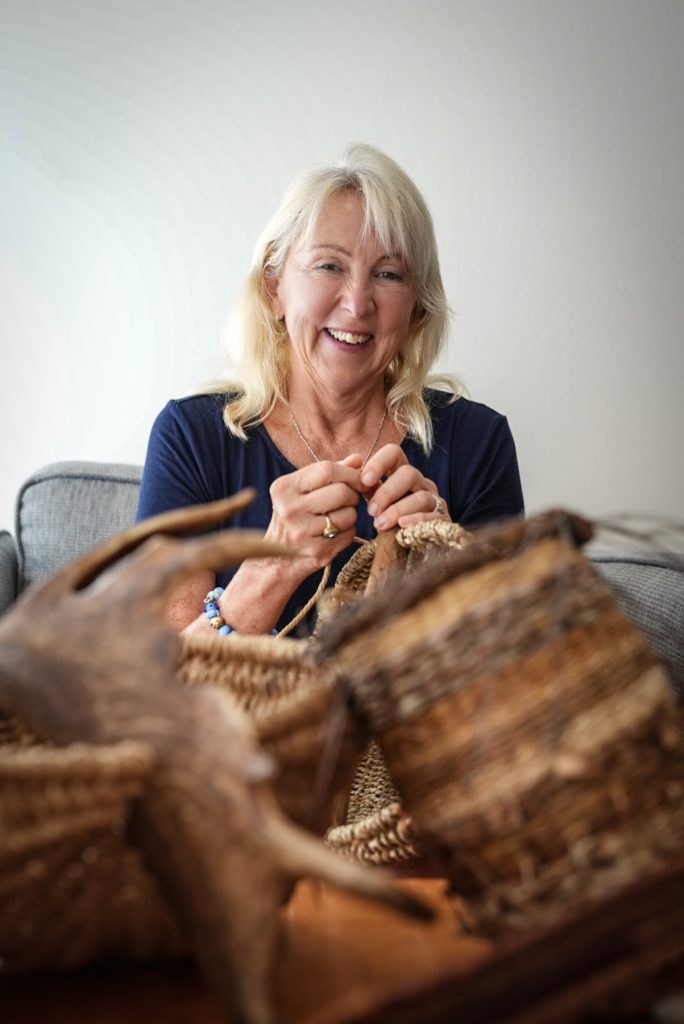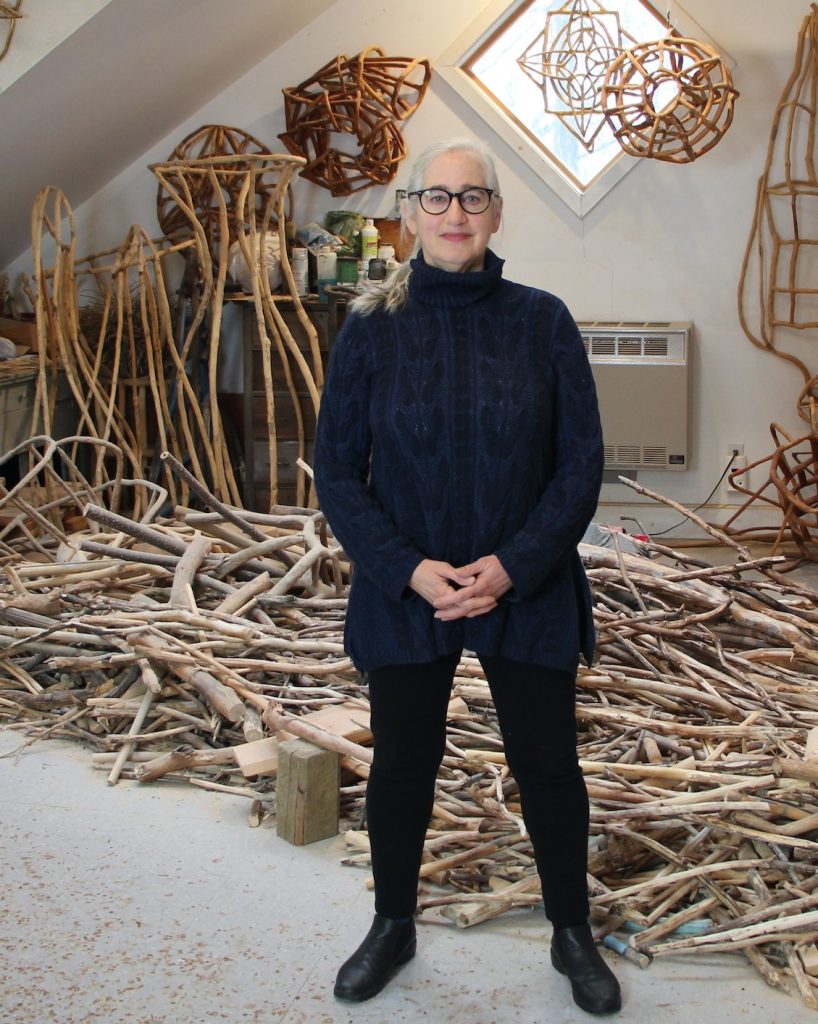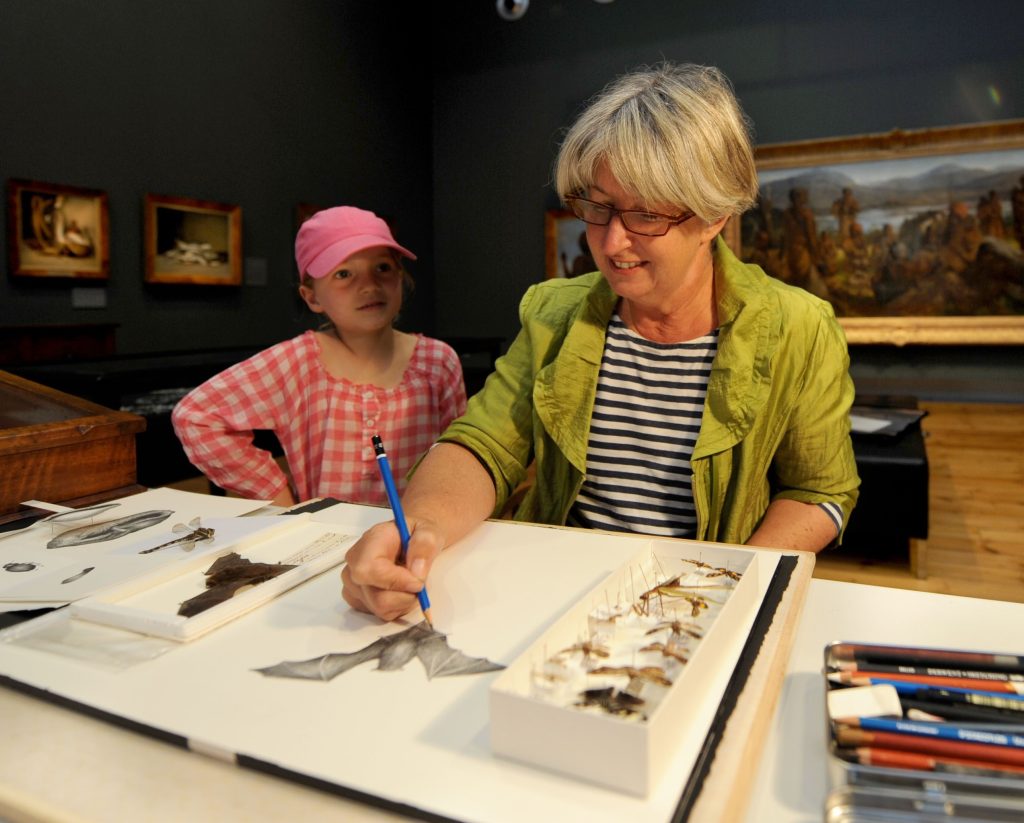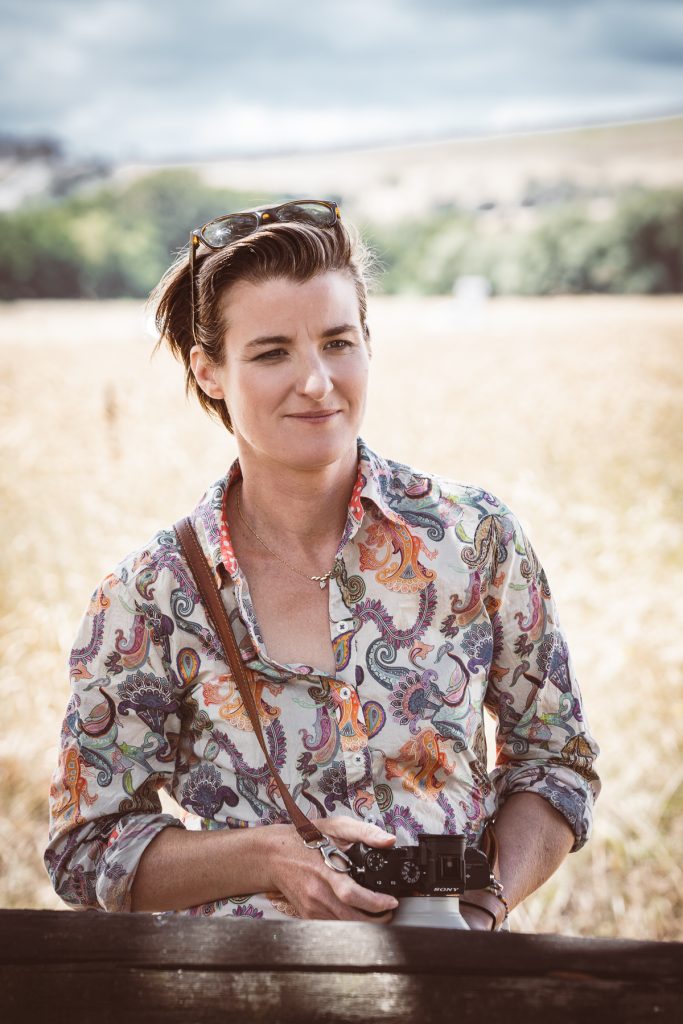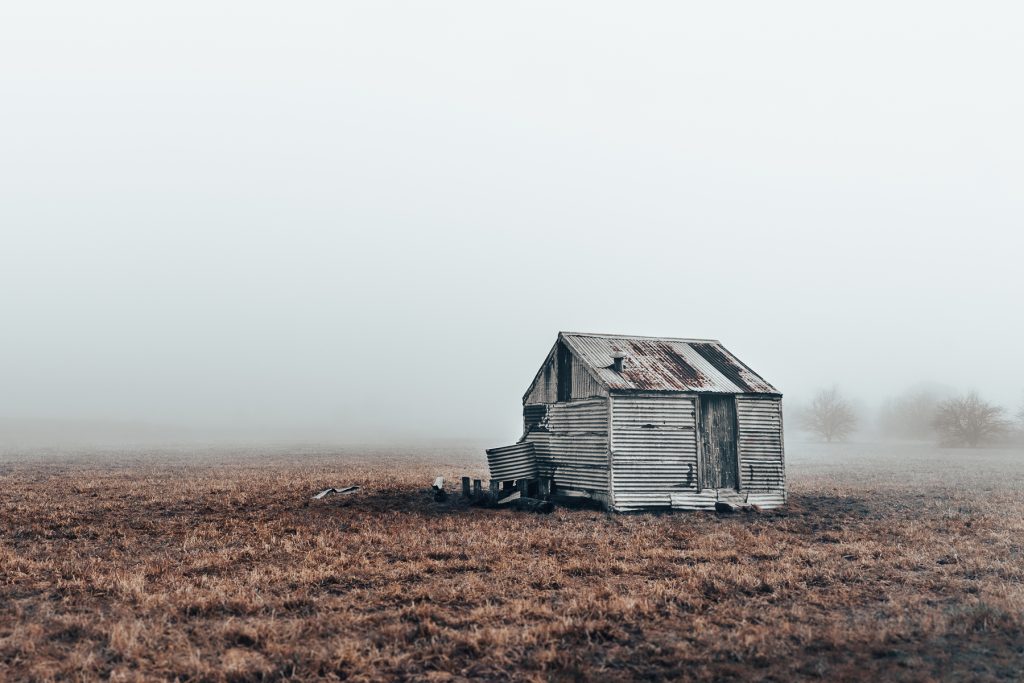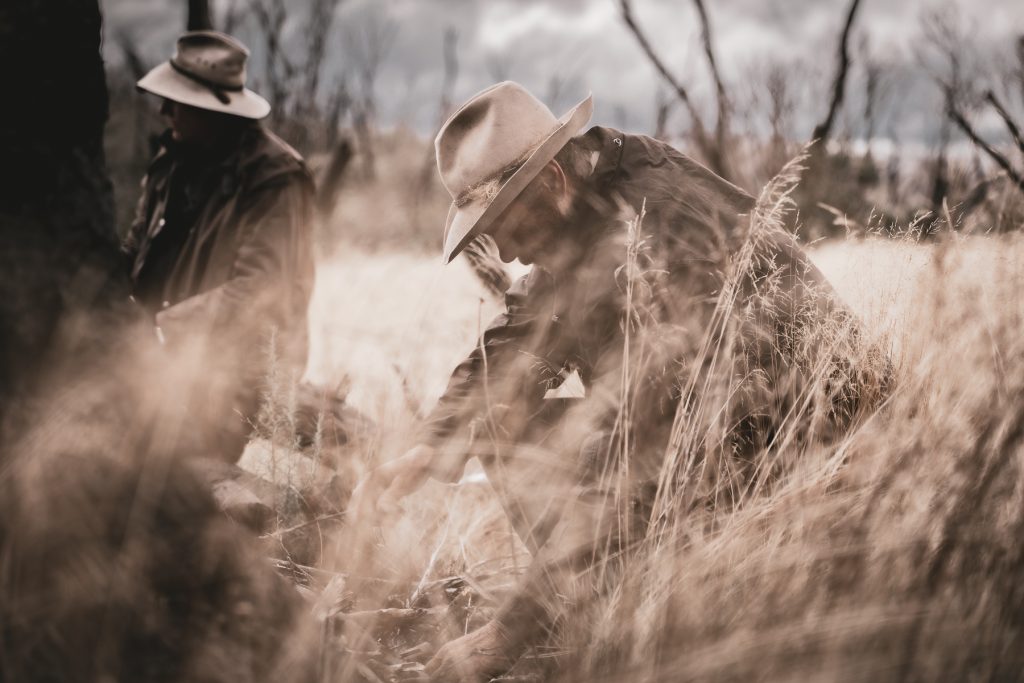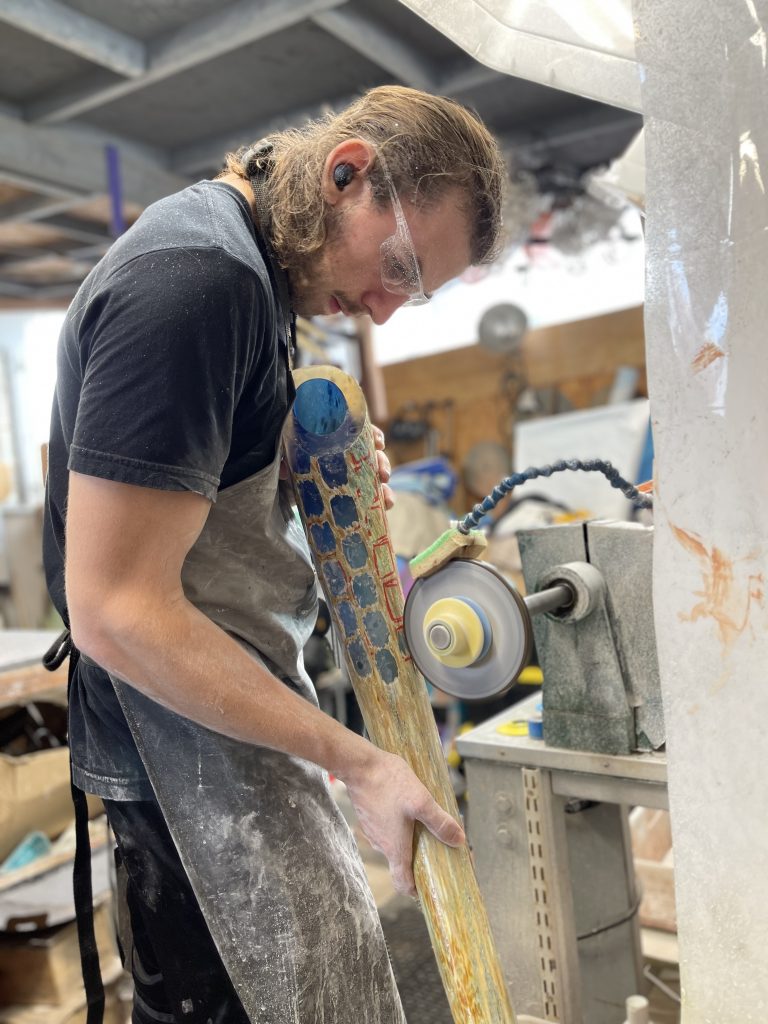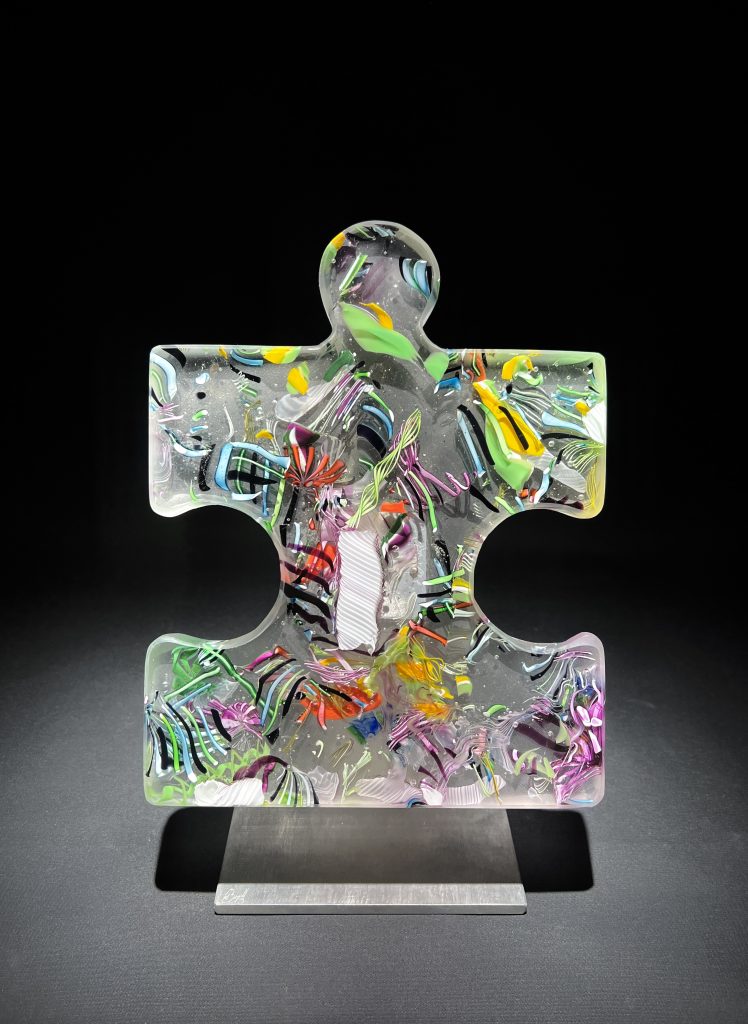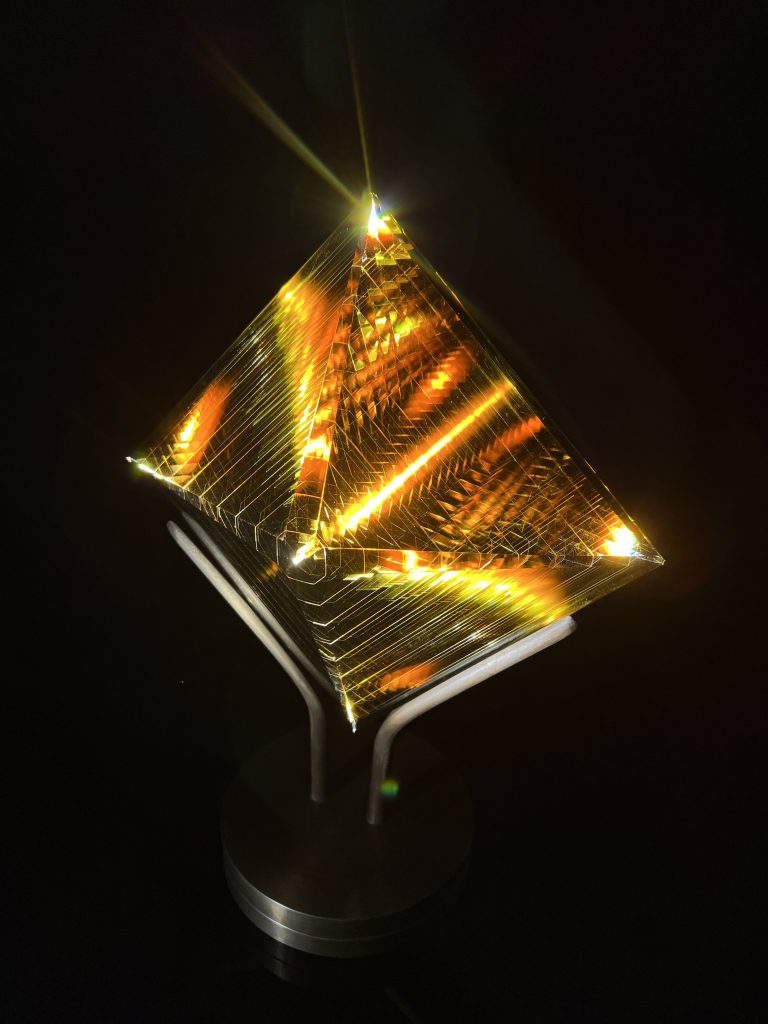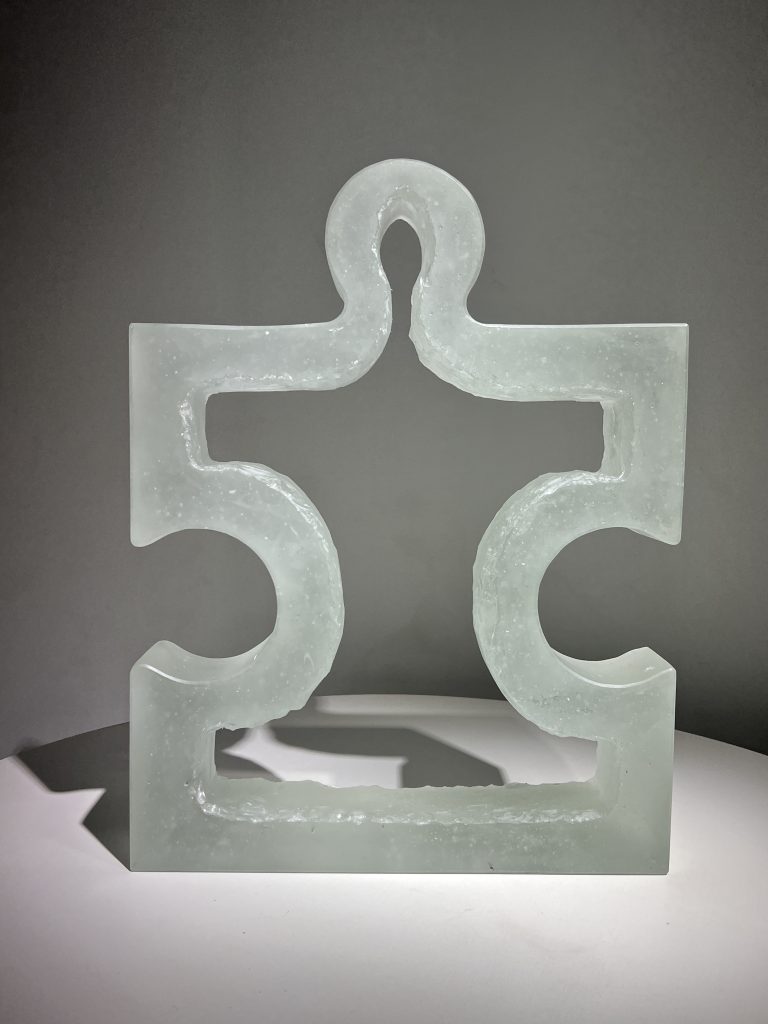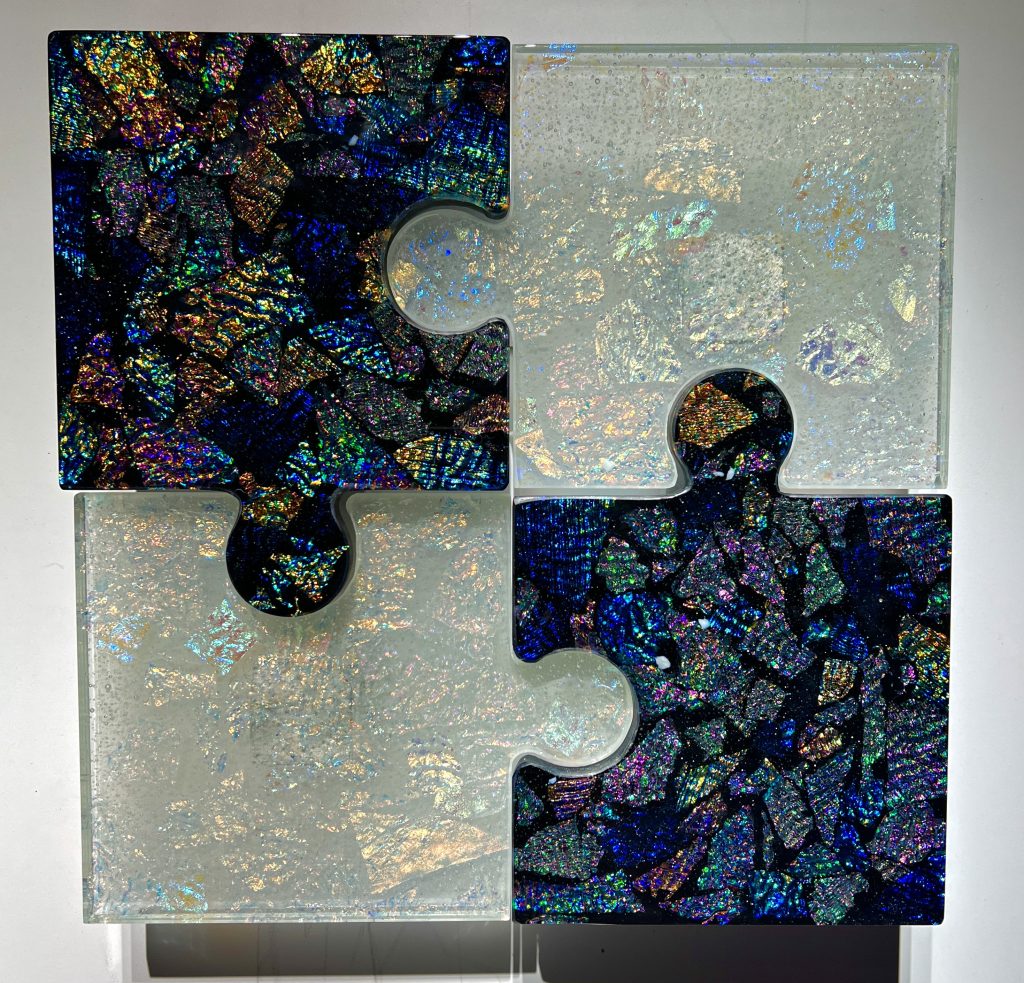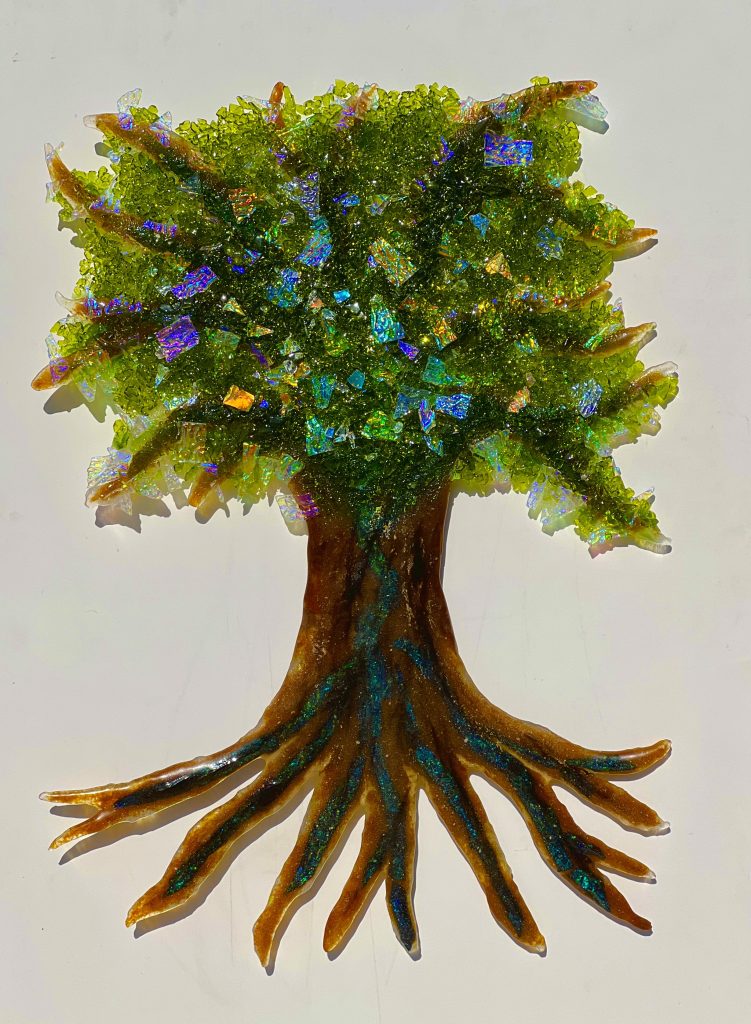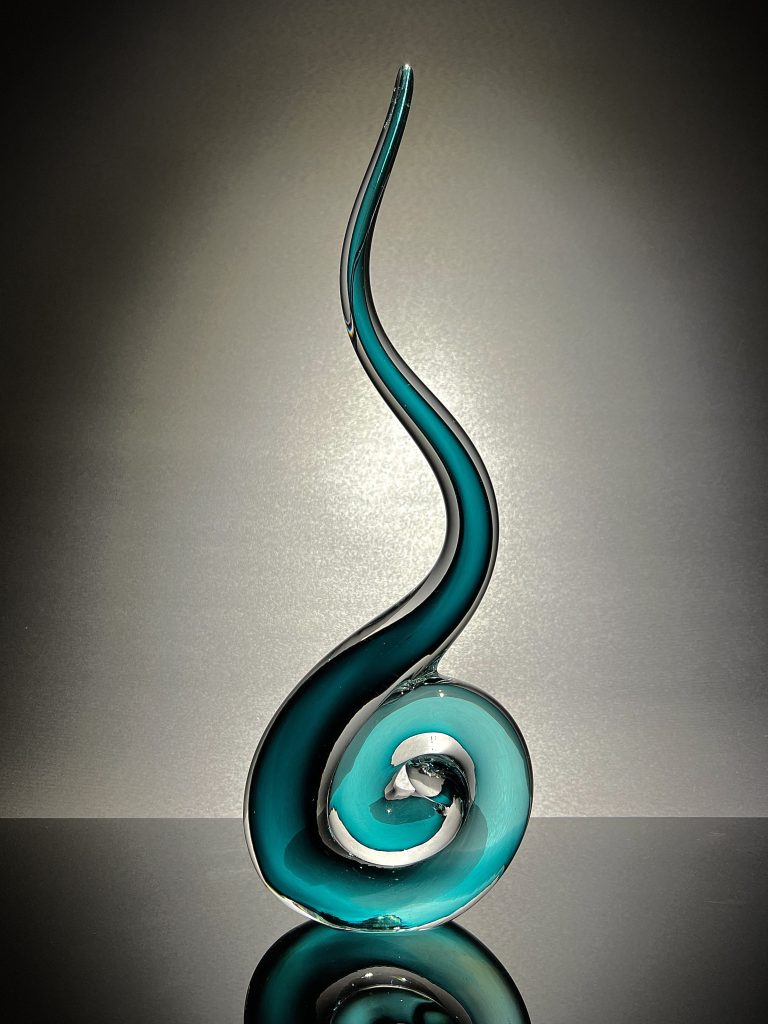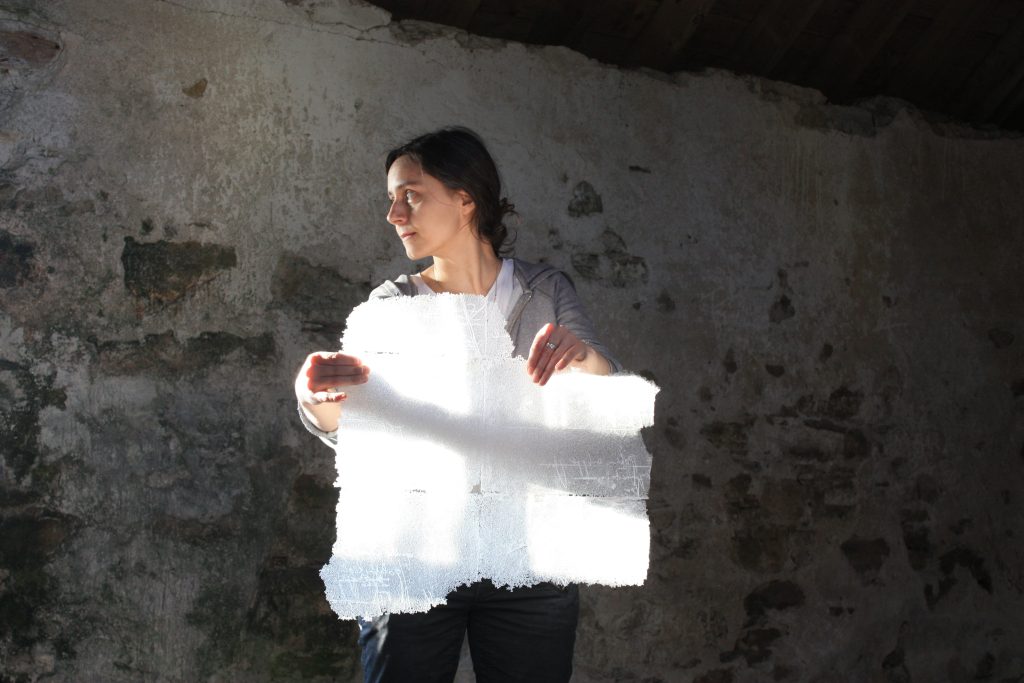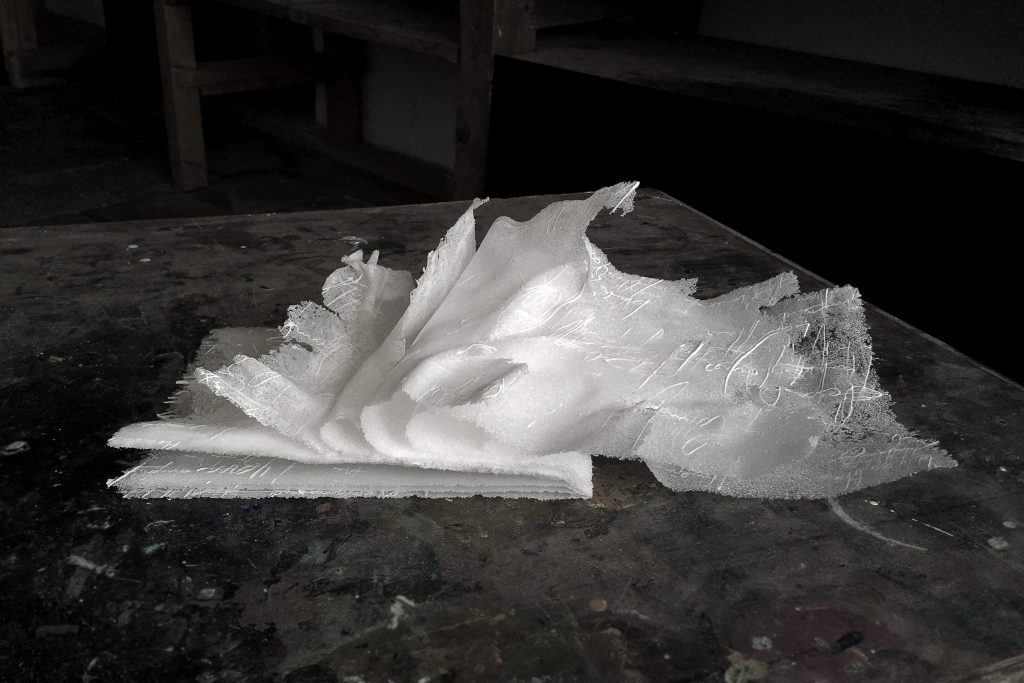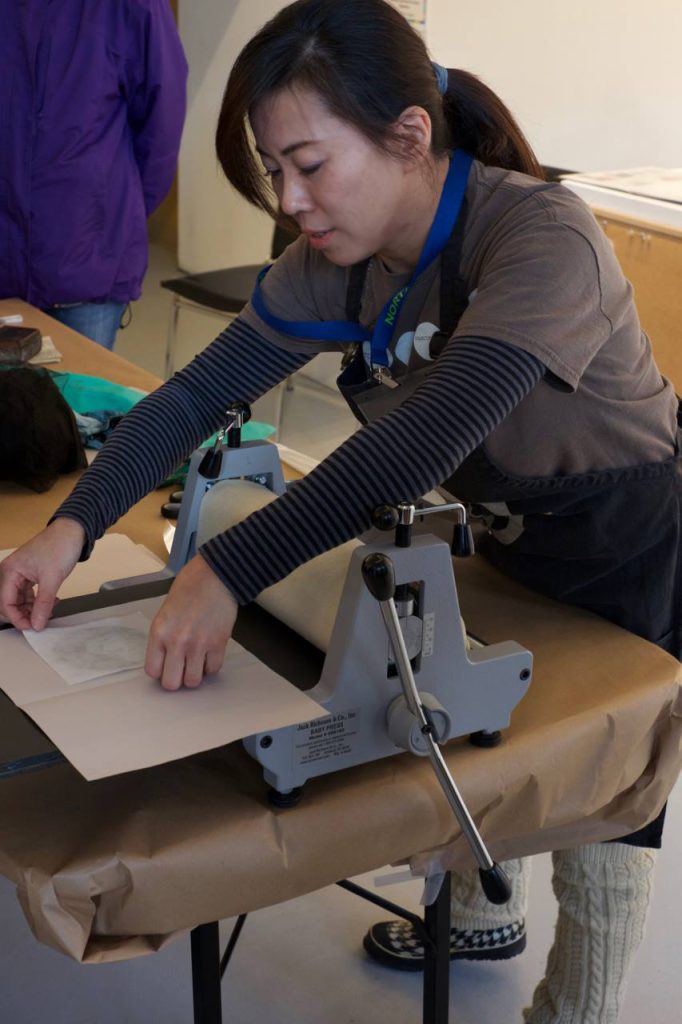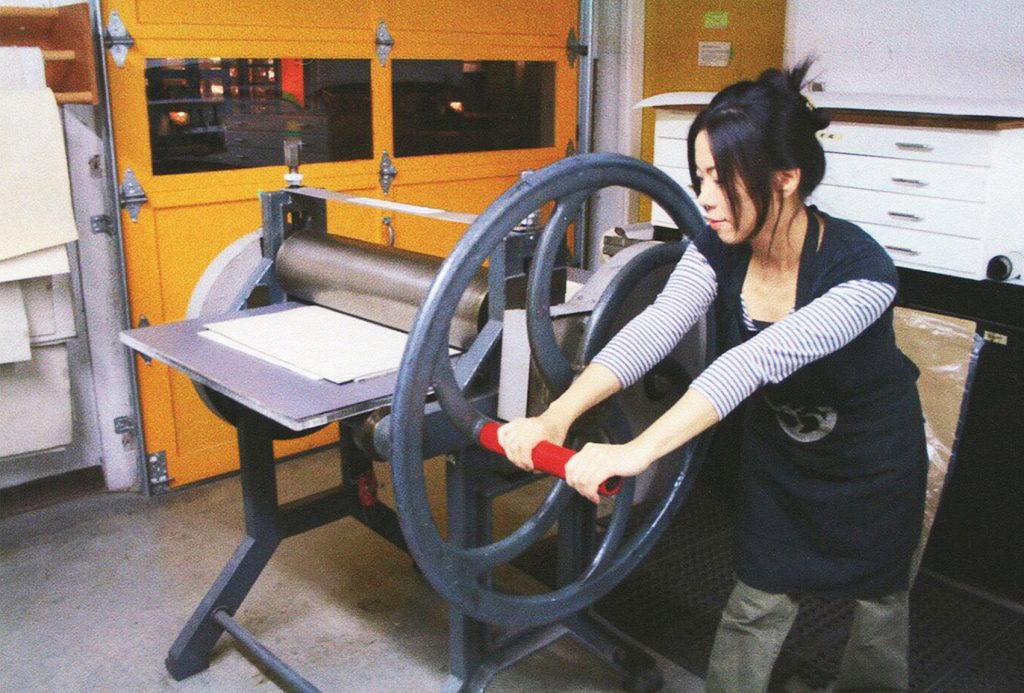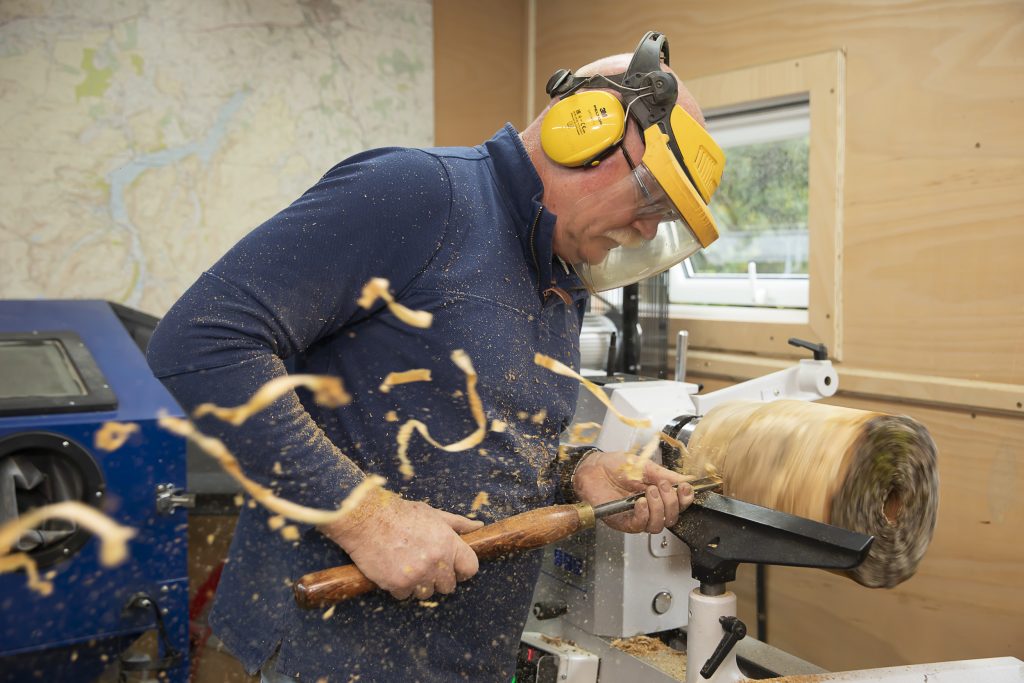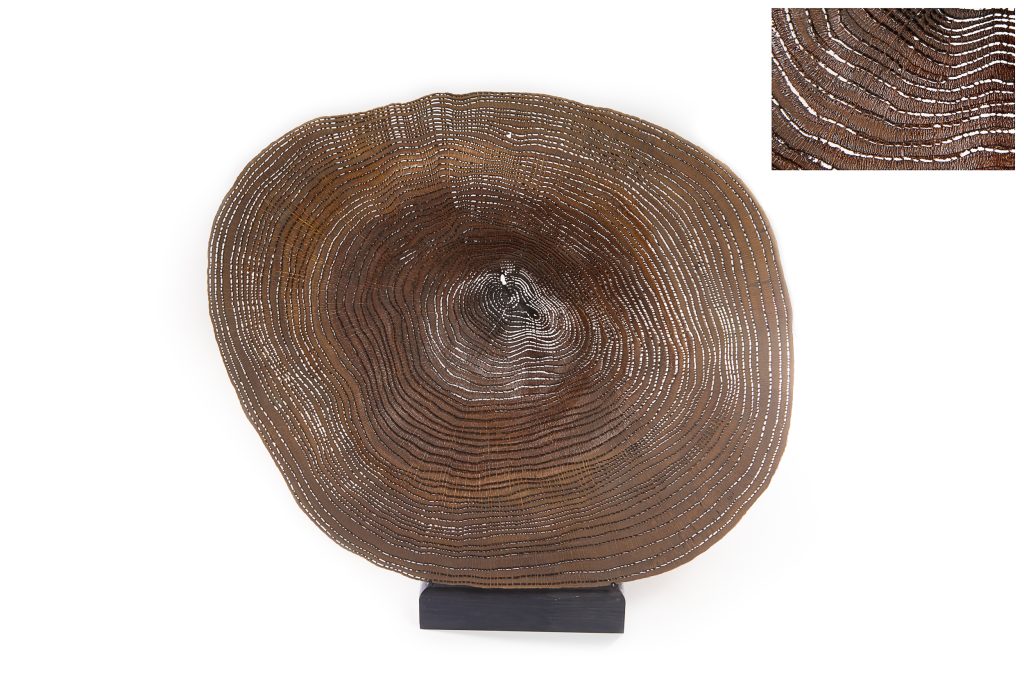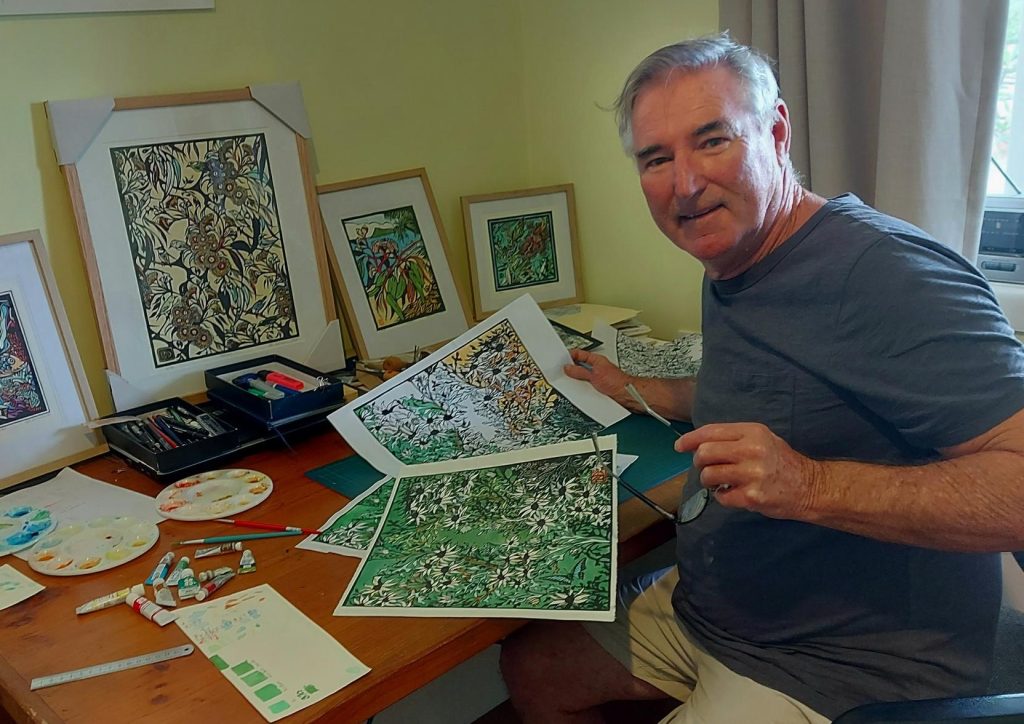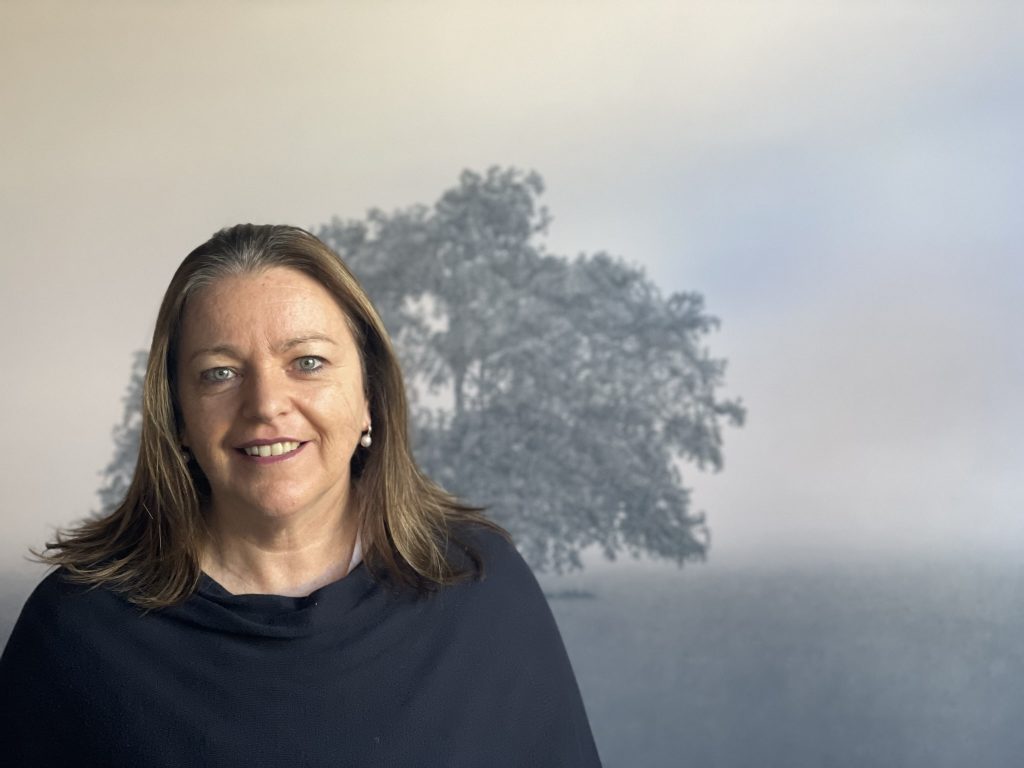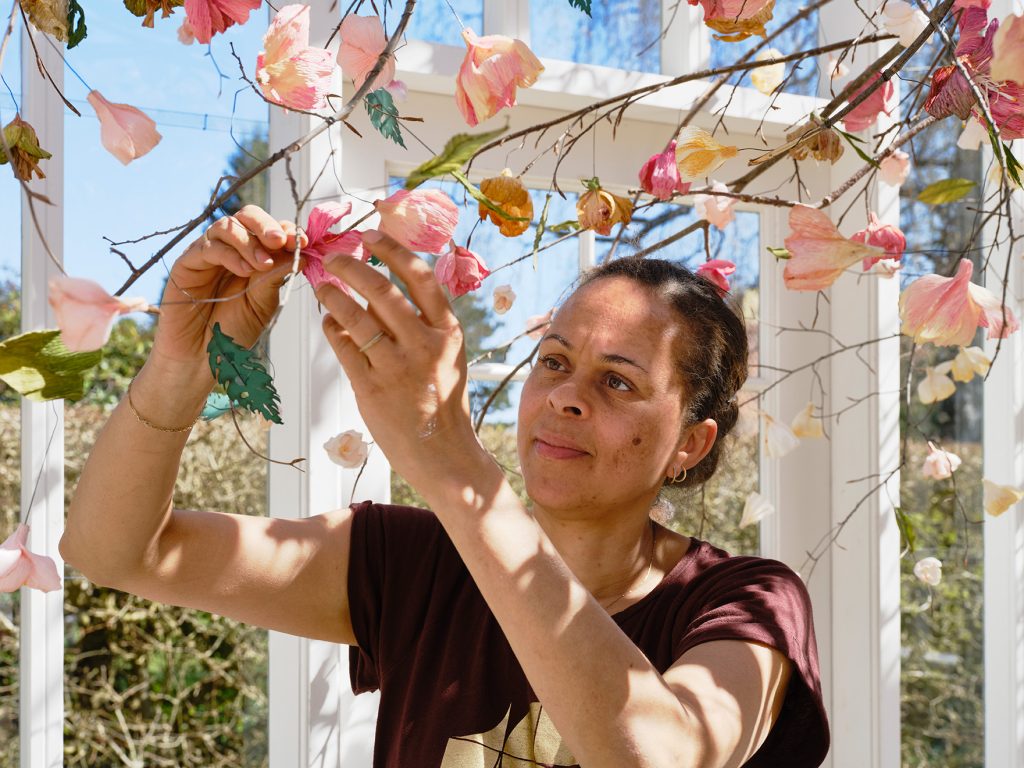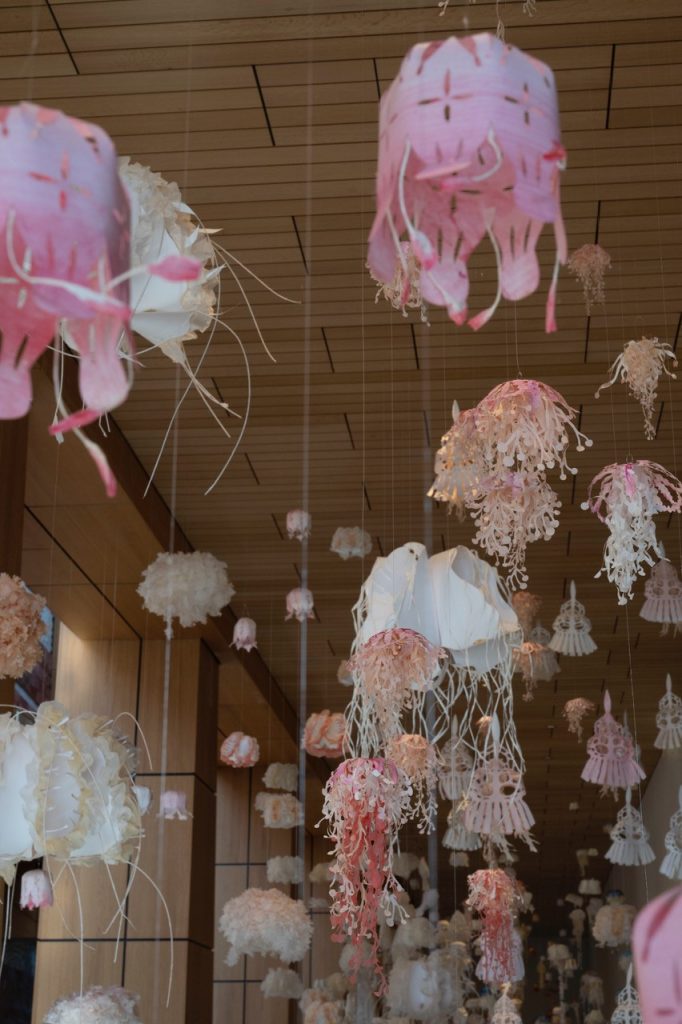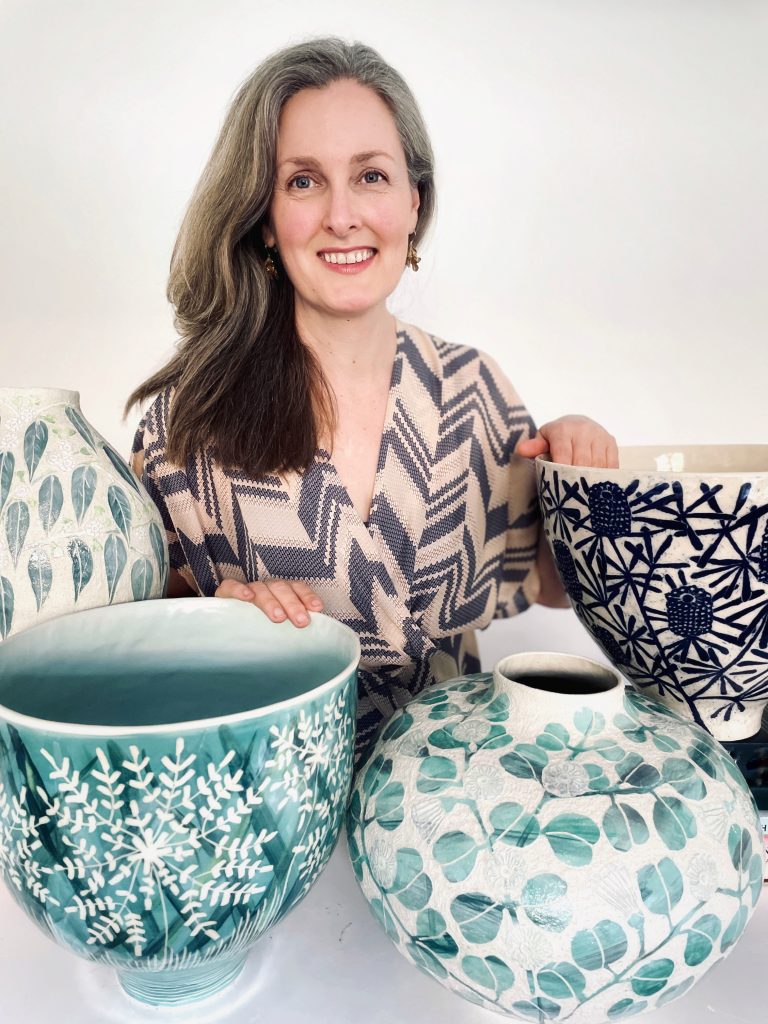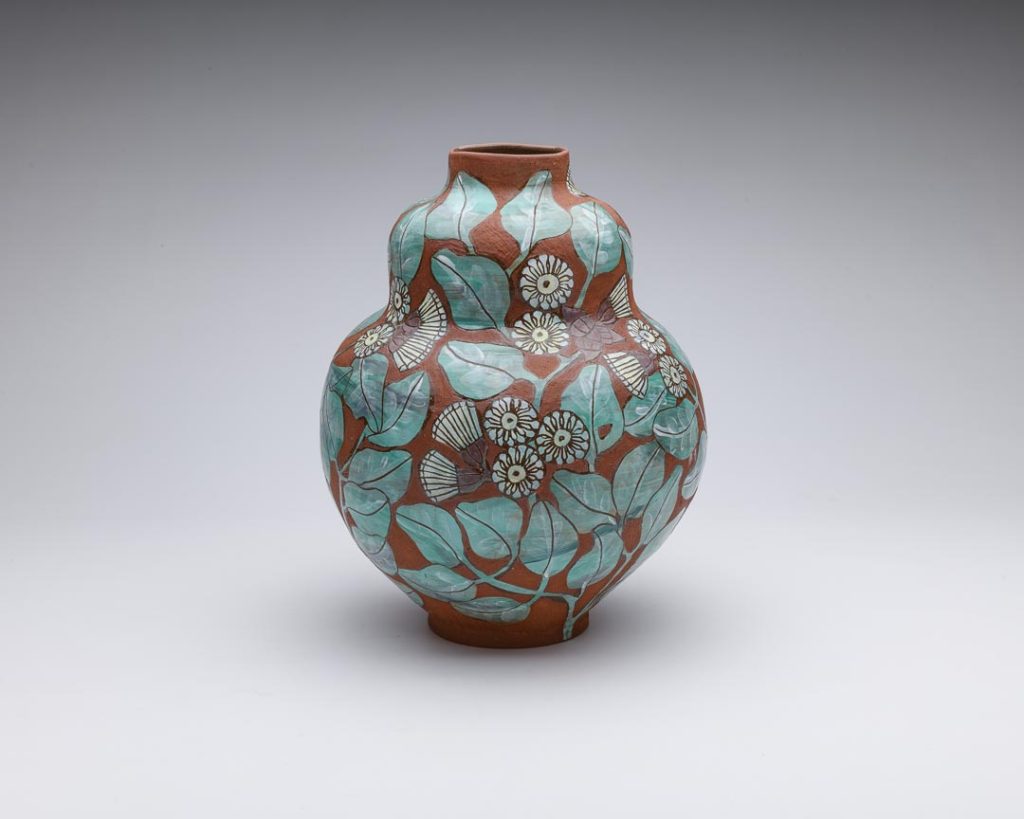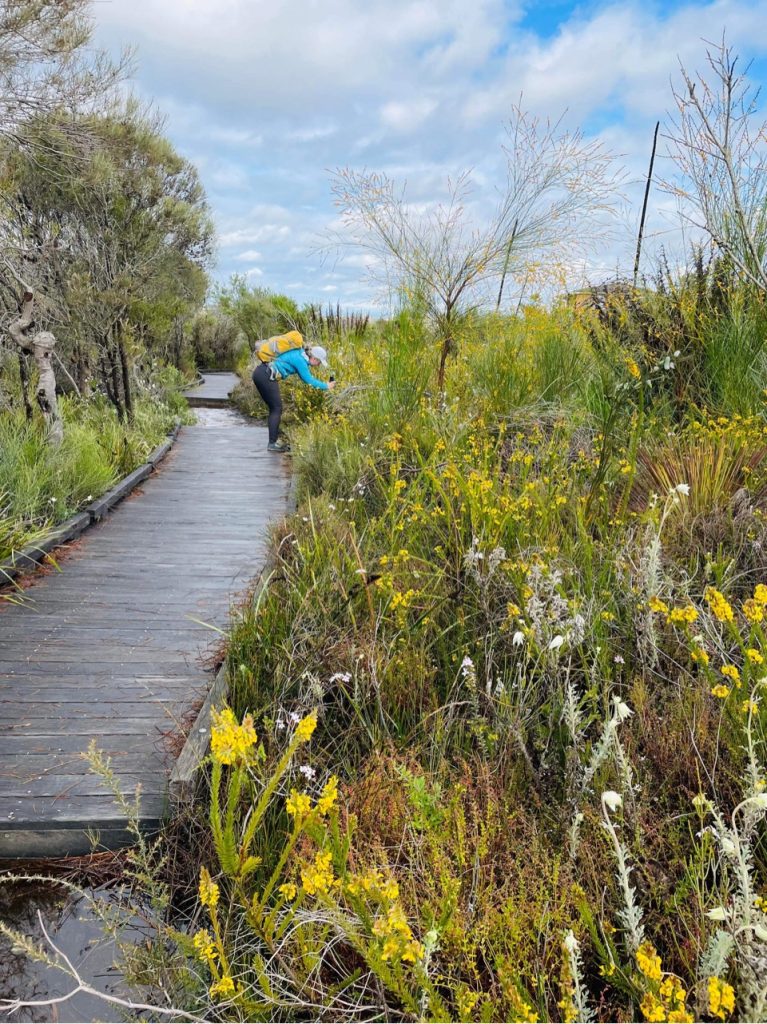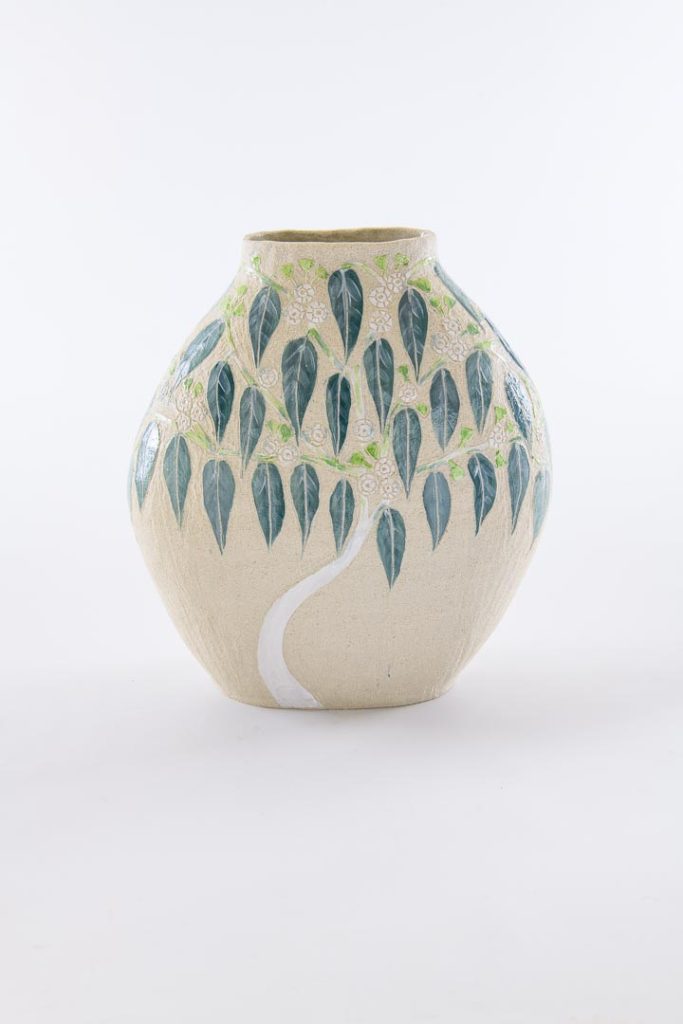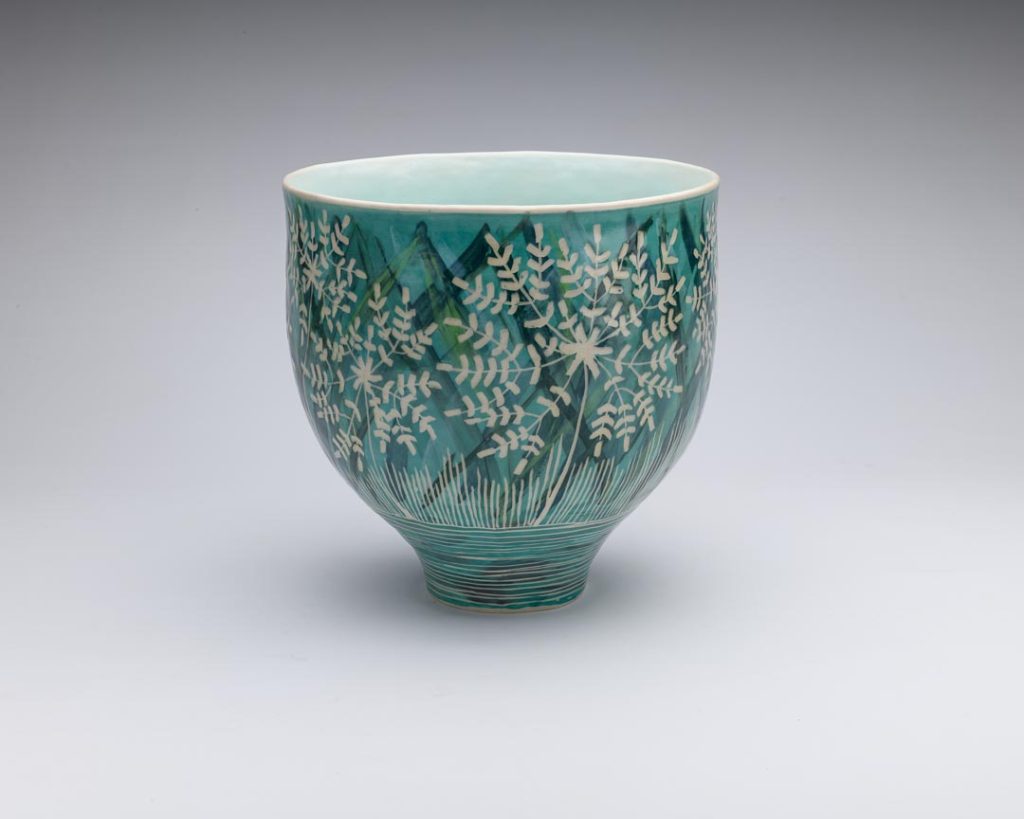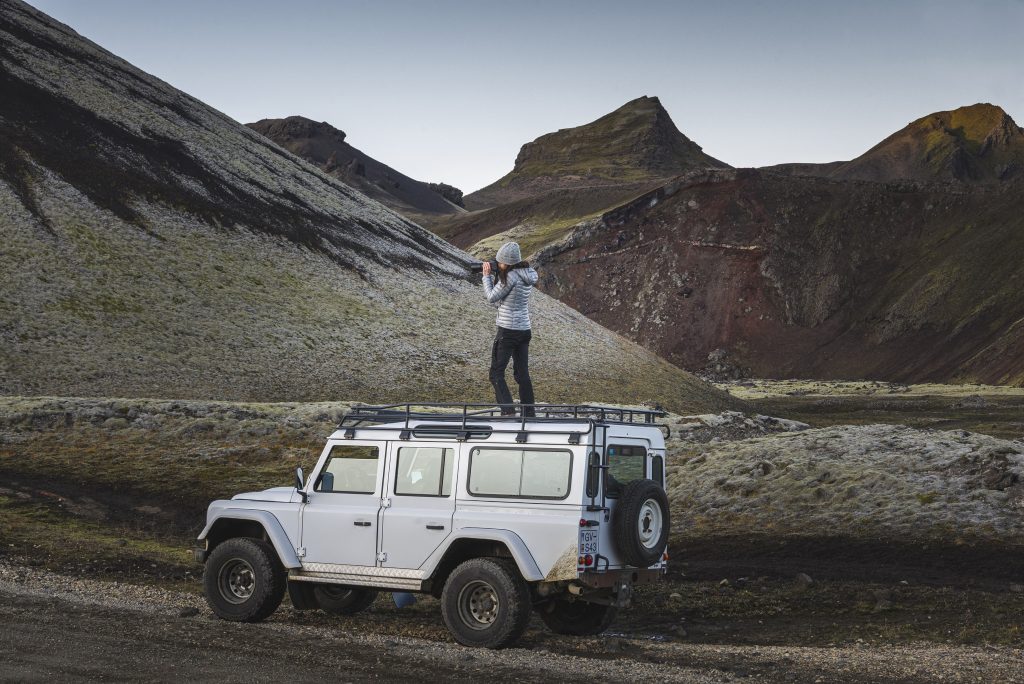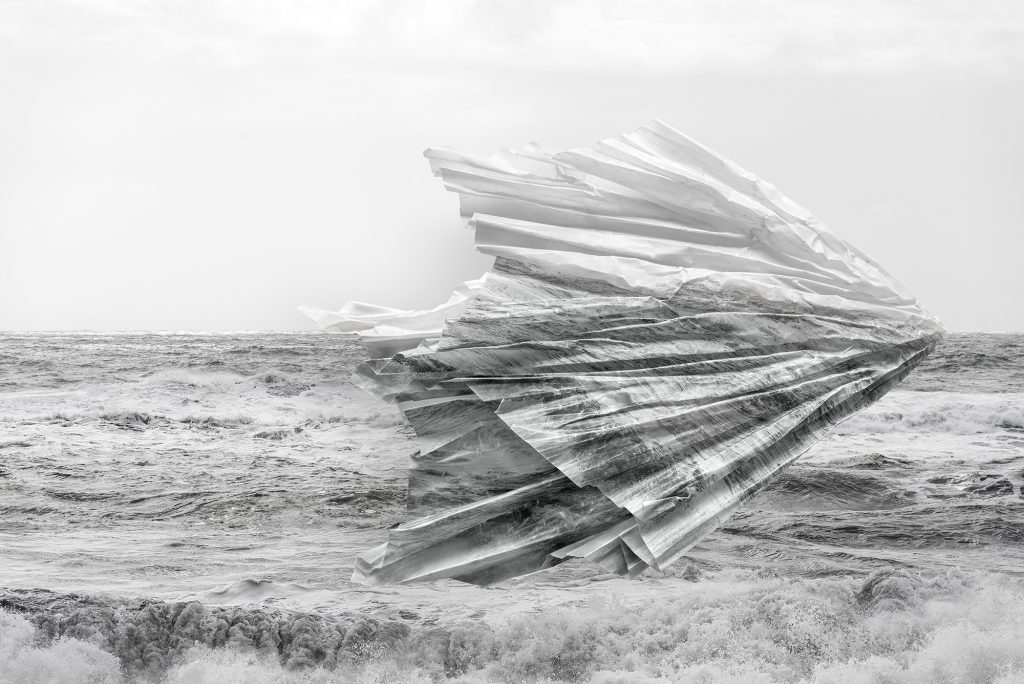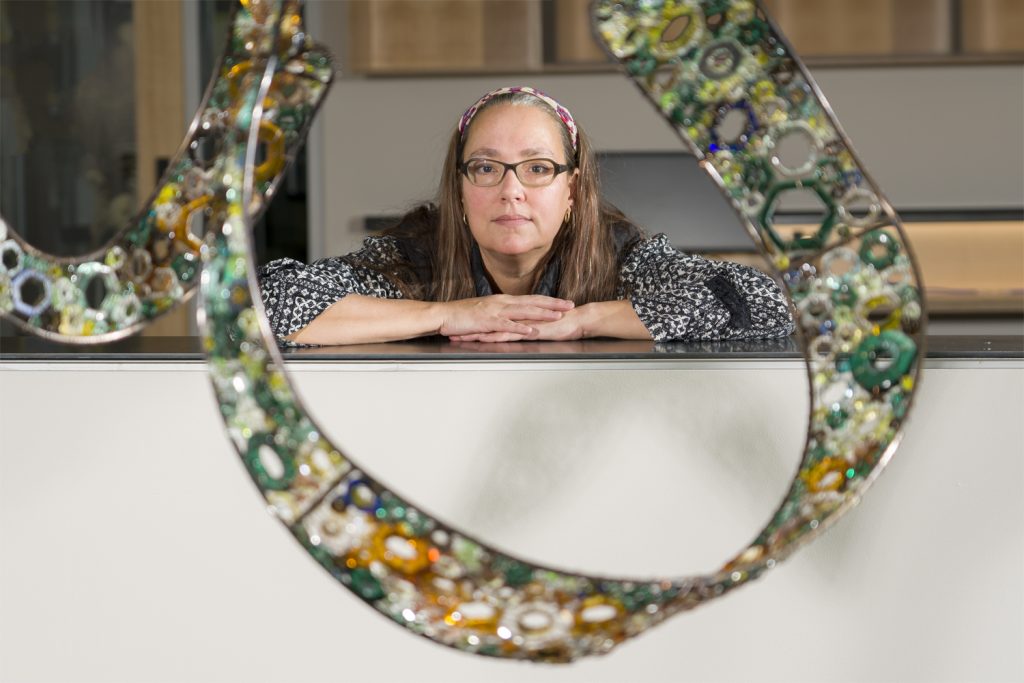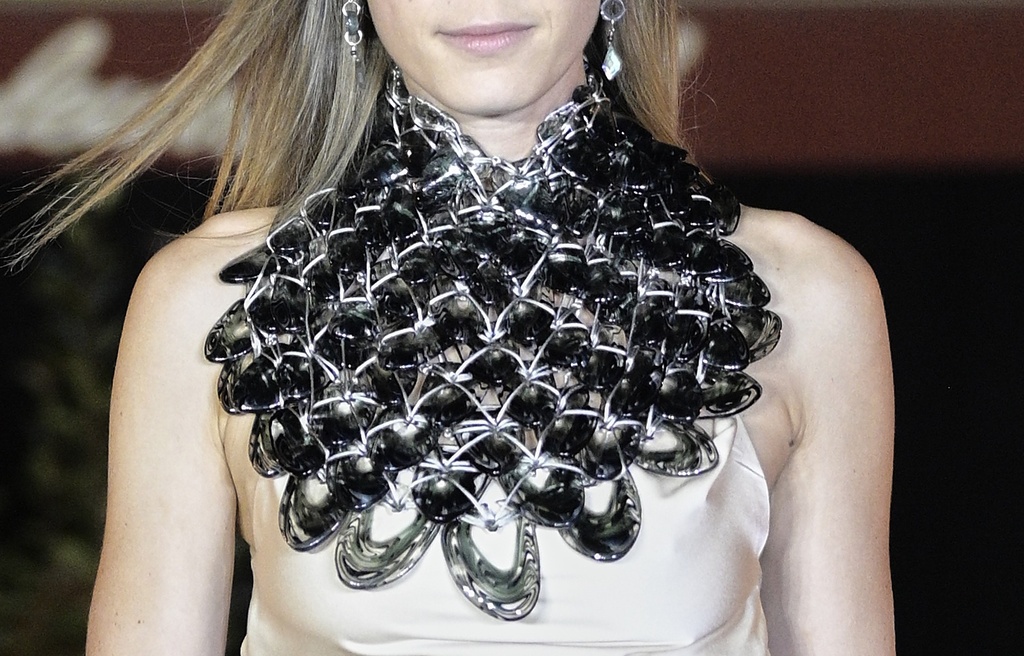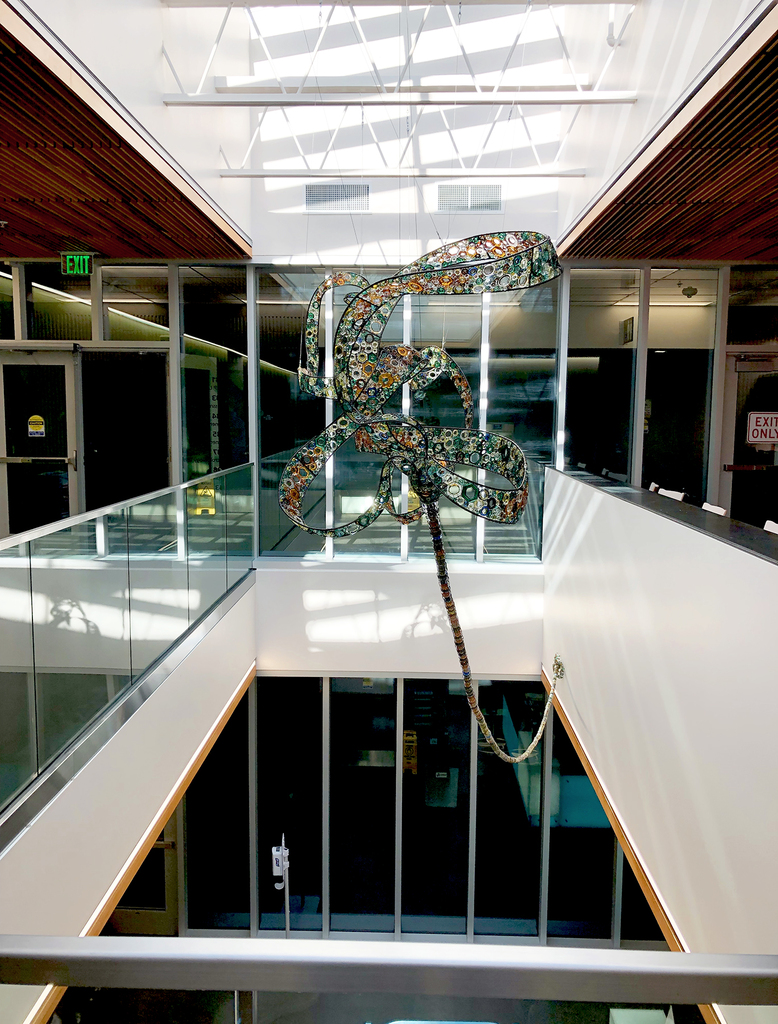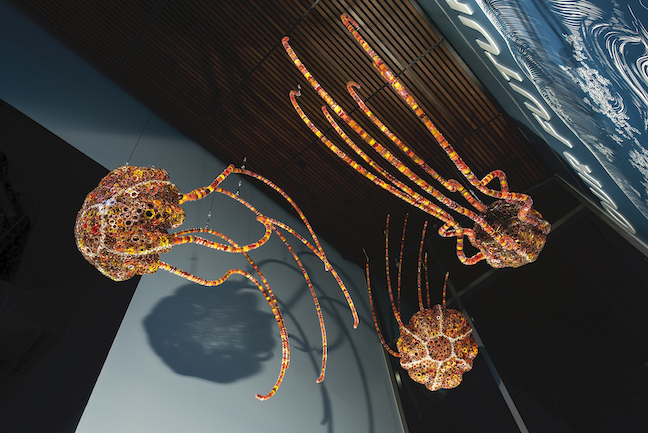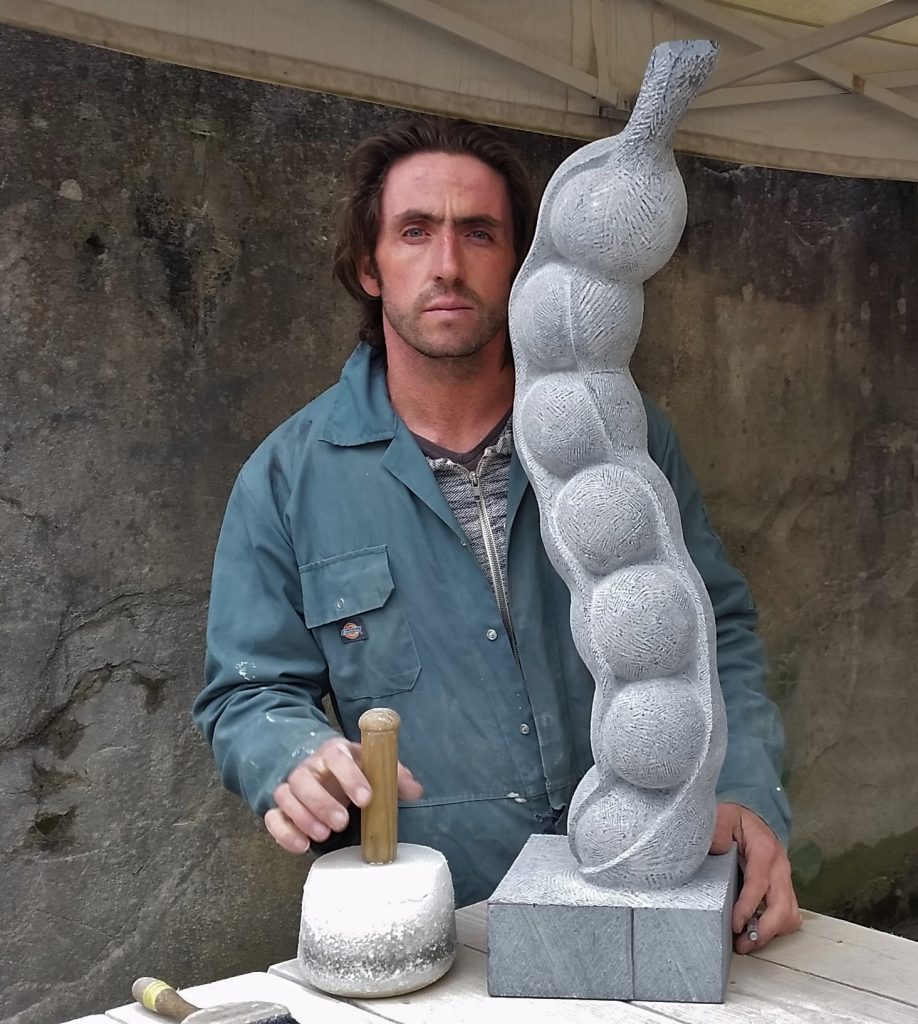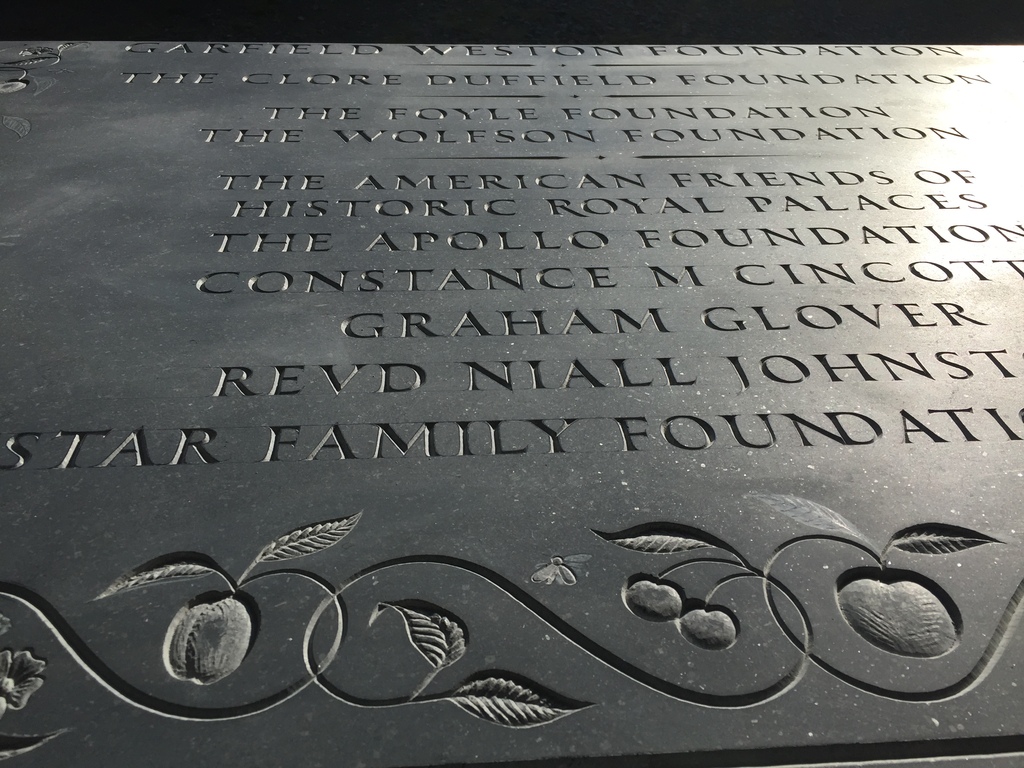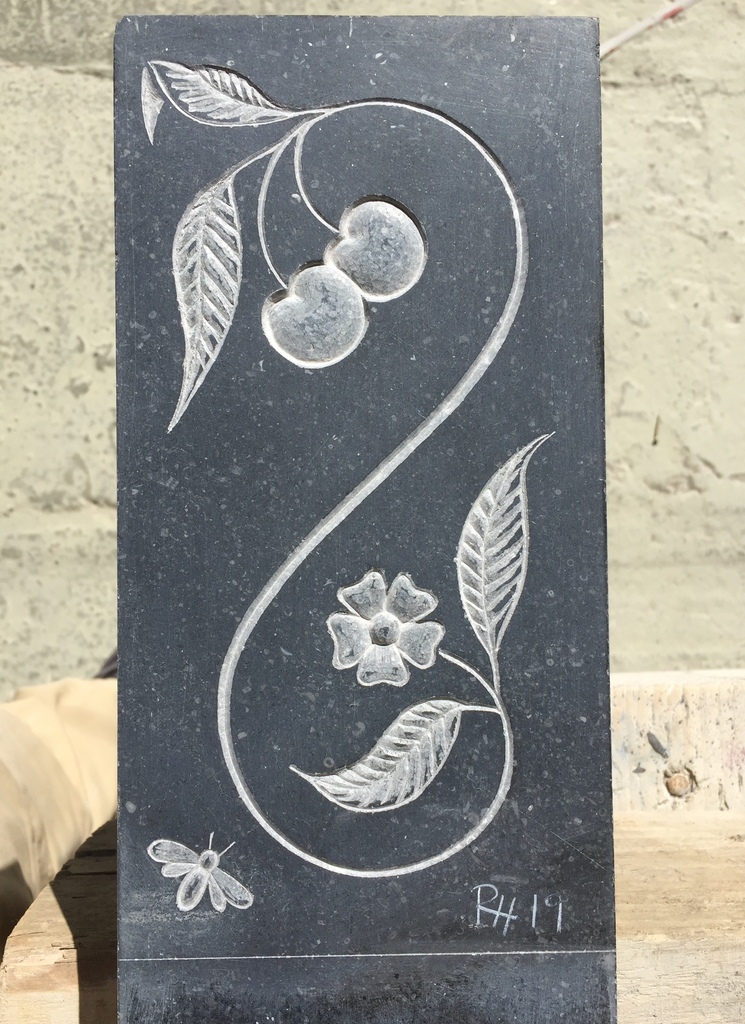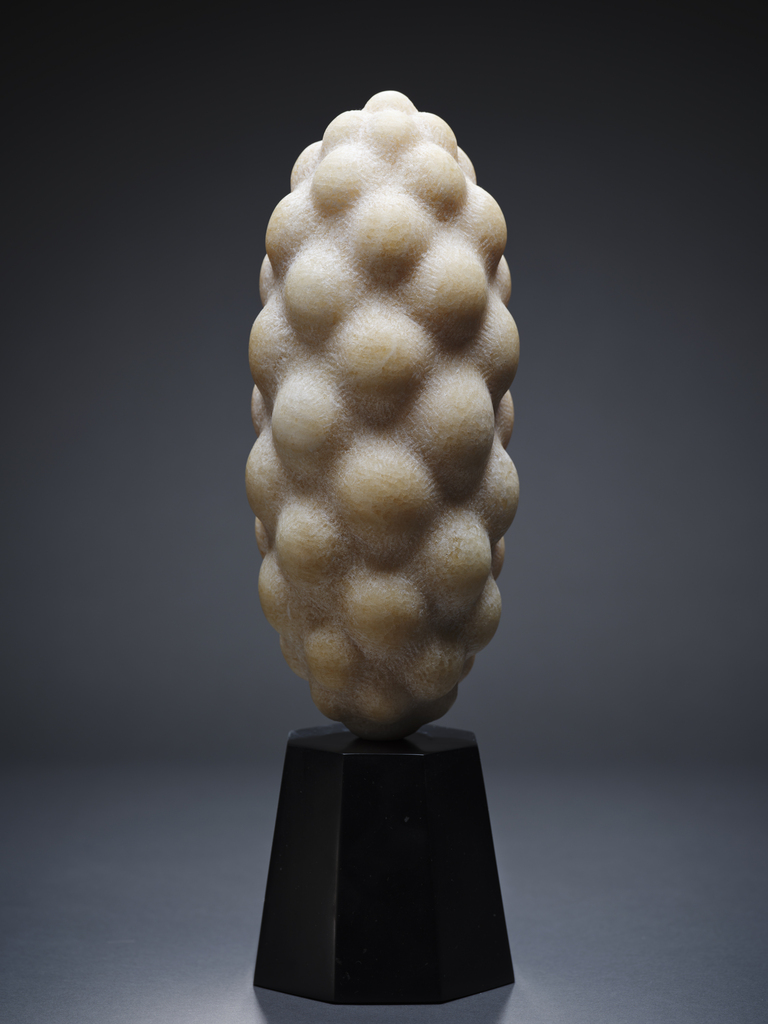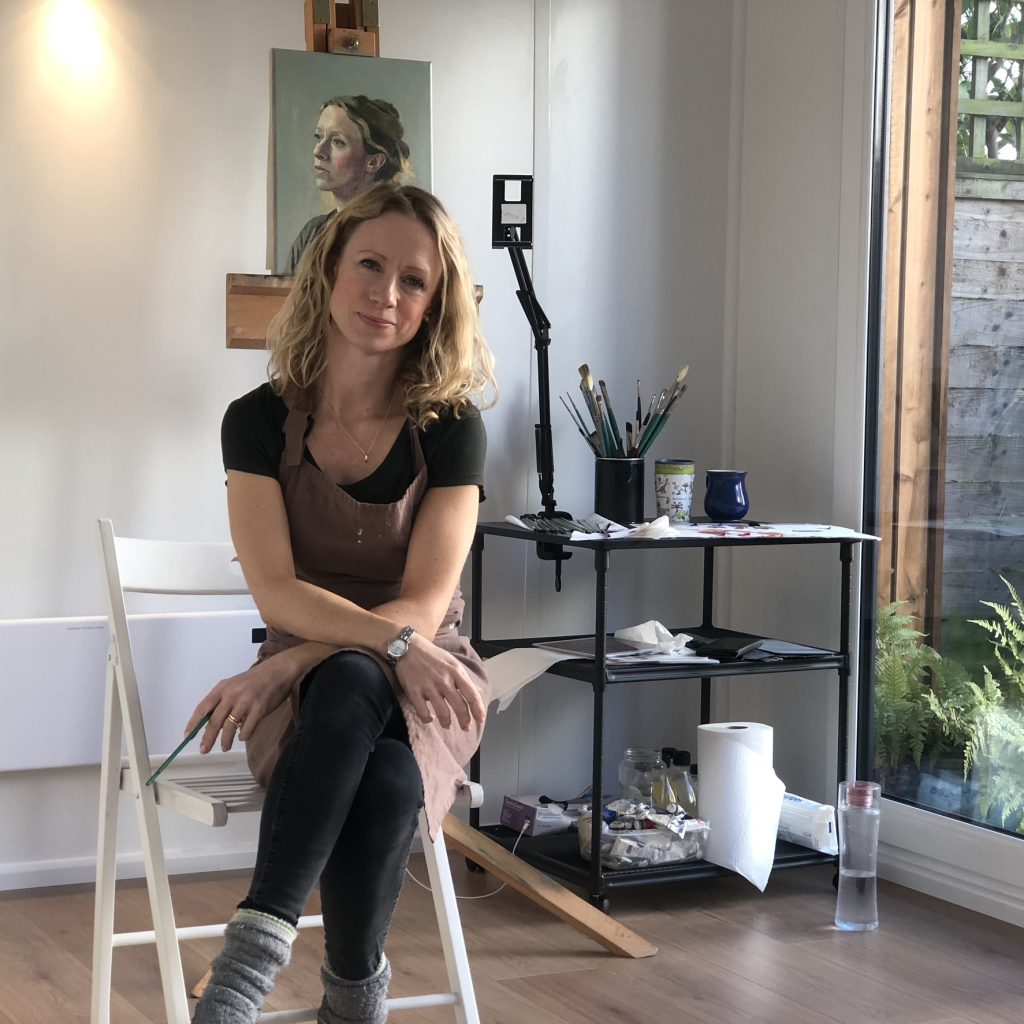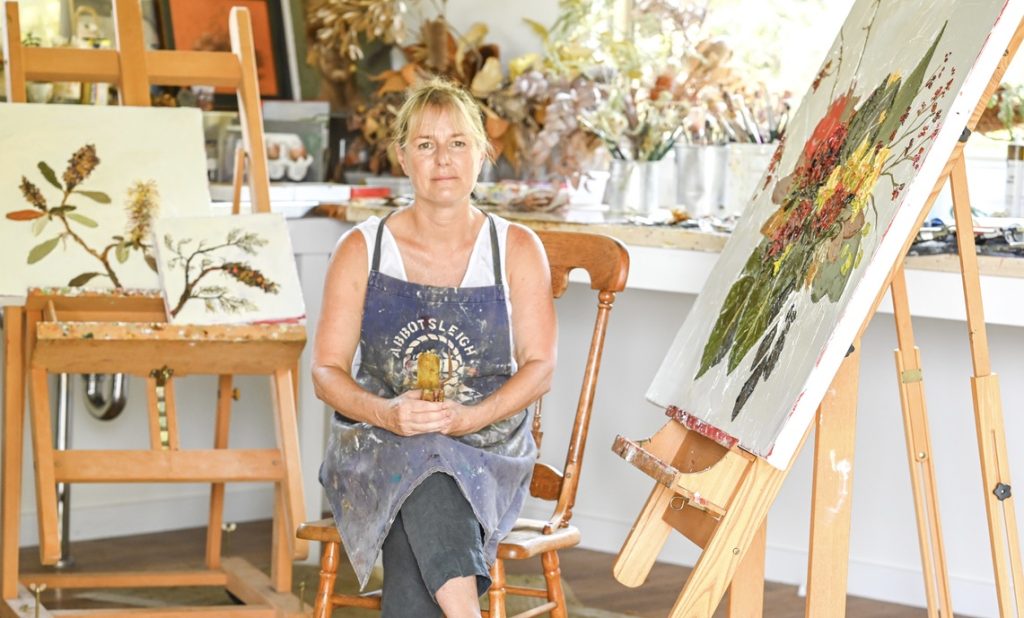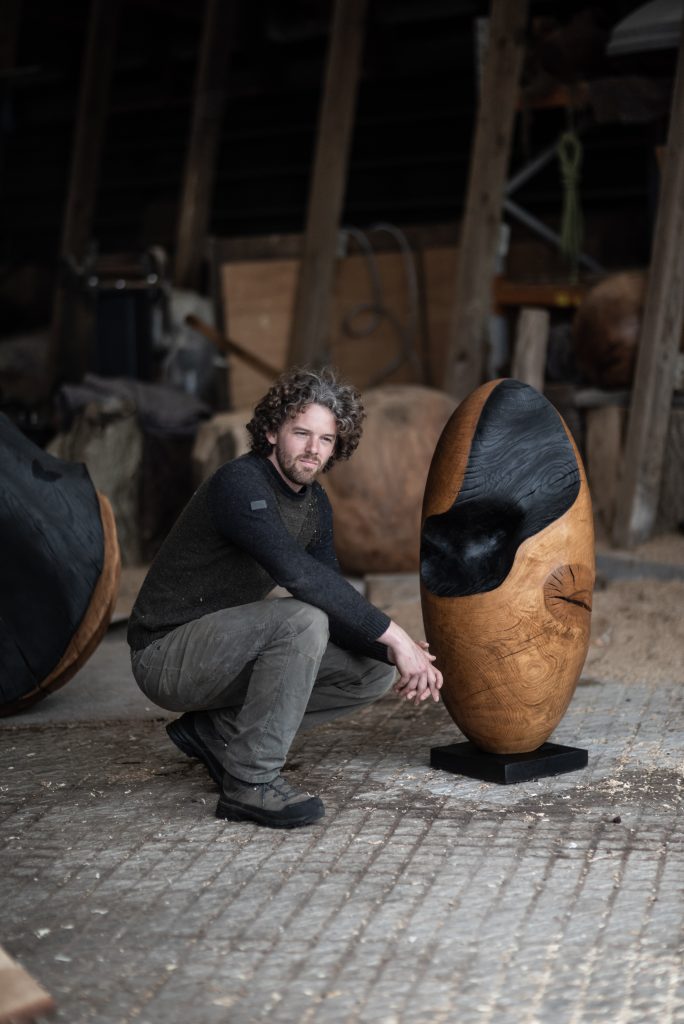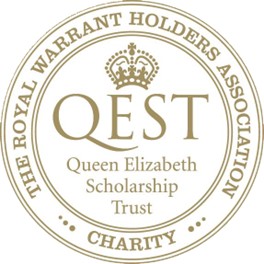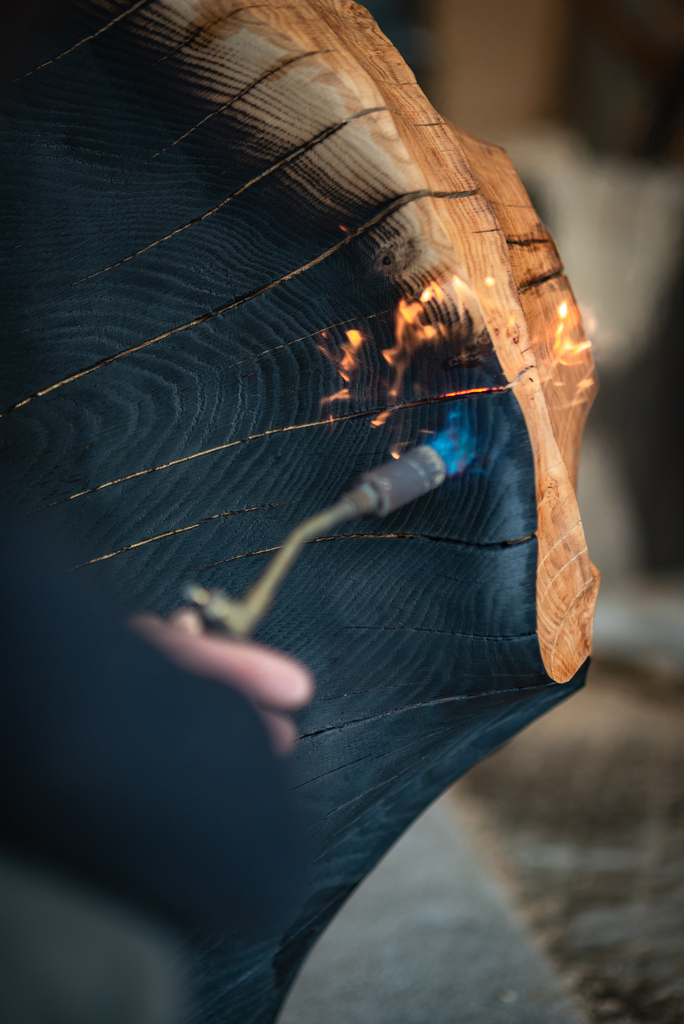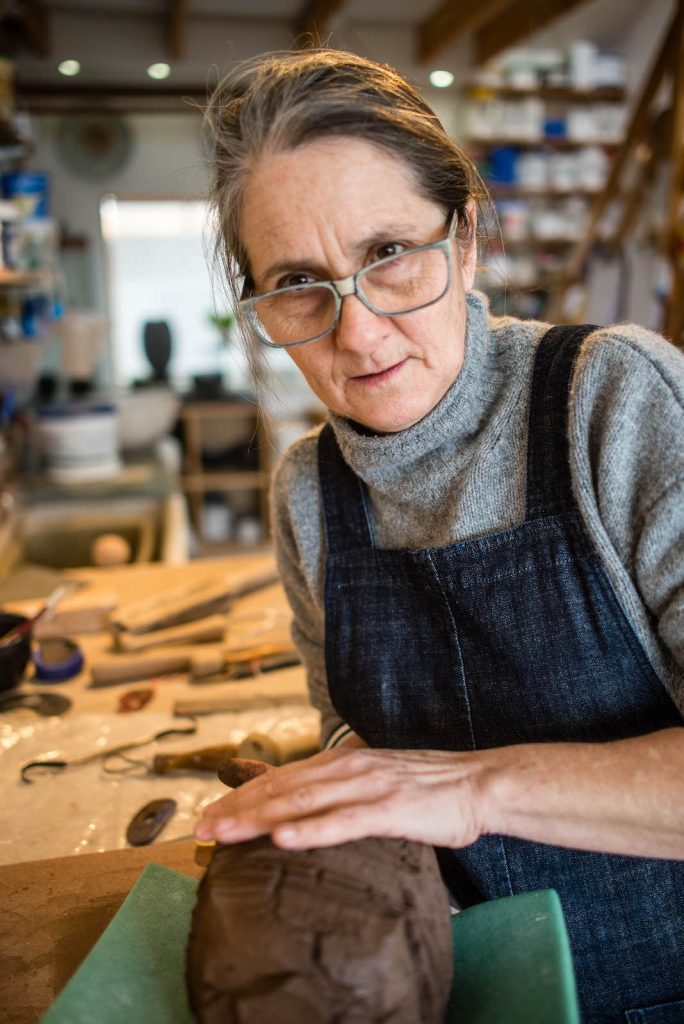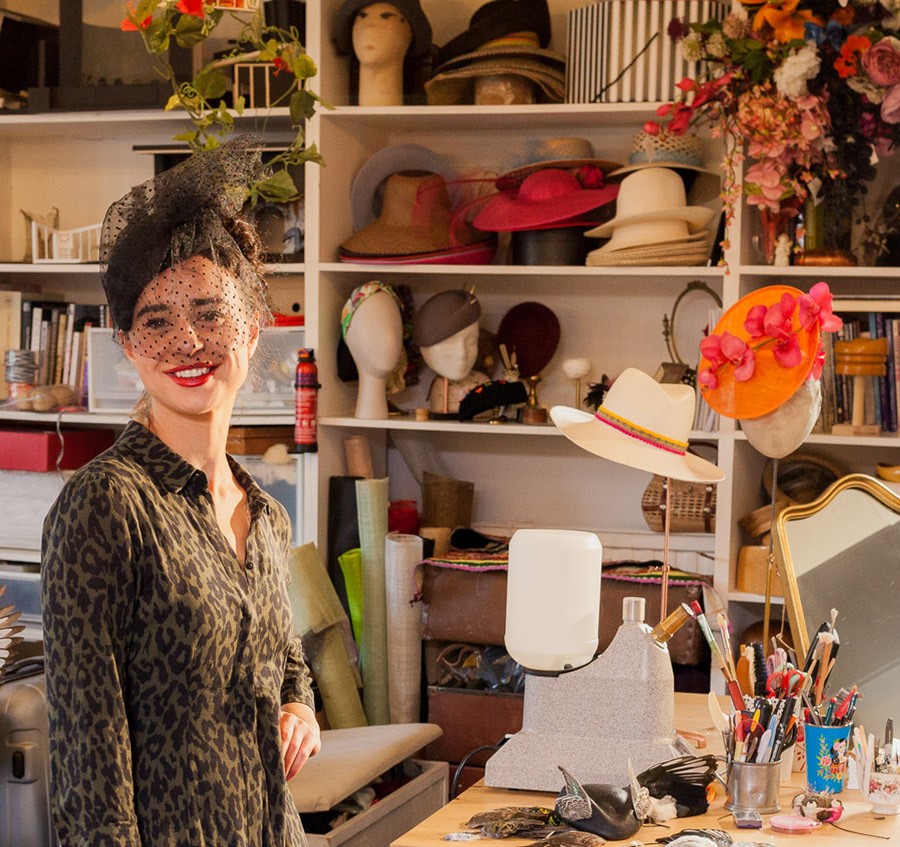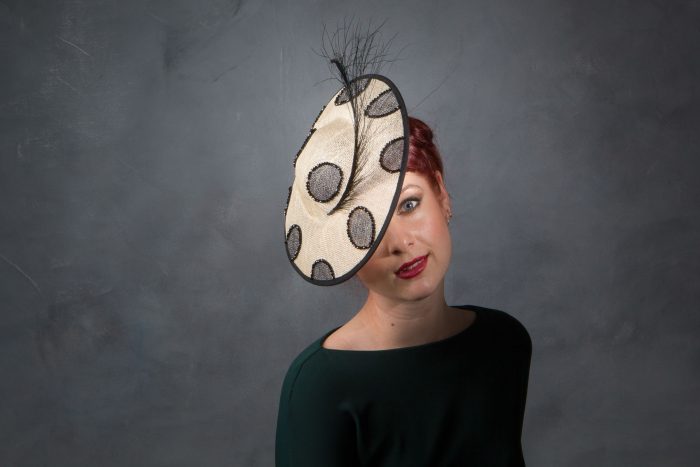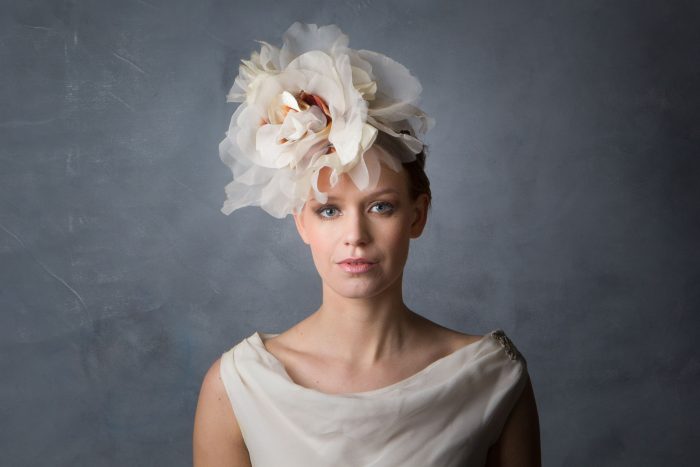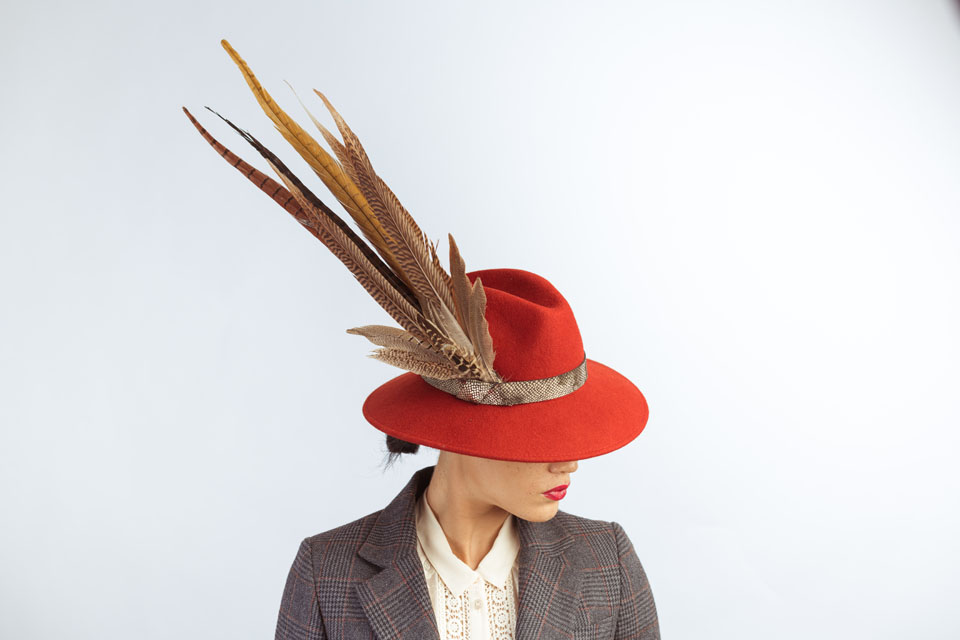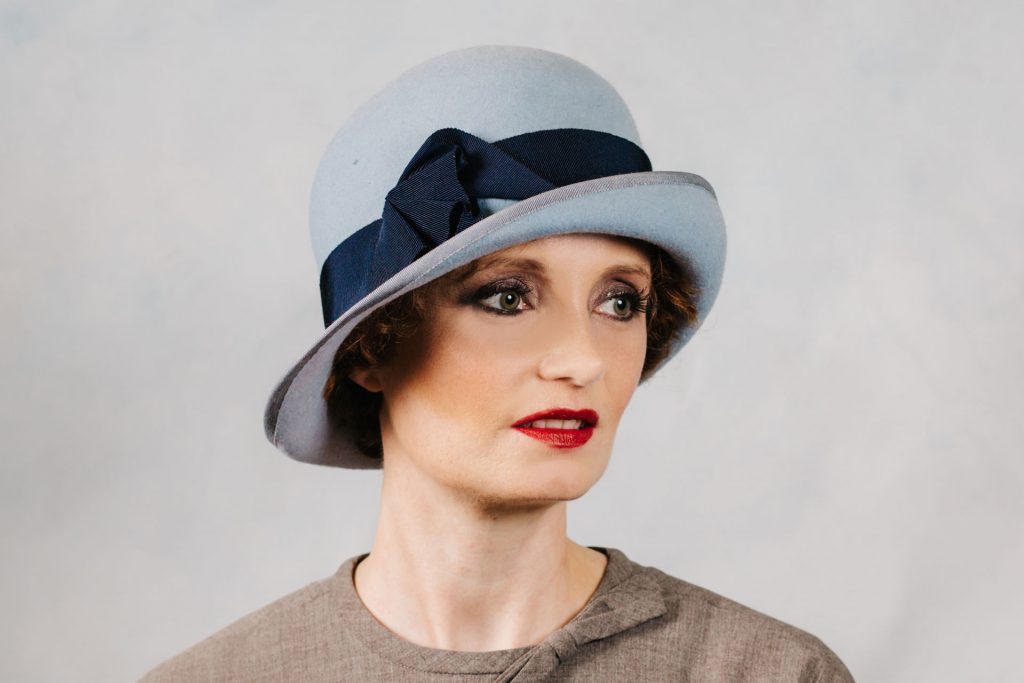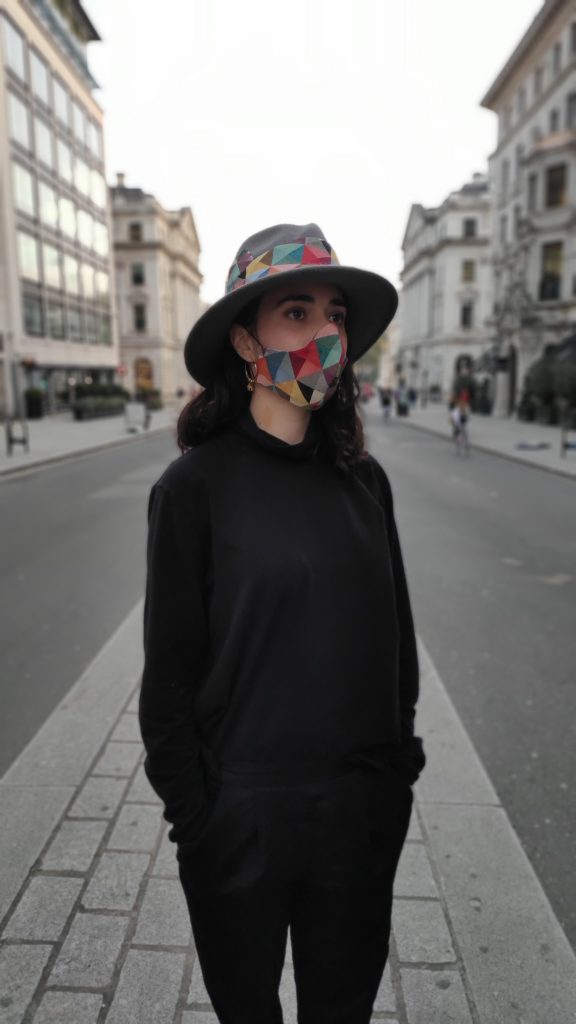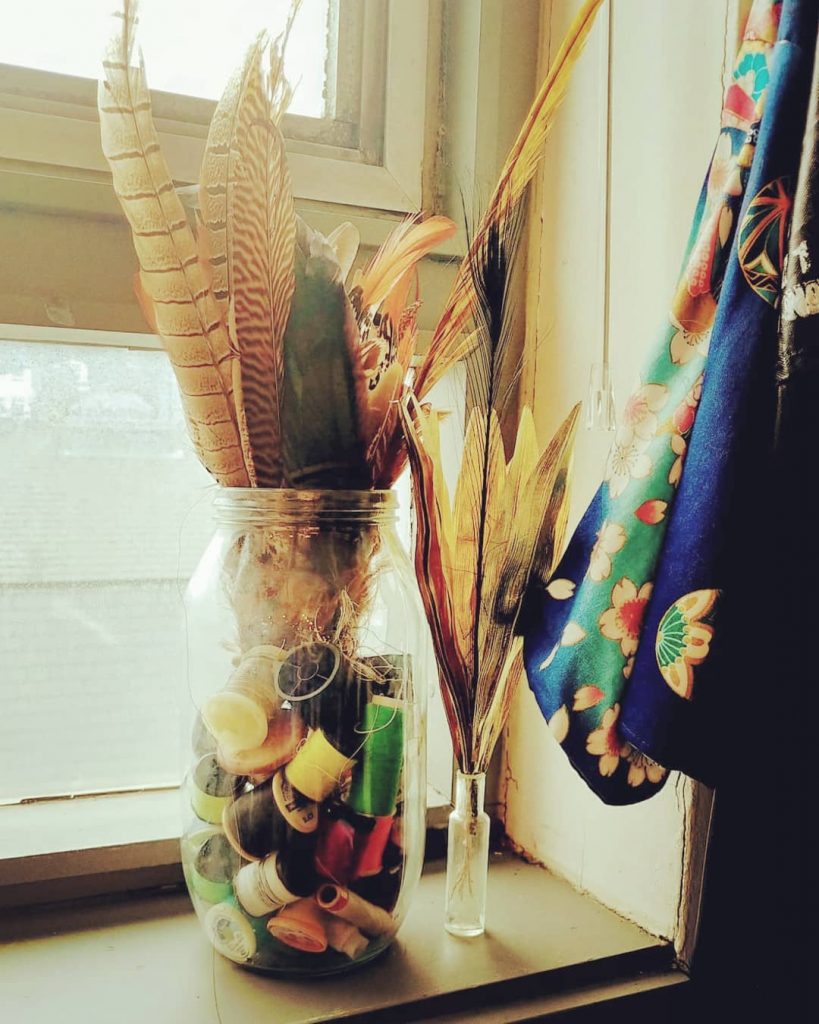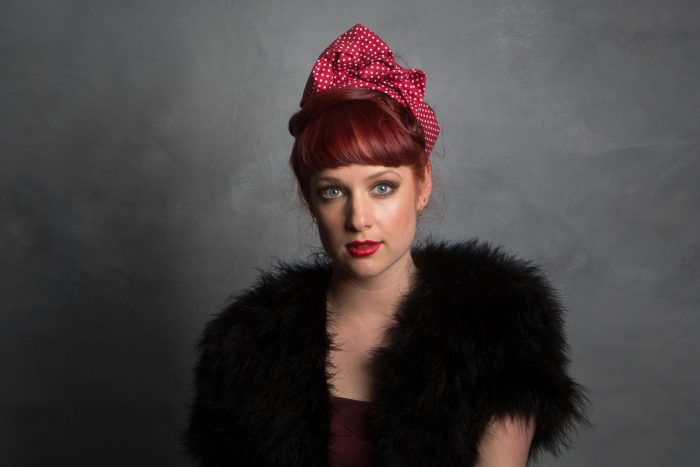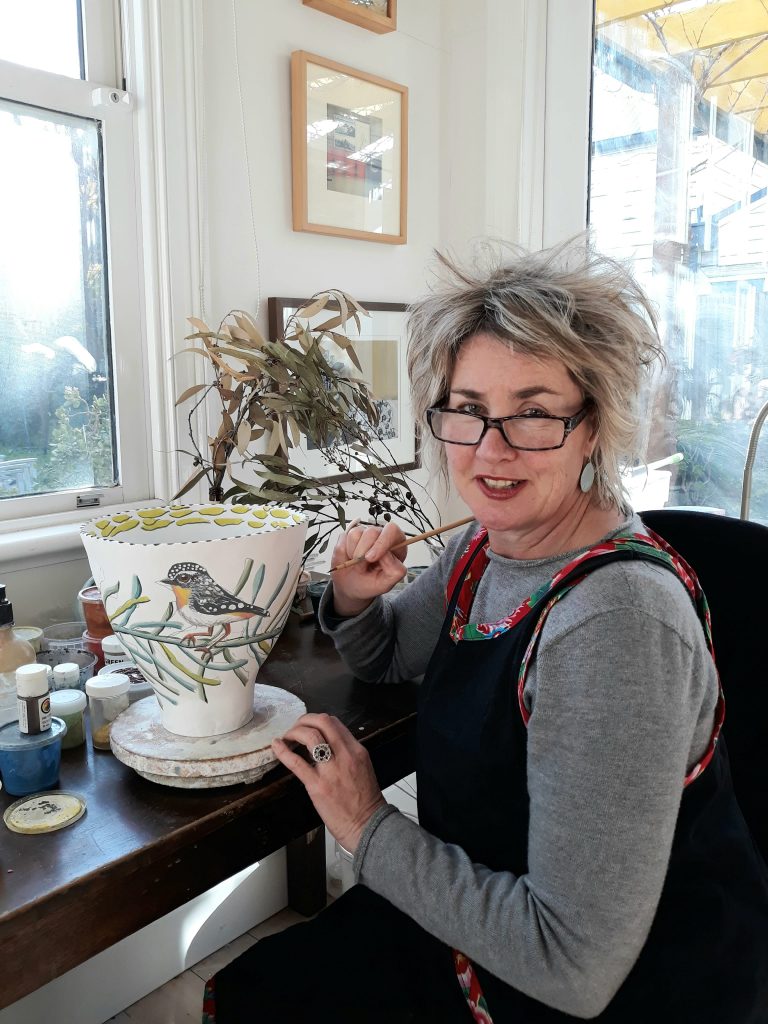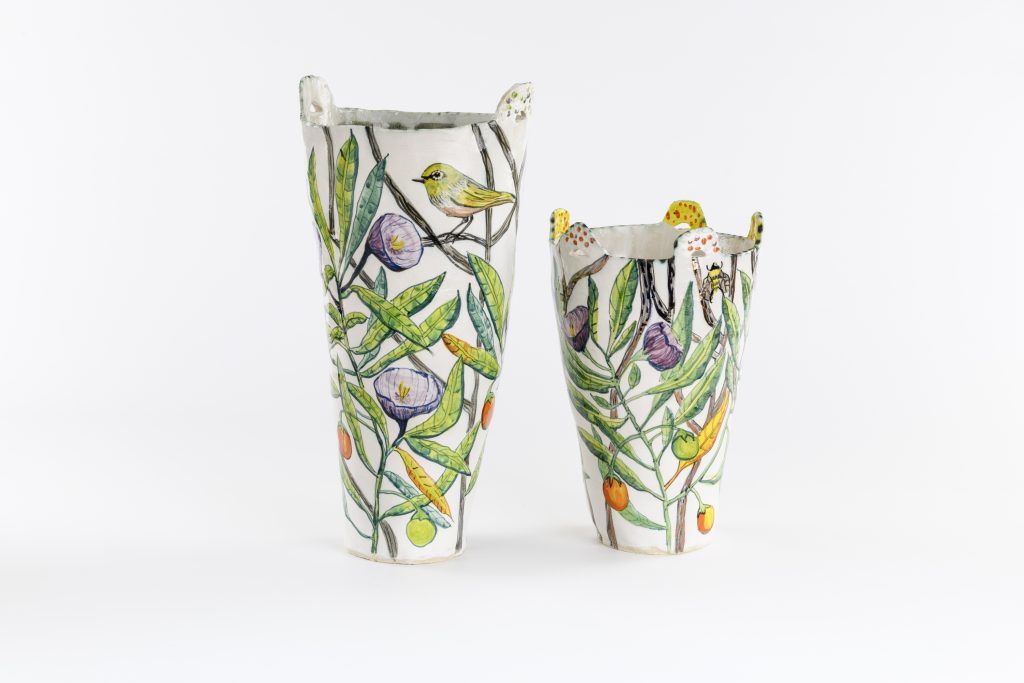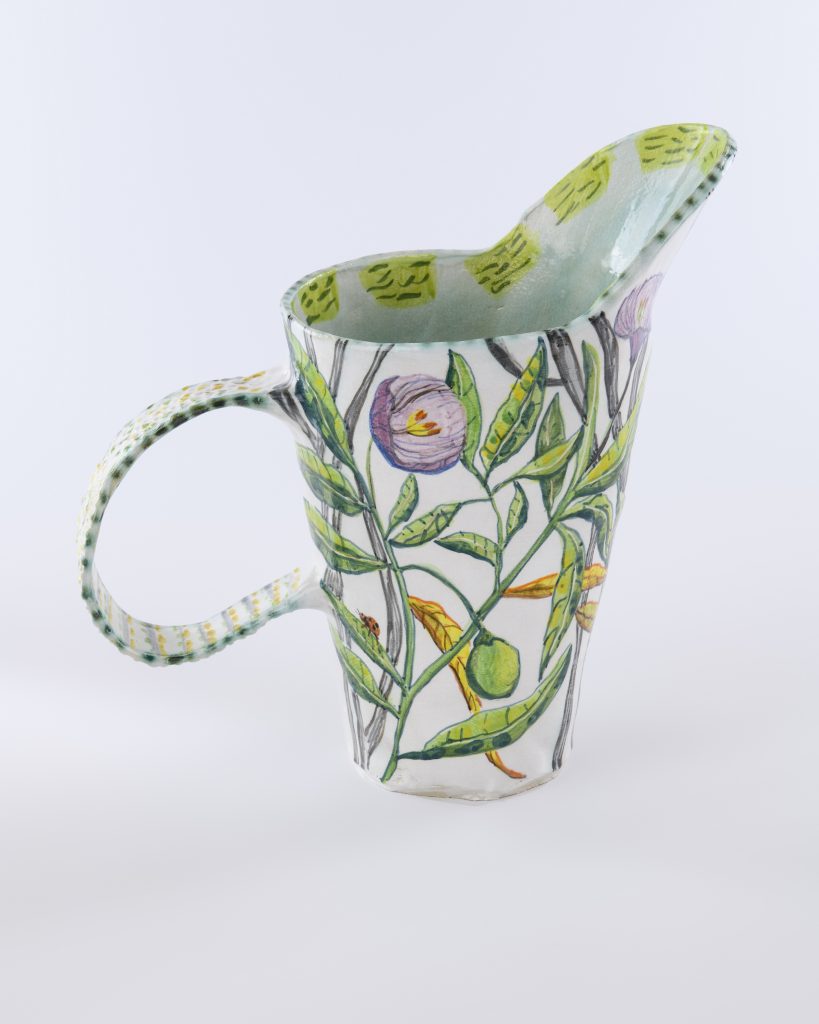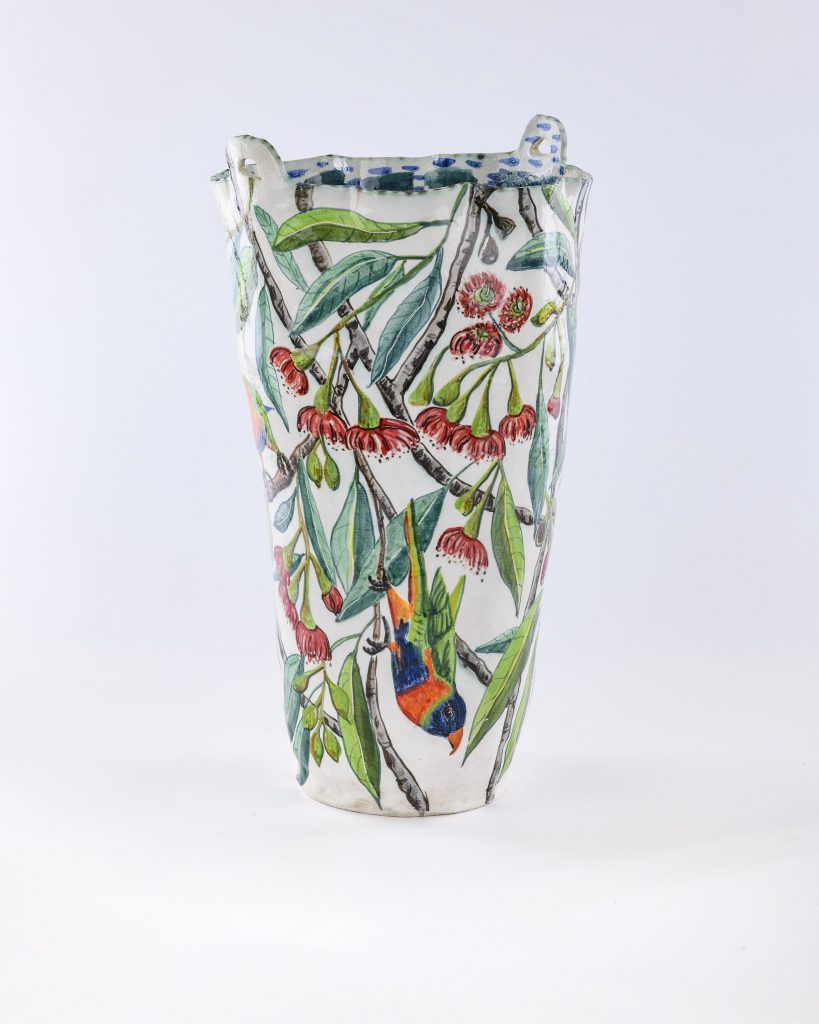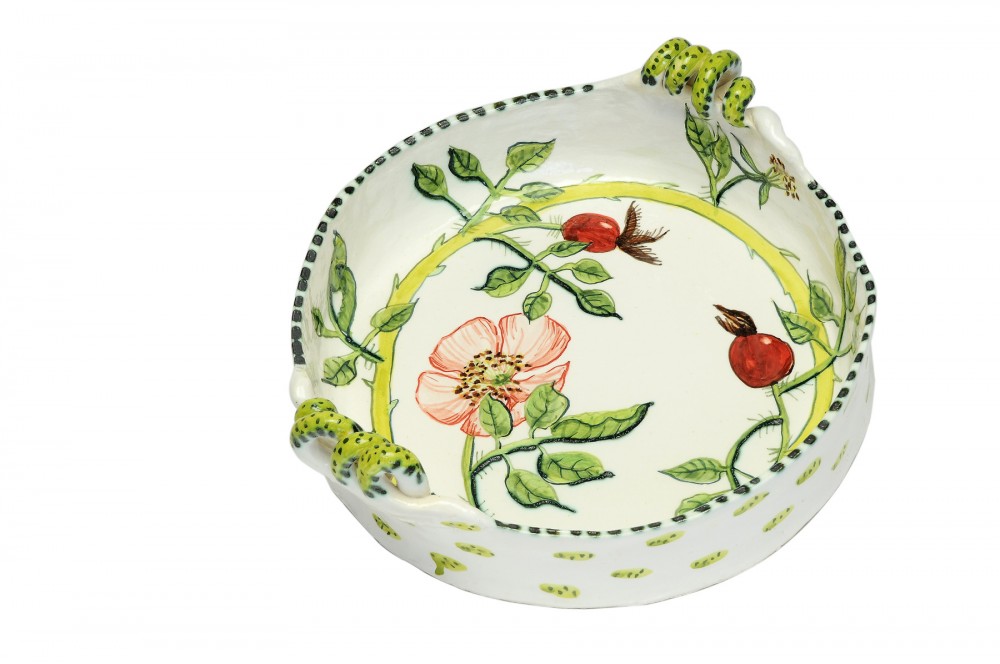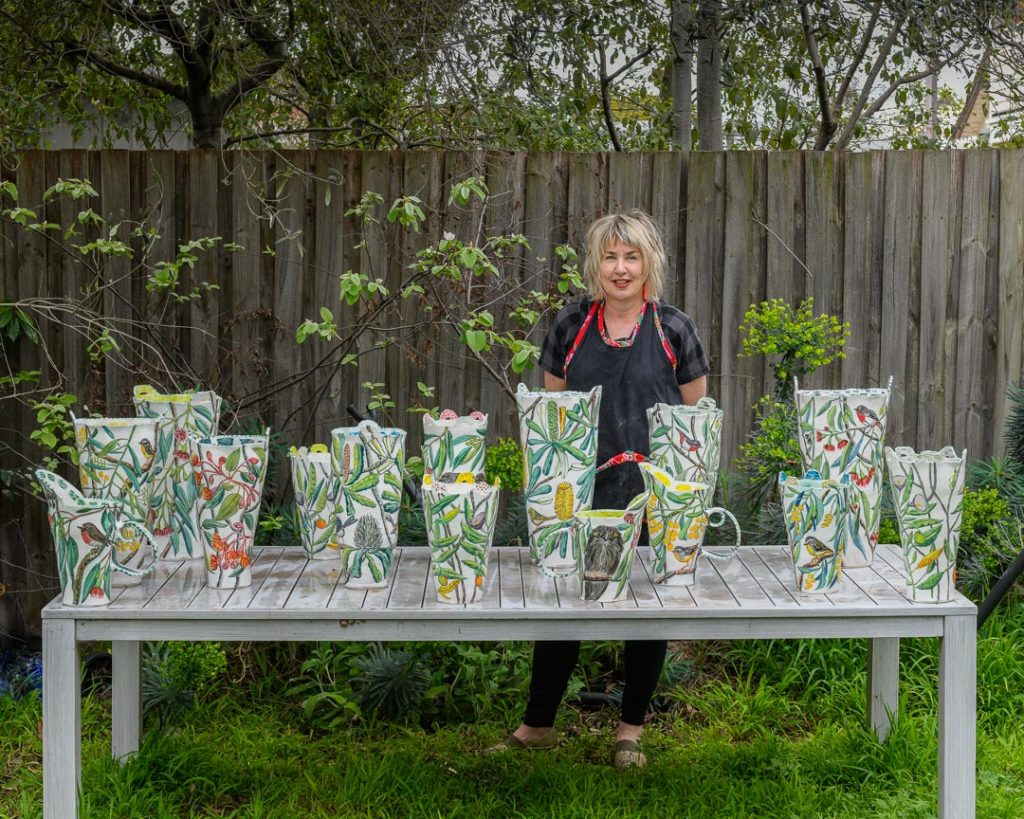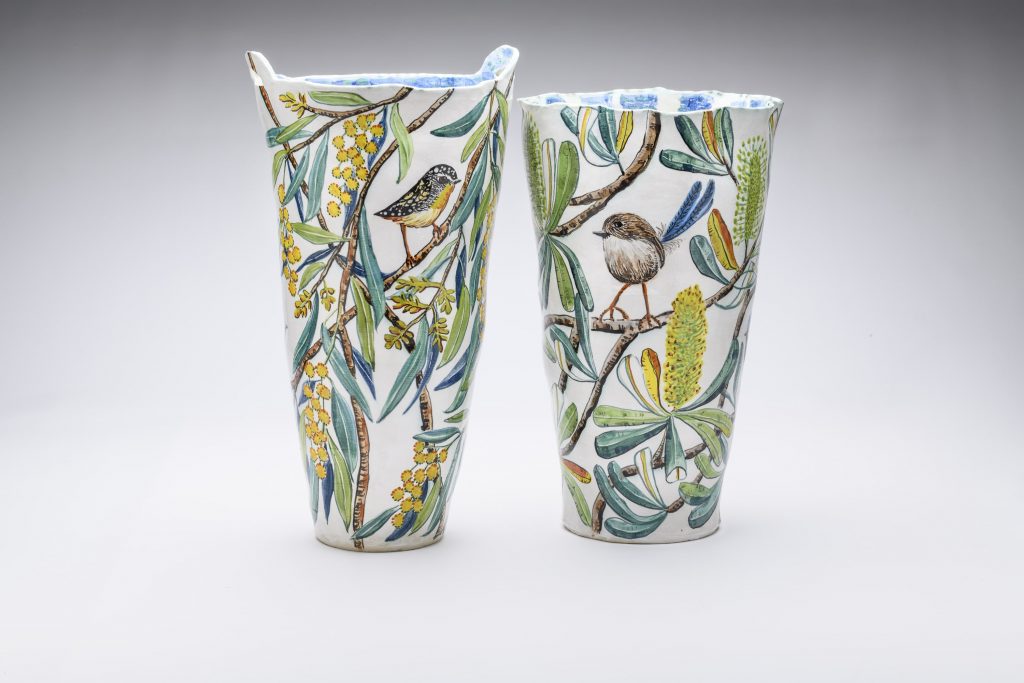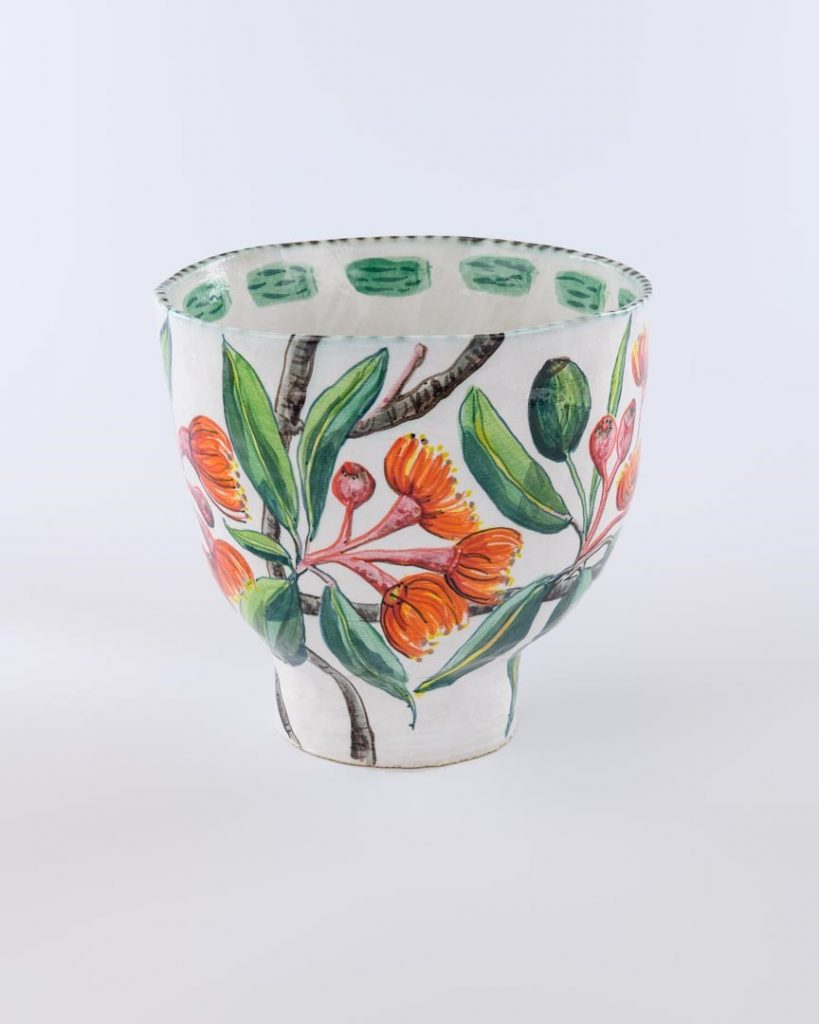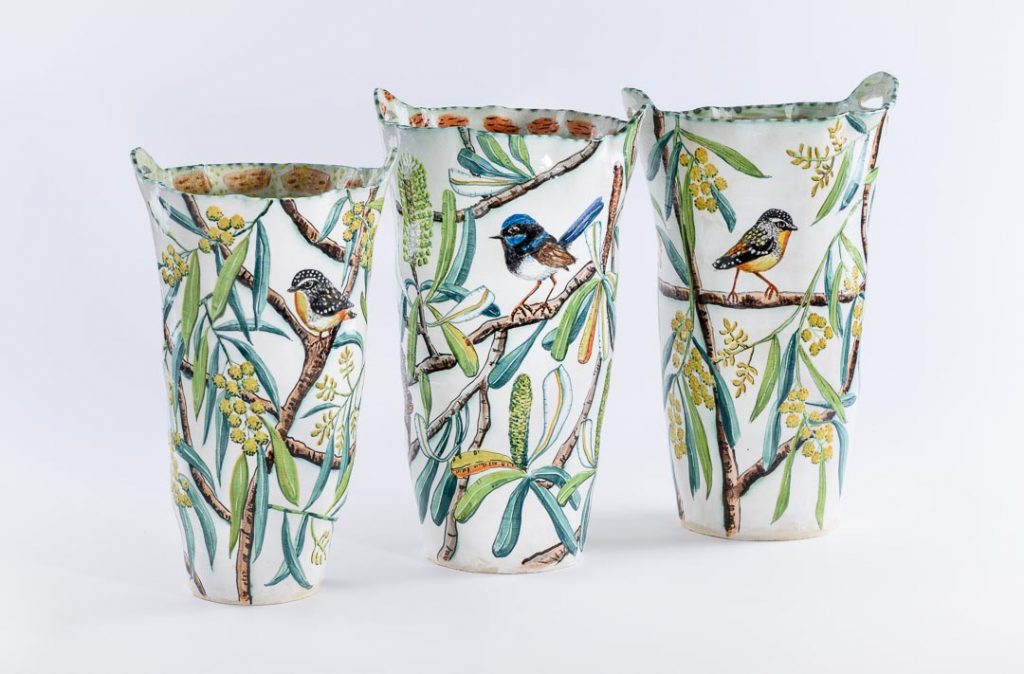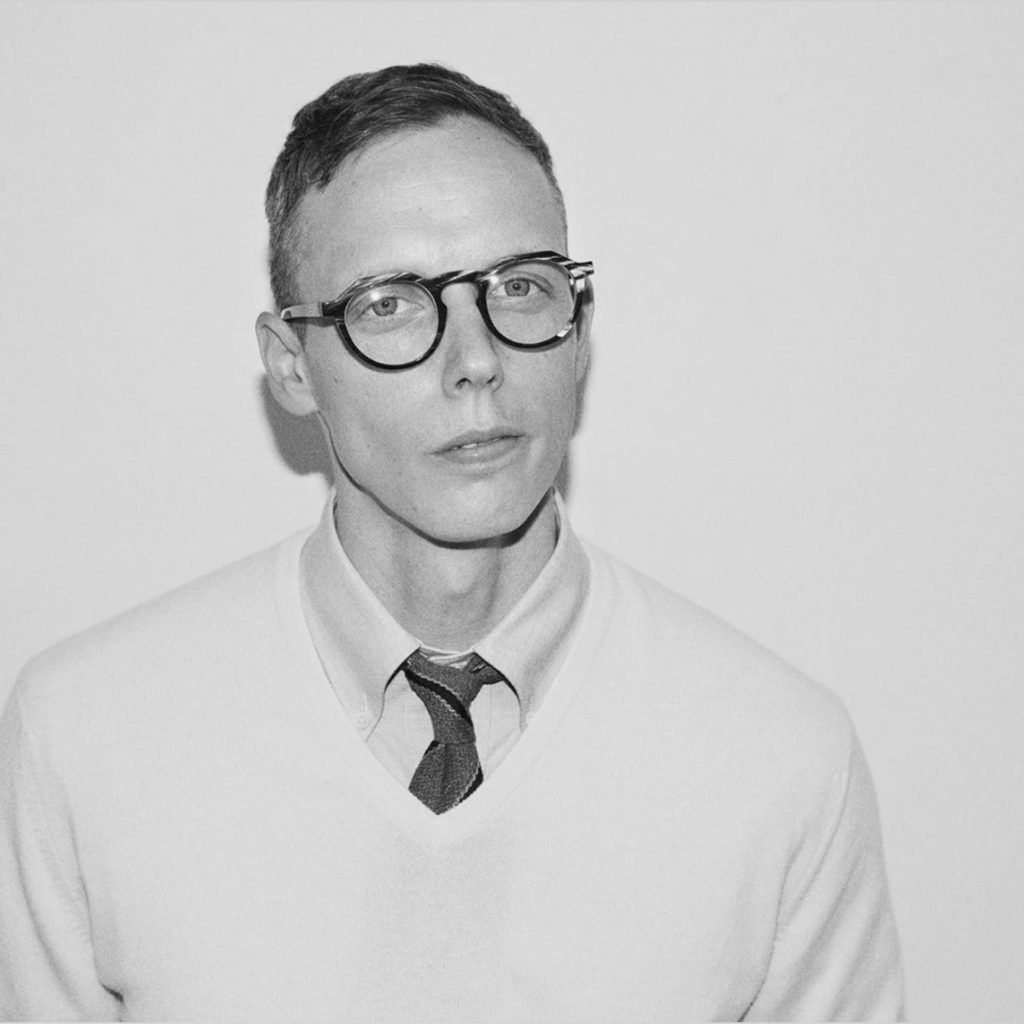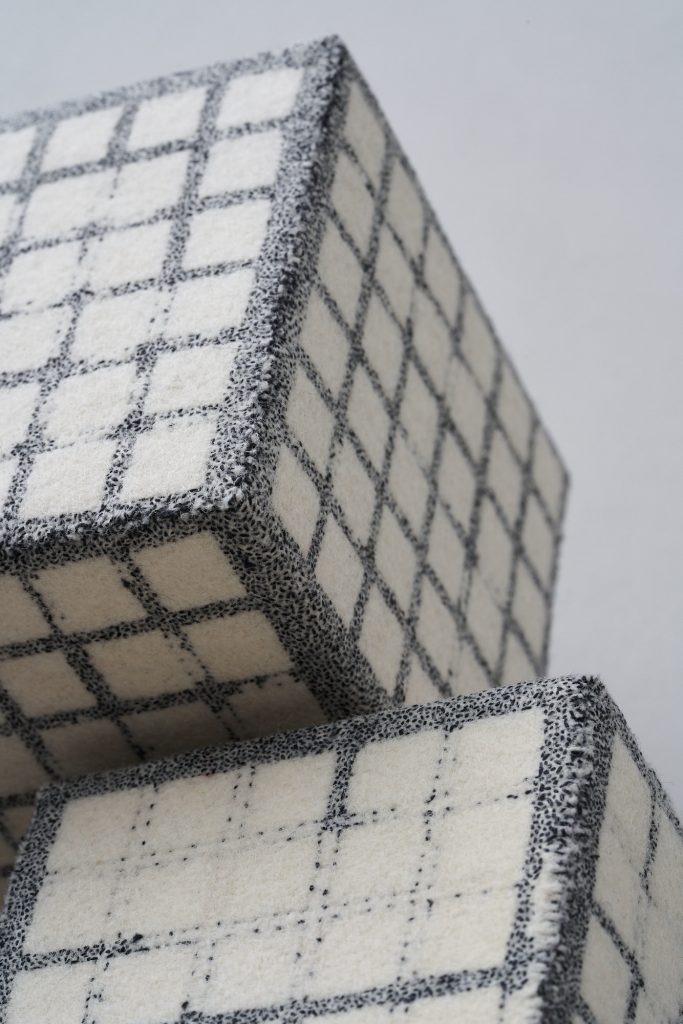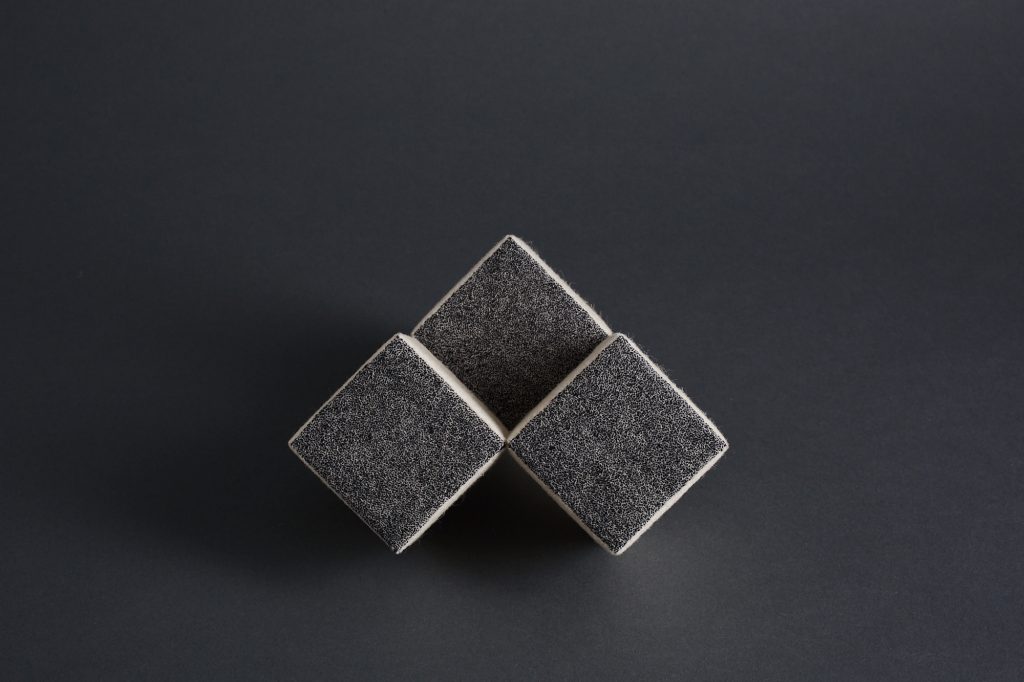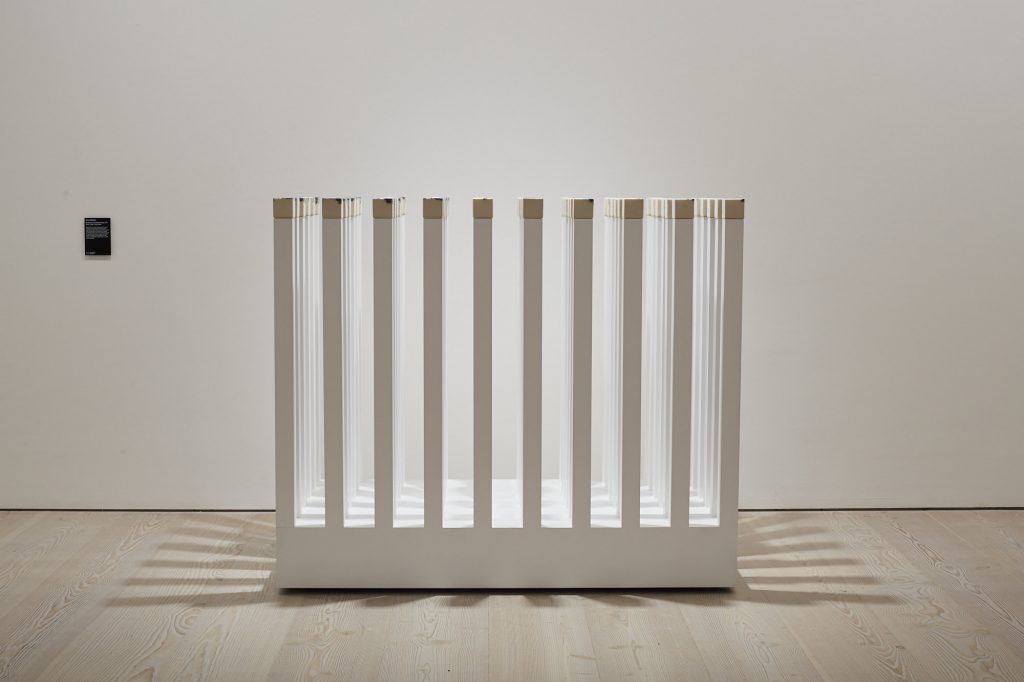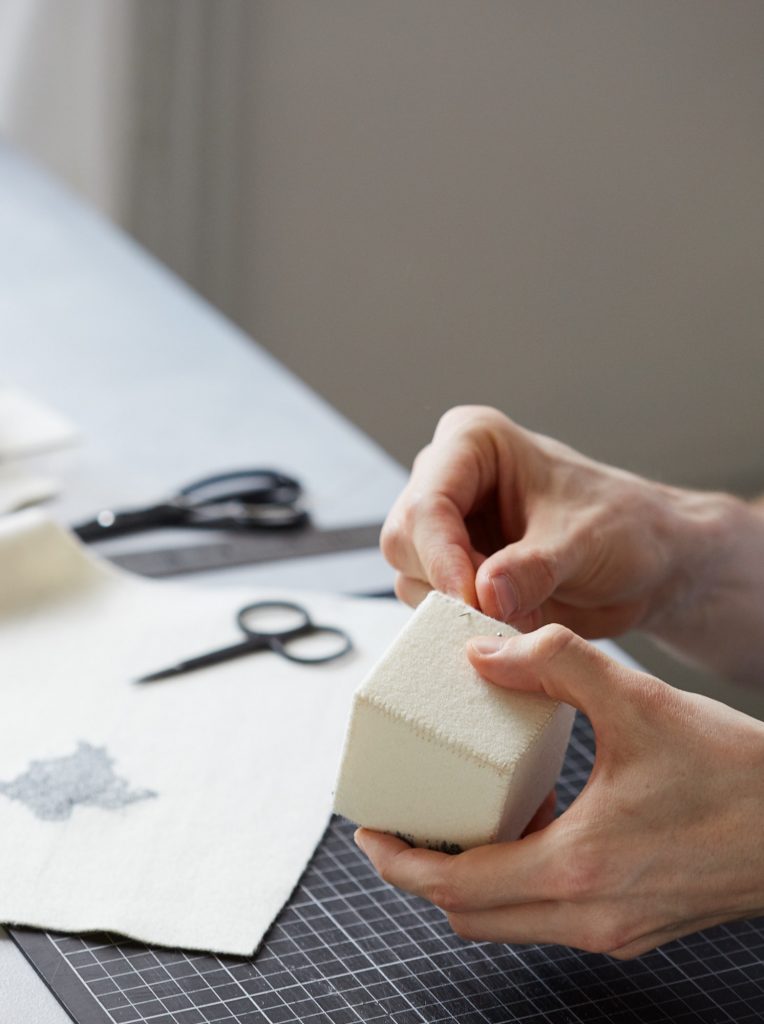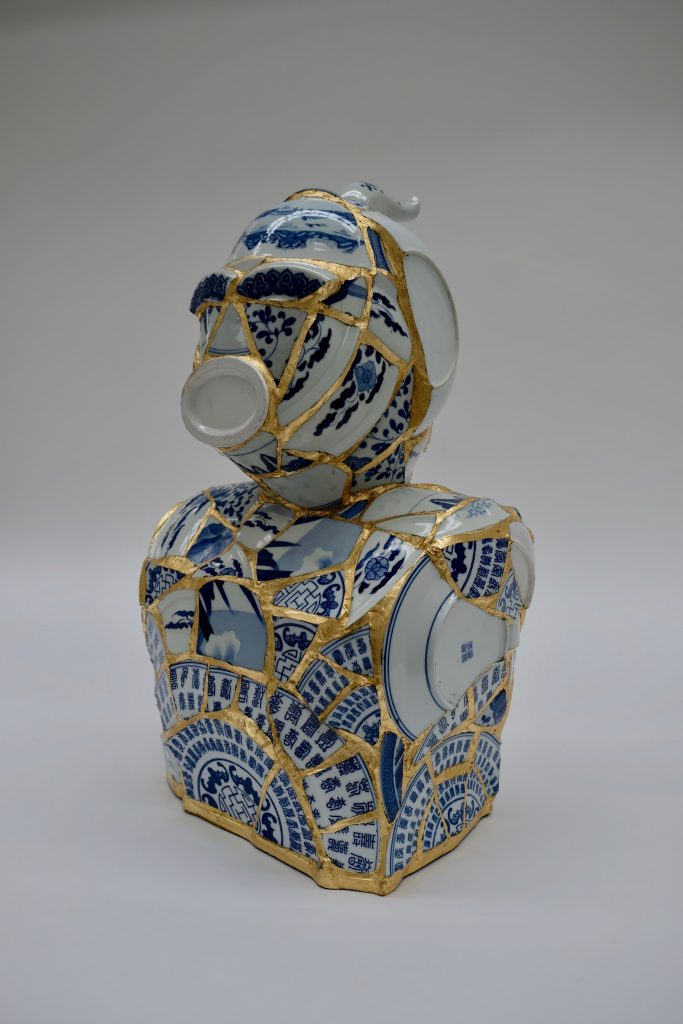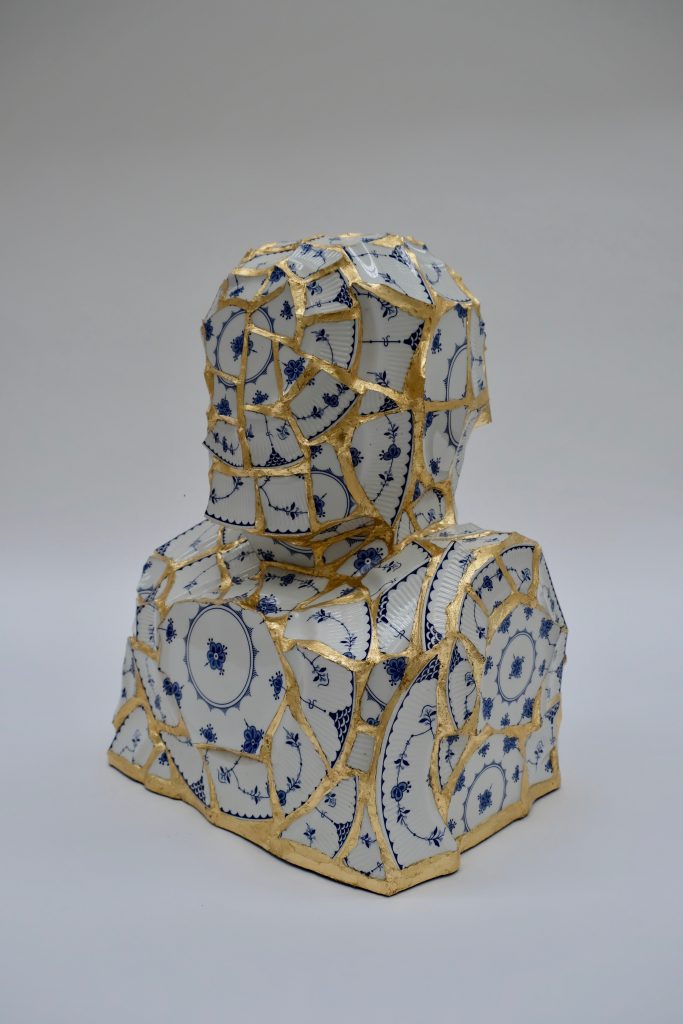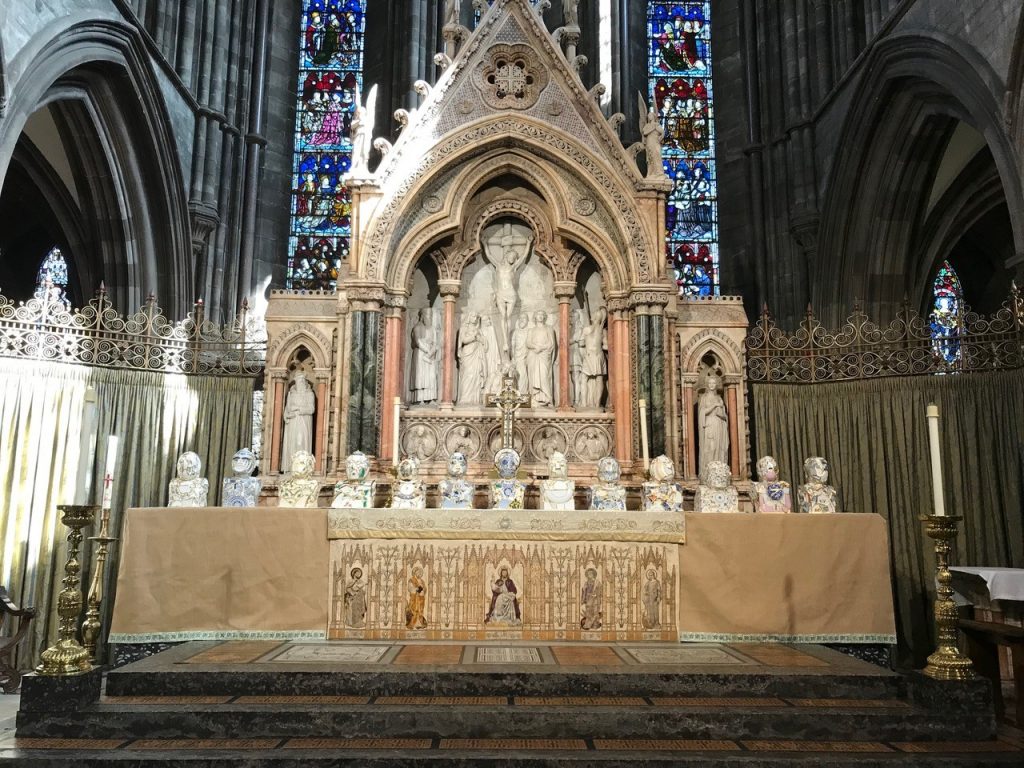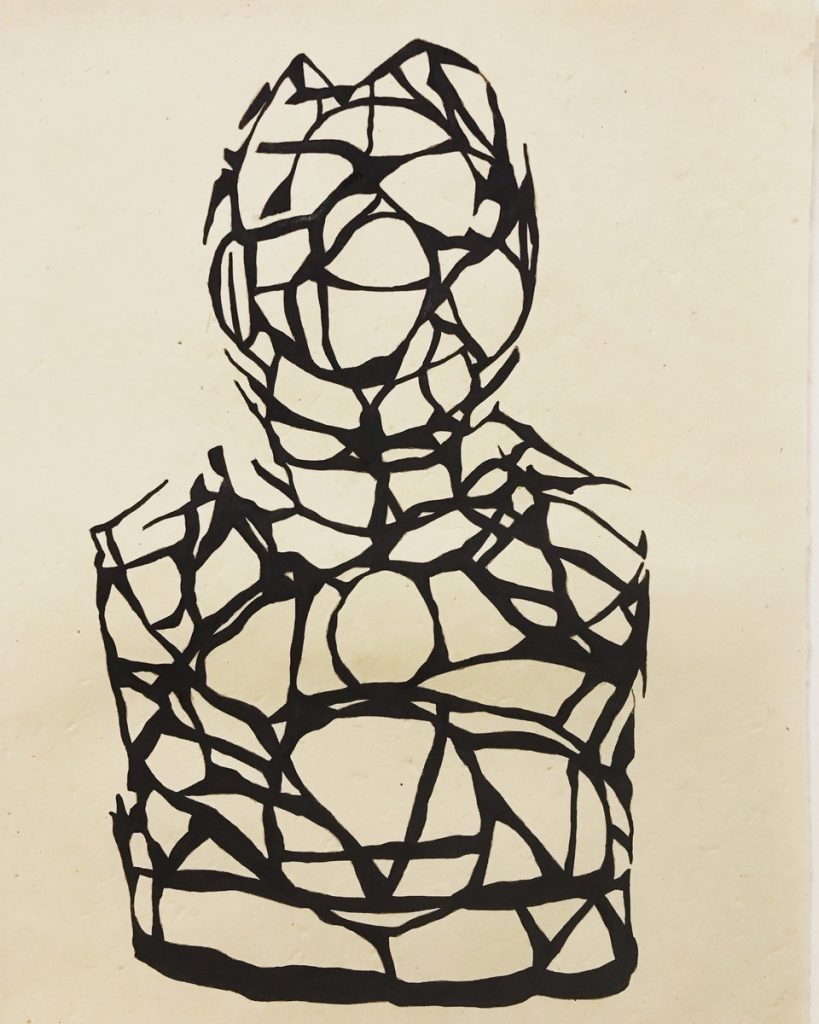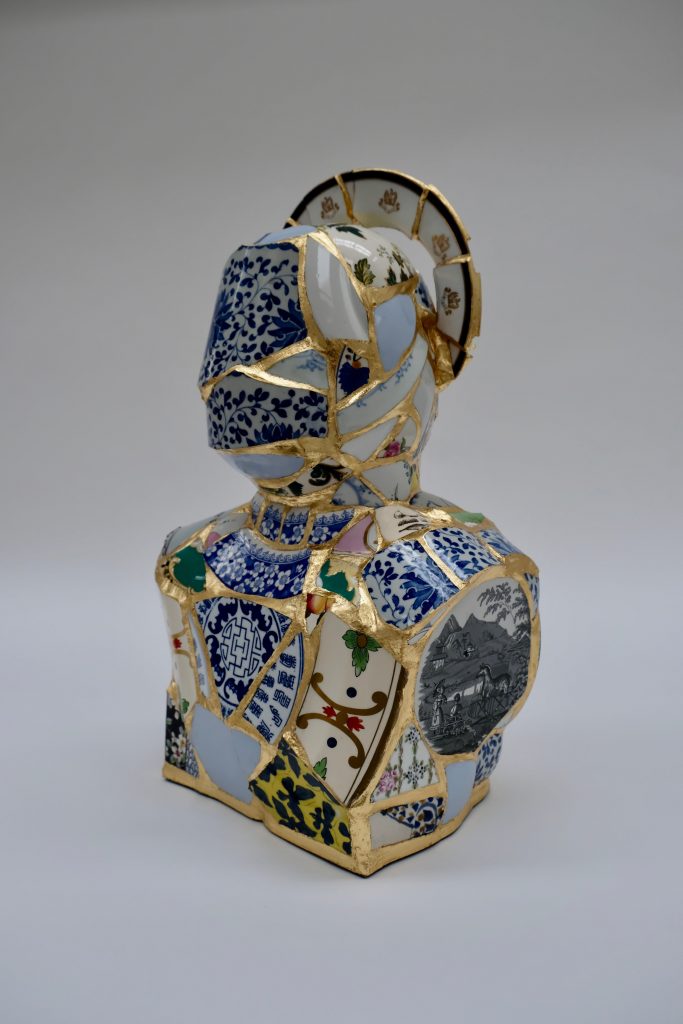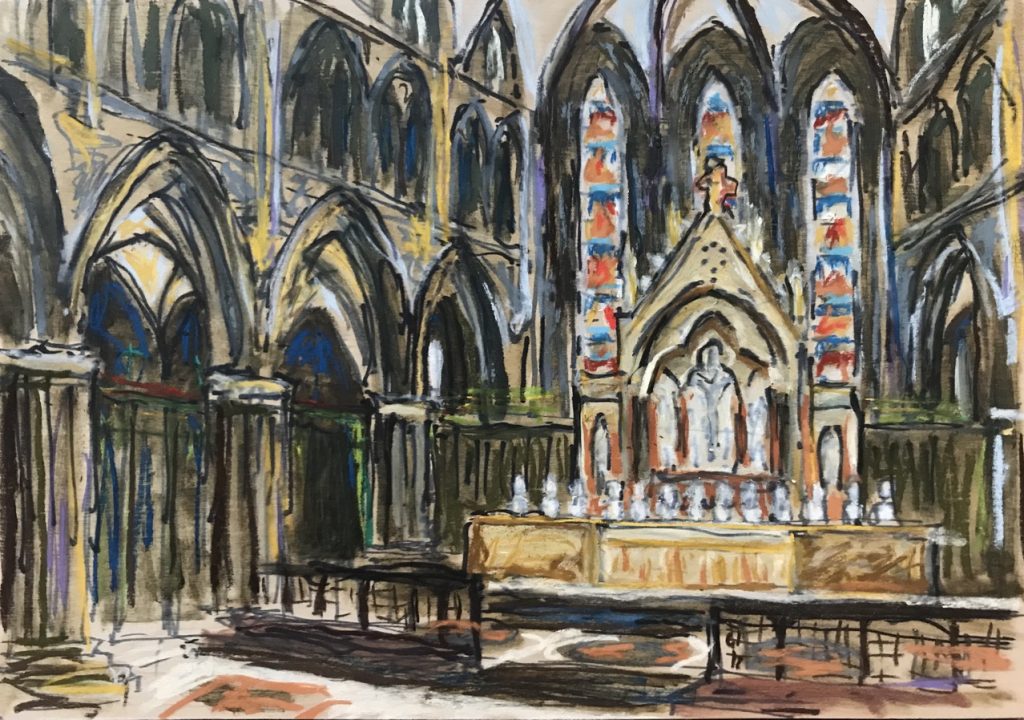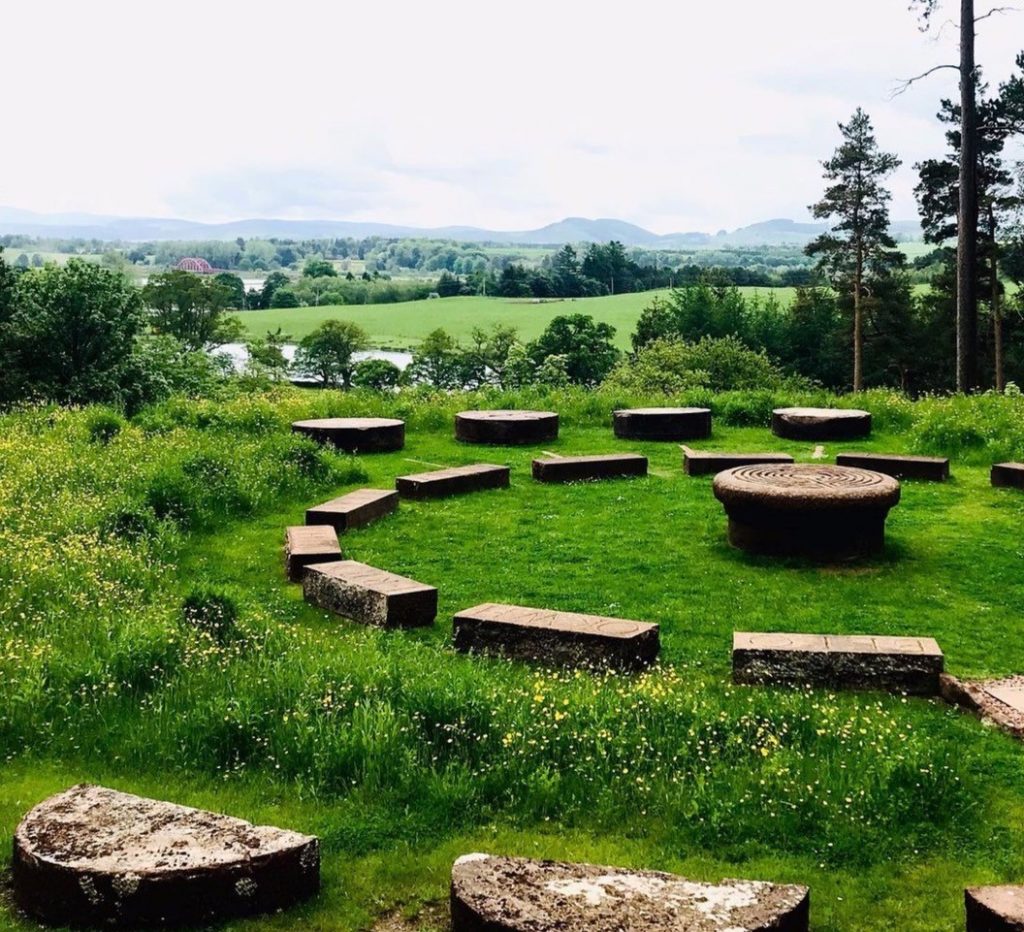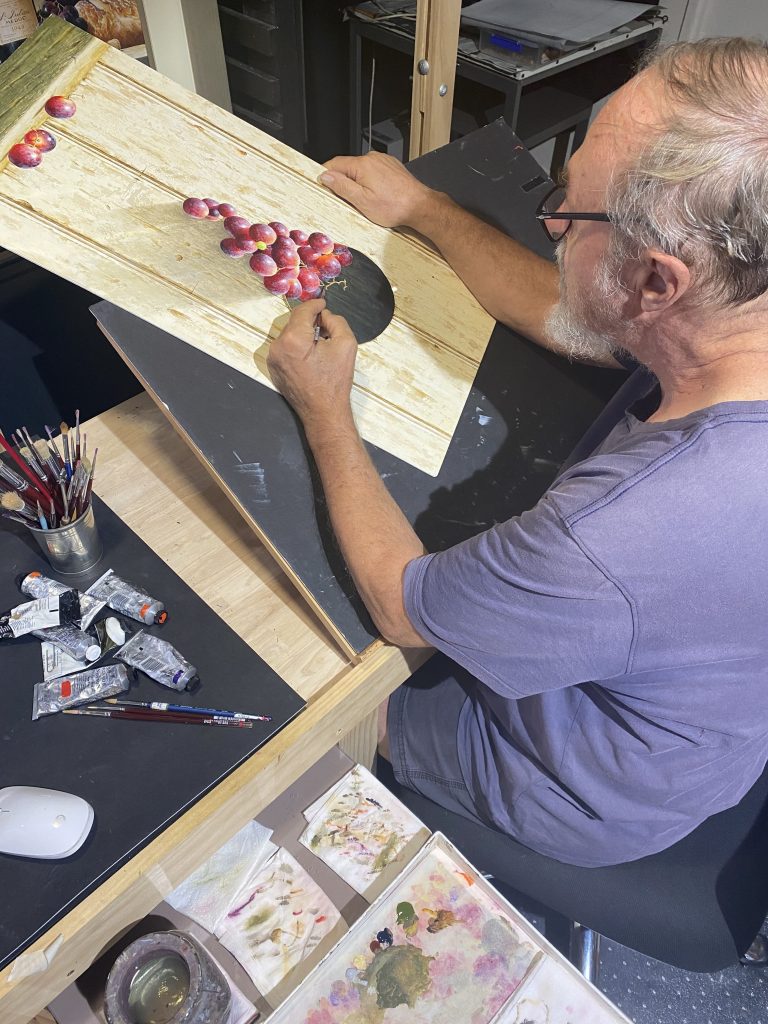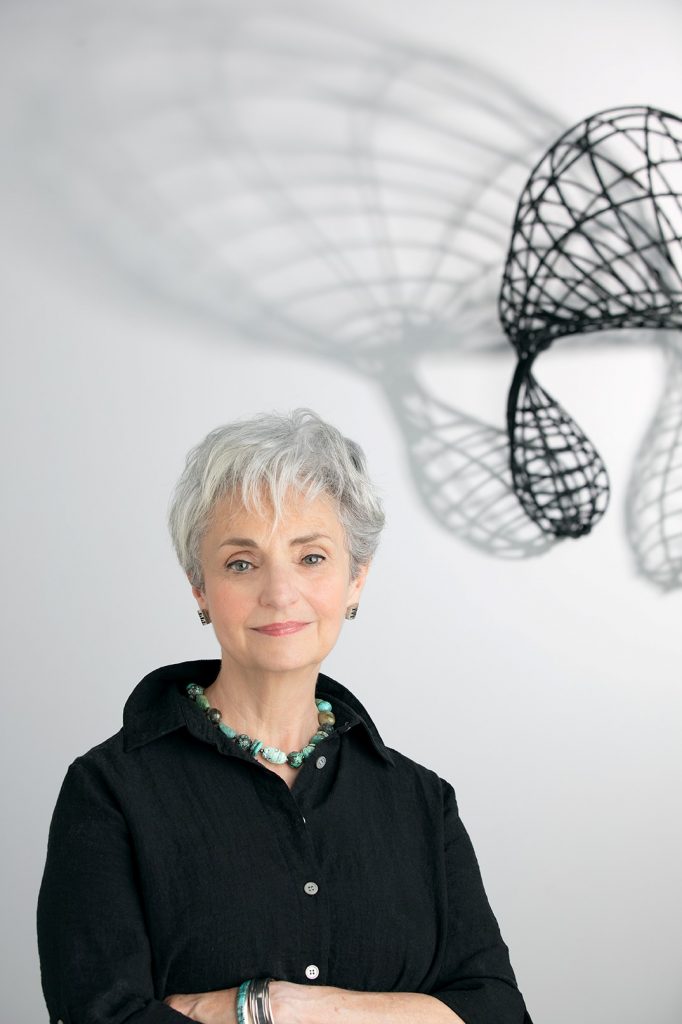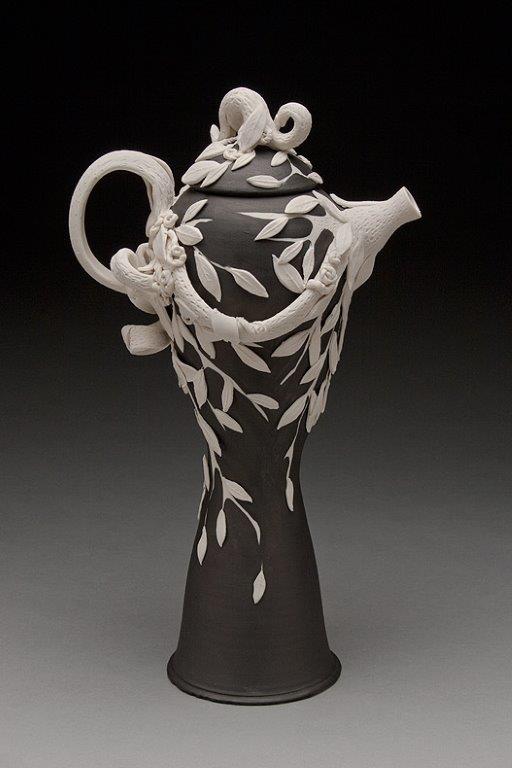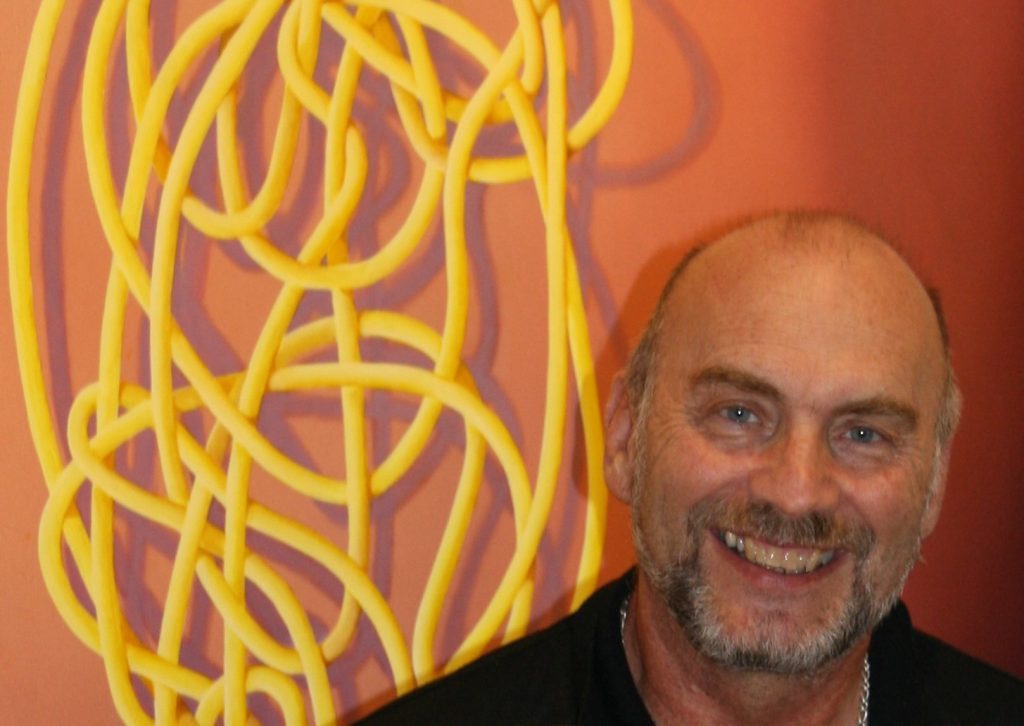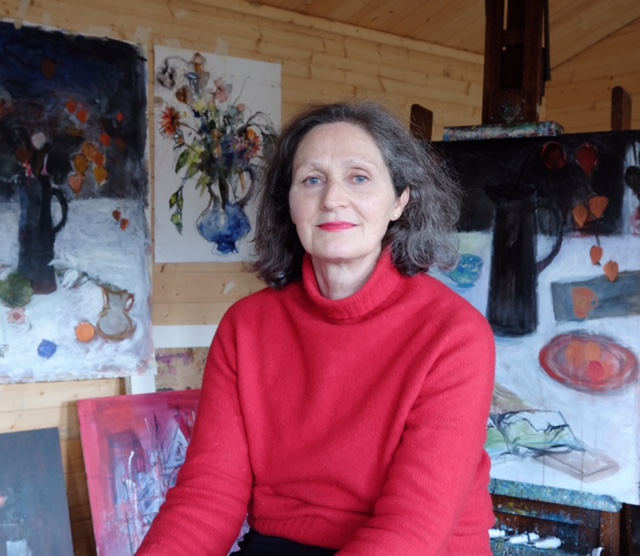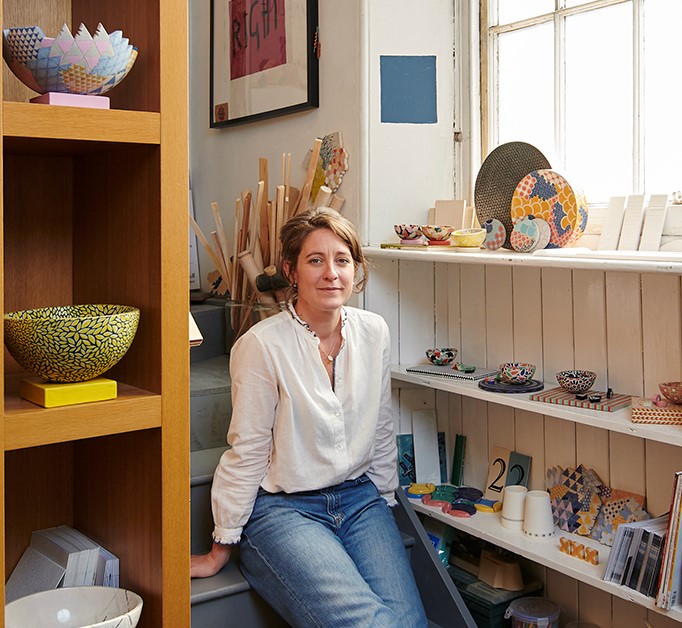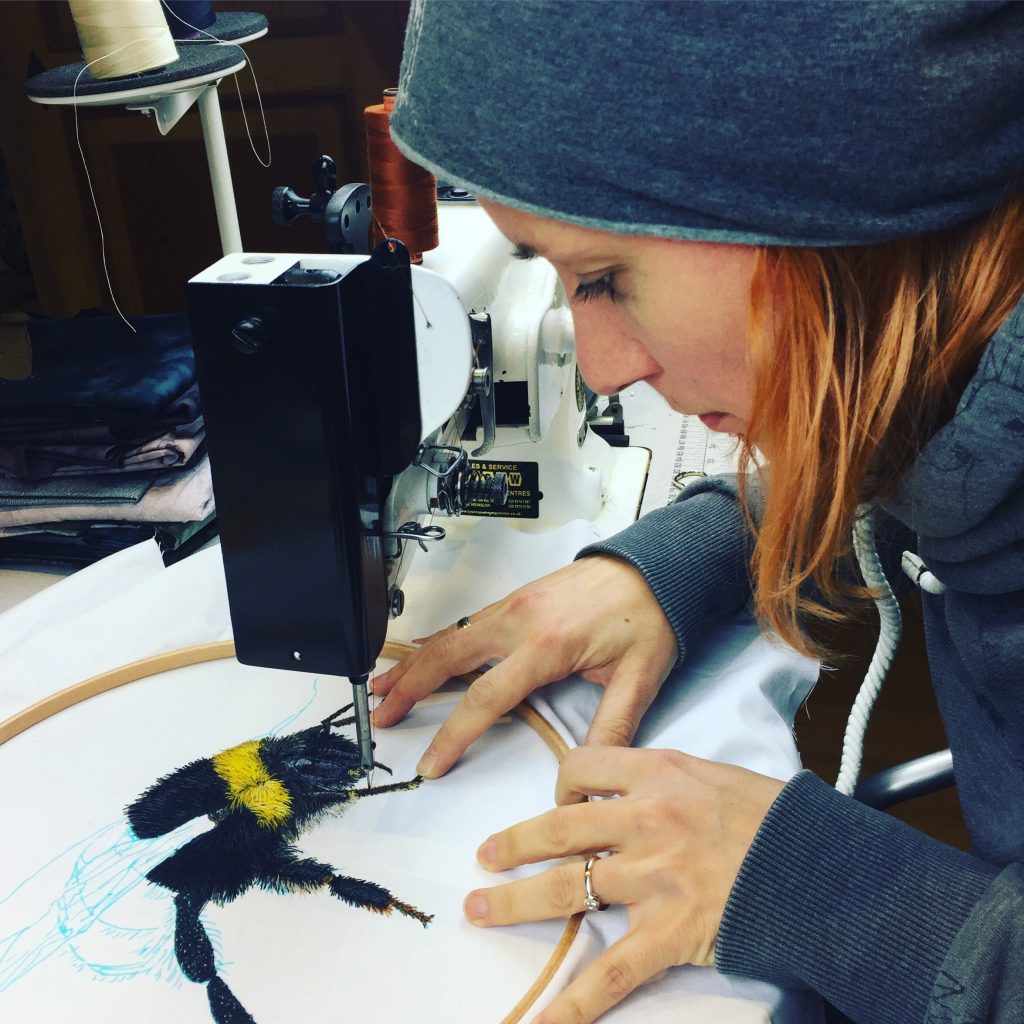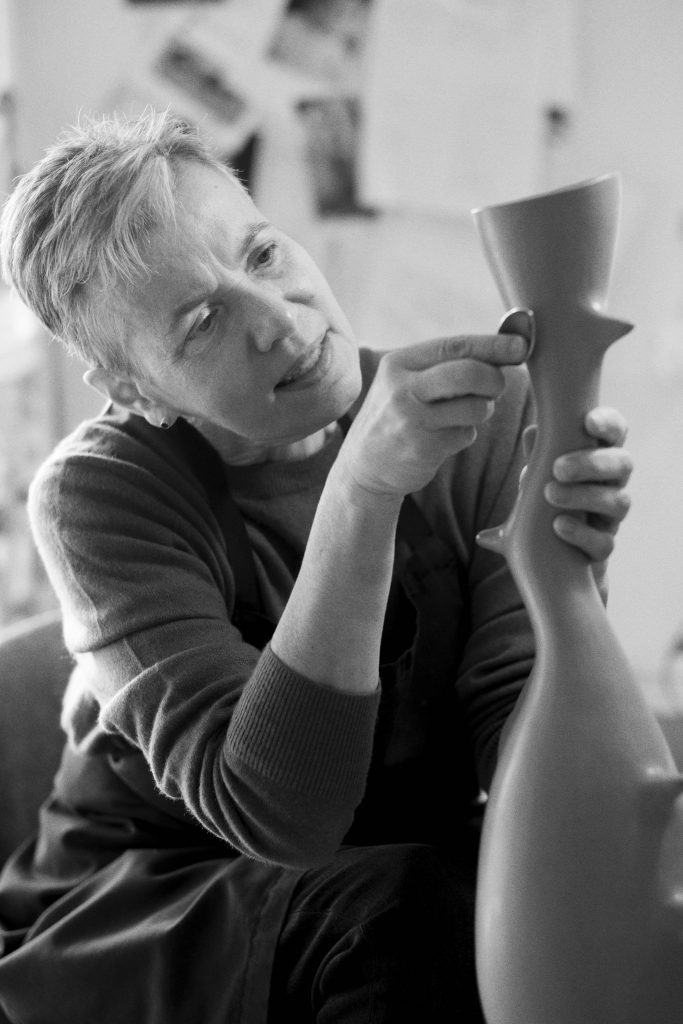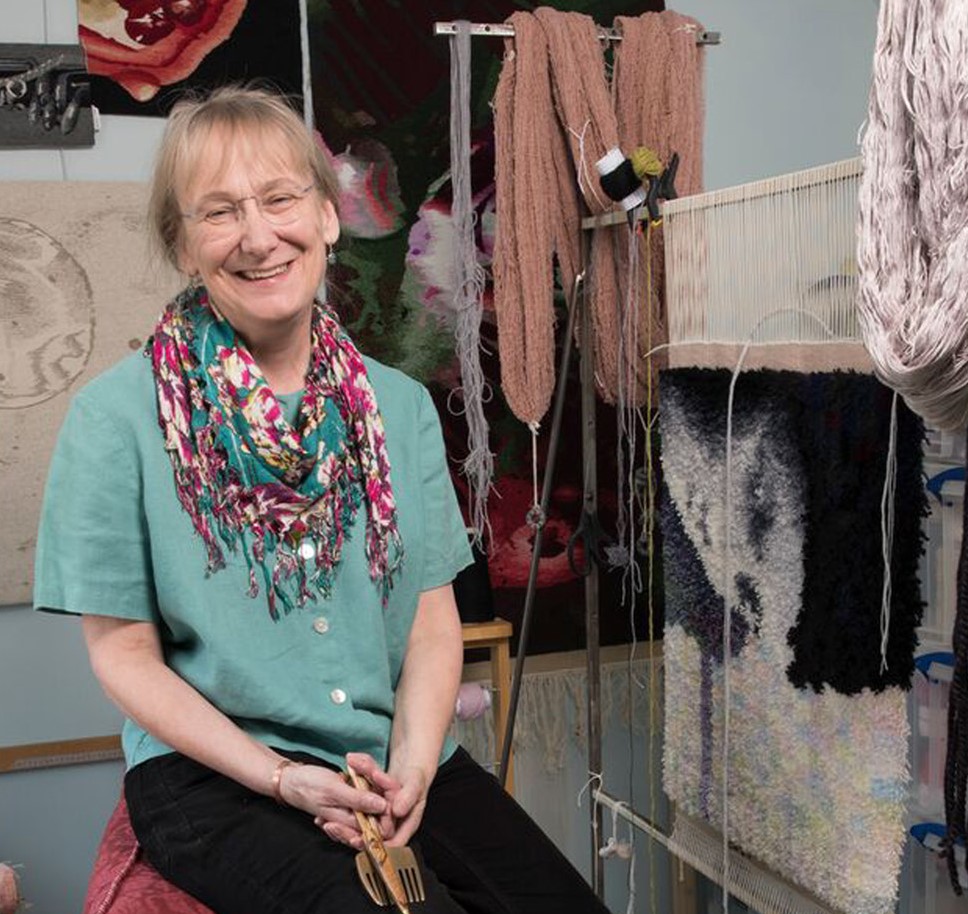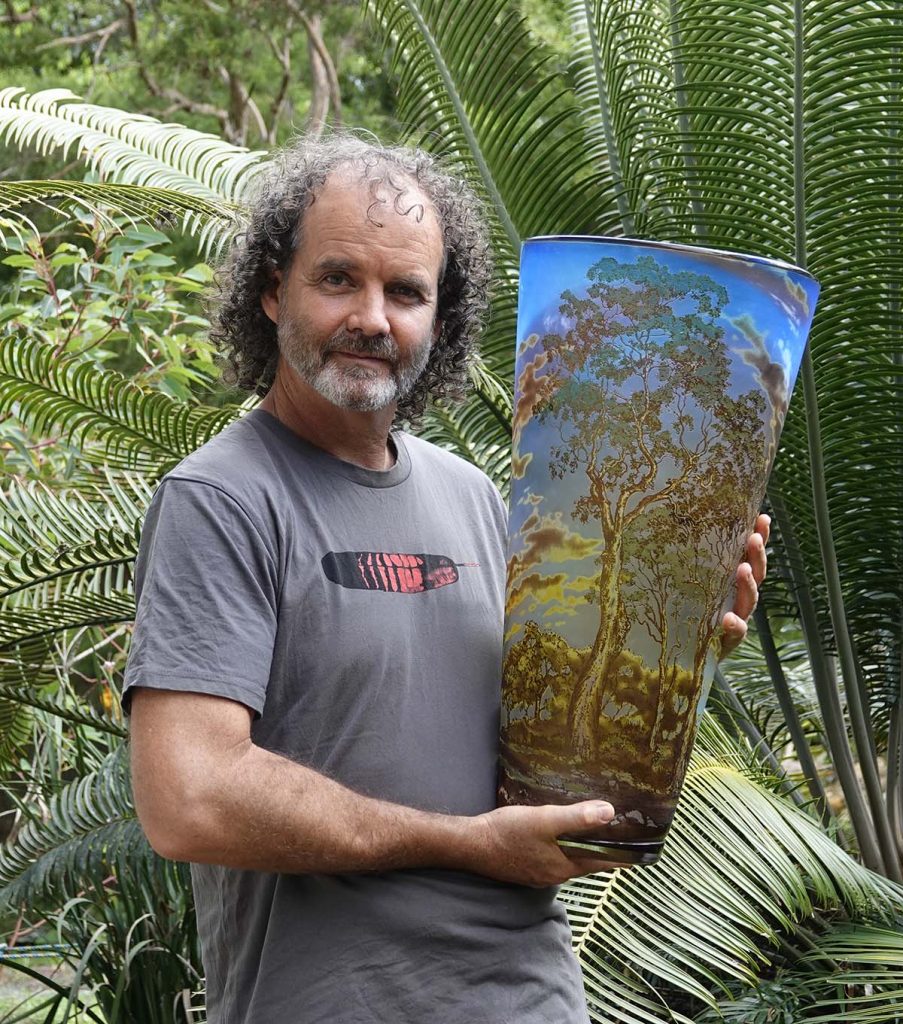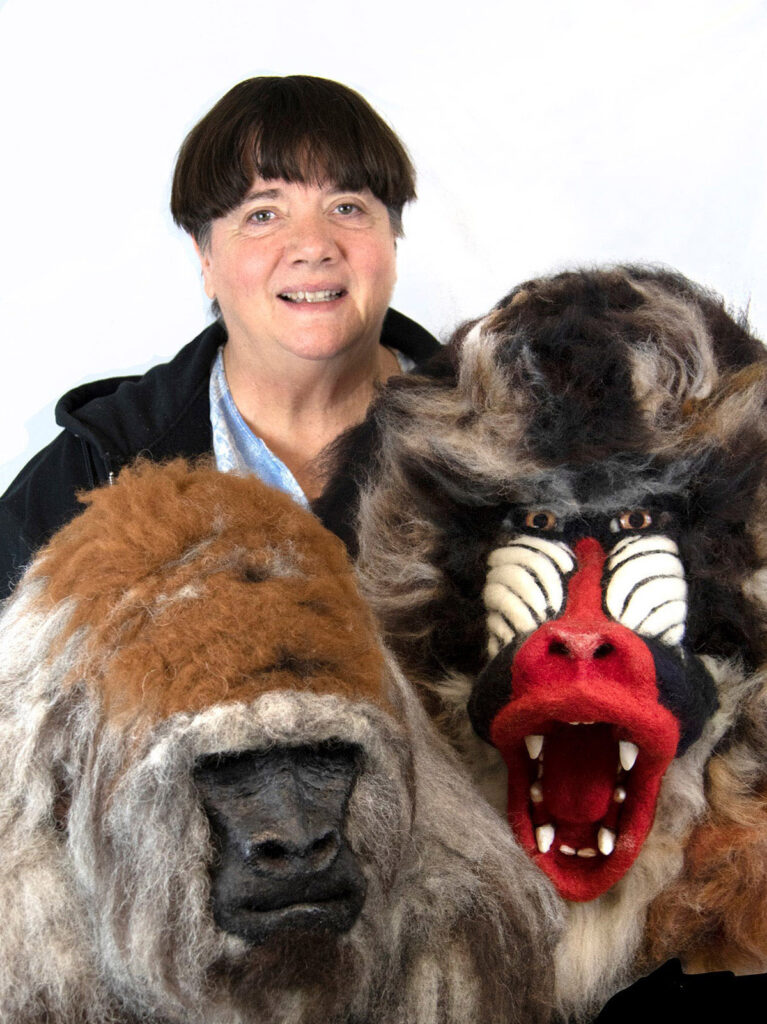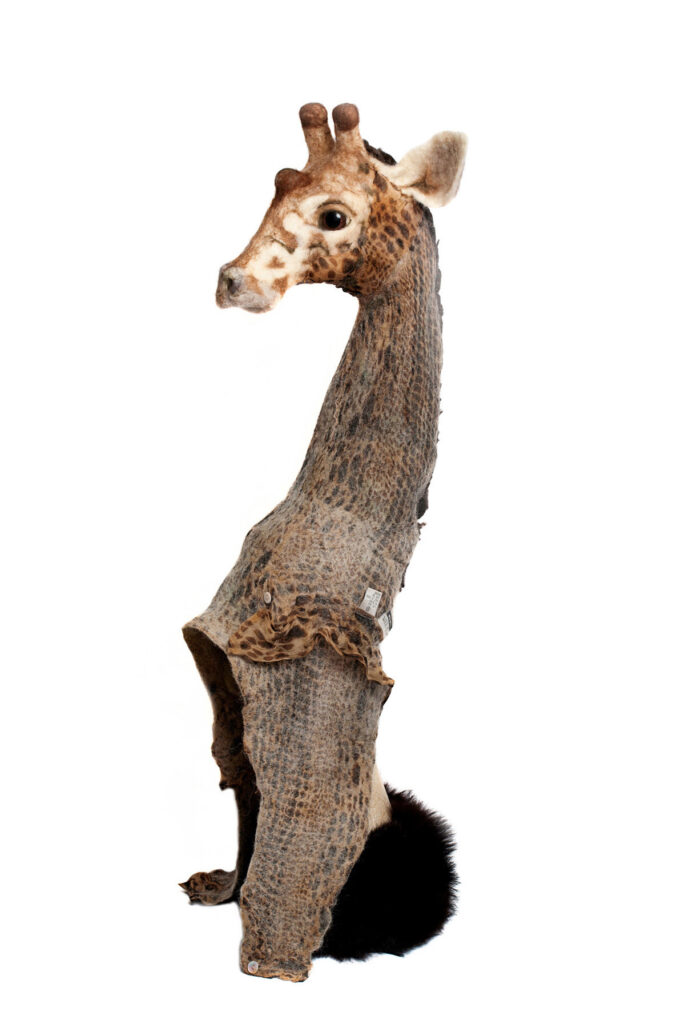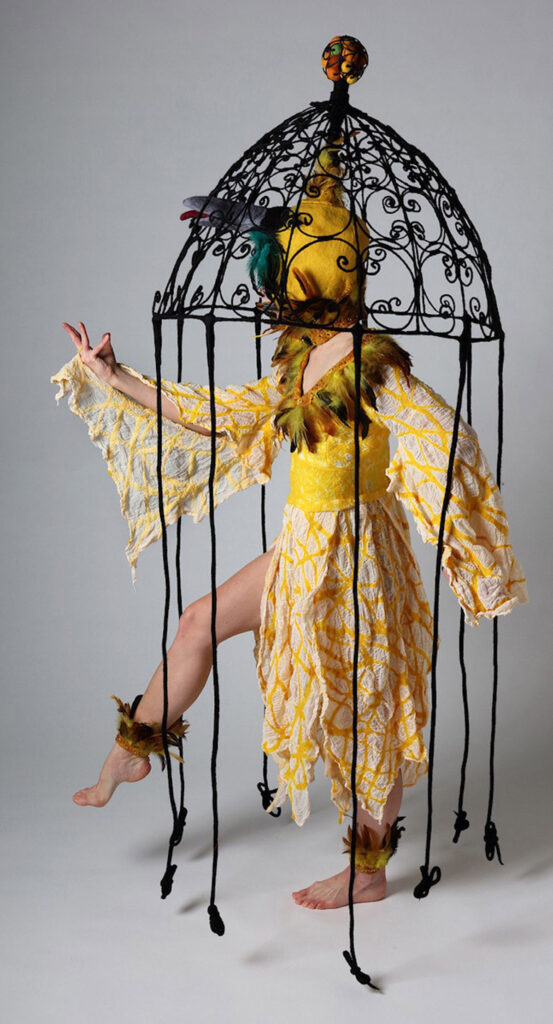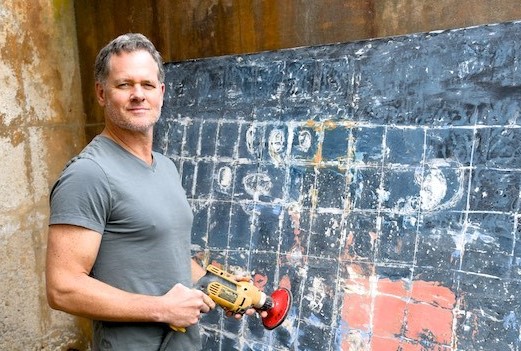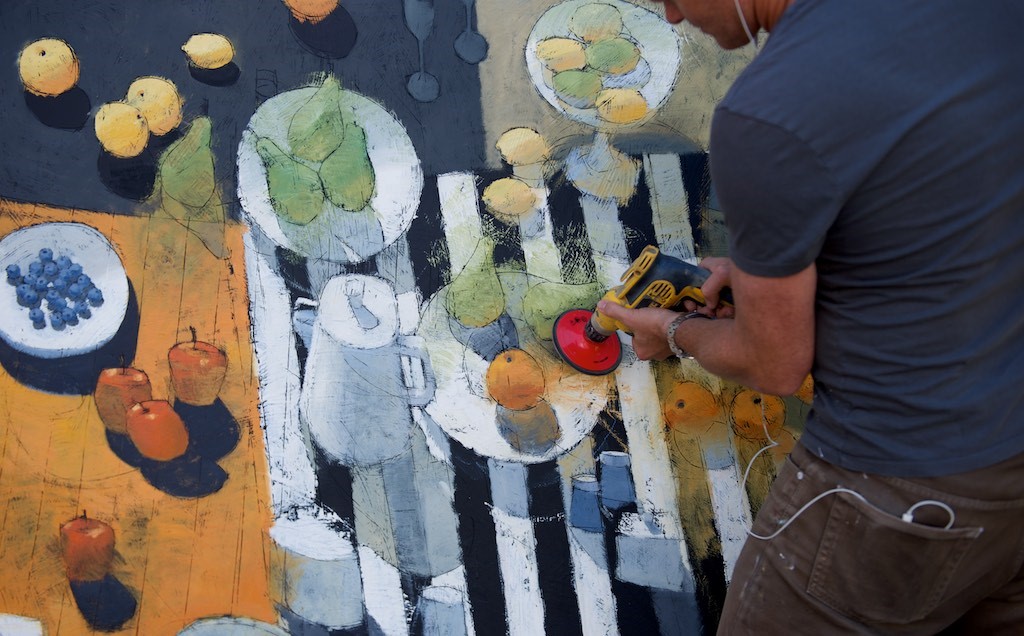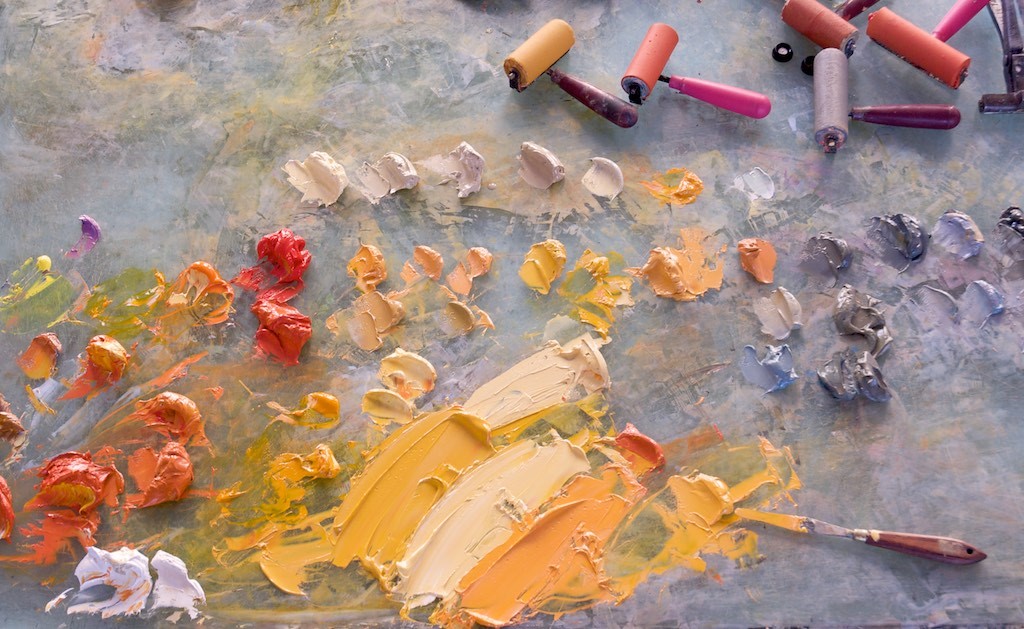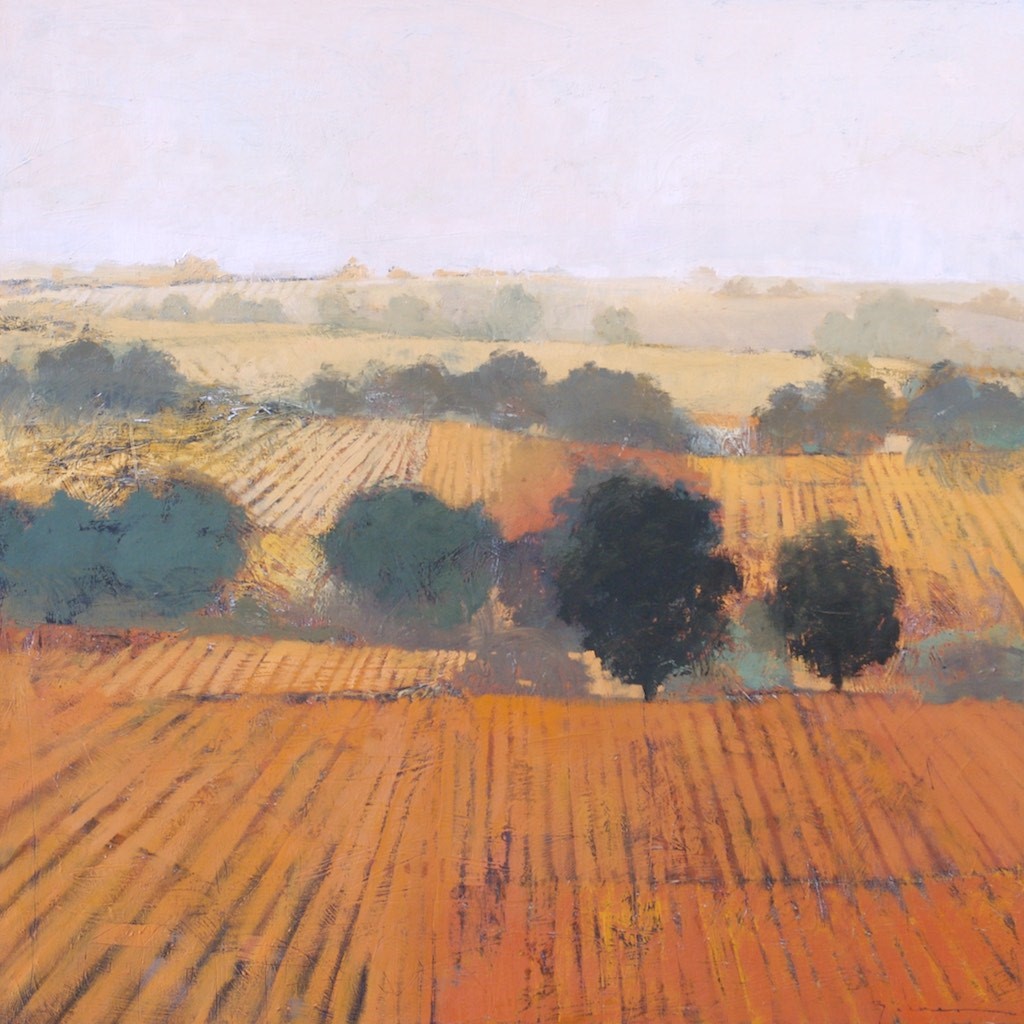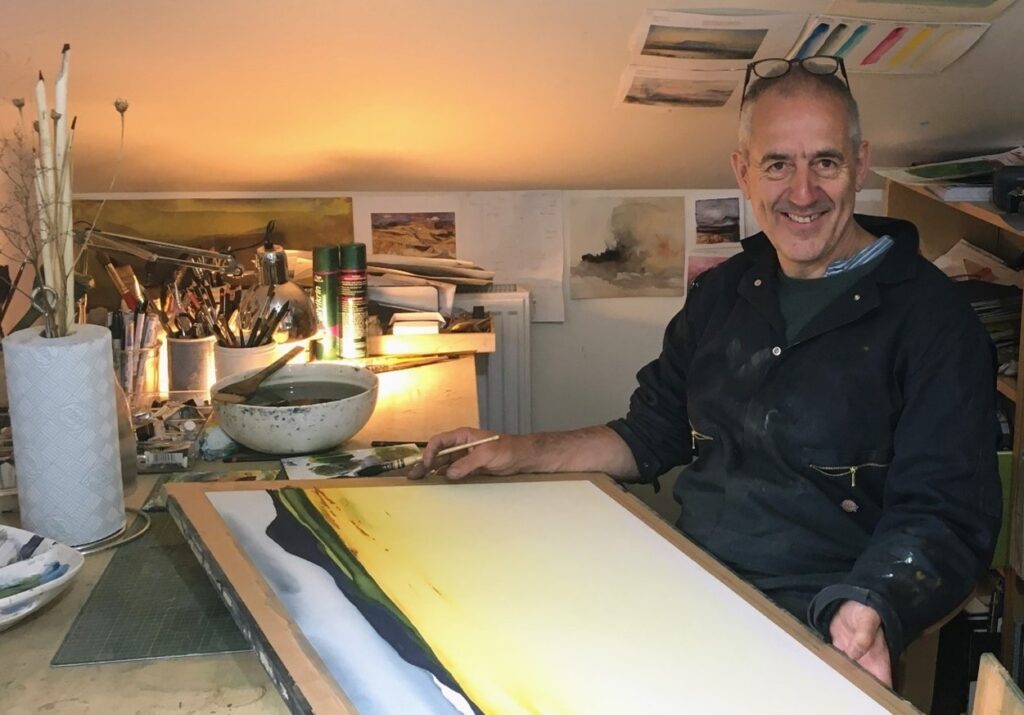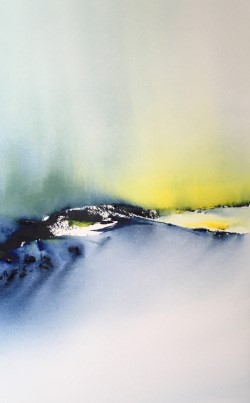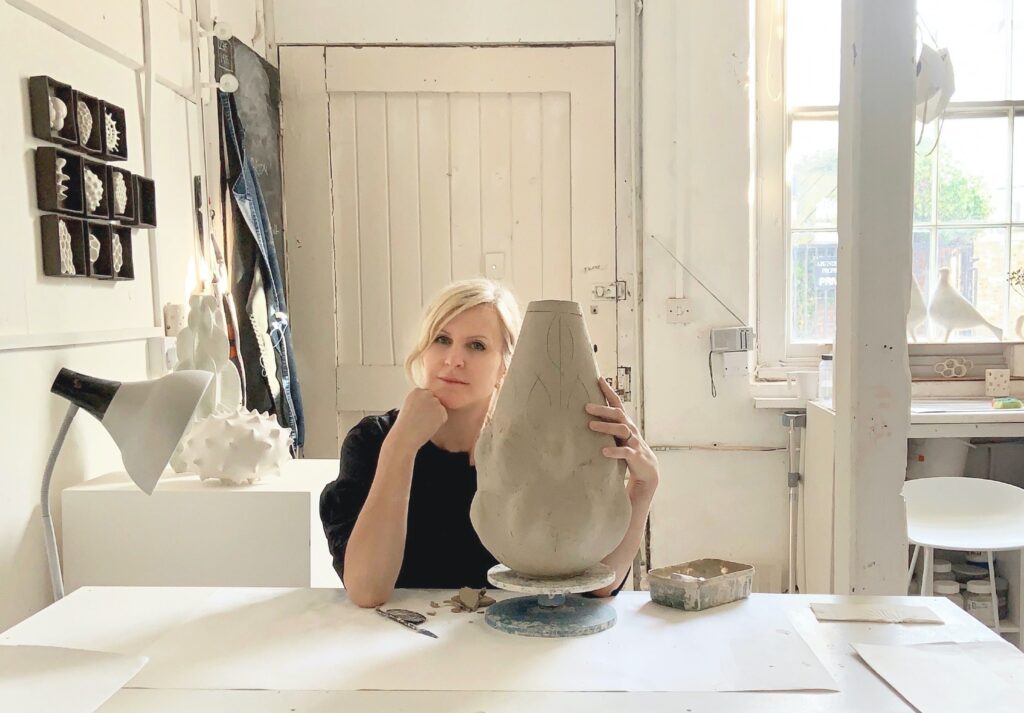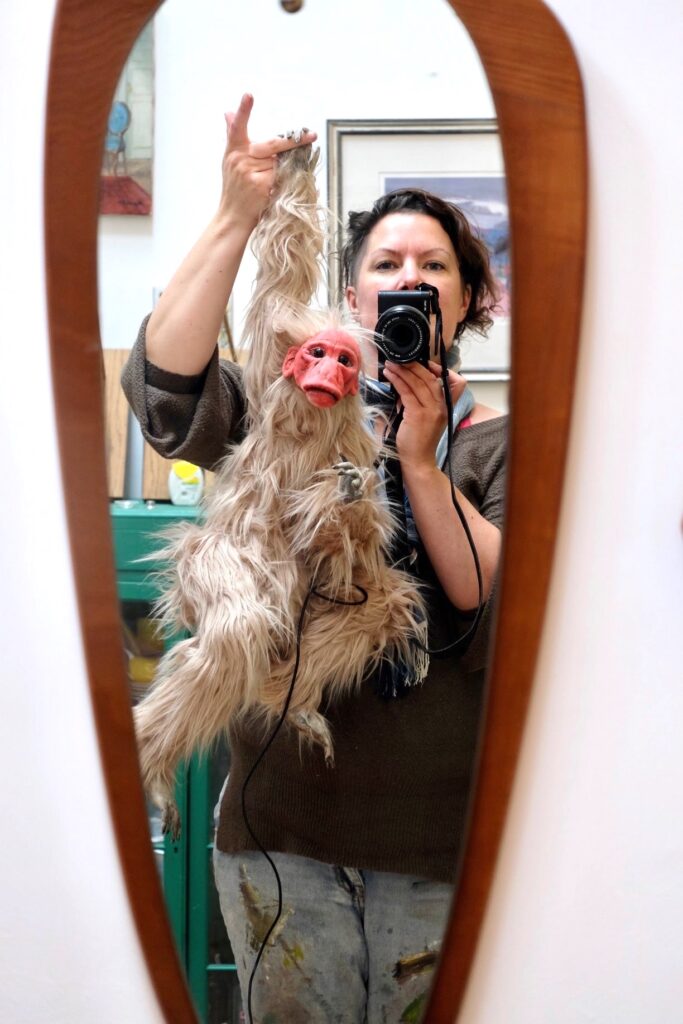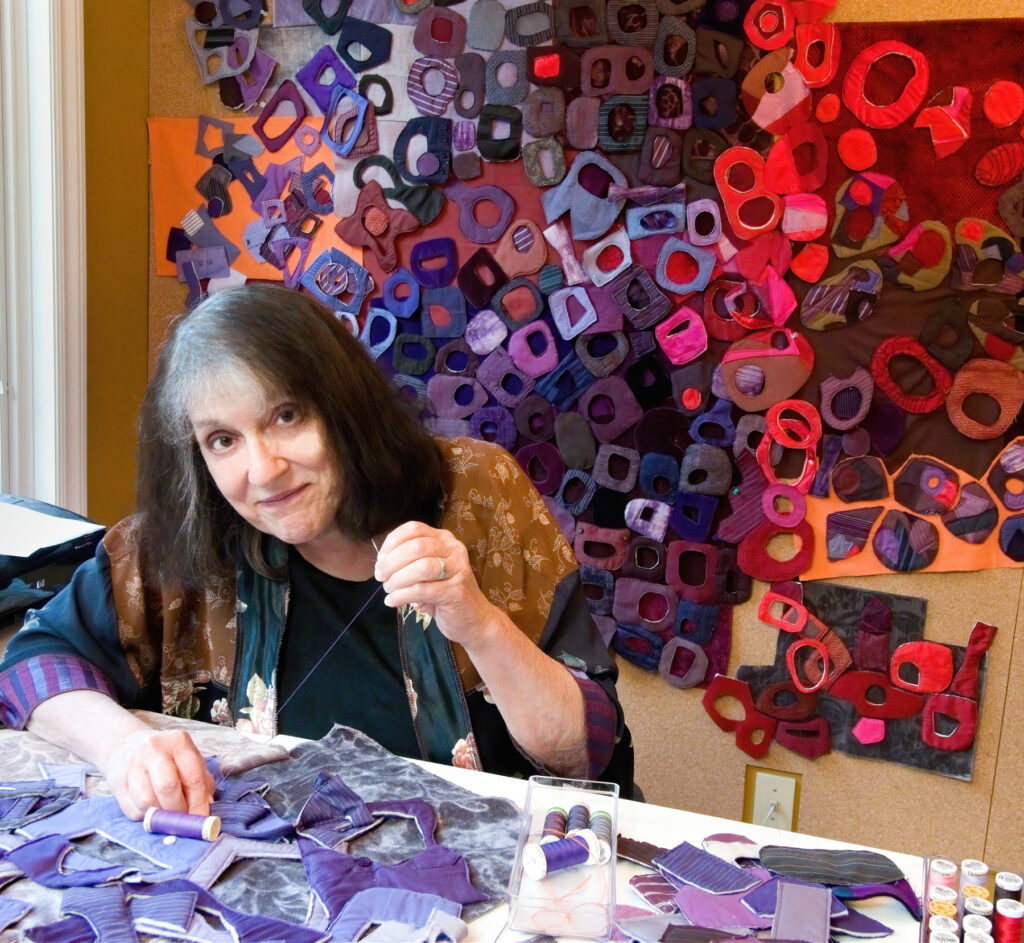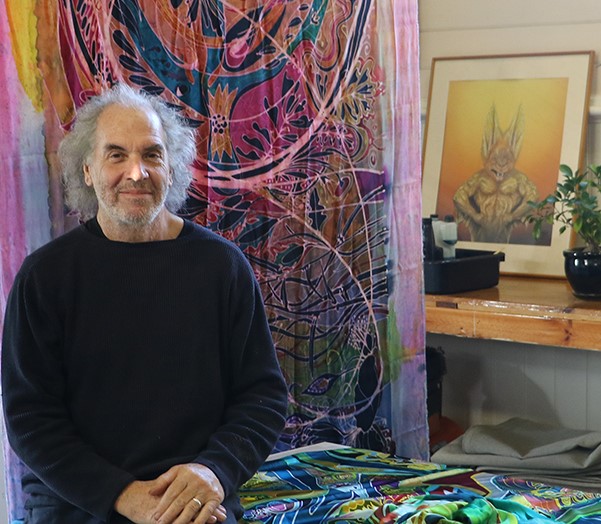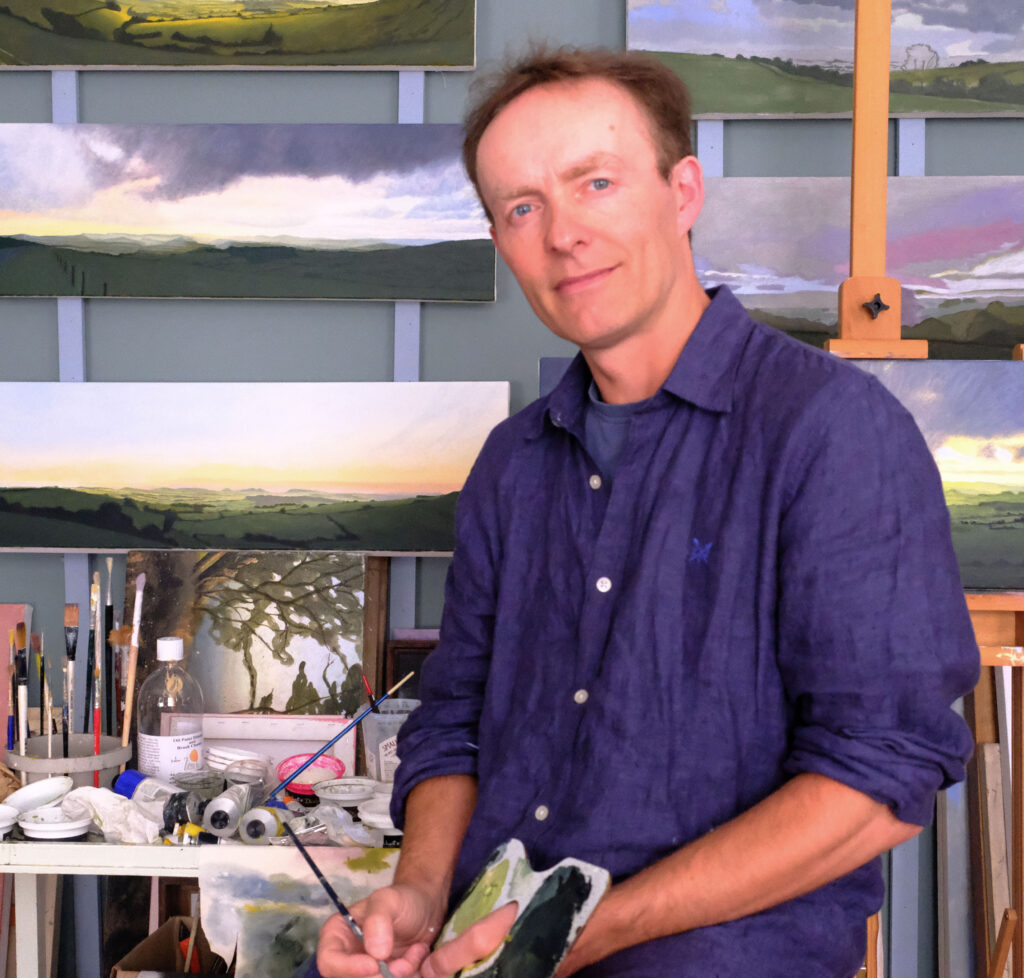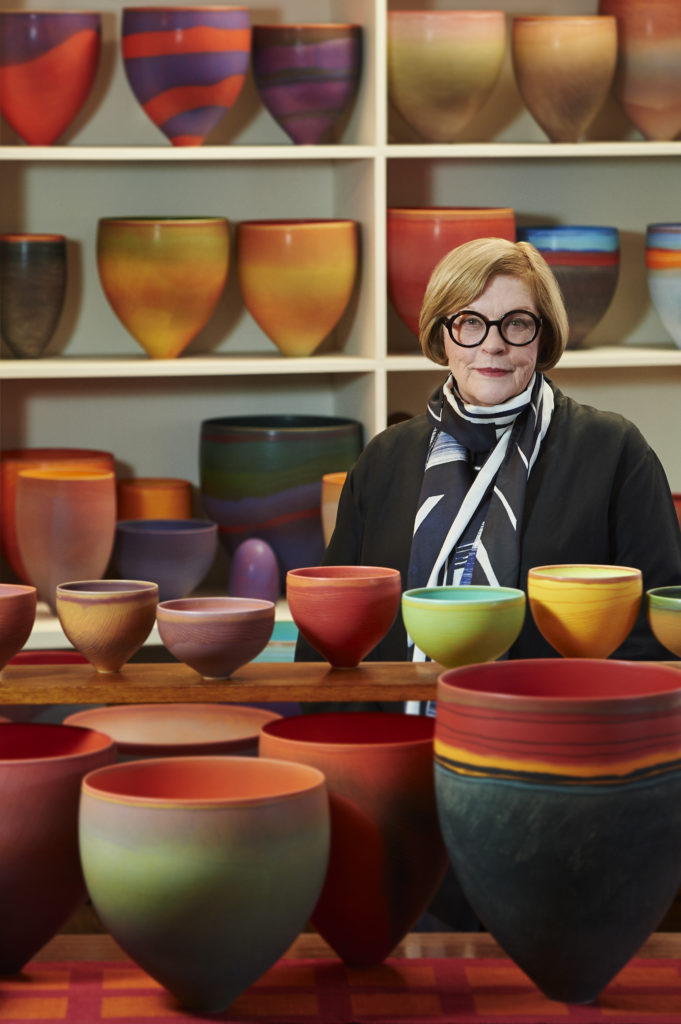Michele D'Avenia
What was the point in time when you knew that you wanted to be an artist?
Ever since I was a child, I have always been attracted to drawing. I continuously drew and coloured, trying to reproduce everything I saw, especially the images and covers of the "Micky Mouse" magazines that I grew up reading. Although I had this confirmation as a teenager, it seems incredible but one day after leaving school while I was returning home, feeling stressed thinking about my uncertain future, I heard a voice in my head repeating to me "you are an artist, you are an artist, you are an artist.”
 As the Sun Fades 50 x 70 cms , Oil on canvas
As the Sun Fades 50 x 70 cms , Oil on canvas
Who are two people who have helped you to achieve this goal?
My father., Painter, decorator and art enthusiast, he introduced me to the wonderful world of colour and drawing since I was a child, giving me the first lessons on drawing and colour techniques. But all this didn't help me achieve a goal, it was just a way to do what I felt and be myself.
Subsequently, in the path of my life, I have always been very lucky to surround myself with people who have always seen and believed in my talent, stimulating and making me notice that what was normal for me was actually special.
Take ‘Abundance’ and discuss the importance of light and colour in this work.

Abundance, 40 x 50 cms, Oil on canvas
"Abundance" is a medium sized oil on canvas still life painting. It is a painting of great emotional impact which manages to attract the attention of the observer. All this is not occasional, but strongly desired. The painting, with a pyramidal composition, was executed on a canvas prepared with a dark background primer (ivory black). This made it easier for me to carry out a highly contrasted work, creating a wonderful contrast between light and shadow which gives the work a great perspective. The colour, applied in glazes until saturation, enhances the objects represented at maximum chromatic power. They are rich in delicate nuances and at the same time with a three-dimensional plasticity that makes the composition emerge from the darkness, giving great atmosphere and depth to the painting.
Tell us a bit about your restoration work?
It all started when I was in the academy of fine arts. I had a great desire to learn but the academy I attended didn't give me what I was looking for. I wanted to know more, I wanted to understand and learn ancient painting techniques. One day I had a great intuition: "I would like to see how ancient paintings are made and structured" In a city not far from Messina I found a restorer who gave me the opportunity to attend his laboratory for the restoration of ancient paintings and sculptures. Shortly thereafter he took me in to work in his shop. This was a great training experience for me, acquiring all those workshop techniques and secrets, which are still part of my professional background today. Oil painting as it was done in ancient times, preparing the supports with the right plaster and painting with glazes until the desired effect is achieved. Since that moment I have never abandoned the wonderful world of restoration which continues to keep me linked between the past and present. Ancient technique representation of today - contemporary.
Comment on the way your still life work is often avoided of anything but the single object.
In the composition of my paintings, nothing is given to chance, each object is placed in the right place, in a so-called "invisible scaffolding" to create an elegant and harmonious compositional balance. Subsequently, to bring out the composition as much as possible and have an immediate reading of the painting, I concentrate as much as possible on the objects in the foreground, synthesizing the background a lot. In this way the background creates the wonderful atmosphere that envelops the entire painting. The synthesis of the background is so exaggerated that it makes the work atemporal.

In Full Bloom, 100 x 90cm, Oil on canvas
Compared to this, you also do still life paintings with many objects discuss.
The objects that I include in the compositions are always well studied, both for the shapes and for the chromatic aspect they must have. Furthermore, they have a very specific task, they are there, not to demonstrate their beauty but to symbolize or renew the plot of a story. Like in a still image from a film, where there is a before and an after.
 Primi Luci 40 x 60 cms, Oil on canvas
Primi Luci 40 x 60 cms, Oil on canvas
What historical artists do you hold in high esteem and why?
As I have already mentioned, I have always been fascinated and in love with all the art of the sixteenth and seventeenth centuries with all its immense artists who contributed to making the history of art. Although among all these artists there is one in particular who has been a constant point of reference for me and that is Michelangelo Merisi known as Caravaggio. He is an artist with a powerful and direct language. With his strongly marked ‘chiaroscuro’ he manages to give importance to subjects and human figures, making them three-dimensional, creating a completely new spatiality. But what is even more fascinating is that the technique of this sixteenth-century master is modern and contemporary even today.
 On the Edge 100 cms. Oil on canvas
On the Edge 100 cms. Oil on canvas
‘Zucchini Flowers’ you are using your humor and stretching the viewer as to is it not usually cut as a flower for a vase.
Yes, it's true, in "Zucchini Flowers" there is a bit of irony that distances you from the usual conventional representations.

Fiori di Zucca, 50 x 40 cms, Oil on canvas
But there is also a great point of truth... my own perspective. I’m driven by the constant and exasperated search for beauty and aware that beauty is everywhere. As in this case, where a simple and poor object still has great objective beauty, it's all about knowing how to grasp it.
Discuss the positioning of your model in ‘Summer Bliss’
"Summer bliss" has a rigorously balanced composition, where the female figure, with a soft and seductive chromatism, is immersed in a sparkling setting of clear and transparent water, aiming to evoke a moment of pure relaxation.
 Summer Bliss, 100 x 100 cms, Oil on canvas
Summer Bliss, 100 x 100 cms, Oil on canvas
The nice thing is that in a discreet and non-intrusive way, I am present in the scene. At the bottom right you can see my shadow immortalizing the scene.
Tell us why ‘Art of the Goat’ was painted and given this title?
“The Art of the G.O.A.T” was a commission.
 Art of the G.O.A.T 100 x 300 cms, Oil on Canvas
Art of the G.O.A.T 100 x 300 cms, Oil on Canvas
The client asked me to create a large painting depicting our nations favourite sport, football. As a non-fan and non-enthusiast, I really didn't know where to start. Through the many researches I did I was struck by the action of this footballer, Cristiano Ronaldo known as "The Greatest of all time" I decided that I wanted to create a painting that immortalized him with a new Caravaggesque painting depicting the image of him emerging from the darkness while performing the spectacular bicycle kick. By painting him with a strong plasticity I wanted to highlight the athlete's fantastic performance.
You give, a lot of thought, to all your titles, discuss.
I believe that the title of a painting has great importance, because it helps the viewer to understand better or faster what you want to tell them. Usually the title comes first, when I have the inspiration of what I want to create. A few, rare times when the work is finished. In that case it is the painting itself that suggests the title to me.
If this is not enough, you also sculpt. Discuss the techniques used in ‘The Ballet Shoes’ in the casting process.
Yes, sculptures have always fascinated me and are truly fantastic. It is a different language that is closer to real than paintings, because while a painting is a deception of the eye because it creates three-dimensionality on a superfine flat two-dimensional.
 L’altra Faccia del Peccato, Bronze
L’altra Faccia del Peccato, Bronze
The sculpture is real, wonderfully three-dimensional, you can see and touch it from every side. Furthermore, it is exciting to give the sensation of softness to a hard material, such as marble, stone, bronze.
“The Ballet Shoes” is a sculpture that had a fairly long process.

Le Scarpette, Bronze
The initial plan was to make it in Carrara marble, but during the final phase a blow from the chisel was fatal, bang! and the marble broke. In order not to lose the work, I glued the sculpture and made a silicone mould to reproduce it in plaster and be able to continue the work. When the model was finished, I produced the bronze casting with the subsequent patina (the thin film on the bronze of the sculpture).
What are you currently working on?
I am currently working on some painting commissions that depict still life works with dark backgrounds with objects emerging from the darkness, placed in precarious situations with a strong emotional impact. When I have completed these works, my commitment is to dedicate myself to new production for the American market which has ‘water’ as its main theme.
Does your environment give you inspiration and do you want to transport the viewer?
Yes, I am lucky enough to live in a wonderful place full of stimulation and inspiration for my work.

The Fruit of Life, 100 x 150 cms, Oil on canvas
Although I believe the important thing is not the place you are in but on the contrary, the more you travel, the more you know and experience new places and things and the more you are stimulated because your predisposition to inspiration is within you. But the ability to see beauty is fundamental and is the exciting part of things. I am like a sponge, I absorb everything around me. I assimilate every emotion, I hold it and I try to pour it into my works both paintings and sculptures.
Discuss light and shadows in both your paintings and sculpture.
As you now know, since I was a child I have been fascinated by Caravaggio's revolutionary way of painting. I immediately understood the great importance of light in both painting and sculpture, so that it became the essential characteristic in my art. As in sculpture it enhances the all-round plasticity, also in paint things and people emerge from the darkness, thanks to a revealing light that falls only on the parts I prefer, enhancing their beauty and plasticity. The shadows are shrouded in darkness, taking away from the viewer everything that I don't think is appropriate.

Waiting for Freedom, 129 x 94.5 cms, Oil on canvas
It is a strong and delicate balancing act at the same time.
All this gives the work I create a fascinating perspective and the possibility of leading the viewer to the emotions I wish to communicate.
Moments, 90 x 50 cms, Oil on canvas
Contact:
Michele D’Avenia
Michele D’Avenia Art Gallery
Email: micheledavenia@hotmail.com
Deborah Blakeley, Melbourne, Australia
Interview by Deborah Blakeley, July 2024
Images on these pages are all rights reserved by Michele D'Avenia
Lauren Betty
Can you expand on your comment, “…there is a rhythm that exists on the farm” how does this rhythm influence your art?
When my husband and I came across this land, there was an unfinished barn with a slight structure on top of it, a long gravel drive up to a clearing , and views of the sunrise over acres and acres of pasture. The trees were swaying and “talking”, rubbing up against one another. Immediately we knew had found our homestead and named it “Talking Tree Farm”.
 Frida and Diego the goats
Frida and Diego the goats
The rhythm exists in the sound of the trees, the winds, and the seasons. I am on mother earths time, the sunrise, the sunset, and the weather dictates everything. The animals go out at sunrise and away at sunset, the rhythm is the movement of the farm and all its beings.
The influence rhythm has on my art is that is all interconnected. I moved to the farm in 2020 from the city, and my art was transformed.

Originally, my studio did not have running water and I was using a rain barrel to wash my brushes. Seeing the pigment wash into the ground was frustrating . I was watching the pigment poison the ground. I began using fabric to absorb the pigment in my dirty paint buckets and suddenly realized I had found my next chapter in creating art. This is what i call I my “aha moment”.
I found old metal objects that had been stirred up from the earth and began using these to create rust on paper and fabric.

The peaceful and quiet rhythm of isolation on the farm combined with the need to be environmentally conscious and sustainable created the “Fabric of Being “ collection!
Discuss how you use college and fabric in your work.
I use collage and fabric to create compositions that evoke an experience. The majority of my work is on a large scale, to have the viewer stand within the paintings. The process is my passion. I have dyed fabric hanging from clotheslines and rolls of paper strewn across the floor covered in watered down paint. Once dry, the dyed fabric and paper is torn into monochromatic compositions. My paintings are a form of propagation.

Taking a piece of a whole, planting, nurturing, and duplicating my surroundings. The weave of the fabric is represents my integration with nature and the symbolism of being interconnected with our environment.
How strongly has your art been influenced, by your formal art training?
The art I create today could have been accomplished with or without formal training, but I believe that when we learn how to use multiple “tools”, it allows us to find ourselves in our art. Life drawing, realism, sculpture, basic disciplines allowed me to free up space for the creative process to flow. As a multidisciplinary artist, I am able to create with fluidity of thought without guessing the process. Knowledge is freedom to tell your own story.
What method of recording do you do when you travel?
I love to collect organic forms from the area that I’m traveling. Branches, rocks, shells, feathers, bones, sand, anything tangible as diaries of the adventure. I also have been known to send myself postcards! One of my favorites is a postcard i sent to myself from Abiquiu, New Mexico, USA with a photo of Georgia O’Keeffe riding passenger on a motorcycle in 1944. I write simple notes to myself . These tangible diaries create the shrines throughout my studio.
Discuss the femininity of your work?
Women and nature have an undeniable bond. My art is representational of nature. That is why my art has femininity.
 ‘Of Light and Water’ I, 48"x 48" Mixed Media on Canvas
‘Of Light and Water’ I, 48"x 48" Mixed Media on Canvas
You have work in both private and public collections. Please take one that you were sorry to see go but also delighted to where it went and why?
In the beginning of my art career, I held fast to the emotions surrounding individual paintings. Now, many years have passed, and my emotional investment in the individual painting is severed when it leaves my studio, giving space for my mind to breathe into the next piece of art. My emotional connection has fallen into the love of the process. The meditative actions taken in dying of the fabric, hanging the fabric, pooling water onto paper, and composing compositions. This is what I hold dearly.

‘Of Light and Water’ II, 48"x 48" Mixed Media on Canvas
Discuss how multi layering brings out unexpected results in you art.
I believe the canvas already has a plan, and I am its tool. The delicate surprises of color change when the underlayer of paper is combined with the sheer top layer of a dyed fabric, is comparable to mixing color on layers of transparent film. Repeated to achieve deep organic hues. Combined with the different size of weave in the fabrics , the folds become deep crevasses exposing small peeks of rust. A focal point of warmth trickling through a monochromatic sequence of layered color. The multilayering is unpredictable, and the outcome is unpredictable as well. I simply allow the painting to transform and trust the process.

'Willow' 1 70"x 60" Mixed Media on Canvas
Comment on your current colour palette.
I lean towards a monochromatic color pallet. The color inspiration is influenced by my surroundings, also inspired by travel. I will bring the ocean or the desert home to the mountains and recreate the colors on the canvas. It’s a visual diary for me. I travelled to Joshua Tree National Park and the surrounding area of California several times this past year. In my current exhibition in North Carolina, USA , the colors depict warm tones, deep grays, and whites. I brought the high desert to North Carolina! Carolina! grays, and whites I brought the high desert to North Carolina! 
'Wind Moon Howling' I 48"x 48" Mixed Media on Canvas
How do you compose landscapes to give such a calming embodiment?
I am fortunate to have found my place of serenity in the foothills of the Appalachian Mountains. I watch the ever-changing landscape of the weather, mist, fog, clouds, sun, moon, and seasons from the farm. I try and capture the movement of the elements in the form of collage. By using the thin delicate weave of fabric, and haphazard placement, i attempt to mimic the serene. This ethereal display of nature is the inspiration of my landscape paintings.

'Wind Moon Howling' II, 48"x 48" Mixed Media on Canvas
Discuss your amazing studio….
The studio was the first structure able to be used when we began the work on our homestead. It was a shell of a structure, so getting it up and running was a huge undertaking and it’s still very rough around the edges. The studio sits above the barn . The sounds of the goats, chickens and ducks echo over my music, and at night the frogs sing around the pond in chorus! in chorus!

It is my sanctuary, oasis, and a space where my mind can open. I have 1200 square feet of raw work space with multiple windows and glass doors to allow for the natural light. Through the glass I can see the pastures, the pond and all the trees surrounding the studio. An extra large, table is in the centre of the space, and is used as my main flat surface for the focus painting.

There is an area that I have dedicated to a lounge/sleep space, decorated with found objects of wood, bones, feathers, rocks, and shells. These objects are my “collections” from my travels and from around the farm, and they are displayed in shrines to nature over a drawing table. It’s a very thought provoking, space and is rough enough to feel free to explore my art in all mediums!
In 2023 you had five exhibitions – how do you keep up the pace.
It all circles back to the rhythm of the farm, and the isolation that allows me to focus on my art. I’ve been an independent artist for years, and self-discipline is a necessity to achieve the goals I set for myself.

I found that integrating my life on the farm and my art, and seeing them, allows space for freedom of thought and creativity. When the opportunity presents itself to exhibit my work, I jump at the chance to have a vision come to life.
Contact:
Lauren Betty Art
Deborah Blakeley, Melbourne, Australia
Interview by Deborah Blakeley, June 2024
Images on these pages are all rights reserved by Lauren Betty
Claire McCall
Why do you find, using palette knives so satisfying in your work? How many sizes do you use?
I love the buttery texture of oil paint and find the use of palette knives very satisfying as you can create thick impasto passages and then move the paint around as you wish to blend edges or create movement in the paint with directional strokes. I generally stick with 2 sizes unless I am working on a very large canvas. I use a medium size knife with rounded edges for background work and a small knife with a more pointed tip to work with fine detail on figures.
How did ‘place’ become such an important part of your art?
I like to think that the viewer can translate my paintings to their own place in terms of space and in terms of their own world. With figures generally turned away from the viewer, one can easily put themselves or family members in the painting.

Another Day Done
How large and small are your paintings?
My paintings vary from 30cm x 30cm to 120cm x 120cm with various dimensions in between.
Comment on your statement, …”the drama of abstraction vs realism’ in relationship to your work.
When I start painting a work, I will first complete the background. My backgrounds are quite abstract with free palette knife movement and mark-making with the tip of the knife. The figures or a focal point will then be carefully constructed with a solid foundation amongst the thick impasto abstraction.

A Picnic Lunch
This is the more detailed realism for the eye to focus on initially before being swept around the painting.
Why are there so many of your paintings done at the beach?
 Sandcastles
Sandcastles
Apart from the fact that I feel at home by the ocean, and I spend my vacation time in this environment, I think the beach landscape suits my style of painting with its texture and movement. Colourful umbrellas and people in a relaxed state are also an endless source of inspiration for multiple painting compositions.
Take your painting, “Beach Cricket” and discuss.
The Beach Cricketer is a figurative work that conveys a classic pose of a child playing one of the all-time favourite activities of a beach holiday, beach cricket. It is a memory that many people can relate to and can include lots of motions that help to convey movement in my painting. The figure wears a cap hiding the details of his hair and face. This gives the viewer a chance to put themselves in the picture.

Beach Cricket
Is it your aim to record the feelings of Australia and our times at the beach?
I do love the old impressionist works of figures at the beach by artists such as Edward Henry Potthast who convey a different era of beach costume and would love my paintings to be a record of this point in Australian history.
 Beach Ball
Beach Ball
Comment on your thoughts about entering art shows.
Art shows are a perfect place for an emerging artist to begin showcasing their work to a broader audience. It is not so much for the prizes as judging is a subjective process, but to regularly exhibit at art shows is to become known by regular art show enthusiasts and I have often been approached for commission work when my works have been seen by collectors at art shows on a consistent basis.
Where has this led you and your art practice?
I did enter the Camberwell Art Show with my very first painting back in 2003/4 in complete ignorance to the high standard of work that would be on display. Of course, it did not get hung, however I did use this show to measure my progress. In the next year, I did get hung, and sold a couple of pieces the year after. Three years after my first attempt at this show, I won ‘Best Representational Work In Show’.

Ice-Cream
My art practice has been driven by my unwillingness to give up even in the face of rejection.
“Painting is easy when you don’t know how, but very difficult when you do” Discuss this quote in relationship to your own art.
The more you learn of course in art, the more you find out how much there is to learn. When you don’t know how, I guess it’s easier to simplify the process. I have developed my method over a number of years and all of the elements that go towards composing and completing my paintings become second nature, but it is a complex process which can only come together with many failures and successes behind you as experience to draw on.

Beach Umbrellas
Are the children in your art your own?
My earlier works featured my own children and often a friend’s children.

Age of Innocence
Take, “The Lifeguard” and add the other elements of beach life you paint and why?
The Lifeguard features a lone figure however adding a seagull flying past or the lifesaving flag in the distance can add context for the viewer and provide more atmosphere and elements for the eye to focus on.

Lifeguard
What or who inspired your art and what and who encourages you now?
I have been inspired by many local artists in Melbourne. I am a big fan of the Melbourne Twenty Painters Society. Many members are impressionist painters and I enjoy their annual exhibitions. I am inspired however by many genres of art and I look forward to studying the works of the masters in galleries around the world as I find myself with more time on my hands now that my children are older.
Discuss painting light and particularly, bright light.
Light very much dictates my attraction to a scene that I might paint. I particularly like late afternoon light as it turns golden. I pay close attention to the direction of light and the colour of the shadows to give the painting an overall warmth. Bright lights can be added at the very end to really turn up the highlights.

At the Beach
When the weather turns, what do you paint?
I would normally gravitate towards sunny days to paint outdoors otherwise I can work from source photos.
Discuss your studio and one or two objects that your love having in it?
I love the very tall windows of my studio that give beautiful light to work in.
How do you capture the magic moments, in a sketch book or photos?
I very much prefer photos over sketches as I am concerned with light and colour in my compositions.
Contact:
Claire McCall
clairemccallart@gmail.com
Victoria, Australia
Deborah Blakeley, Melbourne, Australia
Interview by Deborah Blakeley, May 2024
Images on this page are all rights reserved by Claire McCall
Linda Coomber
Explain what led you to basket weaving?
My interest in basketry and fibre art is a mid-life phenomenon that grew out of a need and into a passion. Having recently moved to the Mid North Coast of NSW, Australia, I acquired some beautiful old wooden chairs with caned seats. The caning was damaged and broken. I searched around for someone to fix them, and a friend introduced me to Helen Beale, one of Australia’s most talented caners and weavers.
Helen declined to fix my chairs but offered to teach me how to do it myself. Out of those caning lessons came basketry, weaving and fibre art.

Black
Why do you source your materials locally rather than using traditional flax?
Every area, indeed, every country, has its traditional weaving materials. In the UK and Europe, it is mostly willow. In native American weaving, sweet grass, pine needles, wicker, spruce root and cedar bark are all used. Anything pliable can be used in basket weaving as long as it is bendable and can form a shape.
I’m still learning and experimenting, and try many different leaves, vines and grasses that grow in my local area, as well as more traditional materials from my area, like Pandanus and Lomandra.

Dracena
Describe the landscape around your studio?
I live on Gumbaynggirr Country on the Coffs Coast of NSW. My area is made up of beaches, headlands, rivers, estuaries, creeks, mountains, and flood plains. It is a diverse and beautiful landscape. Both native and introduced plants grow vigorously in our temperate, humid climate – rich pickings for a scavenger like me!
Collecting seed pods and similar materials is the make of your work. Discuss how they are added to your work.

Clay Base
My weaving is a mix of traditional basket weaving techniques like twining and plaiting, but I also use coiling, where I sew together coils of natural materials using a strong waxed thread. This allows me to add embellishments like stones, shells, and seed pods, which are sewn directly into the work.
Being a scavenger is fine, but where do you store it all?
Yes, storage is a problem. Luckily, I have an airy, dry area under my house, and a very understanding husband!
Mould is my enemy, so once my materials have dried out, I hang them from racks suspended from the ceiling in our garage. That way they stay clean and dry until I need them. Larger pieces are stored in cardboard boxes and paper bags. Air flow is important, so no bags or boxes are ever sealed.
Is this a seasonal activity?
Certainly, in many parts of the world, collecting weaving materials would depend on the season, but in my area, where temperatures are mild all year, I am able to collect all year round.

Driftwood Rush
Expand on the process you take in using local plants to produce a suitable material to weave with.
I’ll use two examples. Lomandra, also known as mat rush, is a perennial clumping plant with long, strappy leaves. They are native to Australia and grow abundantly in my area. I cut handfuls of the leaves close to the base of the plant. Once I’ve harvested the leaves, I think I’ll need, I’ll take them home and spread them out in the direct sun. Within three days, the leaves will curl and dry to around one third of their original width, but they will still retain their green colour. At this stage, I use a sharp needle to split each leaf into thin strips. These strips are quite pliable, and ready for weaving.
The Radiata Pine tree is also very common in my area. It has long needles that when dry, are a lovely red brown colour. The tree sheds its old needles all year round, so you can collect them straight from the ground. After I’ve rinsed and dried them in the sun, I store these in a cardboard box, ready for use.

Serenity Stones
What is the drying time needed?
This varies greatly. Some, like the pine needles, are already dry when I collect them, but most strappy leaves will take a few weeks to dry out completely.
Do you add colour, either natural or manufactured dyes?
I don’t use dyes. I prefer the lovely, earthy colours that that are inherent to each variety of leaf or plant that I use. If I feel the need to add colour, I’ll do it by using coloured waxed thread, particularly in my coiled pieces.

Palm Sheath
A special twist in your work is the use of introduced deer antlers, discuss.
 Antler 1
Antler 1
Deer were introduced into Australia from Europe in the 19th century as game animals. Today, they are feral animals in many areas throughout Australia and cause a variety of environmental problems, unfortunately. Fallow deer are particularly abundant in some areas of NSW. Many people don’t know that deer shed their antlers naturally every year, and then grow a new set. They will often rub up against a tree until the old antlers fall off, so it’s not uncommon to find a set together beside a tree where deer are common.

Antler 2
These naturally shed antlers are beautiful, tactile things. Anywhere in length from 40cm to close to a metre, I have found they make wonderful, dramatic handles to my woven baskets. Their colours are beautiful too. They can range from dark brown to almost white.
Are there any local restrictions on the collecting of plant material?
Aside from it being terribly rude to raid a neighbour’s garden without permission, no, there are no restrictions in my area! I make sure I selectively harvest – I never take a whole plant, just a handful of leaves; after all, I’ll probably want more sometime in the future.
How do you define your work, artwork, or useful artistic objects.
I consider myself a weaver. Weaving is almost as old as human history. Traces of baskets have been found in the Egyptian pyramids, and woven basket liners have left their impressions inside the fragments of ancient pottery.
Baskets and woven materials were needed as containers, clothing, floor coverings, storage and for transport. Almost all cultures used and experimented with the natural materials around them to create woven objects.

In our modern lives, we no longer need to weave our own clothing and floor coverings, but I like the notion of bringing the natural world into our interiors. By beautifying and texturizing our living and working spaces, a statement can be made about valuing artisanal objects, whether considering them as artworks worthy of putting on our walls or as useful objects to be used daily.
Your background in psychology, has it helped with your artistic practice?
If it has, I’m not aware of it!
Take ‘Jacaranda Vase’ and discuss.

Jacaranda trees are very common in my area. Most people will know them for their gorgeous violet coloured flowers, but they also have the most beautiful woody seed pods. I use these seed pods to decorate some of my vessels, and they are particularly lovely around the top of vases. To make the vases suitable to hold fresh flowers, I’ll often build the vessel around a glass insert. That way the vase is a usable and useful piece of art.
The sizes of the vases can vary from 20cm or so to very large pieces that are half a metre in height.
Using locally foraged plants means that I never run out of materials for my pieces.
Comment on the importance of the local artistic community in giving you the opportunity to define your own art.
For the last five years, I have been the gallery manager of our local community art gallery. The Art Space Urunga is entirely staffed and managed by volunteers and supports local established and emerging artists in all mediums. One of the benefits for me has been that through meeting many other artists, I have been able to collaborate with several to combine their skills with mine. For example, I have worked with several potters to design bases for my weaving. A glass artist has made gorgeous luminous glass bowls for me to weave around. Currently, I am working with a local woodworker who is making handles for my pieces from beautiful local timbers. These creative collaborations have brought complementary skillsets that have enhanced my projects.

Vase
You take local workshops, how does your teaching qualifications assist you within the classes?
I have learned through classroom teaching that, no matter what the subject is, it is important to try many different approaches when teaching a skill. Some people respond to what you say, whereas others may learn best by watching and doing. Teaching has also taught me that follow up is vital. Whether I’m teaching someone how to make their own twine or how to make a ribbed basket, I always have notes with detailed instructions and photos for people to take home. You can’t remember everything you’ve learned in a workshop, so handouts can remind you of processes and techniques you may have forgotten.

Palm Platter
How do you extend your students to go beyond the expectations of a basket?
I am constantly surprised by people’s innate creativity. Once the basic methods have been mastered, the resulting baskets from workshop participants are rarely the same. Each individual’s choices of specific materials and how to put them together leads to very different results.
Do you take commissions?
Yes, gladly.
Contact:
Linda Coomber
Details
Linda Coomber
New South Wales, Australia
Deborah Blakeley, Melbourne, Australia
Interview by Deborah Blakeley, May 2024
Images on this page are all rights reserved by Linda Coomber
Loren Eiferman
How overwhelmed do you feel about the environment we are passing onto the next generation?
As with most of my circle, I feel very stressed about climate change. It is here and happening before our eyes. Lilacs now blooming twice a year: once in spring, and again strangely in the fall. Insects and diseases that were often relegated to the Southern Hemisphere are now prevalent where I live -- in the northern hemisphere. Spring peepers (frogs) are chirping away the first week in March instead of in April, and of course much worse outcomes including bleaching of coral reefs and many species are on the brink of extinction. This is not normal. These are indeed strange and changing times that we are all living in. But I remain hopeful that human ingenuity and knowledge will get the upper hand and be able to reign in and realign this runaway train. Both of my daughters are working on addressing climate change and are seeking fundamental new pathways to alleviate this global problem. I am proud that they and many in their generation have chosen this path, and for this reason, I remain hopeful.
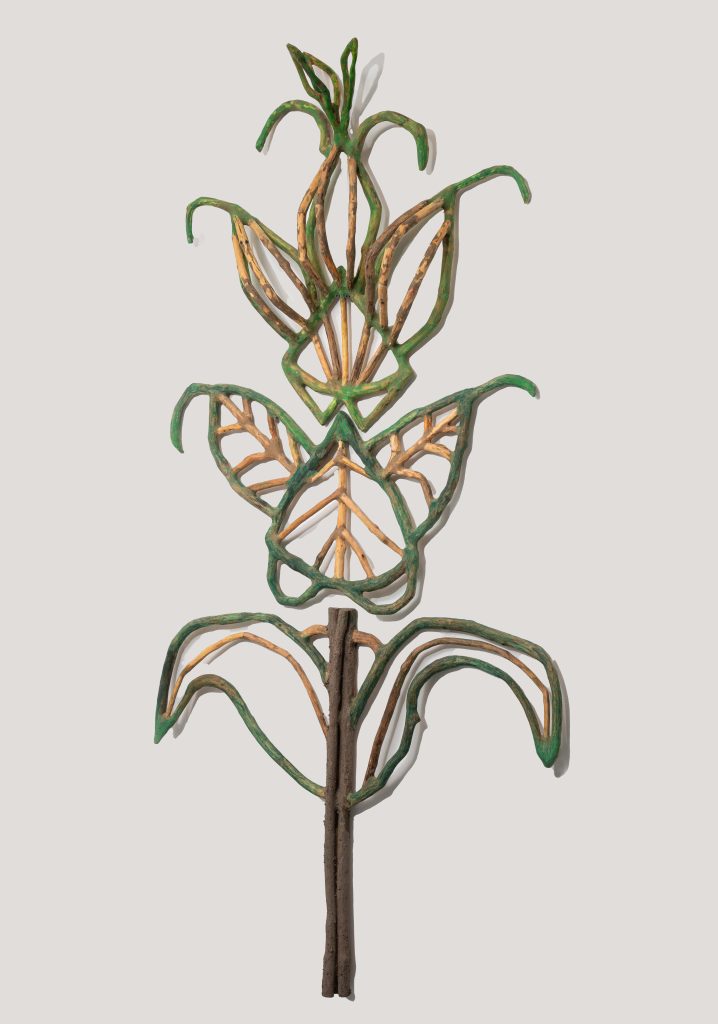
Prunella Gradiflora Self Heal, 2022, 150 pieces of wood, pastel, linseed oil, 62 x 31 x 5
Do you work one series at a time, exclusively?
I used to work exclusively on one series at a time. Often working within a certain framework of what captivated my imagination for several months to years at a time. Now, it seems that I frequently hopscotch between series, and I am not rigorous about sticking within the confines and parameters of a particular series anymore. I find myself experimenting and playing more these days in my studio.
Where does your current inspiration come from?
My current body of work is inspired from different sources. One source is the mysterious illustrations found in the late 15th century Voynich Manuscript. This manuscript was written in an unknown language, by an unknown author and filled with botanical illustrations of plants that don’t exist in nature, past or present. For the past eight years I have been translating the botanical section of the manuscript into three-dimensional wood sculptures.
Another source of inspiration is the black and white photographs from the early 20th century German photographer, Karl Blossfeldt. He photographed nature in extreme close-up and the photographs from his seminal book, “Urformen der Kunst” (“Original Forms of Art”) are extraordinary. The way a plant curls or the shape and color of a tight bud always inspires me. It is ultimately the nature that surrounds me, in all her myriad forms and wisdom that I draw daily inspiration from.
You collect most of your material locally. What is the process from then?
I start out every day with a walk and collect tree limbs and branches that have fallen to the ground. I never chop down a living tree. I carry those sticks back up into my studio. I then let the wood sit for many months in what I call my “sea of sticks” to make sure the wood is dry and won’t check or crack. I usually do a drawing first and that drawing acts as a road map of where I want the sculpture to go. From there, I start looking for shapes found within each stick to correspond to the lines found in my drawing. I then cut small naturally formed shapes, joining these small pieces of wood together using dowels and wood glue. Next, I make a putty to fill in all the open joints. I then wait for the putty to dry and sand the putty until it’s smooth. The goal is to make the line of the wood seem continuous and all the joints appear seamless. I usually reapply the putty, wait for it to dry, and sand it at least three times. I want the work to look as if it grew in nature, when in reality, each sculpture is built from hundreds of small pieces of wood that have been meticulously crafted together.
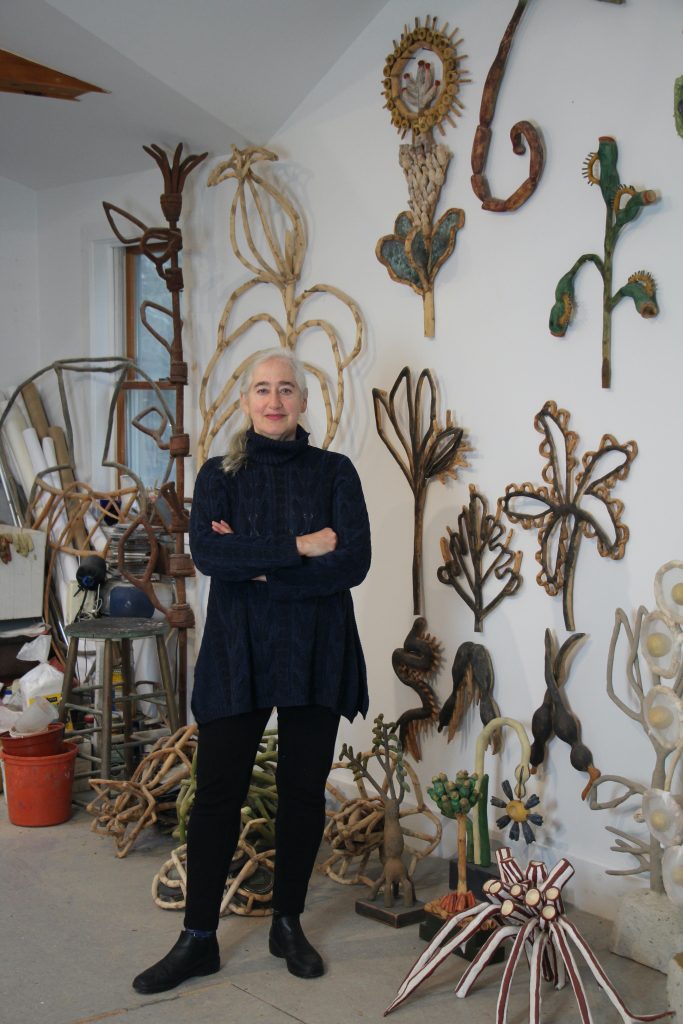
I think of my sculpture as drawing, but in wood. This is a very time-consuming process, and each sculpture takes me a minimum of a month to construct. I frequently work on two sculptures at a time since there is so much down time waiting for the putty to dry.
When and why did you decide to work with wood?
It’s been a long circuitous route to get to where I am now. I used to be a painter. I was working in my tiny apartment in Manhattan’s Little Italy, making large oil paintings on paper. I had three studio walls that were filled with nearly completed paintings. On one particularly hot and humid August day, the paint wouldn’t dry, and I had no more wall space. I was stuck with three very wet paintings that couldn’t be moved. I am wired to always be making and creating art. Since I couldn’t paint, I instinctively picked up a piece of balsa wood that I had been using for a framing material and a straight edged razor blade and inexplicably proceeded to whittle away. Literally time stopped. After eight hours of being in an almost trance like state of crafting this piece of balsa wood, I realized that I derived more creative fulfillment as a sculptor than as a painter! From that point, I evolved from whittling balsa wood with a razor blade to getting a proper whittling set.
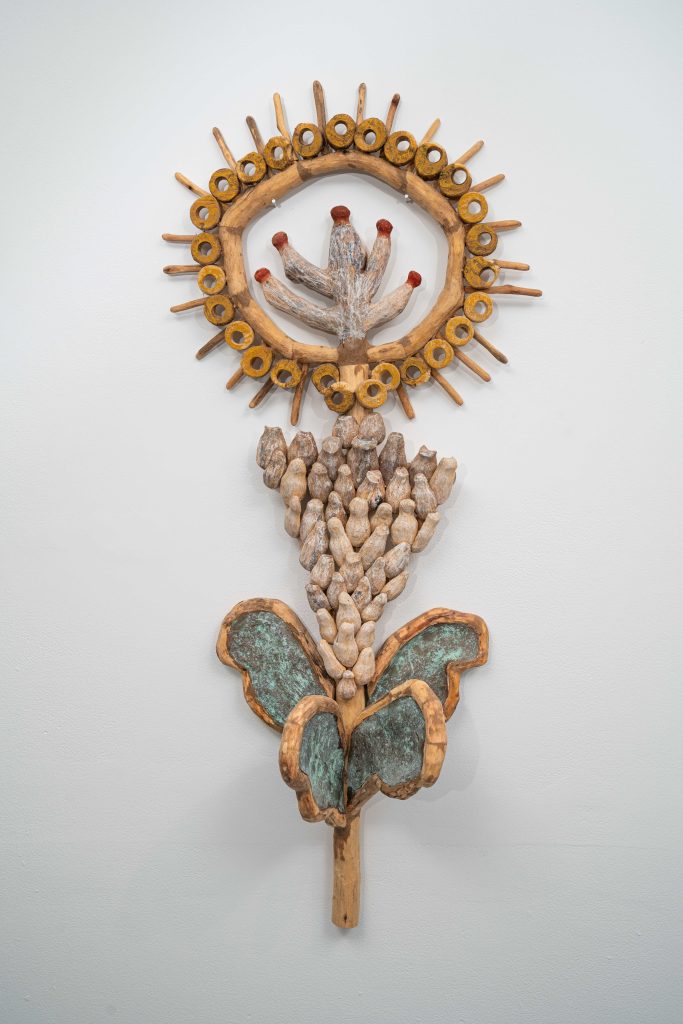
New Growth, 2021, 142 pieces of wood paper clay, linseed oil, pastel, copper metal coating with green patina, 38 x 16 x 8
Eventually, I realized that balsa wood is a terrible sculpting material and I started gathering sticks in Central Park and hauling them via the subway back to my studio.
I also started using better tools, including a small electric Dremel and now a Foredom flexible shaft tool.
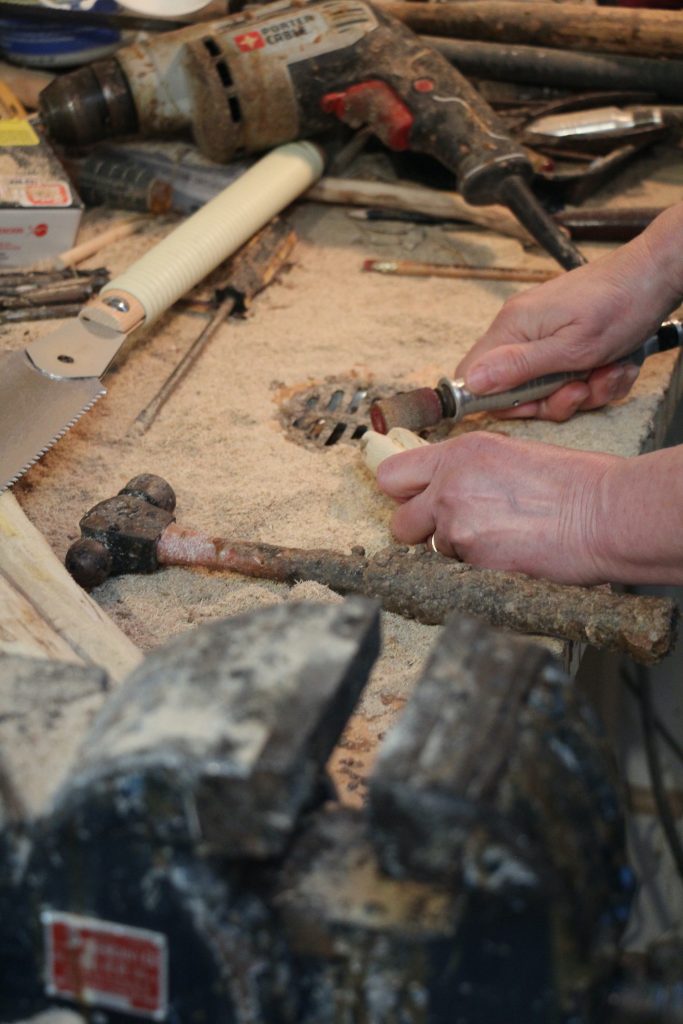
I’ve been working with sticks now as my main material for decades. While my work has evolved from totemic style carvings of my earlier period into a more nature-inspired and botanical direction, my material, and my decades-long love of working with wood has remained.
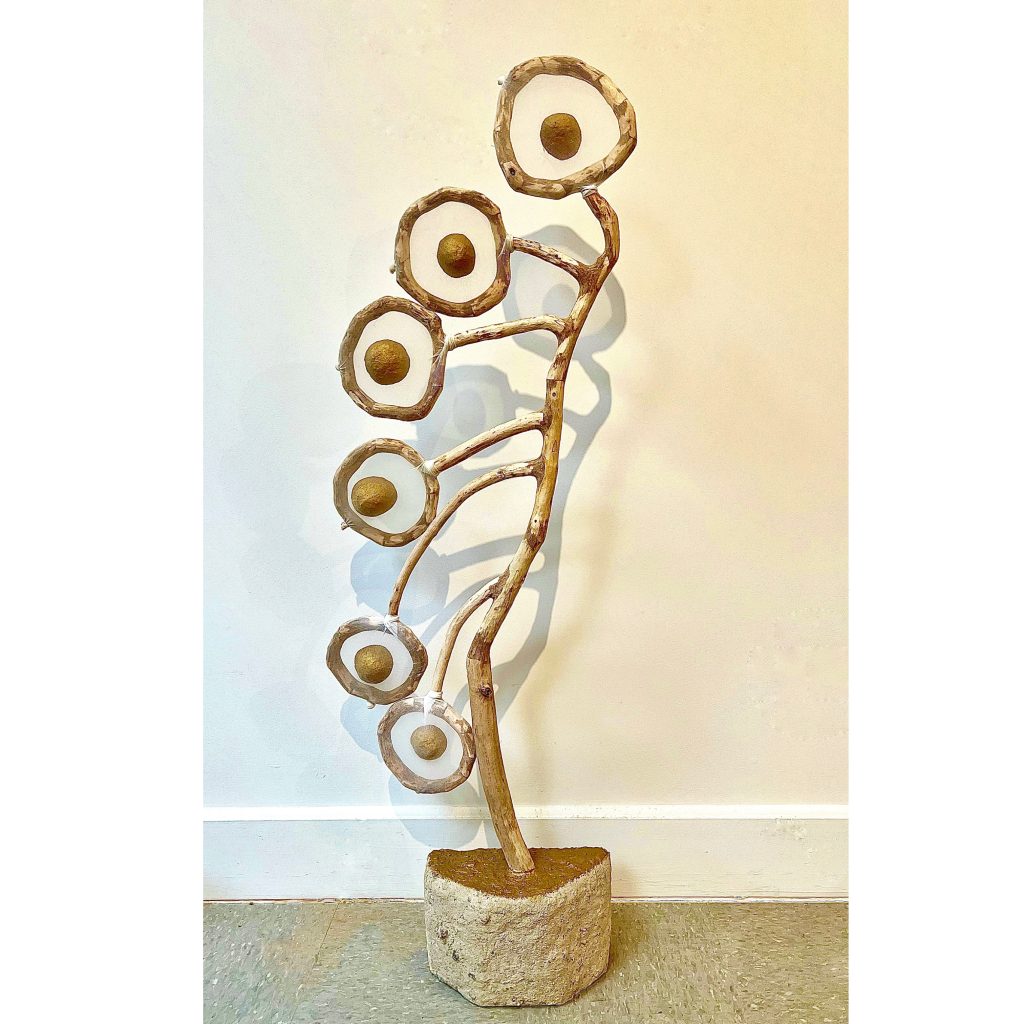
Lunaria 2024 78 pieces of wood, pantyhose, 50 x 157
Tell us about your commission with the MTA Metropolitan Transportation Authority.

How did the commission come about?
I received a call from the director of the MTA/ Arts and Design saying I was one of five artists chosen for a commission at the Metro North Station in Pelham, NY. I didn’t know how that happened since I never even applied to the open call. I later found out that one of the curator judges on the panel put my name forward. So, I went about visiting the train station, learning about the history of Pelham and synthesizing many ideas to come up with a way of working in metal. I created a vision board with my proposed ideas for the project and happily I received the commission.
What were the perimeters?
The project was open, to all ideas, and we could design anything we wanted. We were given a budget, and I originally had another whole design that was to run the length of the station’s platform that would’ve been attached to the overhang--but that ended up becoming too costly. So, I scaled it back to have the eight black steel panels built into the stations existing railings, which is the project that was ultimately commissioned.
What was the inspiration?
I researched the origins of the Town of Pelham. I discovered that the Town of Pelham was incorporated in the late 1880’s. During that time, William Morris, the Roycrofters and other popular designers from the Arts and Crafts movement were active. I wanted to emulate the carpets and wallpaper designs that were commonly found inside the homes in Pelham Heights at the time of its founding. So, I came up with the concept for “Home: Inside/Outside” where I designed eight tri-layered panels made from textured black painted steel that emulated the patterns of these carpet and wallpaper designs. There were three separate iterations that were installed throughout the station’s hand-railings. The shadows created by these panels were integral to the design, such that standard MTA railings now can be read as vertical planks of wood flooring across the platform and the panels that were built read as interspersed carpets within that flooring. I wanted these carpets to be visually contemplative, indicative of a modern-day mandala but in metal. These carpet-like screens hopefully engage the viewer into seeing new forms in the negative and positive spaces and in that moment of engagement the viewer goes back “home”, is connected to the outside from the inside, is entertained, is engaged in a new way, allowing them to meditate on the value of “home”. I wanted to convey the idea that “home” can be anywhere and everywhere one might travel, even if it’s just a week-day commute into Grand Central Station.
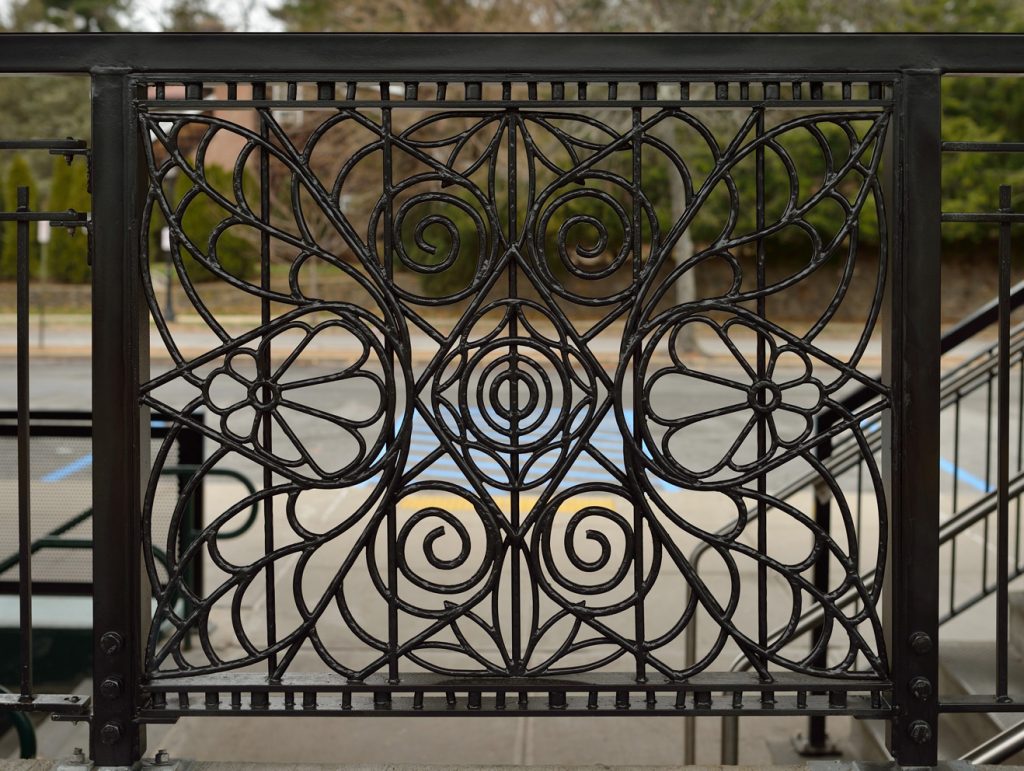
Butterfly cropped
Discuss the material you used and why?
I decided that my wood work would be best translated using black metal textured rods. Metal rods and wooden sticks have a similar cylindrical form, and I could texture the metal to resemble wood. The material needed to be totally weatherproof and stand up to the strict standards and guidelines of New York’s Metropolitan Transportation Authority. I wanted the metal to appear like my wood sticks. Together with the fabricators help, we came up with a unique way of working with the metal. Like my singular process of working with wood, the metal needed to be cut into small pieces and then welded and formed into the shapes and forms I had designed. This way of working was new to both of us, and it was a very exciting process to be part of.
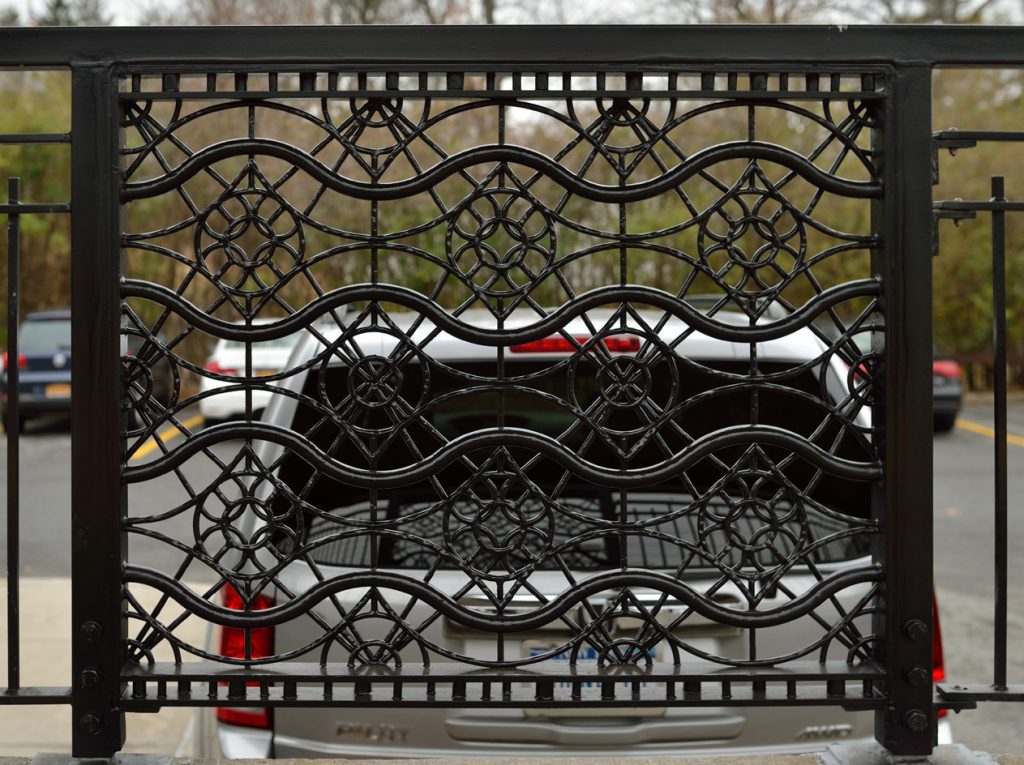
Lollipop cropped
Take one or two pieces of that have needed much taming.
Before I start a new sculpture, I usually do a pencil drawing first in my sketchbook. This drawing frequently is about the final form and what I want the shape of the completed work to look like. I don’t always take into consideration how I’m going to get from Point A (the drawing) to Point B (the finished work). That’s where the difficult part comes in. I am giving myself a challenging task and it’s almost like, why did I just give myself this impossibility?!! So, for instance, when I went about building “Albutilon”, I knew that I wanted all the petal like forms to touch, but I had no idea how to make that happen spatially.
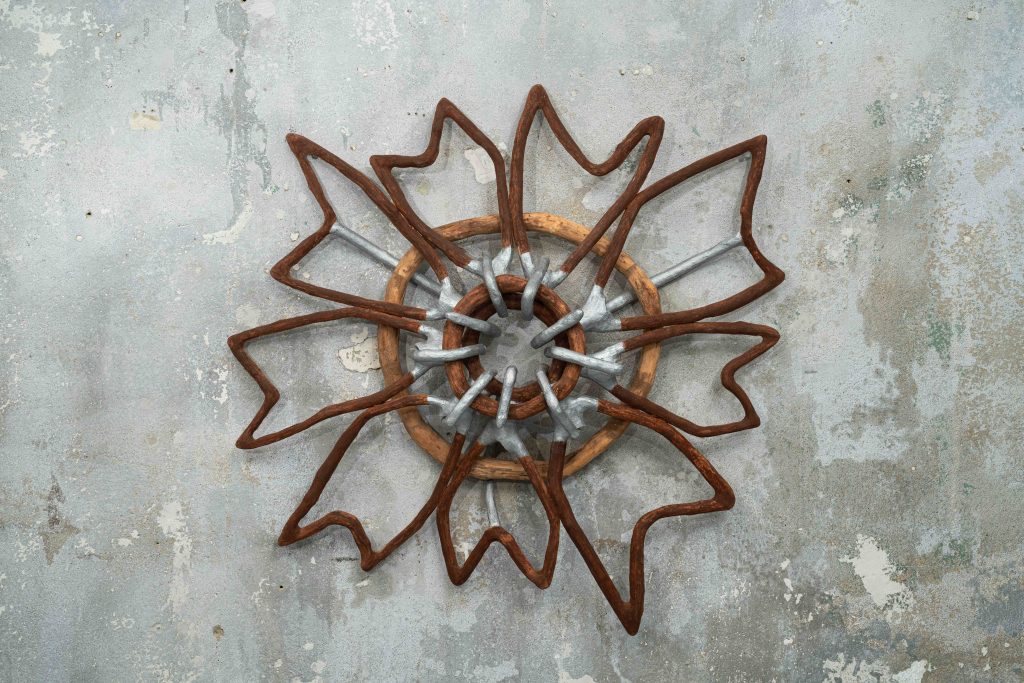
Albutilon, 2022, 118 pieces of wood, pastel, linseed oil, silver metal coating, 33 x 32 x 17
So, for this work, I drew a preliminary drawing in my sketchbook, and then had to draw a larger full-scale drawing. That larger drawing became almost a dress-makers pattern that I could follow to help guide me.
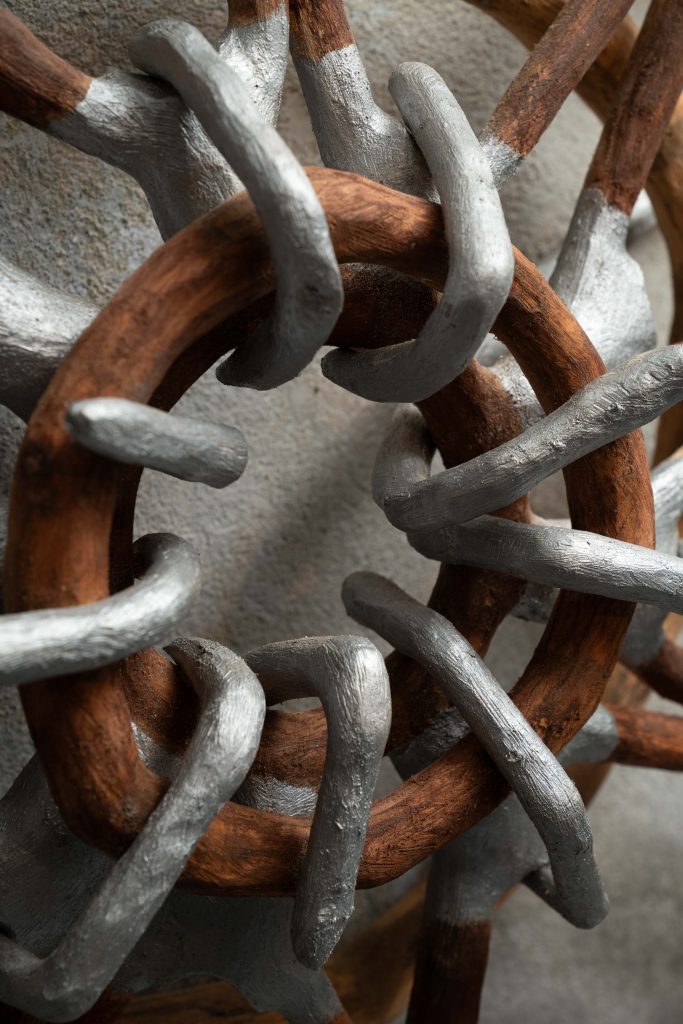
Albutilon (center side super close up), 2022, 188 pieces of wood, with pastel, linseed oil and silver metal coating, 33 x 32 x 7
I laid the small pieces of wood right on top of this full-scale drawing. I had never done that before with a sculpture, but this work demanded a new way of working. This work was very complicated to build, and it took 118 small pieces of wood that were seamlessly jointed together to make it come to life.
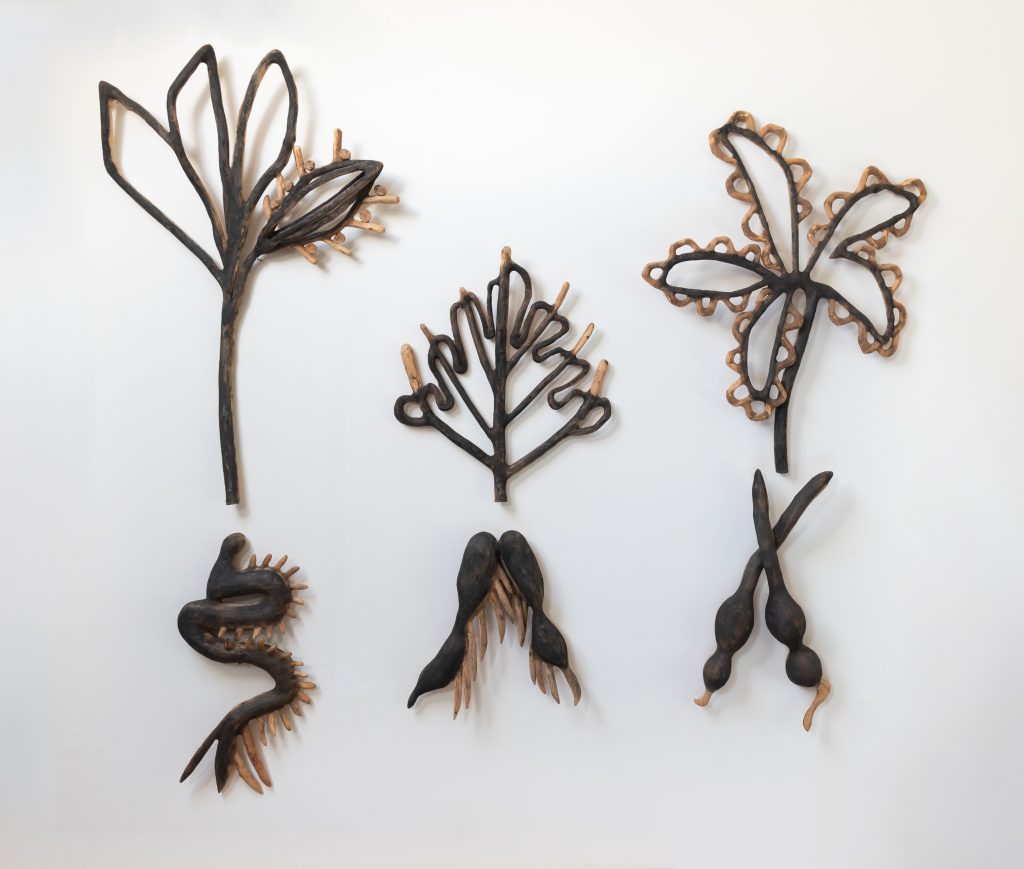
Specimens (full view), 2018,287 pieces of wood with graphite, 46x56x5
Another work, “Specimens” had so many twists, turns and angles in it that it took me months to build. This six-part wall work was made from 287 small sometimes tiny, sometime carved, pieces of wood that were jointed together and then covered with powdered graphite.
Comment on your older work in clay.
‘Take the Money and Run’.
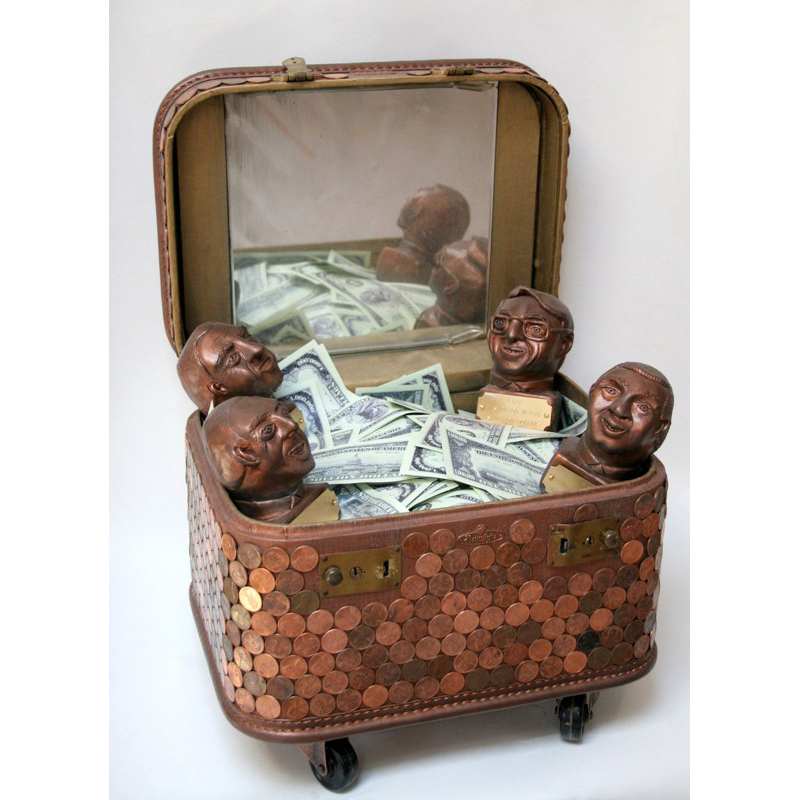
Take the Money and Run
My clay work came about during a very difficult period for me. I didn’t have the energy or time to focus on creating my wood sculpture. Each wood sculpture needs hundreds of hours to create and build. For a year I didn’t have that calm focused energy or strength for this type of creative outlet. I needed to work with something that gave me more immediate results. I started making clay portraits that could be finished in a couple of days to a week instead of taking months to build. I started working with self-hardening clay and sculpted portraits of people that were profiled in the pages of the New York Times. This was 2010-2011, the time of the financial crash and the subsequent bank bailout, the Arab Spring, and the Fukushima disaster. These were the stories at that time that were captivating me both emotionally and politically.
The political background?
“Take the Money and Run” shows four CEOs from four separate financial institutions and how much money each made because of their golden parachute. These CEOs became extraordinarily wealthy while the Main Street investors were completely wiped out. These clay portraits were the CEOs from four financial institutions: Merrill Lynch and his $161 million dollar payday, Countrywide Financial and his $121 million dollar bonus, the CEO from Washington Mutual who made off with $18 million dollars and the head CEO from Lehman Brothers that made $22 million dollars. These four CEOs are nestled in a suitcase filled with hundred thousand dollar bills and the exterior of the case is covered in pennies. The vintage travel suitcase has an interior mirror so that the heads with an engraved brass plaques that states their financial payday are now reflected in the mirror and I put heavy duty casters on the bottom. So, “Take the Money and Run” seemed like a perfect title. This work now lives on my studio floor.
Take one clay work and discuss it in detail. Also, why you have chosen this one?
The final work from this period was a work called “Dreams of Our Ancestors”.
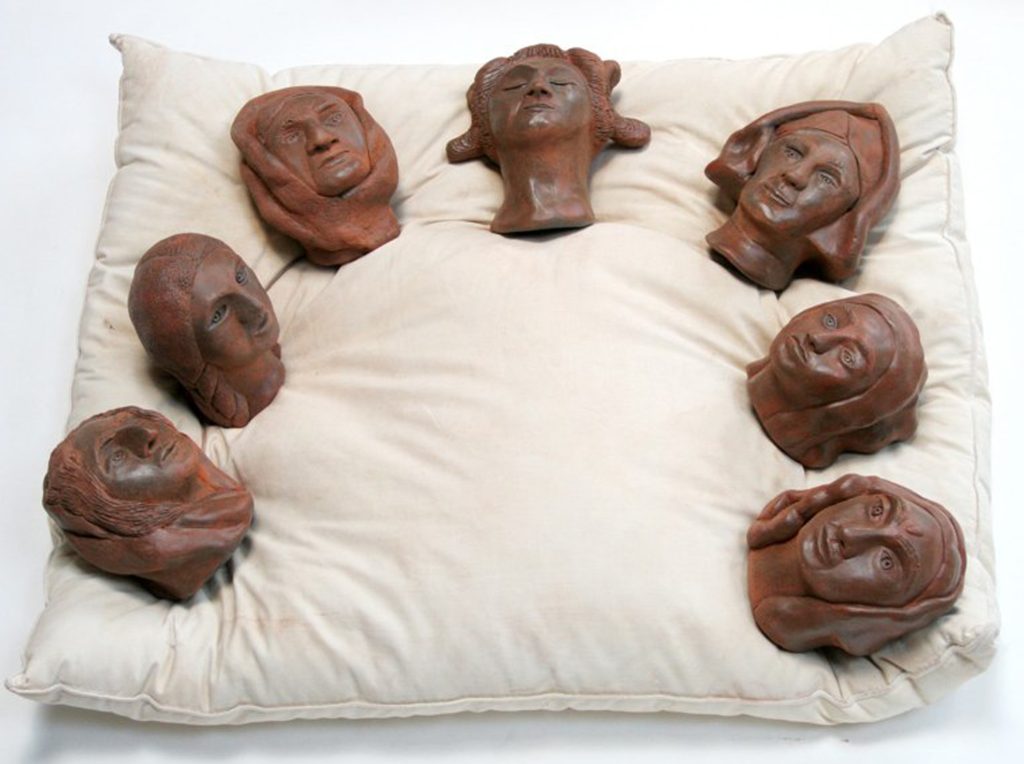
Dreams of our Ancestors
This work portrays seven extraordinary women, each of whom had a profound impact on a world religion. Women such as Sun Bu’er, the first Taoist; St. Kateri Tekakwitha, the first Native American ever canonized by the Catholic Church; Margaret Fell Fox, who was known as the mother of the Quakers and the founder of the Religious Society of Friends, Mirabai, a 16th century poet, mystic and Hindu saint who was devoted to Krishna and Hildegard de Bingnen who was a saint, visionary theologian, musician, polymath, artist, scientist and Benedictine abbess from the Middle Ages. These seven women are all together, resting and dreaming together on a pillow. As strange as it sounds, it was the strength and energy from these dynamic women that helped to heal my distress.
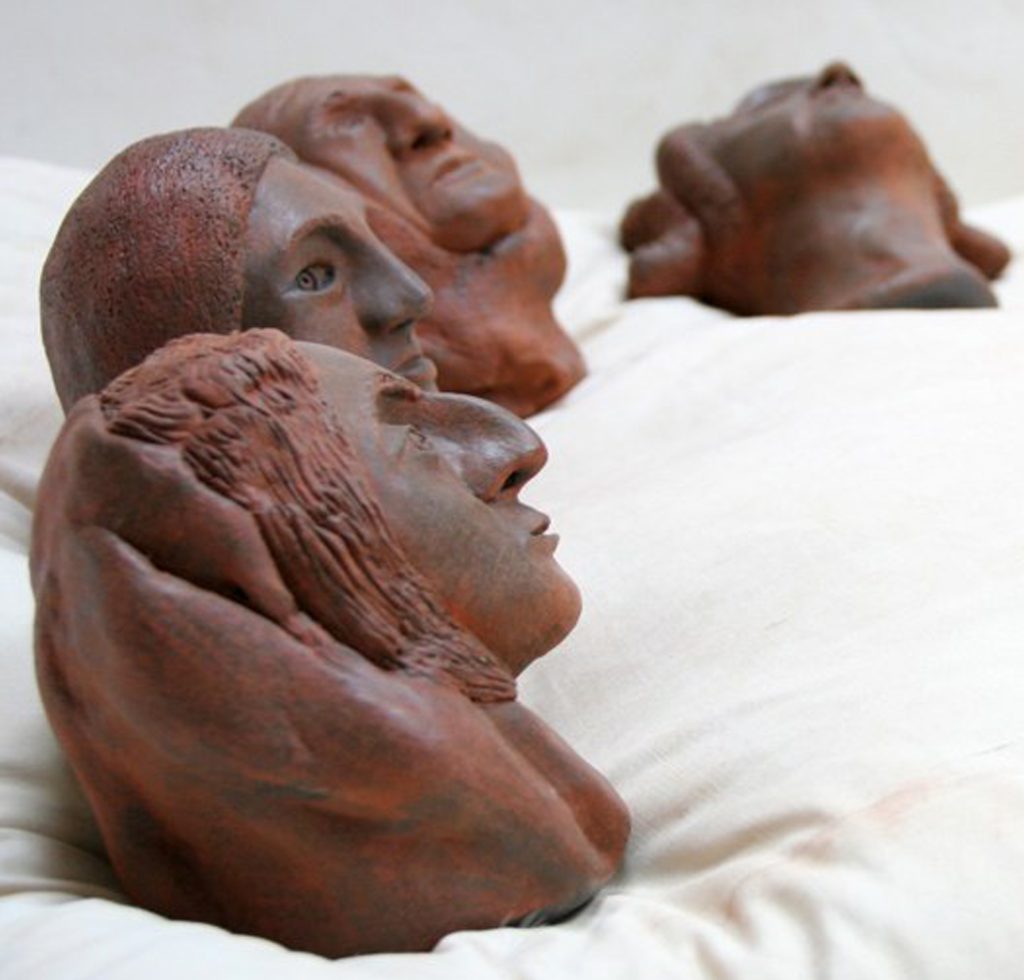
Dreams of our Ancestors detail
I realized that my source in creating art does not come from a place of anger or politics but rather from a more connected interior space. Completing this clay series allowed me to finally return to my wood work with renewed vitality and inspiration.
You are very diligent and do a drawing every morning, discuss.
Each sculpture that I build takes me a minimum of a month to construct. As previously mentioned, I used to be a painter, and I was really missing working with colour. I also missed the immediacy of creating work and seeing results quicker. I needed those “art” endorphins coursing through my mind and body. I also needed to be making work that takes up less physical space, something that is always a sculptor’s dilemma. I came up with what I call my “morning drawings”.
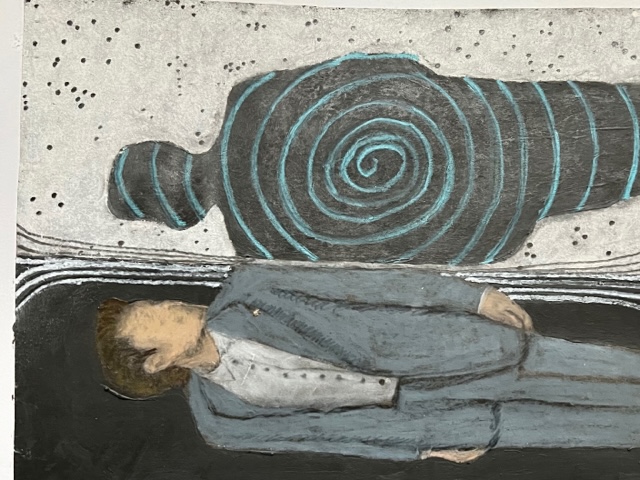
Parallel Lives
I usually read The New York Times daily and tear out images that strike me. From there I go about working on my drawing in an 11 x 14” sketchbook. Each drawing is usually based on an image found in the paper. I frequently work on the drawing when I first get into my studio in the morning, and I might continue to work on it for several mornings till it’s completed. It’s a way that I trained myself to focus and not get so distracted and be productive at the same time. I use many different materials in working on these drawings such as: crayons, chalk, powdered graphite, earth, matte medium, pen, watercolours. I had a college art professor from when I spent a year in France who taught us that if you put your body in the position of work, then the work will flow from there. This was one of the most useful words of wisdom that I learned throughout all my art classes. I repeat it frequently and it has become my daily mantra. I find beginning-starting a workday is frequently the most challenging for me. My morning drawings are a simple way to sit at my drafting table and begin to focus and start my workday.
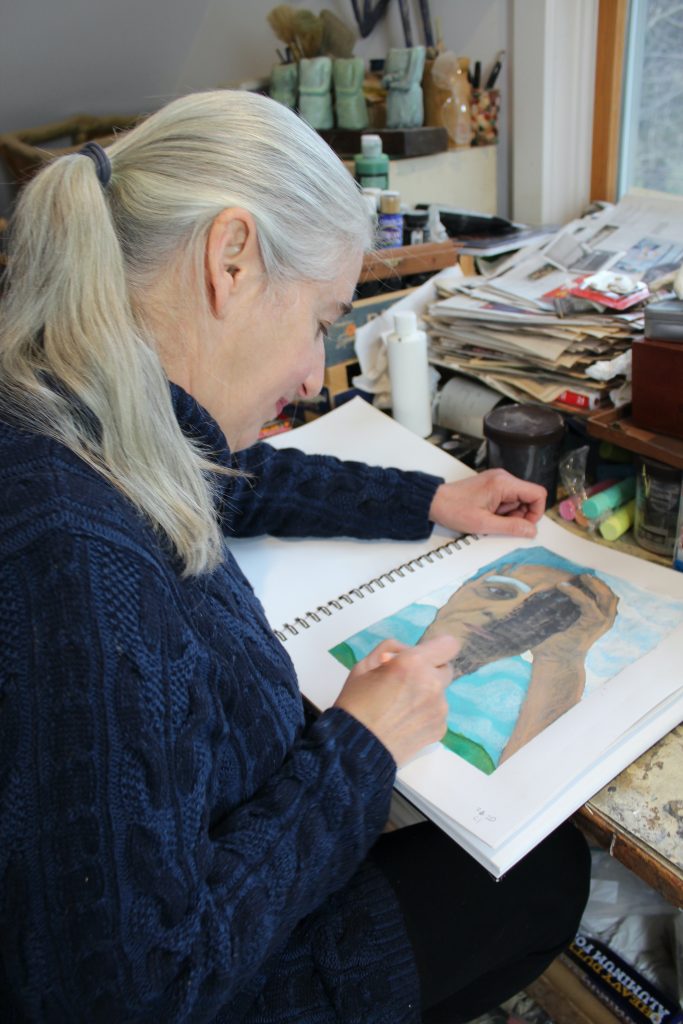 Contact:
Contact:
Loren Eiferman
Loren Eiferman@gmail.com
Instagram: @loreneiferman
Deborah Blakeley, Melbourne, Australia
Interview by Deborah Blakeley, April 2024
Images on this page are all rights reserved by Loren Eiferman
Julie Payne
You have been short listed for the Glover Prize on several occasions. Can you explain your work, and a little about the Glover Prize?
The Glover Prize is a prestigious landscape prize celebrating the Tasmanian landscape. I love being part of this exhibition as it always pushes the question of what constitutes “landscape”. My submissions are always specifically made for the “Glover” and often will examine emotive aspects of experienced memory and place. I grew up in the semi -remote north east of Tasmania and always look back at this time for visual stories to tell.
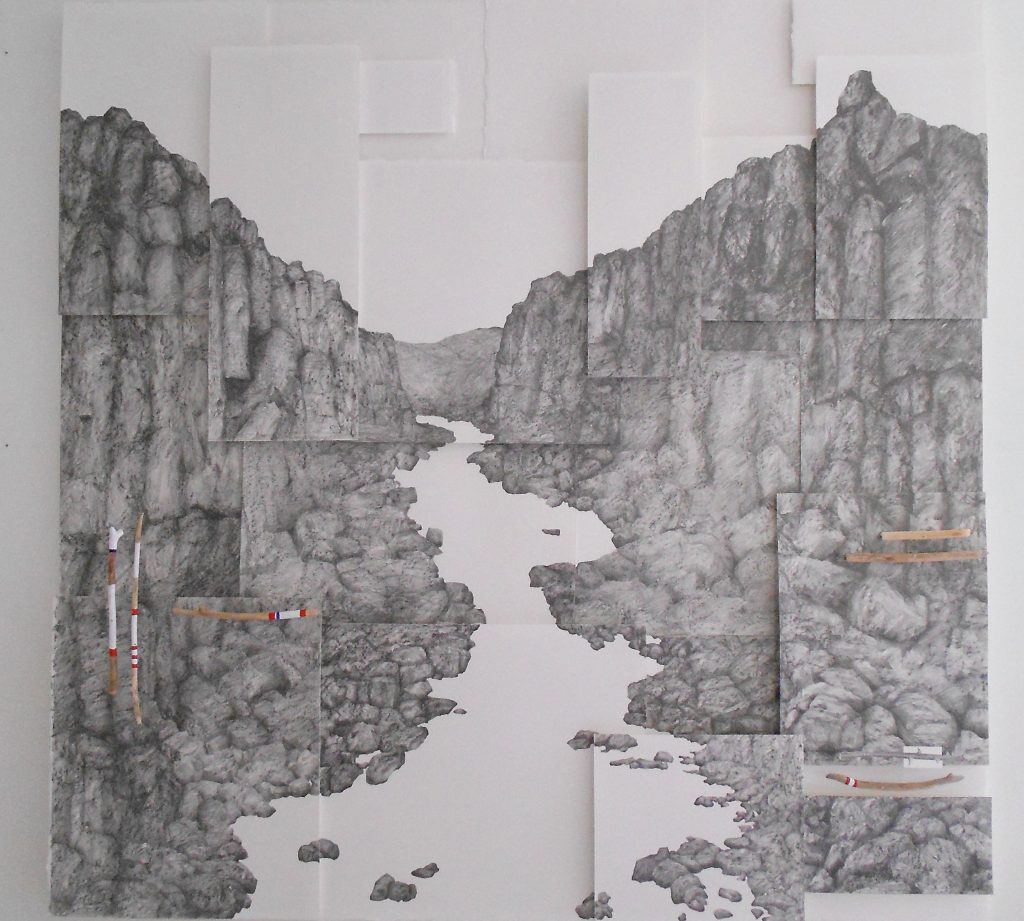 Glover Prize Finalist Drawing “The Gorge in a Hundred Parts
Glover Prize Finalist Drawing “The Gorge in a Hundred Parts
Take ‘Spring Carnival’ and discuss the work and how you combined watercolour and pencil.
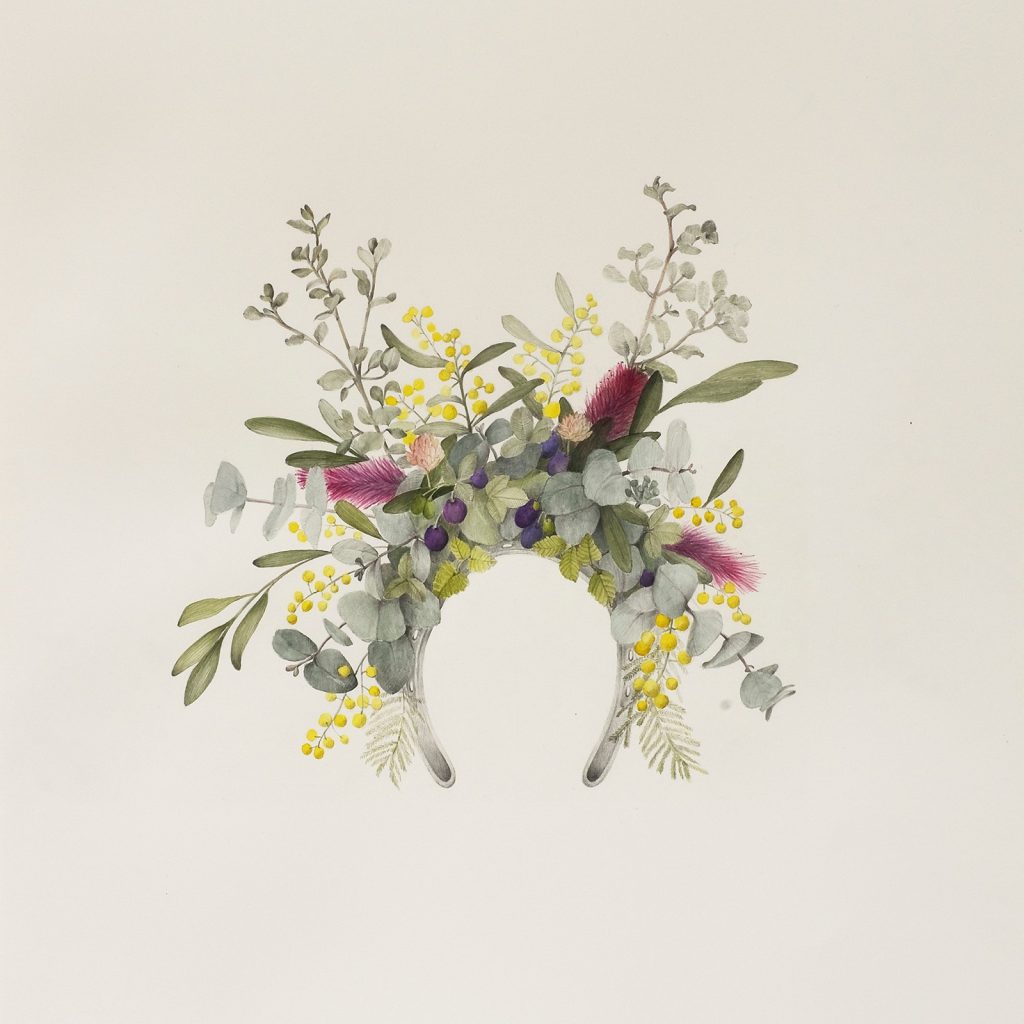 “Spring Carnival” Pencil + Watercolour wash
“Spring Carnival” Pencil + Watercolour wash
I have always been interested in the play of known objects and combining additional elements to form another object. In this case it was the “fascinators” worn at spring carnival horse races and connecting the horseshoe as the basis of the headpiece and then attaching abundant native flora to form the fascinator.
Prior to this work I had been producing work only using graphite pencil but wanted to experiment with colour. With great tenacity I started to see how well watercolour and graphite can be combined. This then led to much greater confidence with colour in later work.
The importance of symbolism in this work.
I tend to use symbolism a lot in my work to initially capture the viewers gaze and once I have their attention, I want them to bring them on a journey of storytelling.
In Spring Carnival, the clue was the horseshoe and then it’s not such a leap to start thinking about horse racing, costume and place.
In the “Text Gardens” ie “The Garden of the Lost and Forgotten” superfine grass seed is used to establish the link with colonisation of the Australian landscape.
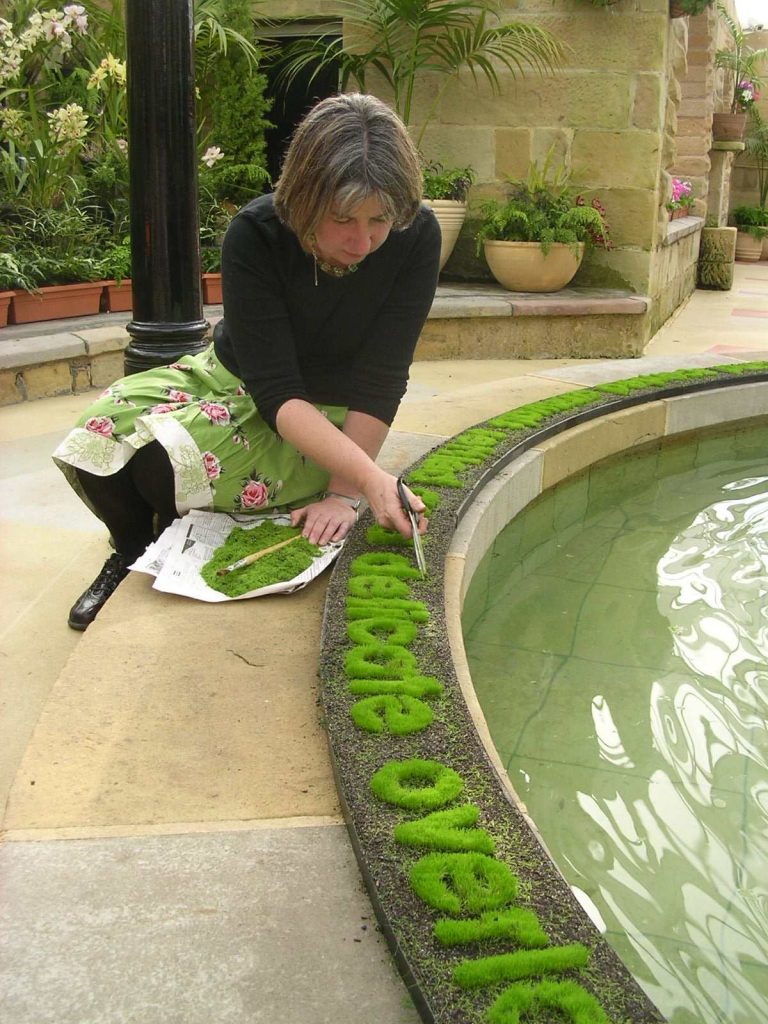 “The Garden of Human Happiness” grown grass text -detail of cutting. Tasmanian Royal Botanic Gardens.
“The Garden of Human Happiness” grown grass text -detail of cutting. Tasmanian Royal Botanic Gardens.
Comment on the importance of nature in your work.
During Art School I studied as a sculptor and loved the work of site-specific artists such as Richard Long, Rosalie Gascoigne, Andy Goldsworthy, Ken Unsworth, Anthony Prior, among many. All, at that period, were looking at a new approach to what sculpture could be and seemed to enjoy the direct response to a specific landscape.
Coming from a Sculpture department filled with noisy heavy machinery and time-consuming processes, the alure to making ephemeral art installations in the natural landscape was very attractive.
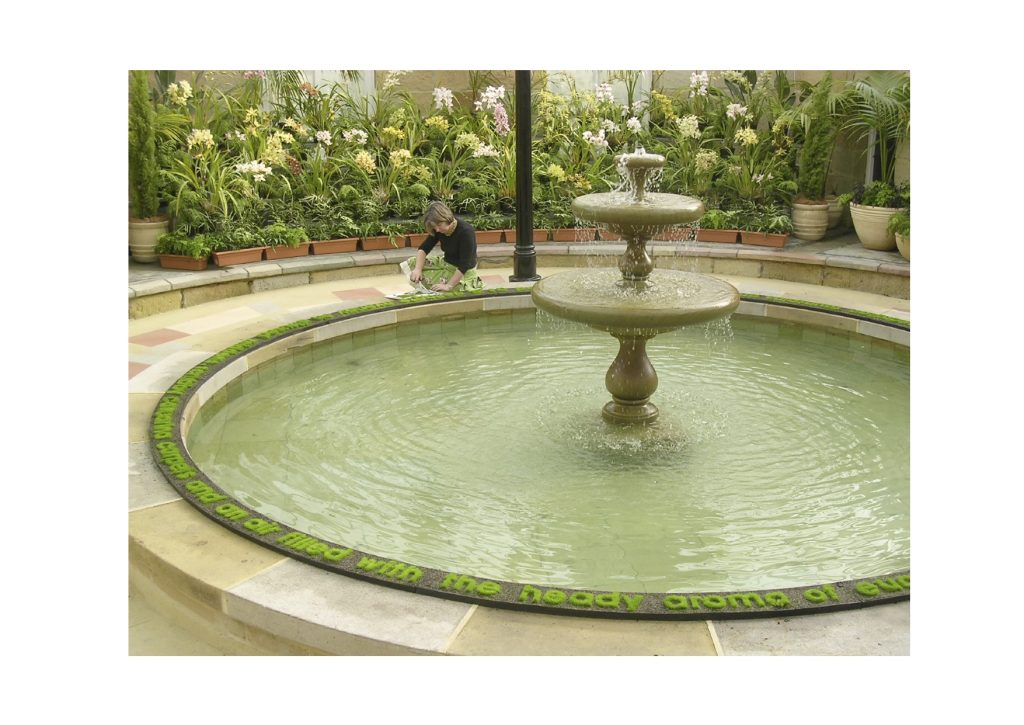 “The Garden of Human Happiness” grown grass text - Tasmanian Royal Botanic Gardens.
“The Garden of Human Happiness” grown grass text - Tasmanian Royal Botanic Gardens.
How have you extended Botanical art to one with your own twist?
I started looking at botanical art as a return to drawing after studying and practicing architecture. Architecture requires exceptional care in details and botanical drawings worked on a similar level. However, I was not interested in the scientific principles of botanical work and instead used plants as symbols for storytelling. For instance, “Journey through the Contents of a Fridge” was a fun reminder of all the forgotten plants that congregate and form their own colony in unseen human made spots.
How does living in Tasmania influence your art?
After working in Brisbane, Melbourne and Darwin I realised the uniqueness of having a strong family connection to the north-eastern region of lutruwitta/Tasmania.
It was a raw and unprivileged childhood background that allowed immense scope for working out the way of the world on my own terms. It’s also incredibly beautiful place along with being a microcosm of political dissent, tragic colonial history and populated by extraordinary people that seemed to be sifted down to the bottom of Australia. There is plenty to be inspired by in the State.
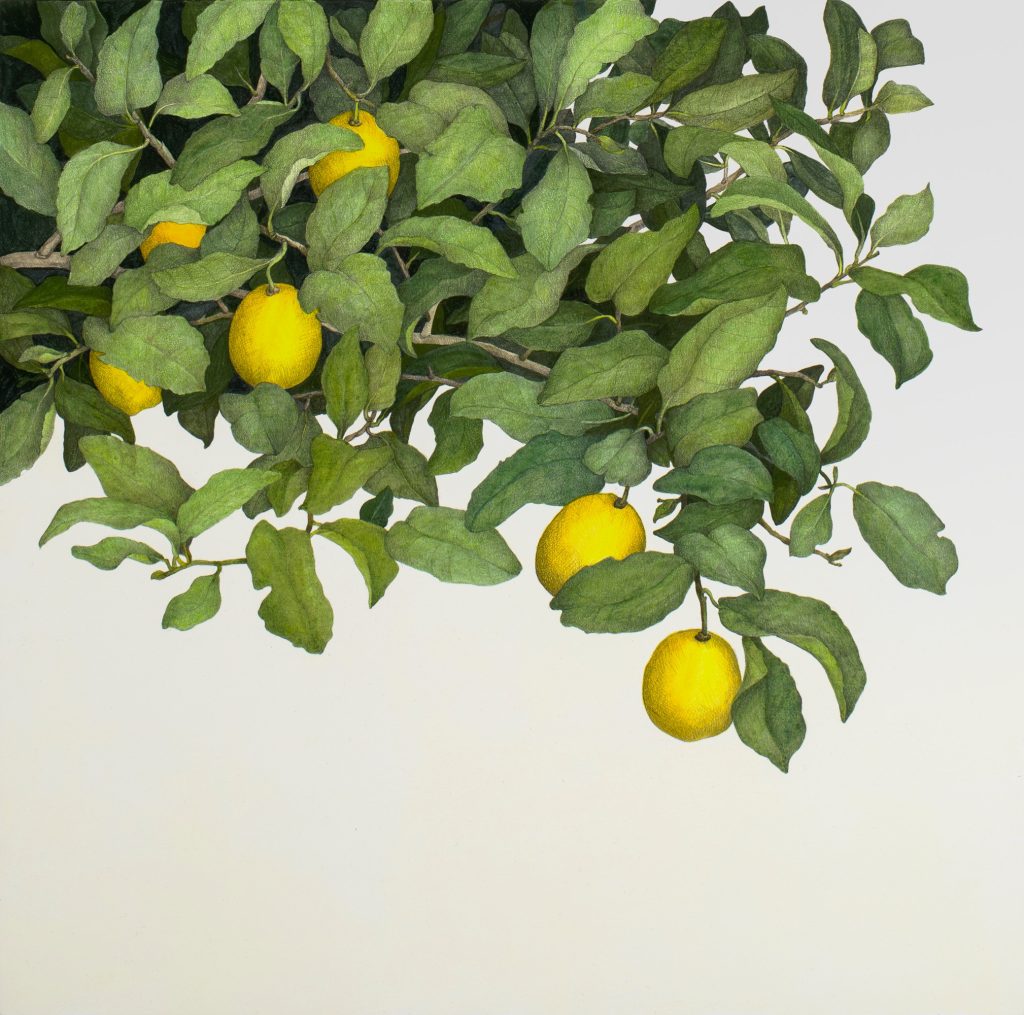 “Lemon Spritz” Watercolour + Pencil
“Lemon Spritz” Watercolour + Pencil
How does the art society in Tasmania nurture you and your art?
I don’t really have a connection to the Art Society apart from a few workshops to teach form techniques in drawing + colour washes.
Tell us about your studio?
I feel so incredibly lucky to have a studio at the Salamanca Arts Centre on the waterfront of Hobart.
Making art can be a very lonely occupation at times so greeting my studio buddies is a very positive way to start the day.
There are eight individual studios in our section of SAC, each occupied with dedicated professional artists. Although we mostly simply get on with our work after an initial greeting, we do have occasional celebratory gatherings to mark individual achievements. It’s a very positive working environment.
Of course, I could mention that the studio is spacious, light and located in fabulous Salamanca Place but it’s the heartfelt sharing that is number one.
Comment on your series, Flood Sticks, and your environmental presence in Tasmania.
Flood Sticks is a story based in memory and fragility while also showcasing the beauty of the Cataract Gorge in Launceston.
The “Flood Sticks” series focuses on the wildness of the Gorges that geographically divides the city. It is known for their spectacular and dangerous flooding events as well as its calm summer beauty. The sticks have been collected, stripped bare by the raging floods, and juxtaposed with the fragile boat vessels.
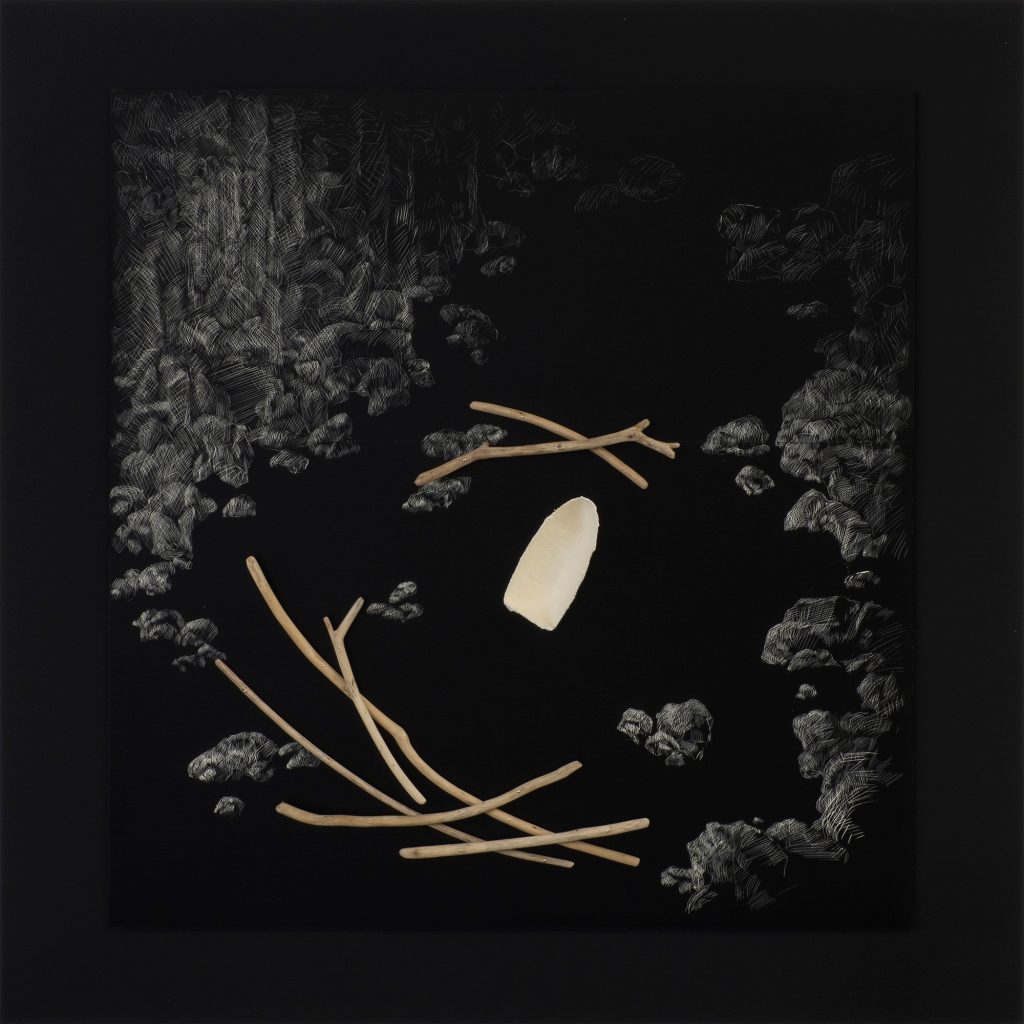 “Flood Sticks” Scratchboard + collected flood sticks from Cataract Gorge.
“Flood Sticks” Scratchboard + collected flood sticks from Cataract Gorge.
You use many, different background papers in your work. Comment on this, particularly in relations to ‘IXL Still Life’.
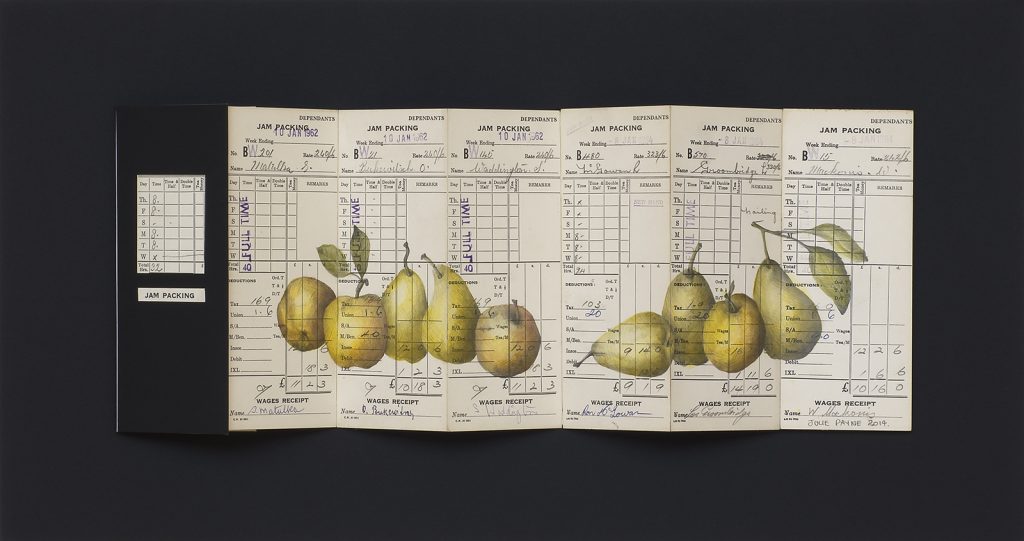 “IXL Still Life” Watercolour and Pencil over salvaged timesheets in concertina format.
“IXL Still Life” Watercolour and Pencil over salvaged timesheets in concertina format.
Experimenting with different papers is similar to a painter experimenting with different “grounds” on a canvas. Each produces a different effect and takes the initial preciousness away from starting a drawing.
In the IXL Still Life series, old timesheets from the Henry Jones IXL Jam Factory were collected, after the site was abandoned, and reused them in a linear format to imbue them with the fruit that was processed on site while also paying homage to the workers.
You have also extended this by putting your work in a book format, comment.
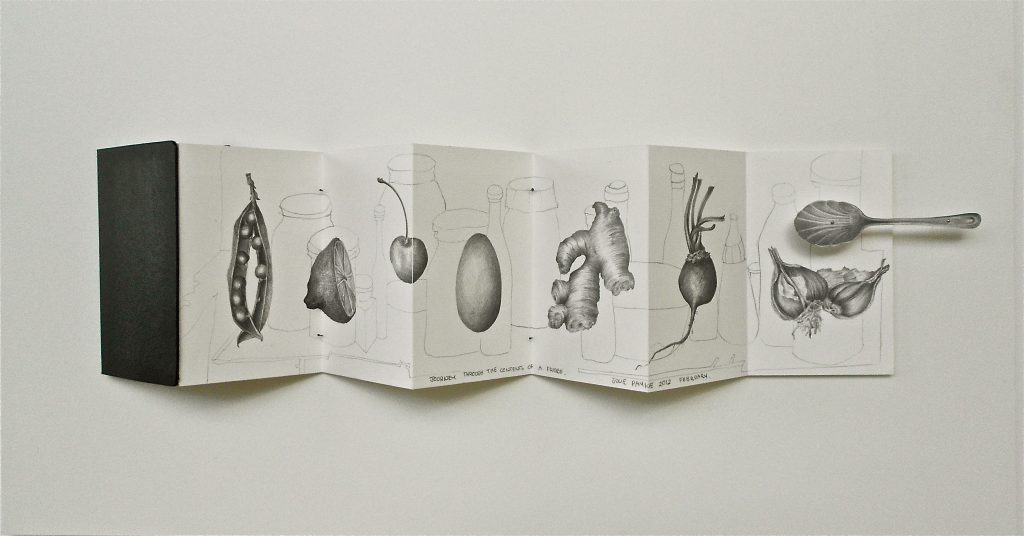 “Journey through the Contents of a Fridge” pencil on paper.
“Journey through the Contents of a Fridge” pencil on paper.
The concertina book format was chosen to suggest a processing line and telling longer individual stories.
Discuss the use of humour in your work.
Along with tackling many political and emotive themes, I do enjoy a laugh as well.
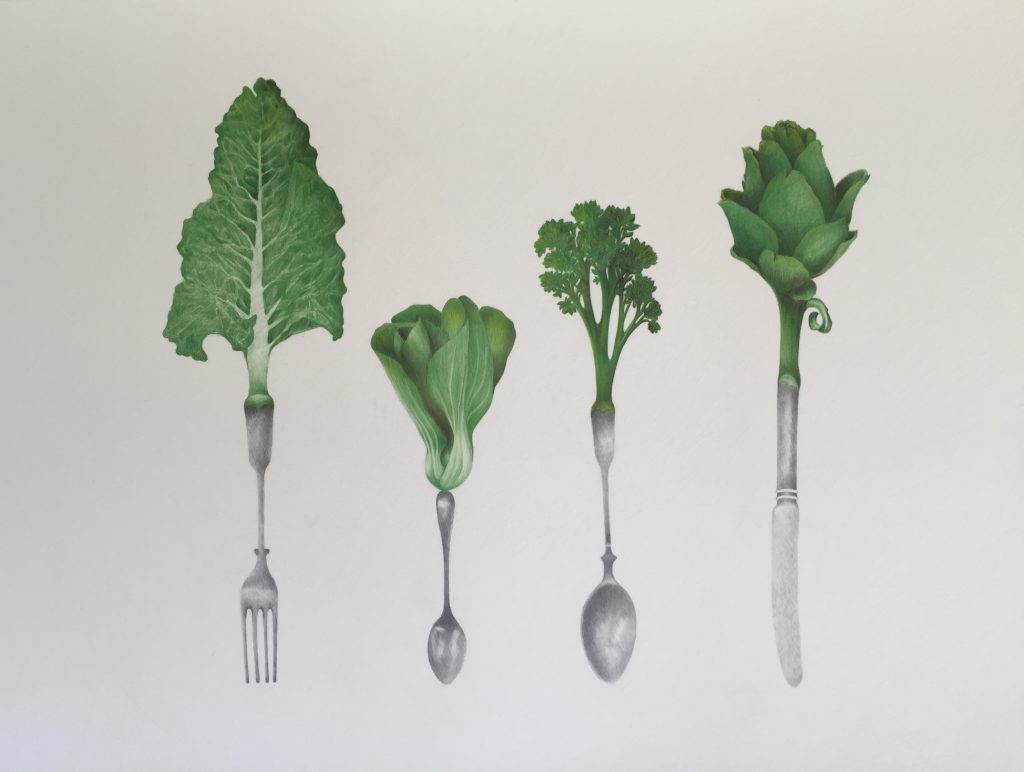 “The Culinary Greens” Graphite and coloured pencils.
“The Culinary Greens” Graphite and coloured pencils.
“The Culinary Greens” started as an exercise in using luscious, coloured pencils. It soon developed into a story of eating your greens and different families of vegetables. I saw the Culinary Greens as the apex family that everyone aspires to.
Beyond your studio, into gardens. How did this become such a large part of your art practice?
In 2001 I was commissioned to produce artwork to celebrate the opening of the Queen Victoria Museum, Inveresk site in Launceston. It was a disused railway yard employing hundreds of workers during its days. The Museum restoration had sanitised the huge site, eliminating the personal histories of tendered gardens and social gatherings that occurred. I liked to think that no matter how much new landscaping had been done, the tender history of site would always seep through and start telling stories. This is where the idea of growing text that suggested past activities originated. It was called “The Garden of the Lost and Forgotten” and I loved that you could not supress history so easily. It was also delightful tending this garden. It’s certainly high maintenance.
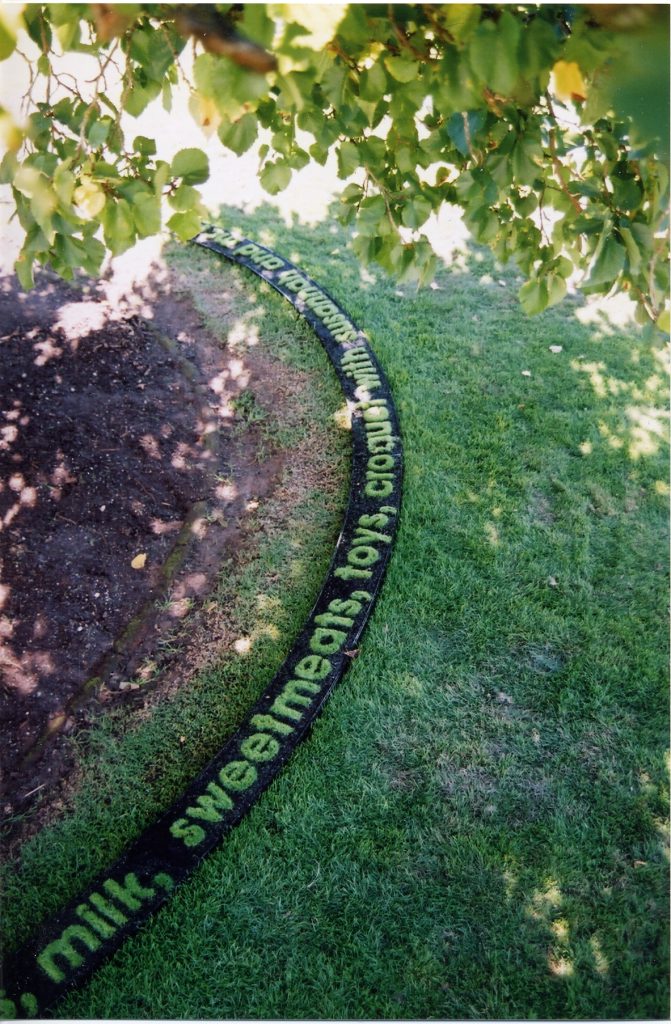 Garden of Loss and Desire” grown grass text - detail. Woolmers Estate
Garden of Loss and Desire” grown grass text - detail. Woolmers Estate
However, the process, the stories that could be told, and the clean visual impact was very satisfying and I went on to grow another four text gardens commissioned for various festivals.
Explain your commission within the Conservatory at the Royal Tasmanian Botanical Gardens?
“The Garden of Human Happiness” was grown specifically to tell a wandering story around the fountain within the Conservatory of the Royal Botanic Gardens.
 “The Garden of Human Happiness” grown grass text - Tasmanian Royal Botanic Gardens.
“The Garden of Human Happiness” grown grass text - Tasmanian Royal Botanic Gardens.
What other installations have you done?
Other site specific Installations have been created for Woolmers Estate, Festivale in Launceston, and Kelly’s Garden in Salamanca Place, Hobart.
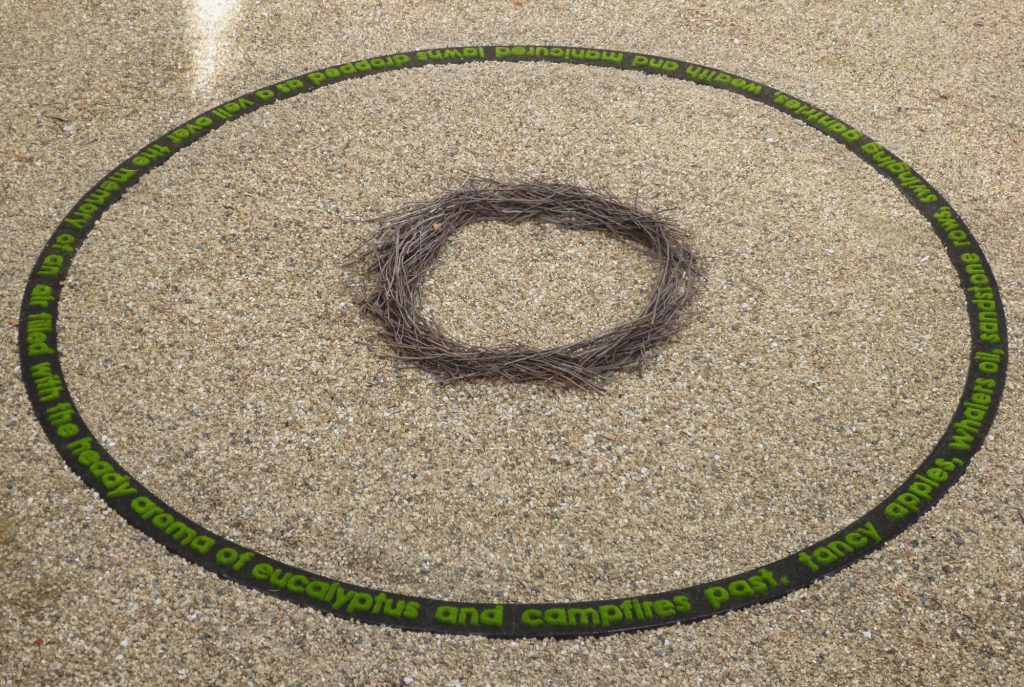 “Mr Peacocks Garden” grown grass text. Salamanca Arts Centre Hobart, Tasmania.
“Mr Peacocks Garden” grown grass text. Salamanca Arts Centre Hobart, Tasmania.
Ephemeral works locations have been located at the Cataract Gorge, Launceston; Fortescue Bay, Tasman Peninsula; Port Arthur Historic Site and Holly Bank Reserve.
How important is the weather for your installations?
A good downpour of rain is always welcome, although this often means a brisk growing session and lots of hand trimming with scissors. Gardens are always germinated in controlled greenhouse conditions until the words are stable enough for an outdoor location.
Does this art need both ‘Green Thumbs’ and tender loving care?
The art of Sculpture requires an artist to be a master of many crafts. One simply has to learn the craft and limitations of the material for each idea. Growing grass in the form of Helvetica Bold is no different.
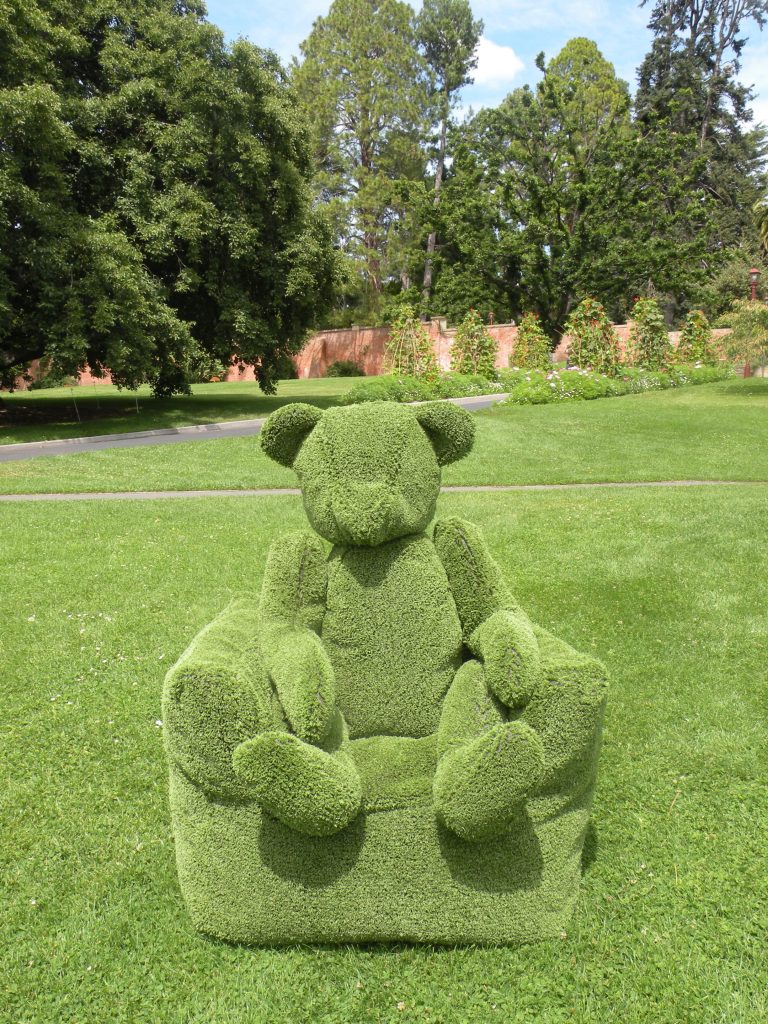
"Topiary Ted" sewn fake grass topiary
How did ‘Topiary Ted’ come to life?
“Topiary Ted” was a response to a group exhibition at the Royal Botanic Gardens in Tasmania. I thought it would be fun to upset the formalised gardens layout with some more unusual topiary. Obviously, I didn’t have the time to grow real topiary, so recycled tennis court Astro turf was sewn together to bring Ted into being.
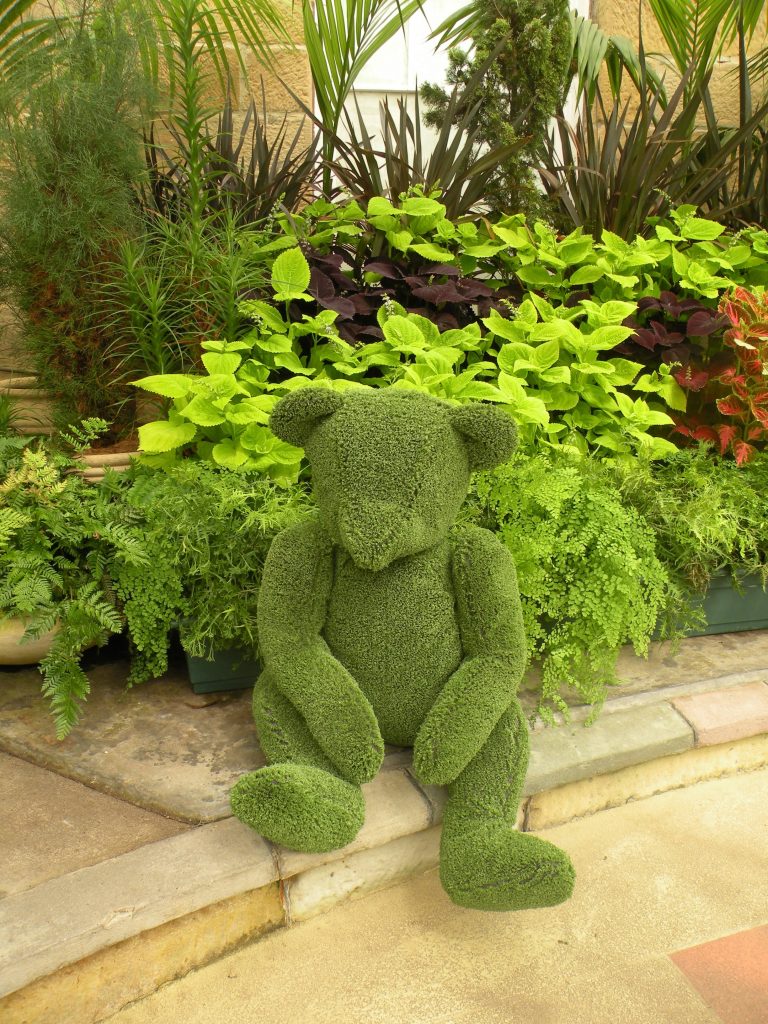
Ted was greatly loved, and I certainly learned the residual power of the childhood teddy bear on visitors.
Astro turf, fishing line and recycled plastic bags never seems to die, so three Teds now sit watchfully in my own garden.
Discuss Tasmanian history and your art?
There is plenty of Tasmanian history to examine and make comment on.
Tasmania has a history that is both culturally rich and, at times, devastatingly cruel and unequal.
Issues ranging from the in just treatment of the Palawa people and convict servitude to the privileged dominated the colonial times.
Relatively recent issues of deforestation, invasive species, environmental and social issues, and loss and memory have all been foundation ideas for various artworks.
Explain your involvement lecturing at the University of Tasmania.
Teaching at the University of Tasmania was a delight. After graduating in Architecture, I was asked to lecture three days a week in Foundation Studies with first year students.
In the second year of teaching at the School of Architecture, the School of Art invited me to teach Sculpture for the remaining two days available.
Although it was a bit crazy sometimes figuring out which school a student was in if I saw them out of context, I thoroughly enjoyed each and every student, yep, even the ratbag ones.
Teaching Sculpture at the School of Art taught me to quickly identify where a student was trying to head with an idea and hopefully assist with being able to distil the concepts’ essential qualities.
Teaching in the School of Architecture was a revision of the complex interplay of ideas, research, practicalities and building skills to think and draw three dimensionally.
You are busy doing residencies, take one that has led you to relook at your work.
I have been fortunate to be granted three studio residencies in France and Ireland. Each have had a positive impact in disrupting patterns of working but it was at Draw International in Caylus, France that was the most enjoyable. The quality of the participants is high, I thoroughly enjoyed discussing ideas, trying new less precious techniques and living in a small French community.
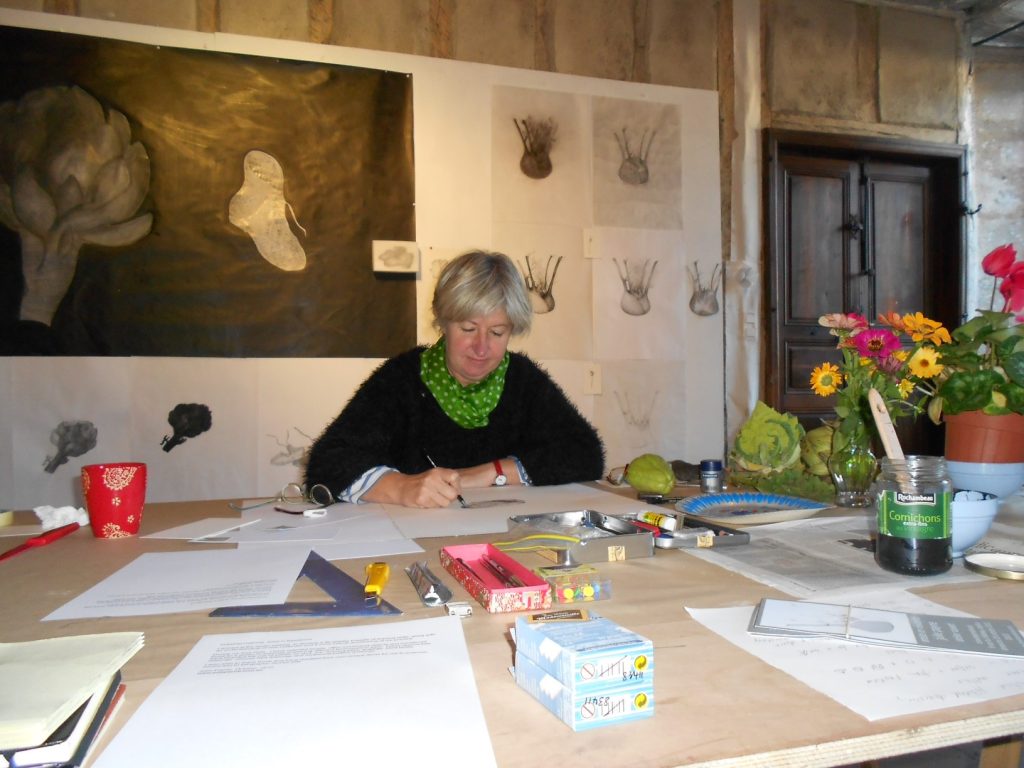 Studio at Draw International - Caylus, France
Studio at Draw International - Caylus, France
Contact:
Julie Payne
Details
Julie Payne
Tasmania, Australia
Deborah Blakeley, Melbourne, Australia
Interview by Deborah Blakeley, April 2024
Images on this page are all rights reserved by Julie Payne
Jerusha McDowell
What led you to open a Gallery and go beyond being a freelance photographer?
I studied photography and filmmaking at university and returned to photography following a very different career. I made the decision about two years ago to resign from my career in the Defence and Intelligence community to focus on photography as a full time career.
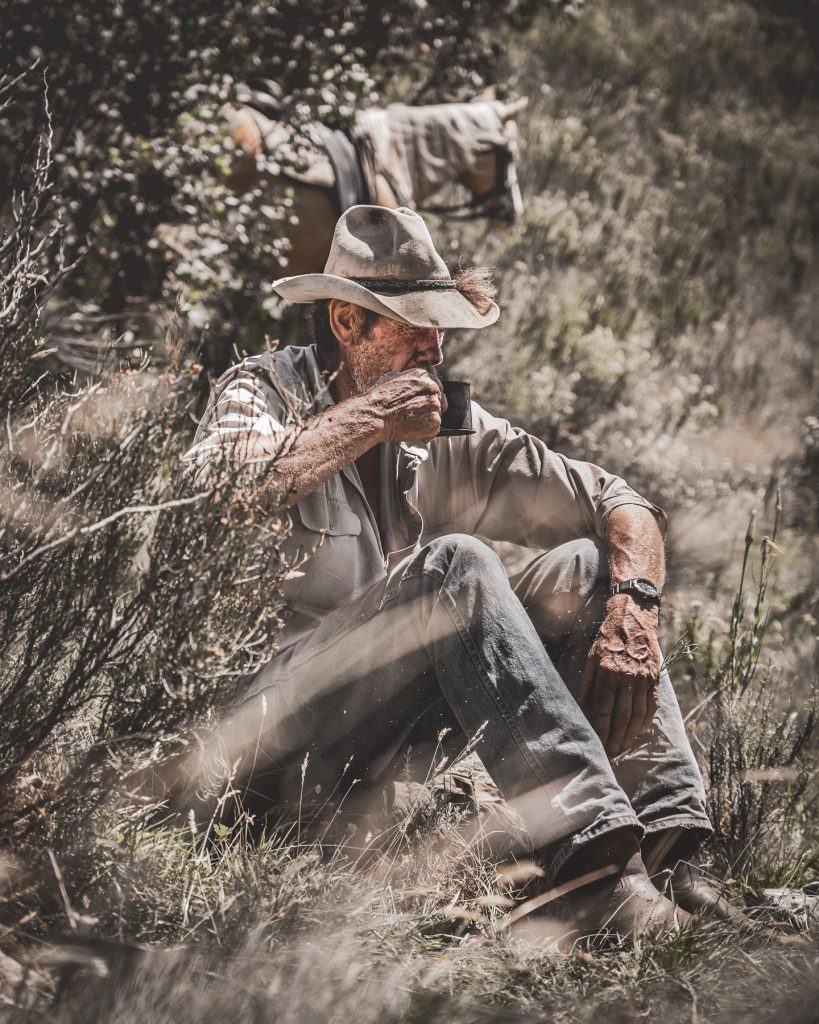
I opened the gallery exactly one year later, and it has been open now for a year. When I first returned to photography I began working as a freelance photographer doing equestrian events, and client work but I was always very focussed on developing my core landscape and documentary work and opening the gallery seemed the logical next step. There is something special about exhibiting your work the way it is meant to be experienced. The digital world is so vast these days it is easy for photographers to get their work seen without the need to print and frame and present the work. But to me a photograph isn’t really a photograph until it is printed. A photograph has such a journey from the decisions you make taking it, through the editing process, to the printing, framing, and exhibiting. The gallery is very important to me because it allows my work to reach that destination.
Added to this you are also a film maker. Tell us about this part of your professional life.
I studied both photography and film making at university, and I have always loved video and film making. I am getting the chance to do more film and video lately and I’m really enjoying it again. There will be a film component to the project I am working on in the Mountains. Right now, we’re just working through some of the logistics issues of carrying video equipment on horses.
Take us to ‘Your Australia’ through e crossing.
The Crossing is the first collection from a documentary project I am working on titled ‘Where the Snowy Mountain Stockmen Used To Ride’, photographing riding expeditions in the Australian Snowy Mountains. This is an ongoing documentary project with my friend, guide, and subject Mark Swan. It began simply, as an excuse to ride horses and shoot remote and beautiful landscapes.
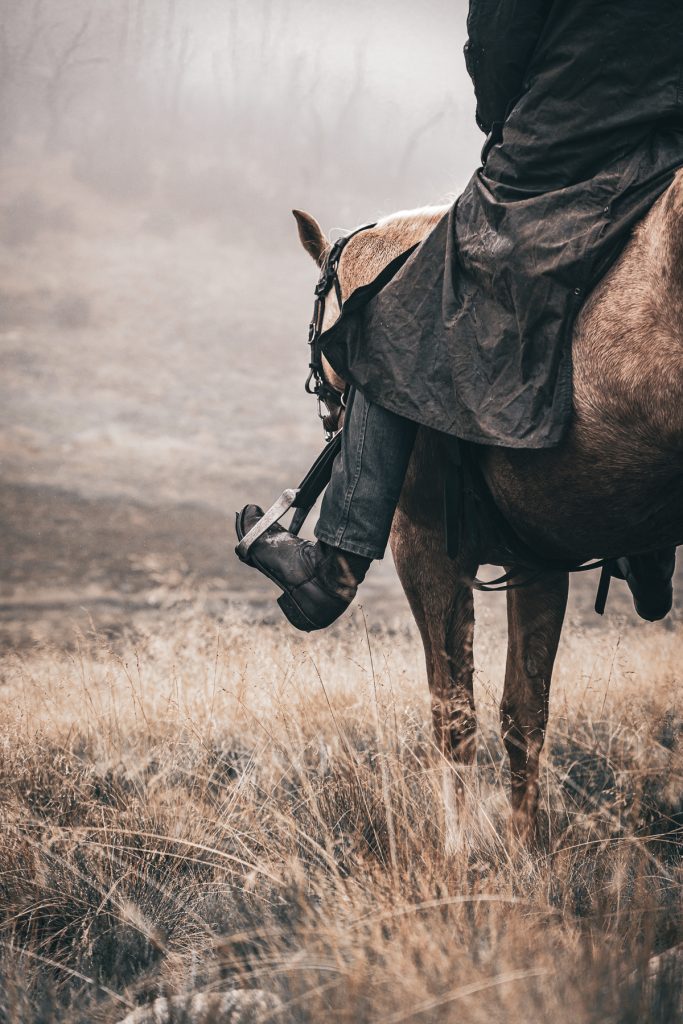
It quickly became something much more. ‘The Crossing’ collection shows a plateau crossing in bad weather near Tabletop Creek in the Snowy Mountains, and simple fireside rituals as we stop to rest and let the weather clear. Photography is about more than pictures. it’s about revealing things unseen. It’s about showing people something through your eyes. As a photographer your connection to a subject is the defining characteristic of storytelling.
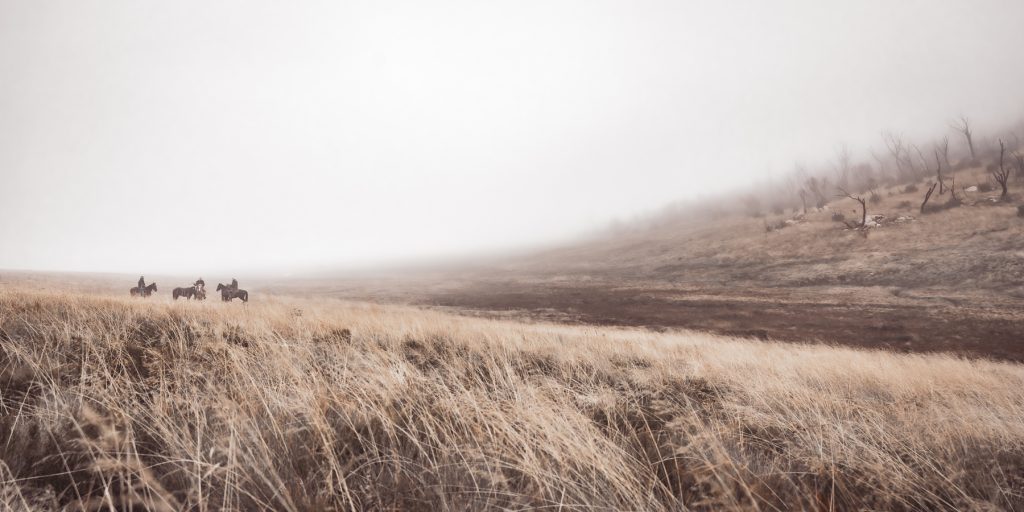
The weather up here changes so quickly, changing the entire landscape around you. The fog had closed in, blanketing the landscape, and making navigation uncertain. The wind and rain were driving in hard making lighting a fire seemingly impossible, and yet, with a little patience the quart pots were soon filled with hot tea. This project continues to be an amazing journey. Getting to capture the amazing people and places out here is one of the great privileges of my life.
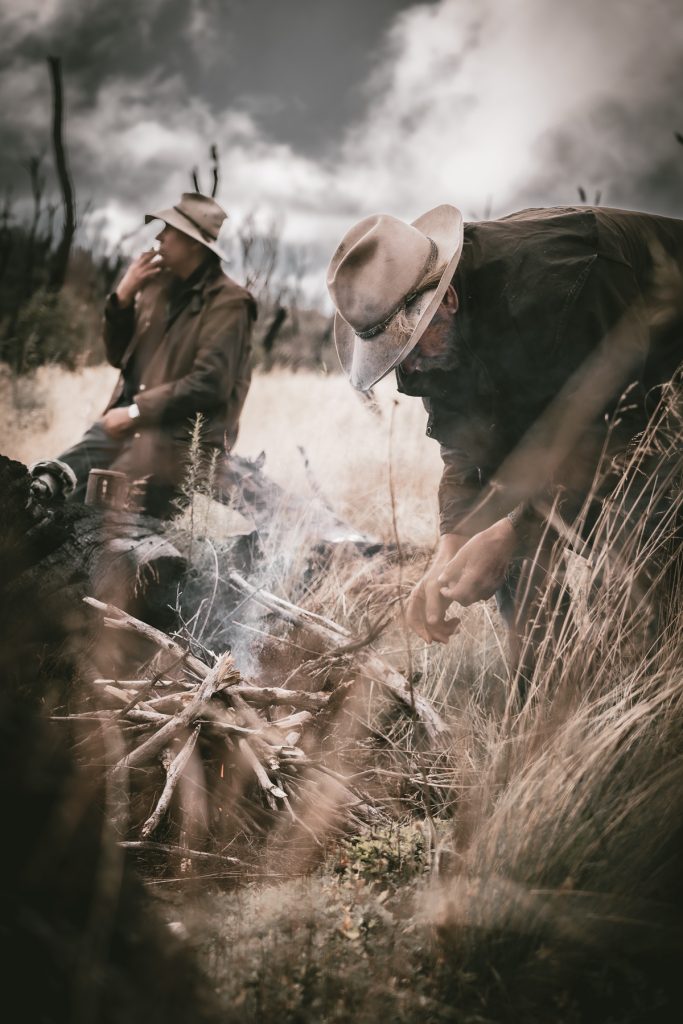
I have been overwhelmed with how this project has been received so far, it has been published in RM Williams Outback Magazine and has received a number of awards including a Top 5 in the International Photography Awards. Shooting in the mountains is never easy. The weather changes so quickly around you. The riding is hard, the environment harsh and unforgiving especially on sensitive camera equipment. But as an artist these are the projects you dream about.
Discuss the pleasure of cropping and highlighting images? E.g. ‘Buckled’
The editing process is interesting, I never really sit down with an image and know exactly where I’m going. I feel like every image has its own journey that it takes me on, not the other way around. The decisions you make when editing in photography are usually about what to leave out rather than what if anything you add. Cropping can change the whole story quickly by removing the clutter and distraction around an element you are focussed on. Buckled is a really good example of this. Where focussing on a much smaller part of the scene tells a more potent story.
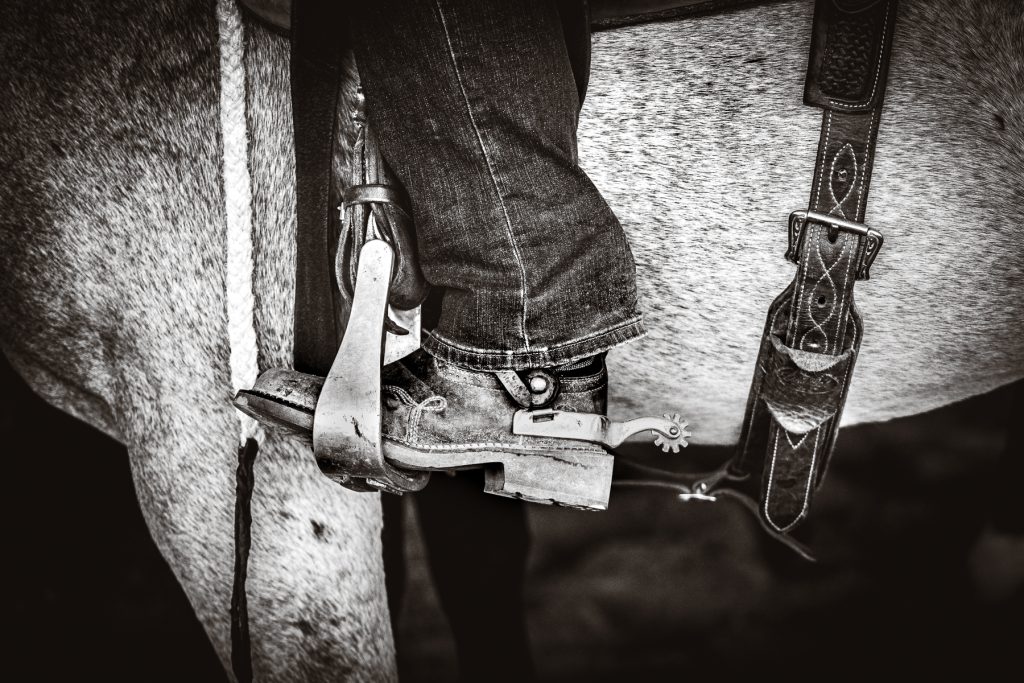
Comment about the importance of limited editions of your photographs?
Doing limited editions is something that was a natural progression after I opened the gallery. It reinforces that the photographs are a finite physical thing. This is really important in the modern/digital world I think.
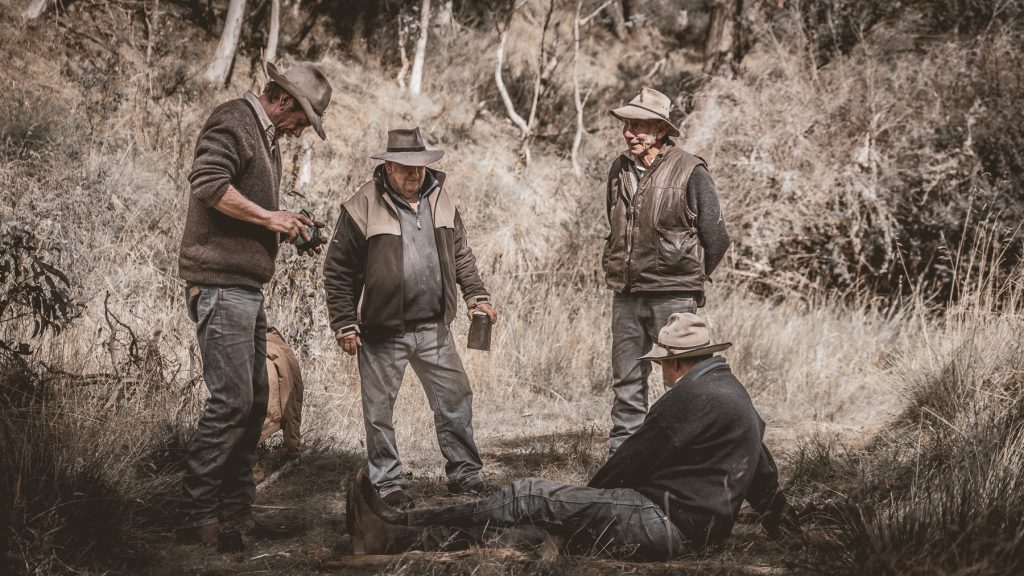
Also, smaller purchases, cards, and the sold-out calendar for 2024.
The gallery offers selection of fine art landscape documentary works as well as a range of cards and giftware.
HORSES…
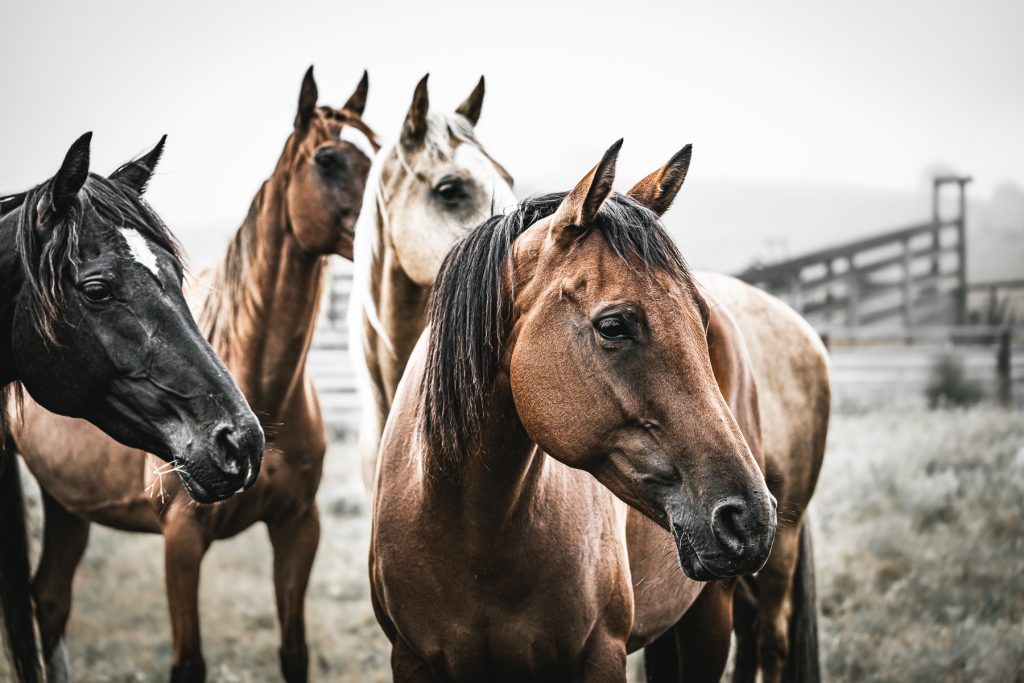
Tell us about your love of horses, which is so obvious in your work.
Horses are definitely a lifelong love affair, and one I am now lucky enough to share with my daughters. Horses force you to be honest, not just with them and with yourself. Otherwise, they see right through you. I am incredibly lucky now to be able to combine my love of horses, the bush, photography and storytelling in the one creative pursuit, and it feels like coming home. Photography teaches you many things, patience, the art of observation and above all perspective. You understand the power of perspective and your ability to change it. Photography and horses have been such an important anchor for me since leaving my national security career. The discipline and solitude of it has given me the space I needed to recalibrate.
Take one or two equine images and give us a short inside story that goes with the photograph.
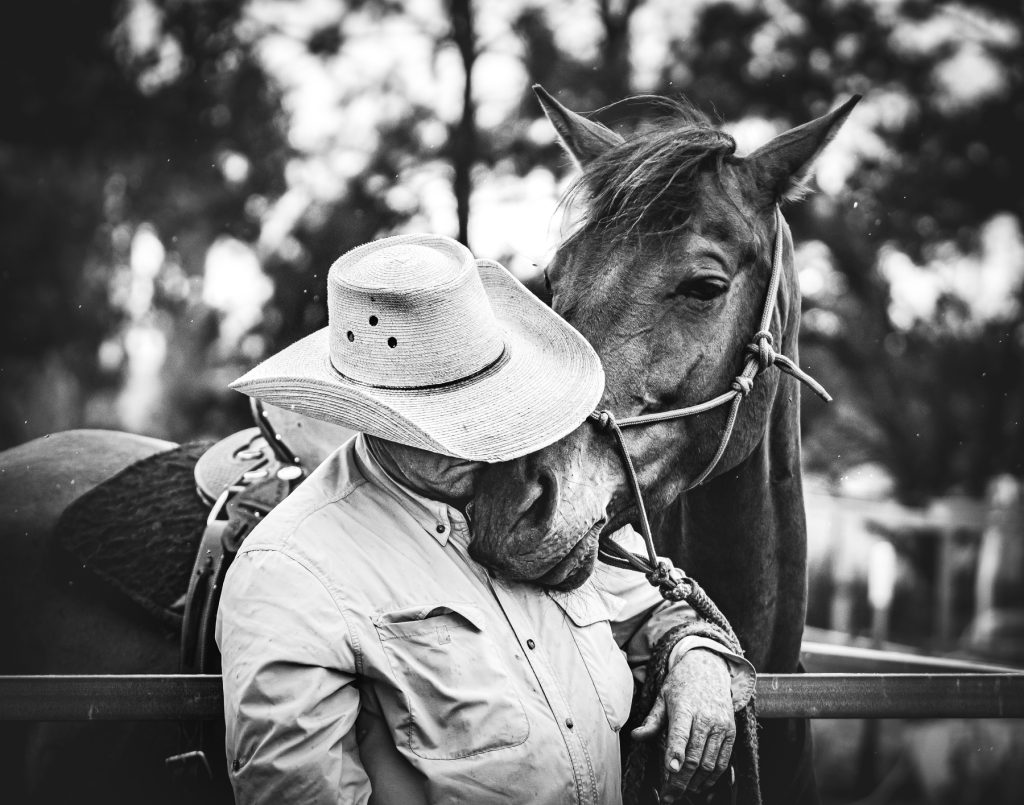
This shot is special and is probably a good example of how I moved from shooting events to shooting in a more documentary style. I now think of almost all my work as documentary photography. It is documenting people, horses, landscapes in a way that shares the world around me with the rest of the world. This image was taken at local horse event, but I was more interested in what was happening out of the arena. This was an incredibly tender moment as the rain began to fall Phil responded to his horse’s gesture, walking over and allowing a moment of connection which I was lucky enough to capture. I remember his response to the image was quite emotional.
LANDSCAPES…
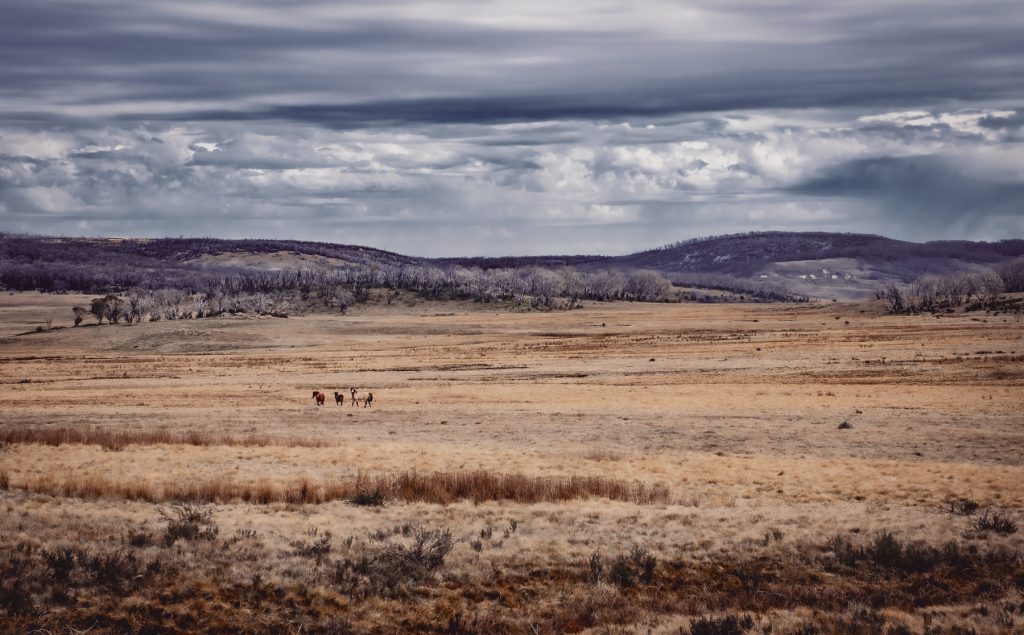
To me landscape photography isn’t about a perfect image. To me photography is all about storytelling, if there isn’t a story, it doesn’t matter how perfect the shot is, it isn’t going to resonate with people. I am attracted to telling stories that help me tell mine, that reflect my search for identity and place. I like creating images that have a certain amount of ambiguity to them. That are more a question than an answer. I began life on a very remote property in the bush, in the high country of the New England Tablelands. We had no electricity, no plumbing, and for me life unfolded beyond the reach of the modern world. My earliest memories are of the rhythms of the bush, storms rising, up through the gorges, the smell of horses, eucalyptus, kerosine and woodsmoke in the rain. It was a magic place that had a deep and lasting effect on me. A tension between the desire to live outside the safety, comfort and complexity of the modern world and the deep yearning to belong somewhere has always pulled at me, is a recurring theme in my work.
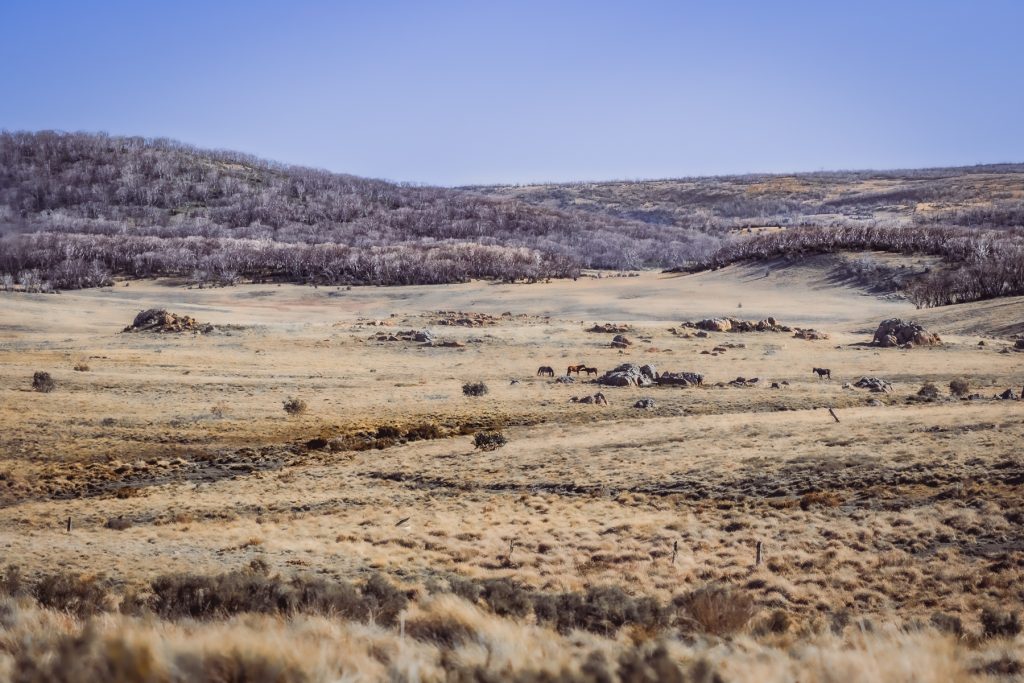
Comment on the almost sepia colour of your part of Australia in photography.
I guess That’s a question of style and I guess I definitely have a style or a signature, especially in the tones and colour I use. I used to work overseas a lot and coming home after being away a while was always emotional. I’d flick through inflight magazines featuring the familiar Australian landscapes, grateful to be home, grateful to be whole, and returning to our beautiful land. Yet I always found myself searching in vein for my landscapes. The glossy spreads would feature the red dirt of the interior or the sapphire blues of the coastline but not the beautiful soft tones of the middle; the tablelands and high country. This is my country. The colours and contours of these landscapes have a unique beauty. Harsh and yet soft and subtle. The light, the sky the air. Over the range but not out back. These are the landscapes I love. I think if I have a signature or style it is because these are the colours and textures I love, that comfort me, that call me home. I was asked recently how long it took to develop my style… I hope, is a lifelong journey. It takes a while for you to start trusting your own instincts and stop looking to emulate others but once you do it’s a never ending process of discovery and expression and evolution. So many things influence and change you and you always keep learning and growing. Creativity is a strange unaccountable thing.
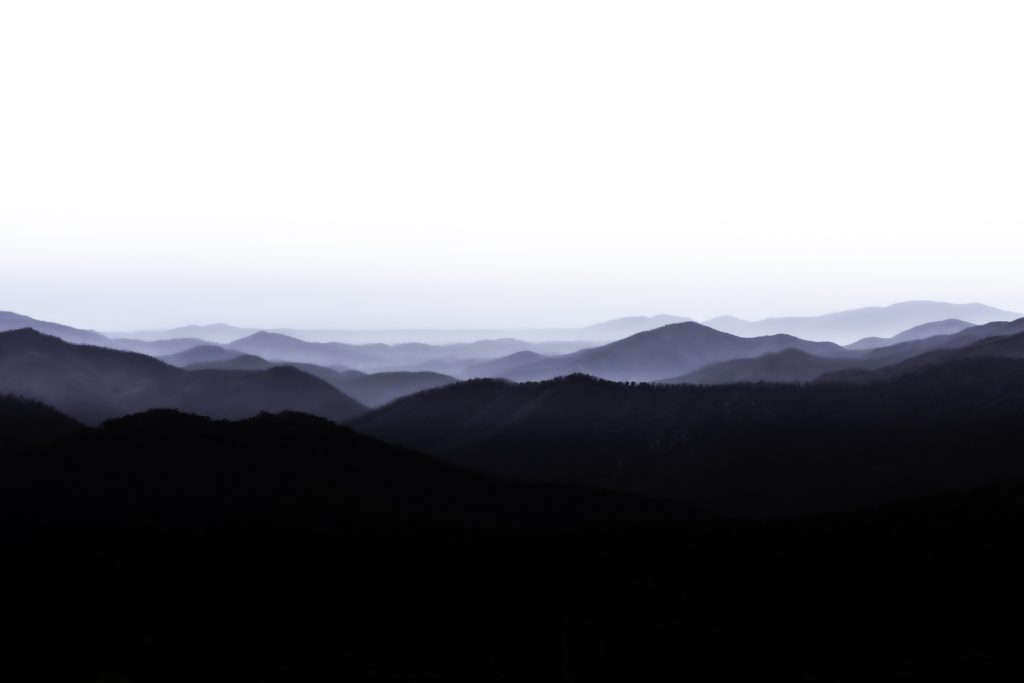
The physical vastness and what you are wanting to capture and why? I approach landscape photography from a feeling or emotion. Its about using elements in the landscape to tell a story or express something. It’s usually more about what a place feels like to me rather than what it looks like. It’s funny, I still don’t really think of myself as a real landscape photographer even though I take a lot of pictures of landscapes! My most recent landscape collection ‘Fields Of Gold’ is a series celebrating the vast beauty of the snowy mountain high plains and the brumbies that call them home. Influenced by the early Australian impressionist paintings that always captured my imagination, these works to me are about capturing the freedom and promise of these these plains.
Can you expand on the importance of your skill within your rural community?
I am a part of an beautiful rural community here in Bungendore on the NSW Southern Tablelands. One that has given me friendships and creative partnerships with incredible people who inspire me endlessly.
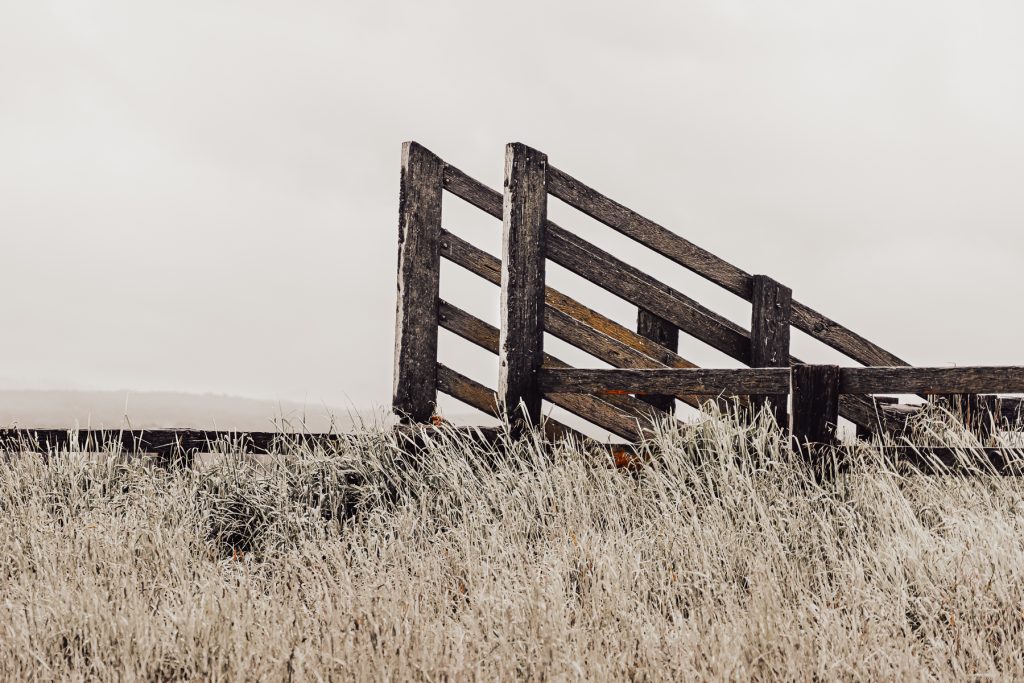
My gallery is part of The Malbon, an incredible local business collective which includes local businesses and artisans its been such a huge opportunity for me to grow by business and expand my reach as an artist, and I have also been able to use my skills to support growth and evolution of the Malbon its a great partnership I am lucky to be part of an amazing and supportive rural community here in Bungendore.
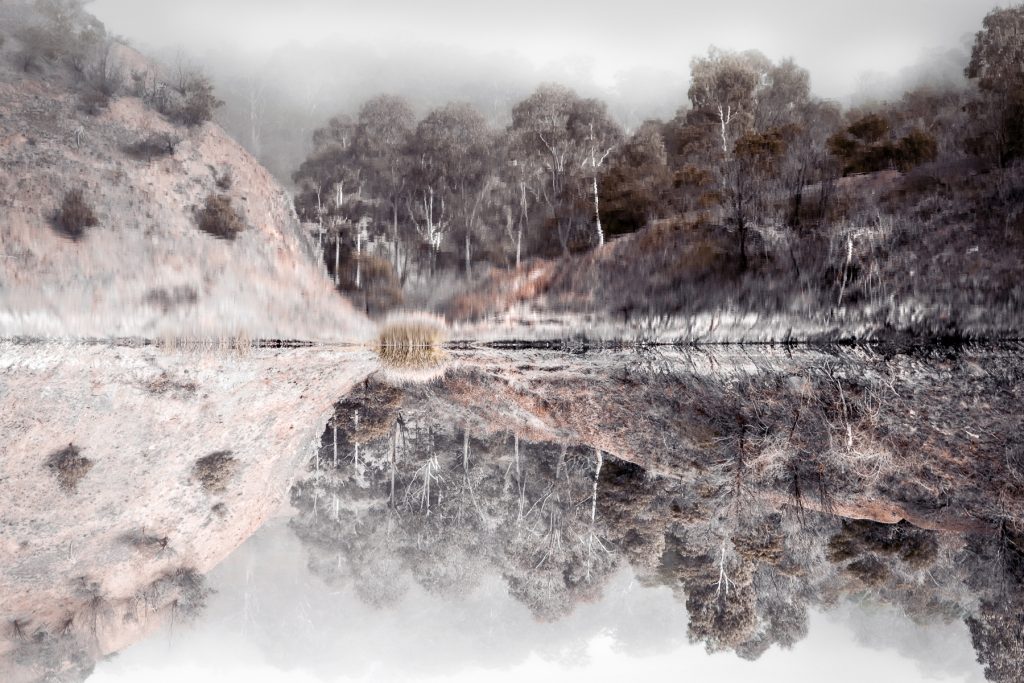
I love this landscape here. Not the white-sand beaches of the coast not the red dust of the outback. I love the crisp air and muted colours up here, it’s harsh but it’s subtle and beautiful too.
Contact:
Jerusha McDowell
Details
Jerusha McDowell
Rushe Photography Gallery open 7 days, Bungendore, NSW
Deborah Blakeley, Melbourne, Australia
Interview by Deborah Blakeley, March 2024
Images on this page are all rights reserved by Jerusha McDowell
Jacob Barfield
Comment on your statement, ‘Piecing the puzzle of life together through art and creativity.’
This statement is something I created to describe the feeling I felt when starting to try to make a career as an artist. It’s confusing like a puzzle, but if you stick with it and don’t give up eventually you’ll be able to piece it together.
How do you develop both Glass and custom-made metal stands. Combining two very different skills?
Learning how to work with metal was a skill I learned out of necessity to take my art to the next level. A lot of glass art needs to be displayed in certain ways in order to get the best effect. Metal stands are not only strong but when done properly complement the artwork. Most of the time I develop the artwork first and then design the stand around the piece.
Discuss how important it was for you to shown technical skills as a young boy.
Learning how to work with my hands were very important skills to develop. Almost every job and hobby I had required some sort of hands-on skills that took time and practice to develop. A lot of those technical skills required good hand-eye co-ordination, I was able to translate that developed coordination into the work I currently produce.
Comment on how you see art as a continuum to your art skills.
I’ve always enjoyed learning new things and one of the qualities of glass that I enjoy is how many tools and skills are required when producing the art. Because of this I had to learn a large variety of new techniques in order to produce the work I wanted to make.
Puzzle Pieces.
Where did the idea come from?
I’ve always liked puzzles and I even made a puzzle piece table in woodshop class in high-school.
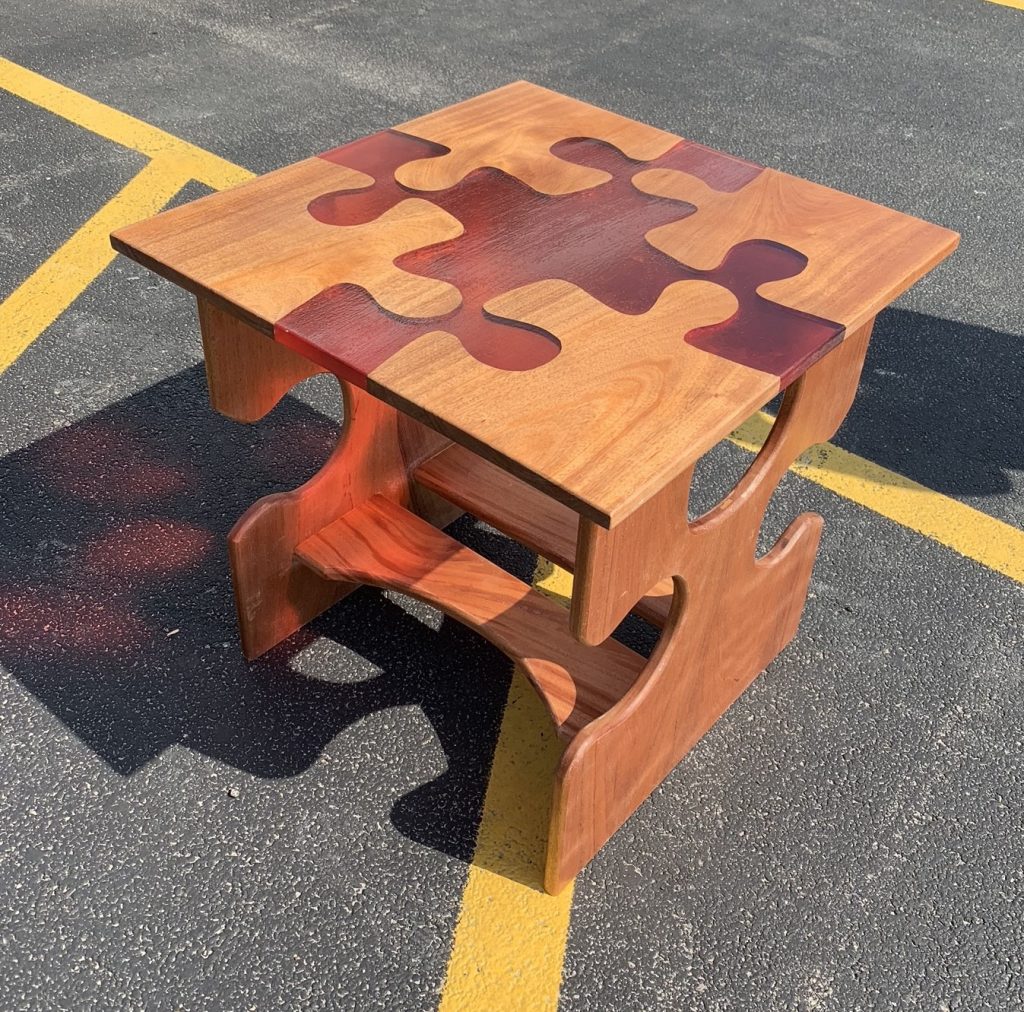
So I guess the idea of puzzle pieces as artworks was always in the back of my mind. But when I started to pursue glass, I wanted to produce something that had a lot of versatility. After dwelling on the idea of versatility for a while I eventually thought back to that project in high-school and decided to try making puzzle pieces out of glass.
Can you briefly explain the production of this series?
The pieces are made by taking chunks of glass and melting them into a puzzle piece shaped Mold. Once cooled down I then coldwork the edges so there aren't any sharp edges. Then I polish the glass and attach custom made mounts.
How large are the pieces?
The smallest is 8 ½” the largest is 13”
How are they sold? (the number of interlocking pieces)
They can be sold individually or in complete sets.
Comment on diverse ways the pieces can be displayed.
All the pieces are designed to connect with one another. You can assemble a collection in any way you want. These pieces can be mounted on the wall or attached to a stand and displayed on a table.
What and why are there restrictions on the size?
No restrictions on size, but the size I produce is small enough to display on a table but big enough to look good on a wall.
Trees of Life.
Comment on the size of these works.
The trees are 2 feet wide and 3 feet tall
How are the best ways of illuminating the pieces?
An overhead spotlight works well since it illuminates the leaves and creates a nice sparkle.
Comment on your pieces, ‘Nautilus’?
These are sculptures that are made in a glass blowing studio. I heat the glass until it is molten and then stretch and shape the glass into the Nautilus form. They’re called Nautili because they share a similar swirl to a nautilus’s shell.
What are you currently working on?
Recently, I have been working on a series I call infinity. This series uses layers of glass that have been cut and cold worked in different ways in order to create infinite patterns of light and color within the piece.
Where is your studio and do you share it with others?
The studio is located in San Diego and I share it with my step-dad and mom.
Contact:
Jacob Barfield
www.jacobbarfield.com
Deborah Blakeley, Melbourne, Australia
Interview by Deborah Blakeley March 2024
Images on this page are all rights reserved by Jacob Barfield
Jaynie Crimmins
Can you firstly, discuss the importance of the original text in all your pieces?
My source materials are integral to the conceptualization of a project/series. A project called Building a Blue Wall illustrates this very clearly. The Building a Blue Wall project began after the 2016 election in the US. The work is created from shredded non-profit and political solicitations, health care statements as well as magazine articles highlighting issues to protect our freedoms - this work was in support of social justice, women's health, civil rights for all, science, advocacy, and arts organizations.

Building a Blue Wall 2016-2018
Are they always from the same source or are there pieces with a combination of sources?
My work is very personal to me, and I have been working on projects/series to express my ideas. Because each project is an expression of a specific narrative, if I am using multiple mailings and sources - they get mixed up and end up in the same work. A Field Guide to Getting Lost used one type of catalog [RH catalogs] and In Search of Beauty [pre-pandemic] used individual catalogs for each work. Currently I am using only New Yorker magazines - but not one issue per work.
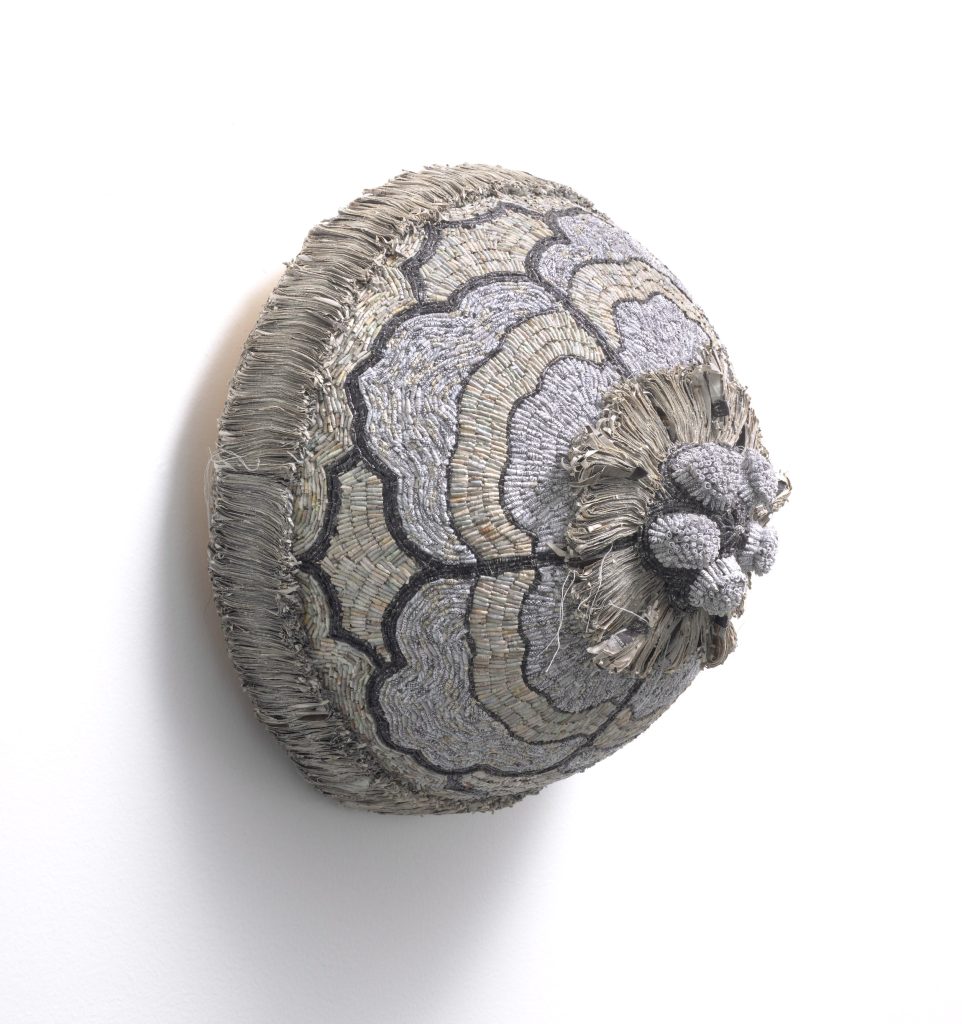
A field Guild to Getting Lost, 12” x 12” x 8” D, shredded RH catalogs, security envelopes, thread, over armature, mounted on wood, side view.
Take us back to your grandparents and how they have influenced your need to collect.
Examining my propensity for collecting leads me directly to my maternal grandparents, particularly my grandmother - the original recycler. Her reasons were not necessarily environmental. The need to save, collect and repurpose things was born from poverty. And that need immigrated to the US from parts of Eastern Europe.
My desire to collect and up-cycle materials originated with my observations of discarded clothing becoming crocheted rugs, old curtains becoming aprons and leftovers becoming the ingredients for new meals.
Nothing was wasted, everything possible was reused. Castoff items became novel and compelling in their potential for metamorphosis. Combining this sensibility with the shredding of junk mail illuminates the physical acts of deconstructing and repurposing.
Can you take us through the process you take from shredding to transformations?
Using a diamond-cut shredder, I shred catalogs, magazines, and security envelopes. Currently I am working with New Yorker Magazines and security envelopes. I manipulate the shreds in various ways - rolling, folding, and sewing. Rolling [which is the only technique I am using now] is done with my non-dominant [right] hand and then individual rolls are placed on a support one-by-one with a tweezer using my left hand, applying an archival adhesive called Lineco. It is a painstaking and meditative process. Steps to roll a shred
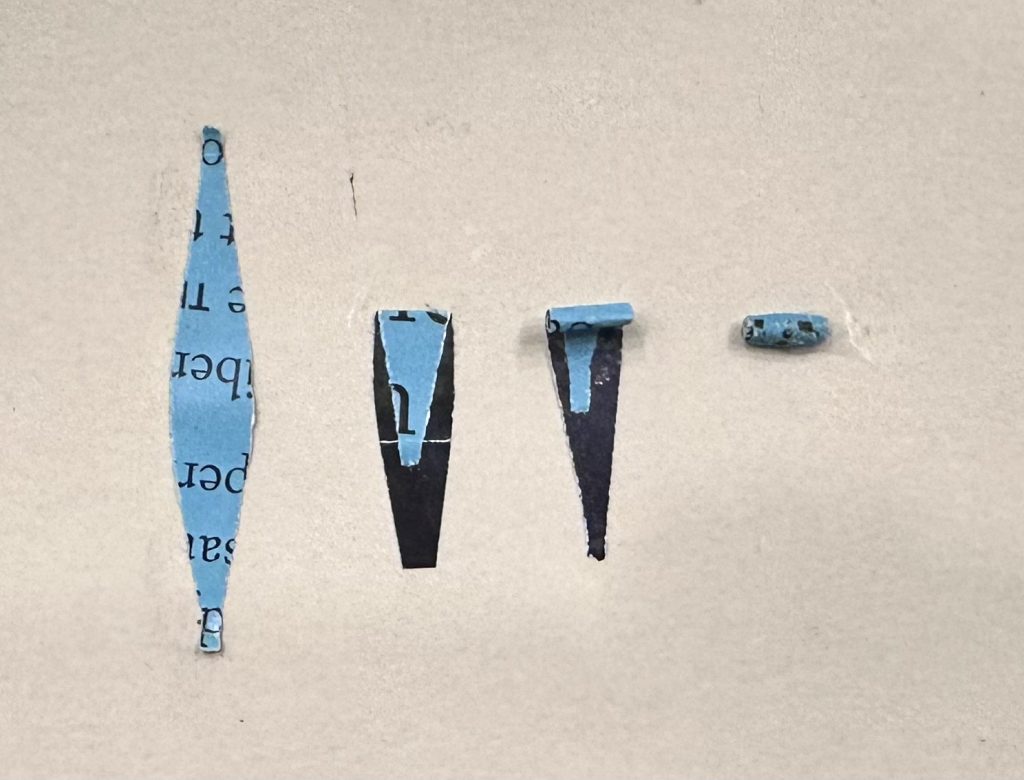
How do you decide on the balance and symmetry of each piece?
My work looks like it is following a sketch or plan, yet it grows organically. In my mind, I am planting a seed when I start my work in the center. From this "seed", the entire work takes form. I am interested in symmetry but do not really measure or layout the work prior to beginning - therefore I identify my work as applying approximate symmetry. While I am working, I sometimes sketch on the armature, and then I generally ignore what was drawn!
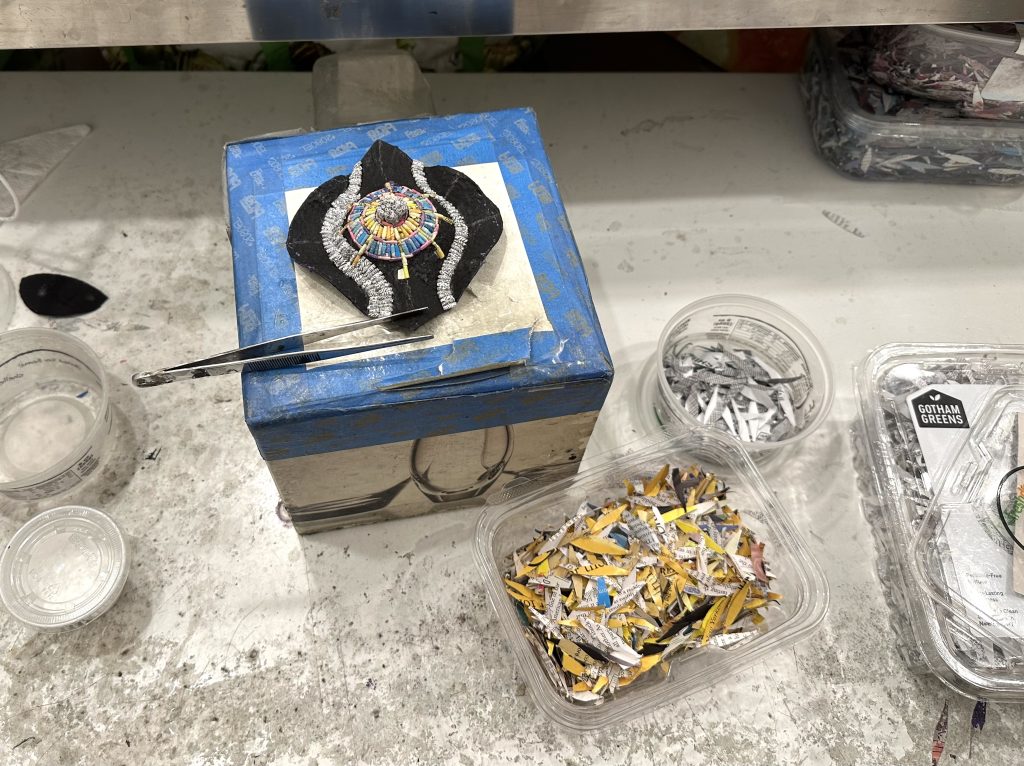
How important is the colour of the original printing in your work?
My palette is derived from the printed colors of the materials I am using. Prior to shredding the magazines or catalogs, I create separate piles of colors, much the same way painters organize their paint palette. I shred the colors individually, storing colors that are not part of the selected palette for that work. The various patterns, from the inside of security envelopes, are shredded as well.
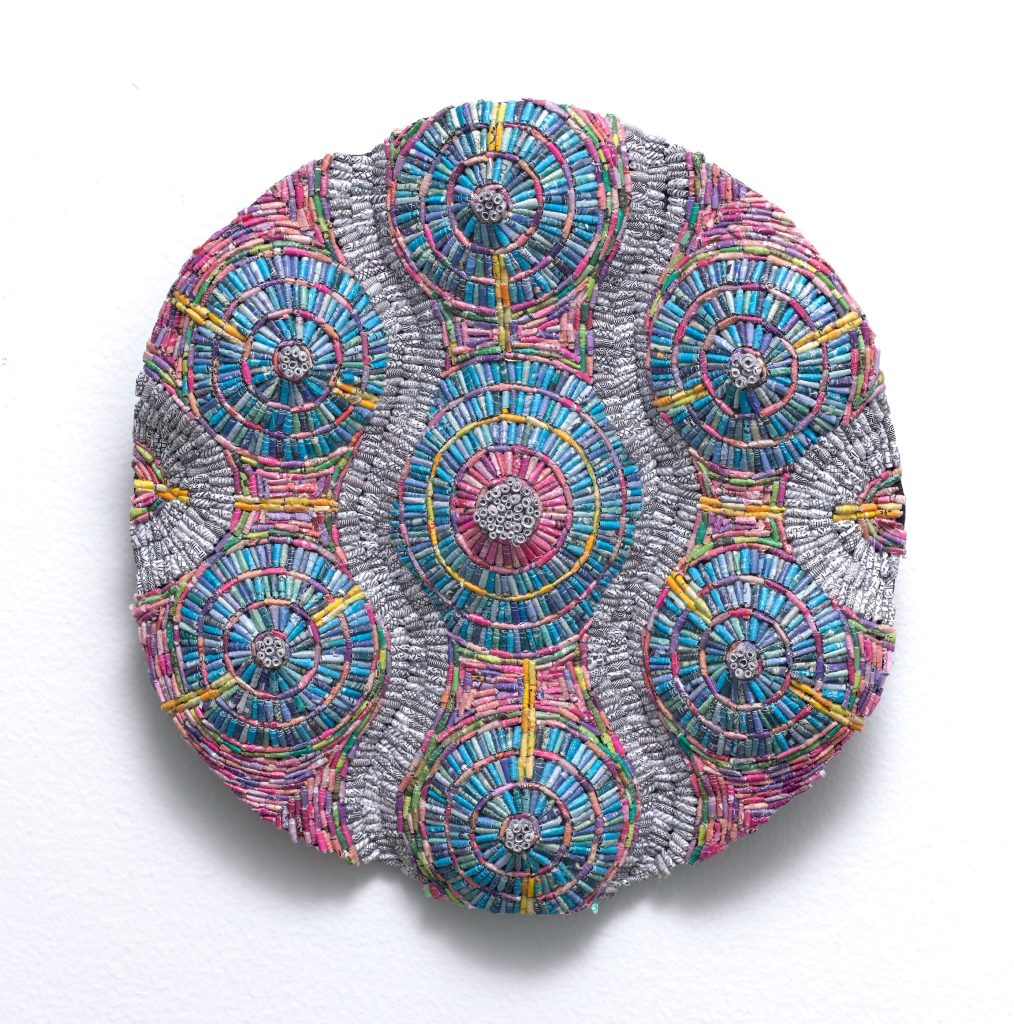 Equanimity #14 shredded New Yorker magazines and security envelopes over post consumer armature, 8 x 8 x 2.5D
Equanimity #14 shredded New Yorker magazines and security envelopes over post consumer armature, 8 x 8 x 2.5D
Discuss the way you use different dimensions in your work?
The surfaces of my work are textural, and the work is generally installed as wall reliefs. Until someone called me a sculptor, I never thought of myself in that way. There has always been an element of projection in my works whether created by the materials themselves or the armatures used. For my current series, Equanimity, the armatures used are from fruit packing purple cardboard inserts. These surfaces have undulating convex/concave surfaces that represent the waves of my breath during mediation.
Comment on how single and multiple pieces as hung for sale.
I am very particular about the installation of my work in certain instances. I like to group them in various configurations, mixing large and small work, framed and unframed. I have also been very lucky to have worked with and continue to work with incredible, intelligent, and talented dealers and curators. In those instances, I am not involved at all in how the work is installed, leaving it to their discretion.

Equanimity, installed at The Clemente, NYC
When and how did you first produce this idea?
In 2009, when the US was experiencing a recession, I was reading many op ed columns by [former NY Times columnist] Bob Herbert. He wrote movingly about the terrible circumstances, [including losing employment, underwater mortgages, etc.] many people were experiencing at that time. While I was personally fortunate enough not to be adversely affected, the economic decline of average Americans was deeply troubling.
I began to shred my financial statements including bank statements, bills, and other financial documents. I used beeswax as a coating to entrap this deconstructed information as if in amber - to preserve for perpetuity. The projects were called: Home Economics and Borrowing from the Future. From these initial series, I began adding more source materials to express personal ideas and replace their messages with my own narratives. I also freed the shreds from the wax, allowing the newly introduced materials, with color, to be exposed.
Equanimity #10 shredded New Yorker magazines and security envelopes over post consumer armature, 12 x12 x 1.5D
Comment on how your understanding, of paper art, has changed since you began. – (Seen as art not a craft.)
As the definition of fine art has shifted and morphed, paper arts have been re-categorized and celebrated as fine art. This evolution is inspired by the increased recognition of the technical skill, artistic vision, and conceptual depth inherent in paper arts. Paper artists have expanded the possibilities of the medium using found, manufactured and handmade paper - all in the service of creating meaningful and elevated art objects.
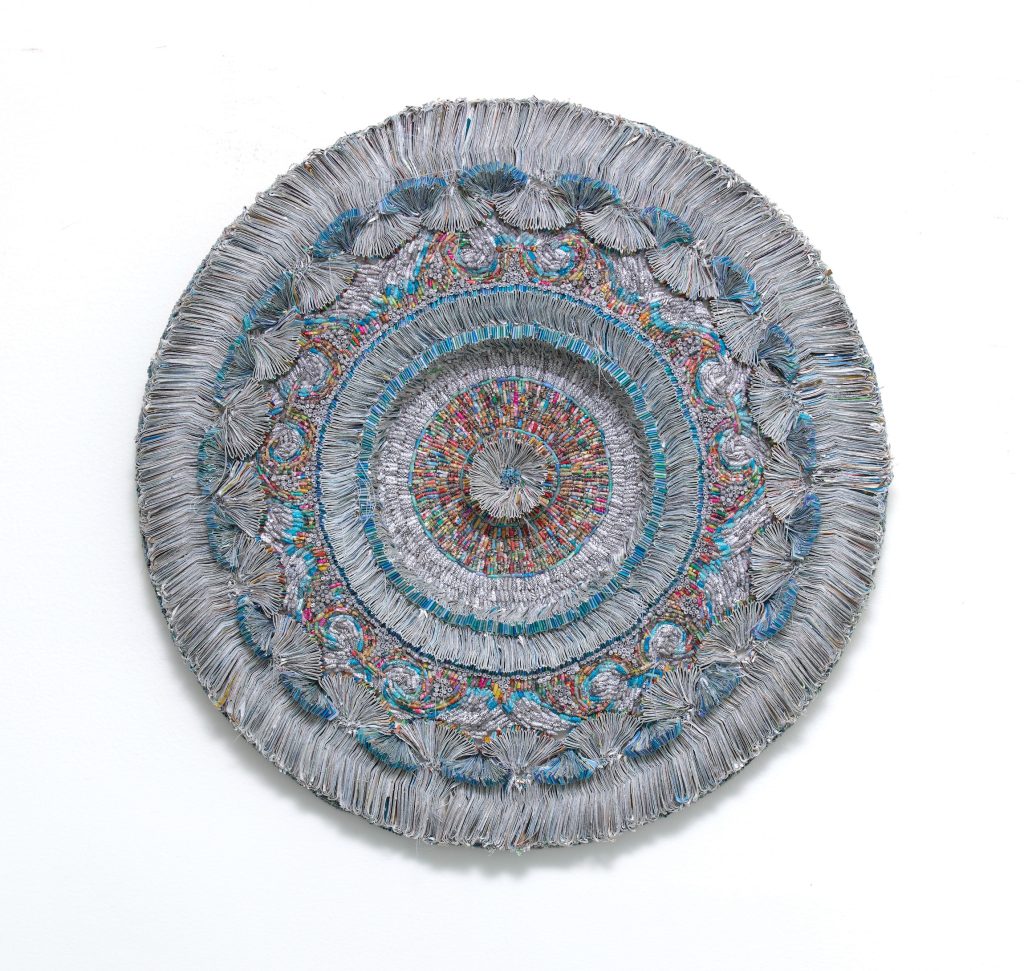 In Search of Beauty #11
In Search of Beauty #11
Tell us about your up coming exhibition, ‘With Every Fibre.’
I am excited to participate in the group show With Ever Fiber at Greenwich Academy's Luchsinger Gallery in Greenwich, CT. It is the first time I am exhibiting at a private day school and am looking forward to having my work introduced to a new audience and interacting with the students. The work included in this show is from my In Search of Beauty series which incorporates sewing.
The curator Kristen Erikson states: "The works in this exhibition largely transcend artistic categories, instead fusing elements of weaving, sewing, painting, sculpting, and mathematics into three-dimensional sculptural forms. Found materials mingle with natural and synthetic. dyes and fibers. Patterns are developed, repeated, and distorted, sometimes evoking recognizable forms like fossils, archeological fragments, maps, or constellations."
Are you ever given commissions along with boxes of related papers?
I am working on a commission now and have had prior commissions but only one in which I was given specific shredded documents to work with. It was a birthday gift for a collector's sister. The shreds were financial papers from their [deceased] mother, that, to the client, represented their single mother's strength and independence.
How did Covid effect your art practice?
Covid had a huge effect on my art practice. For one thing, I started a meditation practice which influenced my work [and will be discussed later on]. One of the reasons for beginning to meditate was that I live around the corner from Lenox Hill Hospital in Manhattan. During the pandemic, there were refrigerator trucks parked around the corner from my apartment to house the overflow of Covid victims' bodies. It was extremely upsetting, I would say traumatic, especially since there was a segment of the US population that was denying the pandemic was real. I needed to calm down.
Also, my pre-pandemic studios, were in a neighborhood accessible to me by train in Brooklyn, NY called Bushwick. It is a thriving artist community, and I met many friends there. When it was clear we were going into lockdown, I brought enough supplies home with me for about a week or two. I do not own a car, and at the time, public transportation was being used mostly by essential workers. After several months, the realization that the pandemic was extremely serious and dangerous, I decided to move my studio into Manhattan to a neighborhood that I could walk to from my apartment - East Harlem. At first, I felt displaced, but eventually I began to build a new community of artists scattered around that part of the city.

Equanimity #3 10” x 12” x 1”D, shredded New Yorker magazines and security envelopes over post consumer armature.
You have also exhibited beyond the US – comment on one experience.
A friend had recommended my work for the Sharjah Biennial Arts Festival in the United Arab Emirates. I submitted images and a statement based on their theme and the work was accepted into the exhibition! It was an incredible experience. I met artists from all over the world and was so honored to be shown with creatives of that high caliber. The Biennial staff was amazing - organizing trips, meals, everything. Each artist was given a space in which to install their work at several venues - indoors and outdoors. The experience was truly transformative.
Comment on how you combine meditation and creativity, in your art.
I began to practice meditation during the pandemic - focusing on the breath and specific phrases. Meditating during uncertain times helped me to remain present and try to find some balance in my life. The definition of equanimity is: mental calmness, composure, and evenness of temper, especially in a difficult situation.
In addition to meditation, creating can also be a meditative process. Working with my materials enables me to connect with the present moment and immerse myself in the creative process.
Equanimity, as a body of work, embraces the notion that the waves in each piece embody my breath and state of mind, while the use of New Yorker magazines aims to capture both the struggles and joys that challenge me to keep a calm state of mind.
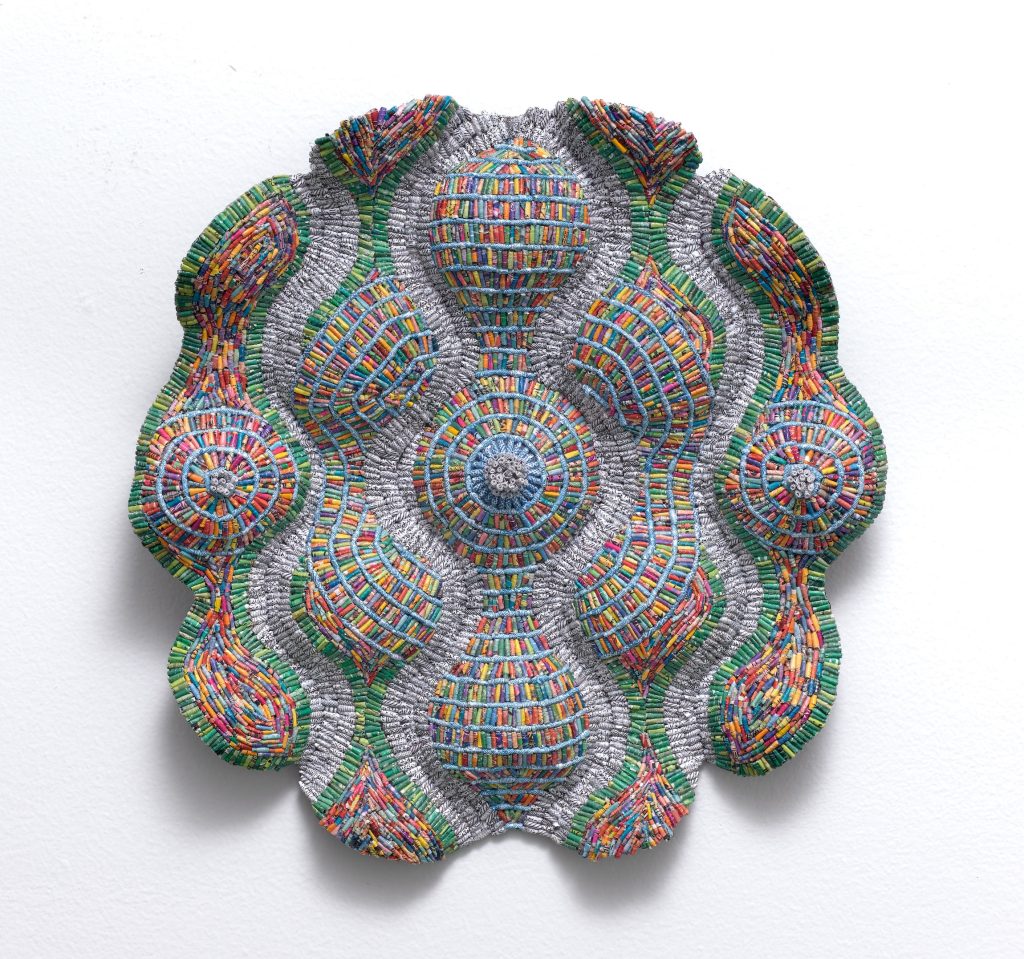 Equanimity #5, 2021, shredded New Yorker magazine images, security envelopes over up-cycled armature, 12 x12 x1.5 D.
Equanimity #5, 2021, shredded New Yorker magazine images, security envelopes over up-cycled armature, 12 x12 x1.5 D.
Contacts:
Jaynie Crimmins
Interview by Deborah Blakeley, February, 2024
Images on this page are all rights reserved by Jaynie Crimmins
Sherry Czekus
What led you to paint everyday life?
Photographing the liveliness of city life and crowds of people is what led to my interest in painting everyday life. Figurative painting has always been a draw for me but not in a portraiture sense. The city crowd, in its simultaneous specificity and anonymity, became the subject matter of a kind of figurative painting that did not focus on individual identity. The crowd itself has become the single entity. Observational paintings of the everyday have generated fresh perspectives as I record the crowd and its progressive changes over time, particularly in fashion and electronic technology.
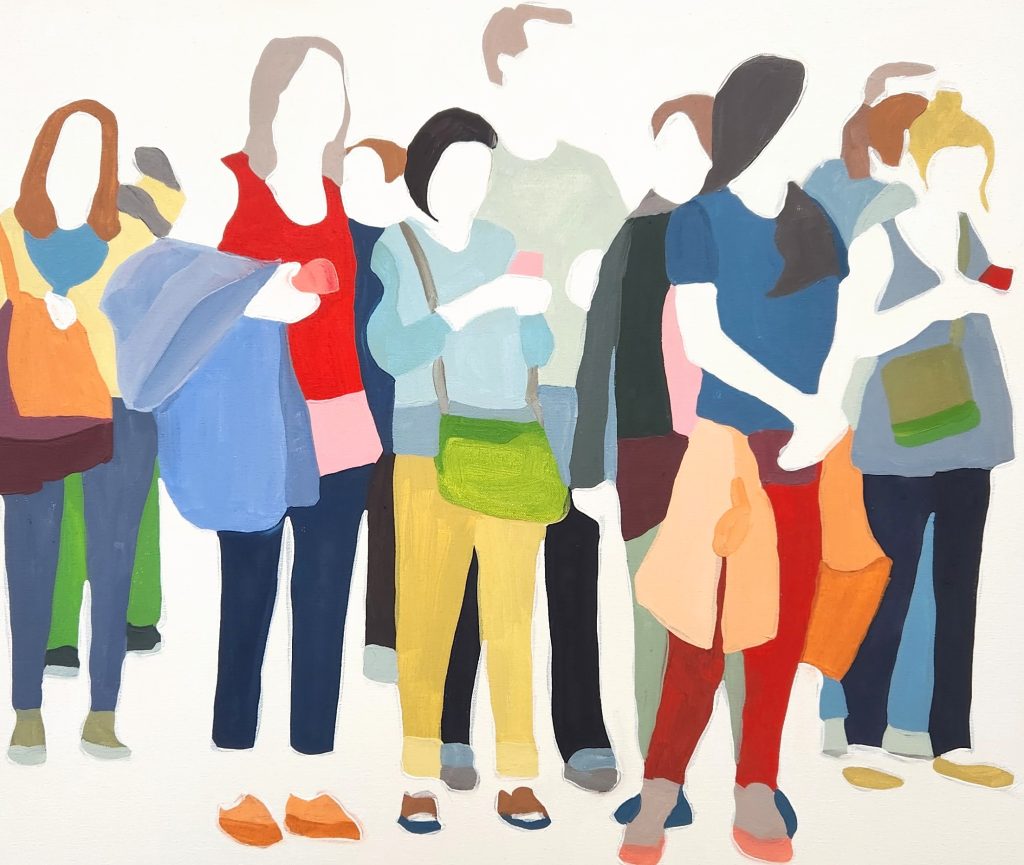 ‘A Peculiar Thing Happened’ 20 x 24cm
‘A Peculiar Thing Happened’ 20 x 24cm
Comment on physical crowds and how they been affected by Covid?
The most startling effect of Covid-19 was in the early days of the pandemic as safety measures were put in place globally, the urban crowd disappeared from the public domain. My paintings are depictions of people walking along the sidewalks and public walkways in the city and people were ordered to stay indoors except in necessary situations. As an artist, I was not one of the mandated types of workers who could work in this manner and even if I was, there was no one to photograph in my surroundings. Since the mandates have been dropped, my most recent excursions to capture the crowd have yielded very different results than the pre-pandemic urban scene. The crowds are fewer, less dense than before Covid-19.
Discuss one painting and how you have read the body language involved?
The body language in ‘On The Platform’ indicates the relationship between those in close proximity to each other while some are disconnected from the crowd engaged with their cellphone activity or simply watching for the next train.
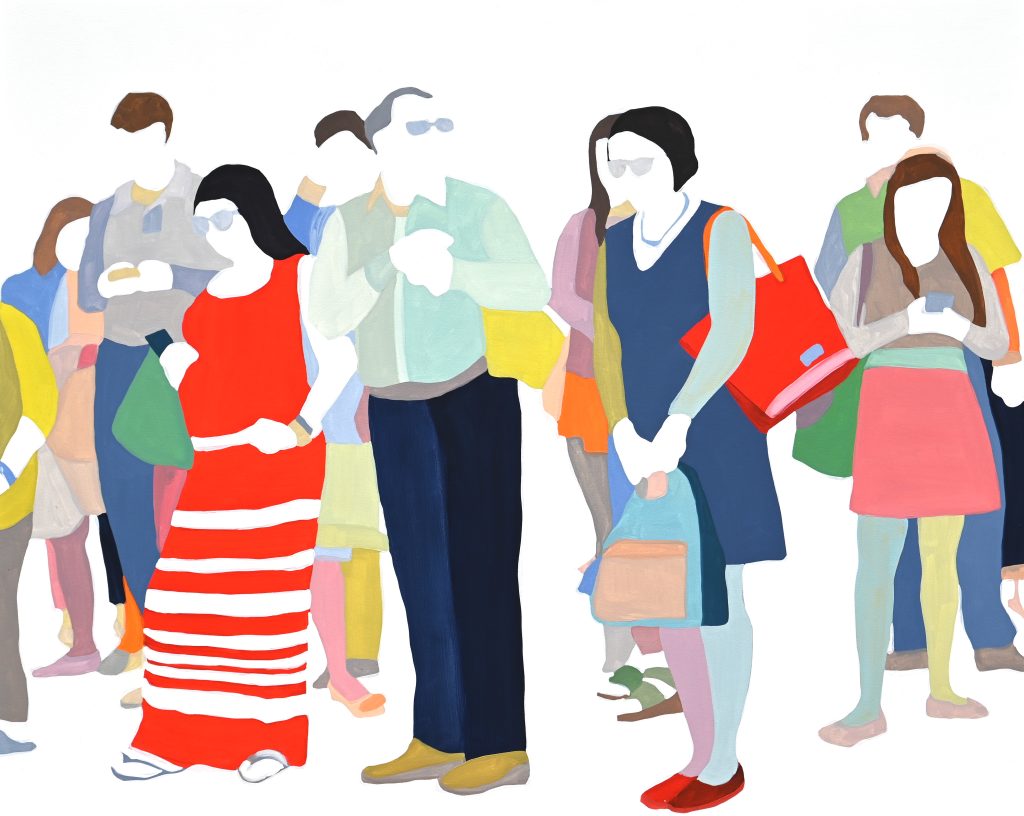 ‘On The Platform’ 60 x 48cm
‘On The Platform’ 60 x 48cm
I find the consistency in the distance each person stands apart from one another of interest. If people took the opportunity to acknowledge one another or start a conversation, they would be close enough to do so. And yet there is no obligation to do so. There seems to be a kind of order in establishing an area of personal space and social norms that’s unspoken yet understood as a public crowd participant.
Why are there no actual faces in your work?
The paintings aim to reveal the identity of the crowd as a whole rather than expose the identity of the individual. The lack of faces in the figures is a move to place the emphasis on the gesture of the bodies and how they interact together in social spaces and situations. I photograph the people in the crowds and its my way of protecting their privacy as the project intends to illustrate a social portrait of urban society. The gestures emerging in the group reveal something about all of us and the community develops an evolution of social behaviours by seeing each other and being seen publicly.
 ‘Church and Wellington’ 36 x 48
‘Church and Wellington’ 36 x 48
Including faces in the paintings I fear would shift the focus to personal identity of the crowd members and would make the paintings less about gesture and the crowd as a whole.
Movement is shown in ‘City Life Study’, discuss.
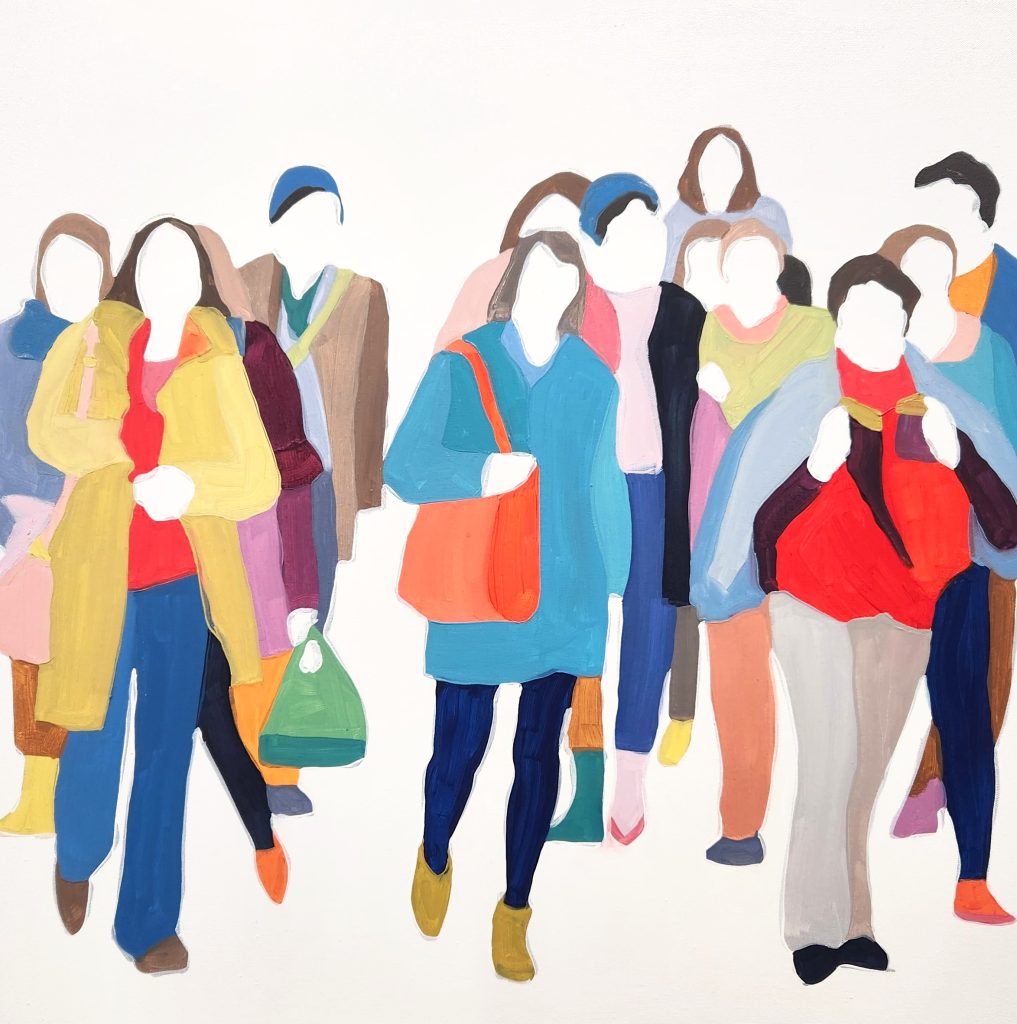
‘City Life Study’ #3, 24 x 24cm
The movement in ‘City Life Study’ is an illustration of the urban environmental structure and flow or rhythm of movement that the crowd walks within while walking on the sidewalks or crossing the street. The everyday experience of walking from one place to another is a public social happening in the downtown area of any large city. It could be running an errand on a lunch break or walking from public transit to a work space. To be swept up in the movement is energizing. The gesture and position of the feet of the figures in the paintings carries the feeling of the motion though the baseline of the canvas. The viewer is invited to experience the sense of being part of the crowd as it moves towards them or following the figures in front of them.
Comment on colour and your paintings.
Once I have chosen the composition to paint from the photographs I have recorded, the colours in the painting are determined as the painting develops. I choose a few colours to begin with and create a puzzle to be worked out compositionally through form and colour. The colour balance is intended to guide the viewer through the painting. The colour pathways are developed throughout the painting, placing lights and darks and specific shades strategically that make up the forms of the figures. You may notice chartreuse green appears in a linear pattern through the centre of the painting. It may be half of a shirt, a belt, one side of a bag, a bracelet and a jacket folded over an arm. Its meant to guide the viewer through the painting, to bring attention to the details of the figures. Red may be a tall boot, the top of a cell phone, one side of a collar or a scarf. Red can be lightened to pink with an added tinge of orange and placed beside the red to create a sense of volume in a bag, for example. The colour forms are flat and painted in a hardedge format in order to create a shallow space for the crowd to exist.
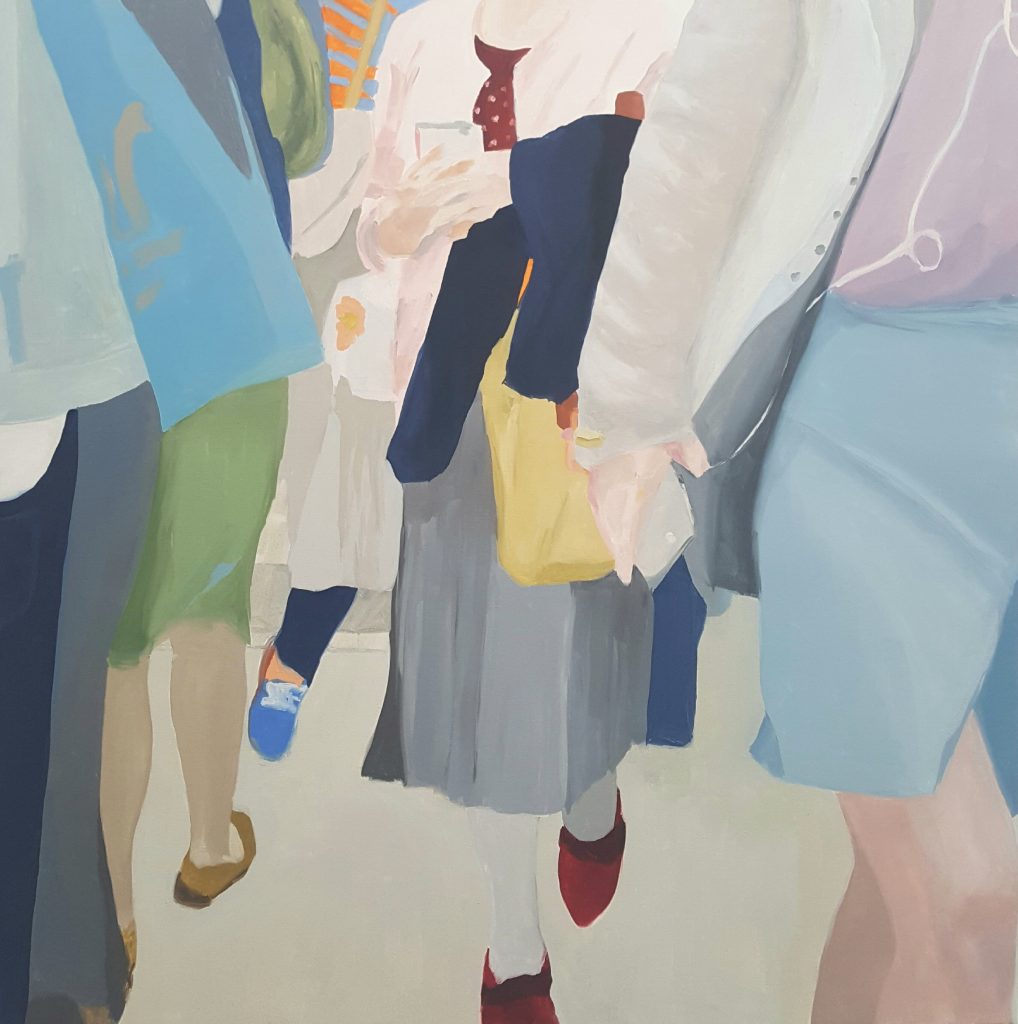
‘Crossing With The Light’ 48 x 48cm
Colour and colour theory are aspects of the paintings that I hope helps the viewer engage with the paintings as a way to look at ourselves and how we all are part of public engagement.
How is clothing so revealing in so many ways?
Clothing hints at various aspects in the urban crowd. The details of fashion can indicate the timeframe of the image when particular fashions in clothing and accessories have its moment and carry through to pair with new fashions. Short jackets with large lapels and tall boots with high heels or low heels paired with leggings or wide leg pants have all made an appearance recently. I’m not a fashionista but I do record these aspects. The public social sphere is an environment that influences fashion trends as people are present to see one another and to be seen, like the flaneur and flaneuse. Clothing can reveal cultural influences in terms of fashion trends and colours. The way one dresses can indicate a person’s type of employment or leisure activity. Wearing clothing publicly is a form of expression and communication that reveals visual clues about us individually and collectively as a community.
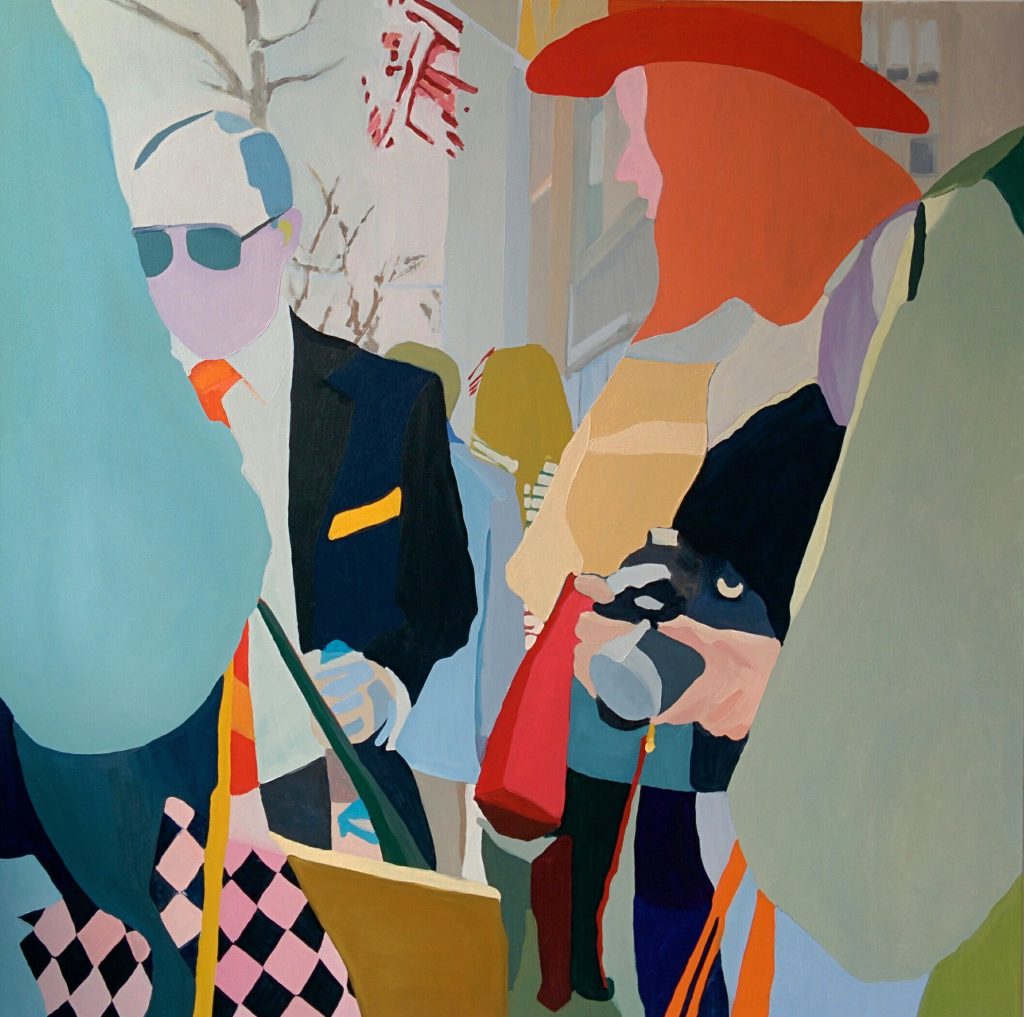 ‘Lexington Ave’ 60 x 60cm
‘Lexington Ave’ 60 x 60cm
In ‘Acquaintances’ the title makes us look more closely.
I titled the painting ‘Acquaintances’ as its difficult to determine the exact nature of the relationship of the figures in the painting.
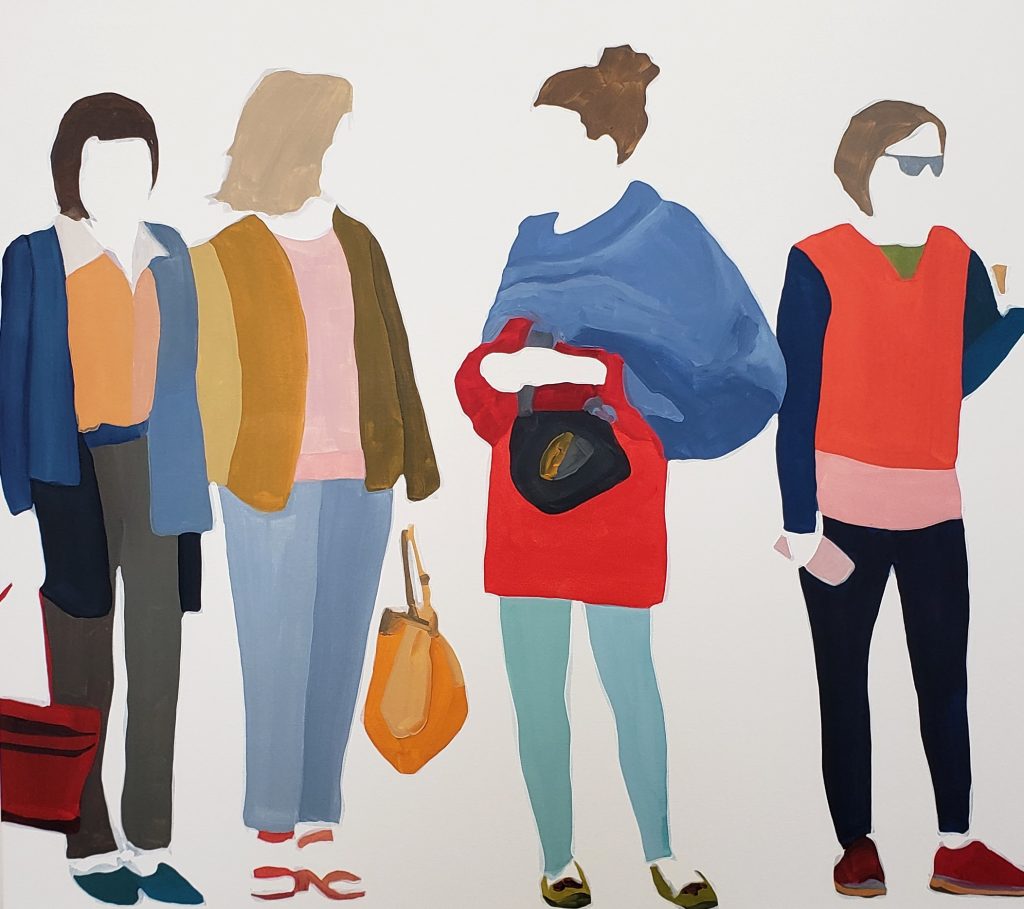 ‘Aquaintances’ 36 x 40cm
‘Aquaintances’ 36 x 40cm
Painting, as an act, is a pathway to knowledge and understanding about the subject and environment I am painting. It’s a slow and cumbersome process to paint something. The brush as a tool is not precise and the viscosity of the paint on the brush requires some negotiation between how long can you paint without reloading the brush and how accurately can you put down the mark you intend with the paint you have loaded on the brush. Mixing the paint colours falls in line here too. These are painters’ problems to work out. But the process of painting is a learning process. Every aspect of the image painted has been deliberately done so by the painter and so every aspect of the image is considered. I had a long time to study the figures in the image, thinking about their relationship to one another and this is what drew me to choosing the image for the painting. I could study the engagement between these people. I believe the painting poses more questions than provides answers. The engagement is friendly, but are the two central figures acting cordial to one another having never met? Is someone asking for directions? Or are they friends taking advantage of a stop light to have a deeper conversation? Do the others listen in on the conversation, particularly the female on the right? I’m not sure. The moment seems synchronous and fleeting and regardless of their relationship to each other, the connection of the moment was what drew me to paint it.
In your ‘Canadian Series’ you zoom in on the subjects. How do you make the discussion?
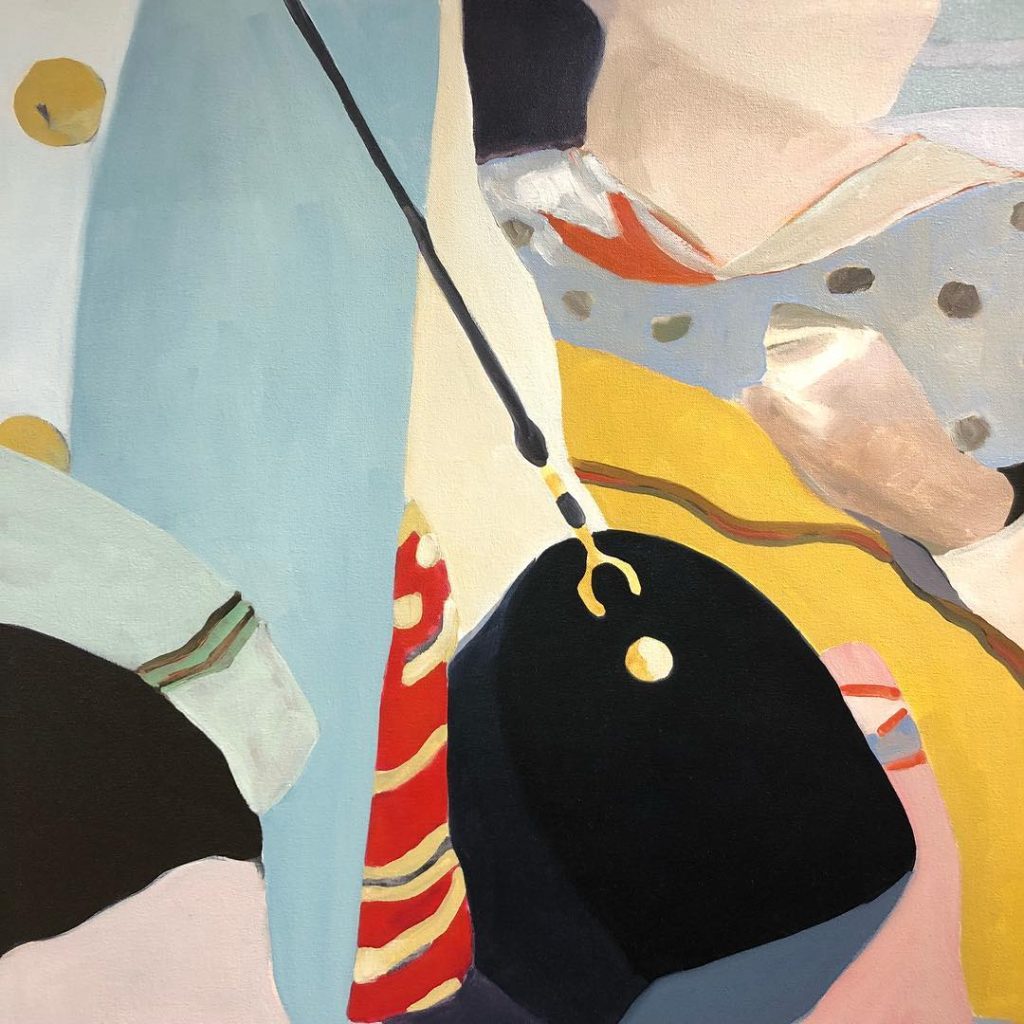 ‘Canadians’ #3 24 x 24cm
‘Canadians’ #3 24 x 24cm
The ‘Canadians Series’ is a series of abstract paintings that zoom in on the figures in the scene. The emphasis is not on the figure and relationships but instead a more formal approach to developing a series of paintings. Forms, patterns and colour tend to dominate the canvases in these paintings. The compositions are square, neither portrait or landscape and look at areas of clothing with intriguing patterns, bags with shiny accessories and the less obvious intersections of the figures in the crowd.
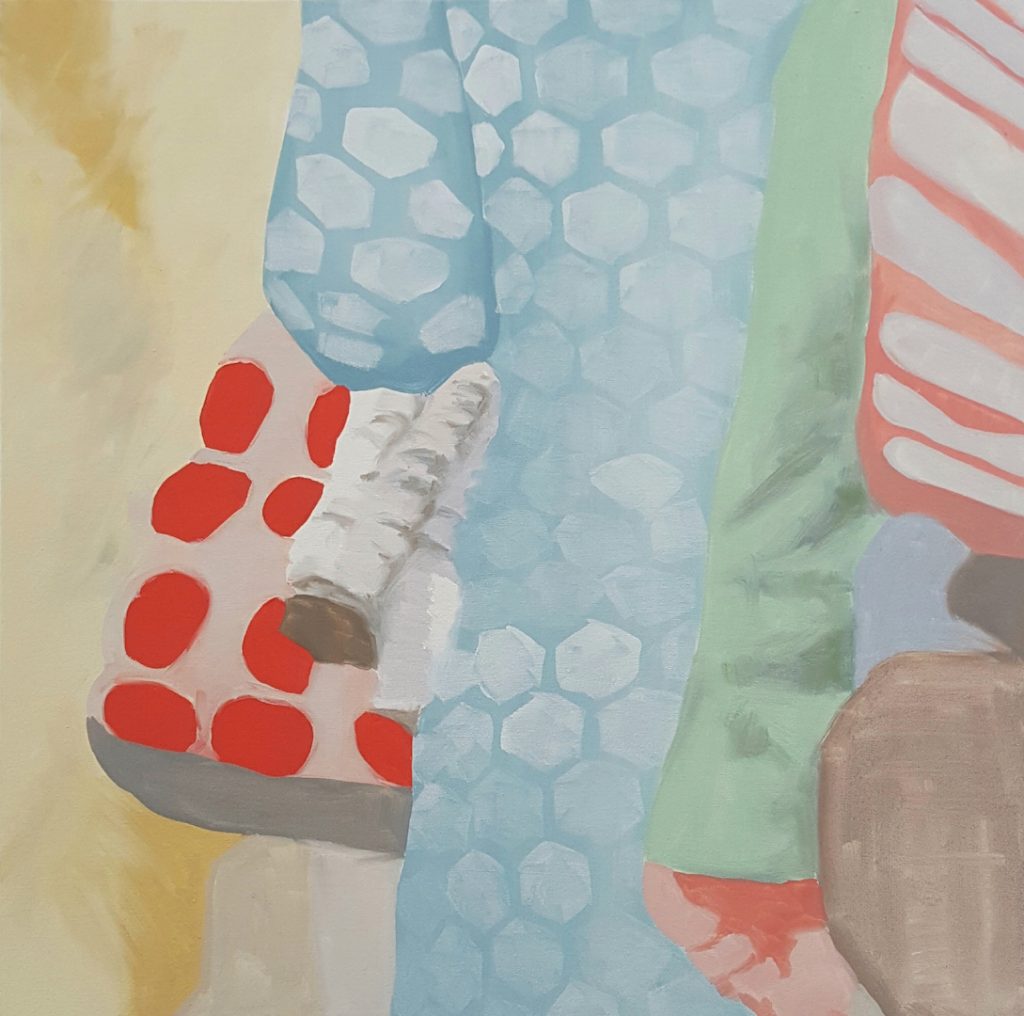 ‘Canadians’ #2, 24 x 24cm
‘Canadians’ #2, 24 x 24cm
Compositionally, I’m searching for balance in form and colour and problem solving that directly on the canvas. There is space to explore volume in the forms in these paintings with very thin paint brushed over the flat colour blocked forms. The images are from photographs taken in Canada and titling the series ‘Canadians’ allowed a clue that these abstract works are figurative.
‘In Line’ comment on how your images are like looking at a cross section rather than the whole?
The cross-section view in ‘In Line’ is a cropped digital photographic image of a line of pedestrians gathering at a red light and waiting for the signal to cross the street.

‘In Line’ digital image
The image crops the middle section of all the figures in a horizontal line. The centre of the action seems to be happening at this point. Bodies are turned, some are front facing, holding bags and purses, arms crossed and dangling. The gesture of the body is evident in the positioning of the legs. The viewer can get a sense of who these people are collectively without revealing the upper and lower portion of the body and I found this to be a compelling discovery. The forms that make up the colour of the clothing and accessories provide the flow and rhythm though the image. We can focus our attention the mass movement resembling a line dance rather than the identities of all of those who make up the scene. I think we can try to imagine ourselves as part of the crowd.
Contacts:
Sherry Czekus
sherryczekus.com
Sherry Czekus, Waterloo,ON, Canada
Interview by Deborah Blakeley, February, 2024
Images on this page are all rights reserved by Sherry Czekus
Anne Petters
Having been born in Dresden how has this affected your art, with movements from, Germany, to USA and finally England?
Born in Dresden in 1978 I grew up in the German Democratic Republic, a country that doesn’t exist anymore. I always understood the political change in my country, which I experienced as a displacement of reality, as a basic influence on my lifestyle and artistic work. My interest in controlling and displaying moments of our fleeting, vulnerable existence leads leads me to a poetic, metaphoric use of glass and other materials, including natural phenomena.
I see my work as an empathetic comment on our transience and the desire to control time and fleetingness.
I am very drawn to experiencing other realities and inspiring my art practice by traveling and getting to know other perspectives. Art can be a tool for breaking with familiarities and for sparking curiosity to work against indifference.
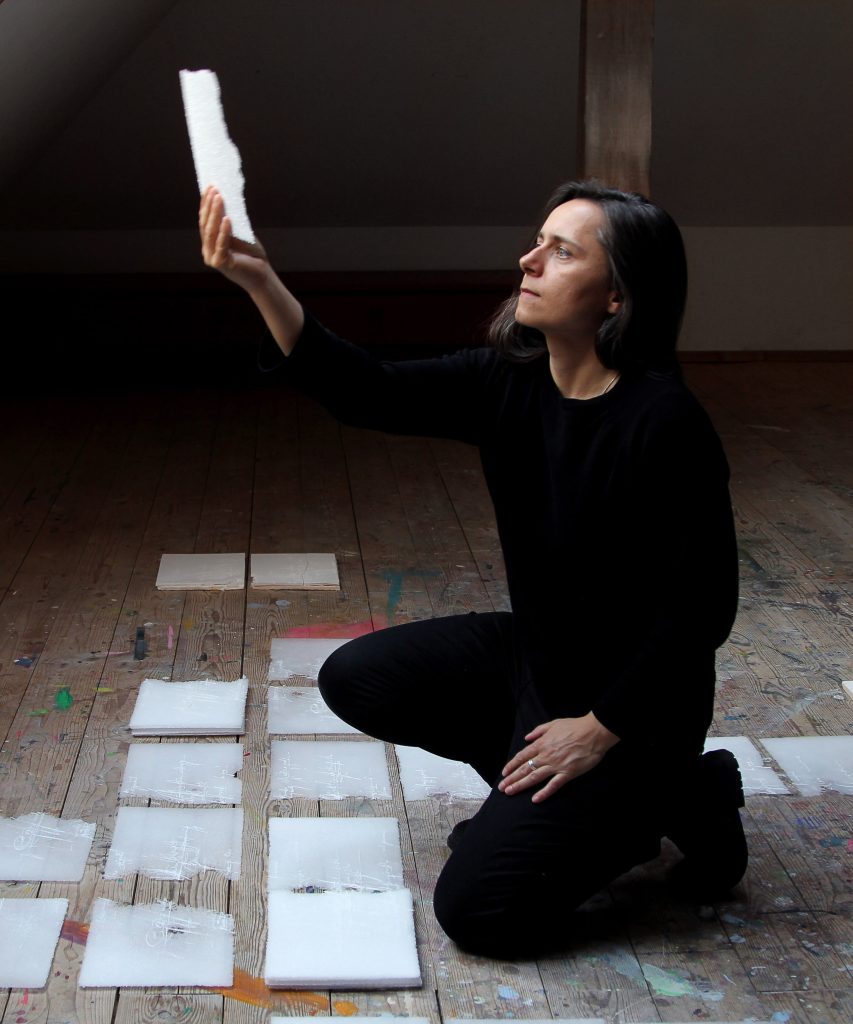
Photograph by Torsten Rötzsch
How are you now passing on your knowledge to other artists?
I am teaching a lot at Universities internationally but also in specialised glass studios like the Corning Museum of Glass, Pilchuck Glass, Penland School of Craft, Summer Academy Bild-Werk Frauenau, Urban Glass to name a few. I enjoy sharing my art and inspiration not only through extensive exhibitions but lectures and workshops world wide. It is never only passing on, it is exchange, I do get back a lot.
You now lecture at City and Guilds in London. How does teaching influence your own artwork?
I find it very important to be part of an academic discourse. It means a constant flow of ideas and being close to a contemporary Zeitgeist, to art in a philosophical, historical, social and political context. Academies bring together artists from all age groups and ethnic and social backgrounds.
Of course teaching also comes with a lot of distraction and interruption to one’s own creative flow. It is often difficult to find the balance. But I would not want to miss it completely. It is another level of sharing ideas in addition to art making and exhibiting.
Tell us about your installation at Coventry Cathedral in place of the vandalized window.
How was the original damaged done?
In January 2020, the Angel of the Eternal gospel, one of John Hutton’s engraved over life size angel and saint figures that decorate the cathedral’s west screen was smashed during a break in. Someone tried to steal the donation box and in an act of complete ignorance broke this panel of the iconic piece of art work.
The people who did it were never found.
How did the commission come about?
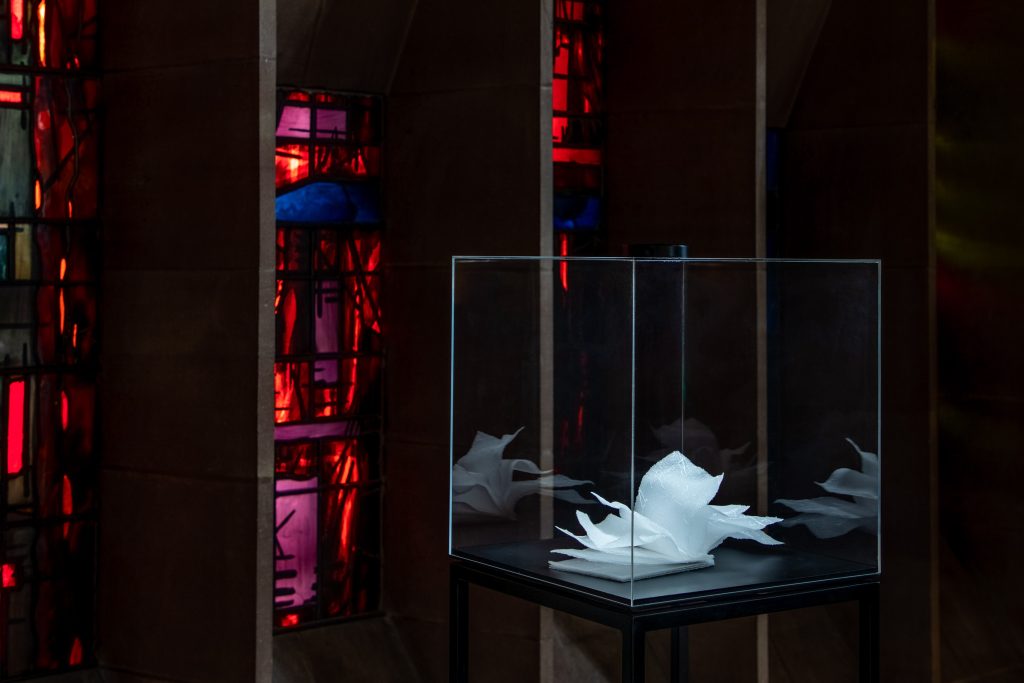 Photograph credit Martina O'Shea
Photograph credit Martina O'Shea
The ‘New’ Cathedral, designed by architect Basil Spence, was build after the old one has been bombed and destroyed in 1941 during a blitz bombing by the Germans.
The statement of building a complete new cathedral in the 50‘s and 60‘s in a modern architecture, a Phoenix-like idea, still reflects in the cathedral’s ethos today.
The Very Rev'd John Witcombe, Dean of Coventry, decided to not replace the panel as it was, since the artist John Hutton died in 1978 and his own way of glass carving was very unique and revolutionary. Instead he approached acclaimed curator and professor Mike Tooby to find a contemporary response to this new act of violence and destruction. Mike Tooby invited me to create a piece of art work as the first artist, followed by Barbara Walker and Abigail Reynolds. The invitation came as response to the series ‘Books of Disquiet’ a series of glass books that I have been making since 2017.
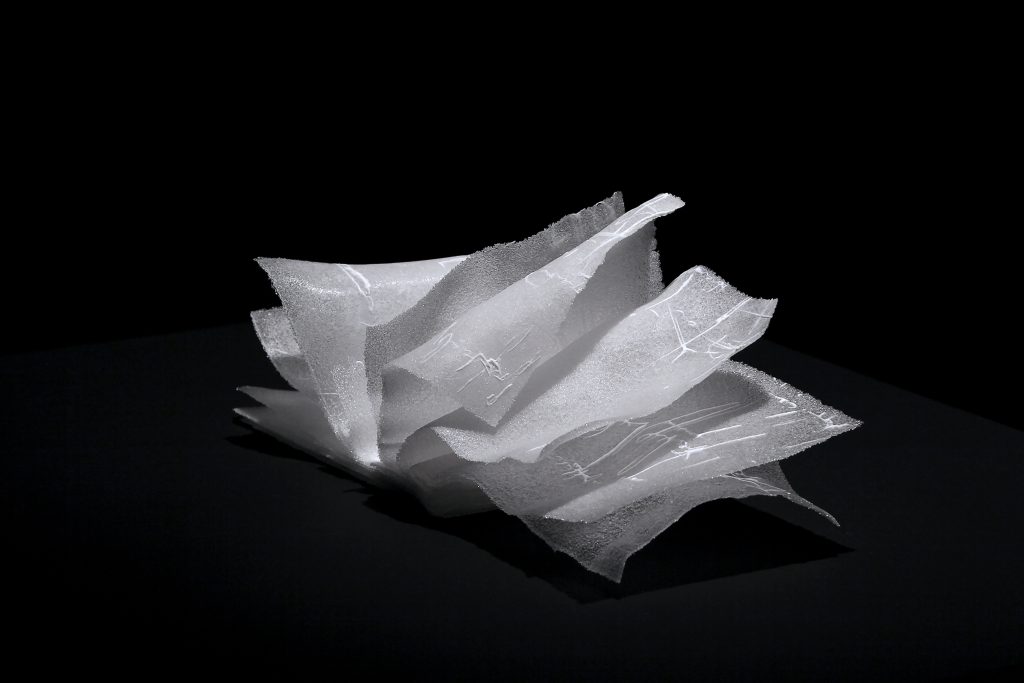 Books of Disquiet IX Photograph Credit, Anne Petters
Books of Disquiet IX Photograph Credit, Anne Petters
They caught Mike Tooby’s attention in the context of the destroyed Angel holding the gospel.
I had complete freedom for this project and decided to work with light and projection, a more ephemeral approach. In Lichtung - Break, the title of the installation, I am projecting a broken piece of glass back onto the screen where the Angel was.
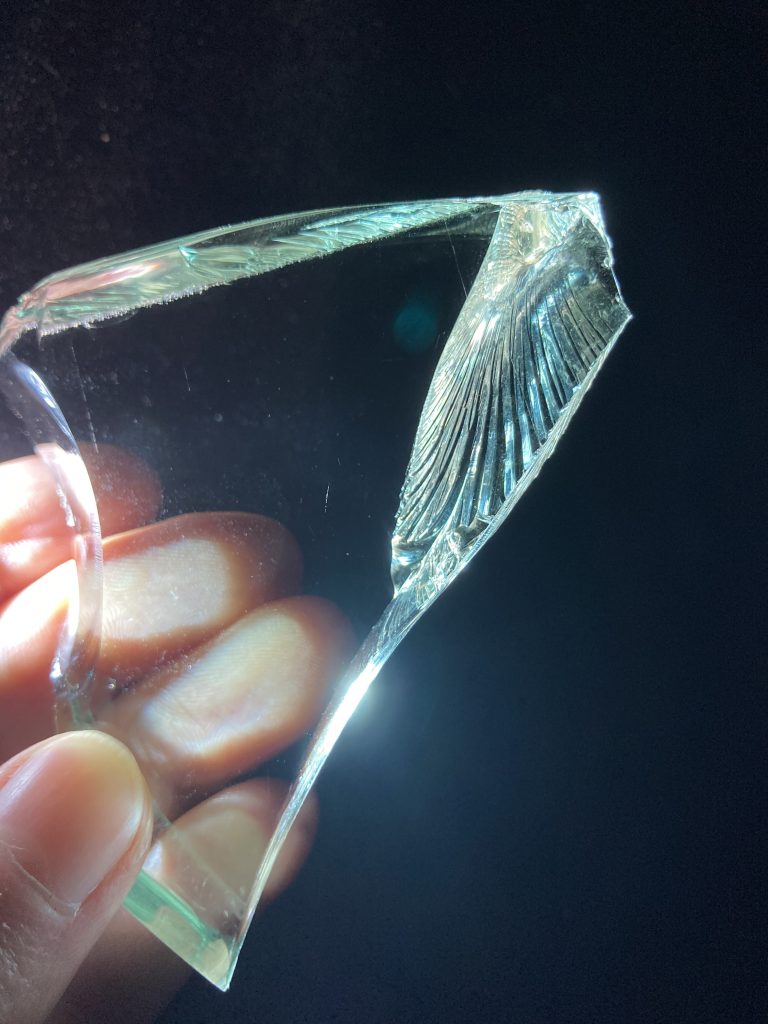 Photograph, Anne Petters Lichtung-Break
Photograph, Anne Petters Lichtung-Break
The break of the glass, a conchoidal shell like fracture, perfectly responded to John Hutton’s gesture of engraving, the feathering suggests an angel’s wing taking flight, or landing. The image would appear and disappear at dawn and dusk, an ephemeral comment on the recurring theme of suffering, death, hope and light.
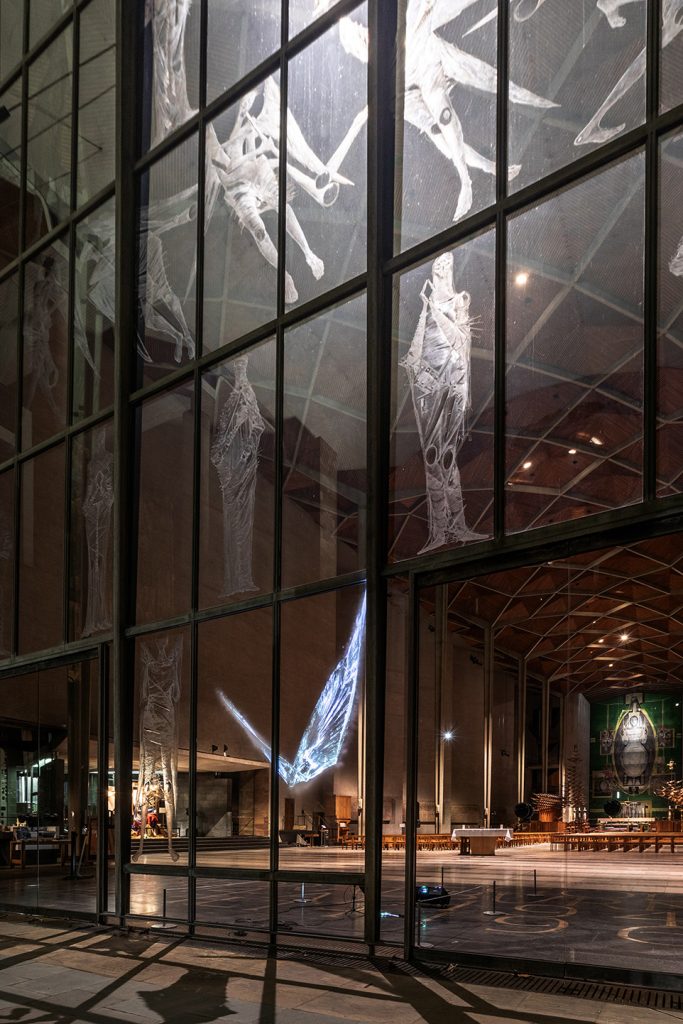 Lichtung-Break, Photograph, Anne Petters
Lichtung-Break, Photograph, Anne Petters
What was the briefing for the commission?
There was no briefing, the artists were invited.
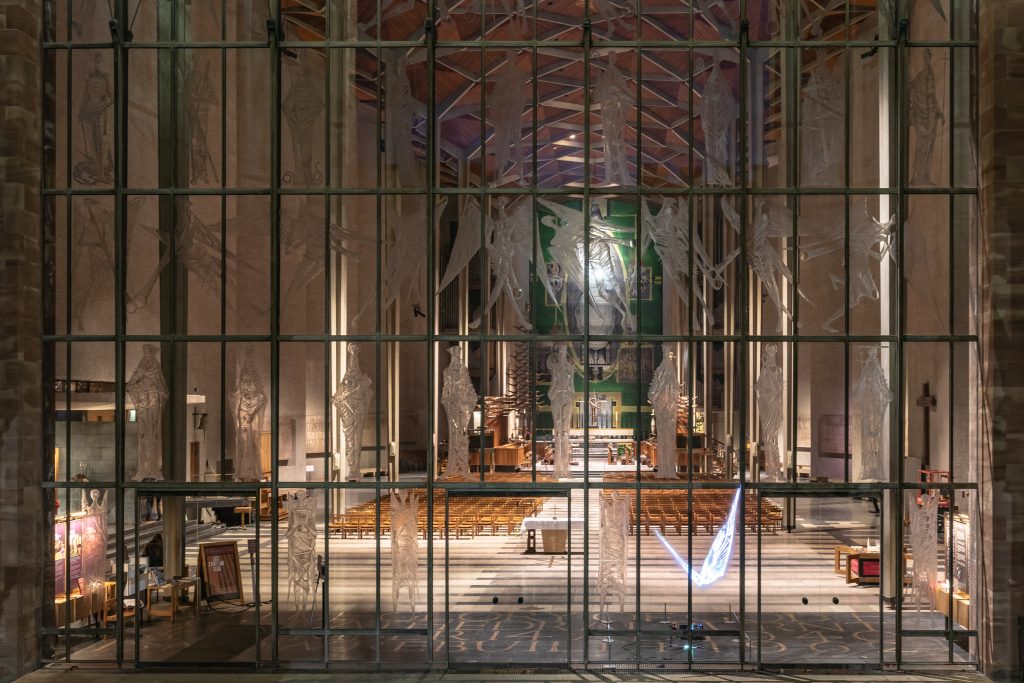 Lichtung-Break Coventry Cathedral Photograph credit Martina O'Shea
Lichtung-Break Coventry Cathedral Photograph credit Martina O'Shea
What has been the reaction to the commission by the public?
The Installation Lichtung - Break received a very touching response from many members of the community of Coventry. It was the first public art work I made and it was very rewarding to be able to move so many people. Usually I work for galleries and art institutions that naturally come with an audience with an artist background. Making work for a public community and trying to find something that is accessible yet sublime and that can be understood and experienced by people of all ages and backgrounds was a haunting challenge at first, but it naturally came to be and fell in place beautifully.
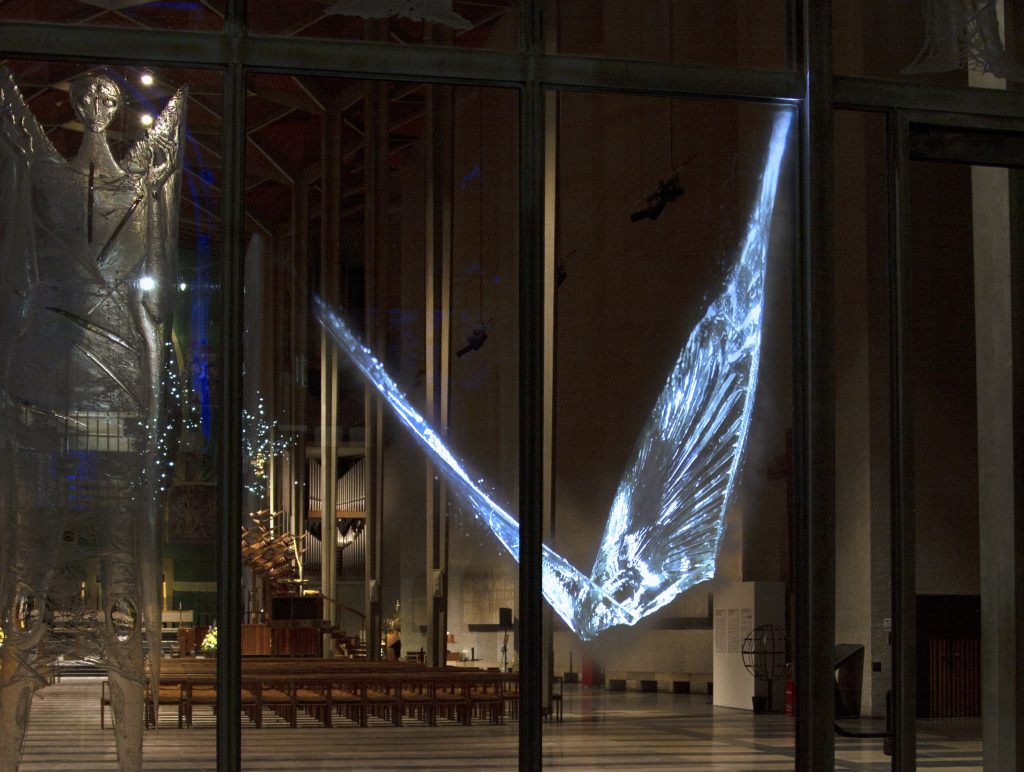 Lichtung-Break, Photograph, Anne Petters
Lichtung-Break, Photograph, Anne Petters
Discuss your perspective of working with this Cathedral.
Working with the team of Coventry Cathedral from Dean John Witcombe and curator Mike Tooby to all the committed staff has been a heart warming and inspiring experience. The openness, deep conversations and support I received helped me immensely to develop the installation without restrictions or problems.
Dresden is the twin city of Coventry, which gave the project another personal level, although the invitation to work on this project had nothing to do with that. We realised this connection later. It was one of the wonderful serendipities that happened along the journey.
Coventry Cathedral is a most welcoming place that brings people together, regardless of their backgrounds and beliefs. It seems to be the heart of Coventry.
Discuss your involvement with the Bullseye Projects?
Bullseye Projects is run by the Bullseye Glass Company, based in Portland Oregon, US. They represent me regularly at the London Art Fair COLLECT and in 2019 invited me to take part in a site specific exhibition in Caithness Scotland at their Byre Space, a converted old barn, typical for the area in Scotland. The exhibition titled ‘Field Notes’ included four acclaimed glass artists based in the UK. Bullseye is internationally known for their beautiful glass and their support for glass artist and glass education.
Comment on your work Lichtung – White Drift and Disegno.
How have you used writing on the glass?
Disegno, Lichtung - DRIFT and the series Books of Disquiet originate in my fascination for our never-ending flow of thoughts, the phenomenon of imagination itself and the desire to gain control over ephemeral moments. The rolling up, ripping off and freezing of unique thought moments, is realised in translucent glass sheets, frozen in movement. The drawings and the words on each glass object are records of those moments in time.
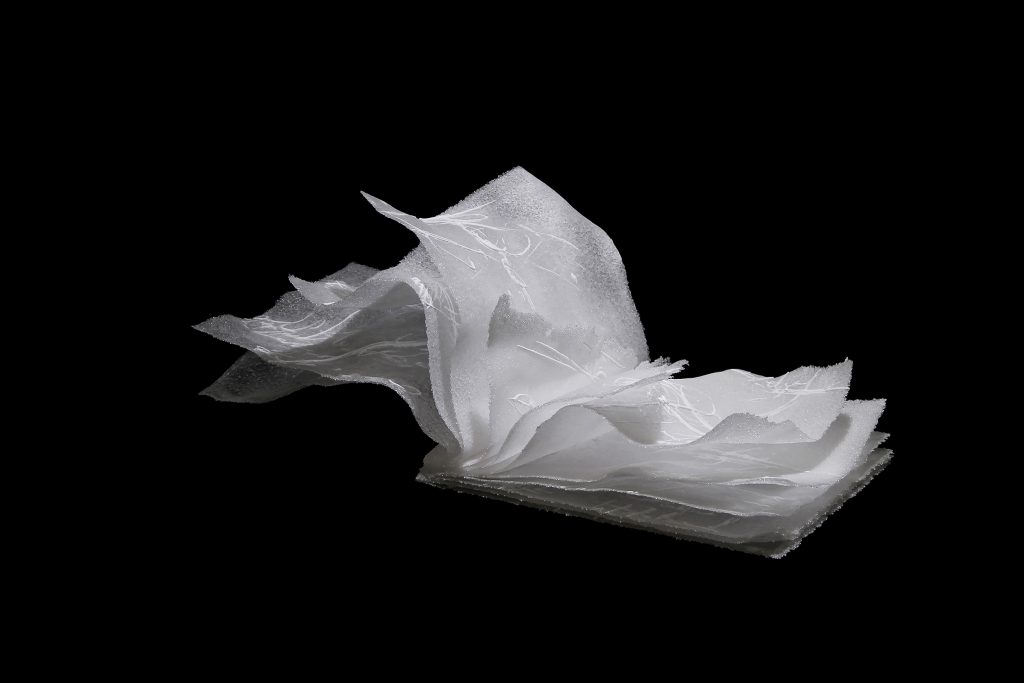
Books of Disquiet 2018, Photograph, Anne Petters
The pieces are made in a special pate-de-verre technique, which allows me an immediate and expressive way of bringing drawings onto glass. I see it as a form of intaglio printing translated into a kiln forming process. I use plaster-silicone moulds as printing plates on which I write reverse and then carve into the moulds tracing the spontaneous writings. White and clear glass frit is then sifted onto the mould and fused at about 720° Celcius to thin ice like sheets of glass. The pieces are then assembled to books or free forms and shaped in the kiln at 700°C. The process moves between control and randomness, which gives the pieces the natural, timeless and fleeting form. Process informs the concept in this case.
I see Lichtung - White Drift and the Books of disquiet as physical manifestations of the intangible phenomenon of imagination, one interpretation of this liquid space, as an attempt to freeze moments of thought. They reflect on the desire to control randomness and fleetingness.
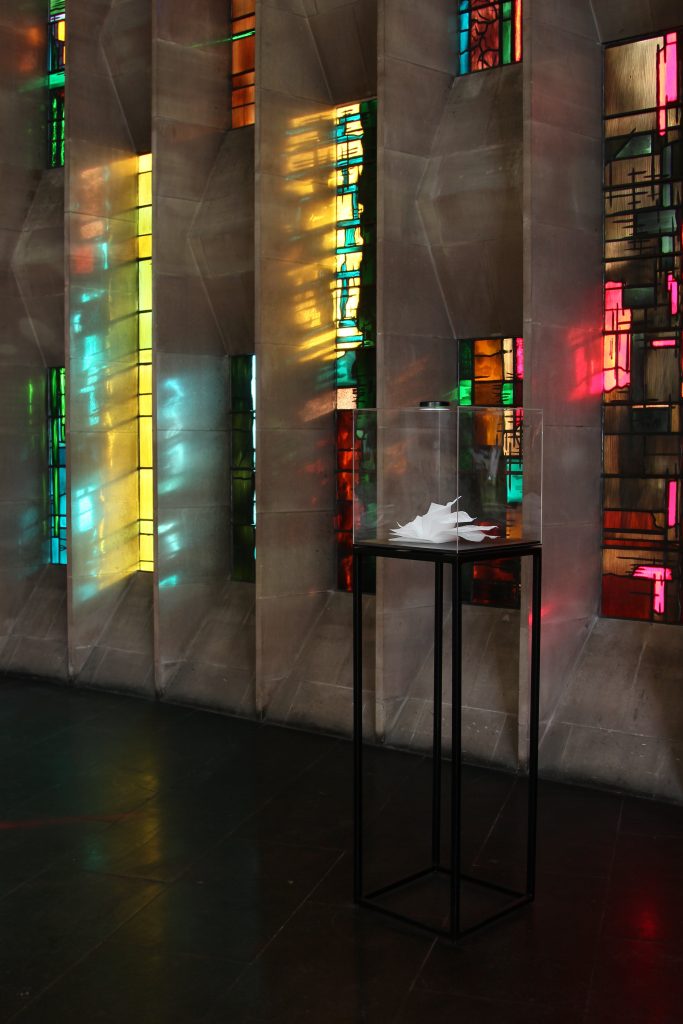 Lichtung White Drift, Photograph, Anne Petters
Lichtung White Drift, Photograph, Anne Petters
The writings are personal poems and thought fragments that run through my mind at the very moment of recording them.
The marks seem to contain information and draw the viewer into a secret but at the same time they elude themselves back into the ephemeral space they came from.
The handwritten text and drawings on these pieces are very subtle and cryptic. Therefore, although they are very personal, they function more as a visual comment on imagination itself rather than as a source of information.
The book as an object is a universal symbol for eternalizing one’s ideas. It contains and frames a certain space of someones mind. Once printed ideas are manifested, materialised and frozen in time.
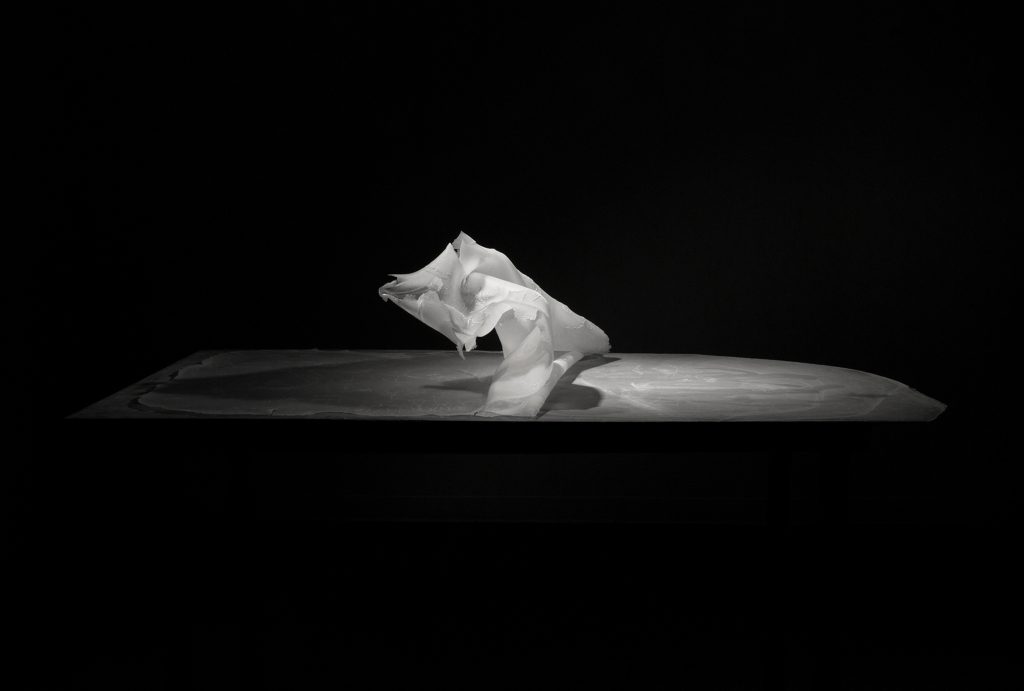
Disegno II, 2011 pate de verre hotprint glass, plaster, wood, 110cmx132cmx71cm, Photograph, Anne Petters
I am taking this object out of its function as a source of information and turn, it into a poetic image that pictures our innate desire to control time and fleetingness. The importance of making glass appear so fragile.
Discuss your comment, “…freezing moments of beauty” in relations to your glass art.
I am using certain properties of materials that pushes them to an aesthetic quality that trigger attraction and in the case of my glass work it is the fragility and ephemeral translucency that make these pieces so attractive and captivating. I believe that materials have a certain gravity on an emotional level and I like to use that to trigger curiosity and a sense of unearthliness. In the end all my work has the purpose of creating an intense sensation in the viewer, a moment of surprise, awe and wonder.
The natural, moving and beautiful forms of the books and the fragility of the pages suggest something so fragile that it seems they would blow away every moment, or melt. But they don’t. It is the essence, the image of timelessness for me.
Weises-Rauschen-2020
Tell us about your time at Pilchuck Glass School.
The Pilchuck Glass School is an important place for the glass community. Established in the 70’s by Dale Chihuly and friends, it was an experimental pioneering glass studio in the forest of the Pacific North West, two hours h north of Seattle. Glass as an art form was very young and niche at the time. The school developed into one of the most vibrant and important places for artists interested in glass. For everyone who has ever spend time there it has been a life changing experience one way or the other. I first worked at the Pilchuck Glass School in 2014 as one of six emerging artist in residents. The seven week long residency allowed me to experiment and play through some ideas, which now almost 10 years later have come to life in my work Sombre, large black glass leaves referencing the shadows of things.
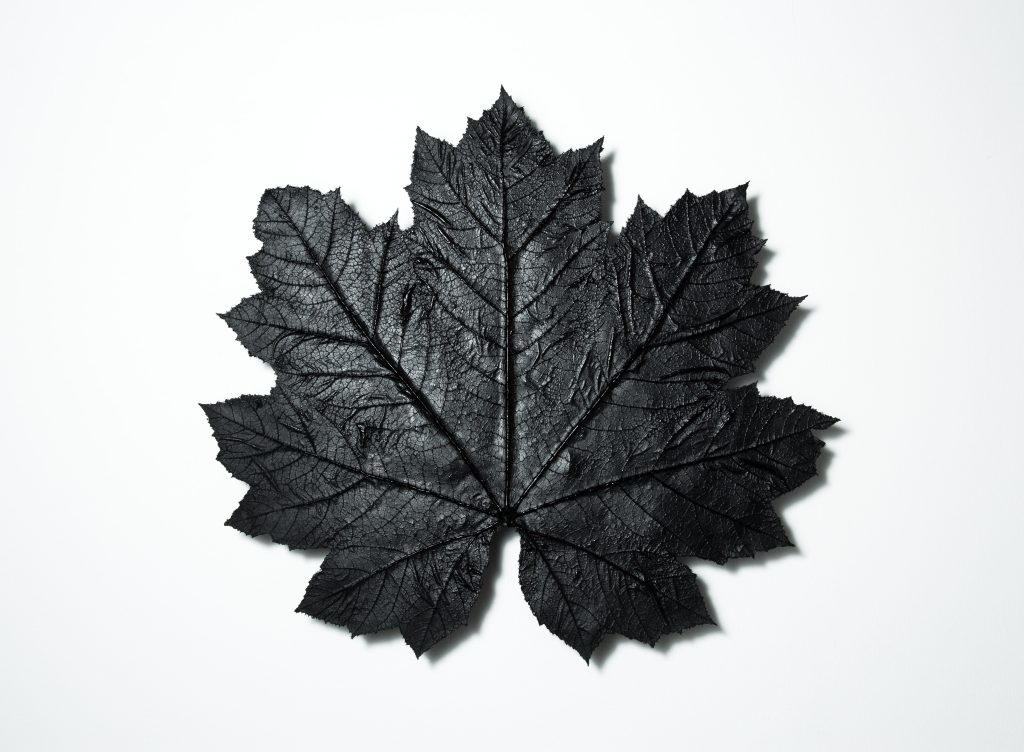 Sombre (n3), 2022, 56x50x2cm
Sombre (n3), 2022, 56x50x2cm
The school is located in a magical isolated mountainous region. Spending such a long time in nature has informed my work immensely, and helped continue conceptual ideas of my installation work like BeautyII, One and 1ALL from 2011, which all use natural phenomena as theme of desire to freeze beautiful moments in time.
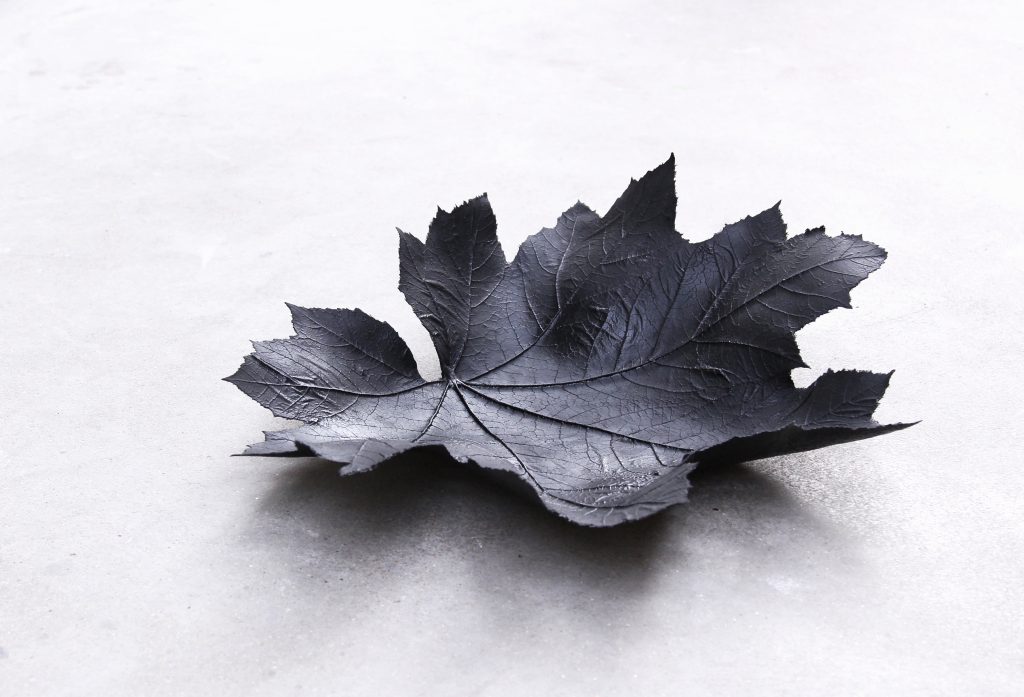 Umbra, black glass, 2023, 52cm x 49cm x 19cm
Umbra, black glass, 2023, 52cm x 49cm x 19cm
Discuss the importance of residencies and membership of many important glass organizations.
Working with glass as a professional artist is very challenging. My practice requires certain equipment and a lot of space. To survive as a glass artist who does not come from a wealthy background is a daily challenge. Establishing a private glass studio is for many of us a dream that takes many many years of commitment and sacrifice on one’s personal life. Residencies offer fantastic opportunities for artists to spend a focused time on developing new work without interruption of daily life. Especially as emerging artists working with this challenging material you need time and support to build up skills and a body of work. I always experienced the glass community as a supportive network, where artists share their research and help each other. Being on the board of the Summer Academy Bild-Werk for instance for almost 10 years has both provided me with a constantly growing network of inspiring and committed artists and also allows me to give other artists and my students the opportunity to meet and widen their network.
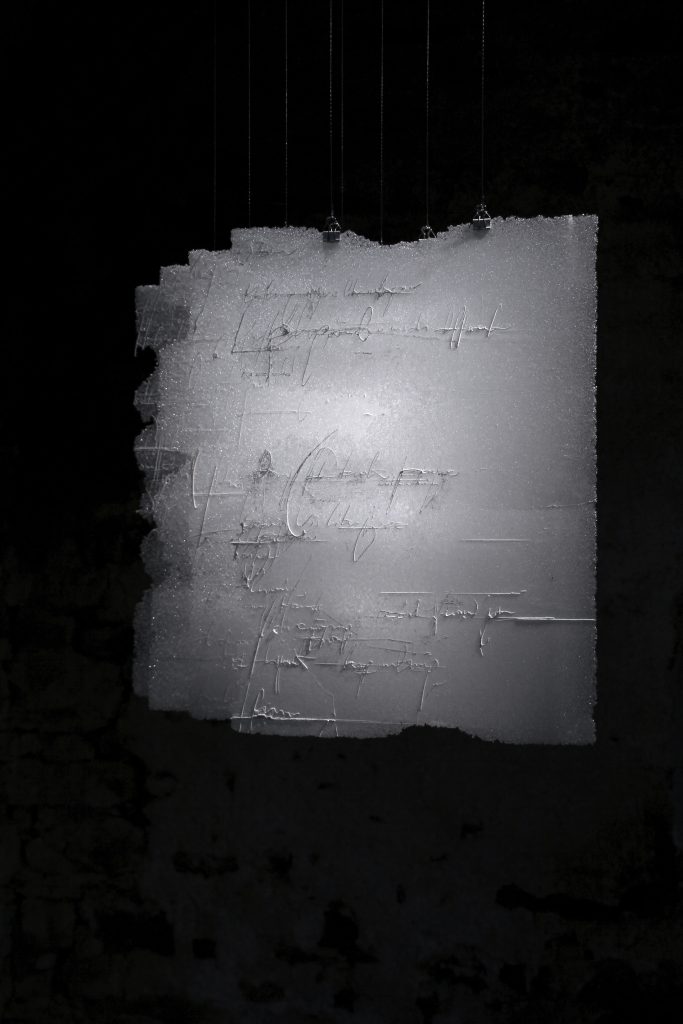 Silent Echo Byre 2019
Silent Echo Byre 2019
Anne Petters
petters.anne@gmail.com
Anne Petters, London, England
Interview by Deborah Blakeley, January, 2024
Images on this page are all rights reserved by Anne Petters
Mariko Ando
Can you explain the way the mixing of two cultures, Japanese and Canadian has affected your current work?
I was influenced by European culture from a young age and was particularly drawn to Victorian style illustration. I loved the British Monty Python inserts, for example, which were collages of these. I feel that the beauty of Japanese art is its serenity. I became particularly aware of this when I came to Canada. Perhaps the composition and spatial expression in my art works are a fusion of the Japanese part of me and European materials.
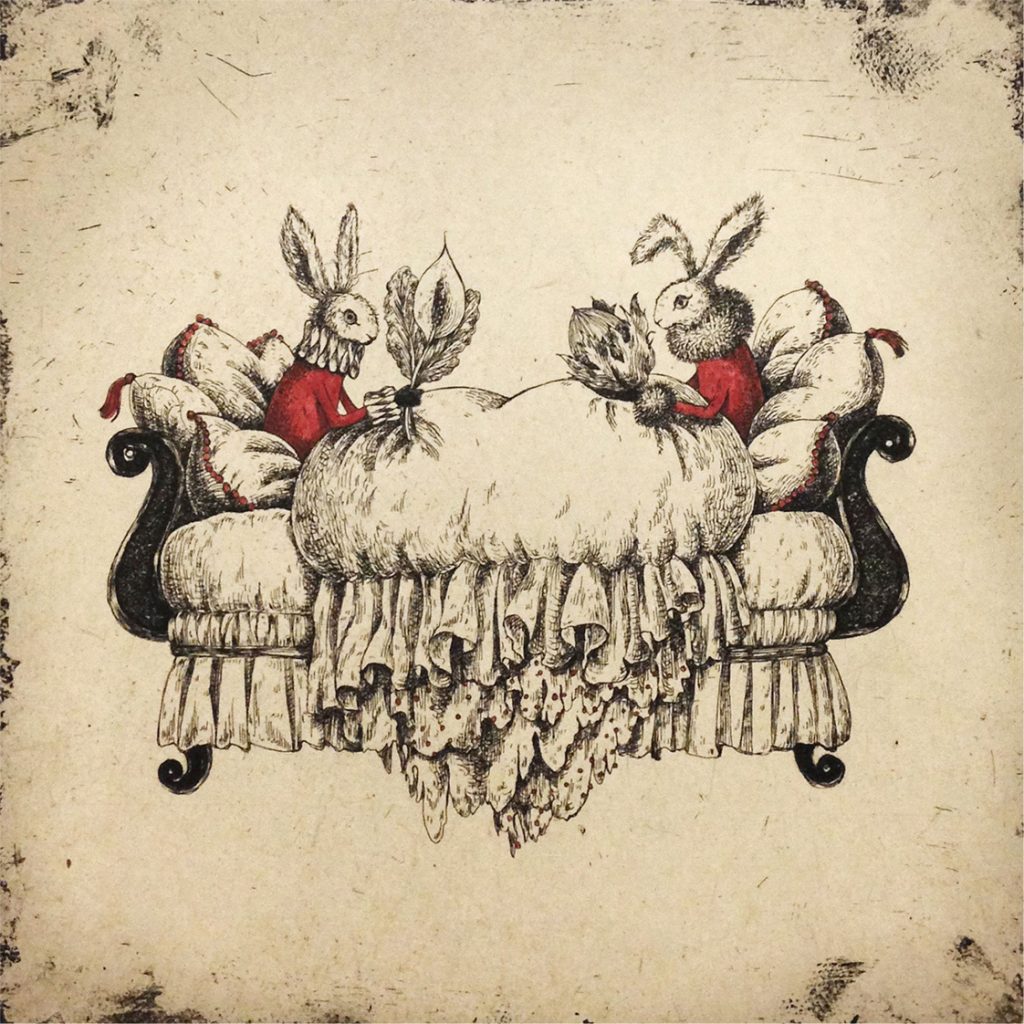 Everlasting Love
Everlasting Love
Explain the term Intaglio Printmaking?
It refers to all intaglio techniques of printing and printmaking. Conversely, the relief printing technique is called relief printing. A metal plate is physically engraved with an engraving knife or steel brush, or corroded with an acid solution to create a concave area, ink is applied to the entire plate, the ink on the surface (convex area) is wiped off with a cloth or newsprint paper or hands and then transferred to paper by applying pressure in a press machine.
What led you to working “Bunny”?
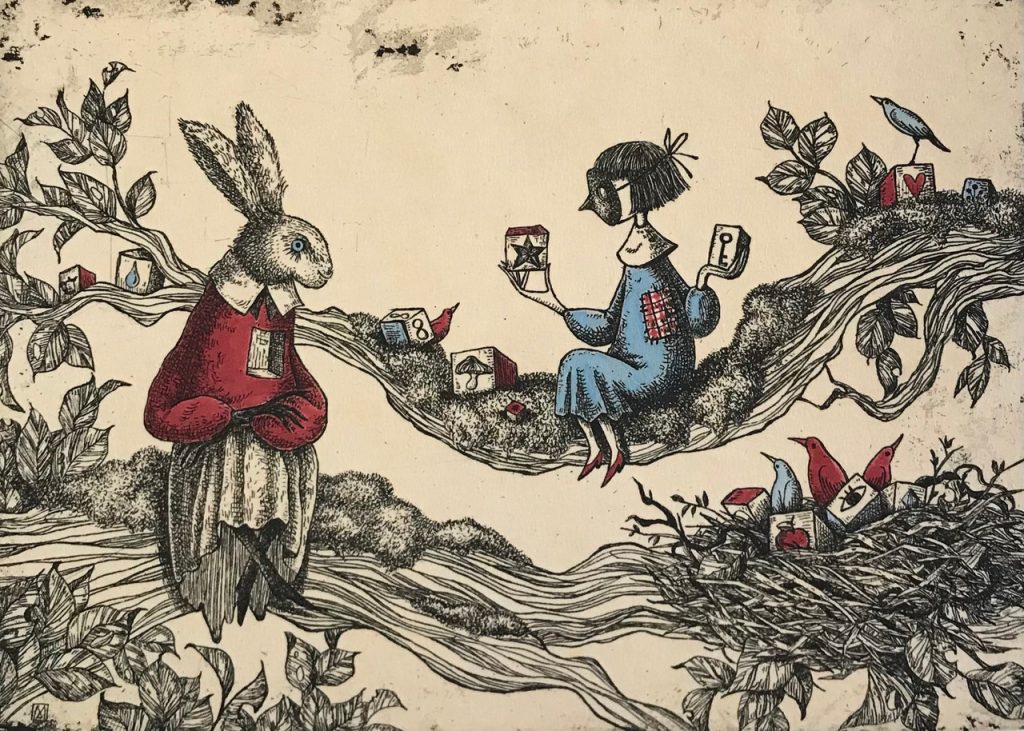
Lost and Found
I don't remember if it was a dream or what, but it must have been a daydream. A rabbit appeared. She / He didn’t say anything.
I started drawing the rabbit in my painting, and now my hand moves on its own and draws the rabbit. The rabbits I draw are inorganic and somewhat frightened, but they have a little courage. I am sure they share the childhood memories that we all have in our hearts.
The bunnies lead the way in the world I want to express.
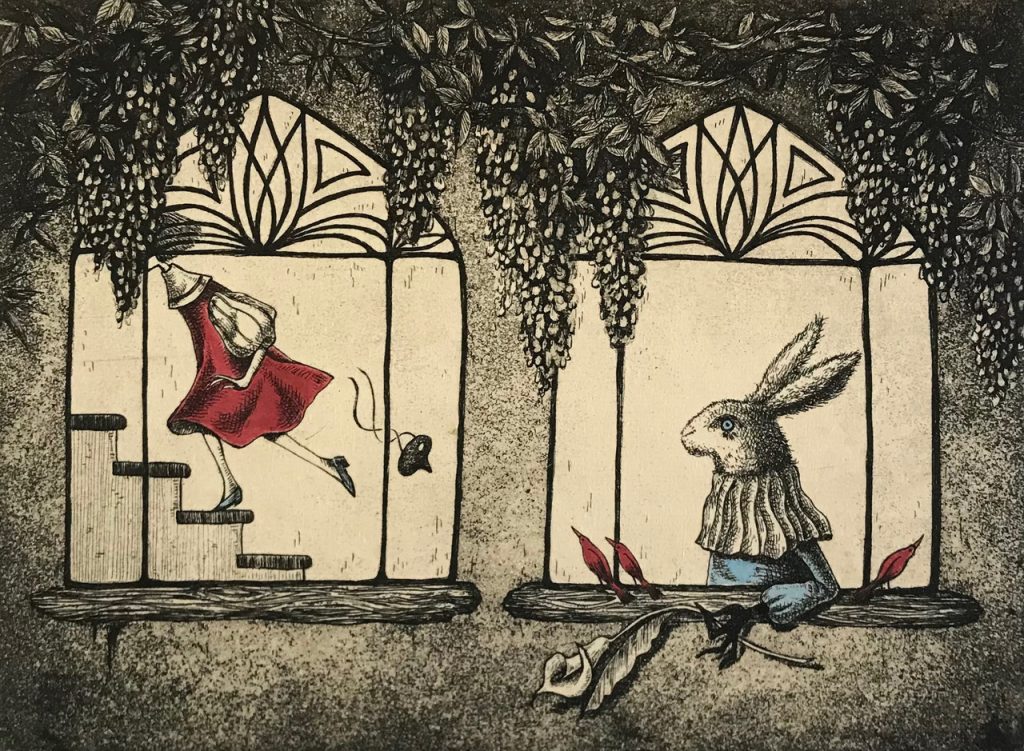 Night of June
Night of June
Your “Bunny” Series has been developed into Limited Edition Prints, discuss.
They are mostly, about 20 editions. Small are 5 to 10 inches or less. Large ones are about 14 inches. Sometimes on red paper is used, but usually hand-coloured with acrylic paints or colour inks after the ink has dried.
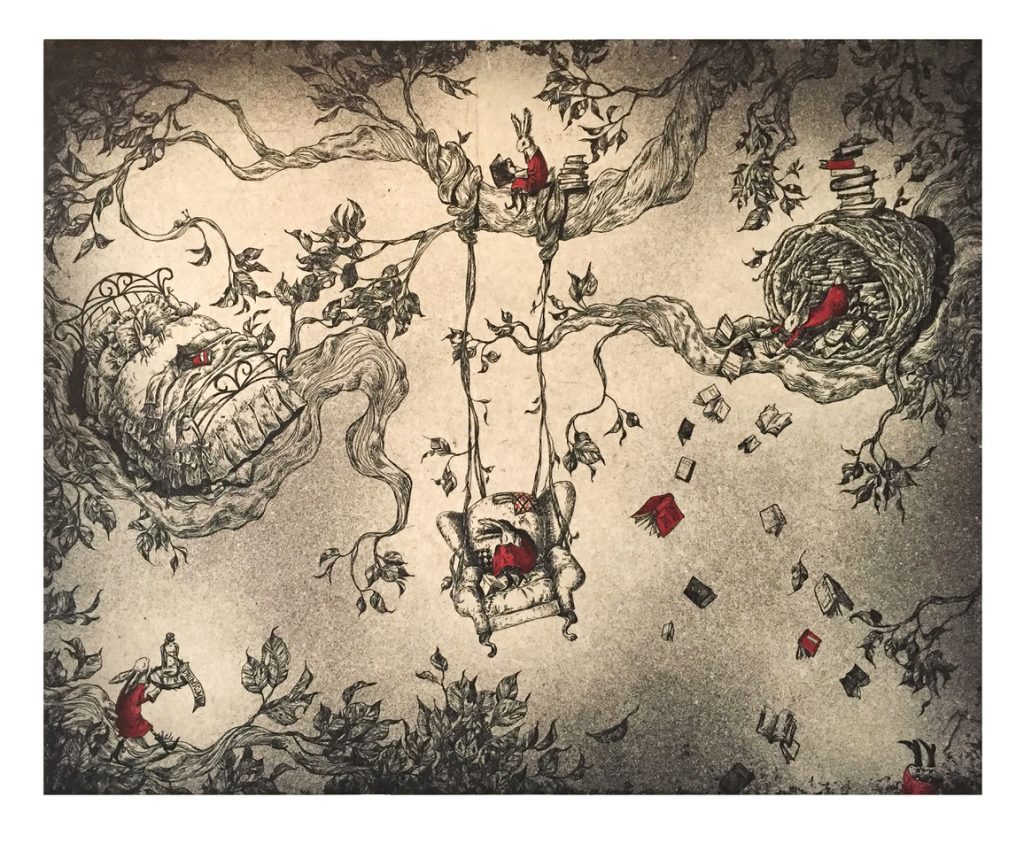
Gracious Insomnia
Show, how you have made your animals take on human personalities.
How? That is an interesting question. I have never thought about it. All living things have their own language and I always speak to them naturally. It’s a natural thing to me?
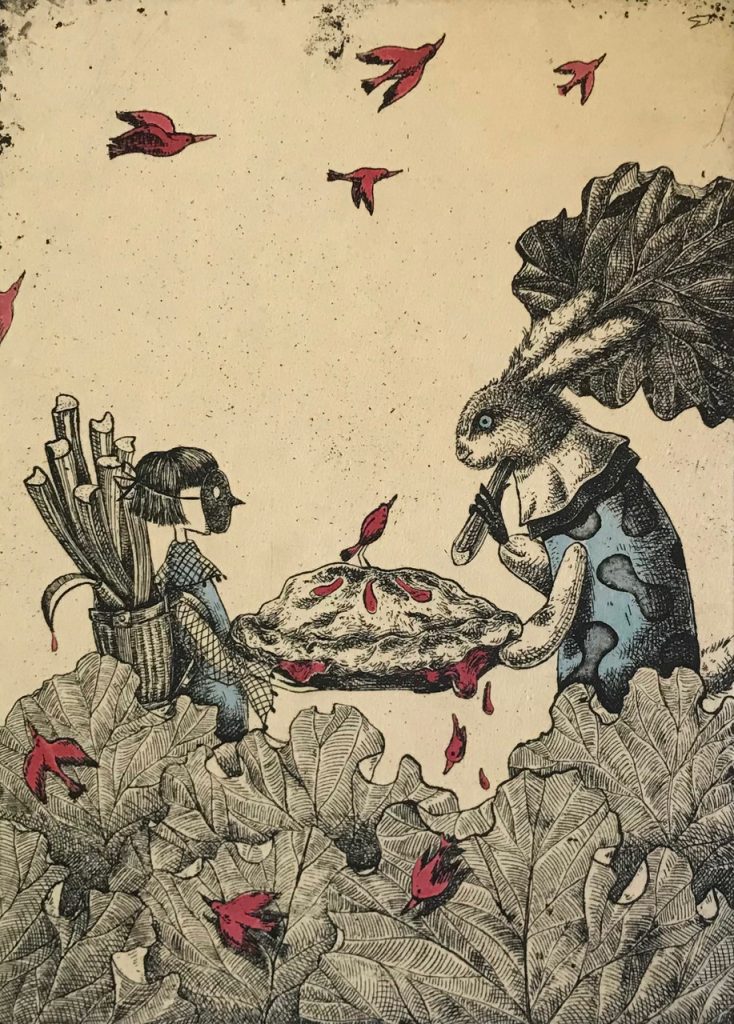 Her Rhubarb Pie
Her Rhubarb Pie
How has your work come to be chosen for several Children’s book illustrations?
For me, illustrating picture books has always been a dream. When I came to Canada, I created a portfolio, researched publishers and sent it off. It didn't lead to work straight away, but I think it was the result of a long, slow process of building good relationships.
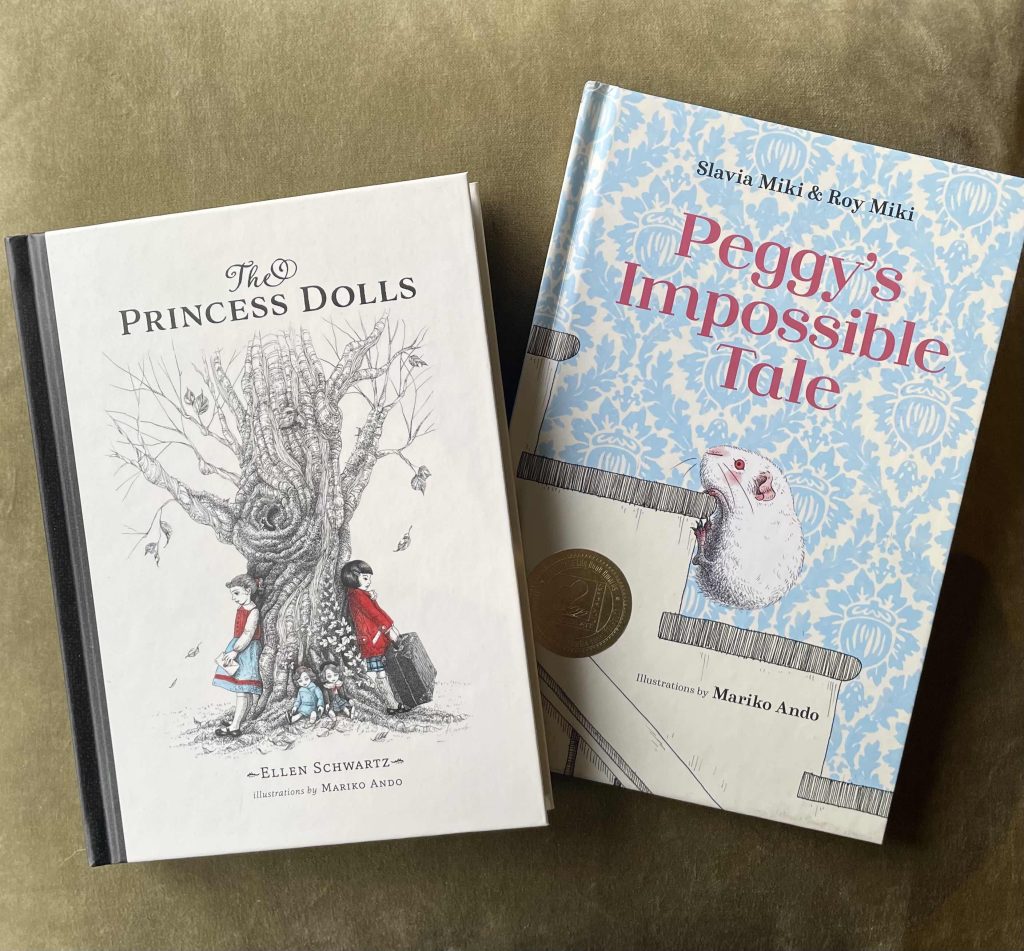
How important is the relationship between an author and the illustrator?
The author and illustrator do not usually meet or talk until the picture book is finished.
It is always communicated through the publisher. This is something of a rule in the traditional publishing world. Of course, it is up to the publisher and the author. When I meet the author after publication, it is a very magical and emotional hug. It is a wonderful moment. Producing a picture book is really hard work. If you can't even get on with the marketing properly, it will end up being wasted on no-one's eyes. That's why I try to refuse to work on picture books unless it is through a professional publisher. (Book info: ‘Peggy’s Impossible Tale’ by Slavia & Roy Miki :Won Award: Chocolate Lilly Book Awards 2023 , ‘The Princess Dolls’ by Ellen Schwartz :Won Award: Western Jewish Vine Book Awards 2019 , both published by Tradewind Books).
Are the connections to Alice in Wonderland, intentional?
People often tell me that. I am not particularly conscious of it. But I respect very much John Tenniel who the original Alice in Wonderland illustrator. I do have his prints and vintage books! Those are my treasures.
Can you discuss several of the characters in the work “Silent Spectators”?
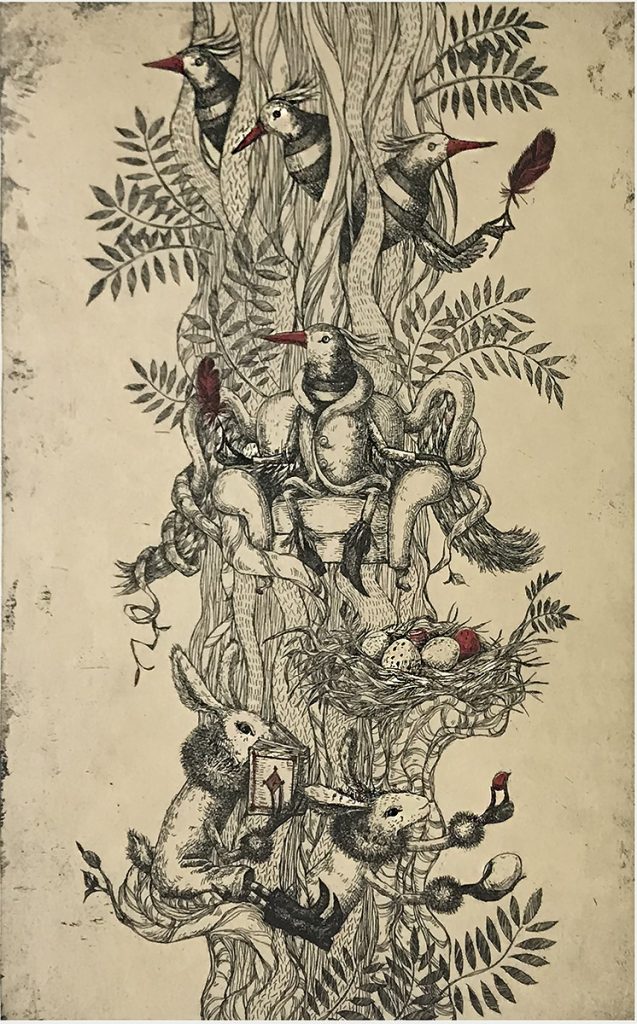 Silent Spectators
Silent Spectators
What are the prince and his cronies up to in their bird kingdom in the deep forest? The three rabbits don't seem to mind them and seem to be enjoying themselves, but they know something is going on.
How has your “Alphabet” Series been sold, individually, making up a word or name, or as a set of 24?
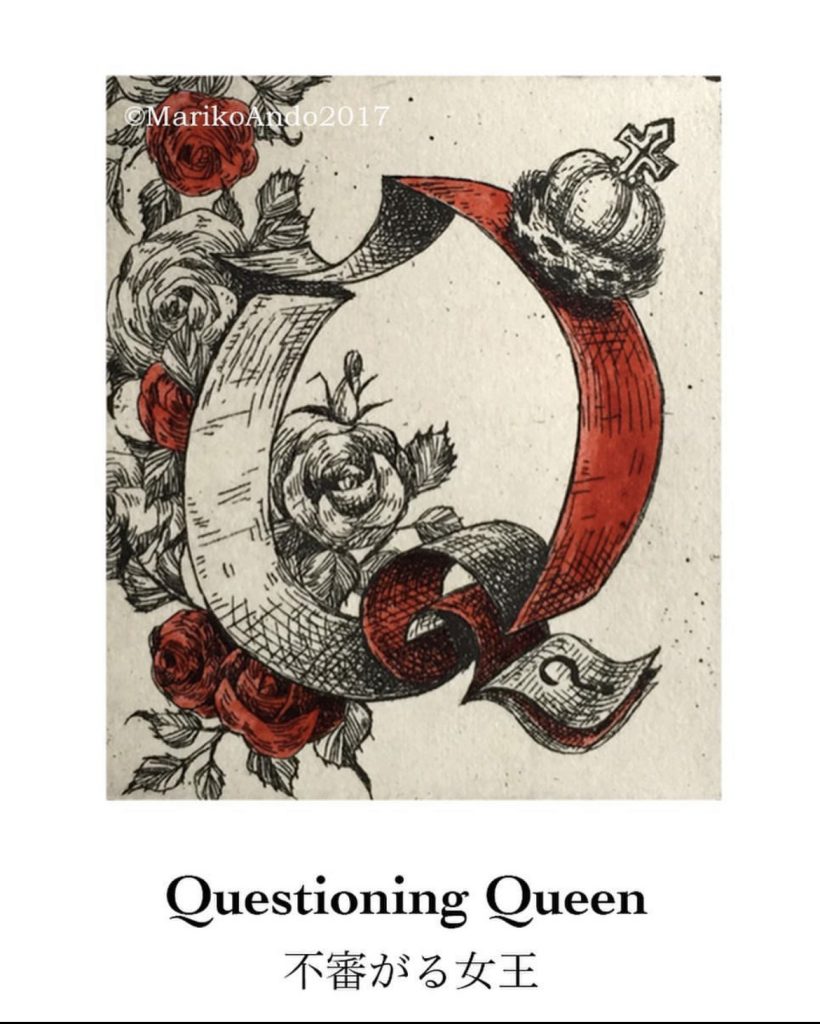
It’s still available a set with A~Z, 26 sheets, together with front and back covers. They are also available individually. Unfortunately, the book is not yet bound, but I would like to make it someday.
'Alphabet Series' (2017) has always been something I wanted to make. My father died in 2016 and I made it for him and my mother. I don't know if it's all about them, but it was my parents’ who created the creature I am. Isn't the A to Z in me their creation at the same time?
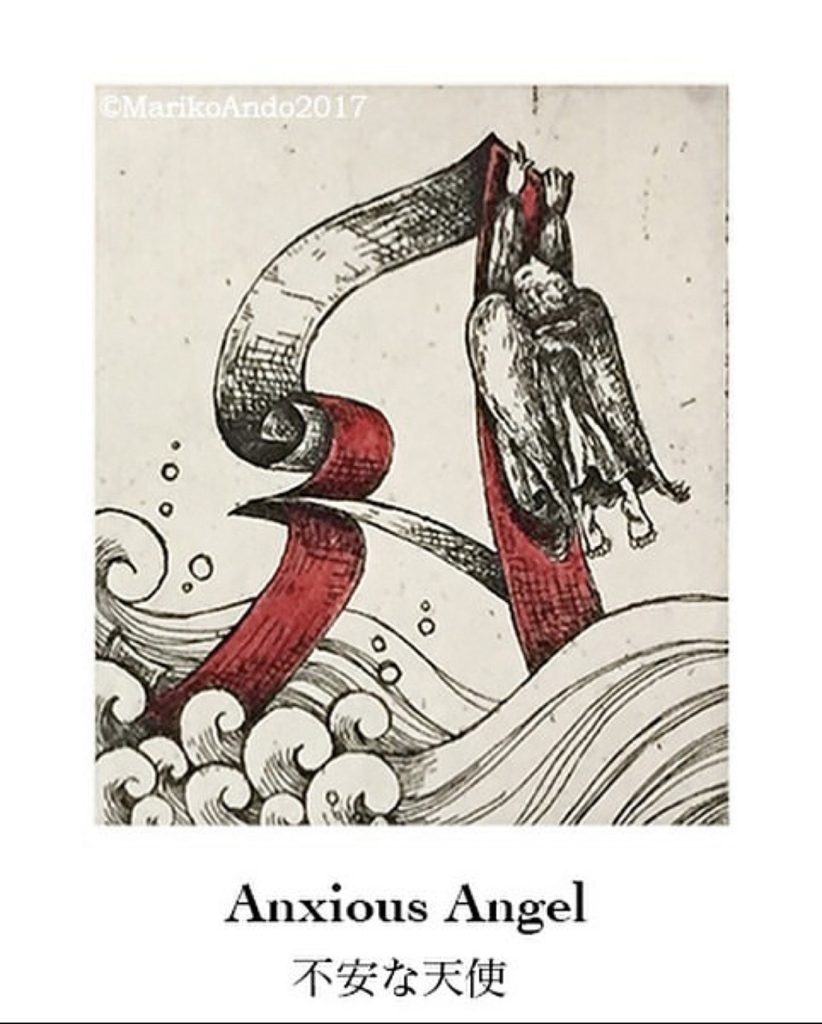
'Alphabet Series' combines two words with the same alphabet at the beginning and creates an image based on it. I made them while staring at the dictionary. It was difficult to come up with them from my limited English vocabulary.
I would ask my husband, 'Isn't this combination strange?' and I checked each one, and his answer was always, 'It's strange, but it's funny and it's you.'
Your exhibition “Minding Rambling Hares” in Vancouver, discuss, the importance of being a printmaker of this standard. The attention to detail.
I think especially in recent years. A series of terrible conflicts and disasters that make us want to prevent hearing anymore. Even if not, people have small sorrows and sufferings in their daily lives. It doesn't matter how big or small it is. I think it would be wonderful if people could forget everything for a moment and smile when they pass by my artwork in such circumstances.
Why etching printmaking?
The lines carved by the chemical corrosion of the copper plate have an appeal that is completely different from that of direct drawing with other materials. Sometimes the result is unexpected, which is also interesting. Among printmakers, this is called a happy accident.
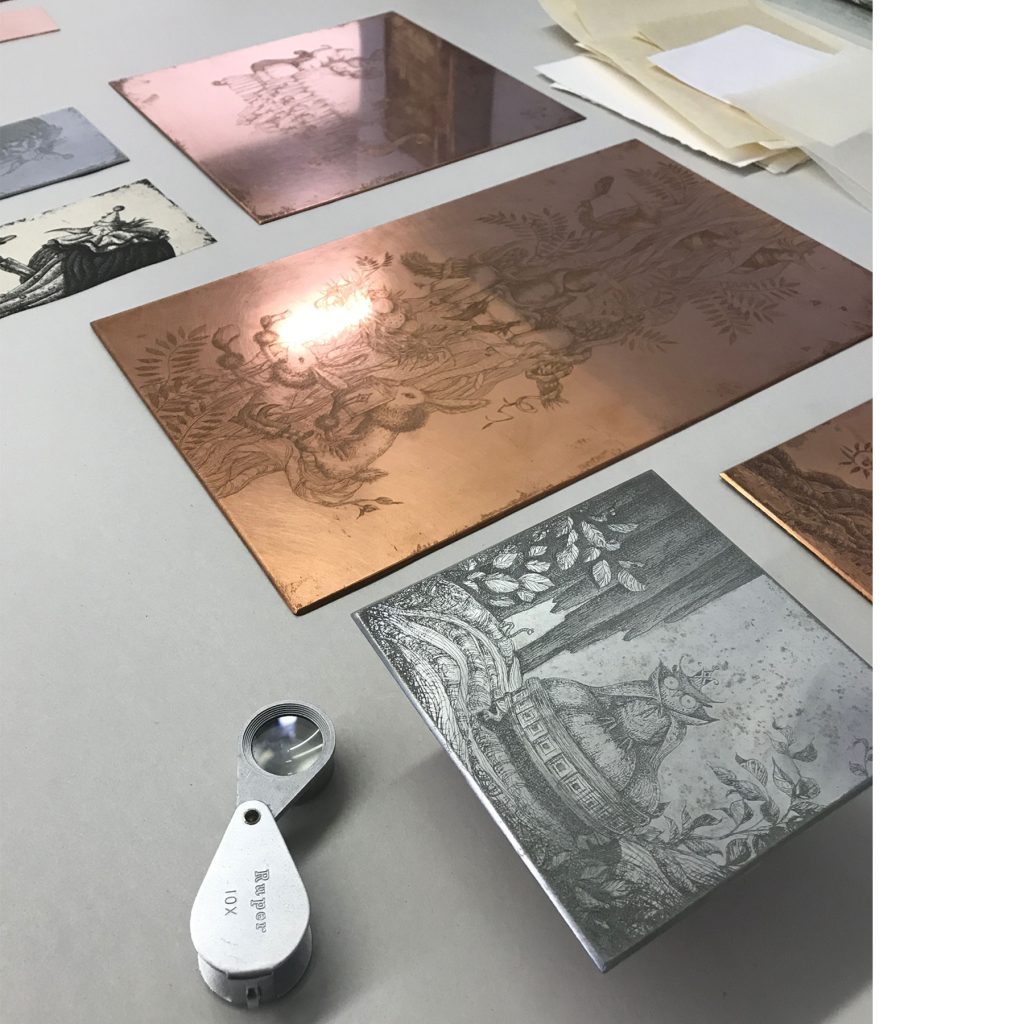 I'm particularly interested in the 'unearthed in the ground' effect. Etching is very suitable for that. The advantage of being able to reproduce. It's not a one-off, where if it sells, it's goodbye. I can keep at least one copy. I think there are probably a lot of artists who feel the same way, but the work is like my own child.
I'm particularly interested in the 'unearthed in the ground' effect. Etching is very suitable for that. The advantage of being able to reproduce. It's not a one-off, where if it sells, it's goodbye. I can keep at least one copy. I think there are probably a lot of artists who feel the same way, but the work is like my own child.
Printing technology is evolving at a dizzying pace these days.
I am a somewhat cynical person, who uses ancient printing techniques in contrast to the dizzying progress of printing technology today. I think it might be my twisted nature that makes me do it. However, the beauty of a sheet of paper that is printed by hand, one by one, taking time to turn a heavy press machine by hand is precious.
The smell of the ink on the paper, and the rise and fall of the ink, are something you should feel up close if you have the chance.
The pictures and lines on the copper plate engraved by etching, The plate itself is lovely.
Take two prints and comment on them.
Print 1
This is an intaglio printing. My usual style.
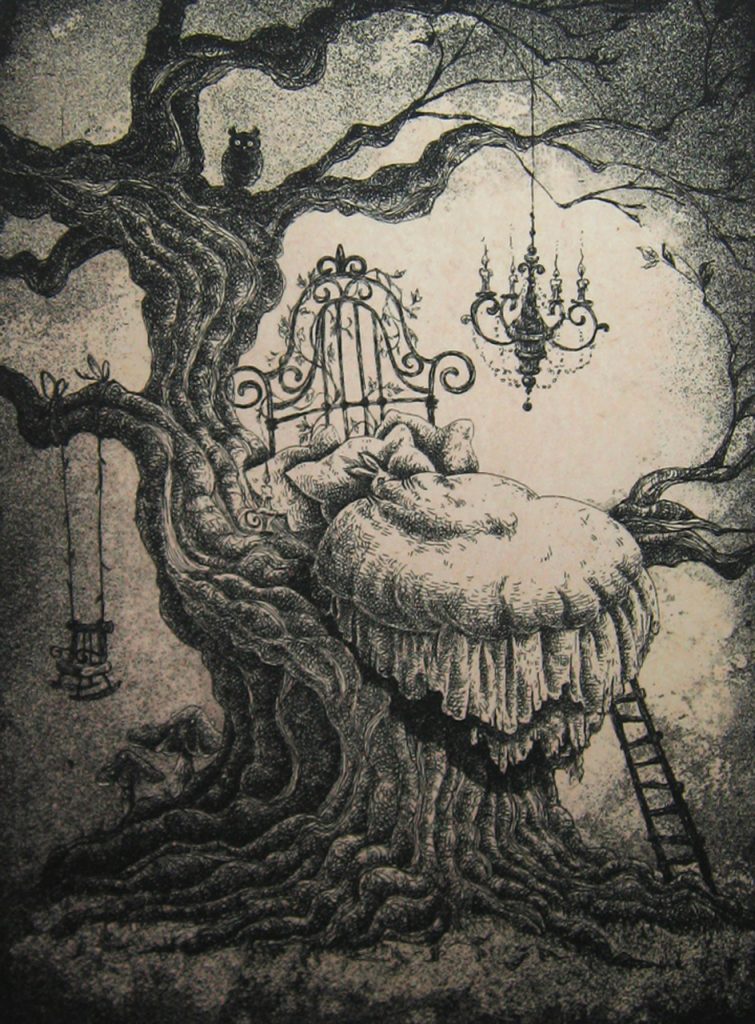 Day Dreamer
Day Dreamer
Print 2
This is a woodcut print. This is a relief printing. A chisel is used to dig into the wood board where you want to make it white. This is the complete opposite of everything, especially as it is a large 8’ x 4’.
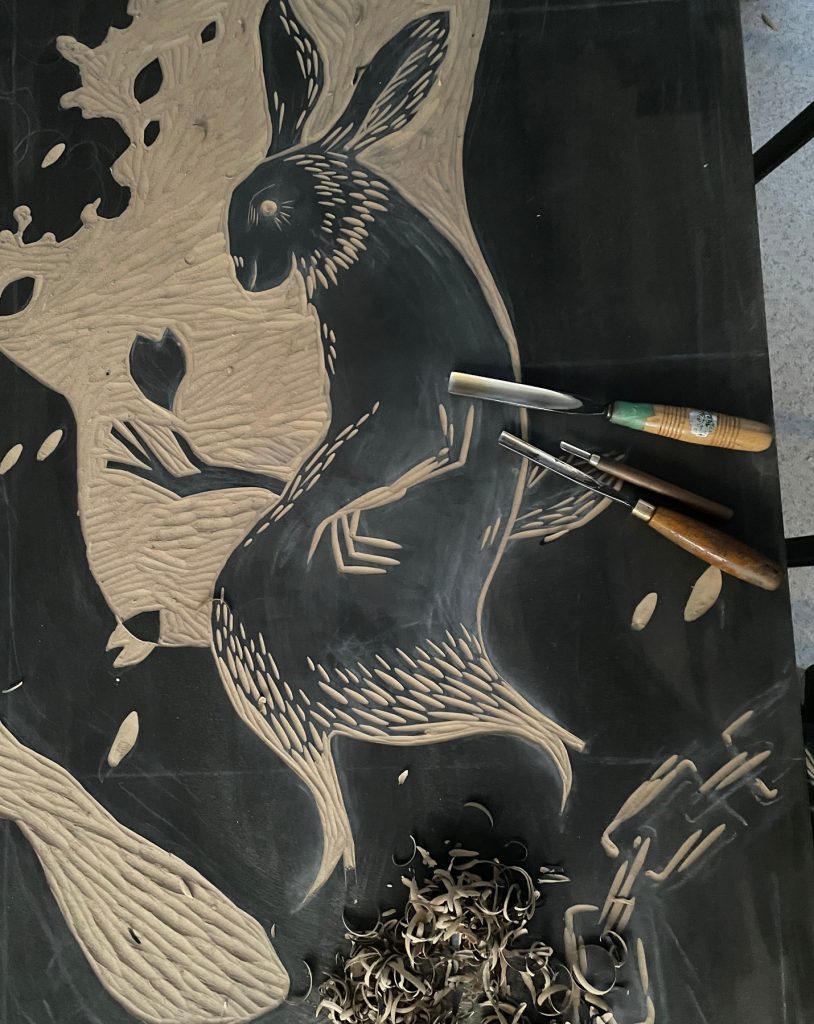 Big print, Print Block
Big print, Print Block
This ‘BIG PRINT project’ is by the Vancouver-based Creative Cultural Collaborations Society.
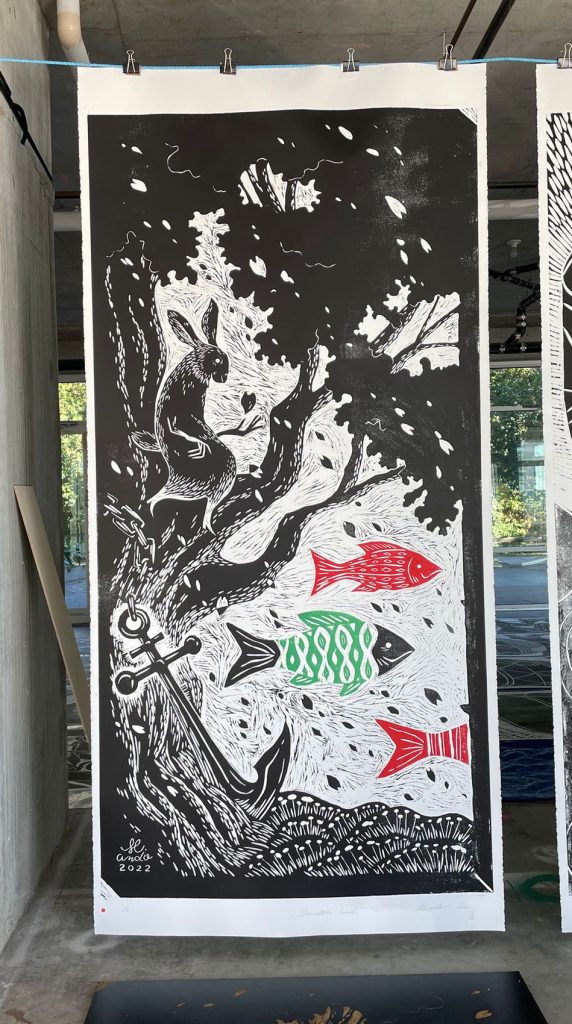 Big print photo
Big print photo
It was a unique project that was printed on a steam roller car.
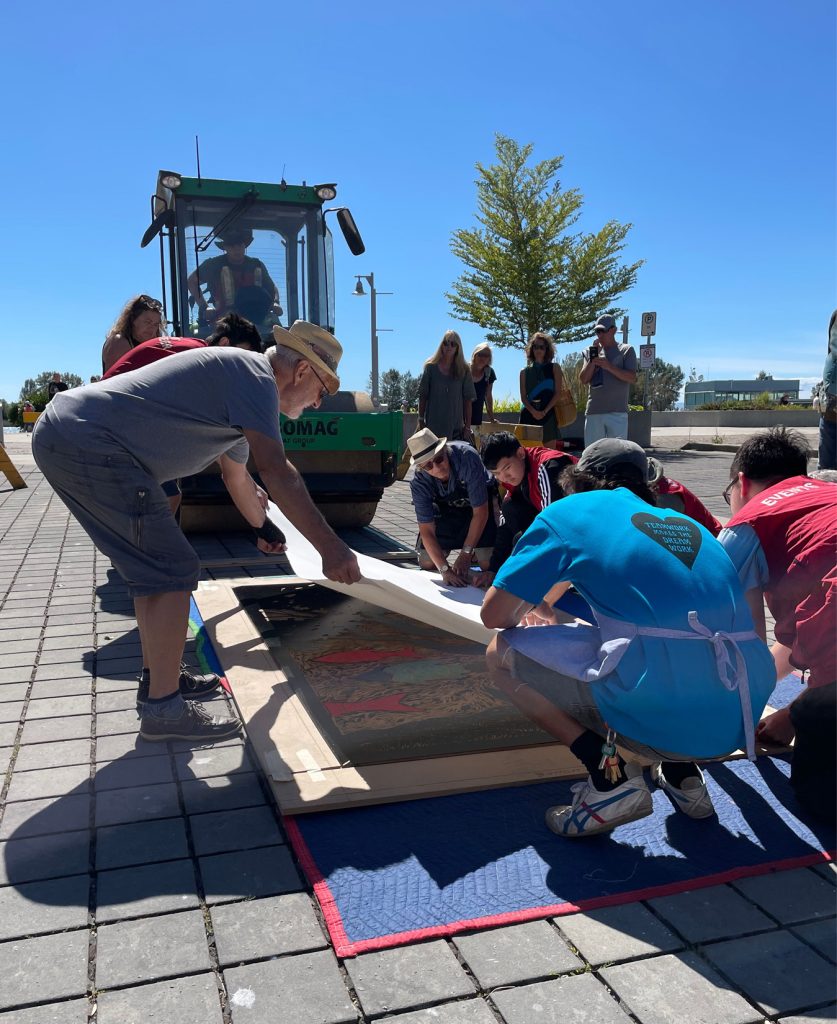
You have recently returned to Japan for an exhibition, discuss the process this took to achieve an exhibition in another country.
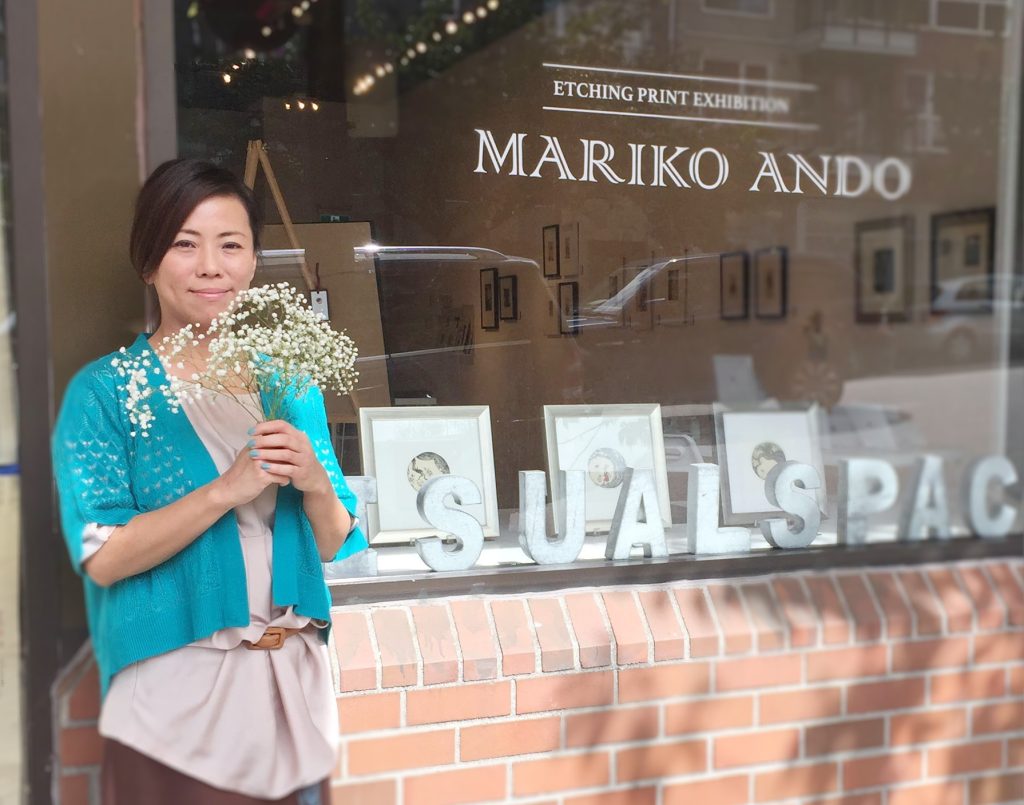
Yes. I had a solo exhibition in Osaka, Japan, in October. It was a great opportunity to meet old friends and new customers. It was very meaningful and nostalgic to have a solo exhibition in Osaka, which was where I worked when I was still a young artist.
In Japan, I can connect with people through acquaintances, and the solo exhibitions develop based on encounters and old connections. For example, the gallery owner Yukiko Onley Visualspace Gallery Vancouver introduced me to the Toga gallery Okayama, Japan. I feel very lucky. At the same time, I get to see my family and friends.
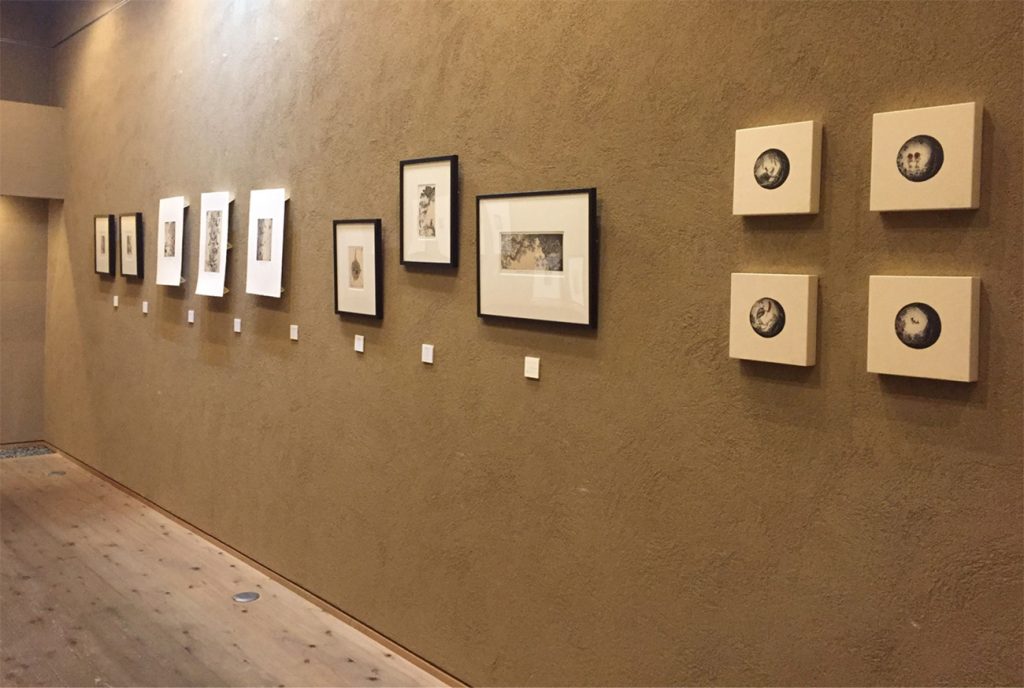 Japanese Gallery
Japanese Gallery
This November, I am currently holding a solo exhibition at the Liss Gallery in Toronto. I just recently returned from a trip to the opening reception. It's not overseas, but Toronto is far away from Vancouver, three hours time difference, and it's a big city.
I attended the Toronto Art Expo 10 years ago because I wanted to expand my base. I was nervous and anxious about attending a big show by myself, without any acquaintances and with my English even worse than it is now. I met the owner of the gallery there.
Originally, I would like to approach more places, but I'm taking my time and seeing how my fitness is.
Do you take commissions?
Yes, if it’s fits on my art work style, timing and cost.
What are you currently work on?
I’m working on the illustration for the Cookie Package of a Japanese Hotel. I’ll be back to work for printmaking and oil painting.
Discuss the relationship you have with your print studio.
When I came to Canada, all my career was in Japan. I didn’t know anybody and I didn’t have any connections here, I felt like nobody. And I always wanted to do print making. I found a studio in Granville Island, called Malaspina Printmakers Society, where some Japanese artists were also members. They helped me a lot. Also the other wonderful printmakers are so friendly and kind always. We were always helping each other in a comfortable place.
Today, I still uses Malaspina Printmakers’ studios when I need larger press machine and it has become a place where I have built a community for myself.
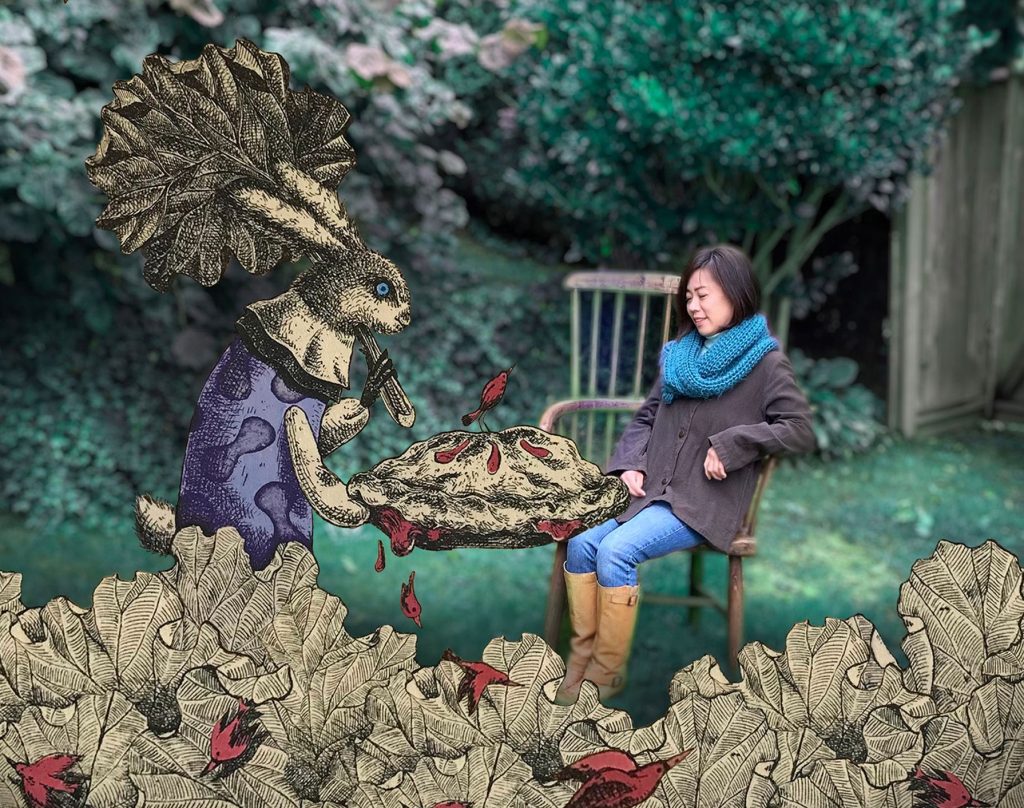
Mariko Ando
Contact details:
Mariko Ando, Vancouver, Canada
Interview by Deborah Blakeley, January, 2024
Images on this page are all rights reserved by Mariko Ando
Greg Kent
Your wood comes via local tree surgeons. Do you give them a list of trees you are after, or is it a mystery delivery?
I collect wood from wherever I can get it. I have a good relationship with some local tree surgeons and they let me go over to their yards and collect nice pieces which would have been firewood. I also get a lot of wood from local farmers and homes when trees have fallen down in storms. If I hear a chainsaw I’ll go and see what’s being cut down.
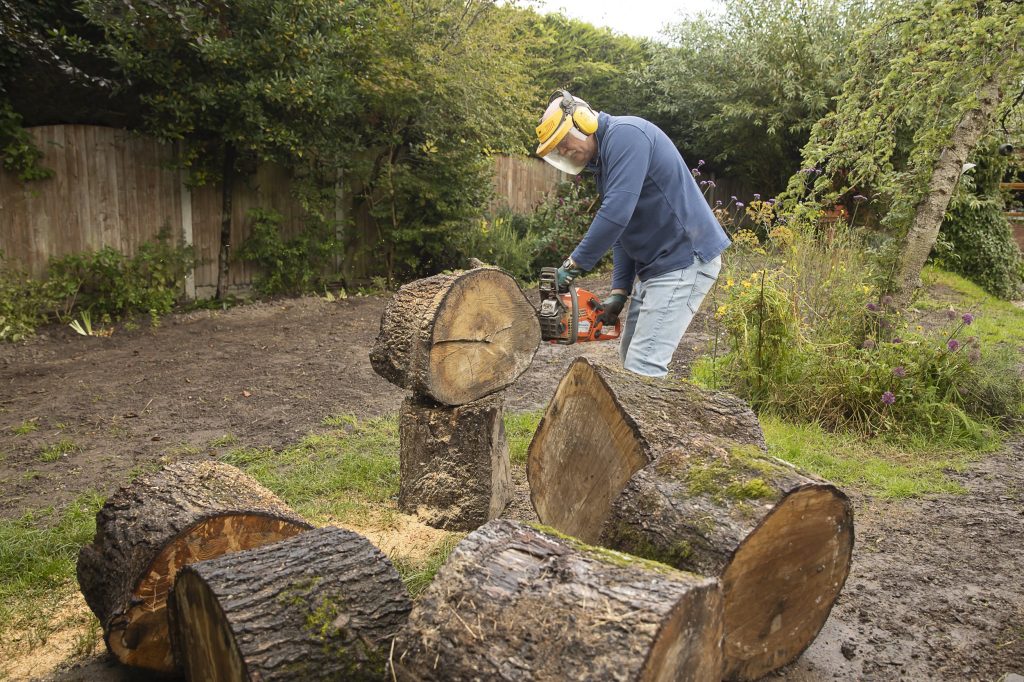
Can you expand on the term ‘Turned Green’ and the importance of it in the whole process of your work?
Normally woodturners turn wood that is dry, that is less than 12% humidity. Normally they would buy this from specialist suppliers. These sources are often expensive and unsustainable. When I get wood from a tree surgeon it will have a moisture content of over 50% and been destined to be firewood. This fresh wood is called ‘greenwood’. This can then be rough turned, coated in wax and left to dry (for 6 months to 1 year) before the final turn. What I do with oak is turn it green down to 2-3mm thick and straight to the final shape. I do this green because it is impossible to get that thin with dry wood as it becomes too brittle. Also, oak is notorious for cracking and if you turn it is this thin it takes the stresses out of the wood and the pieces just warp slightly into some lovely organic shapes.
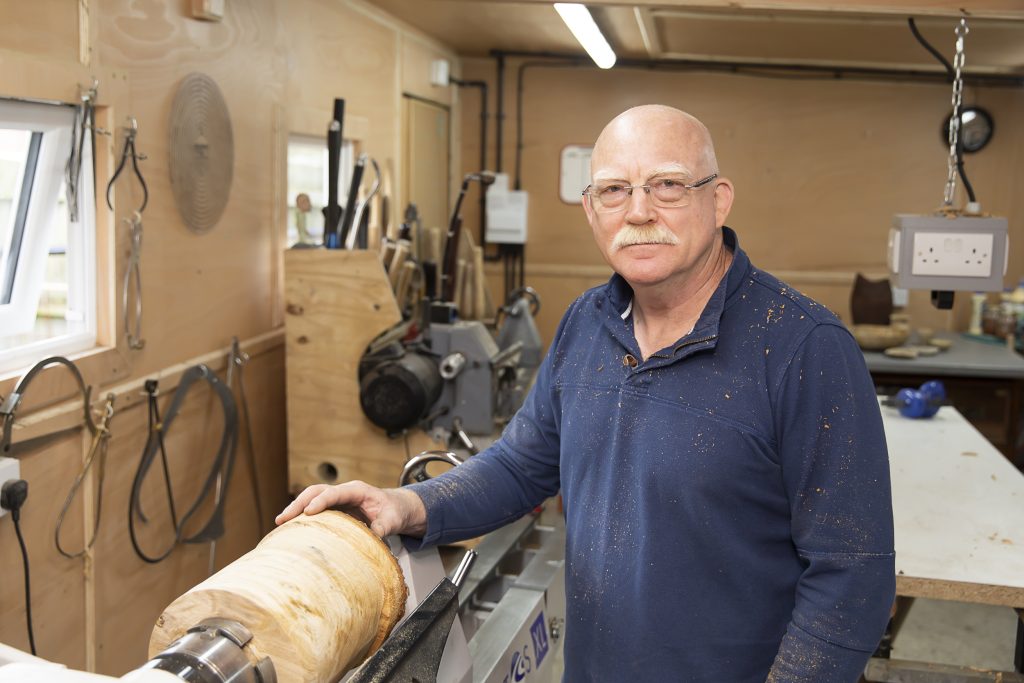
How long do you need to store the wood for?
I try and turn the wood straight away and usually with 3 months of it being felled. When I have turned it down to 2mm thick it then dries within a week and is ready for sandblasting.
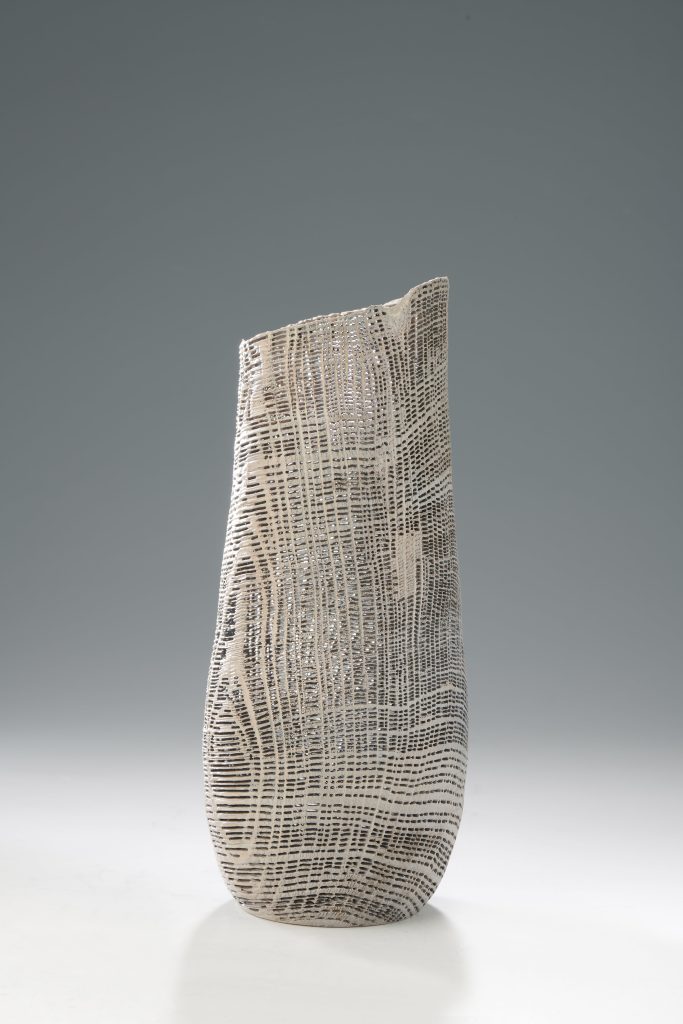 White Vase
White Vase
Where do you store it and how do you catalogue each piece?
The wood is stored outside. I’m not sure what you mean by cataloguing. All the wood I use is oak and admin is not my strong point. I seem to retain an encyclopaedic memory of where the wood came from and its story. The final piece is then stamped and numbered and has a certificate of authenticity.
How does sandblasting add to the final technique?
Sandblasting is what sets these pieces apart. The sandblasting picks out the soft spring growth and removes it. Oak has an almost unique feature called medullary rays. These go across the growth rings and give it it’s strength. The sandblasting leaves the harder summer growth rings and the medullary rays creating the lace like effect.
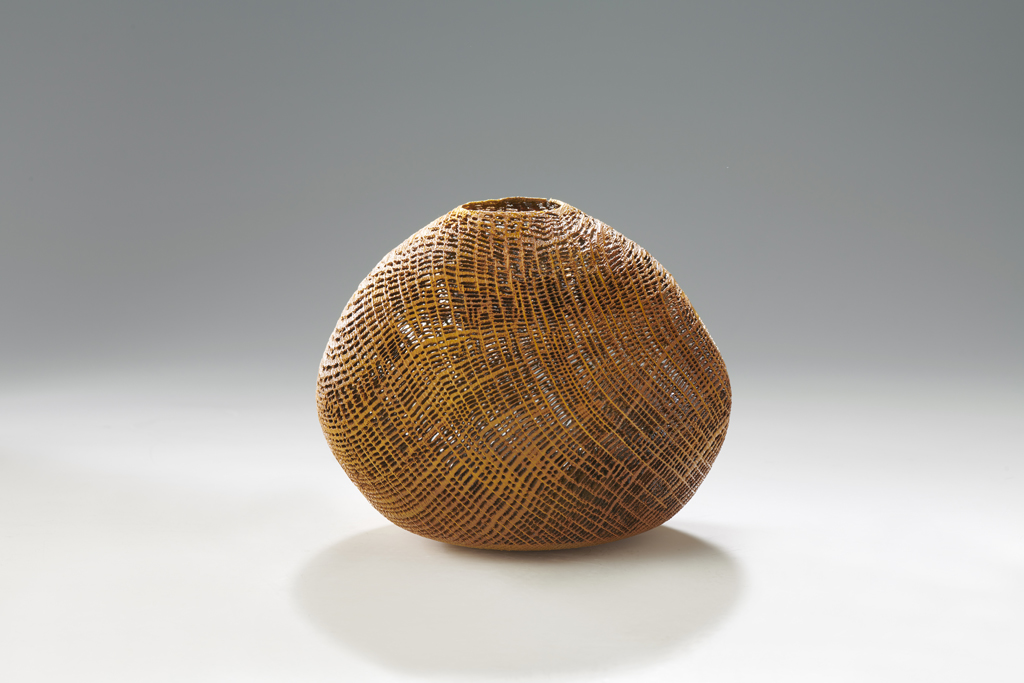 Hollow Form
Hollow Form
Discuss the different coloured stains you use.
I use a range of stains and finishes. It all depends on the how the wood looks after drying and sandblasting. If is has retained the golden glow of the oak I will leave it in the natural colour. If is has knots and bark inclusions I might highlight these with autumnal wood stains. Other pieces are either ebonised or stained in a natural stain such as honey or earth colour.
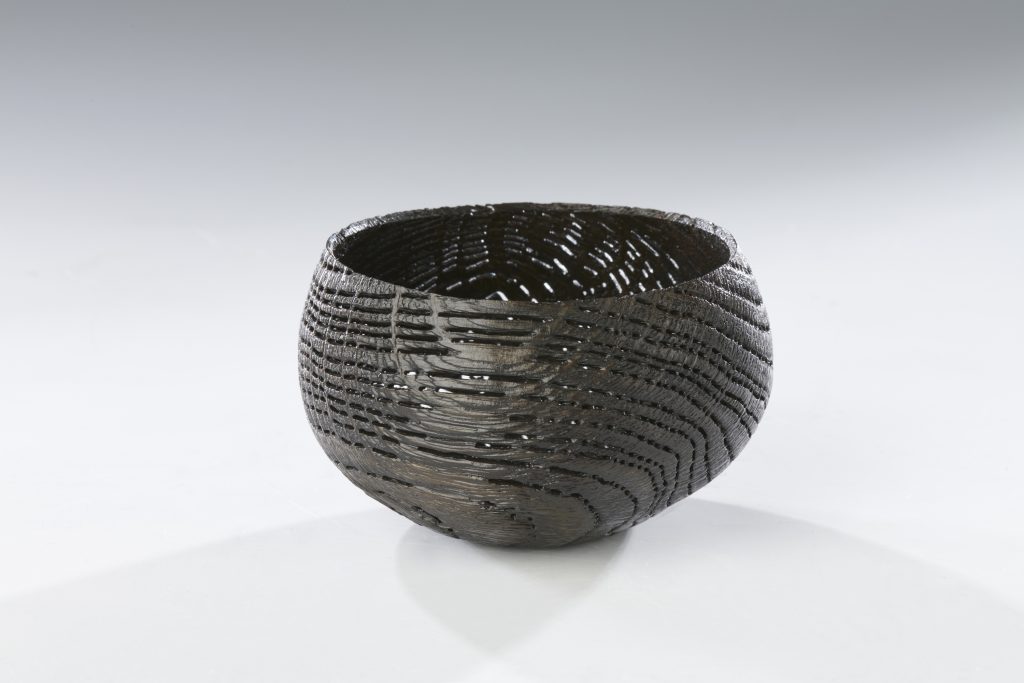 Small Bowl
Small Bowl
Discuss the fragility and care need for your pieces.
All the pieces are treated with a wood hardener and lacquered. So, whilst they are fragile they are like fine china.
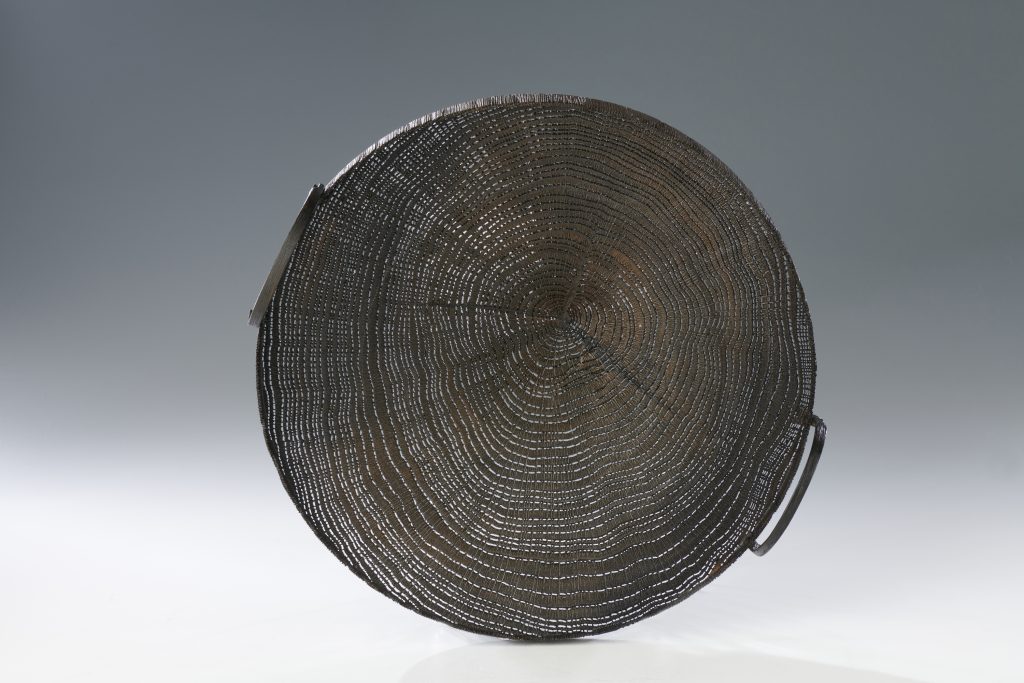
Tray
Take one large piece and one small piece and discuss why they still delight you?
A small piece I particularly like is the teacups that I made. I used oak with very small growth rings and this really highlighted the delicacy of the tea service. I also created handles from oak veneer and attached them with tiny oak rivets. The whole piece appeared to be incredibly delicate and yet was remarkably strong. They really captured the narrative I was trying to create.
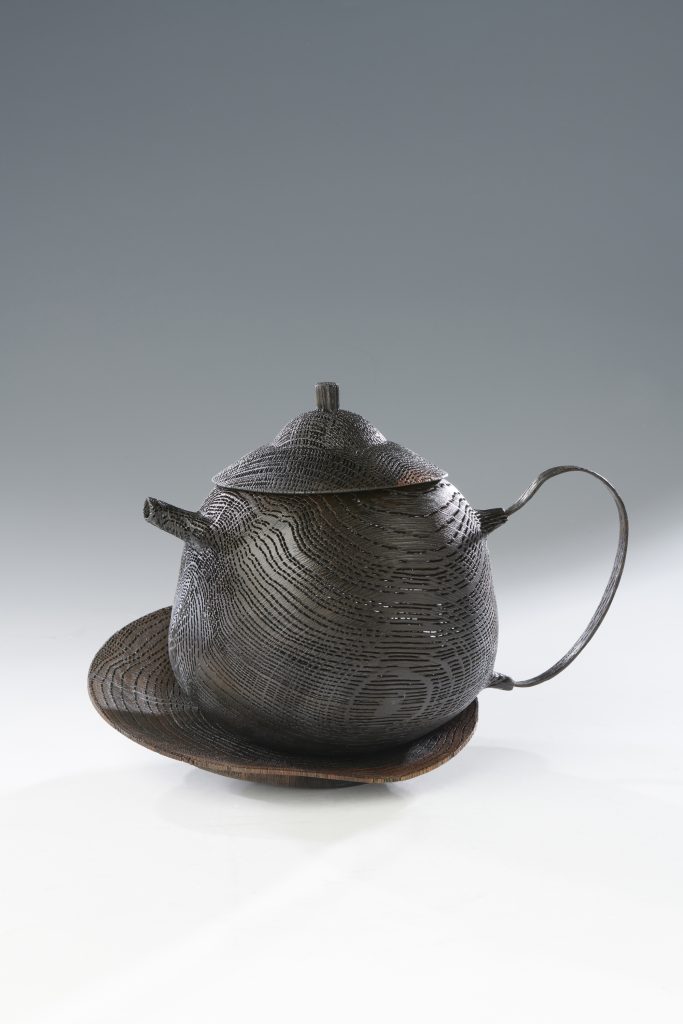
Tea Pot
The largest vessel I have created was actually made from quite a well-rotted piece of oak which I wanted to preserve because of its character. This involved using a deep hollowing technique that was new to me. I created a very large bowl and retained the natural edge of the wood. This piece was shortlisted for the Wood Awards.
Show us your wooden tea and coffee pots. How did they come about?
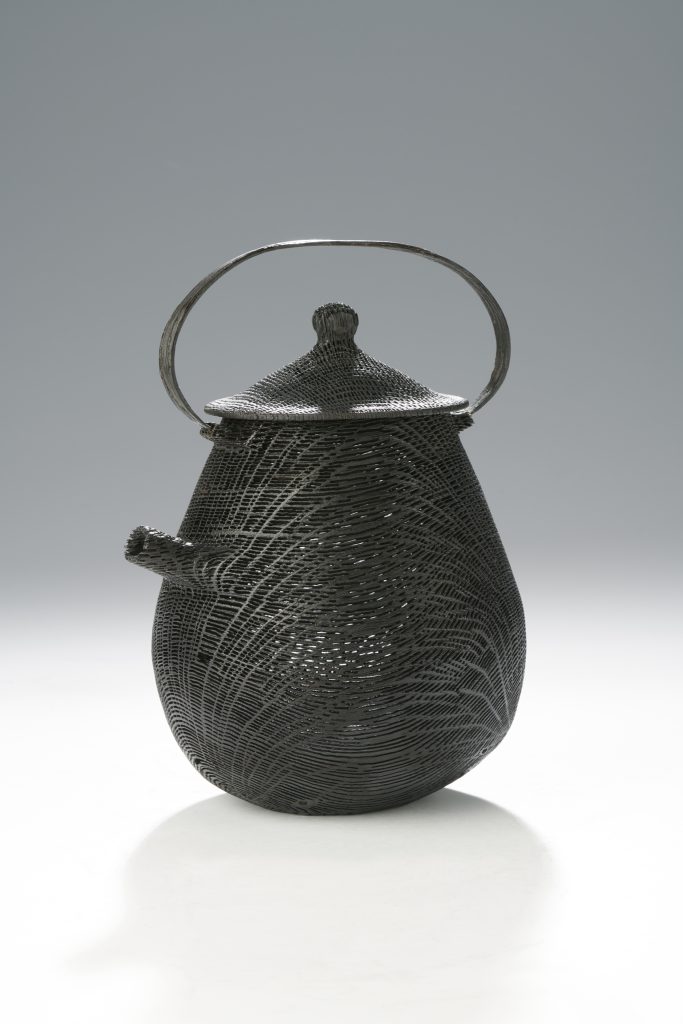
Coffee Pot
I applied to be part of the Collect Open at the Crafts Council’s craft exhibition at Somerset House in London 2023. My submission had to have a narrative to explain why it was important. So, I created a tea service entitled Tea and Imperial Tea Sympathy. In making a Victorian tea service I was referencing the importance of tea in Britain’s imperial past and the exploitation and abuse that came with it. This is never discussed when we teach history in UK schools and needs to be understood before we can move on as a diverse society in a post-Brexit global world. Tea exemplifies the reality of Britain’s Imperial past. It was the driver for the Opium Wars, it fuelled the desire for sugar and the slave trade, and it was the catalyst for the Boston Tea Party and American Independence. This subsequently led to the Industrial revolution and the Climate Crisis. This is a history we need to understand in UK. Using wood sustainably to create new products is something we need pursue.
Because of the lace technique, you have been able to develop lighting. Comment on the effect of light and shadows in your work.
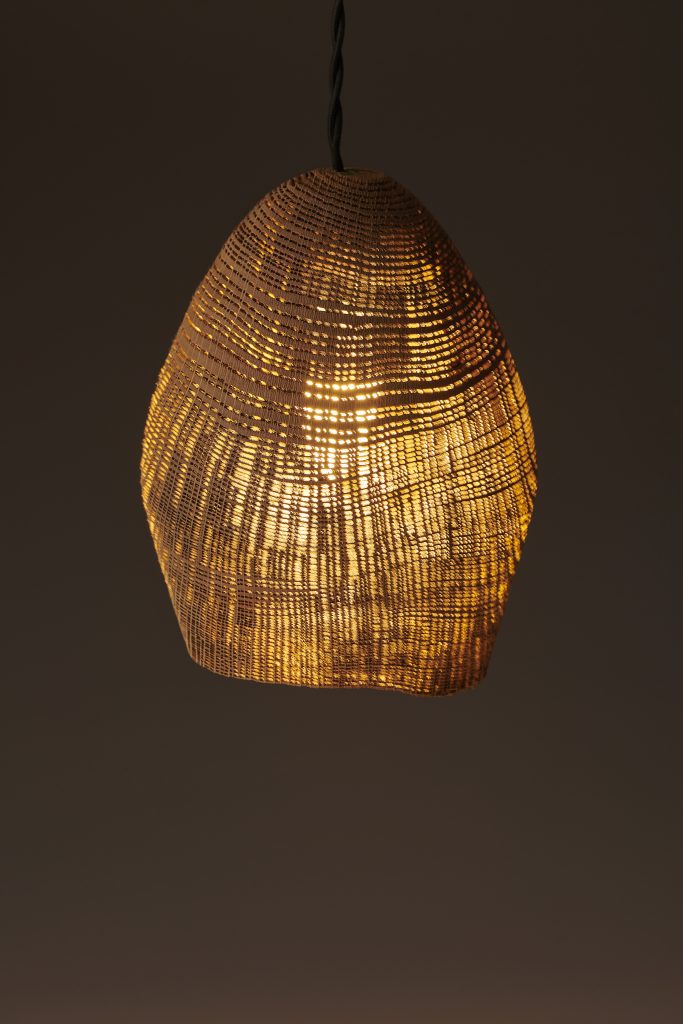 Light Shade 4
Light Shade 4
I particularly enjoy illuminating my pieces. Not only does this highlight the lace effect but it also makes the pieces glow and casts the lace pattern across the surfaces in the room.
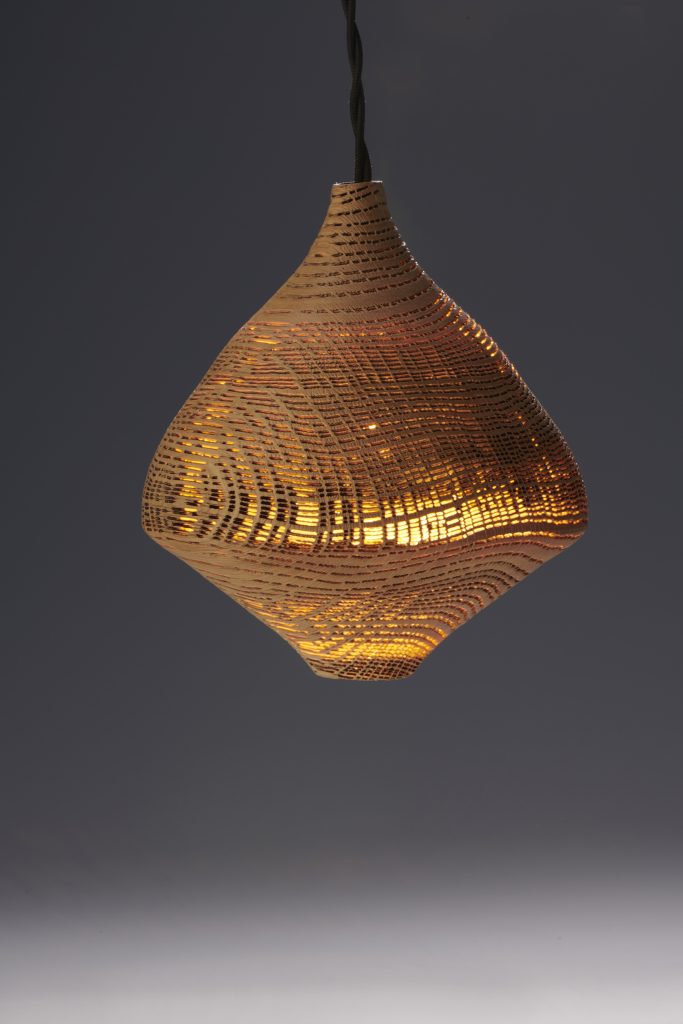
Light shade 1
Do you take commissions?
I do take commissions and particularly enjoy making pieces for people who have had a favourite tree fall. I have created vases, bowls and lamps for people in a variety of fallen woods. I also made a bowl in the form of a velodrome from the cycling track at the Manchester velodrome which hosted the Commonwealth Games and World Championships.
Comment how you have been able to transform a tree trunk into a leaf.
I love the leaf shape and especially the Autumn colours. They are an ideal shape where the wood I have acquired is damaged in a way they makes it unsuitable for making into a disc.
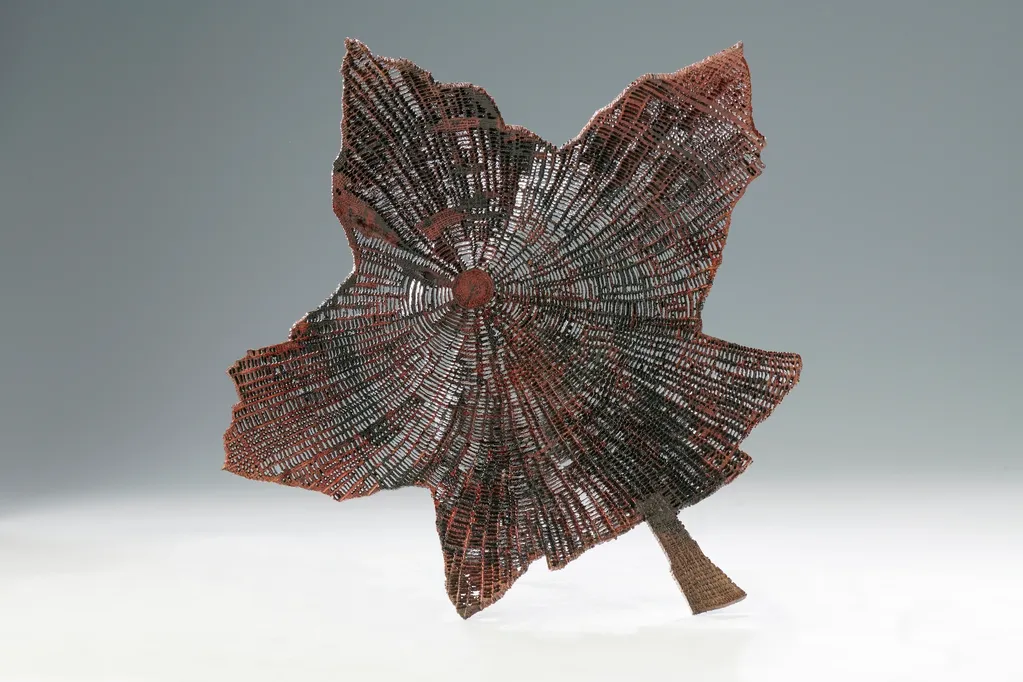
Leaf
Is your work around the world? Where are some of the places that you have sent them to?
My work has been sold to people in America, Italy, Thailand and Australia. In fact, Claire Delmar at Studio CD in Sydney has recently just acquired some of my work for her Interior Design business and Gallery.
Has there been a ‘special’ tree that has been removed or died that has led to a commission?
I was recently contacted by a lovely couple in Liverpool who had a 250 year oak tree they had taken down because their neighbours complained about the shade and leaves. I was able to make them some large vases and light fittings from the tree which remind them of a lost friend.
RPT what does this mean? Who can use it?
The RPT is the Register of Professional Turners. Founded in 1978, the Register of Professional Turners comprises skilled woodturning artists who have a professional approach and are craftspeople to trust. All members will have undergone a rigorous assessment before being accepted on to the roll of the Register.
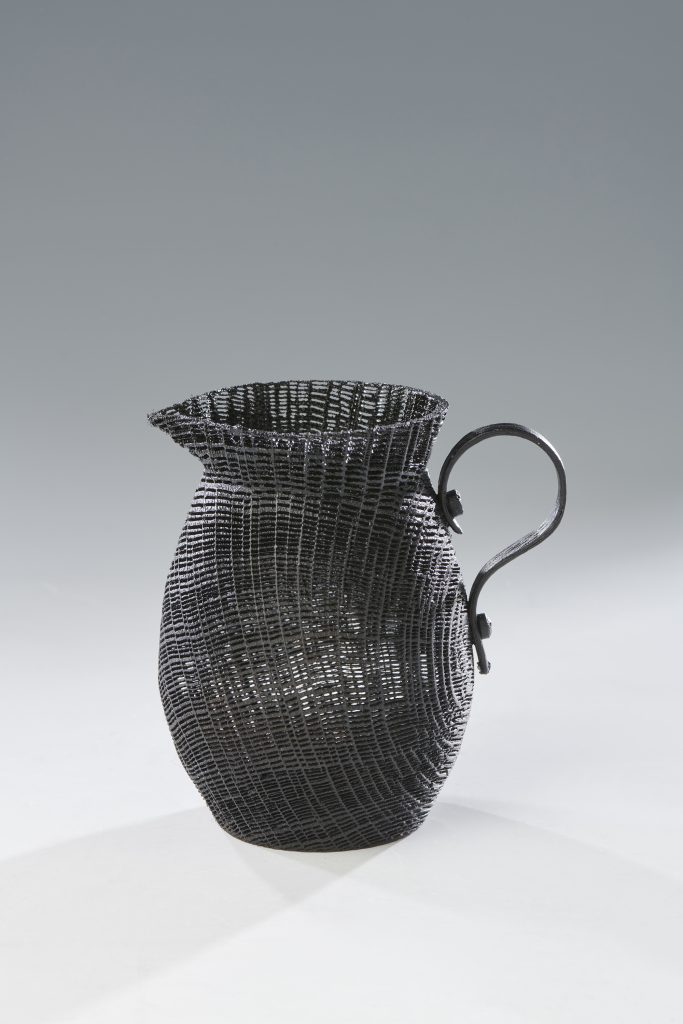 Milk Jug
Milk Jug
It is here where you will find a woodturner who will be able to carry out your request whether it be crafting gorgeous, stair-spindles, creating a piece of sumptuous art work, or teaching and demonstrating the craft of woodturning.
Discuss one tool that you use often and why?
The tool I use most often is my Hamlet 1/2inch fingernail grind bowl gouge. I can use this tool to rough turn a piece of wood and then do the fine work when finishing the piece and bring it down to 2mm thick.
How long have you been wood turning and how did you first get into it?
I have been woodturning for 7 years. I got into it because I needed some tapered pieces for a boat I was making. So I watched some YouTube videos and was mesmerised by both the process of shaping wood as if it was like clay and the patterns the wood revealed. It then rapidly became a hobby and a way of relaxing after a stressful day of teaching.
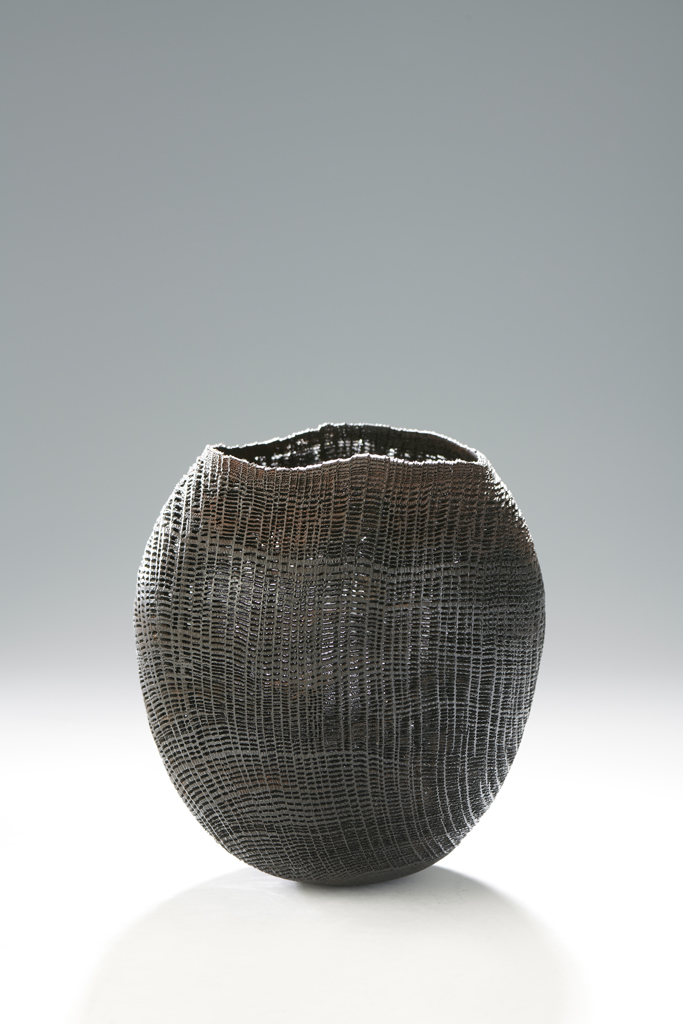 Ebonised hollow form
Ebonised hollow form
What training did you do?
None whatsoever. I have spent a lifetime chasing qualifications believing there was a correct way to do things. I watched numerous You Tube videos and realised there were many people doing different things in their own way. Whilst there are ways of using the tools I particularly enjoyed watching American Turners. They had a ‘make it happen’ approach. If they had an idea in mind, they then used their skills, the tools they had available and their own problem solving abilities to create an object. From there on I ‘hoovered’ up ideas and techniques from You Tube and the woodturning club I attend and then I enjoyed using a creativity and problem-solving skills I never realised I had to create the objects I liked.
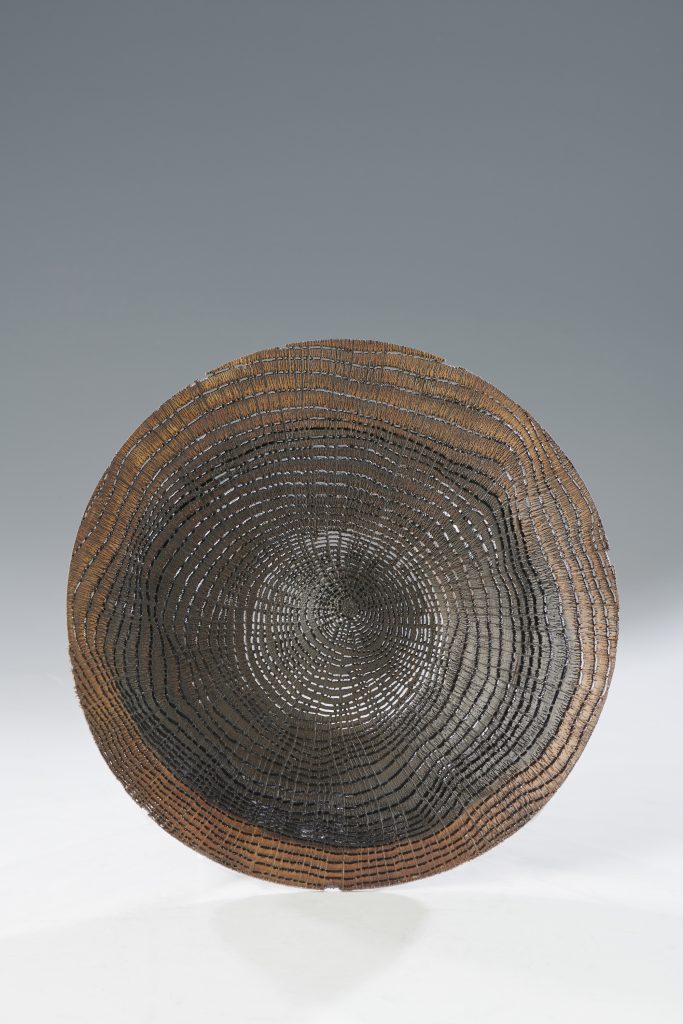
Disc
What recognition/accolades have you had for them? Any awards?
I have recently exhibited at the Craft Council's Collect Open. Collect is one of the world’s most influential fairs focusing on contemporary art and design made in the last five years by living artists. My coffee pot was selected as the fair Director’s choice. I also had a piece at the 2023 Royal Academy Summer Exhibition in London. I was also invited to exhibit at the Worshipful Company of Turners, ‘Master’s Exhibition’. Through the theme, ‘Coronation’, it showcased the finest elite woodturning in the UK. I exhibited as part of Future Heritage at Chelsea Harbourside in October. The world’s premier design centre is a champion of design talent and gives greater focus to the well-established Future Heritage, the forward-looking showcase of established and emerging makers curated by the influential design journalist and curator Corinne Julius. Corinne has been great mentor to me since I embarked on this journey.
Finally, my large natural edge bowl was shortlisted for the Wood awards in London.
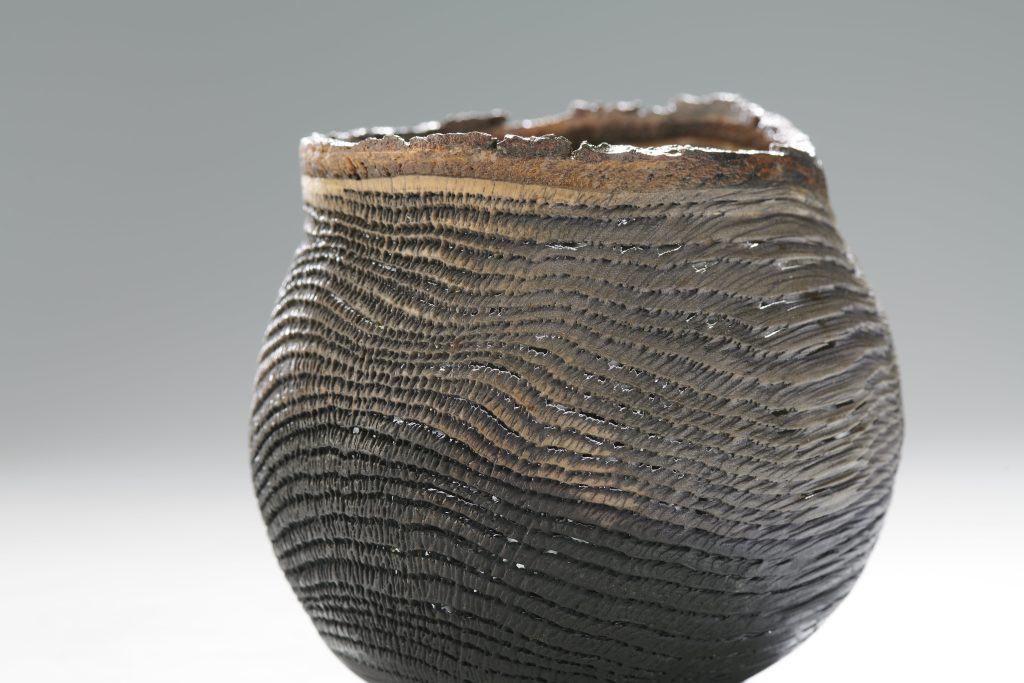 Ebonised natural edge bowl (2)
Ebonised natural edge bowl (2)
Where can your work be seen?
As well as being available online my work is available at the Flow Gallery in London.
Contact:
Greg Kent
Deborah Blakeley, Melbourne, Australia
Interview by Deborah Blakeley, December 2023

Brian Davidson
Can you explain the difference between printmaking and watercolourist prints?
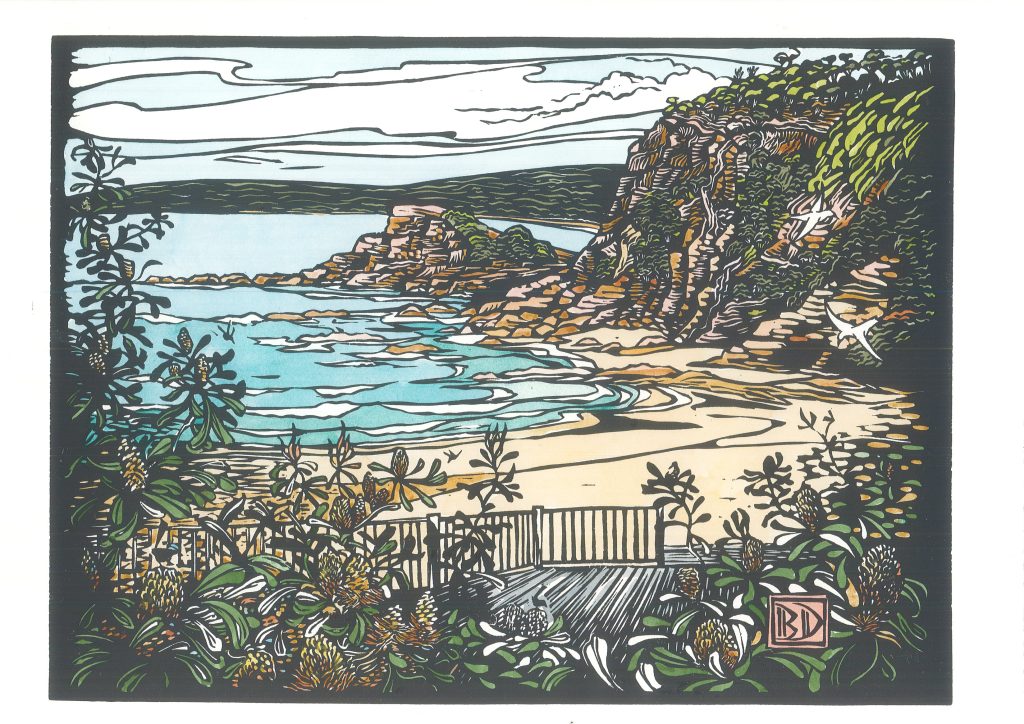
Pambula Beach
Unlike reduction Lino Printing where the lino (or other substrata) is successively cut and printed in layers using a different colour each impression and building up the image, a hand coloured Lino Print is printed once, usually using black ink.
In my work I like to focus on the linework of the print. I am ever conscious of the quality of the line as I am cutting. Of course, patterning can be done but I particularly like and rely on the strength of the line.
What is left behind is the area that will accept the ink and be the printed part, it is like working in reverse. One of the joys of printmaking is that the result of the labours are not seen until making that first impression so there is a surprise element involved.
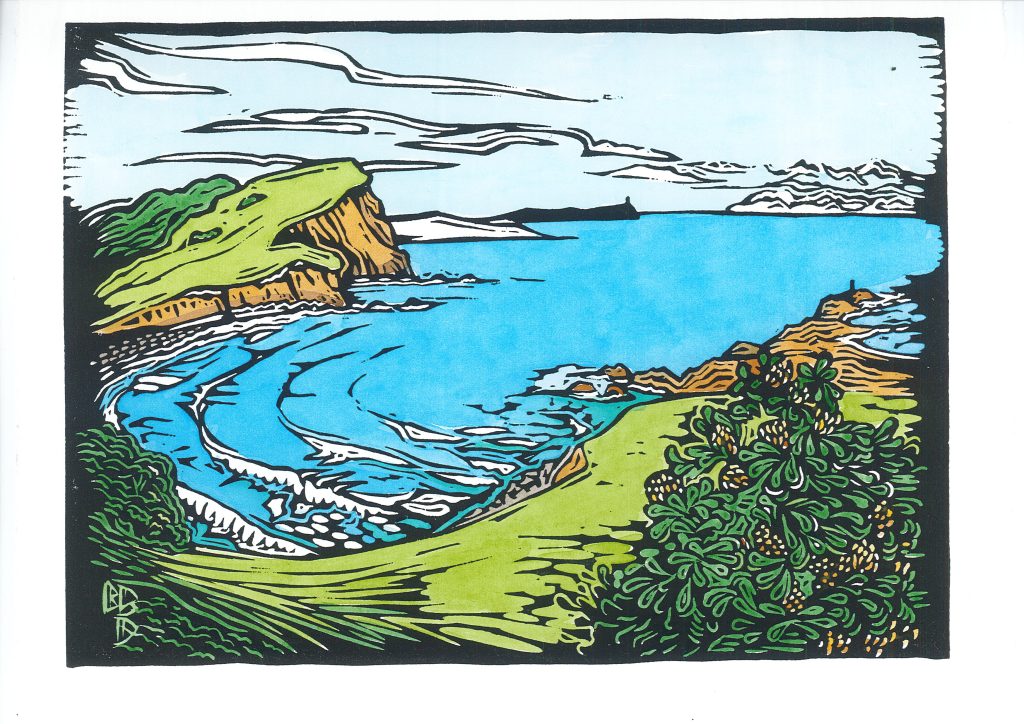
The Peg
Take us through the process of photography / sketching and hand colouring.
When working on outdoor scenery, for me usually coastal, I like to sketch in-situ and use photographs as reference later in the studio.
Sketching and thumbnails have the advantage of moving the elements of the composition, diminishing areas, highlighting others or even moving elements so they fit the balance of the design.
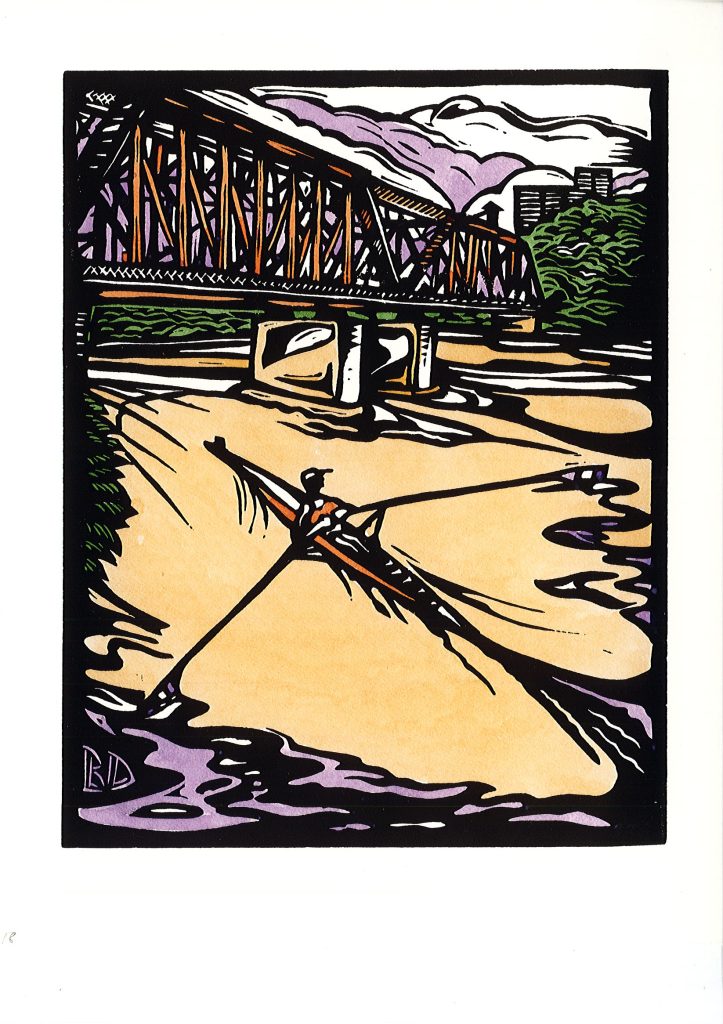
Grafton Sculler linocut
I see sketching as important as it brings an organic feel to the design which follows right through the entire process, even though the printmaking process is a mechanical one.
At times the image I am trying to create pops up with the least amount of effort almost complete with everything in place and colour solutions, but there is also occasions when the process is slow and meticulous with many iterations of the theme, sometimes taking months.
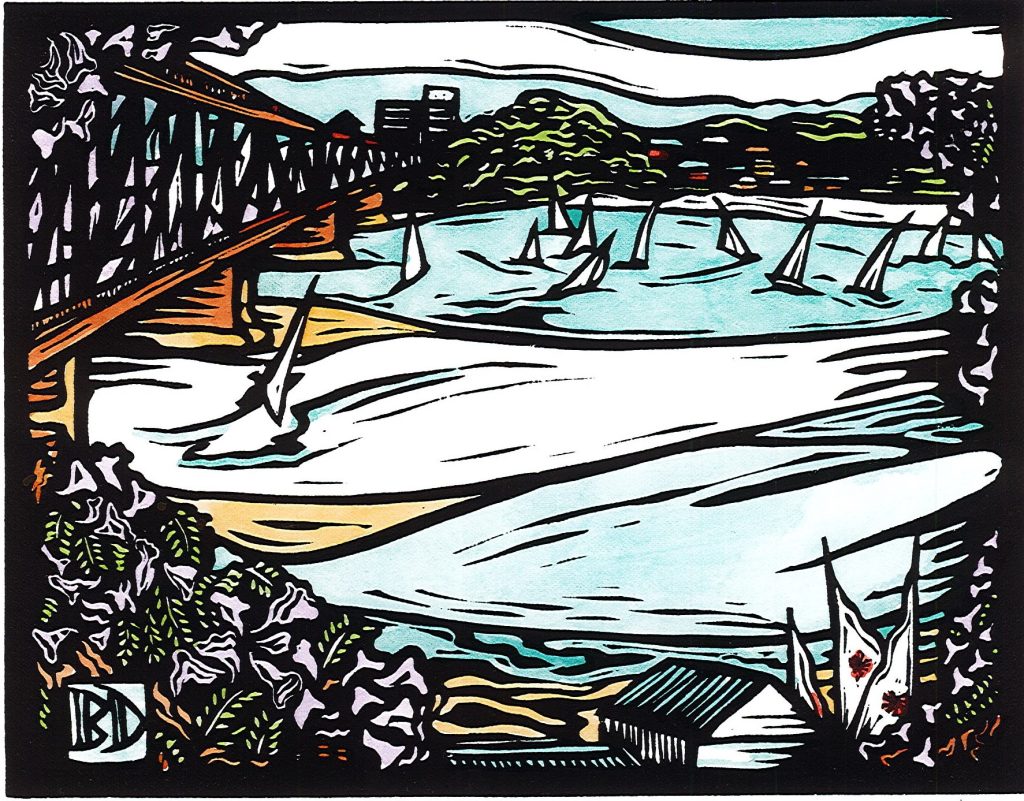 Sunday Sail
Sunday Sail
I begin by transferring the design to the lino (remembering to mirror the image; I produced a headland print once and forgot to do this, and even printed it before I saw my blunder!), now the cutting begins using regular lino/woodcutting tools I have also fashioned and modified tools and blades.
The cutting process, even for a simple design, takes me at least three days and often stretching up to 8 or 10 days, though not working continuously, after printing the oil based inks will take a few days to dry before any colour can be applied. Typically, I print onto 300gsm watercolour paper and colour using Artist quality watercolours.
It is usual that the first printing impression will reveal the need for further cutting and finessing and some colour experimentation before the edition is made, these first one or two prints are classed as Artist Proof prints, and though they substantially resemble the editioned prints they really are unique in themselves, some print collectors seek out A/P’s.
My editions typically run from 20 to 50. When the edition has been completed the block is destroyed, thus keeping the integrity of the ‘limited’ edition.
Are all, of your works of nature?
Nature certainly provides the main source for my work. In my training and education in illustration the focus was to observe and record, sometimes even at scientific level.
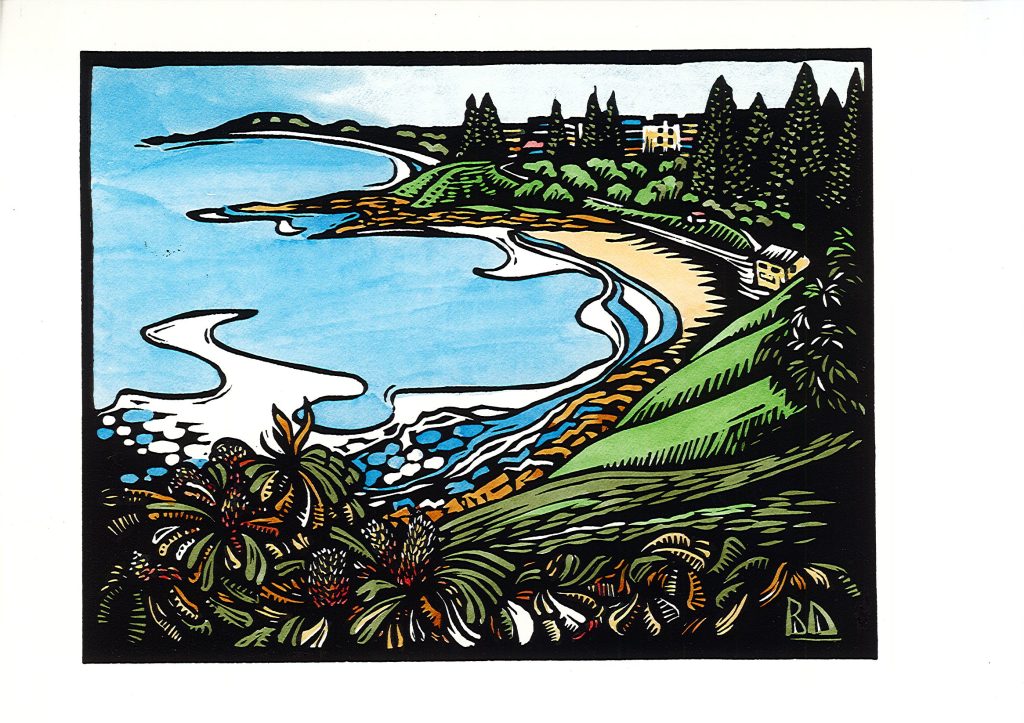 Yamba Main Beach linocut
Yamba Main Beach linocut
How has living in the North Coast of NSW, Australia influenced your work?
I have always lived on the coast so the littoral and coastal environment is an easy palette to draw material from.
The coastal zone is a contained area, stretching from the tidal mark to behind the sand dunes, this being not more than some tens of metres, but even so I never tire of the flora and fauna that survive and thrive in this weather lashed zone, the diversity is really amazing for quite a restricted and small area. It’s my go-to subject.
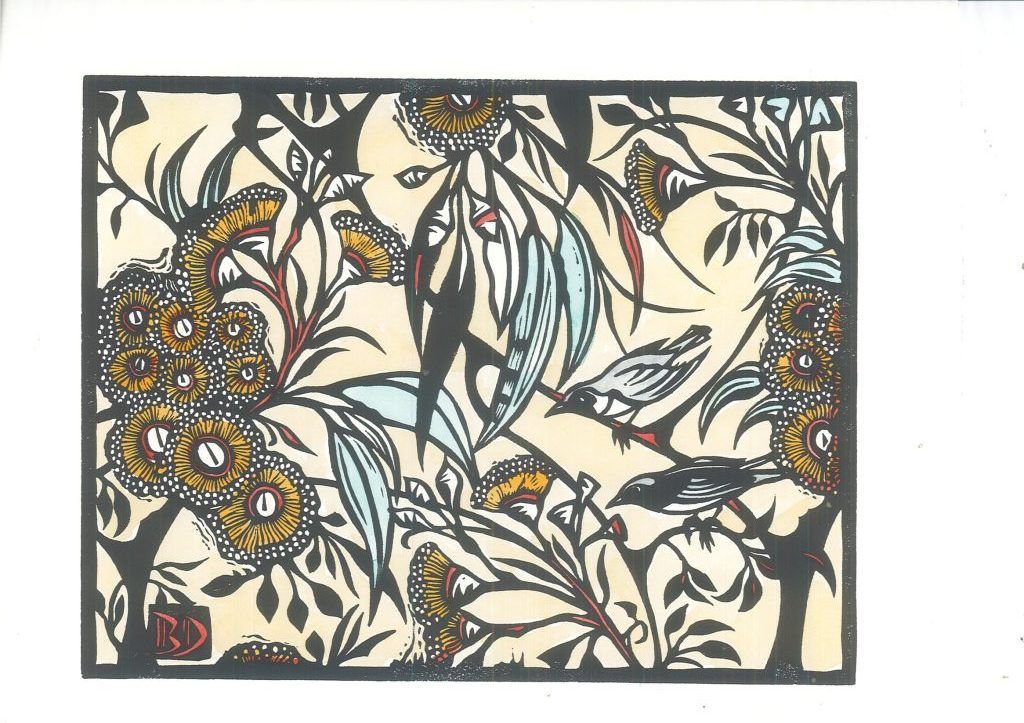
Thornbills
Do you have your own press, or do you work in a print studio?
One of the attractions of printmaking for me is that it is a process, and, in making a print you move through these processes in an ordered and organised way.
I have connections with printing studios and groups though I like to use them only for mundane tasks and social interaction with other artists. I find it much more productive working from my home studio, even using a hand press and finishing with a berrens, which can be quite physical, the result is infinitely less mistakes, less wastage and work gets produced.
Printmakers are big talkers!
Discuss the importance of the border of a good quality print.
Hand coloured Lino prints, due to their nature seem to be invariably framed by a border, the border substantiating the heavy graphic quality of the print.
Early on I began ascribing a non-descript 4mm border on my prints which is quite traditional, but I now also like to vary the width so it might become nothing more than a thin edging or add some design embellishment within the border.
Discuss Australian flowers you keep returning to and why?
Now, after some years creating Lino prints I find I don’t need to draw too much detail of any particular object but rather prefer to concentrate on the shape and elements in my mind’s eye.
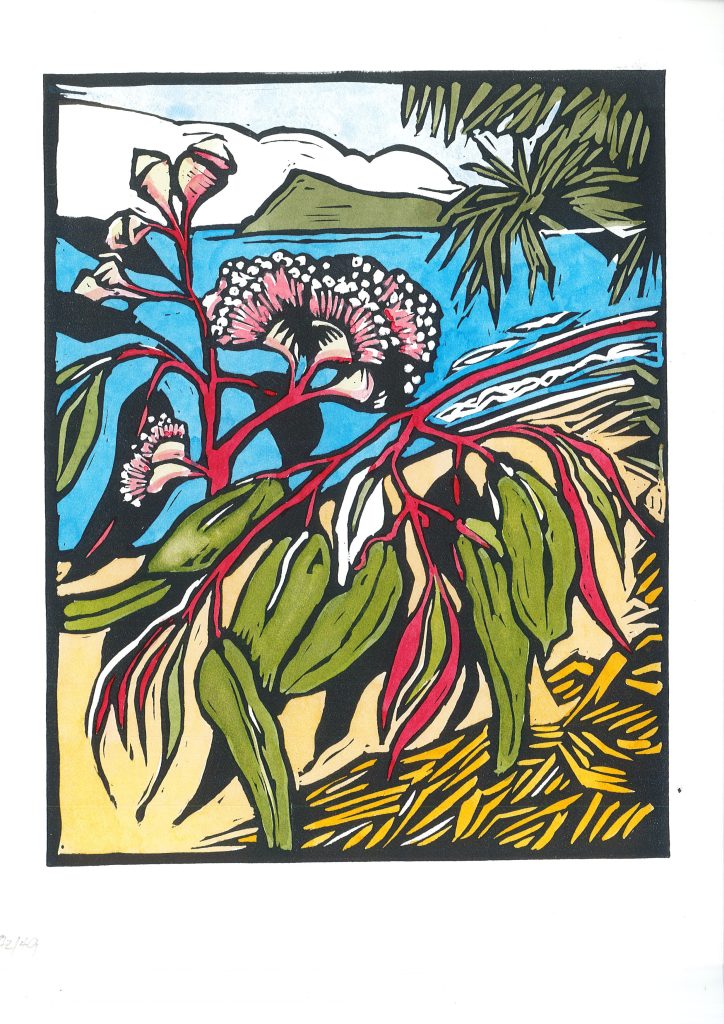 Lennox Eucalyptus
Lennox Eucalyptus
When cutting, say a banksia, I find I can work intuitively with my focus on the design aspect of that flower. I work quite quickly when doing this, not thinking too much but allowing the tools to take over the task. Submersing oneself in the subject I suppose.
Flowers are a great challenge to represent, it’s easy to get them wrong. I would love to do an extended tour making Lino prints of Australian wildflowers.
I pursue underwater subjects too but they are much harder to problem solve.
Do you have any endangered birds or plants that are on the endangered list in your work?
I enjoy taking up causes to do with the environment and conservation.
One such program is called ‘The Overwintering Project’, which can be found on the Net. This specifically relates to printmakers and printmaking in all its forms and investigates, documents and illustrates the plight of migratory birds from the northern hemisphere travelling so many thousands of kilometres to Australia’s wetlands where they stay through the northern winter. - 'After all, we have the spare parts and we've got a voice'
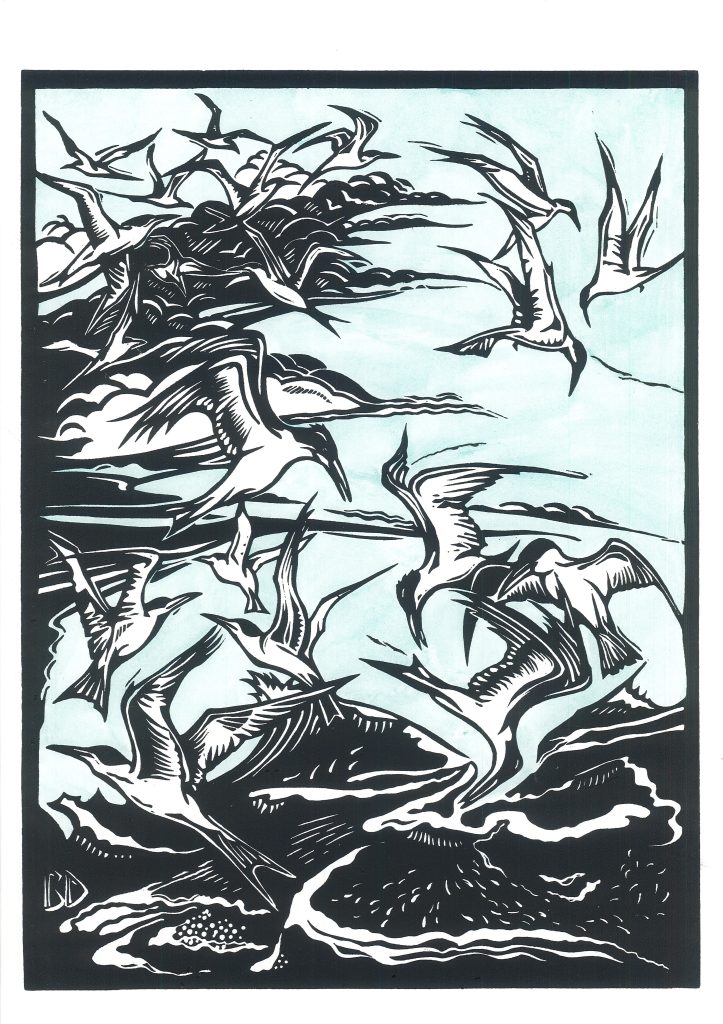 Terns
Terns
I think, as an artist, we are in a prime position to take an altruistic approach to causes like this and add another shoulder to the wheel, after we have the spare parts and we’ve got the voice.
Discuss the almost pattern in some of your work?
This is a revealing question on my approach to making my art.
On occasions someone, when viewing my work will blurt out “Margaret Preston!”, which I sort-of-get but I have never paid her work much attention at all. BUT had they said “William Morris” then they would have covered many bases.
I am spurred on by the repetition in nature, the seeming chaos of the design in nature, the accidentalness in nature which when all put together represent the ‘order’ in nature.
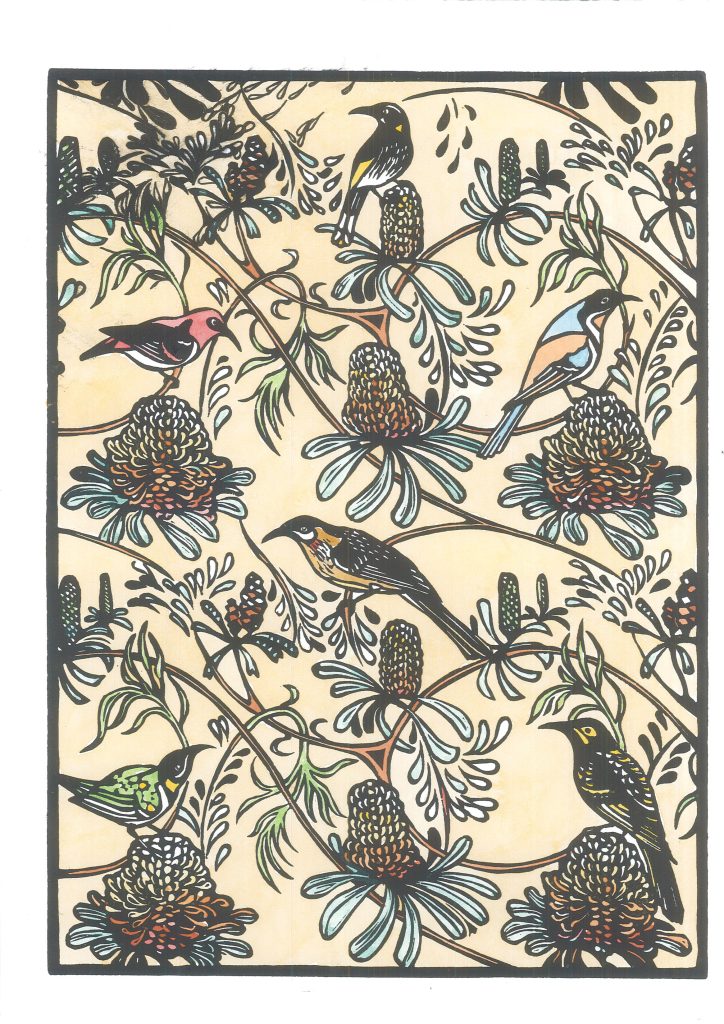 Honeyeaters
Honeyeaters
I am glad Deborah you note the almost pattern in some work. When making a design which features a repeating design, I make a much bigger drawing which will include a complete repeating design, but, when I make the final design however, I will delete parts of the design, add some elements in and in doing so disguising the repeat.
Did that almost answer the question?
I believe in the functionality of Art, e.g. I love the Silo projects – would love to do one!
I have adapted some of my repeat designs for printing onto lengths of fabric too for personal use.
Are all your prints framed, and unframed for sale?
I do sell prints unframed but galleries prefer framed work.
I have now standardised my artwork into 3 sizes (traditional Japanese prints were produced in standard sizes because of the blocks used for carving). For a printmaker this makes sense when producing a number of same sized prints needing the same sized frame.
So now, I have a number of blank frames with matts & glass etc made up and keep in stock. When needed I can assemble on demand.
Comment on your Wooli River work?
The Wooli print, about A4 size, is the outcome of a small community, on the north coast of NSW, taking the conservation of their local habitat into their own hands by holding an Art Exhibition each year. The exhibition acts as a fundraiser to restore dunes of the beach and Wooli River, a lot of work by a small group of individuals.
I am very glad you have asked me to discuss this print Deborah as it is also a good example of how I settle on the content of my work.
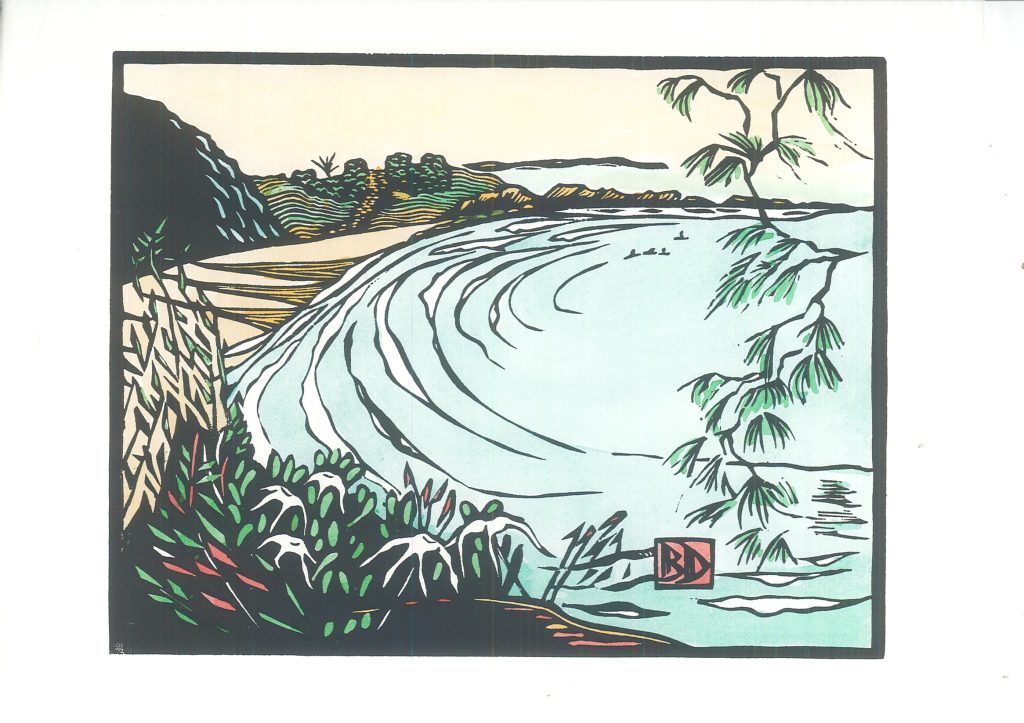 Minni Water
Minni Water
No matter how alluring and ready made a scene might appear, I find myself rejecting first impressions and obvious standout elements for a much longer investigation, opting for walking, exploring, leaving the locality and then returning, sometimes time and time again.
Eventually something, a small area, a view from a particular point, the colours at a particular moment will throw a new perspective on the scene and define an essence of the locality, a timeless instant (if that exists) which is older and deeper than the big picture crowding your view.
This is a slow process and cannot be rushed
I find if I get these small details in focus then the big stuff falls over itself just trying to get into the picture!
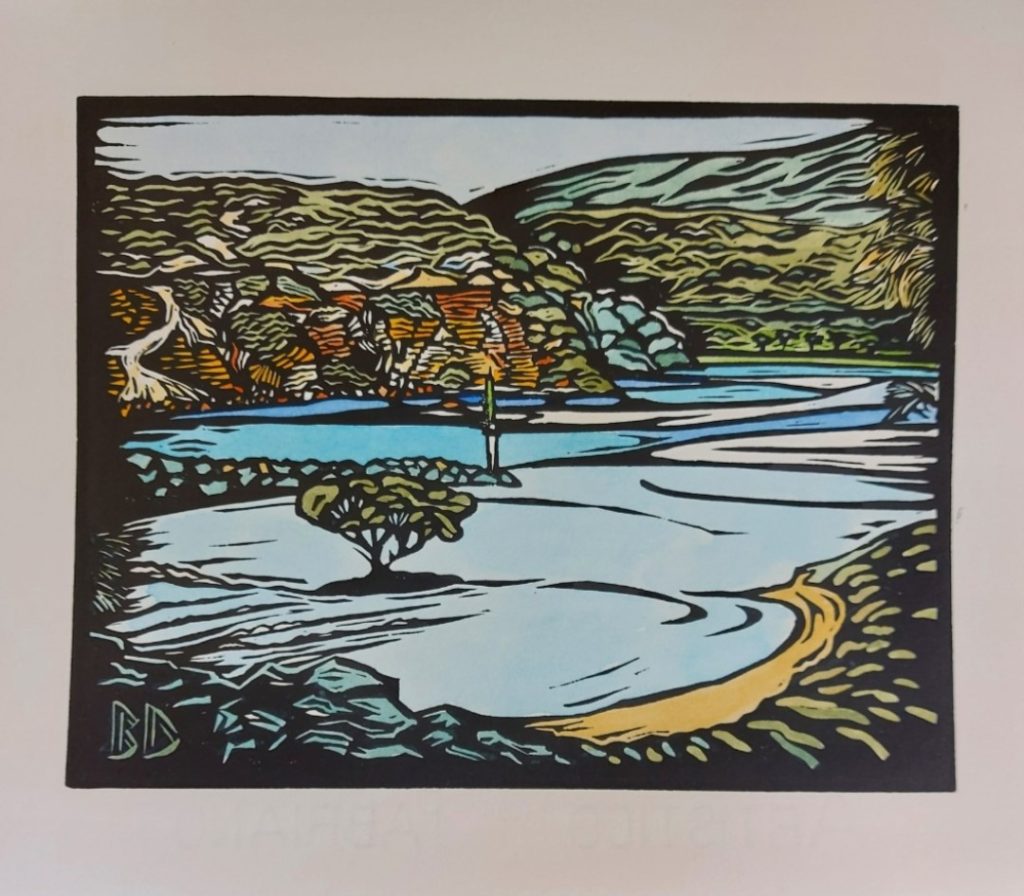
Wooli Wooli
The focus of the Wooli Wooli print can be found in the quiet and secreted corner of apple green verge on the opposite side of the river where a spur of foliage reaches down to the waters edge. More to the fore and more spectacular is the high escarpment with the wild and noisy coloured sands which usually demand all the attention but I get the feeling that this quiet and inaccessible corner area was the place of ancient habitation and murmurings.
Contact:
Brian Davidson
New South Wales, Australia
brianbingdavidson@gmail.com
Insta: Brian Davidson Art
Deborah Blakeley, Melbourne, Australia
Interview by Deborah Blakeley, November 2023
Kathryn Ryan
Recently you took a year off painting. A year to relook and reseeing and refocus.
What led you to do this?
After 20+ years of holding solo exhibitions most years. I just really felt I needed a break from that, and I have always had a passion for charcoal drawing, yet not much opportunity to exhibit or do them. So stubbornly, I put down the brushes and dedicated a whole year to charcoal drawing with the series Rapture.
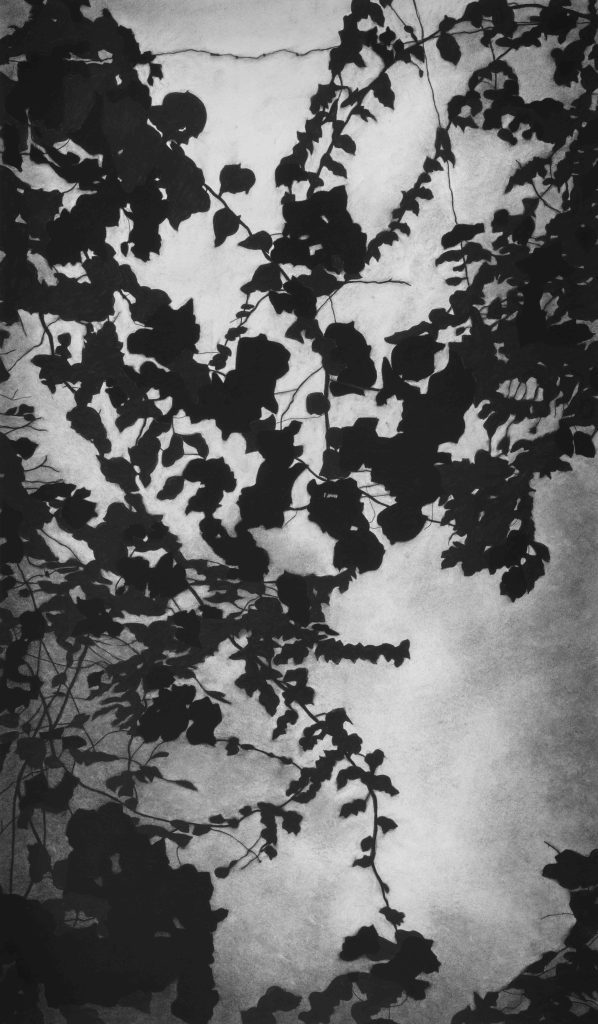
Bastikiya I charcoal 107 x 63cm Framed 128 x 83cm
How did your work change after this break?
Focusing on the visual language of drawing, being completely immersed in the relationships of tone, mark making, compositional elements and pushing the drawing beyond any I had done previously, was such an all-encompassing process. It re-engaged my love of working tonally and contrasting mark making and different treatments in the work.
It led the way for the development of my latest series of oil paintings, STILL POINT – a far more reductive and minimal series of paintings, slowing down, offering a quiet, still, space and worked more tonally.
How did you personally change?
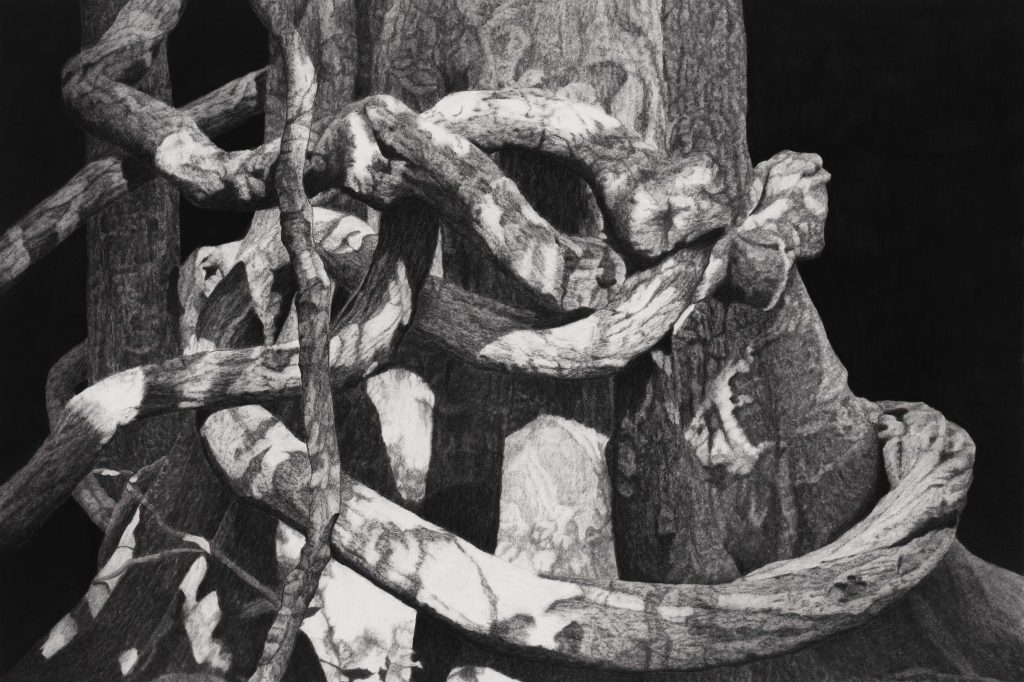
Rapture II charcoal 72 x107cm Framed 93x127cm
Slowing down, taking more time, and being dedicated to my practice. Observing and noticing the beauty around me. Enjoying communicating through my visual language.
With the charcoals I often worked 10 hours a day for 2-3 weeks on the one large drawing, giving it all the time, it needed to finish and only focusing on that one drawing – nothing else was worked on.
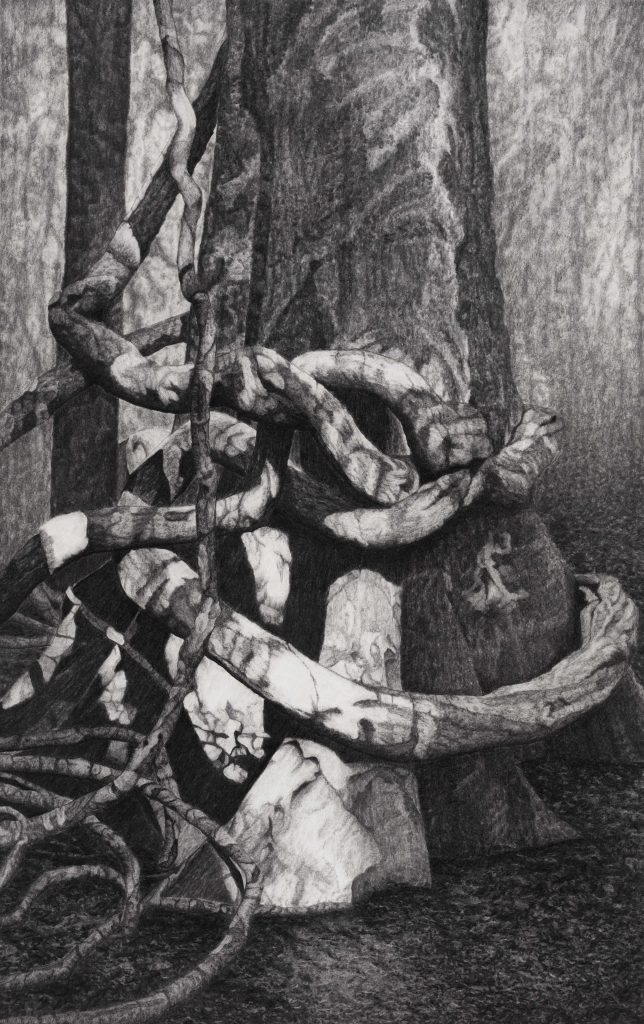
Embrace charcoal 107x67cm framed 128 x 87cm
With STILL POINT – I gave the paintings a lot more time, sometimes working on paintings over a 6-month period and often focusing on one painting only for a week at a time, then putting it aside to dry before it had its next layers…
What medium do you use?
Oil painting – oil on linen & charcoal drawing- willow and compressed charcoal.
Discuss the intricate details of your work.
In the past few years, I have been working with a lot more detail, which is contrasted juxtaposed with vast areas of space and glazing work.
I love getting lost in the detail and have been working with tiny 10/0 brushes painting one dot at time, slowly building layers, building tone, light, and depth. It is a very calming way of working, very meditative and you are aware of each mark made by your hand. Intuitively following marks and totally absorbed in the process.
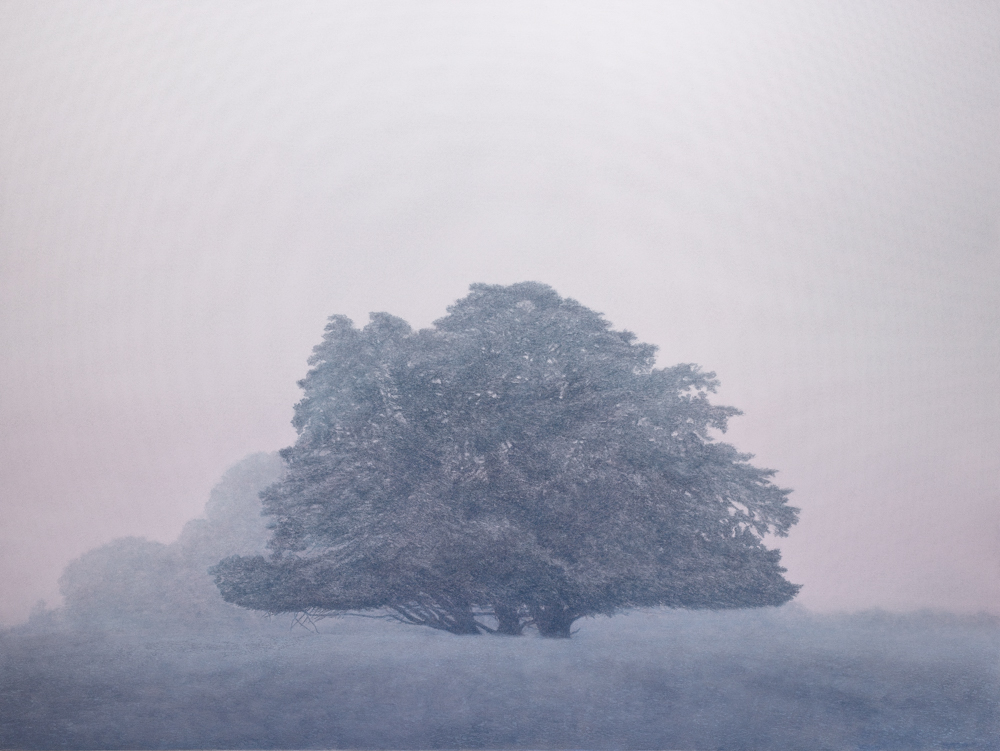
Drift, oil on linen 137 x 183cm 2023
Comment on the hours it takes to produce and work and how do you allocate your time.
My oil paintings take approx. 3-4 months each to do. I generally have 4 or 5 canvases on the go at one time and divide my time with these depending on drying time and whether I am working in details for many days or frantic glazing session.
My studio days are at least 5 days per week and often long days and into the evenings as well, although the evenings are often admin or research time and mornings are often social media, emails, website etc.
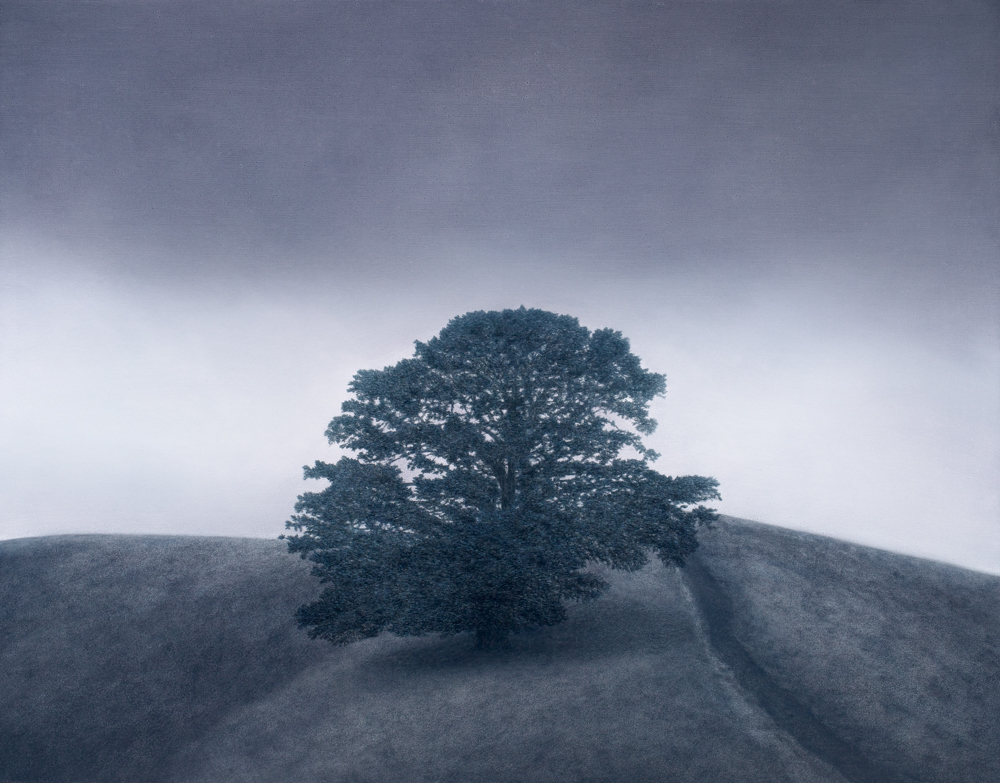
Ascending, oil on linen 107 x 137cm 2023
How does your environment influence your work?
The landscape I grew up with, isolated on a dairy farm, has for many years informed my work. It is a dramatic windswept farming landscape with battered cypress trees punctuating the views like sculptural elements. The skies are vast, the feeling of space and light is all around.
This has informed how I see the world, my sensitivity and awareness to it. Constantly aware of the seasons, times of day and changing weather- the more wintery climate with its moods and atmospheres has translated into my paintings of evocative landscapes.
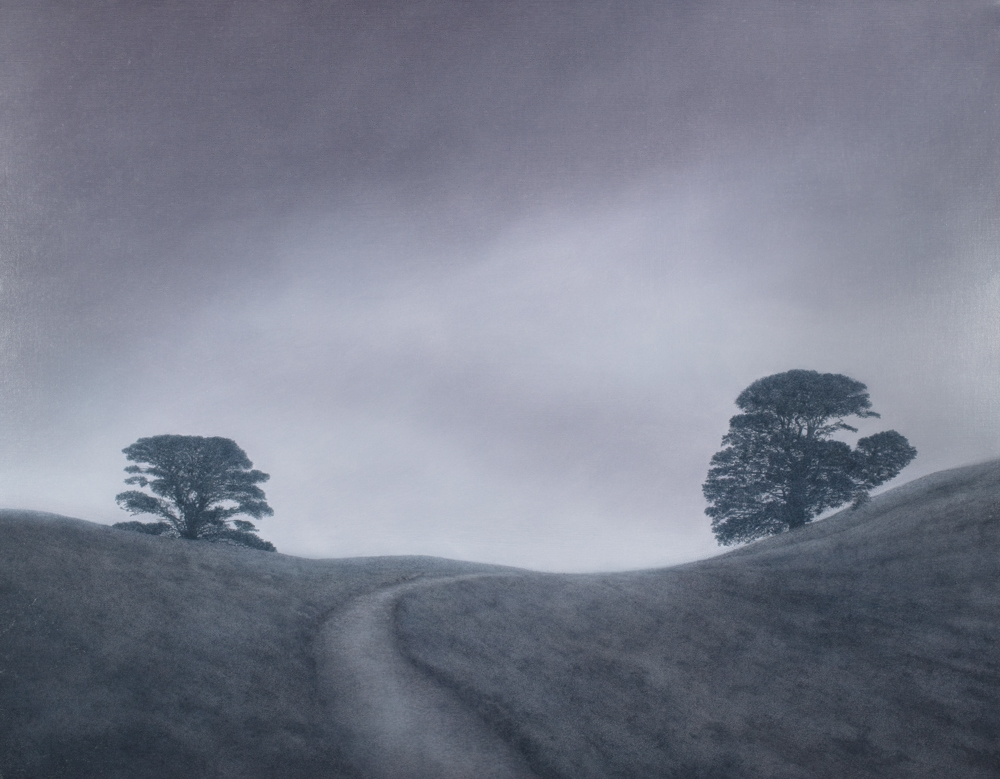
Pathway, oil on linen 107x 137cm 2023
Comment on the calmness of your work?
My work has very often been concerned with offering a calm and contemplative space, a means of going beyond, a depth of feeling and insight or emotional response.
With my latest series STILL POINT, this took on an all-encompassing feel for the show.
Having felt the stress and business of our lives increasing and the noise from media and pace of life it made me want to seek that slowing down, finding a calm and stillness even more. Therefore, my work is becoming quieter and more reductive, reducing things to their essential, with their power felt though their quiet and subtle moments. Yearning and searching for those calm moments found mostly through a closeness to the natural world and in the private retreat of my studio.
How calming is this for you personally?
It is essential. I need to block out all the unnecessary noise and chaos and create a calmer environment for myself this is how I work, make art and stay in tune with myself and nature.
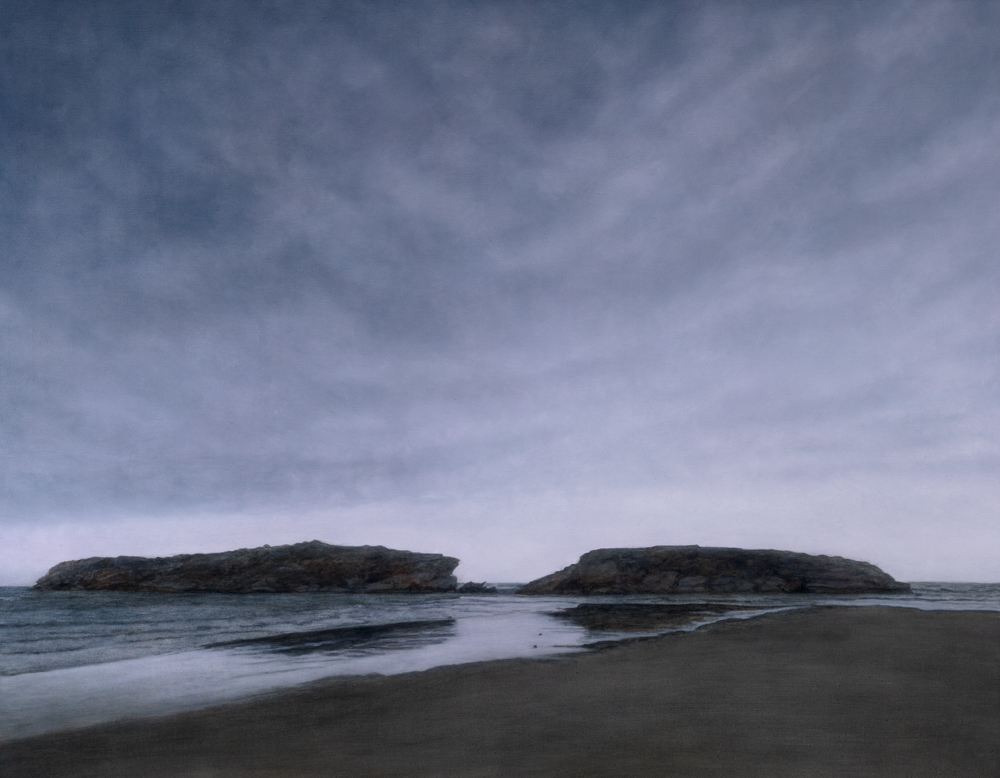
Below Southern Skies, oil on linen 107 x 137cm 2023
Discuss the importance of having your work in local and regional galleries.
I love developing a series of works and ideally to show them as one, to convey that whole story. To see the works outside of a cramped studio and to be hanging on the beautiful white walls of a gallery space is such a thrill, the works can then really come alive and be seen properly.
To see your work exhibited and collected by Regional Galleries feels like such a reward for years of hard work, their vote of confidence and support means a lot. That they are placing your artwork alongside your peers or adding your work to their historical collections, affirms their belief in what you are doing and gives you a personal boost in your solitary life in the studio!
Take on work and explain the importance of that work in your own personal growth.
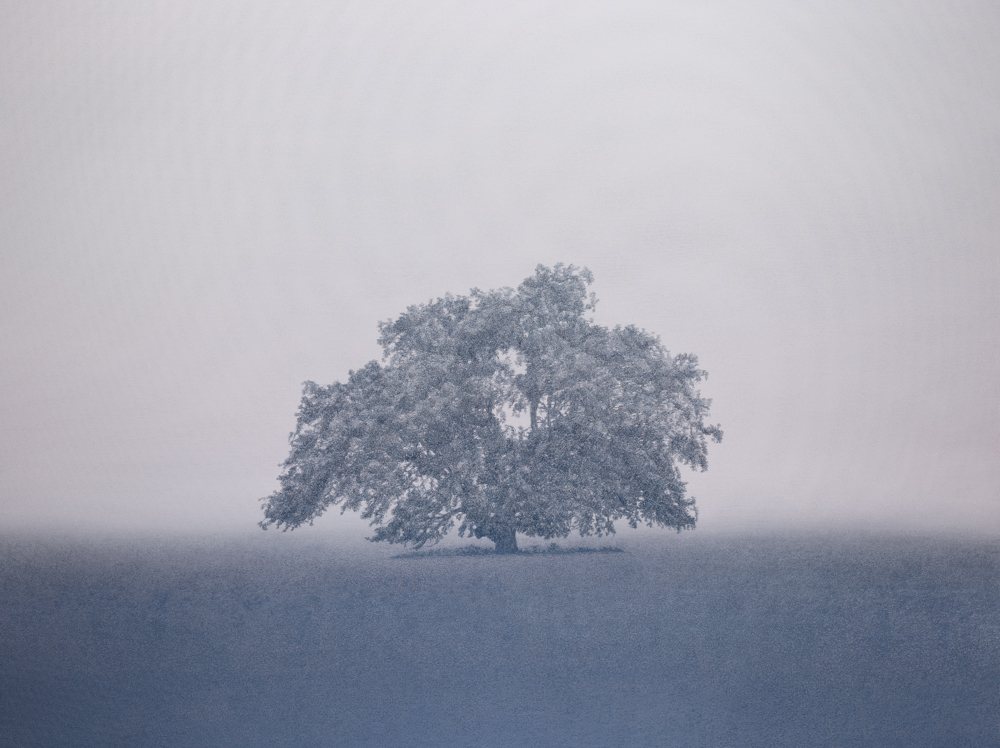
Still Point, oil on linen 137 x 183cm 2023
For me this painting achieved a new level of sophistication, in its desire to reduce things to their most essential, and yet feel a powerful sense in its quietness, stillness and reductive, almost minimal sense of painting. It is subtle and sensuous, inviting close inspection through its intricate detail and simultaneously offering an endless space of softened light through layers of glassy, smooth, transparent glazes to go beyond the horizon.
To reach this level of quiet power through the most subtle of means has been a life’s journey of following the concerns in my work and having a deep understanding of what I am trying to convey. Self-knowledge, translating my observing and responding of the natural world into my visual language, it all comes together… and taking more time and care.
Why do you love being an artist?
This is how I see and understand the world around me and communicate what moves me, what resonates for me. Creating my visual language, to delve deeper, to understand, investigate & communicate, to find beauty to be elevated to the sublime or spiritual feeling has been crucial to me, I love art with a passion.
Discuss the harmony and balance in your art?
My main concerns lie with the harmony & balance of co-existing opposites: The fragilities & strengths/ the macro- micro/ The beauty, cycles of decay & growth, the transient and the solid, the list goes on …
The balance of opposing forces- the delicate & fleeting and the strong and grounded-has always been a concern in my work. So, in the work you often see a juxtaposition of strength and fragility, the intimate and distant, the fleeting and solid played out through the treatment of light and shadow, both bold and subtle, precise, and ambiguous.
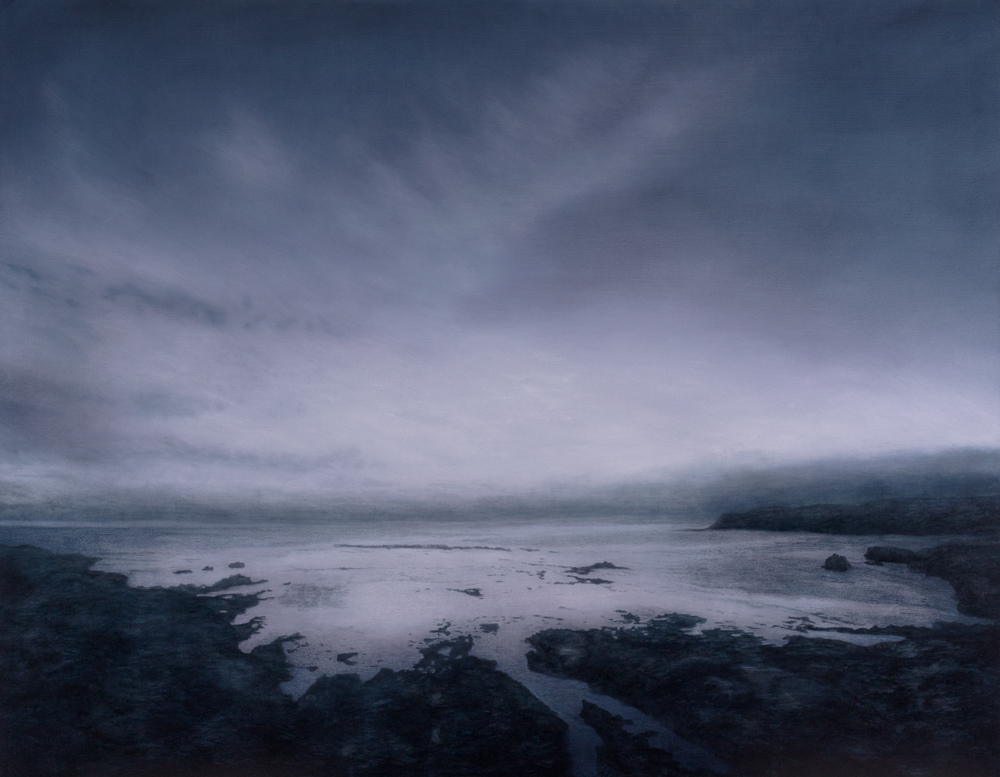
Viewpoint, oil on linen, 107 x 137cm 2023
I think the combination of delicate work and vast space & light – they’re in a sense inviting you in, there’s an intimacy and at the same time giving you space.
In the making of the works, I am completely absorbed in the process, the relationships of tone, lights, darks, subtle areas, strong areas, detailed areas, quieter areas and how your eye takes in the whole composition. It is a matter of combining, weaving all these elements in their own complex web to create an overall balance and harmony. Your eye can rest and take in the whole painting and presence of the work in a restful manner. You can search the intimate details, be lost in an endless space, and simultaneously take in those opposing/ differing areas at once.
Contact:
Kathryn Ryan
Victoria, Australia
kathrynryanartist@gmail.com
Deborah Blakeley, Melbourne, Australia
Interview by Deborah Blakeley, November 2023
Veronica Hodges
You are currently living and working in Denmark, how did this come about?
I am born a raised in Denmark. My father was American and my mother Norwegian. They meet in Copenhagen when my father was on a school trip with fellow students from the Royal Academy of fine arts in Rome. Copenhagen was very “hot” back then in the 1970 ties because of the new Christiania. The free town in the middle of Copenhagen where hippies and others free thinkers gathered to break through with a new perception of live.
Currently you have a large installation at Ordrupgaad, discuss this …
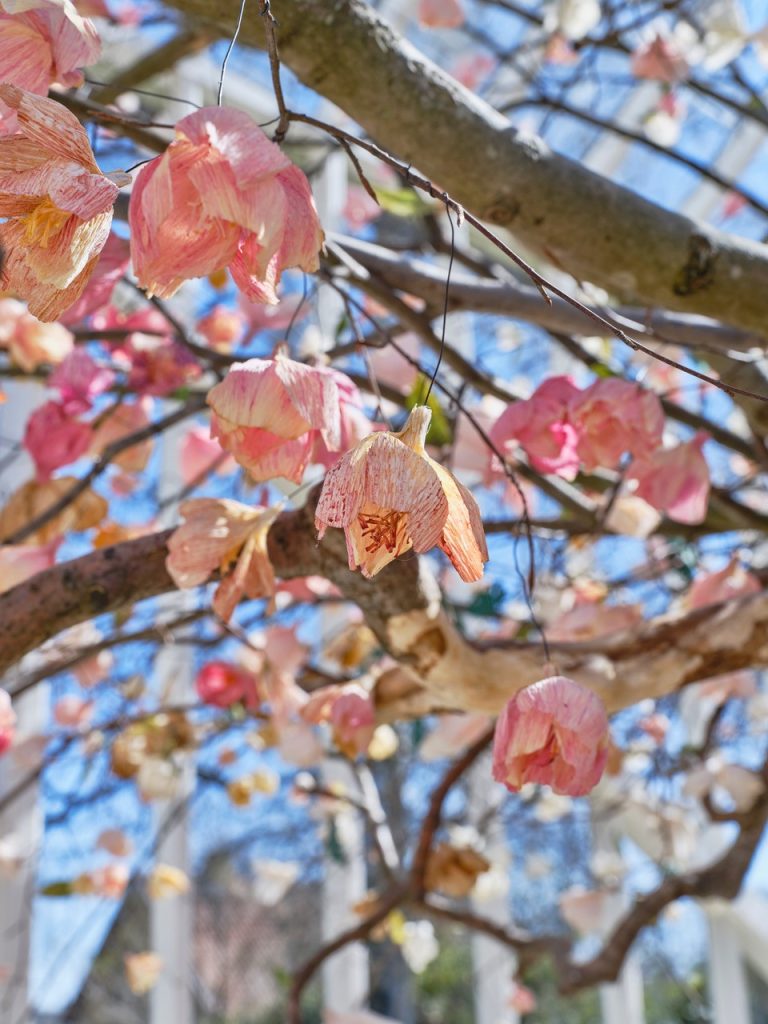
Yes, I have a large installation at Ordrupgaard museum, in their garden in the newly renovated greenhouse. The greenhouse exhibition is dedicated to an artist to show an art piece for little less than one year at the time.
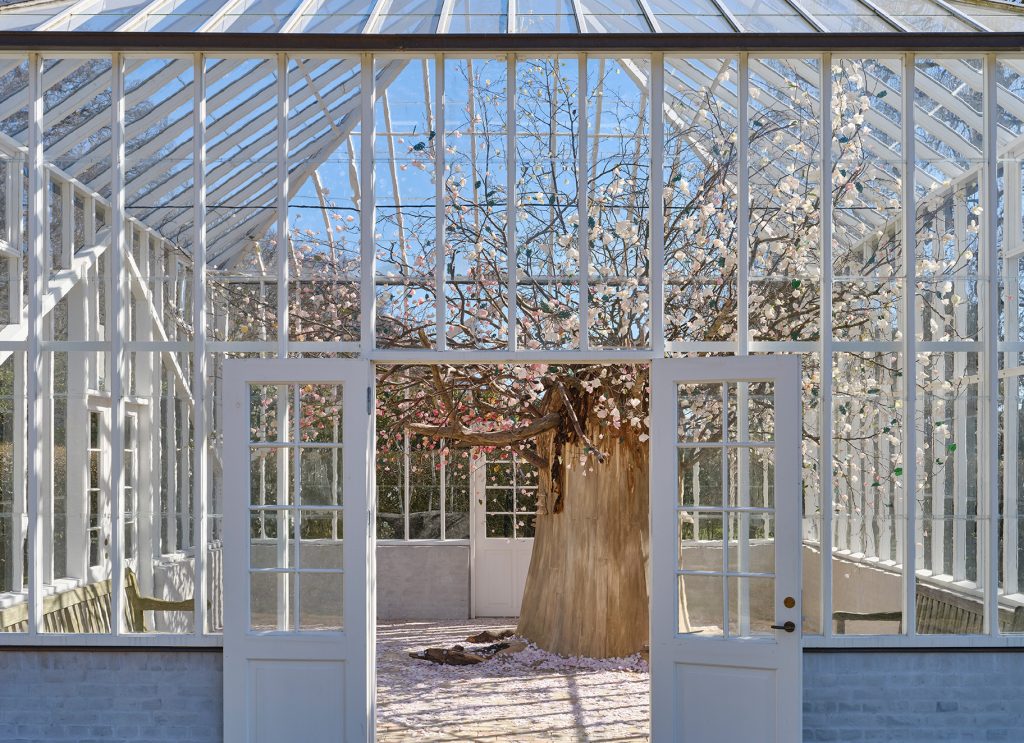
Where is Ordrupgaad the gallery and a little about it?
Ordrupgaard is a museum placed outside of the capital. A rich tradesman who donated his estate and art collection to the state. The museum has contemporary art and their permanent collection.
Ordrupgaard’s greenhouse dates from 1921 has regained its original position in the eastern part of the parkland following a sweeping renovation financed by the foundation Villum Fonden. It now re-emerges as a hothouse for contemporary art with a three-year exhibition program, where a new artist will create a site-specific work every year directing focus at climate and sustainability issues.
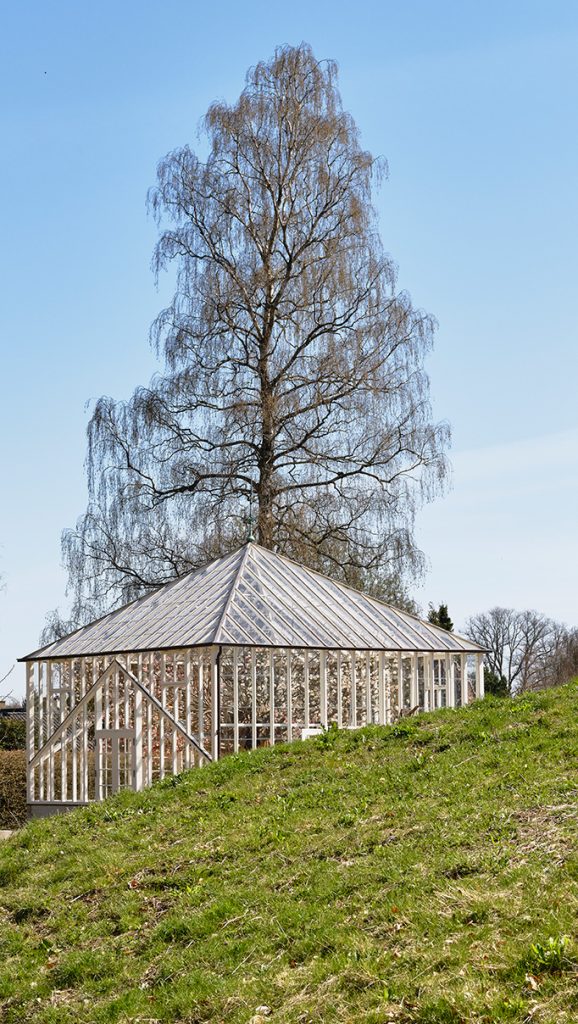
About your tree, and the making of it?
I have for a long time wanted to do a tree with roots and the tree having the feeling of a heavy weight. I had not done a tree before therefore this exhibition, and it became quite a challenge how to construct a tree on a solid ground.
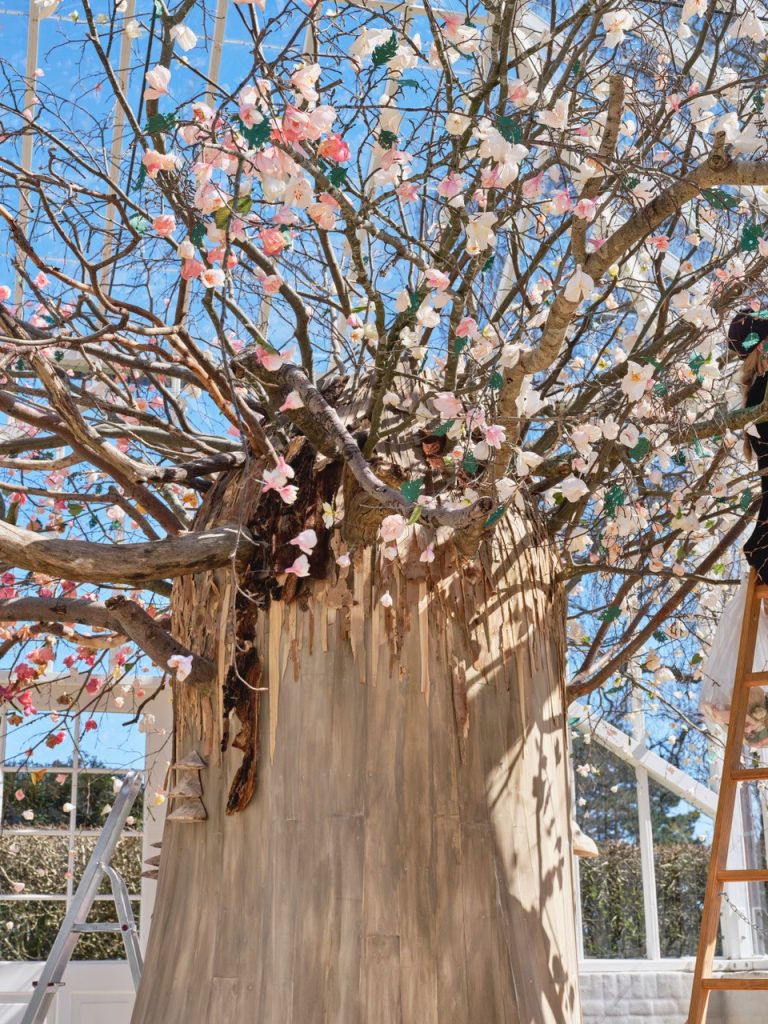
I started out with doing a metal mesh so the large branches could be gathered inside the middle. Then when that was stable, I began to build the outside of the tree and connect the branches with the tree trunk.
I had to make the transition look natural. Giving the whole tree a surface that looks natural. Some of the branches are very dried up and almost crumbling. They were used in one part of the tree as new fresh branches were used on the other side. Then came all the flowers.
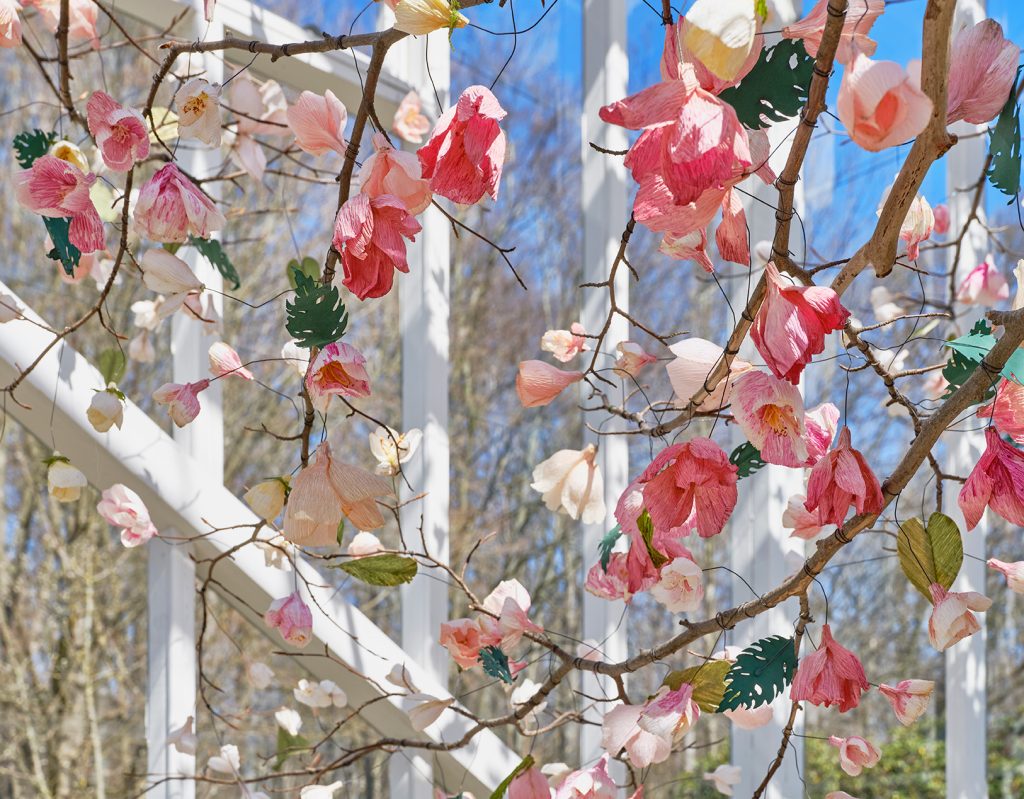
My intension was to have part of the tree in full blossom and other part of the tree witting. In way several seasons going on at the same time. On the floor there was leaves that have fallen and one can walk through them pick up the leaves and throw them in the air.
How did it came to be at Ordrupgaad? And in a Greenhouse set, in the garden of Ordrupgaad.
I was asked to make an exhibition in their greenhouse. As the first artist. Opening after several years of renovation.
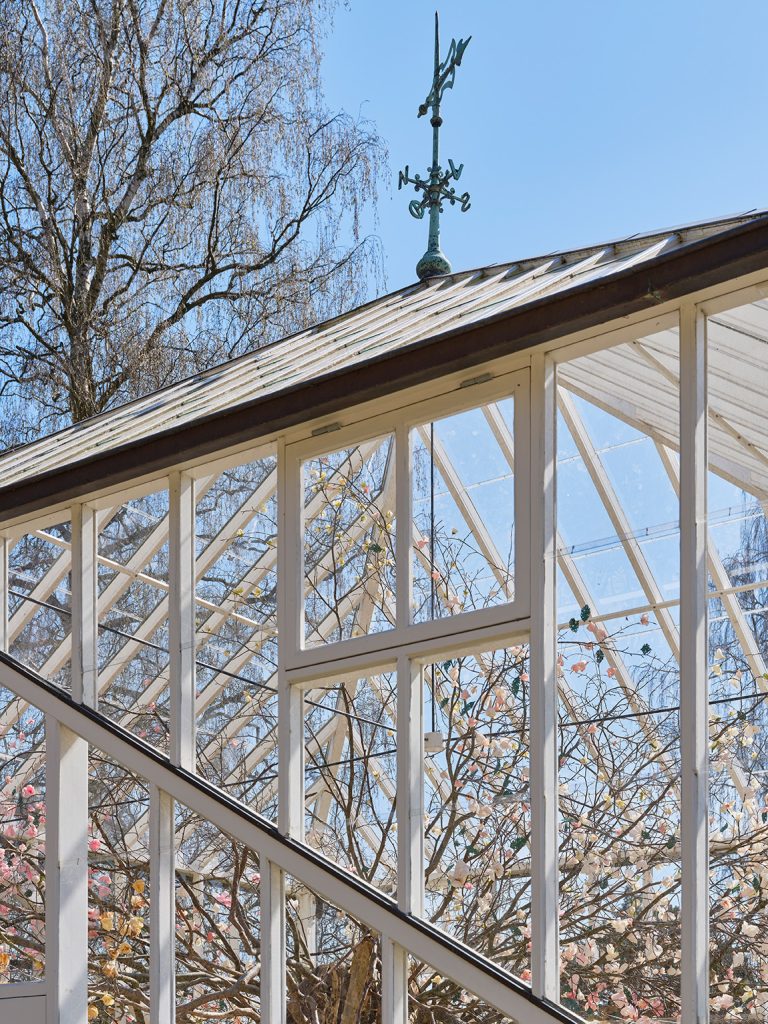
How does the passage of time and the environment effect the work?
In my work the passage of time has great importance. I would say that it is the most important element in my work. That everything is in a transforming faze. We as humans are here on earth for a very short period, our greatest value in life, is our own power of transforming whatever experience we run through in life. This is how we are formed. Our ability to live through life experience and transform our points of view makes us evolve into something new. We become stronger, when we embrace the power of pain and turn it into hope and understanding. We cannot expect not to change the course of a lifetime, it is just a question of who we become and what we do with our struggles. Self-destruction negativity is part of life, it will not carry you very long as those feelings will eat you up from within. Therefore, we must go through pain and begin to become grown up in all aspect of our behaviour, take responsibility, and if we can transcend pain into wisdom for our surroundings we have come far. But this is only the beginning.
As many things is life, we too change with the environment, weather or family and life circumstances. My tree changes during the curse of almost one year. Might be from beautiful blossom to wittered and dry almost no colour. But the importance is the process to be part of something we cannot control and not judge it for being better than or more beautiful just because it makes you smile with joy.
How important is the process of the making and the understanding of the slow destruction of the work, reach the viewers?
The slow destructing is not an end point but a place where things begin all over again. We need time in the not blooming period or the falling apart period to be able to blossom again. Blossoming is a will power of strength and magnitude, so blossoming is also cherishing all the time it took to come so far. It is the transformation part we need to embrace so it is not so important when you step into the installation you are a part if it when you enter the room at the perfect time of your own cycles.
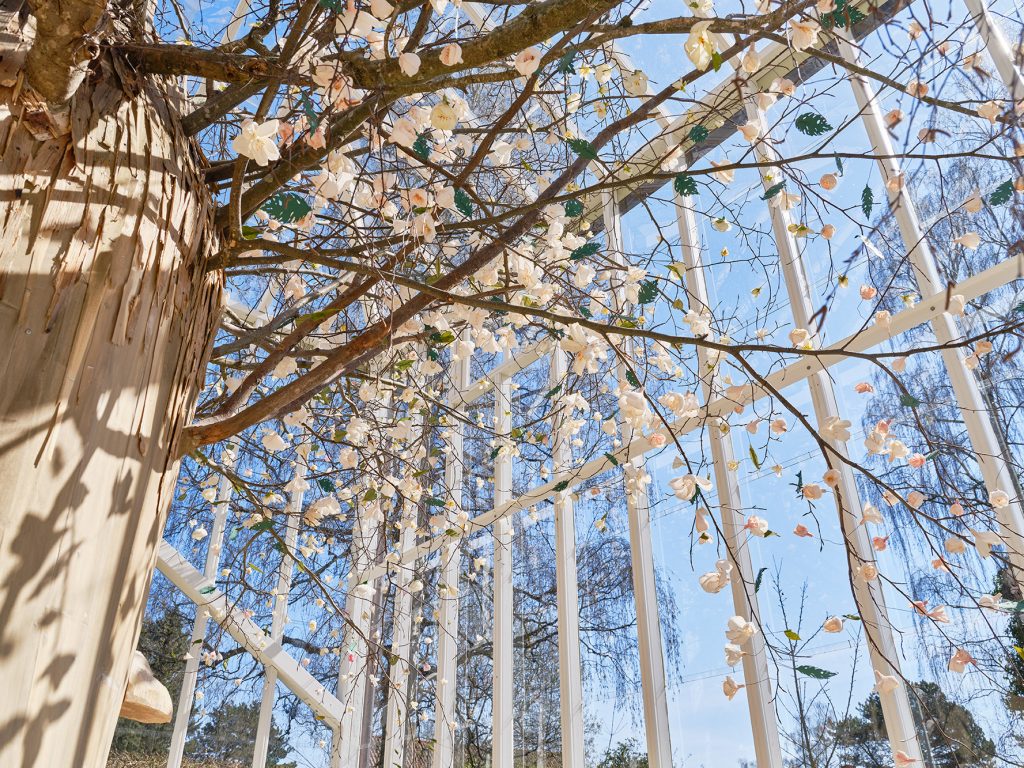
This is not the only tree, flower installation you have had in a significant place.
Discuss the Cherry blossoms in the domed ceiling of Frederik’s Church.
The project in the marble church in Copenhagen was a giant project made of 16.000 paper flowers. It was a comment on many layers of knowledge. The masculine and the feminine in ourselves, and the society. The male dominated architecture of the time and the awareness of us taking better care of mother earth. All together with doing something so big and I could not do it alone but needed to ask for help. A lot of help, in curse of a short period of time. The project depended on voluntary people helping me to succeed.
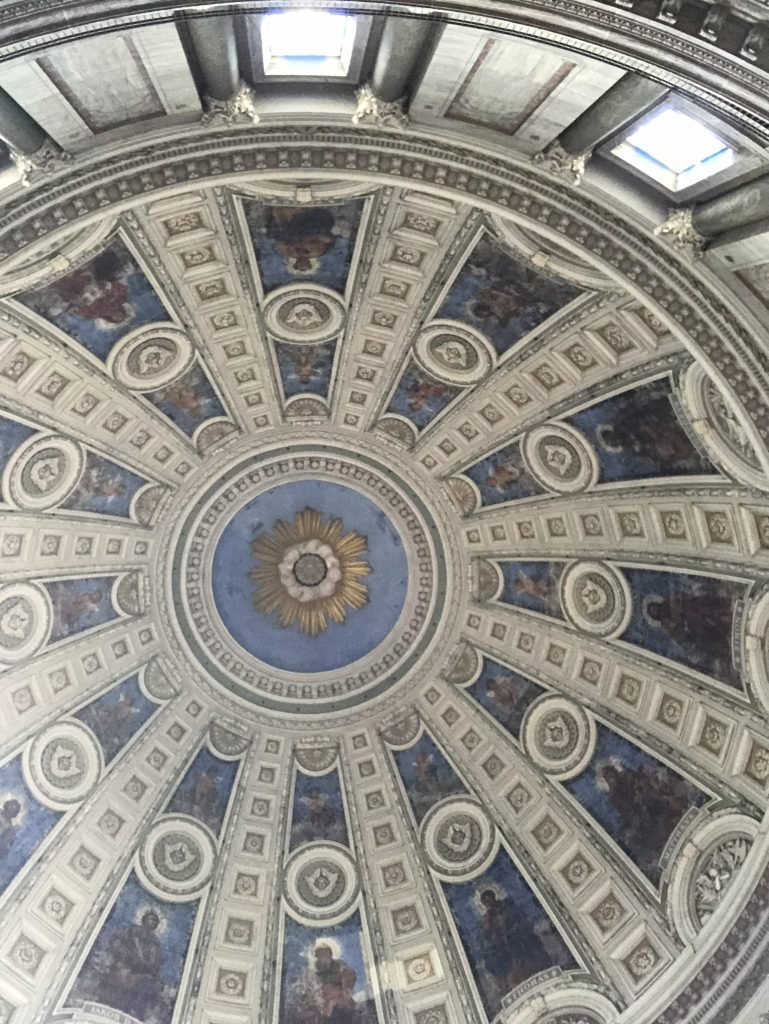
I had over 200 volunteers to help in this period of time. Lawyers, social workers, students, kids, grandparents’, friends ,my mother. Other friends and people who passed by. I even had a sign outside my studio “with come and give some time 30 min an hour and you will get a big hug”. Sometimes especially here in Copenhagen everybody is costumed to getting paid for their work. And we are not so easily encouraged to help when it not a matter of life and death.
Here it was help needed to do an art installation. We needed to lift it together. We did succeed, and I got the help I needed.
It was a very hard task and I’m happy we made it. But I could not do it again. It was too crazy, simply full craziness.
I would do the project again; nobody really understood the visuality of the project before it was hanging there.

How did this installation come about?
It took nearly 1,5 years to convince the church that this was a brilliant idea. And from there I was on my own to make it happen financially and practically.
It is not always easy to make big organizations like a church with no history of giant art project to bring on something new. I do not believe they have done anything similar since. It was a very big task. I sincerely believe, if there are gatekeeps in charge of big spaces like that, magic can happen if they are willing to let people like me in. These types of art projects can have a healing effect on people and create a feeling of hope and togetherness. We need that, more than ever to understand that we are together on this journey of healing ourselves and healing the world. In that sense, we also heal our dearest mother earth. She whom gave us life on earth.
How long was the installation in the Church?
The installation lasted for nearly 7 Weeks and was visited by nearly 200.000 people.
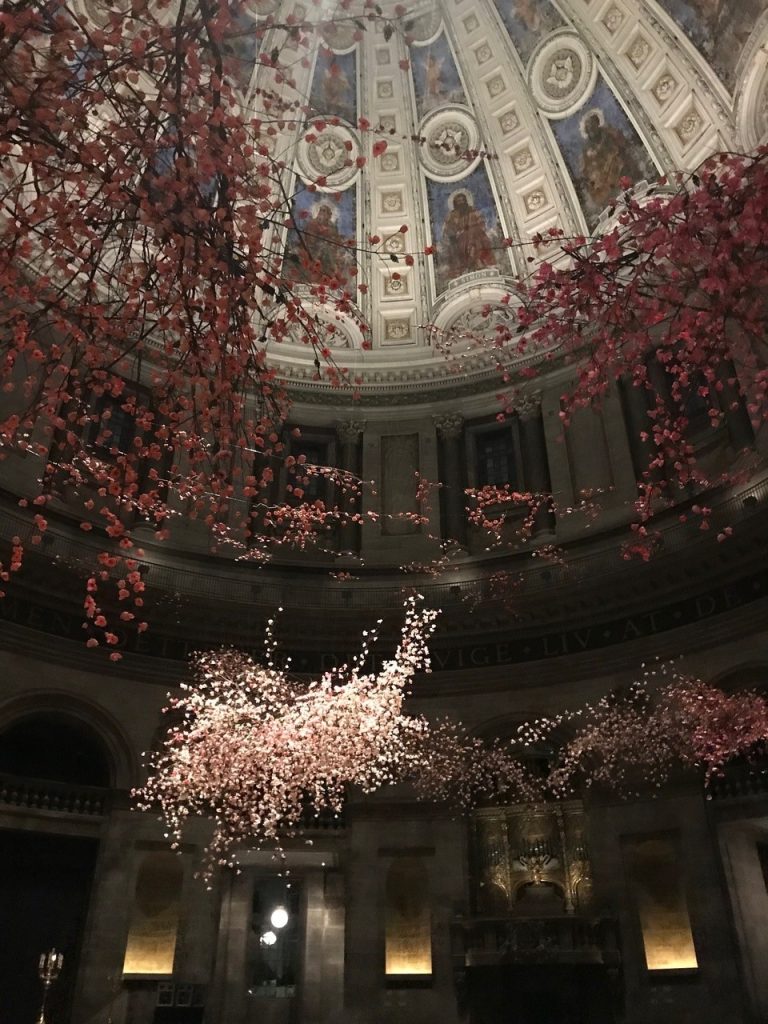
Why was it named, ‘Cherish’?
Cherish as in cherish blossom and we humans need to cherish the beautiful planet.
Who helped with the creation of the thousands of blossoms?
How was it installed?
The 7 branches were big in centimetres, that was nearly 4x7 meter for one branch. They were mounted in the middle of the church floor and then we had climbers rappelling on the inner side of the dome as we could not come up the with ladder or anything. The dome had been untouched on that side since it was built.
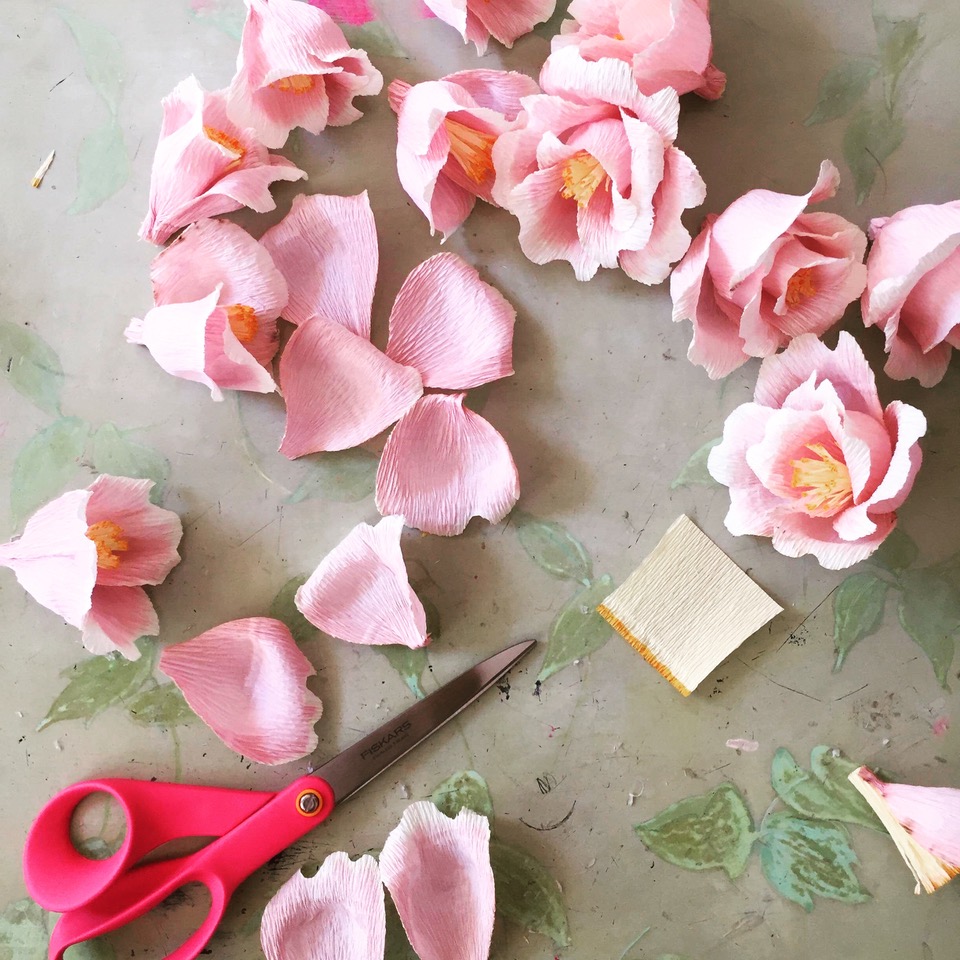
Are you always working to connect, art, academia, the public, and often commercial interests?
No, this part can go out as I have stopped my PhD. Project recently and will for the time being not become an academic person in the traditional context.
Apart from flora, you manipulate paper into fauna. Discuss your Jellyfish series?
Flowers are a part of my interest; nature is my inspiration. I always take an interest in what needs attention. Everything under water is my passion. I am an ocean person. I love everything to do with water. I would say if I should be an activist, it would be for nature off course, but the ocean has at my heart. Jellyfish are just a small, tiny part of that. They follow the current in water. They are woundable and beautiful, and we must respect the differences in spices also and especially in the ocean.
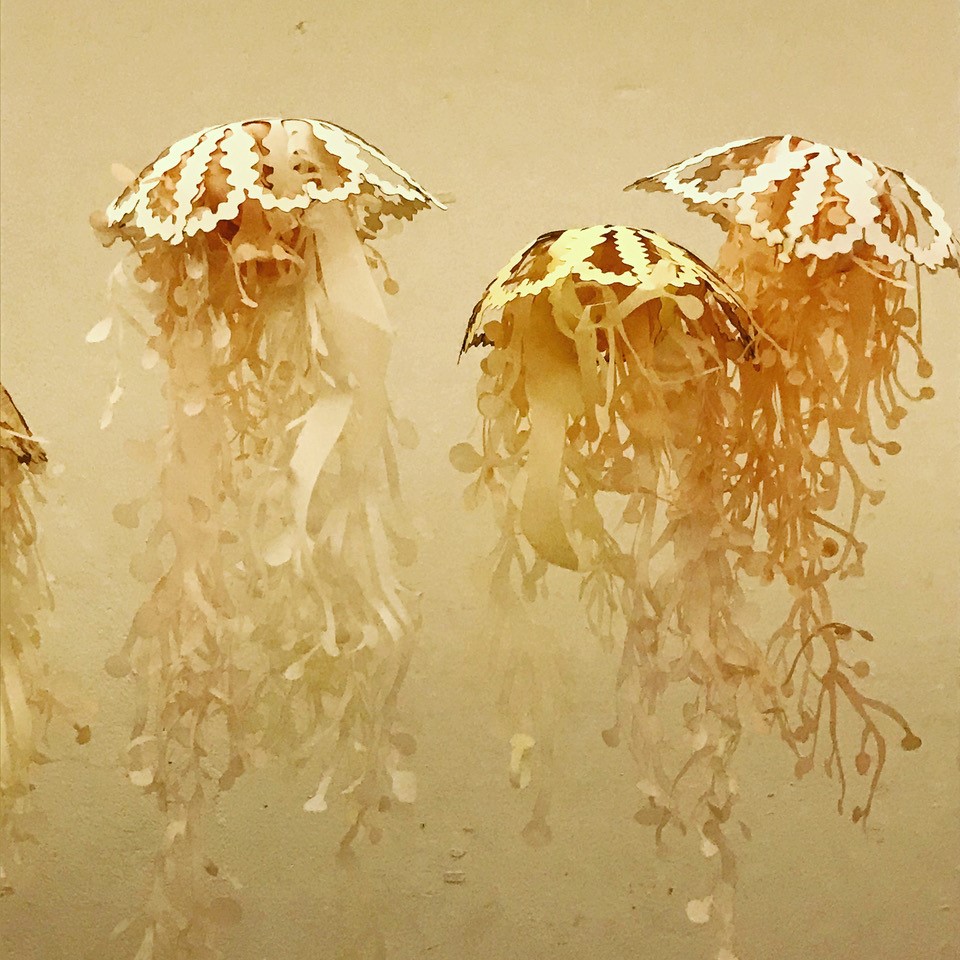
Where was it installed?
The jellyfish exhibition has been installed at the museum Arken south of Copenhagen. Also, at the Natural History Museum in Leiden. Holland
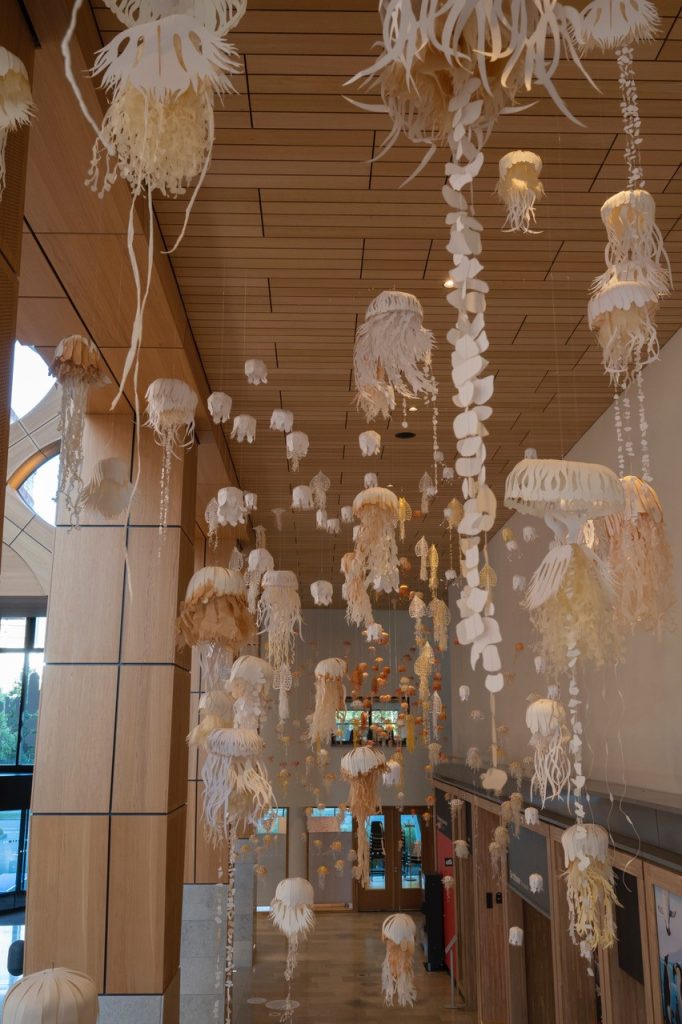
Discuss the reason behind the strong use of white.
I have only used just white once when I made and exhibition 6 years ago in a large shopping mall in Arhus. There everything was white to make an emphasis on the coral reef that loses its colour when we do not take care of the ocean.
I do use colour. But it is important for me than the total expression is seen, and one colour can often make the contrast to the big space that I am exhibiting in.
The exhibition at the greenery has lost a lot of colours over the last 6 months and is turning brown and white.
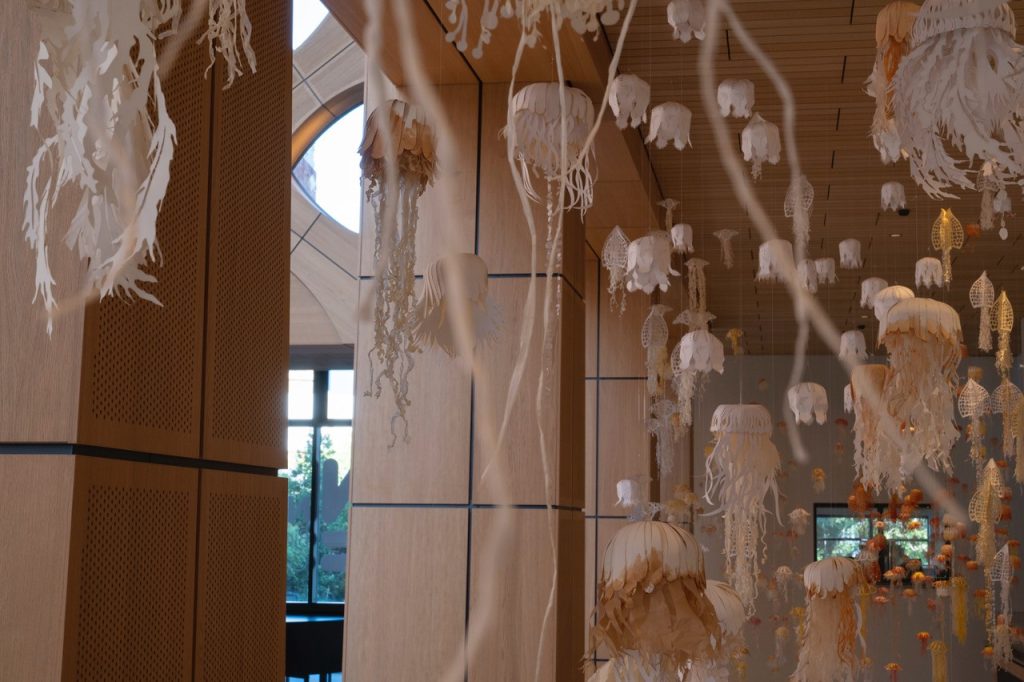
Do you find one installation naturally leads to another?
No, I do not think in that way, in some cases it does but my theme of work also has to play together with the building and the architecture I exhibit in. I always have a underlaying theme, I work with what has to be done to taking care of the planet. So, it’s just how much the stakeholder wants to make my message a theme. I do emphasize on making it a requirement that it is visible and clear that I work for mother earth.
100% commercial approach is not my goal on earth.
What are you currently working on?
I am currently working on a private commission in Oslo. It is so wonderful to have time to work with one piece. In the world of a Museum, you often work with a timeline of two to three year, so at the moment I am doing my best to fill up an assignment for the next 3 years. I do a lot of research to find a match and suggest a project. And sometimes it is only me having a brilliant idea. If the gatekeeper does not agree, then I need to move on to another, whom has the visual take and understand of my artwork.
Do you think having worked in the film industry has taught you to work big?
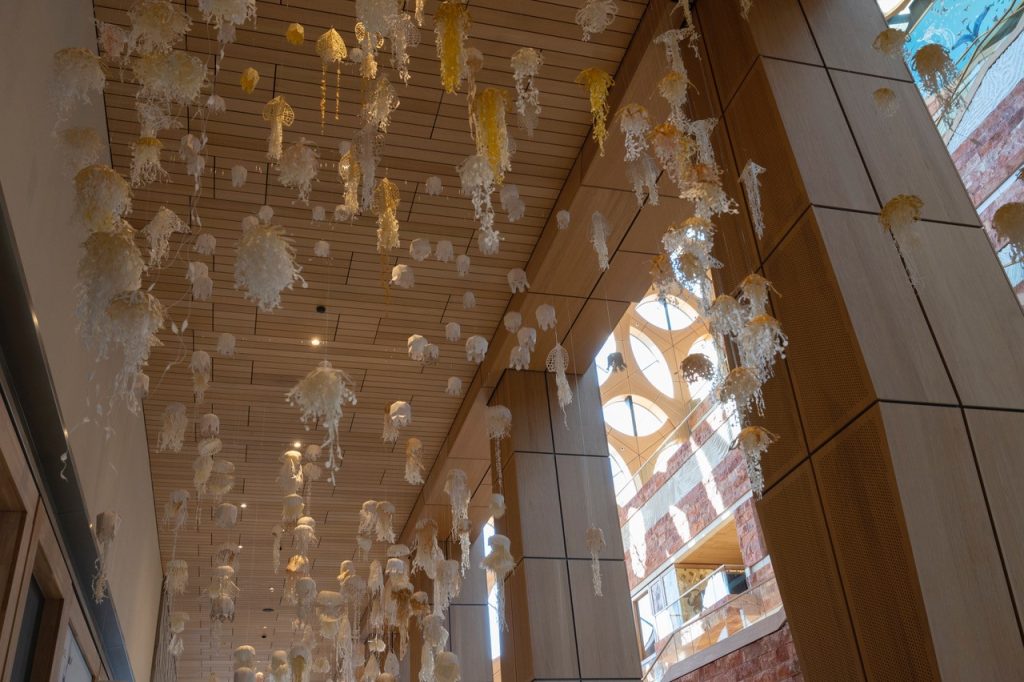
Yes absolutely. Film has taught me how to work in big scale, work fast and have a catch to the eye.
I love the film industry, but I also love the possibility to emerge into quietness in your own soul by having an inner experience with space and art.
My goal is to break thought the intellectual mind and go directly for the heart connection. I believe it is here we truly can change our selves and then make changes for the world. We need to step up to a higher consciousness and I want to be part of that movement and hopefully inspire humanity, to take care of the planet with respect, dignity and love.
We need to change, and I am in for it. I am ready, to bring it on. My life purpose is to bring beauty and change to the world to those whom want to change the consciousness of humanity. That does not mean it is easy. It's hard work to go through hard layers and its ugly at times to see yourself.
How do you cope knowing that the fragility of paper will not last into the future?
The fragility of paper is beautiful as it corresponds to the fragility of our body and life. We are here for a short period of time, then we are dust and memories. I create experiences that live in the heart of the individual. The fact that my material becomes dust is just poetry for me. And why not pay for those who chose to use their life on doing floating poetry for the evolution of love. For me there cannot be a higher purpose in life than that. Yes, not to forget to love and make sure to listen to my children, feed them and give them a place to live. Those are the things that makes me truly happy and my life worth living.
Art as poetry should not have a price tag. That does not mean that the artist is not paid, just than you cannot put a price tag on the value of transformation and that can happen in life, in art or in your hearts and the knowledge we gather, we must give away not turn it into bitterness.
That is why we are here on the planet earth together to transform our selves and give hope for the next generation after us.
Contact:
Veronica Hodges
Denmark
Deborah Blakeley, Melbourne, Australia
Interview by Deborah Blakeley, October 2023
Harlinah Teoh
What led you to reconnect with ceramics in 2019?
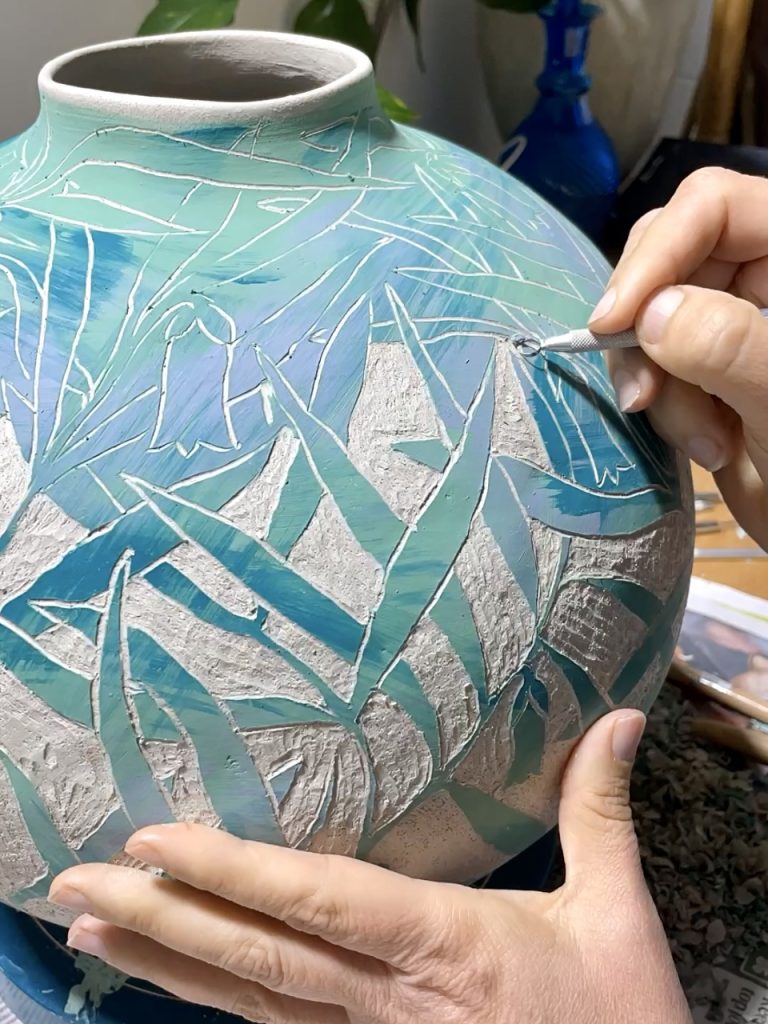
At the end of 2018 I was raising teenagers, working long hours in a demanding job, and studying a postgraduate degree at night. Creativity through art and music had always been important to me, but it had all fallen away as my work became more intense. I was exhausted and felt disconnected from an important part of myself. That year the social club at my work held a Christmas craft market where a colleague was selling her ceramics, and I had a visceral feeling that I needed to make ceramics myself. I’d grown up around potters but had never touched clay as an adult. Over the next month I converted my kids’ backyard cubby house into a tiny studio, borrowed a pile of ceramic books from the local library, bought some clay and basic tools, and signed up for classes. It took another few years of working and a bout of extreme burnout before I realized I needed to shift my priorities and design a life where creativity is central.
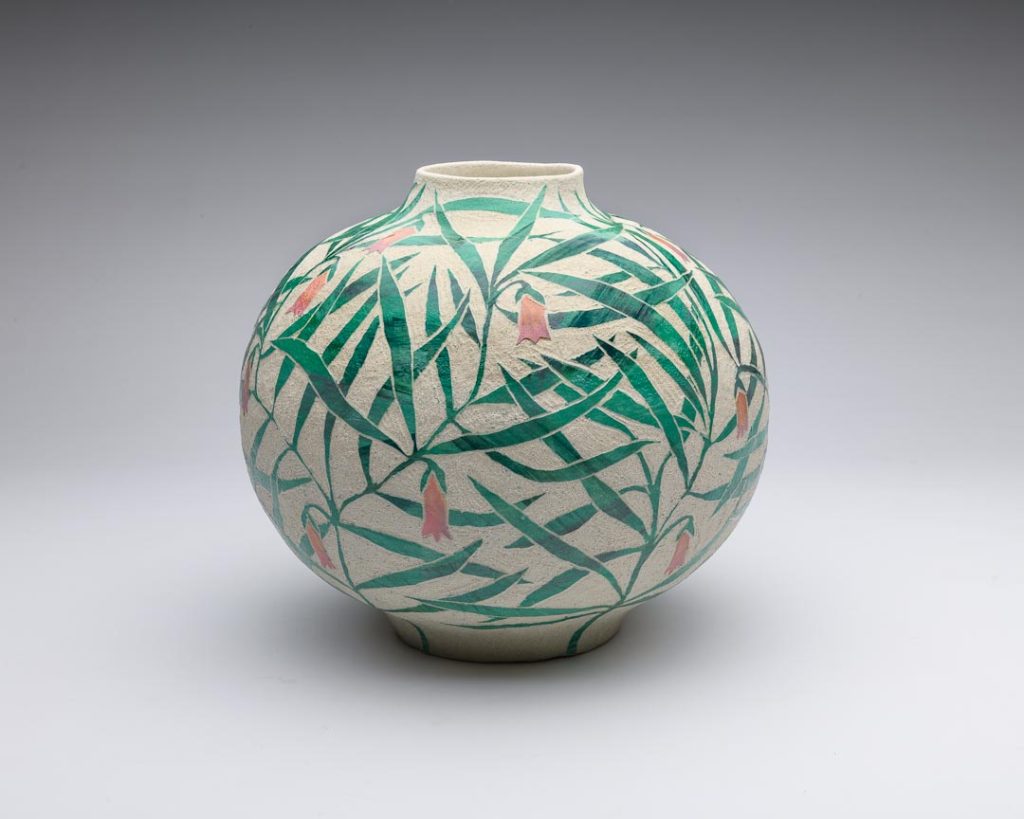
Emu Bush (Section 8: One billion years of solitude), H 26 x W 29 x D 29cm, stoneware ceramic.
Did growing up in the bush (country) and rainforest, become the pivotal part in your current ceramics?
Right from the start, I felt the urge to decorate my ceramics with botanical designs. There’s some kind of connection between my creative instincts and my love of plants. For most of my childhood I lived in the bush -- dry eucalyptus forest and then subtropical rainforest. I had a lot of freedom to explore, make cubbies in trees and spend days swimming in the creek. I loved reading folktales and mythology, and it all got mixed in together to create a dense, green imaginative world. I didn’t consciously set out to make botanical art, but that’s what emerges when I start making.
Red-Bud Mallee (Section 5: The root of happiness), H 30 x w 24.5 x D 24.5cm, stoneware ceramic.
Tell us about your time in Tokyo and Singapore, how these two places have left their mark on your art?
I was curious about Japan from a young age, inspired by books in our home including a catalogue of ceramics by Shiga Shigeo and a much-loved storybook about two Japanese dolls. After I finished school, I followed my interests and moved to Melbourne to study Japanese at university. I lived in Tokyo for six months when I was 19, and again for a year in my early twenties. These were intense, formative experiences, as things often are at that age. I later met and married my husband, who is Malaysian-Chinese, and we lived in Singapore for 5 years before moving back to Melbourne with our first child. My work doesn’t directly reference Japanese or Chinese art, although exposure and appreciation have no doubt had an influence, as has European folk art. The bigger impact was the experience of living in and adapting to different cultures. My childhood was unconventional, taking me to different communities and schools within Australia. Living in Japan and Singapore marrying and raising children with someone from a different background, doubled down on the need to be adaptable. There’s a lot going on in my work about how organisms (including humans) adapt to their environment, and how meaning changes – native or introduced, precious specimen or weed – depending on context.
Discuss why, your work is hand built rather that from a potter’s wheel?
I started hand-building because I could do it independently at home, in a small space with minimal equipment, which meant I could continue making between my weekly classes. I also realised many of the ceramic works I first admired were by hand-builders, such as Thancoupie, Toshiko Takaezu, Avital Sheffer, Erna Aaltonen and Alev Ebuzziya Siesbye. I enjoy the slow process of coil-building and the energy of hand built forms. After several years of hand-building I took wheel-throwing classes, which developed my understanding of clay and made me a better hand builder. I now use a hybrid technique where I coil-build most forms and use the wheel to refine the shape. I like that I don’t have to trim the pot – the shape I build is the final version, and I can start work on the surface straight away. That said, I’ll probably spend some time developing my throwing skills soon – I think it’s useful to have both skillsets.
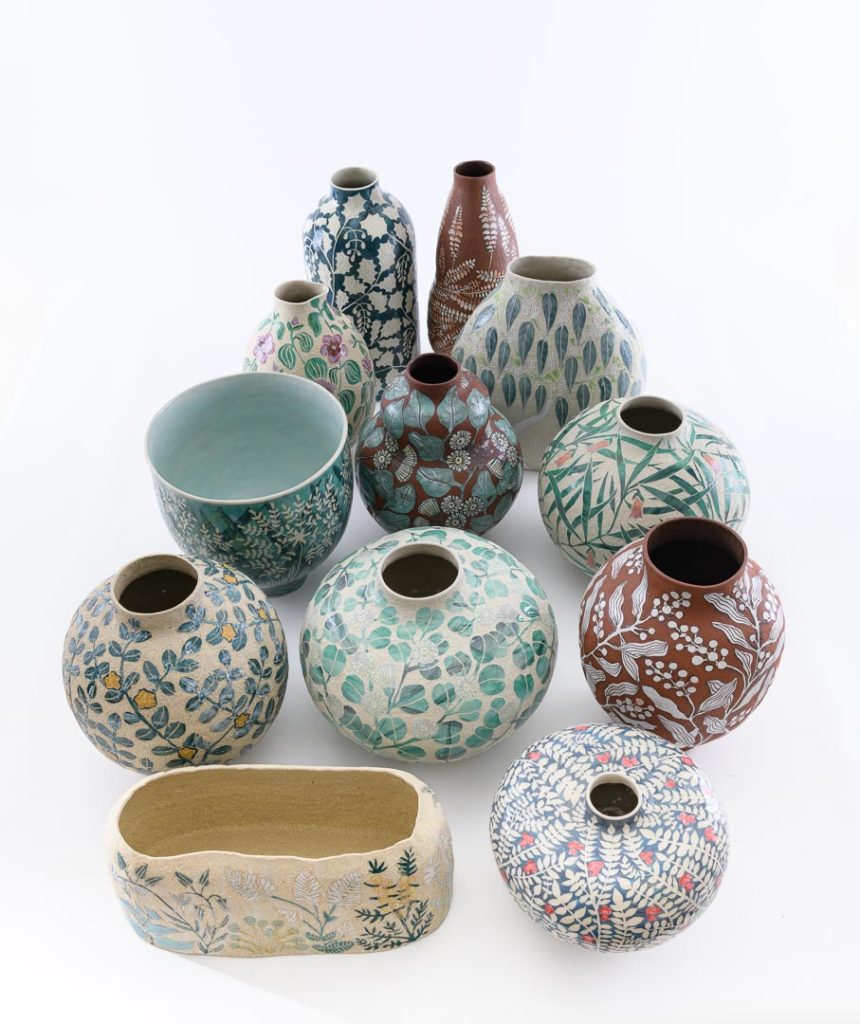
Larapinta series – 12 vessels representing the 12 sections of the Larapinta Trail. Various sizes. Various sizes. Stoneware ceramic.
How do you collect or record the plant life you use?
I take photos on my phone while on hiking trips or urban walks. I don’t remove any plant material from the wild – partly due to ‘leave no trace’ hiking principles, but also because I don’t really have the collecting gene! I’m happy to leave things where they are.
Has your time working in the State Library Victoria developed a strong practice of documenting?
What a great question! My mother is an artist and advised me to keep a record of my work from the start. The State Library gave me an extra appreciation for the long lifespan of documentary history and the value that seemingly insignificant documents gain over time. I bumped into former colleagues visiting my first solo exhibition and was surprised and thrilled that they took away a catalogue to create my Australian Art and Artists (AAA) file. It had never occurred to me that I could be part of the AAA collection.
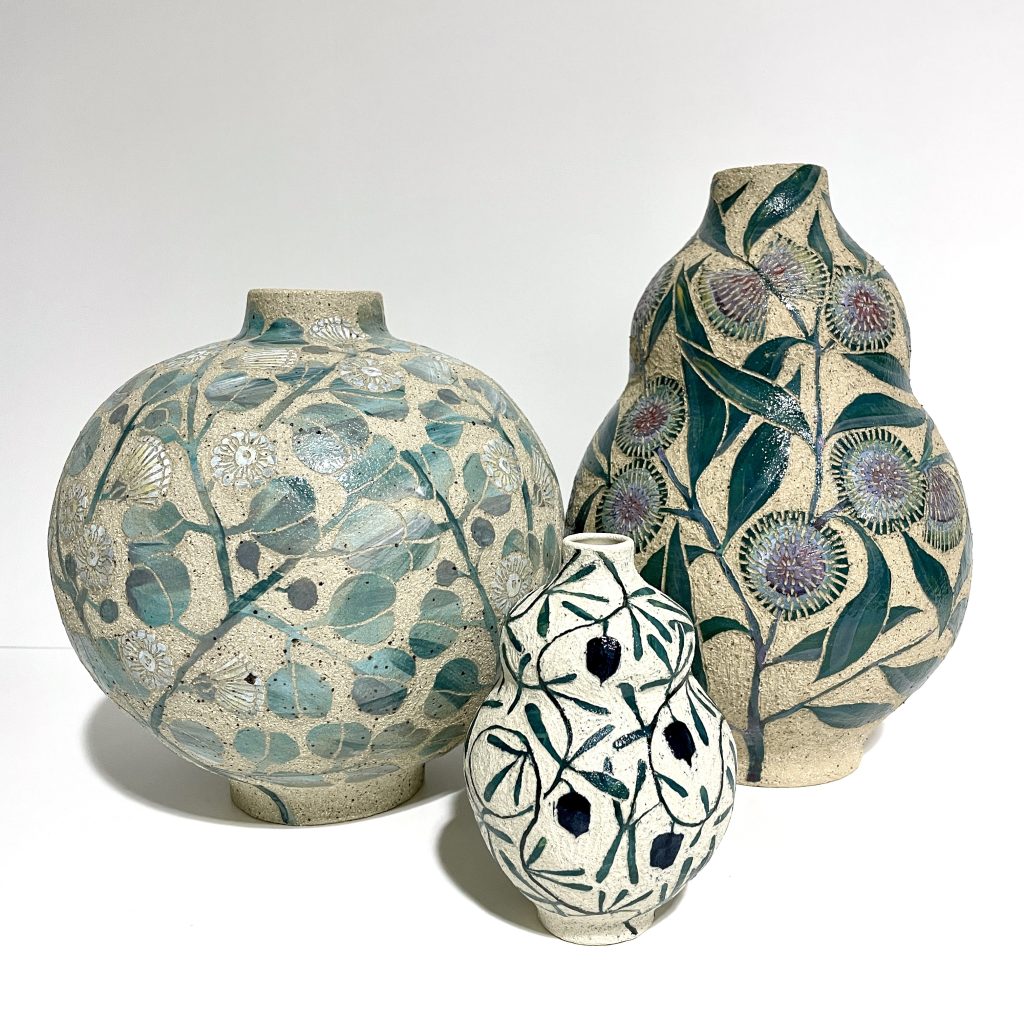
Back, L to R: Pincushion Hakea, Round-Leaf Mallee. Front: Purple Apple-Berry. Various size. Stoneware ceramic.
Your exhibition Larapinta – A Botanical Journey.
How did it arrive at its name?
When restrictions lifted after Melbourne’s COVID lockdown in late 2020, what I wanted more than anything was to get out of my suburban neighbourhood and go for a walk in the bush. My first post-lockdown hike prompted me to join a bushwalking club, which led to me doing longer and more challenging multiday hikes. I discovered I loved walking long distances with my camping gear on my back. The slow pace of walking and the plants I see on the trail have become an essential part of my ceramics practice.
How long was the initial journey and the following journey to the gallery space?
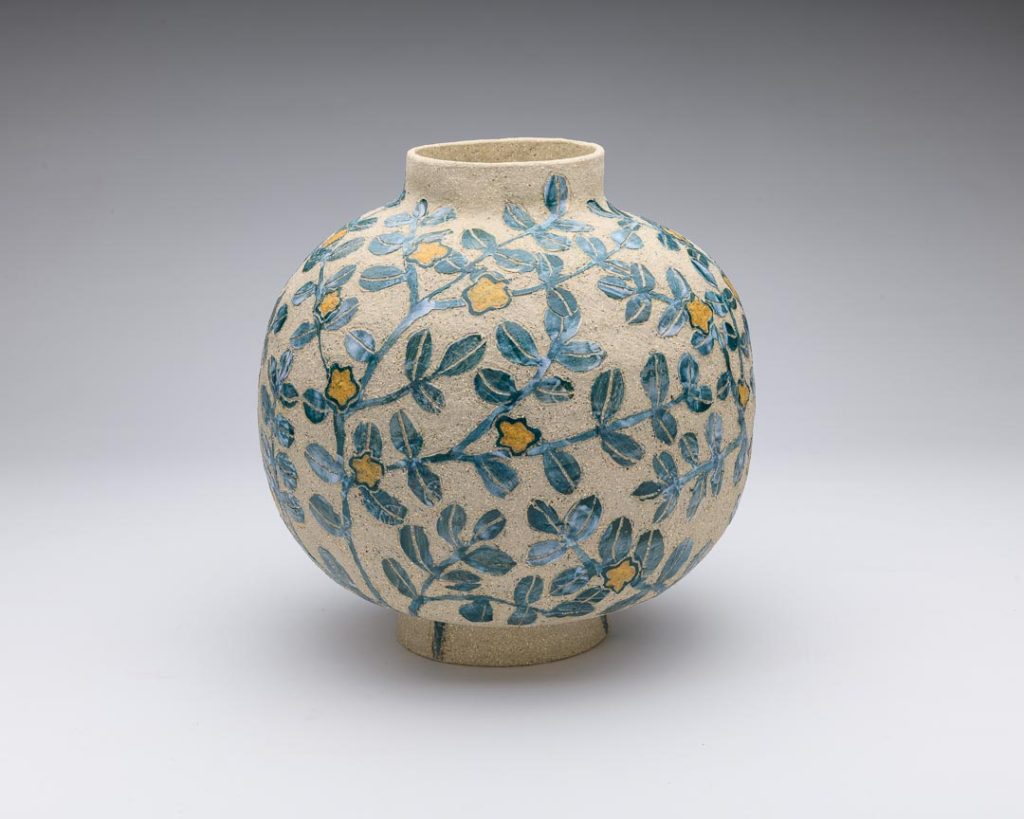
Cassia (Section 1: Simplicity), H 26 x W 25 x D 25 cm. Stoneware ceramic.
In mid-2022 I set out to walk the Larapinta Trail, a 240-km track through the West MacDonnell Ranges in Central Australia. It’s a stunning landscape and a challenging hike through rough, arid terrain. I visited after two years of heavy rain and saw the desert in full bloom. When I returned home, I set myself a goal to create and exhibit a series of 12 ceramic works representing the sections of the trail.
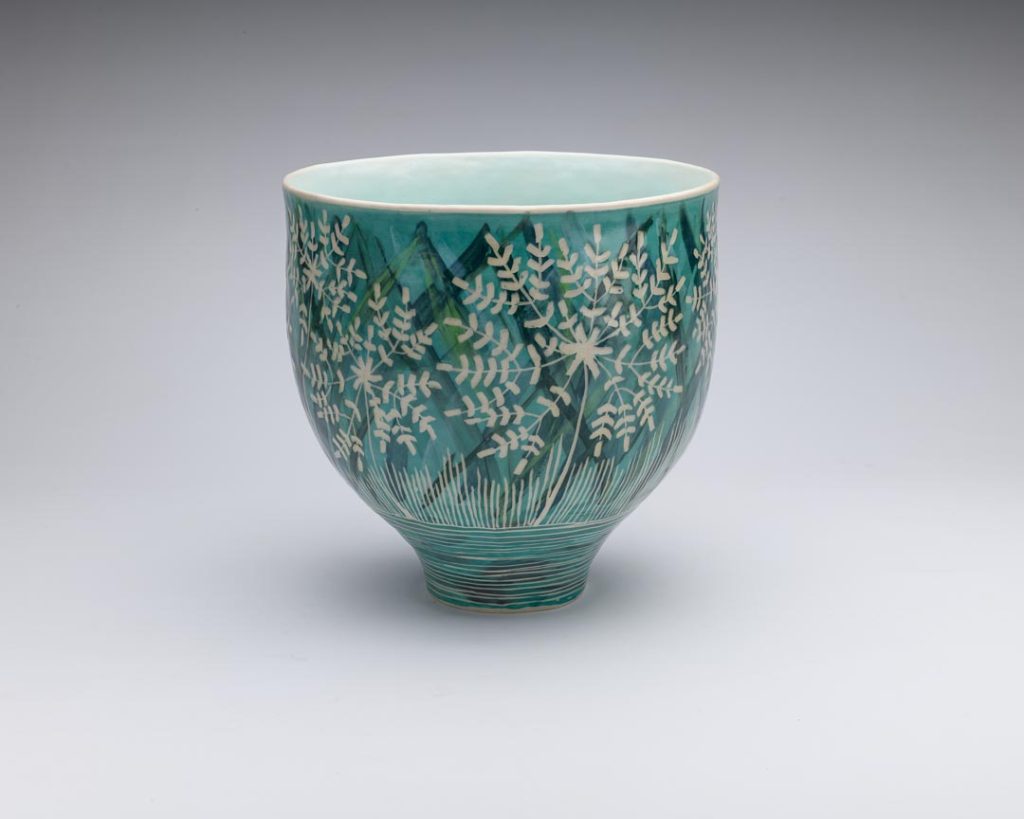
Finke River Reeds (Section 10: The river), H 26 x W 26.5 x D 27 cm. Stoneware ceramic.
‘Larapinta: a botanical journey’ is my first solo exhibition and the outcome of that idea. I started by researching the plants I’d photographed and deciding on the ceramic forms, clay and plants that best represented my experience of each section. My work is named for the plants that inspired them. The Larapinta exhibition series have subtitles that identify the section of trail and give a sense of what I was seeing and experiencing as I walked the trail.
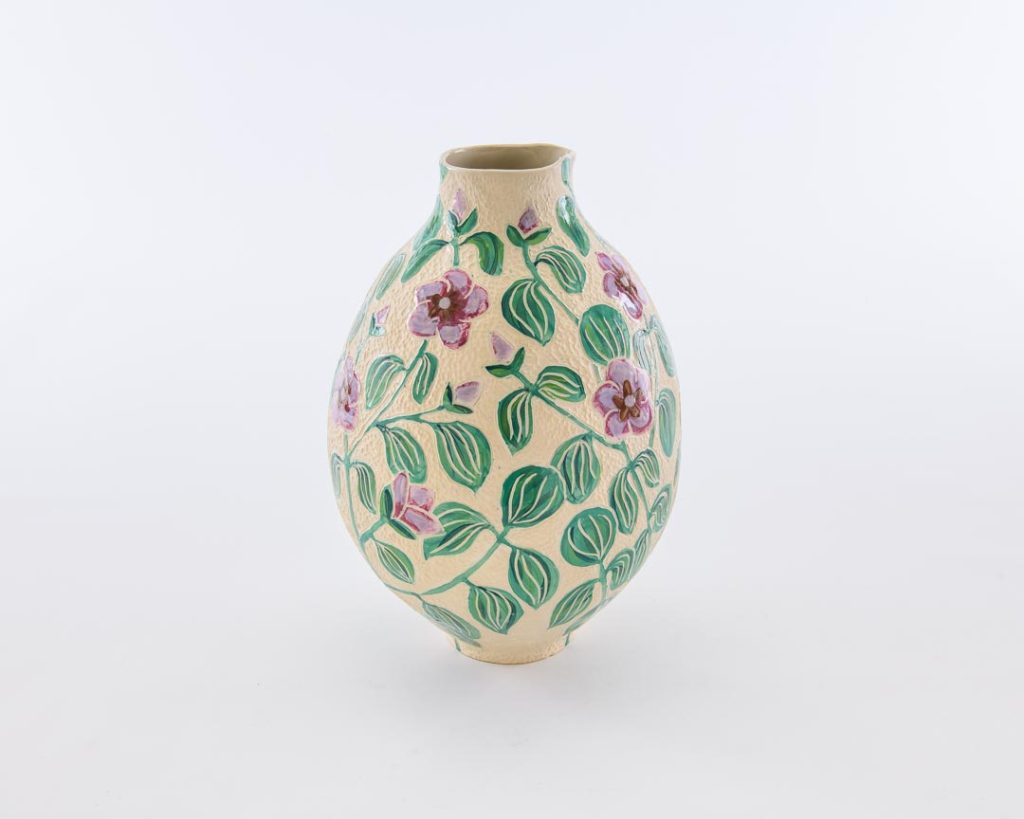
Sturt Desert Rose (Section 7: The serpentine path), H 32 x W 19 x D 19cm. Stoneware ceramic.
These initial ideas evolved as I iterated different versions of the work. In late 2022 an opportunity came up for local artists to apply for gallery space at Glen Eira City Gallery, and I was fortunate to be selected to exhibit in 2023. All up, it took about 9 months to create the final series of 12 vessels.
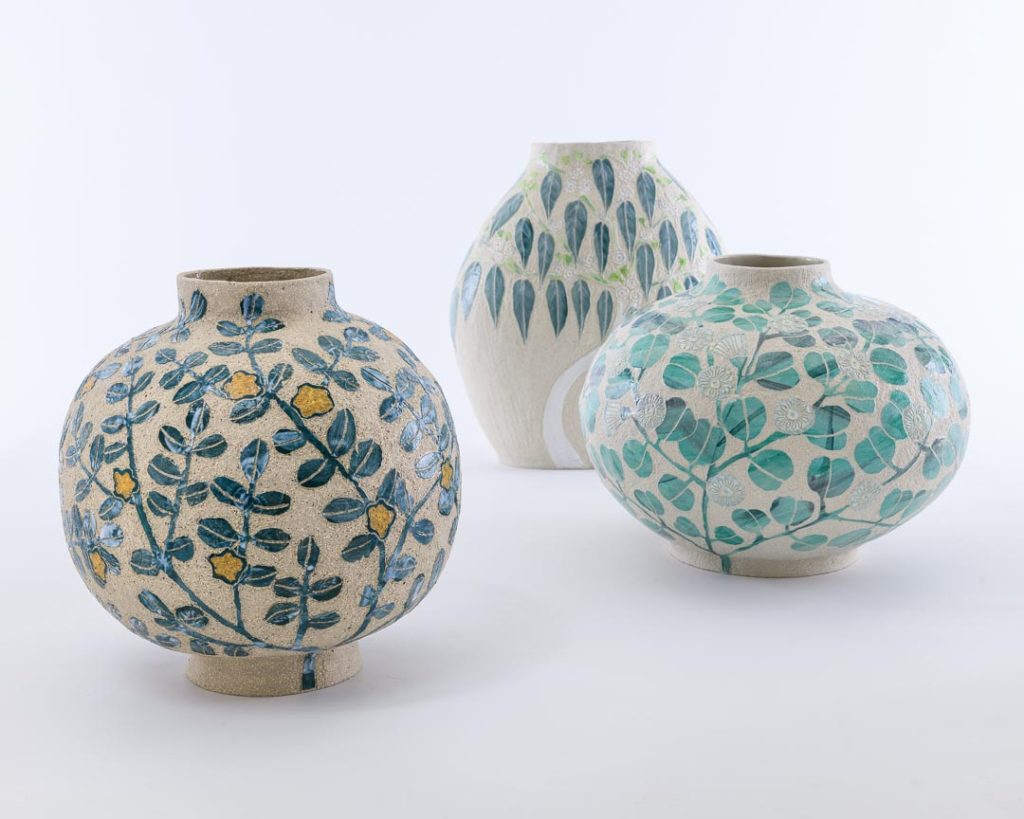
L to R: Cassia, Ghost Gum and Round-Leaf Mallee. Various sizes. Stoneware ceramic.
What was it like to have your first solo exhibition, a sell out?
The response to the exhibition has been extremely positive. It was exciting, and a relief, that all work sold, the majority to international collectors before the exhibition opened and the rest to locals visiting the exhibition. I’ve received wonderful feedback from visitors. The experience working with the curator, Diane Soumilas, and gallery team has been fantastic and I’m very grateful for the opportunity to show my work in a public forum.
Ghost Gum (Section 9: This too shall pass), H 32.5 x W 30 x D 16 cm. Stoneware ceramic.
Do you see most of your pieces as solo, do you sell pieces in groupings.?
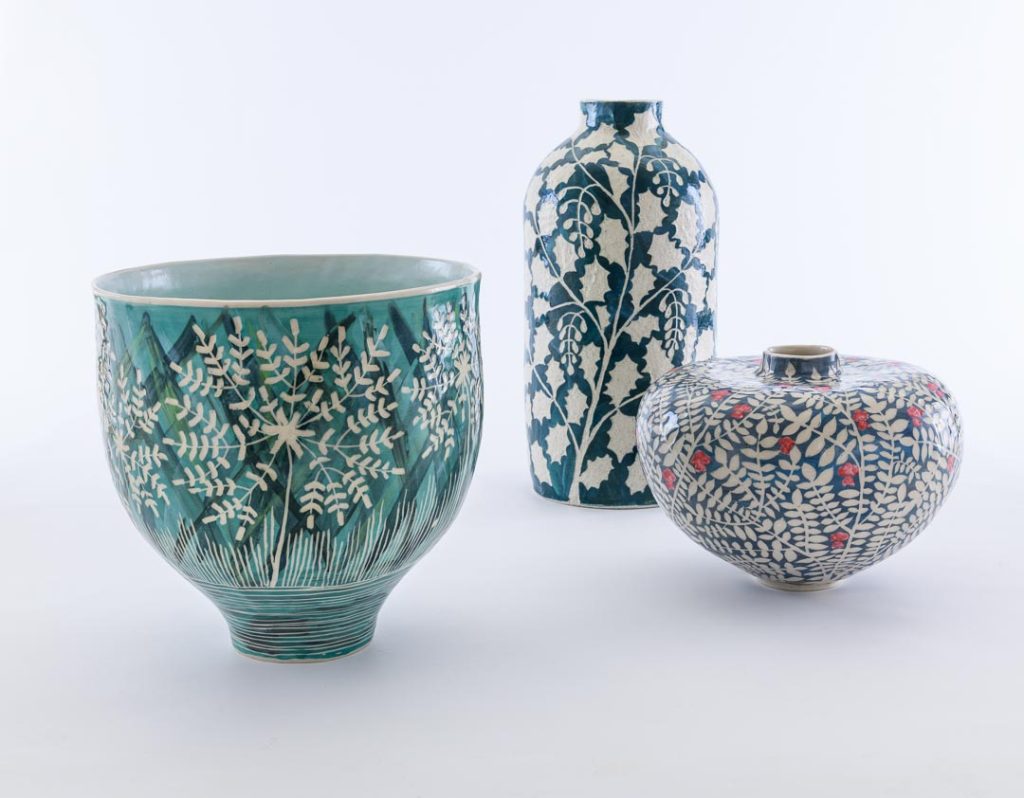
L to R: Finke River Reeds, Holly Grevillea and Silver Indigo.
I make stand-alone works, although some, like the Larapinta vessels, are part of thematically linked series. They do look good grouped together, and quite a few collectors have bought multiple pieces together. I currently sell work individually to give people the option of buying one or choosing their favourites to combine. Maybe in future I’ll exhibit and sell work in groupings.
Can you show us your makers mark on the base of your work, what does include?
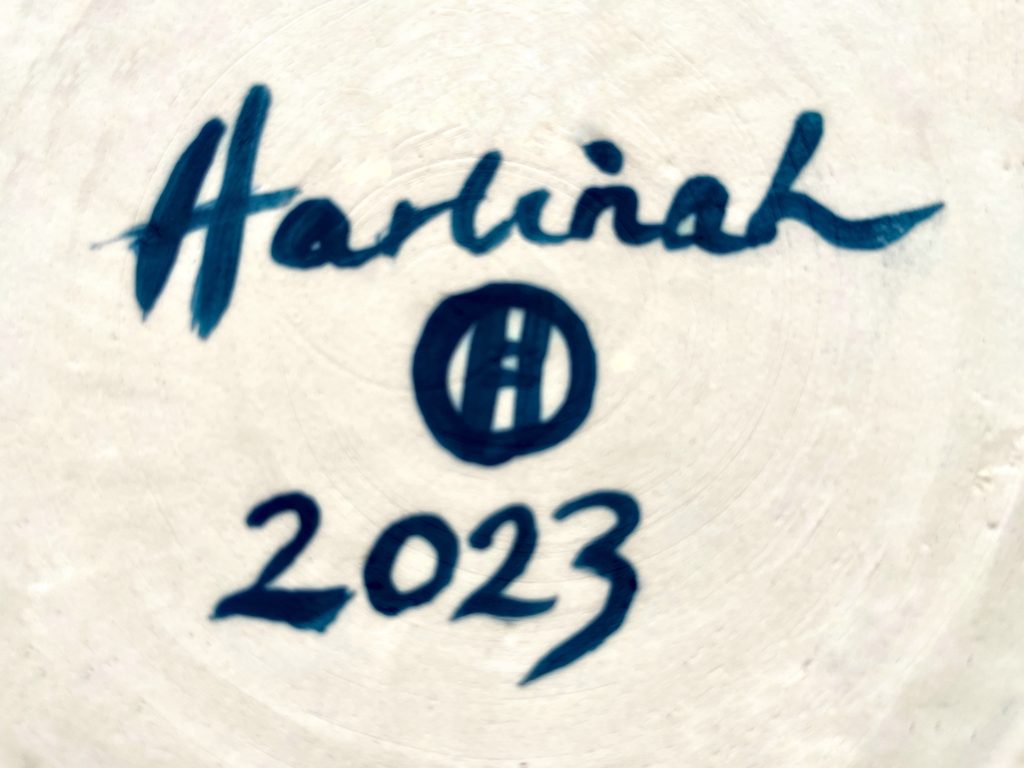
My maker’s mark is my first name, a stylised symbol combining my initials (which I sometimes use alone if space is limited), and the year of making, signed in underglaze.
Tell us about your cups.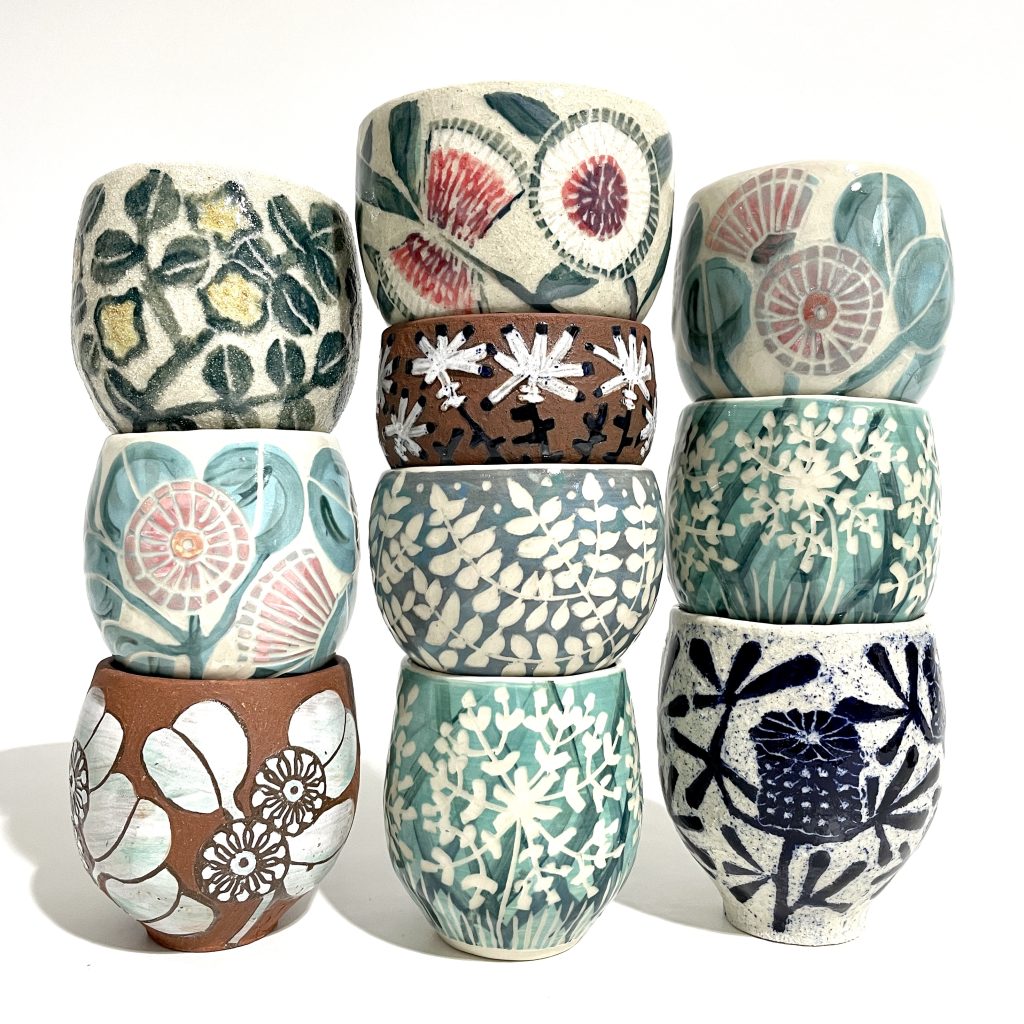
Variety of cups including Cassia, Round-Leaf Mallee, Pincushion Hakea, Mulla-Mulla, Silver Indigo, Finke River Reeds, and Silver Banksia.
H 6.5-11 cm, diameter 8-10cm. Stoneware ceramic.
My cups are like miniature samplers exploring the plants featured on my bigger pots. They use the same techniques as large work, with layered painting, sgraffito and glazing, so they’re little artworks in their own right. They’re time-consuming to make and I don’t produce many, but I like that they make buying a one-off ceramic artwork more affordable. Also, I do love it when people let me know how they enjoy using my cups. The cups vary in size and construction technique. Generally they’re about 8-11cm tall, and they may be wheel-thrown, coil-built or pinched – I’m still experimenting and haven’t landed on a preferred construction.
What does it feel like when viewers can recognize and name the plants on your pots?
When people take the time to tell me they recognise a particular plant, it’s usually because they have their own emotional connection with that plant. Perhaps they have walked the same trail, or remember it from their childhood, or grow it in their own garden. These people are kindred spirits who form memories associating plants, people and places. It’s great to know that my work has prompted them to remember and relive that connection.
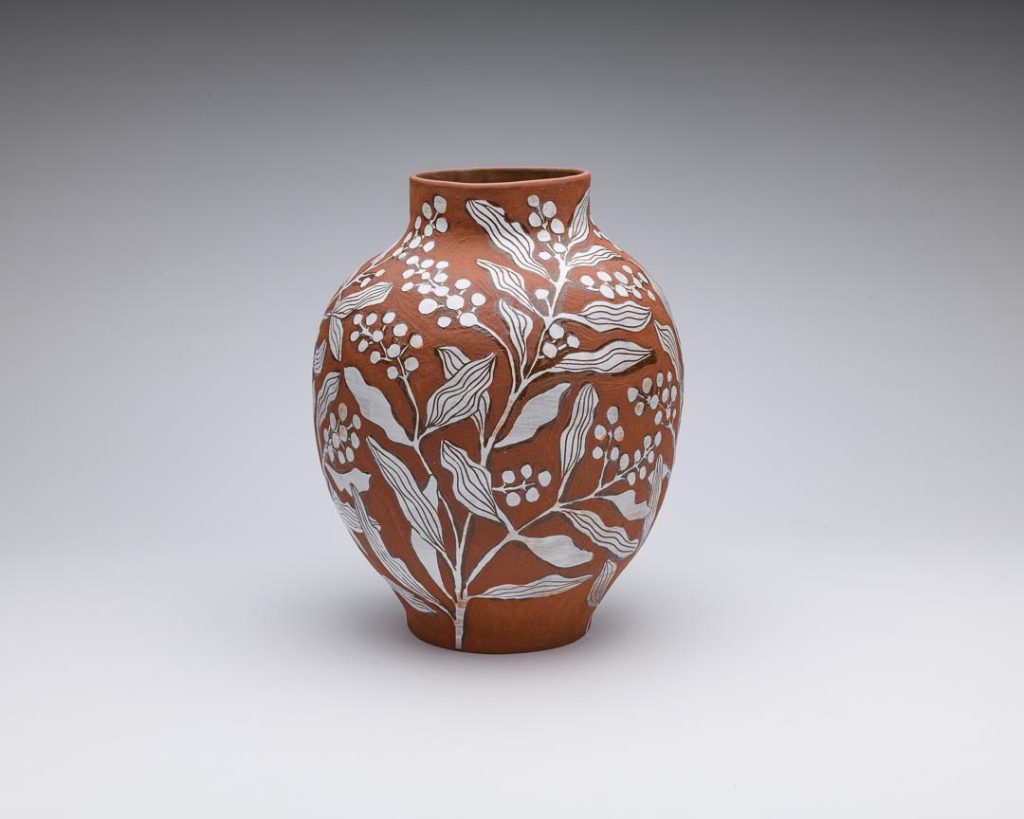
Acacia (Section 12: The mother), H 31 x W 23 x D 23 cm, stoneware ceramic.
Do you give an extra botanical information with the piece as it is sold?
I include the plant details, where I saw it and a photo from the trail on the website listing.
Discuss, Silver Indigo.
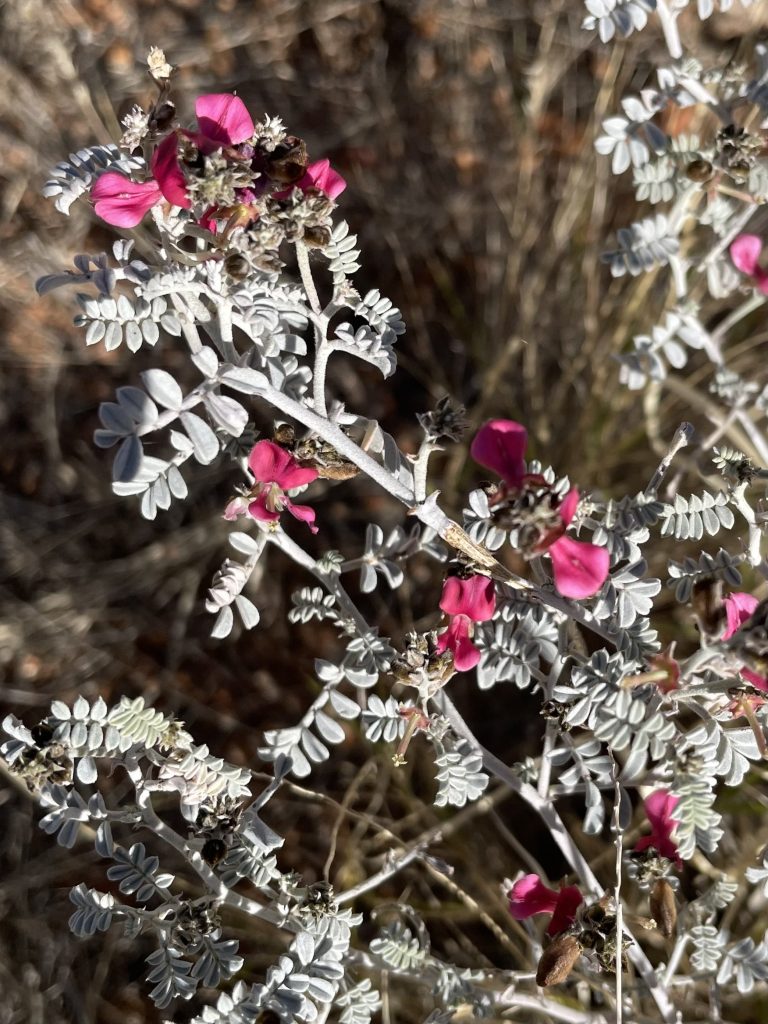
Silver Indigo represents Section 2 of the Larapinta Trail. The plant, Indigofera leucotricha, is a desert shrub with tiny silvery-white leaves and deep pink flowers.
For the vessel representing this plant, I wanted to reference the rounded form of the plant, the colour and delicacy of the leaves, and the blue sky of this open section of the trail. The pot is built from smooth white clay, coiled up from a narrow base into a wide form at the top. This was a risky form as there was a chance the thin walls might slump when the clay became molten at high temperature. The surface was painted with multiple shades of blue and grey glaze, then the leaves and flowers were carved through the underglaze, exposing the white clay underneath. Finally, after testing different versions of the flower on test tiles, the flowers were painted in.
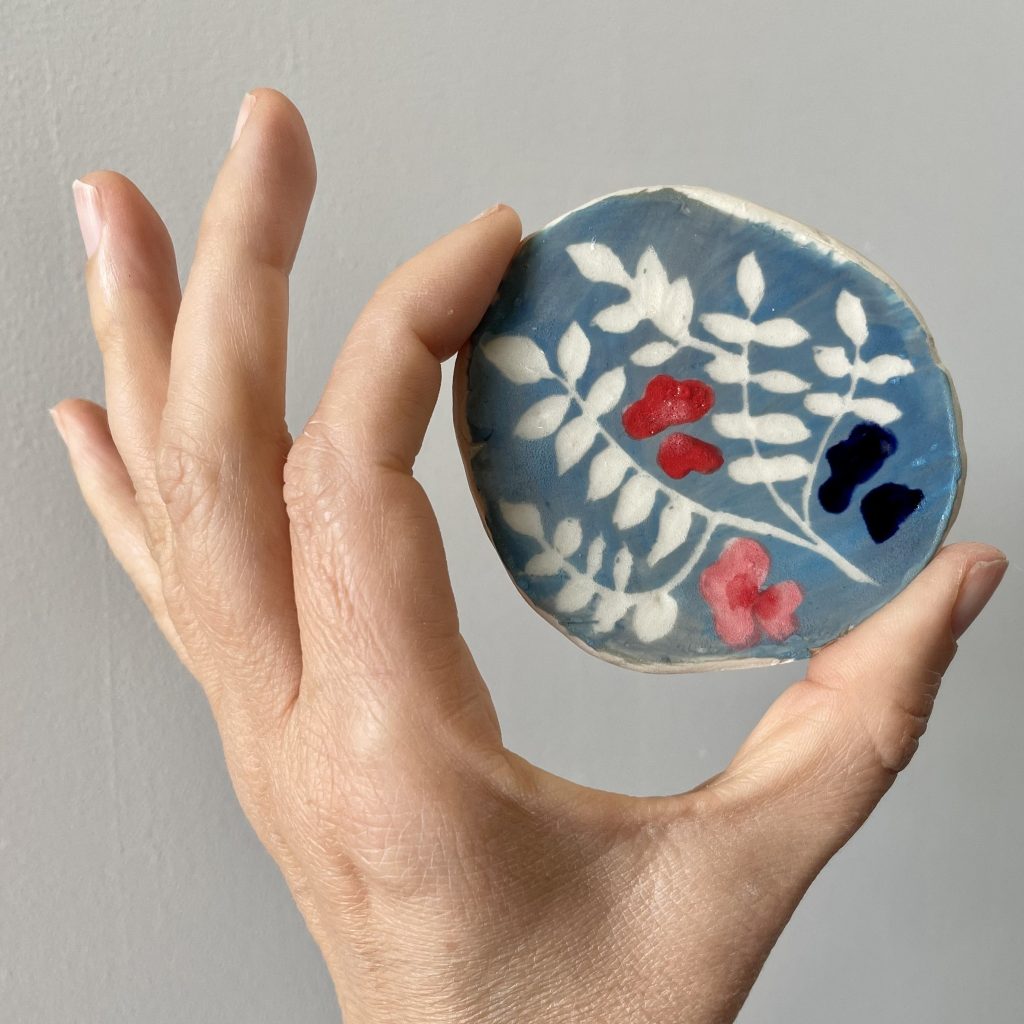
The pot was fired, glazed, and then fired again. Fortunately, the form held during the final firing and the result seems to float on its narrow base.
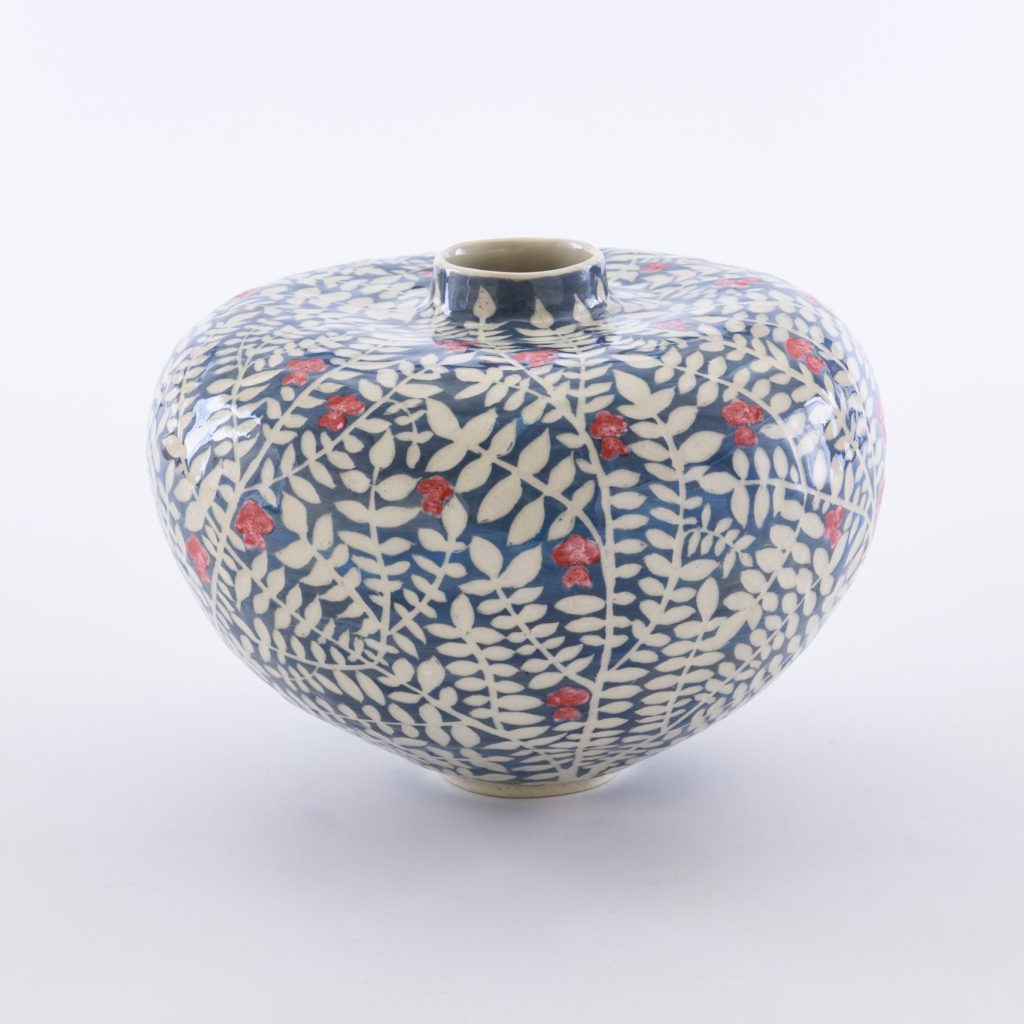
Silver Indigo (Section 2: Starfall), H 18 x W 25 x D 25 cm. Stoneware ceramic.
Comment on two glazes and how they have affected the pieces?
Most of my work uses underglaze and slips, with clear glaze on top. Very occasionally I use a coloured commercial glaze, as I did for the Finke River Reeds bowl which has a pale blue interior. I’ve recently been studying glaze formulation and am just starting to experiment with my own glazes. All the work shown is made from stoneware clay with different characteristics –smooth and gritty, in shades of white, sand and red which relate to the Larapinta landscape of quartz and red earth. The surface designs use underglaze, clear glaze, occasionally porcelain slip, and occasionally a coloured glaze on the inside of a cup or bowl. The work is fired at Cone 10 (approx. 1280°C) or Cone 6 (approx. 1220°C), depending on the effect I’m looking for in the clay and underglaze. I use different clays and glazes appropriate to the firing temperature. I choose materials based on the feeling and colours of the land I walk in. For example, the red clay was important for Central Australia, while for the Overland Track in Tasmania I’m bringing in dark clay, indigo underglaze, natural oxide stains and slips, and matte bronzy-green glaze. For the Jatbula Trail in the tropical Top End of the Northern Territory, I’m starting to explore glazes that run and move, referencing the importance of water to my experience of that trail.
Finke River Reeds (Section 10: The river), H 26 x W 26.5 x D 27 cm. Stoneware ceramic.
Where is your kiln?
In mid-2022 I completed an internship with Pie Bolton at The Kiln Room, and soon after began renting studio space there alongside several other ceramic artists. While there are plans afoot for us to be able to fire our own work, for now Pie does the firing. Eventually I’d like to build a home studio with my own kiln. In the meantime, I’m enjoying the learning opportunities and community of working in a shared studio.
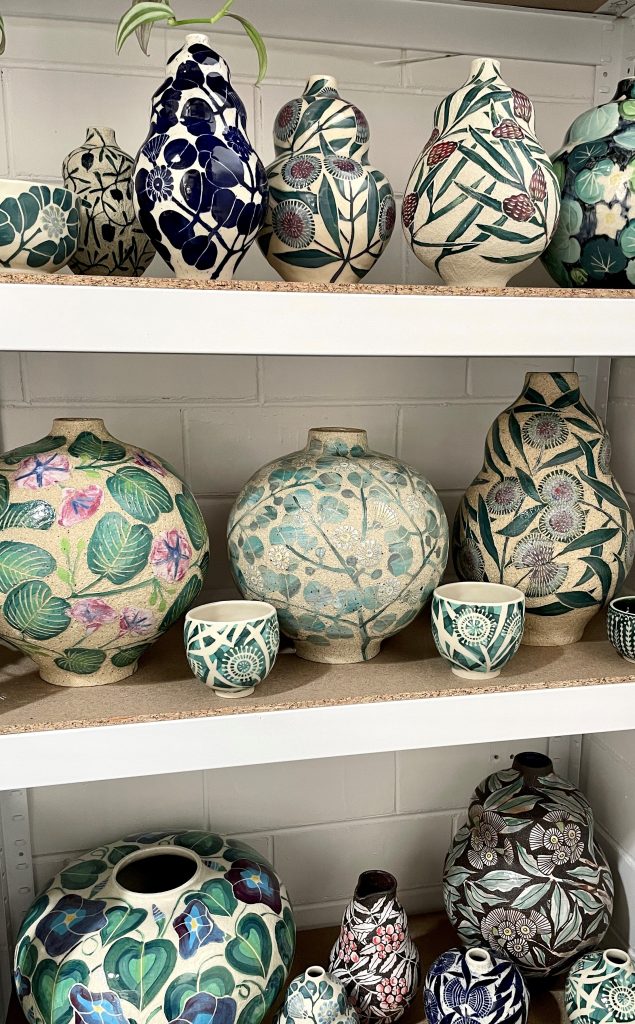
Where have some of your ceramics gone?
My work is held in private collections across Australia and in New Zealand, the United States, UK, the Netherlands, Germany, Singapore and Hong Kong.
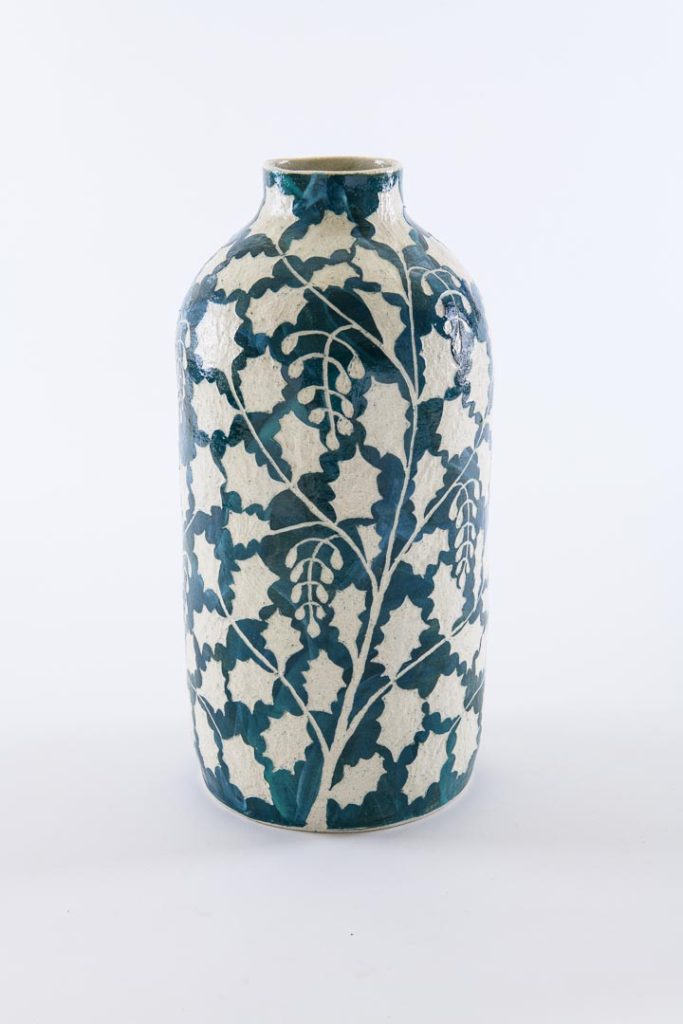
Holly Grevillea (Section 11: Through walking it is solved), H 37 x W 18 x D 18. Stoneware ceramic.
Where to next for you and your work?
My main goal is to keep developing my work in ways that excite me. I’m currently learning about glaze chemistry so I can produce custom glazes that bring different qualities to surfaces. I’m also on a steep learning curve about the business of ceramics, aiming to establish a sustainable rhythm of making and selling across the year. I’ll stay open to other opportunities to share my work through exhibitions. And I’ll keep hiking for inspiration – although right now, I have plenty to work on after recent hikes in Tasmania, the Northern Territory, and the south coast of New South Wales.
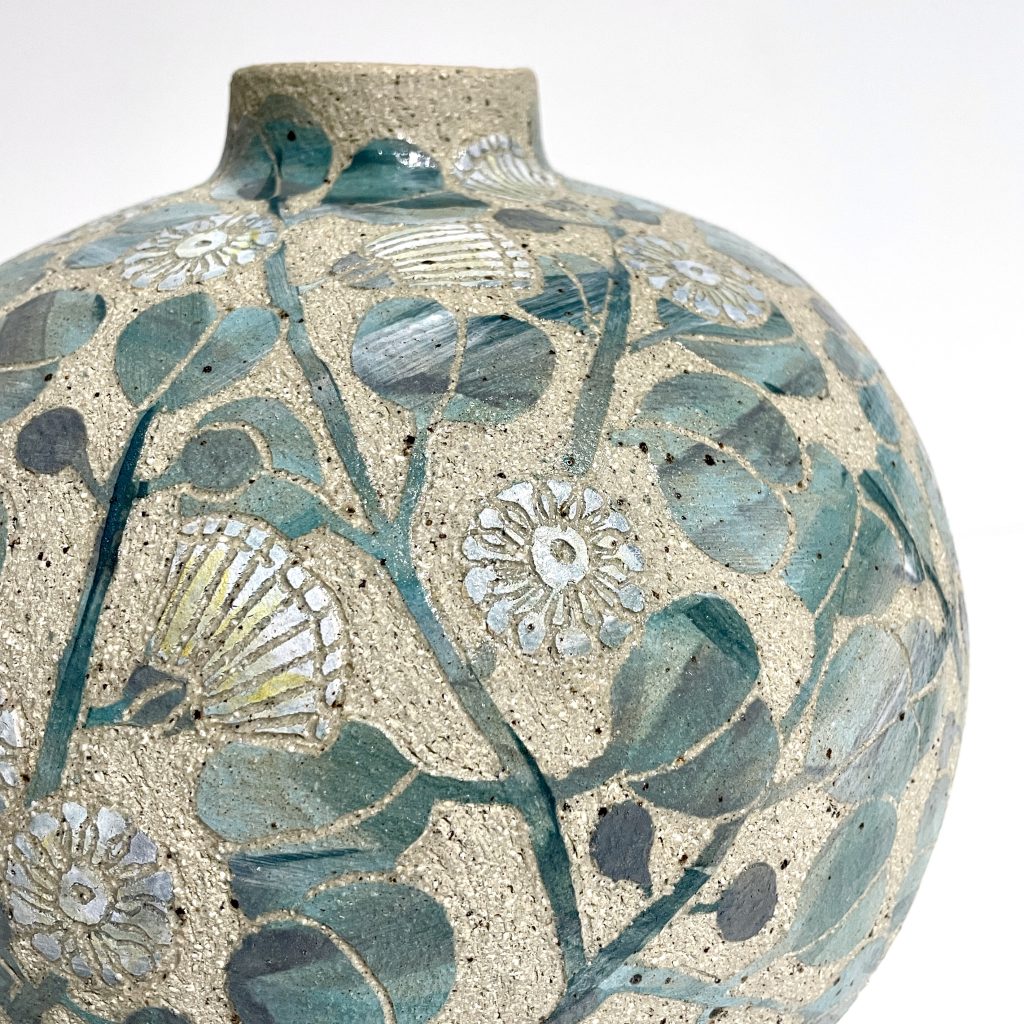
Round-Leaf Mallee (detail). Stoneware ceramic.
Contact:
Harlinah Teoh
harlinahteoh.com
harlinahteoh@gmail.com
Deborah Blakeley, Melbourne, Australia
Interview by Deborah Blakeley, September 2023
Elizabeth Becker
You make the interesting comment, “The watercolours have a life of their own, as they bleed together and slowly bloom, it is liberating to me – it is an act of letting go.” Discuss this comment.
How the watercolours bleed?
How do you find this liberating?
Why the unpredictability, does not frustrate you?
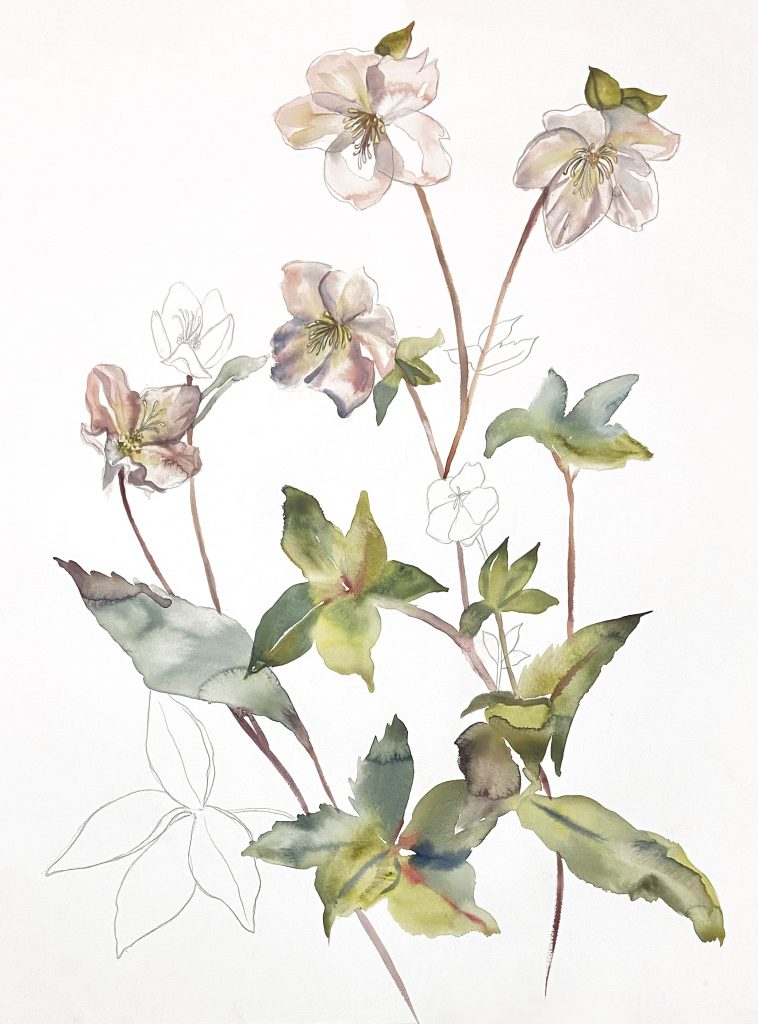 “Hellebore” no. 34
“Hellebore” no. 34
I fell in love with watercolour because of its ability to flow. I paint loosely and expressively with liberal water. I do not plan much, but instead work spontaneously and viscerally, letting feeling and intuition lead the way. I guide the paint, but I allow it to have a life of its own. This process is very meditative. It helps me to let go of control and embrace imperfections.
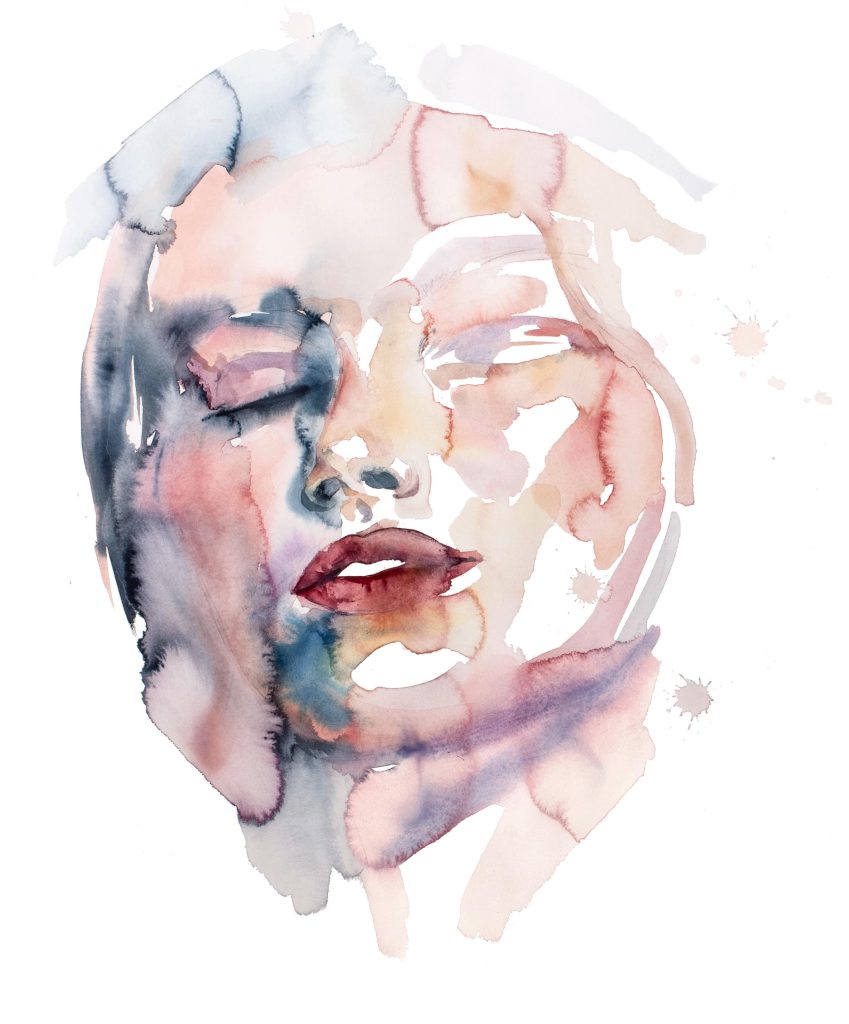 “Awareness” no. 2
“Awareness” no. 2
When one color touches another, they bleed together and create a beautiful effect. To me, painting with watercolour is a metaphor for life. You put your intention onto the page, just like you put your intention out into the universe, but you cannot control the results. It is a collaboration. The unpredictability has never frustrated me. Each painting experience is an experiment, and I am often surprised by the results, which keeps me excited about the process. Even when I have completed a painting, I do not know how it will look until it is completely dry.
Comment how the fusion of both your degrees, Art and Design and Psychology can be found in your, work.
Painting became therapeutic to me at a young age, both as an escape and a way to process my emotions. I have always had a rich inner world which led to my interest in Art and Psychology. Emotion is the most important aspect of my artwork. When I paint portraits and figures, I aim to capture the subject’s inner life and emotional state rather than to achieve a physical likeness. I keep a sense of abstraction and anonymity in my artwork, essence is more important to me than physical form. I hope to inspire a quiet contemplation in my viewers and to encourage them to connect with their inner spirit. I think my work can be therapeutic for that reason.
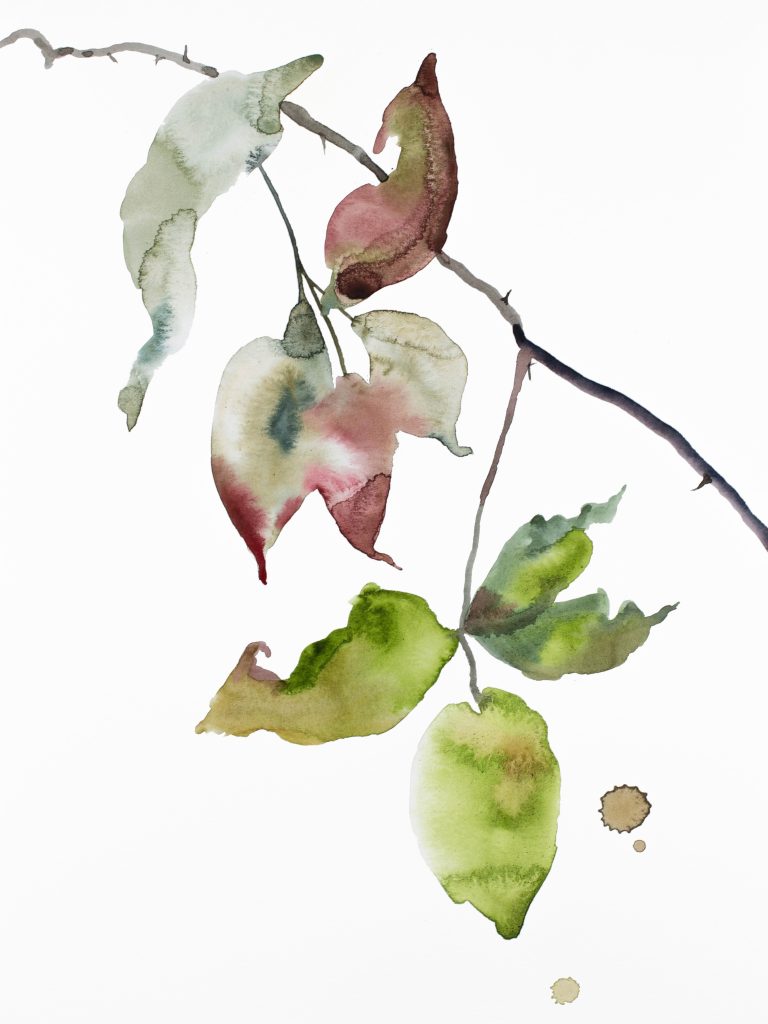 “The Woods” no. 136
“The Woods” no. 136
Many artists do not like to paint hands. Has your work in psychology drawn you interest to hands?
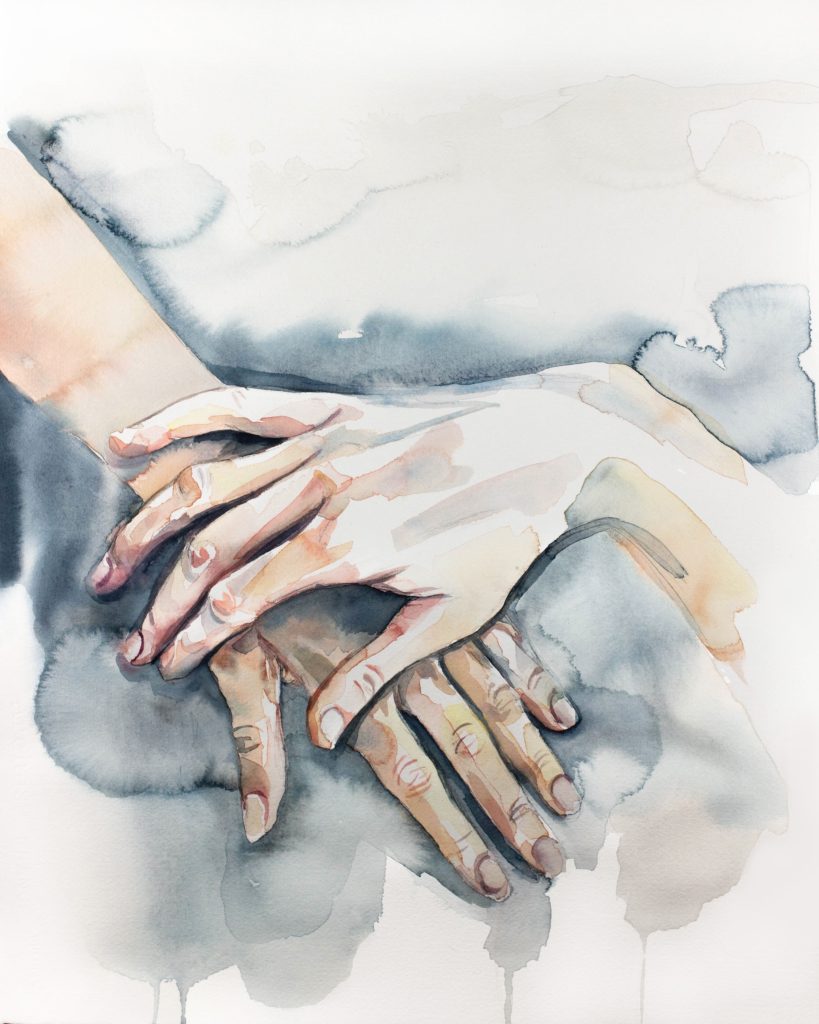 “Touch” no. 8
“Touch” no. 8
I think of hands as a type of portrait, and I like the challenge of painting them. As a sensitive person, I tend to pay attention to people’s body language.
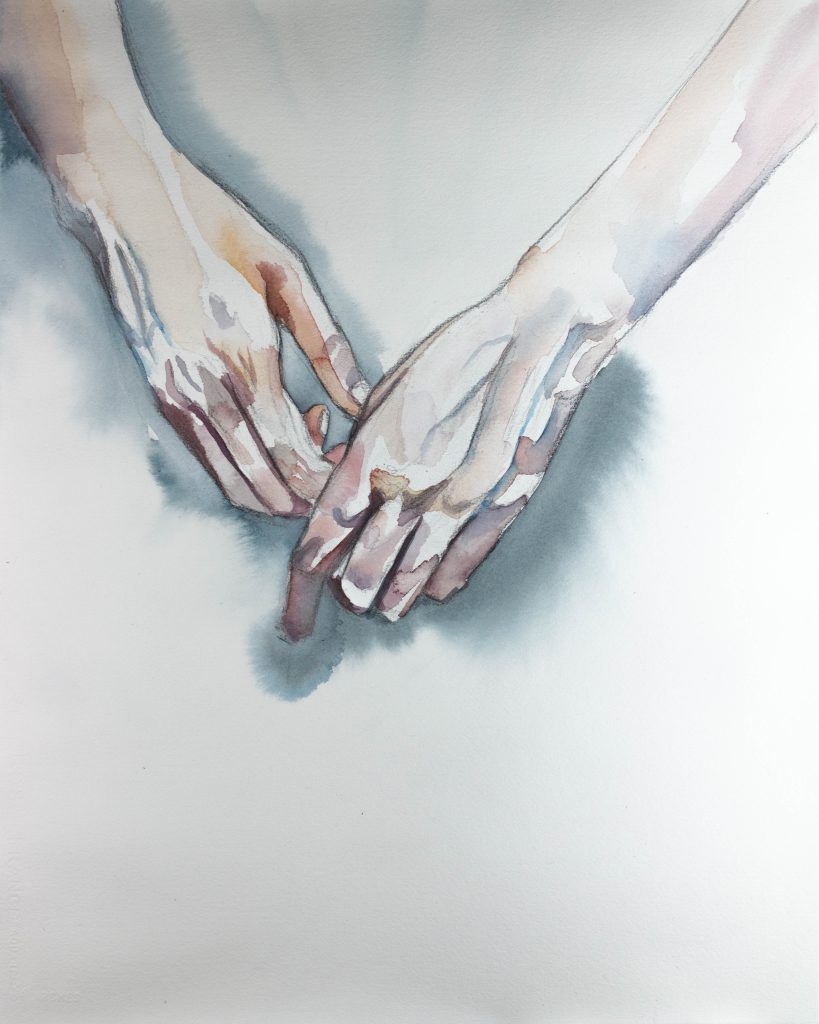 “Touch” no. 5
“Touch” no. 5
Our hand gestures communicate just as much as our words and faces, and sometimes they can be more telling about how we truly feel.
Explain about the construction of two of your works.
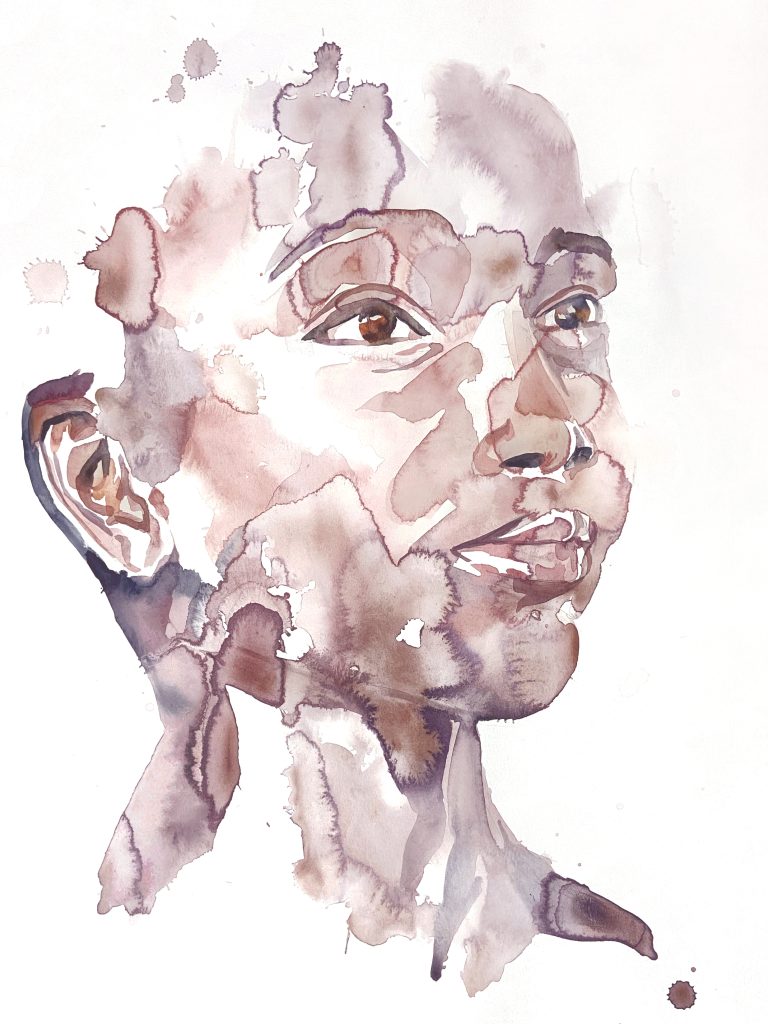 “Mend No. 9”
“Mend No. 9”
For this piece, I sketched the portrait in pencil first. Next, I squeezed water onto the page with a sponge, creating inconsistent puddles. Using my quill brush, I began to paint into the puddles of water, letting the colours bleed together. The first layer was very abstract. I added more details at various levels of drying, such as the eyebrows, nose, and lips, so that I could get some definition, but I still allowed the colours to bleed in some areas. Once the painting was completely dry, I added more details and edges that I wanted more control over, such as the eyes, ear, and outlines of the nose and mouth.
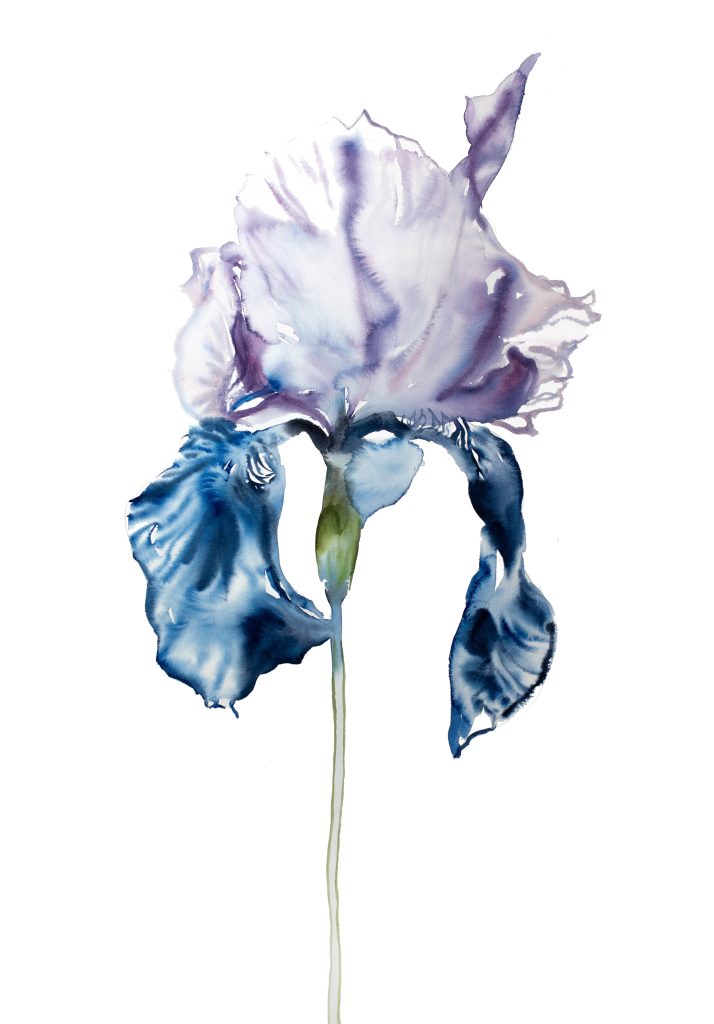 "Iris No. 67”
"Iris No. 67”
For this piece, I lightly sketched the shape of the flower. I mixed my colours on my palette. The top petals are Prussian Blue mixed with Alizarin Crimson and the bottom petals are Prussian Blue mixed with Payne’s Gray. The stem is Yellow Ochre mixed with Prussian Blue. I loaded my quill brush with water and only put water inside the flower. Then I started dropping paint into the water, allowing it to flow. As the paint was drying, I dropped clean water into it to create more blooming effects. At different stages of drying, I added more details, like lines in the petals and outer edges.
Does your location influence your work, especially your leaves.
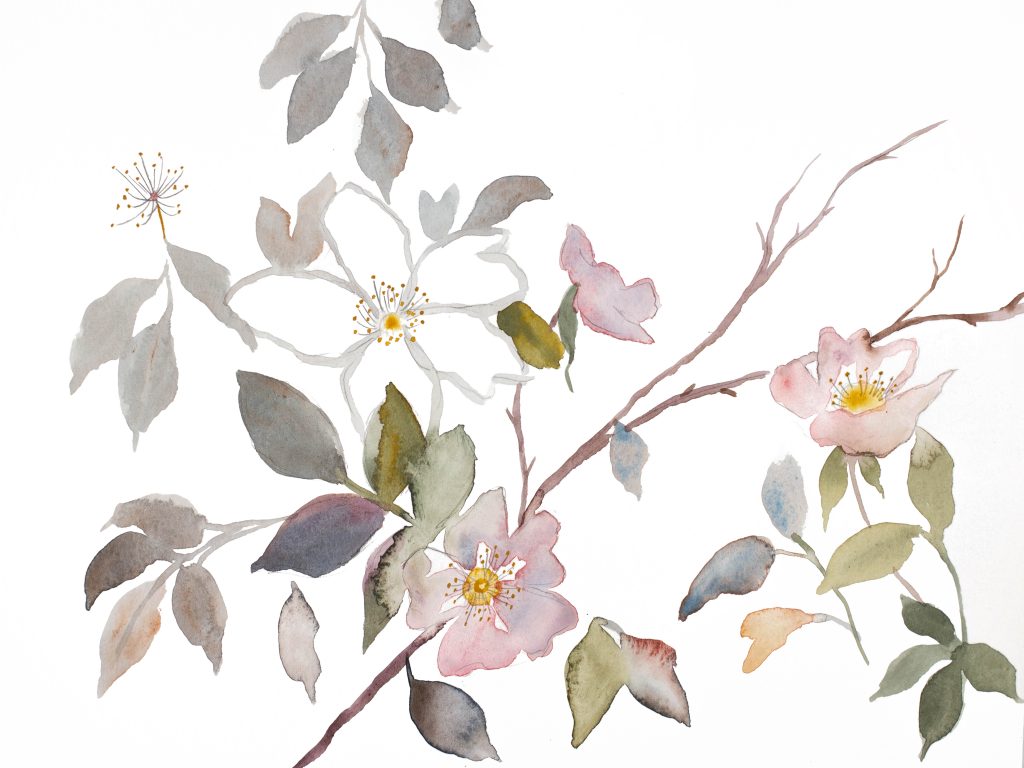 “Wild Rose” no. 20
“Wild Rose” no. 20
Yes, I live in the forest beside a state park and gather inspiration from the nature around me. I have a strong spiritual connection to nature that strongly influences my artwork. Sometimes I paint from life in the forest or in my backyard. As I am hiking, I also take photographs that I use as references.
How do you see your work in comparison to Botanical art?
I consider my paintings of flowers and plants to be Botanical Art. I am inspired by traditional botanical illustrations, but my work is a more loose and modern interpretation. I aim to capture the essence of plants and the emotions I feel when looking at them, rather than a scientific portrayal. I like to blend representation and abstraction in my work, because I believe the use of abstraction gets us closer to the way things truly are, not just how they appear.
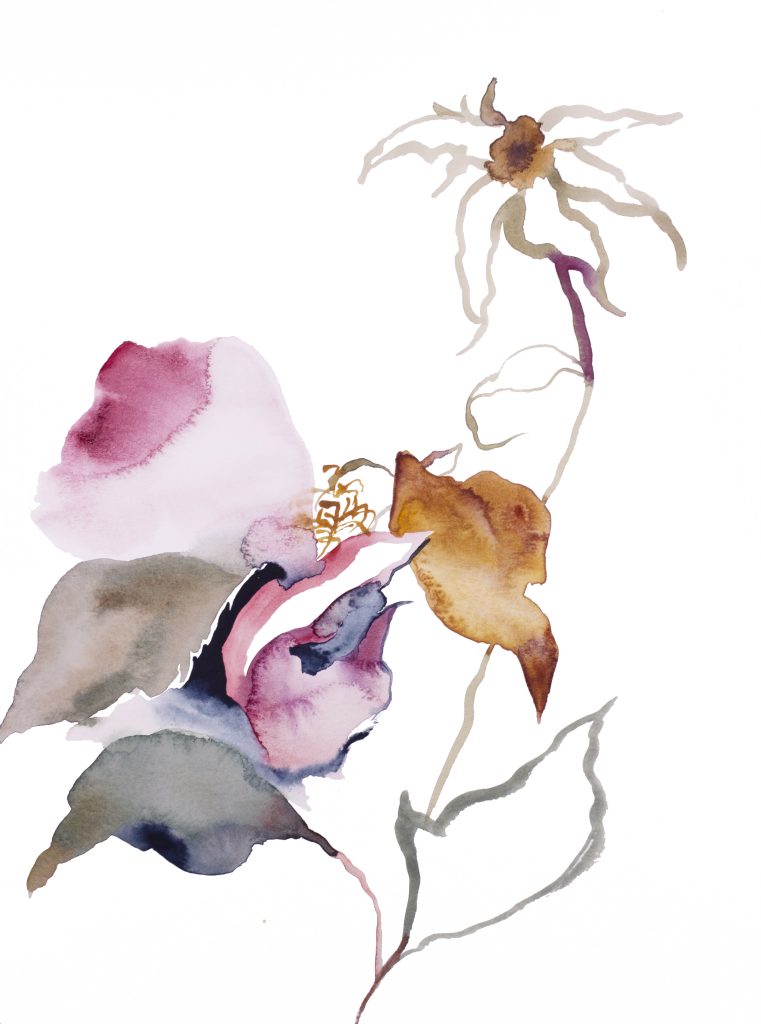
“Rose Study” no. 53
Can you expand on your bird paintings using several to illustrate this?
I have always felt a spiritual connection to birds, and I love what they represent. When I paint birds, I am trying to evoke a sense of freedom and hope. Flying swallows have always been special to me. I especially like to paint them in pairs, like,” to symbolize relationships.
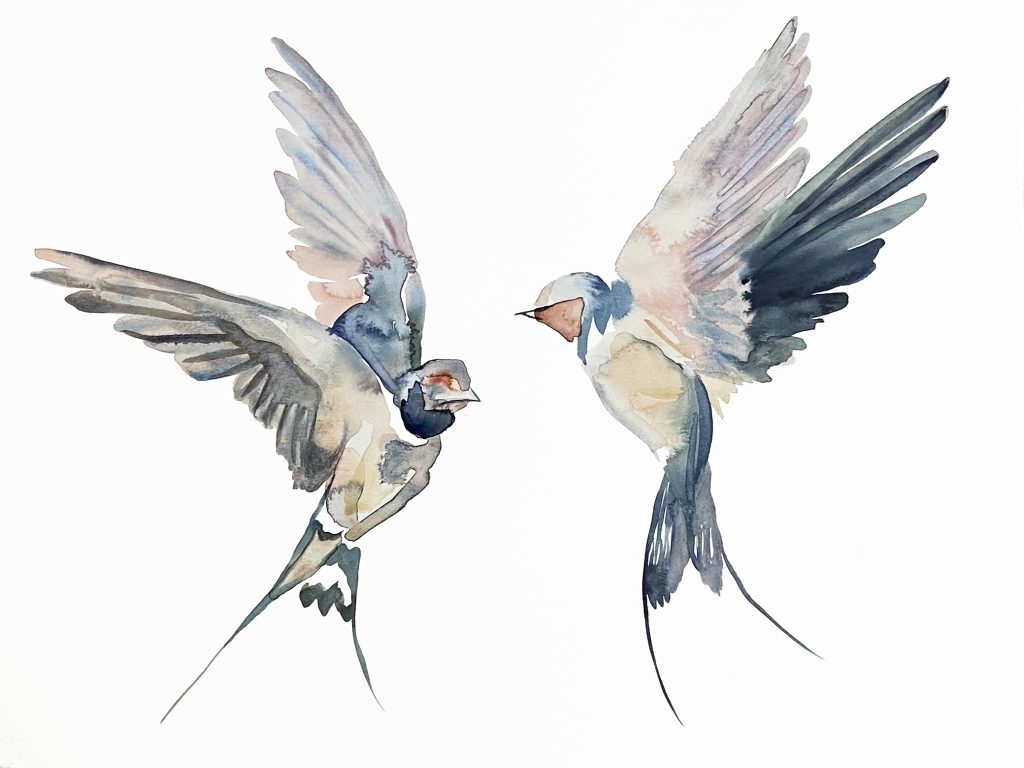 “Swallows in Flight No. 43
“Swallows in Flight No. 43
Herons are another bird that I love to paint and see a lot of in my area. We have a heron that flies over our house every evening. To me, they symbolize elegance, wisdom, and solitude. I hoped to capture these qualities in my painting.
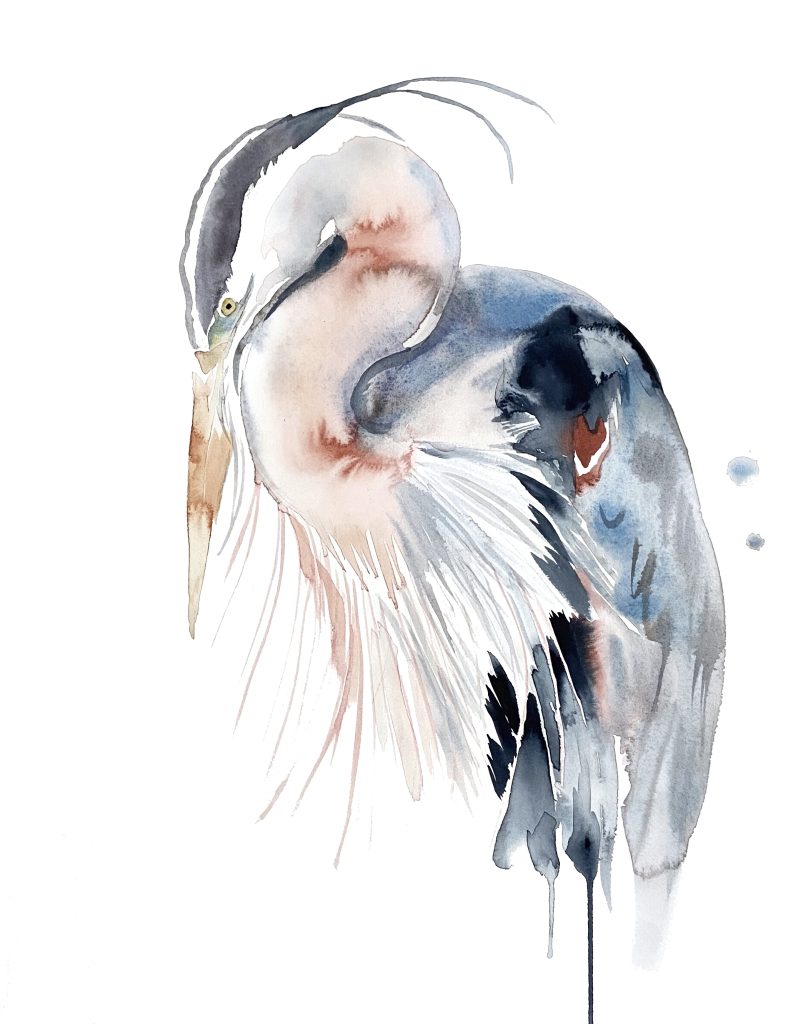 “Heron No. 10.”
“Heron No. 10.”
You also paint flowers that have reached their peak. Discuss.
I paint flowers in various phases of their existence. I tend to keep flowers in my home well after they have peaked, and I have always been drawn to flowers that are wilting and dying. As an artist, I look for beauty in uncommon places and hope to inspire others to reflect on things that we tend to overlook. Plants that are past their peak are just as beautiful to me as flowers that are in full bloom— sometimes more so. Looking at them inspires an emotion in me.
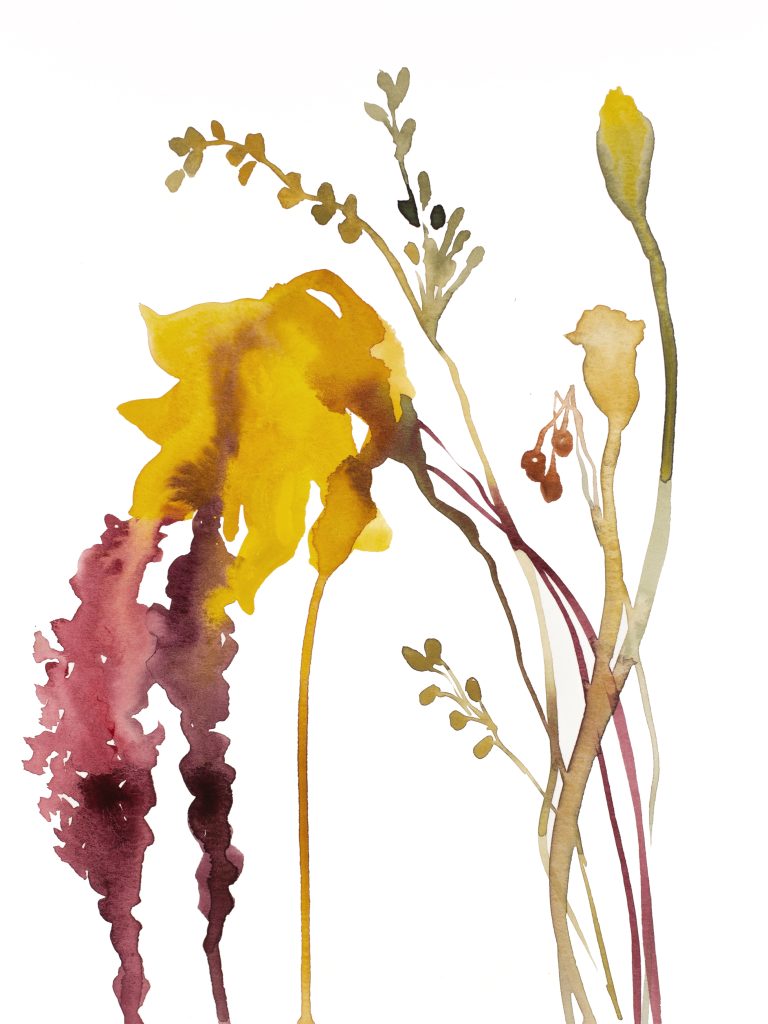 “Autumn Bouquet” no. 2
“Autumn Bouquet” no. 2
A blooming flower can bring joy, but a flower that is withering can bring a sense of empathy to feelings of sadness and grief. They remind us that life is fleeting; everything changes, and everything passes. It is important to not only focus on happy emotions, but the full range of emotions that we experience as humans. Happiness is a only a small fraction of our feelings. That is why I like to celebrate the full range of a flower’s life and death, not only when it is at its peak.
Meadow flowers are taking the headlines and are everywhere. Are they easy to paint?
Their fragility…
Mass plantings…
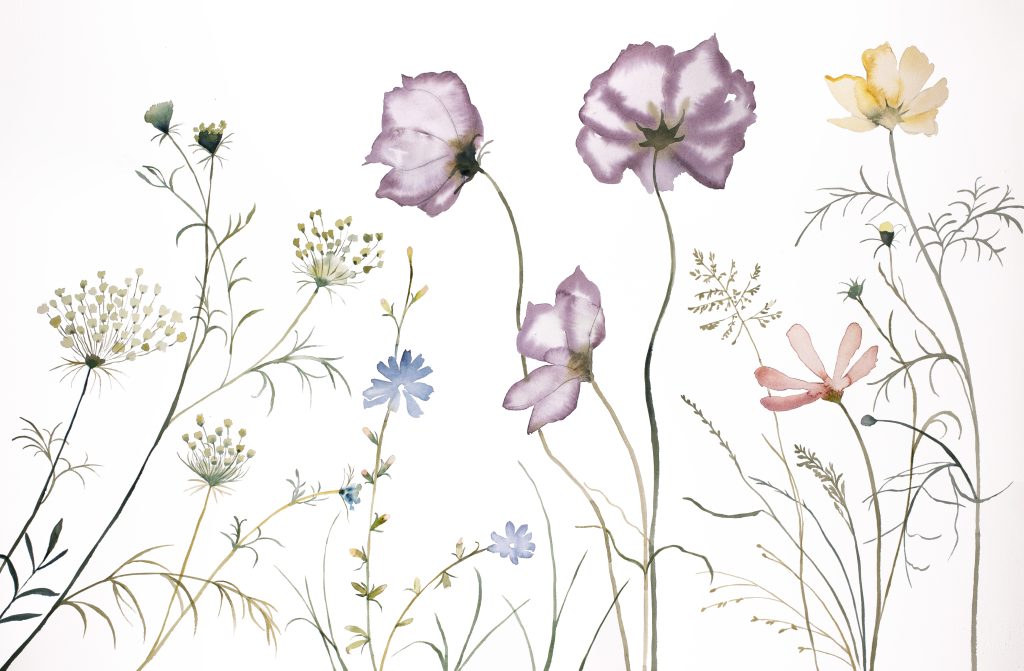 "Meadow Study" no. 10
"Meadow Study" no. 10
Meadow flowers are very delicate and intricate, so they take more time to paint, especially when I am painting a field of them. My painting process is different for these. Instead of painting loosely, I take time to capture minute details, which takes focus and patience. To me, meadow flowers, such as Queen Anne’s Lace, symbolize fragility and take me back to memories of childhood summers.
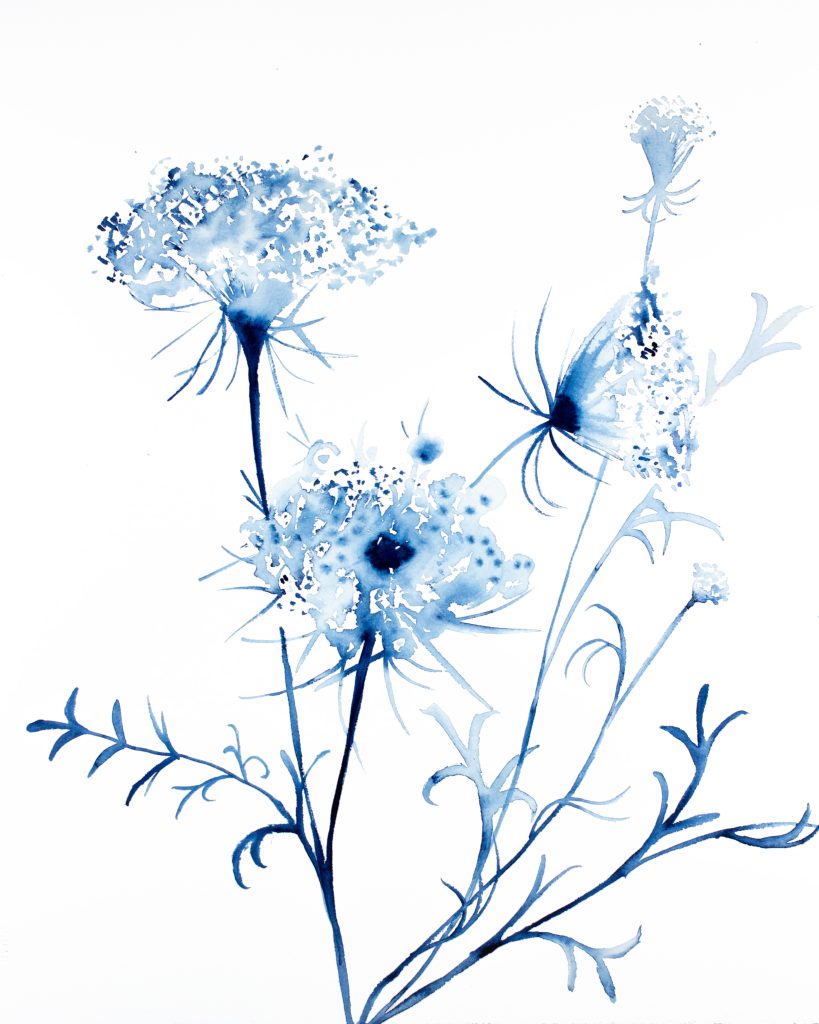 “Queen Anne's Lace” no. 2
“Queen Anne's Lace” no. 2
Your, In-Room gallery is exciting. How did it come about?
I recently began using an app called Canvy that allows artists to create mock-up images of their artwork installed in rooms. It is exciting to visualize how an artwork can look when hanging in a room and to personally choose its environment.
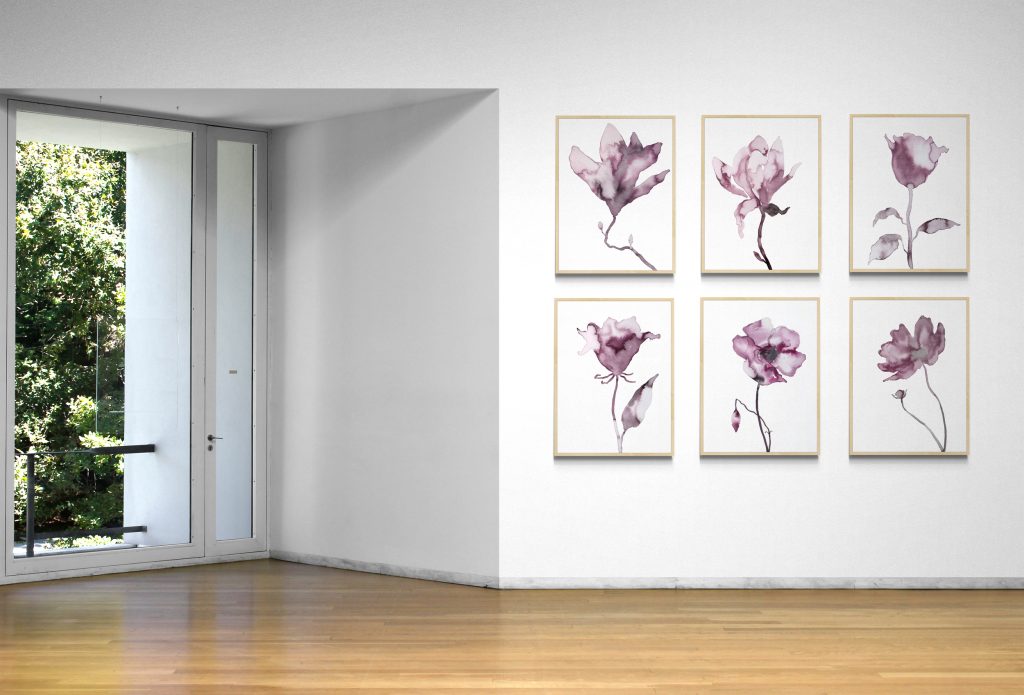 Ink Florals
Ink Florals
Does this presentation of your work, help to show the size and other possibilities?
Yes, it is helpful for collectors to see what the artwork looks like when fully framed and hanging in a room.
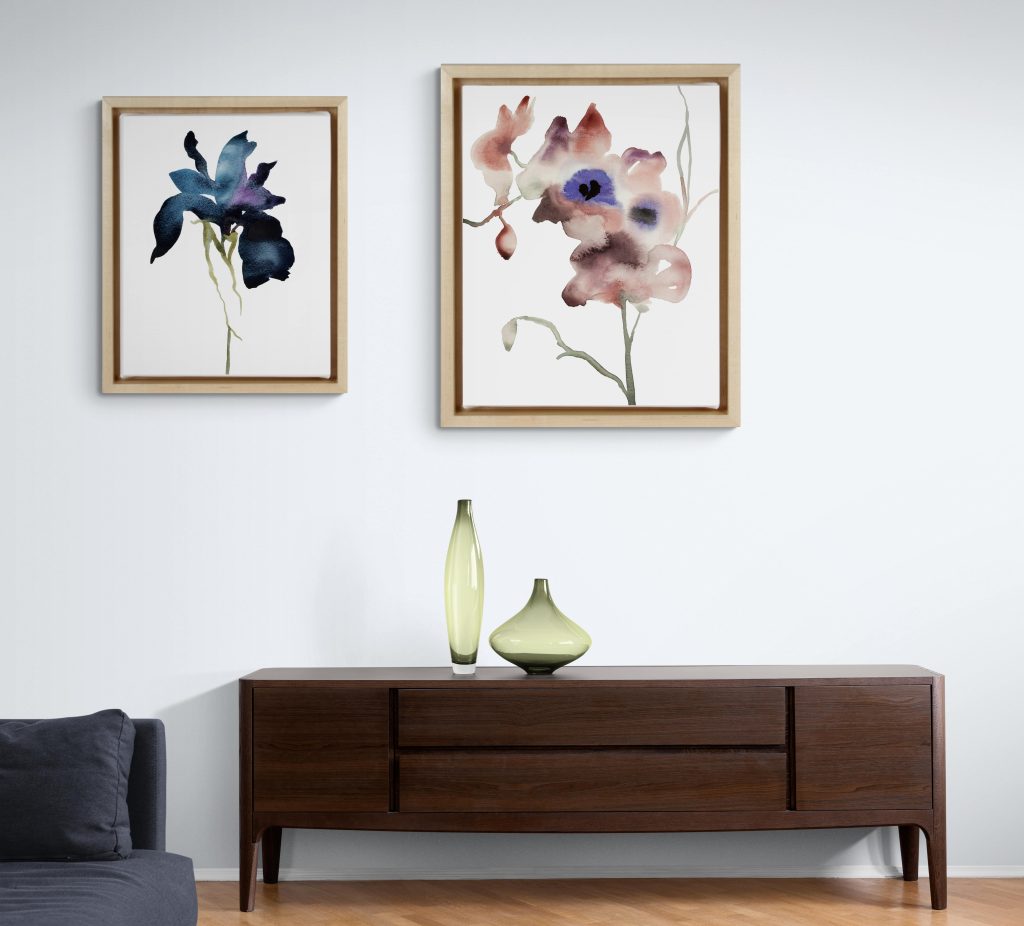 Iris no.1 & Orchid no. 6
Iris no.1 & Orchid no. 6
It shows the size of the work in relation to the wall and other objects. It also inspires ideas of how they could display the piece in their own home.
What is the largest work you do? What are the restrictions you face?
My largest watercolour painting was 36” x 76.” I can get watercolour sheets up to approximately 29.5” x 41.” If I want to paint larger than that, I need to buy a watercolour roll. The largest rolls are 51” x 10 yards, so one edge of the painting cannot be larger than 51.” If I need a larger surface, I can always use canvas. There is a watercolour ground that you can paint onto the canvas if you want to make it more absorbent like watercolour paper. However, the technique and effects are not the same and I prefer working on paper.
You also have some of your watercolours transfer onto canvas, discuss this.
I take high-resolution photos of my watercolour paintings. I send the photos to a third-party printing service who prints them onto canvas using the giclée process.
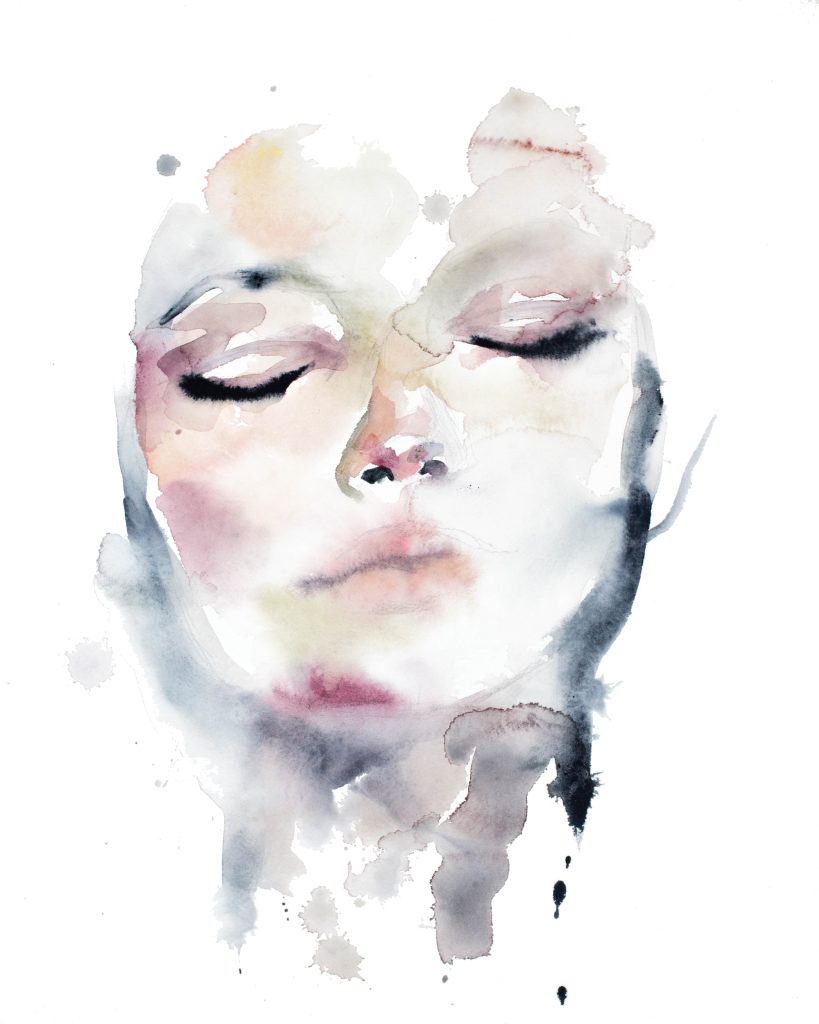 “Dissipate”
“Dissipate”
Discuss one commission that has had an influence on your work and why?
I had a large-scale commission that challenged me to paint larger than I have ever worked before. It gave me the skills and confidence to know that I can paint on a larger scale.
Contact:
Elizabeth Becker
https://www.elizabethbeckerart.com
Deborah Blakeley, Melbourne, Australia
Interview by Deborah Blakeley, September 2023
Ingrid Weyland
Your current work emphasizes climate issues, comment.
Initially, I was mostly a portrait photographer, although nature was always present in one way or another in my work. The turning point was a trip from the south of Argentina to Greenland's ice sheet. I forged an intimate connection with these vast, unspoiled, surreal, and immense landscapes that seemed to me to contain their own particular mood and beauty. On a return trip to Greenland some years later, I was overwhelmed by the changes that had taken place since my first visit in 2015. I noticed with sadness how people failed to adhere to regulations, not respecting boundaries, and it started showing on the landscape in the extreme south to the extreme north.
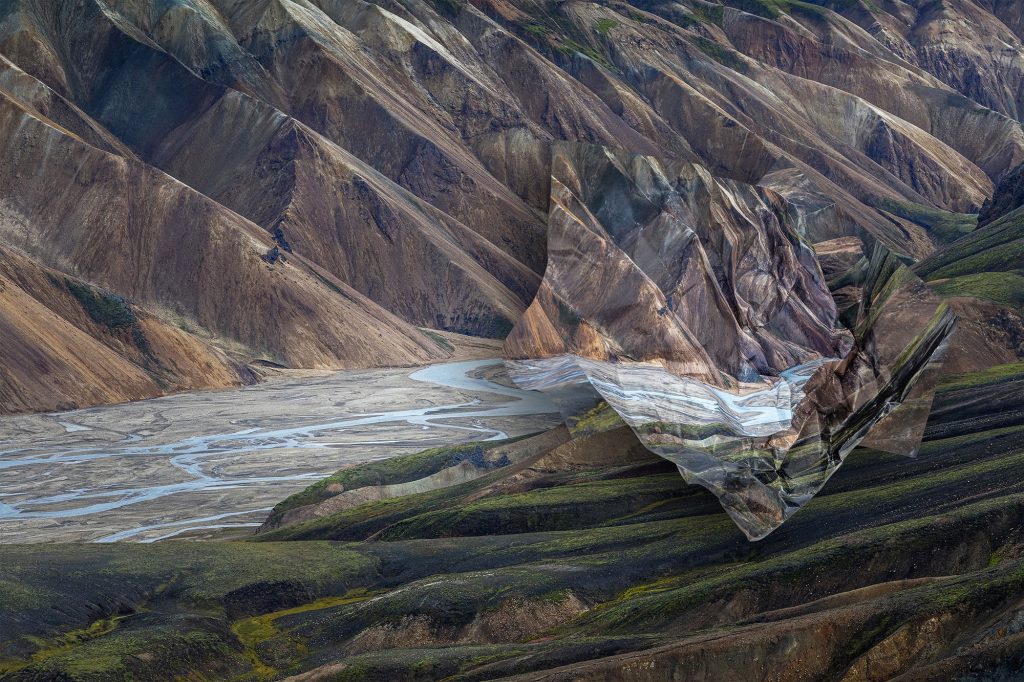
Topographies of Fragility II
This exact moment marked my urgency to inspire change. I sensed that simply showing beautiful sceneries was not enough; I wanted to find a way of conveying both beauty and decay at the same time. I wanted my work to remind people of their impact on the planet and to make them stop and think about what we stand to lose as a result of climate change.
Discuss how in your work you use photography and the perception what is real and what is manufactured.?
I believe “expanded photography” allows viewers to spend longer observing and interacting with my art. They may feel a strange sensation inside, and on a second viewing, they may see the scene in a different light. This is all part of the process of understanding what is happening before their eyes and that there is something to discover within the image.
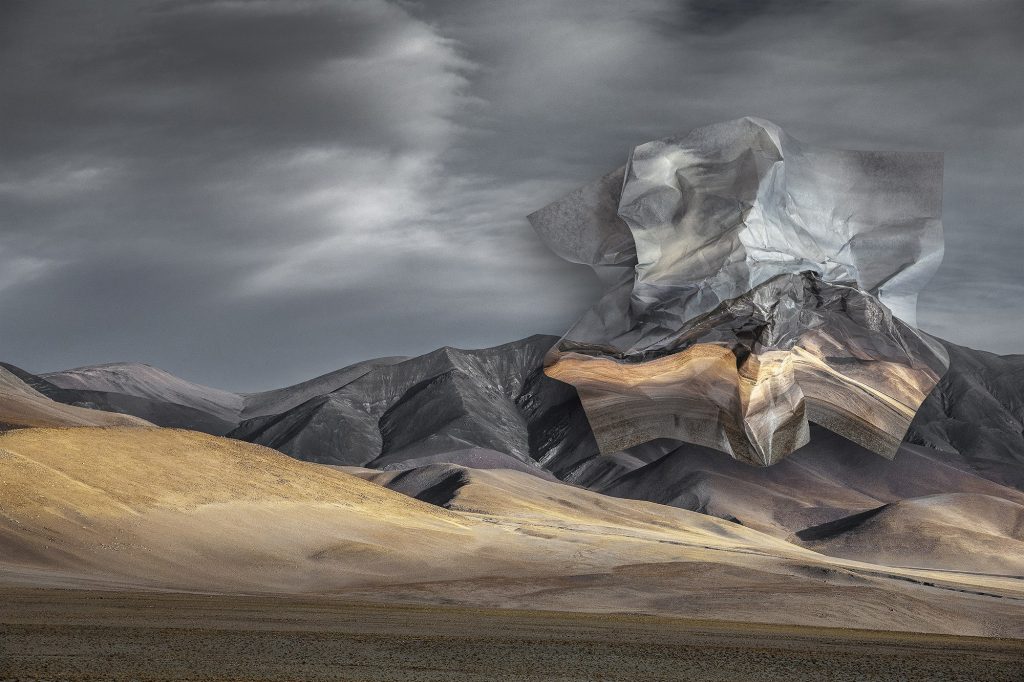
Topographies of Fragility IV
This suspended time between observing and processing what is in the image before their eyes allows the viewer to feel and think of their own experiences in nature and with their surroundings. I believe this is what my art does: it requires active participation from the viewer.
Take three different environments you have transposed, Rainforest, Desert, and Ice fields in your recent series, Topographies of Fragility.
My current work doesn’t focus on specific local environmental issues but rather serves as a metaphor for the fragility of nature, as well as the fragility of humanity itself.
The images from Topographies of Fragility were initially chosen among my archive of images from my travels, and I think these are the kind of environments that I identify more with, where I can feel this strong connection. Icebergs, remote, isolated locations have always interested me.
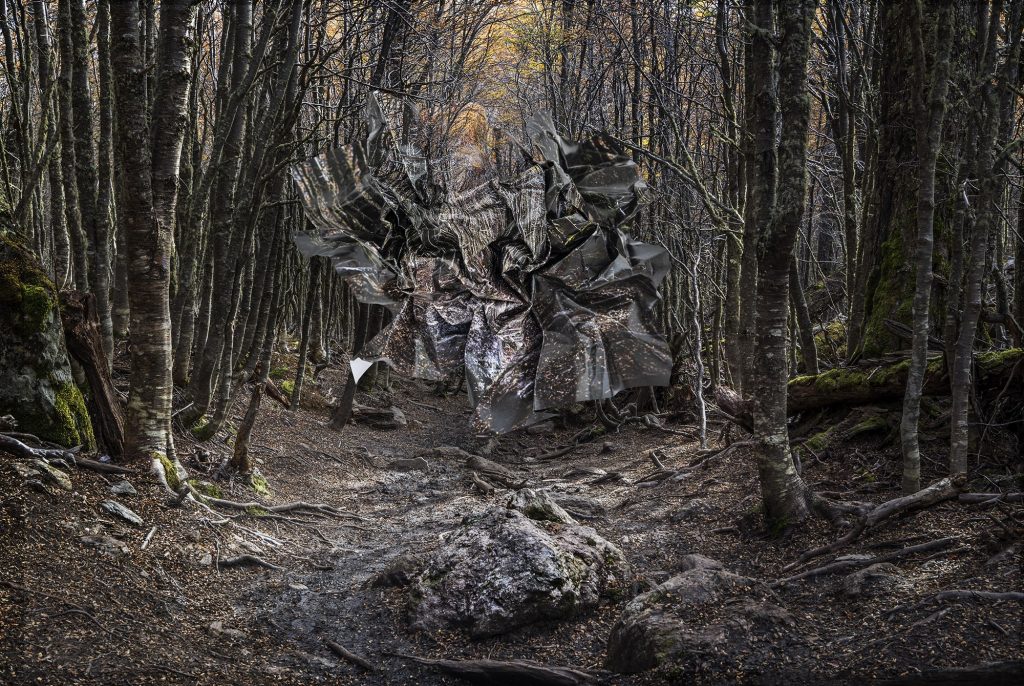
Topographies of Fragility IX
The Arctic and Antarctic areas play vital roles in the future of climate change, as they both help keep our planet’s climate in balance. Although I have not yet visited Antarctica, it has been my dream in recent years.
By intruding into the photographed landscape with crumpled paper you are showing ‘…disrespectfully, invaded is forever broken’ discuss.
The recurring theme in my work is that we are all connected: nature and humans together. The driving force behind my work is a desire to highlight the relationship between humanity and the environment. Humans fail to take care of the planet, but nature can also be violent in return. There is a link in this conflict; there is a cause and effect.
Thus, I started thinking about the vulnerability of nature and began to work on enacting violent gestures on my landscape images, reshaping them until they became something altogether different. In the same way, we humans alter and damage our environment with sometimes irreversible consequences.
There is something compelling in the fact that my own hands “perform” this damage on my own photographs of places of pristine beauty.
It is said that a crumpled piece of paper can never regain its original shape; the trace persists. In the same way, nature which is disrespectfully invaded is forever broken, and many times unrecoverable.
Your work ‘Eye of Fire’ was different from ‘Topographies of Fragility’ rather than adding you have removed part of the image, using flame, comment.
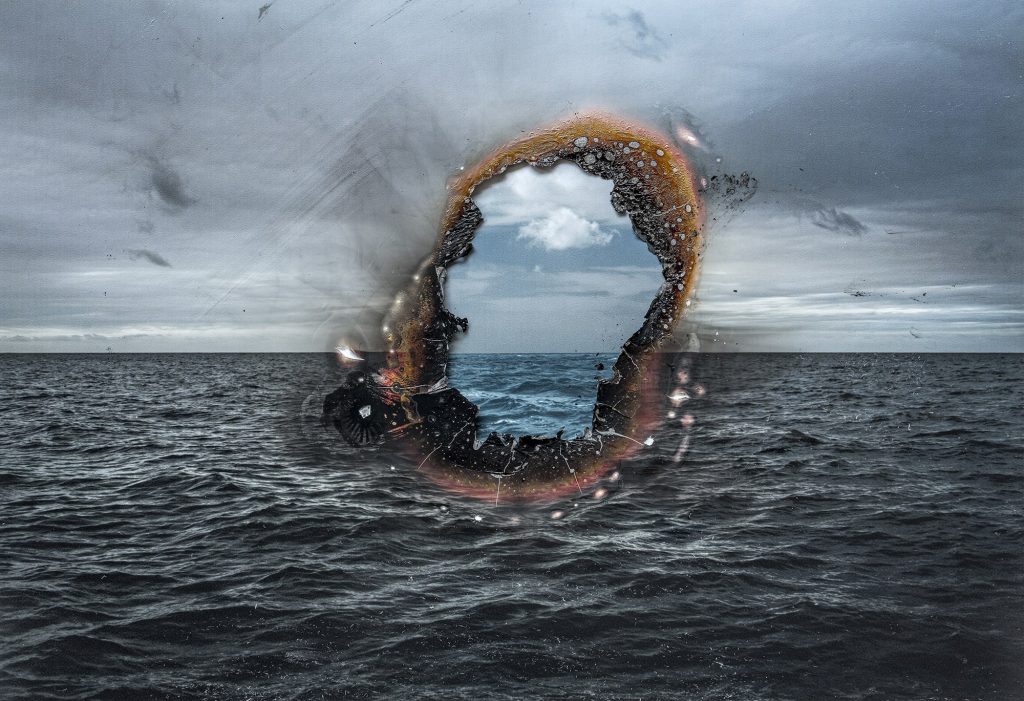
Eye of Fire I
While I was working on Topographies of Fragility, I started thinking of new and different ways of altering or destroying my printed images. After one of the great fires in Patagonia, I thought that maybe I could also try to burn some of the landscapes and leave a "window" or an "eye" through which one could get a small glimpse of what the untouched landscape should look like or used to look like.
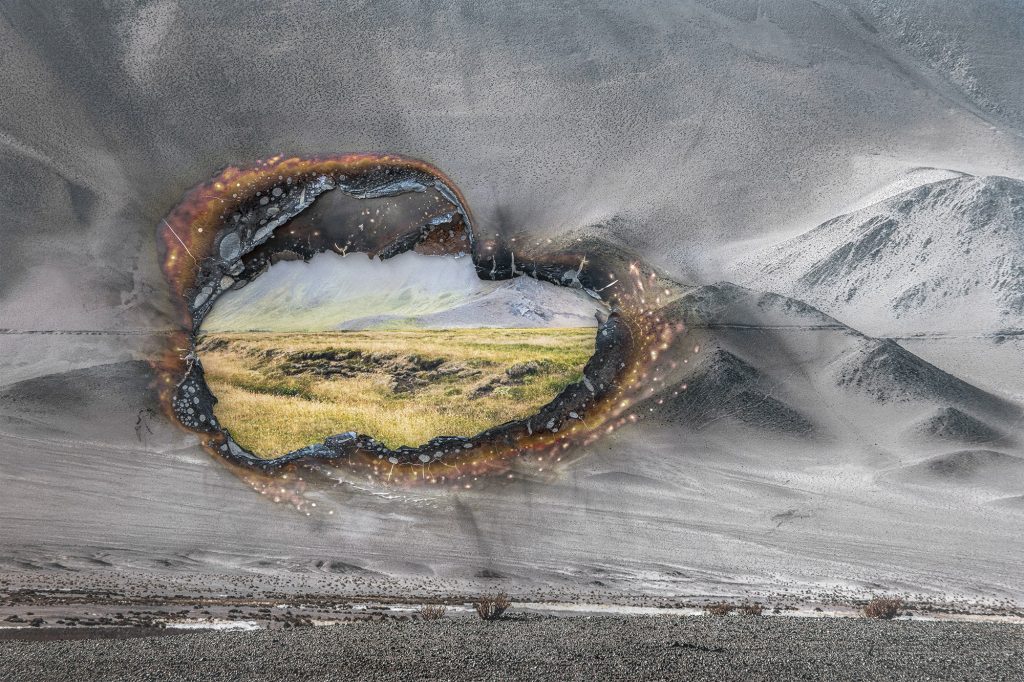
Eye of Fire III
The hypnotizing quality of fire has always attracted me, one can stare at it for hours, yet this same fire burns forests and this is happening more and more frequently across the world. This is practically the same action, to burn paper and watch how it burns, deforms, destructs and transforms the colors and texture of what was before untouched nature.
Around that time, there was an explosion because of a gas leak at a marine platform in the Gulf of Mexico, and I watched in the news fire blazing straight out of the middle of the sea and imagined the damage caused to marine life. This led to my first "Eye of Fire" artwork.
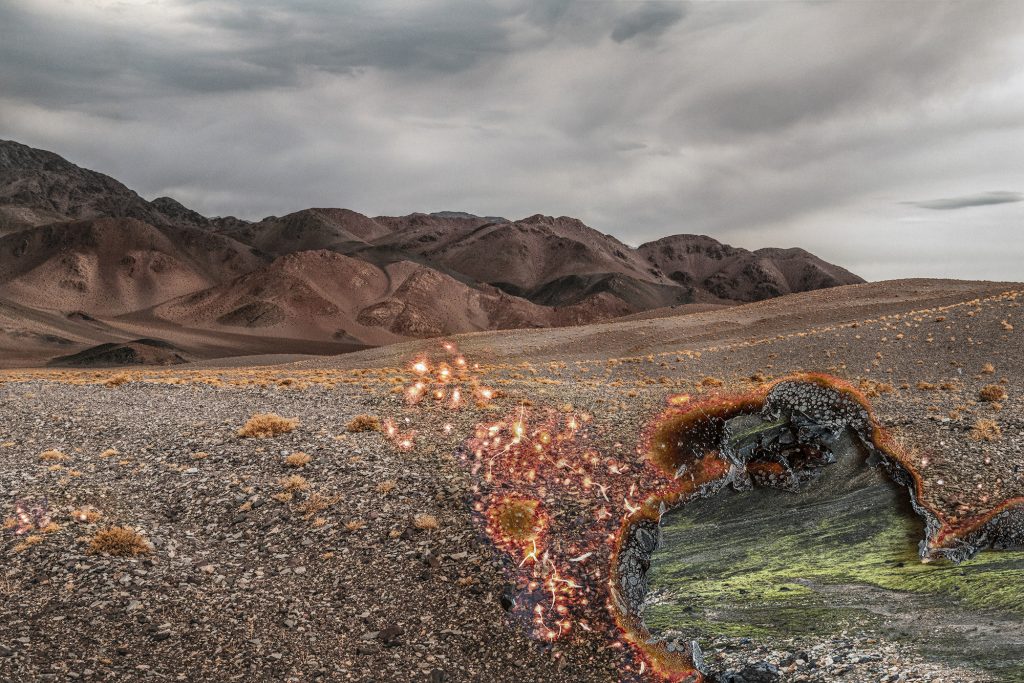
Eye of Fire II
You have travelled widely, take three landscapes that have haunted you and why?
While I was working on Topographies of Fragility, I started thinking of new and different ways of altering or destroying my printed images. After one of the great fires in Patagonia, I thought that maybe I could also try to burn some of the landscapes and leave a "window" or an "eye" through which one could get a small glimpse of what the untouched landscape should look like or used to look like.
The hypnotizing quality of fire has always attracted me, one can stare at it for hours, yet this same fire burns forests and this is happening more and more frequently across the world. This is practically the same action, to burn paper and watch how it burns, deforms, destructs and transforms the colors and texture of what was before untouched nature.
Around that time, there was an explosion because of a gas leak at a marine platform in the Gulf of Mexico, and I watched in the news fire blazing straight out of the middle of the sea and imagined the damage caused to marine life. This led to my first "Eye of Fire" artwork.
Nature is full of surprises for the viewer to see, discuss this in respect to your photography and how you highlight them.
Visually, my projects aim to convey a sense of silence through imagery, a time for contemplation and introspection. For me, nature has always been a "safe" personal place, and I offer that to my viewer as well as they take a moment to look at my work and see what emotions it arouses in them.
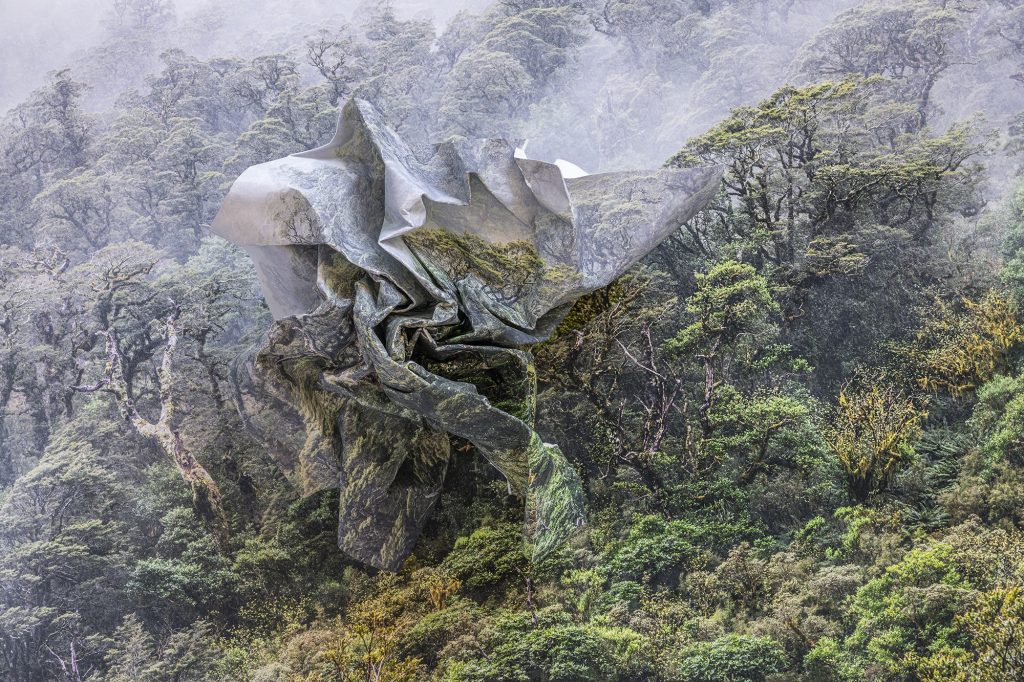
Topographies of Fragility V
You come from an artistic family in Argentina, how influential has this been to your career choices?
I mostly lived with my grandparents. My grandfather was an architect, and my grandmother a sculptor; they both also painted. I grew up among colored pencils, art papers, blueprints, inks, and clay. My passion for form, image, and composition arose from them. This led me to study Graphic Design at the University of Buenos Aires.
You have had many, exhibitions in New York – Are the ‘New Yorkers’ more receptive of your work?
I could not affirm that New Yorkers like my work more than other states in the US do, but Klompching Gallery received me and my work with open arms; the owners are very professional and hardworking people. I also felt a very generous and warm welcome from within the artist community in the US; I have made quite a few friends, it was a very grateful surprise for me, and I treasure it.
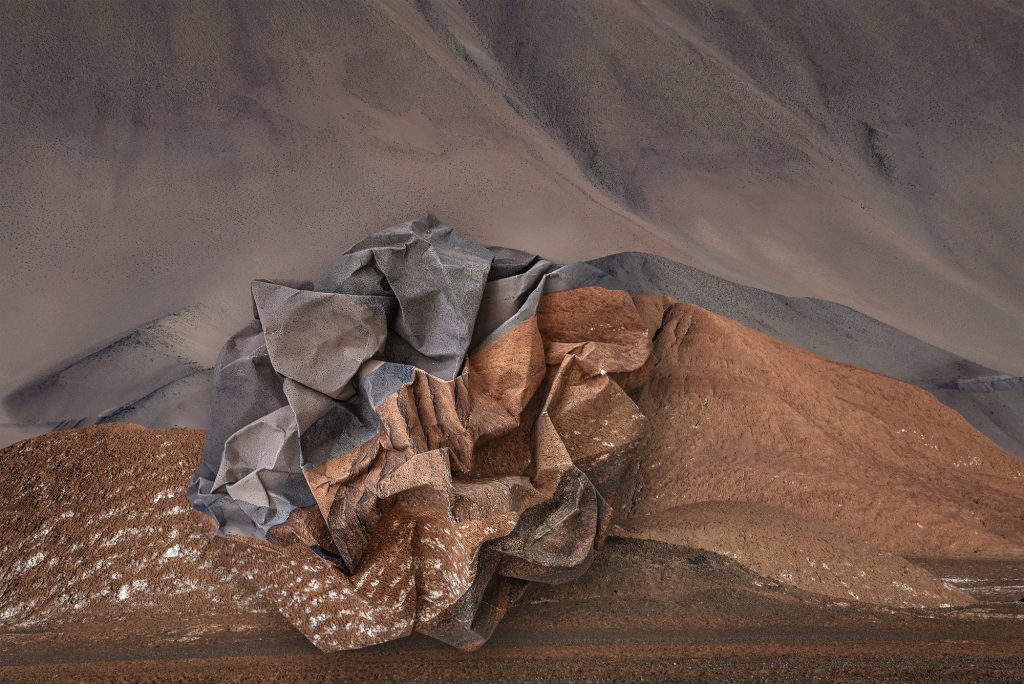
Topographies of Fragility XXII
How large are most of your photographs?
Most of my photographs are 100 or 120cm large (on the longest side), but I intend to make larger ones in the near future. It is my dream to be able to exhibit huge artworks, and I have also been working on crumpled paper sculptures to show with my photography.
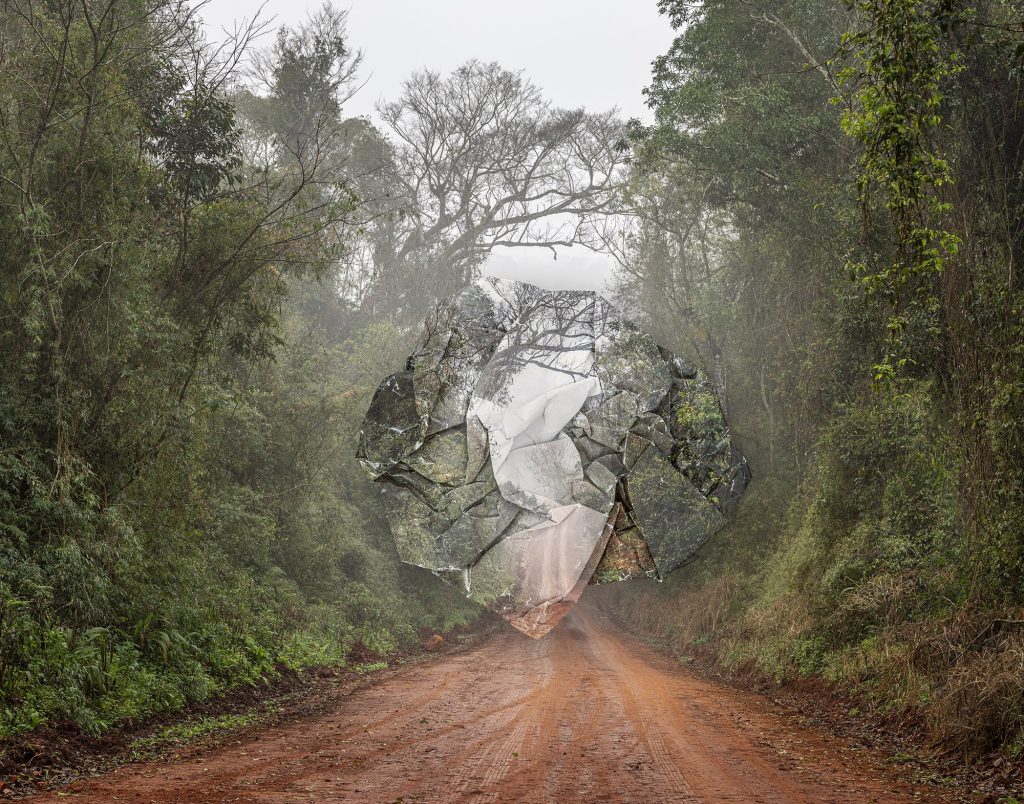 Topographies of Fragility XXIV
Topographies of Fragility XXIV
Do you often groups photographs for sale in series?
I think that you can talk about a "body of work" only after you have several photographs that work together cohesively, that talk about the same thing. In this way, the message you are trying to convey becomes more powerful. So, yes, I usually work in series.
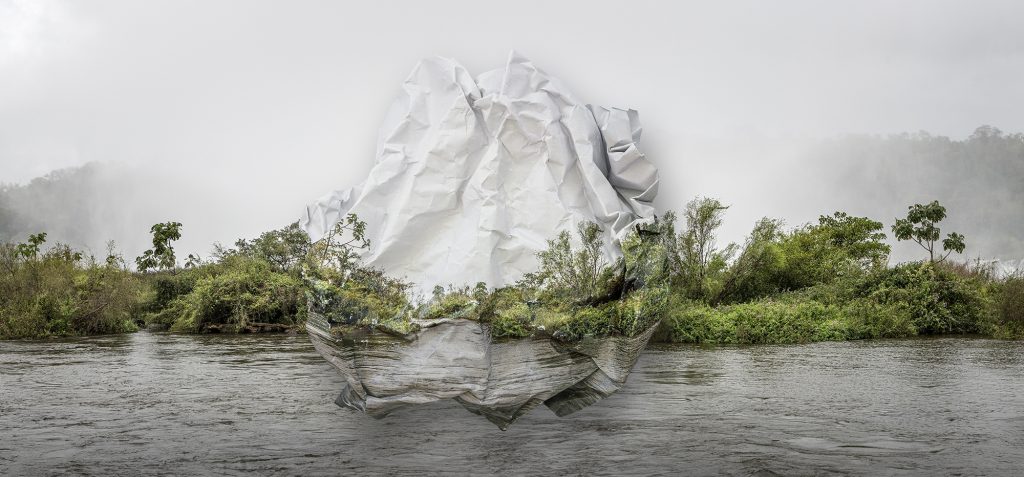
Topographies of Fragility XXV
What is you edition limit?
I work with an edition of 7 prints per artwork.
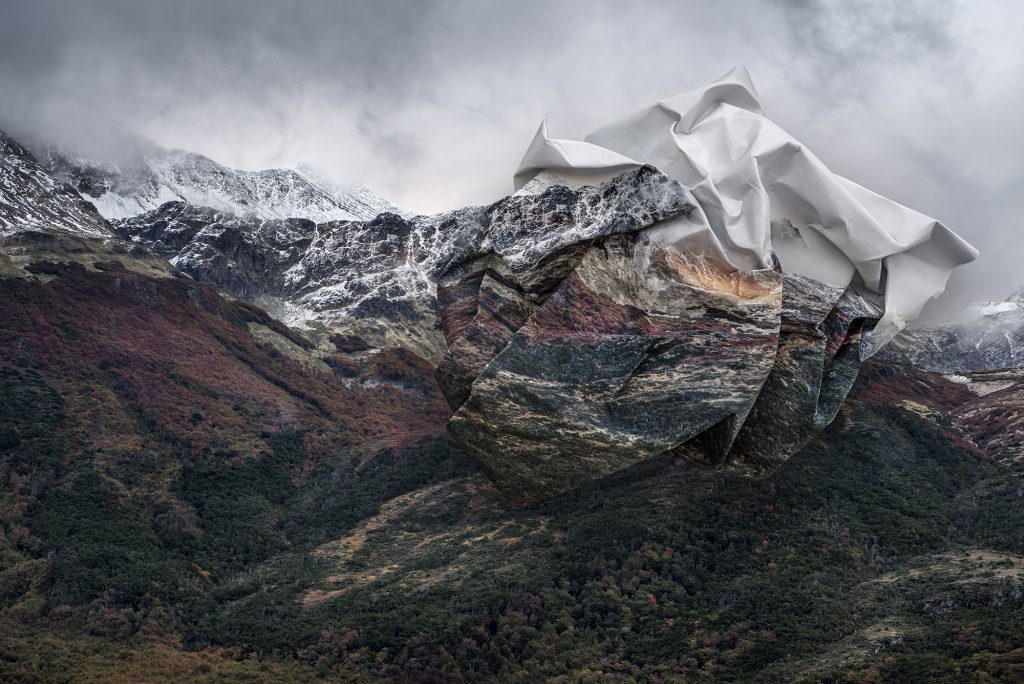 Topographies of Fragility XXXI
Topographies of Fragility XXXI
How many countries have you exhibited in? How have a few come about?
I have exhibited in the US, Canada, England, Portugal, Germany, Spain, China, Uruguay, and Argentina, of course. Most, if not all of them, have come about from Open Calls. In 2020, I committed to applying to art open calls at least once or twice a month within that year, and after this, things started to happen for me. I am so grateful!
Topographies of Fragility XXXIII
Comment on having a billboard with your work in Canada. Also, the importance of promotion of your work in ways like this?
In 2020, I was one of the Finalists of the Exposure Photo Festival in Calgary, and having the images on Billboards was part of the whole program of the Festival. I was delighted to see one of my images displayed in the city!
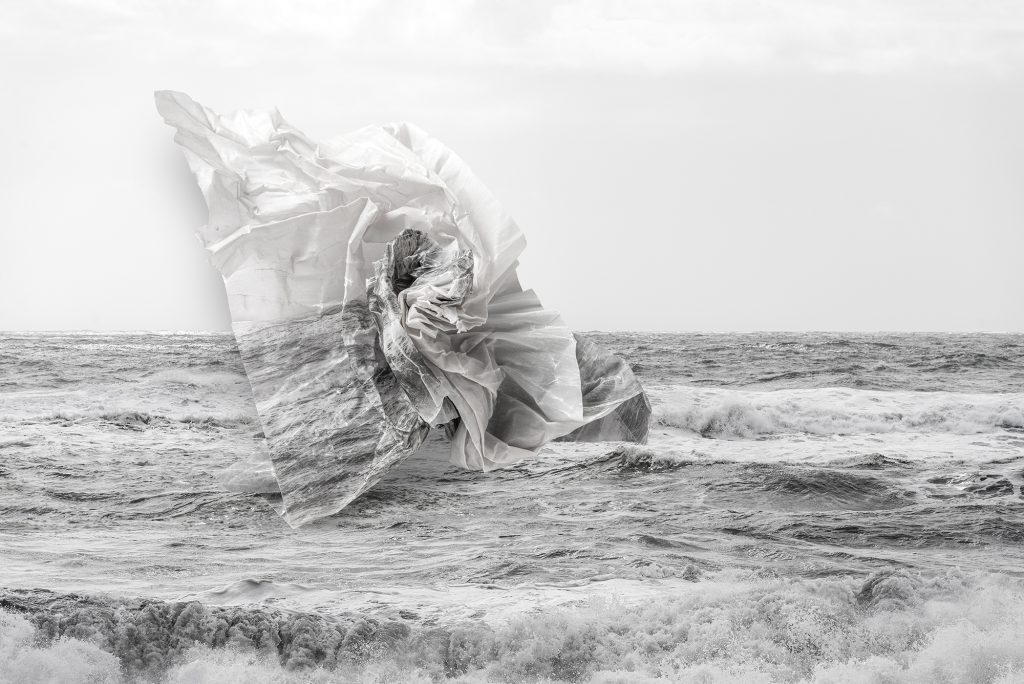
Topographies of Fragility XXXIV
Since I started working on this series, I have been pleasantly surprised to read comments from people who have written to tell me how my images made them stop and think and that they stuck in their minds afterward. A couple of professors have written saying that they were inspired after seeing my work to put the method into practice in their classes: their students took sheets of paper and scrunched them up before trying to flatten them back again, observing how the lines remain, and the folds cannot be undone. This later led to open discussions about our role in climate change. I found this very moving, as I never thought my work could have such repercussions.
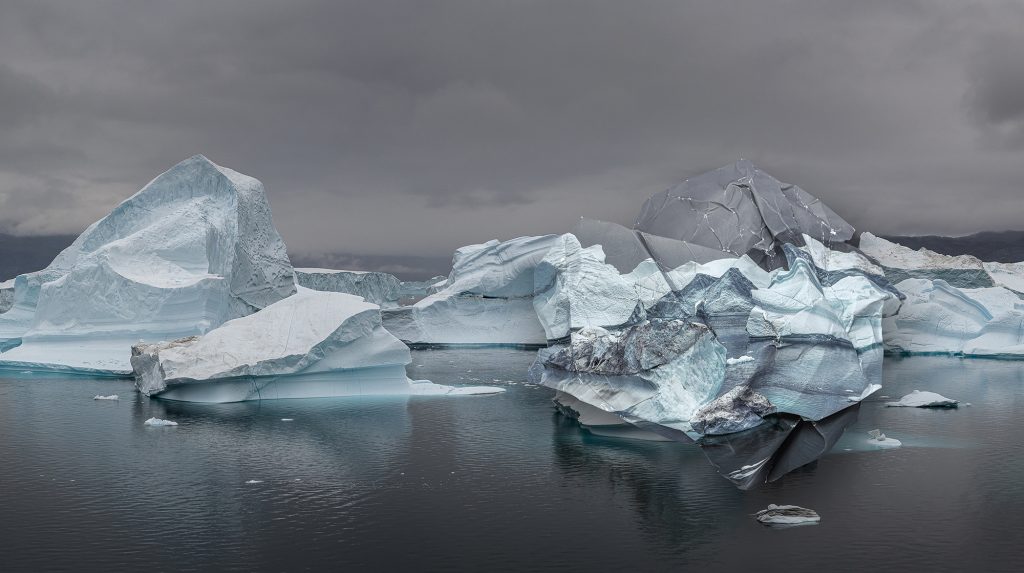 Topographies of Fragility XXI
Topographies of Fragility XXI
This made me feel that I could maybe be of help, by reminding people of what we stand to lose if we don't change.
Now more than ever, I believe that art, and its emotional impact, can be a strong advocate for climate engagement both across society as a whole and for those in government.
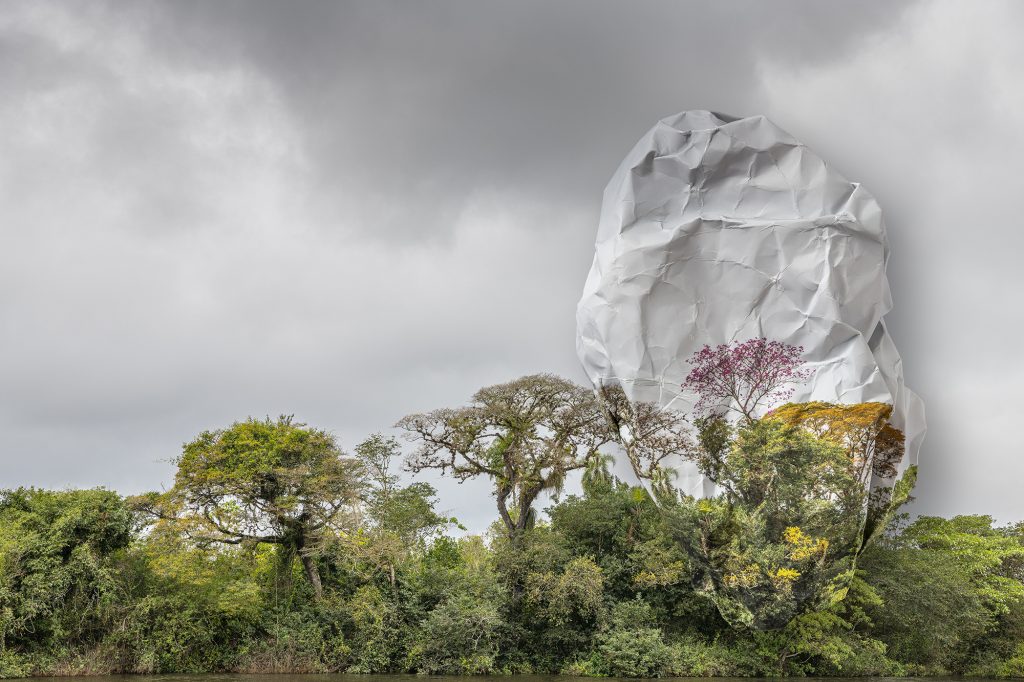
Topographies of Fragility XXIII
Discuss the importance of art in the process of healing and the significance of this in your life?
A few years back, my daughter and I used to love our underwater photography sessions; nature was our playground. Water has always had a strong presence in my life. When I was underwater, time stopped, and silence reigned; one could hear inner thoughts and the heart beating, slowing down. I felt safe in nature, protected, I felt strong. I desired these moments to last forever. Even today, being underwater brings us to that same instant. Nowadays, when photographing landscapes in my travels and looking through my camera, I invariably feel the "pull" of the scenery; I want to immerse myself and become part of it.
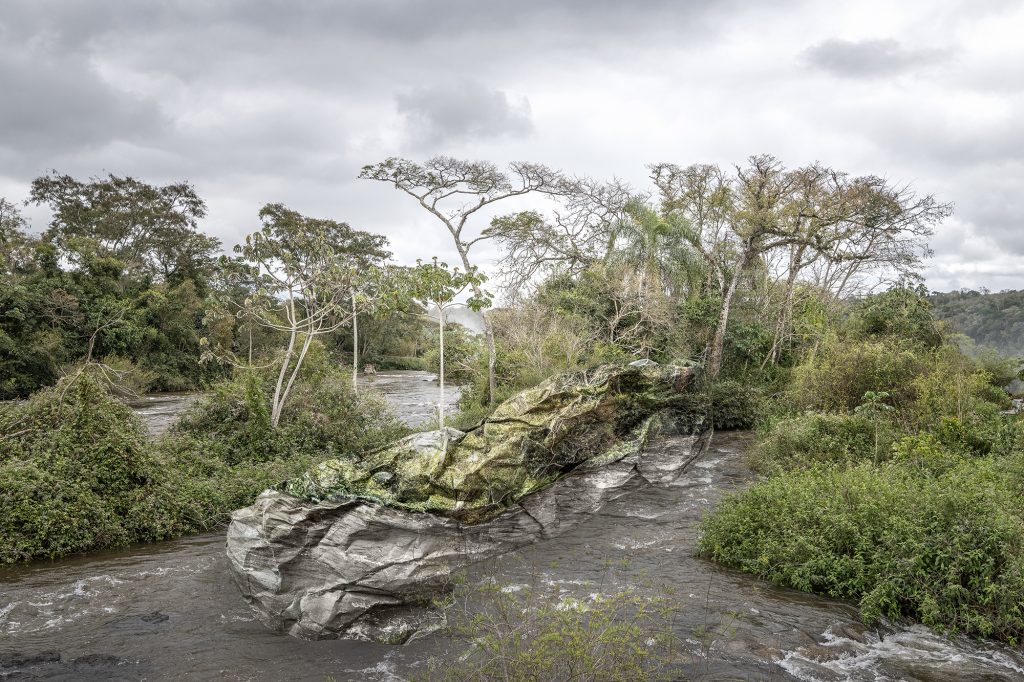 Topographies of Fragility XXVI
Topographies of Fragility XXVI
Nature has always been my emotional haven, a place of silence and solitude. I guess it was a kind of escape for me, a place of refuge from family issues. When I am surrounded by landscape, I feel I can breathe, think clearly, and replenish my energy; I feel empowered.
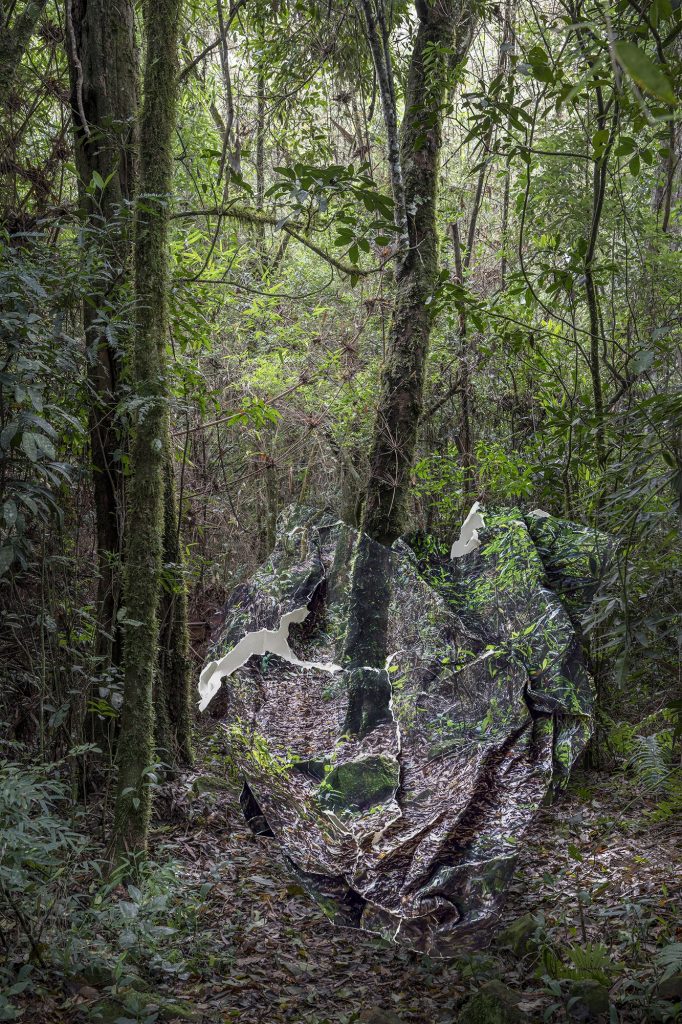
Topographies of Fragility XXVIII
Contact:
Ingrid Weyland,
Buenos Aires, Argentina
Website: ingridweyland.com
IG: @ingridwey
Deborah Blakeley, Melbourne, Australia
Interview by Deborah Blakeley, August 2023
Kait Rhoads
Explain how spending six years on a boat in the Caribbean has influenced your work?
I grew up, mostly underwater. The rhythm of the sea dictated my life. When I slept in my bunk, I would hear the water moving against the hull of the boat. When I was awake, I would be in the water as much as possible. We sourced food from the water; I got to clean my first fish at the age of seven. I was fascinated by undersea life, when I was ten years old, I was certified to SCUBA dive. My mother ran a dive business while I was young, and I worked for her, my favorite thing was night dives. I love how the underwater world transformed, the beauty of the nocturnal creatures and the galaxy of colors that were revealed by my flashlight entranced me.
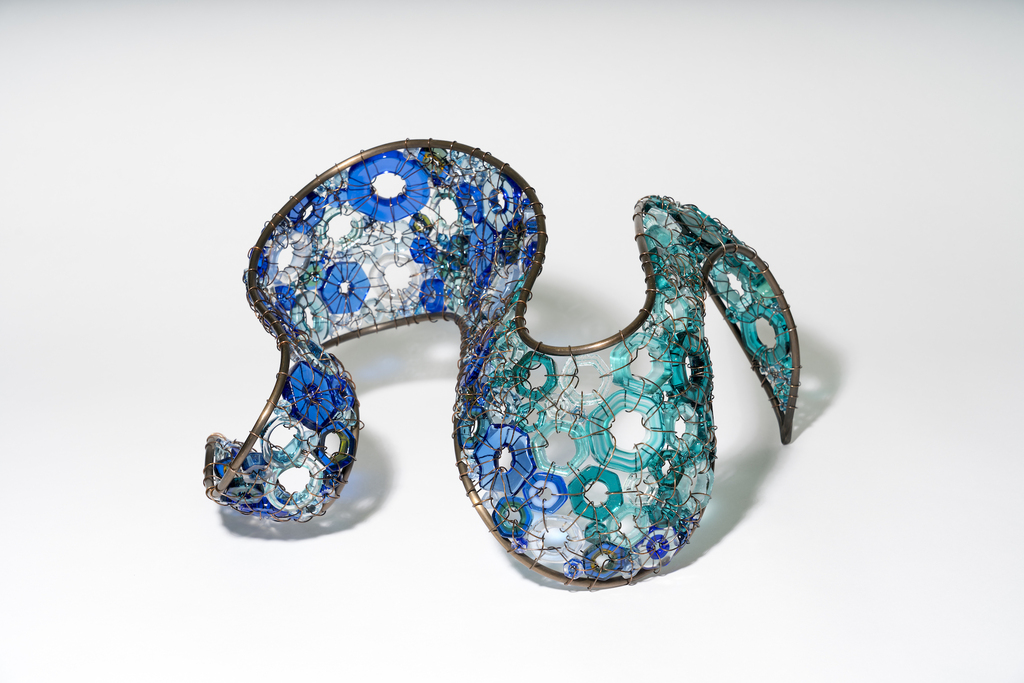
Blue Kelp II
Growing up in a natural setting, the natural growth formations surrounding me created a type of spiritual harmony. I so much loved looking subaquatic life, especially coral, their shapes and growth structures were different from how things grew on land, in material make up and morphology.
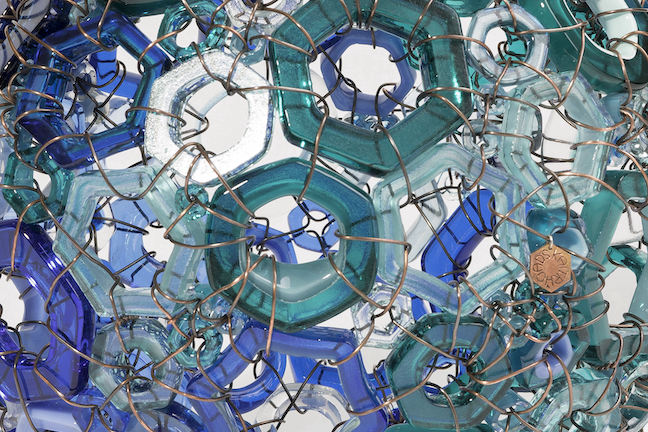 Aqua Detail
Aqua Detail
As I was a hyperactive handful at a young age, I was instructed in macramé; on the boat, one of my jobs was to do the utilitarian and decorative knot tying. I used natural fibers to create baggy wrinkle, or fluffy objects that protect the sails from the stainless-steel braided cable that supports the mast or protective grips on railings.
How have you have developed traditional Italian glass into your own contemporary style?
The world of glass became focused for me in my first year of working with it when I observed Lino Tagliapietra work with cane techniques and Dick Marquis used murrine as a structural material. In particular, I remember a demonstration Dick did at Pilchuck Glass School in 1991 in which he re-created a Roman bowl made with murrine fused together first on a horizontal plane, and then placed onto increasingly deeper molds to gently change its shape. The use of mathematics in this reductive, and then constructive method really appealed to me.
I really love architecture, Buckminster Fuller is one of my favorite architects, he has more of a bio engineering focus to his work that I feel a kinship to.
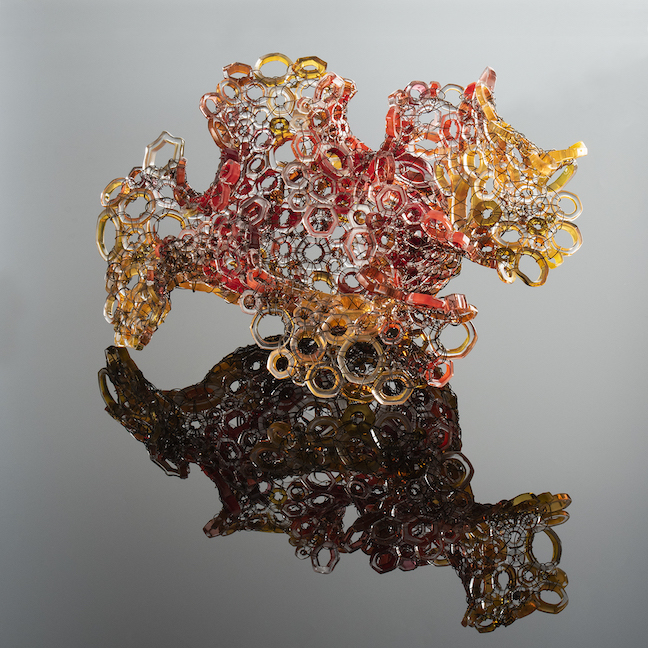
Ephyra
I took my knowledge of murrine making and my affinity for fibers to link together short pieces of fluorescent tubing, or round murrine with holes in the center with thin copper wire to make sculpture in the 1990s. In 1999, I made a hexagonal shaped mold that I used to make my hollow murrine with, I liked so much how these pieces fit together better, how they locked into place without leaving any gaps. It took me about 3 to 5 years to understand that I could make them thicker, more structural, and that I could weave them together to create more fluid and flowing styles. I now use my hollow murrine to make large scale, public art, work, medium size sculptures, less expensive design pieces, and jewelry.
What is the largest work you have produced? Where is it now?
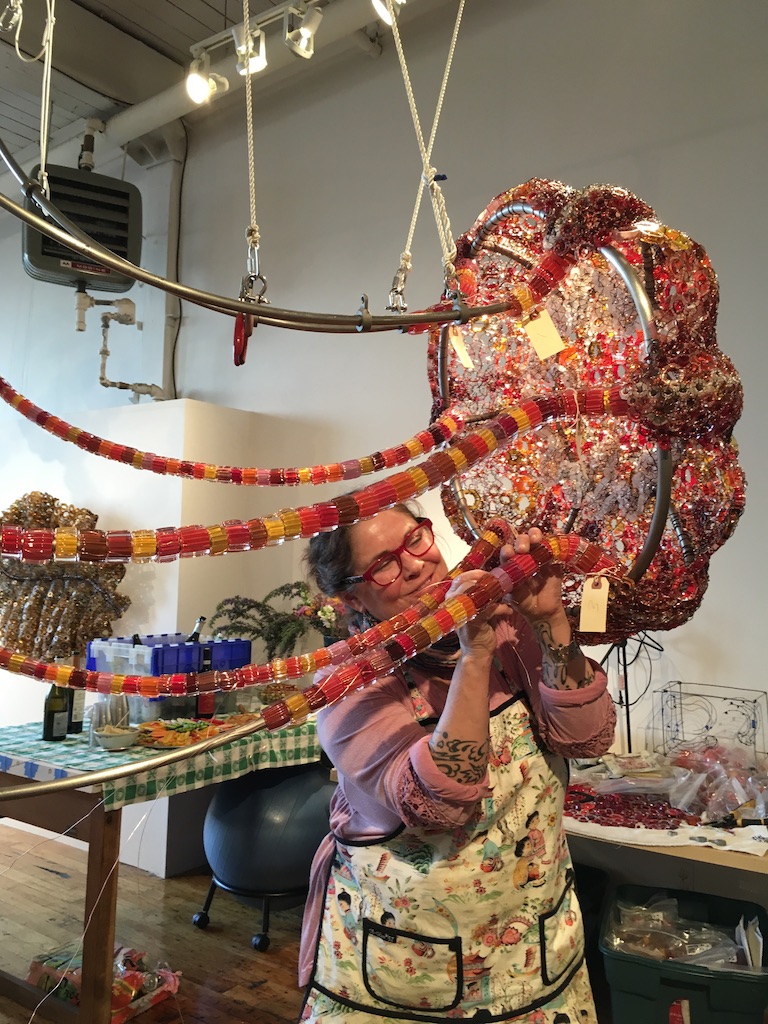
Salish Nettles 2018
What was the process in getting it both together and moved into situ?
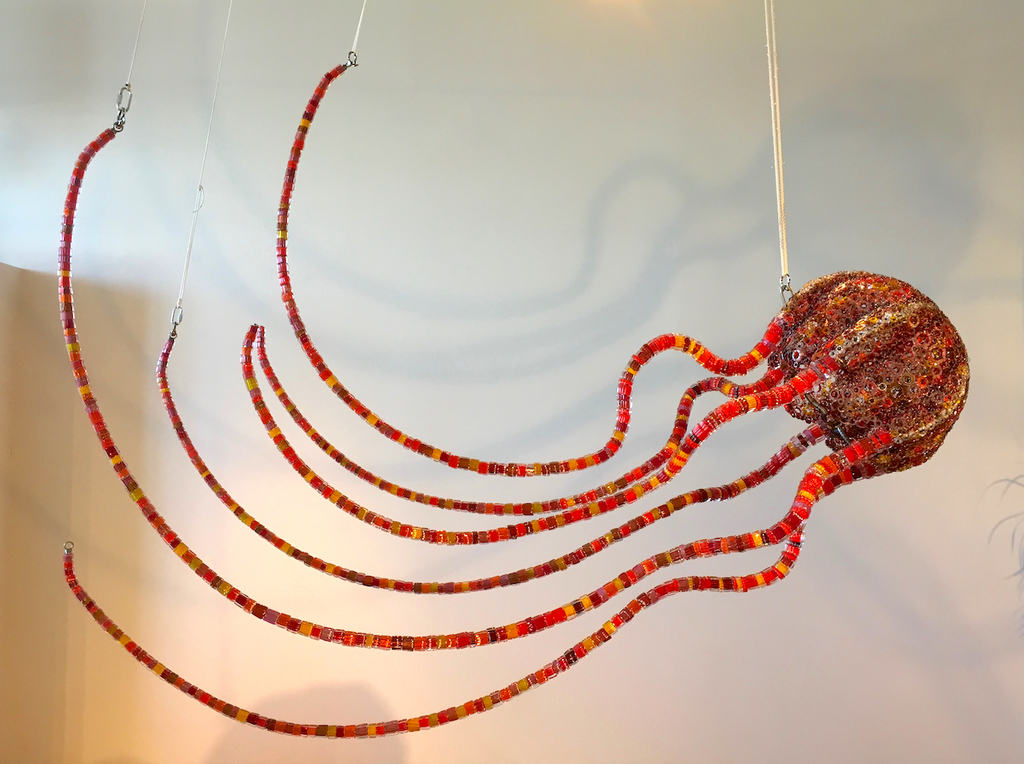
Salish Nettles No.2
I was making the artwork while the aquarium was being built, so I had about a year to put the three large scale jellyfish together. I made small scale models of the three jellyfish armatures, enlarged them in drawings and had them fabricated in stainless steel. The ‘bells’ of the jellyfish were made with my classic hollow murrine construction. I worked with the Hilltop Artists in Tacoma to create hexagonal tubing at their hotshop and at the Museum of Glass in Tacoma. The team there created round tubing with ridges on the exterior, or Rigitoni, as I call it, created specifically to slip over the stainless steel ‘tenticles’ of the jellyfish.
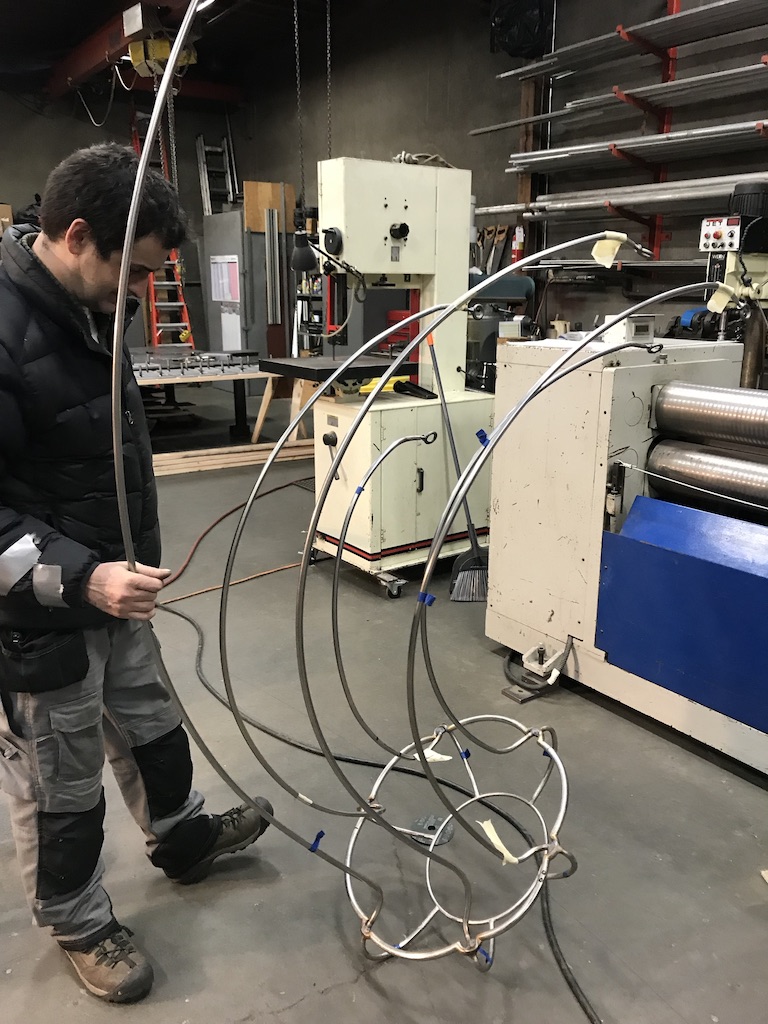
They were relatively easy to weave together on the stainless steel armature, and so I had the public help me finish the tentacles.
I was featured in the urban glass quarterly hot sheet for my 50th birthday celebration, as my guests had the opportunity to help weave the rigatoni onto my sculpture during the party.
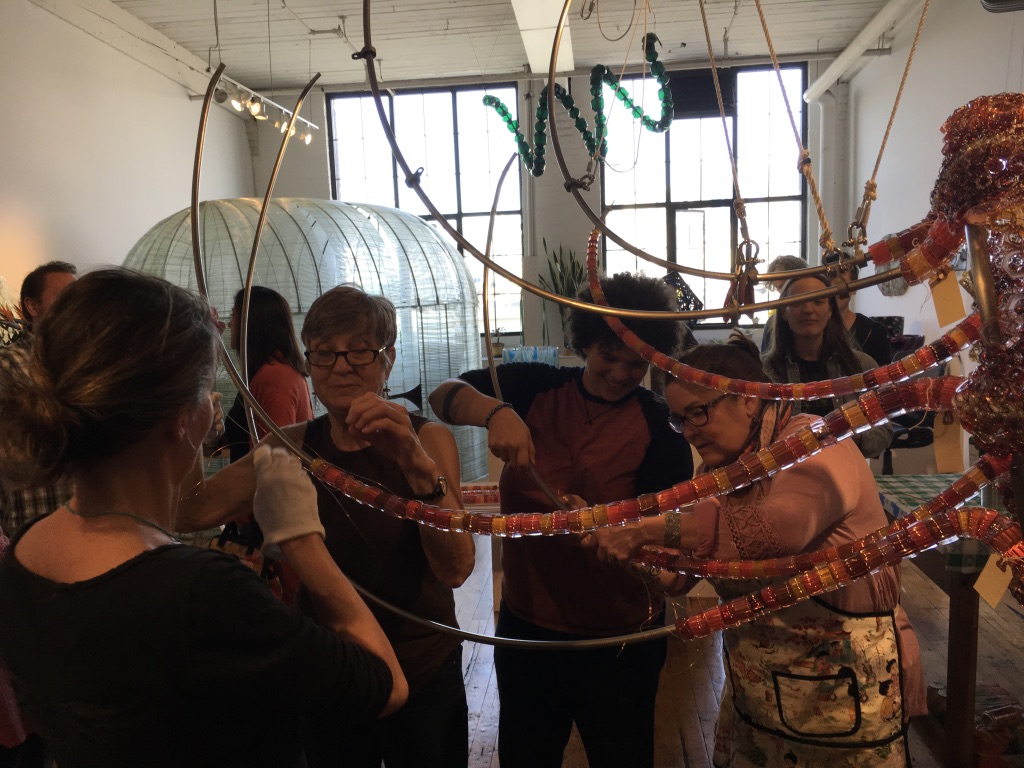
After the sculptures were completed, myself and an assistant wrapped them up in bubble wrap and polystyrene and took them to the loading dock where Fabrication Specialties, the company who built the artmatures, loaded them onto a flatbed truck, drove them down to the aquarium and installed them in place.
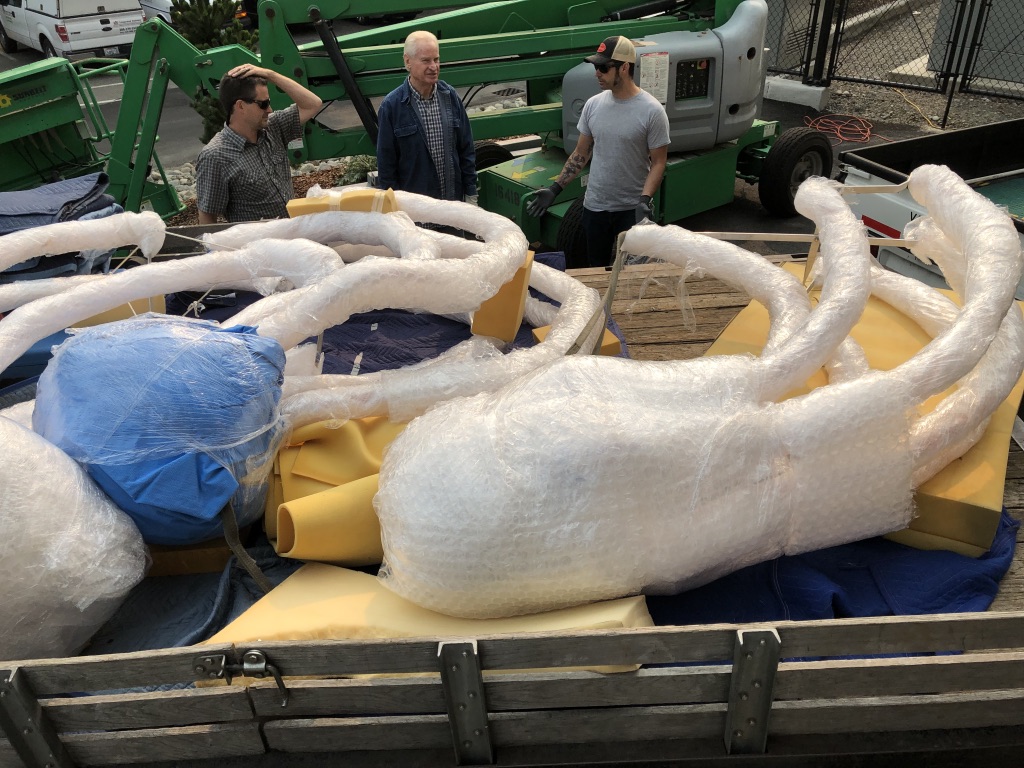
Unfortunately, they are no longer in business in Seattle, but they did have an on-call engineer, which was important to sign off on my artwork, and the instillation at the site. It was an interesting process, to work back-and-forth with the engineer, and the architect of the building to make sure that we could access structural connections to hang the artwork, each of the pieces weighed 80 pounds or less, even if they were 7 to 9 feet long. Fortunately, my hollow murrine sculptures are able to be hung over head in public without a plastic coating on the glass.
On site, we had to bring each of the pieces into a freight elevator, we delivered them to the correct floor and located exactly where each piece was to be placed with maps and laser locators placed on the ground to locate the spot on the ceiling where they should go. We use a scissor lift to anchor the cables in the sips panel in the ceiling, when those were all in place, we lifted the sculptures up to the hanging cables, and attached them via turnbuckles and then wedged them into place.
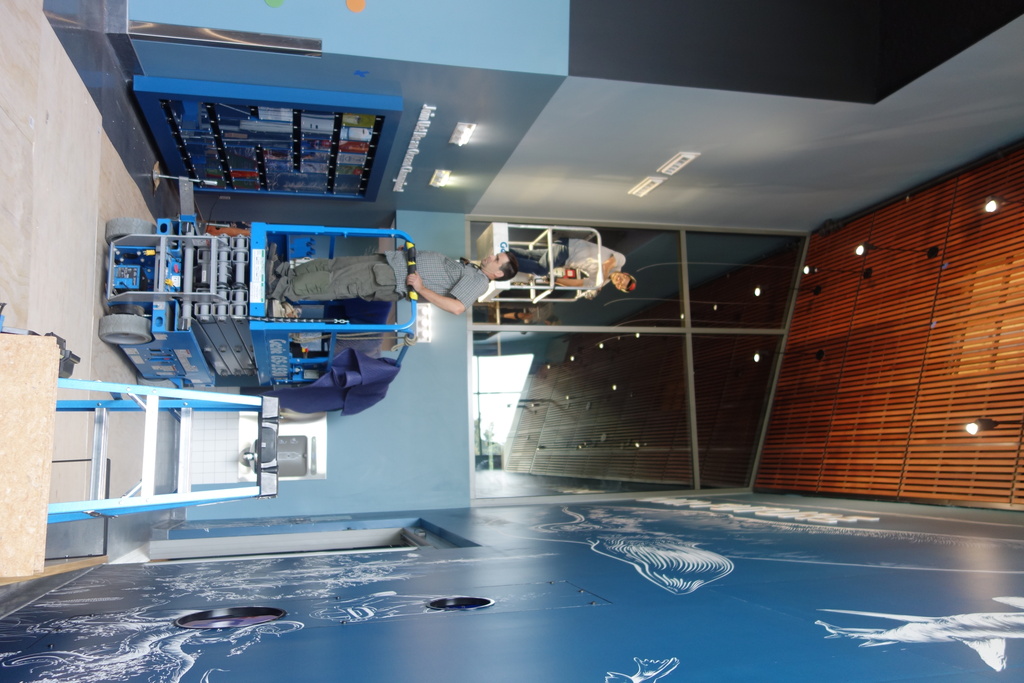
It was a bit of a tricky positioning, as there are five different ways that you can encounter the artwork in the architectural space that they were hanging it, so the positioning had to be appropriate.
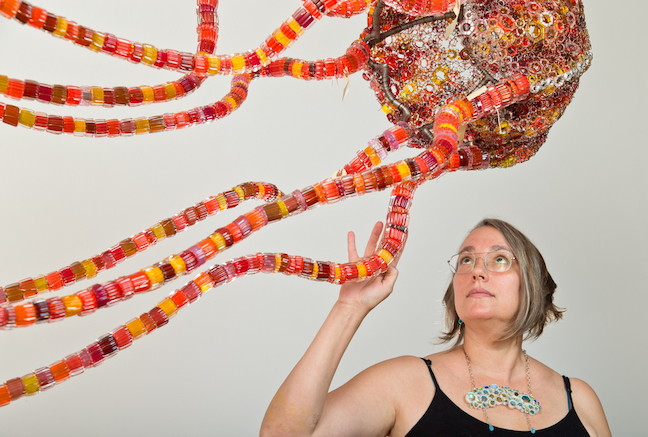
at Point Defiance Zoo and Aquarium, Thursday, July 5, 2018. (Photo/John Froschauer)
Discuss your sea stone series.
They’re called Sea Stones because of the luminous quality of the glass which reminds me of the light in the water. How the light moves underneath the water, in such a different way than it does on land. It helps to differentiate them as their own series as well, I do post them on my design website rather than on my art website, as I see them as design smalls, or more affordable sculptures.
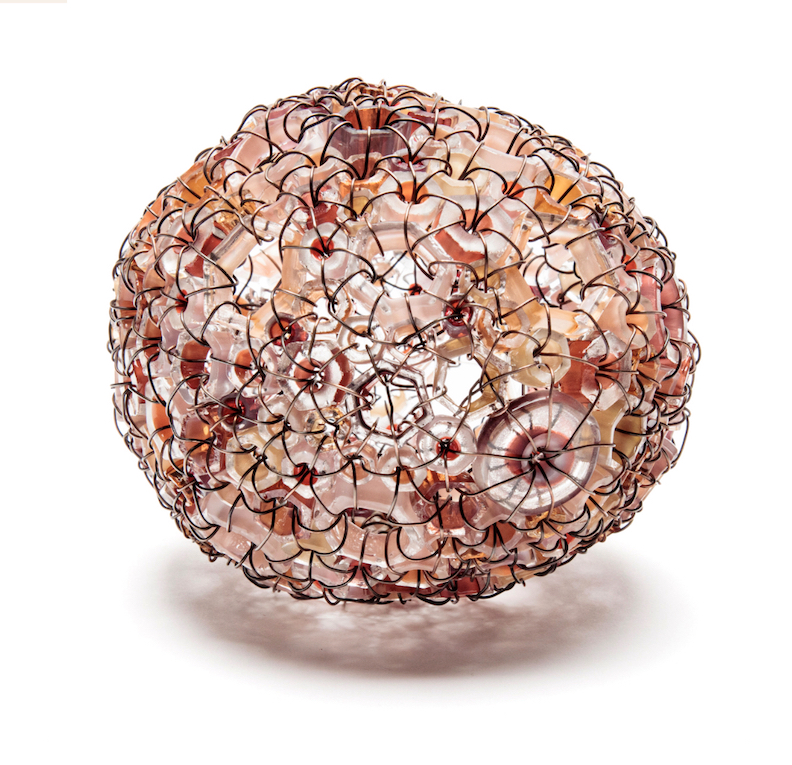
SS 17 18
Each Sea Stone is a small world in itself, I see them as talismans or collectible buildable sculpture. I like to experiment with color, sometimes I do an hombre or join two forms or more together. It is intimate when you can hold a sculpture in your hand. I like calling them stones because stones come in so many shapes and forms, sometimes beautiful crystalline structures, and my sea stones are rarely perfectly round, they have facets. I enjoy using different sized hollow murrine to make the Sea Stones so that they look almost molecular, like plankton carapaces I have observed of under the microscope.
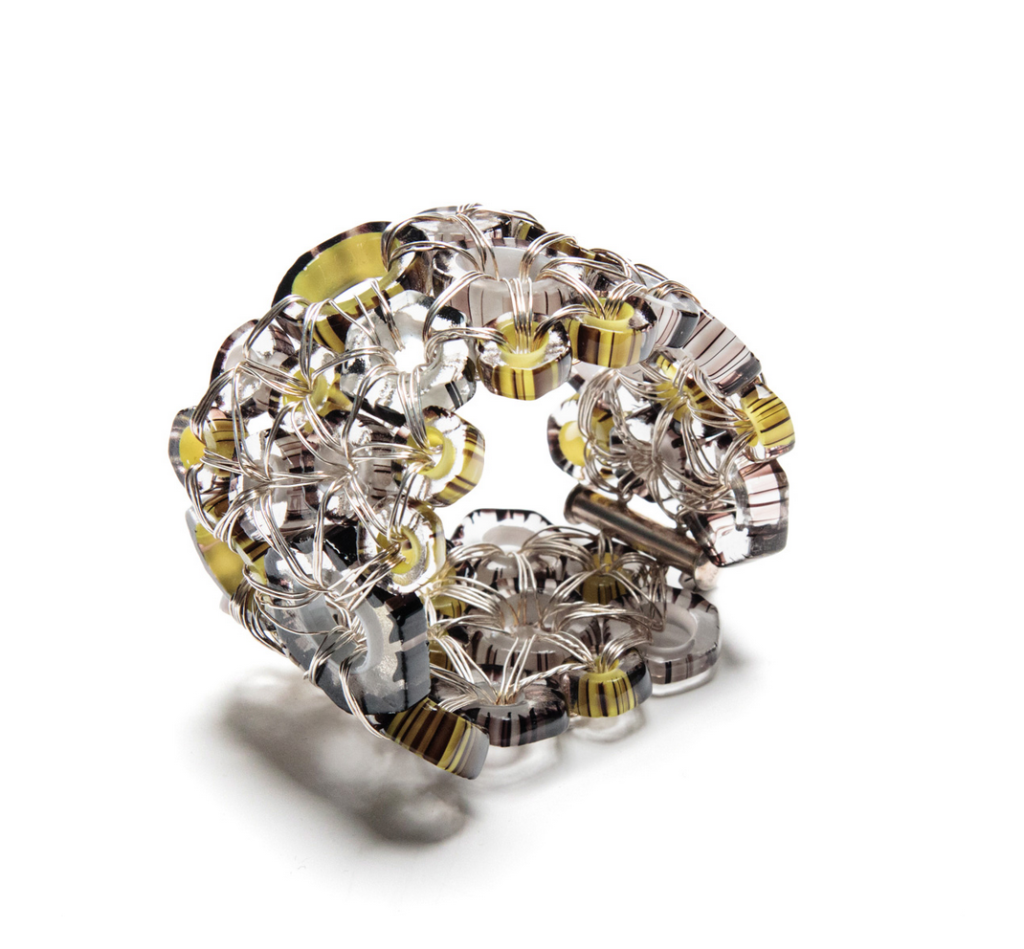
They are born out of my impatience to a certain extent. When I’m working on a larger piece that takes two to three hundred hours to complete, I like to feel the sense of accomplishment of weaving something smaller that I can finish in a day. It makes me feel like I’m making progress, or it feeds my ADHD, and inability to focus on one project for more than an hour or two. My ideal studio set up is that I have five or six projects at different stations so I can work when I feel like I have a solution or next step for the artwork. My brain doesn’t always progress in a linear fashion; and, in reality, I can only weave for a certain amount of time before my hands get fatigued. It depends on the wire thickness, thinner wire is easier to manipulate and thicker wire harder.
Why are they all titled with numbers?
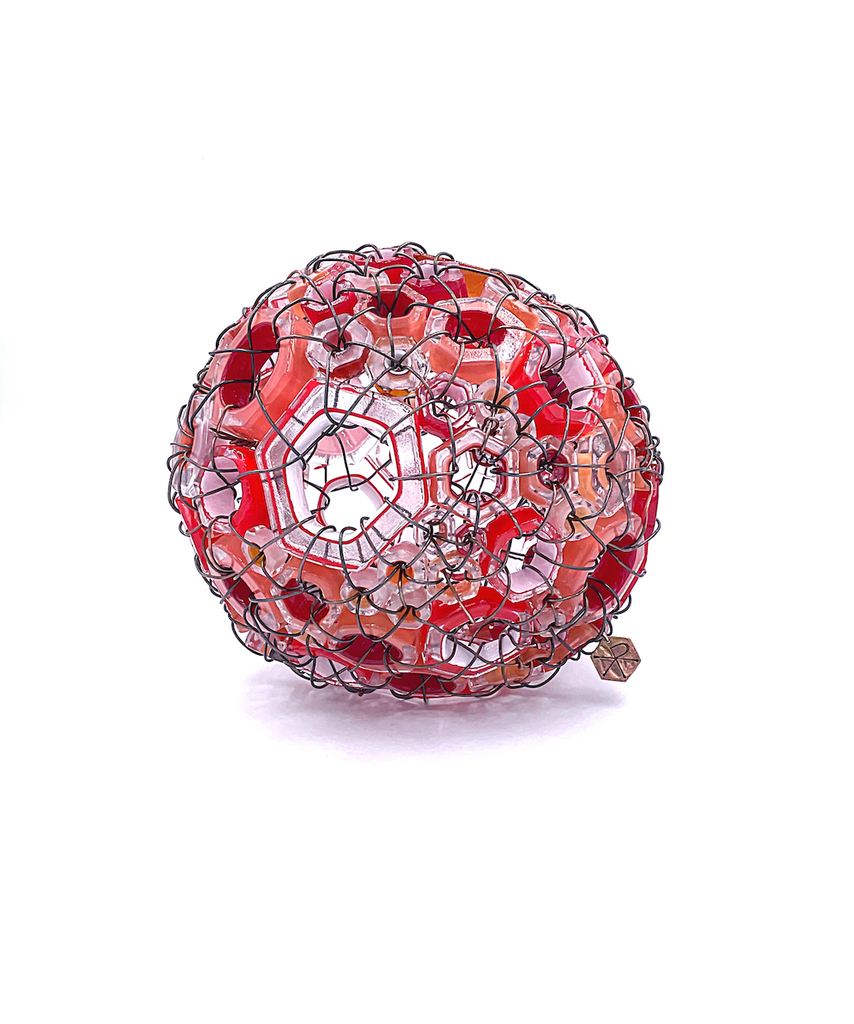
SS 21 14
I think of them as editions, so I title them with the year and the number of artwork that I made that year. Thus, it’s easy to tell in which year it was made: SS 23/01 is the first Sea Stone I made in 2023. It takes me a while to discover the name of something, I do make sea stones that are 10 to 13 inches in spherical form that I name. I think I need to be able to spend at least a week with a piece of art to be able to name it.
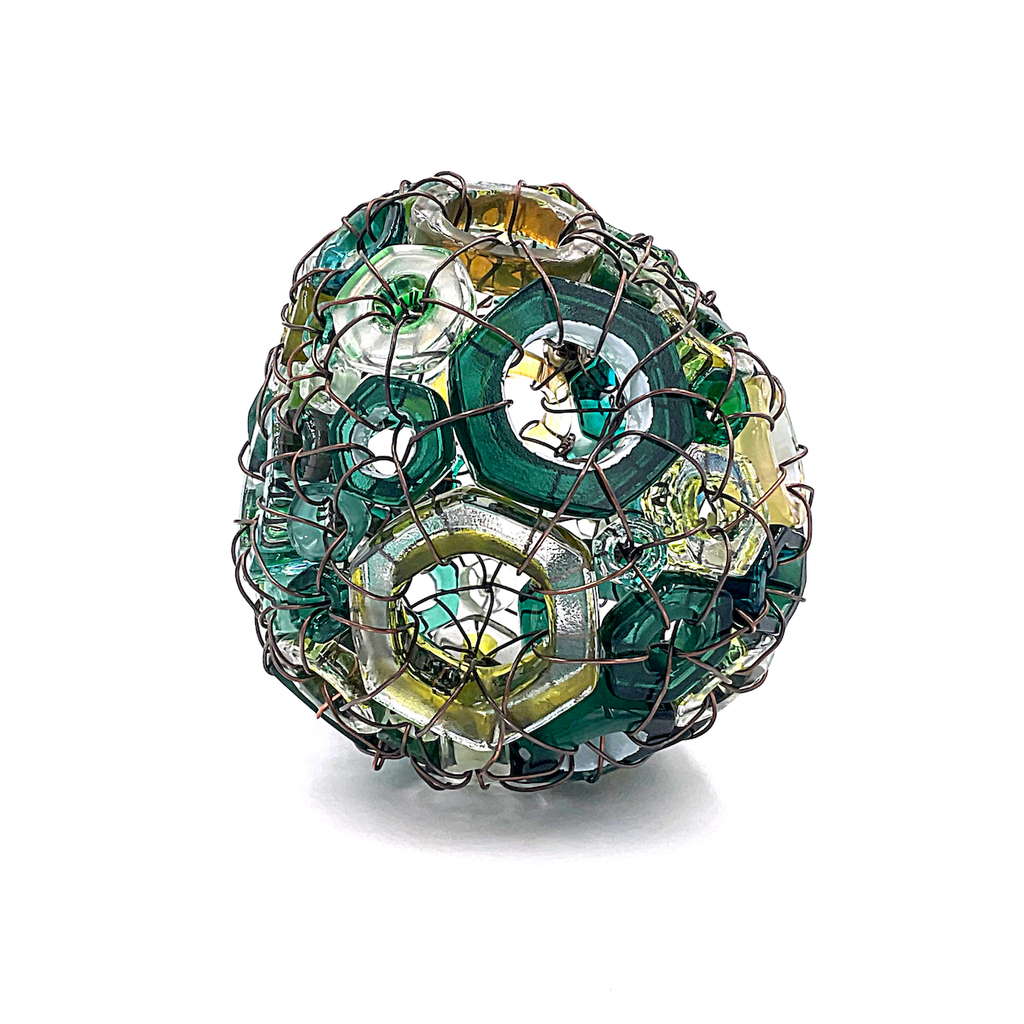 SS 19 07 Aqua md
SS 19 07 Aqua md
Comment on having smaller art – jewellery in your collection.
Fibers were my first love, at the age of six or seven I started weaving jewelry. Eight years ago I inherited my earliest necklace I made for my mother, it is made out of waxed linen and limpet shells that I made when I was 7 or 8. I did study jewelry and light metals a little at Rollins College, and Rhode Island school of design (1987 – 1993)
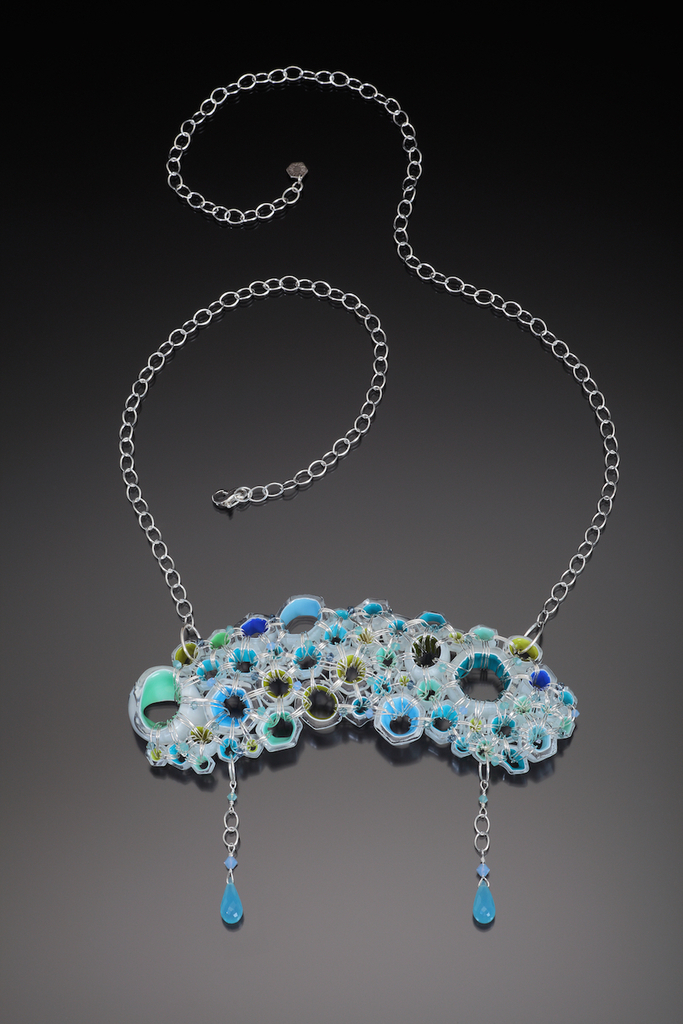
N082 Kingfisher md
When I first started showing at SOFA Chicago and in New York, at the Armory, some women would be so excited to see my work, and so sad they couldn’t afford a sculpture. I found it too tedious to weave a large sculpture using the smaller hollow murrine so I started collecting them together. I used fine silver wire to weave them into bracelets, and began taking them to the SOFA, and to art fairs around the country when I belonged to Chappell Gallery, NY.
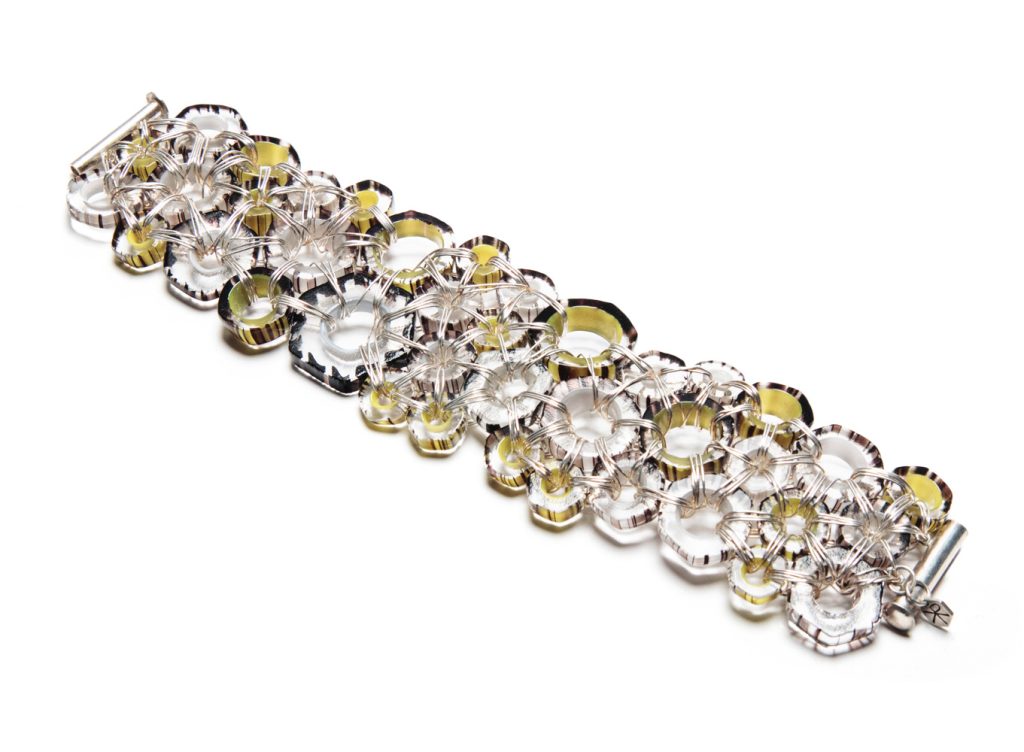
In 2009 I collaborated with the artist, Jana Brevick, and sold some work for about 10 years until they closed at Facèré Jewelry Art Gallery in downtown Seattle. It was wonderful to collaborate with an experienced Metalworker.
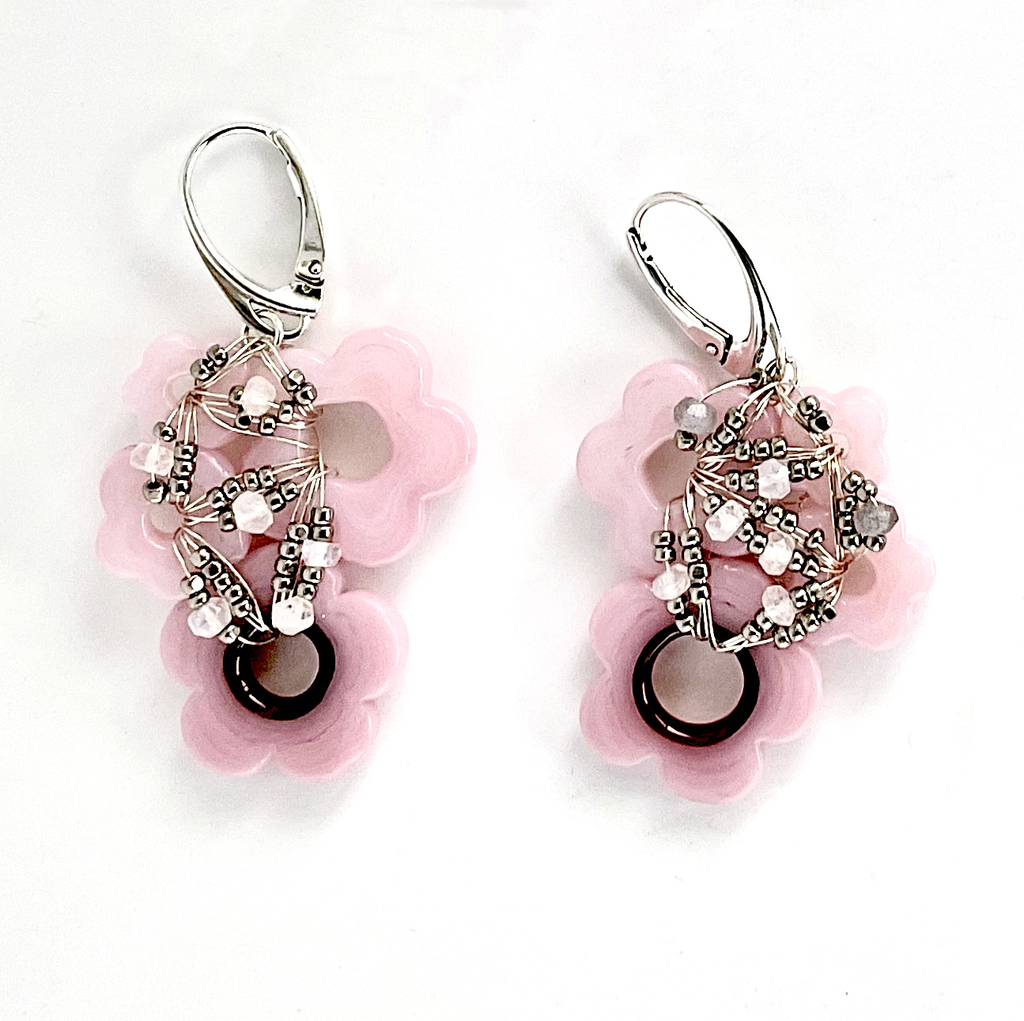
I am drawn to jewelry because it adorns the body. I have made apparatus for the body in the past as sculpture, especially when I was getting my masters degree. Sometimes I sew my artwork, I did learn how to sew from my grandmother when I was in high school, and studied costume design at Rollins College. I don’t really see a too many boundaries when it comes to using my abilities for artwork of different scale.
You have won many awards since leaving University. Take one award that was to alter your work dramatically.
I imagined that it is my Fulbright scholarship to study sculpture in Murano, it adjusted my attitude about glass. I was exposed to Lino Tagliapietra within my first year of working with glass. He came to my school and did a workshop. As well, he remained at Rhode Island School of Art and made some ikebana work for Dale Chihuhly, as a few pieces broke being shipped to New York City for a show, and they needed to be replaced. The summer after I had a chance to work again with Dale’s team during a Glass Lover’s Weekend event at Wheaton Village with Lino on some Dale’s ‘Venetians’. The way that Lino works with the glass, the classic Italian patterning techniques led me down the rabbit hole of Italian design in the 21st century. I so fell in love with Murano’s exposure to art nouveau and how that changed Italian glass design at that time. There are many designers that excited my mind in the way that they used murrine and cane. Especially Ercole Bariovier and Archemedes Seguso, I could see that these were not just design elements to be used in a traditional sense, but used by these artists to express poetry or their life surrounding them. My connection to fibers felt like it had a home in the color and pattern of cane and murrine.
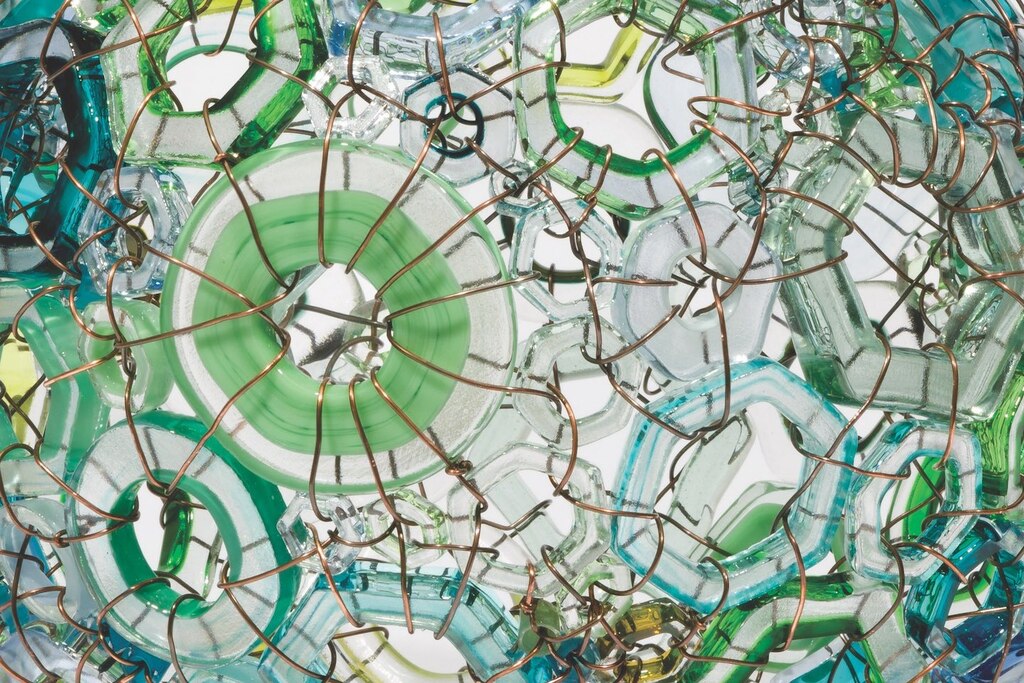
Spending a year in Murano, for my Fulbright study enabled me to see the original pieces that I had studied in books, visit the buildings designed by Carlos Scarpa and to see expositions of designers like Vittorio Zecchin; in which the museums would showcase not only their glass designs, but their paintings, textile design, and industrial designs at the same time. It really opened my eyes to the multi-faceted repertoire of these artists. As well, I lived surrounded by water, public transportation were boats/vaporetti, and my friends would take me out on their personal boats for recreation. It reminded me so much of growing up on the water, which I had left behind me 20 years previously. It seemed to me that the connection I felt to the water rose up and engulfed me, bringing up old memories and reinforcing the bond between the water and myself.
Can you expand on ‘Bloom’ how it came to life and is it still at Highline College, Des Moines?
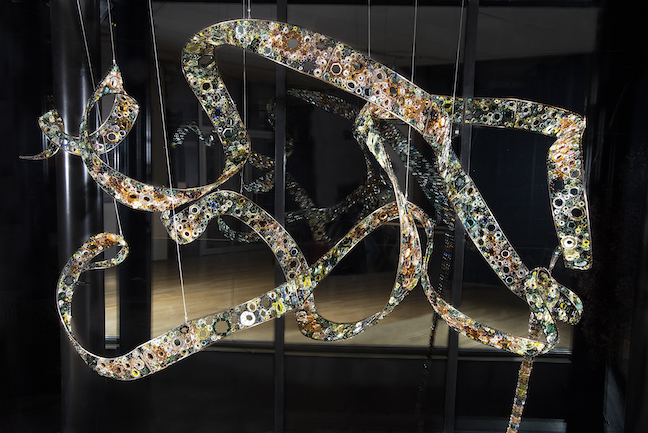
Bloom ,Soft Sculpture, 2018, 7’ x 4’ x 5’ for the blades of the bull kelp – the stipe, pneumatocyst or bladder of the bull kelp and the holdfast are 14’ long by 6”
Artist Inventory #: SS18-04, Blown glass, into steel molds, pulled out into tubing, cut, heated in a kiln, woven together with copper wire onto a silicon bronze frame work (shaped bull kelp fronds). This work was made specifically for the Beacon Gallery at the Bainbridge Island Museum of Art, but is permanently installed at Highline College, Des Moines, WA 2022, Photo: Ian Lewis
I was commissioned to make bloom for the Bainbridge Island Museum of Art’s two-story tall window space in 2018.
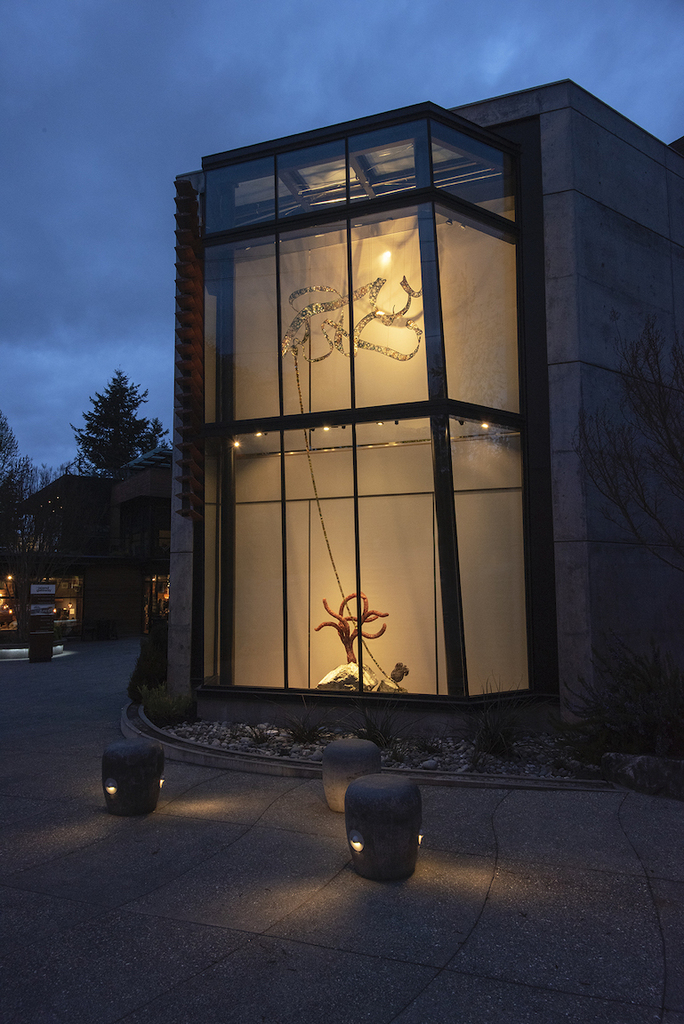
In that iteration of the artwork, I combined a few older works on the seamount/rock pile at the bottom of the window and added in Bloom, that attached to the rock at the bottom and extended up into the second-floor gallery where the blades of the Kelp cascaded out. Gregory Robinson, the head curator, came up with the idea. It was so much fun to place my work onto the rocks/work with the stone cutter who drilled holes into the rocks, and positioning the stones inside of the gallery.
I had been thinking about making bull kelp for about a decade, having this opportunity, coupled with the new type of construction that I developed for Salish Nettle’s tentacles, ‘rigatoni’, really helped to bring this piece to life. I designed the artwork so that it fit within a certain size parameter, so I made a three-dimensional model of the outline for the bull kelp nematocyst and blades to give to the metal worker. After I received the metal from the metalworker, I had a lot of work to do to clean up the edges, patina the silicon bronze, and then set up the sculpture and spend many hours of bending the metal so that it was perfect. From there, I added in my hollow murrine, green with big spots of transparent gold. These spots mimic the soris, or reproductive patches that are heavier than the rest of the blade, so that when bull kelp is broken up in the fall/winter these patches fall to the sea floor where they can grow and take root. The difficult part was re-creating the way I hung the work in my studio at the museum. It took a little jiggery-pokery, but in the end, it looked beautiful. The simplicity of weaving the stipe or long hollow attachment from the gas bag/pneumatocyst to the holdfast was lovely to make from the ‘rigitoni’, or sections of green and gold glass tubes with ridges on the outside. It was so exciting to anchor the holdfast to the stones on the first floor.
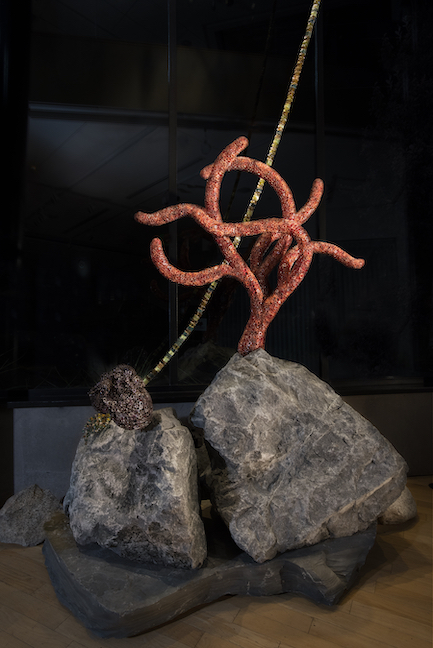
In 2022, Bloom was chosen to be permanently installed inside of the biology department at Highline College, Des Moines, Washington.
Tell us about your work of the Pacific Seas Aquarium.
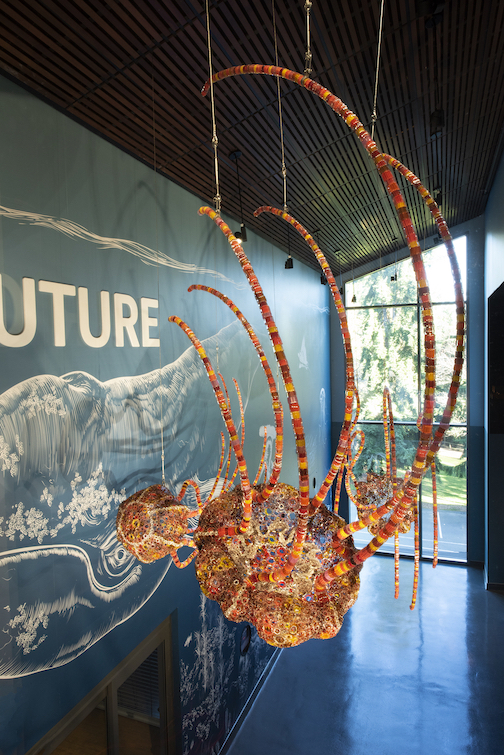
Salish Nettles, is a sculpture that depicts three jellyfish moving in a circular motion; one fully open, one half closed and one fully closed. One first encounters, the sculpture when you enter the Pacific Seas Aquarium, they are hung at the same level with just a pain of glass in between the viewer and the sculpture. As you wind around the inclined pathway of the aquarium, you encounter the sculpture again at the exit of the Aquarium, in the Waves Of Change conservation room, where it is suspended 10 feet in the air.
It is made from hollow murrine (the bells of the jellyfish) and rigatoni glass pieces (the tentacles of the jellyfish), woven together with copper wire.
How do you involved others in this public art works project.
I began working on the project at the Massachusetts College of Art in Boston, MA in November of 2017. The students there helped me blow a lot of tubing, My concept for creating the artwork was to spend a portion of the fabrication money in Tacoma, the city where the artwork would be located, and involve as many people as I can from the city in making it. This gave me the opportunity to promote ocean ecology, especially to young people from the area. The next group that I involved with making the work was Hilltop Artists a youth development arts nonprofit in Tacoma. I arranged with Point Defiance Zoo and Aquarium to have marine biologist Chad Widmer, a.k.a. the jelly man, come and give a talk to the students about jellyfish. I gave them the rundown of the project, and Chad filled them in on some scientific background on jellyfish; then we worked together to produce tubing. On another occasion, I worked with the Hilltop Artists at the Museum of glass. The Museum of glass has a great amphitheater for the public to watch the action IRL as well as a livestreaming. Chad Whitmer worked with us that day in the shop blowing glass. Both he and I gave a few talks about the project and jellyfish to the public periodically during the day.
I was fortunate to have the Kristin Elliot from Grit City Glass cut up all my tubing, I fired it in my studio in the Bemis building in SODO and worked on putting together the bells of the jellyfish. At that time, Bemis arts would have open studio at least two times a year, as I was progressively, weaving the sculpture together, I offered for people who visited my studio to come back when I was ready to work on the tentacles and help make the sculpture. During that time, I had my 50th birthday party, where as part of the festivities, you could weave part of the jellyfish tentacles together. Putting the rigatoni in place is a lot easier than weaving the hollow murrine together, myself, and my assistants had everything laid out and ready to go. That was our practice run, and I made appointments with people who are interested and facilitated them, helping me with my sculpture. I worked with members of my community; art lovers; fellow volunteers of Seattle aquarium; students from Tacoma; and local mothers, and daughters.
It brings me pleasure to think that the community could feel a ownership of a sculpture located in a place that they would visit a fair few times over their lives. My goal with public art is to bring awareness to the incredible world that lies beneath the waves and our responsibility towards its health.
The importance of working, with experts such as Dr Chad Widmer.
I would not have been able to make the work without working with Chad Widmer, marine biologist, currently working at Point Defiance Zoo and Aquarium, and author of “How to Keep Jellyfish in Aquariums: An Introductory Guide for Maintaining Healthy Jellies”. He discovered a type of jellyfish and named it Amphinema rollinsi after hard-core punk artist Henry Rollins, whose music he admires. I believe he requested that the jellyfish sculpture for the Pacific Seas Aquarium be made out of glass; which he has an affinity for, as he participates in the Hotshop Heroes program at the Museum of Glass in Tacoma.
He spent time to show me all the different stages of life of Moon Jellies, Lion’s Mane Jellyfish, Egg Yolk and Pacific Sea Nettles/West Coast Nettles that he cares for at the Point Defiance Zoo and Aquarium. I chose to work with the form of the Pacific Sea Nettles for my sculpture, as they are a type of jellyfish that exist all over the world, but are a beautiful shade of orange here in the Salish Sea. Having that back-room access to jellyfish reproduction was invaluable. I think about it still, the slow, pulsating beats of a mature jellyfish, so different than the frantic movements of its larval forms, driven by bands of translucent muscles. My absolute favorite type of jellyfish observation is through the microscope, looking at the incredible planular, strobilia and ephyra stages in a jellyfish’s life cycle.
Working with Chad was invaluable, he let me take my time to observe the jellyfish, which then led me to create the sculpture with the jellies moving in a circular motion, each of the three sculptures representing a different position of the jellyfish bell, open, half closed and fully closed, acknowledging the relentless ability of jellyfish to pump their muscles, they do it even in their sleep, albeit a little slower.
‘Laurel Wreath’ is from 2014, but it is beautiful can you expand on it?
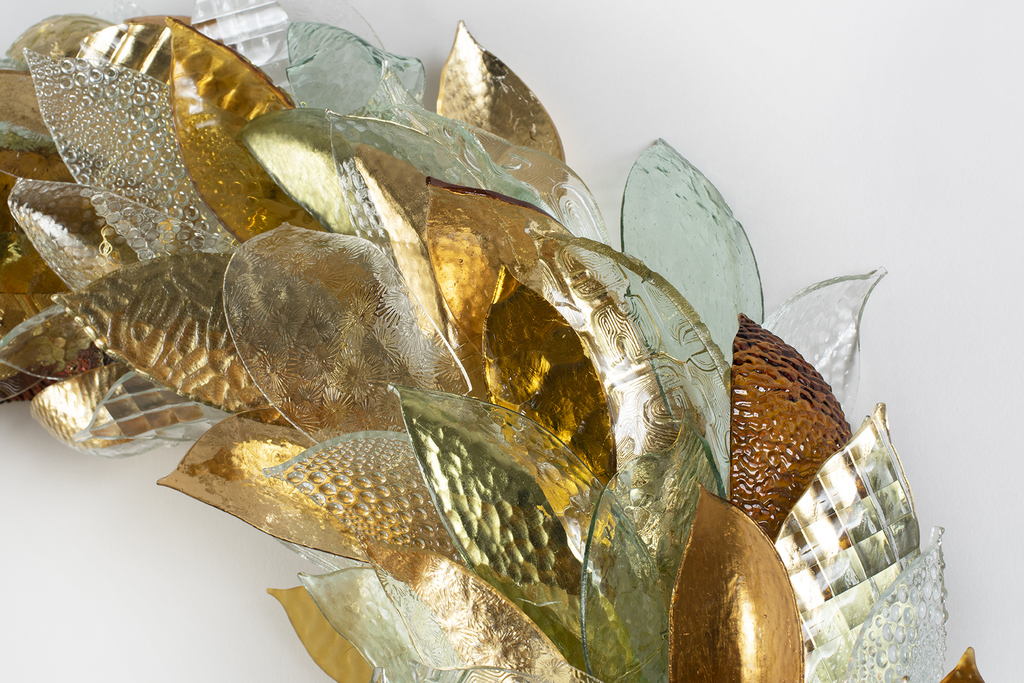
Honor
My connection to wearable sculpture comes from my time studying costume in liberal art collage, Pilchuck Glass School’s student to student auctions during the summer sessions and a body of artwork I made in Alfred University, where I received my MFA. body of artwork I made in Alfred University, where I received my MFA.
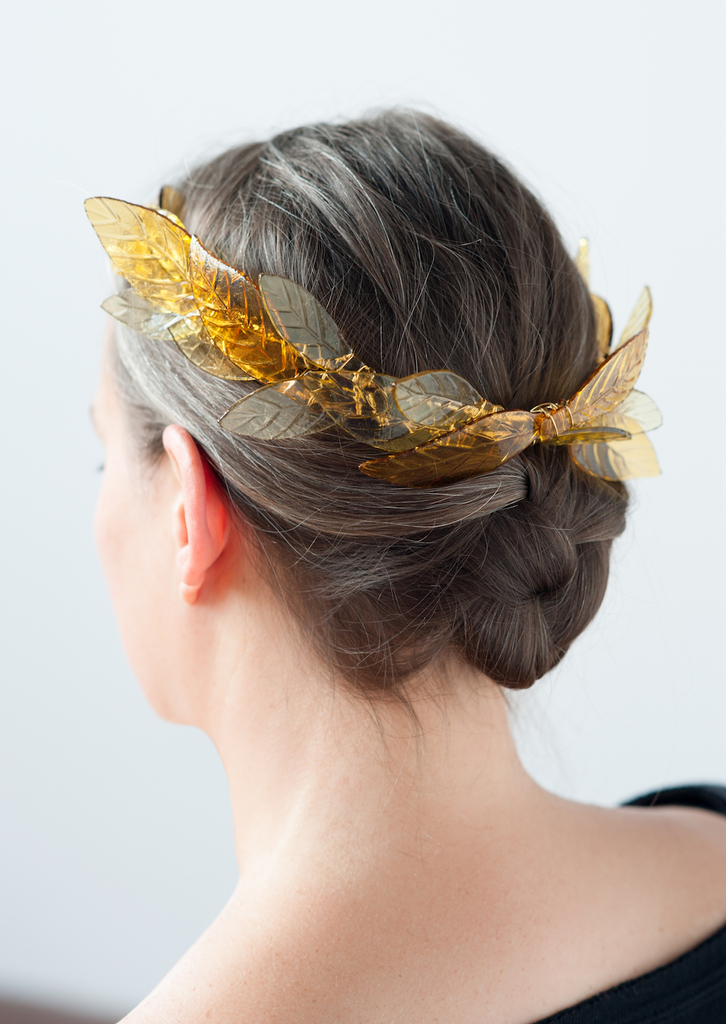
Laurel Wreath is the genesis four other artwork that I have made centered around honoring nature. It was born out of using some scrap flat class that I was gifted by fellow Bemis Arts artist, April Surgent. I experimented with engraving, and then slumping or fire polishing the glass in a kiln.
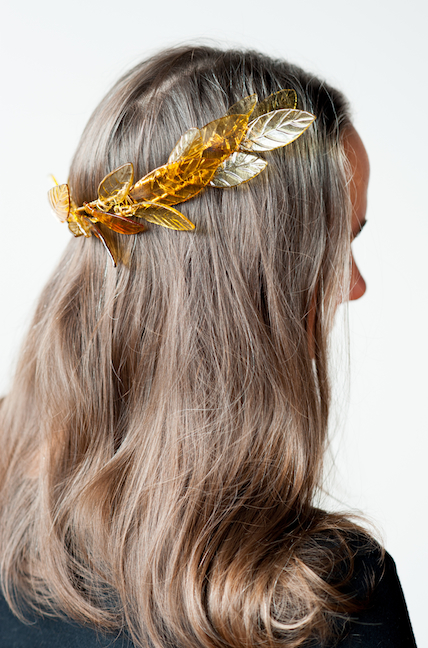
There’s something delicate and lovely about the artwork and I used myself for the photo.
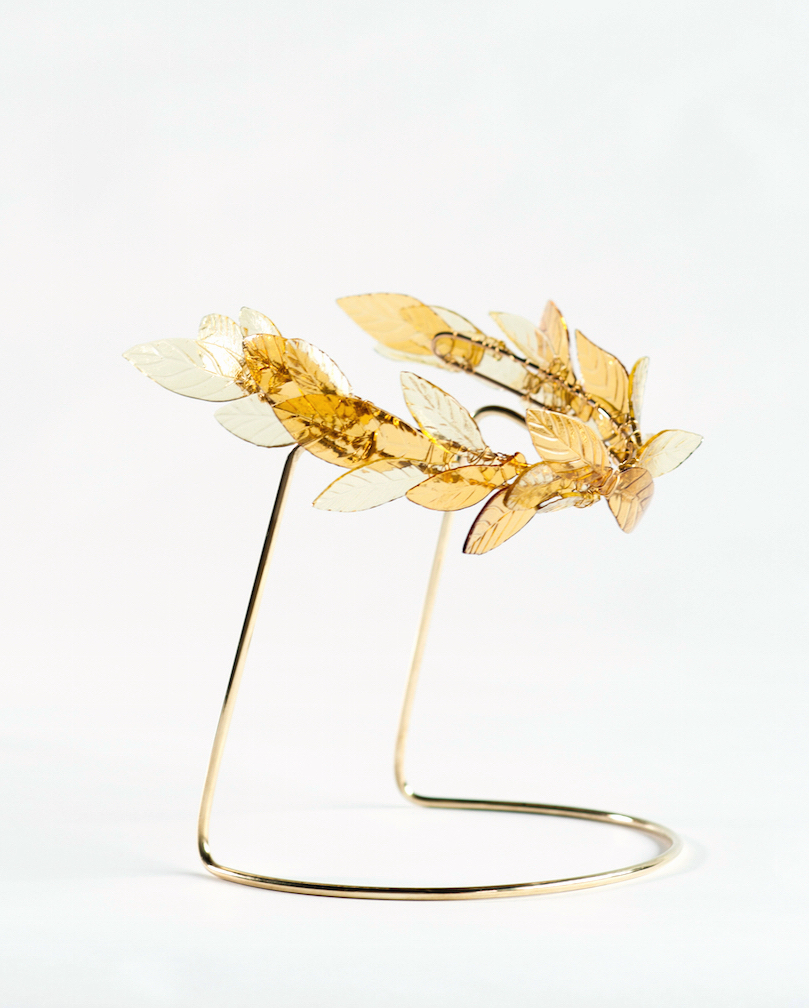
Laurel Wreath, 2014, 7” x 8” x 3” with stand 8” x 8” x 8”, Artist Inventory #: S14-01
Engraved and slumped sheet glass, silicon bronze headpiece, brass wire and stand.
Photo: Erica Sciaretta
The laurel wreath was traditionally given as an award, or mark of honor. Perhaps it is a symbol of myself, giving myself an honor, as an Aries, I can be quite impatient. Why wait around for someone else to give you an award? Perhaps I was fighting against the cultural imperative in America, that older women become invisible.
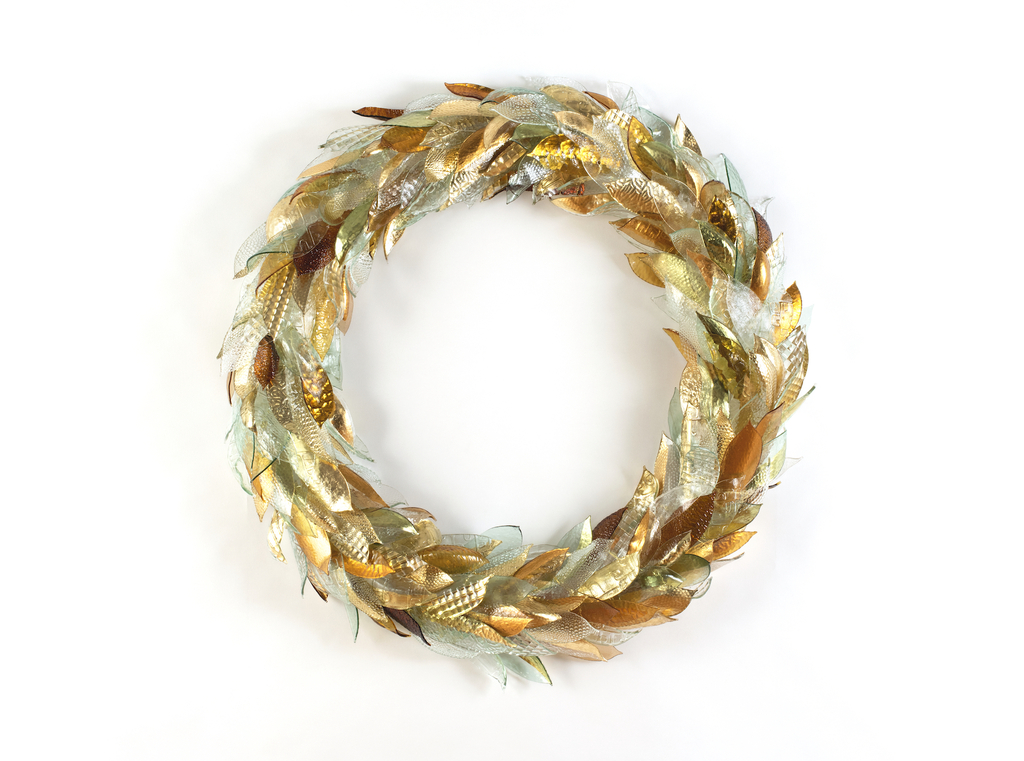 Laurel Wreath
Laurel Wreath
“Laurel Wreath” was the beginning of creating new series of work using flat ’privacy’ glass, waterjet cut into leaf shapes, slumped and woven together on steel forms like “Garland” and “Honor”
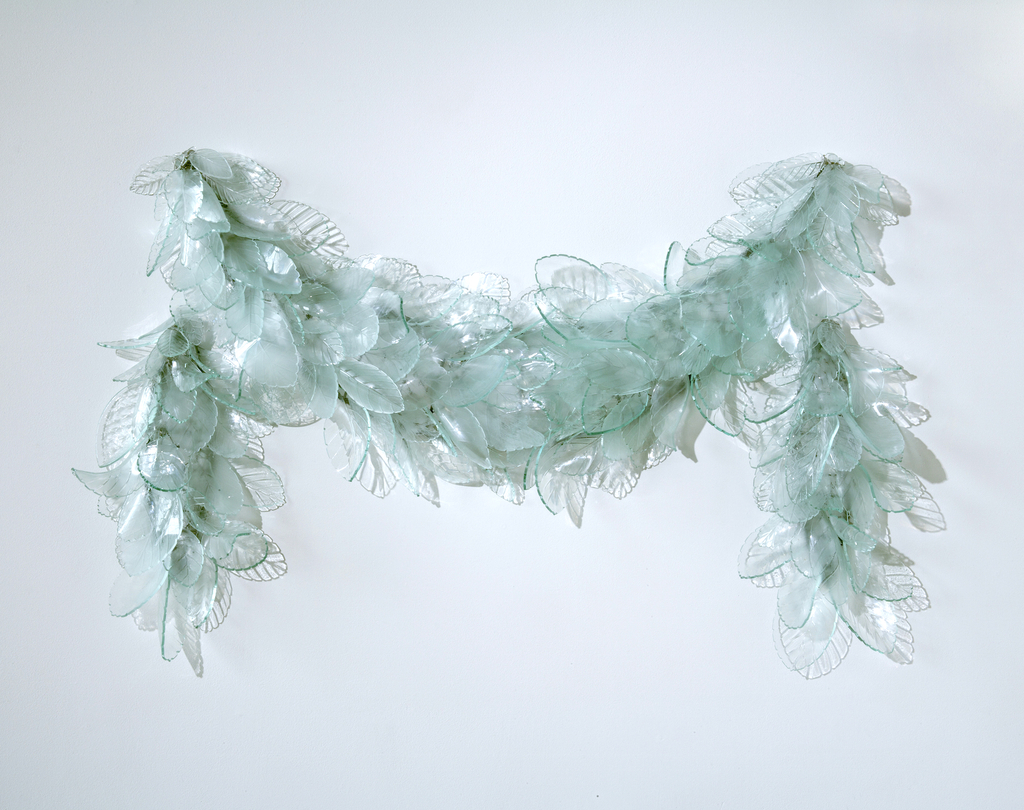
Garland, Sculpture, 2015, 38” x 24” x 5”, Artist Inventory #: S15-01
Plate glass, water jet cut, engraved, slumped and fire polished linked to steel support structures with stainless steel wire. Photo Credit: Mike Seidl
Discuss the importance of teaching to you?
I enjoy teaching, I will be teaching a sculptural workshop that involves discussing climate change and incorporating the knowledge into sculpture this summer with the artist Rachel Rose Moore at Pilchuck Glass School (June9-20). I did teach a semester at the University of Hawaii in 2011 and one or two classes during grad school at Alfred University. It’s not easy to teach sculpture, but I think it’s more rewarding than teaching technique. Glassmaking is such a team sport, teaching can be important to meet new people and to create friendships, some friendships could grow into finding a great independent contractor to work with. As well, I get inspired by the work that the students make, and the excitement of working with glass in a new way. I am looking for a new assistant these days, perhaps they will be taking my next class……..
In 2020 you had, exhibitions cancelled due to the pandemic, how has this affected you as a practicing artist?
My career was going pretty strong at that time, and then the world turned over. I also bought a house at the end of 2019, so in a way I’ve been lucky that I have been able to focus on fixing up my house and making it livable and studio worthy. I do feel that my momentum was blunted, and that the galleries have shifted how they operate to a certain extent. As well, I have had carpal tunnel surgery on both my wrists and some further arthroscopic surgery on my left wrist to try to repair some damage I did in 1990. I had to let go of my assistant of 16 years, due to the financial strain. So things have slowed down for me a bit, but I’m hoping to regain some momentum as we spend the next two years closing out Covid. I don’t have formal representation in Seattle, but I have secured an installation space for a show in 2024 and I am applying to different residencies to support that show. I have a plan, emerging on where to focus my creative energies in the next five years on creating a large kelp forest installation. My goal has been to only create large scale work for public art, as I do not want to store large scale works for long periods of time. I would like to develop this artwork for a specific space in the long run, but I’m going to have to practice making larger works to figure out a new system so that I can be conservative with glass use, storage and shipping. I want to make a conscious effort to be light upon the earth as I take to heart my mission of promoting ocean ecology
Take three pieces and discuss them.
Big
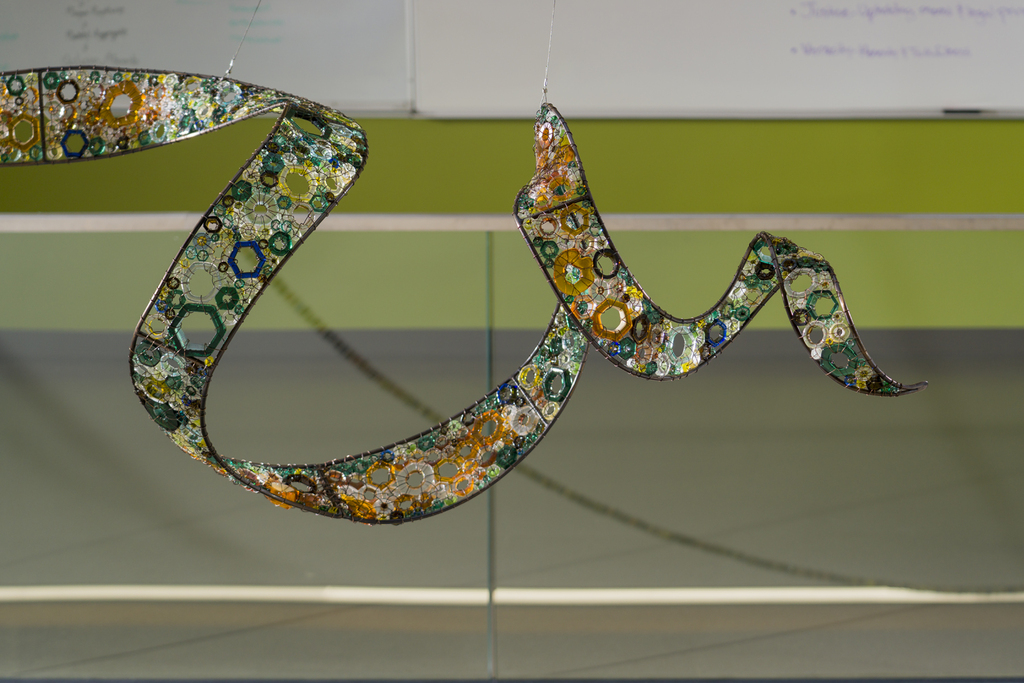
Bloom 2018 in detail
Bloom was the culmination of a ten-year thought process. It was such a pleasure to be asked to fill a two-story picture window gallery space of the Bainbridge Island Museum of Art’s Beacon Gallery for 2018. Gregory Robinson, the Museum’s Chief Curator, gave me the opportunity to create a sculpture of a life-size bull kelp. I did my best to make this sculpture to give honor to these beautiful algae, rising up from the seamount with the blades of the bull kelp floating to one side of the pneumatocyst, flowing with the imagined tide. I thought it was appropriate to have this sentinel ensconced in a window facing the first intersection leaving the ferry terminal; reminding everyone of the Salish Sea’s presence. Many ride upon her surface, but not know what is beneath the surface. I hope that my artwork gave the public who viewed it the ability to imagine what bull kelp look from underwater. We know how it looks from the surface, as it is easy to encounter there, but the lonely majesty of seeing the bull kelp underwater is a new way to experience these important ecosystem engineers that create habitat for a wide range of local and migratory species. I am thrilled that it has a permanent home in the Biology Department of Highline College, Des Moines, WA.
Here is a quote from Gregory Robinson’s write up of the work:
“With Bloom, Rhoads combines brand new and existing work, conceived specifically for BIMA’s Beacon Gallery installation. Rhoads’ mixed media sculptures are built through her own techniques, using hand-formed hollow murrine glass beads, wire, and bronze cable. Bloom reflects Rhoads’ highly accomplished skills in classic Venetian glassblowing techniques, with her lifelong connection to ocean worlds, and her sculptural visions. This work combines her dual sensibilities of realism and abstraction with the interplays of color, light, and the materiality of sculpture.
Medium
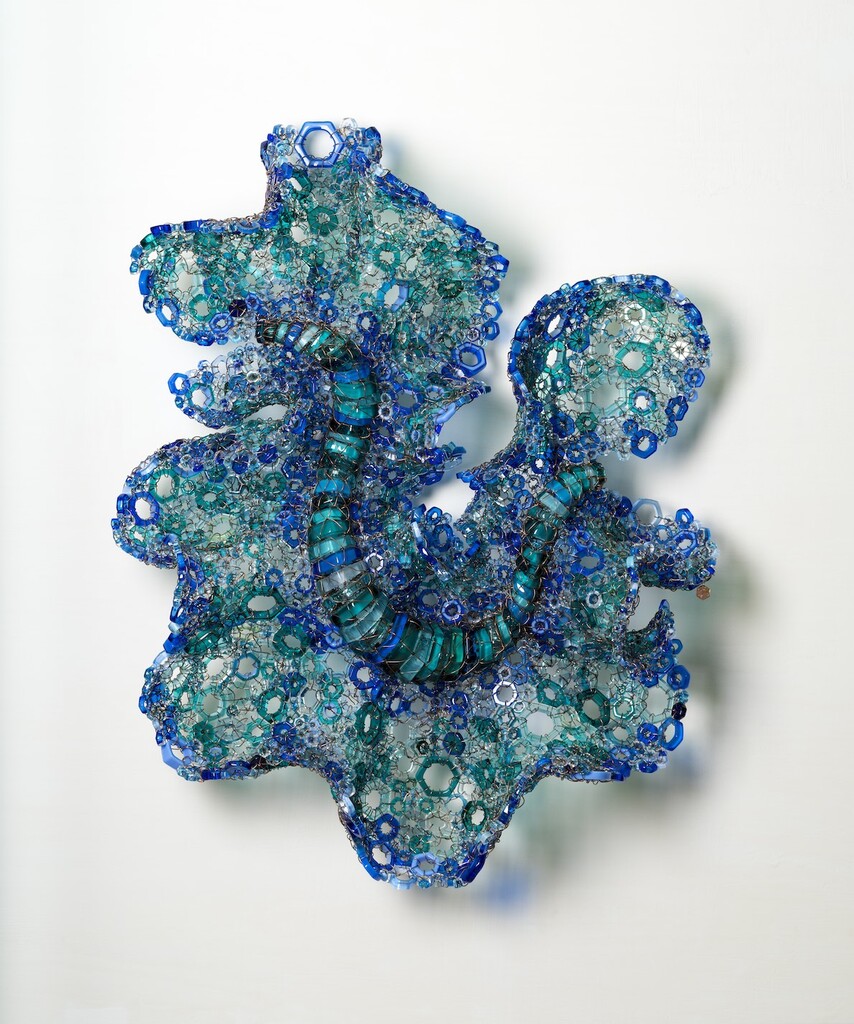
Auric (Polychaetae), Soft Sculpture 2021, 33.5” x 25.5” x 8.5”, Artist Inventory #: SS21-01, Blown glass, mixed cobalt blue and turquoise hollow murine woven into a stainless-steel armature with copper wire. Photo: Ian Lewis
Auric, it is a romp of color and form, a sculpture that embraces fractal expansion in a fantasy seaweed form. My poem of respect and thanks for the contribution of algae as ecosystem regulator and climate regenerator. I designed the metal work that supports the sculpture, and when I received it back from the metalworker, I take my palette of colored hollow murrine and weave it to the form with patinaed copper wire. I know the tips of my steel spokes/supports will be my down beats/closest to the wall points and then I can create the rest of the form by using these anchor points. After this, I let the sculpture speak to me, it emerges from under my hands and after removing parts of it that don’t please me. I allow for growth and exploration with each artwork I make, to keep my mind engaged.
Auric is difficult to photograph, as it doesn’t show it’s contours and convolutions easily in a two-dimensional representation. As the sculpture radiates away from the spine in an aqua glass and towards the edge of the sculpture where the glass is transparent cobalt, the volume of the ripple expands. I don’t like to make the work too predictable. The hollow murrine must link together in a structural manner so that the longevity of the artwork is kept in mind. This takes thicker wire and a stronger hand at the edges. The form resembles the frozen motion of a Spanish Dancer/nudibranch or polychaete worm moving through the water in a rippling motion.
Small
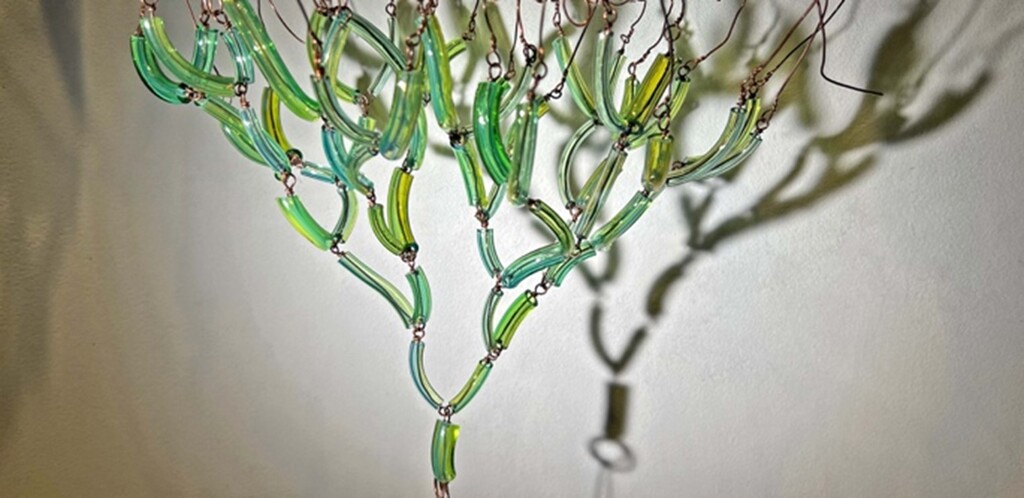 Proto Kelp Forest, Sculpture 2022, 11” x 7.5” x 9” Green and gold blown glass tubing segments, linked together by copper wire.
Proto Kelp Forest, Sculpture 2022, 11” x 7.5” x 9” Green and gold blown glass tubing segments, linked together by copper wire.
This is a small sculpture/model that I created from glass at the Centre du Verre Contemporain last fall in Biot, France. It is an exploration of bifurcation, starting with one tube at the bottom, and branching into two. Then those two branch into two more segments of seaweed, etc.. until the sixth tier where there are sixty-four segments. this art piece or model has really inspired me to begin a round of applications in order to explore its potential. It is simple to handle a 22.86cm tall sculpture, but I would like to work through the engineering to enlarge it to 1 m and over 2 m, bigger than a human. I have seldom been so pleased by the potential of a model. I plan to engraving onto the tube a community sourced word of admiration so that when the sculpture is linked together these words will become poems.
What do you look for when choosing a gallery to support your art?

For the head of the Gallery to have good reputation for being involved in the arts over a sustained amount of time; for the artists who belong to the Gallery’s artists to be ones that I admire and not to be too numerous. Whose artwork is artwork that I could envision being in a group exhibition with. Covid really disrupted the art world, so I don't know what is expected from a Gallery these days. Many have pretty much shifted to online experiences and shows. I would really like to work with the gallery that would with me to promote my work in the region and assist me with commissions.
Contact:
Kait Rhoads
Deborah Blakeley, Melbourne, Australia
Interview by Deborah Blakeley, July 2023
Richard Healy
Your work is divided in two parts, as a Sculptor and Memorial artist.
Which came first?
I studied fine art sculpture at the National College of Art and Design in Dublin and graduated in 2000. I started looking for work straight away. When you leave art college, you find yourself without any of the support structures you were used to, such as access to machinery, space to work or technicians, I think this is especially true if you are a sculptor.
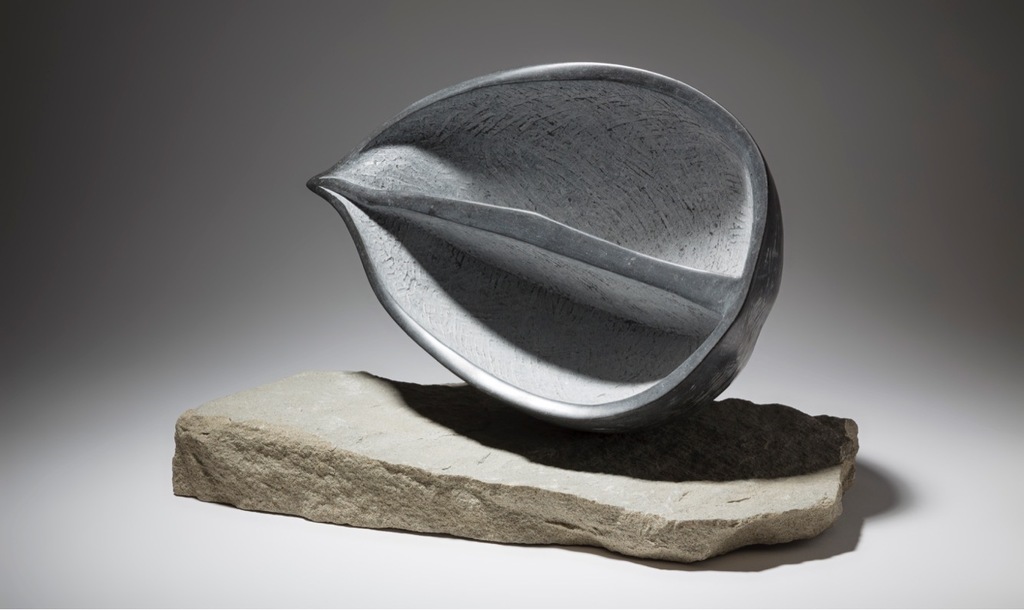
In a Nut Shell
You're kind of tossed out on your ear and you have to start from scratch…. No tools, no studio, and no money. So I went to work in a small foundry for about six months, to learn some practical skills and knowledge in casting bronze…
One evening the phone rang and a stone sculptor called Thomas Glendon was on the line. I had met Thomas during a stone carving workshop at college. He said he had some large blocks of stone in his studio, yard and he wanted to know if I was interested in doing some work for him. I jumped at the chance… and there began an unexpected life in stone. I quickly grew to love stone carving and all the elements of it, such as the tools, especially forging our own and tempering, I also enjoyed the physicality of stone carving. I learned the discipline involved in seeing your way through a carving, from the maquette stage, marking up the block, making templates to the wasting stages and the fine carving and finishing. I always count myself really lucky to have been presented with this opportunity, to accidentally become a stone sculptor in this way.
Tom was a sculptor and Letter carver so this meant the array of work coming into his studio was varied and interesting. One day you could be carving an Altar block or a baptismal font, the next you could be working on one of Tom's sculptural pieces or shaping a headstone or something else.
I worked for Tom full time for about 4 years and got a really great apprentice style training from him. I think one of the most important things I took from my time there was seeing that you could be a professional artist and how to go about it. I worked on projects for Tom on and off for the next few years between doing my own work and commissions and setting up my own practice at D15 studios in Dunsink, Dublin near the old Dunsink Observatory.
So going back to your question about the memorial side of my practice, all that time I had spent surrounded by large inscriptions on headstones and memorials and watching how they were set out and how to lay out inscriptions. From choosing letter forms to work with or an appropriate stone type, spacing, and the rhythm of a piece all informed my own practice.
Once I had moved into my new studio I was also very lucky to share it with another stone sculptor called Stephen Burke who had studied Architectural stone carving in the City and Guilds in London. Stephen brought a great formal training back from the UK and we have been sharing our D15 studio for the last 15 years. The shared space of our D15 studio has been a really nourishing environment for creating work, sculptural and memorial.
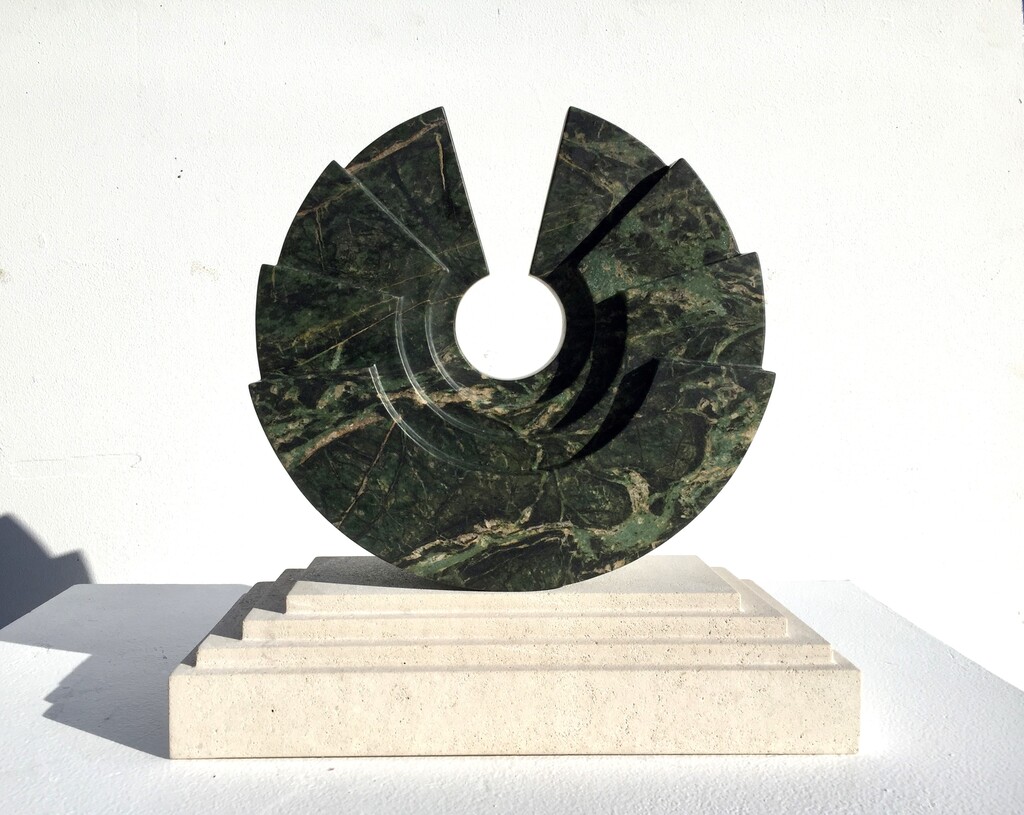
Again back to the question, Sculpture first and memorial work followed that. Both are extremely important to my practice. My fine art sculptural work is often done for myself, with a view to exhibit the work but the memorial work has an equally important role to play. It brings a kind of discipline to my practice. Not that I'm undisciplined, but rather a formal side or return to basics.
Does your memorial work need you to spend more time with the client?
Deciding on the body of text is one of the most important things to be considered with a memorial. There can be a lot of discussion with a client over this and it can be tough on folks because they have often lost someone very close to them. In some ways the memorial or headstone can be the hardest part of the grieving process because it gives a sense of closure or finality.. and the sentiment is a personal choice, it can be hard to decide on. I lean towards a less is more approach but once it is decided upon, you can start to lay out the text.
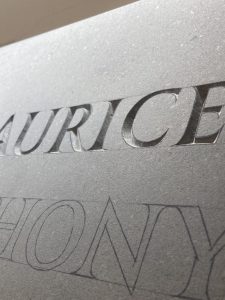
Cut letter close up
With an inscription there is a hierarchy of information such as names and dates, that sort of thing….. you also have style choices and what letterform is appropriate and spacing considerations.. The aim is to create a piece that has a balance to it.
If it happens to be a headstone you will have a certain amount of parameters, normally cemeteries have height restrictions etc and it is your job to create a balanced headstone within these set sizes. Sometimes the client will be leaning towards a stone or letterform they have seen somewhere else and this can be helpful to give you a start or a direction to follow.
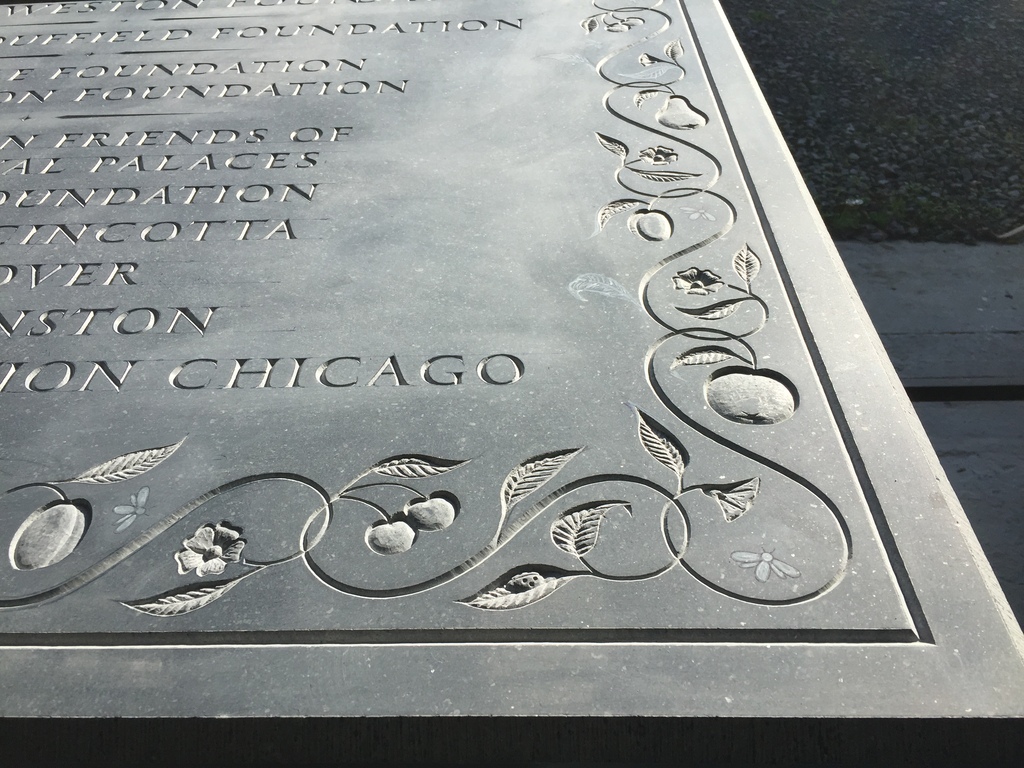
Floral-border-close-up
Often during the carving process, the client will visit the studio to see the progress.
The final part of the monumental process is installing the piece on site. There is a certain satisfaction in seeing the piece in its final resting place… Sometimes I have another headstone already in a particular cemetery and while I'm there I always go visit to see how it looks and reflect on the job. And ask myself the question are there things I'd change about it now? I think as an artist there is a constant evolution and it's always good practice to check in on past work.
What does it mean to be a member of the Letter Carvers Guild?
I remember presenting my work to the letter carvers guild many years ago… It was after I had built up my own body of work, such as letterforms, memorials and commissions. It was a little daunting for me, but I was delighted to be accepted into the guild.
We have had some exhibitions over the years, where the aim was to promote the art of the carved letter and encourage each other to push boundaries and use different materials and letterforms. Each stone type brings out a different quality in the letters and you must adapt the letterforms to suit. The Guild is not as active as it once was and maybe it's time for us, the younger generation coming through, to pick up the mantle and run with it.
Hillsborough Close-up
Is this art form going through a revival?
Somebody asked me about this the other day and in all honesty I would love to give you an outright yes, but it's hard to know if there is a revival. It is certainly not a dying art. I have clients that only want hand cut letters and the people that come to me for a memorial have already made that choice.
Letter Carving is time consuming and requires patience and discipline. A lot of the skills for carving letters tend to lie with the hand sculptors. Carved letters are so very sculptural in their own right that often sculptors and carvers are compelled to master the art of the cut letter…. and as long as they do this, then letter carving will live on.
There are letter carving courses to be found in Ireland but there is a greater tradition in the UK especially with the likes of the Cardoza Kindersley studios. But If any of your readers are keen on taking up letter carving, a great book to get your hands on is, “The art of letter carving in stone” by Tom Perkins. I reference it all the time. This will give you a step by step approach on lettercarving. I have a studio copy with dog ears and loose pages falling out because of the number of times it's been thumbed through.
Do you also need to be an excellent calligrapher?
It's not essential to be an excellent Calligrapher, but it will help just to give a basic understanding of the structure of letters. I personally don't work this way. I draw my letters with pencil on paper. Many letter cutters would have traditionally drawn or painted the inscription directly onto the stone, maybe working from a small sketch or layout of the inscription.
Take one piece and discuss it in relation to design.
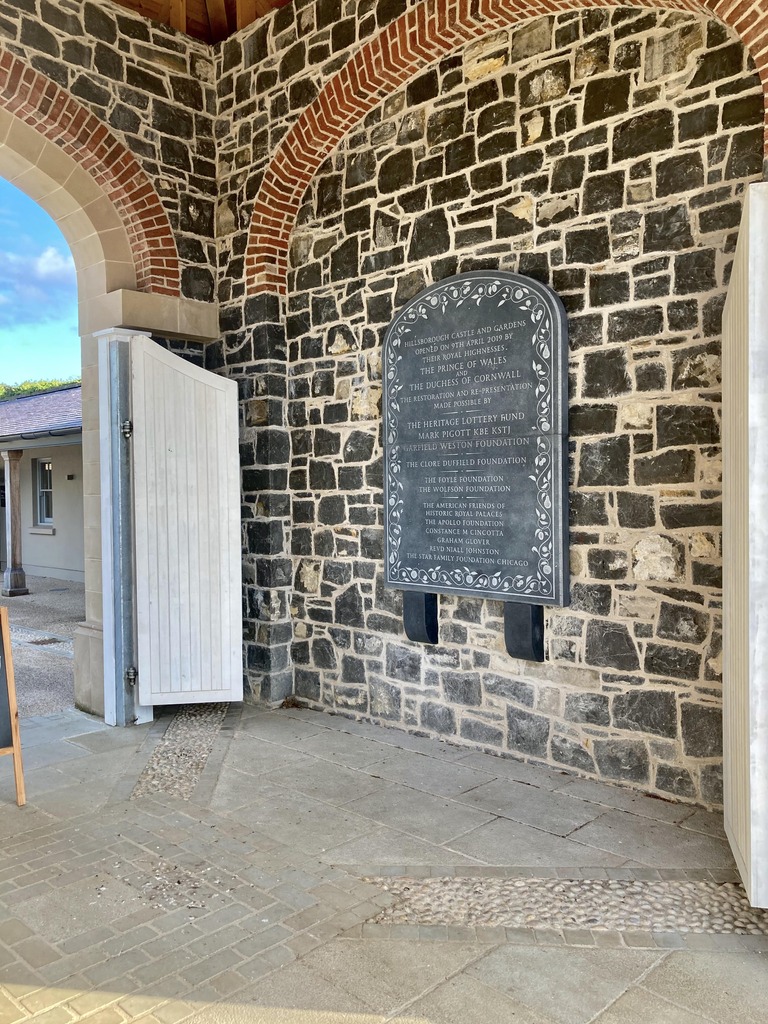
Hillsborough
In 2019, I was approached by the Historic Royal Palaces to create a large memorial inscription for Hillsborough Castle in Northern Ireland. The castle and walled gardens were re-opening its doors to the public and they wanted a stone inscription to mark the occasion and acknowledge the donors who made it possible.
My brief was to design this memorial for installation in the newly built gate lodge.
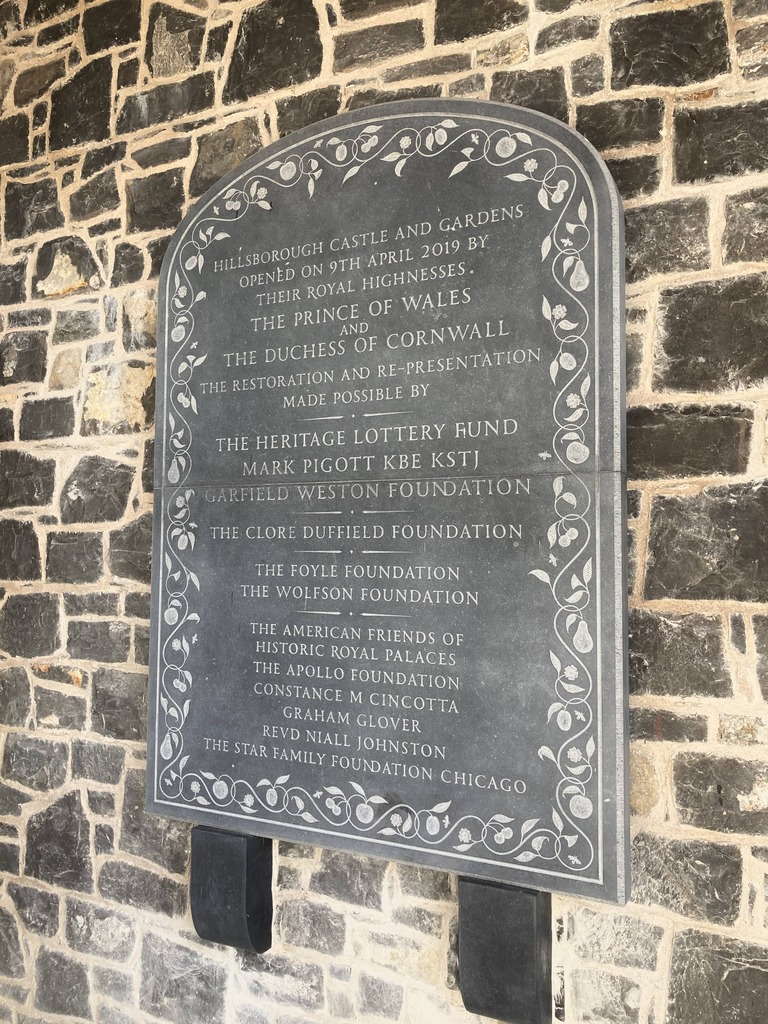
Hillsborough, Close up
I designed the shape of the stone tablet itself to mirror the arch of the gate lodge building where it was to be erected. I then laid out the inscription to sit within an intricate decorative floral border. This floral border was inspired by the native fruit trees in the walled garden at Hillsborough and contained elements such as apples, pears, plums, cherries and a few pollinators too. It was carved in Irish Limestone and measured 2.4 meters tall by 1.2 meters wide and contained about 450 characters.
I was working on it for months. The fruit border was really enjoyable to carve and I had to get the right balance between it and the inscription. If you look closely you will see little carved bees flying among the carved flowers. It was a wonderful commission to get, one of those commissions that only come around a few times in your lifetime.
Fruit-and-flower-test-piece
From the commissioning to the final placement of the work, are you under a strict timeline?
Sometimes yes, there is a deadline for a piece to be completed. It tends to be an anniversary or a significant date. Sometimes people come late in the day with a date and it is not possible. Things carved in stone take time to do right. Even just ordering a block from a stone yard can take 4-6 weeks lead in, from the time you order to have the stone in your studio.
Seminibus
Your sculptures are very dependent on the natural world, discuss.
When it comes to my own sculptural work, the natural world is a huge inspiration. I spend a lot of time in nature, I am forever picking up seed pods, shells, nuts and natural oddities. I love the textures and shapes and I reckon that mother nature is an infinite resource for all artists. Every season has something to offer and every year I wonder how I hadn't spotted something that I just discovered, before now.
Comment on the importance having your work in the grounds of Áras an Uachtaráin, as an Irish sculptor.
Having my work at the president house is a massive honour, I can't believe that my two pieces have been there over 10 years now. This was my first public commission and was commissioned by President Mary McAleese through the OPW. It was one of the last things she did before finishing her time in office.
It was a really important learning experience for me too, I think it's a tough thing as an artist starting out. If you are going for commissions, there is a bit of a chicken and egg situation going on. You can't get a commission if you haven't got commission experience and you can't get the experience if you don't get commissioned.
Throughout this commission I gained invaluable experience. It allowed me to see what size and scale were possible within certain budgets while working with foundries and stone yards, making sure that you as the artist get paid too. It really brought a new level of professionalism to my practice and gave me a greater understanding of the amount of administration involved in dealing with commissioning bodies.
The brief was to create new works for a sensory border at Aras an Uachtarain. I was one of five artists shortlisted and I created maquettes for 3 pieces, 2 of which were commissioned, “The Braille alphabet” and "The Bronze bluebells”.
The braille alphabet consists of 3 Limestone panels 2 meters tall by 50 cm wide. Each of the 26 letters of the alphabet are carved into them, large 20cms tall V-cut letters.
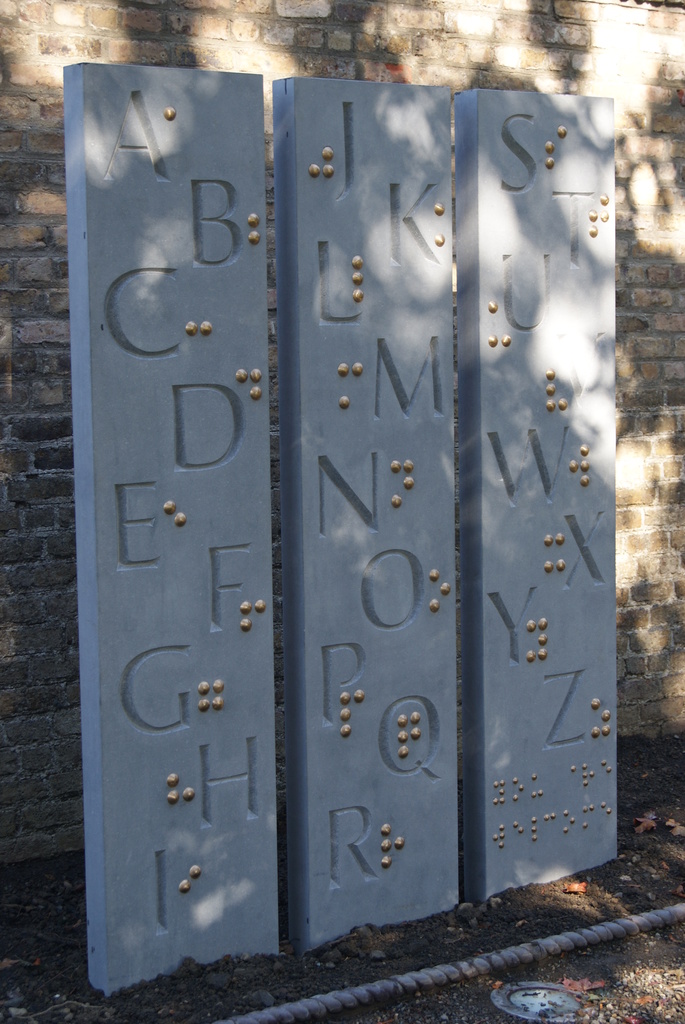
Braille-Alphabet
Each letter has its equivalent braille in bronze next to it or around it. The idea behind it was to let someone who was visually impaired or unsighted run their fingers through the v-cut letter and get a greater understanding of the structure of each of the letters. The same for someone who had no previous exposure to braille, they could experience it. It was my first full alphabet too which was really nice… When you carve letters that large they take on a real sculptural quality and there is something wonderfully satisfying to carving them.
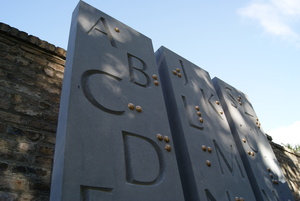
Braille-Alphabet, close up
The Bronze Bluebells sculpture was dealing with the sense of sound. It consisted of 7 individual bronze bluebells, each of a differing size.
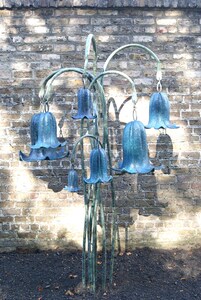
Bluebells
They were hung from 7 bronze stalks (2.5meters tall) and each fitted with a ringer. I modelled each bluebell individually and directly in wax and they were cast using the lost wax method. Each of the bells had a blue patina and made a wonderful sound when they rang.
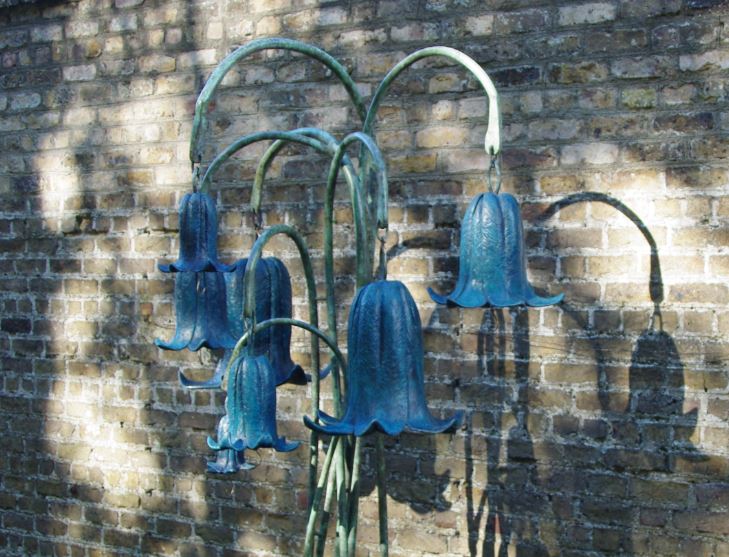
Bluebells, close up
In charge of the foundry where I cast them at that time was a man called Leo Higgins. I had a good relationship with him and he had taught me for a time in college. Leo was a character and a great artist and I will always be grateful for his kind nature and guiding hand throughout the casting process.
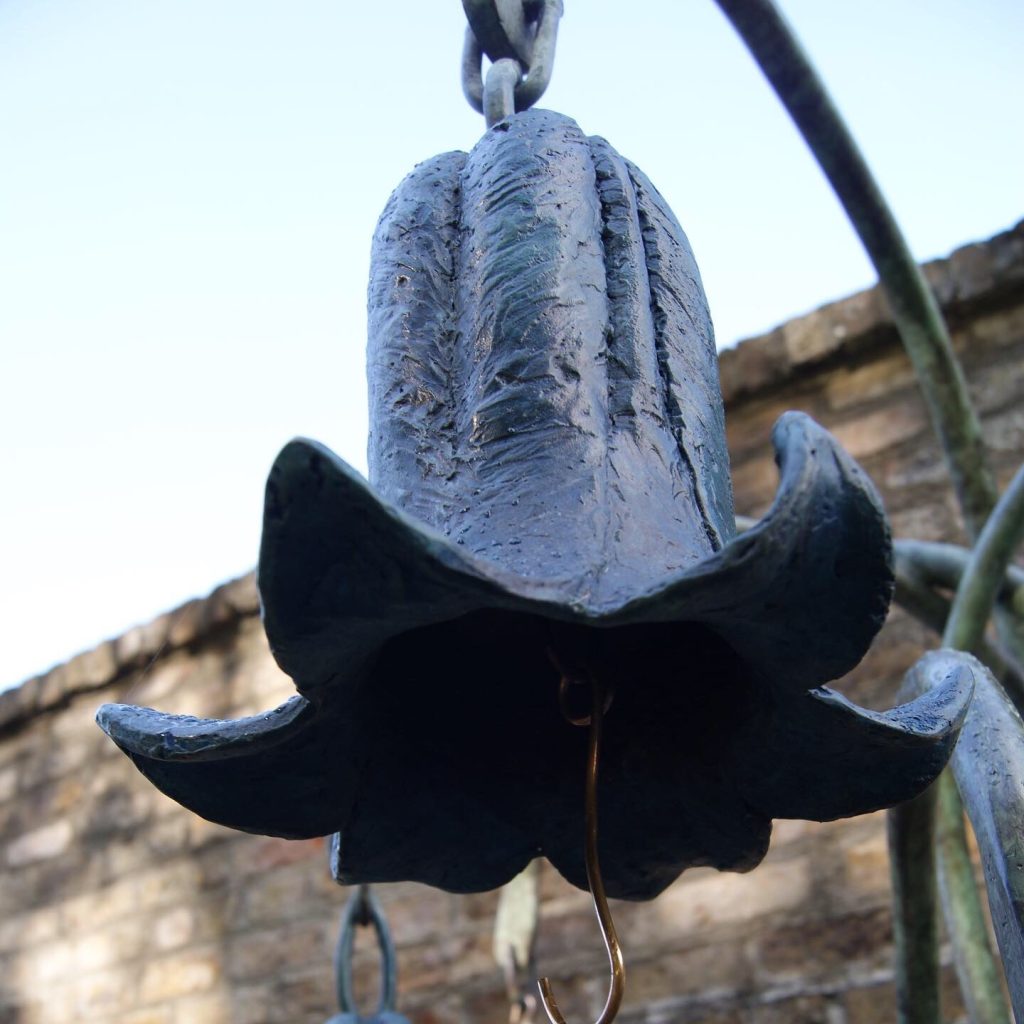
President, Michael D Higgins ringing the bells.
I was sent a photograph by someone who had attended a garden party at Aras an Uachtarain recently, of our current President, Michael D Higgins ringing the bells.
Explain about ‘Sculpture in Context’ and your work there.
Sculpture in context is the largest annual outdoor sculpture exhibition in Ireland. It's been running for over 35 years and was set up by artists for artists. It has had many venues over the years but it currently resides in the National botanic Gardens of Ireland. The gardens have been hosting the show for over 20 years and it's been a great marriage.
I was a member of the organising committee of Sculpture in context for about 8 years. This was the first show that I ever exhibited in. I was buoyed by that experience and I went on to submit work for it every year since. It's the reason why I wanted to give back and get involved in the organisation of the show. I have made some great friendships through this exhibition from committee members to meeting other artists to meeting gallerists and clients.
I have sold work, won awards and been commissioned through this exhibition. I really like the mix of the artists involved every year, from new graduates to established artists and to everyone in between. It's a really important date on the artistic calendar for me each year.
Tell us about one of your sculptures in Taiwan representing Ireland and UK artists.
This show was really interesting. I was approached by the curator to participate in a show that was taking place in Taiwan. It was a great opportunity to have some of my work exhibited overseas, so I jumped at the chance. I sent some images to the curator of the show of my available work. They picked three pieces and I boxed them up for collection. There were some really top names in the exhibition too, like Peter Randall-Page. I never got to travel to the exhibition purely because of financial constraints but the participating Irish artists all met with the Taiwanese ambassador for lunch in Dublin. All the artists were at different stages in our careers and there were some interesting conversations.
The one piece which I sent that stood out for me was a piece I had carved from Irish Limestone, entitled Corolla.
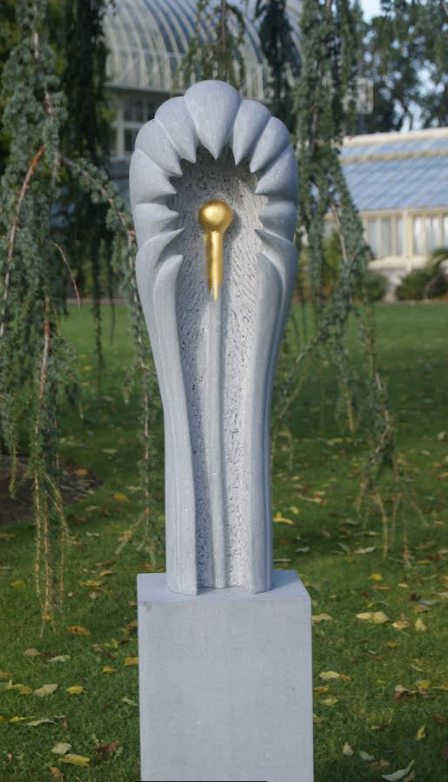
Corolla
This was a really important piece for mycorolla own development as a carver. It has an element of danger portrayed in it. There is a gilded stamen and it's protected by these carved stone dentata. I sold the other works at the show but this one returned to me. I have it in my own garden and recently re-gilded it. I like the way it travelled halfway around the world and has come back to me.
Take one large and one small sculpture, that has given you great pleasure while sculpting it and why?
For the large sculpture I'm going to say a piece from about two years ago, called “Strippeas”.
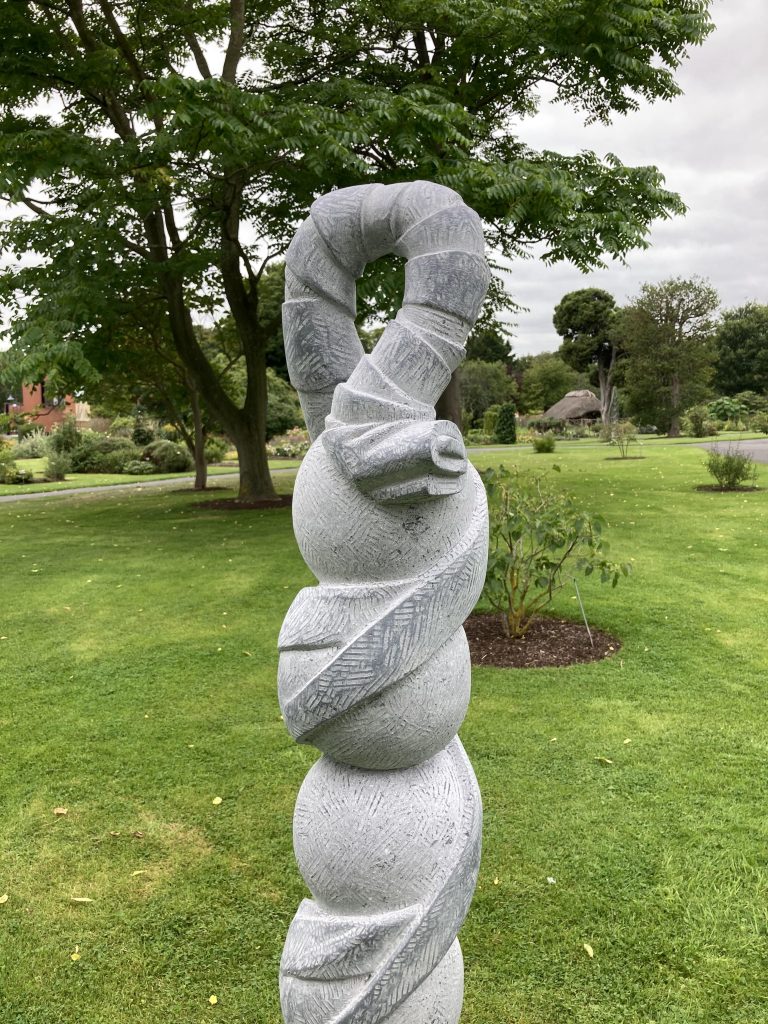
Strippeas
It was a 1.6mt tall Kilkenny limestone sculpture. I have been carving peapods for a number of years and this piece is an evolution of this theme. I have visited this subject matter a number of times and each time I finish one I think that's it now, but then a notion drops into my head or I have a flick through an old notebook and see an old sketch and it triggers the next avenue of exploration with this theme…
This piece represents a skinned peapod with the skin wrapped background itself like drapery. I had a faint notion of Saint Bartholomew at Milan Cathedral in which his flayed skin has been removed, “Senza pelle” as they say in Italy to reveal his muscles and tendons. His skin has then been wrapped around him like a piece of cloth or a toga.
My piece is a bit less gorey and just a bit of fun. It gave me a chance to explore my peapod theme and experiment with some drapery and create something with a little backstory. It was a large enough piece for me to really get stuck in and enjoy the process. It picked up a stone carving prize at sculpture in context in 2021.
The smaller sculpture, I am going to say a Portrait sculpture of my father in law, it's a lesser known side of my practice.
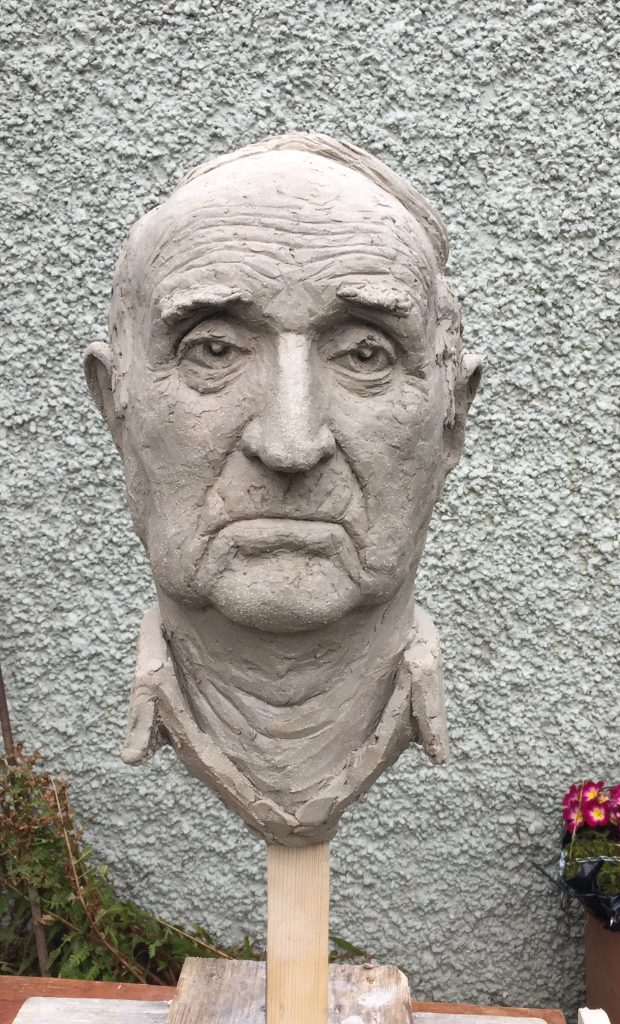
In recent years I have been working in clay more and more and I've built up a number of portrait studies. But this one stands out as most memorable as an experience. It was during the height of covid lockdowns and I had no access to my studio, tools or stone. I did have a large bag of clay lying around and I asked my father in law to be a sitter for me, so I could model his portrait. Each day he would sit for about 90 minutes and I would build up his likeness in clay. He was about 84 yrs old at the time. I was mindful not to have him sit for too long, but over about 10 days or so he would sit up on the chair and I'd get out the portrait bust and work away modelling. Meanwhile he told stories about life as a boy growing up in Crossmolina. This is a little village in County Mayo in the west of Ireland. I had heard some of the stories already but there were some real gems in there, a few salty ones too but they'll have to stay with me. It's a bit like a doctor/patient confidentiality agreement..
There is something really enjoyable about this aspect of portraiture, the rapport that is built up between artist and sitter. As the artist you hope that you bring some of the personality of the person to the portrait.
The rest of the family and I were really happy with the portrait and I had it cast in bronze and we presented it to him at his 85th birthday. Immortalised in bronze.
Contact:
Richard Healy
www.richardhealysculptures.com
Instagram. richie_healy_sculptures
email. richiehealy@gmail.com
Deborah Blakeley, Melbourne, Australia
Interview by Deborah Blakeley, June 2023
Lindsay Madden
When did you become interested in using childhood in your work?
During my time at university, I experimented with using photographic imagery in my work, initially collaging images from different eras to create new narratives. It was while I was trawling through family of my own childhood and my children’s that I was drawn to the universal and timeless quality of children’s body language; there is observing/perceiving an honesty to it, that is not always visible in adults.
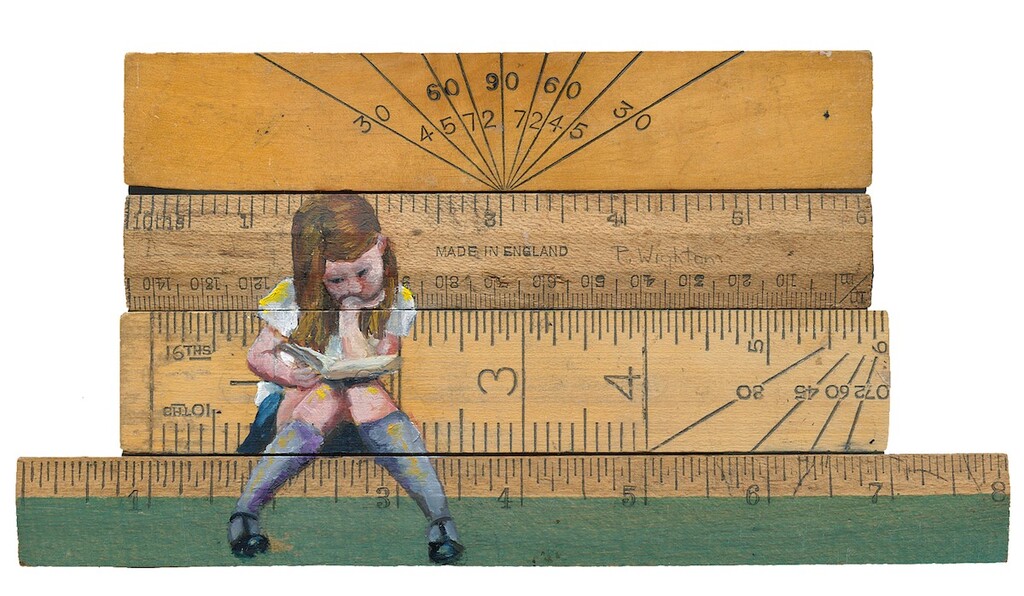
'Short Stories'
How and why have you gone beyond recording your own children and developing your own medium?
In truth I pretty much exhausted my own family photo albums, friends were king enough to let me loose with their albums. I now find using found photographs gives me a sense of freedom, without knowledge of their past makes it much easier to respond the body language and invent my own narratives.
Use Two rulers and discuss the body language in them.
‘Stretched’ was one of my first paintings on rulers, it was part of my degree show.

'Stretched'
The little figure reaching up perfectly reflected my feelings at that time. I was essentially back at school, still growing, academically and mentally rather than physically, being stretch in so many different areas, juggling busy homelife, parttime job and life as a mature student, at the same time, my capabilities were still being measured.
‘Another Perspective’ is a piece that holds a special place for me. The curious little figure, checking out her subject, from an unusual angle, sums up the childhood connection to being an artist, the desire to see the world in a different way. The lack of self-awareness embodies the honesty of children’s body language which appeals to me.
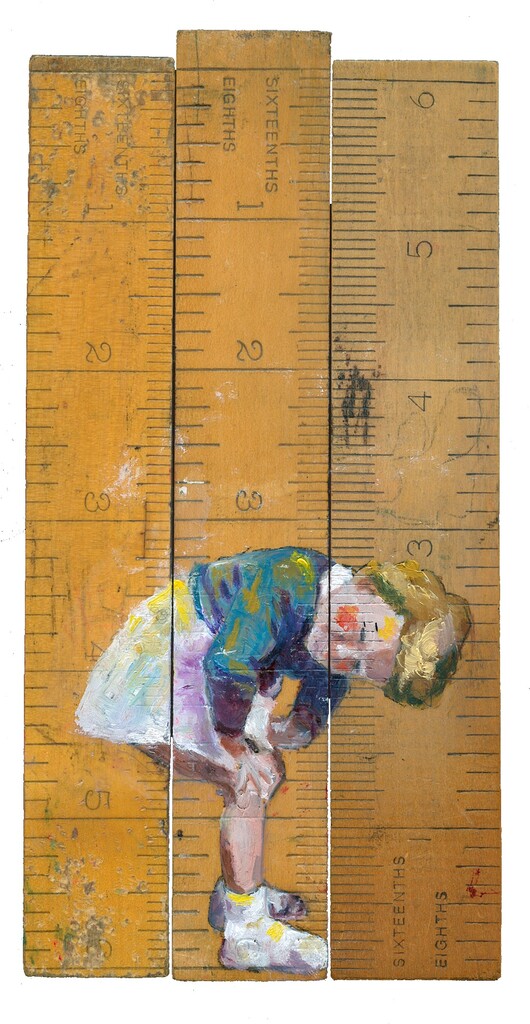
‘Another Perspective’
What lead you to use vintage ruler and blackboards?
I’ve always preferred painting onto a wooden surface, rather than a canvas. Exploring the theme of childhood and its transient nature led me to consider how quickly children grow and how we record that. Height charts sprang to mind, which in turn lead me to school rulers, mini height charts, and in turn the possibilities of other school equipment such as protractors and chalkboards.
Discuss ‘Round in Circles’ and ‘One Size Fits All’ and your use of many children together.
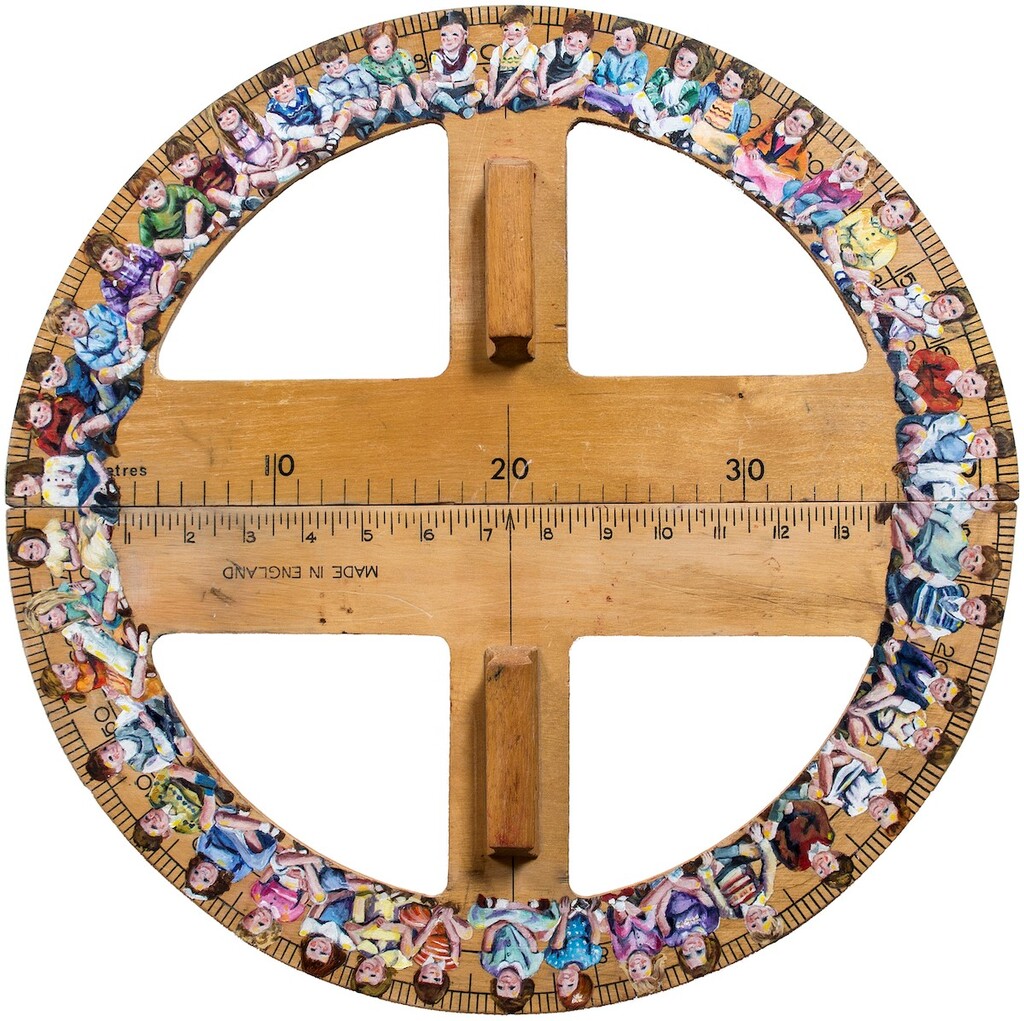
‘Round in Circles’
I’d managed to collect several large wooden teacher’s protractors and was interested in the way they fit together to form a circle, which reminded me sitting in a circle to play the children’s party game ‘pass the parcel’. I wanted to squeeze as many little characters into the composition as possible as that cramped environment is how I remembered playing that game, the feeling of excited eagerness to get your hands on the parcel. I felt that the title ‘Round in Circles’ was a metaphor that could be applied to adult life, when you can feel there is a relentless lack of progress. I’ve always felt frustrated with our education system that takes a ‘One Size Fits All’ approach, and the preoccupation with measuring performance. The piece comments on the notion of school uniform making everyone the same but the fit is always different as no two children are the same.
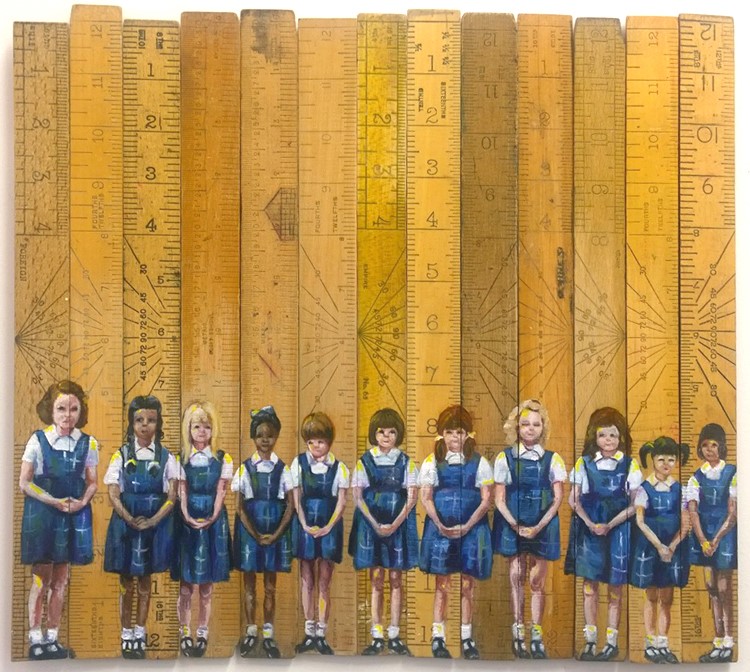
‘One Size Fits All’
Does your work take us back in time? Eg ‘Close Knit’
There is a definite nostalgic feel to the work with those home knits and retro outfits, and the well-worn vintage rulers that have been handled through generations. My hope is that although figures have a nod to the past, the narratives and titles are relatable to present times, ‘Close Knit’ comments on those special bonds of friendship that can be formed during school years.
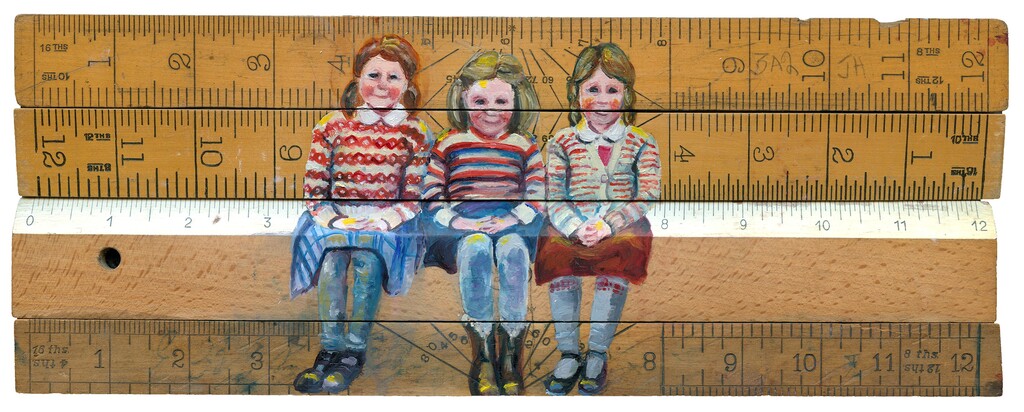
‘Close Knit’
Do people purchase your work both for the painting and their own memories?
It has often been commented by people who have seen my work that they enjoy being nudged into their own memories of childhood. By setting the figures within a context that is both familiar and ambiguous it allows the viewer room for their own experiences and memories to breathe. Galleries and social media suggest that the work has been a great conversation starter for viewers to take a trip down memory lane, whether it’s the recollection of the wooden rulers, the activity of the children in the painting, or some item of clothing, are able to see both themselves and their own children.
How many rulers have you put together for one of your larger paintings?
One of the largest compositions of multiple rulers together is a recent painting ‘The Long and the Short’ which is made up from fourteen rulers placed vertically together.I have also used yardstick and metre rules, (e.g., Pull Together’) which took the alternative canvas size to 100cm.

’Pull Together’
Not all of your work is just children, comment on ‘Temporary Measure’
‘Temporary Measure’ is a very early personal piece that was inspired by a cherished photo of myself as a child with my stepfather. In recent years I’ve chosen to focus primarily on children, opting to keep compositions simple, keeping observations of relationships between the little characters themselves.
 ‘Temporary Measure’
‘Temporary Measure’
How do you come up with all the individual titles?
I aim to look for titles that can work on several levels, something that can be taken at face value and can be interpreted on a deeper level. Sometimes a piece can start with a title, sometimes it is inspired by a photographic image or simply an idea and the titles come when the work is finished, but it’s always on the tip of my tongue.
You don’t have as many protractors, is this because there are not as many available?
Yes, exactly that, they are much more difficult to find.
The chalkboard paintings are those done on the old individual school boards.
Some of the chalkboard paintings are painted on vintage slates, or vintage children’s chalkboard easels. The very large scale 6feet x 4feet pieces are boards I have mad myself to echo those classroom chalkboards from my school days.
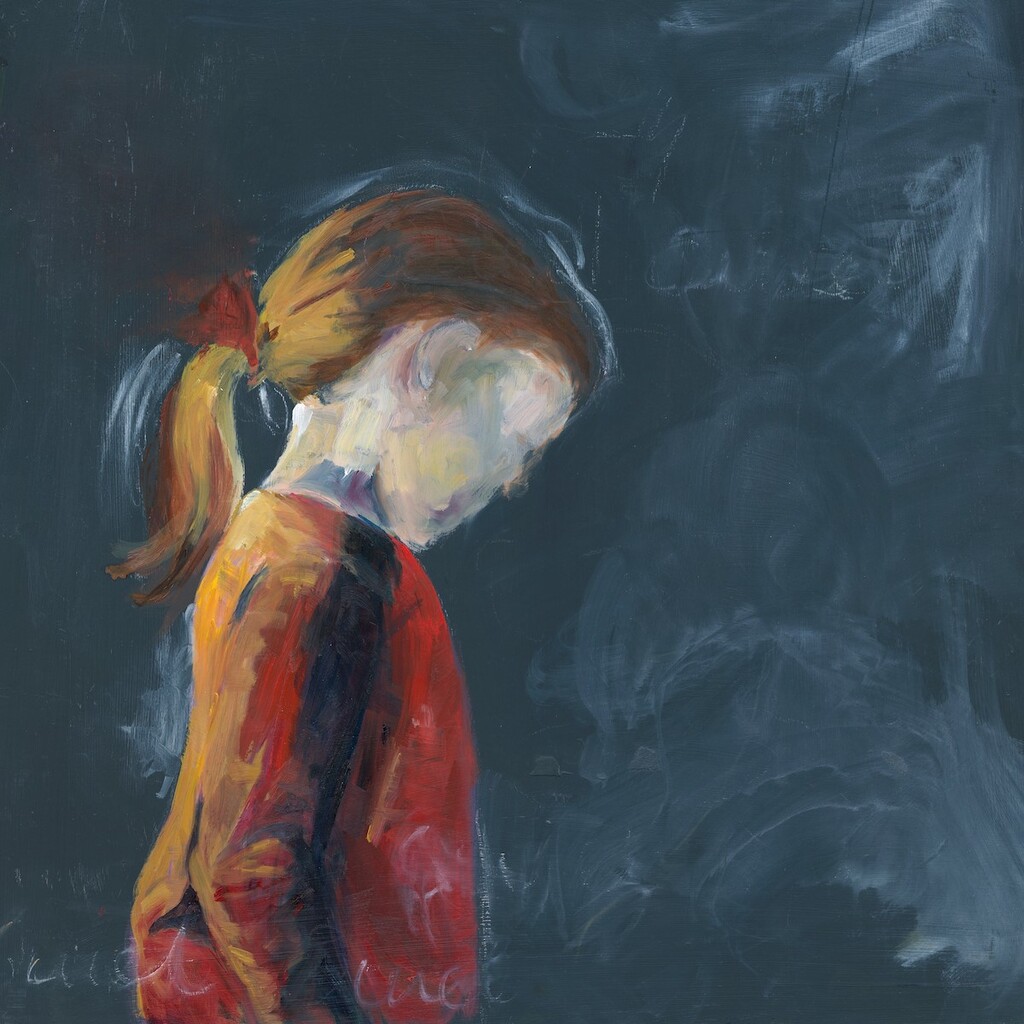 'Quiet, Painted on Chalkboard'
'Quiet, Painted on Chalkboard'
Your children are depicted in the most casual manner, so different from studio photographs of well combed perfect children. Discuss, Equal Measure.
 ‘Equal Measure’
‘Equal Measure’
My interest lies in the uninhibited freedom of children. I enjoy juxtaposing the freedom that children feel while playing, throwing handstands and cartwheels etc against the confines of the rigid limitations of the ruler.
Can you explain more about your Observer Books?
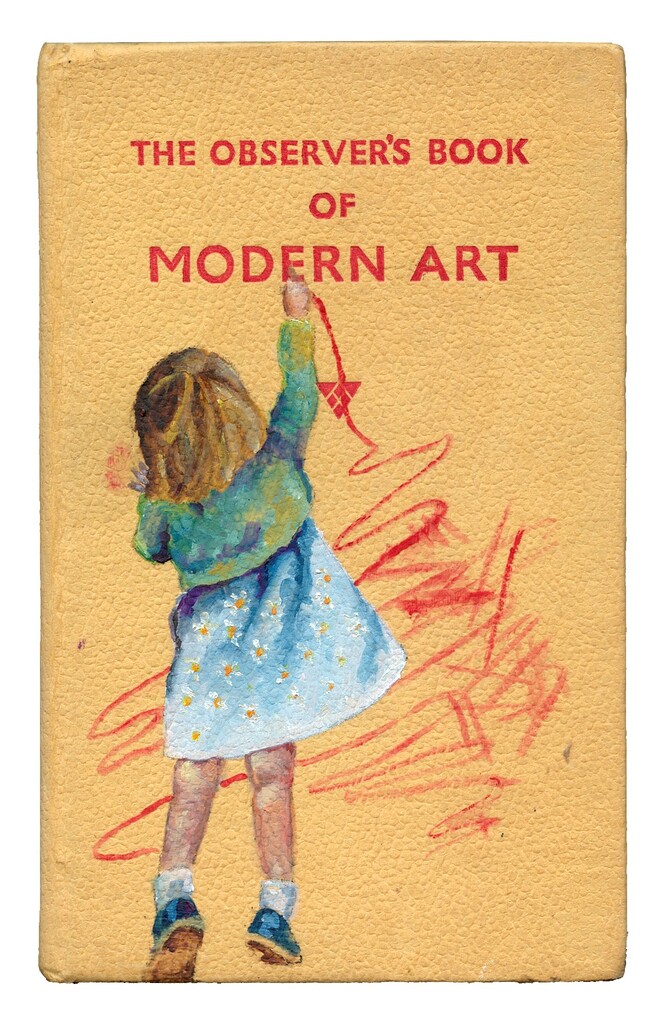 'Red Handed'
'Red Handed'
The aged appeal of those well-thumbed Observer books that boast a wealth of knowledge, offer an irresistible alternative canvas. The tactile familiarity offers the perfect backdrop for the playful interpretations of their subjects. Their colourful covers contrasting with the bold type face of the title form an integral part of the gently mischievous compositions, nostalgic loosely painted figures aiming to bring a smile to the viewer.
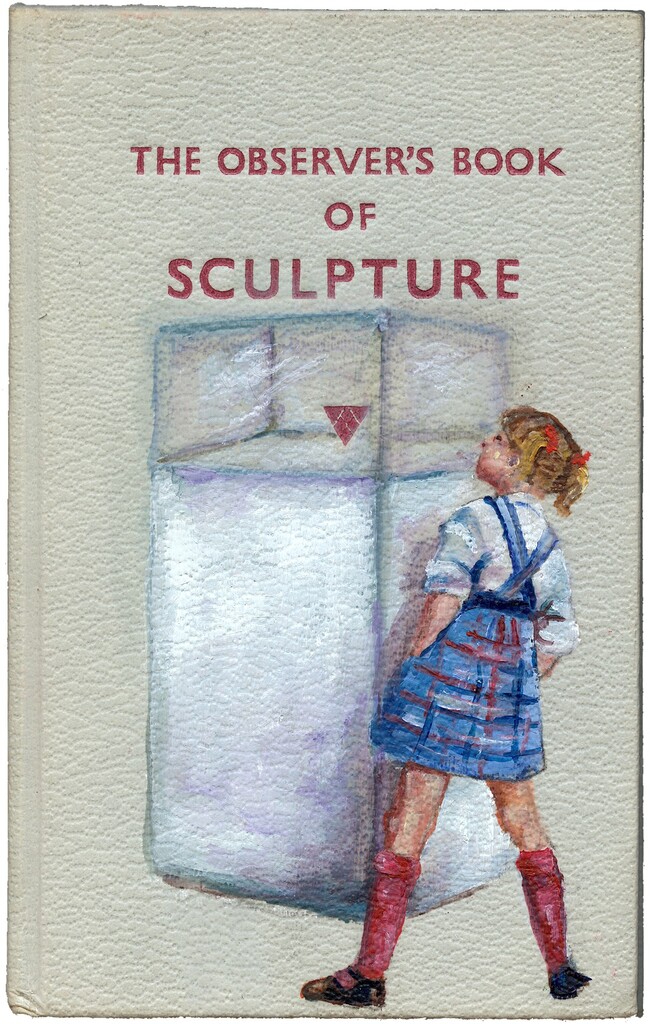 'Look Don’t Touch'
'Look Don’t Touch'
Discuss your relation to the way we need to continually measure Children both at home and school.
Theodore Roosevelt once said that ‘comparison is the thief of joy’ yet as a society we have preoccupation with measurement. From the moment we are born a plethora of statistics are recorded, weight, length, head circumference etc. Throughout life we have this compulsion to measure and compare, we’re constantly on a path to hit relentless milestones, our schooldays especially burdened with all aspects of measurements, physically, mentally, academically and against siblings and peers.
Contact:
Lindsay Madden
lindsaymadden21@gmail.com
www.lindsaymadden.com
Deborah Blakeley, Melbourne, Australia
Interview by Deborah Blakeley, May 2023
Sally Ward
What led you to specialize in portrait painting?
I’ve always been interested in the human figure as a subject and used to draw faces endlessly as a child. About 10 years ago when I picked up painting again, a friend commissioned me to paint a portrait after seeing a sketch I had done of my son. I’ve not been without a portrait commission on the go since then.
The allure of portraiture is not just about finding a physical likeness but is also about revealing an emotional truth about the sitter or the sitter’s situation. The portraits which I am most attracted to as a viewer are those which move me on some level and those which prompt me to ask questions. I find faces and people continually fascinating. The expression and posture of a sitter can tell a whole story about that person.
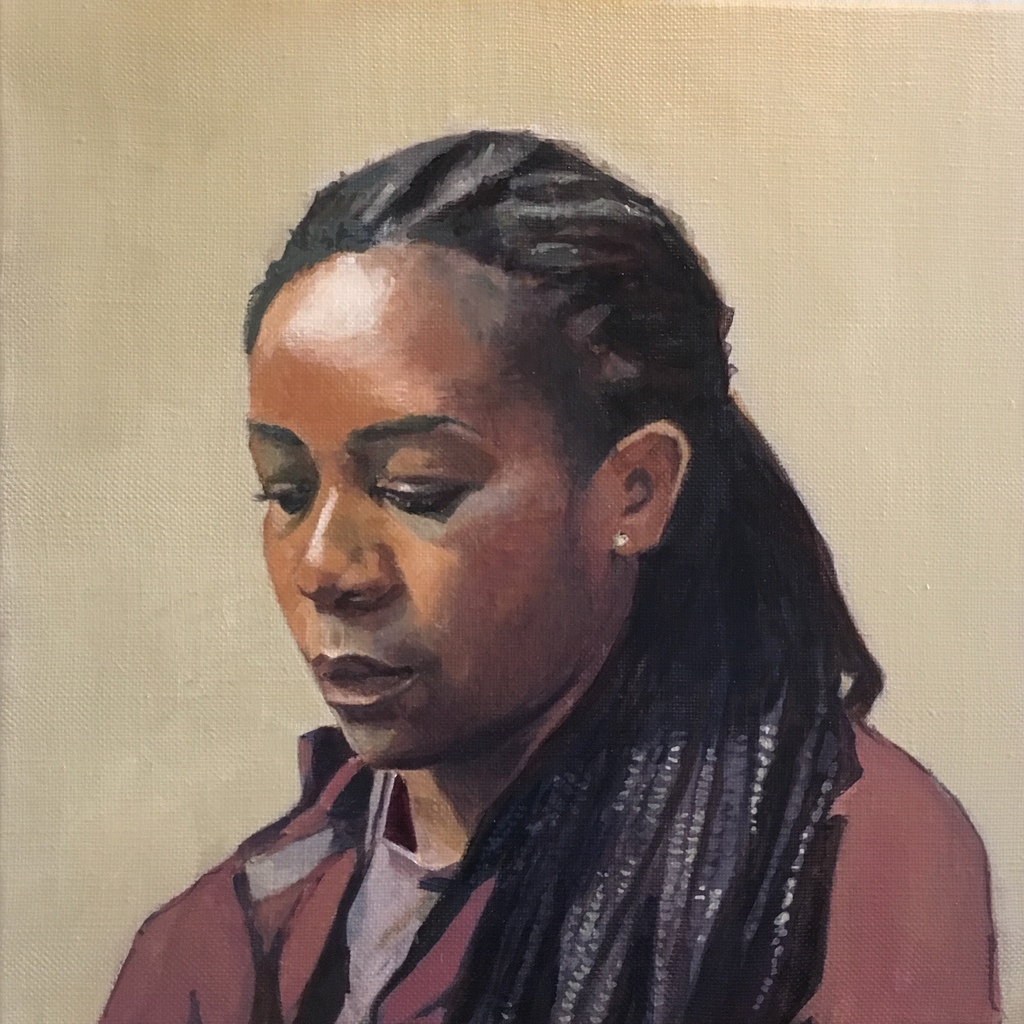
Lulu, oil on canvas, 30cm x 30cm
Are most, of your portraits commissions?
I always have a commission on the go or in the pipeline, but I try to ensure that I find time for my own work as well so that I can develop my practice without the worry of needing to meet a brief. I can be hard to get the balance right sometimes.
Do you say, ‘Yes’ to a commission, face unseen?
I prefer to have sittings for a commission as I find it important to get to know the person I am painting. The personality, gestures and subtle quirks of a sitter will very much inform my painting, as much as the physical characteristics. I cannot really explain how this happens, but it just does. I feel the portrait will have more emotional depth if I have some form of connection with the sitter.
Discuss a face that was full of character. Why it excited you right from the beginning?
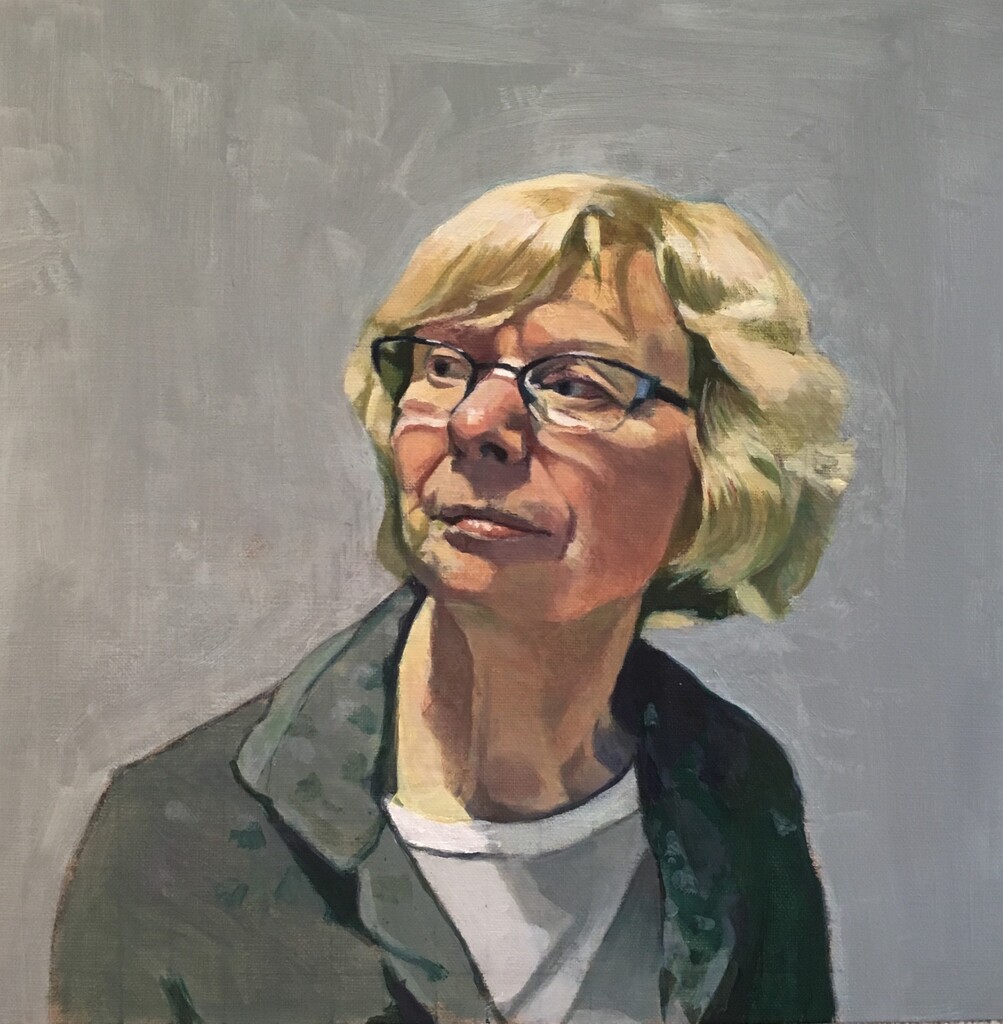
The Artist’s Mother, oil on canvas, 30cm x 30cm
One of my first oil portraits, painted around 5 years ago, was of my mother. She was full of worry at the time, moving out of her home of 40 years and life seemed very uncertain. It wasn’t really a conscious thing to want to paint her in that state, but the emotions of the time (for both of us) were so powerful that the portrait was a means of expressing them. It’s an honest portrait – not flattering, but a very accurate description of her at that time.
How do you get your sitter, to be relaxed?
I find that on first meeting, both the sitter and I can be a little nervous which is natural. I prefer to have a chat with my sitters to begin with usually in their own homes to get to know them a bit and find out what they are hoping for from the portrait. My brain will be taking in all sorts of information (consciously and unconsciously) about their gestures, how they sit, their dominant expression and key aspects of their personality which will feed into my ideas for the painting. I will then do some sketches from life which is very useful for getting to a place of stillness. I usually find that after this, sitters are more relaxed, I can then take some reference photos as well.
How do you keep the work honest without upsetting the sitter?
I particularly enjoy painting close family or friends who I know are happy for me to interpret them as honestly as possible. For commissions, it can sometimes be more challenging because these paintings serve a different purpose. A sitting will be a collaboration of finding the right pose and expression which best reflects the sitter, but which also has the potential to be a great painting.
Show and explain the three mediums you use, oils, watercolours, and charcoal, and why you make the choice?
Oils and charcoal are the mediums I feel most comfortable with. When I was a teenager, I did a lot of life painting in oils and life drawing in charcoal. I like standing at an easel which works really well for these two mediums.
I love oils because of their versatility. You can evolve paintings, work over them, and build up depth which is difficult to obtain with other mediums. There are also so many techniques which can create different effects many of which I employ in my work – such as glazing (building up layers of thin paint), alla prima (wet on wet), scumbling (dragging a dry brush with minimal paint on it), and sfumato (softening edges).
Charcoal is also a wonderful medium – I enjoy working quickly and loosely with it, for tonal studies and life drawing.
Watercolour is a more precise medium. I picked up watercolours out of necessity when my children were very young when I didn’t want to leave oils around. It’s a lovely delicate medium but it requires me to work extremely slowly and precisely which is perhaps not where I’m most comfortable as an artist.
You painted my dear friend, Nancy who died recently. Discuss the importance of this commission. How it feels to know that your portrait of Nancy is now a living memory for her family.
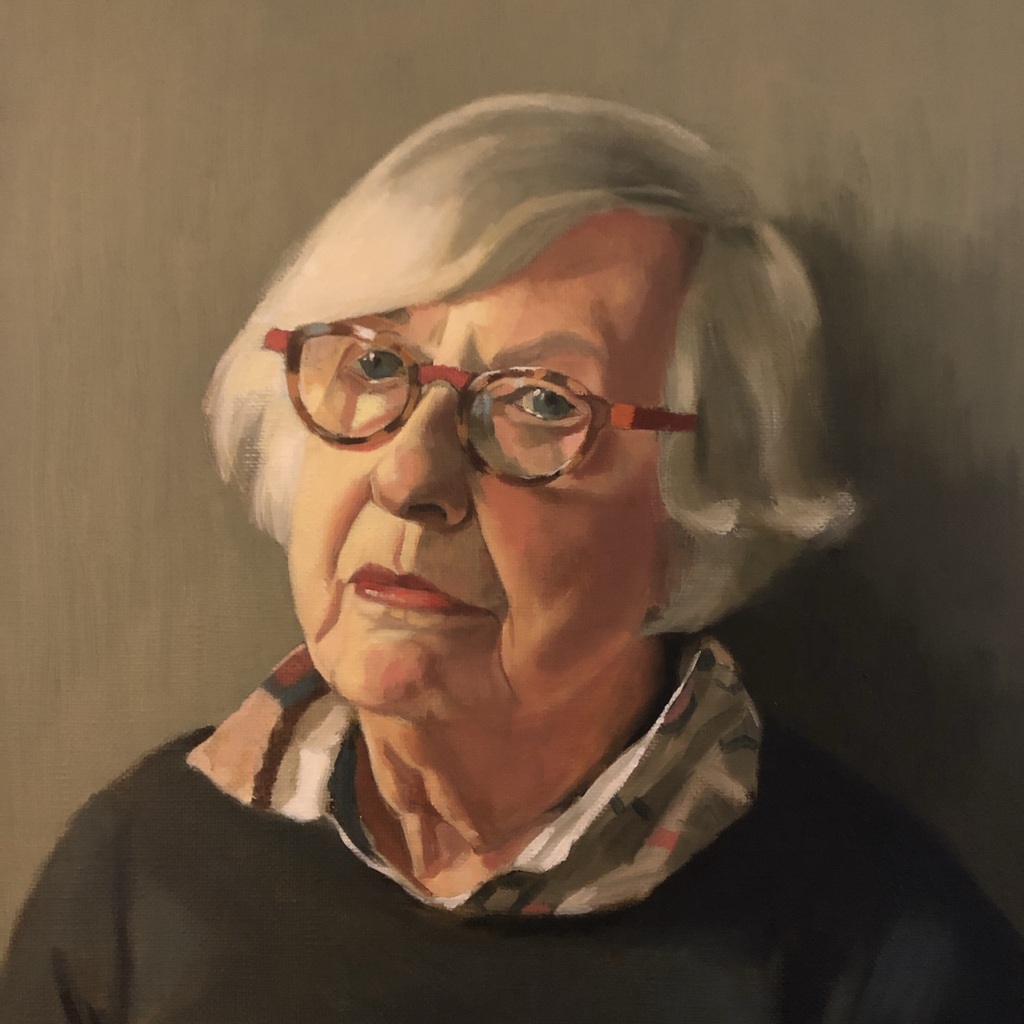
Nancy, oil on canvas, 30cm x 30cm
Nancy remains one of my favourite commissions to date, and I was extremely sad to hear that she passed away last year. I spent a few hours with Nancy for the sitting just before the pandemic. She was such a delightful and vital woman, intelligent and interested in the process, and very patient. Her face was also full of character. To have a sitter who is so interesting physically and in their personality is a gift for any portrait artist. I’m humbled that the painting will be lasting reminder of Nancy for her family, hopefully capturing her essence as well as her physical likeness.
You also paint children. How do you go about this aspect of your work?
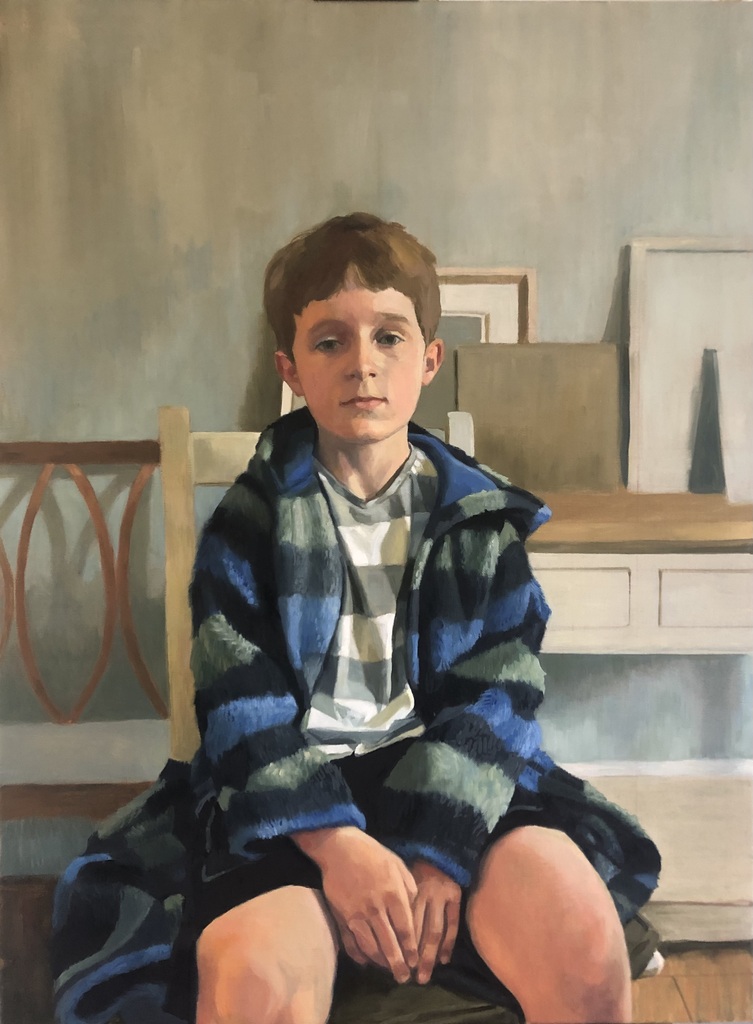
Boy with Dressing Gown, oil on canvas, 60cm x 80 cm.
It is difficult to get a child to sit still for too long so for younger children I have tended to work from photographs. For slightly older children I have undertaken sittings which have worked very well, and I have various methods for holding their attention!
How do you set up a sitting of a child?
For older children much the same way I would for an adult, though I do try to be a lot quicker. Strategic use of a TV, Xbox or tablet is helpful!
Discuss the direction and importance of light on a portrait?
Light is one of my primary concerns while painting and it fascinates me. When striving for a likeness I will be occupied with how the light falls on the face, the way it defines bone structure and the contours of the sitter’s features. Representing light convincingly will make a portrait feel believable and will help achieve a sense of realism which is what I aim for in my work.
Do you discuss where the portrait will be hung and have the sitter in an appropriate position
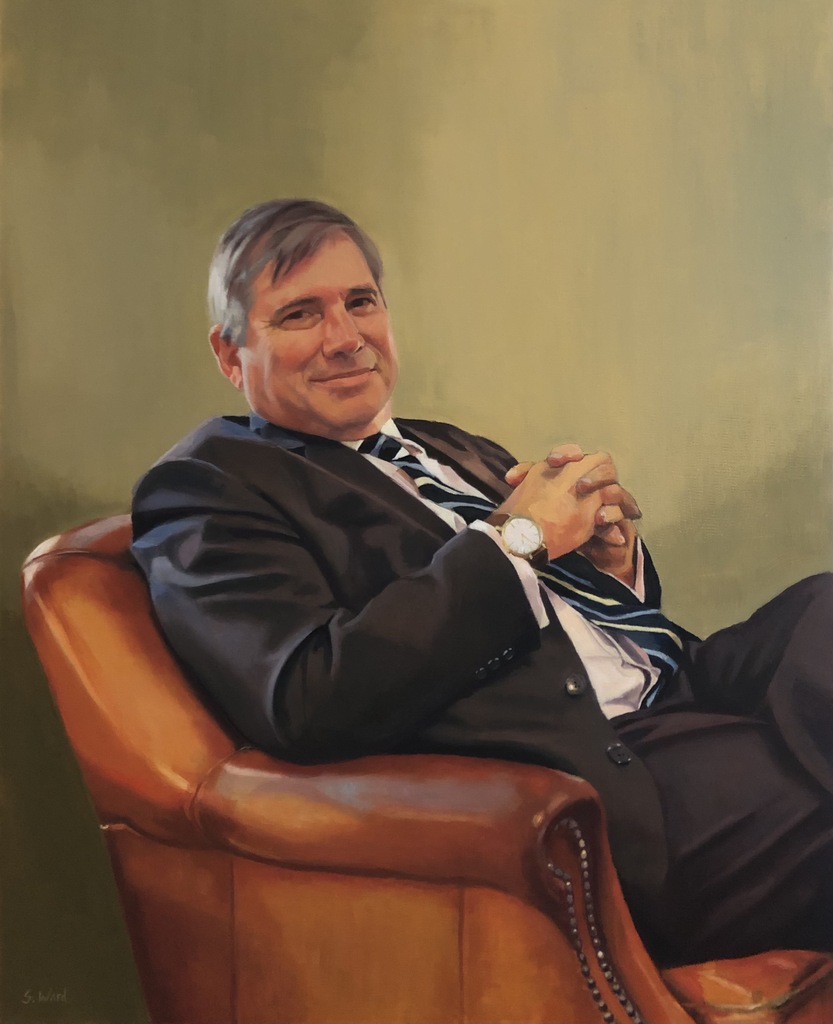
Richard Biggs, Headmaster of King’s College School, Taunton, oil on canvas, 65cm x 80cm
Sometimes. Recently I was formally commissioned by an institution – a painting of the retiring headmaster for King’s College School in Taunton. In this case the painting had to be very much painted with the position of the hang in mind. During sittings I usually try a number of positions to see how the light, composition and posture will work best.
Discuss the importance of entering your work for art prizes?
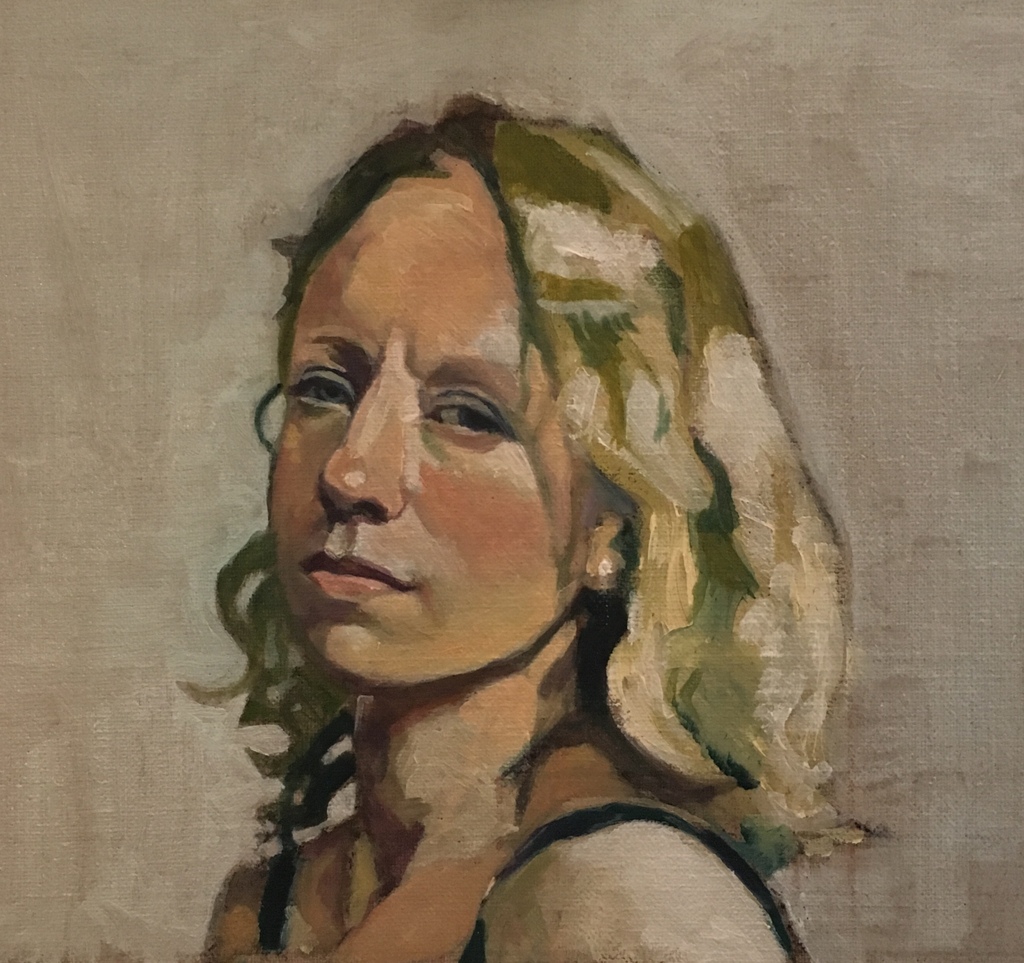
Self-Portrait, oil on canvas board, 30cm x 30xm (exhibited at the Royal Society of Portrait Painters Annual Exhibition, 2019).
Competitions have been really important for me and have helped me build my profile as an artist. I entered my first competitions around 5 years ago. My first and second oil portraits were selected on successive years for the Royal Society of Portrait Painters annual exhibition, which is a very prestigious competition showcasing the work of some of the leading portrait artists in the UK and beyond. I also reached the final of Sky Portrait Artist of the Year – a high profile TV art competition running in the UK. The competitions extended my reach to a much wider audience and have led to some exciting opportunities.
Comment on the work you entered for the Ruth Borchard Self Portrait Prize?
My Lockdown Self-Portrait was highly commended by judges for the Ruth Borchard Self-Portrait prize in 2021. Lockdown was not a good time for me, as for many people. During the winter lockdowns I lost a close member of my family to cancer. The isolation, grief, and relentless home-schooling of my two children was suffocating. Painting the portrait was cathartic and helped me get through that time. When I look at that painting, I see the sadness and claustrophobia I was feeling at the time.
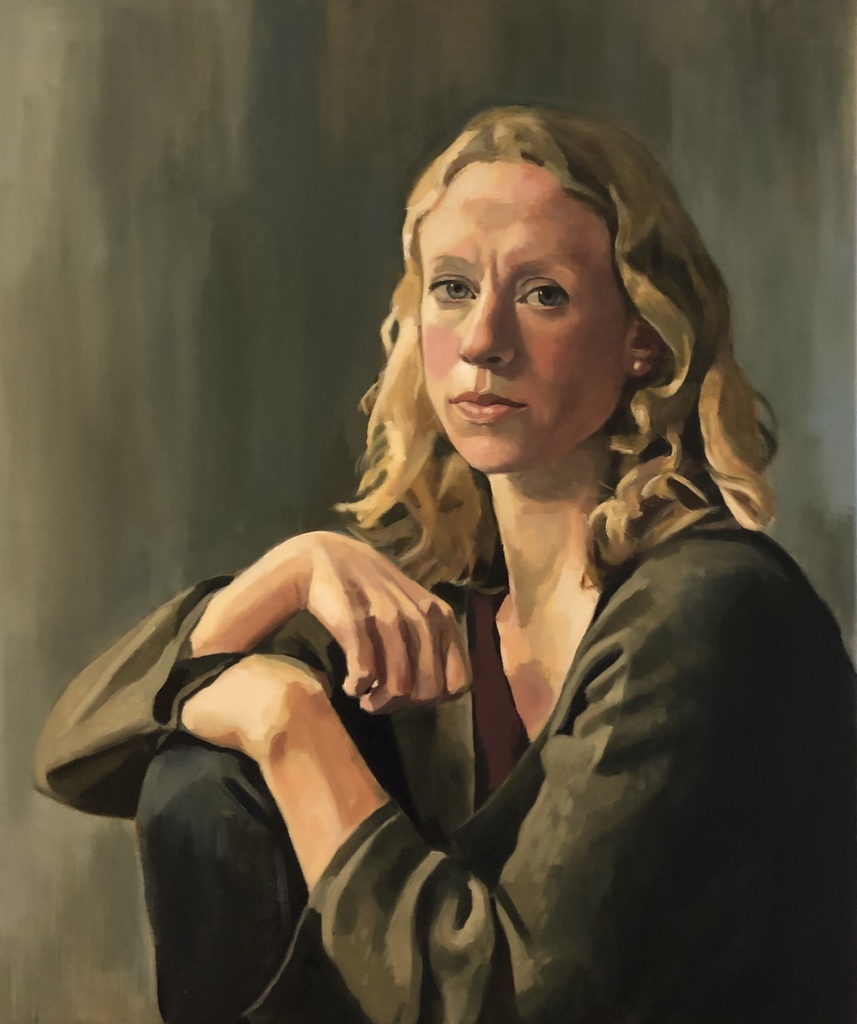
Lockdown Self-Portrait 2021, oil on canvas, 50cm x 60cm (long-listed for Ruth Borchard Prize)
What are your thoughts on all women exhibitions?
I’m very positive about them because there is still a big imbalance in the art world and therefore, I think it is justified to give female art some space of its own. It’s really important that women are better represented and are given access to opportunities to overcome some of the barriers we face (such as pay inequality). The Society of Women Artists is a great example of an organisation which does this in the UK. I exhibited with them last year at the Mall Galleries in London and it was a wonderful celebration of female art and the determination of women to create.
Explain about your life drawing sketches?
I feel that life drawing and painting underpins my love of art. I was lucky enough to be sent to life classes from the age of fourteen by my school and I have always loved the nude as a subject both in my own art, but also in the history of art. It is immediate and freeing to work quickly from a model. I also believe it is simply the best way to practice – through observation of light, line, proportions etc.
How often do you go to a Life Drawing class?
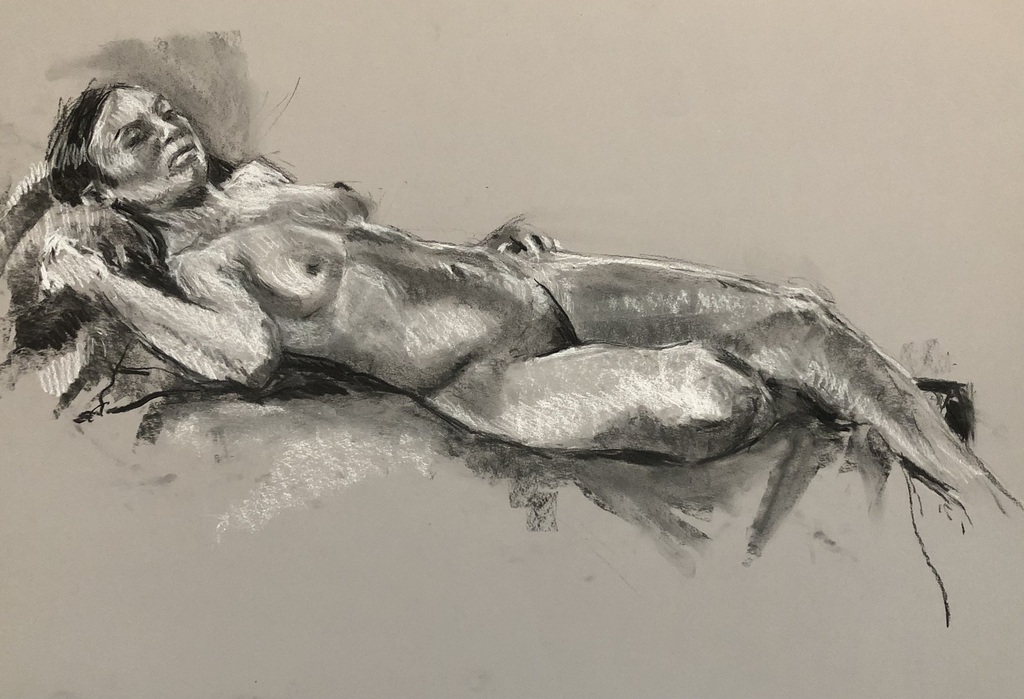
life drawing
Not as much as I would like to. I go whenever I have the time, which is sadly not that often now. I like going particularly when I have a bit of creative block. It is a good reset to help me get back to basics and just draw from life.
How influential are the other artists, and their work to you?
Very influential. I absolutely love art, learning about it, and looking at it as much as painting and drawing. I go to as many exhibitions as I can, and always come away with something from each one which no doubt filters into my practice in some way. Particular influences include Rembrandt, Freud and early 20th century British art. I follow a lot of contemporary artists on Instagram as well, which is also a constant source of inspiration.
Discuss the influences involved in your landscape art.
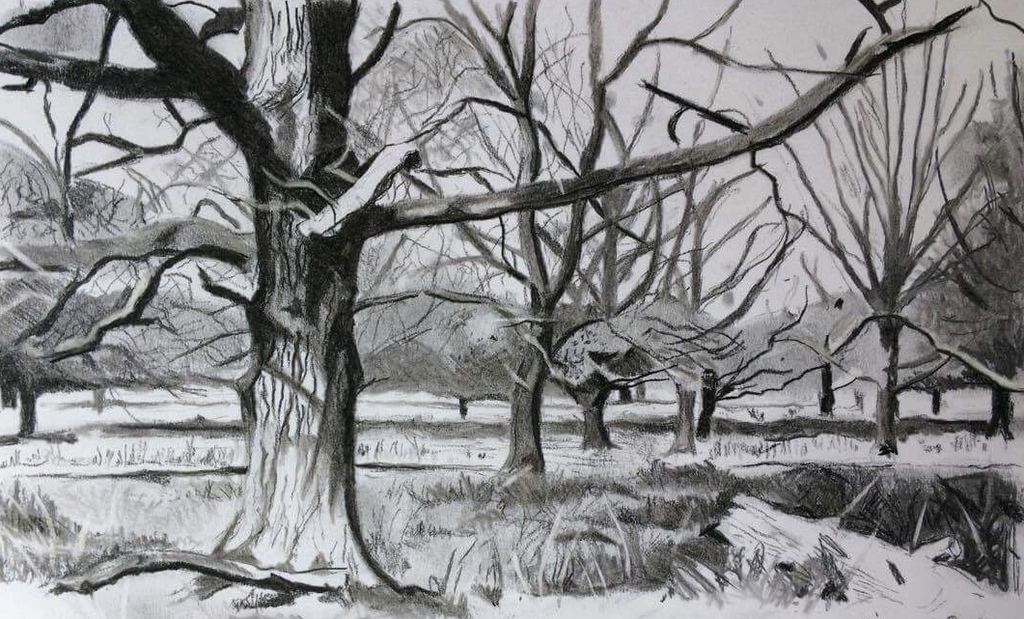
Richmond Park, charcoal and chalk
The landscapes I have done have tended to be in charcoal and were directly influenced by a David Hockney’s retrospective exhibition at the Tate in 2017, which exhibited 25 of his charcoal drawings of Yorkshire woodland. I thought they were exquisite and was keen to try myself.
Discuss the process involved in Sky Portrait Artist of the Year.
That is a big question! The TV competition requires artists to paint a portrait of a celebrity sitter within 4 hours. I had to find ways of truncating my process into a 4 hour-time frame which was very helpful for me in understanding my own process, as well as very challenging. The time pressure was stressful but ultimately enjoyable. I loved getting to know the other artists, and seeing how they approached the same subject and the feedback I received for my work from the judges still blows me away.
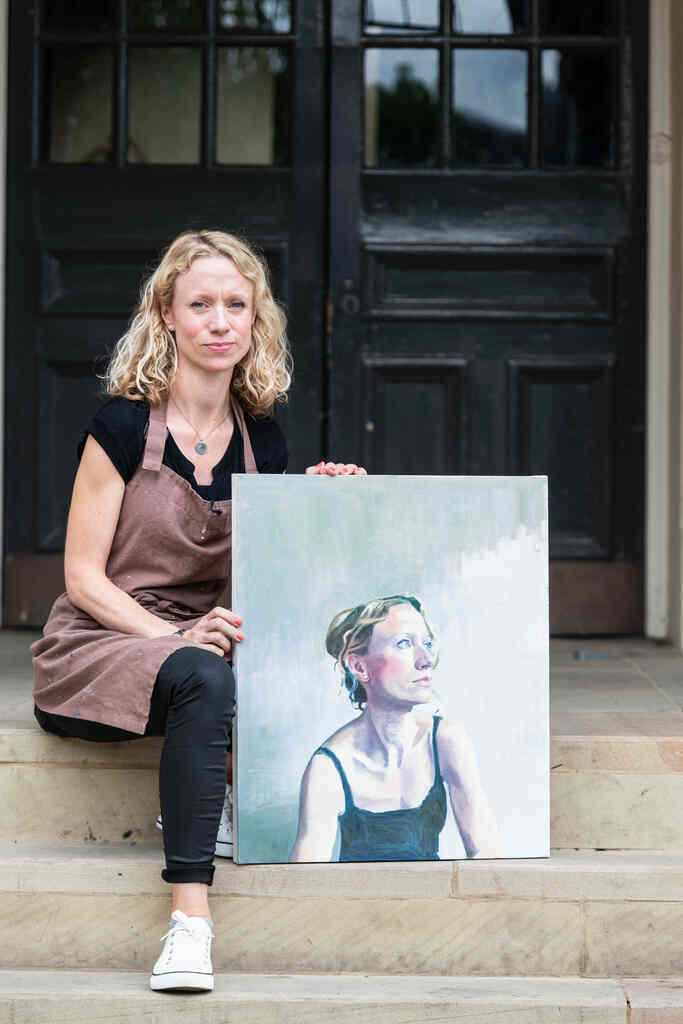
Portrait Artist of the Year, Heat Steps
You are also willing to work from and excellent photograph if the sitter is not available. Discuss this aspect of your work.
I prefer to have live sittings, but sometimes it is not possible (for example with posthumous portraits). This is more challenging because I can’t appreciate the nuances of personality and gesture from a photograph, and I find it harder to connect with the painting if I don’t know the sitter. If I’m honest, I also just don’t enjoy working solely from photographs – understanding the person I am painting is part of the joy of portraiture for me. However, for a painting to work from a photograph alone it needs to have good lighting with some interesting shadows at the very least, with a natural resting expression.
Contact:
Sally Ward
contact@sallyward-art.com
sallyward-art.com
Deborah Blakeley, Melbourne, Australia
Interview by Deborah Blakeley, April 2023
Bob Quinn
Having had a career in advertising what lead you to take up full time sculpture?
I always had an interest in sculpture, and illustration was part of my job. I ran a graphic design business, but it got to the stage when I could never seem to get home in the evening at a reasonable hour. Eventually, my wife bravely insisted that I give it all and build a studio.
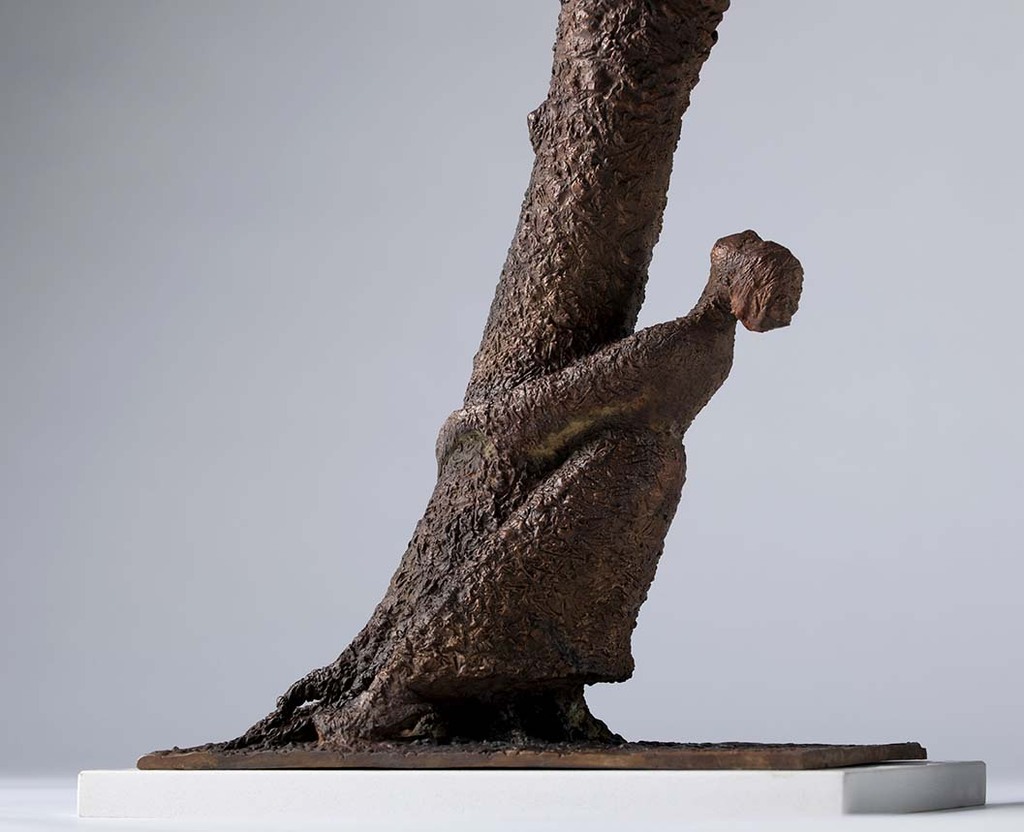
Clearing the Orchard, Detail, Bronze, 103x28x19cm, Edition of 9
How do you manage to add emotion to figurative sculpture?
I think it’s because I want my sculptures to tell a story and I try and take out from the figure any unnecessary or distracting detail, especially in the female form.
Can you expand on one sculpture, please use your initial drawings to the completed sculpture?
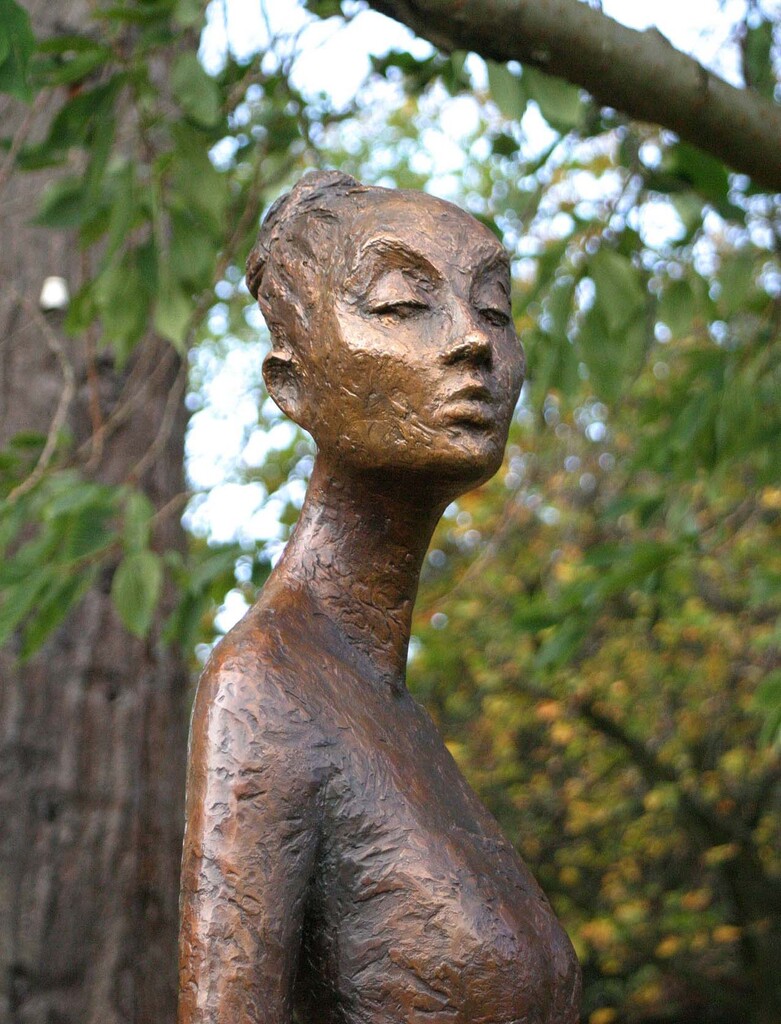
‘The Letter’, Detail, Bronze, 78x13x14cm, Edition of 9
I did “The Letter” in both life size and as a maquette.
It was part of the “Strong Women” One Man Show I did in Dublin. The figure is reduced down to its simplest form while also stretched as far as the eye will accept (I suppose I fall into the Expressionist category; I make what I feel not necessarily what I see).
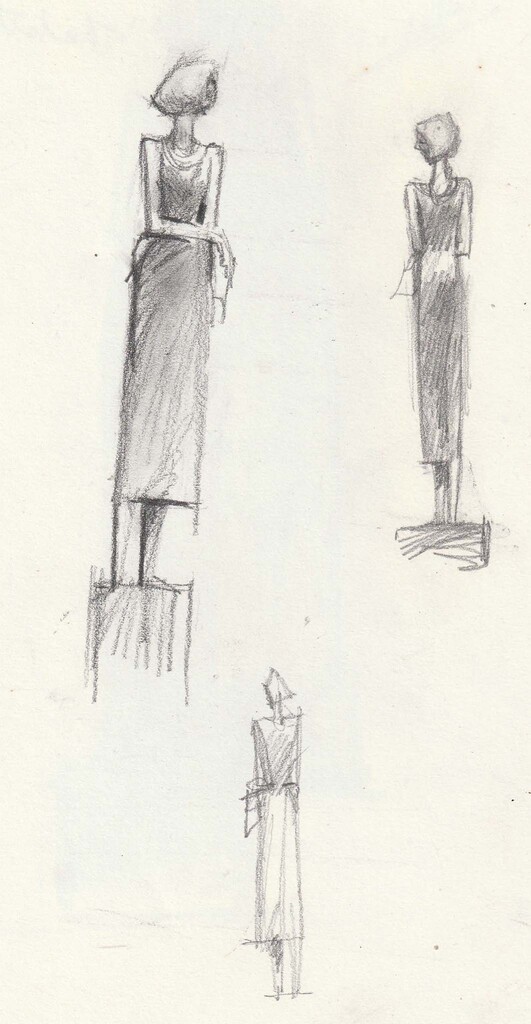
The message is simple, she holds a letter, you don’t know whether the content is good or bad, it’s the expression in her face that’s important, the determination, the stoicism in the way she deals with the contents of the letter. I did “The Letter” in both life size and as a maquette.
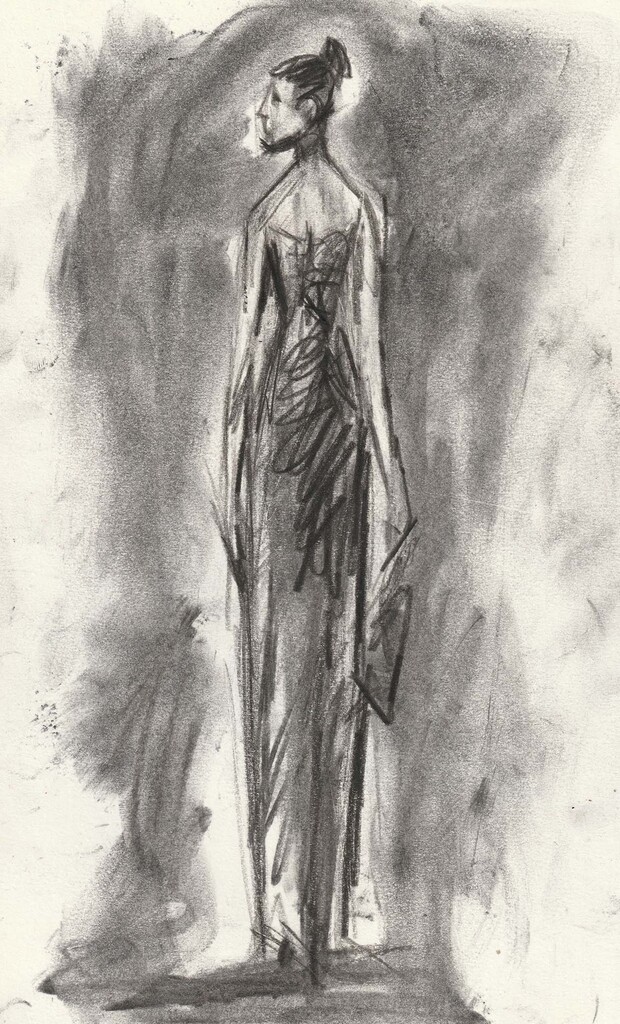 ‘The Letter’, Bronze, 78x13x14cm, Edition of 9
‘The Letter’, Bronze, 78x13x14cm, Edition of 9
What excites you about the human form?
Sculpture is 3D, the human form has endless poses and there are a thousand stories in these poses. Having said that, I once asked my 93 year old mother to pose for me. She, as an artist, insisted that she needed to strip down to her bra and pants. She is not here anymore to defend herself, but, I promise you, she redefined the way in which the human form could excite!
Take two works and explain the emotion in the …’nobility of the most ordinary of human activity.’
Firstly, I choose “Mantle.”
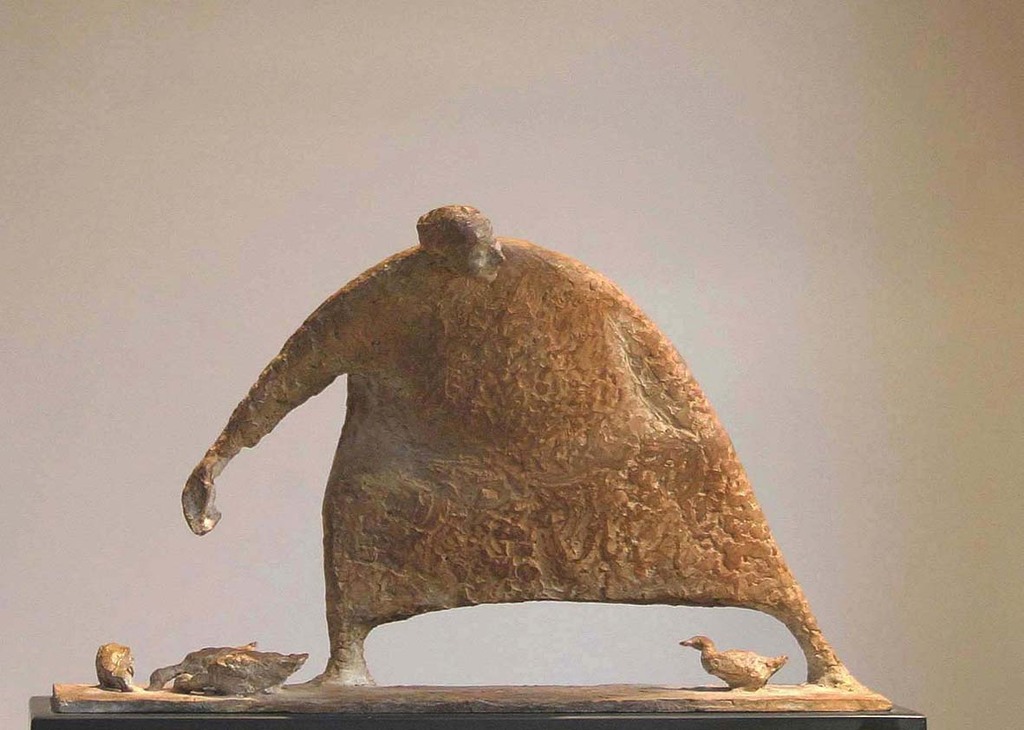
‘Mantle’ Bronze, 39x14x11cm, Edition 9
Here is a practical country woman routinely feeding her ducks. But we see how she is still mindful and caring in protecting one of the weaker ones that follows up behind.
Secondly, I choose “Working mother” (inspired by a 1960s photograph in the press) because it shows (I hope) a young busker on Grafton St in Dublin.
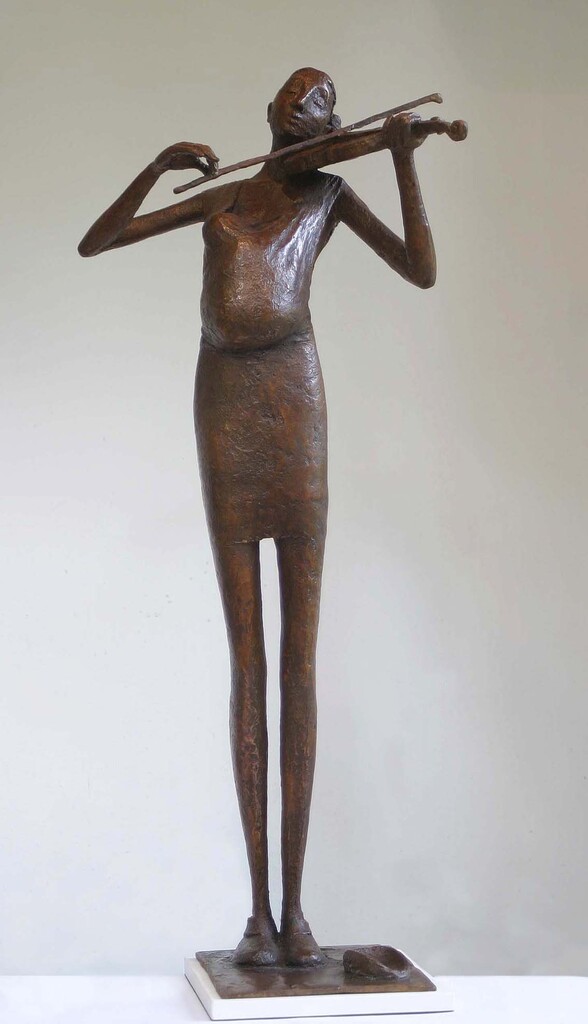
‘Working Mother’ Bronze 62x24x23cm, edition of 9
She protects and swaddles her newborn child while also earning a little money from her violin. She is on her own, probably a single mother.
Discuss your commission ‘Fishermen.’
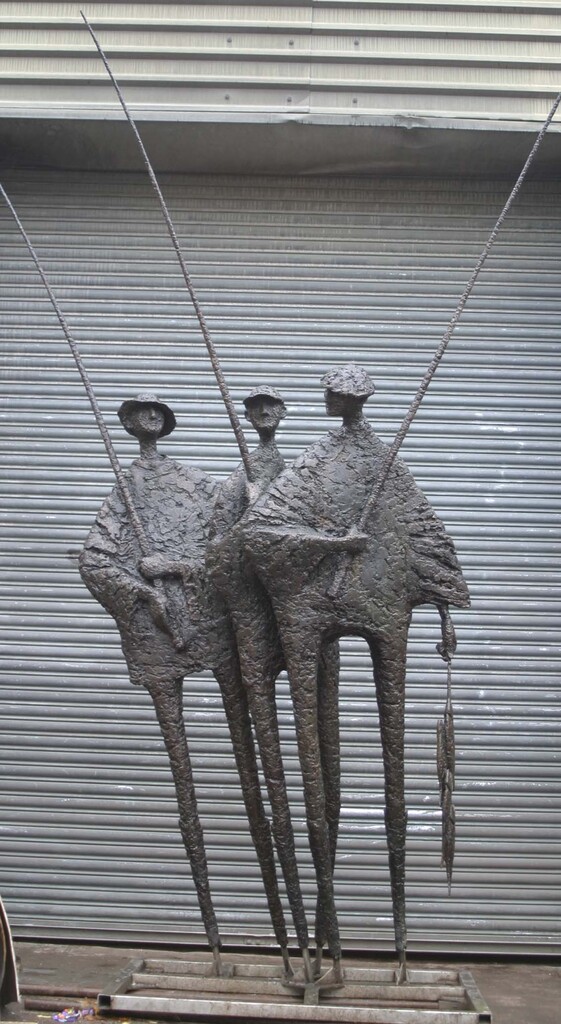
Fishermen, Bronze, Over Lifesize
How it came about?
It came from a commission. A successful business family wanted a sculpture for their holiday property, a beautiful old fishing lodge on the shores of Loch Mask, in the West of Ireland.
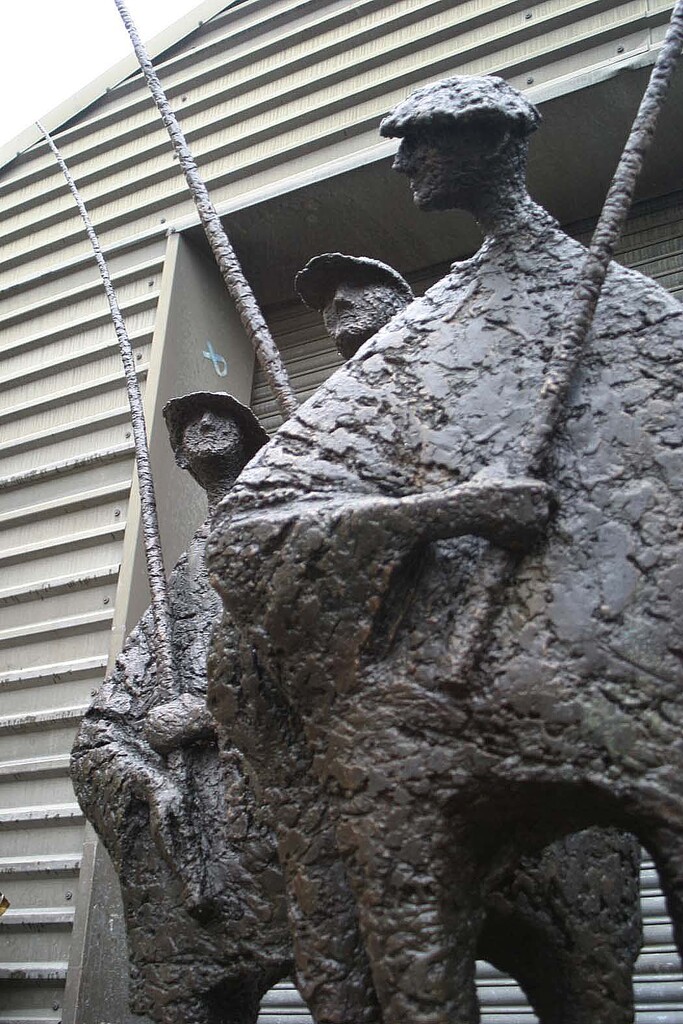
Fishermen, Detail, Bronze, Over Lifesize
How much input, did the client have?
The client allowed me a free hand but I was conscious of the work ethic of the clients and wanted to reflect that in the sculpture.
The final positioning of the work?
After a hard day on the lake, we see the sculpture of the three fishermen from the house coming over the hill to well-deserved relaxation.
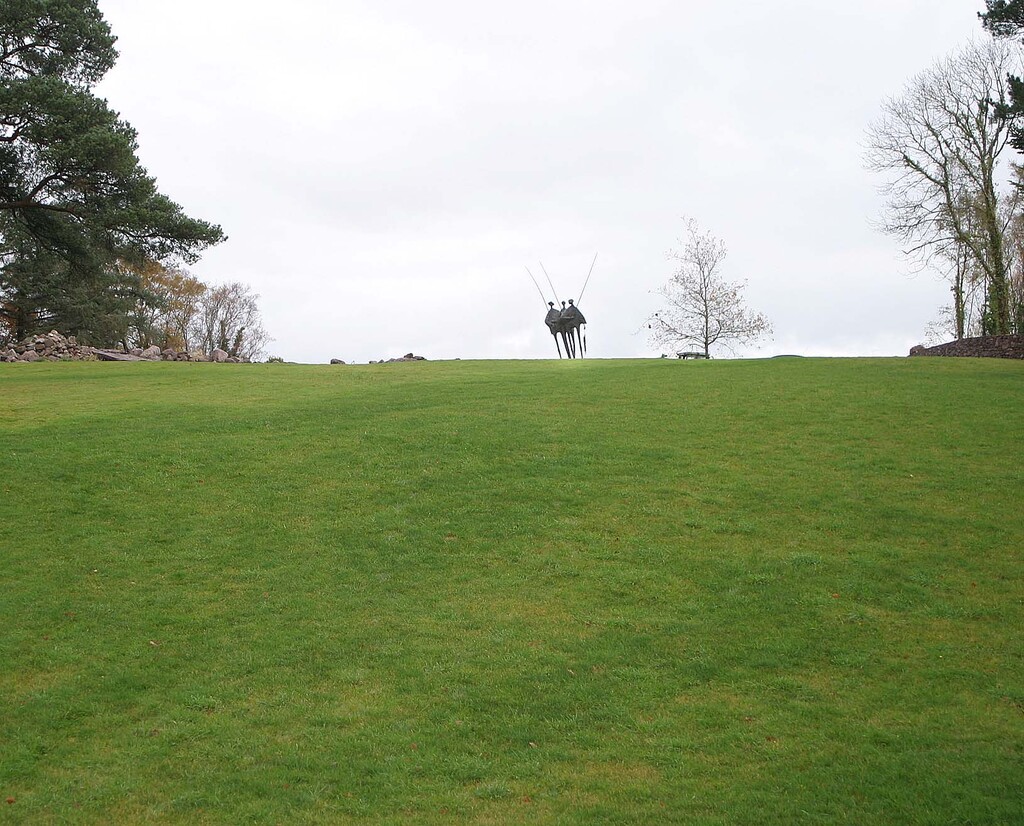
Fishermen, Bronze, Over Lifesize
I suppose they act as a metaphor for the clients coming down to their holiday home perhaps after a busy period with the business.
Discuss how the ‘Wind’ is so often present in your work. (Is it wind or the person pushing forward’?
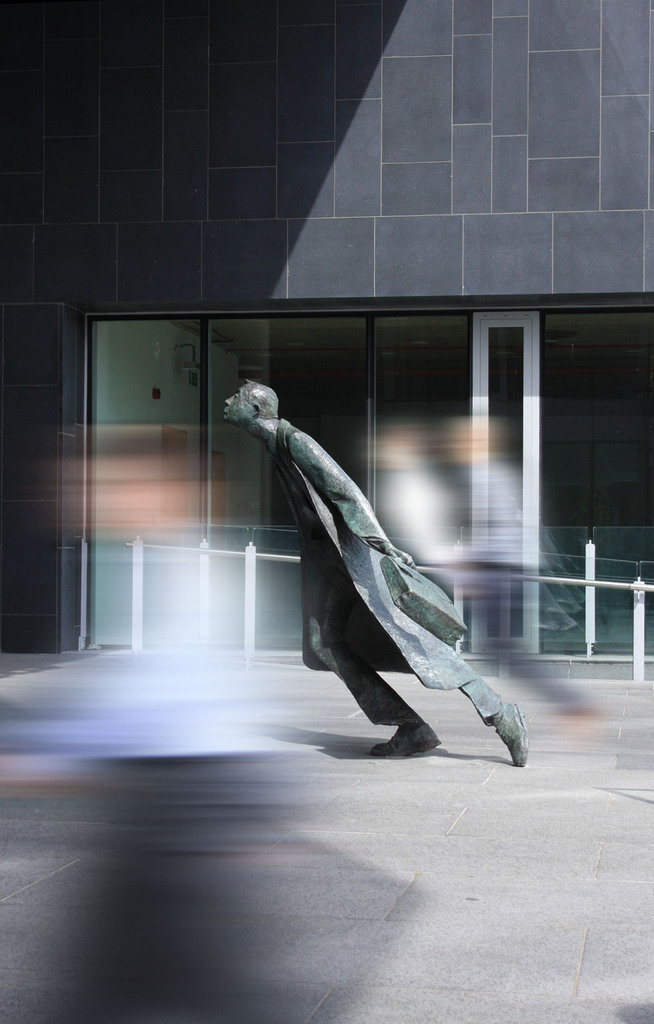
‘Moving Forward’ Bronze, Over Lifesize, Chase Building, Dublin
I have not thought of that before, you have put me on a spot! I suppose it could be because wind creates movement, as does leaning forward. I also think that it is a good vehicle for creating an element of humour.
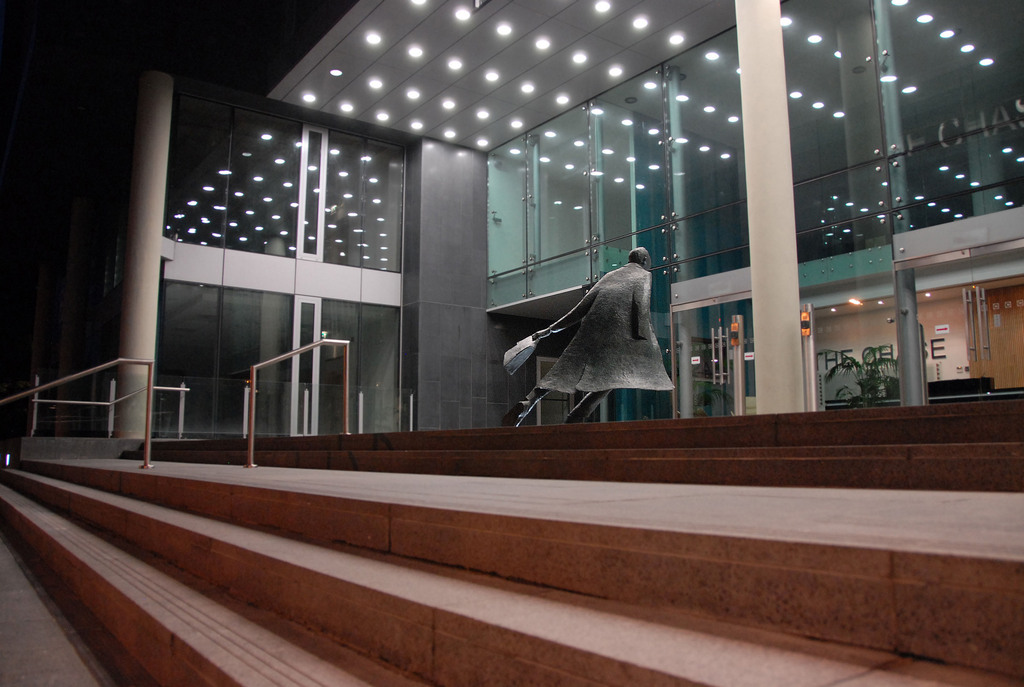
‘Moving Forward’ Bronze, Over Lifesize, Chase Building, Dublin
How influential were your wife and daughters in your series, ‘Strong Women’?
I have a wife and two daughters. Irish women in general, particularly country women, are strong. It is the colonial past, perhaps the famine. Irish women have had to be strong. At a practical level. My six-foot younger daughter was my muse for so many of the pieces.
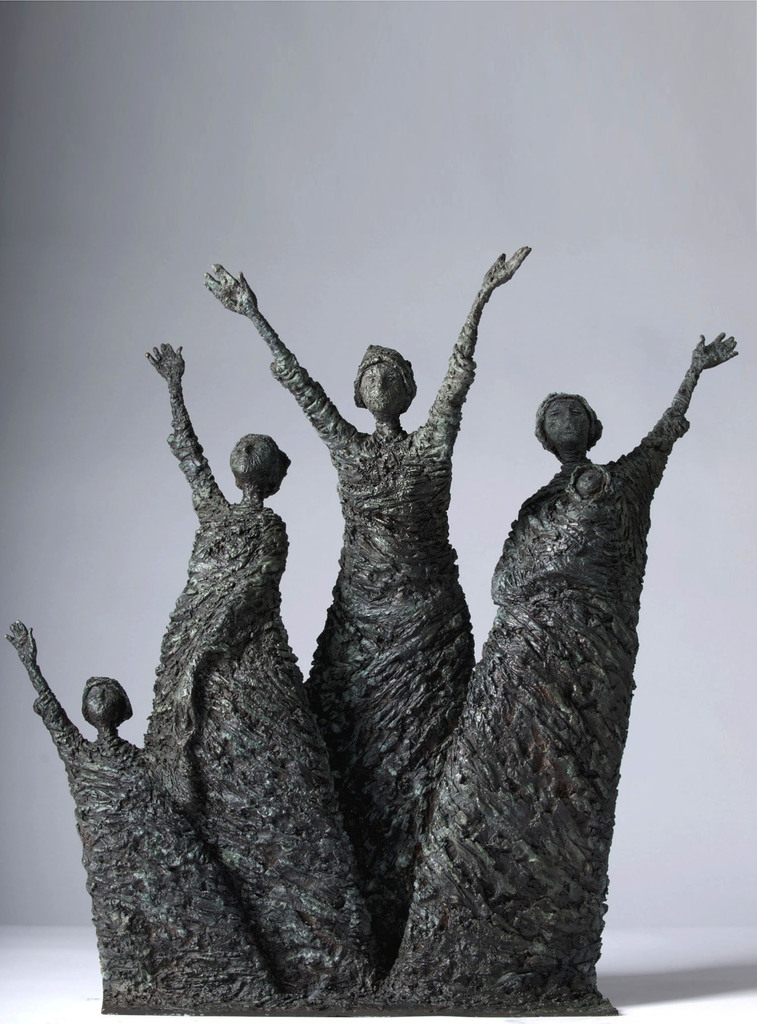 ‘Returning’, Bronze, 61x21x44cm, Editions of 5
‘Returning’, Bronze, 61x21x44cm, Editions of 5
Take ‘Best Night Ever’ comment on…
The decision to have 9 Editions.
Usually I do nine, plus one Artist Copy for maquettes (smaller pieces) and 4-5 plus one Artist Copy for larger outdoor pieces. Sculpture is a costly business any profit must be spread, over an edition.
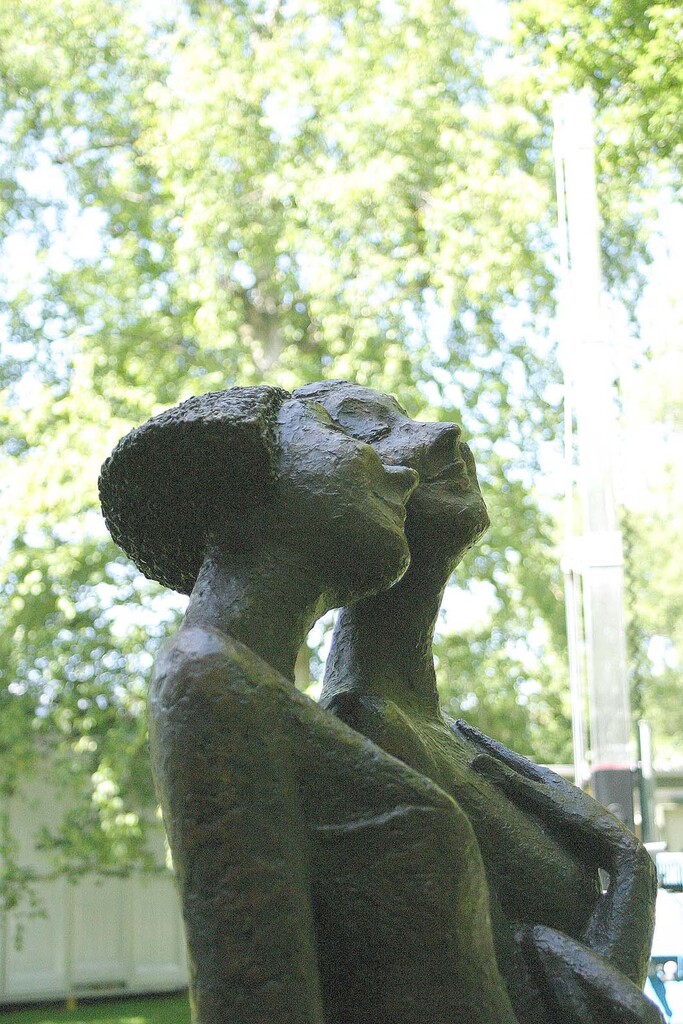
‘Best Night Ever’ detail, Bronze, Over Lifesize, edition of 3
The size of the work.
With larger more expensive outdoor work the edition is smaller. Clients that invest a lot are entitled to a degree of exclusivity. Certain pieces lend themselves to being large, and size can create drama.
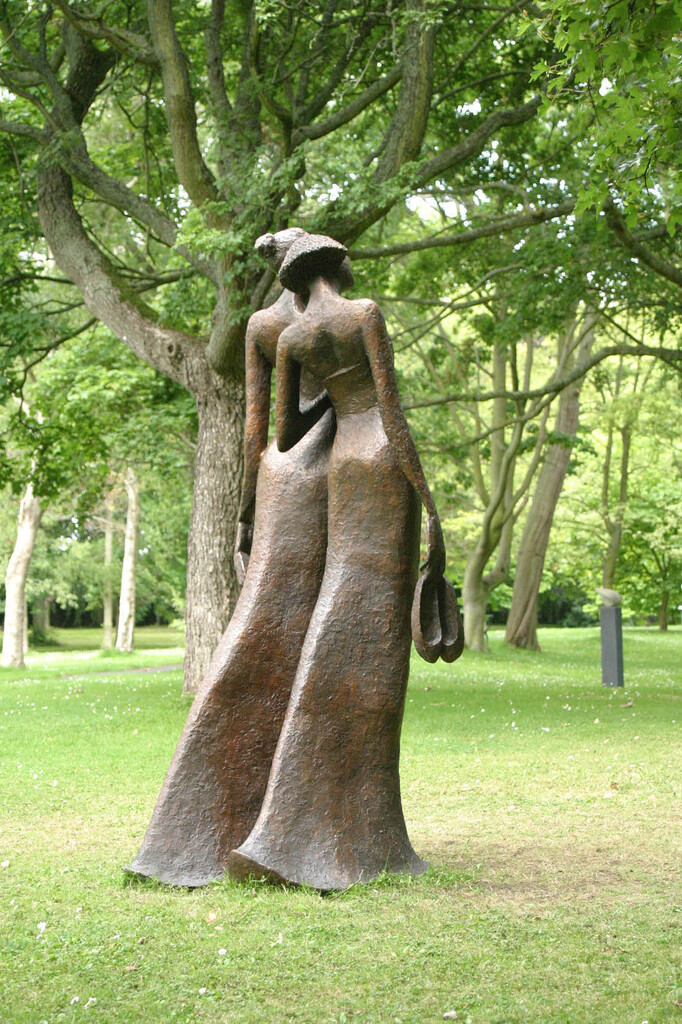
‘Best Night Ever’, Bronze, Over Lifesize, edition of 3
The importance of 360 degrees on the work.
With sculpture an idea might work in sketch form, in 2D, but that does not mean it will work in the round. It must work from every angle. With “Best Night Ever” I wanted them to be seen from a distance, that you are invited to join them, and to share whatever it is that is amusing them. They are two friends, dressed up and sharing a laugh. You know nothing of their lives, what tragedy, what illnesses what issues they might be facing. But for these few hours they are having… the best night ever.
Your work ‘Skating Home’ discuss the cragginess and texture of the work.
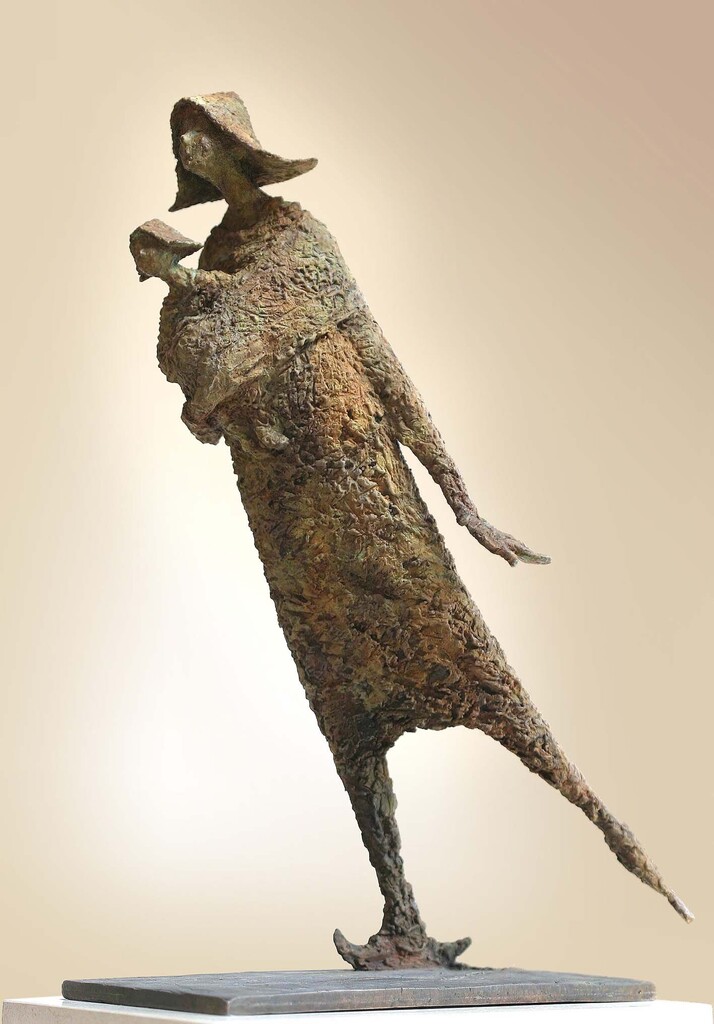
Skating Home, Bronze, 26x13.5x41cm, edition of 9
I understand why, but I still get frustrated when, beside a sculpture there might be the sign “Do not touch”. I suppose when I give a sculpture an overall texture it is to reduce what I see as the distracting detail beneath that texture and keep it simple. With “Skating Home” it’s about the shape created by the mother and child skating down the frozen canal, any detail is to show the period in which the sculpture is set or because that detail adds to the piece.
What is it that allows us to know it is historical?
The piece was inspired by a painting by the Dutch painter John Kind, of skaters on a canal back in the 1800s. I love the shape of the women’s headgear.
Discuss how and why you use different textures in your work.
I enjoy the way different textures respond to different patination, but I also use texture to minumise what I might see as detail that is a distraction to the overall message.
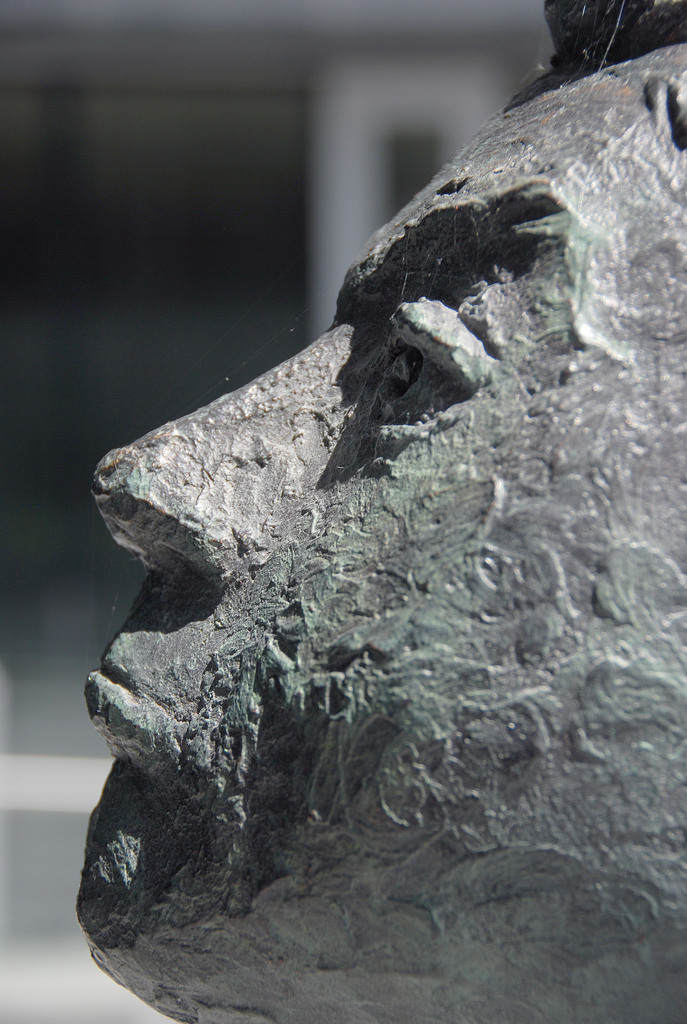
‘Moving forward,’ Detail.
Your work is emotional, comment on this using two works, ‘Crucifixion’ and ‘Clearing the Orchard’.
Both these pieces were in the Strong Women exhibition, one tragic the other humorous. “Crucifixion” depicts three mothers in mourning at the base of three empty crosses. You do not know which is Mary, it doesn’t matter they have all lost a son.
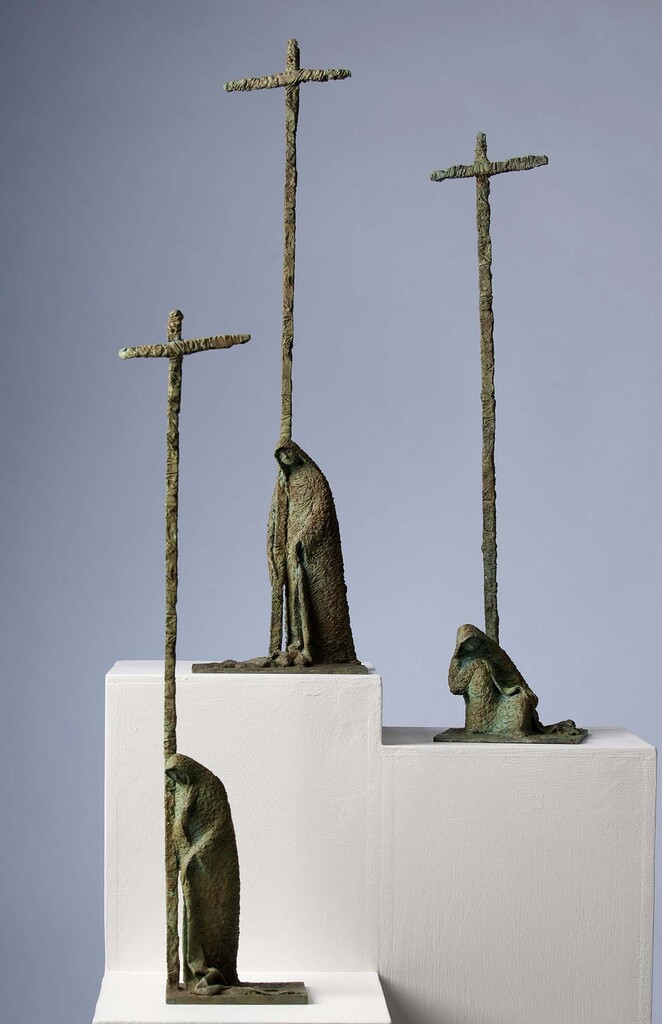
‘Crucifixion’ Bronze, 46.5x10cm, Edition of 9
In “Clearing the orchard” you see a strong woman, literally. She is dragging a tree from the ground, roots and all. You can guess the back story, she’s fed up of asking her lazy husband “forget it, I’ll do it myself”!
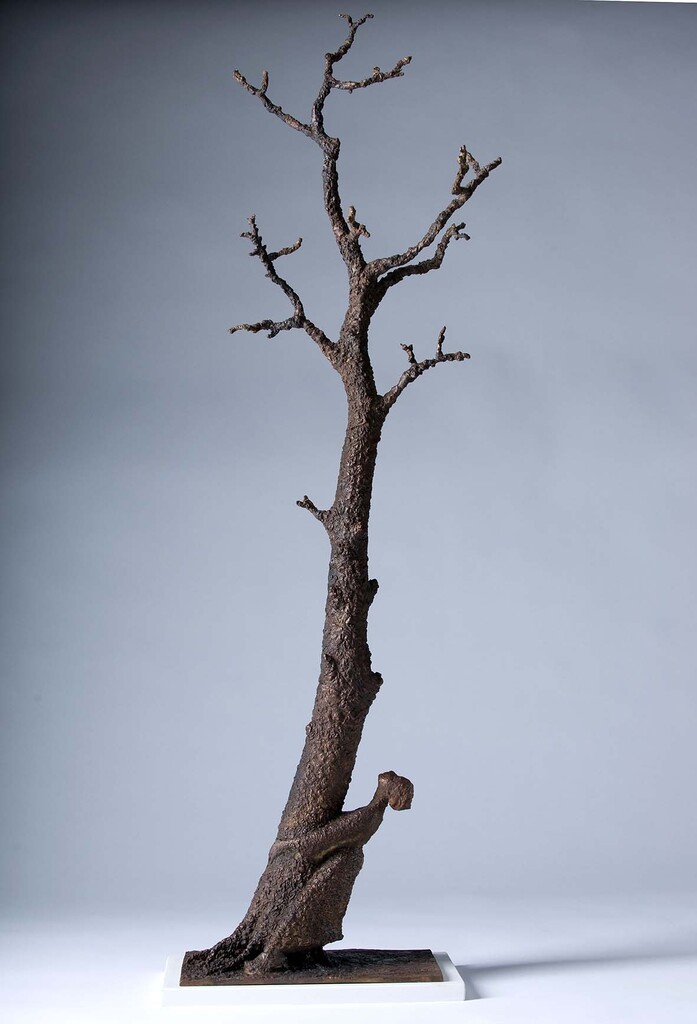
‘Clearing the orchard’ Bronze, 103x28x19cm, Edition of 9
How do you decide on the base / plinth you use in your outside work?
It must, be weatherproof, and it has to compliment the piece its supporting. I generally use stone.
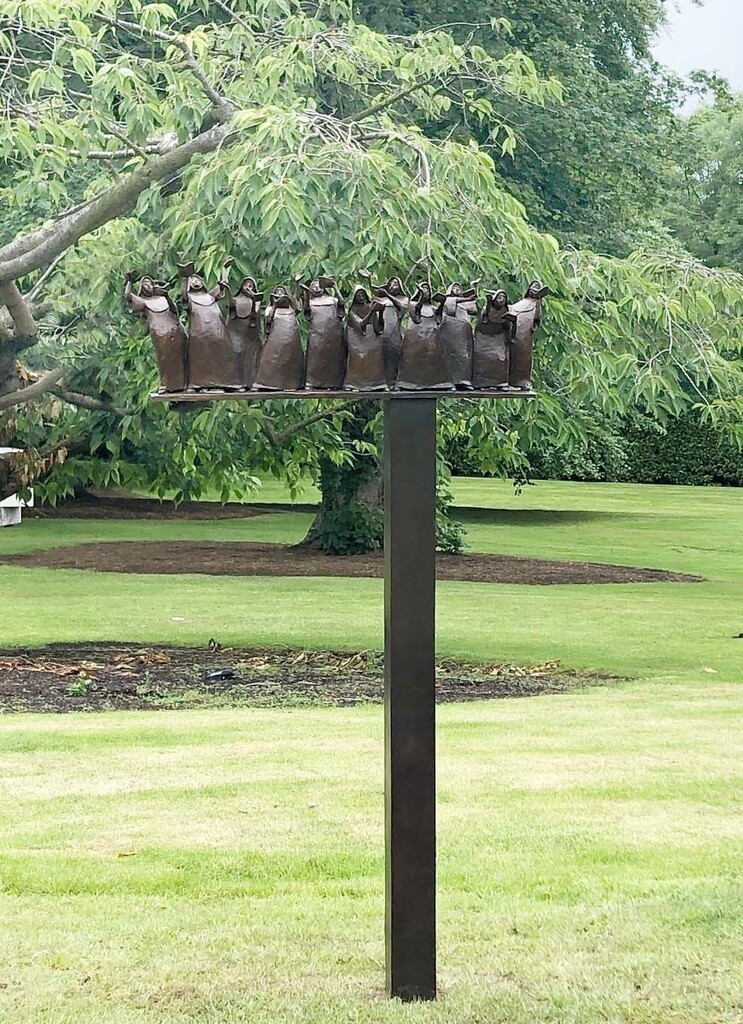
‘Office Party’ Bronze, 62x24x23cm, edition of 9
It is strong and it takes fixings well, but its heavy. I have used cream sandstone its lighter but its soft and you handle it with great care.
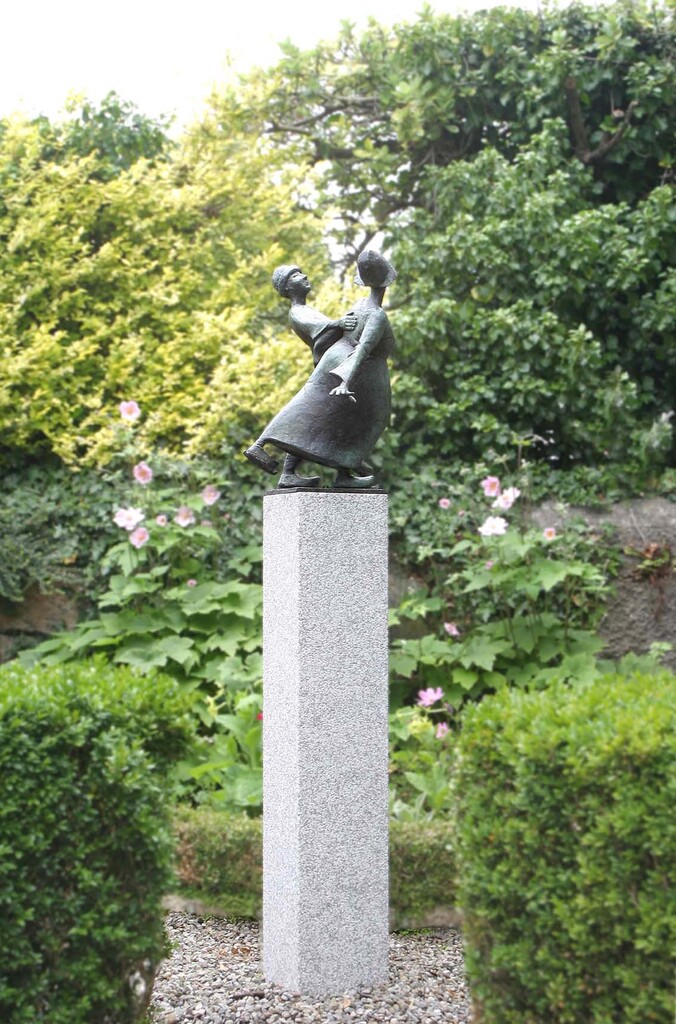
‘Off We Go, Bronze on Irish Granite, 55.5x58x42cm, (including base) Edition of 9
Occasionally a continuation of the bronze sculpture into a plain base with a graduating patination helps lift the sculpture.
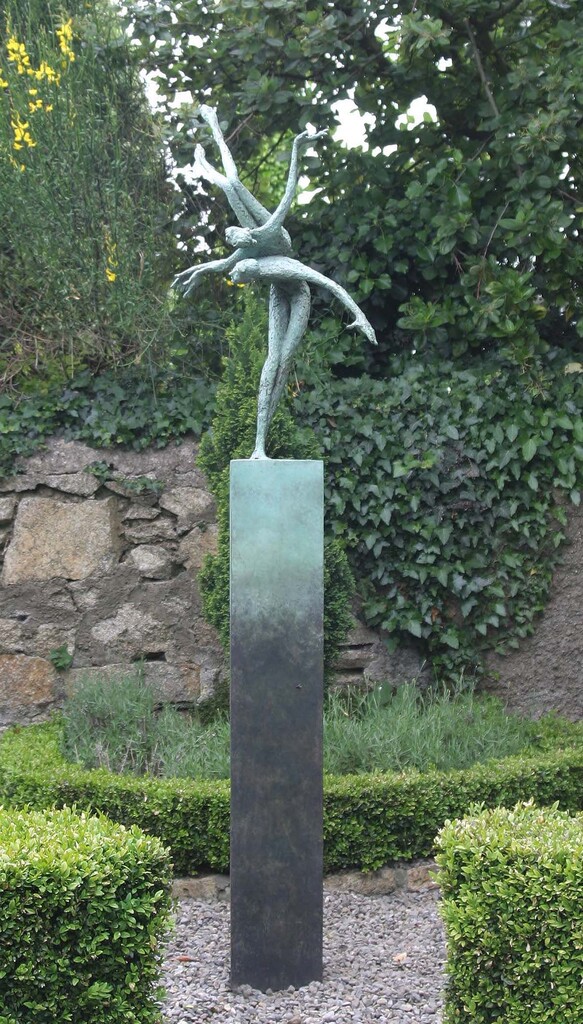
‘Tumbling,’ Bronze, 180x50x50cm, edition of 5
Do you always carry a sketch book with you, or take discrete photographs?
No, I admit I don’t. I bring it on holidays but it’s something I mainly use in the studio.
When I can I love going to life drawing classes. I only use the camera when I use a model in the studio, and that is when I have a firm idea of the pose.
How did Covid and Lockdowns effect your work?
You would think it would suit the artist in the studio, but it took away deadlines, and I live by deadlines. I like that expression “The professional does his/her best work when he doesn’t feel like it”.
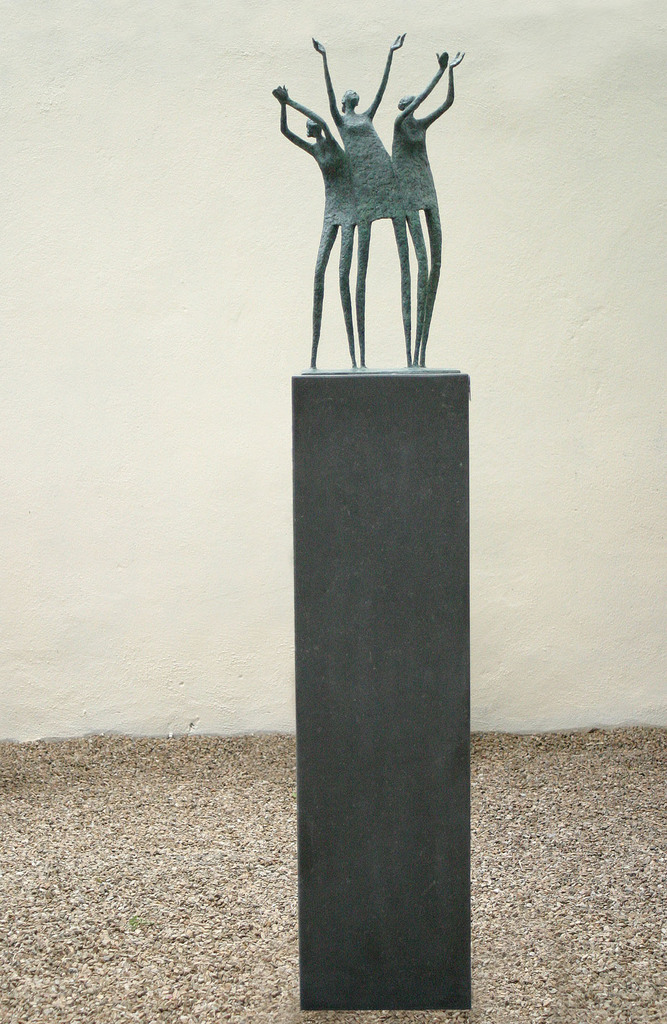
‘ Yeah, Yeah, Yeah’ Bronze, 60.5x34x16.5cm, Edition of 9
Comment on one purchase that either propelled your career or gave you, personal joy.
It must be building the studio for myself and having the wit to include a deck and fishpond. We have had the best dinner parties down at the studio and my morning commute…about a minute.
Contact:
Bob Quinn
Deborah Blakeley, Melbourne, Australia
Interview by Deborah Blakeley, March 2023
Leree Lindsay
Do you feel that your current environment in country Australia, is directly influences your, work?
I live on a farm in the Northern Rivers my studio is surrounded by garden and rainforest the flowers and foliage featured in my paintings reflect the change with the season in the garden. It is a small community that is a very creative with so many amazing artists which is a great source of inspiration for my art practice.
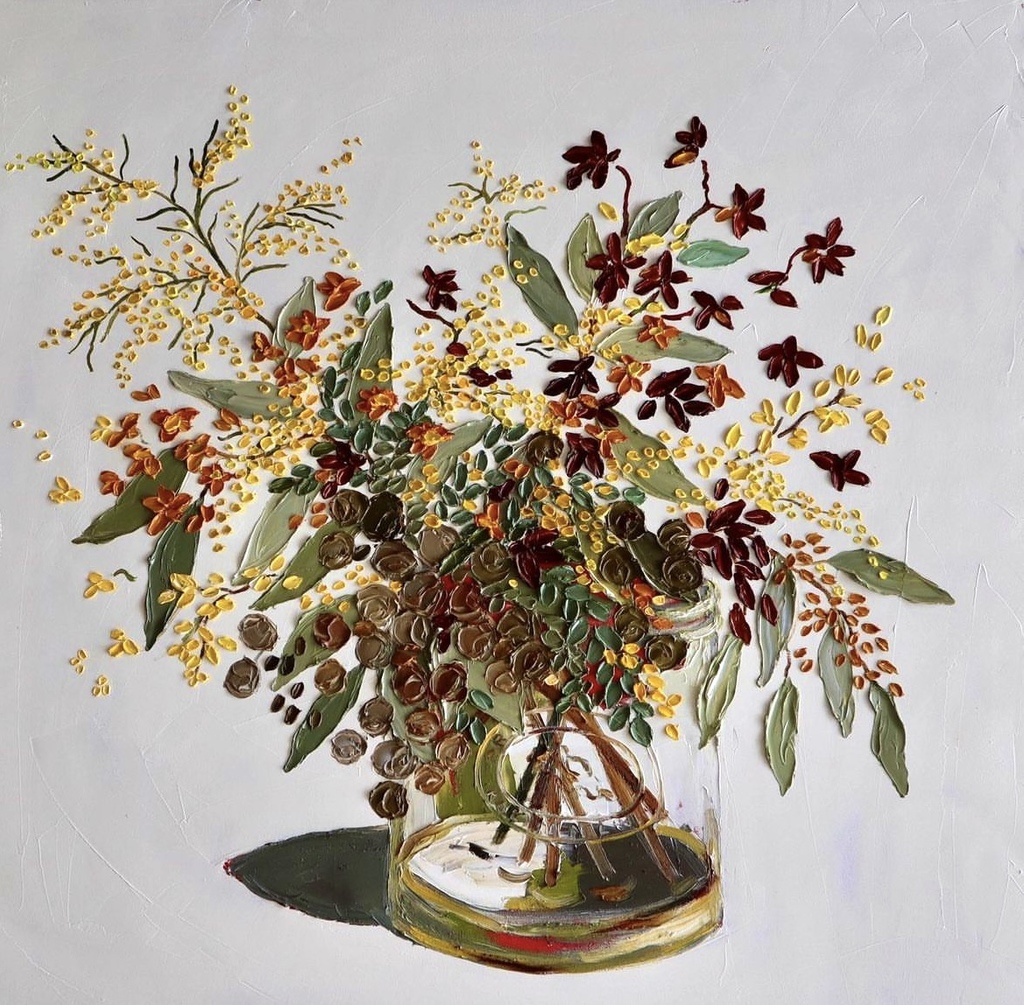
'Australian Natives' 90x90cm, oil on canvas
Can you expand on how you came to be working with palette knives as your major art tool?
I had the privilege to do a weekend workshop with Nicholas Harding back in 2014. He was one of my favourite painters ,his attention to detail and compositions were stunning . That weekend completely changed my art practice. Prior to this I painted with brushes applying the paint quite thinly in layers. It was liberating to apply thick paint with a palette knife it created more movement and gesture in my paintings. Unfortunately, Nicholas passed away last year a huge loss to the art world.
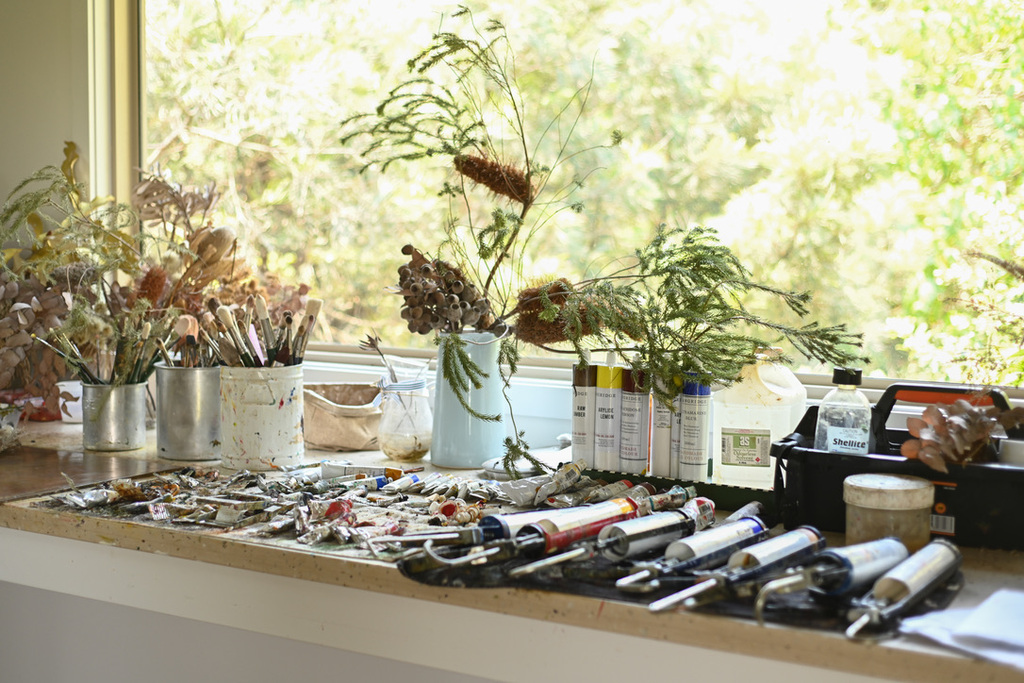
How many palette knives would you have at hand when beginning a painting?
I use multiples. I have a large spatula that I load up with various tones of colour, then I use about 10 palette knives of various sizes. I also have couple of scrapers that I use to cut back paint in small sections or scrape off, when I am not happy with a composition.
The type of paint is also very important to your work. Discuss the difference from the paint you use and normal oil paints.
I love using Langridge oil paints as I prefer not to use mediums, they have a lovely buttery consistency that is easy to move around the canvas. I use a large amount of paint so I buy 300ml tubes and use corking guns to dispense the paint.
Take two individual paintings that use Australian and European flowers discuss?
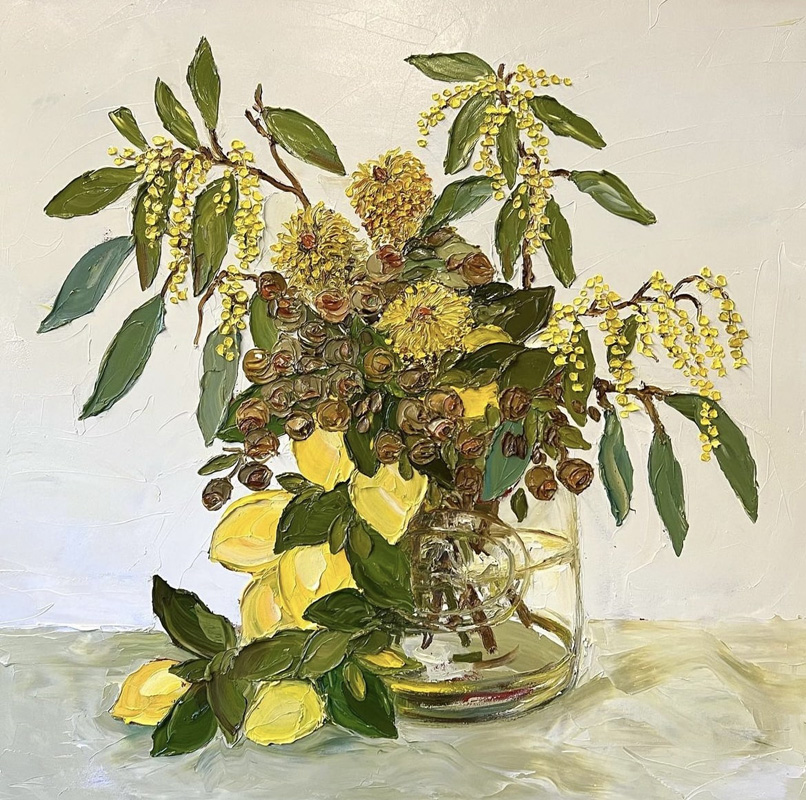
'Spring Lemons with Wattle and Banksia' 95x105cm, Oil on canvas
I love this painting the lemons, banksias and gumnuts are from our garden and the wattle was picked just down the road. It was such massive arrangement with great structure, the branch of lemons were so heavy that they just collapsed out of the vase so the composition was dramatic. I used a limited palette of yellow, green and earth tones.
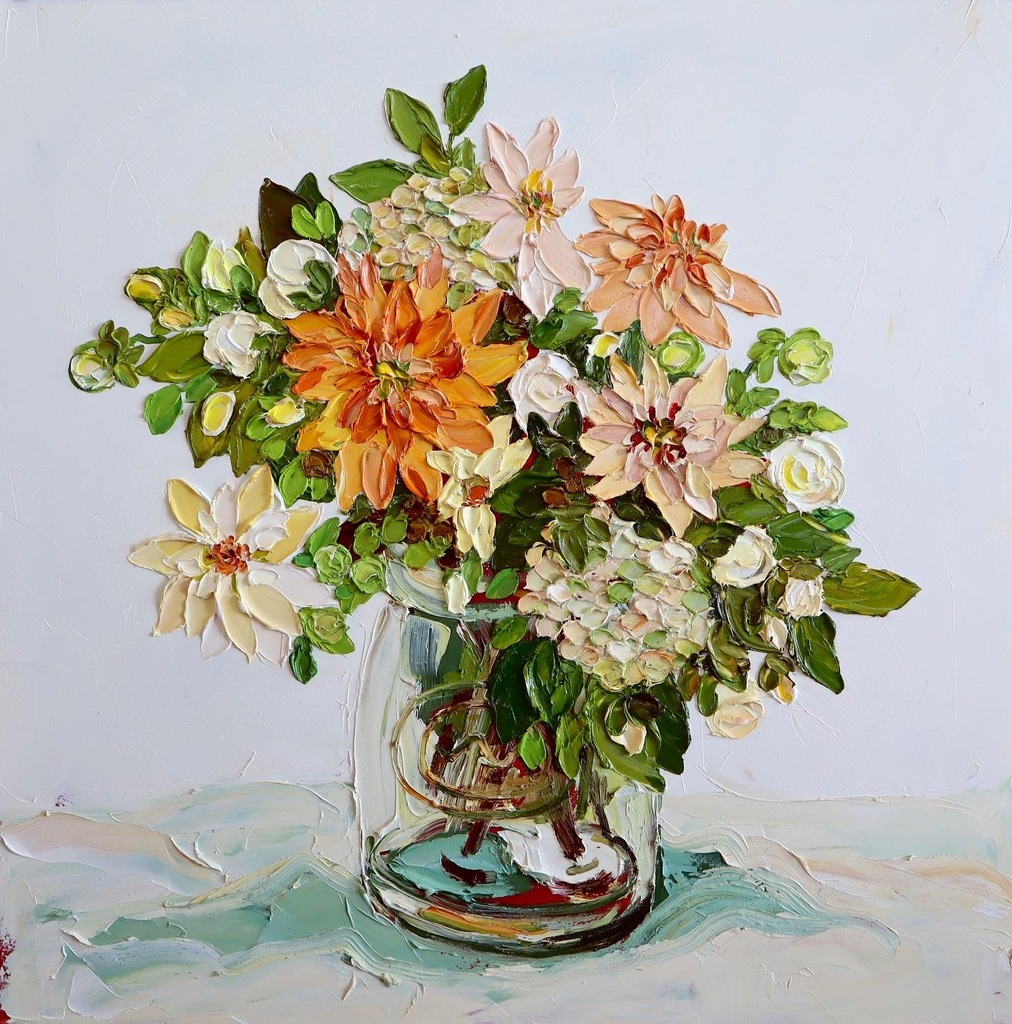
'Our Little Flower Farm Dahlias in a Preserve Jar' 80x80 cm, Oil on Canvas (European Flowers )
This arrangement was a joy to paint. Our Little Flower Farm, is a local florist and flower grower.
Their farm was decimated in the 2022 floods, but they have been able to rebuild their business with community support and hard work .
Dahlias are now one of my favourite flowers and are now widely grown in my region. They are large blooms that have a bold structure, they come in the most beautiful, muted pastel tones, combined with roses and summer hydrangeas they make a perfect composition.
Are all your flowers painted in a glass?
Not always if I am painting a wedding bouquet I will often just paint the stems tied with ribbon ,but I find a glass vessel anchors the painting and adds reflective colour to the composition .
Sometimes you use one glass and a single bloom, others multiple glasses. Discuss.
My partner has a huge collection of old bottles and preserve jars. I love to focus on the single bloom in a single vessel but I am also interested in the interaction of shapes and shadows when vessels are grouped together.
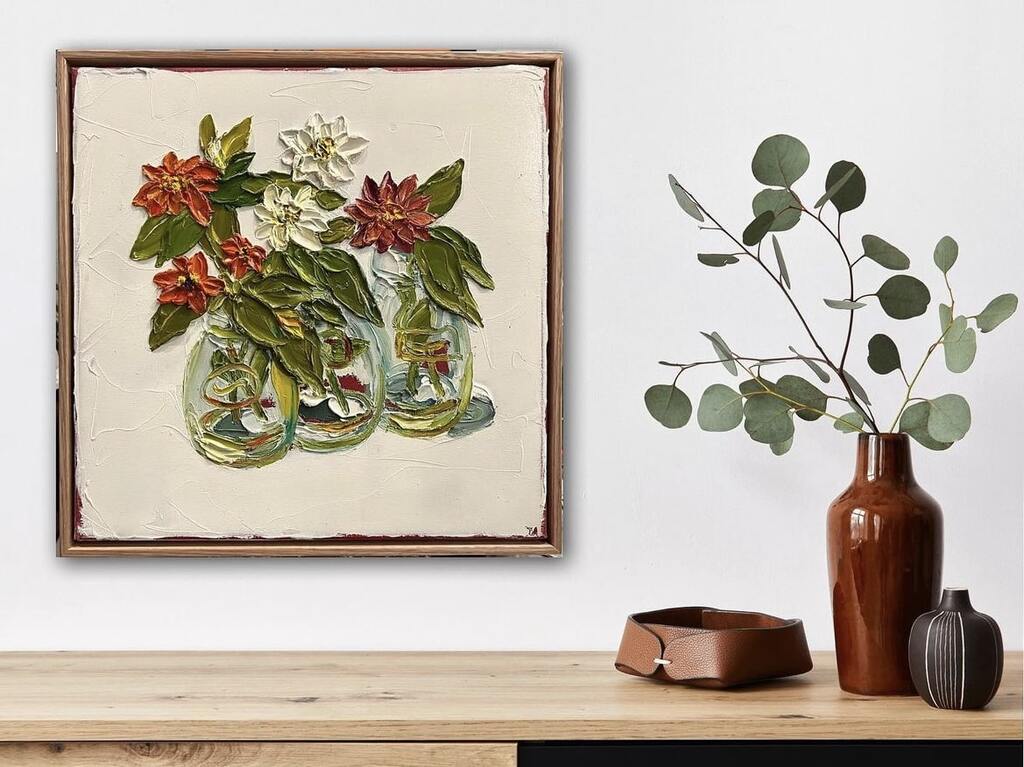
Grouped bottles with Zinnias
Where do you acquire your flowers?
We have a large Australian native garden and rainforest plants that I source banksias and foliage. I also visit the local farmers market where there are amazing flower growers and I am a regular visitor to “Our Little Flower Farm” at Newrybar. They has amazing, seasonal blooms sourced from local growers and are free from pesticides .
Comment on the use of multiple flowers in, ‘Duranbah Ranunculus and Delphiniums.’
“Jumping Red Ant” is a family run farm that is located at Duranbah, it is a town just north of Byron Bay. They grow flowers and vegetables that they sell at the local farmers market Brianna from the farm only grows the flowers but puts them together in stunning unstructured bouquets .
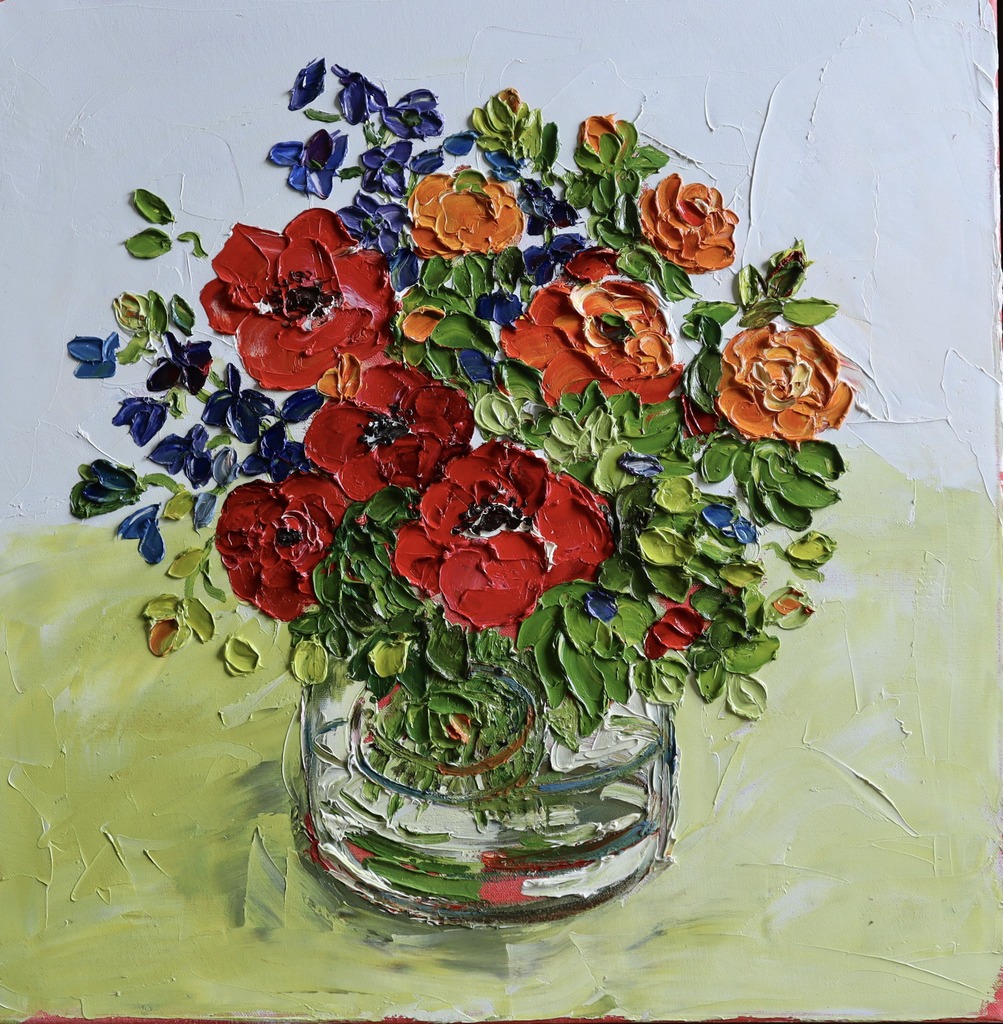
Duranbah Ranunculus and Delphiniums, Oil on Canvas
The Shift Project
At my solo exhibition in Newrybar last year I donated the proceeds of the sale of “Duranbah Ranunculus and Delphiniums” to the Shift Project. It is an amazing local charity that supports vulnerable women and that are transitioning from homeless to independence in the Northern rivers.
Your knowledge of botanical names
I am not that good with the botanical names of flowers thank goodness for google !!
Groupings of colours
The colours in the composition really varies depending on the seasons and what flowers are available, but I always edit a composition to ensure colours and tones are complementary. I also love the subtlety of a white and cream study .
It isn’t always flowers, discuss one or two of your fruit paintings.
We have a citrus orchard on our farm, so by autumn we have an abundance of lemons, limes, mandarins and oranges .I love the pop of colour, that mandarins and lemons add to paintings. The structure of the branches provide the composition. I have recently been be combining Australian natives with citrus in a floral compositions.
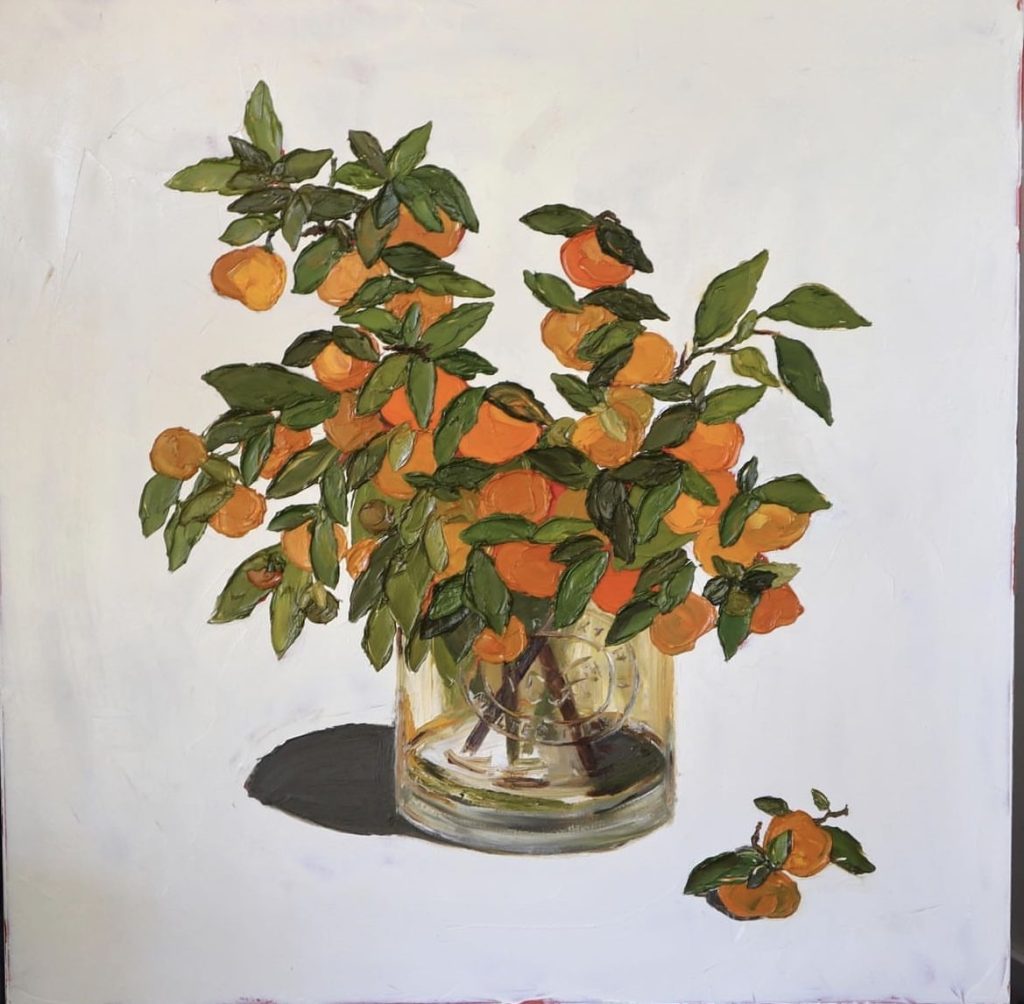
Mandarins in a Preserve Jar, oil on canvas
Why do you use old Norco bottles?
I am the 4th generation in my family to live on the Northern Rivers my dad grew up on a dairy farm in Myocum not far from our own property. His family provided cream to the local Norco factory so it is a lovely way to remember my Dad. I am lucky that my partner is a collector of old bottles so I have quite a few Norco bottles to select from to place in my arrangements.
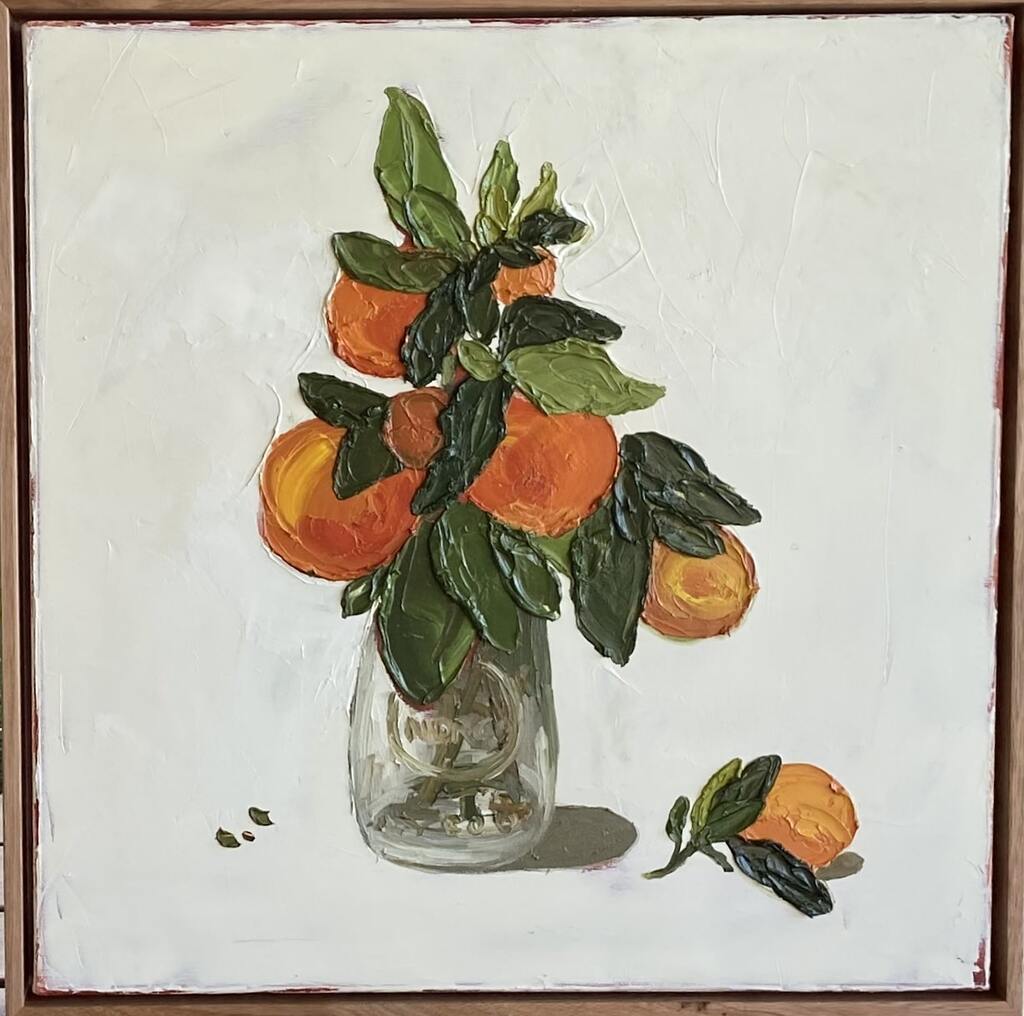
'Oranges in a Norco Bottle', 1.2x1.2mt, Oil on canvas
Discuss the size of your work.
Using one large, one medium and one small.
Large
The largest size canvas I paint is 1.2 m x 1.2m purely for the fact that’s the biggest size that can fit into my car . I find that a larger painting takes a lot more planning, and organising the composition.
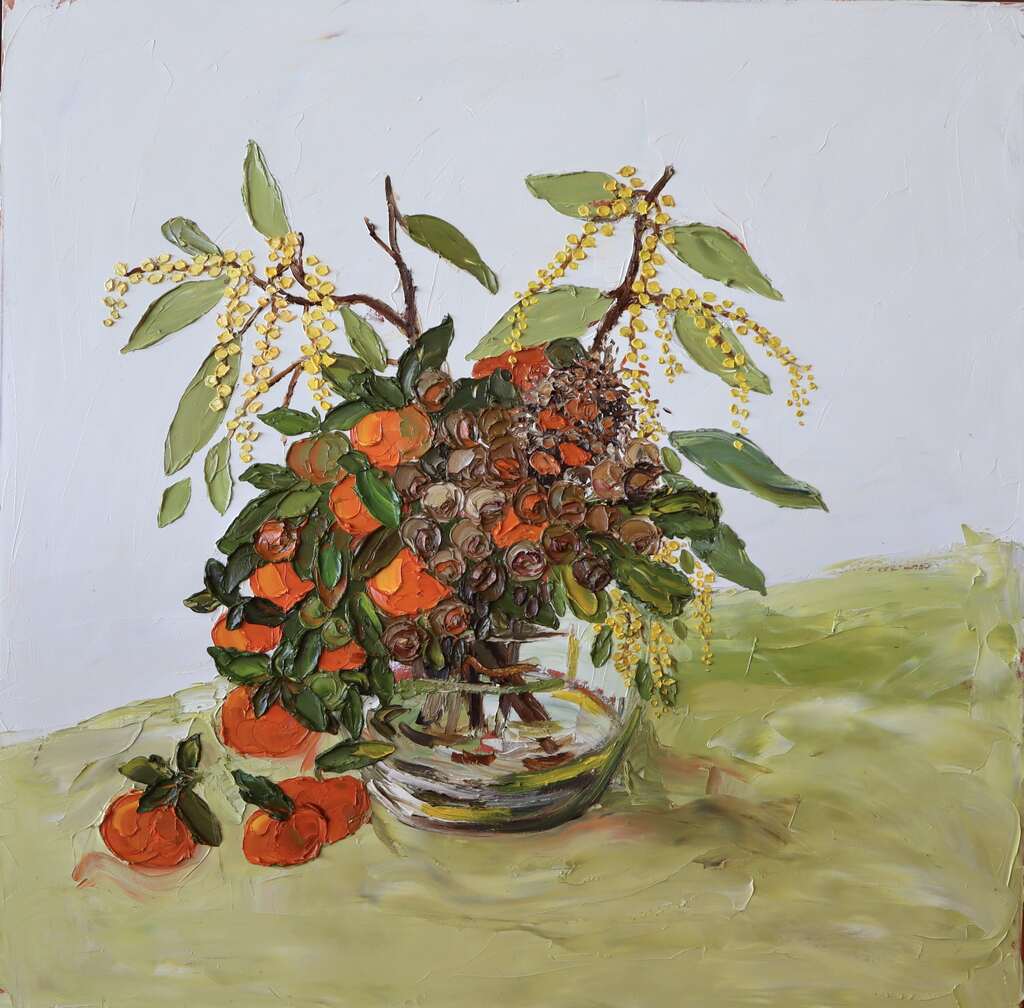
'Spring Mandarins with Wattle and Gumnuts', 93x93cm, Oil on canvas
I would love to be able to paint a large painting in one sitting but I will always come back to the painting and find something I am not happy with and will modify the composition.
Medium
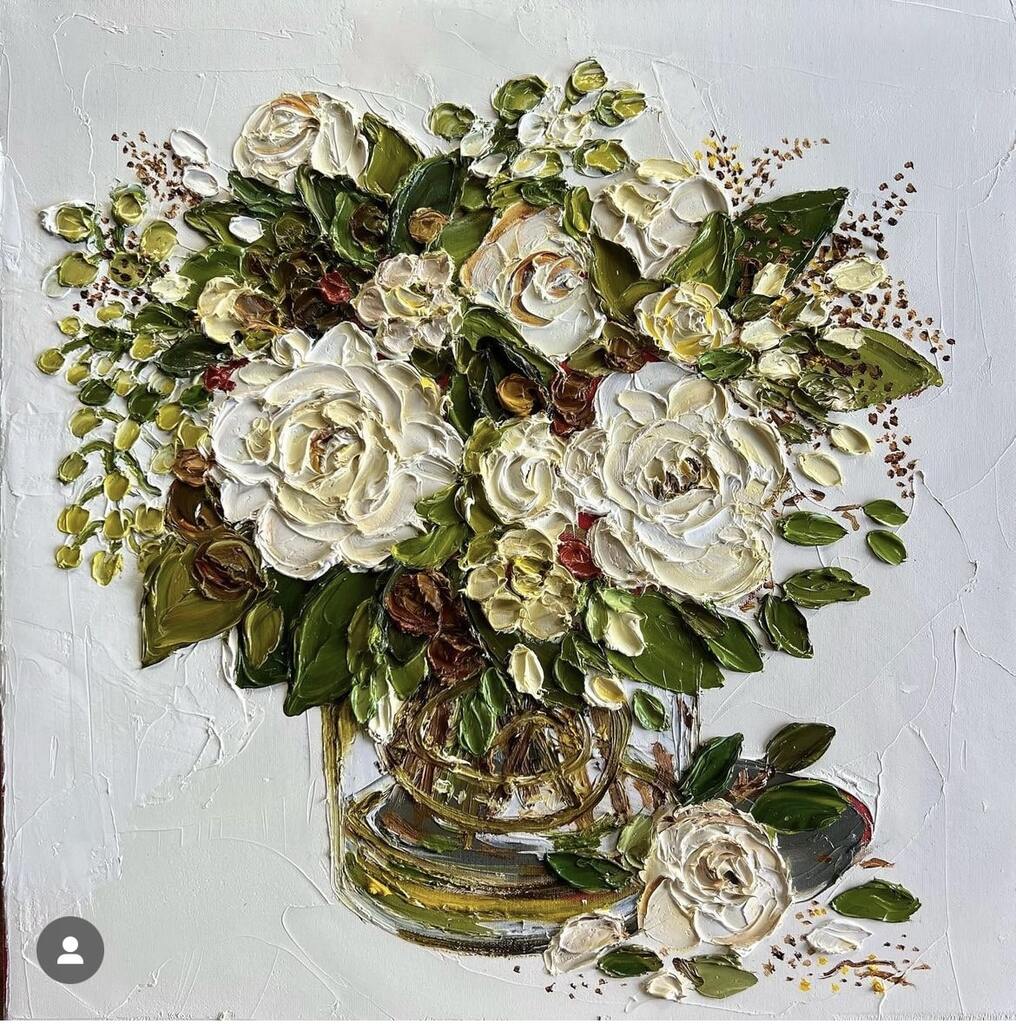
'Summer Roses' 53x53cm, Oil on canvas
A study of white roses ,stephanotis and gardenias, is painted with one of my favourite palettes neutrals ,whites and green foliage .
Small
Painting a small study is spontaneous, it can be painted in a short time so the paint is easy to move wet there is also the benefit that the flower is fresh and alive I don’t always paint perfect blooms. I also like drooping and fading flowers.
 il
il
David Austin Rose in a Norco Bottle, 33x33cm, Oil on canvas
You also do commissions, can you take one commission that you enjoyed doing and why? Where has the painting gone to?
I have painted quite a few bridal bouquets and flower arrangements for a birthday present. Commissions can be quite stressful because most clients already have a vision of the final painting in their mind. I always state that the painting will be an interpretation not an exact copy.
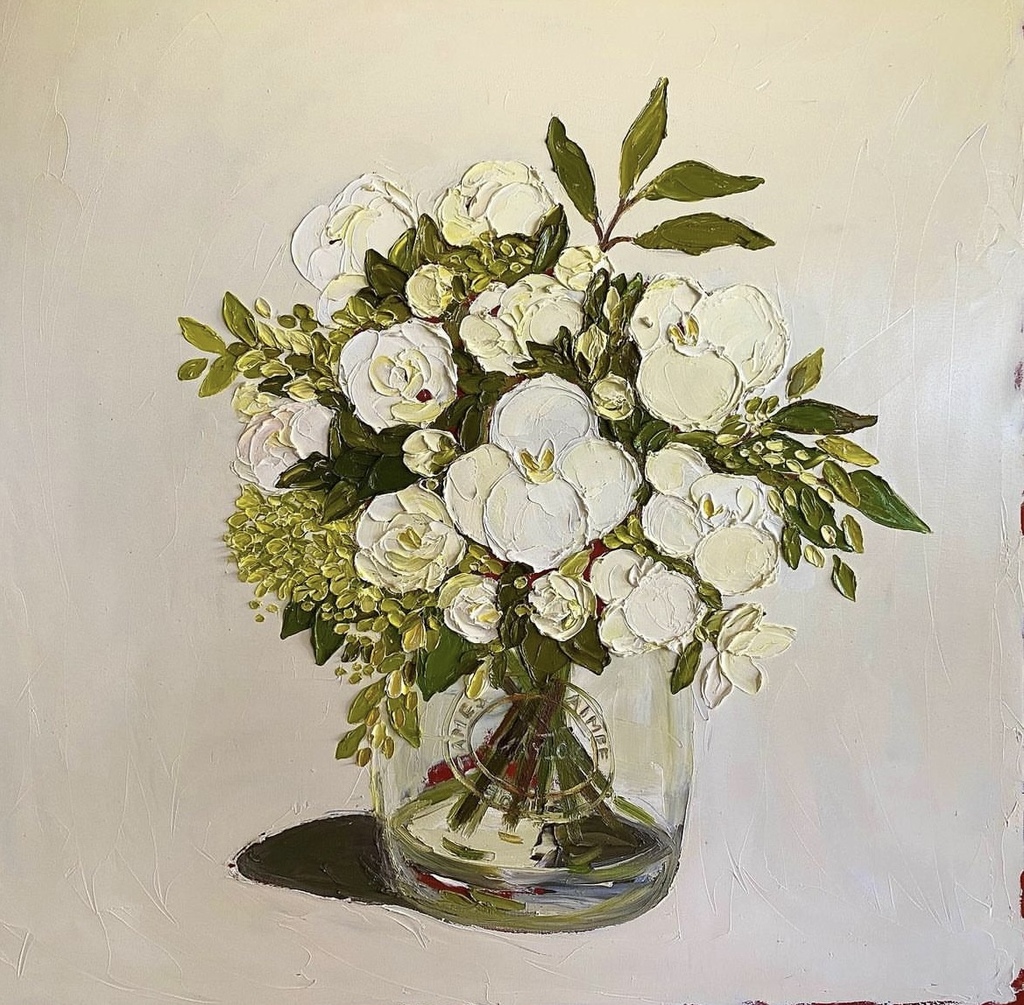 Commissioned Wedding Bouquet, oil on canvas
Commissioned Wedding Bouquet, oil on canvas
One of the most enjoyable commissions I completed was for the mother of a bride. It was going to be a gift for the couple, it was a beautiful bouquet of white orchids and roses. The mother gave me a beautiful description of the couple and their story. I placed the bouquet in an old preserve bottle and inscribed their names and wedding date etched on the glass. The couple loved it and said it was a perfect memento of their wedding. It is always so rewarding to get feedback like that!
Your original education was in Politics and History, how did the change to art come about? (This answer may make someone else brave enough to make the leap)
I have always loved drawing and painting. Unfortunately, I did not have the opportunity to study art when I left school .When I had the time and opportunity I started attending art courses. For several years I was privileged to study under amazing fine artists, John Bokor, Sophie Gralton and Celia Gullet they taught traditional artist techniques they were all so generous sharing their artistic techniques. It was not until I built my own studio on the farm that I had my own space. I was able to spend more time painting and experimenting with my art practice .
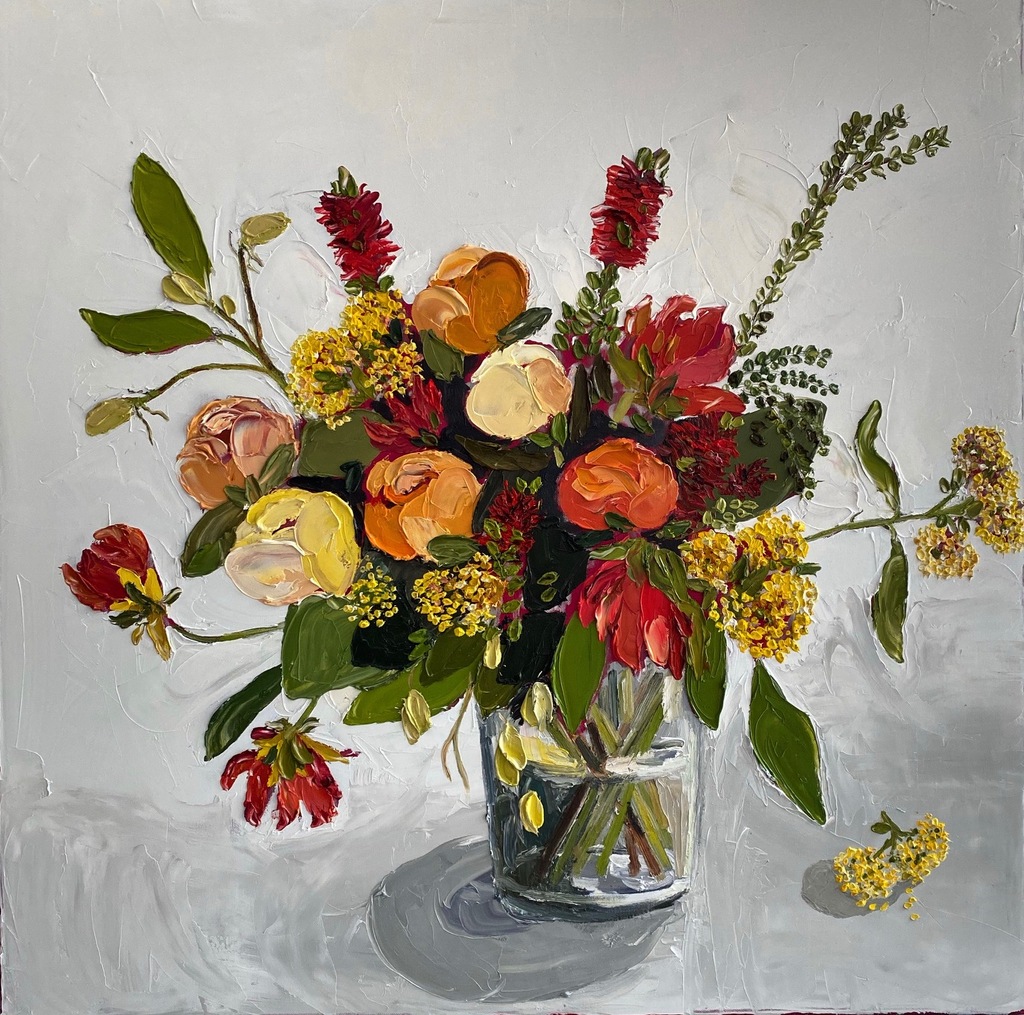
'Bold and Beautiful' 90x90cm, Oil on canvas
Contact:
Leree Lindsay
lereel@gmail.com
www.lereelindsay.com
Deborah Blakeley, Melbourne, Australia
Interview by Deborah Blakeley, February 2023
Philip Walker
Explain the importance of both Qest and training with Alison Crowther.
My scholarship funding from Qest provides an opportunity to have dedicated time to learn new skills. An opportunity like this is important and valuable because it is so difficult to dedicate time consistently under normal circumstances, especially as an adult with bills to pay and responsibilities. I have worked with Alison for many years and so she has a very good understanding of how I learn and how I see things. I think this is important because it gives us such a head start on the relationship between teacher and student. Alison also understands the work I want to produce and obviously has incredible experience and knowledge of the material we both work with.
You have been very involved with Qest (Queen Elizabeth Scholarship Trust). Can you please explain the royal involvement?
Qest was found in celebration of the 90th birthday of HM Queen Elizabeth, The Queen Mother. Charles became a patron in 2017.
Discuss how the correct use of tools has been for the growth of your art?
Learning which tools will allow me to achieve the results I want has been crucial to the progression of my work. Some tools certainly have a correct way to be used, especially edge tools (chisels, planes etc.) and learning those ways will give optimal results. For me pushing the capabilities, exploring the versatility of power tools such as the Arbortech carving range, and perhaps sometimes using them not as they are intended, has allowed me to push my work in new directions.
What finally lead you to move from being a tree surgeon to sculpture?
A number of commissions came along at the same time which gave me the confidence to commit to sculpture work. Operating as a tree surgeon absorbs an enormous amount of energy and so it is difficult to do both at the same time and move either one forward.
Discuss your work in more detail.
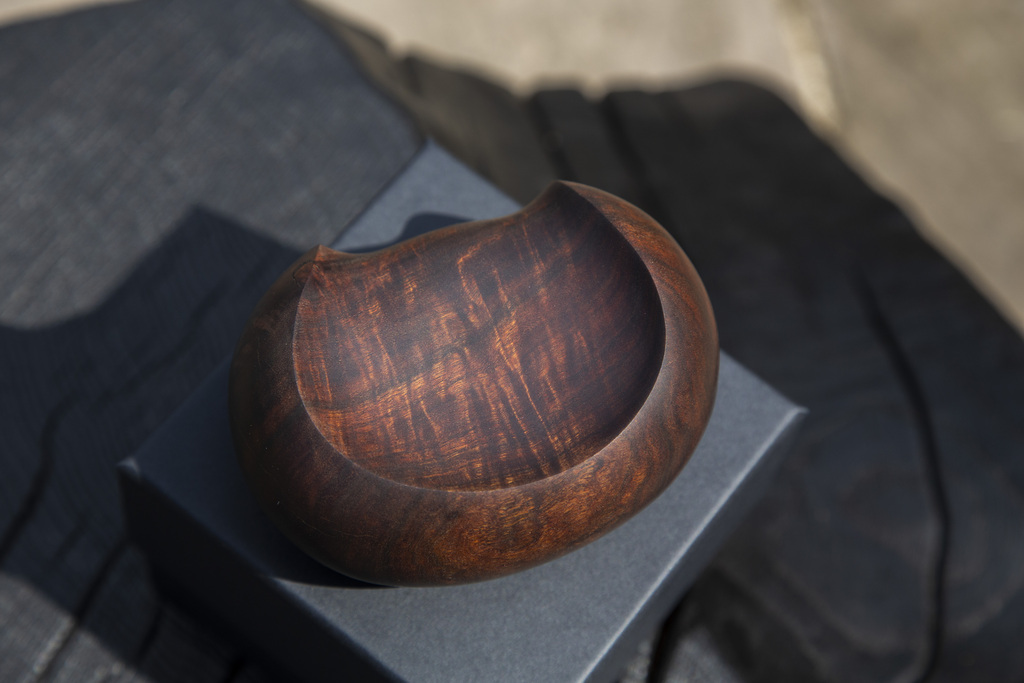
Form – Tactio V
Tactio V
The form of Tactio V, and others in this series of handheld pieces, is decided primarily by the way it sits in the hand. Each of the handheld pieces evolves as material is removed and the form is held and viewed, until it sits in a certain way that feels right. I might make minor tweaks to adjust the aesthetic.
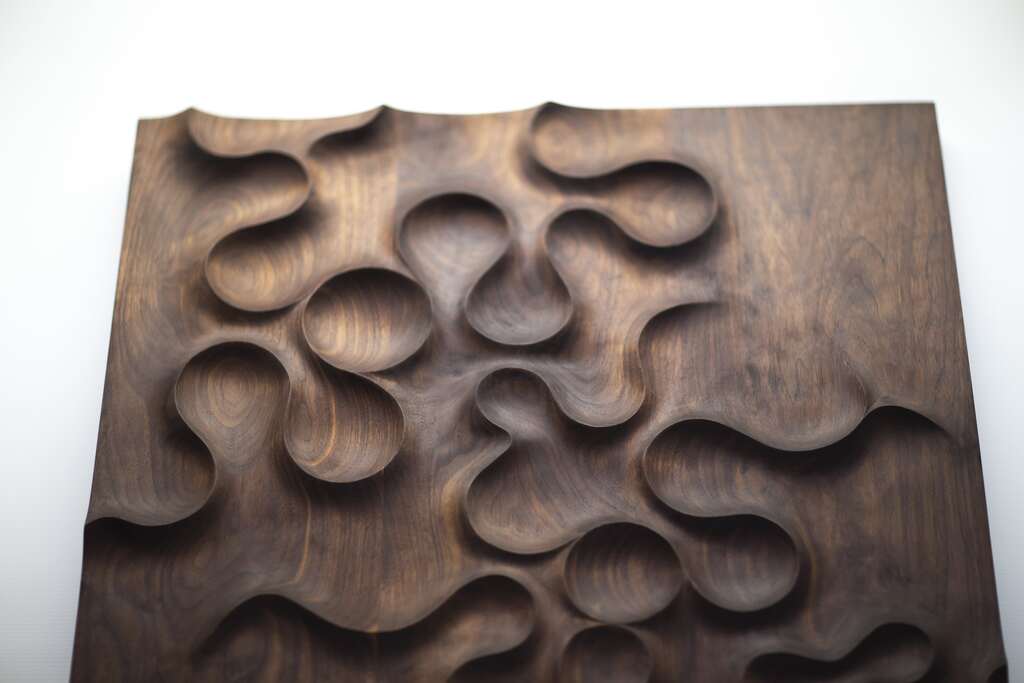 Flow – The Path of a Wandering Mind
Flow – The Path of a Wandering Mind
‘The Path of a Wandering Mind’ American Black Walnut.
The Path of a Wandering mind tells a story of dead ends, new beginnings and adventure. It has a beginning, middle and an open end. The carving for this piece was designed to flow from beginning to end in order to tell the story and this was achieved by using curves formed of very smooth lines, and the scale of the carving growing as the story progresses.
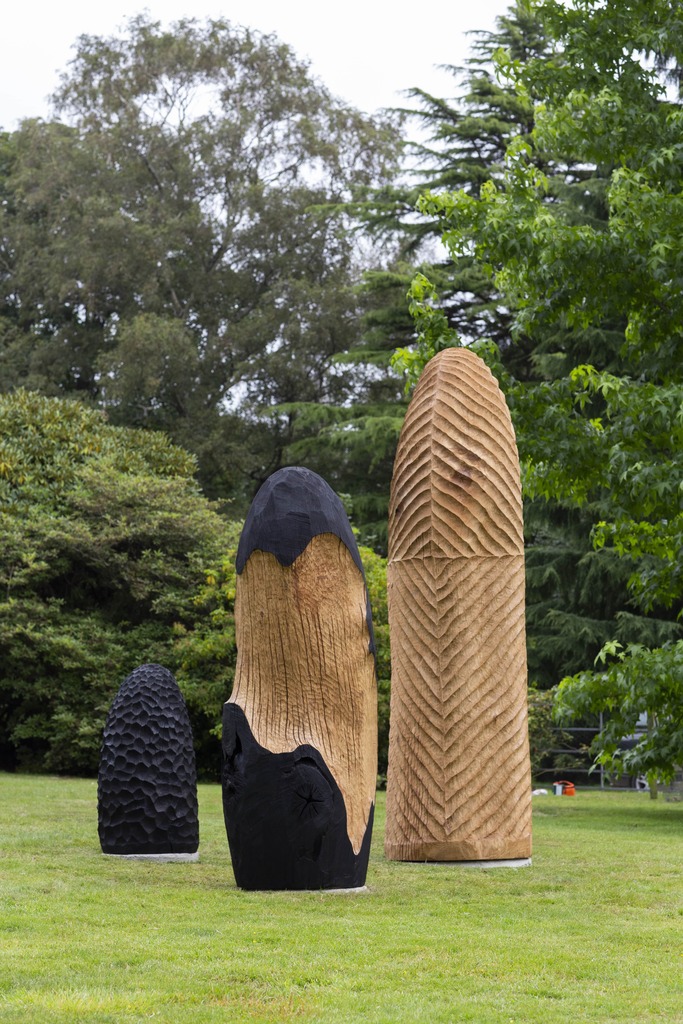 Texture – Trio of Oaks
Texture – Trio of Oaks
This commission was all about texture. I wanted to create lots of shadow to show textures that could be seen from a distance, but also micro textures that would provide interest up close. The largest of the trio stands 3 metres tall and so the carving needed to be deep.
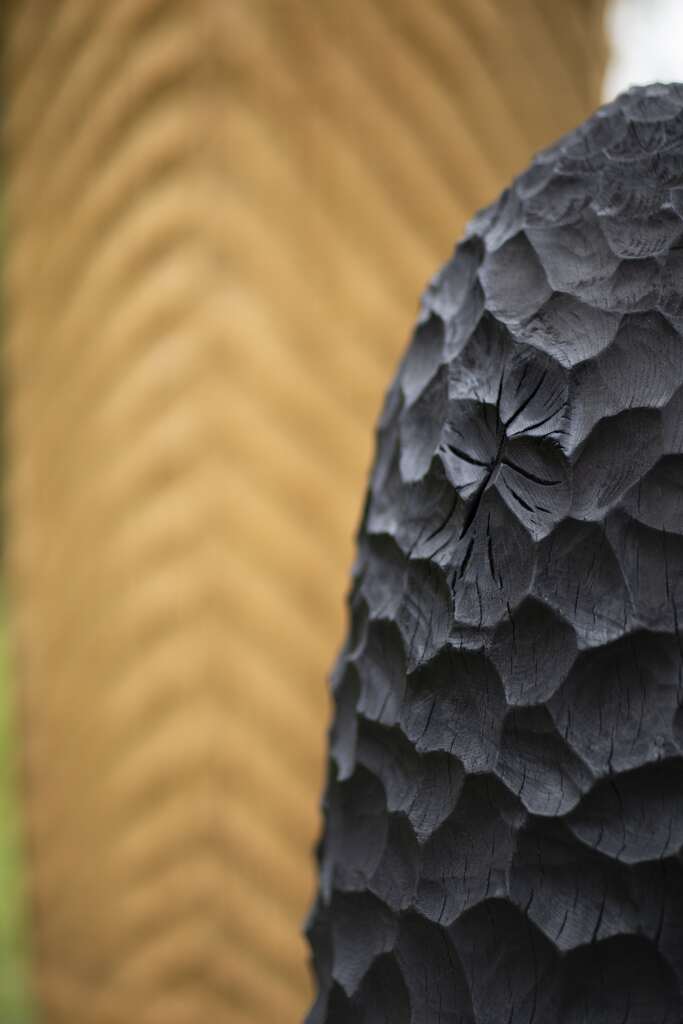
The scorched pieces, especially the smallest of the trio, have several textures. There is the texture I have carved, the texture created by the reaction of the wood being scorched, and the texture of the wood cracking as is dries and moves. The scale and deep carving give these pieces great presence in the garden.
Why is a chainsaw so important to your work?
Almost all of my work starts with a chainsaw. The raw material is delivered in log form and so chainsaws are used to efficiently remove material to a rough shape, or to section the log into smaller pieces for forms of varying scale.
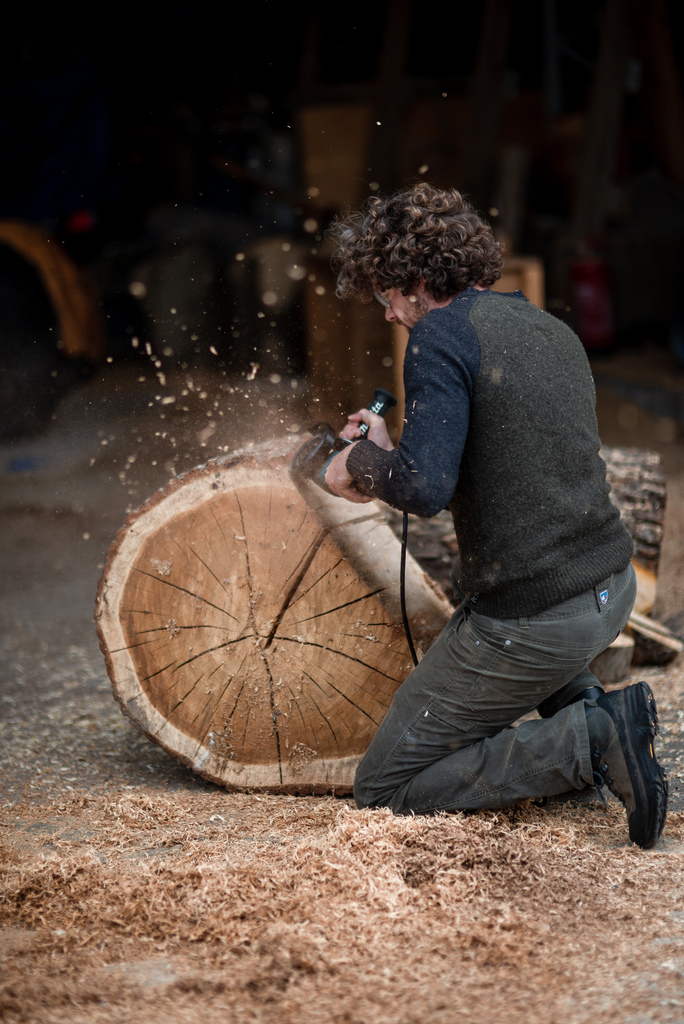 Making chips fly
Making chips fly
How many chainsaws do you have and how are they different to use and why?
I have three saws:
- A Stihl 661 used for big cuts and also milling timber together with an Alaskan sawmill attachment. This is a relatively heavy saw capable of taking a 36” bar. It is powerful and aggressive, but can be used to make accurate cuts.
- A Stihl 361 (my favourite). A midrange saw with a 20” bar, lightweight and easy to use at any angle. I still use this saw for roughing work but it can also be used for more accurate work.
- A Husqvarna T540. This is a top handled arborists saw, designed to be used in the canopy of a tree and hung from a harness. A very useful saw for small cuts and accurate work. Extremely powerful for its size. Left over from my climbing days.
The saws don’t differ much in use other than the size of timber they can cut.
Please take a specific tree that was felled due to damage that you have been able to give new life to.
Old tree
A large Redwood which died due to disease and had to be felled, from Ingleby Manor, North Yorkshire.
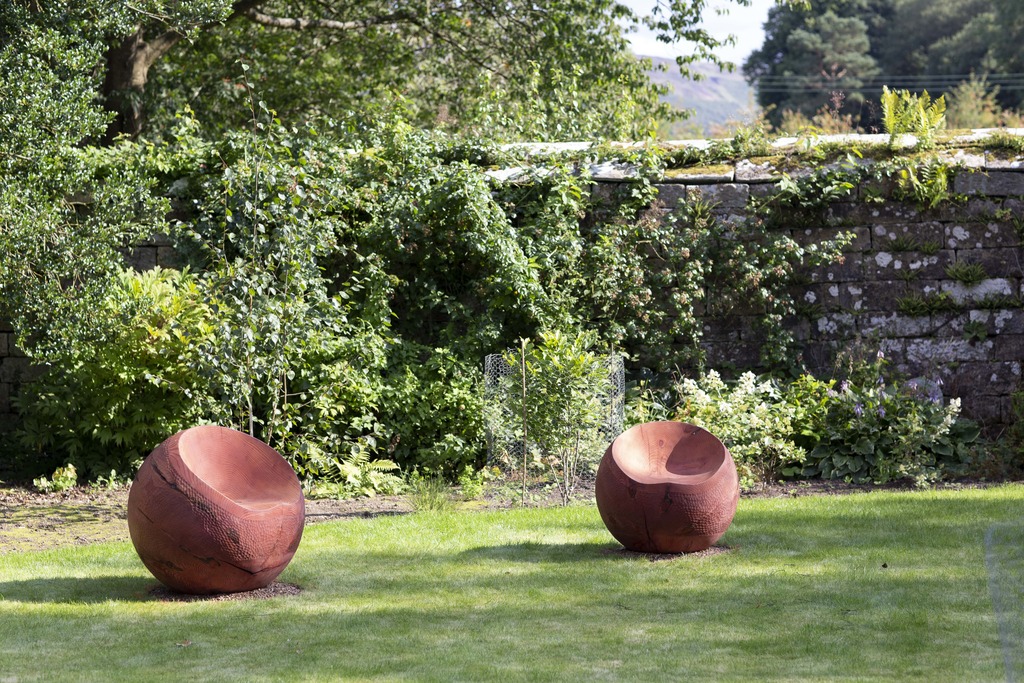 Ingleby Manor
Ingleby Manor
Your involvement
I went up to the site to process the timber into sections suitable for several sculptures, which could then be transported south to my workshop. The owners of the tree commissioned several large sculptures, a bench, two sphere seats and a large sphere split in half with carved faces. I also made a scorched wall hanging from an offcut of one of the spheres.
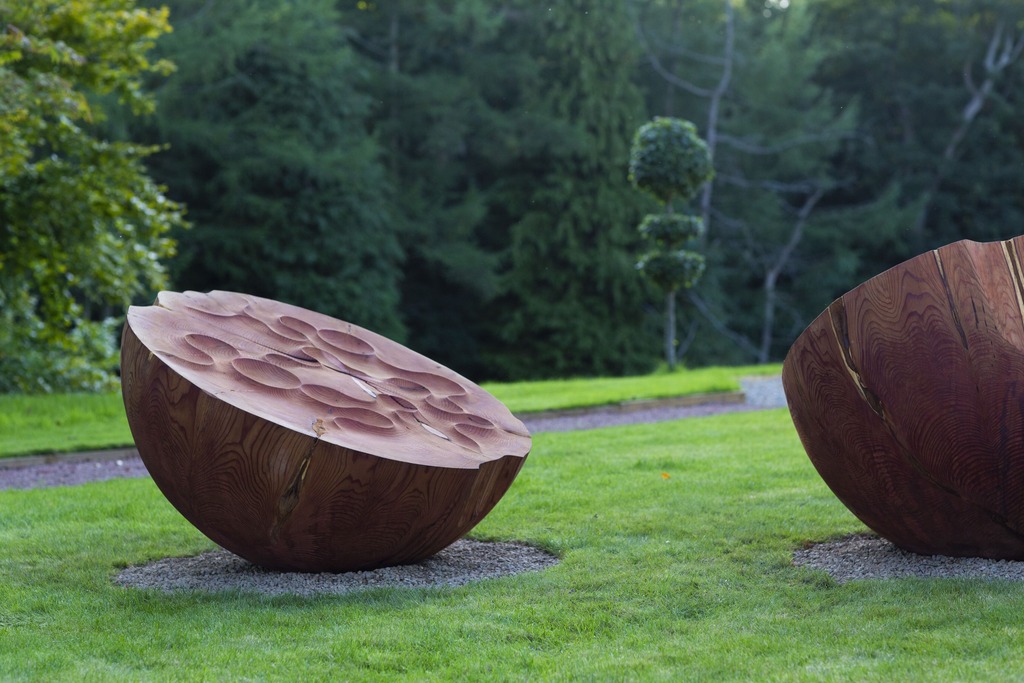 Ingleby Manor
Ingleby Manor
Where the sculptures are now
The sculptures are in the grounds back at Ingleby Manor, a stunning Manor house built in the 16th century, which is a family home and holiday cottages.
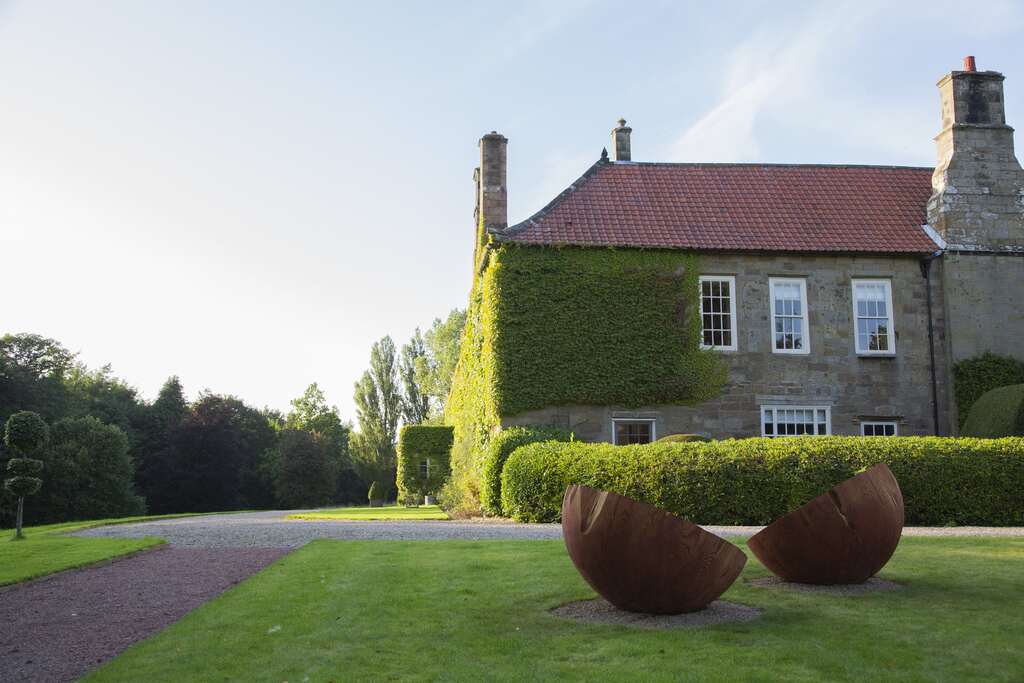
Ingleby Manor
How do you get your message across to people who have to remove a tree, that you could collaborate with them to give re-life?
Only through folks who know me from my time as a tree surgeon, or through Instagram. It would be great to find a better way of getting this out there as I think some are not aware of what can be achieved with a fallen tree.
After a tree surgeon has felled a tree, how long do you have to wait to be able to work on the wood?
You can work on the wood immediately if you choose to. The main consideration is moisture content, but time has little effect. A large log will give up very little moisture, other than right at the surface, over multiple years. It is only when that log is milled into boards or cut into smaller sections that it will begin to dry, as more surface area is exposed. Some species such as Ash naturally have a lower moisture content than others. The time of year the tree is felled plays a part in moisture content also. A tree felled over winter, whilst dormant, will have a considerably lower moisture content than a tree felled in late spring or summer.
There is a saying that goes something along the lines of “wait a year, let the tree know it’s dead”. Like all sayings passed down through generations it is probably a good idea based on a wealth of knowledge and experience, but I do not know the reasons or science behind it!
Discuss your work area.
Size
The workshop is not big enough, but whose workshop is?! It is a reasonable size at about 100 square meters, large enough to manoeuvre a forklift in as long as I am tidy. It is part of a much larger barn, originally built to house dairy cows, so long and narrow. It is open to the elements on one side and the roof leaks and drips condensation when cold. It has light and power, and I can make as much noise and mess as I like, so it suits me fairly well but is brutally cold in the winter.
Requirements you see as essential
As mentioned above, light, power and no one to bother me about noise. It is part of a larger farm with many commercial units. The landlord is great and always happy to lend a hand with the telehandler and removal of my ever growing pile of sawdust. They also turn a blind eye to my also ever growing collection of interesting logs. In turn I keep them supplied with firewood. The forklift, and room to manoeuvre it is essential to what I do.
Take one small sculpture and discuss.
Cloven
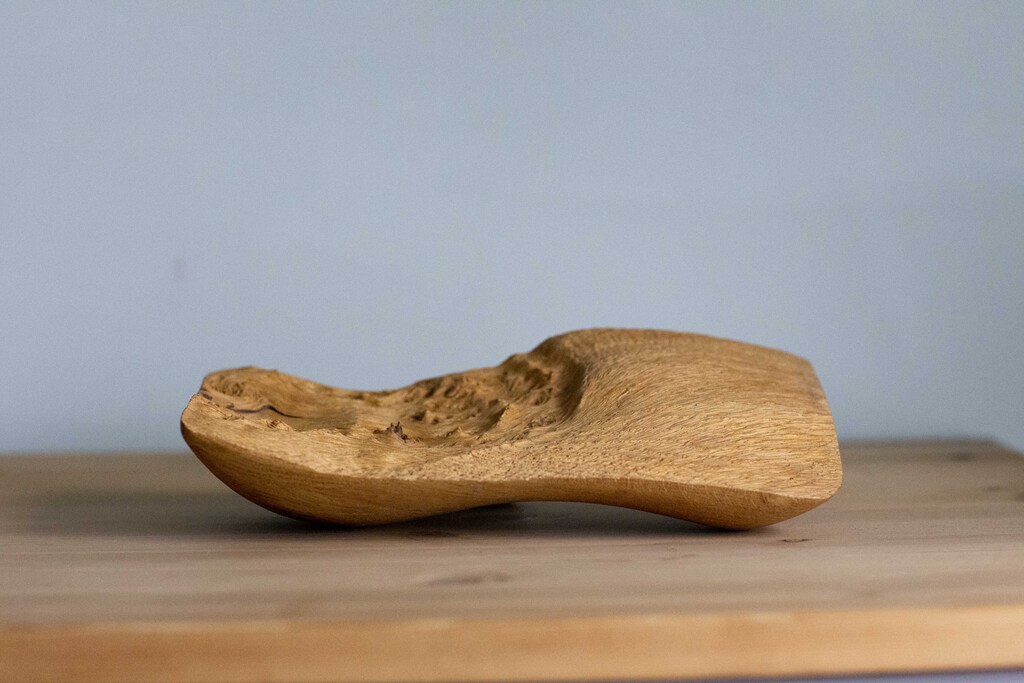 Cloven
Cloven
I am interested in the many methods and techniques used to expose the beauty of wood. The texture created by cleaving a select piece of timber is difficult to rival with any that I might force upon a piece. This method offers an opportunity to explore the interaction between the maker, his tools and the material itself.
Cloven is the first piece in a series I am currently working on that explores this interaction. The aim is to create a juxtaposition between an organic texture and the smooth form I have deigned to carry it.
Take one large sculpture and discuss.
In Solidarity
This pair were designed to sit together, with the carved lines of each flowing towards the other. They are made from a very knotty and interesting lump of English Oak. This was one of my first large commissions and the first large pieces finished entirely with gouges. At the time this was an ambitious design for my as it relied on precision. The form had to be precise, the marking out had to be precise and the carving had to be precise but the most challenging part was drilling the holes in the bases to accept the stainless steel on which they are mounted. It was a great introduction to the complexity of hand carving and the reality of working with a heavy material that does not always behave as desired. I am very proud of this piece and grateful for trusting and patient clients!
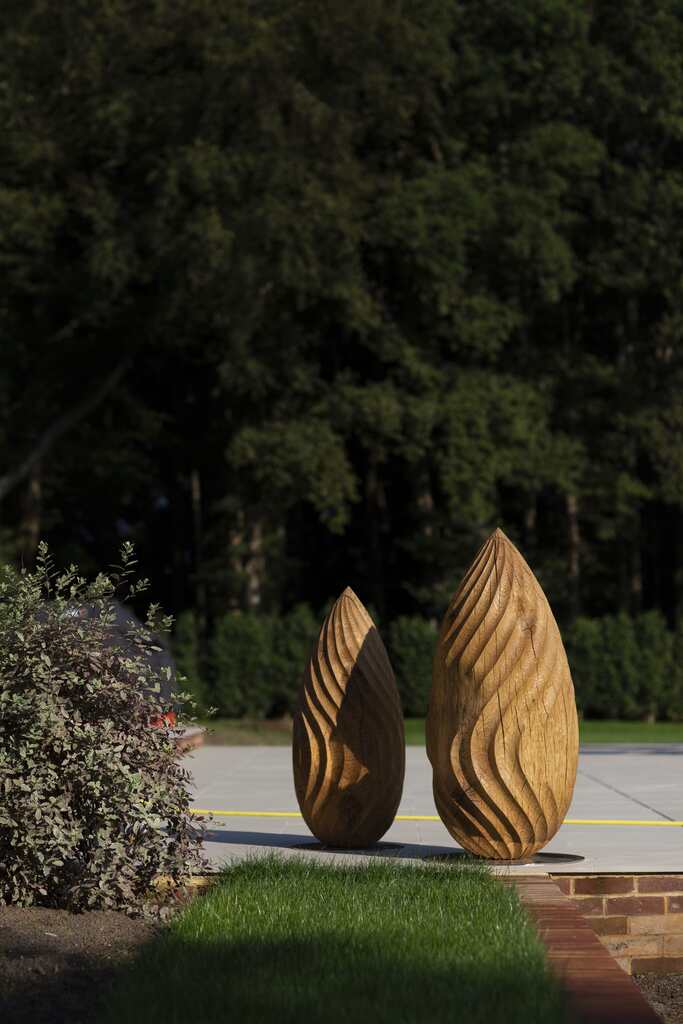
In Solidarity
How do you explain to people you meet what your art practice is?
With my background as a tree surgeon most people assume my work will be representative chainsaw sculpture and so I try to explain that the chainsaw is just a tool used for roughing out, followed by many other tools to refine the finish, and that my work is contemporary. It is so easy to pull out my phone and show my Instagram feed, which lays the groundwork for an easier conversation about processes and inspiration.
What was the first tree you remember climbing also the latest?
The first tree I remember climbing was a tall competing Ash with a sparse canopy competing with other trees within the forest. It was early in climbing career and I had been sent up it by the boss as an exercise in accessing the canopy from the ground using a bunch knot (a way of throwing a cleverly knotted coil of rope over a branch with the tail end returning to you in order to ascend to that branch) and change overs (using two ropes to alternate between as you throw to the next branch and make you way up the tree). At this stage I was not very good at these techniques and was not allowed down until I had reached the top. It was very frustrating, but all part of the journey.
The latest tree I climbed was a crappy, ivy covered silver birch this past weekend as part of a volunteer work party at a lake I fish at. Not very exciting, but any tree work with mates and little in the way of time pressure is good fun!
What recommendations would you give to hesitant parents about safe tree climbing?
With the right equipment and the right people to learn from, it can be very safe. The technology surrounding the equipment used has come on leaps and bounds over the last couple of decades. Climbing equipment has never been safer (or shinier and expensive!). For perspective climbers, put time into learning about the bio mechanics of trees, tree biology and fungi, pests and diseases. All of which will give you a better chance of seeing a failure before it happens. Good judgement is key. Adding chainsaws and rigging into the mix changes things entirely. Learn good techniques and surround yourself with a crew you trust!
What is the life expectancy of one of your sculptures that are outside?
25 years, potentially much longer.
Expand on the sculpture, ‘Darkness Within’ and the black pattern.
The original Darkness Within and subsequent pieces in the series represent the way I was feeling at the time. I think many can relate to a feeling of darkness within, whether it be pain, anxiety or fear. This sculpture and series represents that feeling but not in bad or sad way, simply in recognition and to put it out there to be accepted.
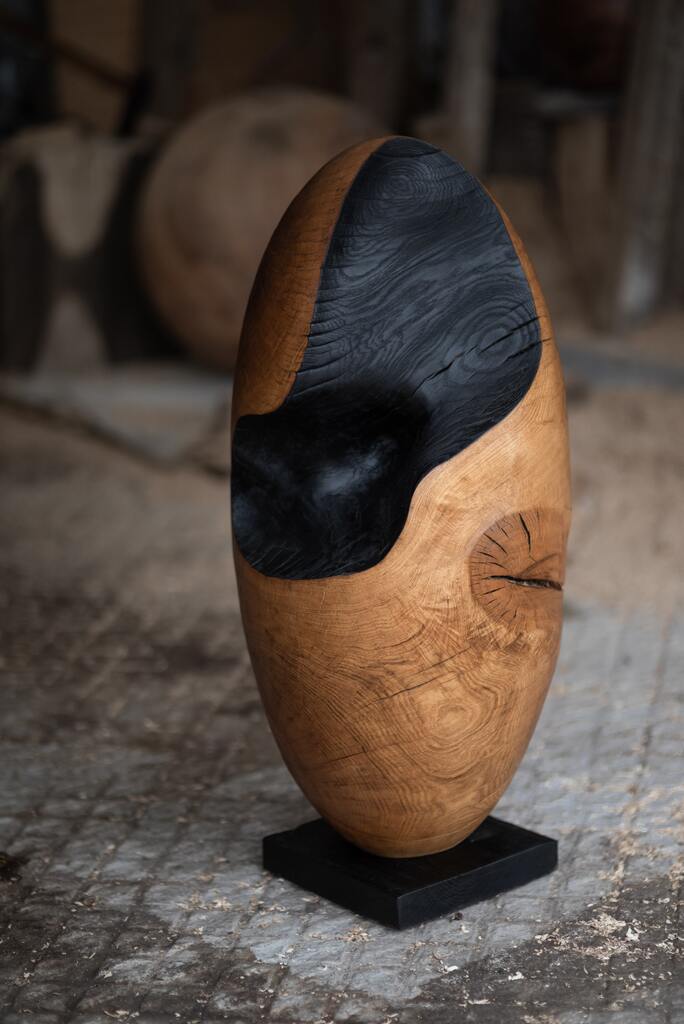
Detail of ‘Darkness Within’. English Oak. Photo: Sarah Sheldrake
The work itself is some of my favourite. I love the contrast and I love the process. I enjoy the transformation of the wood in colour and texture as the flame and heat pass over it. I try to exploit natural cavities in the wood, or create them using the contours of the growth rings.
How is some of your work used as furniture – e.g., Beech Coffee Table.
Alot of my work is functional as seating or tables. I think it is easier for some clients to justify functional sculpture and I am very happy to combine art and functionality. It often presents challenges as useful objects tend to have rules for dimensions which natural materials don’t always accommodate, but therein lies the fun.
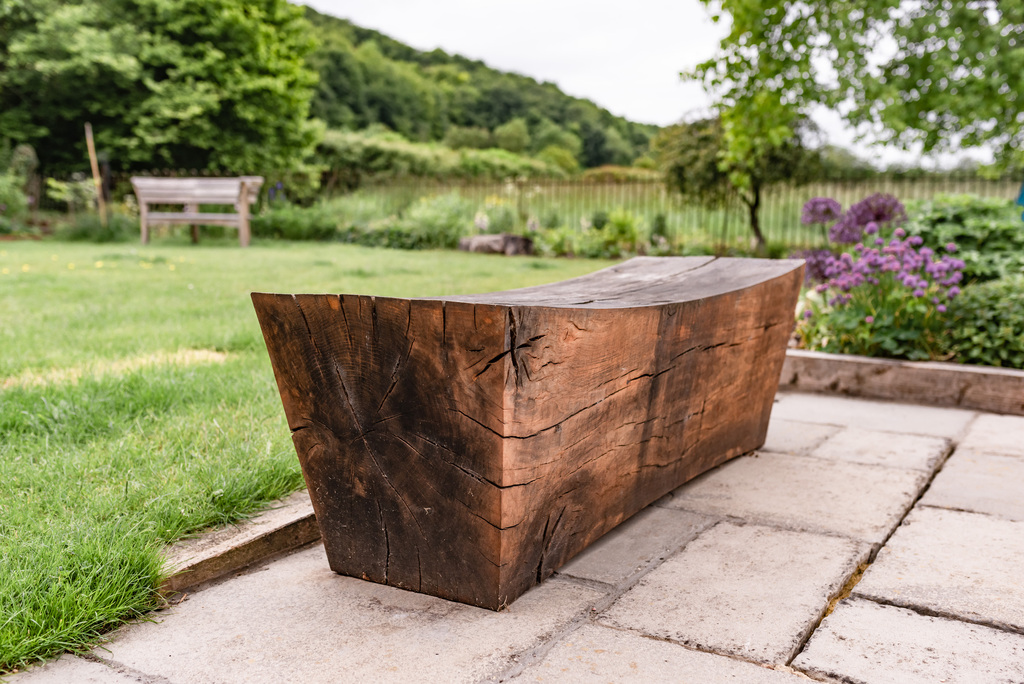
Solid Oak bench seat. Photo: Harvey Coates
Wood has been used to create furniture for centuries, and a fallen tree has provided seating for weary travellers for even longer. I think, we connect wood and furniture as though it has always been, it feels right.
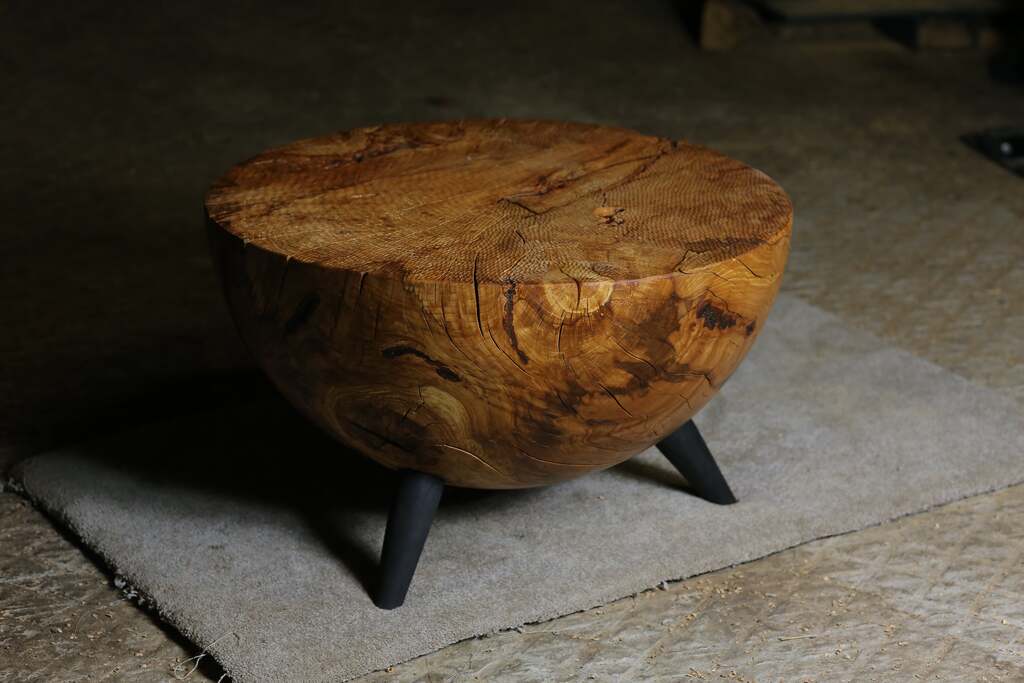 Beech Coffee Table.
Beech Coffee Table.
‘The Path of a Wandering Mind’ what lead you to using the meandering lines?
Experimentation with carving techniques to create shadow and flow.
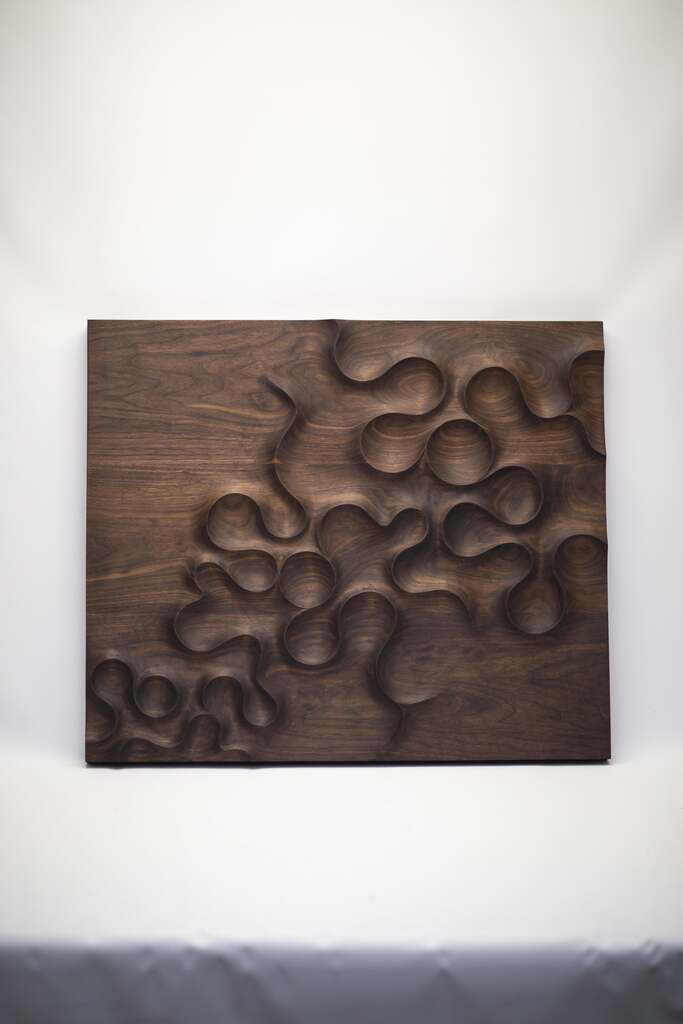 ‘The Path of a Wandering Mind’ American Black Walnut.
‘The Path of a Wandering Mind’ American Black Walnut.
Are there any woods you have not worked with, but you would love to and why?
There are many I would like to work with but one in particular springs to mind, English Elm. This species once dominated the British landscape but was decimated by Dutch Elm disease in the 70’s. The trees grew large with a similar form to Oak. The timber is a rich brown with contrast between summer and winter growth, creating beautiful patterns in figured pieces. Although most were felled before I was born I still feel a nostalgia, probably mostly through stories I have been told by past generations of tree surgeons and carpenters.
Contact:
Philip Walker, Petersfield, UK
philiptreewalker@gmail.com
Deborah Blakeley, Melbourne, Australia
Interview by Deborah Blakeley, January 2023
Patricia Shone
Your method is very manual and physical discuss.
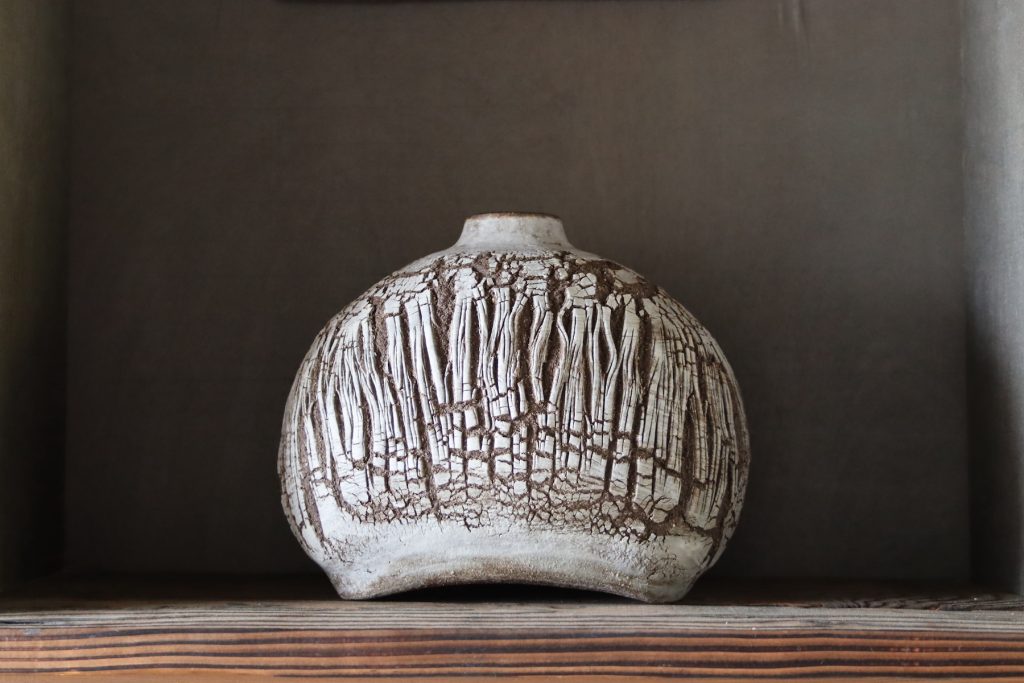
Forest Jar, 2021, height 23cm
The feel of soft clay in my hands and between my fingers. Years of working with it developing strength in my body giving me control in my work which connects me to the physical world around me, beneath my feet. Being aware of living in a body which works well feels like a dance. Movement and activity balancing the mind. All these contribute to the work I make, physicality connecting directly to inner inspiration. Some time it feels like kneading the Earth and I’m actually a rubbish dancer.
How has this affected you physically?
For most of my life I have been fit and strong and coped well with the physical rigours of making ceramics (and 12 years of cheffing). Occasional bouts of carpel tunnel syndrome which always improved with rest. Middle age brought with it the massive drop in oestrogen and I lost all its wonderful anti-inflammatory properties. I felt the beginnings of frozen shoulders. I was in the early stages of learning techniques of making textured work on the wheel which became impossible with the pain and restricted movement in my shoulders. It was this condition which led me to work out how to make small textured pieces by hand building. This is what I have been developing ever since.
I now use a regime of yoga and walking and to be aware of how my joints are coping with any given task. ‘Old age doesn’t come by itself”
Watch this video and see the construction techniques
What type of clay do you use?
I use various types of clay, mostly highly engineered from the Potteries in Stoke on Trent. The texturing and stretching techniques which I use stress the clay and open up its matrix, weakening it, rather than compressing it. When the clay is then subjected to raku firing, wood firing and extreme reduction the stresses are even greater. The clay has to withstand all of that.
I use a couple of raku bodies, great for thermal shock and low shrinkage; a couple of crank clays, similar properties, higher fired and more interesting colour results in wood firing; a black firing clay and some porcelain, both temperamental. I recycle all the scraps of all of these all together which usually gives me the most exciting results in the wood kiln.
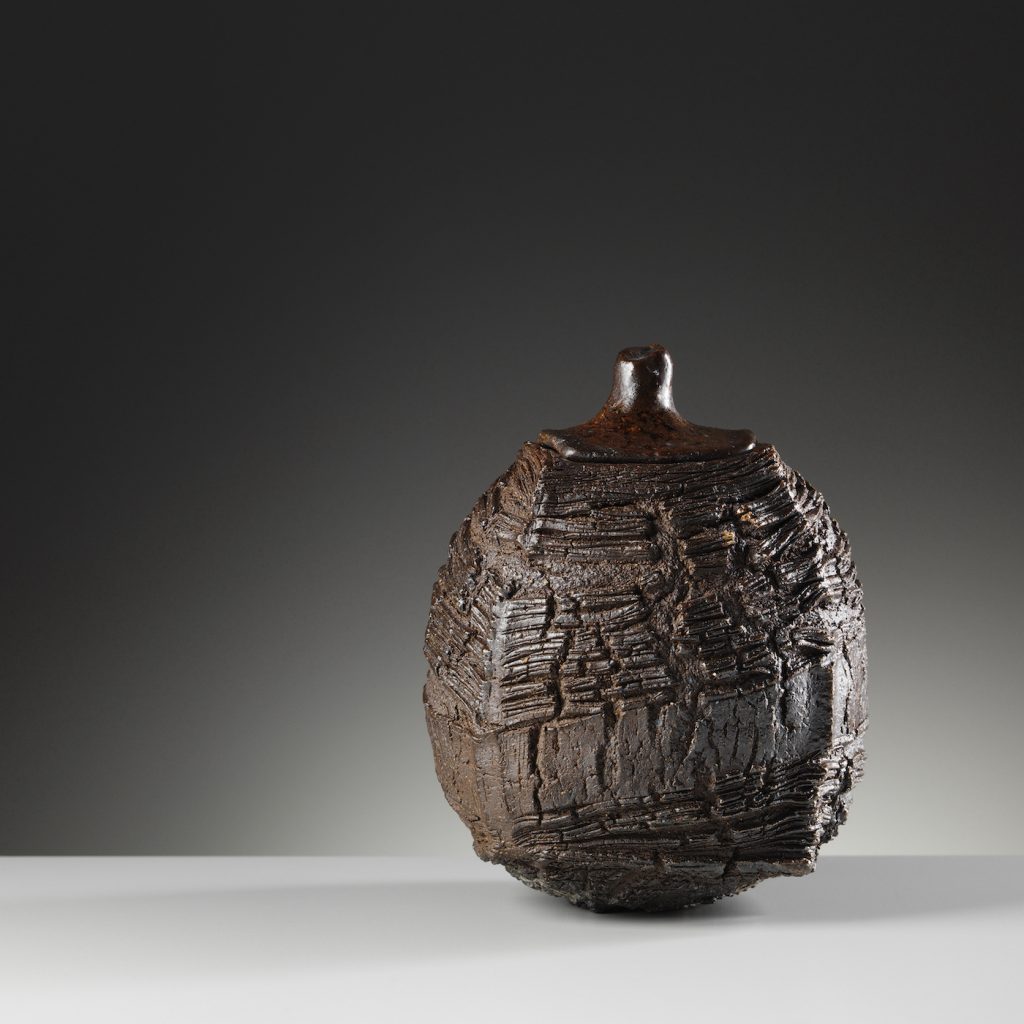 Lidded Erosion Jar. ht16cm.wood fired. Image ShannonTofts. 2017
Lidded Erosion Jar. ht16cm.wood fired. Image ShannonTofts. 2017
There is very little wild clay on Skye, the rivers are too short and most glacial deposits have been washed away. There are a couple of small deposits which I am experimenting with as glaze ingredients.
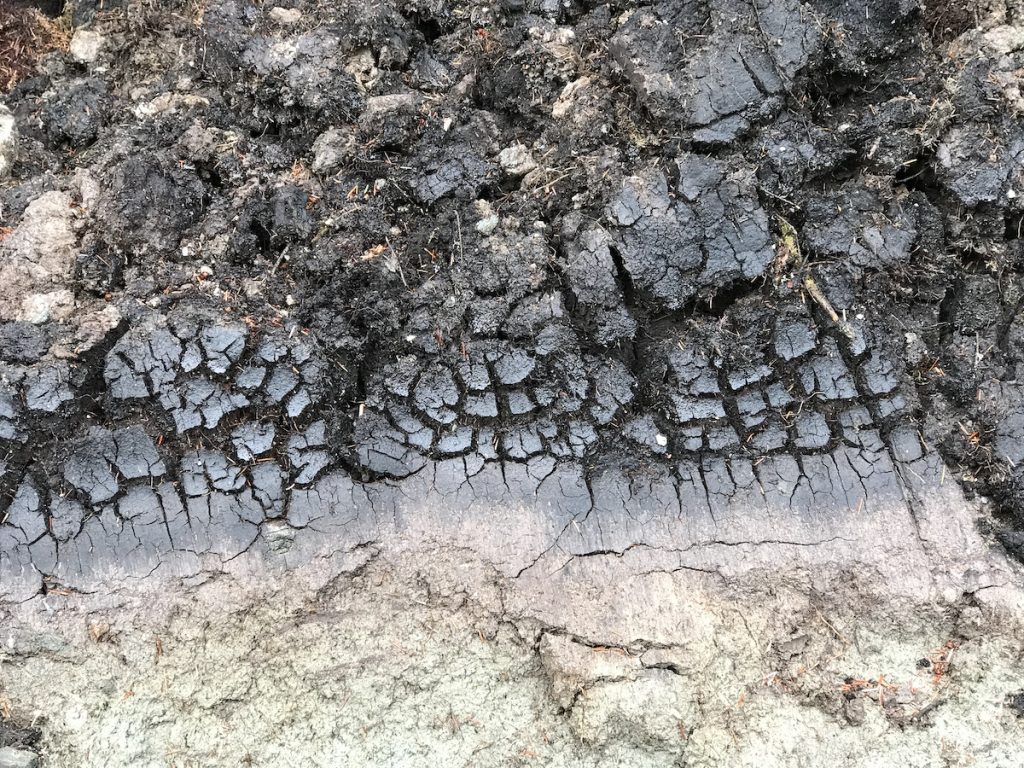
Peat erosion
How has living and working on Skye influenced your ceramics?
It would be hard not to be influenced by these surroundings, it’s quite an immersive experience living here.
There again it’s hard to know as I haven’t lived anywhere else whilst working full time on my ceramics.
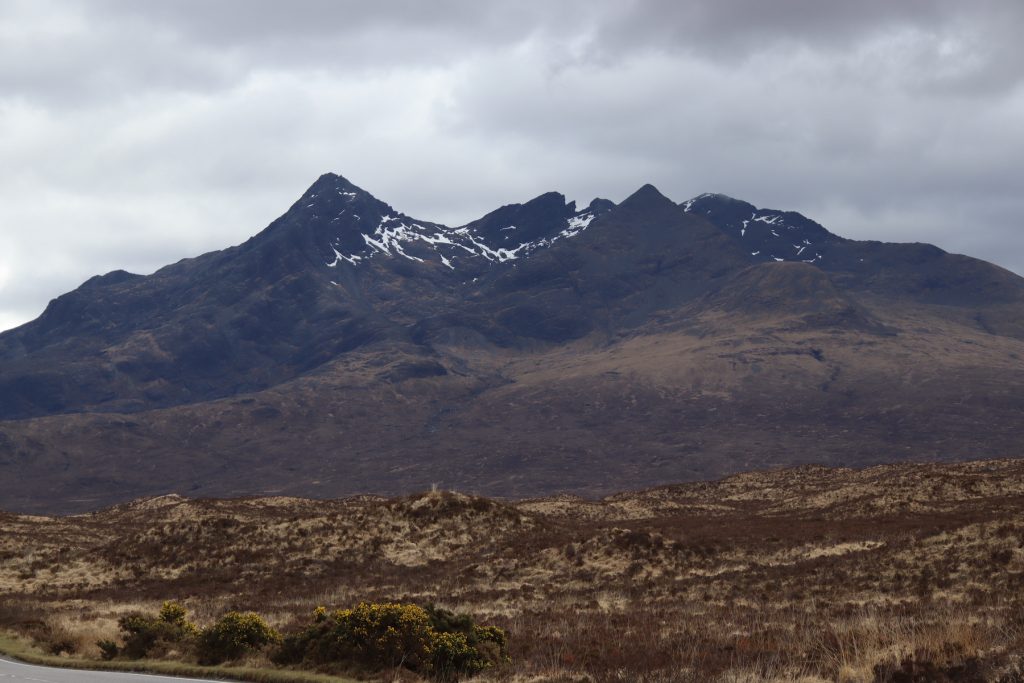
The Cuillin Range, Skye.
I do feel I was brought here and it feels uniquely and perfectly suited to both me and my work. It’s all inseparable. The path of accepting and learning to love all the aspects of living here is also the path along which my work has developed. Problems and issues that living here raised within me, that I needed to deal with, were the problems that were blocking my work. I’m thinking of things like confidence, self-worth, expectation & disappointment, trust in my own vision, belonging. Belonging is a big one, it’s very strong amongst local people here and I had to find and claim my own sense of belonging. As a child of an itinerant family, I never felt I came from anywhere, which is freeing but also lonely. The 2014 independence referendum kind of forced me to stake a claim!
When and why do you use the wheel?
Initially I was throwing texture pieces, practicing the techniques I learned from Shozo Michikawa, a master of these twisted, energetic forms. I got to the level of being able to make a virtue of throwing badly. I had to stop when my shoulders problems began.
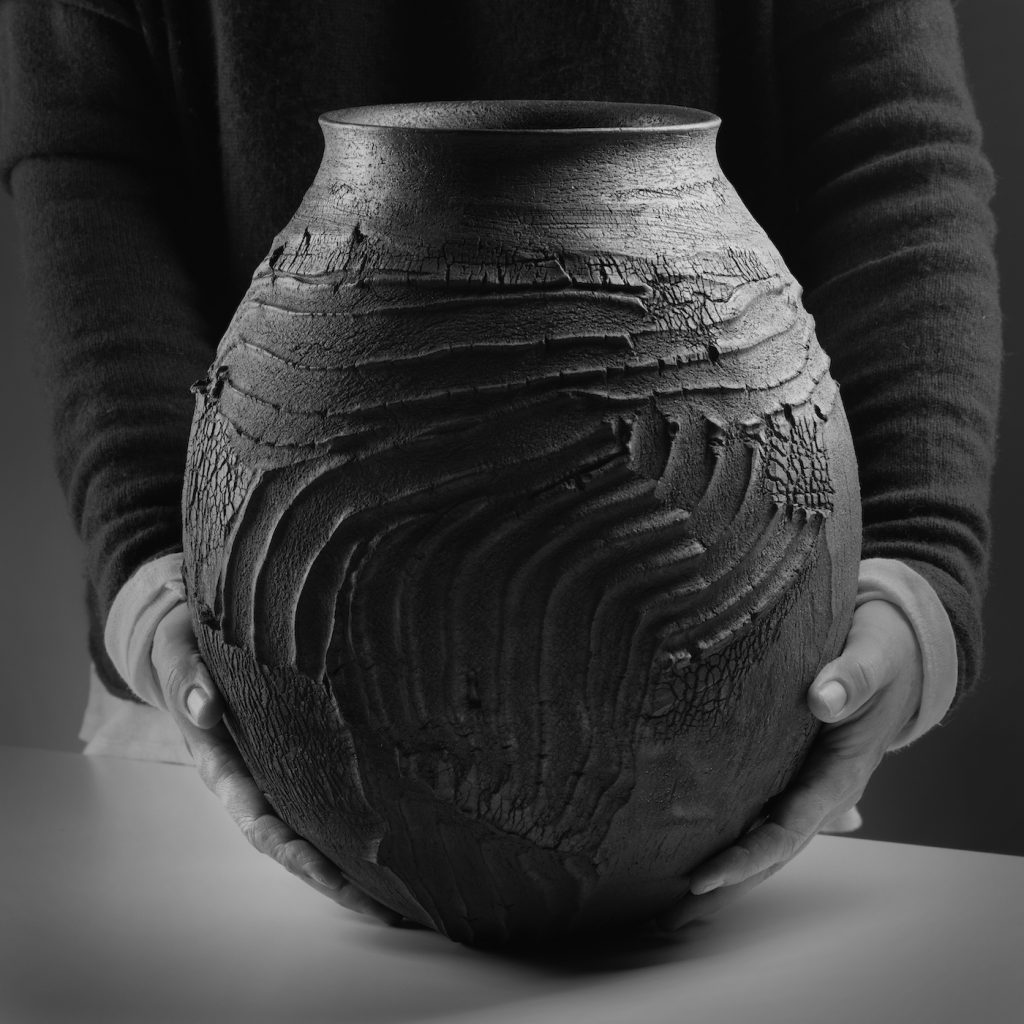
Erosion Jar, 32height x 34cm, image Shannon Tofts
I admire the skill of repetition throwers but I don’t have the patience for it myself. Occasionally I throw and alter some cups and bottles, just to keep me connected to the reality of function and closer to the craft of pottery than to sculpture.
What brought you to Raku?
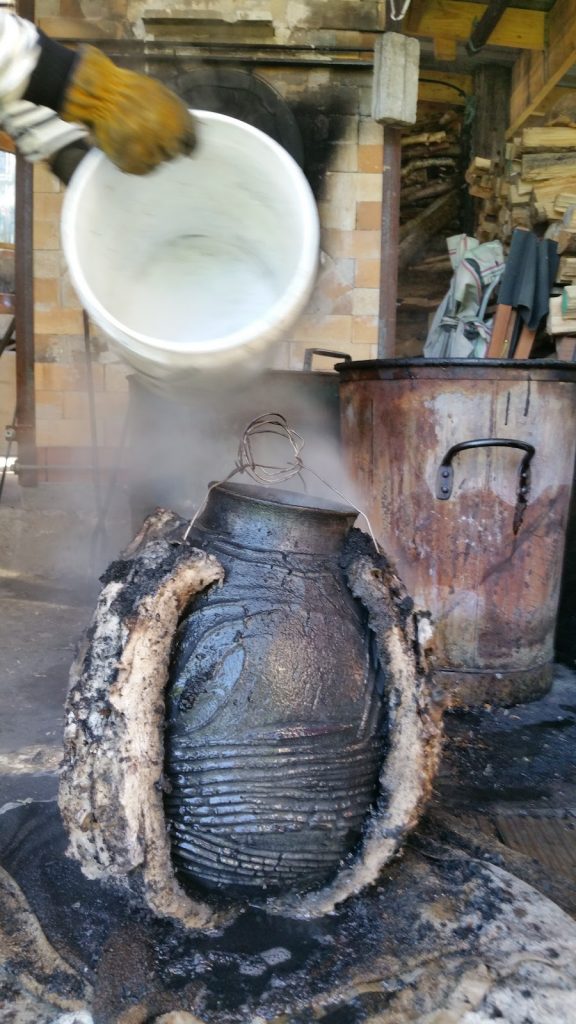
Big pot
I was at art school in London in the 1980s studying ceramics. There was very little kiln building or firing but we did get a long weekend of raku firing at a tutor’s studio out in the countryside. Nearly 20 years later when I returned to making ceramics it was the simplest and least intimidating way to start playing with it again, both financially and creatively. I rather fell in love with the soft, deep blacks and greys of the unglazed clay surfaces that develop with the post firing reduction of western raku technique.
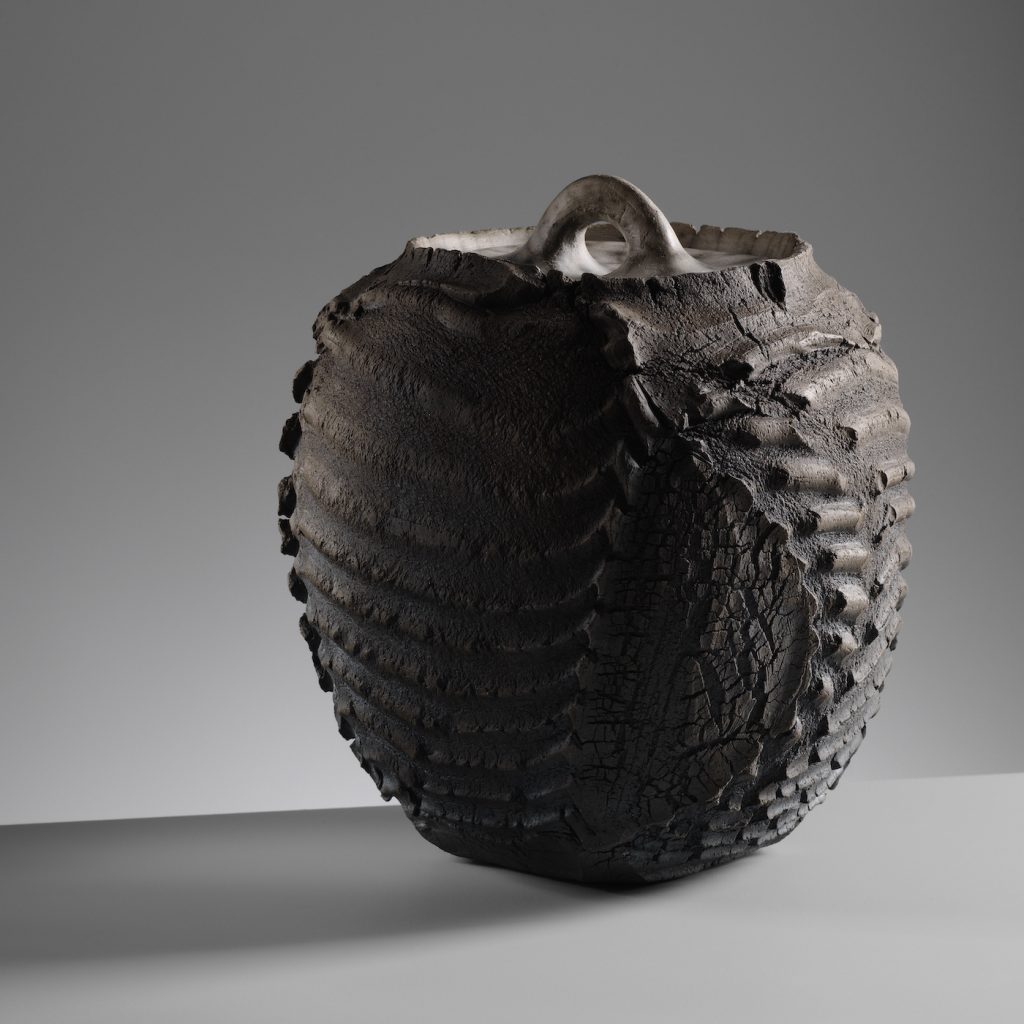
Lidded Erosion Jar, height 16cm, wood fired, image ShannonTofts, 2017
You say, “The landscape can be very dominating.” Discuss this in relations to your art.
This landscape in this climate is not an easy place to walk through, literally unless there’s a path and you’re well prepared. It’s such an obvious metaphor for life.
Walking along old tracks out on the hill I’m aware of the many other footsteps that made that path. Here am I adding my own whilst obliterating those of previous travellers, all helping to keep the path open. There’s a sense that nature is waiting to wrest control again, the moment we stop walking that path. It’s both reassuring and unnerving. It’s not a comfortable landscape, you can’t ignore it and imagine that humanity can exist here without hard work. There’s a humility required and a stubbornness. The soil is thin, the summers are short, the sea is cold, the midgies are relentless, the wind can knock you down, the air is exquisite and the light on the hills takes your breath away.
Discuss your work in relationship to caring for the environment.
I have left this one to last, dreading it really and the conclusions I know I will be faced with. This is the big issue. I’m writing this with COP 26 happening over the hills in my nearest city. The Highlands just had one of the driest summers on record (making it actually one of the loveliest). But there are few fish to catch in the sea and not so much bird song which used to wake me at 3 in the morning as the sun came up. Ceramic production requires high energy - wood, gas or electric. Raw materials come from all over the world. I drive my work to shows or send it with carriers. It all adds carbon dioxide to the atmosphere. The small efforts I can make, reducing, reusing and recycling, seem very small indeed. Potters are generally very frugal in their working practices, there’s not much to cut. The kilns have only ever been fired full. My use of wood as a fuel came about, apart from interest in the results, because our power supply here is too weak to fire to stoneware with electricity. Recently I wonder if this is the last generation of studio potters who will be able to fire in reduction, which requires a combustible fuel. No more copper reds and green celadons?
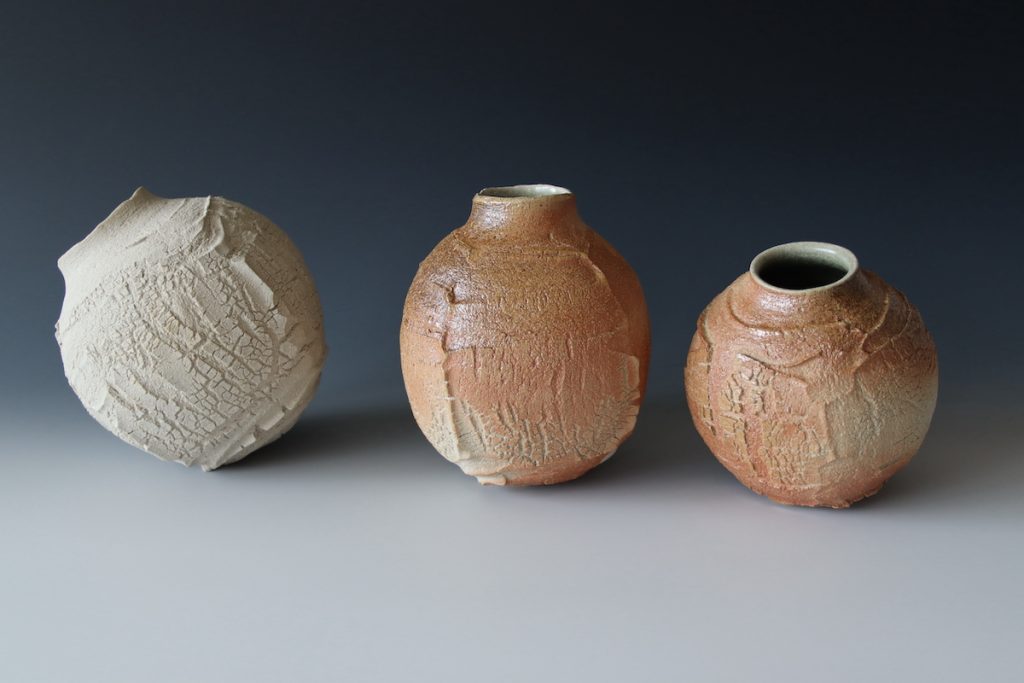
Three Globe Jars. WoodFiredStoneware.2020, artist image
On the domestic side we look after the croft land around us, dealing with invasive weeds, maintaining meadows and encouraging biodiversity, planting trees, growing fruit and veg organically. We shop local, eat local meat, have an air source heat pump and a wood burner for when the power goes off.
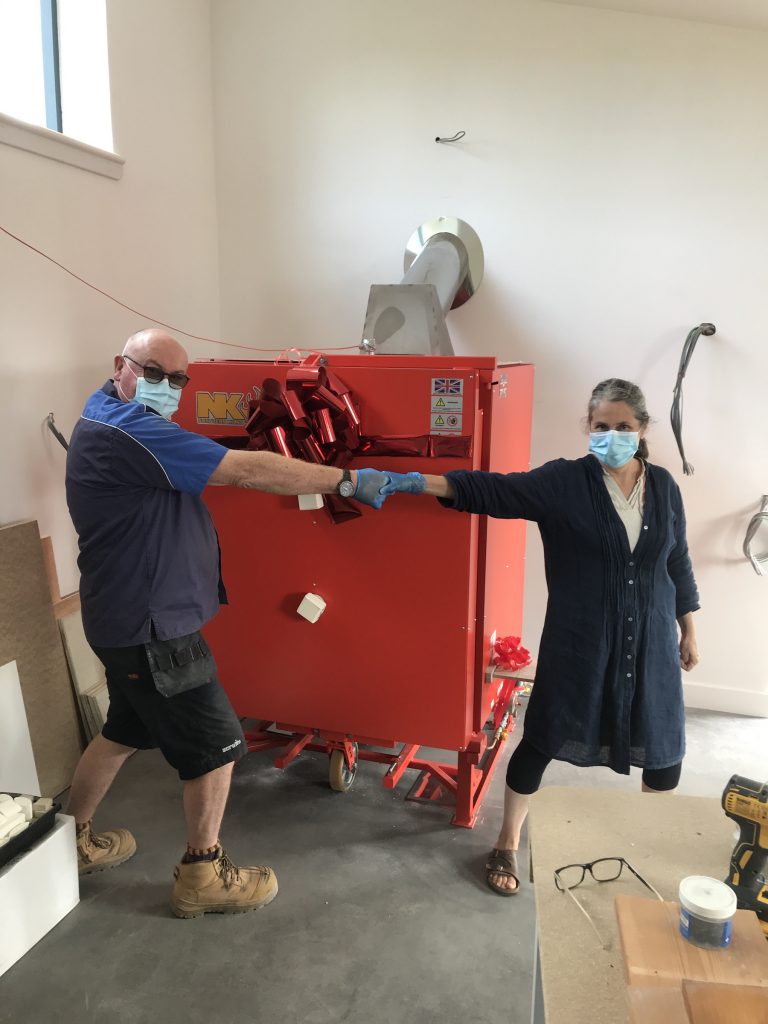
Installing Big Red Mary during covid
The biggest contribution I could make would be to stop making/firing my work. I don’t think it is something I can do. It feels more like penance, a self flagellation of the spirit, and would it add to the general sum of happiness? More questions than answers I’m afraid.
Comment on your involvement in Potfest - Scotland.
Potfest is just that - festivals of pottery, run by a potter family with potters and pottery collectors at it’s heart. They are joyful gatherings where we meet our friends, make new ones and get to see the whole spectrum of ceramic work. So much more than just sales. I see very few fellow potters in any year, let alone have the chance to handle and talk about our work. Many collectors come to the events as the standard of work is astonishing considering it all takes place in tents in Scotland! It gives the visitors a chance to meet, talk to and learn from the potters. It’s a very levelling event to take part in. During the pandemic many shows were cancelled but Potfest rescheduled theirs and managed to find those sweet spots between the lockdowns. The Scottish Potfest at Scone Palace in September 2020 was the first event of the summer in the area. Helped by glorious weather and being safely outdoors we had double the normal number of visitors, many for the first time. I think any event would have drawn the crowds, we were all desperate for something positive to happen. The joy of it helped many of us face the winter lockdown, both financially and emotionally.
How large can you construct a piece and what are your perimeters?
The largest pieces I have made so far with the stretching techniques are about 40cm in diameter, 50cm in height using about 12kg clay at the start of the process. I usually work from small pieces to large pieces over the course of a few weeks, rather like weight training. The weight of the clay can easily crush the textures and I have to be able to manoeuvre the mass of textured clay without that happening.
You have recently (2020) moved your studio after twenty years.
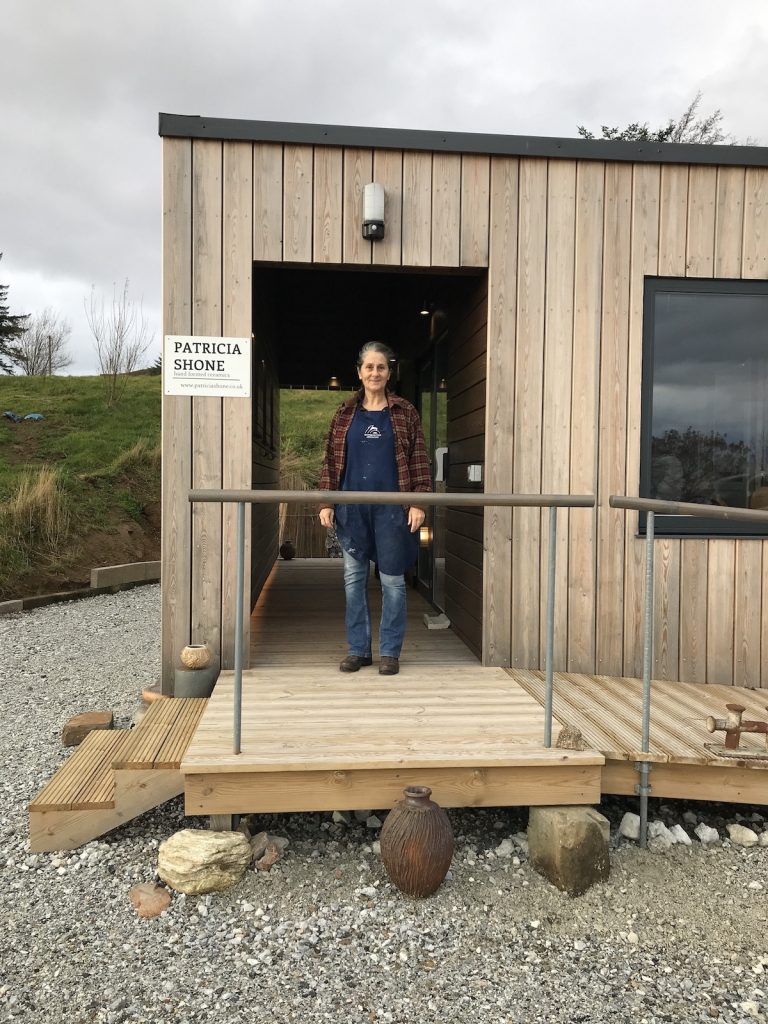
Fearna mor Studio Studio step
The old studio was converted from a small garage attached to the house. After 20 years it was full, leaving very little space for making more than a couple of pieces at a time, which was problematic as I use many different clays. Recently we were able to buy the croft surrounding our house and this gave us a potential site to build. I haven’t moved far, just down the hill. The advantages are many, it’s 4 times the size giving me separate areas for working the different clays.
I have a small gallery space now to display the work away from the dust and mess of the workshop. The short walk to the studio in the morning starts my working day away from the distractions of the house. No more displacement activity, as long, as I get through the garden without stopping.
The setting of the new studio makes the most of the view with it is ever changing light from reflections of the sea and sky.
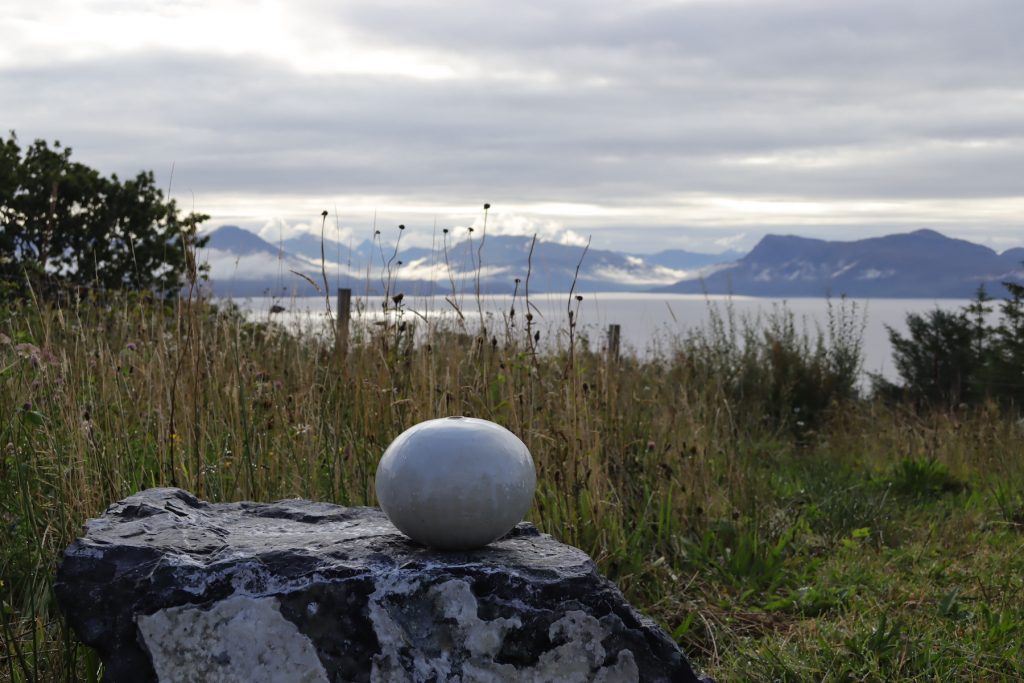
Studio view
The value to me is unquantifiable, in life and work. I am taken aback by how my work has developed, and the success it has achieved. It has required as much work on myself to accept the success as it has taken to develop the skills to make the work. Valuing my work to the point of building myself a studio is still uncomfortable and something I work on understanding.
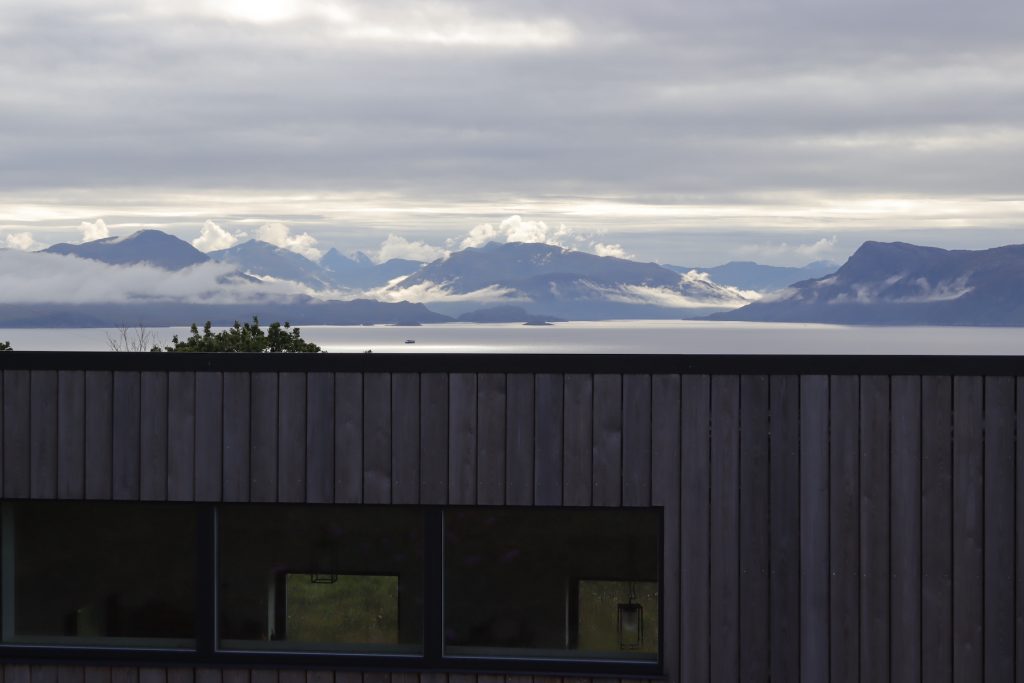
Studio view
How has Covid 19 affected you and your face-to-face interactions with you buyers and open studios?
It’s been fascinating as we’ve opened, up again from the lockdowns. I discovered that a little splinter of suspicion of strangers had developed, a little voice saying “who are they? what are they doing here? Have they brought the pestilence?” Of course, it evaporates as soon as we talk, and feel the relief of the kind human contact. We’re all feeling it. Visitors are so important to help resist that drift towards isolation. They help me see this land again with fresh eyes, returning me to the core of my work. I feel I owe it to share what I have here, something in it resonates with people.
I do like that little bit of extra control I have over when visitors come to the studio. I’m now open by appointment, and ask people to message or email, it just gives me time to prepare myself. Covid has allowed me to make that necessary rebalancing.
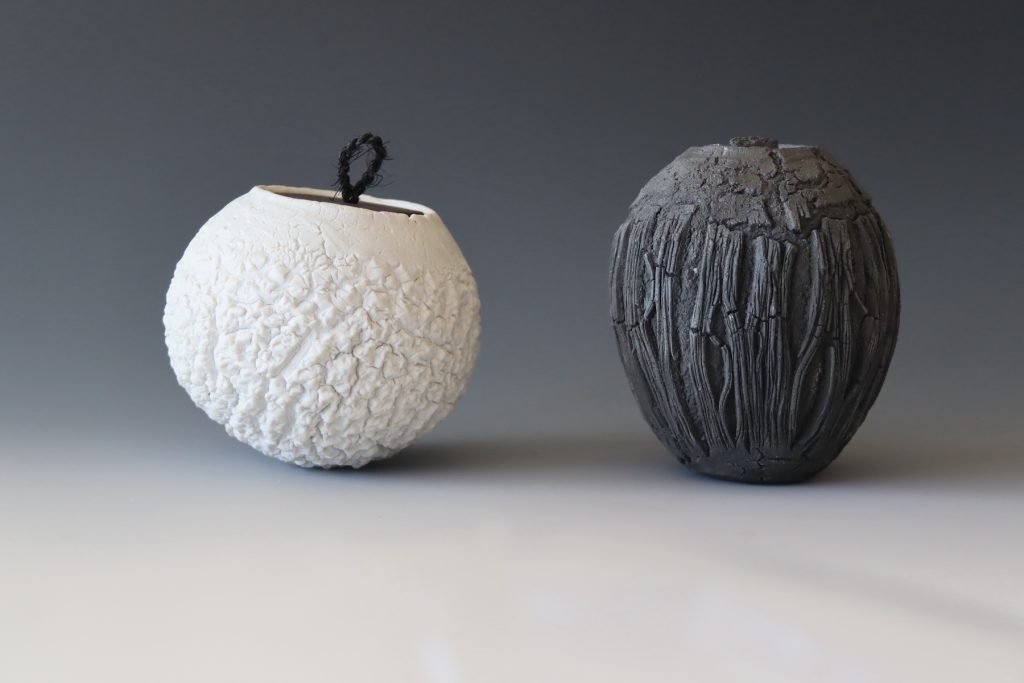
Lidded jars porcelain and saggar fired height 10cm
What do you think you will take from the Lockdowns and the pandemic as an artist?
Initially the shutdown of everything was a huge relief. After 10 years of busy and hard work combined with issues of ageing family at the other end of the country, I was happy to stop for 2 or 3 months. The quiet and stillness was exquisite. Just when I was ready to start again my body said no! Niggling aches and pains turned into full blown inflammatory conditions and I couldn’t do anything with my hands for months. So there’s no ‘Great Art Work’ to summarise this extraordinary time, I struggled even to hold a toothbrush. I did nothing, just lived through it like most of us. Fallow periods are always good for the creative soil, it allows the compost to rot down well.
Contact:
Patricia Shone
on Instagram @patriciashoneceramics
Deborah Blakeley, Melbourne, Australia
Interview by Deborah Blakeley, November 2021
Sahar Freemantle
Discuss race season and its value to millinery.
The racing carnival is big in Melbourne with the 'Melbourne Cup', the race that stops a Nation. Ascot without the Royals.
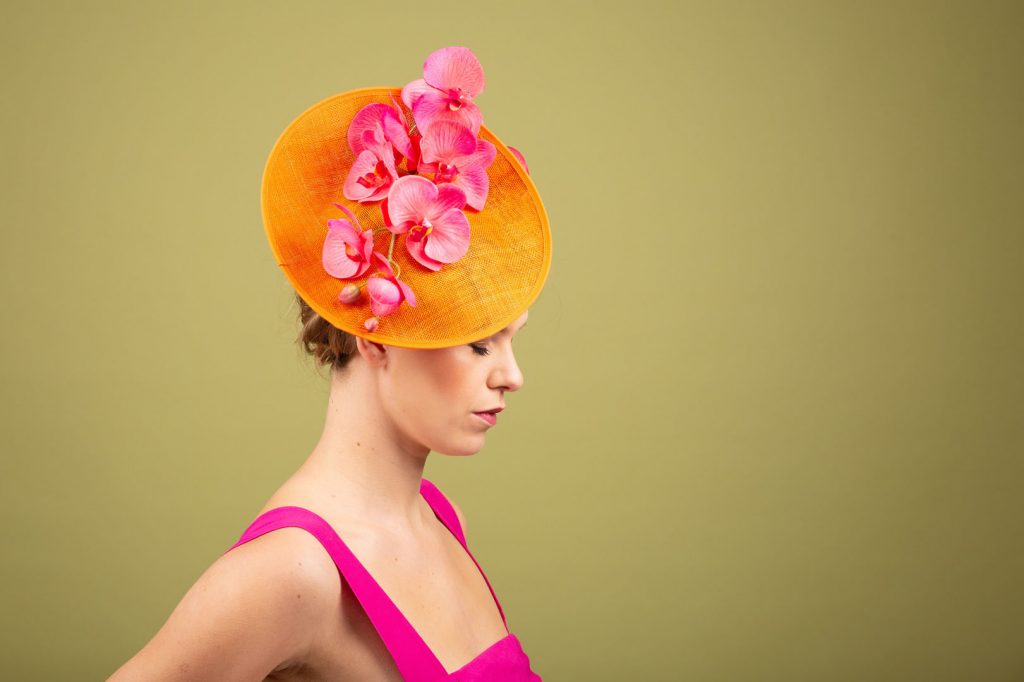
Sahar Millinery Fascinator
It’s a massive contribution and an opportunity to make and showcase the larger, creative hats that don’t get worn at weddings. For those few days it gets the public actively engaged and interested in the world of millinery.
Pokadot 50s Style Hatinator
Can you explain the transformation that happens within the catalyst of a hat?
The right hat flatters the wearer, often adds height, and finishes an outfit. What makes ‘the right hat’? – Well, it’s a combination of wearers colour, and a shape which suits their face, frame, and outfit It’s incredible to see someone put on the right hat and instantly transform – they stand taller and with more confidence.
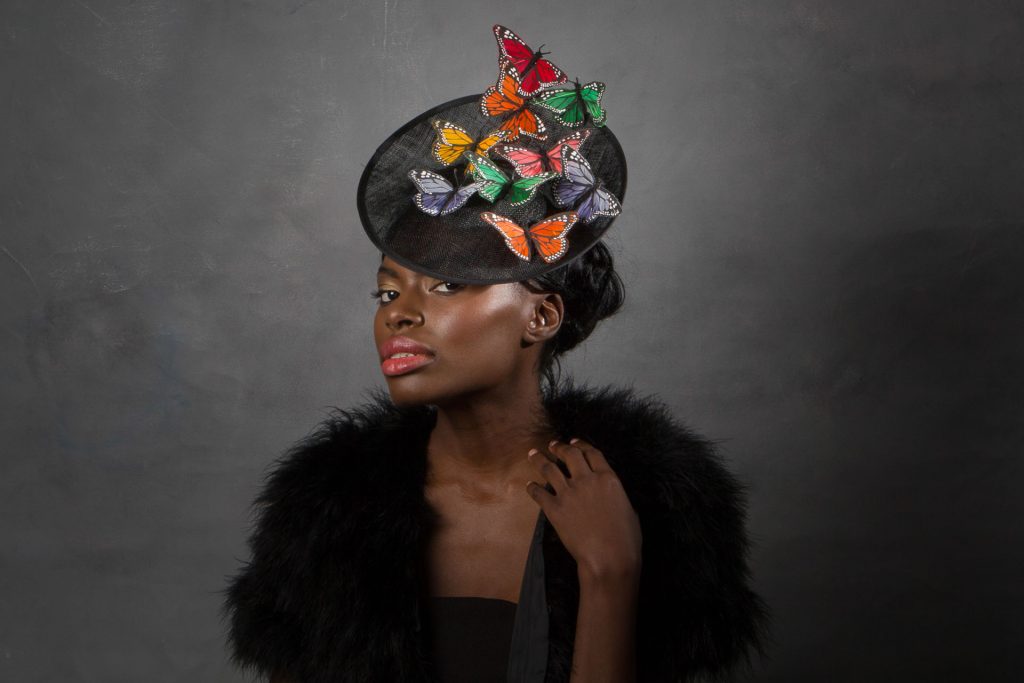
Black Butterfly Saucer
Take two hats that show this transformation and why?
This is different for everyone! The ‘right hat’ is personal and subjective – both from a physical sense of it suiting ones colouring and face, but also in terms of suiting ones personality.
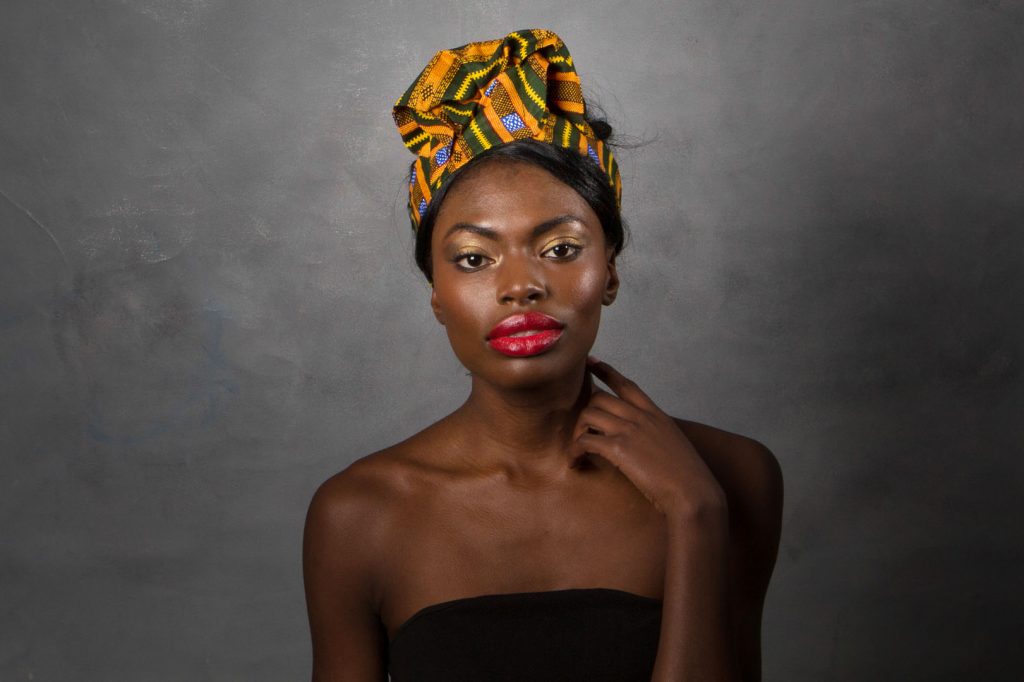
Large Knotted Beach Wear Faux Turban
– a hat which is just right for someone may but far too subdued and small for someone else and far too extravagant and showy for another.
Large Floral Headpiece For the Bride
When did you decide to specialize in millinery?
When I stared at the hats in the boot of a car once. Right after graduating – a couple of Scottish milliners were putting on a show and I was helping them – I saw the hats and a little voice went ‘this is it’
Baby-Bie Fedora Hat-with Pheasant Feathers
Expand on your comment, “When excellent craftmanship merges with playful curiosity, what emerges is a fresh embodiment of British eccentricity.
There is excellent craftsmanship, and there is playful experimentation. One cares about the outcome, finesse, and perfection. The other cares of creativity, having fun, making a mess and being curious about ‘what happens if…?’. If we only follow tradition then we keep creating the same things. If we only play then we never achieve excellence. Britain is known for it’s high standard of craft, and it’s also known for it’s innovation, celebrating eccentricity, and not liking to be told what to do.
Millinery is one example of a high-end craft that keeps inventing itself newly – whether that is fashions changing over the decades, or new materials being introduced.
Red Fedora Hat with Pheasant Feathers
Why do you think millinery has remained so popular in the UK?
The reinvention and moving with fashion is part of it, and every so often (just often enough) there will be a celebrity or TV show who champions hats and makes them cool again – whether that’s Grace Jones, Isabella Blow, Pharrell or Lady Gaga, or - makes them popular again, like Sarah Jessica Parker or the Duchess of Cambridge, or - makes them fun again, like Boy George, Slash, or Jamiroquai, (note, whether I’ve categorised these as ‘cool’ ‘popular’ or ‘fun’ is only my opinion – feel free to disagree!)
TV shows like Peaky Blinders, Downton Abbey and Sex in the City do the same thing.
You trained in Edinburgh College of Art in Performance Costume. Give us a tiny peek into your work for Downton Abbey.
Anna Robbins, who I studied with at Edinburgh – was always a stickler for perfect work and historical accuracy even as a student, so I knew when she got the job as costume designer for Downton Abbey, that every part of every costume would need to be historically accurate to the year, and everything done meticulously by hand. There are, however, some tweaks that need to be made for screen. They used my upturned brim shapes instead of the ‘bell’ type cloche, because you need to see the face, and most hats needed a groove at the back, to allow for wigs.
Powder Blue Lady Mary Cloche
Tell us about your hats with co-ordinating covid face masks.
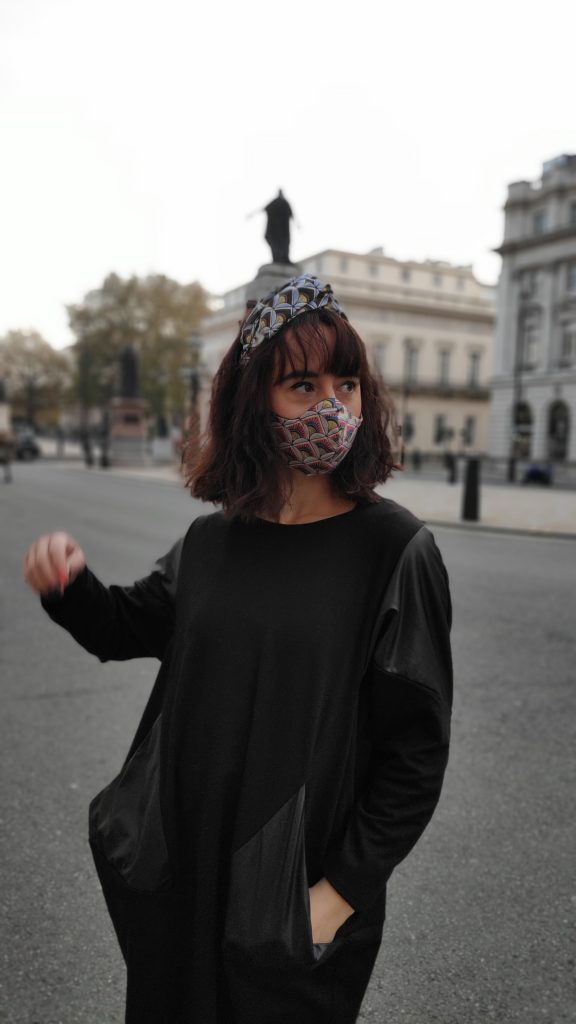
The main ways I’ve done this is by making matching headbands and masks, or creating the hatband on a trilby hat in the same fabric as the mask. Occasionally if there was a wedding it was a case of creating a mask in the same colours as the wedding hat.
Now that you are out of Lockdown in London. Have you restarted, The Milliners Drawing Room?
Not yet, because my studio management are still being very Covid cautious. Hopefully very soon though! I have been modelling in hats as a guest for other fashion illustration events though – mostly online.
What happens in the drawing room?
The models are dressed in fabulous, showy attire, each a different theme every month, and artists of all abilities attend, and draw!
How can people join in?
Anyone can join, but best to book in advance by emailing me, you can follow @millinersdrawingroom
Tell us one story that has delighted you from one of the sessions.
Honestly the best thing is when I see and hear everyone being super encouraging of each other – we get Vivienne Westwoods illustrator and beginners and everyone is delighting in each others work. I’m delighted to say that didn’t just happen in one session – it happens in all of them.
You also hire hats. What needs to be different with these hats, so that they fit many different heads?
Actually, most of my hats – which are the ones that get hired - fit most heads, because they’re held with elastic or alice band and are one size fits all. The main difference is to keep them one colour, so they go with more outfits, because if they’re too niche they will go with less. That’s why the most exciting hats are the ones made bespoke for the client because they are less generic.
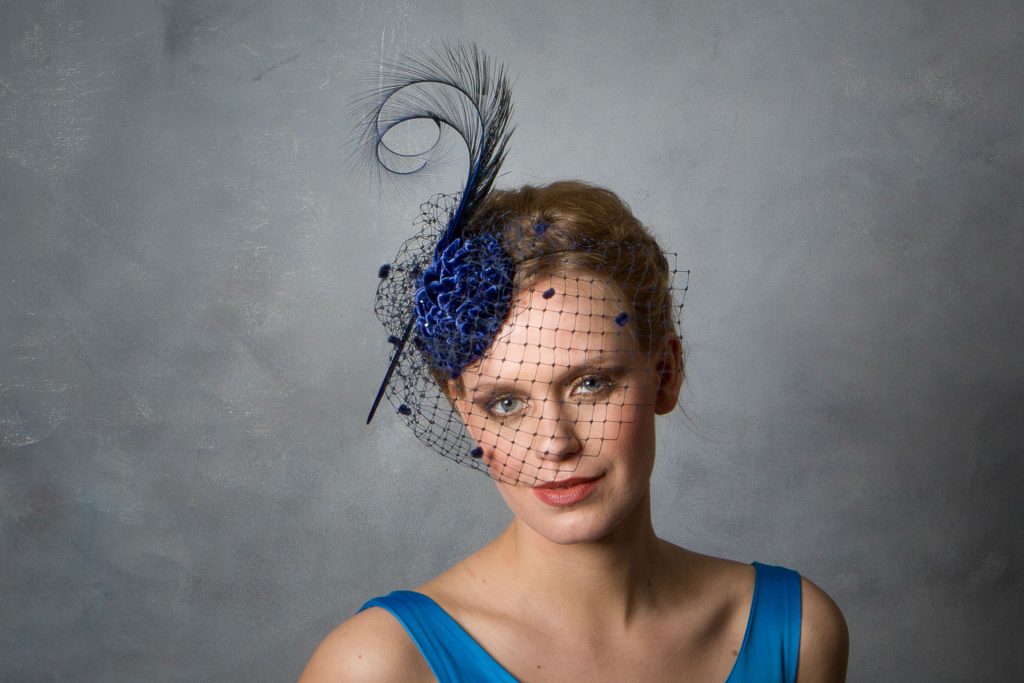
Navy Blue Fascinator
Royals are big hat wearers; do they keep the craft alive?
They do, and it’s nice to see with each new royal that comes along their own style and hat choice. It’s a shame that Meghan Markle stepped down, as I think she infused some freshness with her choice of millinery. It’s always great to see The Queens bold colour choices for Ascot!
You are a member of QEST. Discuss your membership

Yes, I was awarded a scholarship to train under Ian Bennet, so there is the training which is funded, plus there are many other events which have been on hold and are now opening up – it seems my first event will be at Buckingham Palace, which is exciting!
I’m yet to experience the full value but so far the QEST team have been very supportive indeed. It’s a very prestigious award and just to know they felt I was worth investing into was a huge success. I will soon start my training with Ian Bennet, and going to the events.
It’s really great that the Royal Family and the Royal Warrant holders place such value on high quality crafts in the UK, that they have formed this charity and actively support craftspeople. Any form of creativity is good for society, and craft is creativity with deliberate practice and precision. QEST helps British craft thrive.
I receive the QEST magazine, which showcases really inspiring QEST alumni. It’s great to see what they’re up to and see photos of their work as it’s always inspiring to see other makers making it. There are events such as the Christmas drinks at Buckingham Palace, in which I get to mingle with other alumni, and stands at various craft events, such as Material Masters, coming to Collect, Somerset House, February 2022.
What is you advise to others both men and women, why they should enjoy the treat of a visit to a milliner?

Navy Blue Beret with Veiling
Ooh!, it’s such a treat because you get to try on whichever hats you want, then start the creative process of finding your favourite bits of each hat, and having one made for any outfit. We have fun, I’m serious with my craft, but it’s definitely not a serious process!
Red Large Knotted Vintage Style Faux Turban
Can we finish with …
Portrait of A Milliner
Contact details:
Sahar Feemantle
07891041378
insta: @saharmillinery
Sahar Freemantle, London, UK
Interview by Deborah Blakeley, November 2021
Discuss race season and its value to millinery.
The racing carnival is big in Melbourne with the Melbourne Cup, the race that stops a nation. Ascot without the Royals.

Sahar-Millinery-Fascinator-Ladies-Hat17
It’s a massive contribution and an opportunity to make and showcase the larger, creative hats that don’t get worn at weddings. For those few days it gets the public actively engaged and interested in the world of millinery.
Polkadot 50s Style Hatinator
Can you explain the transformation that happens within the catalyst of a hat?
The right hat flatters the wearer, often adds height, and finishes an outfit. What makes ‘the right hat’? – Well, it’s a combination of wearers colour, and a shape which suits their face, frame, and outfit It’s incredible to see someone put on the right hat and instantly transform – they stand taller and with more confidence.

Black-Butterfly-Saucer-Fascinator-Hat
Take two hats that show this transformation and why?
This is different for everyone! The ‘right hat’ is personal and subjective – both from a physical sense of it suiting ones colouring and face, but also in terms of suiting ones personality.

– a hat which is just right for someone may but far too subdued and small for someone else and far too extravagant and showy for another.
When did you decide to specialize in millinery?
When I stared at the hats in the boot of a car once. Right after graduating – a couple of Scottish milliners were putting on a show and I was helping them – I saw the hats and a little voice went ‘this is it’
Expand on your comment, “When excellent craftmanship merges with playful curiosity, what emerges is a fresh embodiment of British eccentricity.
There is excellent craftsmanship, and there is playful experimentation. One cares about the outcome, finesse, and perfection. The other cares of creativity, having fun, making a mess and being curious about ‘what happens if…?’. If we only follow tradition then we keep creating the same things. If we only play then we never achieve excellence. Britain is known for it’s high standard of craft, and it’s also known for it’s innovation, celebrating eccentricity, and not liking to be told what to do.
Millinery is one example of a high-end craft that keeps inventing itself newly – whether that is fashions changing over the decades, or new materials being introduced.
Why do you think millinery has remained so popular in the UK?
The reinvention and moving with fashion is part of it, and every so often (just often enough) there will be a celebrity or TV show who champions hats and makes them cool again – whether that’s Grace Jones, Isabella Blow, Pharrell or Lady Gaga, or - makes them popular again, like Sarah Jessica Parker or the Duchess of Cambridge, or - makes them fun again, like Boy George, Slash, or Jamiroquai, (note, whether I’ve categorised these as ‘cool’ ‘popular’ or ‘fun’ is only my opinion – feel free to disagree!)
TV shows like Peaky Blinders, Downton Abbey and Sex in the City do the same thing.
You trained in Edinburgh College of Art in Performance Costume. Give us a tiny peek into your work for Downton Abbey.
Anna Robbins, who I studied with at Edinburgh – was always a stickler for perfect work and historical accuracy even as a student, so I knew when she got the job as costume designer for Downton Abbey, that every part of every costume would need to be historically accurate to the year, and everything done meticulously by hand. There are, however, some tweaks that need to be made for screen. They used my upturned brim shapes instead of the ‘bell’ type cloche, because you need to see the face, and most hats needed a groove at the back, to allow for wigs.
Tell us about your hats with co-ordinating covid face masks.
The main ways I’ve done this is by making matching headbands and masks, or creating the hatband on a trilby hat in the same fabric as the mask. Occasionally if there was a wedding it was a case of creating a mask in the same colours as the wedding hat.
Now that you are out of Lockdown in London. Have you restarted, The Milliners Drawing Room?
Not yet, because my studio management are still being very Covid cautious. Hopefully very soon though! I have been modelling in hats as a guest for other fashion illustration events though – mostly online.
What happens in the drawing room?
The models are dressed in fabulous, showy attire, each a different theme every month, and artists of all abilities attend, and draw!
How can people join in?
Anyone can join, but best to book in advance by emailing me, you can follow @millinersdrawingroom
Tell us one story that has delighted you from one of the sessions.
Honestly the best thing is when I see and hear everyone being super encouraging of each other – we get Vivienne Westwoods illustrator and beginners and everyone is delighting in each others work. I’m delighted to say that didn’t just happen in one session – it happens in all of them.
You also hire hats. What needs to be different with these hats, so that they fit many different heads?
Actually, most of my hats – which are the ones that get hired - fit most heads, because they’re held with elastic or alice band and are one size fits all. The main difference is to keep them one colour, so they go with more outfits, because if they’re too niche they will go with less. That’s why the most exciting hats are the ones made bespoke for the client because they are less generic.

Royals are big hat wearers; do they keep the craft alive?
They do, and it’s nice to see with each new royal that comes along their own style and hat choice. It’s a shame that Meghan Markle stepped down, as I think she infused some freshness with her choice of millinery. It’s always great to see The Queens bold colour choices for Ascot!
You are a member of QEST. Discuss your membership

Yes, I was awarded a scholarship to train under Ian Bennet, so there is the training which is funded, plus there are many other events which have been on hold and are now opening up – it seems my first event will be at Buckingham Palace, which is exciting!
I’m yet to experience the full value but so far the QEST team have been very supportive indeed. It’s a very prestigious award and just to know they felt I was worth investing into was a huge success. I will soon start my training with Ian Bennet, and going to the events.
It’s really great that the Royal Family and the Royal Warrant holders place such value on high quality crafts in the UK, that they have formed this charity and actively support craftspeople. Any form of creativity is good for society, and craft is creativity with deliberate practice and precision. QEST helps British craft thrive.
I receive the QEST magazine, which showcases really inspiring QEST alumni. It’s great to see what they’re up to and see photos of their work as it’s always inspiring to see other makers making it. There are events such as the Christmas drinks at Buckingham Palace, in which I get to mingle with other alumni, and stands at various craft events, such as Material Masters, coming to Collect, Somerset House, February 2022.
What is you advise to others both men and women, why they should enjoy the treat of a visit to a milliner?

Ooh!, it’s such a treat because you get to try on whichever hats you want, then start the creative process of finding your favourite bits of each hat, and having one made for any outfit. We have fun, I’m serious with my craft, but it’s definitely not a serious process!
Can we finish with …
Portrait of A Milliner
Contact details:
Sahra Feemantle
07891041378
insta: @saharmillinery
Sahra Freemantle, London, UK
Interview by Deborah Blakeley, November 2021
Fiona Hiscock
Are all the native Australian birds on flora that is specific to the bird’s habitat?
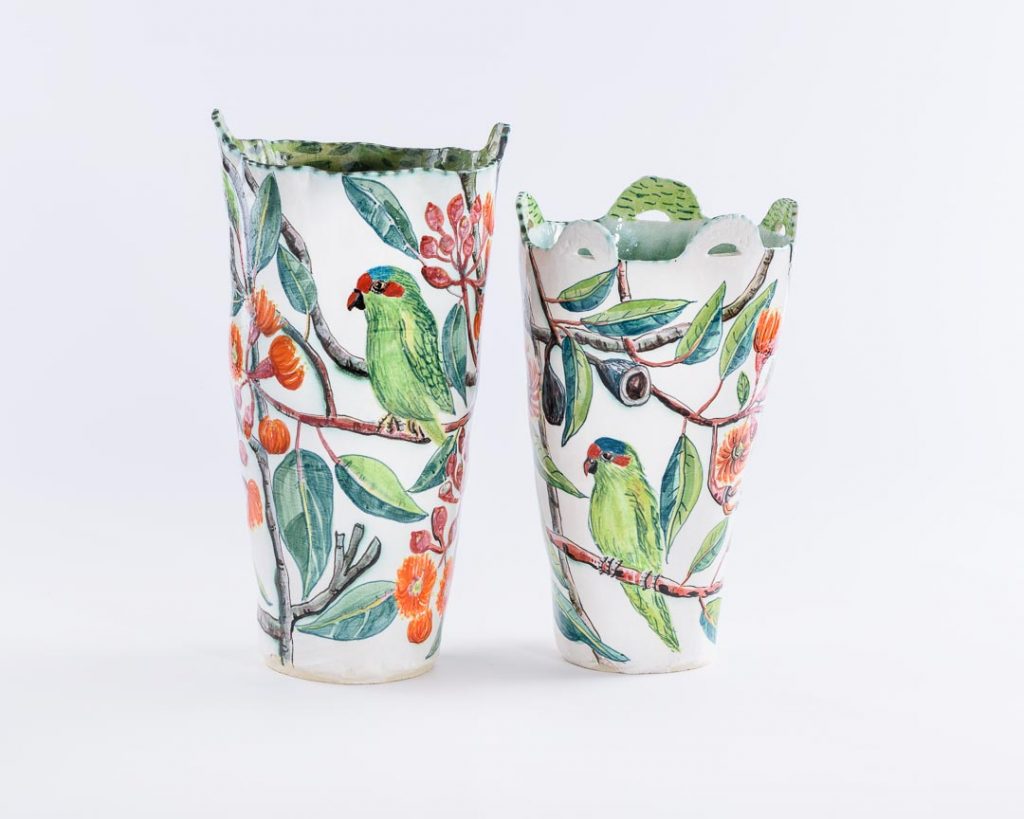
Yes, I am really particular about composing the painting so that the birds are situated within their specific habitat. I do a lot walking in parks and wilderness areas, and make close observations of the bird life in the surrounding bush. It’s important to me that the habitat is presented in a botanically correct manner, along with the bird and/or insect life I’ve observed in real life.
How do you originally capture these tiny birds?
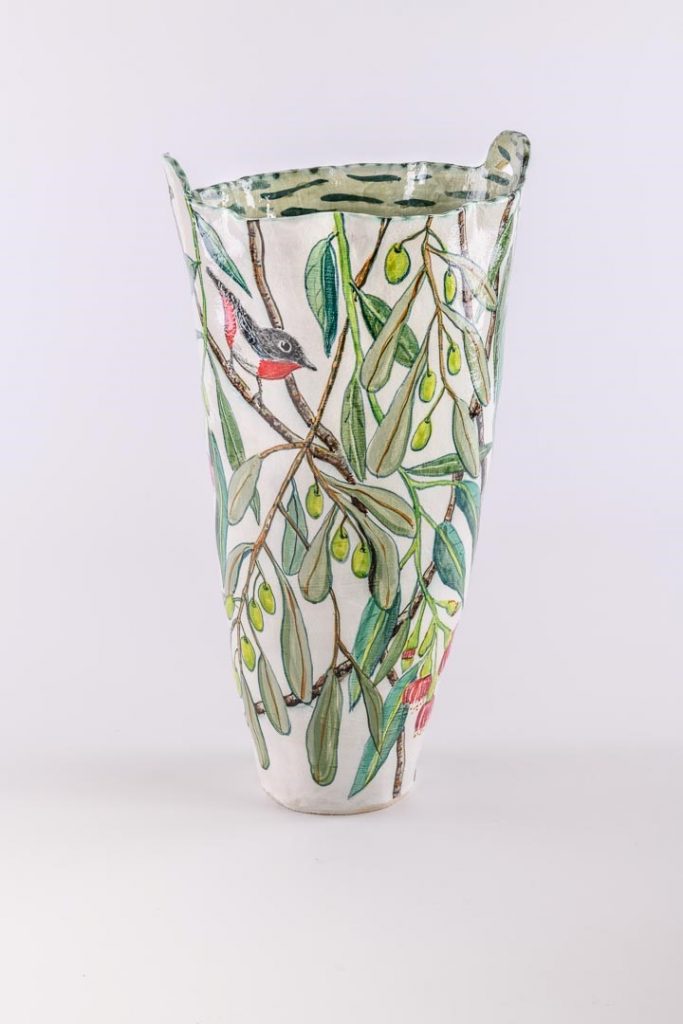
I make watercolours on paper of the plants and birds that I’m interested in capturing so that I can work out how to paint them on clay. I take a lot of photos of plants and refer to these as well as my sketch book when painting the vessels. I also look at resources such as e-bird which lists species in particular habitats and provides really great photos for identification purposes. I also have a good pair of binoculars and a good reference library of bird identification books.
Discuss the shape of many of your jugs and bowls and their early colonial history?
As a kid my parents loved visiting antique shops, and in addition, I grew up in rural Australia. We had old sheds filled with tin and aluminium objects and I was always drawn to the large, utilitarian basins and bowls designed for faithful service to people or their livestock rather than fine China. I loved those old washing tubs, oversized water jugs, mixing bowls and buckets and feel they are reference to my history as a white non-indigenous Australian. They also loosely reference women’s labour and were an easier entry point for me as a female artist.
Can you explain the artistic process of your work?
I didn’t immediately go to art school at the end of year 12. Instead, I studied Fine Arts at Melbourne Uni and did a double major in art history. By the time I commenced studying ceramics at the end of my initial BA, I was completely versed in just about every art movement from the Renaissance to Modernism. When you know this much about art history, it can be very difficult to know how to locate your own practice. Starting with ceramics was actually an easy choice for me. It’s what I had really wanted to do when I finished school and it felt less overwhelming. I was very much drawn to making useful, somewhat humble utilitarian objects.
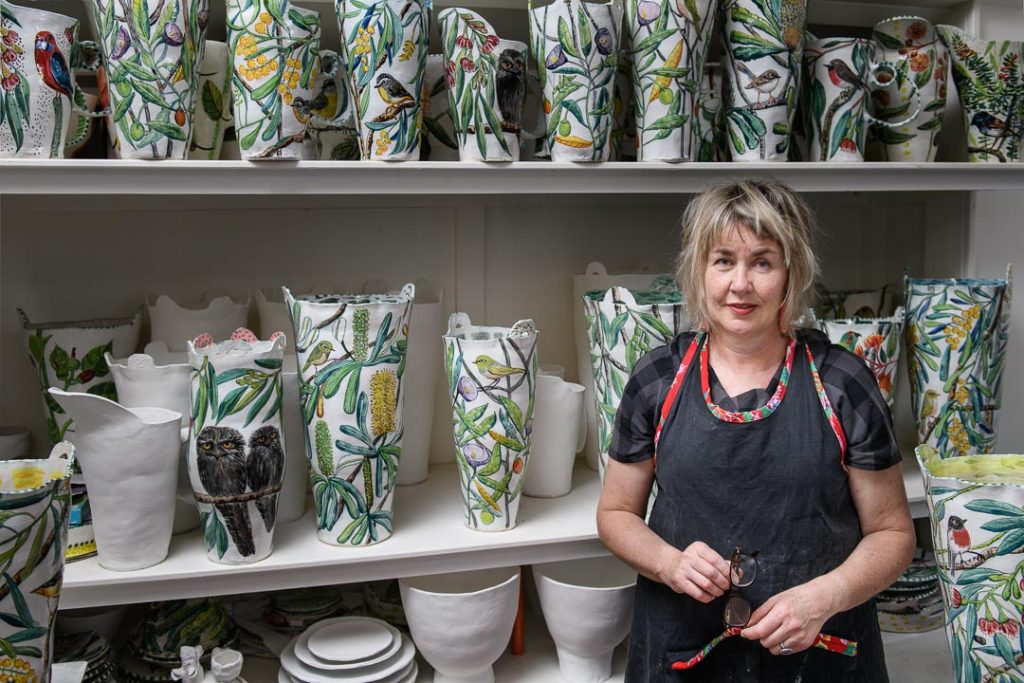
The key though, given my art history studies, was an interest in narrative, and I always wanted my ceramic objects to act as a canvas, or a device for story-telling and painting. This meant flipping ideas of scale, and giving the object a presence or stature that meant it could not be ignored, or put away in a cupboard. I was also aware that most of the art history I studied described paintings made largely by men. Ceramics, however, speaks of the feminine. We tend to associate vessels, domestic objects and crockery with the home, and by implication, with women. This felt like a better fit for me, and an entry point to a broader perspective.
Earlier you also worked in watercolour – discuss
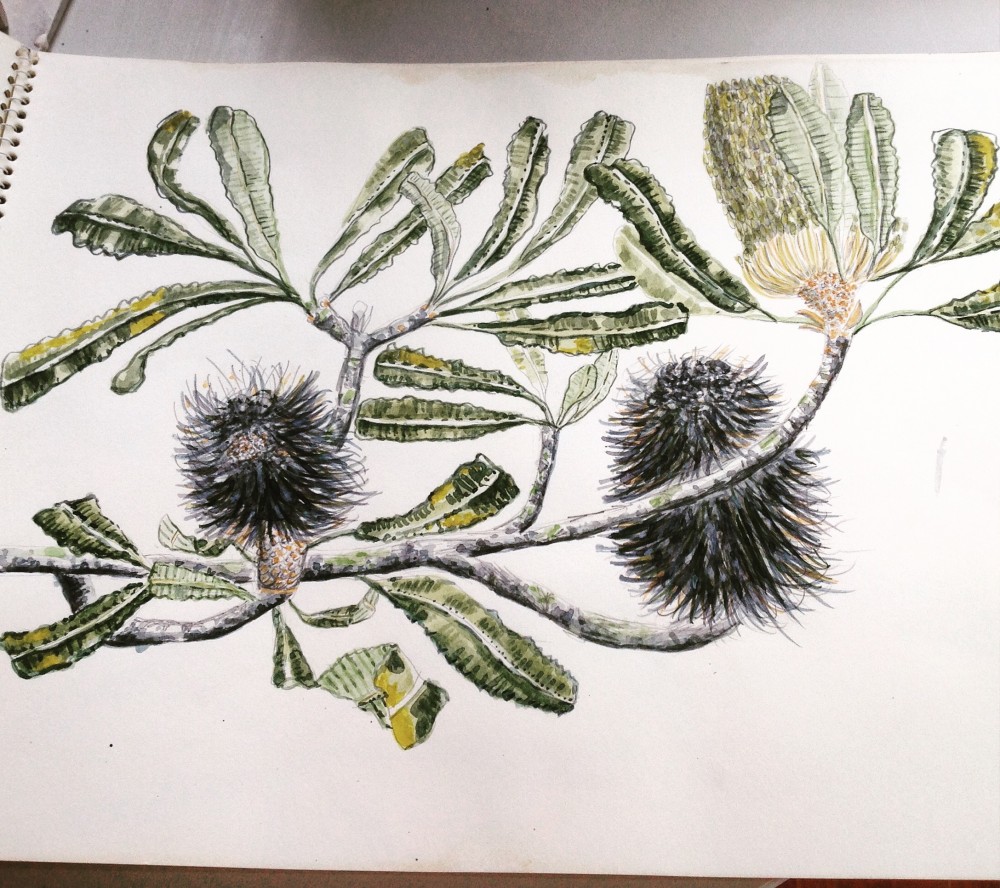
I have always made watercolour painting of plants that I’m interested in depicting as studies to support my ceramic practice. I don’t see myself as a natural painter and need to practice until I feel comfortable enough to commit brushstrokes to clay. Ceramic paints behave differently however – they tend to bleed and burn out at different temperatures, so there’s always an element of chance and unpredictability. I am never sure how the works will emerge from the glazing process, which to be honest, can be totally frustrating at times, and also surprising. I spend all our family holidays painting water colours, this is a really important part of my research and preparation, but they are like my reference library, and not intended to be exhibited.
Comment on the importance of your work and the impact the environment is facing.
My work has been about plants and the animals who cohabit with particular species, for the last 20 years. Growing up in rural Victoria, in an old goldfields house, I was first interested in painting the plants early settlers or colonists brought with them to Australia, plants deemed at that time, necessary for survival in what was considered a harsh environment. I quickly became more interested in the weeds that accompanied those species, particularly noting in times of drought that the weeds were thriving and changing the Australian environment as they spread. As a white person, I didn’t feel that I had permission or authority to paint native species as I was too aware of my colonial past. A trip, however, to a well-established Banksia woodland along the East Victorian jolted me awake, and I started to get heart palpitations encountering Banksia Serrata for the very first time. The irony of this personal discovery wasn’t lost on me – it was after-all, the first Banksia ‘discovered’ and identified by Joseph Banks, the London Botanist who was part of the Endeavour in 1788.
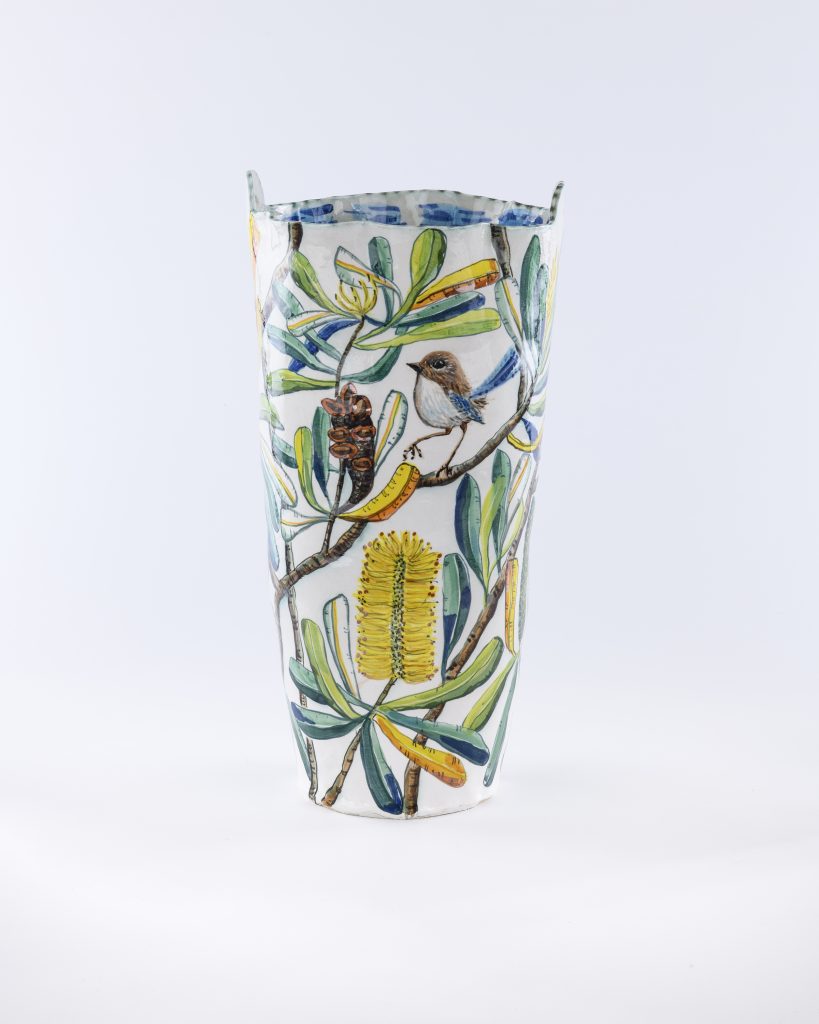
At this time, I was about to turn 50 and I knew I had to obtain permission from the traditional owners of the land before I could start painting their plants. I travelled and stayed with a very remote Yolnu community in the Northern Territory as asked the women there for permission to get out my paints. They gave me five different names for their banksia, which looked a lot like Banksia Serrata but was slightly different in habit and leaf spread. The community picked armfuls of plants for me to paint during my time with them and I return from that trip unable to depict anything other than Australian species. So, I spend as much time as I can in the natural world. I walk, camp and observe particular trees of interest to me, and the birds and insects that live within the confines of a particular species. If feel it is extremely important for me as an artist to paint the Australian environment and highlight its beauty and value at a time when it seems increasingly under threat from land clearing, drought and fire. I’ve also seen at firsthand how traditional Aboriginal cultural burning practices are much gentler and effective as an on-going management technique, and able to bring a better balance to a healthy ecosystem.
Where do you go for your inspiration?
Basically, the natural world.
The importance of residencies to your work
As an artist I believe it’s really important to take yourself away from your usual environment from time to time and observe new areas. It’s something I’ve missed greatly during the pandemic, and I’ve had number of trips cancelled due to Covid-19.
Early in your artistic work you had two residencies at Hill End in Victoria, Australia. During this time your work reflected Australia colonial pasts discuss.
Hill End:
I completed two artists in residencies in Hill End because at that time, I was interested in early colonial species, and I knew that Hill End had existing gardens of plants and trees dating back to early settler contact. I painted the trees that were commonly found in everyone’s gardens – figs, pears, almonds and other fruit trees.
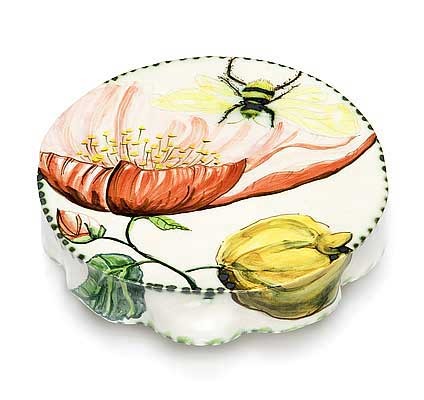
I was there in two different seasons as I wanted to see how the trees reacted at different times of year and made a couple of series of work in response to that environment, all depicting introduced species. After this, I became much more interested in the weeds that arrived along with the intentionally planted species particularly as I was beginning to notice the effects of prolonged drought. Weeds such as rosehips (below cassoulet) and blackberries thrived when everything else was struggling to survive. This seemed like a good illustration of how colonisation had unanticipated, unacknowledged and often harmful effects on the natural landscape.
Now your work still has reflections of our colonial past but mainly in some the shapes of your vessels. Your work acknowledges modern Australia and your appreciation and knowledge of the need to look into our First Nations Peoples history and the land in a new open and honest way. Discuss also how exposure remote Aboriginal Arts communities has altered you art.
After working through the weed series, I started spending regular family holidays in National Park areas on Victoria’s east coast. Encountering the old growth banksia woodlands for the first time was immensely affecting and I knew I had to start painting and depicting Australia’s unique flora and fauna. I felt it was important to seek permission prior to doing this however, from our First Nation People and spent time with a remote community near Elcho Island in the NT, learning traditional weaving techniques but also painting local plants while there. The ladies provided me with traditional names for plants, often in 4 or 5 different dialects and would pick bunches of new plants for me to paint each time we went collecting materials for weaving. I’ve maintained connection with this community alongside a group of Melbourne based supporters and we have hosted the weavers on trips to Melbourne, and organised exhibitions of their remarkable work.
In addition, I have regular contact with a remote ceramics community near Alice Springs, the Hermannsburg Potters and have worked with them to explore our shared interest in depicting the unique Country we are all proud to live on and care for.
Current Residencies:
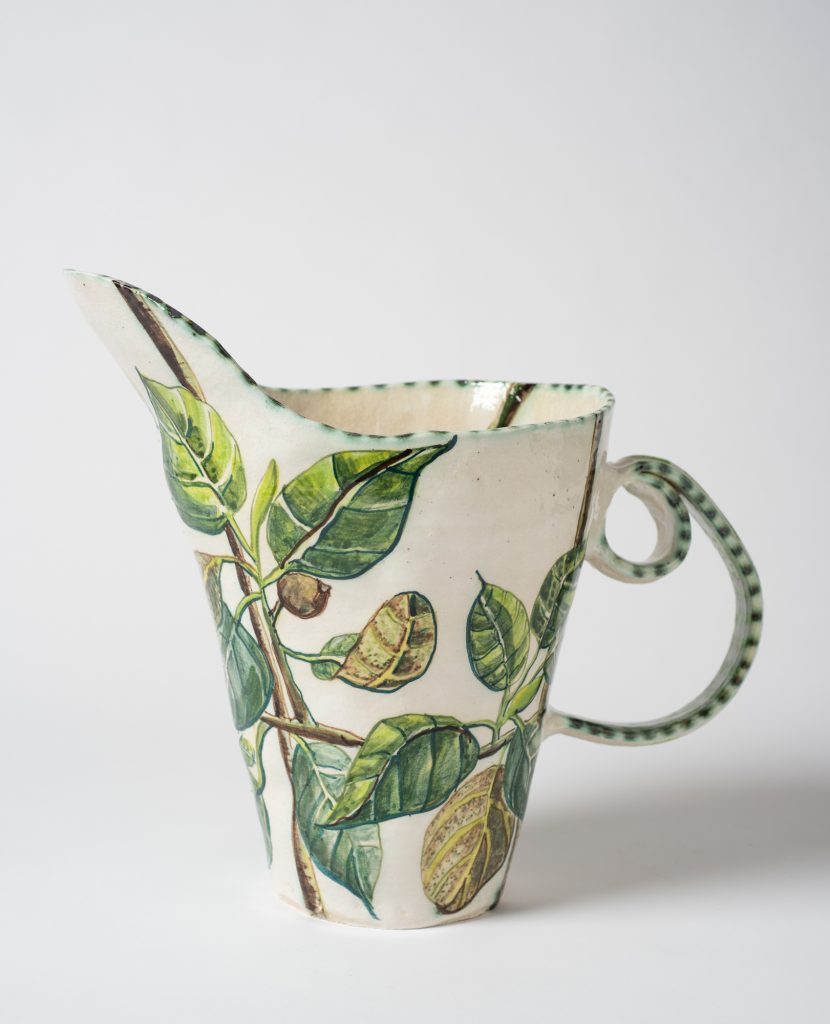
More recently, I’ve completed a residency in Bundanon, Arthur Boyd’s property on the Shoalhaven River to specifically paint and observe the local environment.
This area has an abundant plant and bird life and has been the site for traditional cultural burning practices, overseen by Uncle Victor Steffensen (Firesticks Alliance) to preserve, protect and nourish the natural landscape which is still recovering from years of grazing and a lack of Indigenous care.
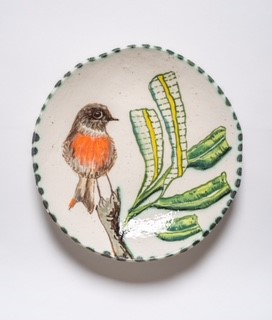
Interestingly, in the 2020 bushfires, Bundanon was preserved as fire free and acted as a haven for animals to seek refuge thank to the cultural burning practices undertaken by Uncle Victor over the last few years, while the area around it was ablaze. I was interested in the biodiversity the area has to offer and was lucky enough to witness Uncle Victor practicing a Cultural Burn along with some, local young indigenous lads from nearby Nowra.
Discuss the Texture on the tops of your work.
I like to think of the tops of my work as a kind of framing device that contains the painting, which is why they will always have a decorative and repetitive pattern. There’s also a nod to the process of ceramics here and the tactile nature of clay, so I like the tops to be slightly freeform and organic.
Do you name each piece or is the botanical information included?
Each piece is usually named by referencing either location or the plans depicted.
Your work is currently in an exhibition, ‘I Am Here’ comment on this exhibition and other similar all women exhibitions and their importance on the public and young women artists.
This work was curated by Katherine in response to the Know My Name exhibition in Canberra at the National Gallery of Australia. Katherine selected 40 female artists she knew who are working today, across a number of mediums. This work was very personal for Katherine Hattam as she had made a number of paintings that included lists of the painters her female artist friends nominated as influential. The same names kept repeating and Katherine then started painting lists of female Australian artists into her canvases. I was extremely honoured to take part and agree with Katherine’s observations that female artists have been a tad underrepresented in major institutions. I welcome the efforts these institutions are making to redress this balance.
Contact:
Fiona Hiscock
@fionahiscock
Deborah Blakeley, Melbourne, Australia
Interview by Deborah Blakeley, October 2021
Richard McVetis
Do you feel that coming to embroidery without any preconceived knowledge has been a great asset to your work?
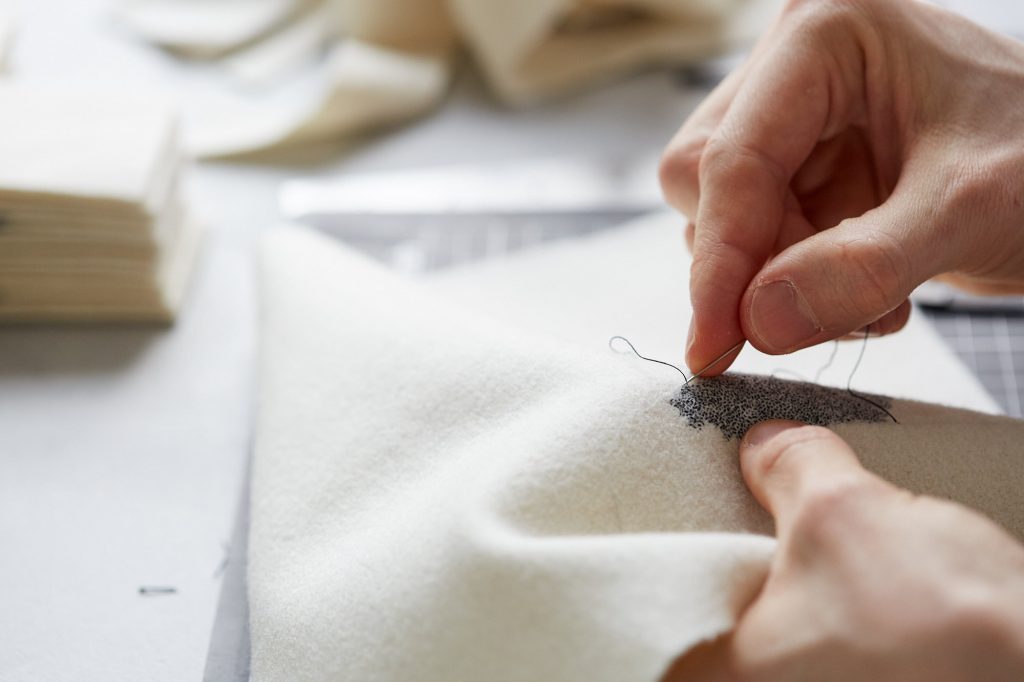
I had a very basic view of textiles and embroidery before art school. My auntie would visit on Monday evening and knit our Christmas jumpers, and I had a little bit of experience with cross-stitch from school. My introduction to embroidery was a happy accident and, in fact, happened on a visit to the open day of the Embroidery degree at Manchester Metropolitan University (which sadly no longer exists as its original entity). The course opened my mind to the broad sense of the word ‘embroidery’. What attracted me to this place was the chance to learn one of the world’s oldest crafts whilst exploiting the contemporary possibilities of this medium at the same time; without a doubt, this period of my life is one that I regard with great fondness. The diversity and exploration of the medium are liberating. Under excellent tutelage, we were encouraged to use anything and everything as materials in our work. As a result, there was always a sense of everything being well made and always well thought out, whether design or fine art.
Can you discuss why embroidery is not grouped with ‘art’ rather ‘craft’ so often.
For me, the intersection of art and craft was the most exciting and provided constant inspiration. I like embroideries somewhat conflicting status of being fine art and craft, depending on where and how it is presented. Ultimately though, its association with the domestic or women’s work has held back embroidery and textile art, and this is due to the patriarchy and the art world hierarchy. This perception has somewhat shifted over the last fifteen years, for example, recent exhibitions of artists such a Jessica Rankin at White Cube, Sophie Taeuber-Arp at Tate Modern. The difference, of course, is the route in which these artists take. Artists studying fine art and working with textiles are more excepted within the fine art world than artists who study textiles.
Discuss your work in relationship to repetition – “A moment in time.”
My practice is deeply rooted in process and hand embroidery., multiples of dots, lines, and crosses, all meticulously stitched, record time and map space. My work is about labour, refinement and investing time in very ordinary materials. I explore subtle differences that emerge through the insistent, repeated, ritualistic, and habitual making and giving material form to abstract ideas, making the intangible tangible. Time is a theme that I have explored extensively within my practice.
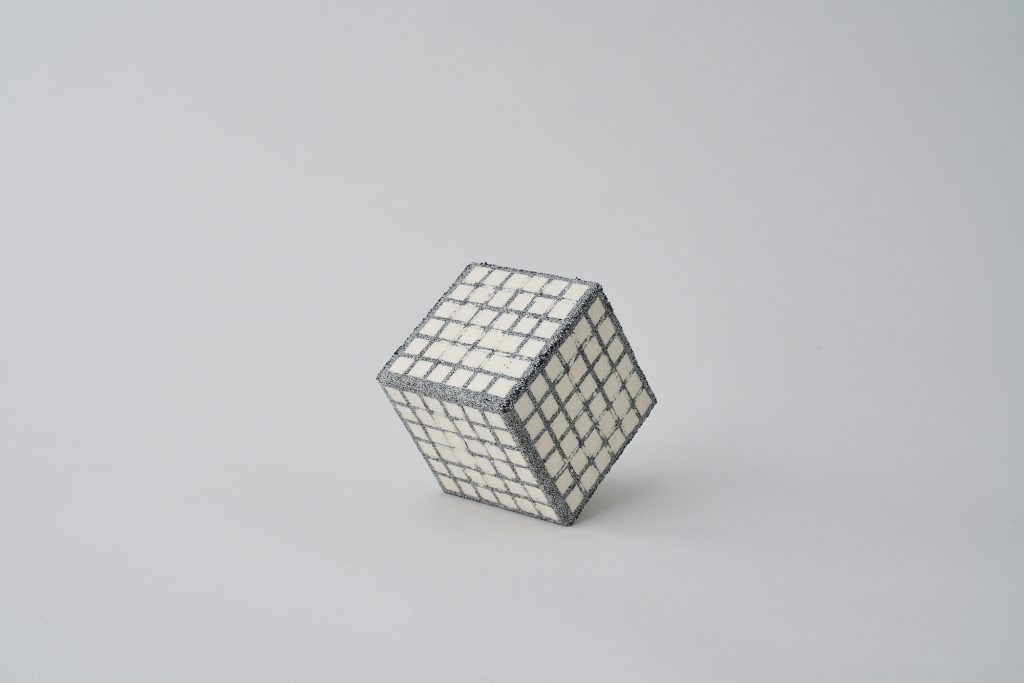
Grid, 2019, 10 x10x10cm, Wool and Cotton, hand embroidery
I am greatly inspired by the thinking of Carlo Rovelli, in his book ‘The Order of Time’ – he points out that there are not just two times, Times are legion: a different one for every point in space; there is not a single time; there is a vast multitude of them.’
This statement tells us that our perception is unique and relative to each of us. Our time does not extend throughout the universe. It is like a bubble around us, and it is an expanded presence.
‘Units of Time’ became a way for me to try and make sense of this; each stitch is like a comma or a full stop, signifier time, a pause, an interval, a mantra.
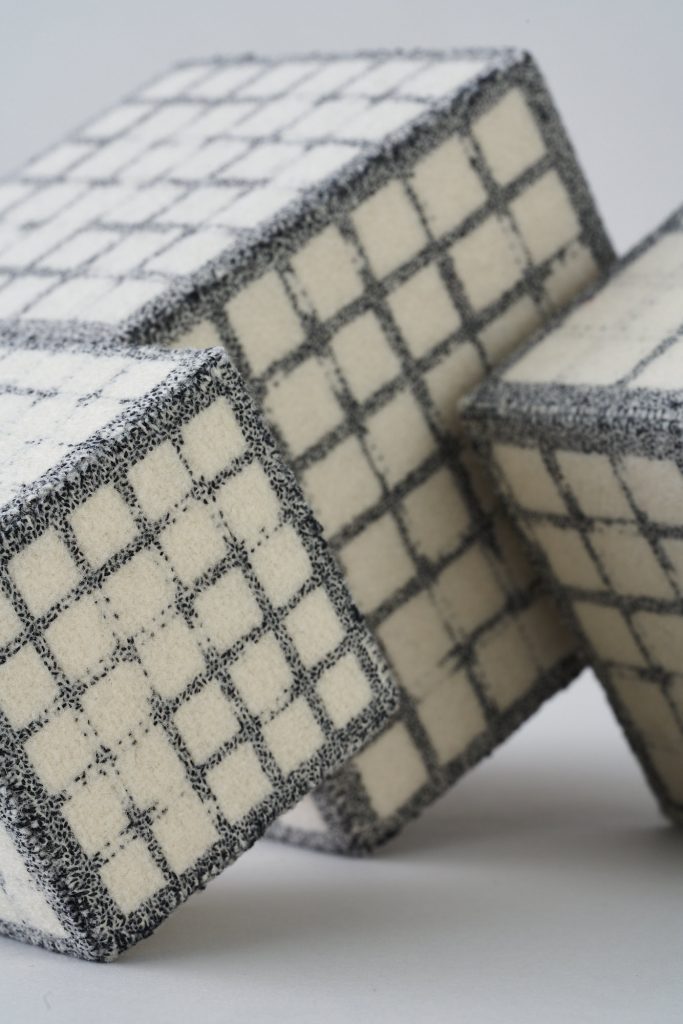
Grid Collective, detail, Wool and Cotton, hand embroidery
Rooted in this tradition of hand stitch, each of these objects becomes a very individual expression of my time. They demonstrate my need to engage with and connect to the world through touch.
Creating objects also helped me subdivide extended periods and represented moments of my time, translating the intangible into something tangible, tactile, something you move around and draw within space. They record and persevere fleeting moments, found patterns, the objects become markers of time, an embodiment of this deep focus and patience.
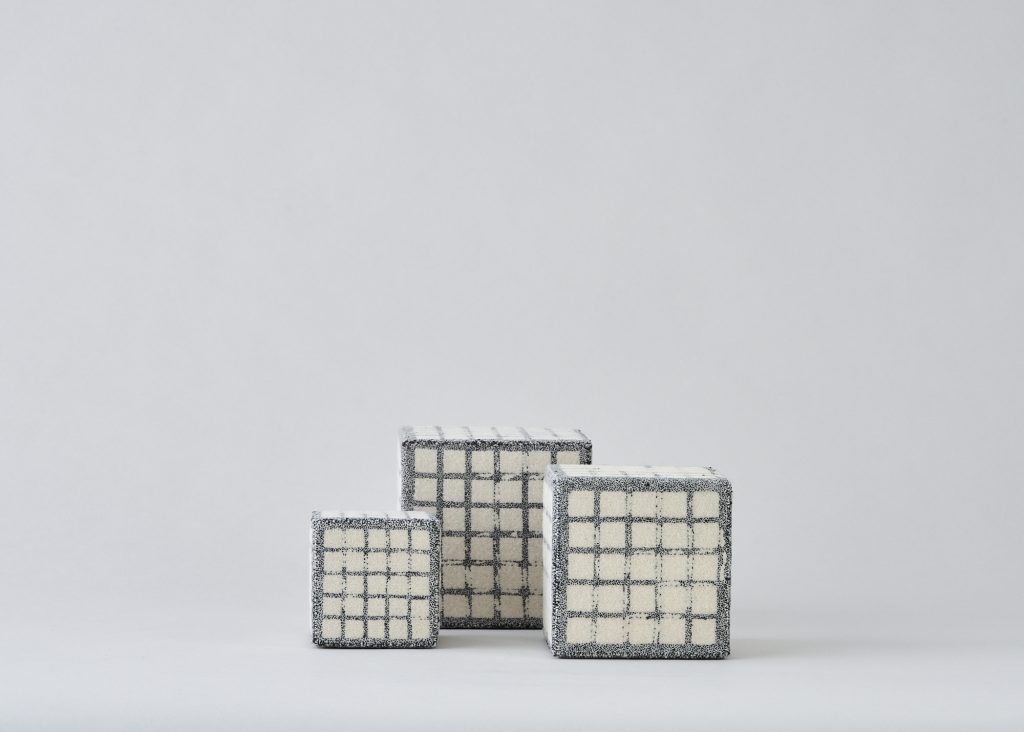
Grid Collective, detail, Wool and Cotton, hand embroidery
These works extend from me, the past condensed into physical form and infinitely rearrangeable. "A moment in time."
Do you think this has been heightened by lockdowns and the concerns for the future?
I feel the pandemic has heightened our awareness of time. There have been moments when time has crept forward slowly and other moments that have sped by. Emotion and stress affect our sense of time, which has been supercharged over the past year. The first lockdown acted as one big brake on a global scale; that sense of everyone experiencing the exact moment is powerful. In a world obsessed with speed, these moments happen rarely. There are few times in our lives when ordinary time has paused, the 9/11 attacks being an example of this; Covid is the next. In Jay Griffiths book Pip Pip, she uses the model of Princess Diana's death 'All radio stations and TV channels, all newspapers and all conversations were for once in sync'. She goes on to say, 'The ordinary time of usual life met the extraordinary time of myth. Mythic time interrupts the succession of ordinary time and the mythic moment is where the profane present meets a sacred eternity.'
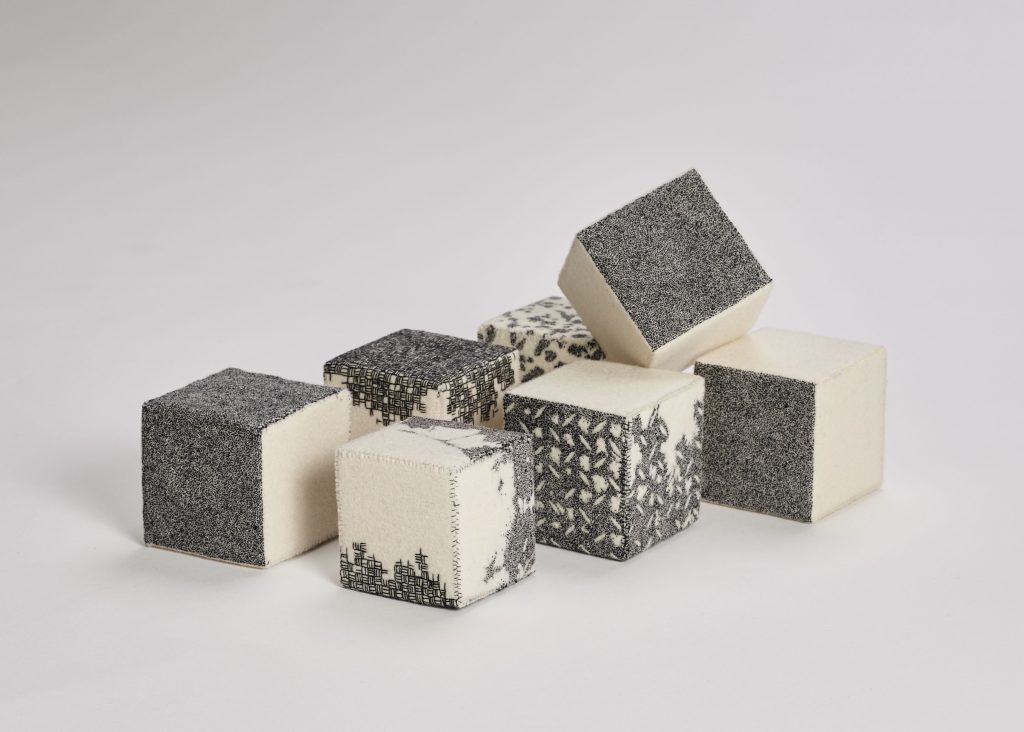 Units of time, Wool and Cotton, hand embroidery
Units of time, Wool and Cotton, hand embroidery
The very act of slowing down forces us to take notice; we see more. The artist Georgia O'keefe wrote, "It takes time to see". We enable this by slowing down, which is why I enjoy the slowness of hand embroidery. Through the action of the hand, I attempt to find order, quietness, a rhythm, a very human rhythm that allows you me slow down.
This slowness allows for a more excellent perception of that moment, and it teaches patience, focus.
I'm an anxious person and, at times, too sensitive. I'm hopeful for the future, but I sometimes find it hard to disconnect from the constant news cycle. Creating art is my way of coping and processing all this trauma.
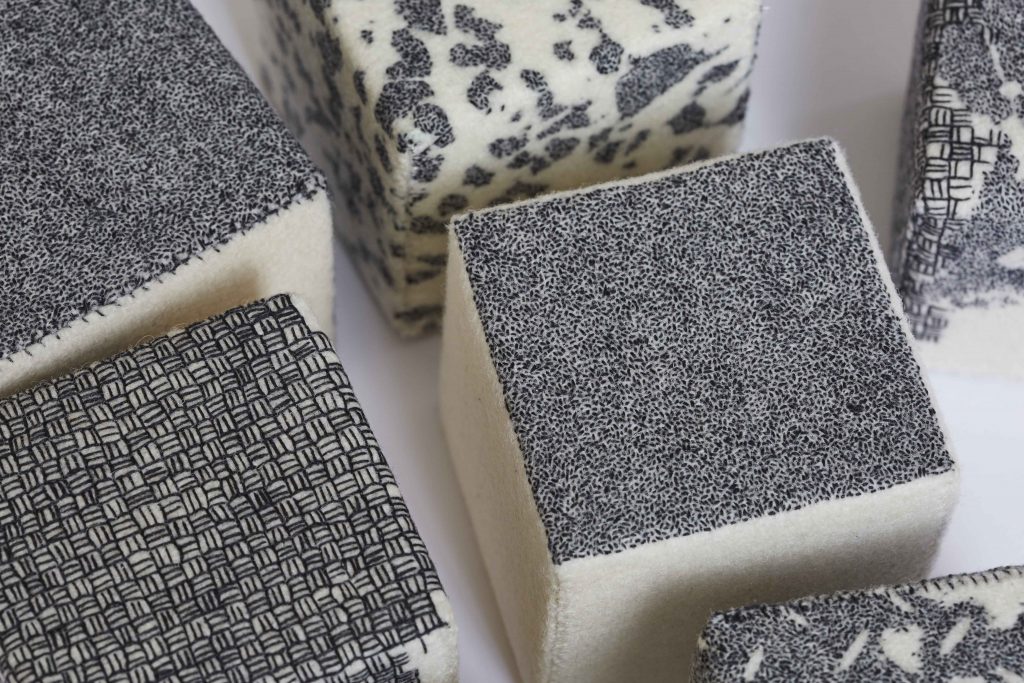
Units of time, Wool and Cotton, hand embroidery, detail
Can you discuss your work using the cube?
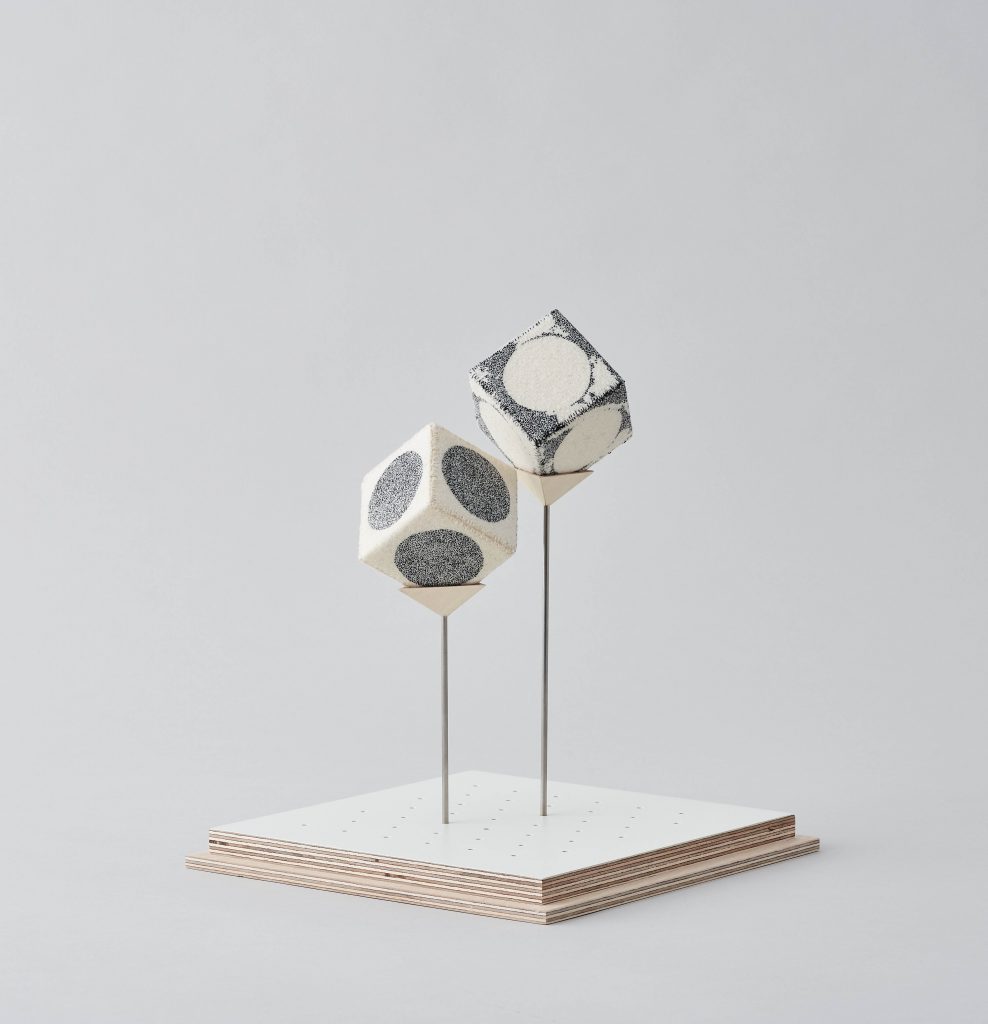
Two Cubes, Wool and Cotton, hand embroidery
The exploration of the cube – it’s geometry, intrinsic nature, and perception as both a complex and playful shape – has been greatly inspiring to me. Each cube is individual but is also part of a greater whole, it’s repetitive but varied with my obsessive mark making.
But cube also is a reference to the grid. The Grid format gives the impression of uniformity but also of infinity, an idea discussed in Rosalind Krauss’ Essay ‘Grids’ she also goes on to say, ‘by virtue of the grid, the given work of art is presented as a mere fragment, a tiny piece arbitrarily cropped from an infinitely large fabric’ and the grid to order reality’
This grid and cube offer more rational way to organise the chaos of nature. I also wanted to work to reflect architecture, the way in fact our lives are built and housed in this construct of time.
Three Cubes, Wool and Cotton, hand embroidery
What made you decide not to work from home but to have a studio outside your home?
For many years I worked at home, it was not financially viable to have a studio. I live in London, where space is at a premium, so it's challenging unless you have a lot of money and a big house. But I did think it was essential to create some separation; having a studio outside of the home also sets a boundary between home and work life, and as an artist, it's hard to switch off. I also felt restricted by the space at home. The practicality of space limited the scale and ambition of my ideas.
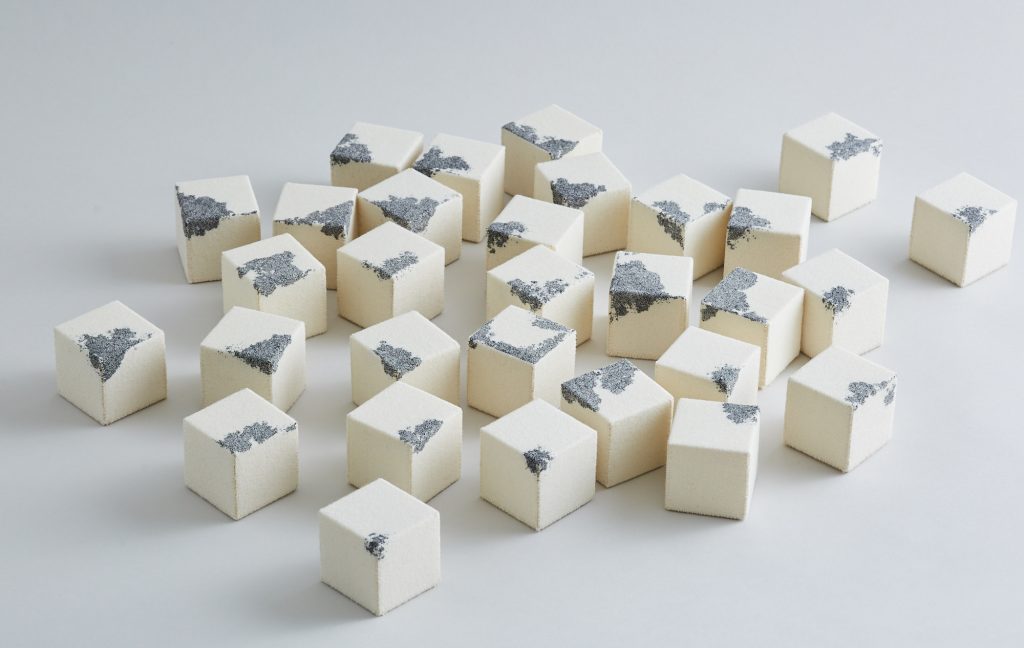
Variations of a Stitch, Wool and Cotton, hand embroidery
An essential part of setting up a studio outside of the home was the chance to be part of a community. I have a studio at Cockpit Arts in Holborn, Central London. Cockpit Arts is home to over 140 independent creative businesses. We have public showcases and business incubation services, and they provide makers and materials-based artists with the tools to succeed. Being an artist can be lonely and very insular; therefore, it's vital to have conversations and support fellow artists who understand what you might be going through.
Variations of a Stitch, Wool and Cotton, hand embroidery
Have you always shared your work through classes?
My practice informs my teaching, and teaching informs my practice. Therefore, I always include and share my work through classes. I think this is my point of difference and one the main reason people attend my workshops.
Comment on you online workshops, and the variety of students that this format has introduced to you.
Teaching online has meant that there were no restrictions on location, and the accessibly of embroidery allows me to connect to people worldwide. It’s a universal language. People of all abilities and ages attend my workshop. The only difficulty has been attracting men.
Some may not know about the 62 Group, please expand on your introduction and involvement with the group?
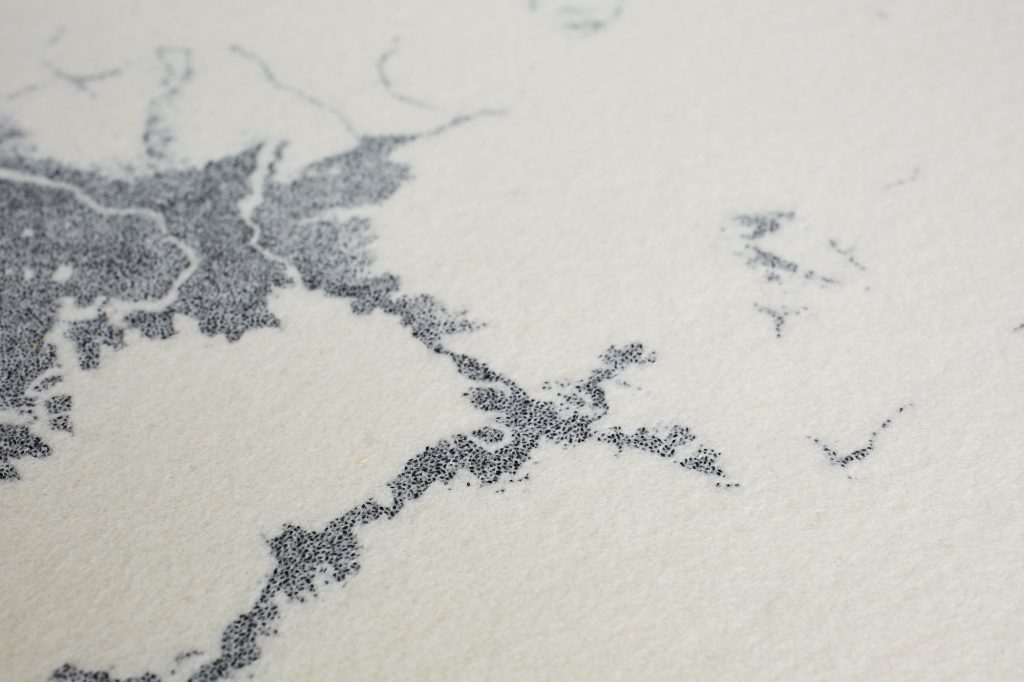
Light Abstraction, Tokyo Bay, 50x50cm, Detail
The 62 Group is an artist-led organisation. We aim to incorporate and challenge the boundaries of textile practice through an ambitious and innovative annual programe of exhibitions. Since its establishment in 1962, some of the most highly regarded British textile artists have been members of the 62 Group. As a result, the 62 Group has an established international reputation for professionalism, quality of work and strength of purpose. Member’s work is subject to appraisal by a panel of their fellow members before it is accepted in any 62 Group exhibitions. In this way, we aim to maintain standards and rigour and keep the group evolving.
I have been a member since 2015, and I’m currently the exhibitions officer. My job is to work with the committee to plan an annual exhibitions programe—our next exhibition, ‘Connected Cloth’ part of the British Textile Biennial.
What are you currently working on?
I’ve just finished a new body of work for the British Textile Biennial. The theme of this year’s events focuses on the global context of textiles, textile production, and the relationships it creates historically and now.
I have created two works for this exhibition, ‘Coal seams’ and ‘A Portrait of Coal.’
Using the intensive labour-process of hand embroidery, ‘Coals Seams’ maps and bring to the surface the underground and hidden landscapes of this elemental material formed over three hundred million years ago. It examines my family connection to material, place, class and race; and how, like the seams that shape a garment, Coal continues to shape our lives.
A series of coal portraits highlights the aesthetic, cultural and climate impact of coal. Coal was more than just a material, but a symbol of power, class, and time. The unlocking of this geological time gave us the power to go fast. In Britain, it is a symbol of the past. Ultimately though, Coal is a symbol of the present, the future, and the climate emergency.
Discuss the differences in your 3D and 2D work.
Drawing as an act is occurs in everything that I create. Drawing as a dialogue, a focus that goes beyond the flat surface and into the space around. The objects and structures compose and draw in space, with each architectural setting creating a new relationship. Things must and do exist in dialogue with a scale around it, with the infinity of it all. The only difference is perception and experience; creating is the same.
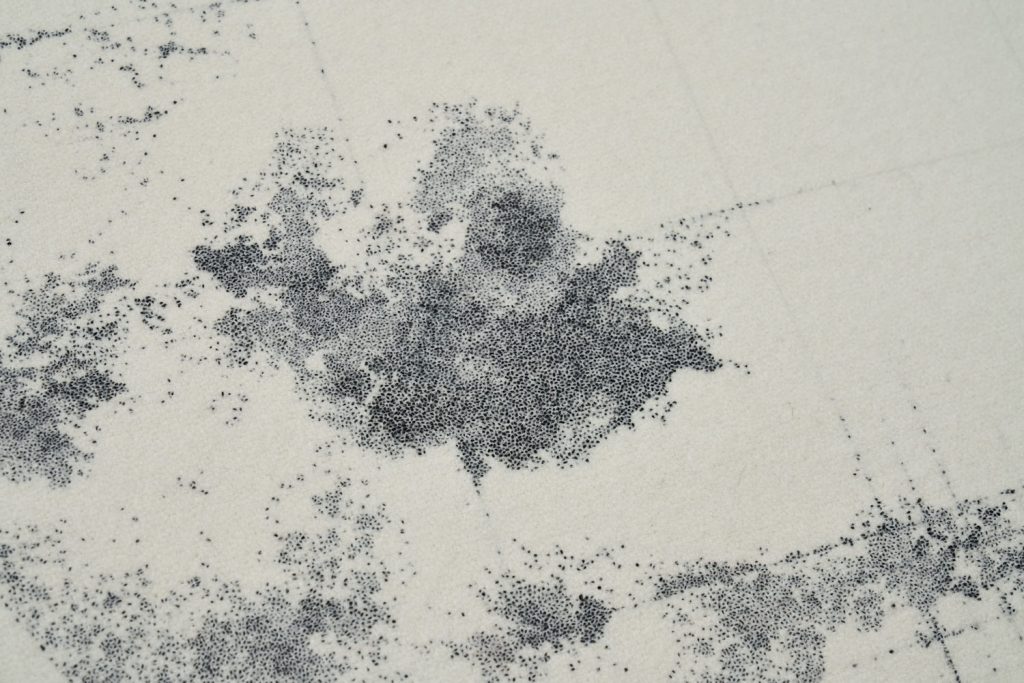
Phase 1, 100 x10cm, Wool and Cotton, hand embroidery
Contact details:
Richard McVetis
instagram @richardmcvetis
Richard McVetis, London, UK
Interview by Deborah Blakeley, October 2021
Silvy Weatherall
The Last Supper:
How did this work come into life?
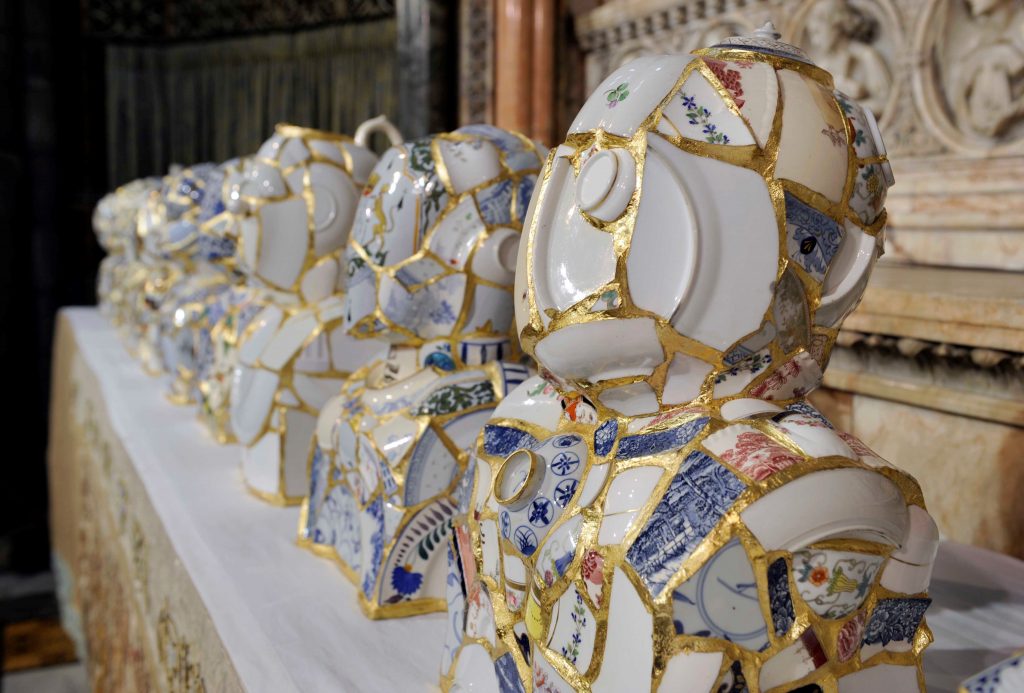
The concept was born after my studio was flooded by heavy rain. When clearing it out, I found several pulpy cardboard boxes of broken china in a soggy corner. They had been kept, along with other broken and useless belongings, as an ever-growing collection for a potential project - a consequence of my hatred of throwing things away. How did these previously loved broken objects end up in this box? The unintentional act of breaking china is violent and generally rather alarming. Chucking out your grandmother’s tea pot or a wedding present immediately post-breakage is sometimes just too emotional. I have subsequently found out that I am not alone when it comes to keeping broken china. Much of the material used in this installation has been gifted to me by kind and thoughtful friends. No plate or cup was intentionally broken for this artwork.
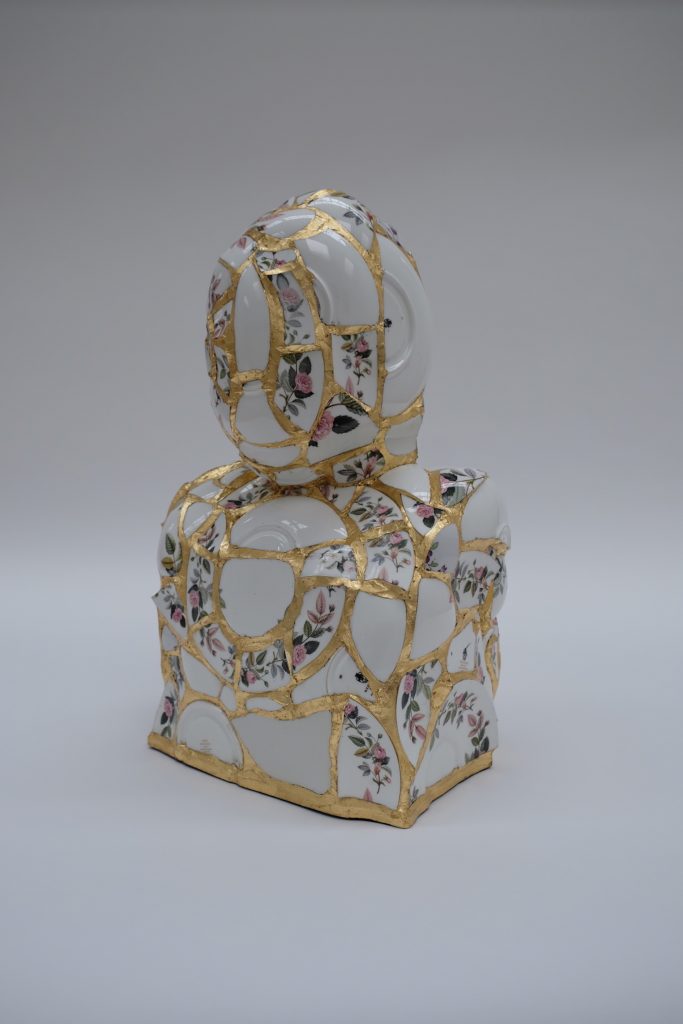
This sculptural series evolved from a play on words and a speculation into what was the last meal served upon the plates and china? There is also a word play between ‘bust’ - the heads and ‘bust’ - the china, as well as the physical and emotional meaning of being ‘broken’.
Did it have a space to be exhibited before commencement or after it was begun?
No. The concept came to me and by the time I had made three busts I felt able to make a proposal to a gallery with the intention of finishing the piece. I made a proposal to HIX Gallery in Shoreditch, London (underneath and associated with a restaurant called the Tramshed) in September 2018 and showed it at Easter 2019.
Can you explain ‘wabisabi’ – and “kintsugi’ and how you have adapted this Japanese technique to this work?
*Wabi-sabi: In traditional Japanese aesthetics, wabi-sabi (侘寂) is a view centred on the acceptance of transience and imperfection. The aesthetic is sometimes described as one of beauty that is "imperfect, impermanent, and incomplete"
*Kintsugi (金継ぎ, "golden joinery"), also known as Kintsukuroi (金繕い, "golden repair") is the Japanese art of repairing broken pottery with lacquer mixed with powdered gold, silver, or platinum. As a philosophy, it is similar to that of wabi-sabi: it treats breakage and repair as part of the history of an object,
In making this piece I have been inspired by the technique of Kintsugi but I have adapted it for my own purpose. Whilst not actually mending something , I am constructing with broken china. The joins therefore have to be larger and stronger in order to make a robust sculpture. I smoothed and sanded the joins before applying about 4 layers of gold leaf on them. This was possibly the most time consuming and fiddly aspect of the build.
How are the busts constructed beneath the ceramic pieces?
The busts are hollow. I made an armature with a wooden upright and base and then wrapped tightly scrumpled newspaper around the upright binding it with string and tape until I had a basic head and shoulder form. Each bust is slightly different in shape and size. It was a case of “hoping for the best” in terms of construction. I couldn’t map out the pieces before gluing together. It was more of a piece by piece process, a 3D jigsaw. Starting at the front and working up and around to the sides. Then the back and working up until the pieces met in the middle. I then peeled away front and back from the armature and joined them together. The busts have wooden bases.
They are hollow but they contain quite a lot of my DNA.
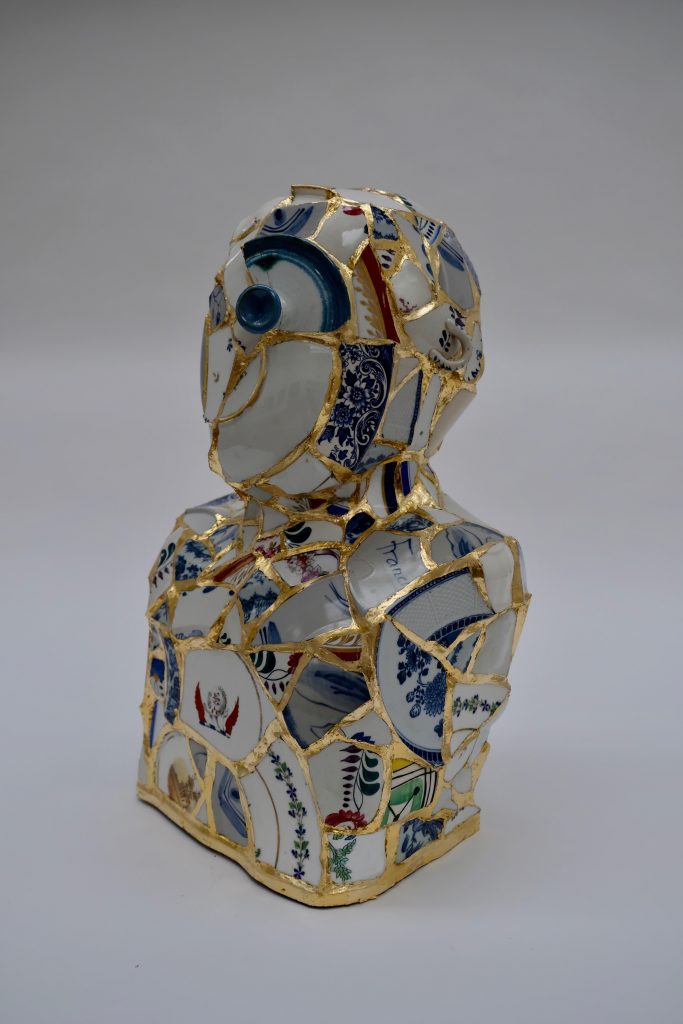
Has the work grown a life of its own?
Yes! It has grown bigger than me. It is almost like I have turned from the maker to the custodian of the piece. I am being advised kind and concerned people, who feel a sense of responsibility, telling me what I have to do with it in the future. “It must travel” “It needs to be bought for the Nation” “It should do a Cathedral tour” The latter words of advice are currently my wish too but I don’t know where it will go from here.
Obsolete, doesn’t appear to be in your vocabulary – discuss.
I have used it in a few essays and interviews! But maybe it is not on my website. It is deffo a word I use!
Here is an excerpt from one of my brief essays on the materials I use.
‘I am preoccupied with objects that have seemingly ceased to function, rendered obsolete for whatever their original intended purpose by their age or physical state; I like to see the potential where others may not. Interested in the history of an object, I question functionality and attachment. I play with associative words and meanings to help inform my end work.’
You have expanded beyond the 3D form to studies of the twelve busts expand on using both 2D and 3D in this project.
I studied fine art (painting) at Art School (Camberwell-London) and have always been a painter and observer. Whilst my preoccupation with other materials has led me to more conceptual and sculptural pieces, drawing and observation have never been far away.
Once the busts of The Last Supper had been made, I wanted to concentrate on meaning of the cracks/ joins that inform the piece. I made a portrait of each bust on A2 handmade paper , taking away the broken china element and portraying the busts as 3D skeletal systems.
Also , whilst invigilating at the Cathedral, during quiet spells, I have been drawing studies of ‘The Last Supper’ in its ecclesiastical setting. More as a note taking and observational exercise but maybe with a view of painting a series of the Last Supper in its future settings too. A collection of “Altared images”
Tell us about having the work in St Mary’s Cathedral in Edinburgh?
There was a very brief spell between finishing the piece and taking it to London for the Exhibition at HIX Gallery. I had an impromptu studio opening where local friends and family could come along for a preview. A Reverend friend in her late 80’s became very passionate about the piece and subsequently bombarded me with emails with contacts in the church. She gave me the contacts for St Mary’s Cathedral and after my London Show had finished, I contacted them. They were very open to the idea, and we had a meeting to discuss it further. I took Jesus along in the passenger seat of my car for the meeting… I thought he may help! (to show the scale and the finish!)
Exhibiting at St Mary’s during the Edinburgh Festival has been amazing. The Cathedral opens its doors for concerts, organ recitals and choral evensongs of world class quality. The building feels alive and vital and welcoming.
During the time you were also at the cathedral you spoke to many observing the work. Please share some of the highlights.
The response during my 10 days in residence in St Mary’s Cathedral has been extraordinary. Raising philosophical discussions, biblical references, recitals of French poetry, (Jacques Prévert “La Cén”) issues to do with mental health. Their observations and responses have often informed me about aspects of the work or references that I had not yet been aware of.
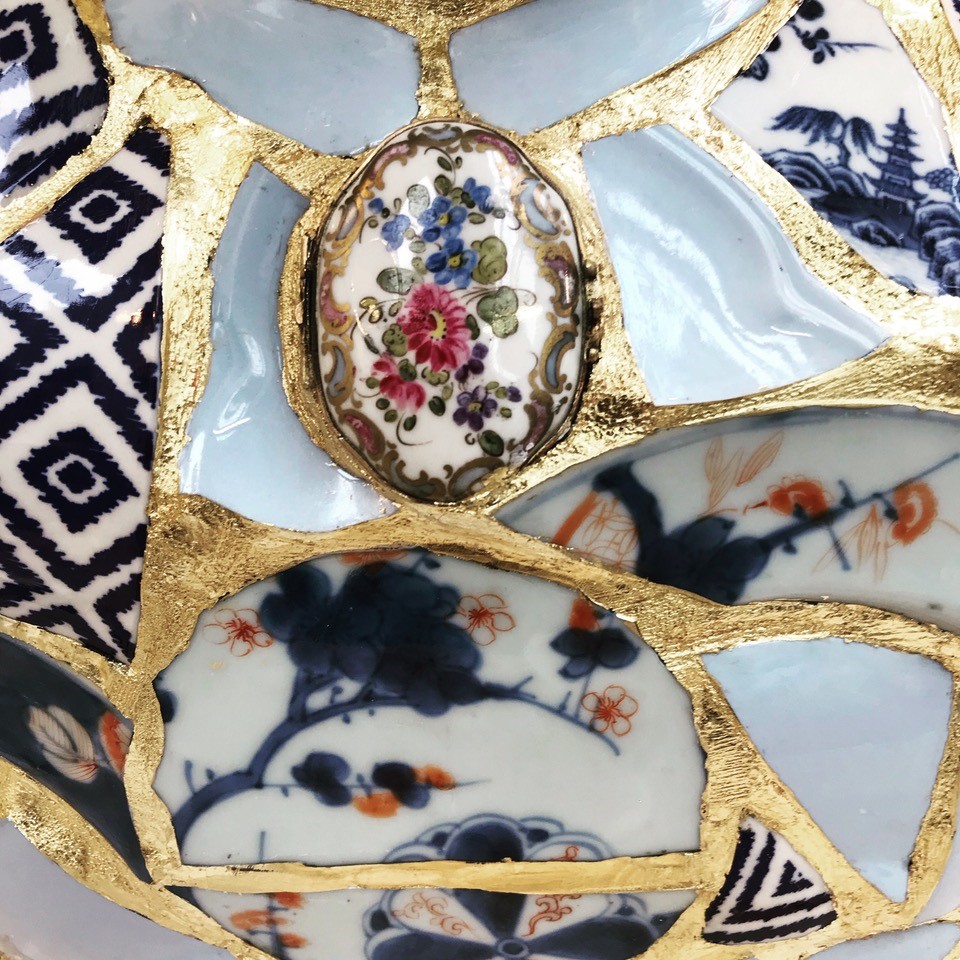
Comments to me like ‘You can see that it has been made with love” “You can see the respect for the materials” “It is God’s work” as if I were not actually a part of it. All unbelievably positive and affirming. A few of the visitors have been wept. Lots of physical responses to the piece like goosebumps and then associative memories when someone spots a piece of familiar china. I have had visitors coming back to view the Last supper multiple times. They have come as strangers but leave as friends.
The Vice Provost, Rev Marion Chatterley has written a sermon about the piece for her Sunday service as has the Dean of the Diocese of Edinburgh. It has been humbling and slightly surreal!!
Other works:
You have taken the art of decommissioning even further and larger with the Memorial Garden using a decommissioned railway bridge expand on this commission.
In 2016 I had an exhibition at the Fine Art Society Edinburgh called “Another Man’s Treasure”.
A friend, neighbour and patron came to the show and whilst liking the pieces -he has several of my works on his walls- he wasn’t going to buy from the show but made a proposal instead.
He had a huge stack of sandstone on the bank of the river by his house. Stone that had formed a Victorian railway bridge spanning the river. The bridge had been demolished to make way for a modern one, and the sandstone slabs had been discarded-rendered obsolete.
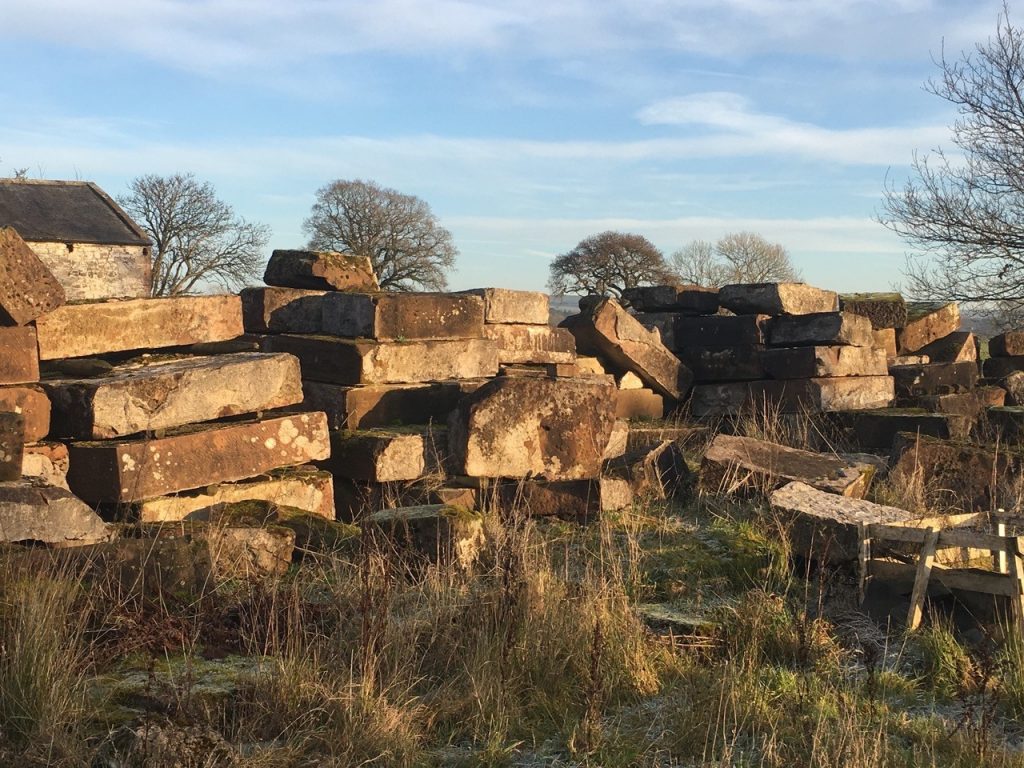
Could I use these huge stones to make a woodland memorial garden next to the parish church? It was a job beyond my capacity really, but I undertook to design this public space. My first problem was the term “Memorial Garden” . I had envisaged a place that felt like an archaeological discovery, a place you came across in the woods, a sanctuary . I researched the landscape and discovered there had been a few Roman roads and settlements in the vicinity. The old bridge carried passengers from Dumfries to Glasgow. So with my Patron’s consent I referred to it as the “Journey Garden” and inscribed quotes, which had to be discovered, on the stones “Look where you have been, view where you are at , seek where you want to be” and made a labyrinth on the centre stone. The garden is used for ceremonies, blessings, gatherings and performances as well as a place to sit quietly and reflect.
Another discarded objects you have use are feathers. Comment on your work Wheels and Mandalas.

Peasant Feathers
My husband Ben was in the food business for 18 years. He sold beef, lamb and mutton from our farm in SW Scotland and collected game from around the region to sell to the restaurant trade. At one point the price of game was unbearably low and I felt that there seemed to be an injustice to the life of these beautiful birds. I intercepted and plucked the pheasants before they went to be processed for the food market. With these feathers I made art works. Nature is so very geometrical by design and I gravitated towards making Mandalas .
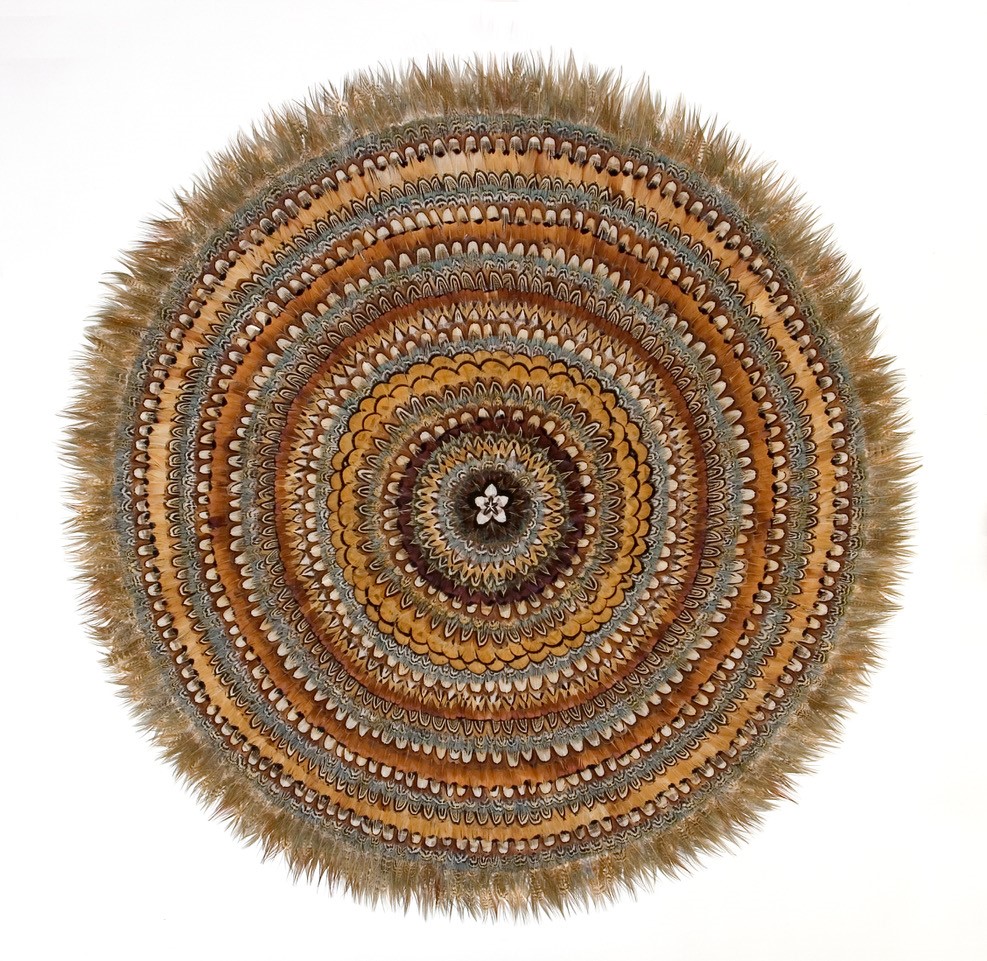
Peasant Feathers, 100cm x 100cm
This extended to bird skulls (another by product of the food industry.) These , like much of my assemblage and sculptural work , are a a kind of memento mori.
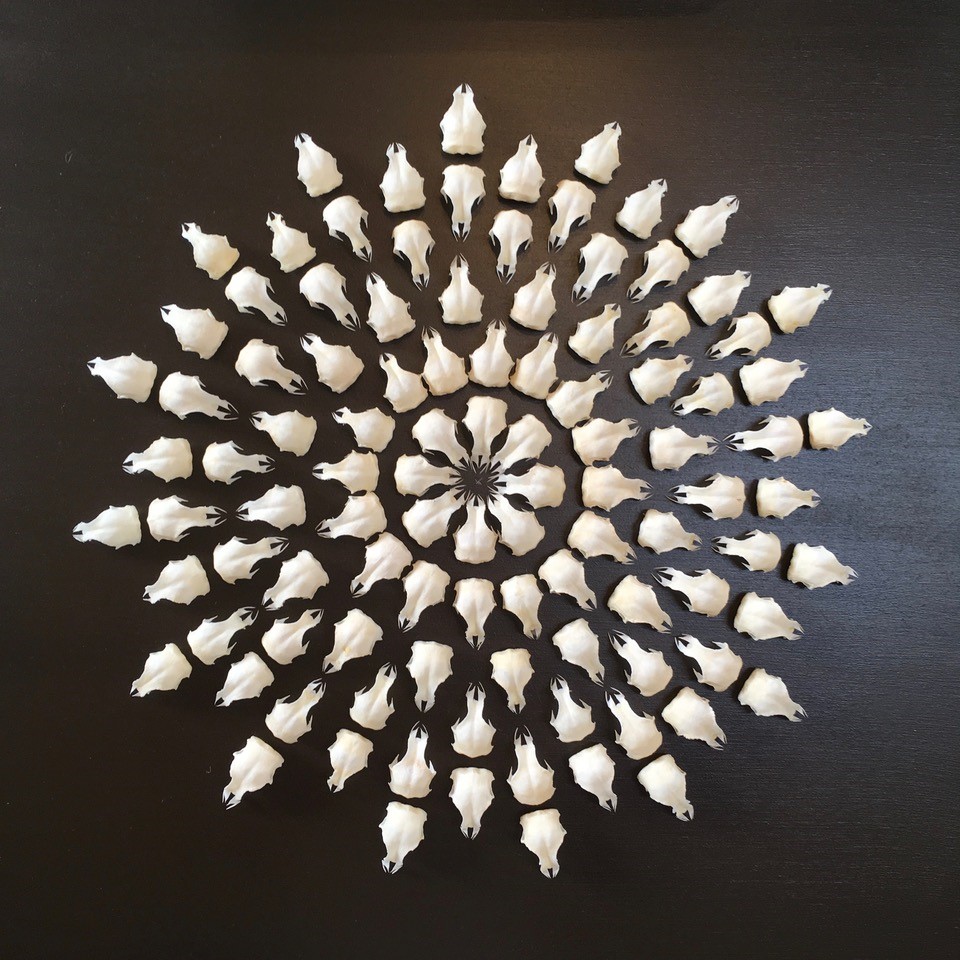
Grouse Skull Mandala, By products of the food industry
My husband is no longer in the food industry, so I had to look elsewhere for inspiration.
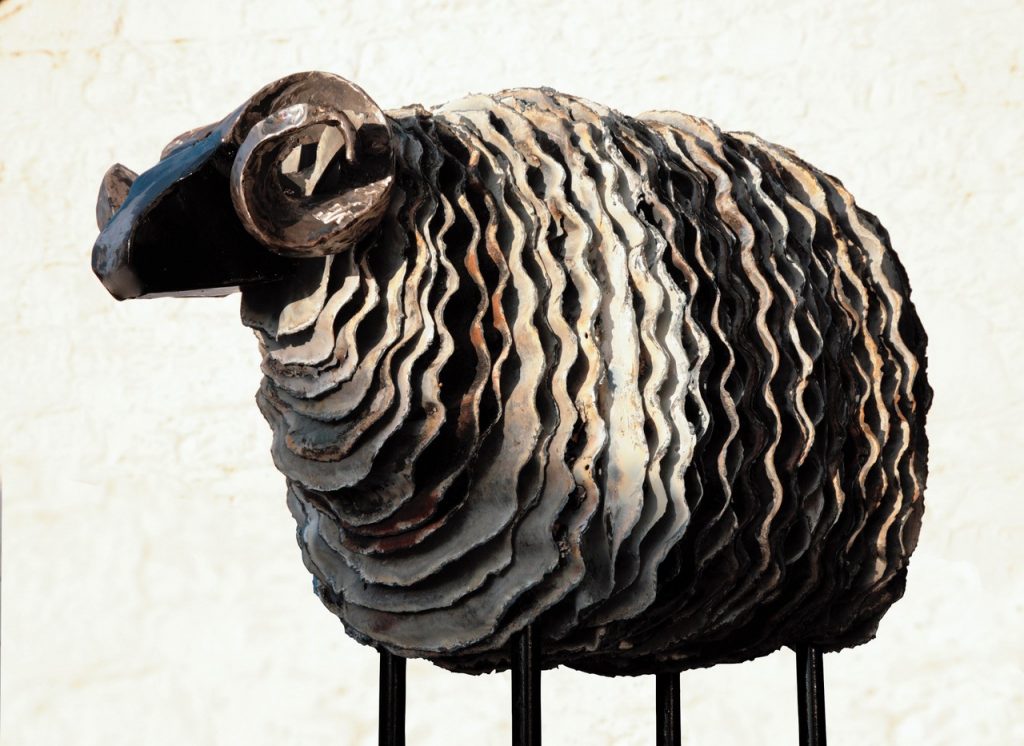
Tin Tup, Made from a demolished corrugated iron farm shed
Silvy Weatherall
Contact details:
mail@silvart.co.uk
Instagram @silvyweatheall
Silvy Weatherall, South West, Scotland
Interview by Deborah Blakeley, September 2021
Ian Mastin
You commented “ …everyday objects which have no intrinsic value except for the richness of their history and the hands through which they have passed.” Discuss.
I am drawn to paint the kind of subject matter which would have been utilised in everyday life through the ages. Some items were simply discarded after use, for example bottles, ointment pots and clay pipes. Others were purely utilitarian, such as tools, kitchen and eating utensils, spectacles, night lights etc. And then there were the valued items - lockets, books, the keepsake box with its contents. All of these things speak of a lifetime hand to mouth struggle for most people that we can barely imagine in the 21st Century. In a way, I am paying homage to the resilience of the human spirit and appreciation for our forebears.
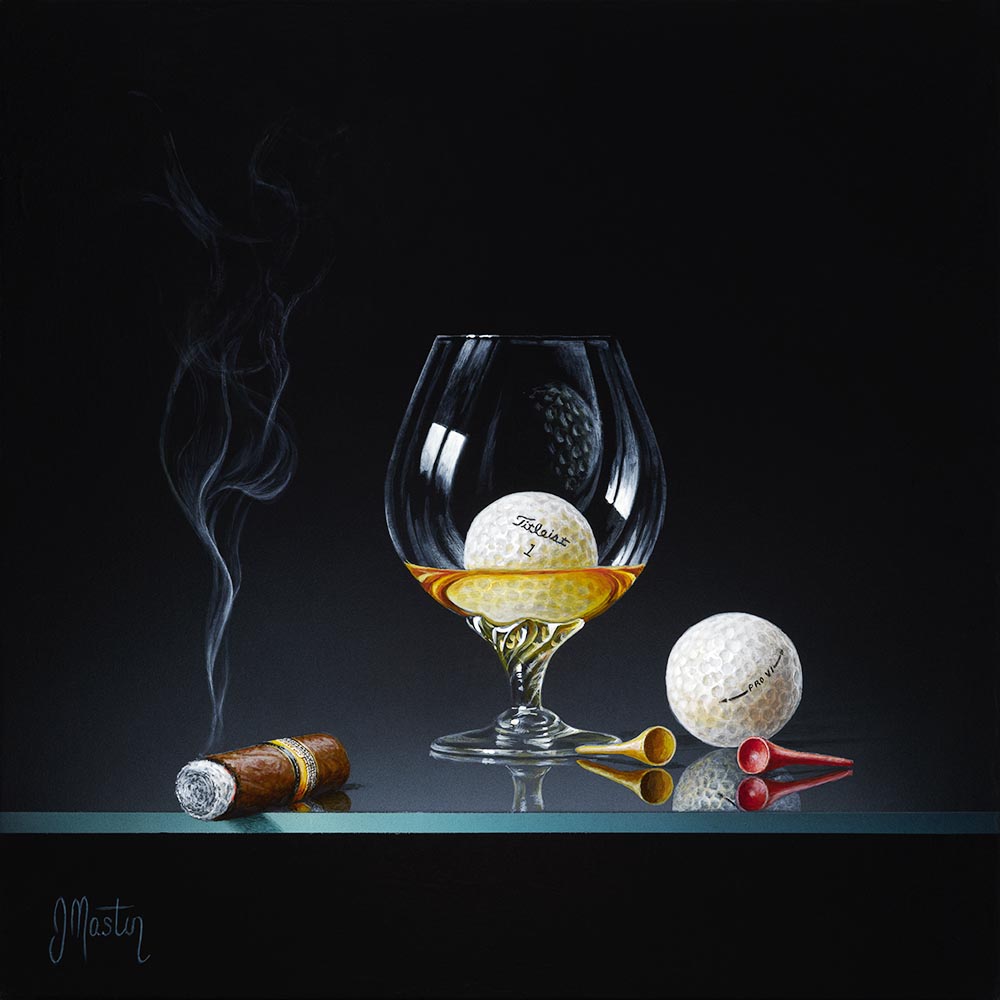
Hole in One
Can you discuss how you choose a combination of objects to paint?
Once I have settled on a theme - a meal spread or musical setting as a complex example, or a single main feature such as a particularly interesting pot, decanter, vase or simply a piece of fruit, I then begin to look for complementary items to balance the setting.
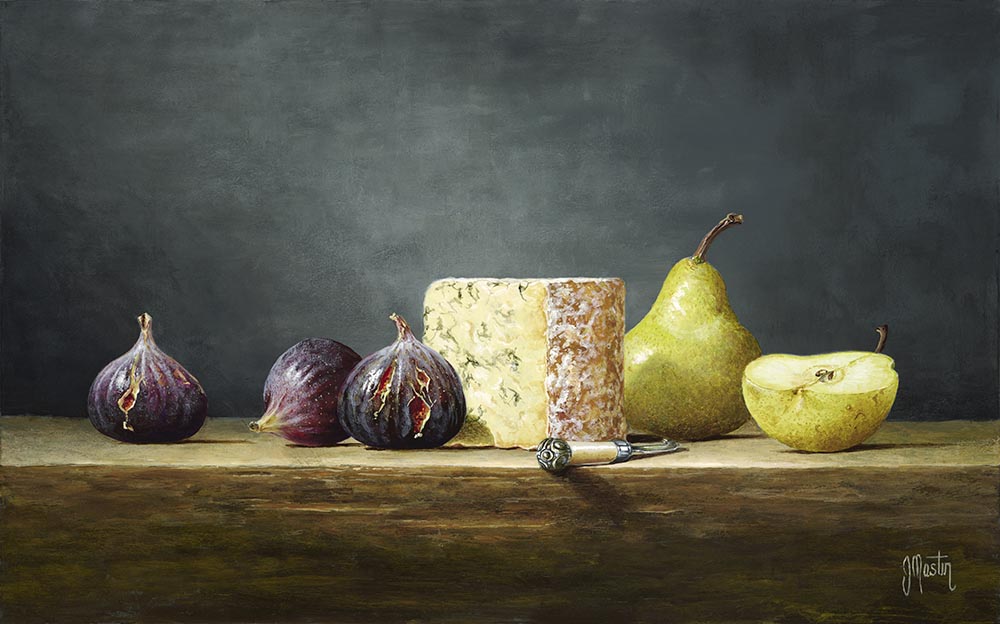
Colston Bassett Stilton
Over the years, from my travels I have collected a vast array of subject matter large and (mostly) small. Although time consuming, it can be very enjoyable to try out various combinations to get the balance ‘just right’. Although the overall theme is paramount, oftentimes it is something totally unexpected or unconnected that makes it work. I try not to overthink the setting, what I am seeking is the overall ‘feel’ and the balance. This is where texture, hue, tone and lighting become crucial.
What is one of your favourite paintings from The Golden Age, that always gives you inspiration?
My Favourite artist from that era would have to be Vermeer. Favourite painting? A bit like choosing my favourite music, it will depend on my mood (anything from Joe Bonamassa to Purcell), although I never tire of Jan Lievens ‘Still life with Books’ (Vanitas Stilleven).
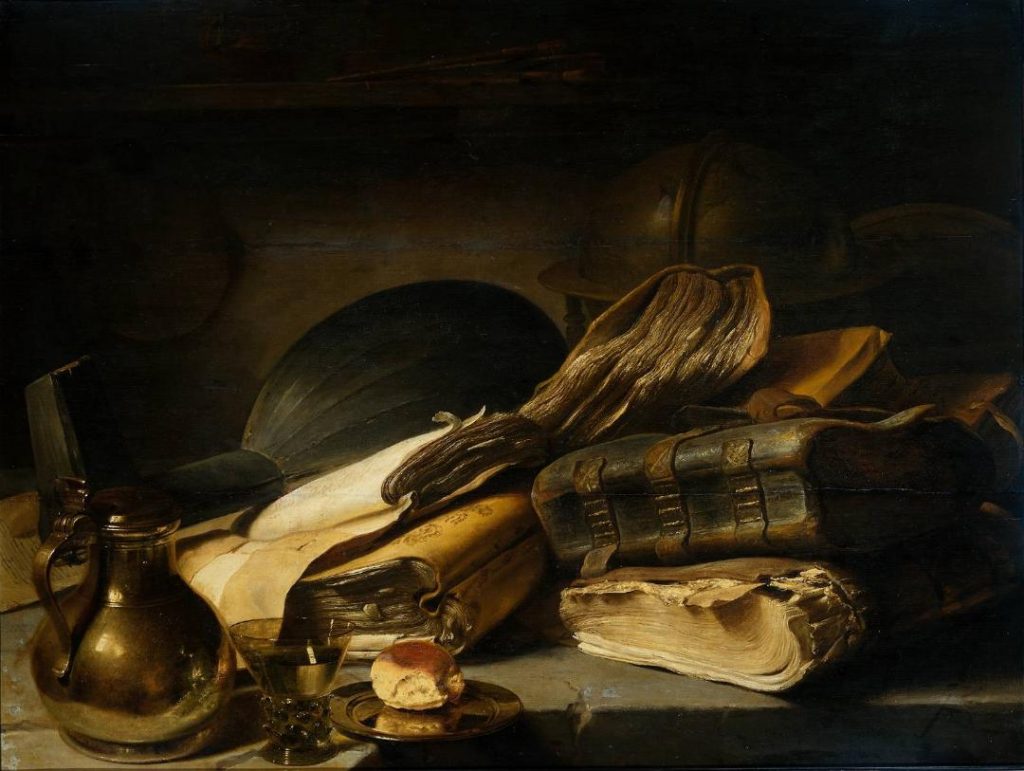
Jan Lievens ‘Still life with Books’ (Vanitas Stilleven).
Discuss the importance of ‘Chiaroscuro’ meaning light and Dark in art, in your own art.
I think that is one of the reasons why I am so inspired by so many of the great Dutch and Flemish artists from the Golden Age who excelled in this style. Another favourite, Joseph Wright of Derby was also a superb proponent. His work “The Orrery” has a magical quality. It is the juxtaposition of the strong contrasts that for me brings a painting to life and has the capacity to bring an almost 3D quality to arrest the eye upon the simplest of subjects on canvas.
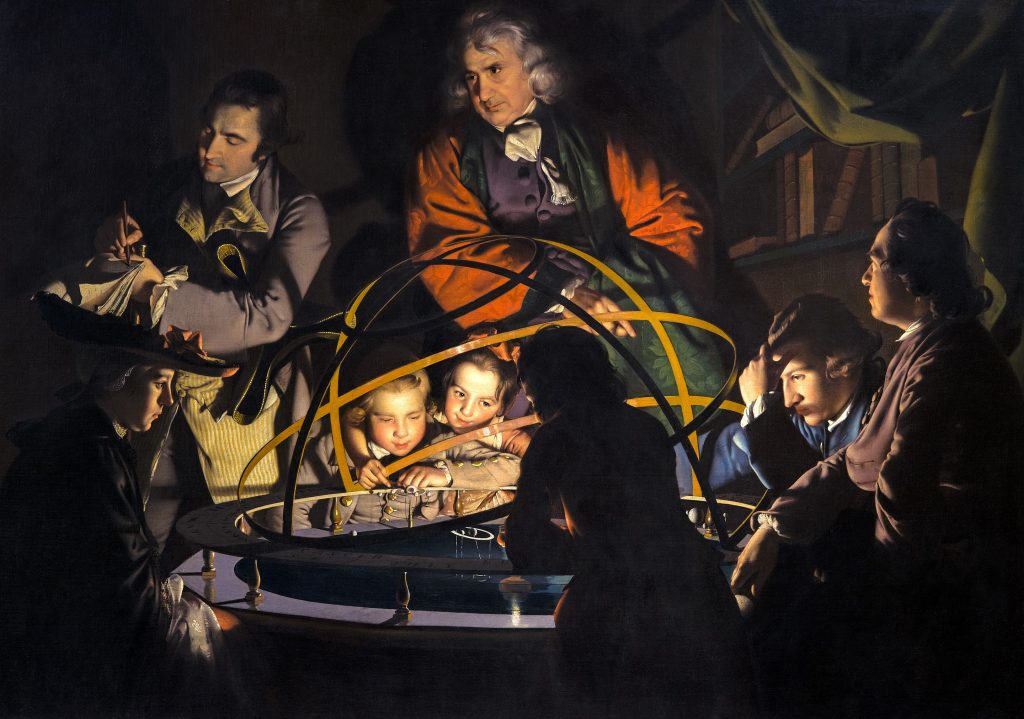
Joseph Wright of Derby
How do you keep up with the demand as you are represented in both Australia and the UK?
Until Covid hit, I was travelling twice a year to the UK to provide my galleries there with fresh work, and habitually worked 60-80 hour weeks. I have since eased my output considerably and find I am enjoying the change of pace immensely. It has given me the luxury of thoroughly enjoying each new piece I now choose to create.
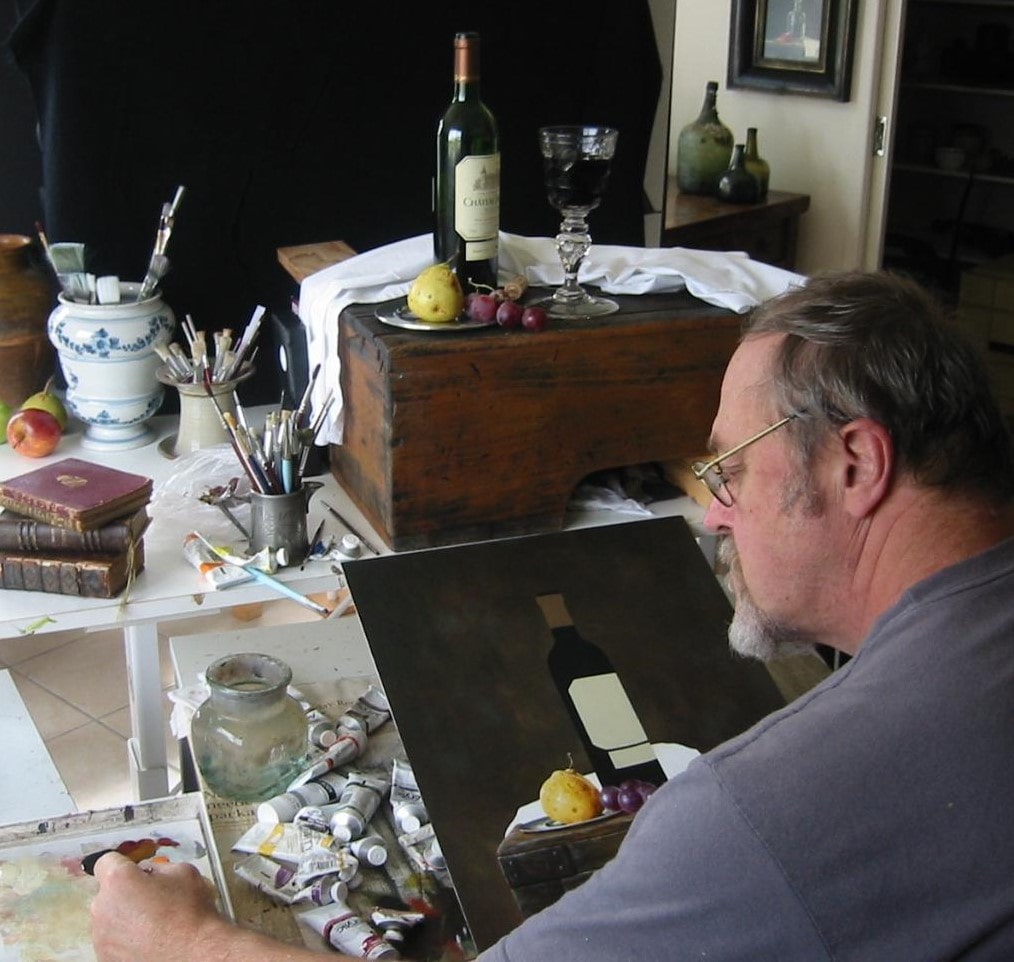
The Grand Goblet
Are you ever asked to paint a still life with a piece of pieces from the purchasers collection?
Quite often. It is always a pleasure to incorporate subjects that have special meaning to the buyer.
Do your paintings hold meanings through the objects you use as in the paintings of The Golden Age?
I sometimes do include objects that have a particular meaning to me or as a request from a buyer. More often than not though, the reference is hinted at in the title of the piece. I often create a play on words or pay homage to a favourite book, author or piece of music.
Can you discuss two paintings, one where the objects are prominently fruit and another manmade objects?
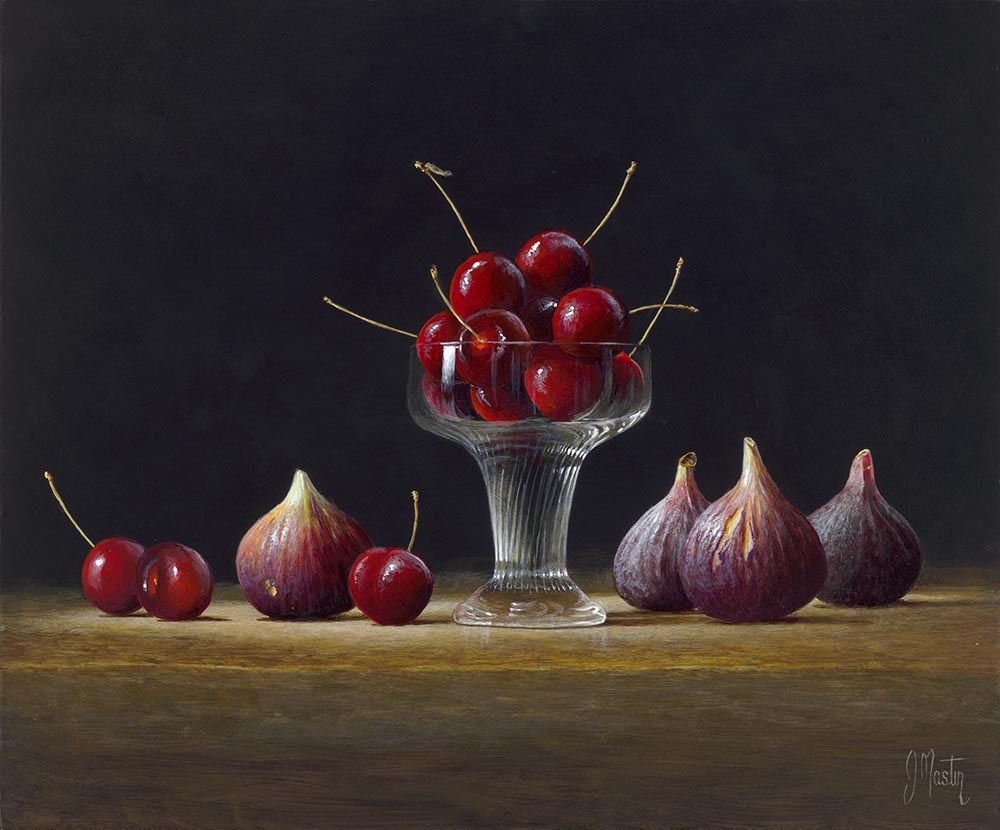
“Rising to the occasion”.
A simple composition featuring figs, cherries and glass. The textures, colours and play of reflected light complemented the setting well. The exquisite perfection of the stemmed bowl contrasting with the wonderfully imperfect organic presence of the figs I found particularly satisfying.
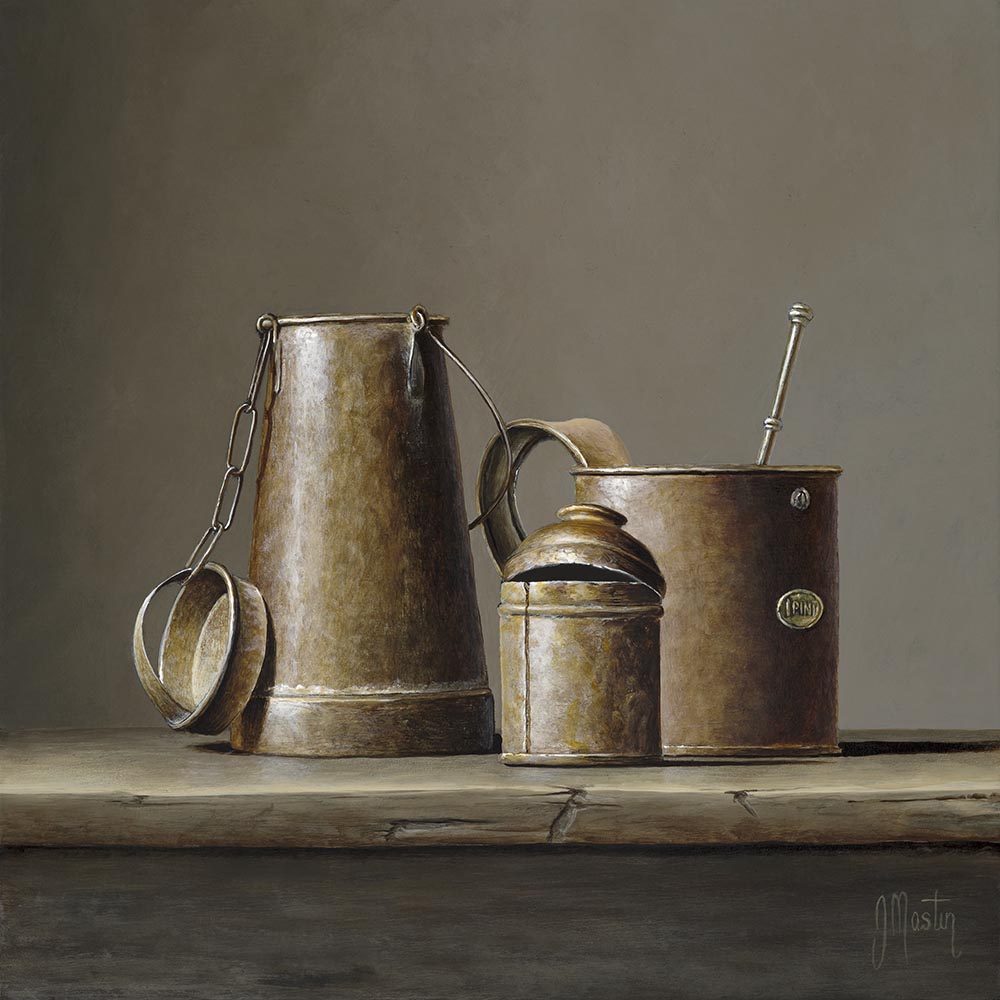
“Old Tin Pots”.
Another simple creation which took some considerable time to arrange, both subject setting and choice of surrounding colour and tone to best achieve what I was seeking to represent. A perfect example of the most mundane of throwaway items featured to appreciate and study in a new light.
How do you use light in your studio set up, natural or electric light?
Virtually all my painting subjects are set up in a shadow box with the light source entering from the left (window) side. Although I prefer to work with natural light from the window, because I work often early morning or late evening, I also use white (natural) electric light from the same direction. Experiencing the vagaries of a consistent light source, I am in awe of those Masters from earlier generations who had nothing more than natural or candle light.
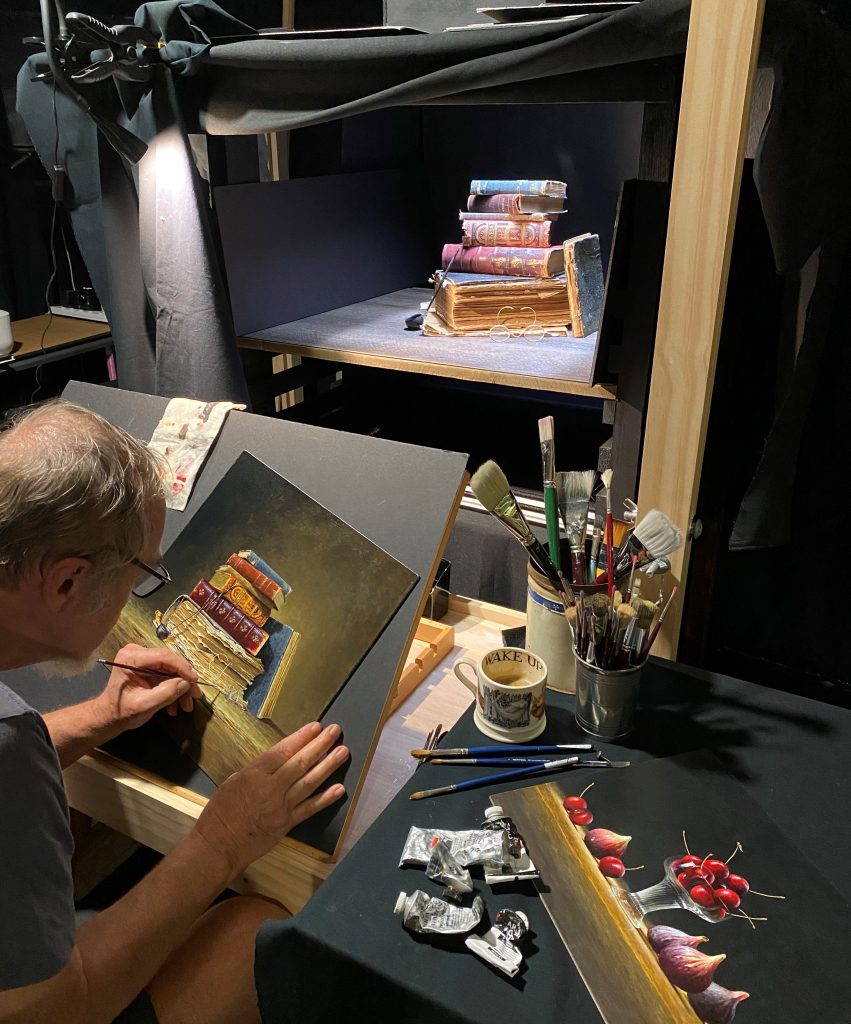
The Grand Tome
You continue to provide pieces for the Woodgate Art in Spring – tell us about this connection?
My little community of Woodgate is the ideal environment for what I do. The demographic consists of a considerable number of retirees and many of them in their retirement have discovered a serious talent for arts and various other crafts. About ten years ago it was decided to hold an annual exhibition to show off the fruits of our endeavours. It has since grown to become an important component on the Woodgate calendar, and many visitors from around Australia co-ordinate their visits to coincide with this event. I highly recommend it.
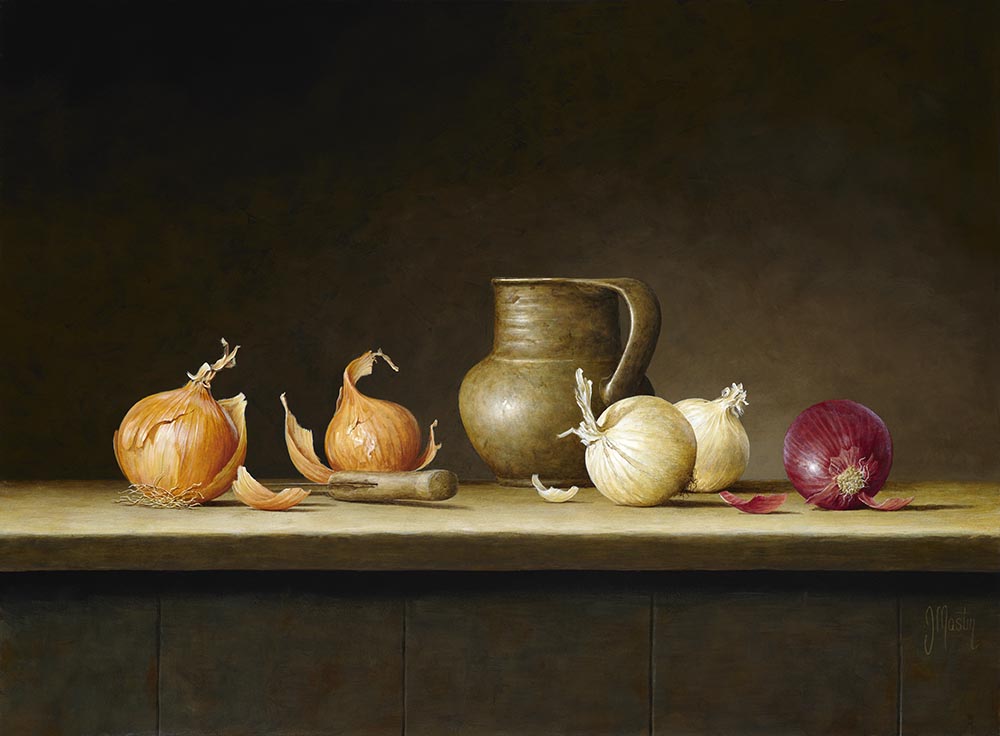
Pot with Mixed Onions
Comment on two commissions Lest We Forget and A Life of Medicine.
Where the commission came from and why?
The objects used and why?
“Lest We Forget” was, a commission requested for a significant birthday for a nephew of mine.
He is a serious student of the art of war, particularly the Australian involvement in the First World War. All the pieces included in the set-up of the painting are from his personal collection. A very intense, thought provoking but rewarding commission.
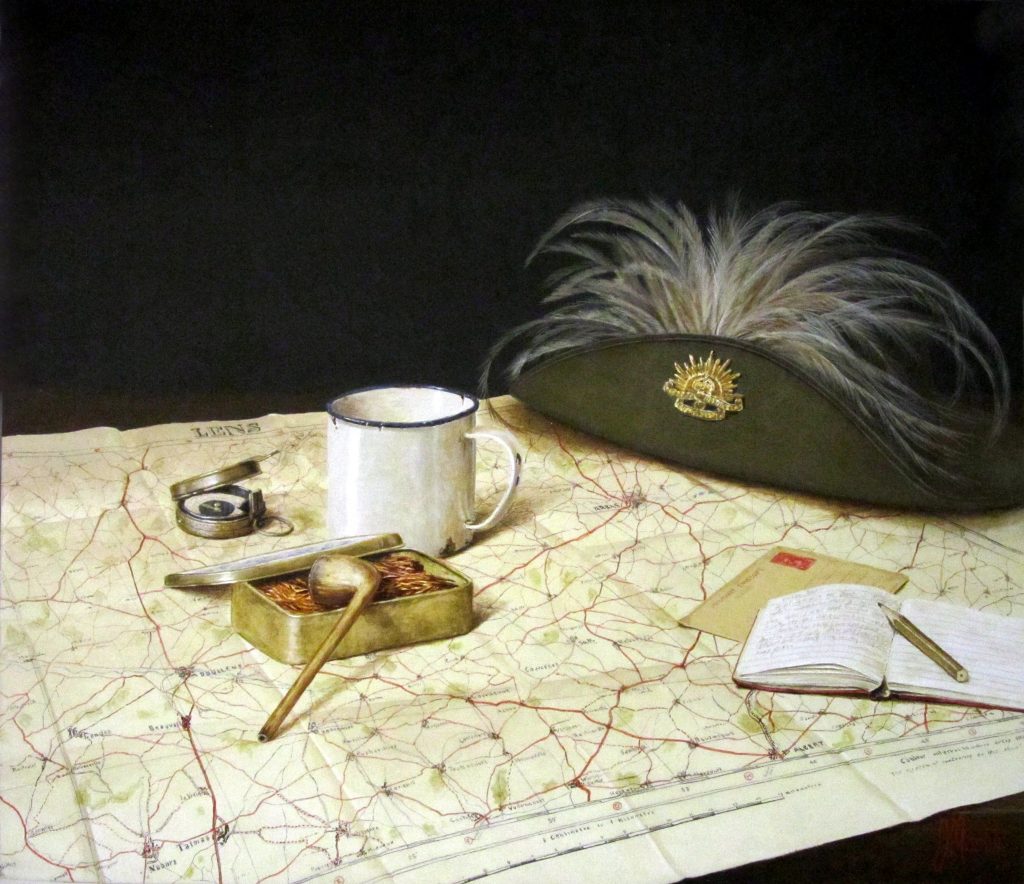
Lest We Forget
“A Life in Medicine” was a straight forward request from the family of a general practitioner upon his retirement. Many of the items included in the painting were provided by the family.
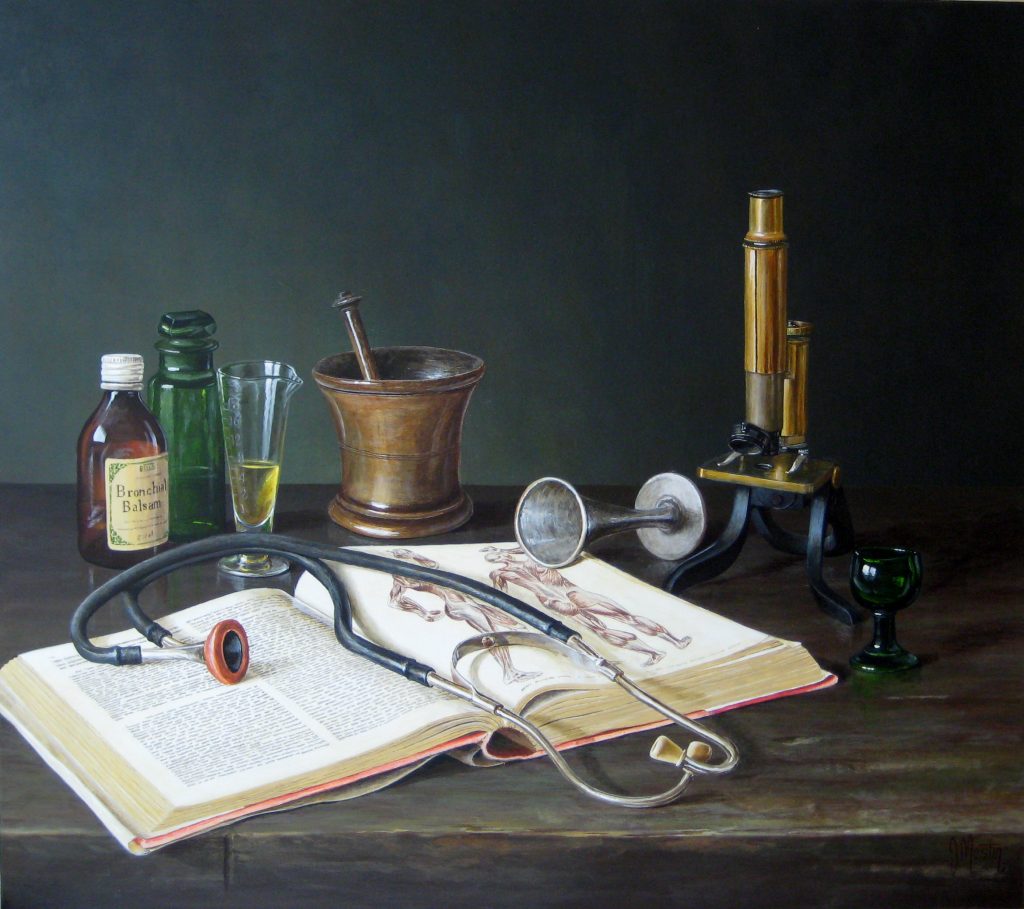
A Life in Medicine
The titles of your work help to date and make comment, discuss this using, Chateau Talbot and The 2019 Collection.
“Chateau Talbot 1949” I love the combination of bread and wine in a painting. For me it evokes a feeling of bonhomie and appreciation for the simple pleasures of life. The vintage denoted on the label is purely a personal aside. Hopefully, it was a good year for the wine. It certainly was for my existence…so far.
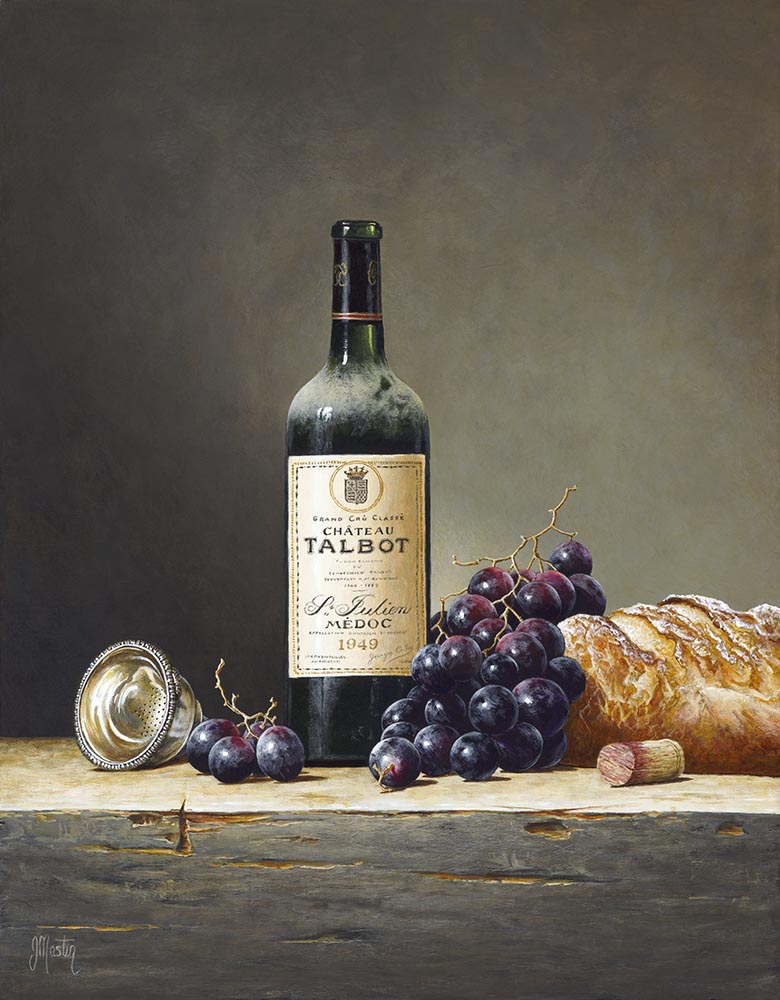
Chateau Talbot-1949
“The 2019 Collection” I never tire of painting old books. So much wisdom, foolishness, humour, pain and every facet of the human condition encapsulated within those pages.
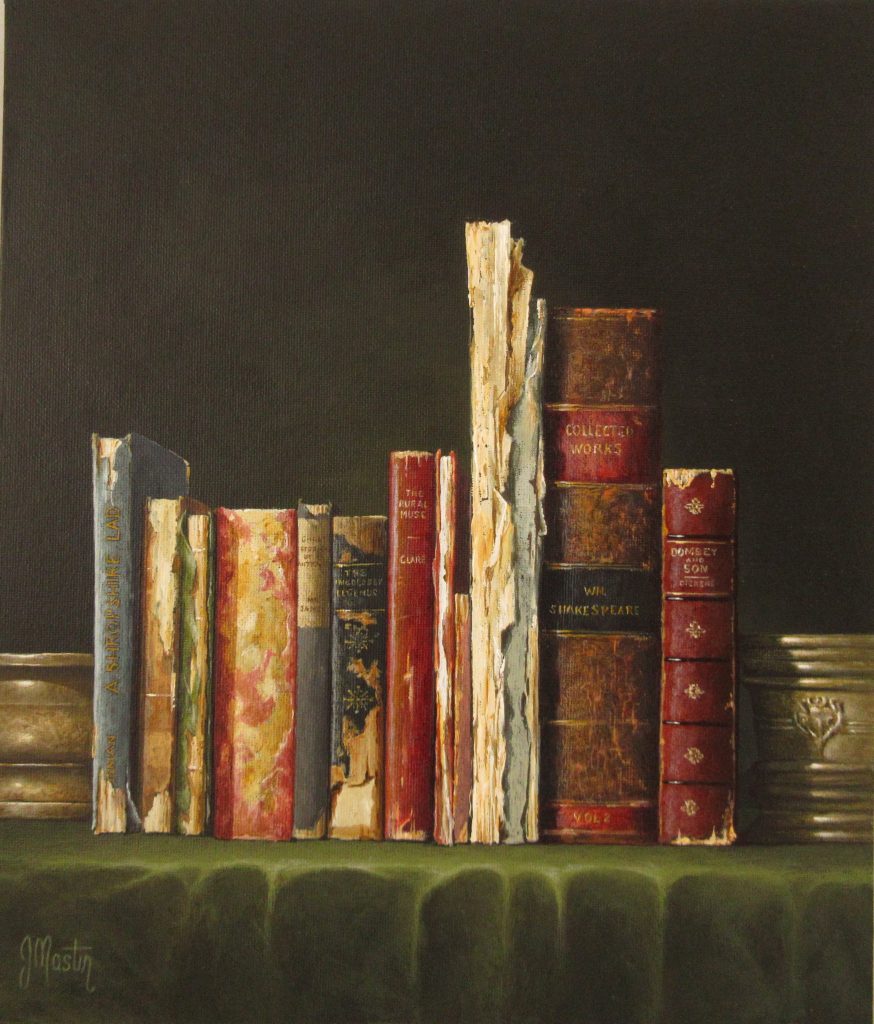
The 2019 Collection
Each year I love to attend Lifeline Book fest, a huge charity event in Brisbane where many tens of thousands of donated books are offered for sale to raise funds. I always gravitate to the section where the oldest books are. I’m looking primarily for books that would present well in my work - well worn, missing spines, falling apart, the tattier the better. The titles are strictly secondary. The 2019 event produced a particularly fruitful bounty. I then exercised a little artistic licence and inserted some of my favourite authors and titles to a few of the pieces featured in this work.
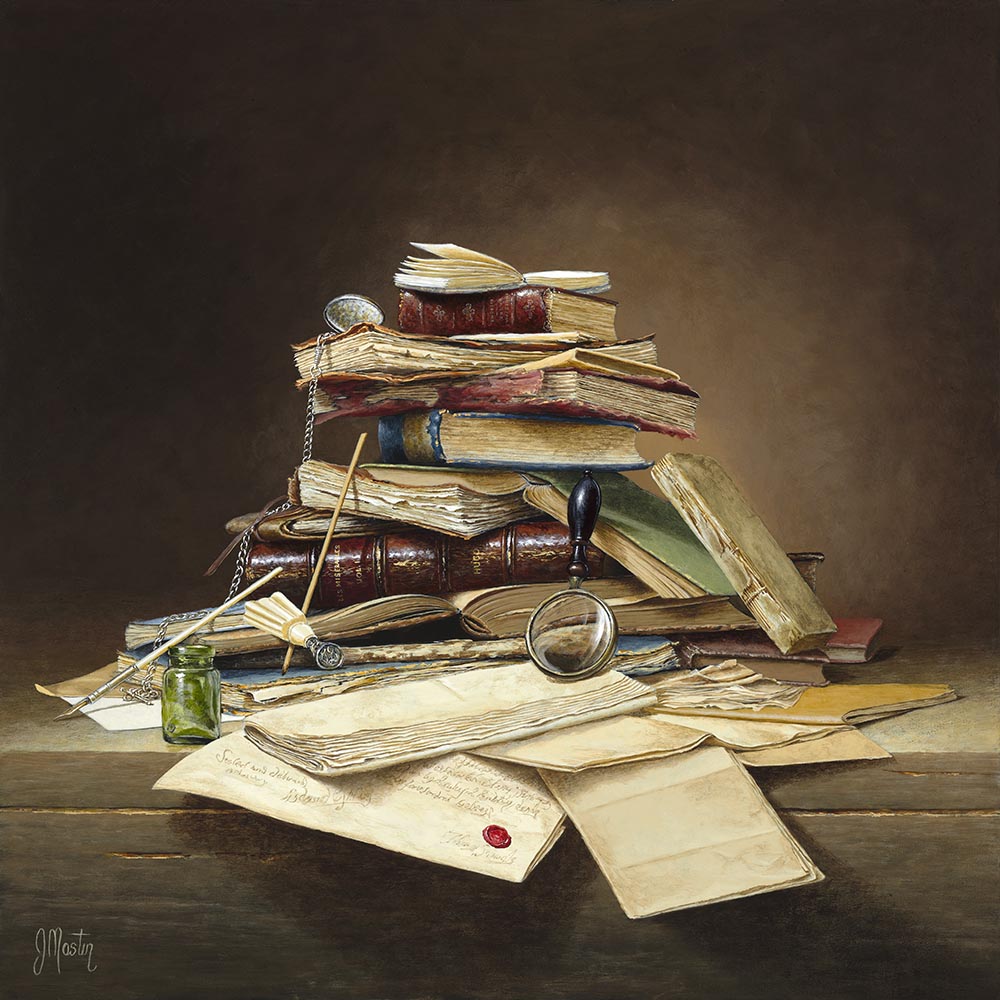
Another Story Must Begin
Your wife gave you a set of watercolour paints. How has her support and encouragement influenced your work since then?
My wife Eleanor is without doubt my best support and most honest critic of my work. Sometimes, when I have been working many hours on a piece and struggling to complete it, I am aware that I have become too close in the minutiae of it to see just what is lacking to bring it to life. I then ask Eleanor what she thinks of the new ‘completed’ work - hoping she will just love it so I can move on. Invariably she will pause, then observe a very basic aspect of the painting that I had missed but becomes obvious once pointed out. In my exasperation I rarely appreciate the extra work at the time, but I know she is right and her open, uncomplicated view is a tremendous asset for me - a genuine muse.
What extra have you been doing during the pandemic?
Recently I have launched a limited, edition reproductions (which are available on my website). and new works are added to this collection regularly.
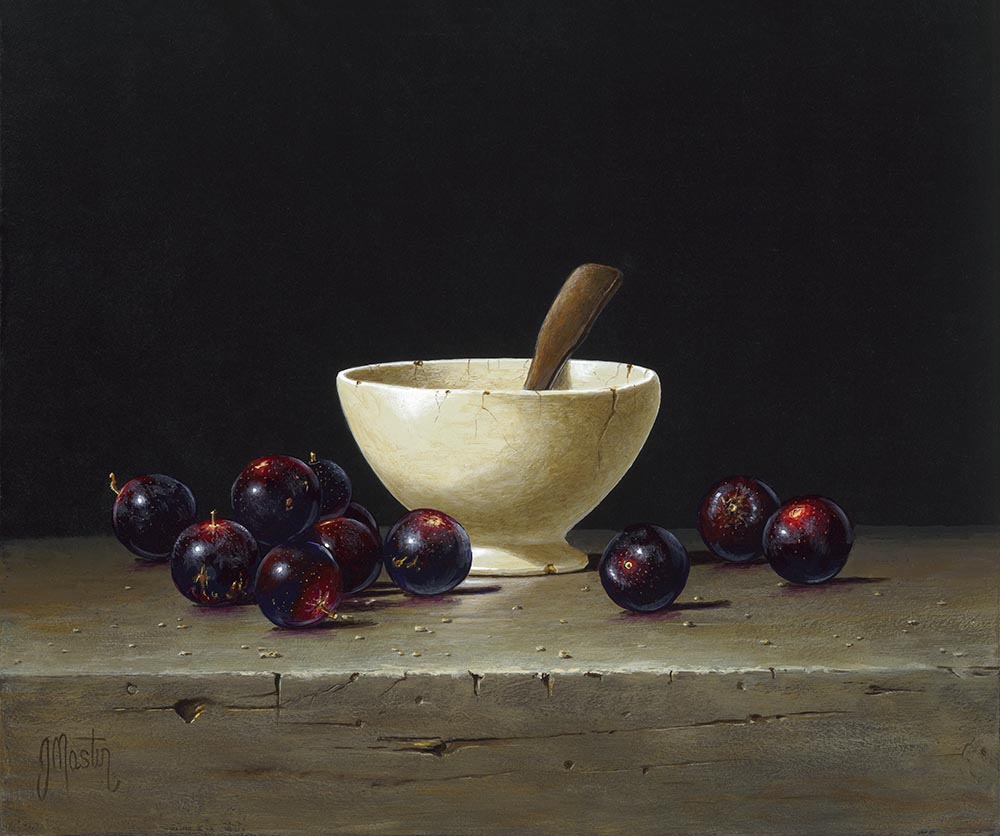
Muscadines Around a Bowl
Contact:
Ian Mastin
Deborah Blakeley, Melbourne, Australia
Interview by Deborah Blakeley, September, 2021
Eileen Braun
How did Spruill Arts help you to establish the direction you wanted your art to move to?
After 2 years of concentrated encaustic wax development, I felt I was ready to introduce my new cohesive body of work. I approached Spruill Gallery Director Jennifer Price. Her enthusiasm for the work I presented gave me the confidence to push myself and fill the gallery (1,300 sq Ft). Mounting a solo show allowed me to visualize the unifying theme of my work.
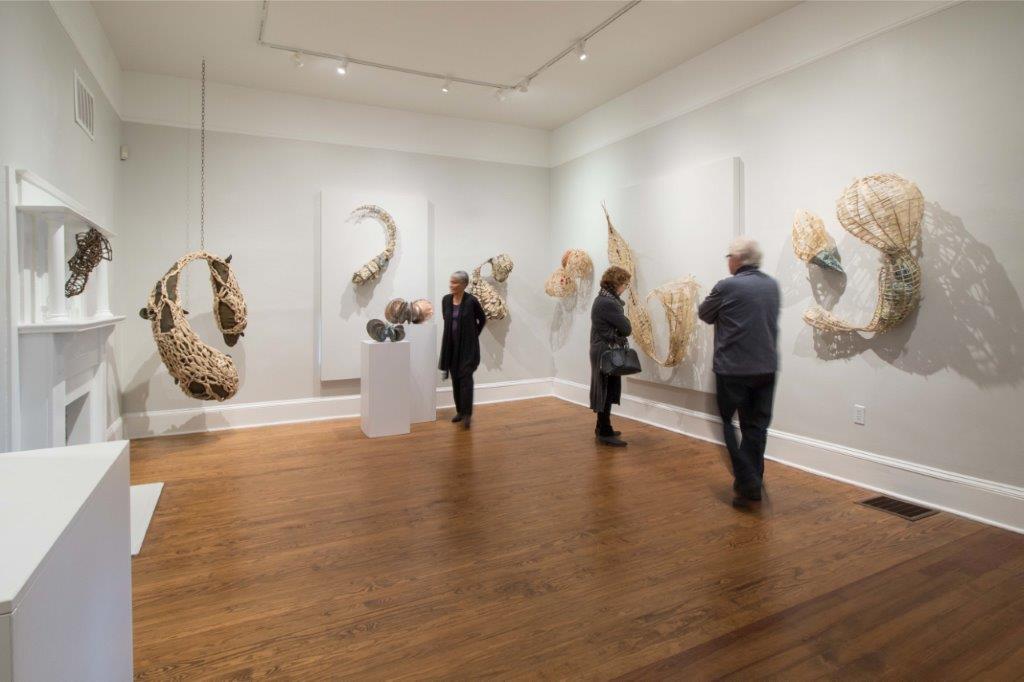
Spruill Gallery Interior: Peopled. Questionable Origins Exhibition 2020, Atlanta GA
How have you been able to use your time as executive director of the Croton-Cortlandt Center for the Arts (C.C.C.A., Westchester NY 1990-96) and manager of the gift shop at Spertus Museum of Jewish Heritage (Chicago, IL 1996-2004) to understand how to put your art work forward?
Working as a liaison between artists, gallery and collector prepared me to present myself for a career in the visual arts.
In 1990 our family relocated to the New York City suburbs and I took on the job of Executive Director of a very small arts center. Three classes! By the time we relocated once again (1996) The center had grown to 80 classes and 3 exhibition pop-up spaces - one in a large shopping mall. The innovative pop-up shopping mall gallery was staffed by the contributing artists. Placing the gallery in a shopping mall made it accessible and comfortable to viewers of all ages who had never been inside a formal gallery setting. The gallery’s story was covered in the NYT! We relocated the gallery within the mall to un-leased space every 3 months and called it “Art Moves”. I learned a great deal about mounting an exhibition and the huge amount of work that goes into the task of a successful gallery. I so appreciate the complexity and hard work of galleries that now promote my work.
Through my experience creating and managing the CCCA’s 3 galleries I acquired the knowledge of what I believe galleries look for from an artist.
- A defined consistent body of work.
- Technical proficiency.
- Resume built of exhibitions and completions- awards are a nice extra.
- Quality photography.
Can you give us a brief history of your arts progression?
I stumbled into working with clay (1988-90) at a local college. It was the only class that fit into my schedule and the medium I had not tried while completing my BA in Art and Art Education at Indiana University.
I fell in love with everything about clay. Of course, I also relished time spent with adults who felt the same passion for art making. On a lark, I took some of my fired vessels to a fine craft gallery. They bought every sample I brought and ordered T-shirts similar to the one I was wearing.
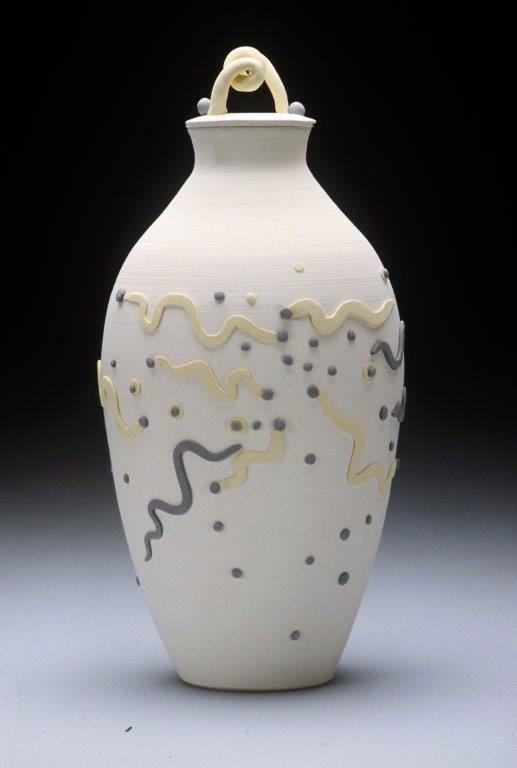
Early work Image. Untitled Vessel Ceramic 13”H X 5.5” W. Wheel Thrown with hand colored clay embellishments.
You worked in ceramics but in the last few years you have moved from clay. Why?
I returned to clay in 2004, after several more arts related jobs and relocations setting up a studio in my Atlanta Georgia home. I auditioned several clay bodies before choosing porcelain – actually, it was more like porcelain chose me. I fell hard for the qualities exclusive to porcelain : creamy smoothness, bright white body and luster when fired. My training in clay is mostly self-directed. Research and a huge amount of experimentation= failures. I pushed and pleaded with the porcelain to break rules. I incorporated wheel throwing, hand-building, sprig molds, adapted new techniques and made my own tools. Because of the temperamental qualities of porcelain clay, I had to babysit the work constantly. Porcelain is known for its wayward cracking, slumping, shrinking and collapsing. Visiting my family long distances away became problematic. I became fearful of dire construction faults that might transpire in my absence from the studio. I came to the conclusion something had to change.
After 12 years of working in clay I went cold turkey from making any art for one year. I did not go into my studio but to grab a new sketchbook and pencils. I drew a lot. Visited museums, galleries and visited artist studios seeking a new medium.
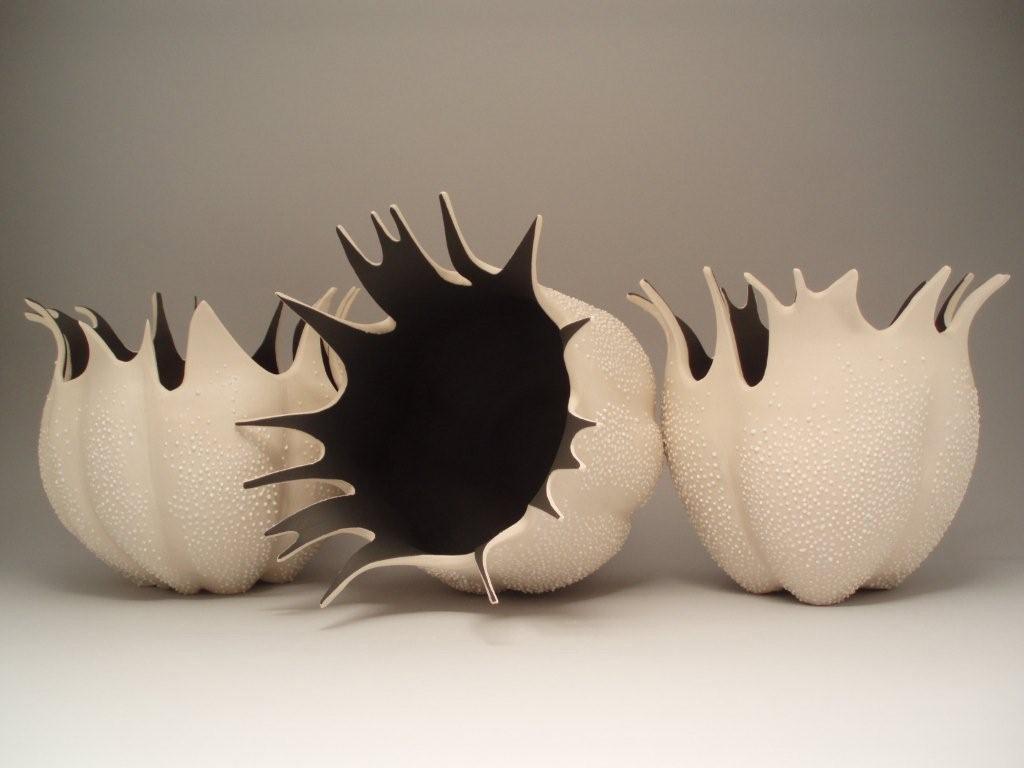
Splash Bowl Series 2014-2016. Porcelain. Vary in size 6-11”H x 6-11” W. Wheel thrown and altered with low fired glaze
Can you give us the top five things you knew you wanted your art to be for you personally?
FIVE OBJECTIVES FOR MY NEW MEDIUM
- Size & weight: I did not want my materials to limit my sculpture. Now I just need to be careful they fit through my studio door and into my car.
- Physical material strength: I sought out materials that would be more reliable and forgiving than clay throughout the construction process.
- Freedom: I wanted the ability to walk away from my studio for more than 5 minutes.
- Health: No more 25# bricks of clay to tote up and down stairs. My current concerns are to simply keep the overhead fans on and window open while working with the potentially toxic molten wax fumes.
- Supplies & Tools: I was not looking for a huge financial investment. Well, I almost got away with this one. Encaustic wax can be expensive.
Jasper Ware Teapot 2016. Porcelain. Wheel thrown, stacked, altered with sprig embellishments and low fired glaze
Can you share with us some of your early attempts with Encaustic wax?
In 2016 I transitioned to a paper mâché like material utilizing recycled materials. It felt a bit like clay with benefits. When my first successful forms were completed, I sought to address their surface. All attempts I felt were failures until I came across an exquisite encaustic wax painting at the Broad Museum (LA, CA). I was blown away by possibilities: Smoky, opaque, translucent, transparent, rough, smooth, shiny, matte, transformative and its ability to conceal or reveal!! And OH!! That awesome honey fragrance. I took a one-week class with encaustic wax sculpture Miles Conrad in Tucson AZ and I was in a state of artful bliss.
As I mentioned previously, I enjoy researching. I pride myself in making work that becomes unique in my hands. Experimentation is supreme and BIG FUN. Have I mentioned that my husband’s career is in the sciences? My days are filled with hands on creative “what ifs”. Evenings are conversations of safe possibilities combining materials. My studio shelves are like many artists, a pallet of cast offs to be repurposed. All kinds of string, threads, natural materials from dried organic vegetation to cast off clothing whose nubby fibers intrigue me and industrial construction materials. I so enjoy a jaunt through a hardware store!
My use of rattan reed was a happy cross pollination. I came across a box of reed stashed away for use as teapot handles. It had all the inherent good qualities for wax absorption and the bonus to transform shape. I used it first on my sculpture “Nesting Instinct”. Then I just went to town seeing what might happen next.
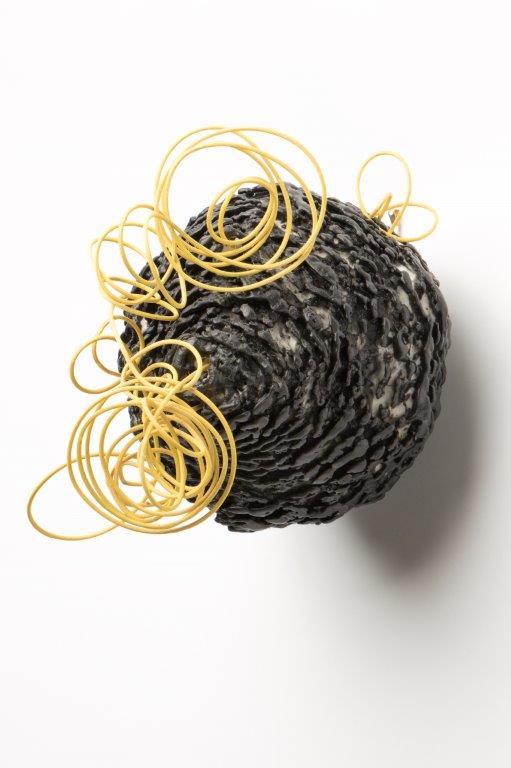
Nesting Instinct 2017. 14”H X 14” W X 14” D. Encaustic wax, Recycled paper, Adhesive, Rattan reed and paint.
My next “Aha” moment was viewing an exhibition at R.A.M. In Toronto Canada. I viewed an exhibition hall filled with ship models. Many had their hull bracing exposed to reveal the construction technique. There were more than historic salesman models on view. This collection displayed vessels of all sizes constructed by French POWs of the 1803-1815 Napoleonic Wars. The prisoners used whatever they could lay their hands on to build with. Bleached bones from their meager meals, threads from their clothing, pebbles and wood from their cell walls- talk about being creative with materials! These were my people!
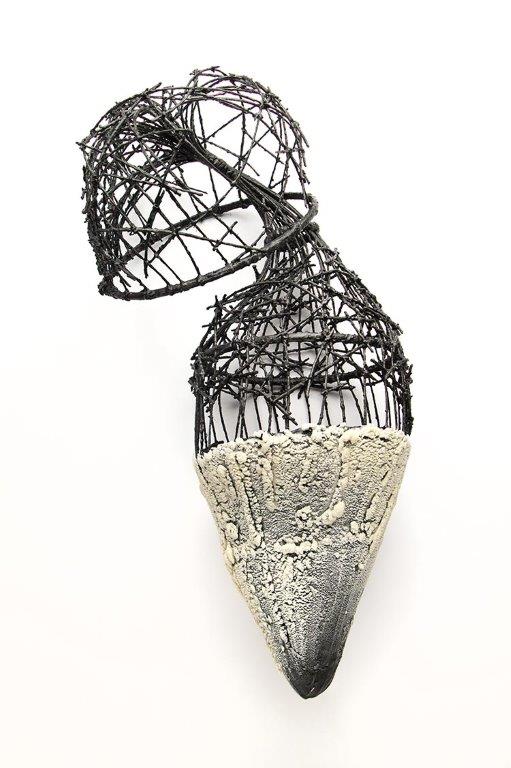
Turning Point 2017. 44”H X 16” W X 14” D. Encaustic wax, Rattan reed, Fabric, Cotton string, Adhesive and Wood stain.
Discuss the OHS needed for using wax in Encaustic work.
Miles taught me the safety guidelines for working with encaustic wax. Ventilation being foremost, no flammable work surfaces, proper safety attire: eyewear, gloves, long sleeves. I learned what materials can be safely combined with the wax for absorbency and stability.
Ecaustic wax has been used since the 5th century B.C. By Greek artisans. That being said there are rules to abide by such as routinely heat setting and allowing the work to cure. Yes, the wax will melt if exposed to extreme heat (200F or 93C) but one has bigger things to worry about if your art is exposed to an environment whose temperatures exceed that.
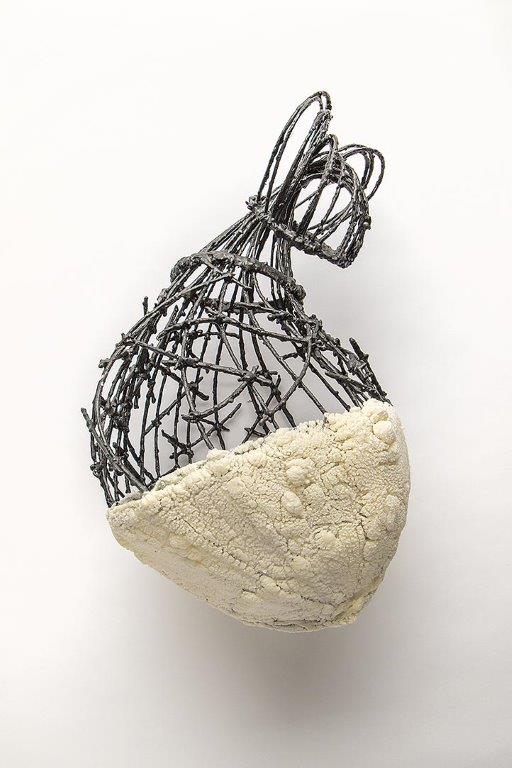 Set Free 2017. 26”H X 15” W X 13” D. Encaustic wax, Rattan reed, Fabric, Cotton string, Adhesive and Wood stain.
Set Free 2017. 26”H X 15” W X 13” D. Encaustic wax, Rattan reed, Fabric, Cotton string, Adhesive and Wood stain.
Shadows are especially important in your final exhibiting of your work – discuss.
Shadows are cast by the animated gestural forms tethered to the wall. These shadows soften the hard lines and enlarge and deepen the work while expanding the power of the object. I have created the object, but the object has liberated itself and gone beyond. My hope is that the when approaching the viewer will be drawn in by the relaxed floating form; then intrigued by the ever-changing views of the work – seeing both through and around simultaneously.
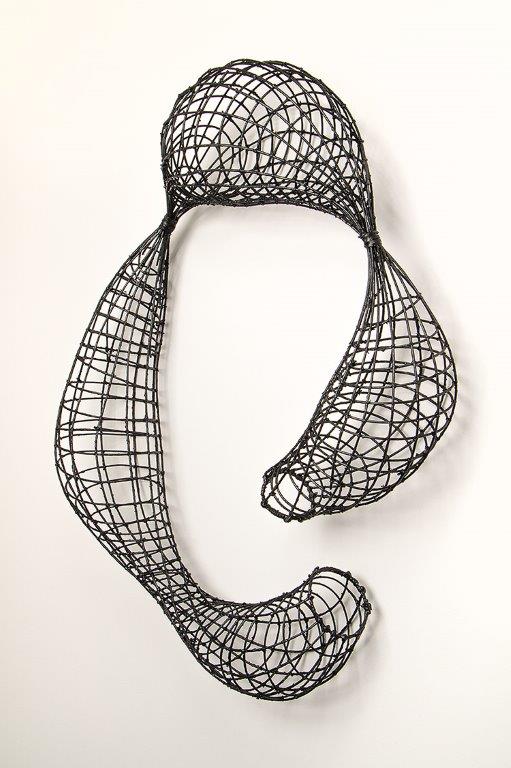
Smoke 2017. 62”H X 48” W X 19” D. Encaustic wax, Rattan reed, Cotton string, Adhesive and Wood stain.
What concerns do you have about the fragility of your work?
None at present. Hurrah. Other than someone inadvertently sitting on my work. My sculptures are very strong because of my unique construction process - they are not woven- more like spun.
Comment on how you trick the viewer into see your work as metallic.
Um. It is a trick of sorts. Thank you, Rumpelstiltskin. My work that is enrobed in black encaustic wax also has a fine mica dust mixed into the molten wax. My iron and copper patinas are created with a layered combination of specialty paints and encaustic wax.
Pretty amusing to see me lifting a HUGE sculpture one handed from out of my car transporting it into a gallery. I get lots of stares and often someone rushing in to assist me. Love it.
Oh, and may I also add that my father’s occupation was testing metallurgical samples-by x-ray. In many ways my sculptures can be seen as exposed metal skeletal hulls.
What other materials are you use currently?
Experimentation never stops with me. Yes, I use that word a lot too. Recently I added dressmaker’s pattern tissue to my forms. Another material that sat on my studio shelf awaiting transformation. I appreciate the tawny color, texture of the paper with its printed instruction guides of dots, lines, and arrows. I started with adhering the paper flat, similar to its use on an Akari Lamp Shade. I have since pushed onward to a form of Guerilla Knit Bombing, Folding and now Brooming - my own term of bunching and tying- my current focus. The paper has so many potential applications. Some serious while others playful. Very exciting.
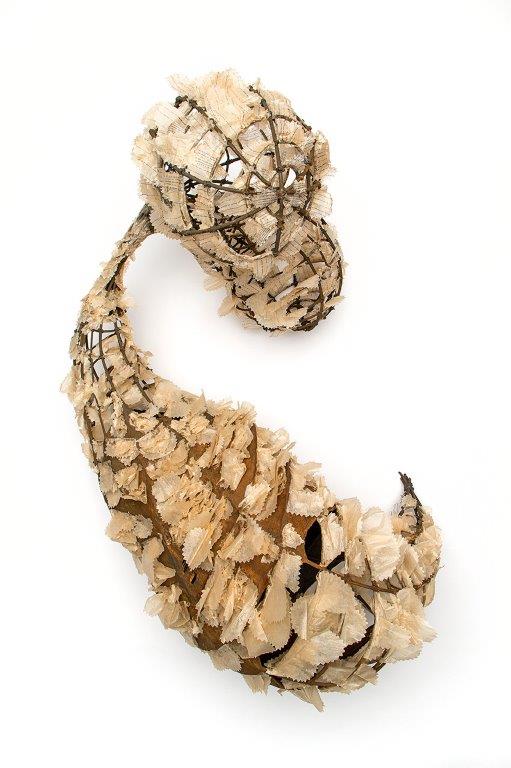
Swoosh 2018. 35”H X 37” W X 23” D. Encaustic wax, Rattan reed, Fabric, Cotton string, Adhesive, Dress maker’s tissue and Specialty paints.
Discuss the preplanning of your work that you know is necessary before beginning.
Sketching a piece is a very important meditative phase. I see my work as architectural and gestural. Through drawing I first define the shape I am attempting to achieve. Then I devise the most efficient way to construct the form. Some of my work is like building a ship in a bottle. I seem to be building the inside and the outside simultaneously. The next phase is to visualize the finished size. It is here when I select and prepare the appropriate gauge reed for strength and then soak my materials 24-48 hours.
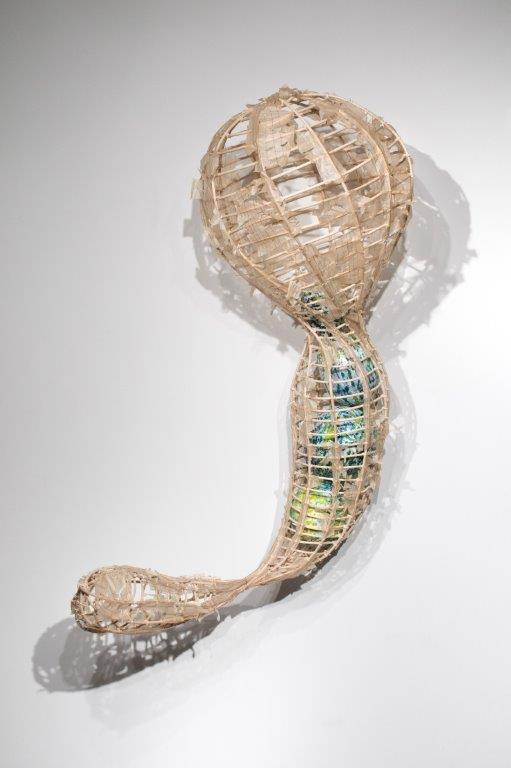
Fertile 2019. 51”H X 32” W x20D. Encaustic wax, Rattan reed, Cotton string, Adhesive and Dress maker’s tissue.
Can you take us briefly through your process?
Referring to my sketch I wrestle the reed to conform to the desired shape with clamps, I then tie off each junction with cotton string. When fully formed I glue each intersection then trim the form. From this stage the work might be left bare, or painted then enrobed in encaustic wax or the reverse. I carefully heat set the wax in stages.
You comment, “Movement, texture and complexity of form are integral.” Expand on this comment.
May I also add deceptively Effortless?
My own favorite sculptures are the ones that appear “effortless” or natural and organic- not forced. In reality those are the most complex forms to attain and their resolution the most rewarding. A little game I have is to question myself...
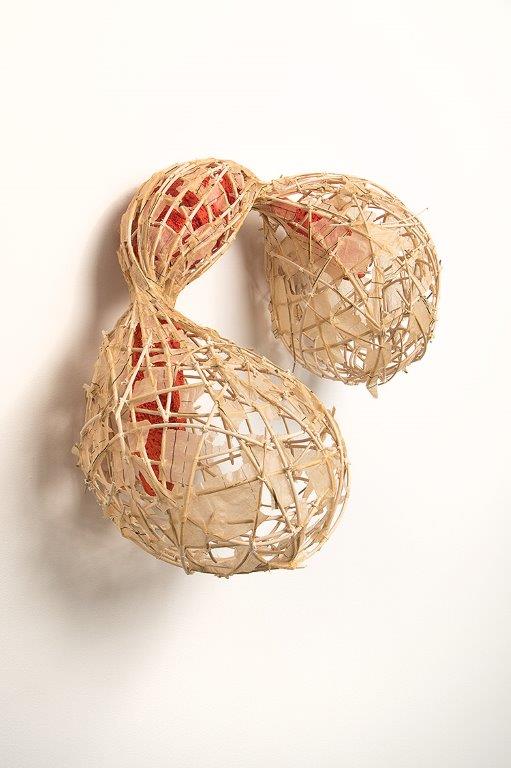
A Float 2017. 32”H X 21” W X 15” D. Encaustic wax, Rattan reed, Fabric, Cotton string, adhesive and Dress maker’s tissue
“What are my limits in complexity and design while still appearing natural and organic?”
“How can I entice the viewer to remain scanning the form so that both the sculpture and the experience is fluid with continued small visual revelations?”
“How does my choice of materials and texture effect the nature of the form?”
I have come to see there are distinct qualities connecting my sculptures that emerge from my hands and psyche, no matter what the medium.
- Playfulness- positive, quiet and unexpected.
- Gestural movement-caught in motion.
- Organic-very much alive and at peace.
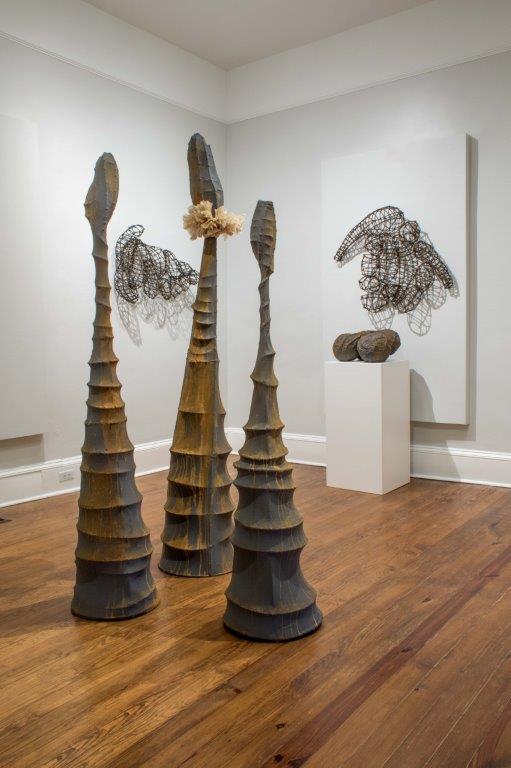 Early work Image. Untitled Vessel Ceramic 13”H X 5.5” W. Wheel Thrown with hand colored clay embellishments.
Early work Image. Untitled Vessel Ceramic 13”H X 5.5” W. Wheel Thrown with hand colored clay embellishments.
Contact:
Eileen Braun
#EileenBraunArt
Deborah Blakeley, Melbourne, Australia
Interview by Deborah Blakeley, April 2021
Nicole Ayliffe
Can you discuss how you have been influenced by the Australian Glass community?
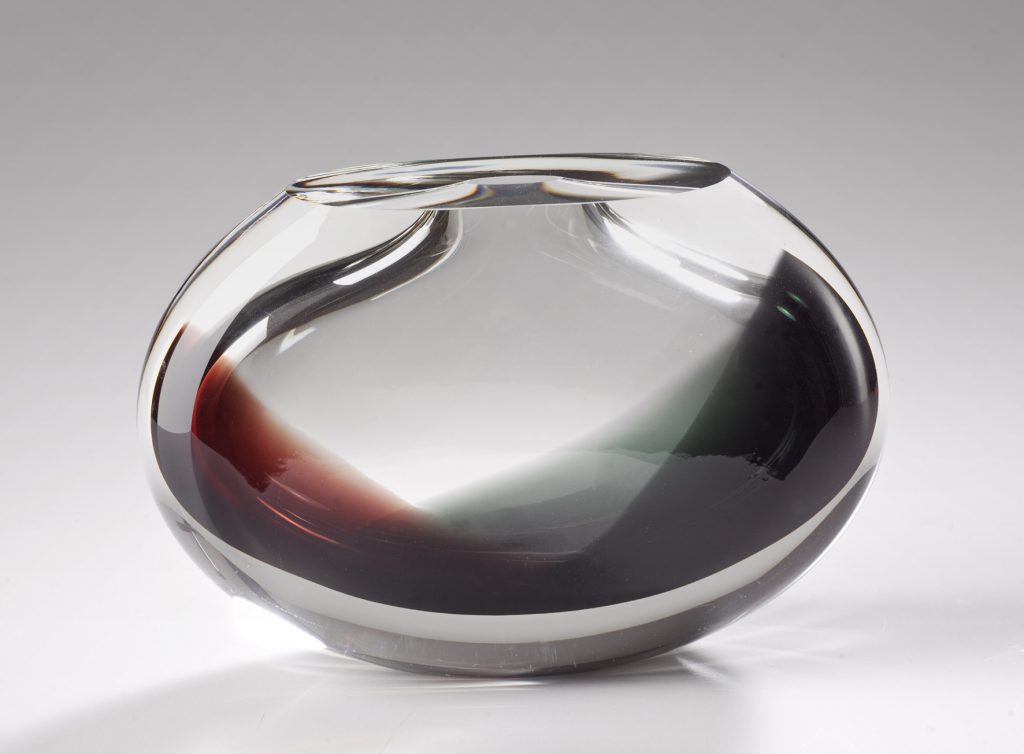
'Seasonal Landscape' Autumn
We are lucky, in South Australia to have such a vibrant, inclusive glass community. It is also very fortunate that the University of SA is right next door to the Jam Factory, so it is an easy transition once you’ve finished your degree, to start making work in the Jam Factory glass studio. We are also very lucky to have Gabriella Bissetto as our head of glass at the University of South Australia. She was such a positive influence when I first started working with glass and I really love her enthusiasm for the material.
I also share ‘The Ware House’ studio with six other artists, five of which are glass artists. It’s such a great environment to work in. We all get along well, we discuss ideas, offer feedback on new work and I find it beneficial to my practice. We also have it set up with a cold shop, so everything apart from the blowing process is done there.
Discuss photography and glass and how you combine both?
I studied both photography and glass during my university degree, so it seemed only natural to combine the two things I love together. I was lucky enough to learn about a gel medium technique that my photography lecturer discovered and through experimentation I realised that this could be applied to the glass surface. The combination of these materials led to my ‘Optical Landscape’ series,
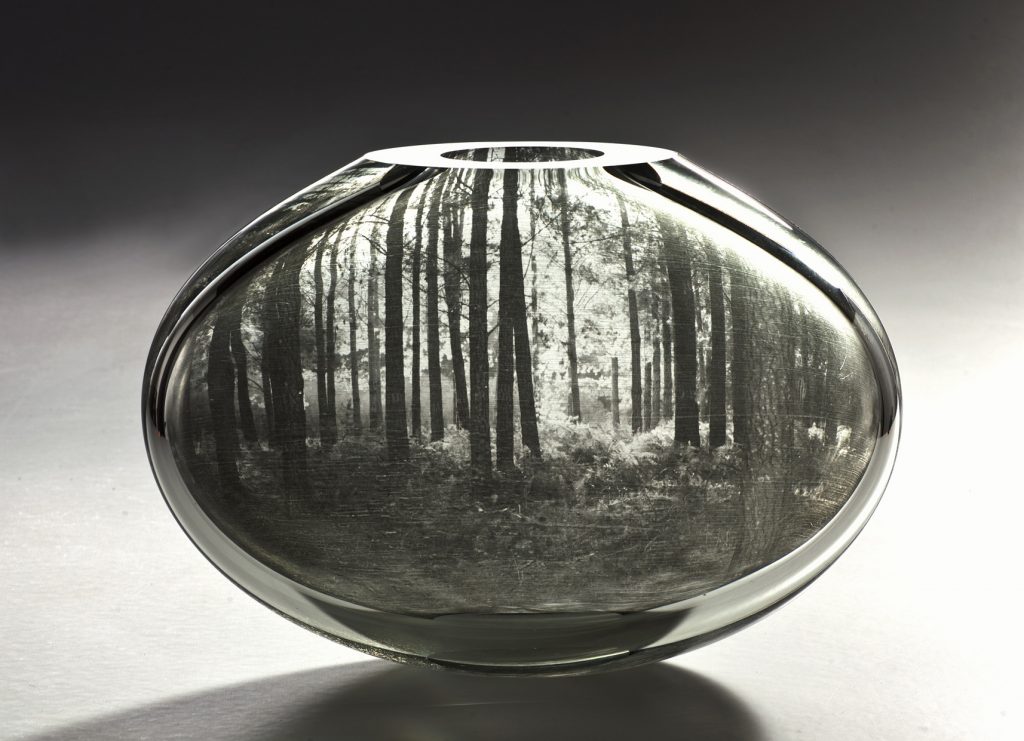
'Optical Landscape Photographic Series, Forest'
I combined black and white photographic images on the back of thick clear glass forms. The changing thickness of the glass creates some beautiful optical effects when viewed through the front of the form.
Then in my Honours year I changed to creating images from my glass forms. This was done by carving lenses into thick clear glass forms and then taking these forms into the photographic darkroom and creating and capturing images of refracted light. This series was titled ‘Optics and Light’.
I have continued to create multiple series of works expanding and exploring a variety of techniques. The combination of imagery and glass is still front and foremost. My latest series of works titled ‘Optical Landscape engraved series’
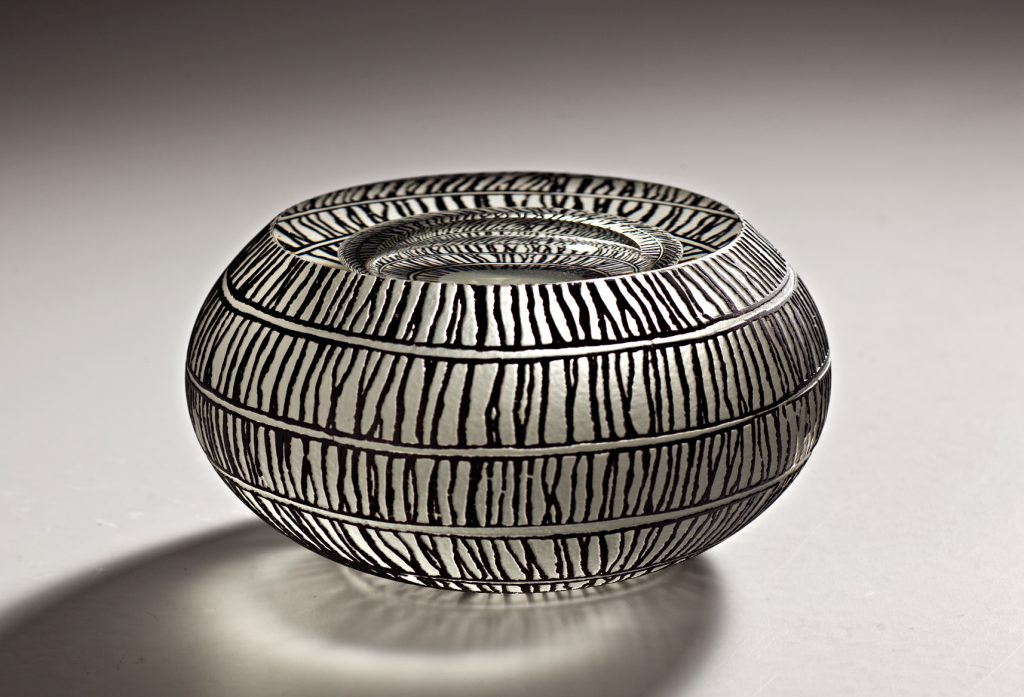
'Optical Landscape Photographic Series, Forest'
still combine imagery of the landscape, but I have chosen to engrave these patterns onto the glass surface. These forms still utilize the thickness of the glass creating reflection and magnification of the imagery.
Why do you call some of your glass ‘Optical Landscape’ glass art?
I have always been fascinated with the optical qualities of glass. In my ‘Optical Landscape Photographic series’ the thickness of the glass gives the illusion of space and the glass acts as a three dimensional optical lens through which you can view the black and white photographic image, when viewed through the front of the form. Alternatively my ‘Optical Landscape Engraved series’.
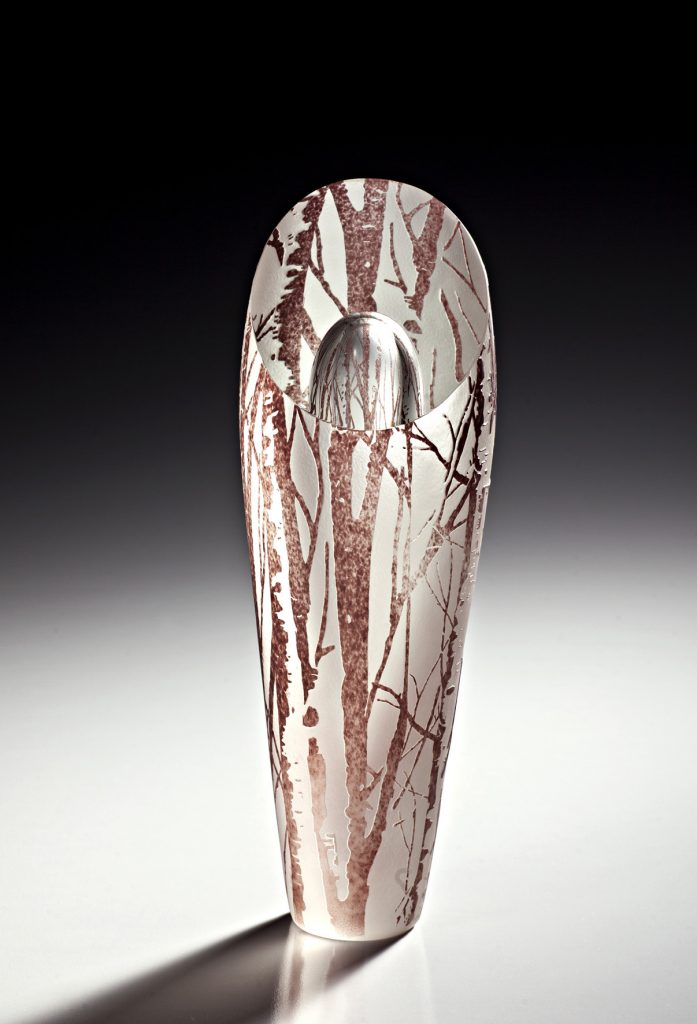 'Optical Landscape Engraved series' Leaf
'Optical Landscape Engraved series' Leaf
I have a cut and polished window, which allows you to view the interior space. I love the way the solidity of clear glass form and the curves of the interior bubble highlights the natural qualities of reflection, distortion, movement and space within each glass piece, creating its own interior world.
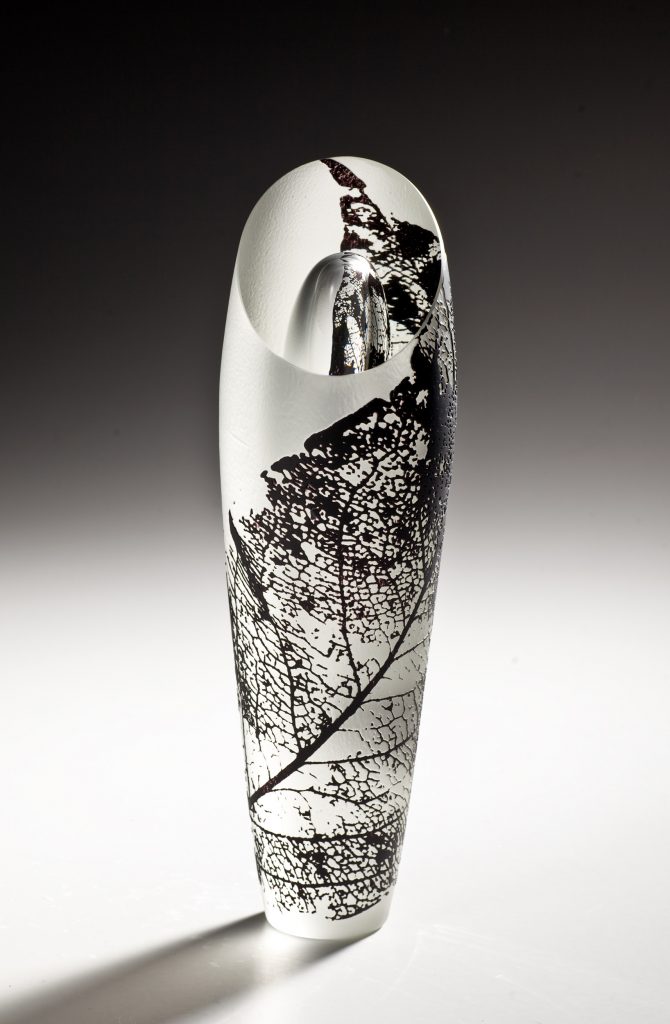
'Optical Landscape Engraved series' Leaf
Many have heard of SOFA, can you tell us what it is like to have your glass exhibited there?
It was such a huge honour to have my work exhibited at SOFA multiple times by Glass Artists Gallery also later by Kirra Gallery. I was also fortunate to be able to go over for the exhibition twice. It’s such an amazing experience being surrounded by so much fantastic artwork. It was quite surreal to see first hand, the artwork of many of the artists that I had studied while at University, as well as meeting some of the artists themselves from all around the world.
You have exhibited your glass art around the world. Can you take two places that have propelled your career and why?
Glass Artists Gallery in Sydney would have to be the main gallery that supported me right from when I first finished my degree in 2005. Maureen Cahill took my work both to SOFA Chicago and Collect London in 2006, 2007, 2008 and 2009. She also represented my work at Art Taipei, Taiwan 2006, Glass Weekend, Wheaton Villiage USA 2007 and Art London in 2008. It was through this international exposure that I made many contacts with galleries from around the world, who then exhibited and continued to sell my artwork.
Discuss your use of colour in your glass.
Single colour
Multiple colour
The majority of my exhibition work over the years has been in black and white. I like the stark contrast and simplicity of a minimal palette, although recently I have been exploring using colours from within the landscape to enhance the imagery I have been engraving. An example of this is in my recent exhibition titled ‘Seasonal Landscapes’ at Beaver Galleries, Canberra.
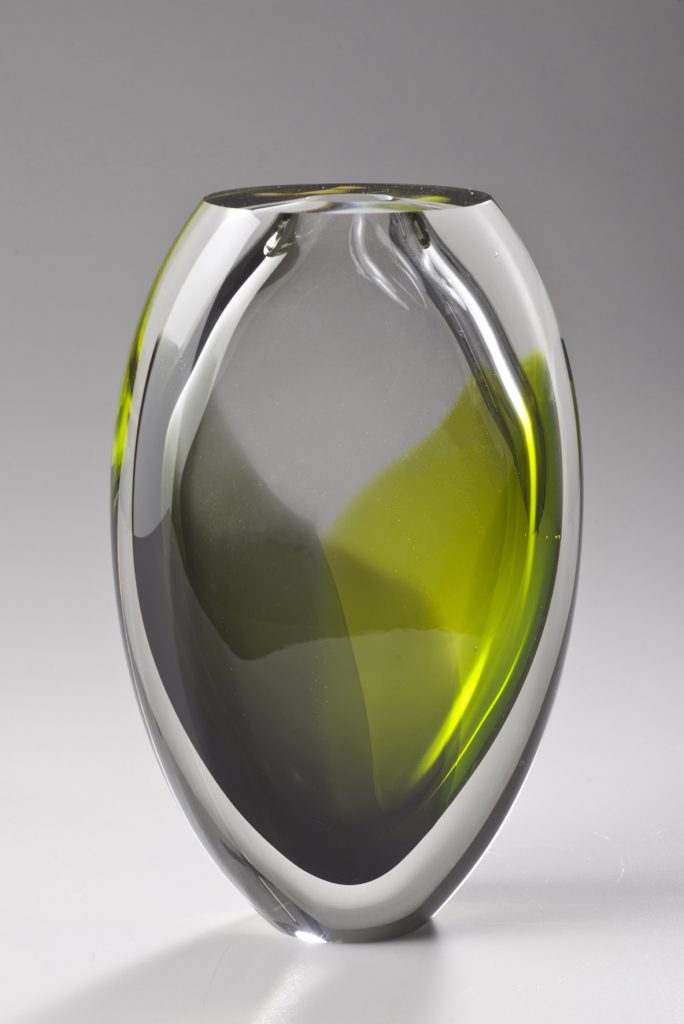
'Seasonal Landscape' Spring
Here colour has been used to enhance the decorative nature of the surface patterns of my engraved pieces, and in my latest work based on the seasons within the landscape, I have used colour in the interior of the piece. These are designed to have the same qualities as a watercolour painting, where two transparent colours blend together and overlap each other.
How are you currently using the seasons to develop your glass with colour?
Since we bought a farm in the hills 2 years ago, I have really noticed the change in the colours of the landscape from one season to the next. We have a fabulous view across rolling hills and valleys and its remarkable what a difference there is in the colour palette, between the lush green colours of spring, compared with the browns and tans of autumn and the blues of summer skies. It has made me a lot more in tune with using colour to express landscape.
Do you find colour is heavily dependent on interior design?
Not really….
Where did you get your inspiration for the series, ‘Moments in Time’?
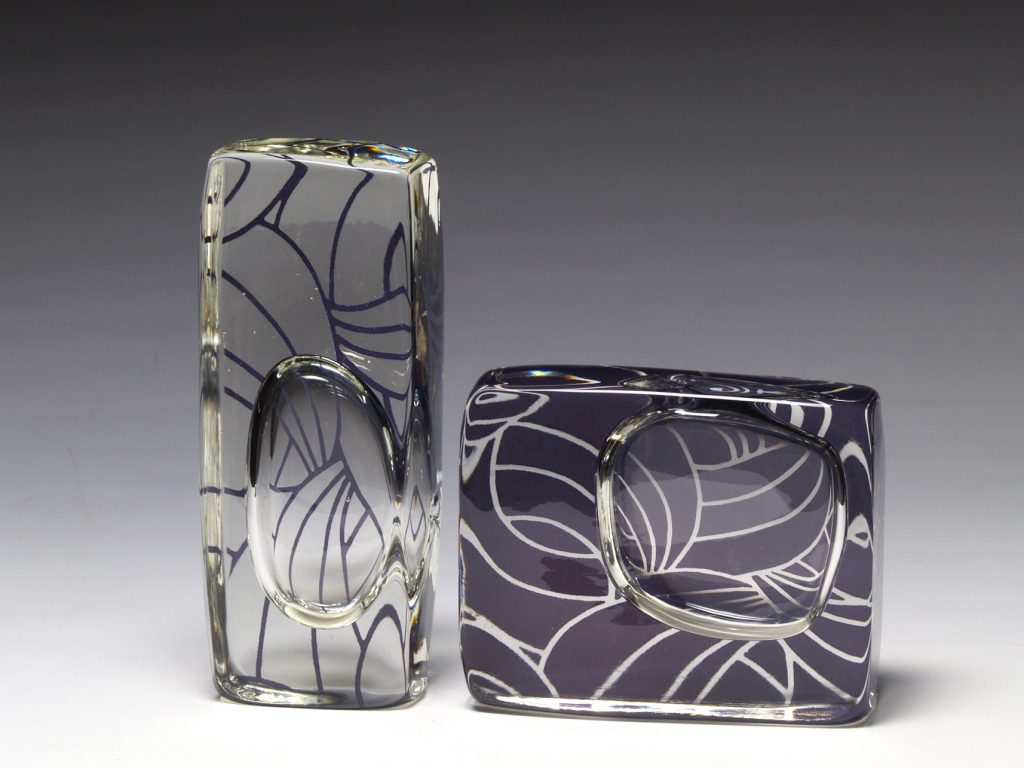
'A Moment in Time' The Master Bedroom
This series of works stem from my memories of my grandparents house on Kangaroo Island, where I spent my holidays as a child. Each room in the house was covered in different wallpaper patterns, and it was these patterns that I translated onto glass forms. The optical qualities of glass continued to be the foundation behind the forms. The transparency of clear glass, the solidity of the form and the suspension of the bubble, suspended as a moment in time. The bubble acting as a lens, magnifying the memories and capturing an essence of my childhood. The rectangular forms acted as a fragment or segment of the past, framed within a three dimensional space, which when placed together read as a story of captured moments in time.
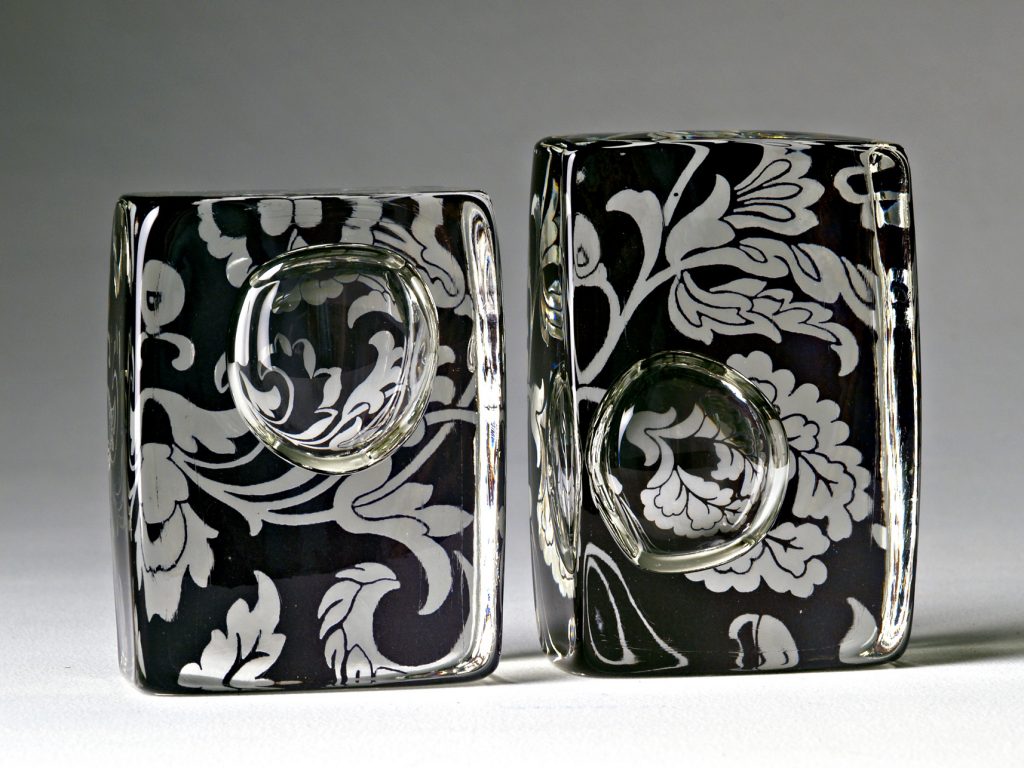
'A Moment in Time' The Tapestry Lounge Suite
Comment on the commitment of time needed for a solo exhibition.
I find that I am constantly designing and creating new work in my head, so I find that being given a deadline for a solo exhibition gets me motivated to actually make my ideas come to fruition in a three dimensional object. Having said that, it always takes a lot longer to create exactly what I have imagined, so it doesn’t seem to matter if I have a year to make the work, it always seems to come down to a rush at the end. I am a perfectionist in my work, so I am always striving to make the work better and better, so without a deadline, I would probably never be finished!
How has the pandemic effected your work?
It was initially a bit scary when everything was shut down. Galleries were closed and exhibitions were cancelled, so my income became almost non existent. The JamFactory also shut down, so couldn’t make any glass work either. Although in retrospect, it was also a good time to reduce the pressure of filling orders, and making deadlines. Instead it gave me time to spend doing other things, which has, in turn, led to creating new designs and new work. Recently it seems that galleries and online sales have been going very well and people are supporting local artists. This is reassuring and I am enjoying getting back to working again.
Explain how you use magnification in your glass?
Magnification and the reflection of light and imagery is particularly evident in my ‘Optical Landscape Engraved series’.
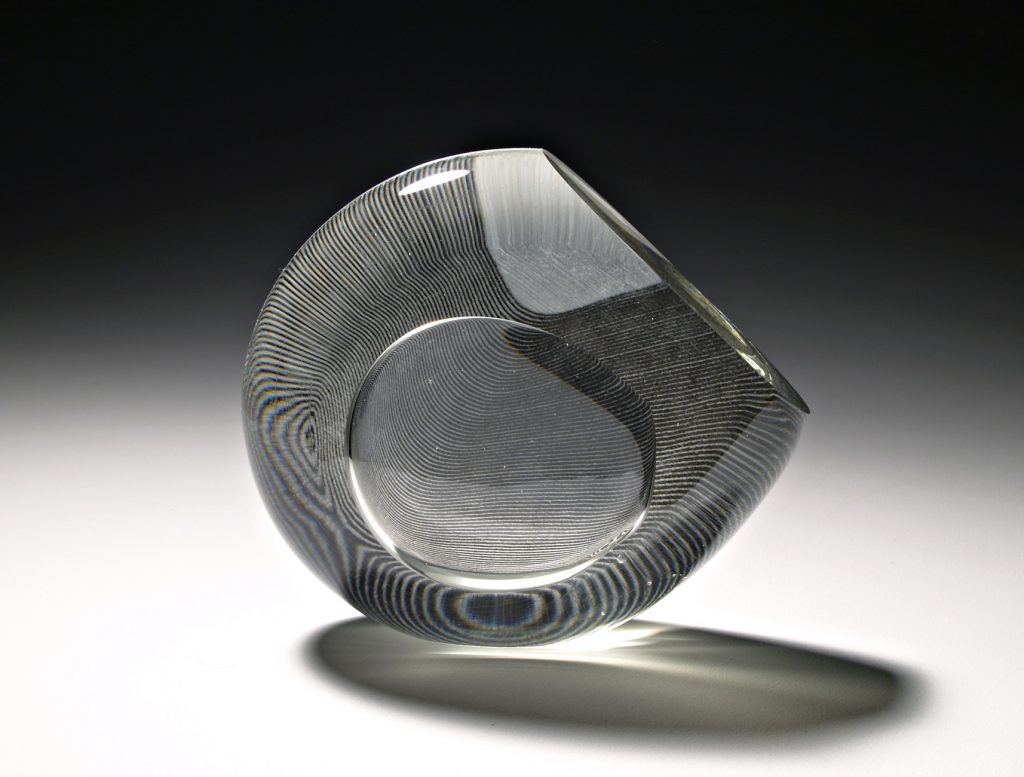
'Optical Landscape Photographic series' Field Lines
These pieces are created with such a solid amount of glass and the bubble is suspended in the middle, so when the imagery is engraved on the outside surface you can see multiple reflections of that image within the piece. The curves of the glass also highlight the qualities of distortion, movement and space within each piece.
Take one small and one large piece and discuss the pros and cons in both.
I guess the pros and cons of a large piece is that firstly they are incredibly heavy both to make in hot glass and secondly to hold and coldwork, when they can weigh 6-7kgs, so they are very demanding physically. The pros though are that you get some beautiful optical effects resulting from having that large amount of semi-solid glass and they do look spectacular when finished.
The beauty though of smaller pieces, besides being a lot easier to make, is that they draw you in to a small world that you can hold in your hand.
Discuss the importance of form and balance in your work.
Form is so visually important, especially with my work being quite minimalist.
There is such a fine line when using such thick, solid clear glass, that the pieces still have an elegance and refinement to them. I love the counterbalance between the solidness of the glass and the refinement of the delicate imagery used to describe and capture the beauty of nature and the landscape. It’s such a contrast between the two.
Contact:
Nicole Ayliffe
instagram @nicoleayliffe
Deborah Blakeley, Melbourne, Australia
Interview by Deborah Blakeley, April 2021
James Ainslie
How has the coast directly affected your painting?
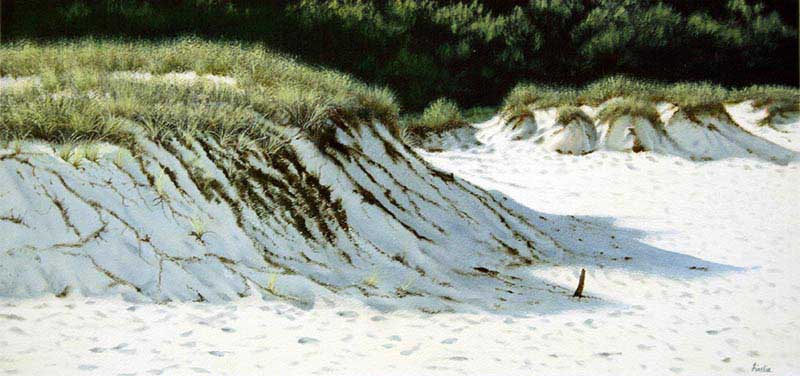
Into the Shadows, Acrylic on linen
I was born near the coast and have spent a lot of my life walking & swimming at various coastlines around Australia so it was inevitable that it had an effect on my inspiration. I get agitated if I don’t get to the coast often unless I am in my other love—the outback.
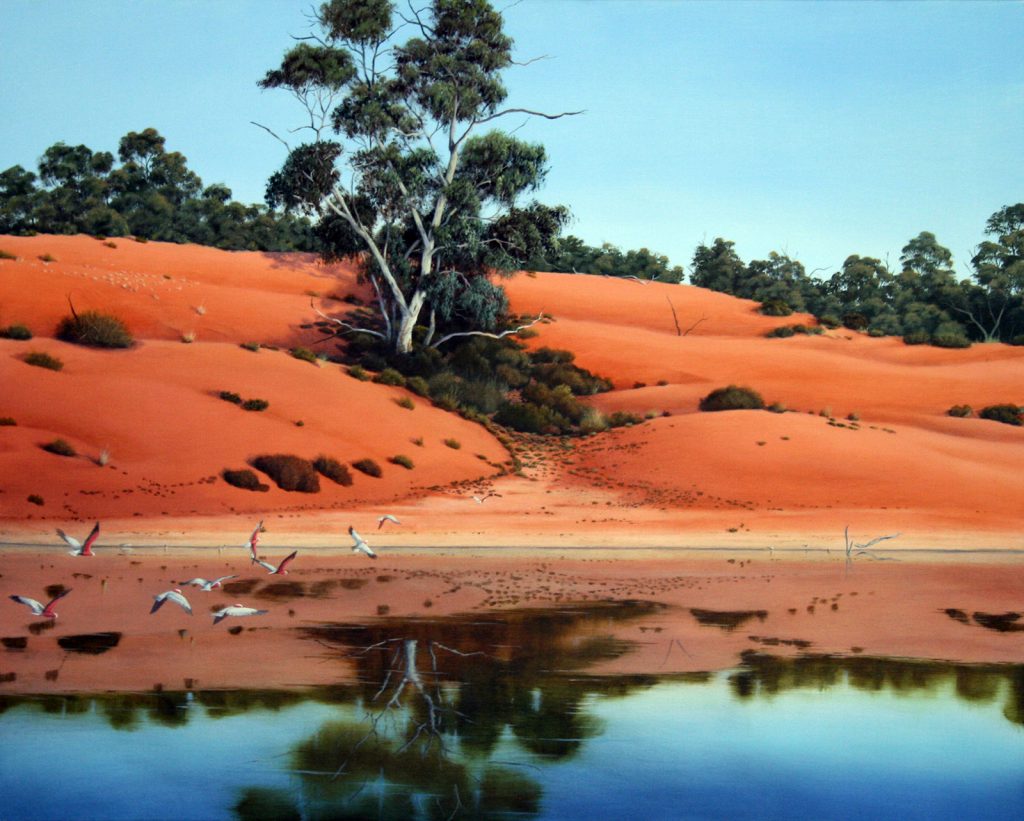
Yulara landscape 1 , Acrylic on Linen,122cm. x 61 cm
How different are parts of the coastlines of Australia?
The coastlines differ vastly around Australia. They differ in light, smell, vegetation, temperature and colour, all of which evoke images for me. The north of Australia has a vastness to it’s coastline with huge tidal fluctuations and often opalescent aqua waters that occur because of the marriage of Pindan & white sands on the shore. The vegetation is totally different to southern beaches too. You have pandanus, grasses & scrubby trees binding the dunes together & often mulla-mulla (a native flowering bush)too. In the south the beaches are often covered with low bushes & beautiful sea grasses & some have seaweed balls washing up on the beach which as kids we loved to throw at each other. Further south the beaches change again as does the light. The Tasmanian beaches are often given a dramatic grey sky to set them off & bring out the greens of the foliage.
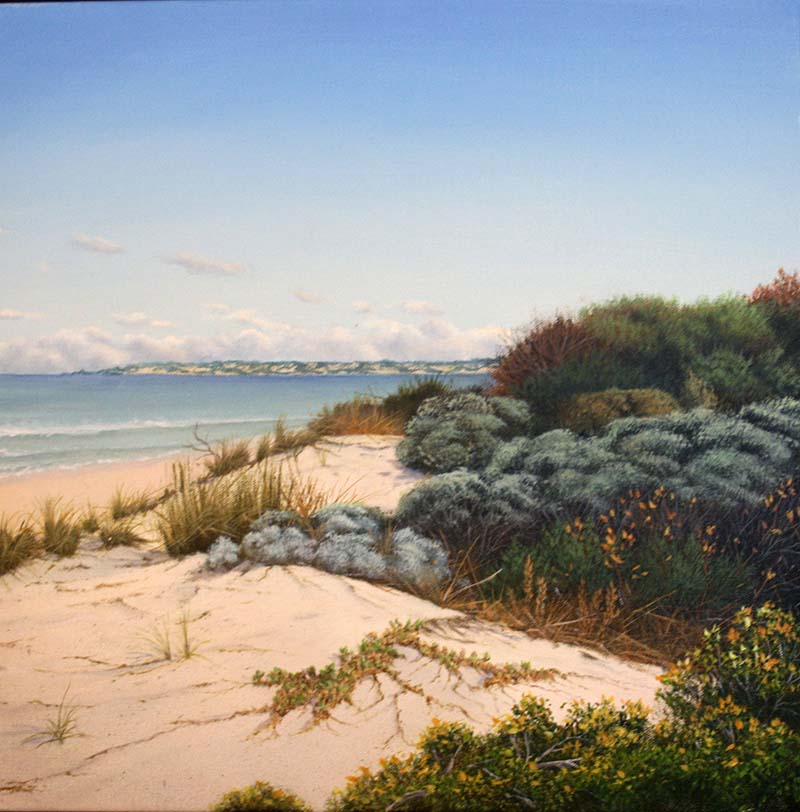
Beach Moods 3, Acrylic on canvas,45cm x 45 cm.
Show us the Australian inland in your work and discuss some of the differences in the use of colour in the work.
The inland of Australia is so diverse in its imagery, from the Flinders Ranges where I lived for a time, to the red desert country around central Australia or the sheer breathtaking beauty of the Kimberley which I visited annually for 16 years. The Flinders throw a soft blue hue ,both in atmosphere & the saltbush/bluebush that sustains the livestock. This is off set with magnificent old red gums ,rocky creek beds and the occasional rugged ,rocky gorge. The red center often brings the comment ”You’ve painted this a bit too strong or red” but you have, to spend time and visit it, to realize the depth of colour out there.
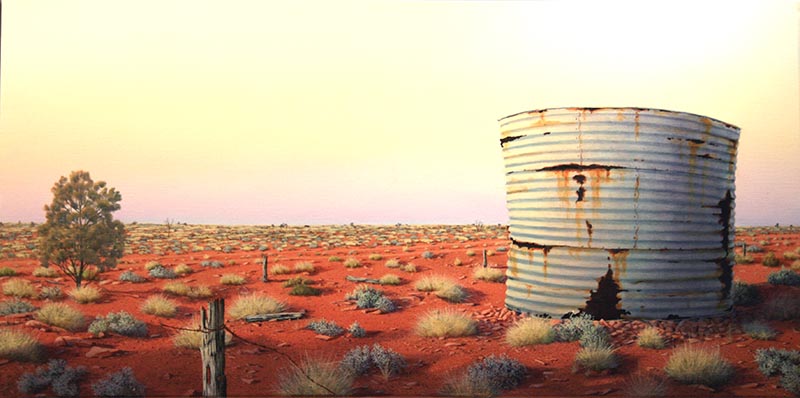
Harsh Country, Acrylic on linen, 122x61cm
In a good year after rains the contrast between the vivid greens & the red sands is amazing , added to that all of the wild flowers break into bloom .The pink and mauve Mulla-Mulla ,yellow Seneca ,vibrant magenta parakelya and the white & yellow poached egg paper daisies can cover the dunes in vast swathes. Then, there is the indescribable Kimberley ,which amazes at every kilometer travelled. The flora is unique, the skies are huge , the colours are brilliant and the size is huge. There is a painting at every escarpment, boab tree, creek bed, gorge & river, not to mention beach. Each of these places has its own evocative smell to trigger images.
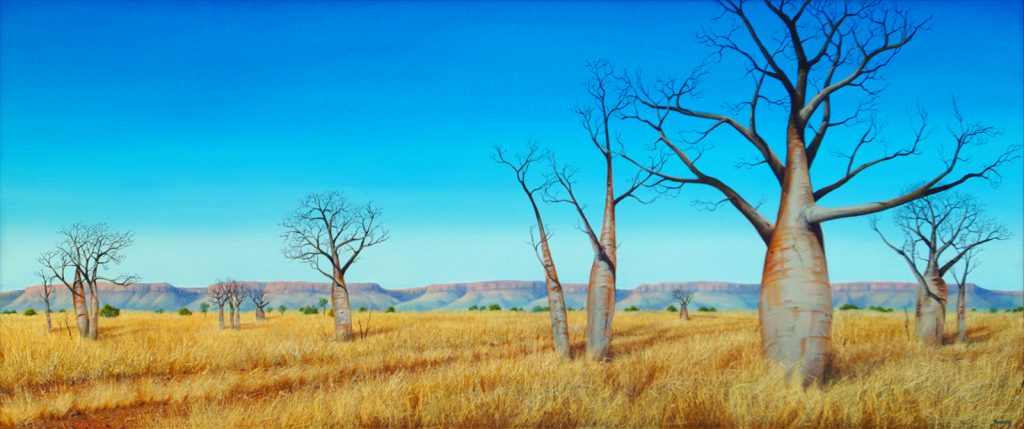
Wyndham Boabs Landscape , Acrylic on Linen,210cm. x 92 cm.
Comment on your residences in Uluru, and how this time has influenced your work.
I enjoyed my years of residency @ Uluru because despite the hype , the rock & Kata Tjuta do live up to their status. There is a lot to see out there other than just the two major attractions and the colours. Scenery and culture all add to the inspiration, there is a feeling that pervades you when you are walking in and around these places—a feeling that you are walking with the ancestors of the place.

A Little Piece of Cooper Creek 2, Acrylic on Linen,155cm x 145 cm
I happens in other areas too, like Island Lagoon.
You have work in many public companies, take one that has helped your career and how?
I’m not sure I can say that any have directly helped me in my career other than allowing me to continue painting by purchasing my work, the fact that they have seen fit to buy it does give you a mental fillip to continue painting.
Can you tell us about being one of six artists to represent South Australia globally?
Early in my career I had a wonderful gallery director (who I stayed with till she retired ) and she was very proactive. She decided she would like to showcase South Australian artists in London and I was lucky enough to be one of the ones chosen. It was an honour to be amongst such illustrious artists, some of whom are still painting/sculpting today. The painters were a diverse selection, some figurative ,some landscape ,some more abstract and a sculptor, whose work has gone on to be included in many prestigious collections.
I think it helped me to feel I had something to give with my art as I was young & full of self-doubt—now I’m old & full of self-doubt.
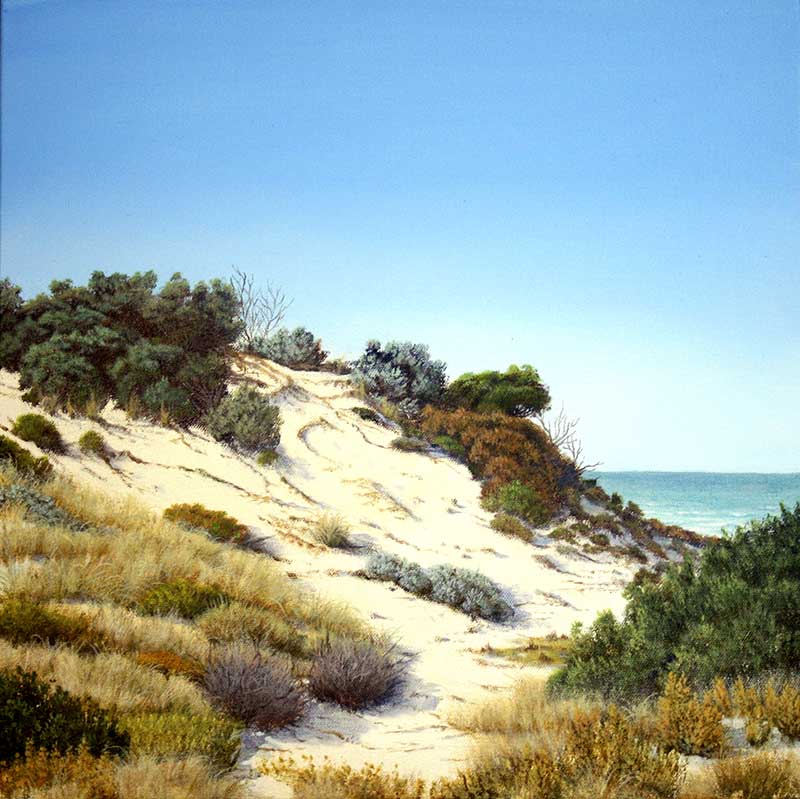
Beach Mood , Acrylic on canvas, 45cm. x45 cm.
You comment., “the essence of place that inspires my Images.” Expand on this.
The essence of a place is a whole collection of senses that wreath a place & evoke images. It can be a smell, a bird call ,a flash of colour or a swathe of colour it can even be just a feeling that the landscape prompts as you walk through it. But that is the most important thing to me, if I don’t experience a place, I don’t paint it.
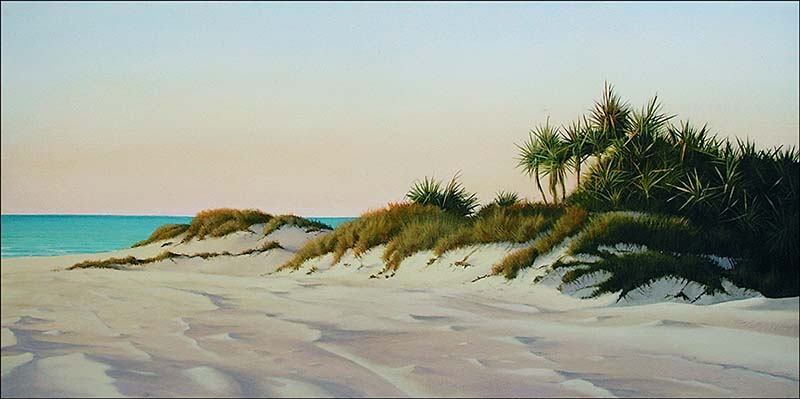
A Little Bit Later, Acrylic on linen ,122 cm. x 61 cm.
Discuss ‘Tread Carefully’ and how this and others similar represent different aspects of nature within the one frame.
Tread Carefully is another step in me describing a place-in this case Kakadu.
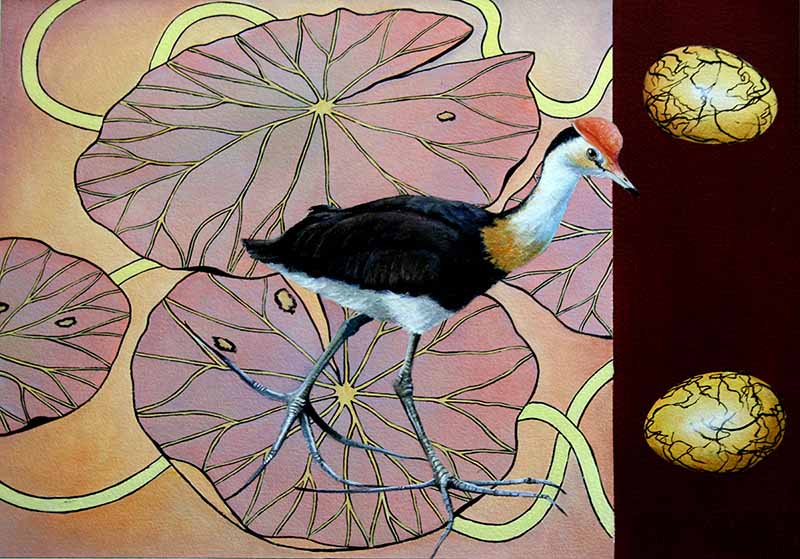
Tread Carefully, Acrylic on Arches, 73x53cm
I often take flora or fauna and develop an image that is both descriptive of the bird/flower & a sight common to an area ,sometimes in a slightly more abstract approach as in Island Lagoon 1.
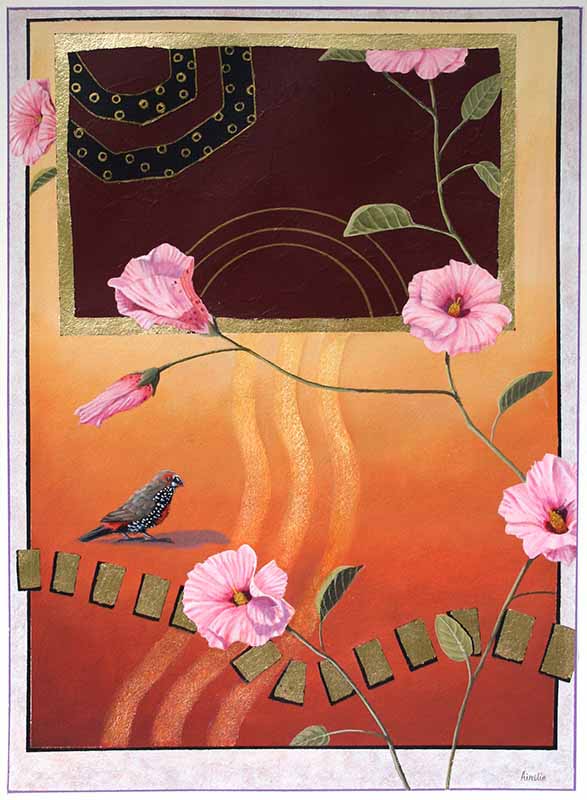
Island Lagoon Revisited 1, Acrylic, gold leaf on Arches paper, 52x72cm
Which uses the harsh iron browns, soft colours of the flora & symbols & marks to show the bleached vertebrae/ animal pathways. Alternatively, Imperious is just the emu with nothing around him because his strong character demanded that he was the center of the work. This is a way to paint “the essence”
Take one or two birds and discuss the work.
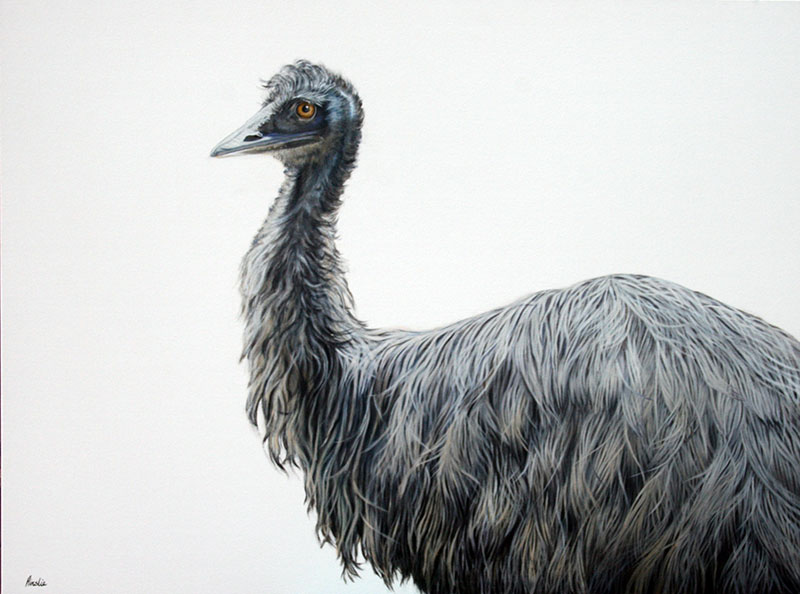
Imperious! ,Acrylic on Canvas,122 cm. x 92 cm.
Imperious is painted sans background and almost life size as I felt his strong almost arrogant presence warranted no distractions. He still sits in my studio looking down on me working with his imperious look.
Whistle stop was as much about the birds in their habitat as it was about the birds (Whistling Ducks) themselves. It was my homage to the bird life in Kakadu which has always captured my interests whenever I have gone there. I have also included stylised/graphic Magpie Geese & Wild ducks that are prevalent on the waterways up there. The almost linocut look is a reference from another life when I did a lot of printmaking
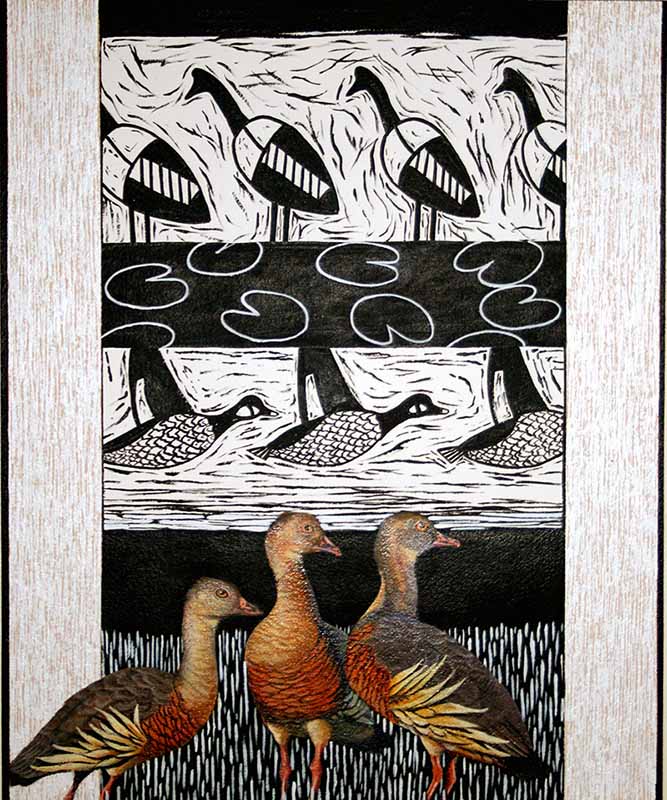
Whistle Stop, Acrylic on arches, 52x72cm
In your coastal work do you ever add people?
Why have you made this decision?
Because I’m a curmudgeonly old bloke & because I tend to walk the beaches less populated & at dusk or dawn when there isn’t another soul to spoil the beauty. I prefer to put a bird in my coastal work-they are far less intrusive to the feeling of peace I try to achieve.
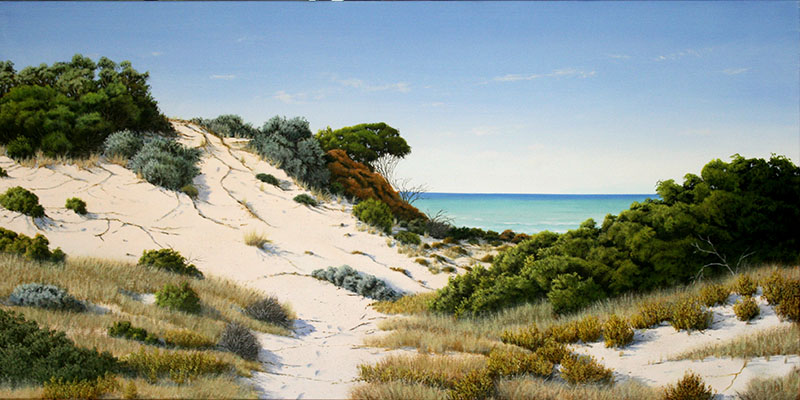
Cloud Wisps 1, Acrylic on linen, 122x61cm
Discuss painting water and, also the reflections found in water.
Water has always been a battle to paint but at the same time it has been intrinsic to a lot of my work. The best I can say is that I go to the studio & fight with the paint until I achieve something I am half satisfied with.
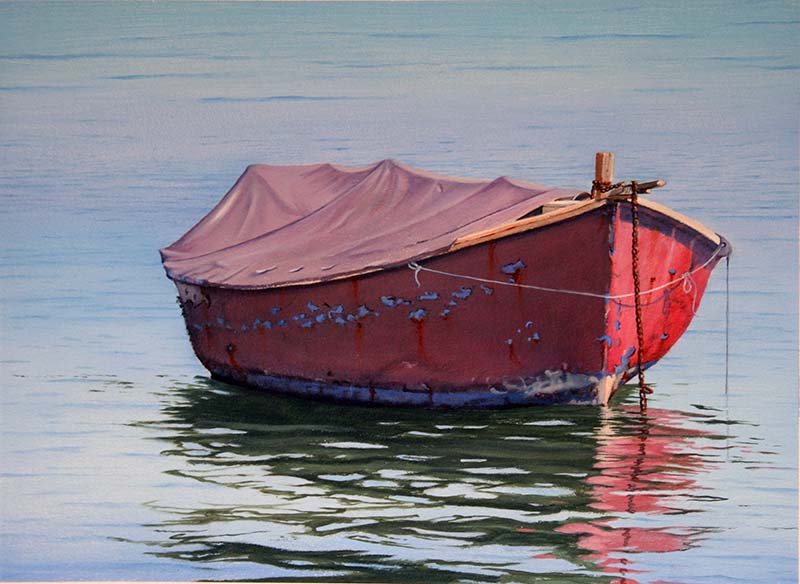
Neglected, Acrylic on Arches, 72x52cm
Beautiful reflections continue to attract me.
Discuss how you paint place and time in your work.
Time is usually by the light I choose to paint—dusk, dawn or strong midday light with strong shadows.
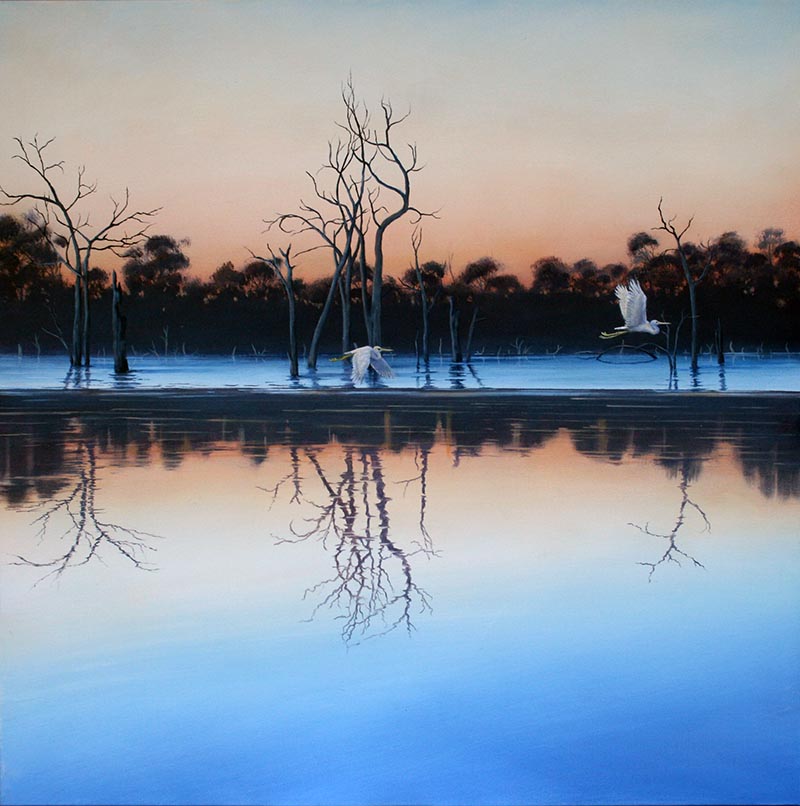
Last Light - River, Acrylic on canvas, 101x101cm
The other way I paint time is the area/painting itself , because it is a record of one of my trips. Place is evident in all of my work because, again it is usually an image specific to a particular place even if it is not a straight landscape. As in Fragments of An Inland sea ,which is inspired by my visits to various fossil field around Australia.
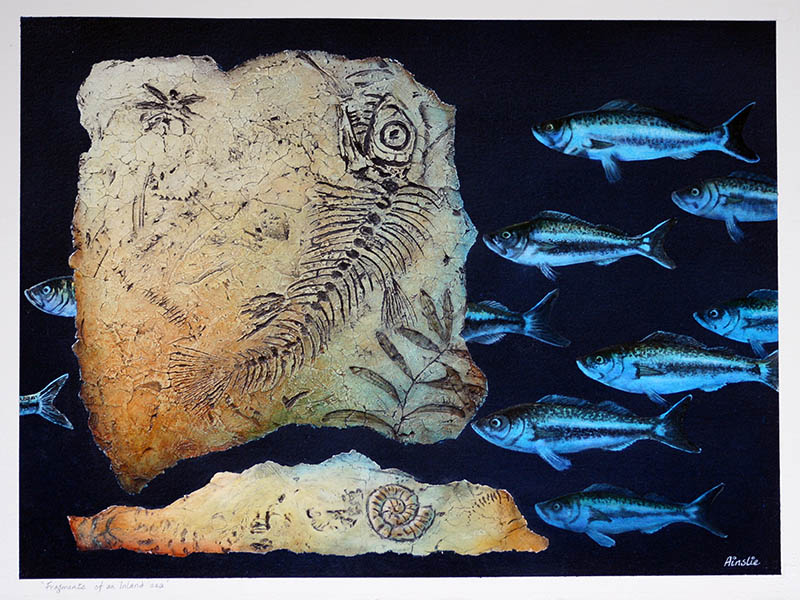
Fragments of An Inland Sea, Image size,74 cm .x 54 cm, Acrylic on Arches
Do you use a sketch book? How do you record places you wish to paint?
I use many methods to record a place. I used to do small onsite gouaches, but not so often now. I do jot down very rudimentary line sketches & notes to jolt my memory & I do take photo’s which I cast about the studio to remind me of the essence & sometimes for reference if it is a particular flower or bird but my work is a montage of an area not a specific place, though I hope it is recognisable. In the studio I have books & books of small, coloured studies I do to work out a painting.
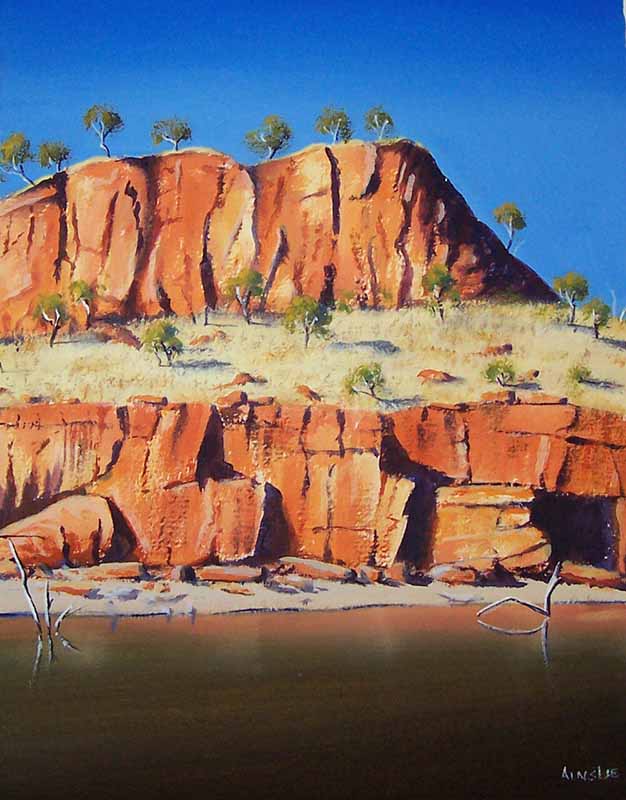
Gorge Note Book 4, Acrylic on Arches, 26x35cm
Some never come to fruition & sometimes the big painting gets destroyed because it isn’t a patch on the sketches, but occasionally we have a winner.
What is one tool of trade that you value highly and when did you first come to use it and understand its value?
It is hard to pinpoint one tool of trade so I will say worn brushes & useless credit cards ,both of which are great for mark making. “Summer Hillside “painted with credit card, grass & glad wrap
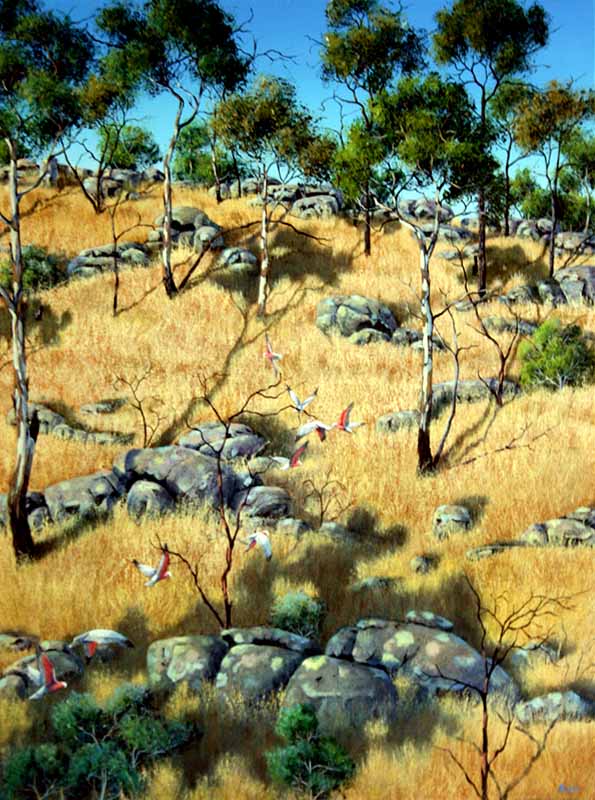
Hillside Shadows 2, Acrylic on canvas, 92x122cm
Contact:
James Ainslie
ainsliestudio@aapt.net.au
Deborah Blakeley, Melbourne, Australia
Interview by Deborah Blakeley, February 2021
Ann Oram
Colour is a signature of your work. Discuss this using several of your paintings.
Colour and its use is a very Scottish thing. I think we have a lot in common with the French Impressionists also. Much more so than with the English painters who are more subdued in their use of colour.
We have the Scottish Colourists as part of our history, and I think I am part of that tradition.
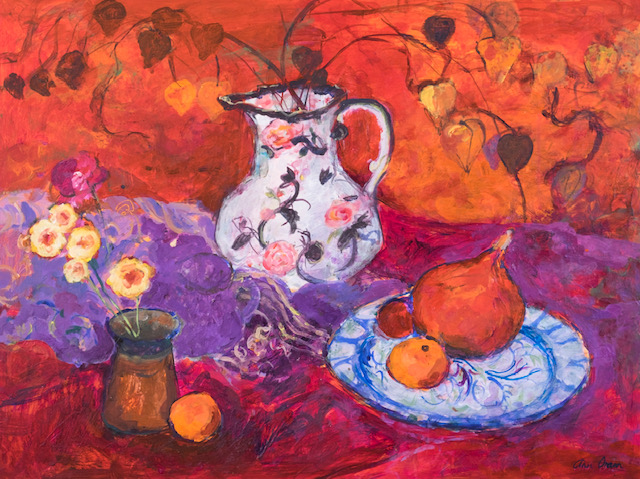
Red Still Life with Chinese Lanterns, Mixed media on Board, 41 x 41cms
For me, I couldn’t think of life without colour. It conveys so much in terms of mood and emotion. I also think it’s an antidote to the Scottish dreich climate!!
What led you to still life painting?
Still Life is a subject that was part of the curriculum at Edinburgh College of Art. All art schools taught it, as well as life painting, portraiture etc. I loved it and loved arranging the objects into attractive groups. I also like painting what I find to be beautiful.
Nowadays I start with a rough set up, and it changes over the painting period. Objects get painted out and replaced by something else!! It’s a moveable feast.
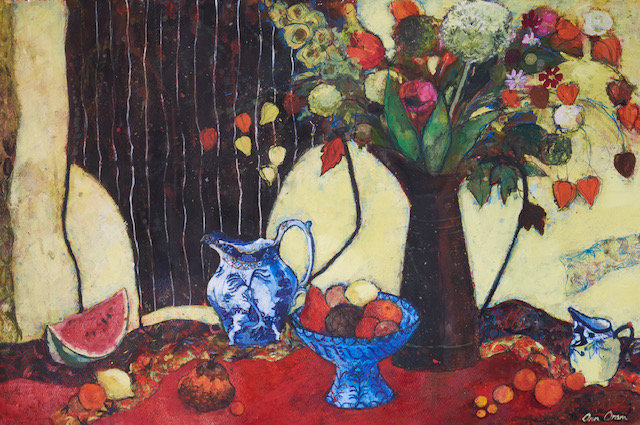
Autumn Fruit, Acrylic on watercolour paper, 67x101cms
Part of the fun is shopping for flowers and jugs and all the other bits and pieces. I’ve accrued quite a collection in my studio!
I was interested in Bonnard and Anne Redpath: both painters of still life, and in Bonnard’s case, he painted from memory and Anne Redpath kind of painted what was in her mind, rather than the set piece!! I’m with these guys as I love to go off piste with the group!!
Are there always flowers in your still life paintings?
There are always flowers in my still life. I don’t know why, but I think it’s to do with the pop of colour they give and also my love of everything floral!! I’m a bit of an addict.
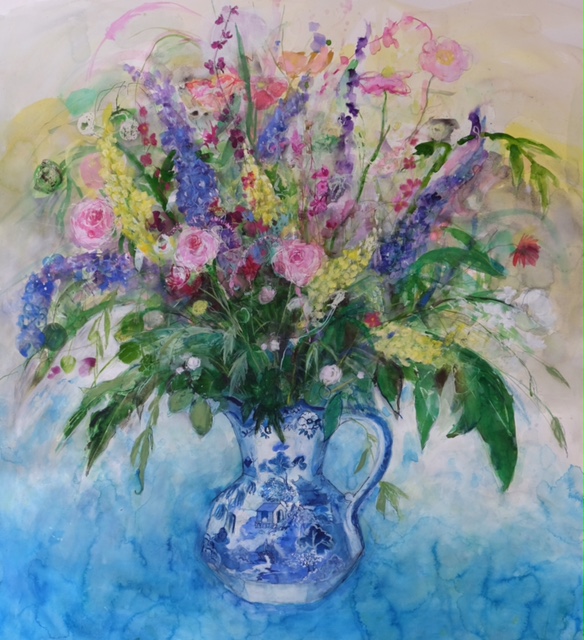
Flowers from an Edinburgh Garden, Watercolour and Gouache on Arches paper, 105x117cms
There are a couple of gardens I visit: One garden is at Wemyss Castle in Fife and the other one is where I buy my flowers at Millpond Flower Farm in the Borders. The sense of wellbeing I get from these environments is second to none.
You comment that, “Winter time and still life go together discuss.
This is a good time to paint still life as the weather is cold, and the studio is more inviting! I tend to work on single Flower pieces in the summer when the flowers are in season.
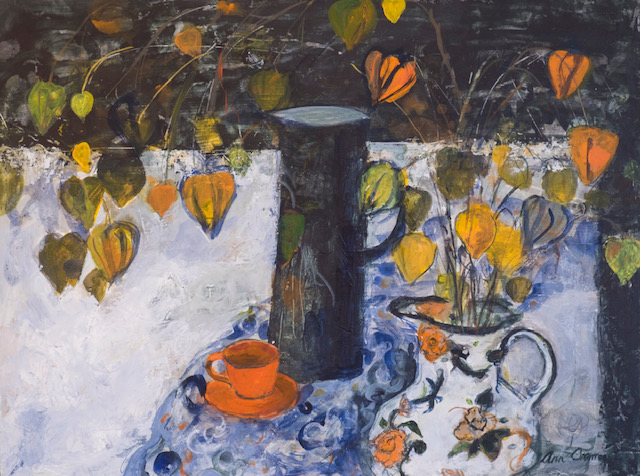
Two Jugs with Chinese Lanterns, Acrylic on gesso board, 51x61cms
You have many of your paintings made into prints.
I can make any painting into a giclee print. They are really for people wanting a nice image in their house without acquiring the original! Those prints are not signed, and I can print as many as I like. People often scroll through my Instagram account and request a print for instance!!
On the other hand, I have worked with professional printmakers through the years, and then it is a more serious business where the prints are editioned and signed. There might be 20-50 in the edition. With this method, the prints are screen prints.
I’d like to produce more prints, but I need to work with a professional. It’s a different approach to image making and I need that expertise. I have worked with a marvellous printmaker and artist called Gill Murray, and we are planning to work together again.
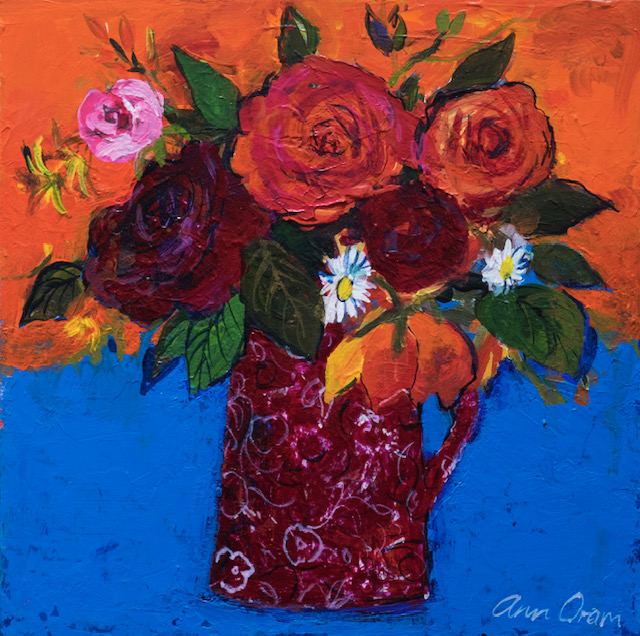
Wee Jug of Roses, Acrylic on gesso board, 30x30cms
Tell us about your Art School and how it has had to adapt to our new way of living in 2020?
I don’t teach every week. My painting schedule is too busy for that. What I tend to do is teach an intensive 2-3 days, where I work everyone quite hard!! Lots of exercises and techniques to free up the students’ work. We usually play all sorts of music and generally have a good time! I may do these courses about 8 times in the year.
With the pandemic, I have decided not to teach meantime, but hope to resume when things eventually settle down.
Your comment, “Ordinary landscape of Scotland” Is this what you see daily?
I like the landscapes that I see around me on a regular basis. It’s about what is accessible and what I love. I do make forays to the West coast of Scotland occasionally, but generally I like using what is local. I love our fields, and grasses. I don’t go for the dramatic glens particularly! I’ve included some landscape from Italy as well as Scotland in the photos I’ve sent.
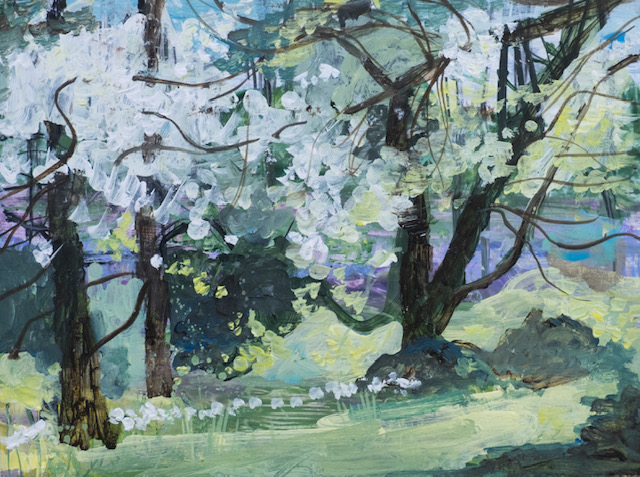
Trees at Paxton House, Acrylic on canvas board, 20x 30cms
Discuss your landscape art.
There’s really not much to say. If I’m out walking and see something that excites me, I will scribble down an image and usually record it on my iPhone. Familiarity is key; if I see something regularly it kind of fixes in my mind. I rarely paint on the spot but gather the images sometime later. This is where the creativity comes in and I muck around with wax candles, watercolour and gouache. Pen and ink too. The more finished paintings can go into acrylic paints, but I go between the two. Whatever I paint is not necessarily true to what I saw originally!!
I also introduce still life into the landscape or more truthfully into a garden scene. It’s an attempt at ‘feel good’ picnics in the garden! Bottle of wine, cheese, lovely plates and glasses!! Again, garden flowers will feature. Perhaps I am a creature of the good life!!
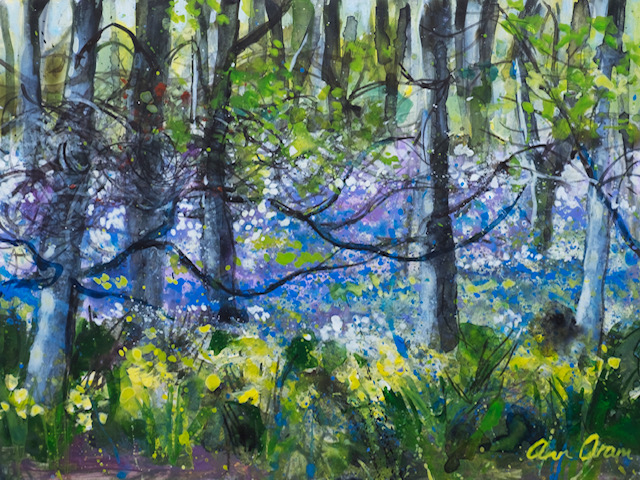
Bluebell Wood, Wemyss Castle, Acrylic on board, 20x30 cms
Discuss the differences that light plays out in your paintings both inside and outside.
Good light is important for still life. However, when you paint outside, good light is often the enemy. I think that early morning and light at the end of the day are hugely important. The skies are more interesting than when you get bright blue skies and full sunshine. I like the winter landscape especially, where the trees are bare, and the shadows are long. Snow and icy conditions are also exciting visually.
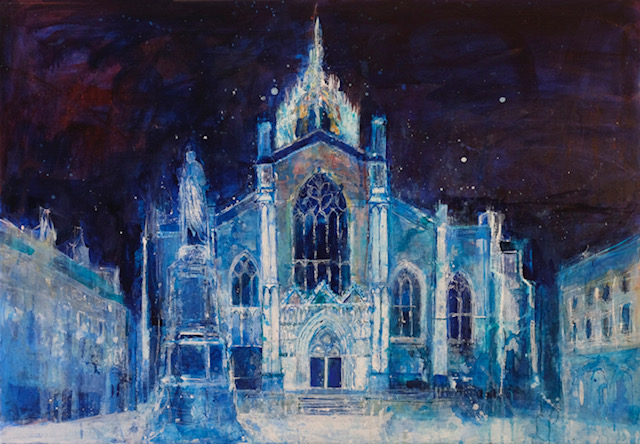
St Giles, Edinburgh at Night, Watercolour, ink, oil pastel on watercolour paper, 56x76cms
Compare you acrylic and watercolour, discuss how, where, and why you use both mediums.
This is an interesting question. I think I was always drawn to a water based medium. I found that when I bought my first acrylics, I instinctively felt I knew how to use them. The various mediums that can give you texture, and line (string gel) are exciting. I can glaze and use the Golden Liquid paints just like watercolour. It’s so exciting and creative.
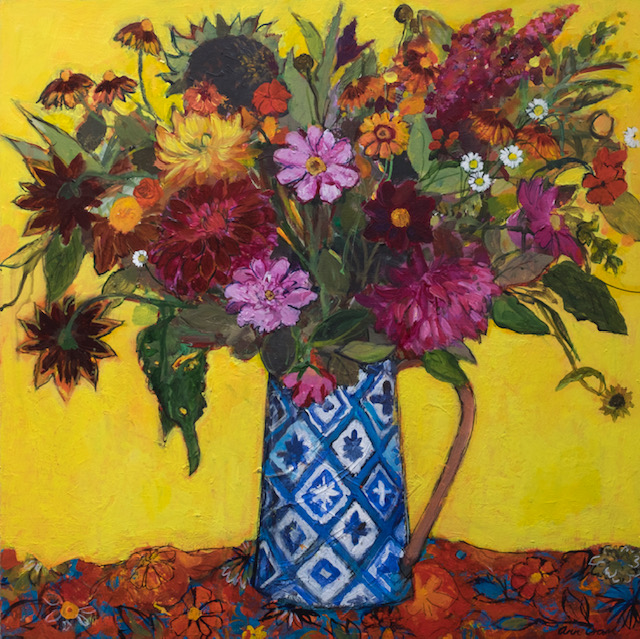
Late Summer Flowers on a Yellow Ground, Acrylic on gesso board, 68x68cms
My first love was watercolour, and sadly I am using it a bit less now. However, it’s good to look back and realise that the watercolour/gouache and inks are actually very exciting and freeing. I am about to start using the mixed media this winter, starting next week. The major difference for me is that the acrylic can give me more intense colour over bigger pieces. However acrylic inks fill that gap. I love using wax relief, or oil pastel with watercolour as it gives the most exciting texture. The gouache can give me wonderful opaque colour. My very big flower pieces are achieved on this way. Another point is that you can work very quickly with this technique. The mark making is fast and exciting and you must react quickly to the image appearing in front of you. I like to challenge myself and try to do paintings very quickly, or in one day!! It can be scary in a way that the build-up of acrylic paint is more considered. I can hardly wait to start!!
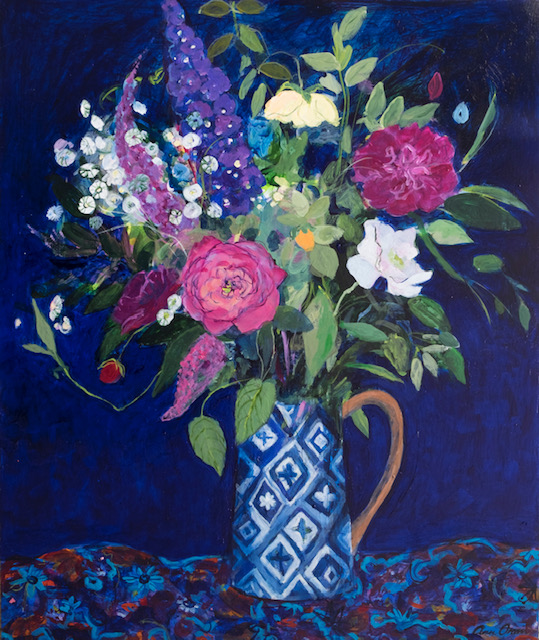
Midsummer Flowers on a Blue Ground, Acrylic on gesso board, 60x60cms
You exhibit in many galleries, what are two criteria you want and why.
This has changed a lot. The market is burgeoning with artists. New and old. Lots of people are changing career and becoming artists overnight. Many new galleries have sprung up, and of course there is more wealth around than there was 40 years ago. A lot of galleries really serve the interior design market.
I used to have one London and one Edinburgh gallery, a couple of provincial galleries and my teaching. Now, that picture has changed and I now work with many more galleries, throughout the country.
My main criteria is that I like the gallery and its director, and the space.
The second criteria is that you like the artists (or some of them) that they show. Being able to talk to your gallery is important.
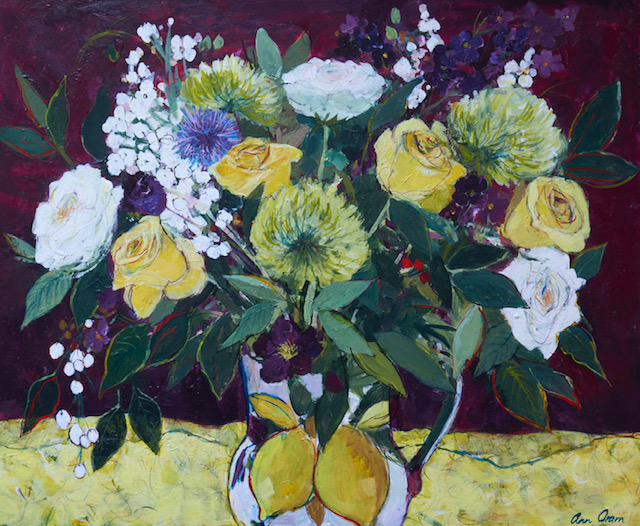
Roses and other Flowers, Acrylic on gesso board, 50x60cms
Tell us about your studio space.
Studio space is important. I’ve usually worked in a room in my house, and I have never shared a space. I don’t share!!
When we moved to the Borders, we bought an old Bakehouse in our village. It came with a piece of ground where the stables had once been. When we acquired it, the land was used for fly tipping and was full of weeds!! This has been cleared and we built a posh garden shed called ‘The Shedio’!! It is a lovely wooden structure which is warm and full of light. It has such a nice feeling, that we sometimes sit there as a family and share a glass of wine and cake!
As for lighting, we use battery power for the daylight tube. We hope to get electricity in next year.
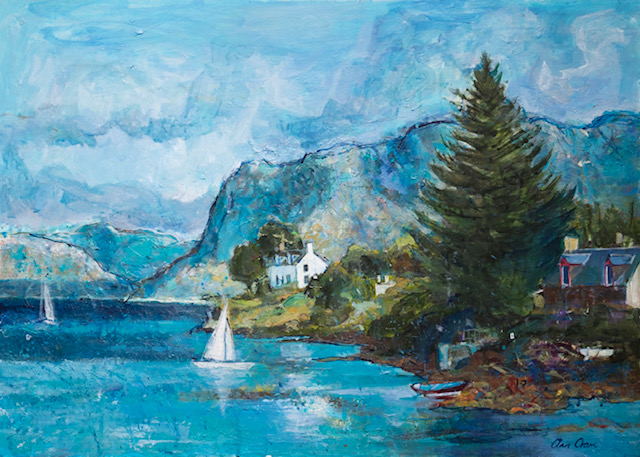
Plockton, Sailing Boats, Acrylic on gesso board, 50x70 cms
Do you keep a sketch book, and do you also use photography as a base for you work?
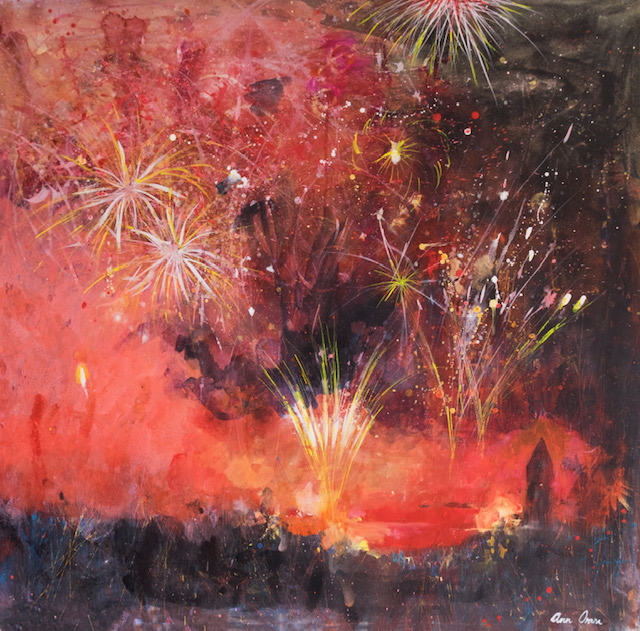
Edinburgh Festival Fireworks, Acrylic on Arches watercolour paper, 114x115cms
I do keep sketchbooks for set projects like foreign travel and for a project about my local landscape which was started earlier this year. They are full of scribbles and splashes of colour. I rely on my iPhone and camera to capture moments and weather. In fact, I recorded the icy shrubs and grasses on the road outside our village on my phone. You simply cannot sit out there and paint them in that situation. The best sketchbooks are in your head. It’s the familiarity of your surroundings that are important.
Contact:
Ann Oram RSW
Deborah Blakeley, Melbourne, Australia
Interview by Deborah Blakeley, November 2020
Frances Priest
Discuss the importance of detail in your work
I have always been drawn to intricate things, providing a place for concentration focus and respite… From the details bigger pictures emerge.
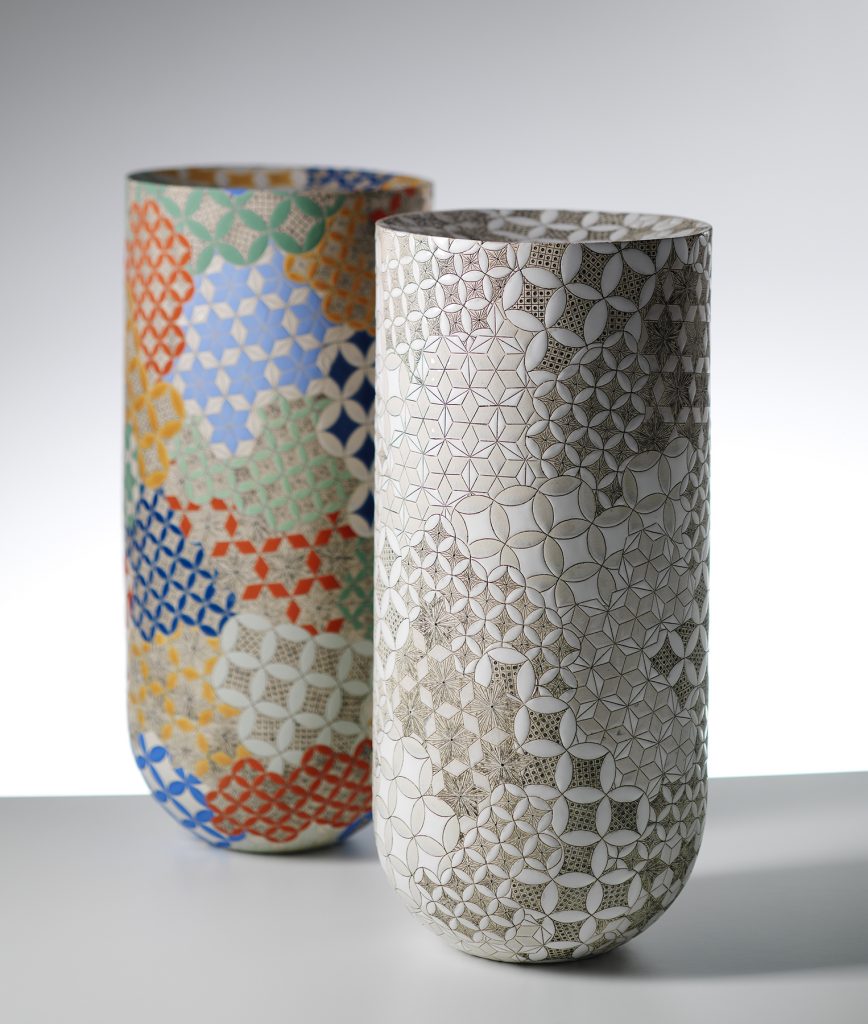
Vase Forms | Grammar of Ornament - Byzantine No3, Monochrome & Polychrome. Photography by Shannon Tofts
How has pattern continued to be so focused in your ceramics?
To ornament and decorate the world is a fundamental human impulse - even the most functional of objects are often decorated in some form. The rich history of how humans create and utilise ornament is an endlessly fascinating area of exploration.
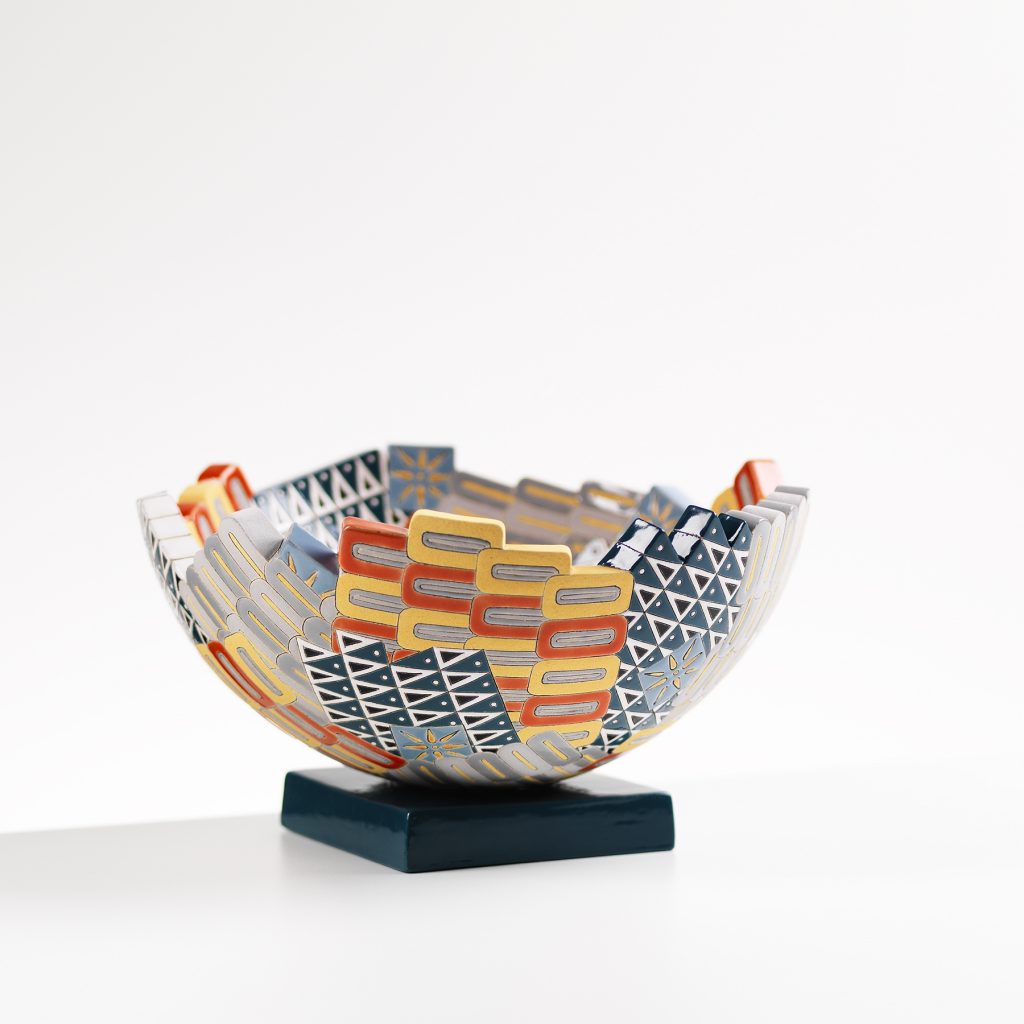
GO Greek Commission, Photography by Shannon Tofts
Can you tell us about your small keepsake holders, in your series, The Garnered?
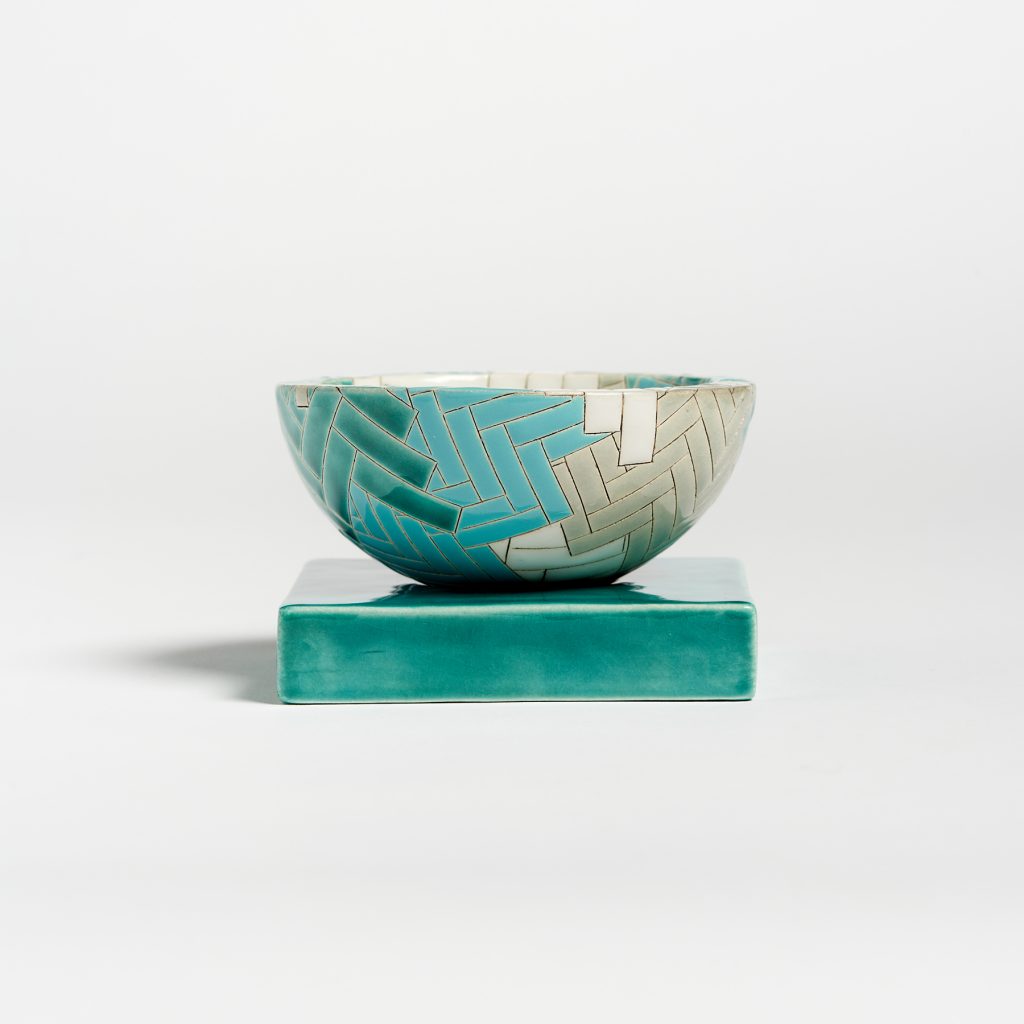
Gathering Bowl | Sanday - Tresness.
This has been a lovely collaboration to work on, developing slowly through conversations with Anna Garner, founder and director of The Garnered.The work responds to an Island called Sanday in the Orkneys which has a special place in my heart. The colours are drawn from memories of autumnal beach walks around the coastline of the island, reflecting pure white sand, rust coloured kelp and the bright turquoise to deep dark blue of the sea.
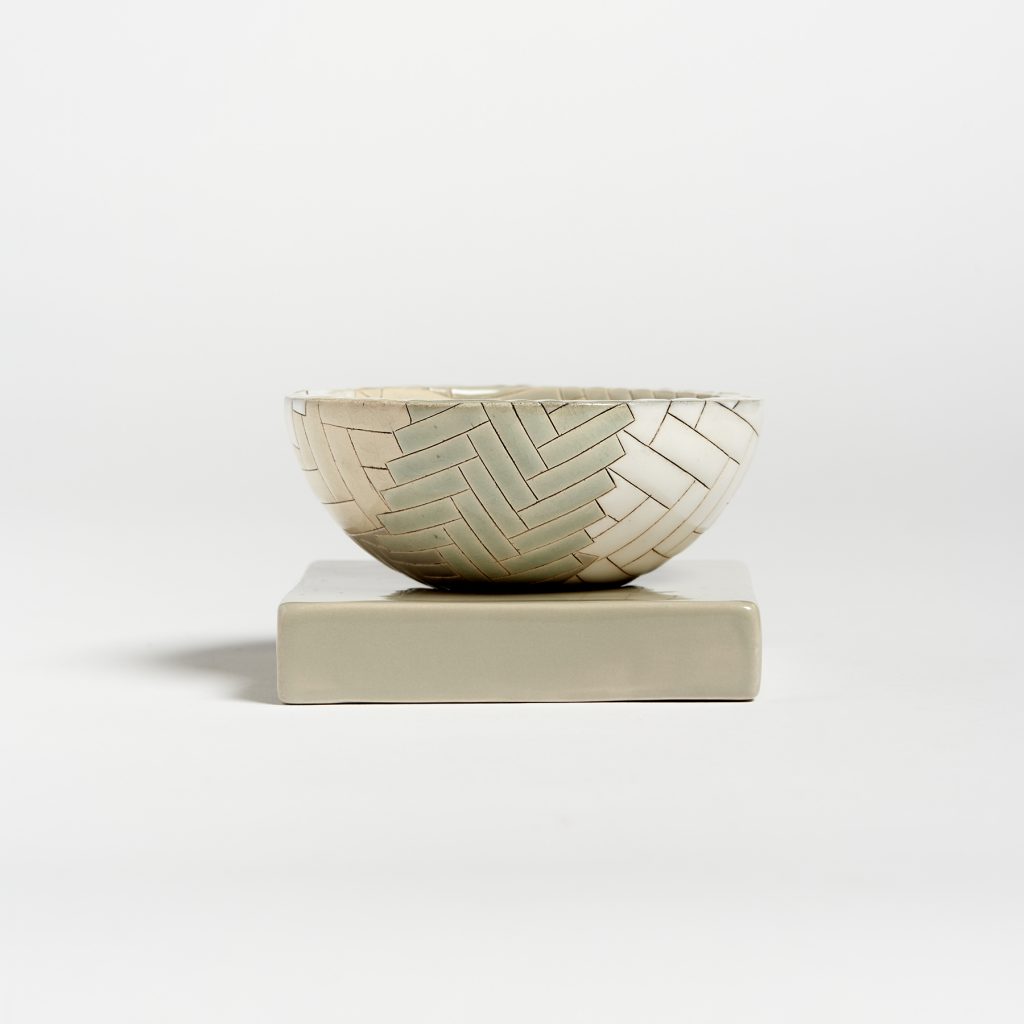
Gathering Bowl | Sanday - Whitemill.
The parquet pattern is a favourite which I often return to. In this instance it seemed very fitting, recalling the patterns of tweed fabric and knitted woollens that are essential for windy walks around the island.
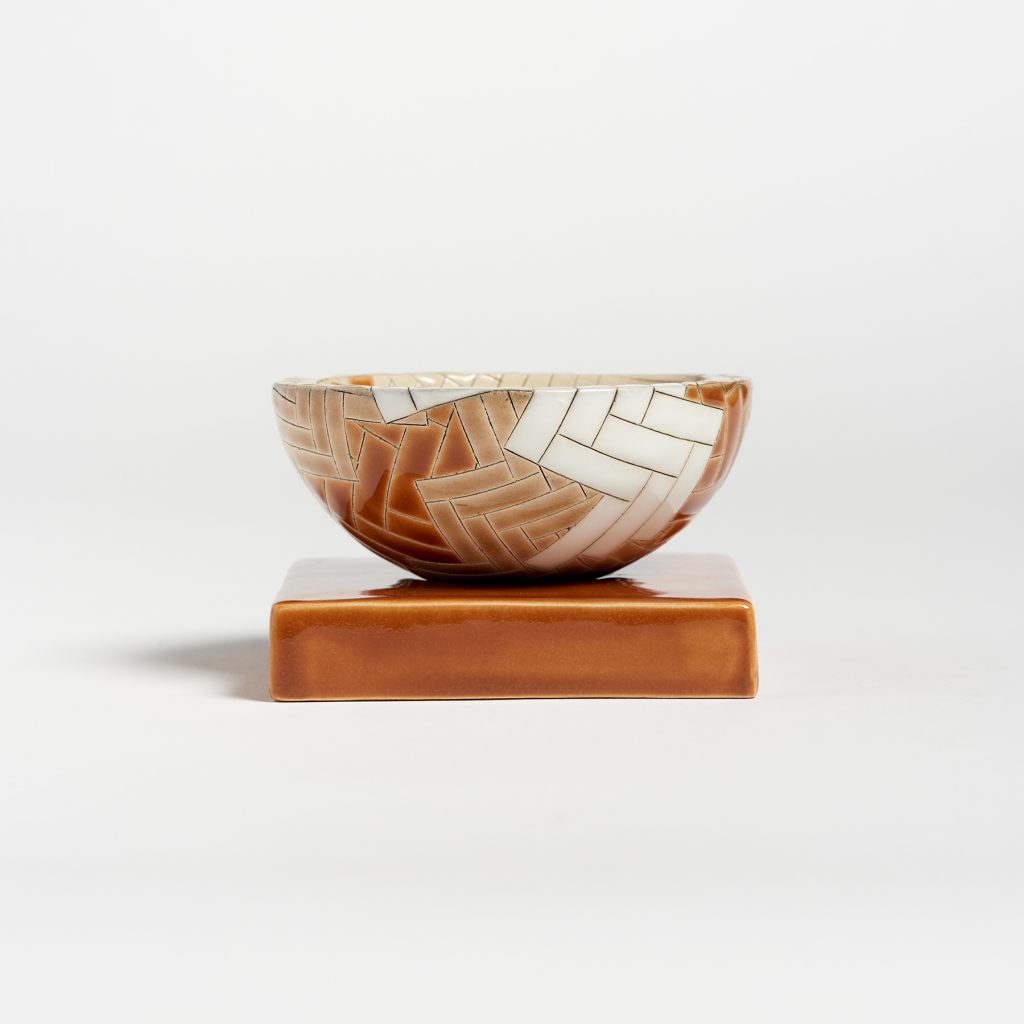
Gathering Bowl | Sanday - Catasand.
Comment on the small stands they sit on.
Each bowl sits on a small ceramic plinth which elevates and frames the work, giving it space to breath.
You comment that it began with a book given to you. ‘The Grammar of Ornament’ by Owen Jones in 1856. Discuss this continuing influence?
I am curious about by the journeys that languages of ornament undertake. Designers, artisans, artists and collectors, pick-up, re-work and re-interpret decorative motifs, through different materials & craft processes, by applying them to new contexts or through building up collections. The Grammar of Ornament is a perfect example of this process in action.
First published in 1856, the book is a compendium of pattern complied by Owen Jones who also devised an accompanying set of design principals intended to shake up and reform British design and manufacturing.
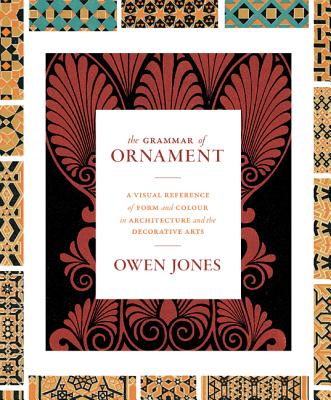
It is a an extraordinarily beautiful publication and a rich resource for lovers of The Decorative. It is also however highly problematic to a contemporary reader, reflecting the politics and position of Victorian era Britain and raising many questions about the dominance of a singular western empirical perspective of design history.
For those who do not know, who was Owen Jones?
I’ll quote directly from the V&A museum to answer this question
“Owen Jones (1809 – 74) was a versatile architect and designer, and one of the most influential design theorists of the 19th century. In his search for a unique modern style, Jones looked to the Islamic world for inspiration.
Jones developed key principles for the newly-established Government School of Design, which later became the Royal College of Art. Jones' bold theories on the use of colour, geometry and abstraction formed the basis for his seminal publication, The Grammar of Ornament, a design sourcebook that is still in print 150 years later.”
Discuss the way you combine colours in your work and where the inspirations come from.
The inspiration for colour in my work is very varied: It might have a historical reference point, be a distillation of my view of a particular place or a response to a design brief. Sometimes it is just a combination that I find appealing, there are certain colours that I regularly return to.
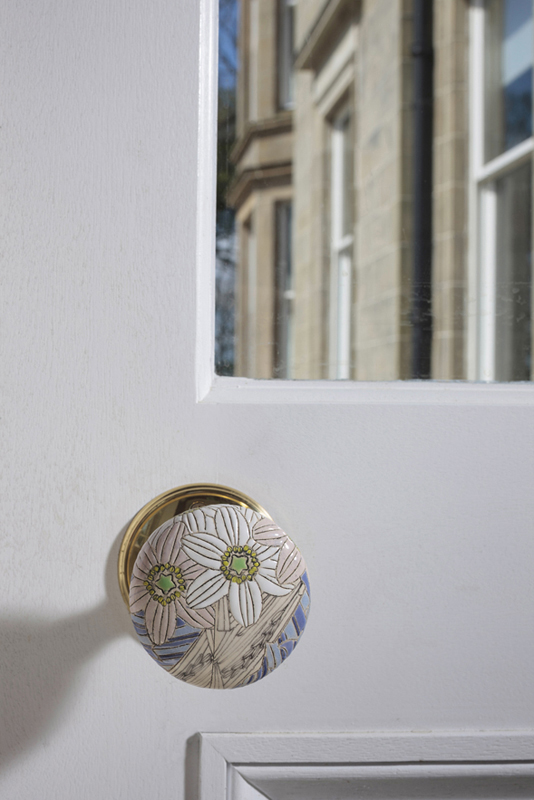
Patterns of Flora Woodland, Entrance Wear, Door Handle, Photography by Ruth Clark
I like creating movement through the use of colour, shifting across a range of hues or tones, and I enjoy adding in unexpected accents that can totally change the feel of a piece.
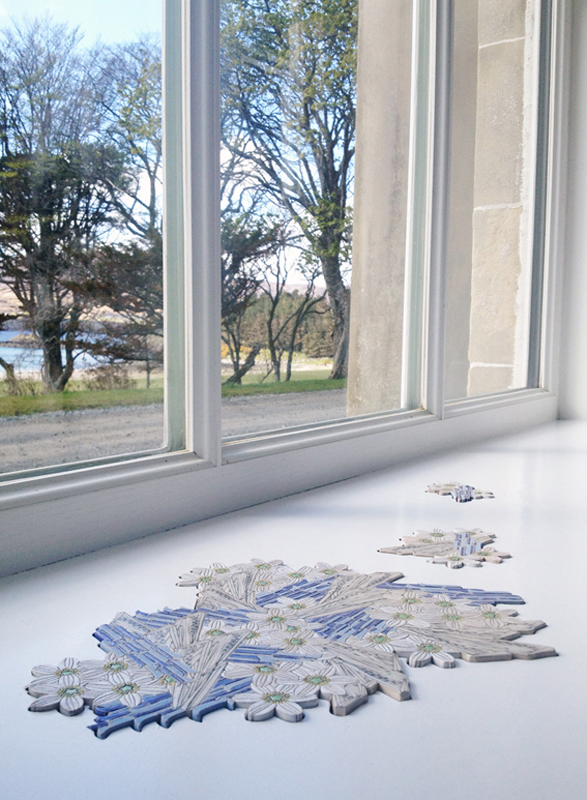
Patterns of Flora | Mapping Seven Raasay Habitats - Woodland. Photography by Ruth Clark
You have made a colouring book.
How did this come about?
Is it or others still available?
The colouring book I made was part of a larger project called ‘Patterns of Flora | Mapping Seven Raasay Habitats’.
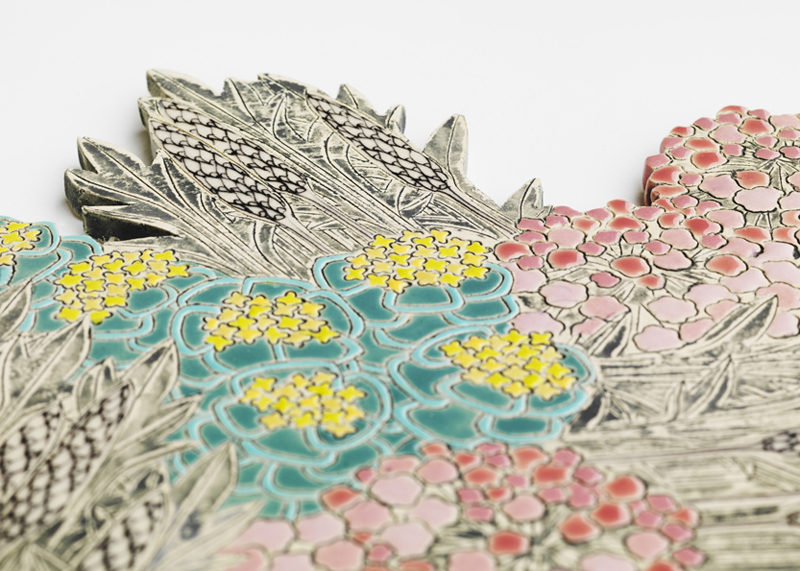
Patterns of Flora | Mapping Seven Raasay Habitats - Coast (detail) Photography by Shannon Tofts
The work was commissioned by Atlas Arts and developed for Raasay House in collaboration with Botanist Stephen Bungard. The work explored the native plants and associated habitats on the Scottish island of Raasay through a collection of permanently sited ceramics at Raasay House.
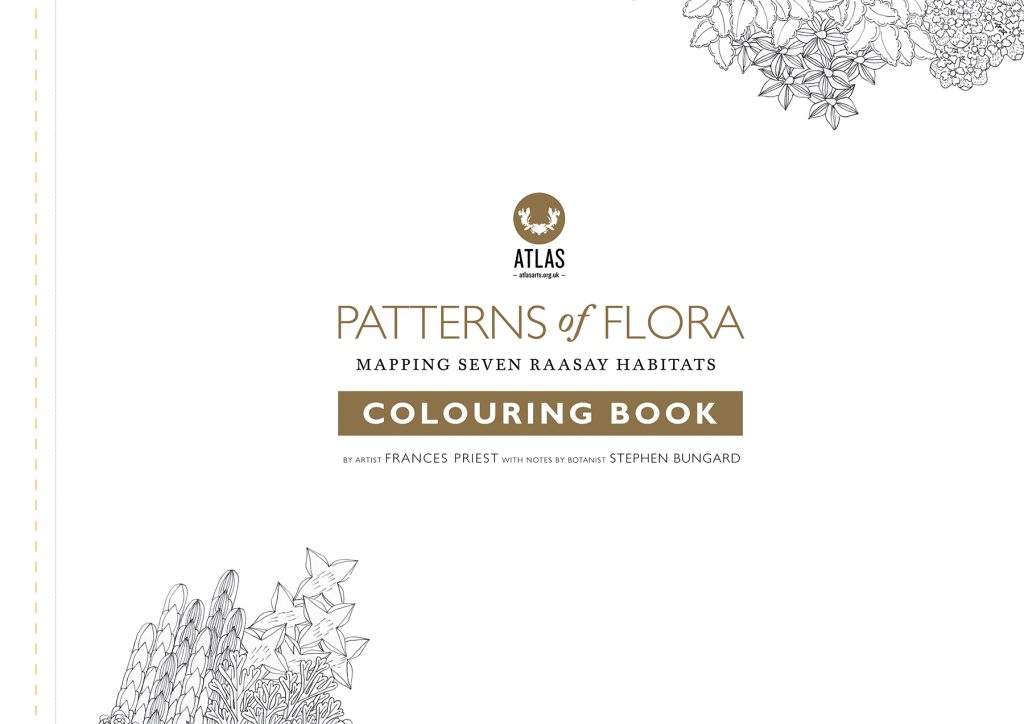
Patterns of Flora | Mapping Seven Raasay Habitats - Colouring Book.
To accompany this commission Atlas Arts invited me to create some artist editions including a colouring book. There are still a few signed copies of the original A3 colouring book available for sale via Atlas Arts. During lockdown we decided to make an a4 printer friendly copy available to download for free. You can get a copy via the Atlas Arts website:
https://atlasarts.org.uk/2020/04/03/patterns-of-flora-colouring-book-free-download/.
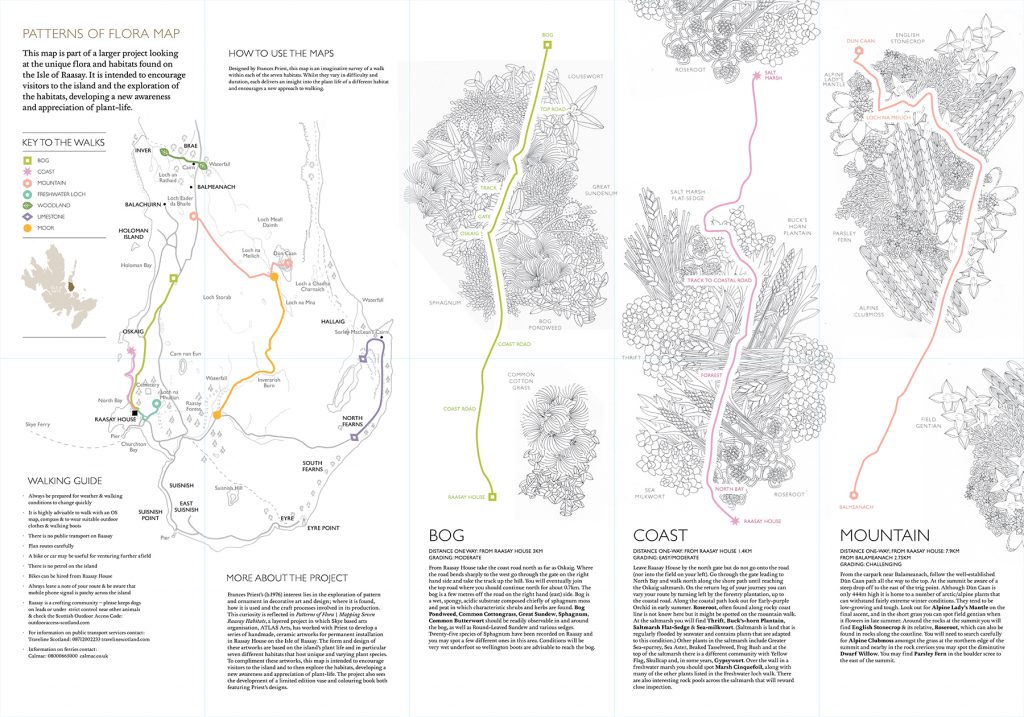
Patterns of Flora | Mapping Seven Raasay Habitats - Map
Can you expand on your work Chevron/Stripe/Asanoha, both small and large pieces?
I developed this collection exclusively for curator Valery Demure to present through her gallery Objet d’Emotion. The work brings together some of my favourite motifs across a series of hand-built drum and vase forms. Chevron motifs can be sourced back to heraldic imagery and stripes have a modernist association.
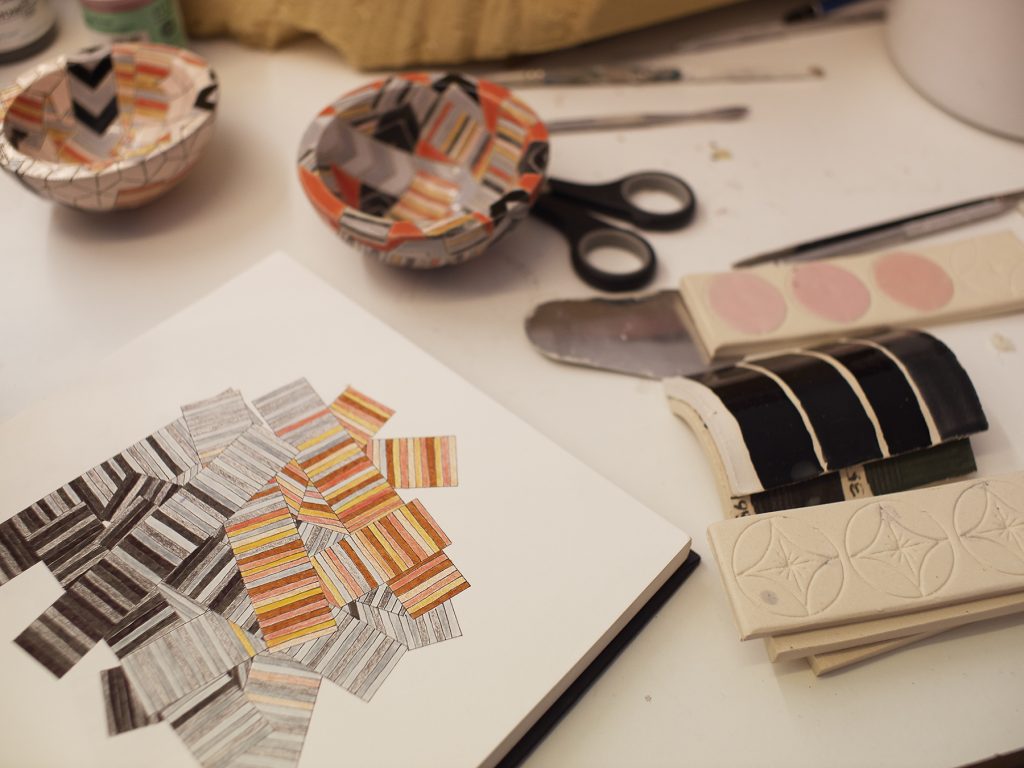
Colour Research, Chevron Stripe, Asanoha, Photography by Shanno Tofts
The Asanoha is a Japanese plant motif. I enjoy bringing together motifs from varied sources to create interesting dialogues. When developing my studio ceramics, I often look for very simple forms that act as vehicles for the surface patterns. The drum and vase forms felt particularly appropriate to the idea of a skin of pattern stretched across a surface. Making work in groups or families allows me to expand and explore an idea. With this collection each piece can stand alone but also exists in dialogue with the group. The colour palette for this work was developed in conversation with Valery and pushed me in a new direction, resulting in a very rich, bold collection.
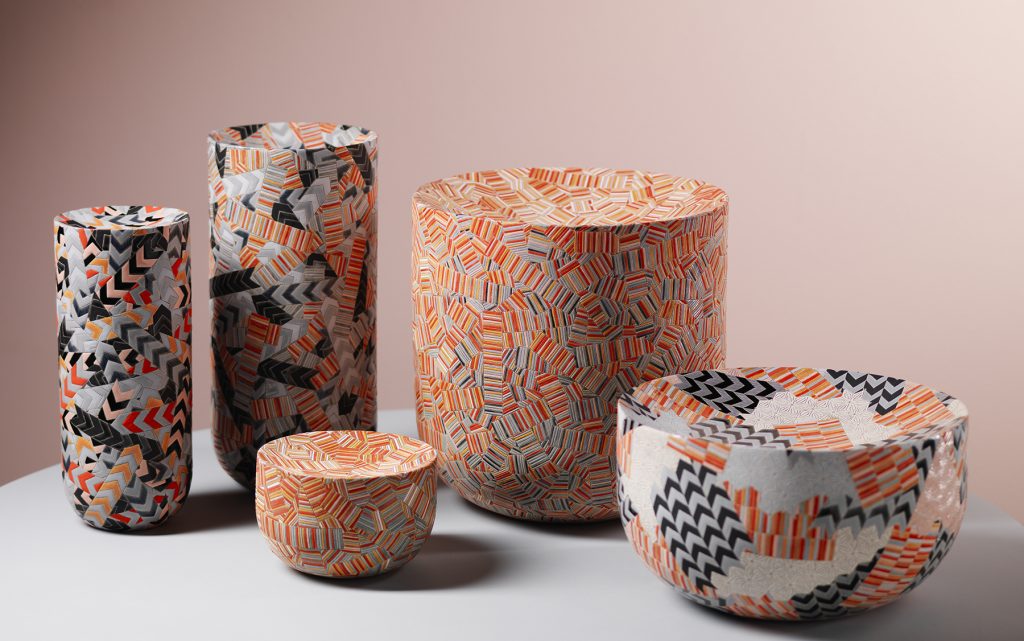
Drum & Vase Forms | Chevron/ Stripe/ Asanoha. Photography by Shannon Tofts
How do you decide on the rim or edges of your ceramics?
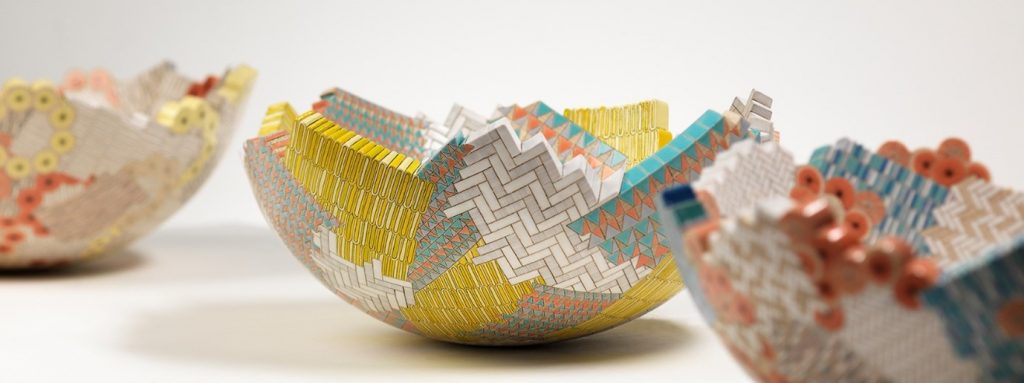
Gathering Places | Collage i, ii, iii. Photography by Shannon Tofts
I allowed the drawing to dictate the shape of the rim of the ‘Gathering Places’ vessel series. The result is that the individual motifs suddenly becomes emphasised and the work appears to be constructed from individual units. I like this ambiguity and how it prompts the viewer to think about how the piece is made, referencing processes such as mosaic, inlay, marquetry, stitch or weave.
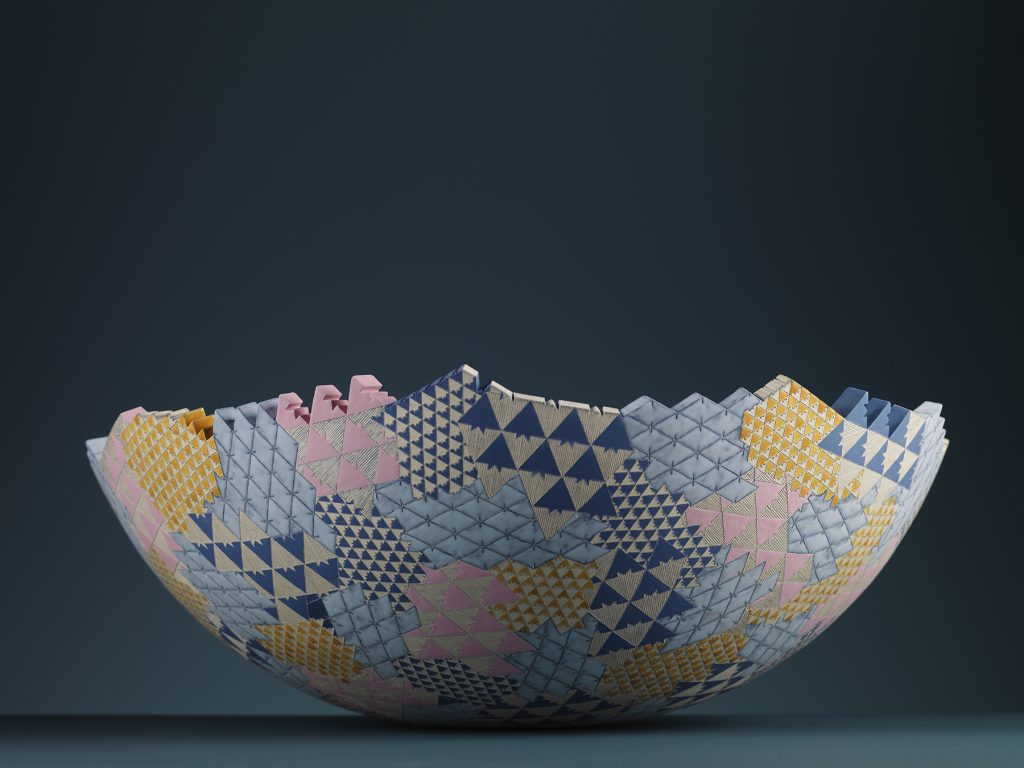
Gathering Places | Grammar of Ornament, India ii. Photography by Shannon Tofts
Tell us about becoming a scholar to both Qest and Johnny Walker?
I have recently been awarded a QEST Scholarship (Queen Elizabeth Scholarship Trust) to enable a period of research and learning with heritage tile manufacturers Craven Dunnill Jackfield. The scholarship is supported by Johnny Walker and will begin in January 2021. It is a wonderful opportunity to immerse myself in traditional tile making techniques, learning from exceptional craftspeople, with the intention that I will use the experience to develop contemporary work. QEST is a wonderful organization, and I am thrilled to be part of their growing family of talented alumni. The added bonus, of being supported by Johnny Walker has connected to an extraordinary group of craft practitioners from a diverse field of activity, covering horology, product design, printmaking and bespoke tailoring. It is a very supportive network that has proved especially valuable during this challenging year.
Take commissions you have had and the importance of each.
I am currently working on a commission for a Haematology Centre at The Edinburgh Western General Hospital, curated by Round Table projects and supported by Edinburgh & Lothian Health Foundation. The brief has allowed me to develop a collection of ceramics based on pattern books from the Linoleum manufacturing industry that was synonymous with the Scottish town of Kirkcaldy. The commission has allowed me to explore historic archives held by Fife Museums Trust including an extraordinary collection of pattern books. It is always interesting to work on a public commission, using my interests as a springboard for responding to a design brief and specific context. Working in healthcare settings adds another layer of complexity and challenge which I enjoy. I take great satisfaction from knowing that my work can help to transform clinical settings into far more approachable and welcoming environments for patients, staff and families.
The most significant of these commissions to date has been ‘The Tiled Corridor’ for The Royal Edinburgh Hospital, supported by Edinburgh & Lothian Health Foundation and realised in collaboration with tile manufactures Craven Dunnill Jackfield.
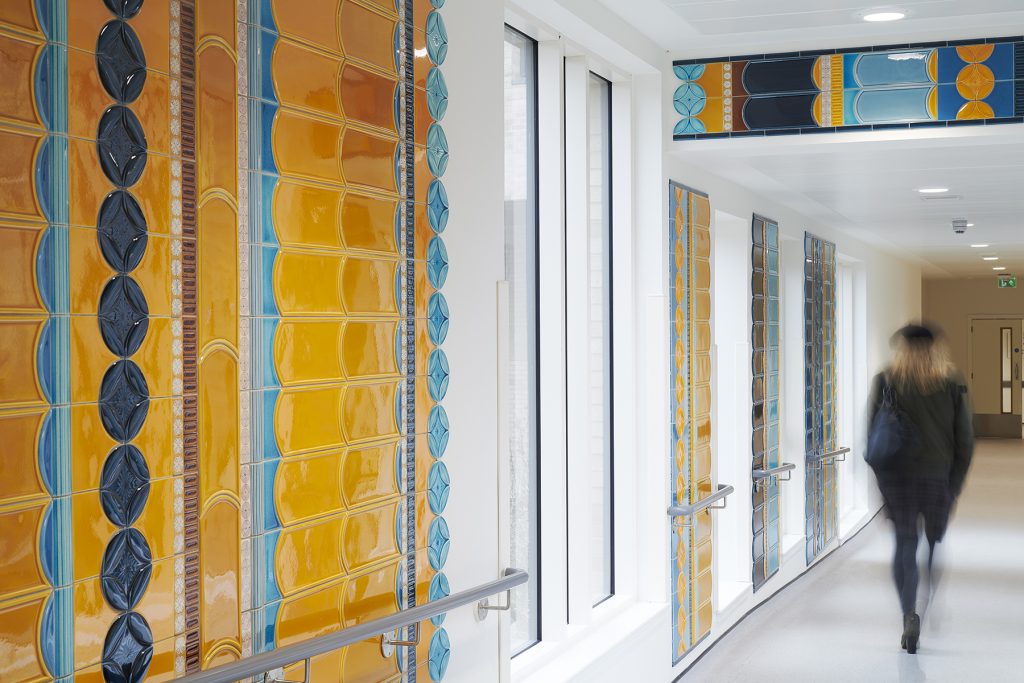
The Tiled Corridor | Royal Edinburgh Hospital. Photography by Shannon Tofts
The design is based on research into the Victorian era interiors of former hospital building Craig House and two tiled stairwells within the building. I have utilised motifs and colours extracted and adapted from these original stairwells to create a contemporary design which is vibrant and jewel like. The work spans the length of the main public corridor of a new hospital building and is comprised of around 2000 tiles, manufactured by Craven Dunnill Jackfield, and an additional 300 made by me in my Edinburgh Studio.
It has been fascinating to collaborate with a manufacturer and adapt my designs to an architectural scale. The work has become synonymous with the hospital and has achieved a great deal of recognition in design publications. It has even been included in a guidebook. To apply such a rich and carefully crafted surface to the walls of a public hospital implies a level of value, care and nurture that is very deserving of the hospital community. The corridor has become a place to linger and a means of orientation and, I hope, the work will bring moments of respite and pleasure to people using the building for many years to come.

The Tiled Corridor | Royal Edinburgh Hospital. Photography by Shannon Tofts
Take one piece that still makes your heart sing when you look at it or an image of it and why?
It would have to be ‘The Tiled Corridor’. This project has been such an important work for me, a real labour of love to complete that pushed at the boundaries of my knowledge and abilities. But the hard work truly paid off with a work that has been incredibly well received, most importantly by the patients and staff at the hospital. It has led on to new and exciting opportunities including the QEST award and the chance to collaborate further with the talented team at Craven Dunnill Jackfield.
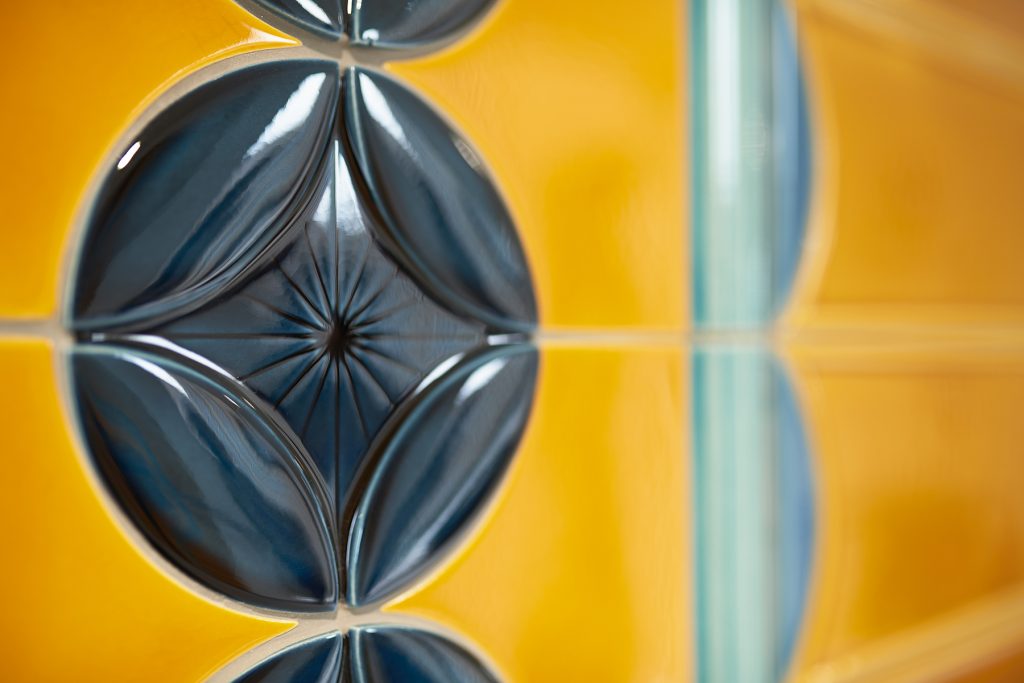
The Tiled Corridor | Royal Edinburgh Hospital (detail). Photography by Shannon Tofts
Do you have a restriction to size, both small and large?
This all depends on the project. In the studio I have two top loading electric kilns so I am limited by their capacity, but I would consider hiring kiln space if I required it. I will also work with fabricators and manufactures to realise work at scale and in none ceramic materials.

Collection | Grammar of Ornament - Byzantine No3 Polychrome. Photography by Shannon Tofts
What is one tool that makes a great difference to your work?
A scalpel and 10a scalpel blade. This is the tool I use to inscribe all of my drawings into clay.
How important is the ceramic community to you?
Creative communities, are very important, to me, whether that be within the field of ceramics or more broadly across craft, design and art. I always enjoy meeting new people and being exposed to new ways of thinking. We are fortunate in Scotland to have a vibrant & active craft & design community.
Contact:
Frances Priest
Instagram @francesprieststudio
Deborah Blakeley, Melbourne, Australia
Interview by Deborah Blakeley, November, 2020
[/vc_column_text][/vc_column][/vc_row]
Janine Heschl
It is going back to 2015 but I love the simplicity of ‘Jacket Sparrow’ discuss.
Back in 2015, I had just finished an intense portrait of a meerkat and I was looking for something more loose and less dense in terms of thread. Also, I had reached a point in my new career, where I wasn’t so sure where I wanted to go with my art and not overly confident, that I will ever make it as an artist. Lots of doubts and little trust in my potential. So, I decided to go back to something I felt confident with and that was collage making – but it wouldn’t be me, if I didn’t add a challenge to it and so I went for a bird, a subject I had never stitched before in that manner. The reference photo I used for this piece spoke to me right away and sparrows are always popular with the crowd and so I went with it.
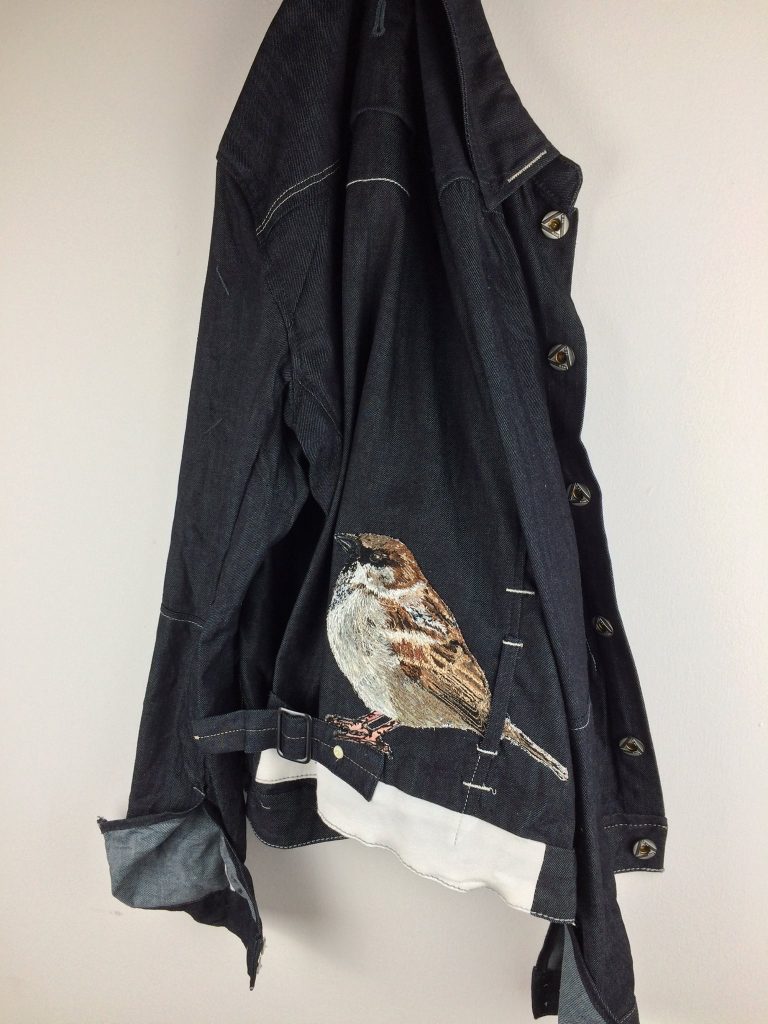
Jacket Sparrow
As the collage grew, my inspiration kicked back in and what set out to be a loose piece, turned into something fully embroidered. I just couldn’t stop adding details, which caused my fabric base to pucker and I was left with no other choice in the end, but to cut the sparrow from its base and to stitch it onto a new fabric background. I held my breath the entire time I was cutting along the edges of the embroidery, it was nerve racking having spent so much time on a piece and then having to chop it all up. When I then held the bird freshly cut in my hands, I knew that I needed to give him a less ordinary background and having been following the patch making trend on Instagram at the time, I decided to stitch him onto my denim jacket. I liked the idea so much of wearing my own art, taking it out into the public and creating unique exposure. It took me forever to find the right placement for it and I really loved the idea of its tail going underneath the loop at the bottom of the garment. There was no plan behind it all, one thing simply led to another and the learning curve was steep.
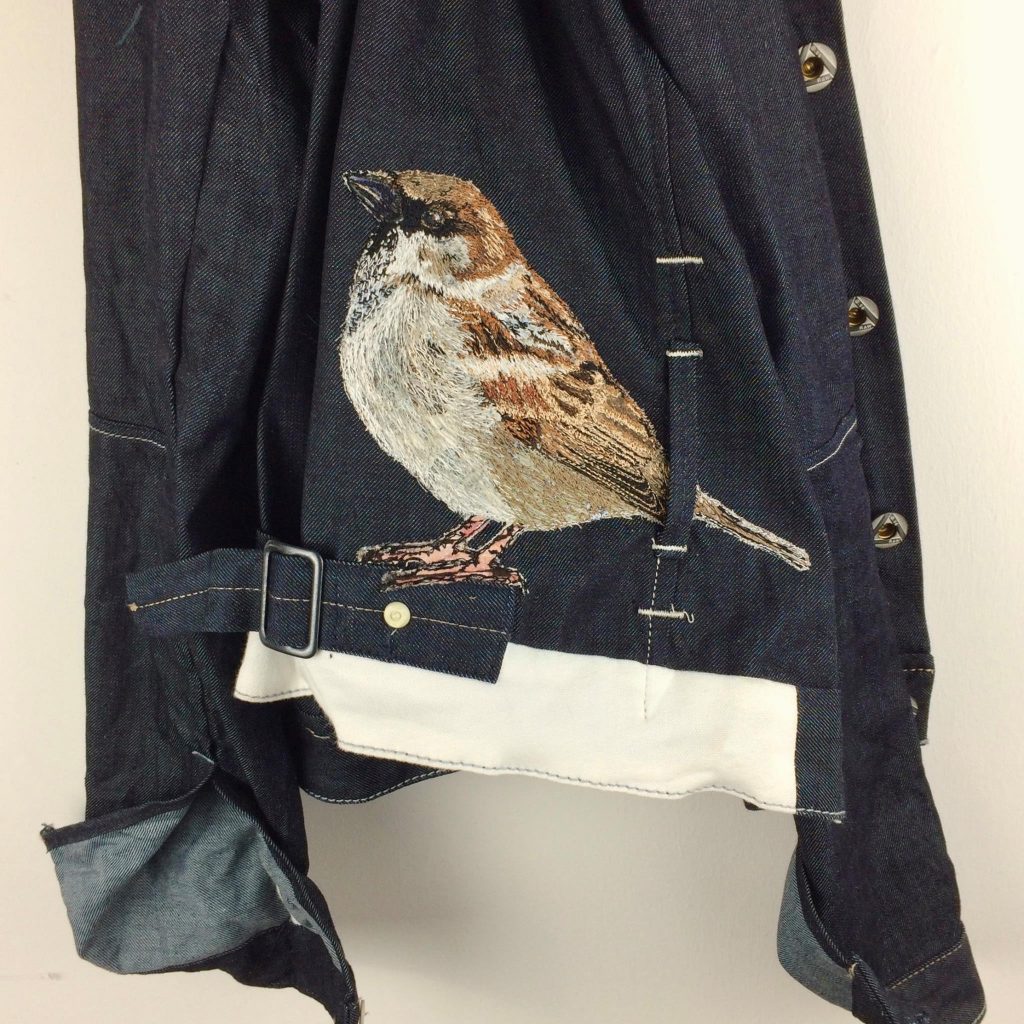
Jacket Sparrow, Detail
Tell us about your relationship with your machine?
I have three machines in my studio, which I frequently work with. One is a vintage, motorized Singer flat embroidery machine from the 50’s, a Bernina Record from the 70’s and my Brother machine I bought in 2011. All three have very different characters and produce very different textures.
I do not have names for them or take overly good care of them to be honest. They have no handmade covers or fancy stickers, but I am grateful for each one to call my own. I am fully aware of the torture I may cause them at times, the stop and go stitching, the endless hours they are ploughing through layers and layers of thread without any symptoms. So, if there is some kind of relationship, it is a respectful one. I am aware that I couldn’t work the way I do without them and I appreciate the fact, that they are all still going strong, all three of them.
When do you get cross with your machine?
Like every artist, I have bad days. Days where nothing works out, time seems to have been wasted because no obvious progress was made, or an idea didn’t work out as mapped out in the head. And it is on those days, that machines tend to tangle the threads, break their needles or refuse to wind bobbin thread – and it is on those days that I have zero patience with anything and that is when I get cross. Obviously totally wasting my energy by directing all my anger towards the machines, but it is the only vent at that very moment and frustration finds its way to be seen and heard. Luckily I have learned over time to simply walk away, after throwing that small tantrum, and switching the machines off for the day.
Discuss the full meaning of your masks.
What are they hiding?
What is behind their eyes?
The subject of the masks has developed over time. When I first started to look into the matter of endangered species and the rapidly growing loss of wildlife, I knew I wanted to use my art as a channel of information and to raise awareness. Back then I didn’t know exactly how powerful art could be, but intuitively I tried to give mine a deeper meaning.
So, the idea behind the masks is that I wanted to make the viewers connect with my subject.
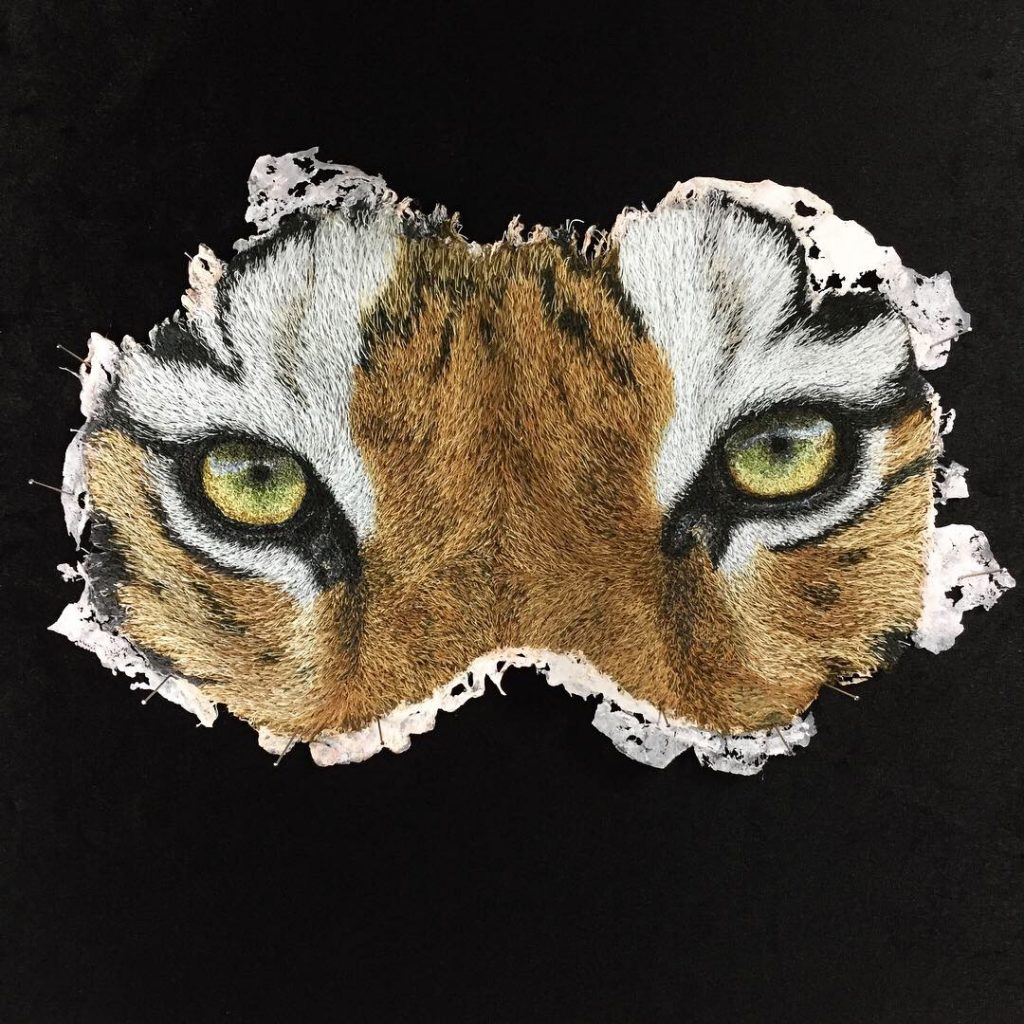
Mask – Sumatran Tiger
I wanted people to meet those animals on ‘eye level’ or equal terms and to make contact, because I believe that you can only care for something, if you are emotionally drawn to something.
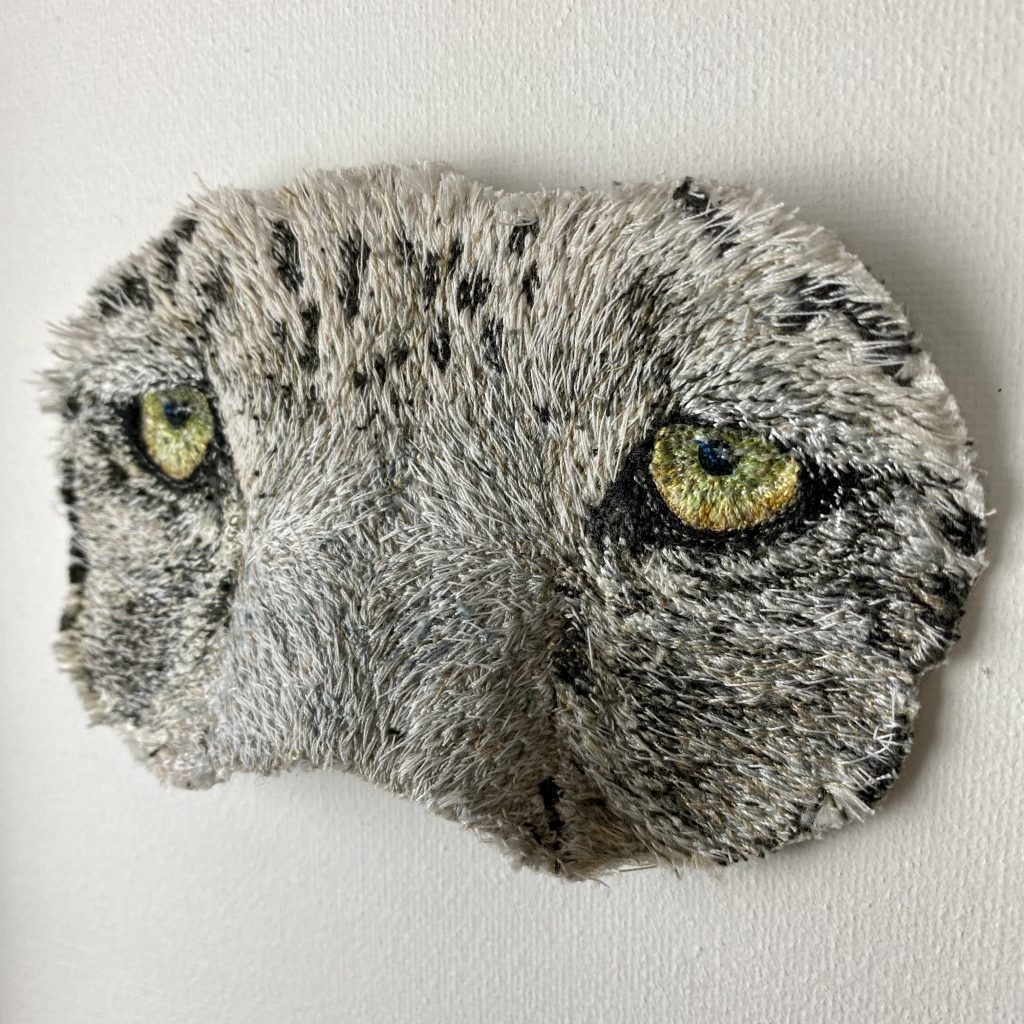
Mask – Snow Leopard
To me, those masks are bearing urgency, sadness and hope. They are hiding so many emotions, and every individual will discover something different behind their eyes. But I think the common ground is sadness regarding the plight of the species and their dependency on us humans to make a change.
With the current urgency that our planet is experiencing, having lost 65% of all our wildlife already according to Sir David Attenborough, my need to create more masks has grown over the past few months.
Show us two animals you have embroidered that are endangered.
Discuss the technical aspect of the work
The background to the animals endangered status
In 2016, I started to focus on endangered species and lending them my voice to raise theirs. I haven’t stopped doing so and I don’t think I ever will either.
Receiving feedback from my followers on social media always fuels my intentions to continue, as they let me know that they for example had never heard of a cassowary before, or that it is for example the plantation of palm trees for extracting palm oil, that destroys the habitat of orangutans. If I can make one person boycott products with palm oil in it, I have already made a change. If I can show people how beautiful a pangolin is, and explain how peaceful they are, they may teach their children and make them aware.
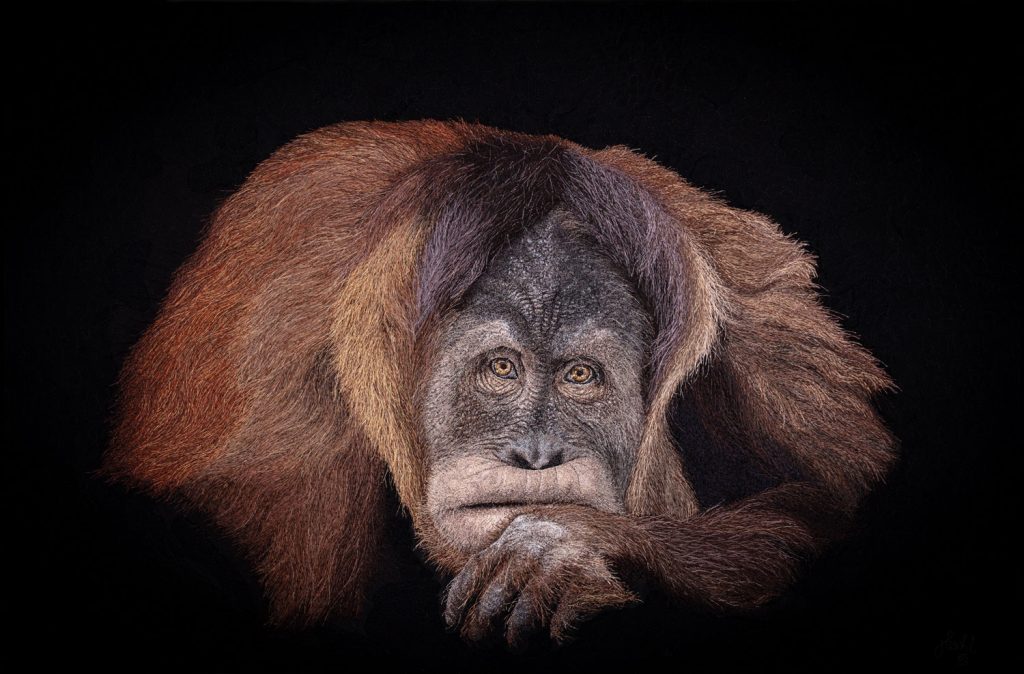
Orangutan. 90x70cm. Photography by Martin Wacht
If I can help make readers understand, that petting a baby lion in a roadside zoo is supporting a wildlife crime, they may think twice about where they will book their safari next. So embroidering endangered animals always comes with a message.
To discuss the process, I chose the portrait of the orangutan and the pangolin, as they entail three different techniques: fur, skin and scales. I mentioned before, that I like to make every portrait a bit of a challenge to me and those two definitely have been quite a journey and a stretch to my wings.
Both portraits, like all my work in large scale, start out with a simple sketch of the outlines of the subject on my base fabric. I often create a line drawing first and the transfer it on my calico fabric with a light board. The next stage is an extensive and very detailed fabric collage for which I usually grab my Batik fabrics, as they create a smoother look. Not that this would make any difference in the end product, as it will all be covered in layers of thread, but I have a need for the ‘ugly stages’ to be pretty as well.
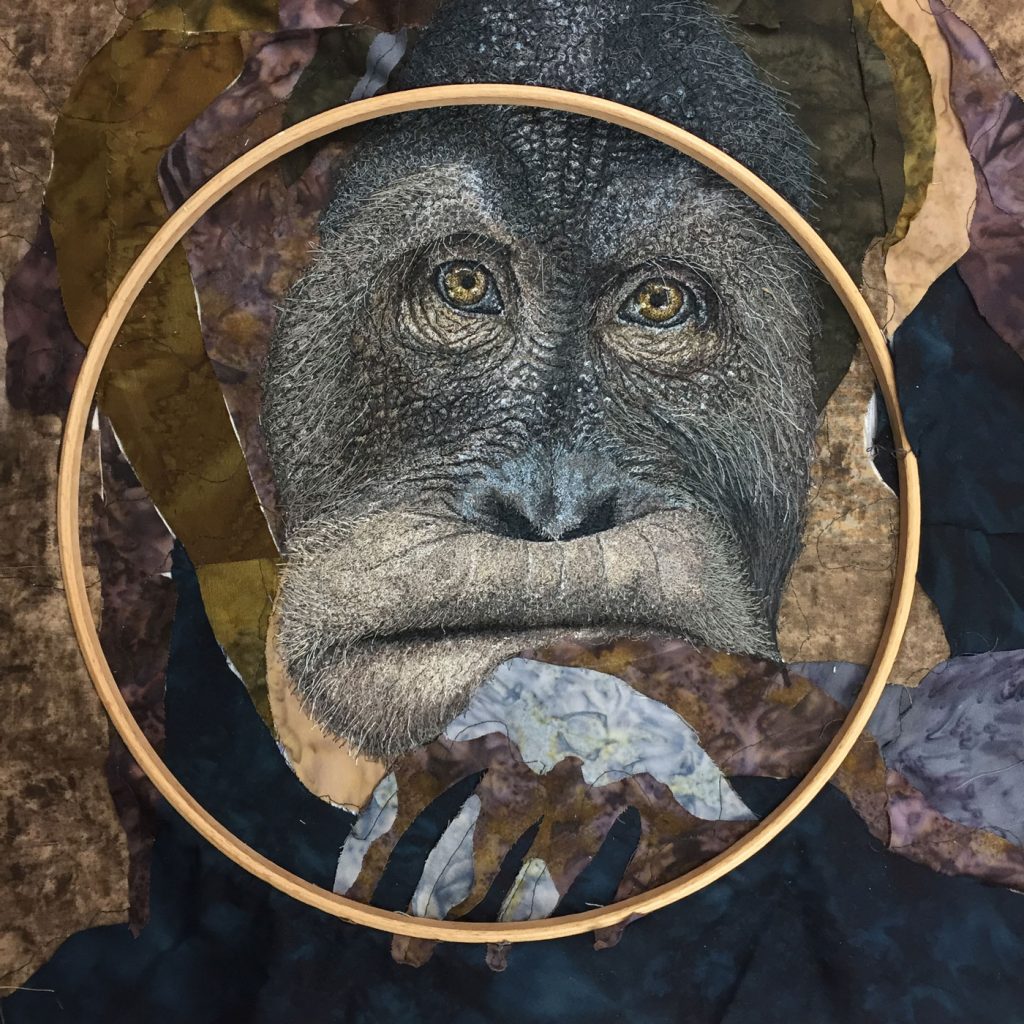
Orangutan. Embroidery process
The most frequent question I get asked is: why do you create a fabric collage and not stitch directly on to your base? Now, there is a simple answer to that, because the collage becomes my navigational map during embroidery. I instantly know where a tiger stripe begins and where it ends for example and I can find the area I am working on much easier on my reference photo that I study a lot during the embroidery process. Sometimes I think I spend more time staring at the photo that embroidering the portrait, but it takes time to study all the details and to identify all the colours involved. The collage process also helps me study my subject in more detail and I familiarize myself with patterns, texture and fur growth direction for example. It lets me study highlights and shadows, which play a major role in photorealism.
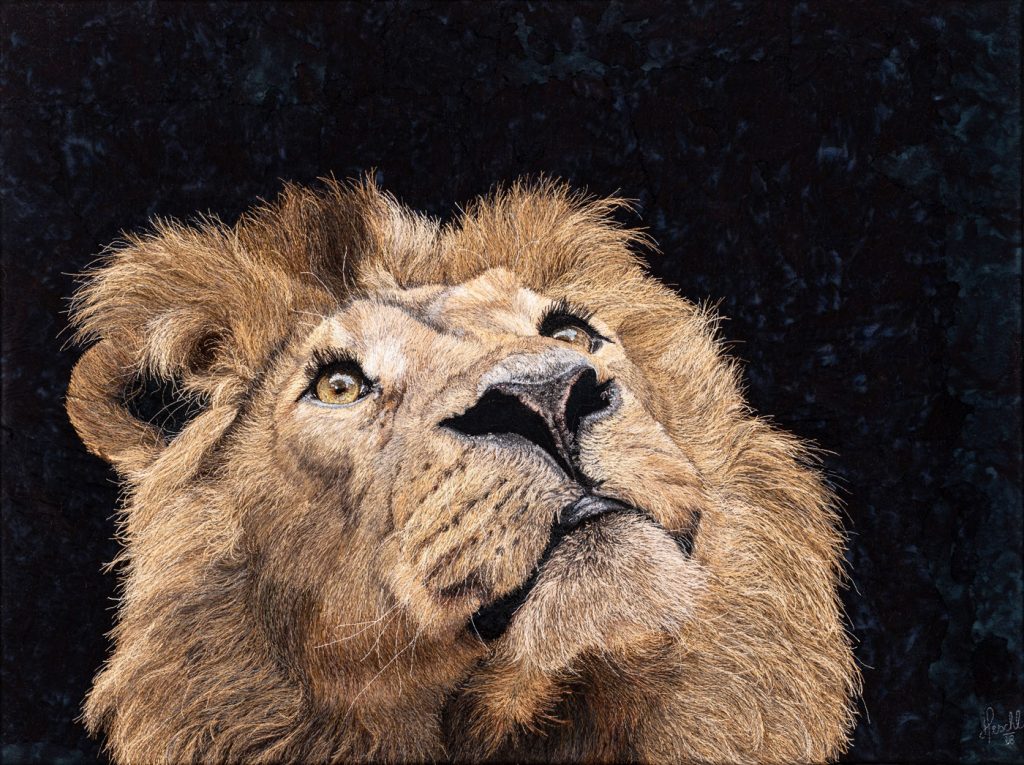
African lion. 80x60cm. Photography by Martin Wacht
Once the collage is lightly glued down with regular glue stick, I start my embroidery process and that always begins with the eye(s). They are the windows to the soul, as they say. To me, they are the window to emotion and to connection with the viewer, and so I spend a particular long period of time on them. After that I work my way around the portrait, focusing a very small areas, no larger than 10x10cm at once, to really let myself zoom in and capture all details. When working on skin, like the face of the orangutan, or working on scales like the ones on the pangolin, I use freeform ‘zigzag’ stitching and build up the texture by applying light layers of thread in coordinated shades. Wrinkles and hard lines are added at the end, to make them more effective and they are always accompanied by a shadow and a highlight. And the big bonus of stitching skin and scales is, that you can always go back over them with another layer, if the tone needs adjustment – no unpicking!
The approach when stitching fur is very different to what I described above. Fur comes in neatly stitched layers, starting with the darkest colour, working up to the highlights and then going over the area with medium tones again for blending. The highlights are added at the very end and are usually single stitched hairs in the lightest colour available, to make them pop and create movement. I have learned that there is not one technique that can be applied to all animal portraits. As unique as they are in nature, as unique are the approaches in embroidering them. There are certain basics, but I have not once completed an embroidery that did not require me thinking about a new technique or completely out of the box. Not even stitching the same subject saves you from not having to think about new approaches and that is why I enjoy my work so much and love what I get to create, because it keeps me on my toes and keeps developing my skills and makes me journey so very unique!
You have lived and studied around the world. Comment on how ‘Global’ this has made you feel. (perhaps with a story)
After completing high school, I went globetrotting and lived seven years abroad to study operational management for film and TV in England, special effects make up in Canada, Tourism Management in Wales and working in hotels in Ireland and Spain. I tried to find my potential in all these years and one education formed the stepping stone for the next, totalling to six completed degrees with only one being of a creative nature. It simply wasn’t what I had myself down as, back then it never crossed my mind to become an artist. I enjoyed people and the company, I found pleasure in working in the service industry and being away from home. Connecting with people from all over the world literally made my world. But it never made me truly happy and was only a small fraction of my path to my true potential. After becoming a mum with 31, finally having agreed to settle down in one spot, my creativity started to flourish. Like it was waiting for me to hold my feet still and finally be heard. All the traveling and spending time abroad has been a vital factor for my artistic career, as I am able to share everything in English and making it easy for me to establish connections with fellow artists, event organisers and collectors. I feel that I can take part in the artistic world without many boundaries and much confidence, at least what language is concerned.
Tell us about the significance of finding your own personal working space.
Being a mum of two, I always had struggle to find time for my creativity. Carving that out for myself, created the need for my own studio and I am very blessed to have been able to ‘carve’ that out for myself too in our house. I now inhabit quite a large studio that I share with all my animals, and it has become my safe place. I have the liberty to create a mess without having to clean it up, I get to retreat and throw tantrums in it, I can let my creativity and emotions run wild and there is no judgement. It truly is my safe place and there is nothing in the world I would trade it against with.
Comment on the community of the textile world.
The textile art community is strong and incredibly supportive. Especially over social media, I have met the most kind and loving people, that are there for you on bad days, that celebrate with you every little sale you made and that tag you in ‘calls for art’ because they think you could rock it. It doesn’t really get better than that – artists supporting artists, women supporting women (and men, there are fabulous male textile artists out there too!). The hashtag #communityovercompetition says it all.
You often work on isolated parts of the animal’s body, eyes, or mouth. Why do you use these perspectives?
Very similar to the masks, I want to draw attention to the details of the endangered animals. I want my audience to take a closer look, to zoom in and discover not only single threads, but the utter beauty in our fauna! I want them to connect to the wild, to take the time again to appreciate the beauty in things. Time has become such an important factor in our society, that no one seems to take it anymore to stop and look at details. It is like people are trapped in a race and the appreciation of natural beauty is lost.
What background fabric and how many layers do you use?
My background fabric is mainly medium weight calico or a poly cotton mix, depending on the size of the subject. Calico is a lot more flexible and easier to stretch on artist canvas before framing, so this is my number one choice and a single layer is sufficient.
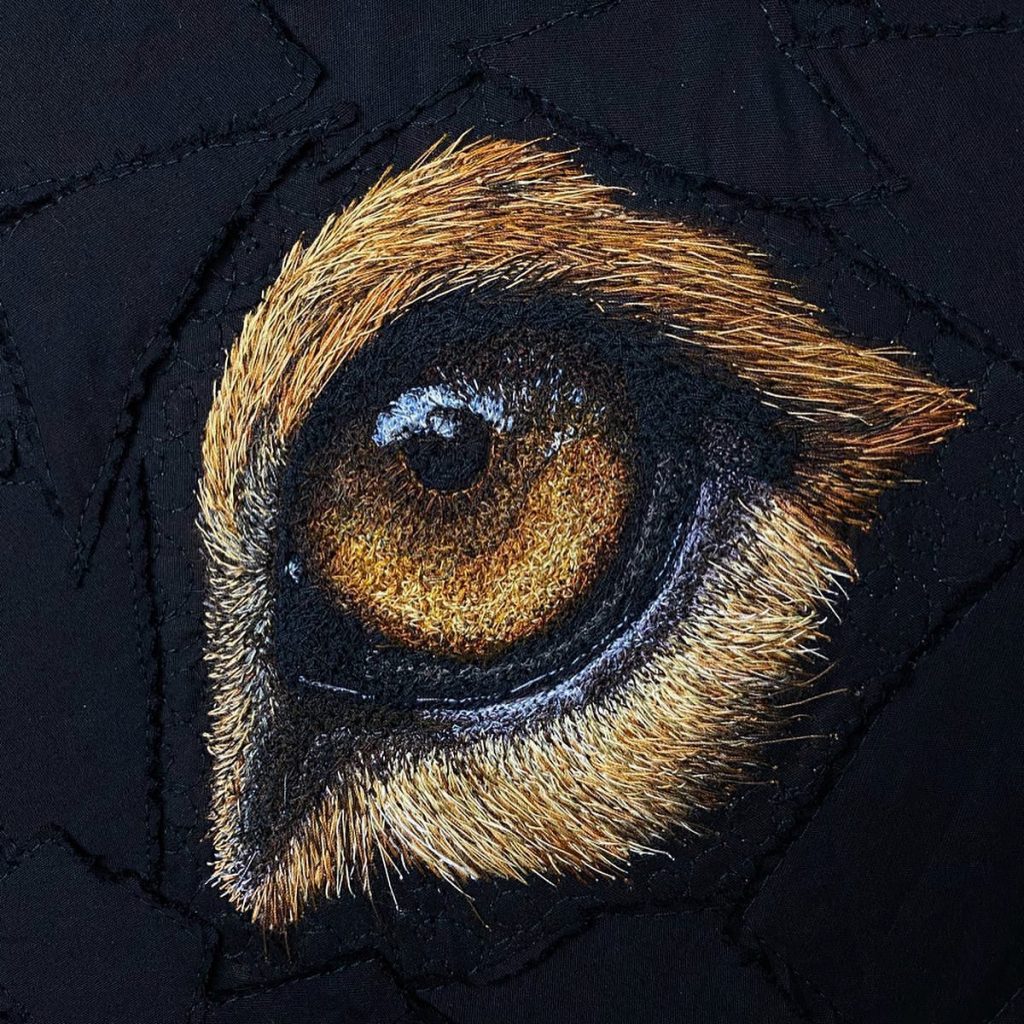
Explain the impact of using the humble embroidery hoop in your work.
When I started out with machine embroidery, there was a lot of experimenting with different materials. That also involved stabilizers of all sorts, trying to avoid the fabric to budge under all these layers of thread. It took a good two years to finally discover, that a simple wooden hoop in combination with the right fabric and the right density of thread would do the trick. No stabilizers, no cutting embroideries and transplanting them onto a new background needed.
Video
Video of working on you bird.
Questions that I want to ask after watching this video…
How many coloured threads do you use in this piece?
I don’t remember the exact number of coloured threads I used in this piece, but there must have been something like 45 of them. My rule of thumb is to use at least three shades of every colour that I identify in the reference photo, to create realism.
How do you set up the threads so that you have quick access to them?
I have large working tables next to my machines, and the threads are spread to the left of me, colour coordinated and in little groups. I need them to be all on display, so I have the chance to find the correct shade I am looking for. It does look very chaotic, but it actually has a system to it.
How do you achieve the translucency of the wings?
The wings have been an extra challenge, as I wanted them to be detachable and 3D. So, I practiced sandwiching a piece of golden organza fabric into Sulky Solvy stabilizer and stitched all the outlines and wing details onto the stabilizer in coordinating thread. I had to repeat that process three times before I got them delicate enough to match my macro image of a bumble bee. But the organza fabric worked a dream and really pulled off the realistic look I was hoping for.
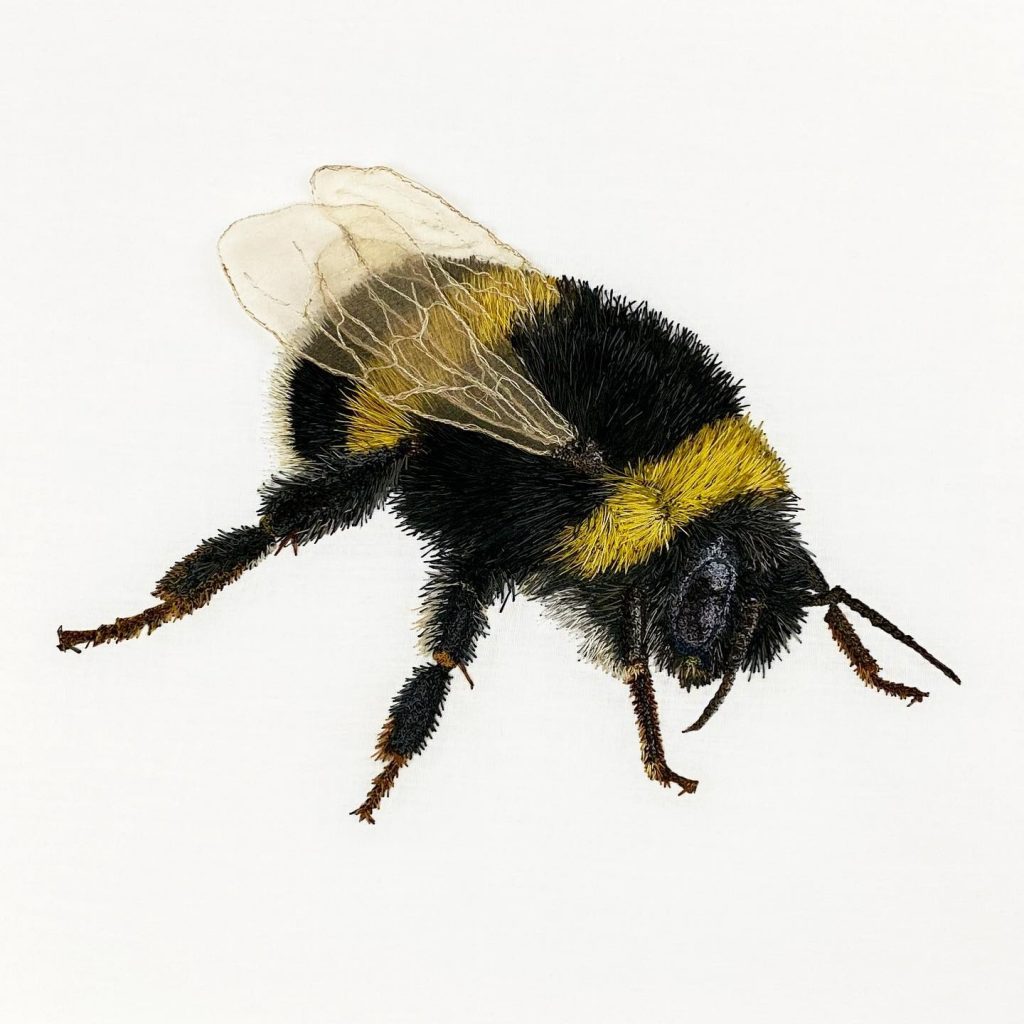
Macro Bumblebee with 3D wings.30x30cm
Have you done any bugs or insects?
Apart from bees, I have never fully embroidered any insects or bugs. Although, coming to think of it, their textures and colours are incredibly beautiful, so maybe I am going to look into that subject matter soon!
What is your next project?
My next projects, that I am very excited about, are two pieces that once again highlight endangered species. For one, there will be another Amur leopard mask in the making and another chimpanzee portrait, of which I stumbled across its reference photo and instantly felt the need to translate it into thread. So, this is what I will be working on until the end of this year and I couldn’t think of a better way to celebrate the end of it – with an important statement to protect our wildlife!
Take one piece that has both given you joy to make and have a great background story.
If I had to choose a piece that has given me the most joy to create, I would pick my portrait of the Gombe chimpanzee. I received the commission from the Jane Goodall Institute – Austria to create a gift for the world-famous anthropologist and UN ambassador of peace, Dr. Jane Goodall, to celebrate the beginning of her extraordinary journey 60 years ago in the forests of Gombe, Tanzania.
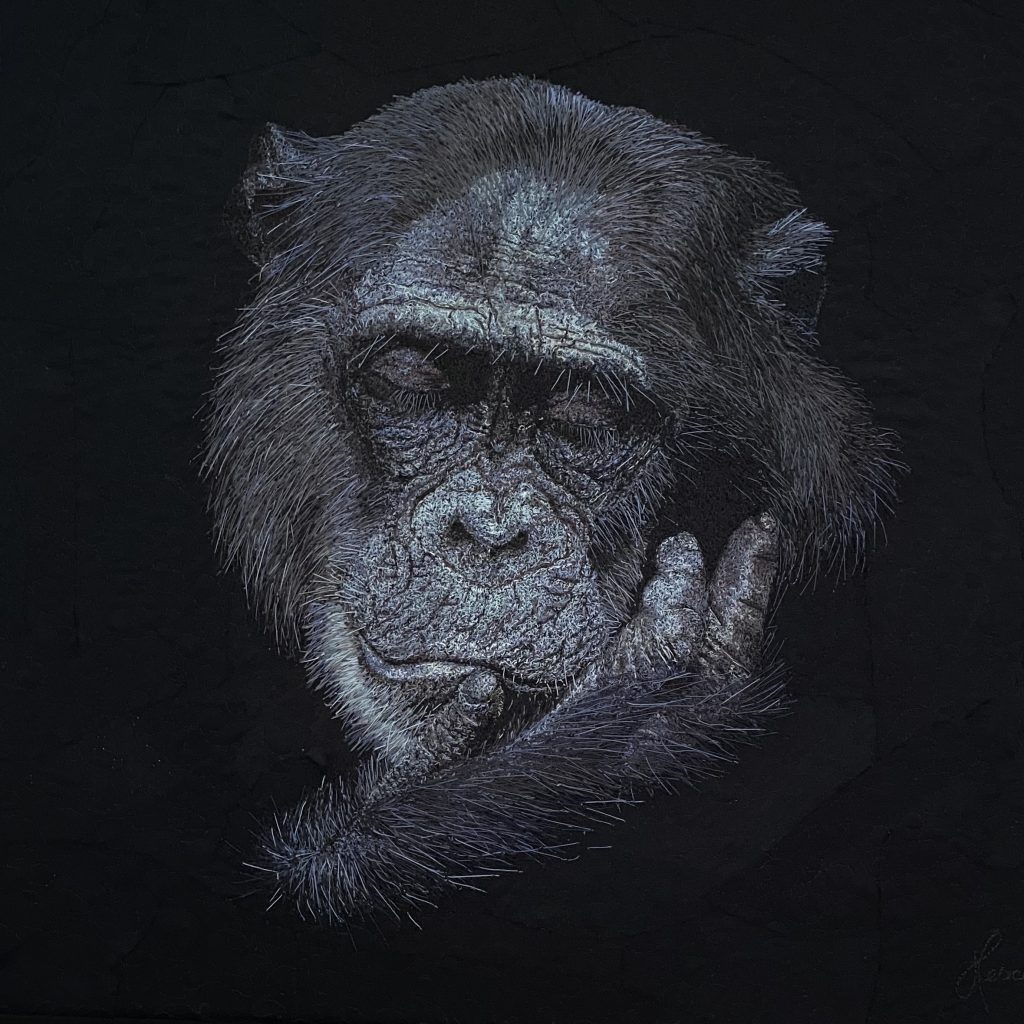
Dr. Jane Goodall commission. 40x40cm
I remember spending a long time trying to find the perfect reference photo, the perfect pose of a chimp from Gombe National Park , and my joy when I suddenly found it. I am not sure if it was the pose of the chimp, the lighting I chose, or the emotion the animal carried, but it turned my embroidery process into bliss. I chose my vintage Singer machine for it and in unity the portrait evolved with such ease. There were tough areas to come by, but none that caused anger or frustration. Stitching the single hairs on the wrist and the top of the head just came naturally and this has also been my very first portrait that had no stitching of eyes. The first piece, that wasn’t defined by the look or emotion in the eye, but the pose and shading.
The portrait is still with me and waiting to be received by Dr. Goodall in person, once traveling and events are safe to host again
Discuss your comment, “If you haven’t found your favourite animal here (on the site). No worries I always make time for special commissions.
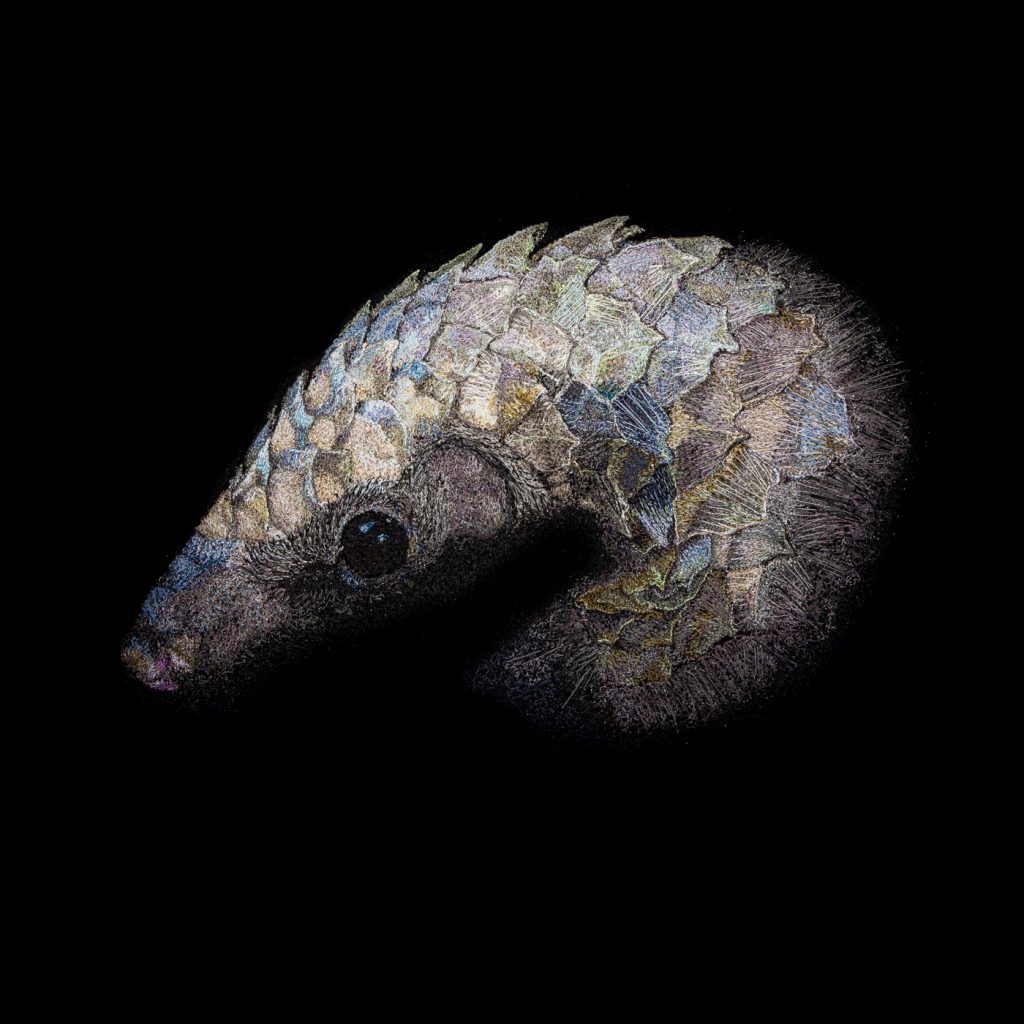
African Tree Pangolin. 50x50cm. Photography by Martin Wacht
I have an incredible community and a very supportive environment around my artwork and over the years built up a small field of collectors who appreciate my work and fund my business. For a long time, I just created work and every now and then one would get adopted and find a new forever home. But over the past few months, I have had people approach me for awesome commissions and that was a great experience for me, because I got to do animals, like a Great Horned Owl, that I would never had thought of creating. An incredible challenge and a first for me to dive into stitching feathers.
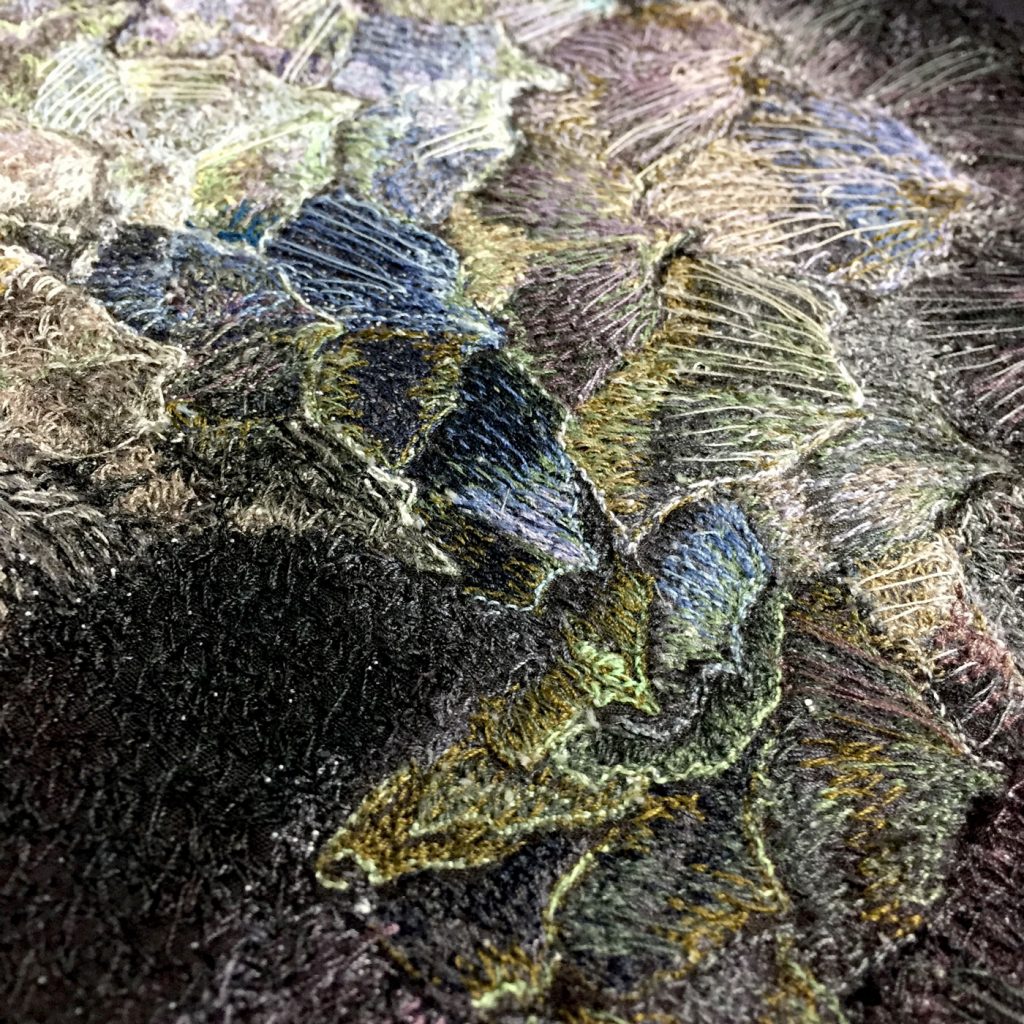
African Tree Pangolin, Detail.
I welcome challenges at all times, as they mean growth to me and those special commissions stretch my wings a lot
Contact:
Janine Heschl
IG: @textile_wildlife_art
FB: www.facebook.com/textilewildlifeart
Deborah Blakeley, Melbourne, Australia
Interview by Deborah Blakeley, November, 2020
Tina Vlassopulos
When did you decide to do one-off built pieces?
I studied ceramics in the 70s when an interest in sculptural ceramics was just beginning to grow but there were only a handful of colleges that encouraged you to explore all the possibilities inherent in making things out of humble clay. Luckily, I was accepted on the BA course at Bristol Polytechnic, which was a very forward-thinking course. Although I tried all the different pottery techniques, it was the versatility and freedom of hand building that appealed to me most and suited my personality best.
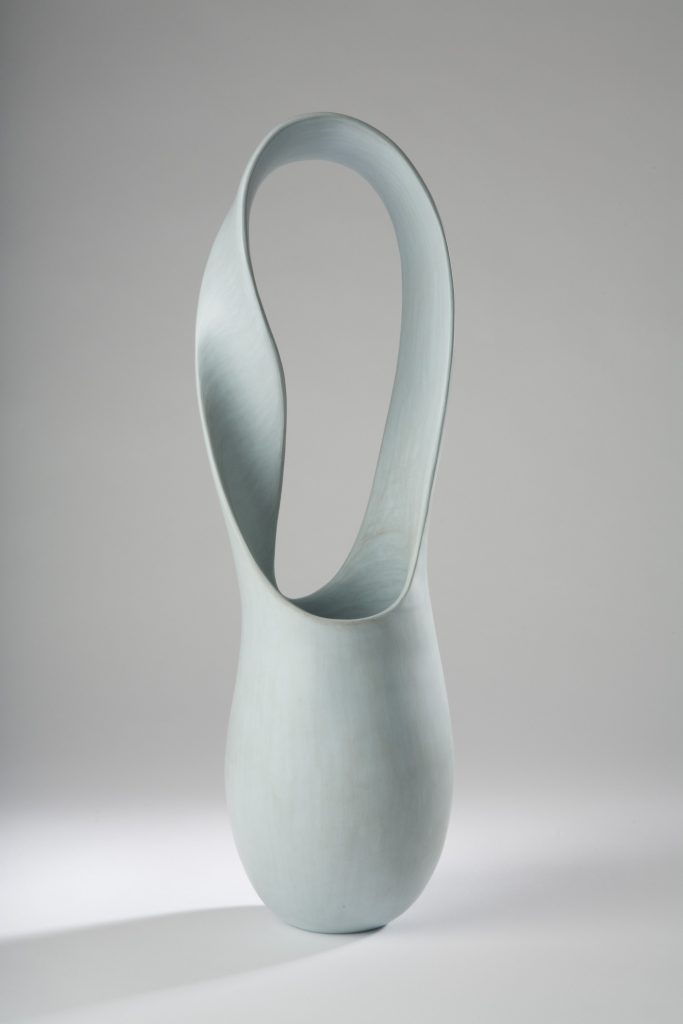
Moebius
Your colour range is very feminine discuss this choice.
The forms and concepts I come up with are my primary concern and clay is my medium of choice. I’m afraid that I’ve never been interested in the technical side of ceramics and find mixing glazes a terrible chore (although I marvel at what other potters can achieve through glazing). I discovered early on, with some relief, that it was possible to leave the clay naked so I started mixing oxides and stains into the clay, which produces pastel shades.
Nowadays I mostly use the clay straight out of the bag without any additions and have started to flock some of the pieces to give colour and a contrasting texture. This allows me to choose colours that have specific meanings or emotive connotations.
Can you discuss the use of colour in the work, ‘Portrait of Fanis’?
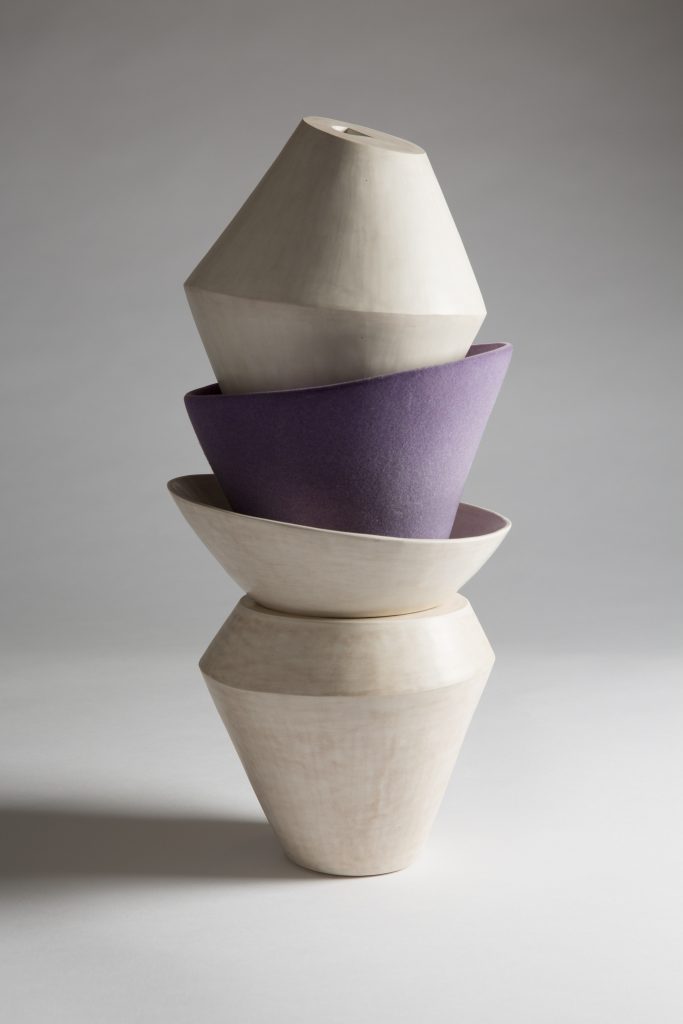
‘Portrait of Fanis’
‘Portrait of Fanis’ is part of my installation ‘Conversations with Friends’.
It took me a long time to work out how to portray Fanis who is a very dear old friend with an amazing and interesting life story, multi-faceted and many-layered with an oppressive family and many personal hurdles, which he managed to overcome with dignity, honor and a noble spirit. He is warm, gentle and loving once you get to know him but complains that he gives the wrong impression when he meets people for the first time.
It occurred to me that purple was the colour that suited him most: it is foremost a majestic colour and is created by combining a strong warm with a strong cool colour which seemed to me to be the perfect fit.
When Fanis saw his ‘portrait’ he exclaimed, “That’s exactly how my therapist described me: unsteady but with a solid core!”
You comment about your pieces as , “Abstracted portraits of friends, representing their character.” Expand on this comment in relations to the work.
In 2019 I made an installation entitled ‘Conversations with Friends’ which consisted of 14 abstract portraits of my friends. Rather than attempting to illustrate them literally, I wanted to represent each friend’s character, disposition and psyche in a subjective and symbolic way. A kind of allegory.
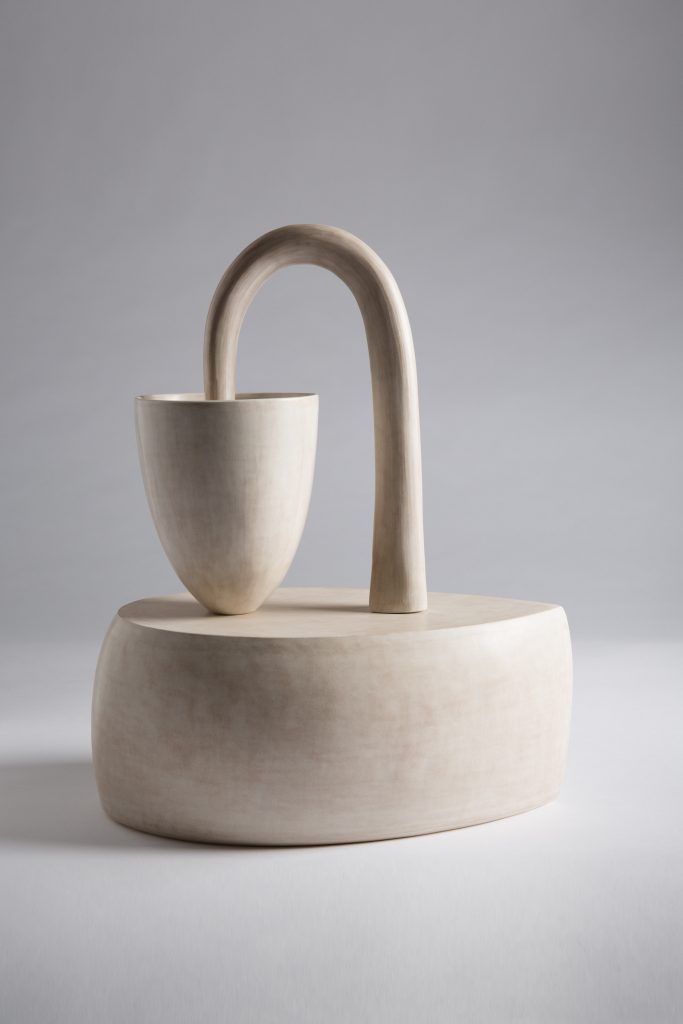
Harjit’s portrait
Each portrait was an assemblage of shapes containing multiple elements to symbolically express and inform my view of a particular friend. Some symbols were obvious, while others were more ambiguous requiring time to unearth their meaning.
It was a very interesting project, as I really had to rack my brain about each of my friend’s character and then come up with a new language to express myself. I found it really difficult in the beginning as I kept coming up with the same 3 adjectives that fitted all my friends’ characters: generous, intelligent and loving. I wrote lists of their attributes and spent hours thinking about each one. It was a very special time and has made me appreciate how lucky I am to have them in my life.
Surprisingly, my oldest friends proved to be the most difficult ones to conceptualise. I think that when you know someone for a very long time, it’s difficult to analyze what draws you to that person as they become an honorary member of your family.
In the beginning the portraits were more literal. For instance, Harjit’s portrait is about balance (she’s a judge), her shoe fetish (the shape of the base) and her appreciation of a good glass of red wine (the cup) but the more I worked on the portraits, the more abstract they became.
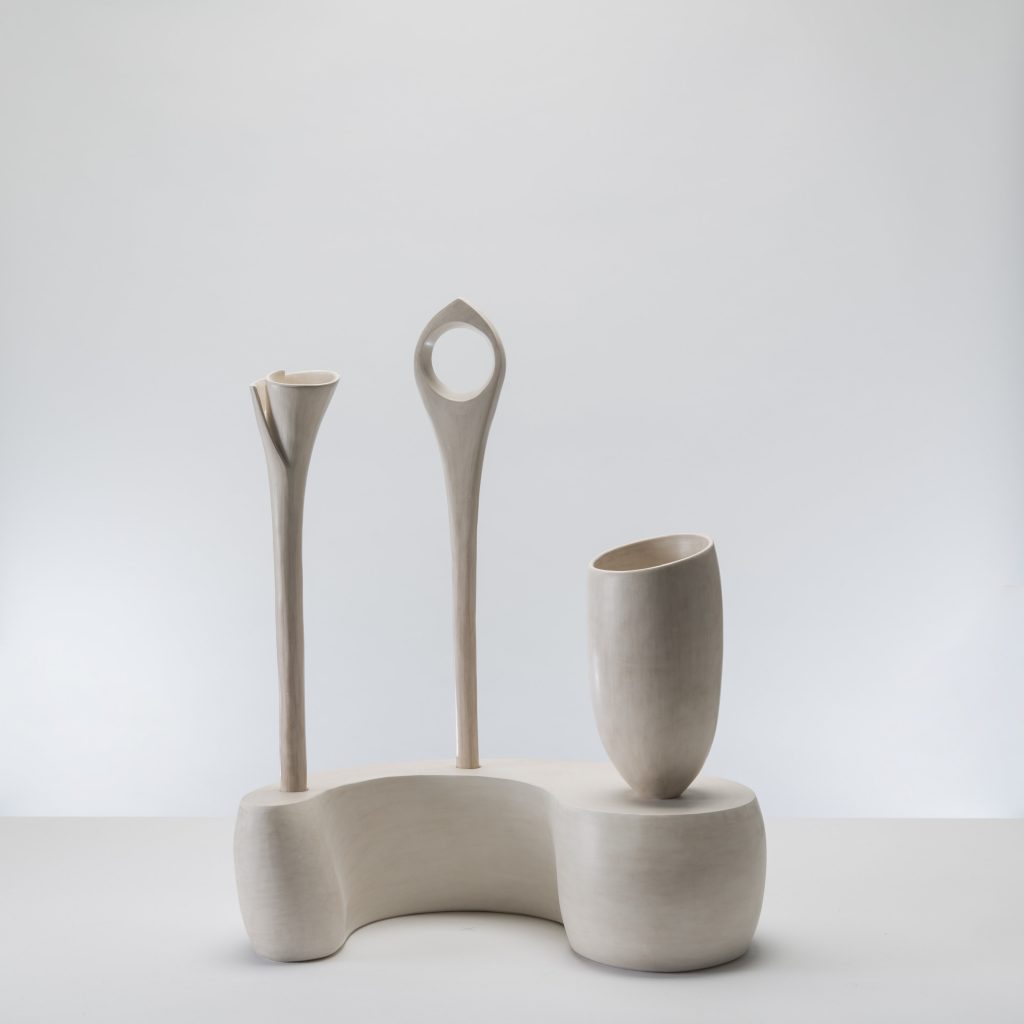
‘Portrait of Lesley’
I met Lesley 46 years ago at uni. She’s always been a fantastic listener and she’s an amazing film director so ‘Portrait of Lesley’ is all about the ear and the eye. The base is an abstract ear shape as is the standing flower (also symbolising her beauty) while the lorgnette symbolises her wonderful eye and perceptive and insightful nature.
Take ‘Curlicue’ discuss the work
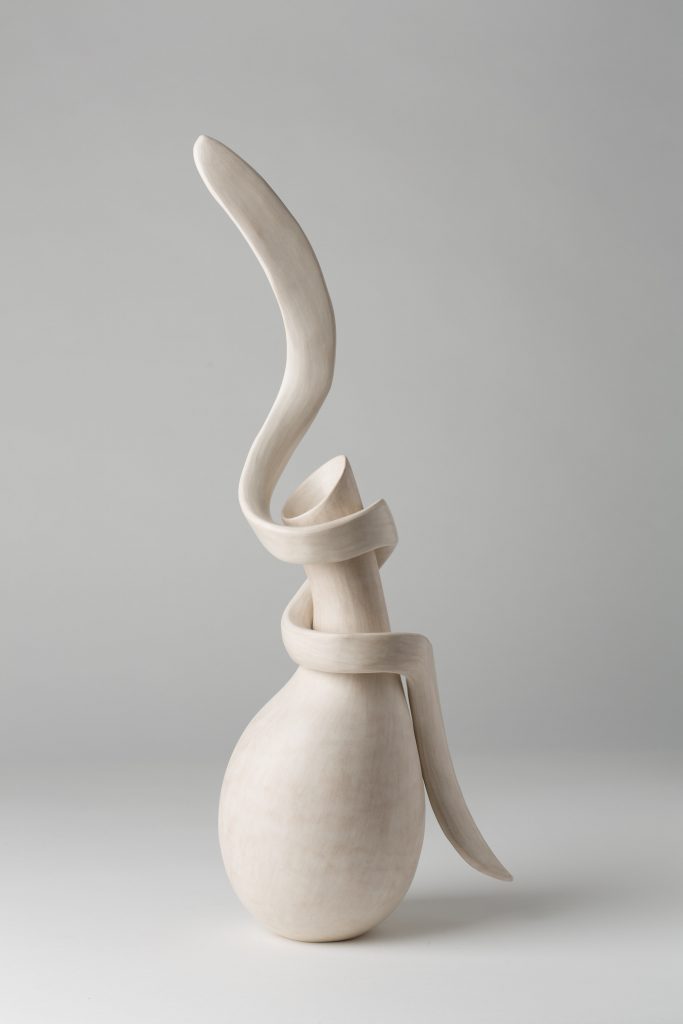
Curlicue, 48cm H x 20cm W
Curlicue, 48cm H x 20cm W, hand built using white stoneware clay, burnished and fired to 960C.
‘Curlicue’ is part of a group of work, which was inspired by the breathtaking rainforest I visited in Peru where nature in its unfettered glory has taken over and the extraordinary vines and creepers that grow there, with their tendrils twirling and winding around each other, all competing to reach the sunlight.
It is made up of 2 pieces that fit together. It was not possible to fit the 2 pieces together until the piece was fired because it would’ve damaged the burnished surface so I had to make several ‘tendrils’ and hope that one of them fit as I envisaged.
I was really disappointed as none of the ‘tendrils’ I made fitted the bottle-shape. Then my partner walked into the studio and picked up a tendril that I’d made for another piece and convinced me to try that one on instead. It was definitely one of those ‘glass slipper’ moments: not only was it the perfect fit but it turned it into the most successful and dynamic piece I have made so far in this series of work.
Discuss the importance of clay for your work.
I’m drawn to clay as it is malleable, flexible and transformable. It is also a down-to-earth (excuse the pun!) and humble material; one that suits all sorts of different personalities. Hard, soft, organic, geometric, from toilet bowls to false teeth to space shuttle tiles - anything and everything goes!
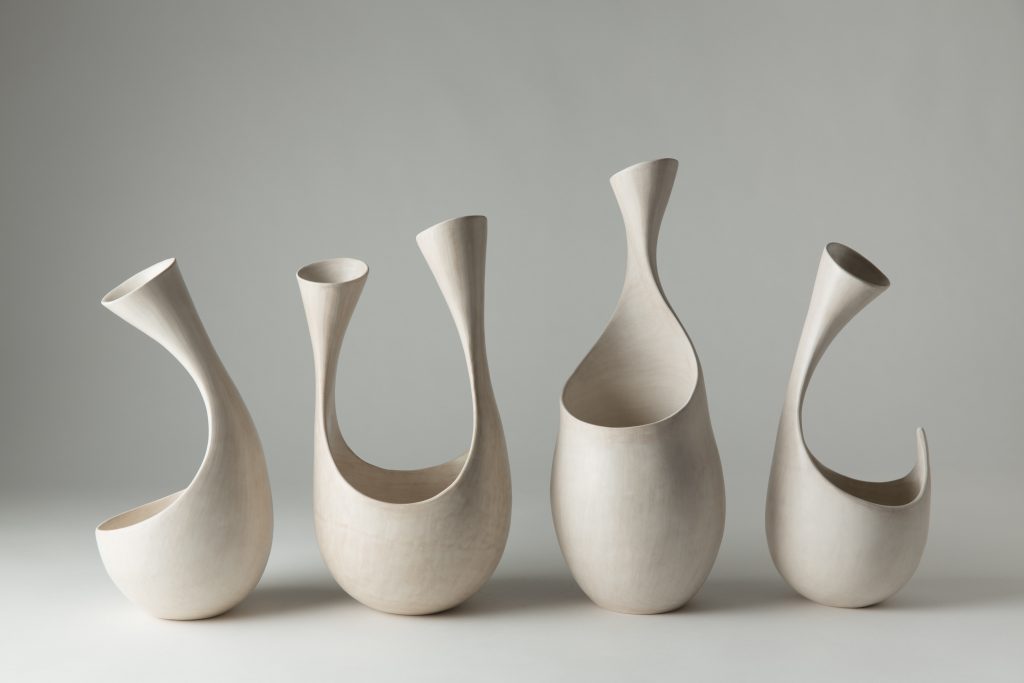
Ode
Your composition is so important in ‘Portrait of Yo’, comment on the piece as a still life.
Working on the portraits of my friends for the installation ‘Conversations with Friends’ allowed me to look and think in a new way. Once the shapes for each portrait had been designed, they were placed into a specific arrangement to make the whole meaningful, balanced and appealing. This took many hours of contemplation, work and scrutiny. There is a magic moment in the process of assembling a still life when it suddenly appears as a visually coherent piece and a nature morte is born.
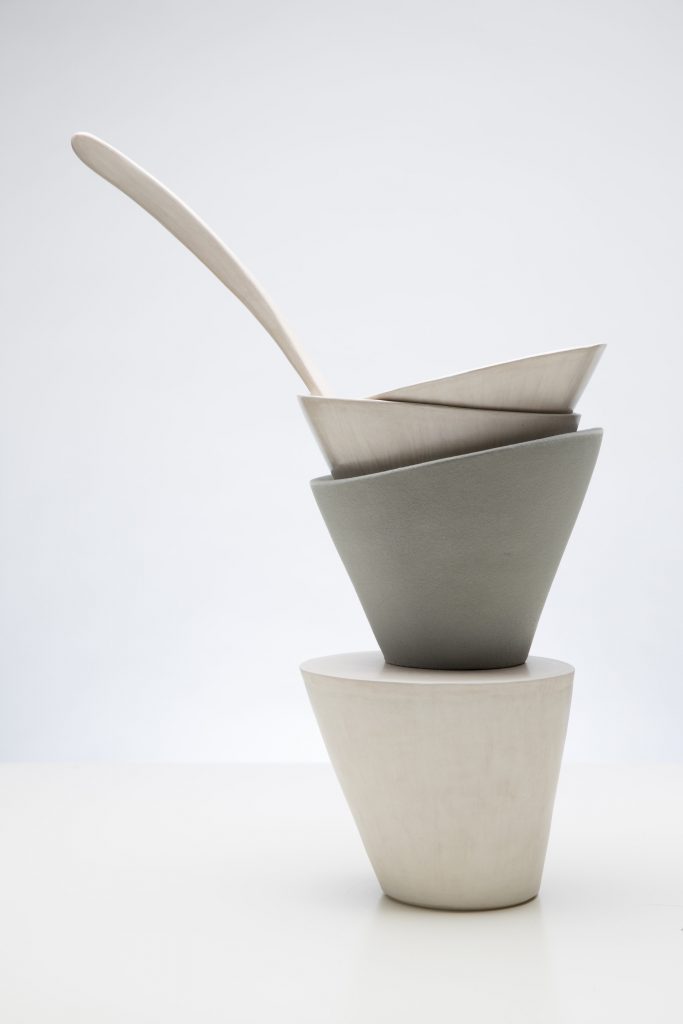
‘Portrait of Yo’
‘Portrait of Yo’ was built up over a number of months of consideration, experimentation and much trial and error. Yo is a woman of many talents, highly intelligent, extremely amusing and oozing with charm. I was very concerned that the piece made a balanced and harmonious still life but at the same time wanted to depict Yo’s endearing clumsiness. While I was making the piece Yo managed to trip up and break her rib which gave me the idea for the element that was missing in the piece.
Adding a ceramic ‘rib’ to the portrait gave it the extra edge I was looking for and condensed the piece into the essence of Yo. A piece that was elegant but slightly awkward.
You show movement and fluidity in your ceramics, can you expand on this and how you also work with groupings.
I take a lot of inspiration from the performing arts especially ballet, contemporary dance and opera. Attending a live performance seems to unlock my creativity and allows me the time to freely roam around in my imagination.
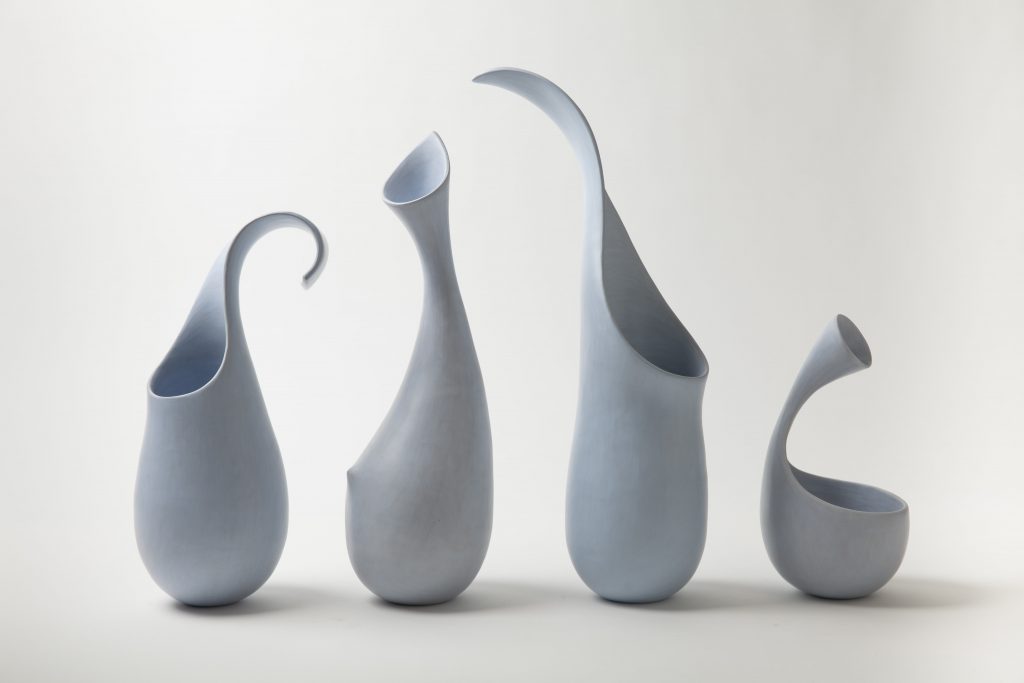
‘Blue Note’
As a homage to the gift of the performing arts, I set myself a challenge to depict undulating melodic motion. In ‘Blue Note’ and ‘Ode’, I attempted to capture the rhythm and flow of music and dance. By deciding to make a group of inter-relating forms I came closer to emulating musical notations and attempted to give the pieces tempo, inflection and movement.
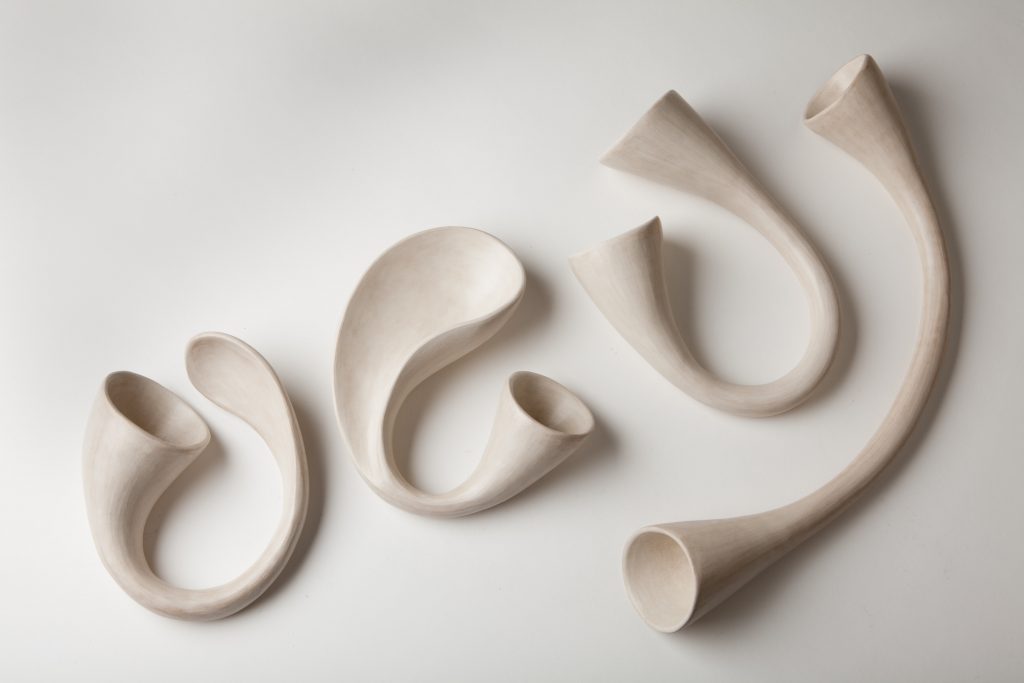
Ode wallpiece
There is a piece called ‘Ribbon’ that shows the actual word – ribbon, discuss.
I’m always on the lookout for new ideas and a lot of them come from really mundane and unromantic things. The idea for ‘Moebius’ was born on the way home from the supermarket when the bag I was carrying got twisted round my wrist.
Most people find it irritating that the postman drops elastic bands everywhere, but I think they produce delightful little random shapes worth noting. I’m afraid that ‘Ribbon’ was inspired by an elastic band I saw curled up on my front step.
But I couldn’t bring myself to call the piece ‘Elastic Band’ so I called it ‘Ribbon’ instead.
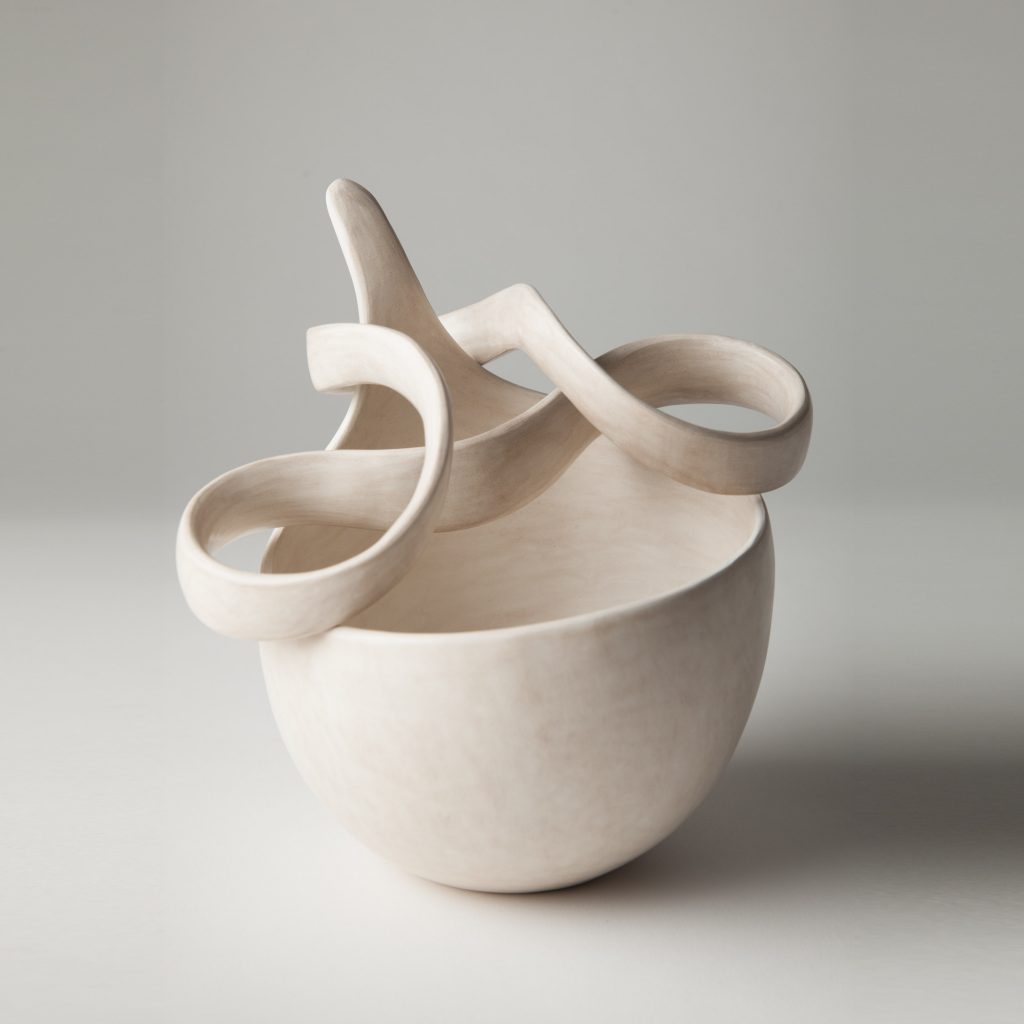
‘Ribbon’
How do you come up with such charming names for your work?
Thank you for your kind words - I’m surprised to hear that. I think that the titles given to a work of art are a very important part of the work as it gives a clue to what the artist was thinking although personally I sometimes prefer something more ambiguous to allow my imagination to wander.
Although I’m not very good with words, I really enjoy them in literature, poetry or as little disembodied organic beauties and the truth is that I place great importance on the name I give a piece. I spend hours pouring through dictionaries and leafing through my 1966 edition of Rojet’s Thesaurus (which has many more interesting words than the later editions) to find the right title for a piece. Sometimes I succeed but other times I give up in frustration and end up calling the piece ‘Vessel’ or ‘4 pots’
Movement and layers are shown in your work discuss this using ‘Wrap’ and ‘Unravelled’.
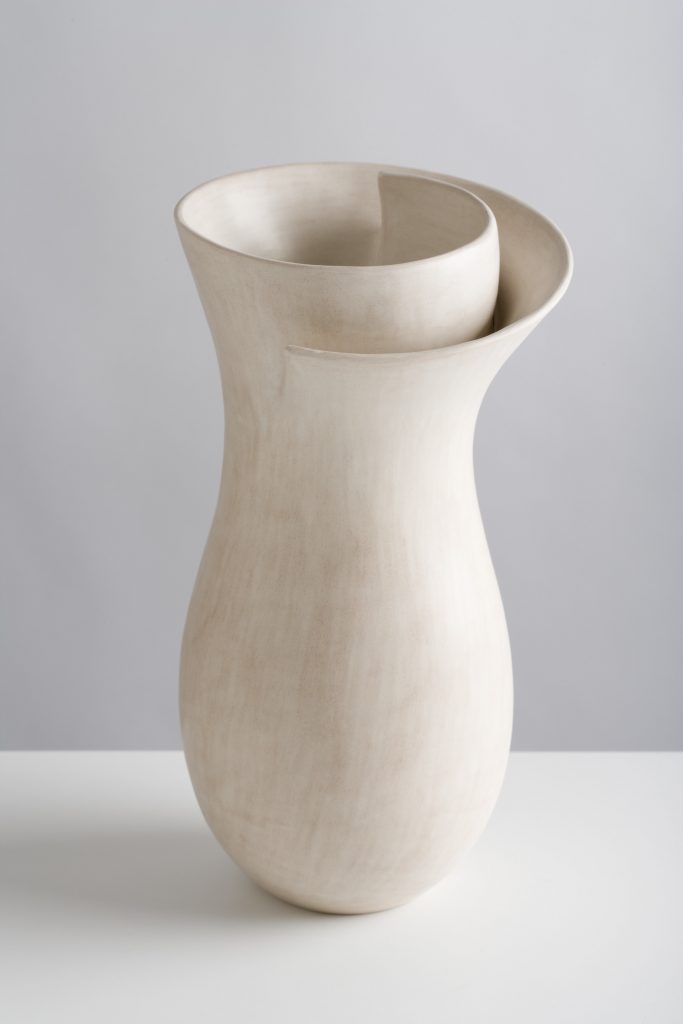
‘Wrap’
I have always been fascinated by avant-garde fashion and try to keep abreast of new designers. I am interested in how the body can be used as a sculptural silhouette and especially the art of deconstructing and reconstructing as seen in the likes of Galliano, Supriya Lele, Yohji Yamamoto, Raf Simons and Issey Miyake.
Both ‘Wrap’ and ‘Unravelled’ have these interests at their heart.
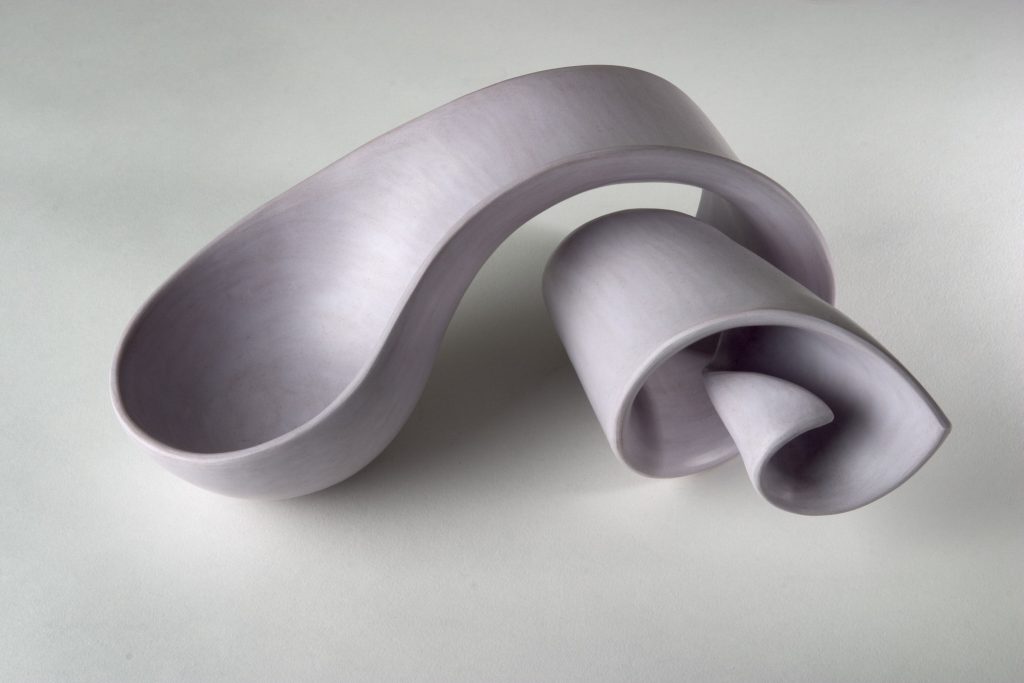
‘Unravelled’
The shapes of your work are often bowls and vases but you have removed the need for objects to be held in them. How do you control the void?
A bowl that proclaims its function but is purely symbolic adds to the ambiguity of my work and draws attention to the nature of clay as a material which straddles 2 worlds.
The empty space is there to be filled by the viewer’s imagination.
Tell us about the Matthew Burrow artist support pledge?
Matthew Burrows came up with a marvelous and very generous initiative to help artists during these difficult Covid times. Artists use Instagram to post and share their work using #artistsupportpledge. The work has to be priced no more than £200 and every time an artist reaches £1000 in sales, they pledge to buy £200 of work from other artists.
Has there been a piece that on completion you have not been able to sell because you love it so much? If so why?
I make things which hopefully will give other people pleasure so the only pieces I’m left with, are the ones that haven’t sold. The most crucial thing for me is the stimulation that comes from using my imagination and the contemplation of the making process. I’m very happy when my work finds a home - in fact it’s a blessing as it makes space for more making.
Contact:
Tina Vlassopulos
www.tinavlassopulos.com
tina@tinavlassopulos.com
instagram: tinavlasso
Interview by Deborah Blakeley, November 2020
Blakeley, Melbourne, Australia
Margaret Jones
Can you explain ‘The Way of All Flesh’?
This piece came out of seeing the scans of my Mums brain when she was diagnosed with vascular dementia. It is not a replica of the scan by any means but the image grew in my mind and after much thought resolved into this piece.
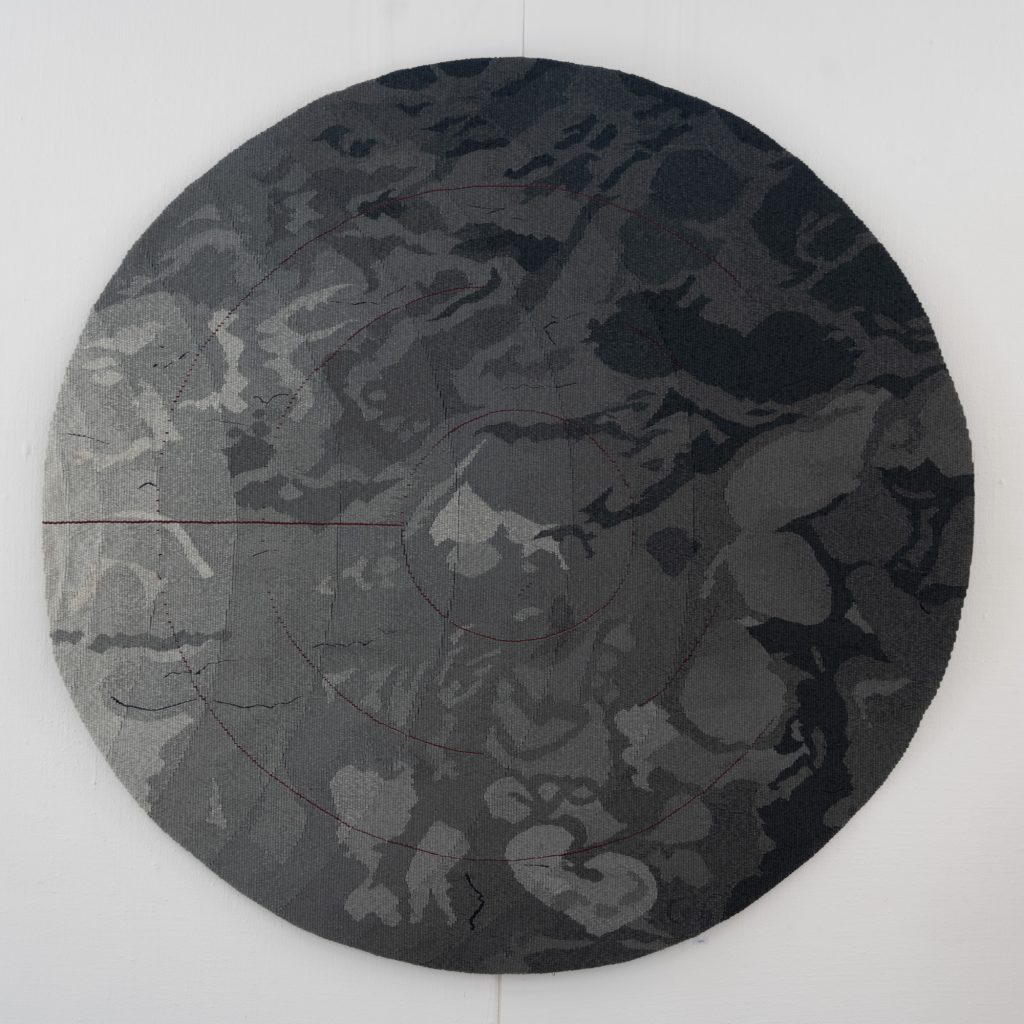
The Way of all Flesh, 147cm diameter
The red circles are fragmented and the image is disordered just as her memory was. I always saw the piece in this grey green colour right from the start, not because our brains are 'grey matter' but because that was how I saw her life. Many dementia groups encourage you to see the joy in dementia but regrettably there was no joy in my Mum's life once the disease became apparent.
I had thought of weaving another piece of the same size in the same colours but a more ordered image indicating a healthy mind. I may still do this.
The tapestry is 147cm in diameter with a limited palette of 5 shades of a grey green colour and red and black linen.
My circular tapestries are not woven round and round in a circle, they are woven from left to right as normal, so the first pass at the bottom of the tapestry is quite short, as is the last one at the top. I usually have a piece of card inserted into the warps which is the negative shape of the bottom of the circle, this gives a solid base to weave onto. If you do not have a solid foundation then you will struggle to get a good consistent weave throughout a tapestry no matter what the shape.
People often admire my round tapestries and ask how I manage to get them so round but to be honest I am helped out hugely by the human eye and brain, people see that they should be perfectly round so they see them as perfectly round.
Can you discuss your current thoughts on making small: therefore, pieces with a smaller commercial value?
It is so difficult. Tapestries are traditionally big murals that run, in series and tell stories. It is not until you walk into a gallery hung with large tapestries that you realise so much of it is all about scale.
However, in the 21st century this brings problems, who has the money to buy these big mural tapestries? Who has the walls big enough to exhibit them? Even some of the larger tapestry exhibitions have size limits on each work, so my current triptych of three tapestries with a total width of 4.5 metres has nowhere to go.
As artists many of the galleries we exhibit in are smaller provincial galleries, they do not often get visited by people willing to spend thousands of pounds on a tapestry so it makes sense to produce smaller work.
But for me personally this is tricky. I cannot just take the designs for the large work and make it smaller. I usually weave at around 3 or 4 warps to the centimetre but if I was to make the work smaller and still want to get in the details I would have to weave at 14 or 16 warps to the centimetre, which becomes cloth rather than tapestry.
This means I have to do special designs for smaller work but I find apart from the occasional portrait I am not happy with these smaller works. It is a conundrum I struggle with.
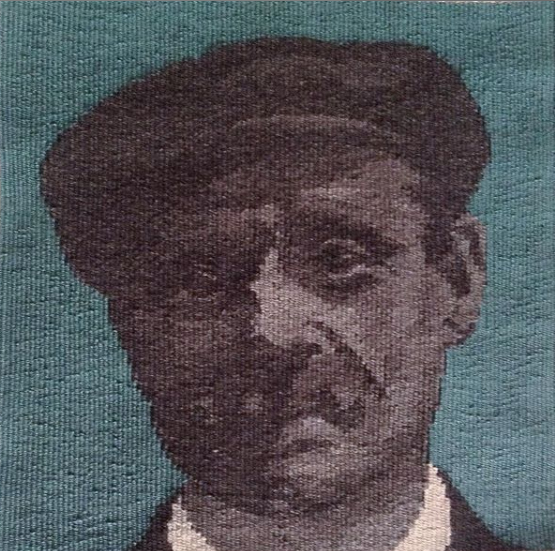
Great Uncle Antonio, 30cm x 30cm
How has the pandemic effected sales and the general effect from an English artist’s point of view?
Because tapestry is a slow medium, I have not felt that it has had much impact on me at all. When we went into lockdown I was about two thirds of the way through a big tapestry so I just kept weaving. I then went straight into my next project which is 2.5 metres wide which I am still weaving. As a rule, I spend many days isolated in my studio so not much has changed. I know some weavers lost their creativity and direction due to the Covid crisis, but I am fortunate not to be one of them. If I hadn't had work in the pipeline. I may have struggled but I whilst I am weaving a piece there are generally two or three projects in my head ready to go.
Discuss the importance of entering your work in International exhibitions.
International exhibitions are important to get your work out there and be seen as much as possible. No-one will have heard of you if you never exhibit your work. I have been fortunate enough to have work included in publications, been invited to exhibit and to speak at conferences specifically because my work was seen overseas.
The UK has suffered from not having much in the way of the big tapestry exhibitions, so we have, to go abroad. The British Tapestry Group have done some in the past but none recently and The Cordis in Scotland takes larger works. Again, it is a problem for weavers who want to weave traditionally sized tapestries. I started the Heallreaf exhibitions in 2015 and we now take work up to 2 metres square, it is difficult to find venues big enough and even 2 metres square is not big when you look at historical tapestries. Another consideration is that it costs a lot of money to send your work abroad. In 2019 I was invited to exhibit in Canada and it was almost cheaper to fly to Canada and take the tapestry in person than send it by courier.
Is it difficult to keep to your own artistic direction rather that producing work that is easy to sell or what a gallery wants?
I have only ever once made a piece of work specifically because I thought it would sell and fit in with the current 'interior design' trends. It was small and sold instantly but it is not work I particularly want to keep making, so I have not. I also struggle with exhibitions that have a theme, I find I have to take time out from the work I am currently producing to find a link to the theme that I can work with and then produce the tapestry. I do understand that often a theme can give an exhibition cohesion and it can be a useful tool to stretch your creative mind but sometimes it is hard to work within other peoples, constraints and maintain the integrity of your own practice.
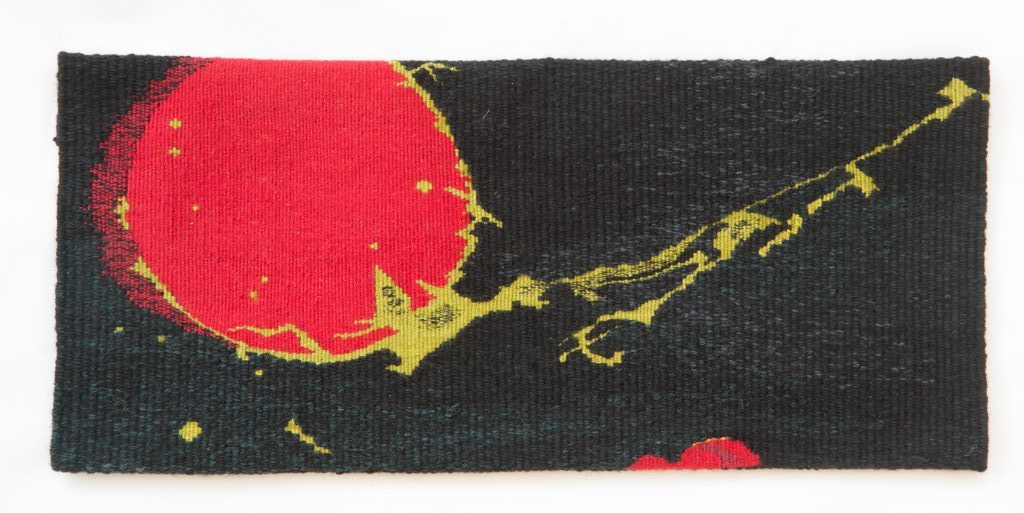
Red Shift Two, 30cm x 20cm
Do you do your own dyeing?
I don't have a dedicated dye room so I will often buy colours but it can be difficult to find the right colour; I have spent the last month dyeing greens for my next project because I cannot source the right green from anywhere in the UK. Sometimes the results of my dyeing can be less than perfect so if I need yarn that is dyed very well with a good solid colour (for instance if I am going to weave a large area of one dark colour) I can get yarn dyed for me specially, although there is often a long lead time so I have to know many months in advance exactly what I want.
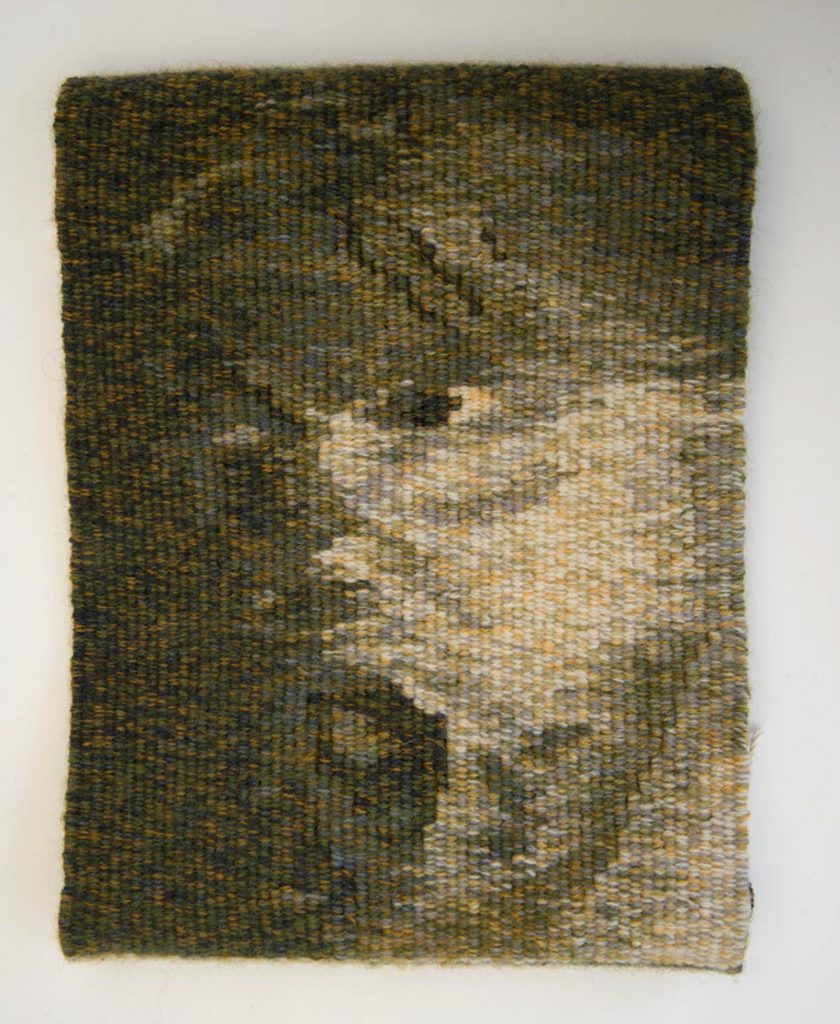
Green Man, 30cm x 20cm
Are your dyes natural or organic and why the choices?
I use acid dyes. This is because they give consistent and repeatable results, and they are very colour fast. Environmentally they appear to be no worse than many natural dyes as the mordants you need to use for natural dyes are not necessarily good for the environment. The dye company tells me that if you exhaust the dye bath, that is: use just the right amount of dye so it all goes into the yarn and none is left in the water, all you have left is water and you could drink it without any harmful effects. I am not brave enough to try it, but it does appear to be just water.
I have recently been experimenting with dyeing with pigments with varied success, that is a long-term project for the future.
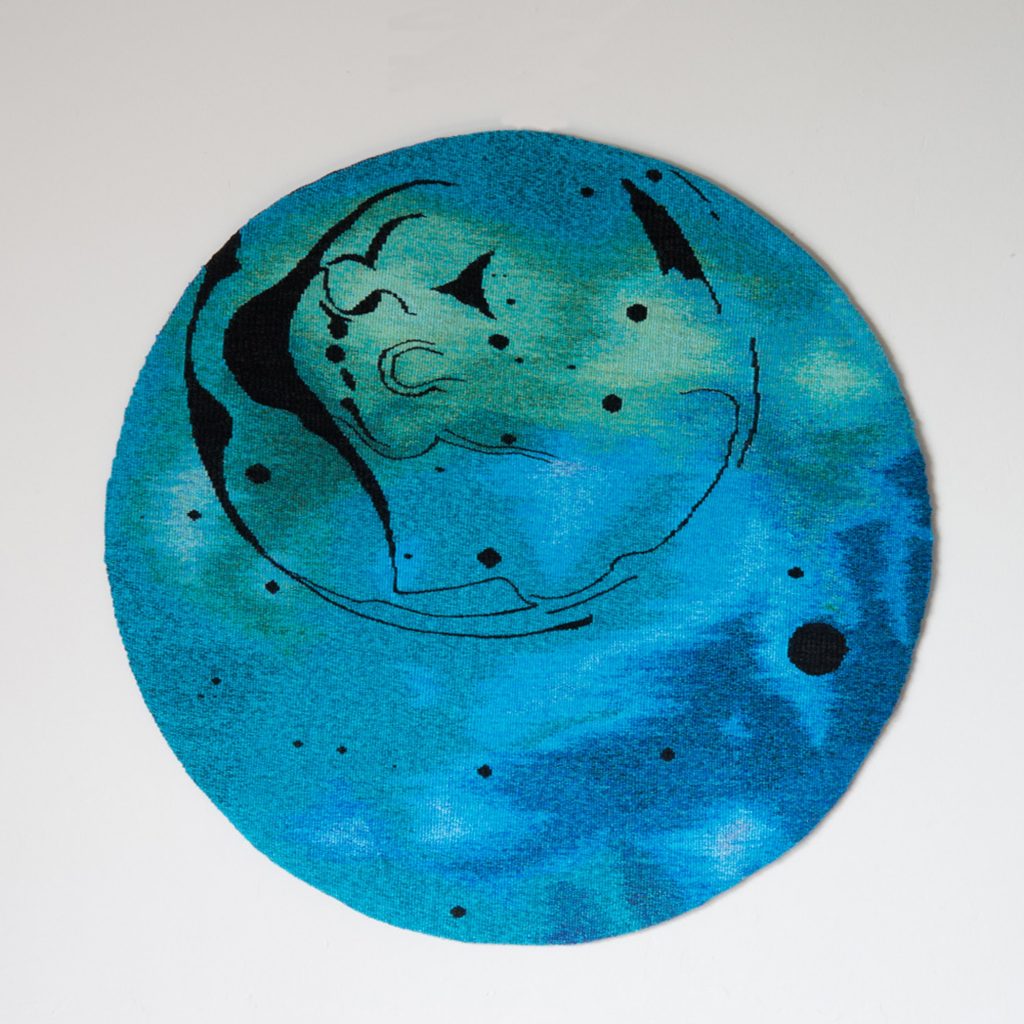
Blue, 75cm diameter
Do you use merino wool or other breeds?
Merino wool is generally too soft for tapestry weaving. I use a worsted yarn which is more traditional in the UK, it is a harder yarn with little or no loft and I try to find a mix of fleeces from sheep like a Corriedale or Leicester. Blue faced Leicester is particularly good but expensive and difficult to get hold of in quantity in the right thicknesses.
Strangely it can be difficult to get worsted yarn in the UK. This is because of an historical decision to breed sheep for meat in the UK and for fleece in the Antipodies.
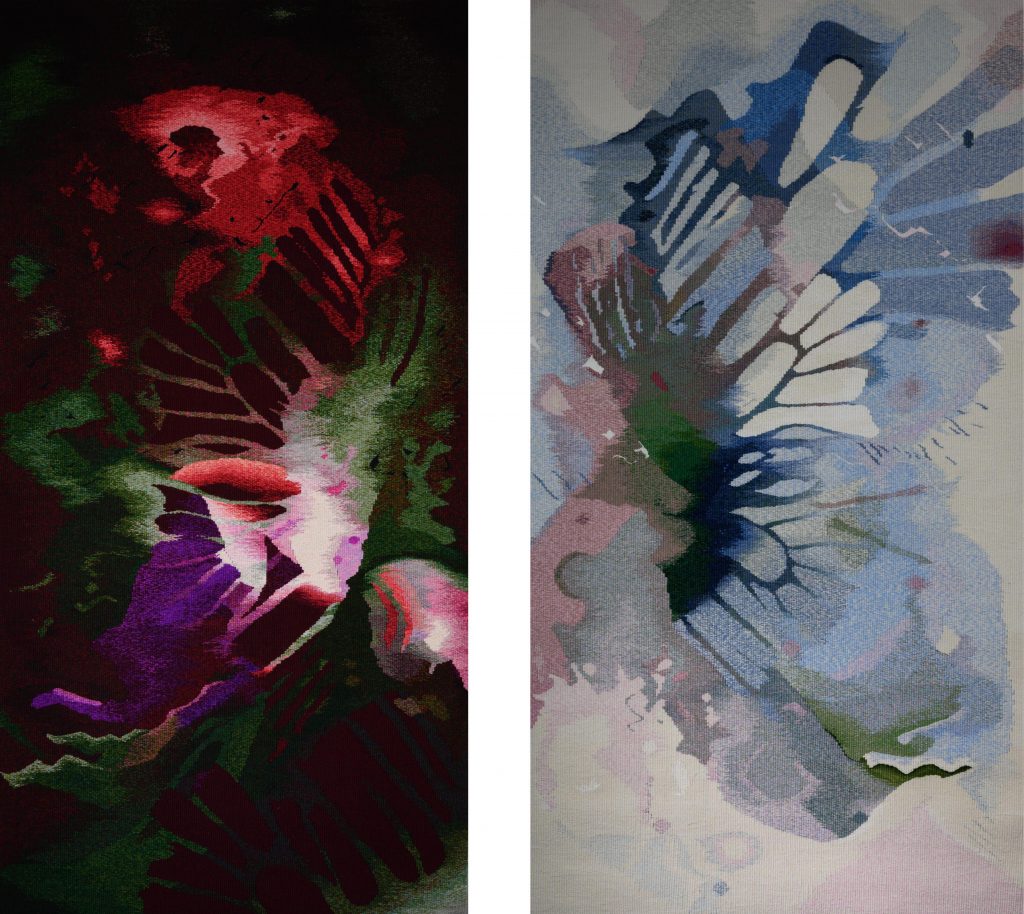
The Fallen Diptych, 150cm x 150cm
Can you explain what these terms are?
Cutting off
Cutting off is just what it says. When you have finished a tapestry you tie a row of knots across the top to keep the weaving in place and then you take your scissors and cut the warp threads below and above the weaving, liberating the tapestry from the frame or loom.
Blocking out
Sometimes after you have cut the tapestry off it can look a bit lumpy, especially if your tension was not as consistent as it could be so you can block it out. This involves placing it face down on a board and pinning it round the edges with brass nails every centimetre or so. Then, once you have done this you place damp cloths on top of the tapestry and leave them to dry. This tightens up the weft and can remove any bagginess in the tapestry. Even if the tapestry does not need blocking to correct any anomalies within the tension it does wonders for the look of the tapestry, the slightly tightened weft gives a lovely smart finish which is difficult to describe.
Discuss a commission you have both done and enjoyed.
This commission came about when the client liked a piece of my work that was already sold. Fortunately, the client allowed me pretty free reign as I undertook to create something like but not the same as they piece they originally chose. Totally independently I had just finished a piece of work for an exhibition in Istanbul but that work had to be completely tufted, like a rug and I had fallen in love with the technique.
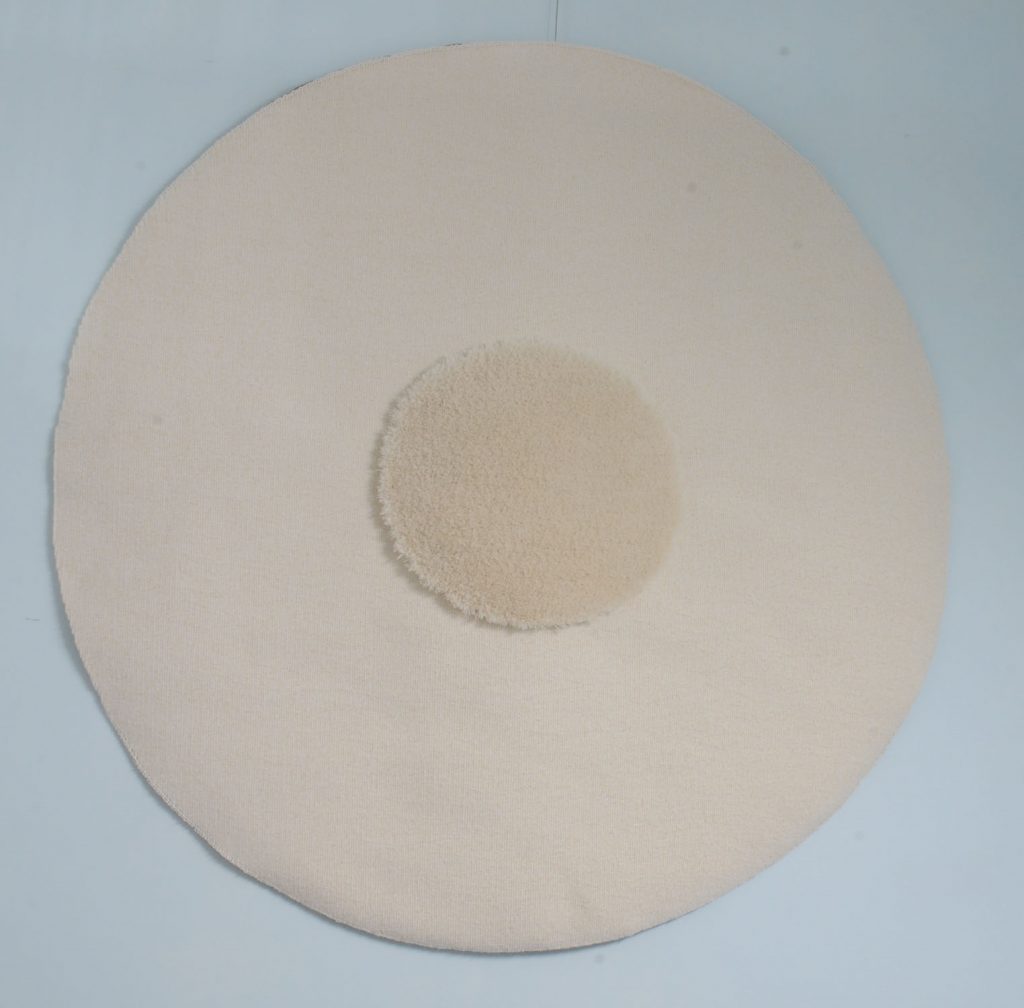
Commission - 100cm diameter.
So the commission became a round tapestry with a disk of tufting in the centre. This idea of the 3D and the circular nature of the tapestry echoed the original piece the client had admired. I enjoyed it but quickly realised that the commission was woven much more finely that the 'rug' piece I had woven for Istanbul, consequently the small tufted area in the middle took as long to weave as the whole of the rest of the tapestry. I sort of fell out of love with tufting after that but that doesn't mean I will never do it again if a tapestry needs that sort of effect.
Where did you learn to weave?
I wove, my first pass of tapestry on 10th December 2010. I became immediately obsessed with it as I found I intuitively understood many of the techniques and how to blend and use yarn to make the images I wanted. It was on a short course at West Dean College and I quickly went onto to do more short courses and in 2012 enrolled on the three year full time course to do my MFA specialising in tapestry weaving. I continue to do the odd course even now as it is rare that you don't learn something new from other weavers, we all learnt and work in very different ways.
What did it mean to be awarded the Qest Scholarship?
In order to become a Qest scholar you have to prove to a panel that you are committed and passionate about your chosen craft, it is a wonderful honour and achievement. Qest follow your career and once a Qest Scholar always a Qest Scholar so the organisation does not give you, your scholarship and then forget about you. Scholars meet regularly (until Covid that is) for social events and exhibitions and I was fortunate to be included in their book 'A Celebration of British Craftmanship'.

My links with Qest will continue with exhibitions, sales of work and receiving the support they can offer at various events and likewise supporting them in any way I can. I have donated work to their auctions which help raise large amounts of money for the charity.
Expand on your “Pods”.
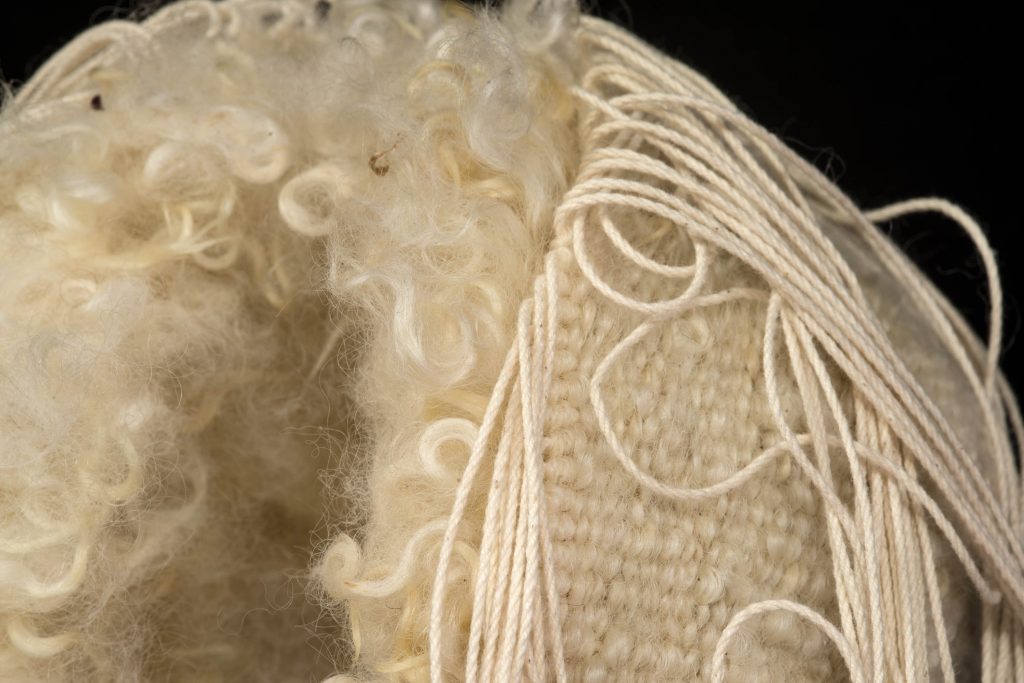
Pod cast detail
The pods were an experiment for the second year of my MFA when I was at college. It started because I had seen the amazing tapestry heads created by Louise Bourgeois but I was so disappointed when I realised that they were tiny pieces of tapestry sewn together to make the face shape, presumably they are sewn around a mannequins face. So I set out to make 3D shapes in tapestry but with as little sewing as possible and that was how my pods started. Since then I have experimented with different materials and different sizes and using the same basic techniques I have made corsets and other experimental work. However, the pods themselves are a little disappointing in my view, okay it is a pod or sphere of handwoven tapestry, brilliant but what next? This is the question that has sat with me for 4 or 5 years until now, I have just started working on large scale woven 3D shapes, using the same pod technique but making life size anthropomorphic structures.
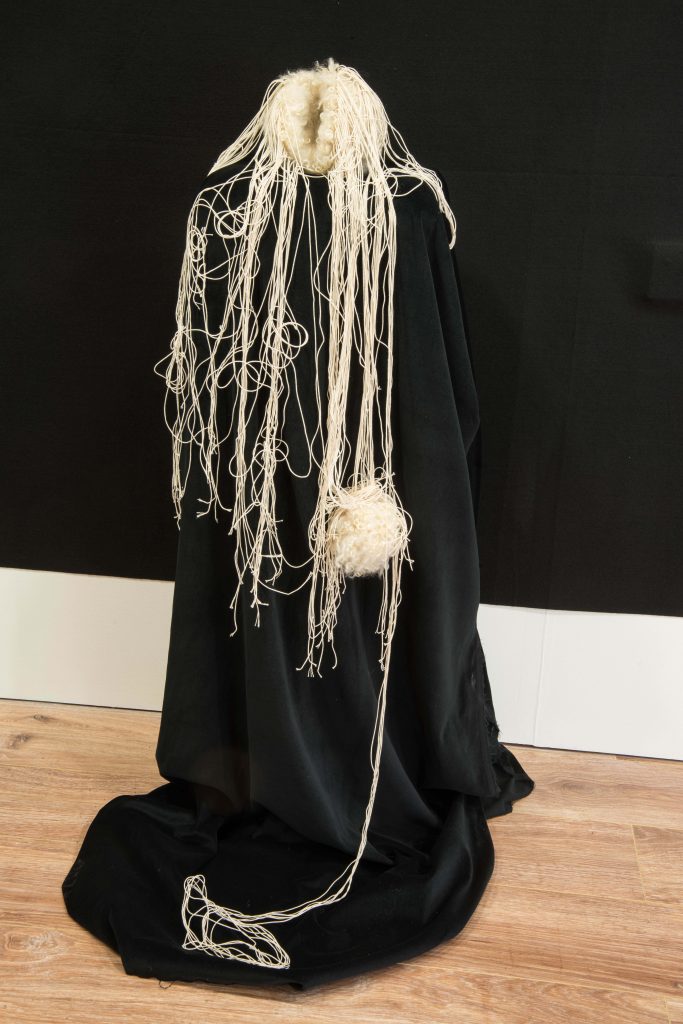
Pod Cast
Take two tapestries that are quite different and expand briefly on each work.
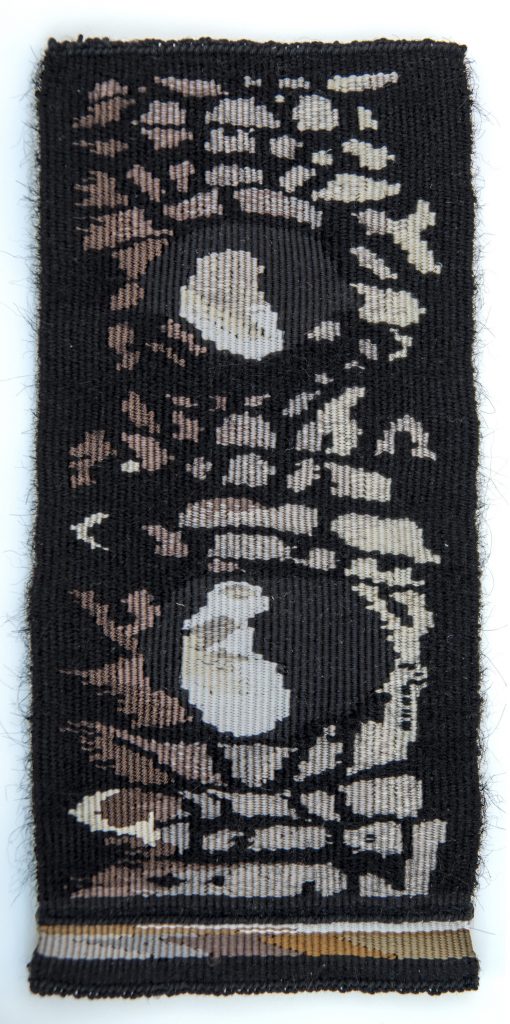
Hawk Moth Caterpillar – 25 x 11.5cm
This small tapestry came about after I found a hawk moth caterpillar in the garden. They are quite amazing little creatures and I was fascinated by the colours, shape and texture of it's skin. This was one of my very early tapestries and the design is almost a direct copy of the markings on the caterpillar but I wanted to convey the texture so used wool for the black background and silk for the coloured markings. It was the first time I had used silk and I found the silk areas are very 'boney', that is, the line of the warp threads is much more visible than in the wool areas. This worked well as it accentuated the 3D effect of the markings.
This tapestry was the first I ever had accepted into an overseas exhibition as it was shortlisted for the Kate Derum Award in 2013 Australia. It is now in private collection in the UK.
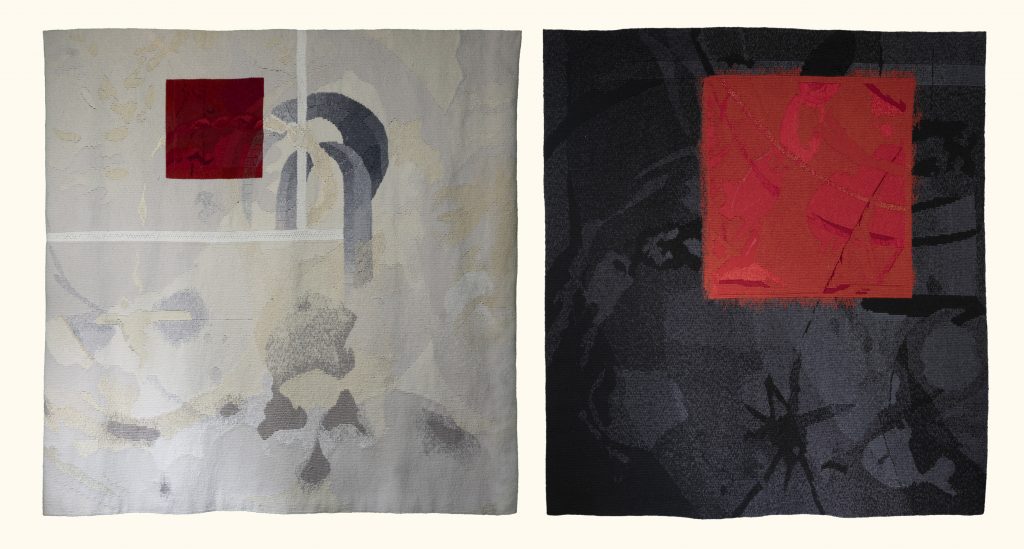
Cecil - The Uninvited Guest - 1.5 x 3m
2019 was a tough year, my husband was very ill and for 3 months the doctors thought he had potentially terminal cancer. The good news was that he did no, but he was still very unwell and in and out of hospital all year.
These tapestries were a response to the year, combining my husbands image, some of his CT scans and other elements that occurred to me during the design process. I do not do a lot of drawing nor do I keep a sketch book, designs turn up in my head fully formed and ready to go in full colour, they are then translated to paper using photographs, drawing and collage. I have a lot of time to think about the designs whilst weaving and in the past I have tried to move the designs on from this mental image but always come back to pretty much the original because it is fresh and the later amendments to a design tend to make it look over worked and forced.
I used wool warp for these tapestries and I don't think I will do that again, I will go back to cotton warp. Part of the reason for doing it was because I had never used wool warp on a large piece before and I thought it would make the finished tapestry lighter but on both of these pieces the tapestry fought me all the way.
I am considering doing a third in the series in red but need a rest from them for a bit. I have started writing poetry to go with some of my works and 'Cecil - The Uninvited Guest' has been distinguished with a poem.
Cecil - The Uninvited Guest
You arrived out of the blue
initially insidious
potentially terminal
uninvited
unwelcome
you stayed a year
you flaunted yourself
you burrowed
like a twisted broken skein
drawn taut inside
you oozed
you flowed
you fought
but eventually
you failed
leaving scars
and a
memory
good riddance
we say
the
doors
are closed
do not return
These tapestries are currently in my studio waiting for an opportunity to be exhibited.
Contact:
Margaret Jones
www.margaretjonesartistweaver.com
Instagram: margaretjones6979
Interview by Deborah Blakeley, October 2020
Blakeley, Melbourne, Australia
Jonathon Westacott
What led you to set up your studio in the hinterland of the Sunshine Coast?
After completing University and traineeship at the Jam Factory Craft and Design Centre, my, partner Marguerite and I moved to the Sunshine Coast to work with Chris Pantano. When Chris retired I built a large studio in Yandina and eventually set up at home at Dulong on the Blackall Range
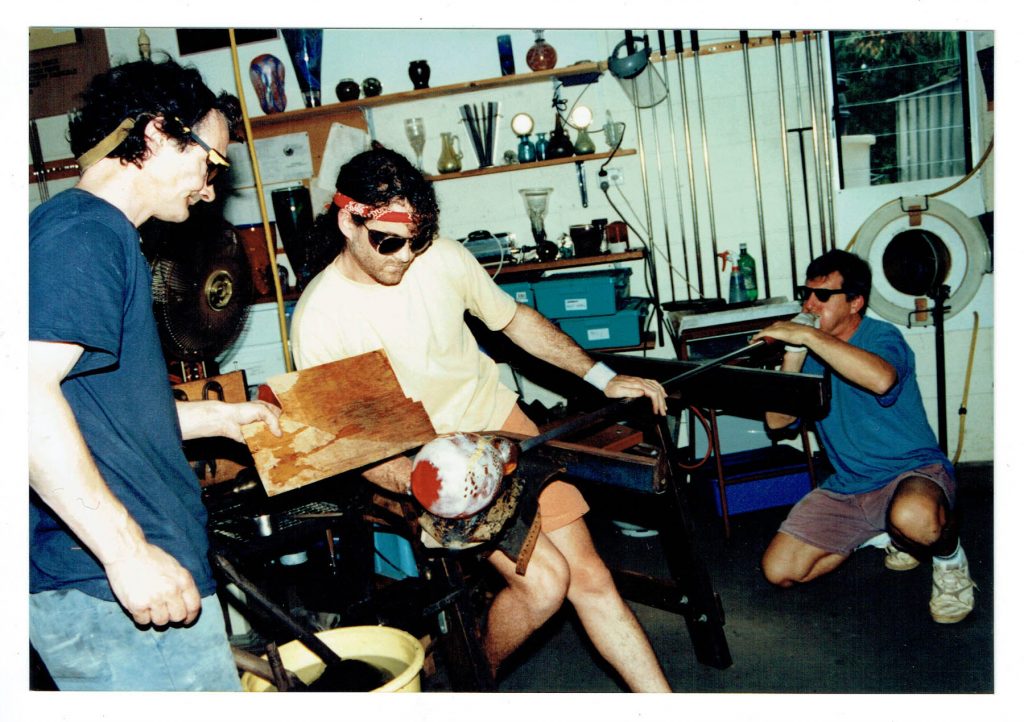
Pantano Studio
Take us briefly through the stages to produce, ‘Bunya, Glass House Mountains’.
There are two main parts in the creation of my work. I start by visiting wilderness areas, drawing and photographing many aspects of the place. I have developed techniques which enable me to use my drawings as a stencil so I can carve these images into the glass.
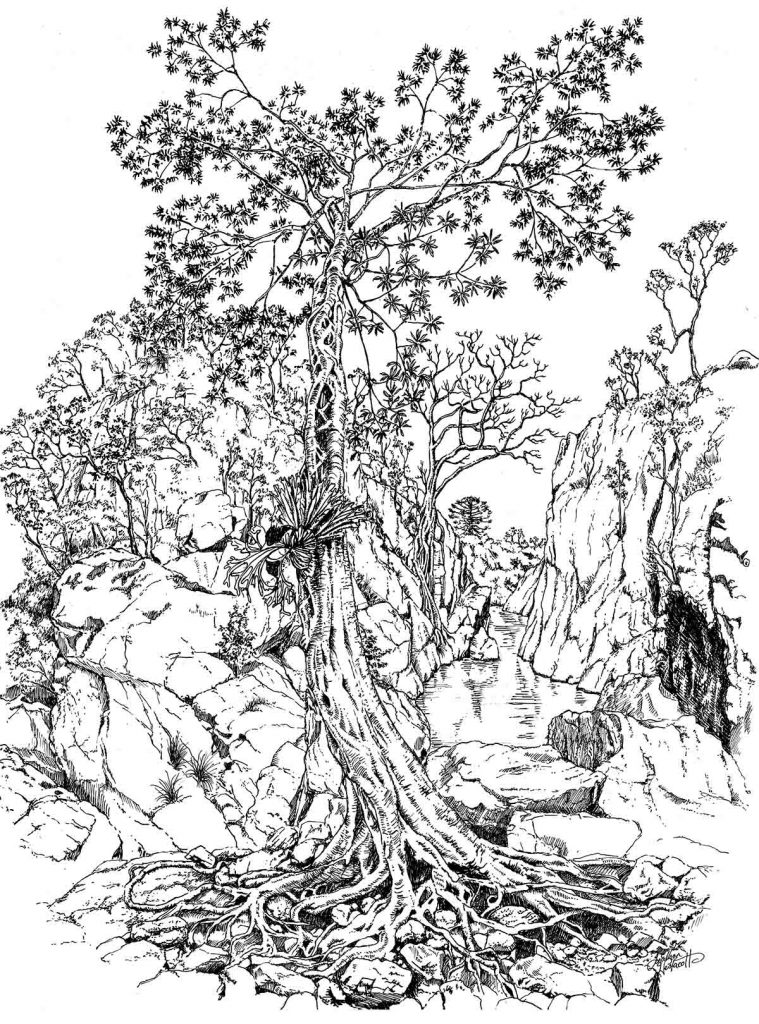
Kureelpa Gorge 2
The second part is blowing the forms to carry the design. This involves layering different glass colours in the blowing process and when the glass cools carving back through these layers to reveal the image.
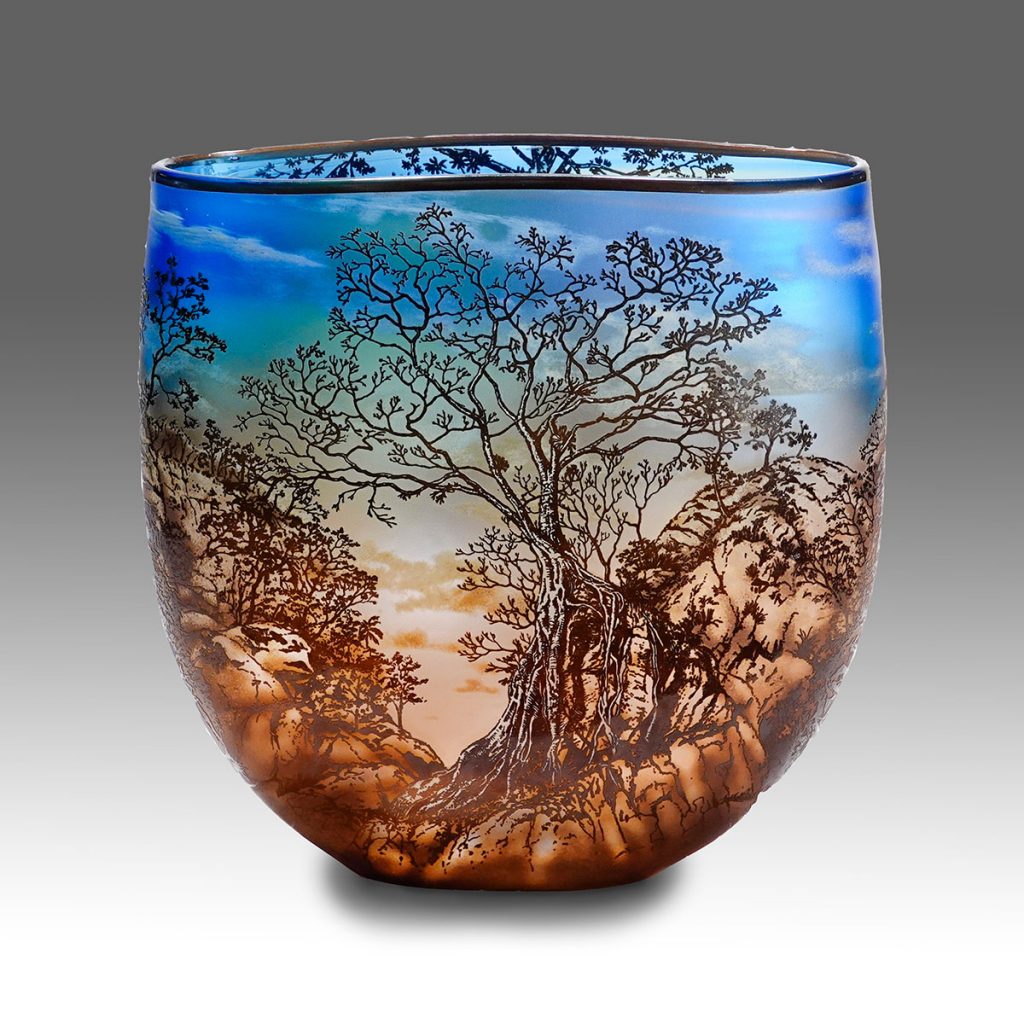
Kureelpa Gorge 2
Explain the relationship to place in this work.
The Glasshouse Mountains are phenomenal geological formations of the Sunshine coast and have fascinated me from the moment I saw them. The direct reference to glass factories in England when Captain Cook first laid eyes on them and more importantly the Indigenous stories about creation and place. Bunya trees are hugely
important to the First Nations people and an iconic feature of the area.
Show us a few of your varied landscapes captured in you glass.
Noosa, Queensland
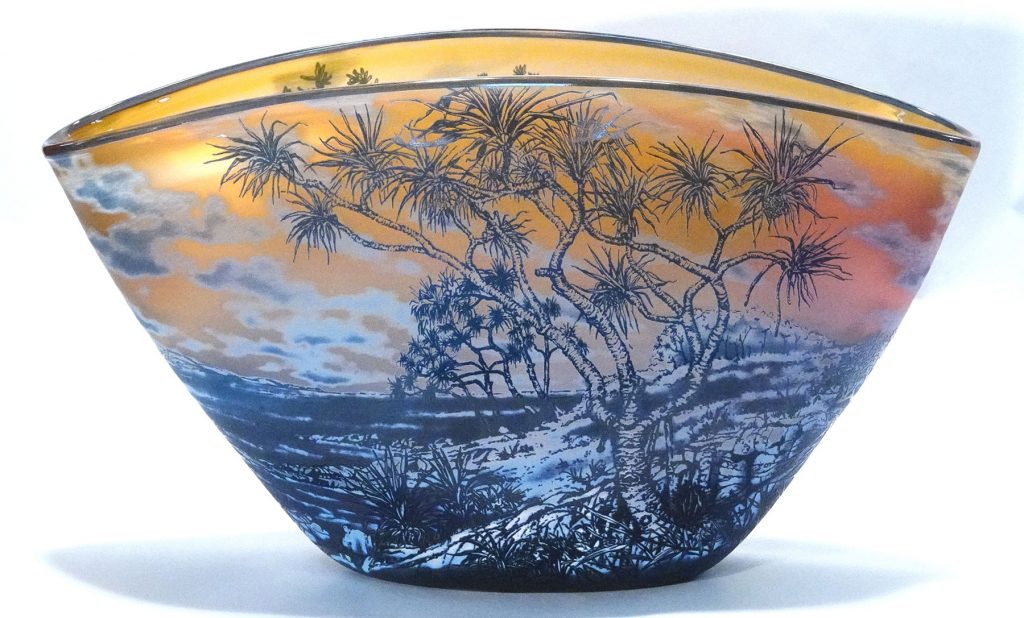
Noosa
Kakadu, Baark Marlam
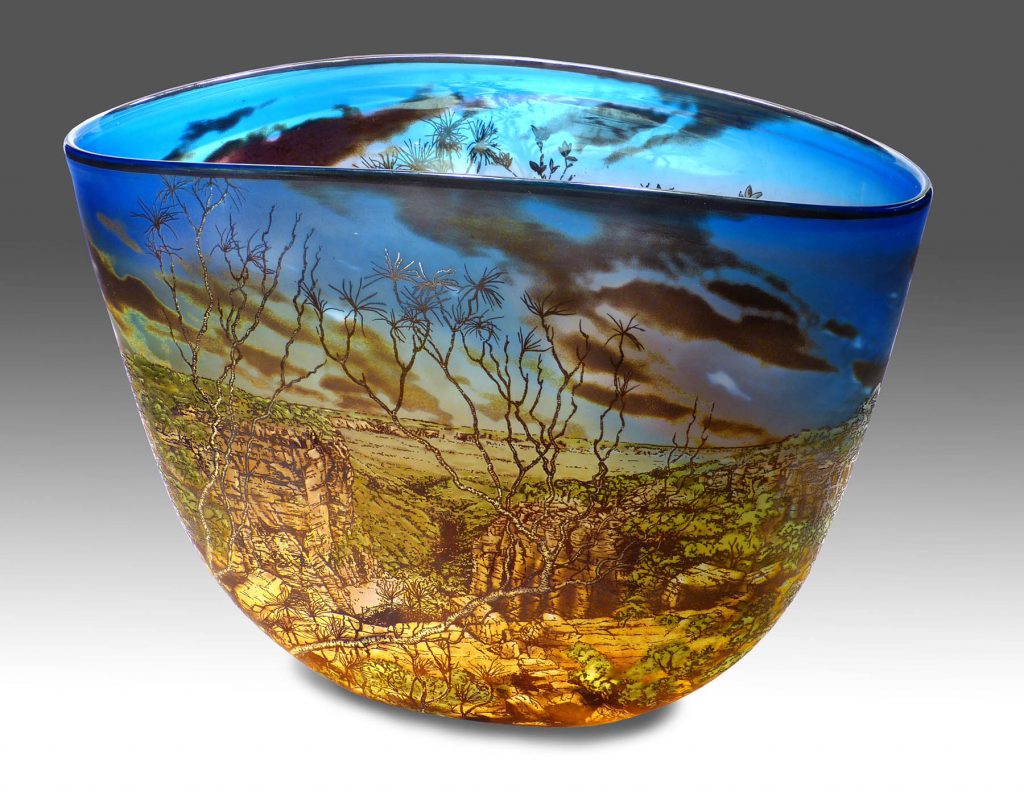
Kakadu, Baark Marlam
Kureelpa Gorge
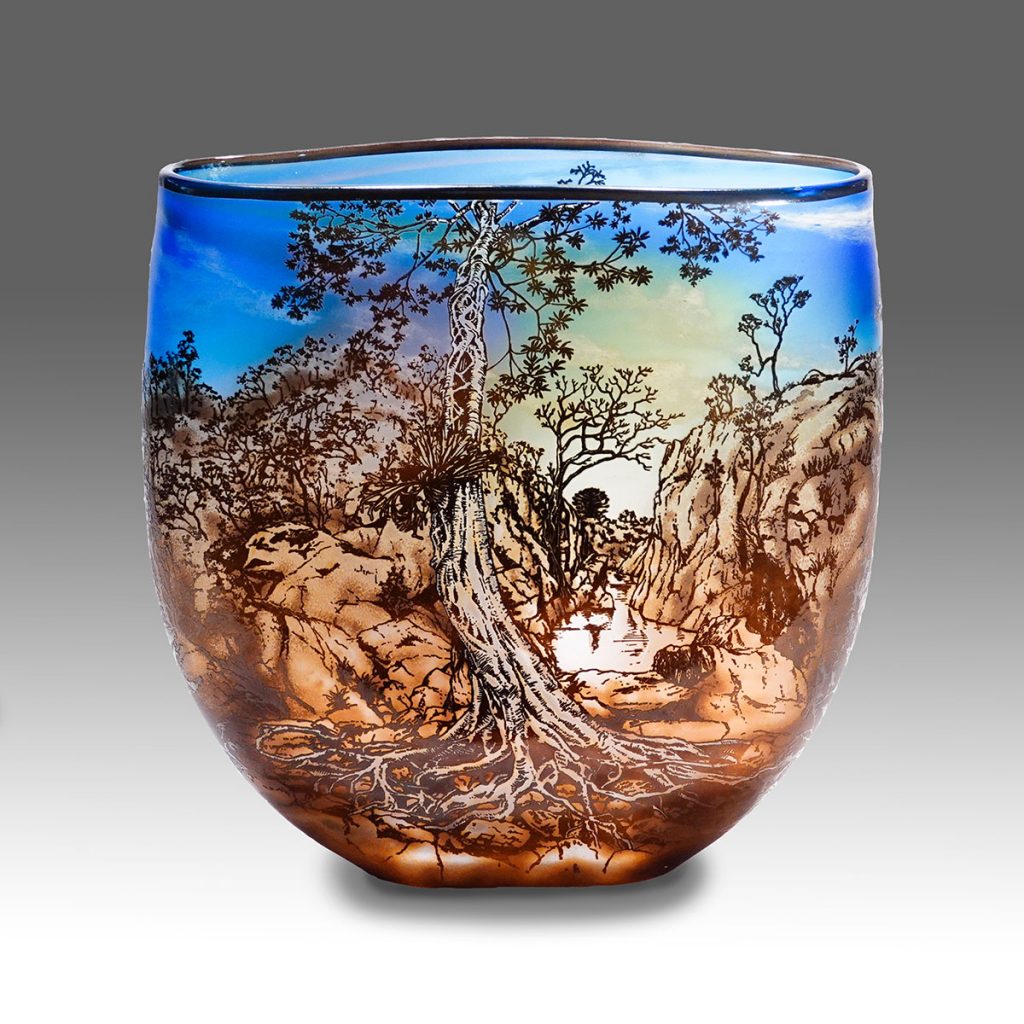
Kureelpa Gorge
Comment on your use of a specific tree in your Kurrajong Series.
I first became fascinated by Kurrajong trees when I saw them in the country around Coonabarabran.
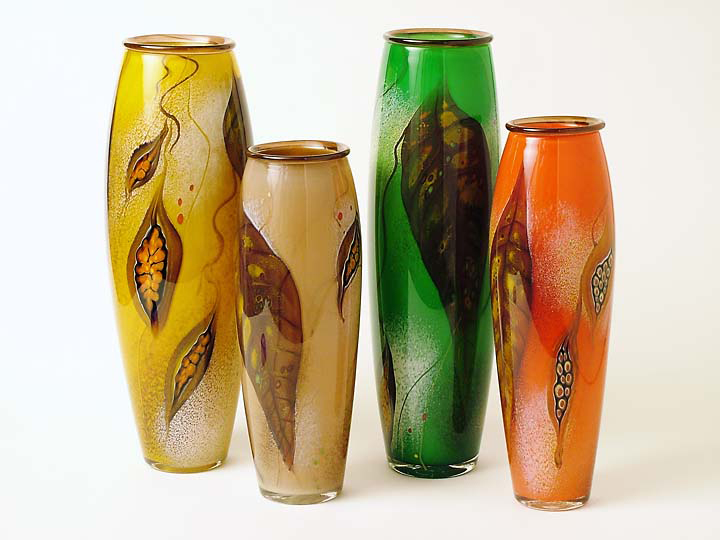
Kurrajong
I immediately related to paintings done by Fred Williams and his depiction of the landscape in the Pilbara. I love many things about these trees and again the importance to Aboriginal people. The bark was used to make cordage for nets and fishing line as well as seeds which were ground to flour also edible roots.
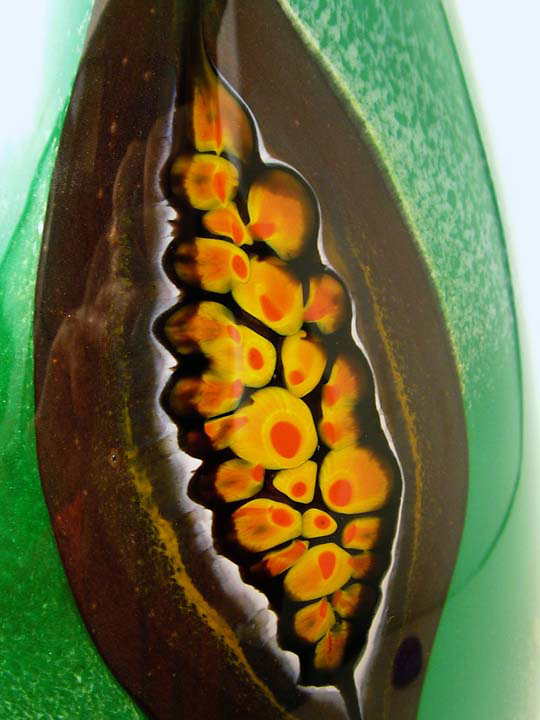
Kurrajong pod
Not everyone can say they have blown glass in front of Elizabeth 11, how did this come about?
When the new Jam factory was built in the centre of Adelaide I helped set up the glass studio and was part of the team chosen to be working on the day Queen Elizabeth opened the centre.
You make the comment, “I am fascinated by man’s interaction in the landscape”. Expand on this comment and relate it to two of your pieces.
As Humans we have a desire to be valued and contribute to society and culture in some way. For, me the landscape has been a constant source of wonder and inspiration. I am driven to capture its beauty in a time when there is a very real threat of species disappearing through the environment changing irreversibly. My work is a
conscious record and hopefully has its place somewhere in history.
Show us how you have incorporated murini and millefiori techniques in your work.
I use murrine and Millefiore as details in many of my works. The seed pods in the Kurrajong series, eyes of Bee eaters and kingfishers.
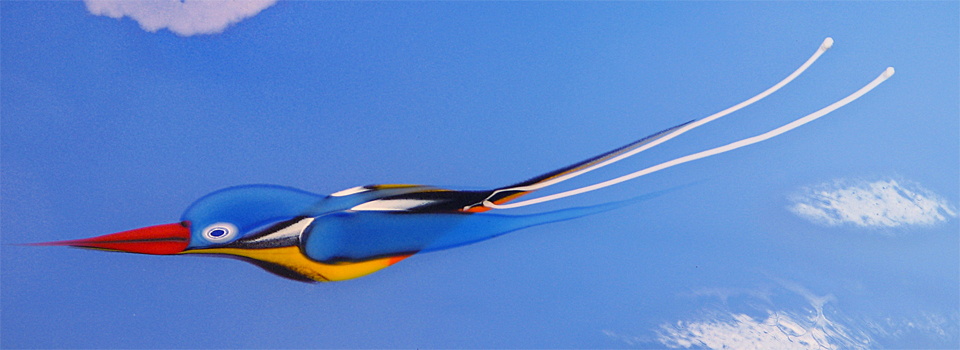 Kingfisher
Kingfisher
Nymphae Platters are some examples.
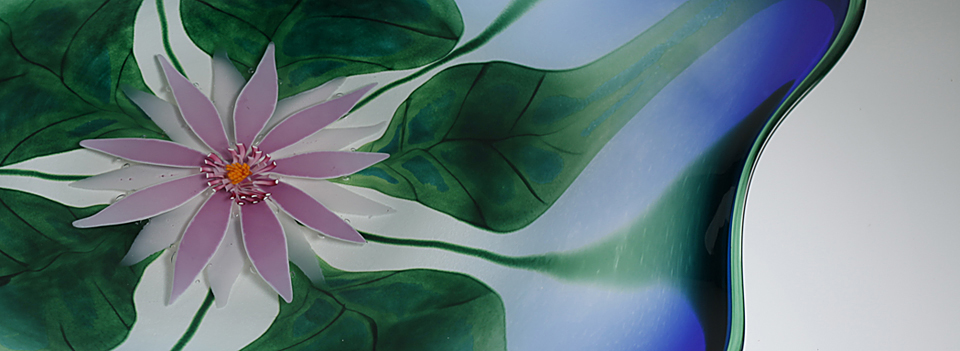
Nymphae Platters - detail
Discuss the way glass is reliant on optical interpretation.
What I love about glass is the way colour is revealed in its purest form. Light that is reflected or transmitted through glass can make the colour look completely different.
Your current work is, ‘Etched Series’.
How many colours to you have in a single piece? I can use between 1 and 20 different colours in the etched series as well as an infinite variety of tones depending on how thickly I apply these.
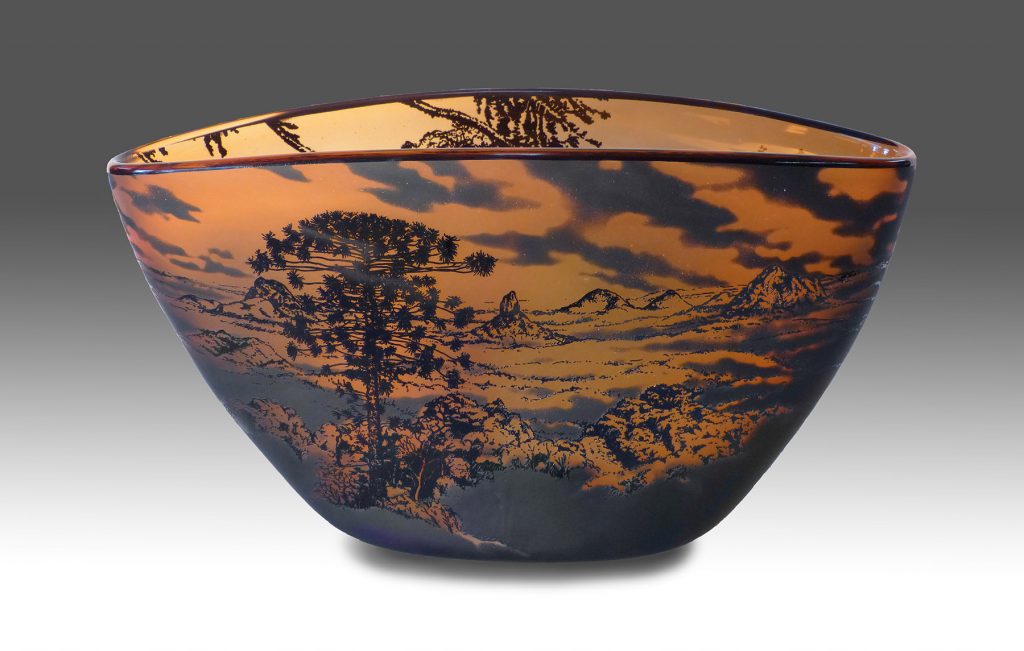
Bunya Glasshouse
Do you produce your own base piece?
I blow all my own work.
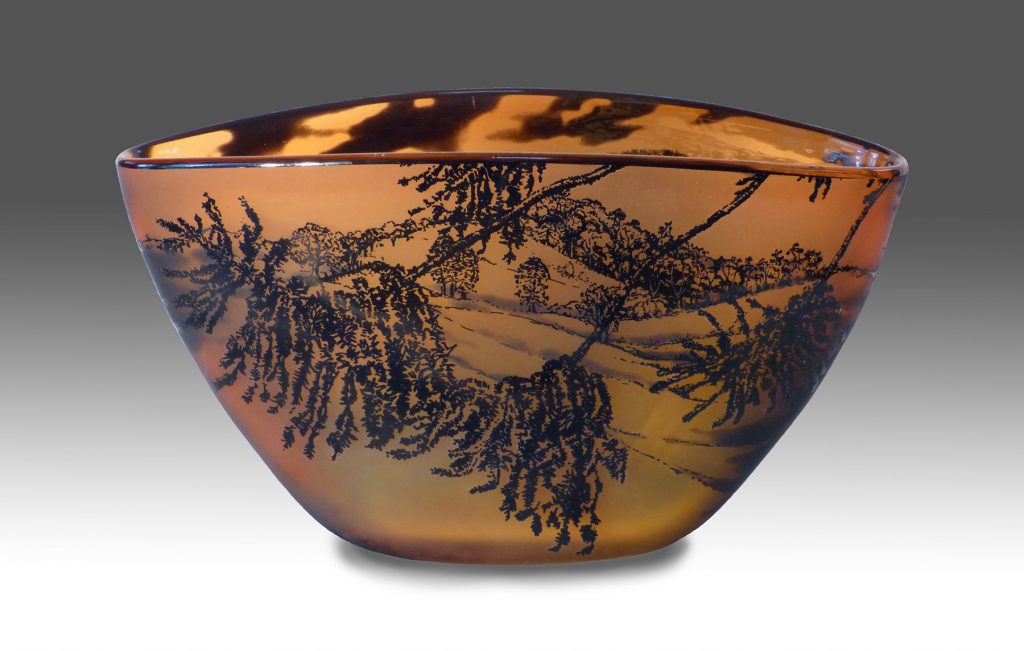 Bunya Glasshouse - reverse side
Bunya Glasshouse - reverse side
Comment on the shapes you are using in this series, and why?
I shape the forms to suit the way my drawings fit on the piece. Prefering to flatten the vessels so I have a canvas to work from but also like to wrap these images around cylinder and barrel forms to resemble a frieze.
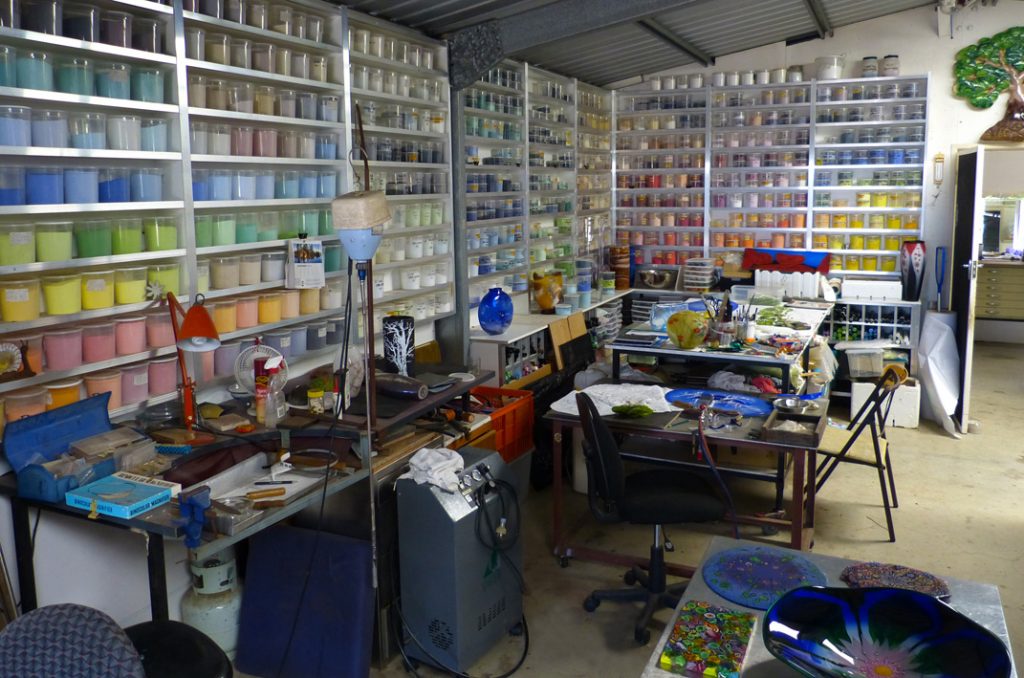 Westacott Studio
Westacott Studio
You have work in many places. Where have pieces gone?
I have sold my glass to collectors and businesses around the world including the UK and America.
Why have these purchases been so valuable to you personally?
It is good to know my work has a place in different cultures. For me, crossing these boundaries the work is successful and desirable.
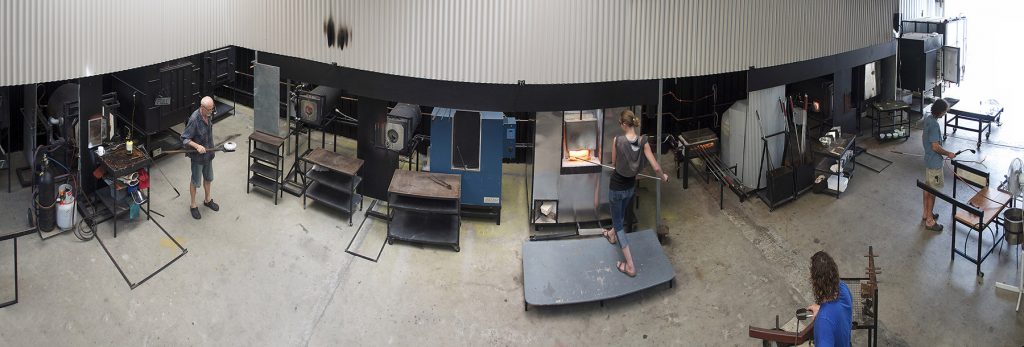
Westacott Studio
Discuss the weight of your glass and its relationship to balance and the stability of the piece.
Glass is a very dense and hard material and yet fragile so I like to make forms which are balanced and stable. Simple shapes to carry complex designs.
How large and small is you work? What are your restrictions?
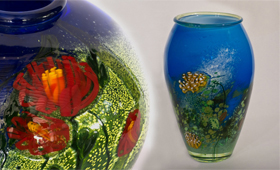
Waratah
Pieces range from 10cm up to about 100cms and weighing 15kgs.
Contact:
Jonathon Westacott
Dulong, Sunshine Coast, Queensland
Interview by Deborah Blakeley, October 2020
Blakeley, Melbourne, Australia
Barbara Nell Morejon
You have been working with textiles for over 30 years. When did you narrow it down to felt making?
Felting became my sole focus in 2005 when I moved home to care for my parents and younger sister. Focusing on my felted art was a positive distraction from doctors, medical struggles, and so many changes.
What is it about felt that gives you such freedom?
Every time I work with felt, there is something new, and for me this is what is so exciting. I never feel stifled by predefined rules or approaches to a project. Finding my own path to design and execute a project, is freedom to me. For example, in a millinery class using hat blocks and preformed millinery felt hoods to make hats, the idea hit me, that with my felted art I could make my own felt hoods and they could be any shape or size. That was all it took. My mind went into overdrive as I contemplated how tall, wide, or detailed could I create a hat. This began my first large body of work and won the Ohio Arts Council Individual Excellence Award. The giraffe hat is an example.
You have your work all over the world, how has this happened?
I have been very fortunate to have developed a strong network of artist friends. These artists mentored, critiqued, encouraged, and helped guide me to venues that promoted my art. Also, my art is unusual, not what you might normally think of, when thinking of hats, coats, or animals. For example, the large gorilla’s head with eyes that seem to watch you as you walk by.
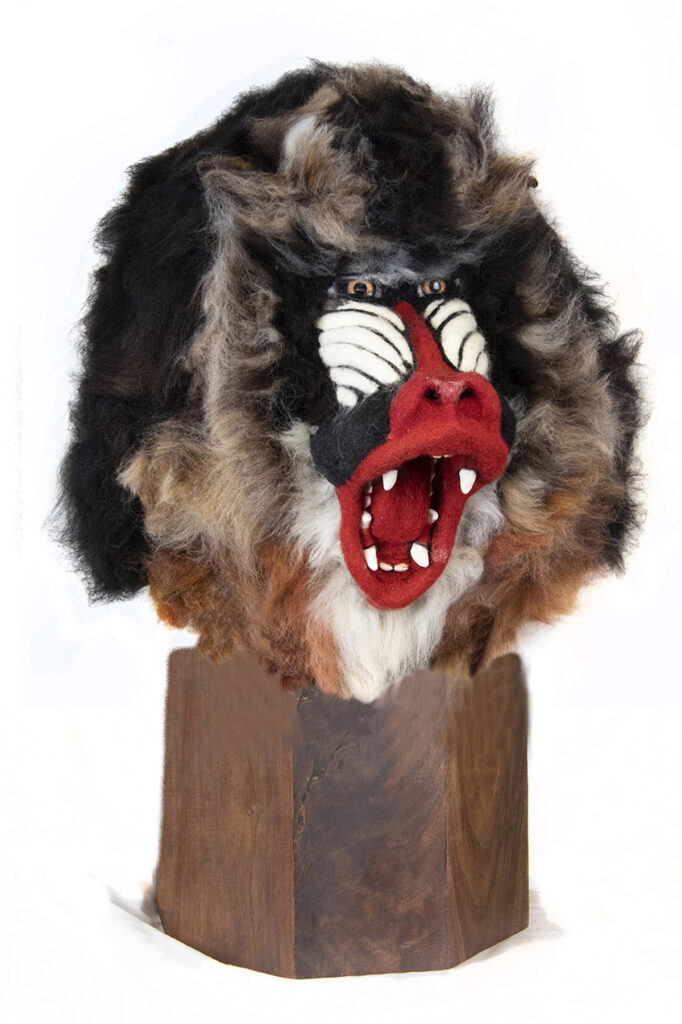
The 3-foot-tall giraffe hat, peeking over the blinds, as the model wearing it, waits for her turn to walk down the runway, invokes chuckles in the audience. My first piece of art to be shown outside of the USA, went to Germany for the International Hat Show, then a Lion hat went to Iceland, and it continued on from there.
One piece is in Australia, with a US connection. Tell us this story.
This was a wonderful collaboration between artist, Marlene Grutter and myself. For three years we had shown wearable art on the runway in Cleveland, Ohio, and taken some of the top prizes. It was suggested that we should enter Australia’s premiere wearable art runway event, Wearable Art Mandurah, we did, and what an adventure! Our art titled, “Captivated”, was the first wearable art entry from the USA. After the runway show, “Captivated” was put on display at Mandurah’s Welcome Centre, and then taken to be viewed at the U.S. Consulate in Perth, Australia. The kindness shown us by the artists in Australia and the U.S. Consulate was unmeasurable.
Show us the two pieces that have a strong relationship to your parents and why?
The giraffe hat was my mother’s all-time favourite. I remember her going to a ladies meeting wearing it, and coming home all smiles with a blue ribbon for the most unusual hat. It makes me smile every time I look at this hat and reminds me how Mom was always there for me.
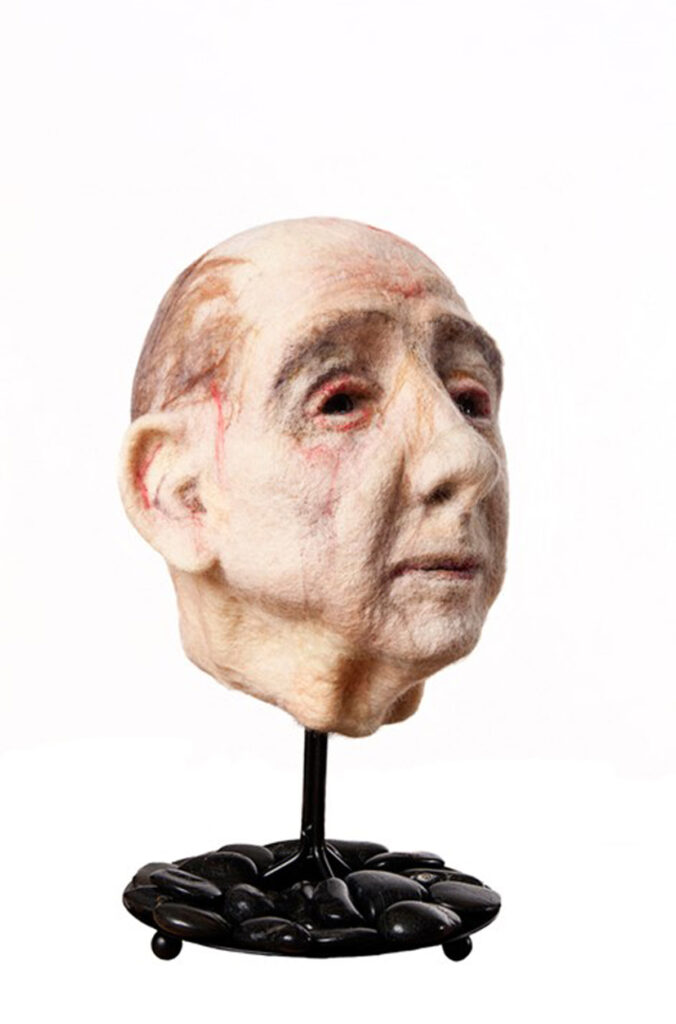
The bust of my dad’s head was my greatest challenge to date. My dad was in the late stages of Parkinson disease and suffering with depression. In an effort to keep him engaged, I suggested to him that I wanted to try something new with my felting, and needed a model. My parents were strong supporters of my art and I was confident he would agree. Beginning the bust was exciting. Never before had I seen this done anywhere. This could be a first. We sat together for hours, and as I measured and felted, we talked. My dad who had never been a talker started sharing stories with me, things he had done throughout his life. My dad has passed, but I will have his stories, and my art forever. In the end, what started out for him, ended up being a treasured gift for me.
You comment, ‘How many artists can say people live inside their art.’ Expand on this.
Learning that Yurts, homes made of felted wool, are still used as dwellings by several nomadic groups in Asia, fascinated me. Just thinking of felting this beautiful textile, and then draping it over the form to make a home, almost seems like magic. A Yurt, art to live in.
Take both pieces, Silverback Gorilla and Baboon, discuss.
The Silverback is 26” tall, 17” wide, and 13” deep. This head is solid wool, not armature, or stuffing. He has glass eyes, black walnut base, and a thin skin of acrylic paint that was applied at the end to create the look and texture of a real gorilla’s skin. When I saw the Silverback at the Columbus Zoo, I saw intelligence and power. These are characteristics I wanted to convey in my Silverback. The large size was created to give the full impact of looking into the eyes of a real gorilla, something most of us will never get the opportunity to do. With both the Silverback and Baboon, needle and wet felted techniques were applied. Both have been on display at Mansfield Art Centre, Ohio, USA.
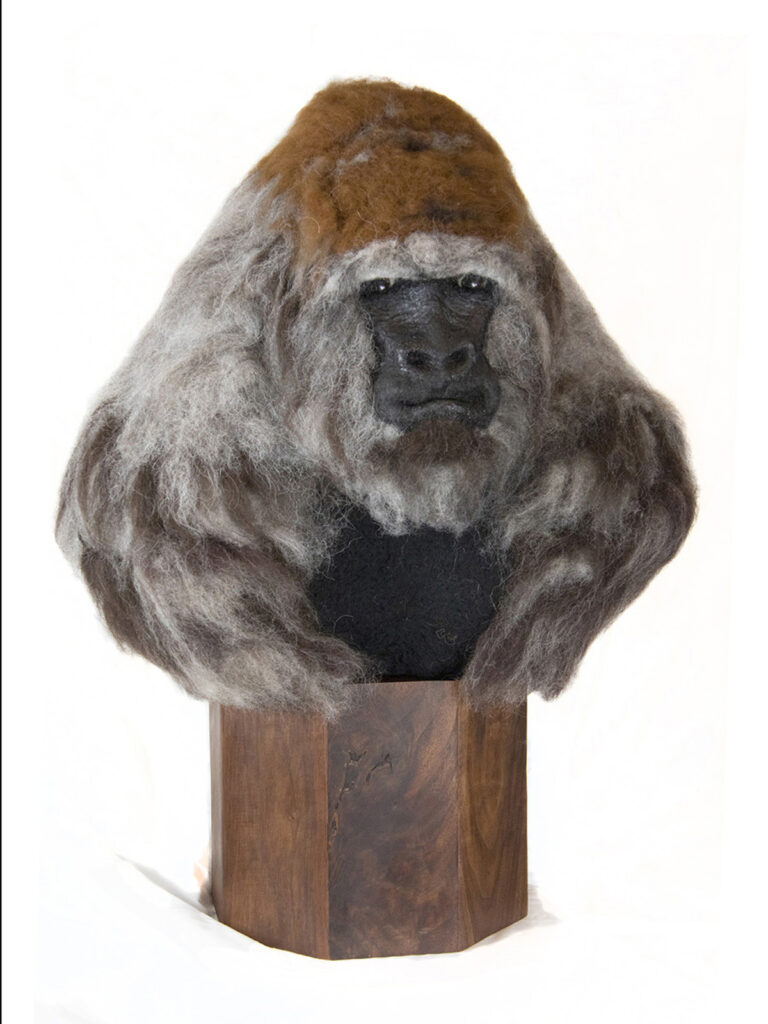
The Baboon is 30” tall, 18” wide, and 18” deep. This head is solid wool, not armature or stuffing. He has glass eyes, and a black walnut base. This Mandrill Baboon was inspired by a documentary I saw. They discussed many characteristics of this primate, but one predominant characteristic was his bad temper. I created this life-size head for the observer to look full in the face of a bad-tempered Baboon, maybe giving the impression he is screaming, “quit destroying my home.”
Why, the interest in animals?
Animals invoke curiosity, contentment, empathy, and positive feelings. With my art, I want people to experience positive emotions. My fascination with animals turned to primates and their places in the world in my teens. Admiring the work of leading primatologists: Jane Goodall, Dain Fossey, and Birute Galdikas; their field work and discoveries have deeply inspired me. While I cannot partake in field work as they have done, this project over the last 2 years, feels as though my art may, in some small way help others to understand these amazing creatures and how important their ecological role is on our planet.
How long does it take to complete a piece like these?
Time is the most difficult part of my art to estimate or calculate. Some aspects of my art are experimental, requiring research and testing. The Silverback Gorilla took a year to finish, but it was not a solid year of work. The Baboon was faster, but still it took 8 months to complete. Some of my smaller pieces, like a basic hat can be done in a day or two. Hats like the Giraffe hat took about a month.
Colour is especially important in you work discuss.
Colour can set the mood without a word, pull your attention from across the room, or give realism to an inanimate object. My coats are made with colours to be seen from the stage, runway, or across the room, and themed to relate to the event that they are shown. This coat was shown at the theatre play of, Romeo and Juliet, Mount Union University, Ohio, USA. For realism when making my animals, a variety of different coloured wools are used. This technic gives highlights and depth to their coats, can show different skin tones and individual features for the body. There is so much power in colour when used well.
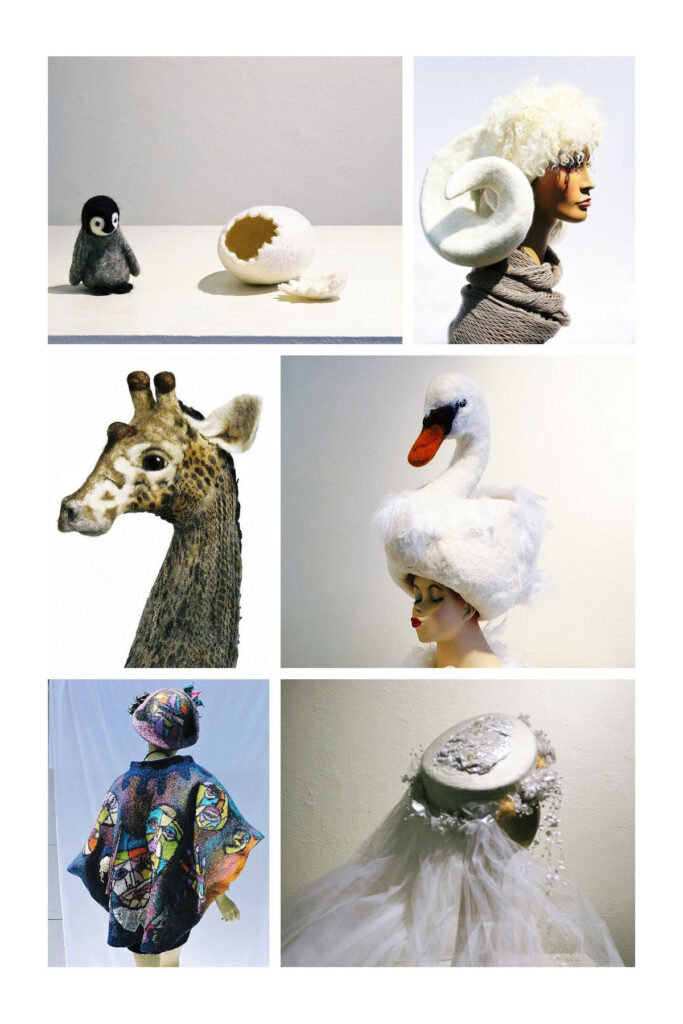
What are you currently working on?
Currently, I am finishing up a body of work on primates. There are 9 individual pieces and the Silverback and Baboon are part of this body of work. After finishing the primates then Christmas projects begin.
Where do you get your inspiration?
Ideas come from many places. The zoo is wonderful to watch different animals for hours. Sometimes it’s something I see walking, browsing in the library, watching TV documentaries about animals, surfing the internet, or even a commission piece. Commission pieces are interesting, because sometimes people ask for items I would never think of. This can offer me a whole new challenge. However, my inspiration is usually something that has caught my eye, and stays in my mind repeating over and over, wanting to be created.
Tell us about your studio and how you keep everything together while creating a piece.
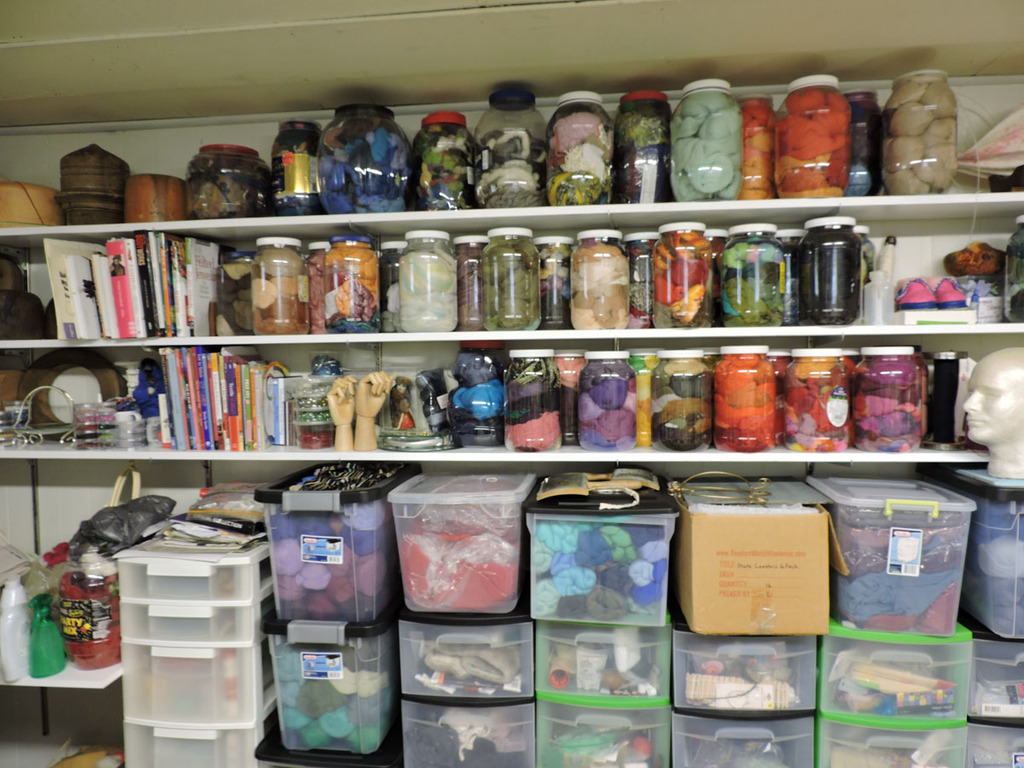
My studio is setup with all wet felting in the downstairs room, with three 6-foot tables, washer/dryer, sink, and shelves lined with clear containers filled with different coloured fibre for easy access. Then for dry or needle felting, the office on the main floor is setup with bookshelves, supplies, small table, desk, and computer. Beginning a project, starts with a clean space and everything put away. From then on until the project is finished, everything related stays out. This is a kind of organized chaos, but it works. A rule of thumb is, one project needs to be finished before moving onto something else. This keeps me from having half-finished projects left over, and can help push me through a project that might not be as entertaining as the next one.
Give us a very brief explanation about the technical process you take.
Felting is a versatile art form that allows me great latitude in approaching a subject. What you see in my art is, traditional wet felting, dry needle felting, and some variations of my own. The animals, coats, and hats are not sewn. Each is felted layer upon layer of wool, in one continual piece with no seams, to create my designs. Other technical processes include: creating wire armatures, designing resists to shape and separate wool for wet felting, and blending the right wools to attain the desired outcome. All of these and more allow me to translate my vision into felted wool.
Contact:
Barbara Nell Morejon
bdnell@gmail.com
Deborah Blakeley, Melbourne, Australia
Interview by Deborah Blakeley, October 2020
Paul Balmer
This is a new format for Zoneone Arts. I would like to introduce you to Paul Balmer using two videos and following each video with the questions that I wanted to ask after viewing them. I do hope you will enjoy being in Paul’s studios as much as I have.
- Storm ( NY studio)
Storm from Paul Balmer on Vimeo.
What do you use as your black background?
Matte house paint
Do you always use black for your backgrounds?
Yes. I need the line work ( which is the first stage of a painting) to be black but also having a black base means I can get shades of a color just by applying the oil paint thick or thin. Example: white can be grey when brushed thinly on black – so I get a range of tones without mixing them.
This black background partly shows in the final painting (either as line, windows or shadows) and offers a real contrast to the oil paint
What do you use to draw the base lines with?
A dremmel tool (a hand held drill with a spinning disk at the end).
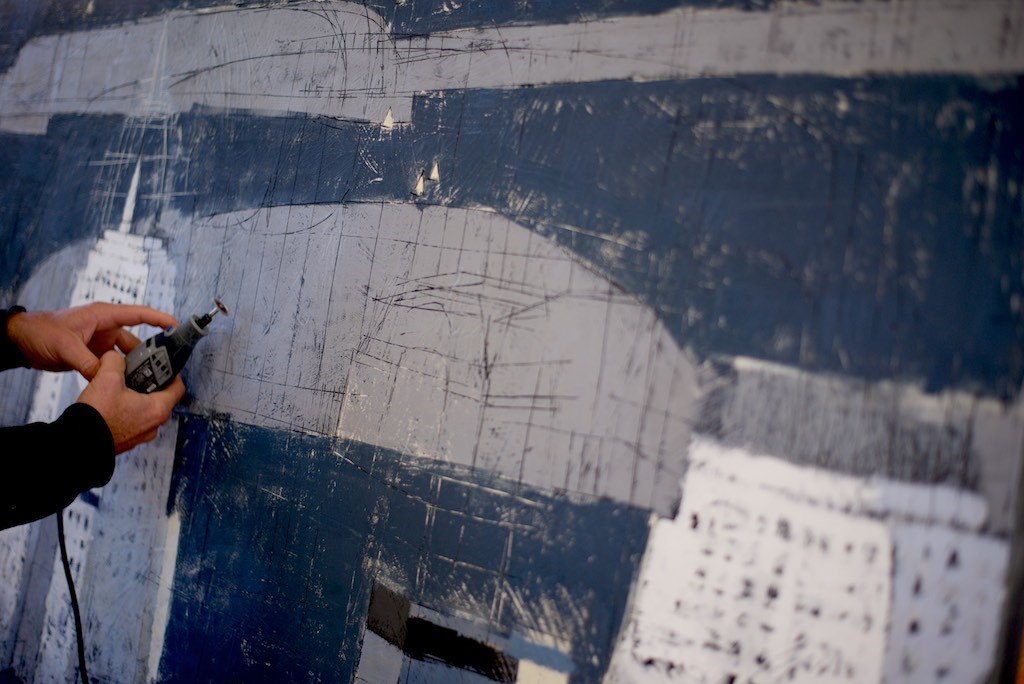
Using a Deremmel tool
In your studio you have squares of hessian how are these used?
A few days out of the month I will spend time messing around in the studio. Some of the best surfaces / textures can come from this time. I am always experimenting with textures. Burlap covered in a thick gesso makes for a great surface to paint on, but I usually use canvas or wood panels and a primer.
How many paintings do you have on the go at one time, as paint needs to dry?
Seven or so.
More than the drying is the fact that it keeps things interesting to jump around between paintings. 5 hours on a painting at one time is a lot. If I get bored then it will show in the painting so it’s good to change it up. Some paintings that don’t seem to work at the time, I will put away for weeks at a time and look at them every so often until suddenly the solution to improve them will seem obvious and then it’s time to take them out and start painting again.
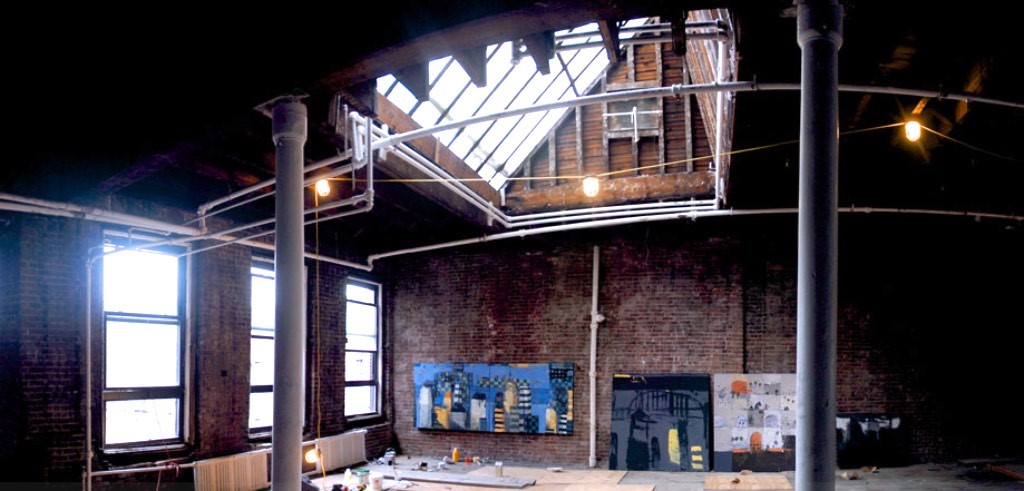
SoHo Studio, New York
Does drying become difficult due to climate?
No. 4 days all is dry.
You appear to be very heavy handed with your canvasses, taking to them with power tools and heavy scraping. Discuss.
The surface of these paintings is a result of heavy brush strokes, sanding, scraping and drilling. To get to do this, I first build up the surface with many layers of a very thick gesso. Then I can pretty much do anything to that surface (although not when I first started using both the sander and dremmel – I would often go through the canvas. A needle and thread can sew up most holes and a lump of gesso to hold it all together did the trick).
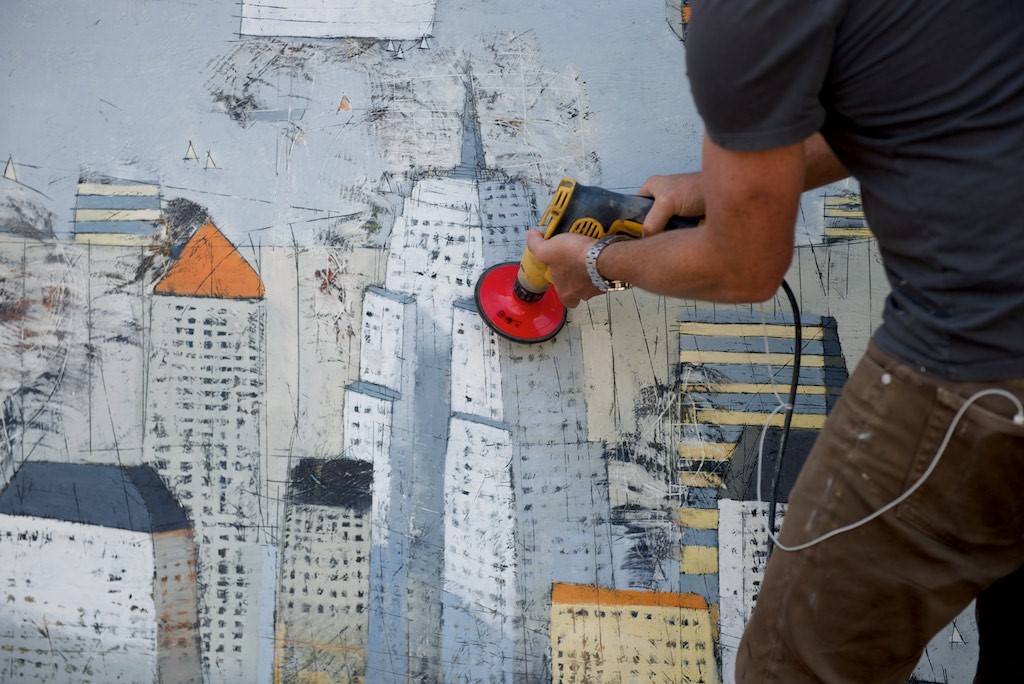
Sanding
You obviously listen while you paint. Is it music or podcasts?
Both, but I really need music for those moments when I am feeling very creative. Music seems to make the process of painting almost spiritual especially when I am listening to something ambient or orchestral. Film scores seem to do the trick too. Music is, very important, to me and the process.
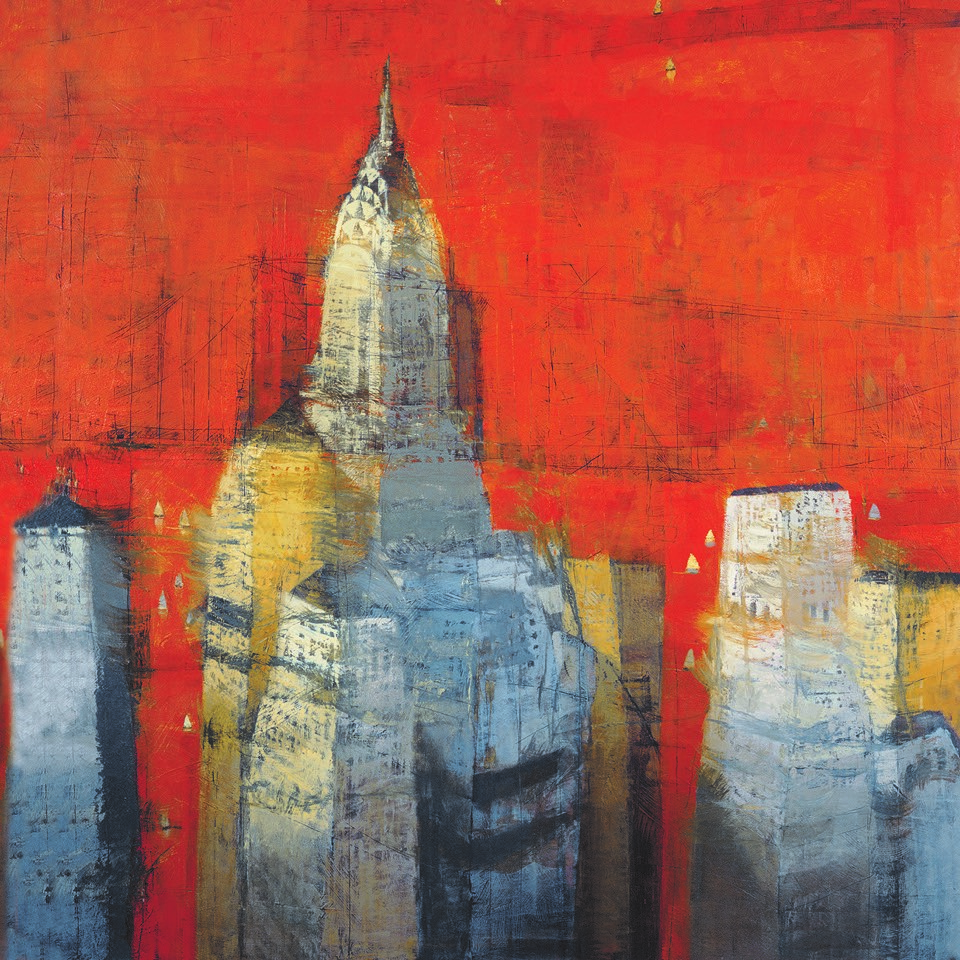
Above the Chaos 64 x 64 inches Oil on Panel
All paintings seem to require a “lateral thinking” phase, and then a completely disassociated creative phase. These seem like two very distinct states of mind and both as important as the other.
Midday Summer from Paul Balmer on Vimeo.
MIDDAY SUMMER
Discuss the importance of the scratch lines. What is this technique called?
I don’t think it has a name and I can’t say I have seen anyone using this technique. I “sketch” into the canvas with a spinning disk. It leaves a distinct groove which I paint black). Then I use the oil paint (with no linseed oil or turpentine) which is very thick, and I brush the paint on or roll the paint on so as not to fill in these lines. The lines form the basic foundation of the painting. I do prefer a “discovering” line rather than one that outlines an object – just like you find in a pencil sketch or an etching. A line that explores the form. I also work out the composition with these lines and the more the better. Even if an object has moved entirely, I like to show these lines as well ( it’s the ghost of where the object was) It shows the history of the painting and all the decisions that were made along the way.
How many layers, over, layers do you do?
The more layers the better because as I sand the surface different colors show through unexpectedly. The process of “messing up” and ‘discovering” is, for me, the most rewarding part of the painting.
I paint the painting then use a disk sander on the surface. I repeat that sequence until the painting looks complete. Some paintings I will leave very sanded and others will be cleaned up much more. If they look too real or edges are too defined then I will sand down those areas to rough them up. The best part of doing this is all the unexpected marks and colours that show up.
Do you have a still life set up or have you transferred the image to a sketch book?
I prefer not to work from real life (for both the cityscapes or the still life paintings). I do like sketching from memory then using that drawing to help map out the etching on the canvas.
How I remember the object seems to serve me better as it makes me paint an impression or a representation of the thing. The less real, the better.
How do you choose the colours you will use?
I’ll spend some time mixing colors (on a very large glass palette). Here I will be fairly casual because some nice combinations may come from this. I will then choose all the colors that will be in one painting. All the light colours and shadow colors. If they look pleasing on the palette then they should look good on the painting. All that I mix that doesn’t look good – I place on a separate glass for another time (that goes in the freezer where it will stay fresh for another painting).
Are there certain colours, that you use, in a specific order?
I start with the lightest colours, then down to the shadow colours. I like working with a particular red and I mix many shades of both warm and cool grey to keep the shadow areas interesting. I am a big fan of Payne’s grey, also a light purple mixed with sepia for the shaded side of a white object.
Discuss the perspective of your still life work?
The less real, the more interesting the painting is to me. So by playing with perspectives and adding many horizon lines – help’s make things less predictable. It started with the cityscapes because I wanted to get many things in one painting i.e. buildings, water, boats, and bridges. If I stuck to a 3 point perspective I would be limited. By having multiple planes and vanishing points I can add all kinds of objects all over the canvas.
A building painted flat alongside one that has dimension can be visually confusing but holds a viewers interest longer. It also throws a painting towards abstraction especially if I can reduce areas into patterns that are further broken up by texture.
Line is a very visual aspect of your work.
One can’t be too exact when drawing with a dremmel and I like the fact that it takes a few lines to work out the position and shape of something.
Stripes of fabric The stripes (tablecloth) offer a way to bring a viewer into the picture. It also sets up a perspective that is soon contradicted by an object following a different perspective. A feature carried over from the cityscapes.
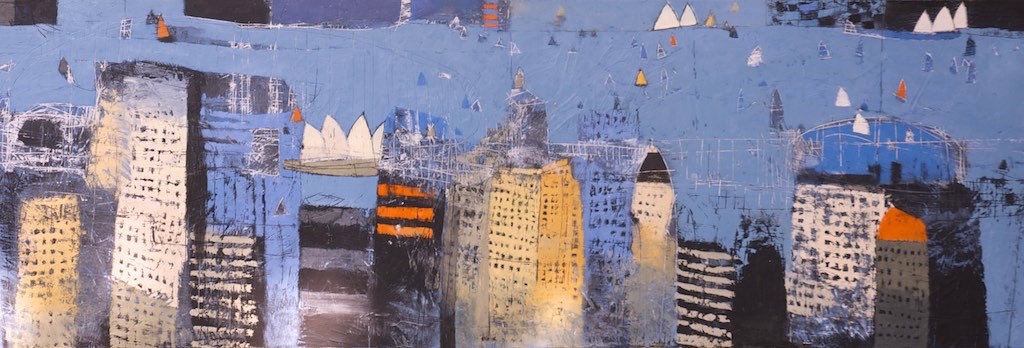
Sydney Opera House City and Sea, 24 x 80 inches, Oil on Canvas. (Paul Balmer is originally from Sydney.)
Comment on the importance of shadow in your work.
Shadows are there for contrast and to make objects look more dimensional. I also like the city to come out of the shadows to reach the light. These lights and darks make the composition.
How difficult is it to work with the video going behind you?
I set the camera up myself (or my wife takes the shots) so it’s not an issue. I doubt I could paint with a crew behind me.
General Questions
Take two paintings that have given you delight knowing where they have gone.
I have a large New York Cityscape that hangs in the Delta lounge at LaGuardia airport with a photo plaque and description. I often get sent the picture from folks that spot it.
I have a few paintings in hospitals around Connecticut including Yale Hospital – that seems to bring some joy to people .
Yale Hospital landscape
Discuss your studio.
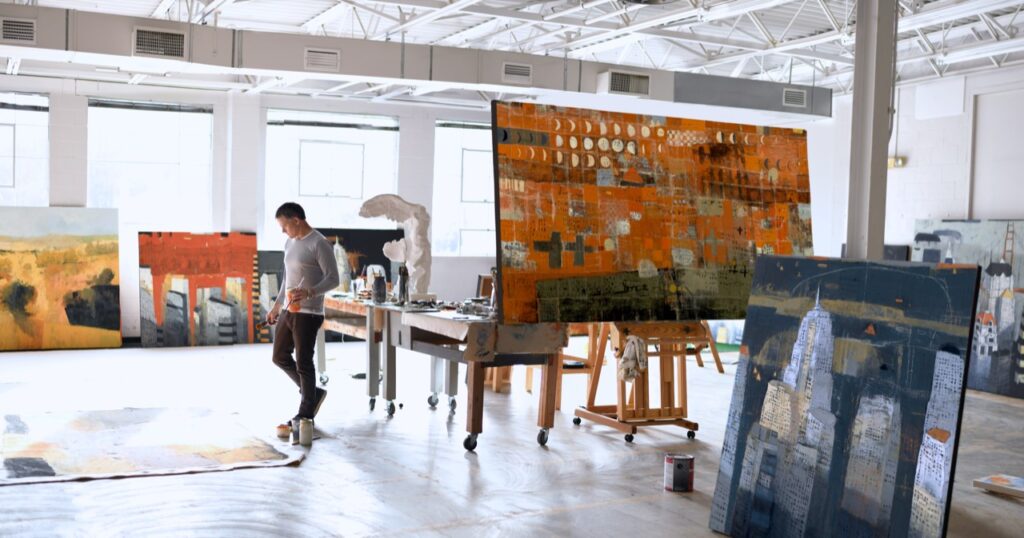
Current studio Connecticut
Size.
I work in an industrial space with high ceilings and many windows. It has so much light even on a rainy day. I also have two additional rooms downstairs – one for power tooling and the other for storage.
Do you only work in daylight?
No; I sometimes work at night. That was my preferred time until I had a family.
Do you see your work as in the tradition of Tonalism?
I do. I started my fine art career painting landscapes and they became tonal paintings. My current work sets up a mood with one primary colour (and limited tones). Perhaps this is why I was included in the book by David Cleveland on “A History of American Tonalism”
What led you to take the huge leap from commercial art to a freelance painter?
I learned everything from being an illustrator and doing commercial art but to be a painter was the goal. To have the freedom, with paint, every day, to interpret what you feel or see. And to spend one’s day experimenting and playing with colours and textures.
What is one part of this leap that still brings a smile to your face?
To have some people recognize my style and say “that’s a Paul Balmer” makes it pretty special.
Contact:
Paul Balmer
w w w . p a u l b a l m e r . c o m
https://www.instagram.com/paulbalmerart/
Deborah Blakeley, Melbourne, Australia
Interview by Deborah Blakeley, October 2020
Stephen M Redpath
Many of your watercolours are dominated by the horizon – discuss.
The horizon is a mysterious, glorious and untouchable thing and I spend a lot of time staring and thinking about how to represent it in my work. Often, I find that a simple line of paint, representing an horizon, can capture what I’m after and take me to another place. See the two paintings below as examples.
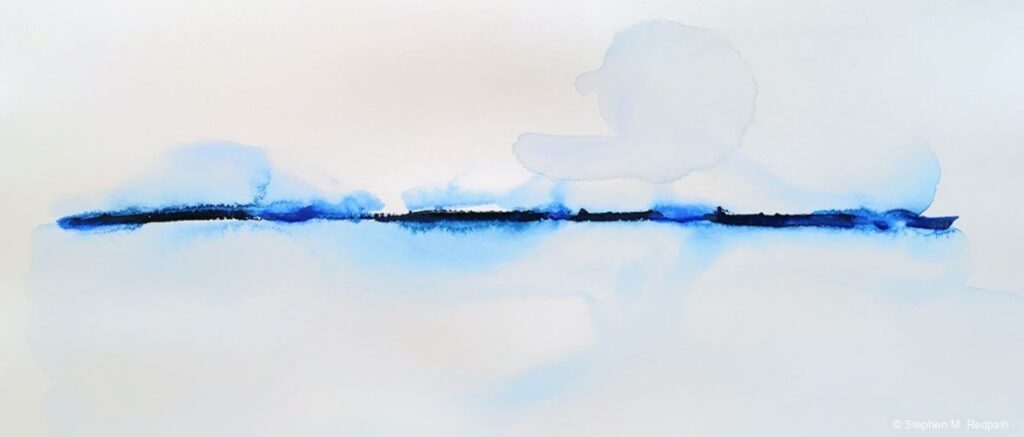
A Distant Shore, Watercolour, 34x15 cm
On a practical level, horizons help set the perspective and I spend a lot of time playing with the position in the paintings and how that changes the feel of the piece. However, not all of my work is focused on horizons. Sometimes I want to escape their tyranny, but I do find myself coming back to them again and again.
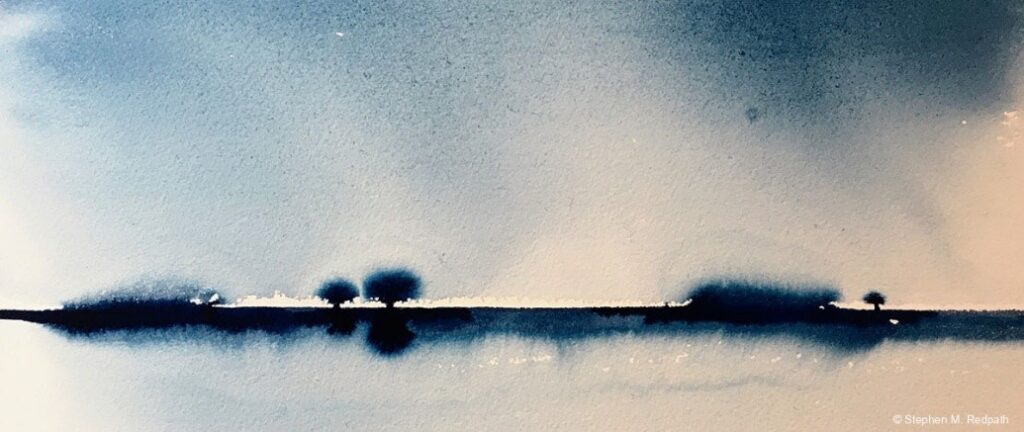
Three Trees, Watercolour, 50x20 cm
How is your work able to command the word ‘Vast’ so well?
Vast landscapes take your breath away. They give us perspective on our place in the world in the same way that staring into the universe at night does.
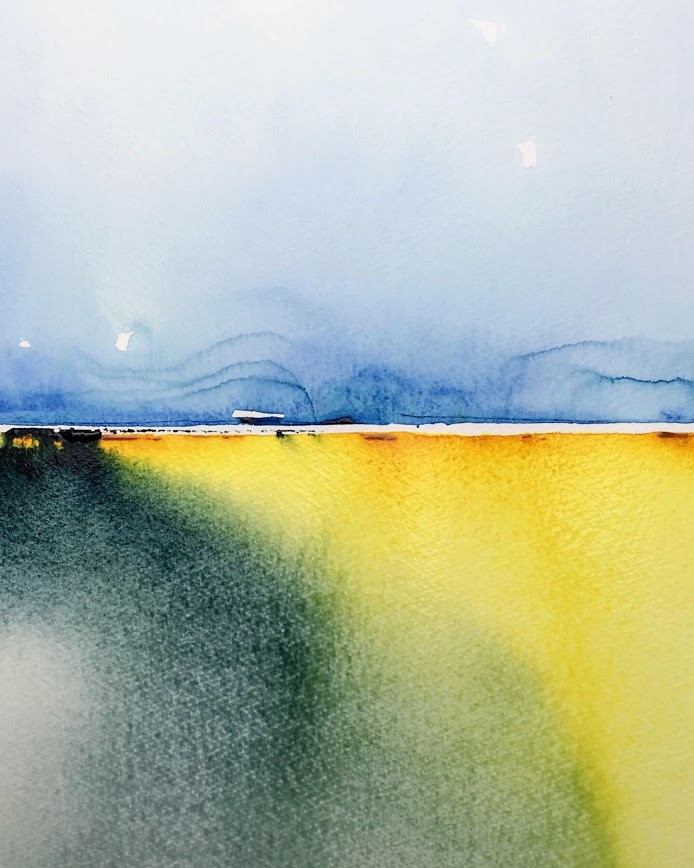
Landscape in Blue and Gold, Watercolour, 32x50 cm
I am interested in trying to represent that feeling of awe. How do I do it? Well I find that a tricky question to answer. First, I should say that I have spent a lot of time looking at how other artists, such as Turner or Ackroyd do it and why they are so brilliant at giving a sense of space. For me, I think it comes down to leaving ambiguity and space in the painting and not cluttering up with detail. It is about what you leave out as much as what you put in. I use a lot of large washes and let them bleed gently into white paper.
Sunrise in the Mountains, Watercolour, 38x54 cm
Your landscapes bring climate into the paintings expand on this using ‘Shower Moving Inland’.
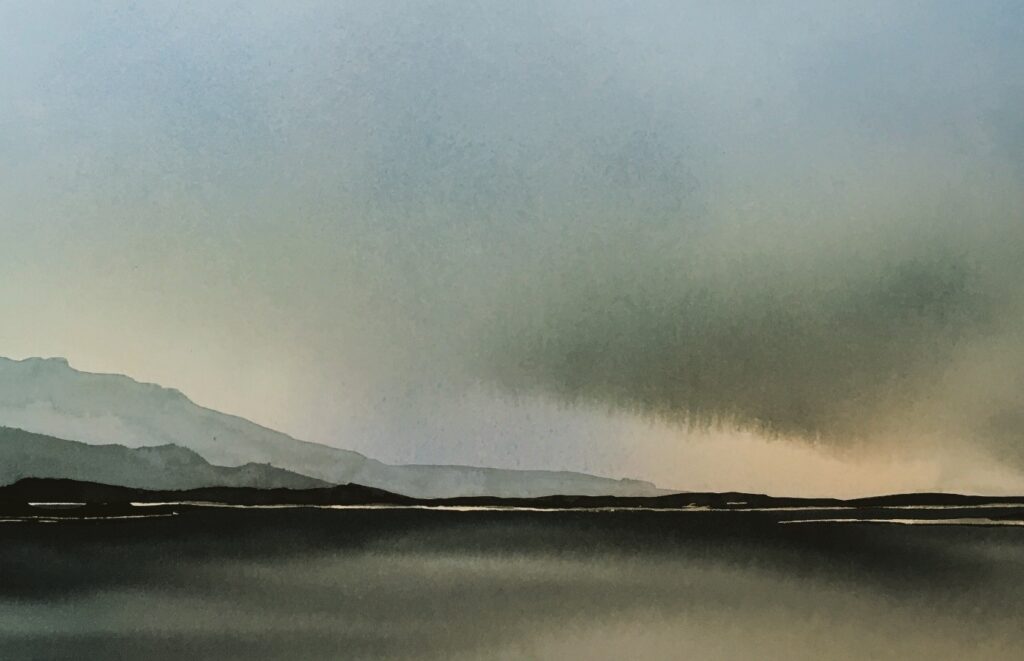
Shower Moving Inland, Watercolour, 53x35 cm
Living in Scotland and sketching/painting a lot outside, I naturally find that the Scottish climate and light imbues almost all of my work. Of course, when you live here, you can’t ignore the weather. Indeed weather provides so much of the interest in landscapes – the shifting shadows, tones and colours, the excitement and energy of storms and of course the rain. Wonderful challenges for a painter. I can’t really imagine living in a better part of the world, for the diversity of landscapes and weather, and for the delicious, northern light.
You make the comment ‘I love to work in that area between representation and abstract’ expand on this comment.
As my painting has developed, I find that I’m not so interested in purely representational work or very abstract work, although obviously I greatly admire other artists who work in these ways. When I’m out in the countryside, I often feel a variety of emotions, from awe and elation to anxiety and sometimes even fear. It is that overwhelming, emotional experience that I feel compelled to try to capture in my work. How it feels to stand in these incredible places, that have been crafted by geological forces over millions of years and that are home to unique assemblages of species.
I often start with representation. I do a lot of sketching outside and constantly looking for those little moments or places that are the key to capturing a sense of place. I also take reference photos.
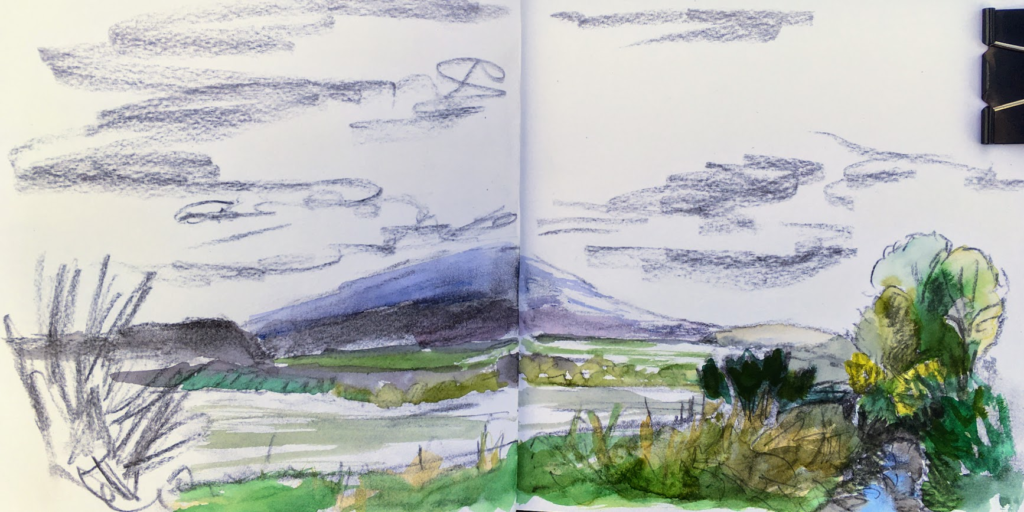
The Howe of Cromar (from sketchbook) Watercolour and charcoal
I come back to my studio, I put the photos and sketches up and quietly I re-imagine myself in that place I want to paint – the feelings, the light, the sounds, the smell and the landscape. Then I work quickly to try and capture that feeling. I don’t care about the details – whether the line of a mountain is exactly right, or a tree is in the right place, or even whether there is a tree – it is about whether I look at the finished work and feel moved and a connection to that place. Sometimes, I skip the whole sketching part and work from the memory of place alone and look inward to find the spirit of a place I remember.
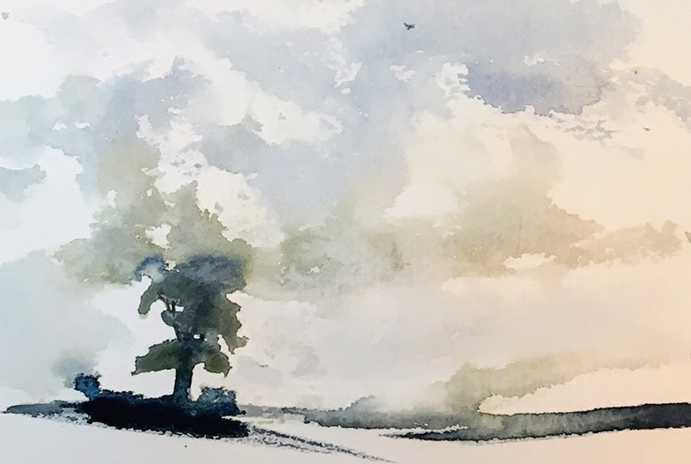
The Howe of Cromar. Watercolour, 20x14 cm
So when the process works it is a conversation between the painting, my emotions and the landscape – I find I disappear completely into the work and pop out at the other end. Boy – that is a wonderful and addictive process. But of course it can also be frustrating when it doesn’t come together as I would like. In that case I keep on trying to figure out why something didn’t work. In fact having a painting that I don’t like gives me such freedom to try approaches I probably wouldn’t try on a blank piece of stretched paper. I am surrounded with folders of discarded paintings…
How has your former University life with wildlife and landscape influenced you painting?
Oh, in so many ways. I spent 35 years working on wildlife and conservation issues, and all of that history and learning and experience has naturally contributed to who I am. We live in a time of brutal and rapid change to our natural world, so I carry a constant sense of grief and anxiety. I can see this coming through in some of my work, and I am sure it will continue to do so. But at the same time I don’t want to focus on the negative, I want to reflect a sense of hope and love. This is partly to help maintain my sanity. Using art as a therapeutic way of dealing with the grief helps for sure. I hope it may even help lift and inspire others. I also use art as a
It is odd moving from a career in science to one in art. I find both approaches incredibly exciting and stimulating. Obviously, there are many differences between the two, but they share three important things. First, they are both focused on finding a truth about the world how it works and how it is experienced, second, at their heart they stem from careful observation, and third, they both rely on reflection and criticism. So in these ways my science life has made my entry into the artistic world easier. I have spent much of my life working in UK upland landscapes, and I have also been fortunate enough to travel to amazing places around the world for work. My head is full of imagery from these places and I know these inform much of my work.
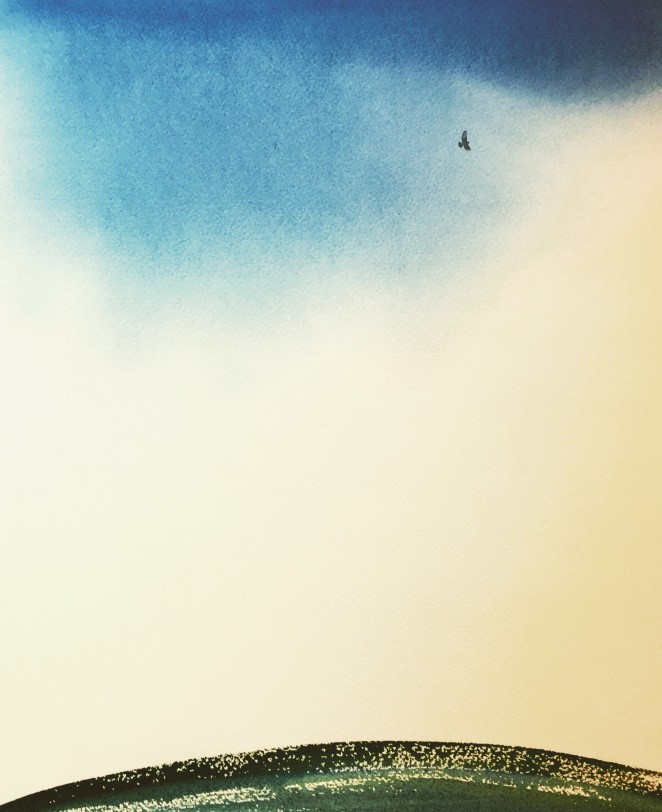
To be a Buzzard & create a sky. (from poem by Norman MacCaig] Watercolour, 50x78 cm
Discuss the boundaries you see in the landscape and your current work.
I am always aware of the boundaries that affect my relationship and connectedness to landscapes. I was incredibly lucky to spend some time in the Serengeti a few years ago. It was amazing to see the wildlife and the big open spaces, but in these situations, there was no feeling of belonging, of being a part of the place. As we drove around in our Land Rovers, it felt as though I was watching it on television, rather than actually being a part of it. This deeper connectedness only comes when I spend time walking, snoozing, getting wet, sketching etc. Where I live in Aberdeenshire I walk almost every day in the amazing countryside around our village, and my relationship with it has totally changed over time. It feels a part of me. This barrier between the artist and the landscape is something interesting to explore. I am uncertain how it affects my work, but I feel sure it does.
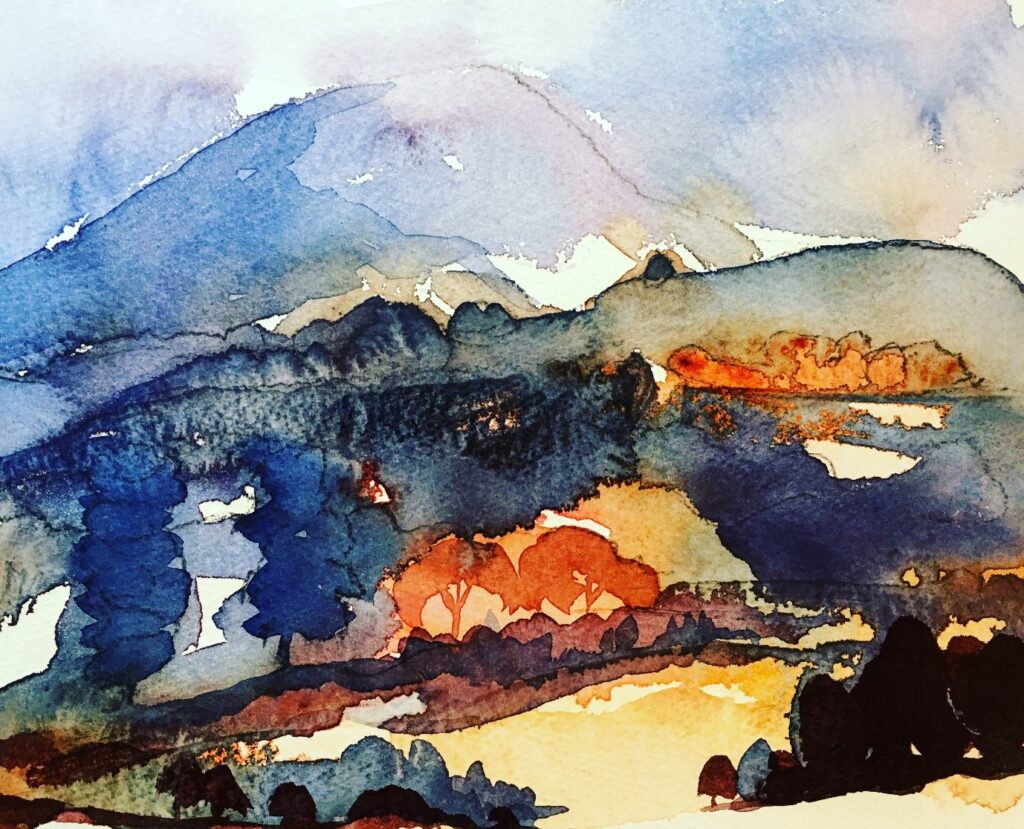
The view from the village, Watercolour, 46x31cm
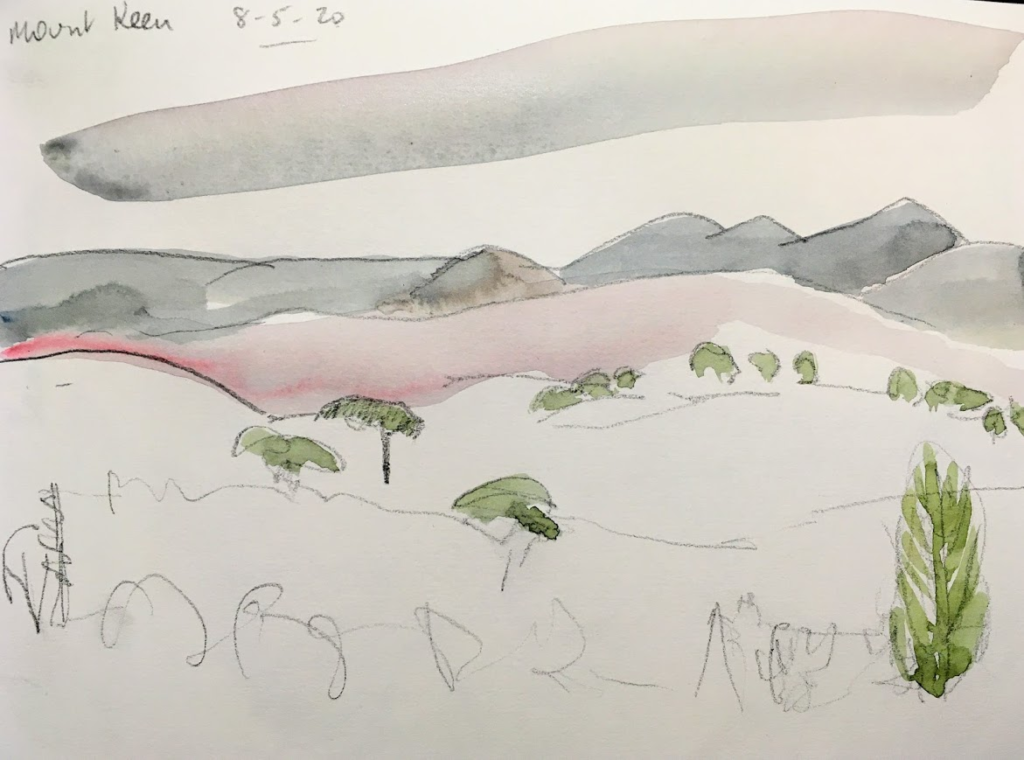
The land where I live (from sketchbook) Watercolour, 20x14 cm
My awareness of boundaries has been exacerbated by having Chronic Fatigue Syndrome (CFS), which I was diagnosed with last year. For those who don’t know about CFS, or M.E., it is grim. It sucks the energy out of you and affects your cognitive function, leaving you exhausted, confused and disorientated. Not surprisingly, this condition has affected the relationship I have with the world. It seems further away, as though I am trapped behind glass. I battle with this daily and sometimes the frustration pours out of me when I’m painting – see the two paintings below.
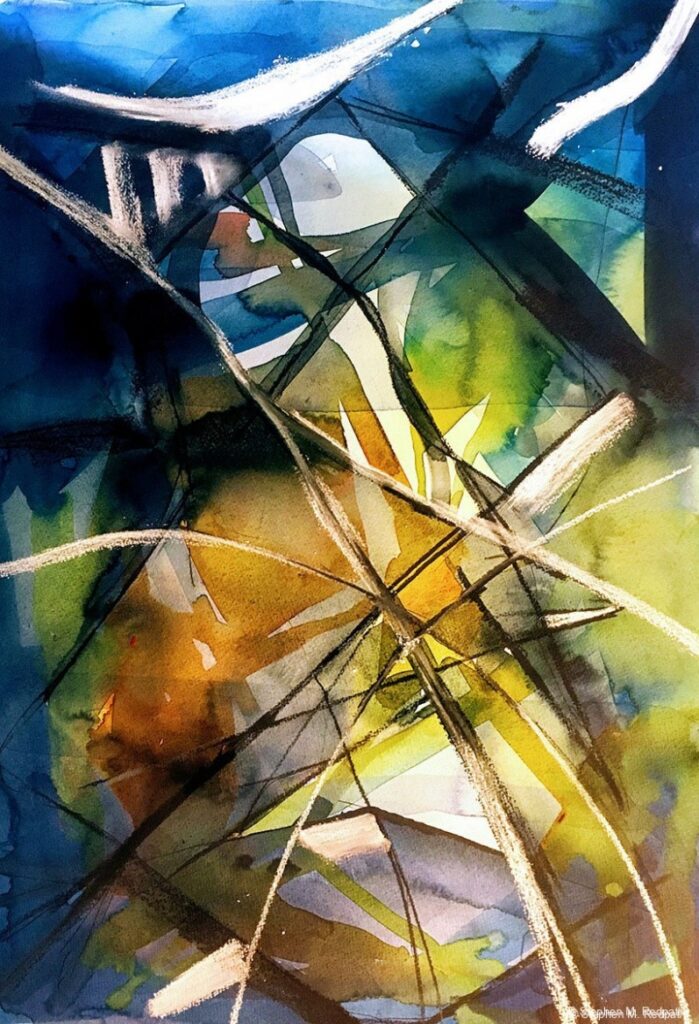
A Lost Connection, Watercolour and charcoal, 48x68 cm
You have recently been diagnosed with Chronic Fatigue Syndrome. What has the silver lining been for you?
I am so lucky that my condition is better than other sufferers have to live with. The glowing, silver lining is, of course, that I am able to paint. I often struggle to read and write and be coherent (writing responses to these questions really takes it out of me), but thankfully the condition doesn’t hinder my ability to paint, often for hours on end. What an absolute, glorious joy.
The pandemic has been hard on artists and galleries. Can you tell how you have dealt with 2020 so far?
It has been a roller coaster. My world came crashing down last summer, when I got diagnosed with CFS, so I went into my own personal lockdown as a result. My life hasn’t changed all that much since.
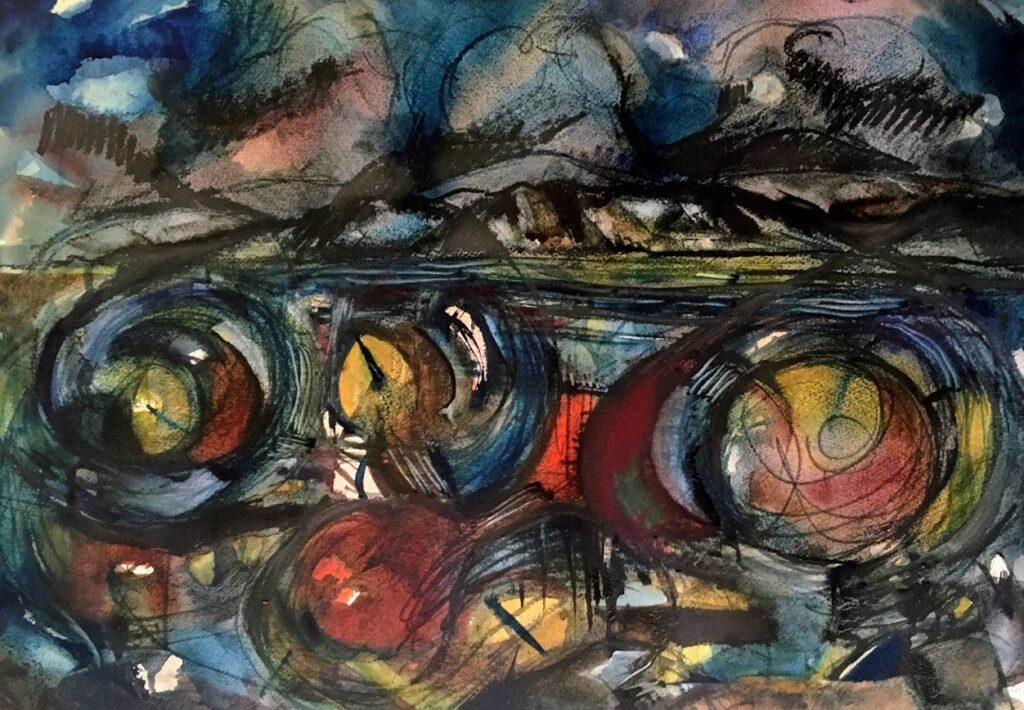
The Wildness Within, Watercolour, ink & charcoal, 72x54cm
I spend all day, almost every day painting, exploring and playing. In fact, despite the illness I feel incredibly fortunate – like a child in the largest sweet shop in the world, without the risk of diabetes or tooth decay. One frustration with the whole pandemic business has been that I’ve had my first two exhibitions cancelled. Fortunately, however, I have finally been able to show my work this autumn at the Tolquhon Gallery near Aberdeen, so I’ve been able to see what they look like together up on the wall in space.
The size and shape of your paper reflects the different landscapes discuss this use three different sizes.
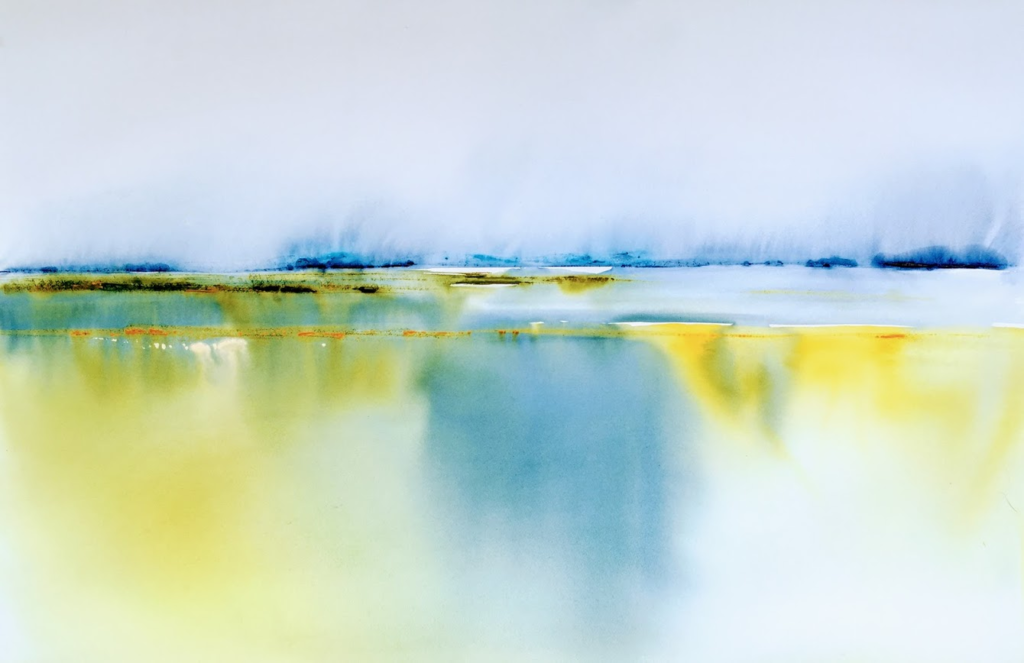
Stillness, Watercolour, 120x80 cm
I have been playing with a variety of different papers that vary in size and texture. Size and orientation obviously affects the feel of a landscape. Recently, I have started to paint on larger paper and it is such a thrill. It forces you to work at a different pace and is dynamic and energetic and stimulating. It also helps create that feeling of space.
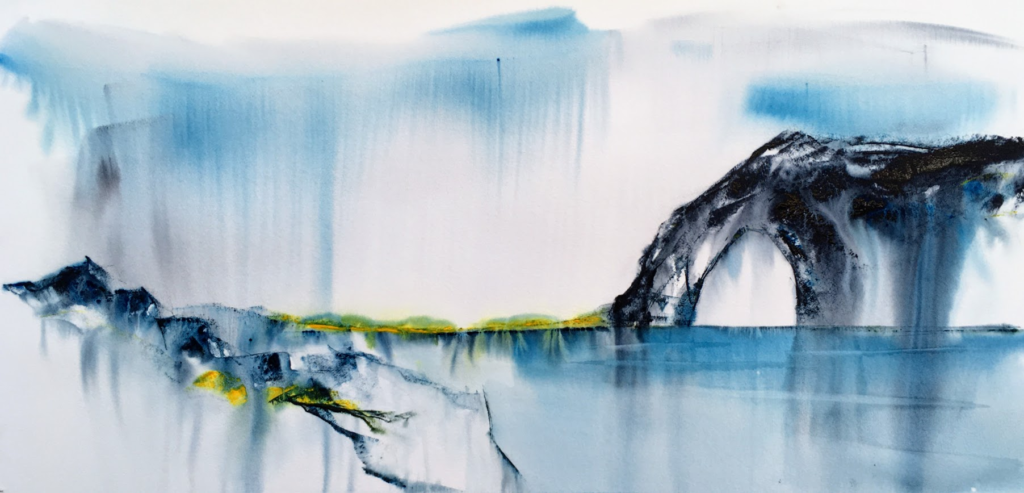
Arctic peace, Watercolour, 120x55 cm
You are not afraid to use dramatic colour combinations in your work neither is nature, discuss.
I adore colour and playing with combinations. Why be afraid? When you go into landscapes and you sit and really look, you see amazing colours and dramatic combinations. A lot of my watercolour work builds on calm and subtle colours, but nothing is more exciting than a line of bold colour in an otherwise calm painting.
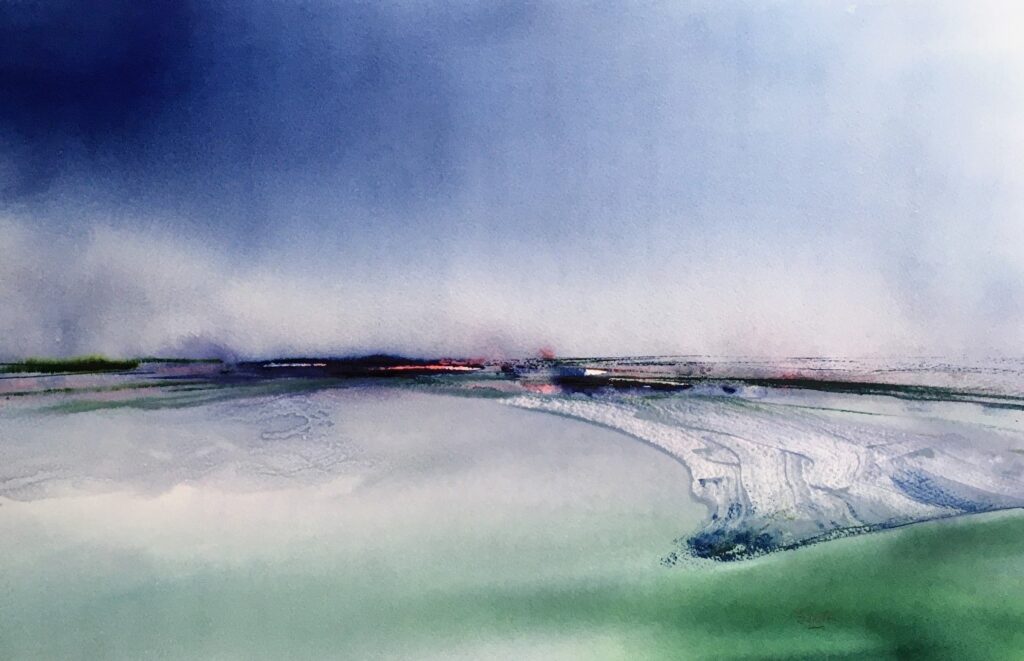
Incoming Tide, Watercolour and ink, 72x46 cm
I really love and admire the work of Brian Rutenberg and I sit and stare at his use of colour. Sometimes when I want a break from watercolour I will work with pastels or acrylics, to be able to enjoy rich colour.
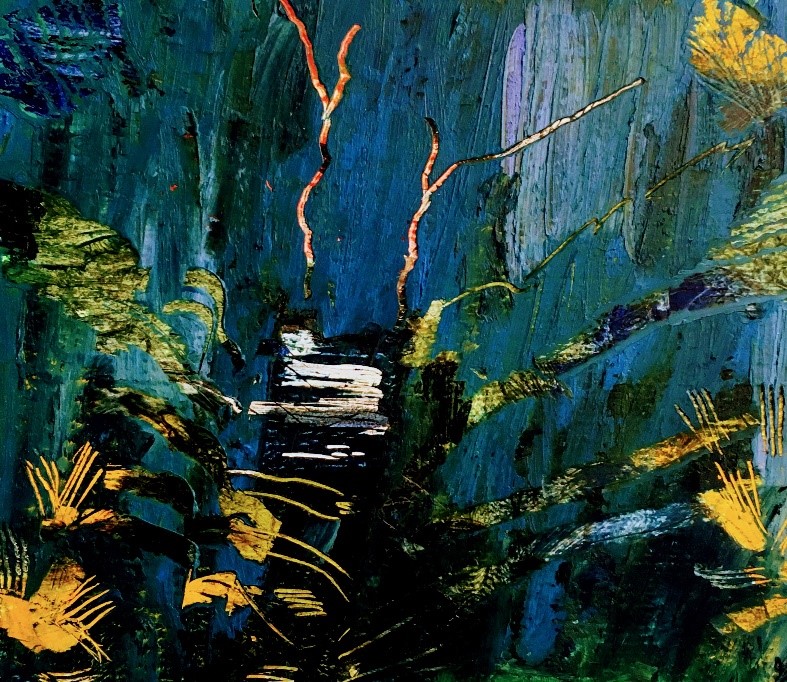
Tarland Burn, Oil pastels, 15x15 cm
We are often told ‘Less is best’, you achieve this in your work. How can you convey so much with so little?
This is at the core of what I do. I am driven towards simplicity and I am slowly learning to achieve it through experience. The challenge of course is understanding when to stop. This takes time to learn (at least for me), so sometimes I force myself to not stop but carry on adding to a painting, generally until it is a hopeless mess. The key thing here is to watch myself and reflect on when I felt the most power in the painting and when it flipped to a different state. In watercolour it is that first line that is often so important – like the surgeon making the first cut. You have to be bold and confident. In the painting below I knew I had what I was trying to achieve after the first mark.
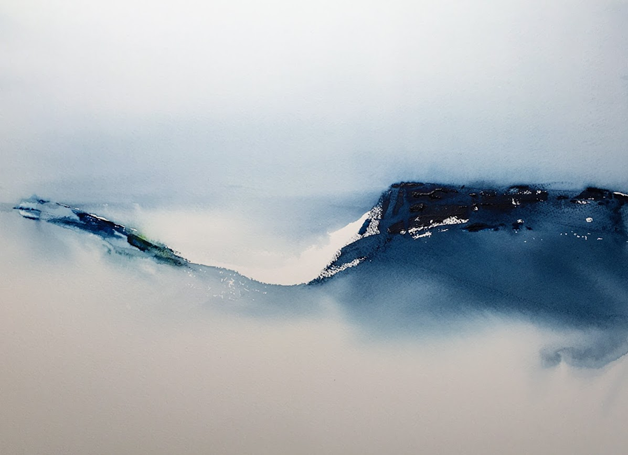
The Coll, Watercolour, 78x54cm
Where did you learn the art of watercolour?
I am still learning. I haven’t been to art school and have only done a few evening classes, so I try and study other artists such as Turner (obviously), Ackroyd, Marin & Melville and I paint, paint and paint, with a self-critical eye. Slowly I am getting to know other artists to get their feedback and to understand their practice. And this winter I am doing a 5 month residential art course with a highly regarded art school (Bridge House Art in Ullapool). I want to be challenged and to learn and then bring that back into my work.
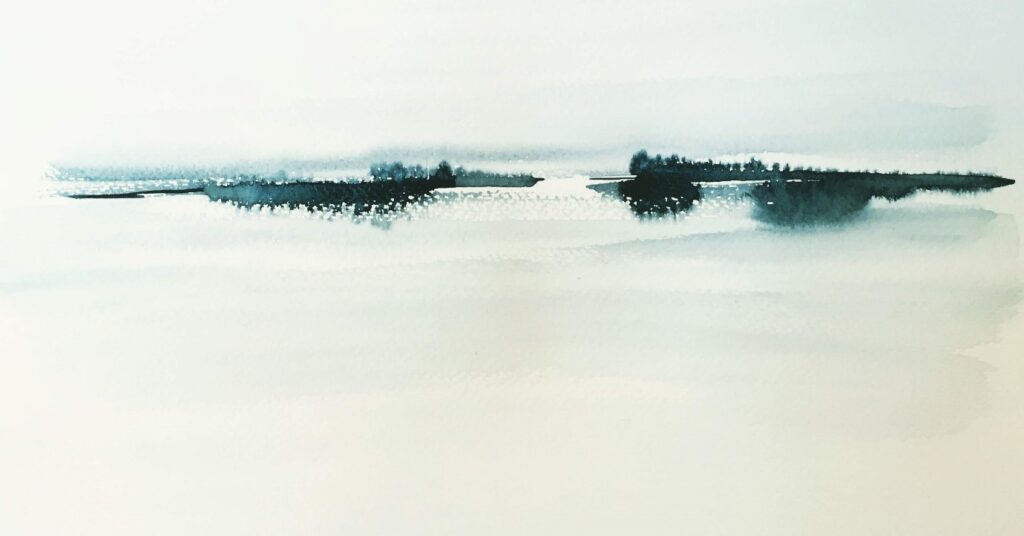
Pike Lake, Watercolour, 38x28 cm
Since my career in science stopped! I have finally allowed that compulsion to paint to come out. It feels like opening the floodgates and there is no way I could possibly stop now. I paint constantly and I’m just completely captivated by watercolour and trying to figure out how water and pigment and paper interact. It is just so exciting. Sometime maddening, but often it makes me gasp with joy – how that first line of Prussian blue demands attention or how a wash slips and settles and competes with its neighbouring colours. I do paint with pastels and acrylics, but watercolour is my first love.
Why is it so important for you to share your landscape through art?
Firstly, painting landscapes is a compulsion. I don’t seem to have much choice in it and my main motivation does not come from wanting to share. I get up in the morning and I simply have to paint. I often dream of colour and landscape and I need to get it down. That said, it is a pleasure and a privilege when others are moved by my work. Naturally, I hope that by producing work that moves me, it may also move others, bring some light and just make this world a tiny bit better.
Contact:
Stephen M Redpath
Deborah Blakeley, Melbourne, Australia
Interview by Deborah Blakeley, September 2020
Julie Nelson
Can you discuss the importance of symbolism in your work?
Symbols allow us to communicate without the barrier of language. They might mean different things to different cultures but that makes their use very interesting. They create links and connect us.
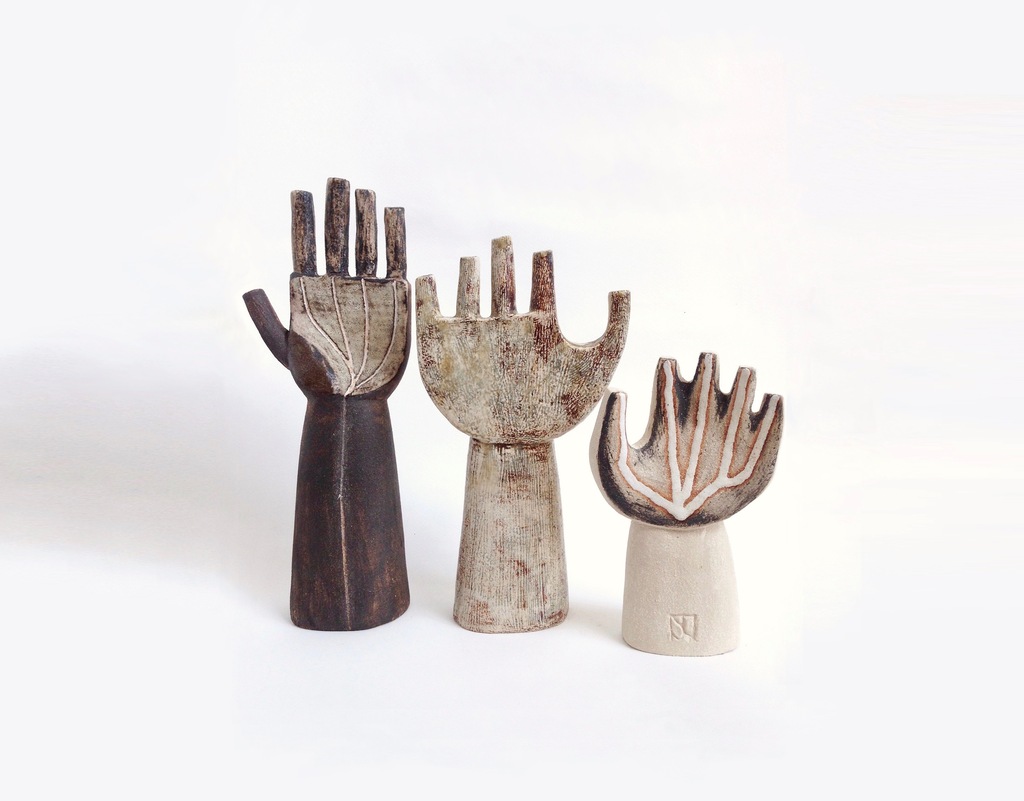
Hands trio
Comment on how you have combined sculpture with ceramics and why?
Humans have been sculpting in clay for thousands of years. It feels like the most natural thing to do and I started making non-functional ceramics during my degree course many years ago. I don’t get too hung up about definitions, it’s the intention that is important.
The human hand is also a verbal part of our communication, as we twist and move our hands while talking. Discuss this in relations to your work.
Many of us take the hand for granted. I have a lovely book by Bruno Munari called ‘Speak Italian’ which has pages of hand gestures alongside the translation. He understood how important these gestures are to our understanding. Even if you don’t use them, the hand is the most incredible piece of anatomy and hand eye co-ordination is instantaneous for most of us. We do this without thinking. So I am drawing the attention to the tool of tools and paying homage.
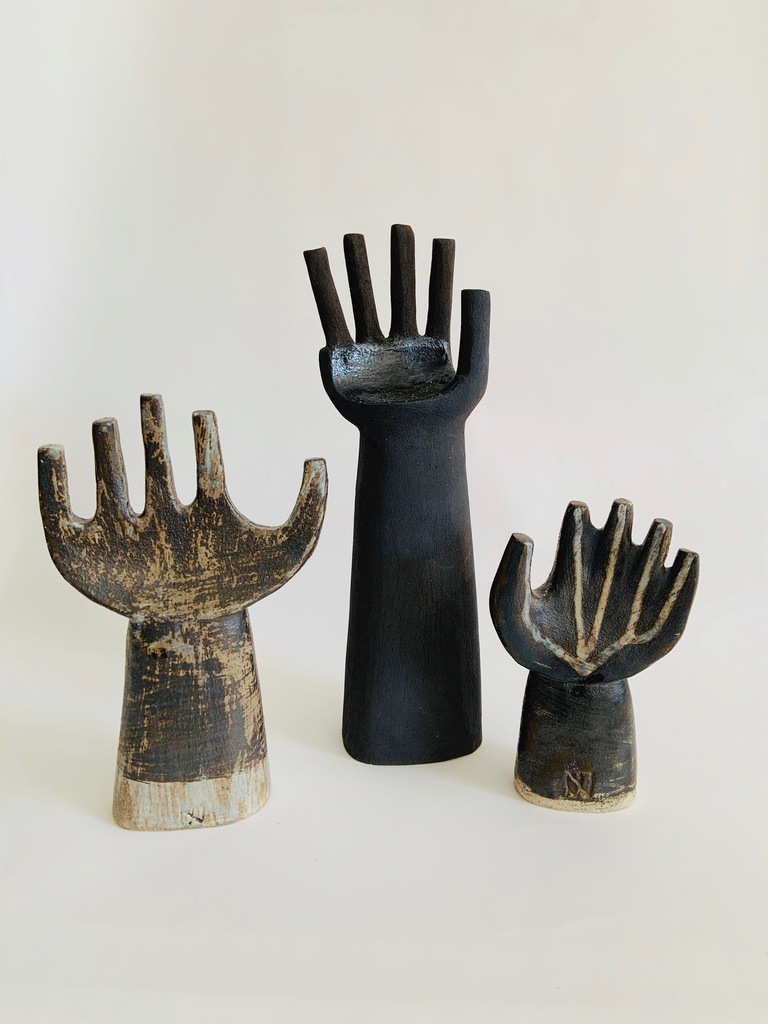
Hand trio, black, metallic and venule
How do you keep coming up with titles for all your different hands?
The names are simply descriptions of the glazes with each one a unique combination.
Can you explain the different variations and affects you get when using stoneware, porcelain and mixed glazes?
My technique of mixing porcelain and stoneware offers a random texture which provides a good base for oxides and matt glazes. I have 3 white glazes which I interchange depending on the base colour. They highlight the texture which, in turn, highlights the form of the piece. I do the same with my black glazes.
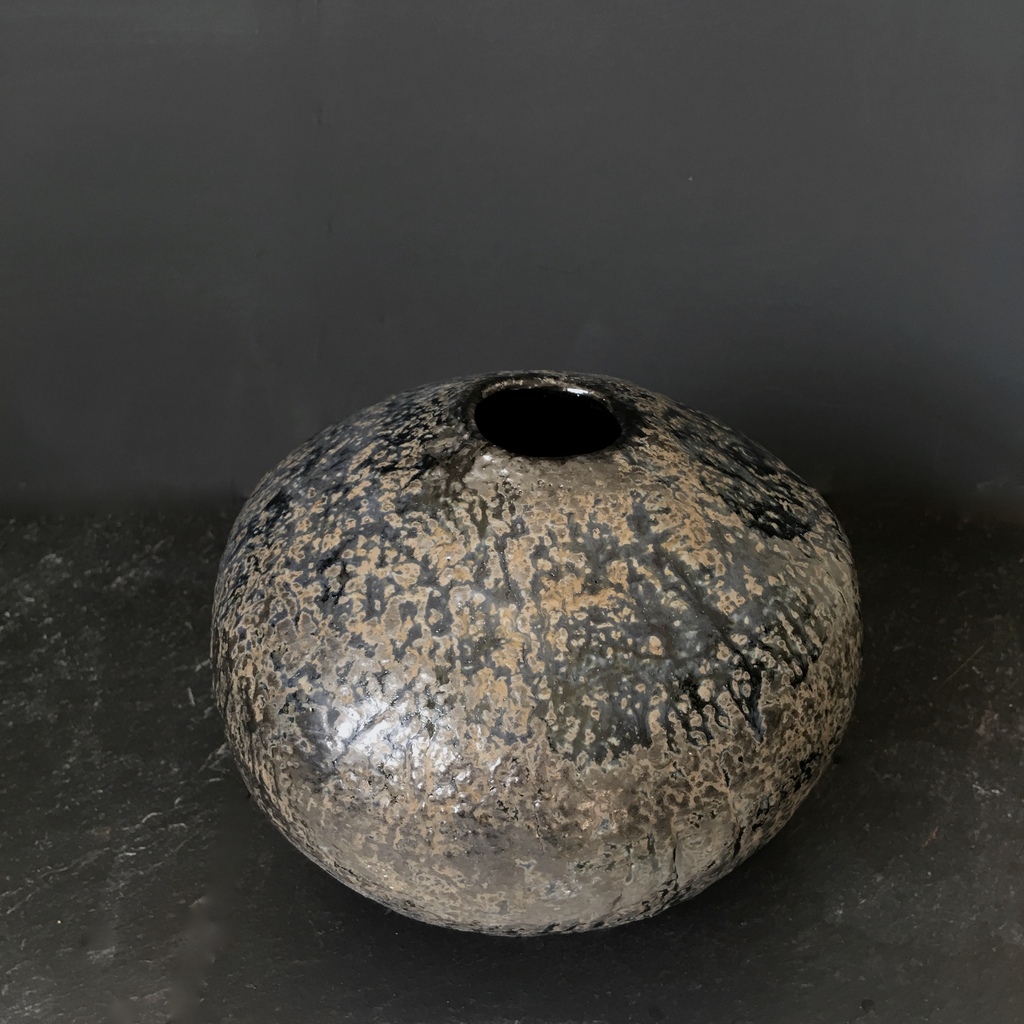
Midnight metallic vessel
How can a curator take your work to another level?
A curator can introduce related artefacts and artworks that share a theme which draws interest from the public. Museums are ripe for interpretation and contemporary pieces can reinvigorate displays of historical objects
We are all effected by our environment, discuss how growing up and now living by the coast can be seen in your work.
My childhood was spent by the sea in Devon and family holidays were spent on the rugged and wild Cornish coast. I took this beautiful landscape for granted. From college, in my late teens until a few years ago, I lived in Hackney and Stockwell in London, both very urban environments with their own contrasts and tensions. It was vibrant and exciting. It wasn’t until I moved back to the coast, with a young family, that I appreciated the importance of a connection to nature. Coastal environments are a rich source of inspiration with the effect of the sea and salty air on rocks and pebbles. I can’t walk on a beach without filling my pockets.
Expand on your installation, ‘Flock’.
How any birds make up your flock?
I originally created 100 ceramic birds which took me about 4 months to make and it was this installation that presented the idea to explore clay workshops with refugees, to think about migration and include a supportive public. The aim was always the artwork at the end. Currently there are 200 birds in Flock Project with plans to expand the it even further. It feels timely to do so.
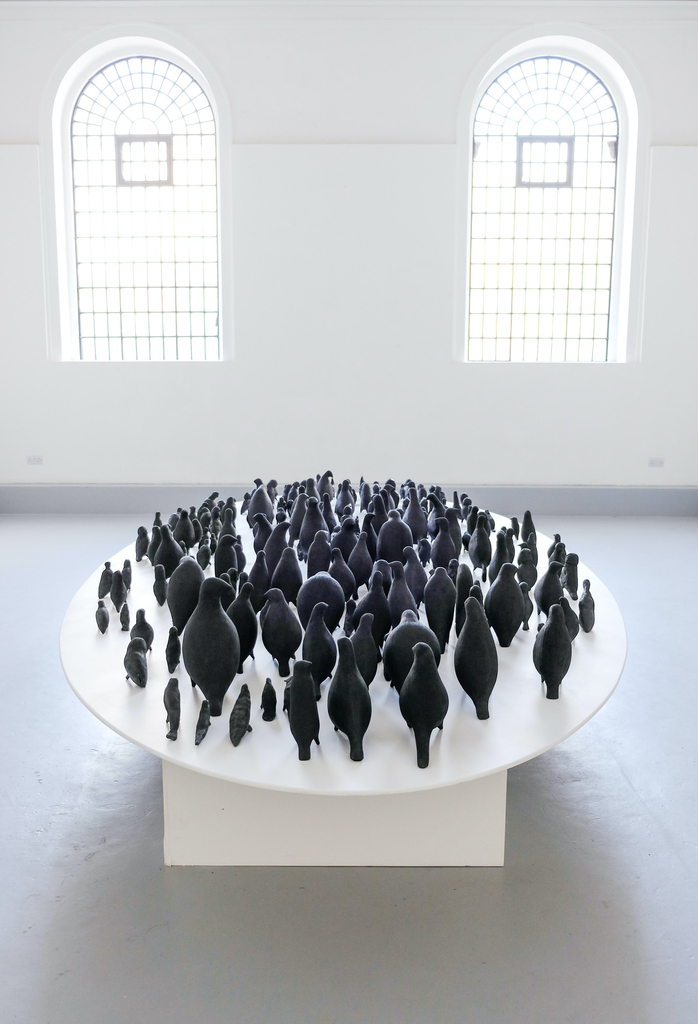
Flock Project, Photo by Ben Roberts
Where has ‘Flock’ been?
The installation has been exhibited in Brighton and London so far. We held workshops in the ceramic galleries at the V & A Museum, a favourite place to visit in London, and have plans to display the project in a museum which contains a collection of birds from around the world.
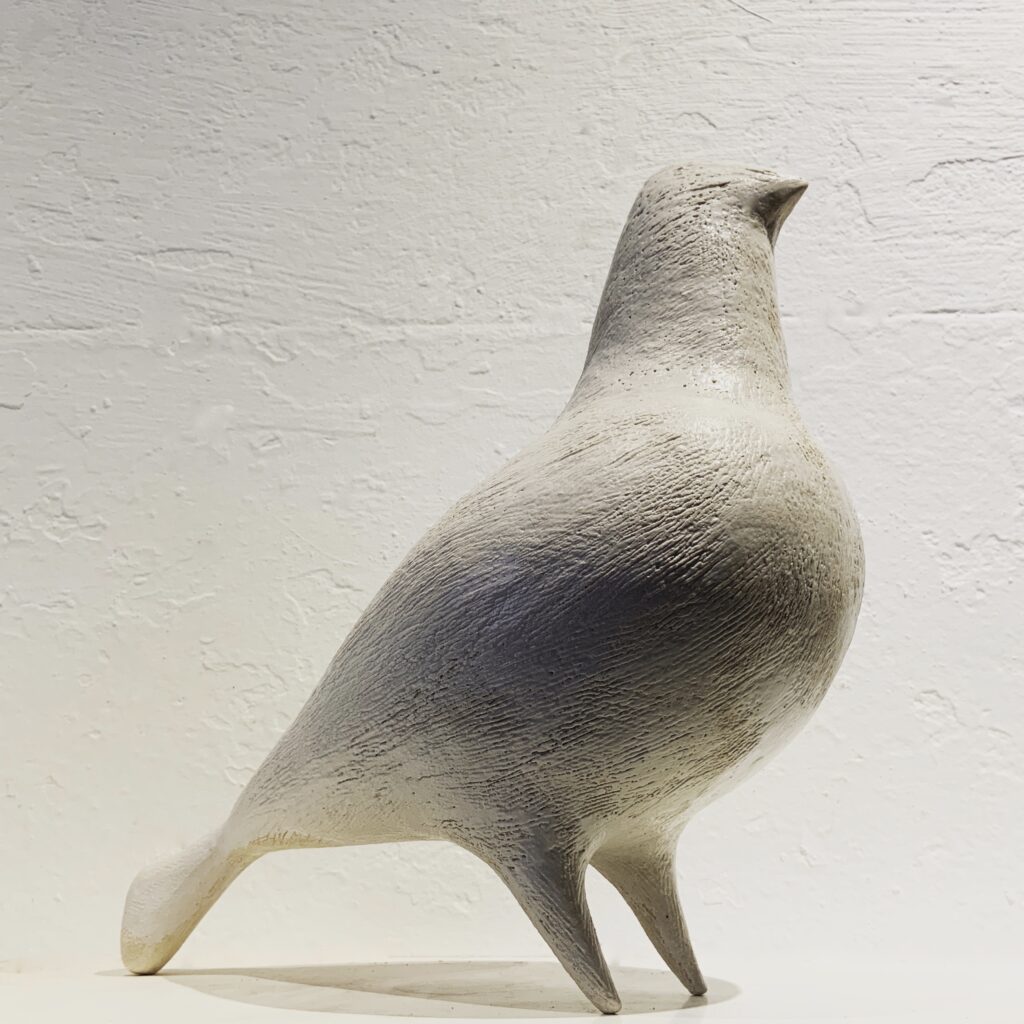
Large Ponti bird
How do you organize the positioning of this installation?
The last iteration of Flock Project was in a large white gallery and it felt appropriate to elevate the birds onto a plinth which was shaped into an oval to echo the murmurations that Starlings make. This circular form brought the project back to the original inspiration, watching these beautiful flight patterns on the end of Brighton Pier.
Comment on the environmental issues related to birds and migration and ‘Flock’.
Birds are the most studied animals on the planet and climate change is impacting their numbers dramatically. This decrease is the first sign that things are wrong. There are parallels with human migration - the survival, safety and opportunity for your family (genes) to thrive. It was a privilege to get to know people who have survived such traumatic journeys and to see how the creative process can help to heal.
Discuss the different variations, colours and shapes of your birds.
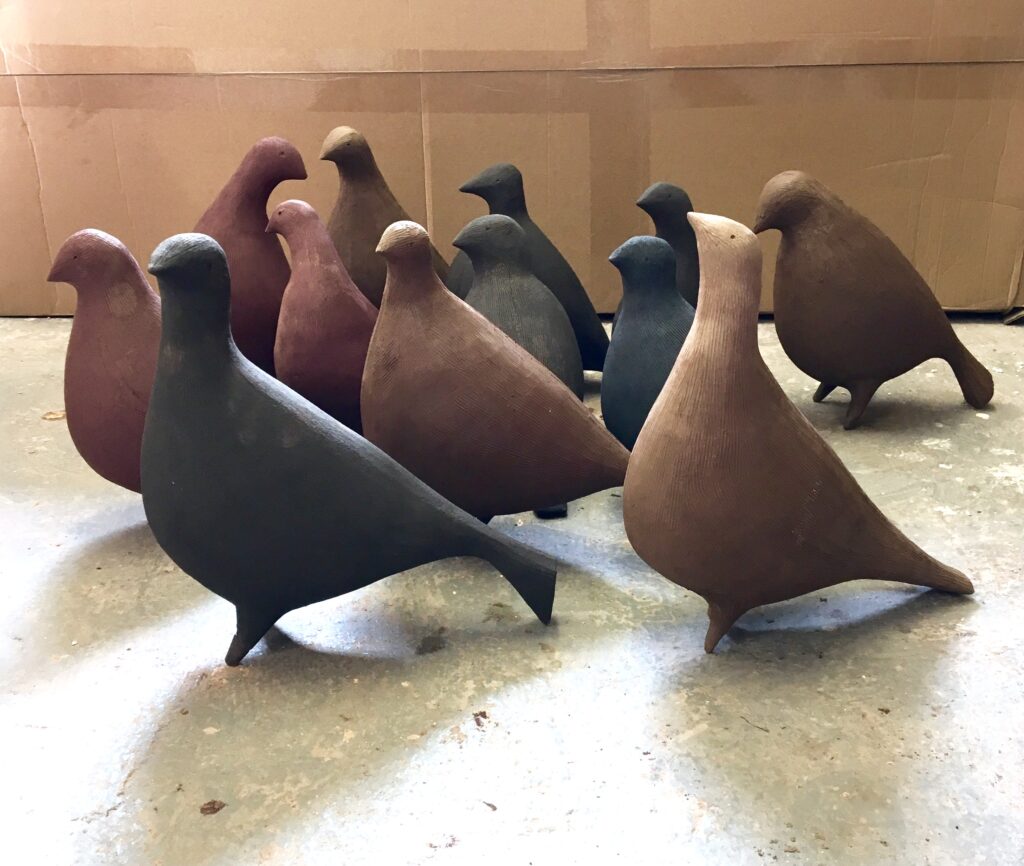
Various stages black birds
I’m simply exploring ‘themes and variations’. I sometimes put images up in the studio of a bird that comes from the other side of the world but I’m not interested in direct representation, more to remind me to loosen up and experiment with the form and patterns made by a group.
You comment, ‘My vessels result from experiments in form, surface, texture, pattern, and composition.’ Show and give an explanation with several of your vessels.
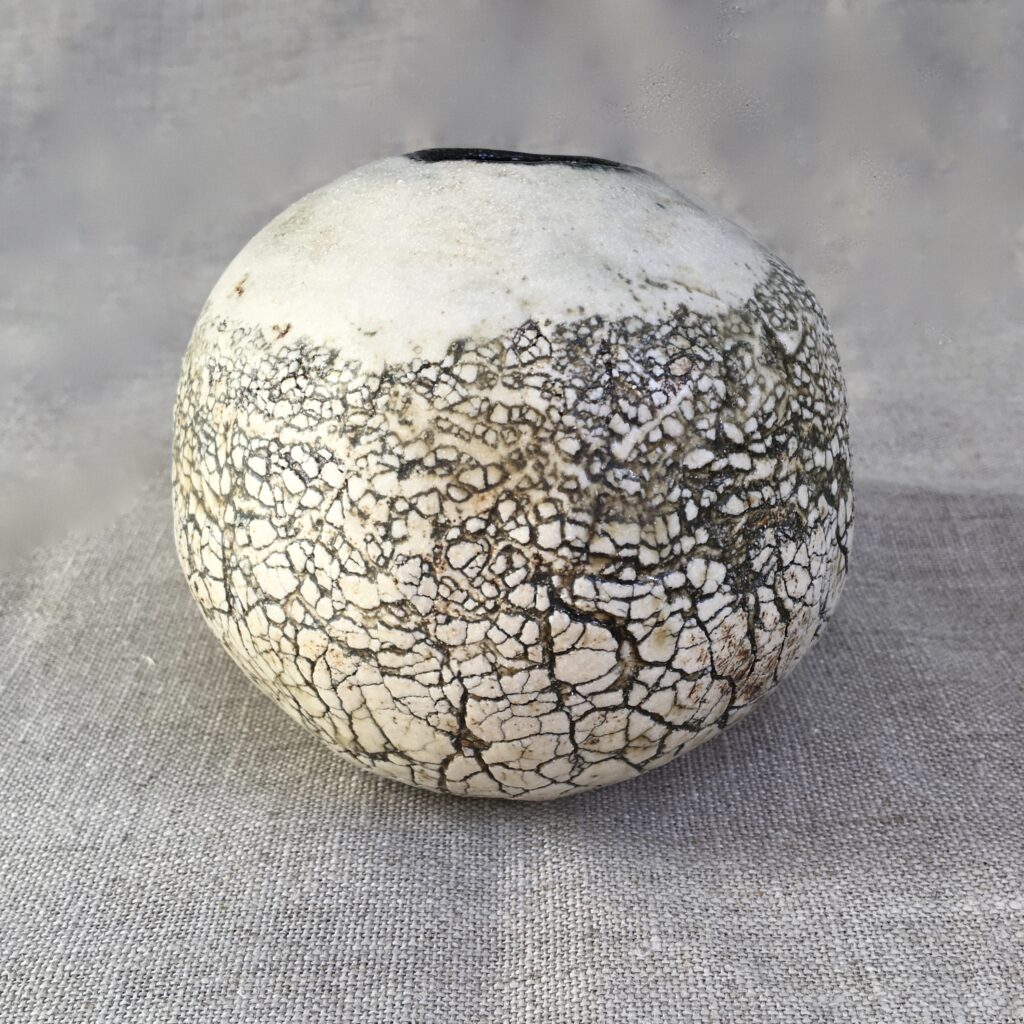
Cracked Pot
I’m exploring the materiality of clay and the different processes at my disposal. The cracked surface contrast with smoothed tops. Sometimes I create texture on the underside of a form, there to be discovered.
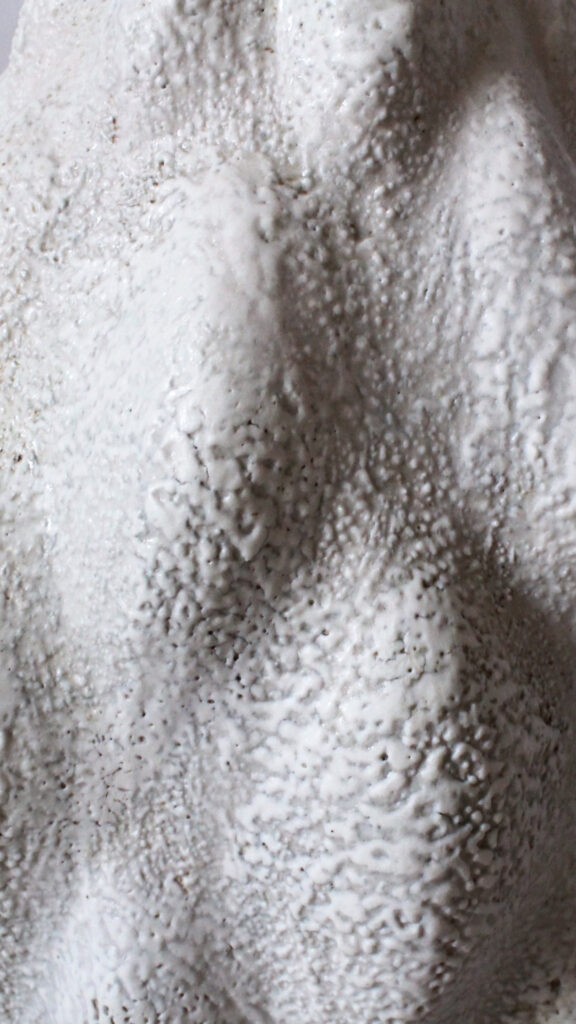
Bud, detail
A bud vessel is layered with different glazes that react and form a metallic, smooth satin glaze.
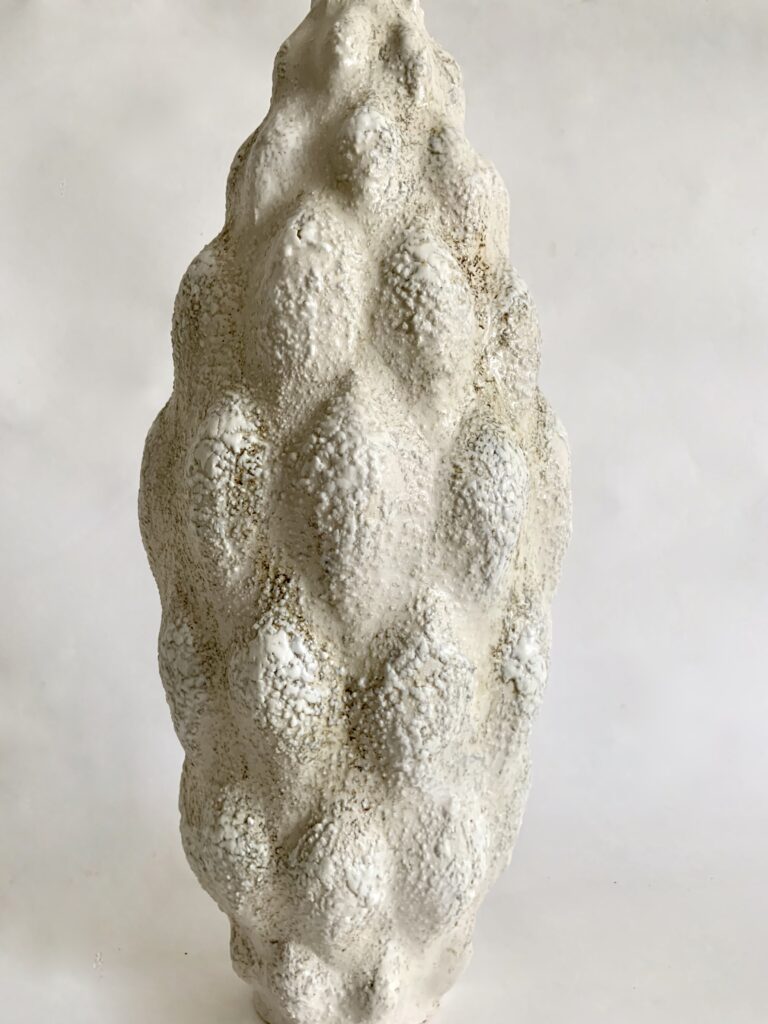
Ovoid Bud
This Loop vessel is more structural and so a strong cobalt and nickel matt glaze emphasises the architectural characteristics.
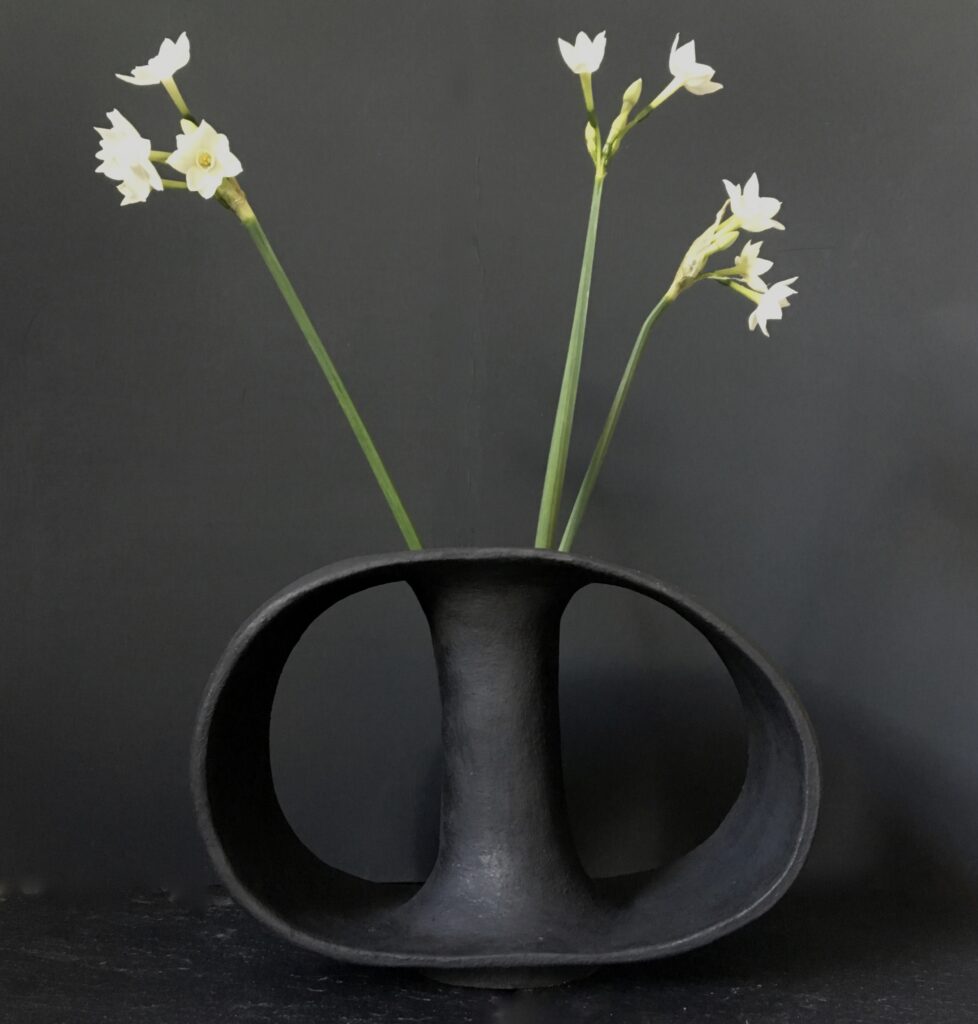
Black Looped vessel
Fjord vessel uses all my known applications and is rich in texture. The shape is a simple oval but within the surface there is a lot going on.
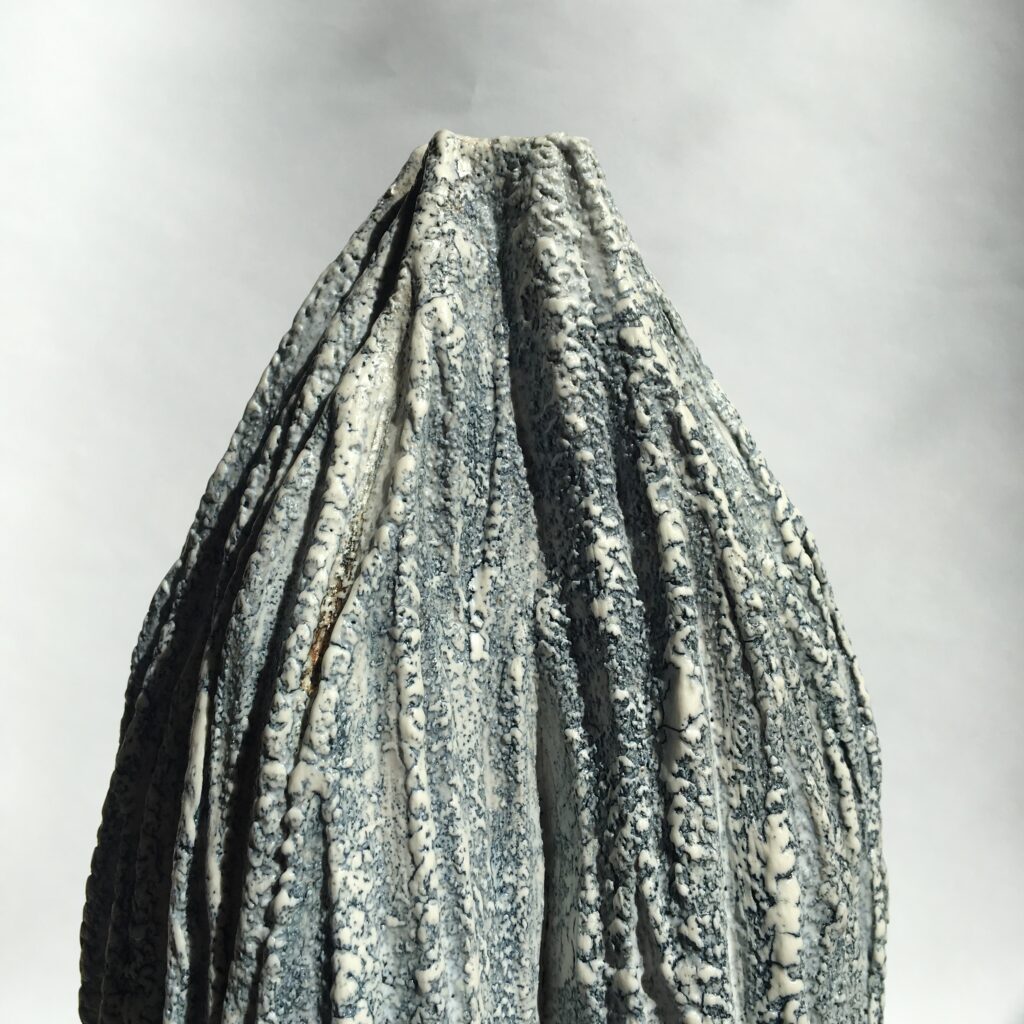
Fjord vessel, detail
As the title suggests, I was thinking of mountains with frozen and eroded surfaces.
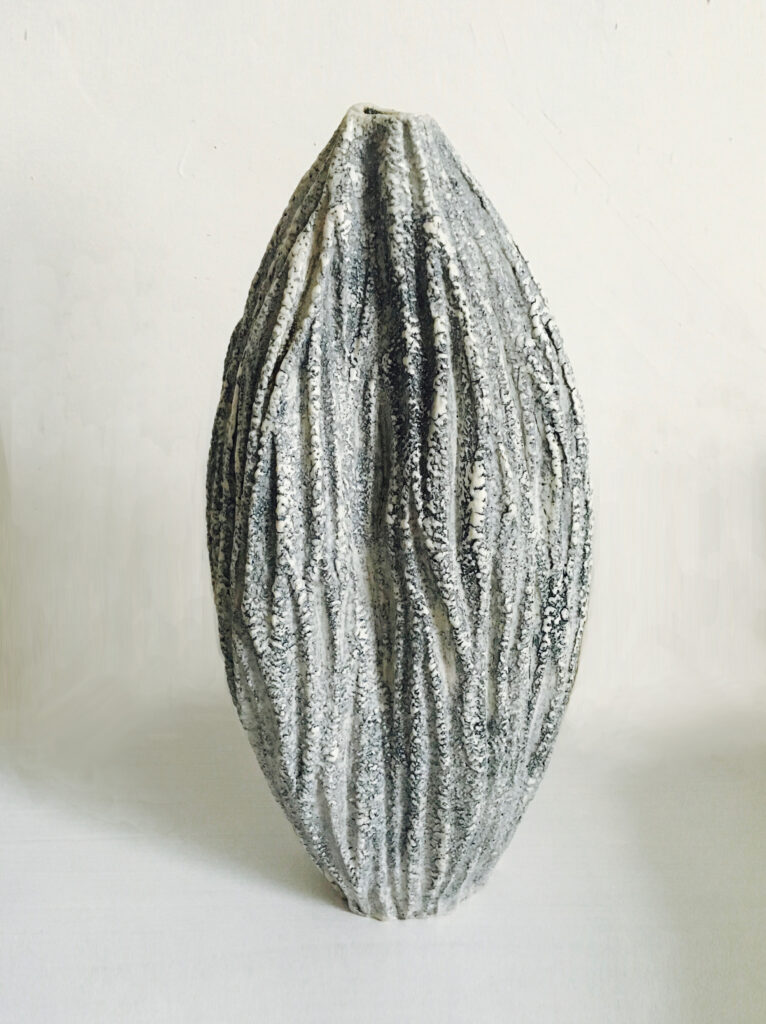 Fjord vase
Fjord vase
Discuss your involvement with V&A and Refugee week. Refugee Week happens in June.
It’s an opportunity for people to share their experiences with each other and the public. The ceramics department of the V & A is huge and holds extraordinary collections from around the world so it was very fitting to hold our bird making workshops there. If you go onto the website www.flockproject.co.uk you can see images and videos of the event.
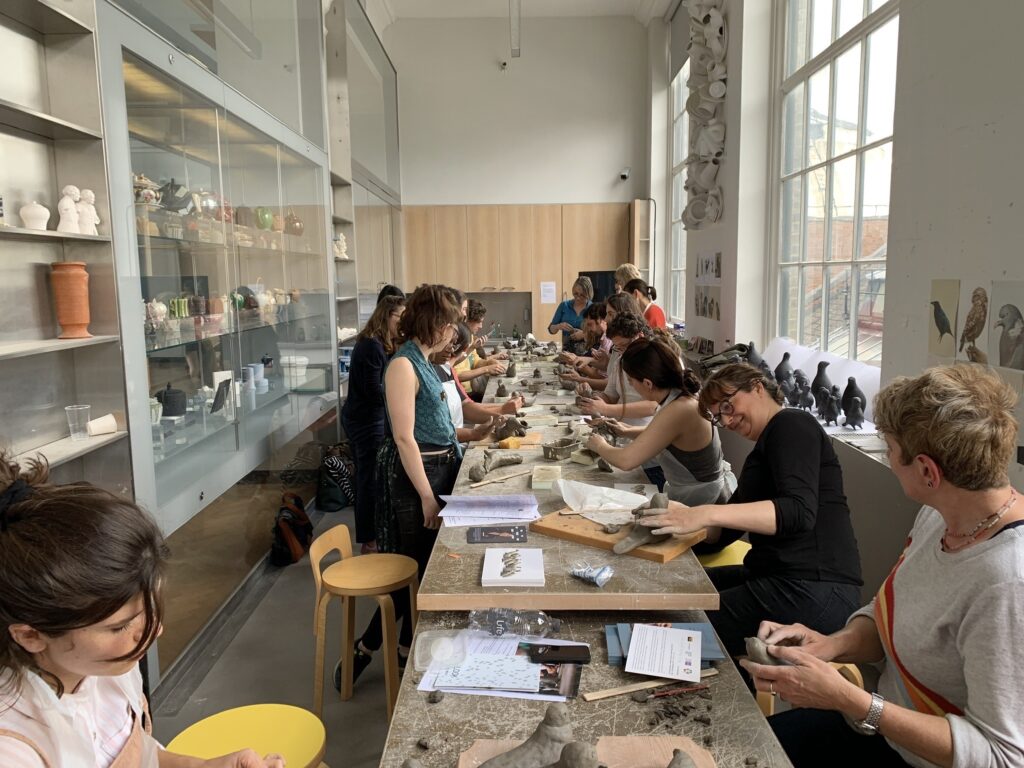
V & A Flock workshop
What do you have planned for the rest of 2020 and 2020?
I’m lucky to be able to work, in isolation, at my studio, and have had a very busy year so far. I’m working on a short film of Flock Project and plans for a museum display integrating natural history exhibits. I’m continuing with the inspiring galleries and shops who support my independent way of working and the relationships that I’ve built with them are vital. Output is important and communicating to people, outside of my studio, through my work, is what it is all about.
Contact:
Julie Nelson
Deborah Blakeley, Melbourne, Australia
Interview by Deborah Blakeley, September 2020
Julia Levander Drew
Can you expand on the terminology of fake taxidermy – fauxidermy?
It was a good word to use in the beginning when I was mostly doing quirky and colourful wall mounted deer and Highland coos. As my work has developed however, I feel it may not be the best word to describe them as I’m trying to tell more of a story with the characters now. I’m not sure how to describe them best, “Textile Sculptures” I guess but it sounds a bit dry.
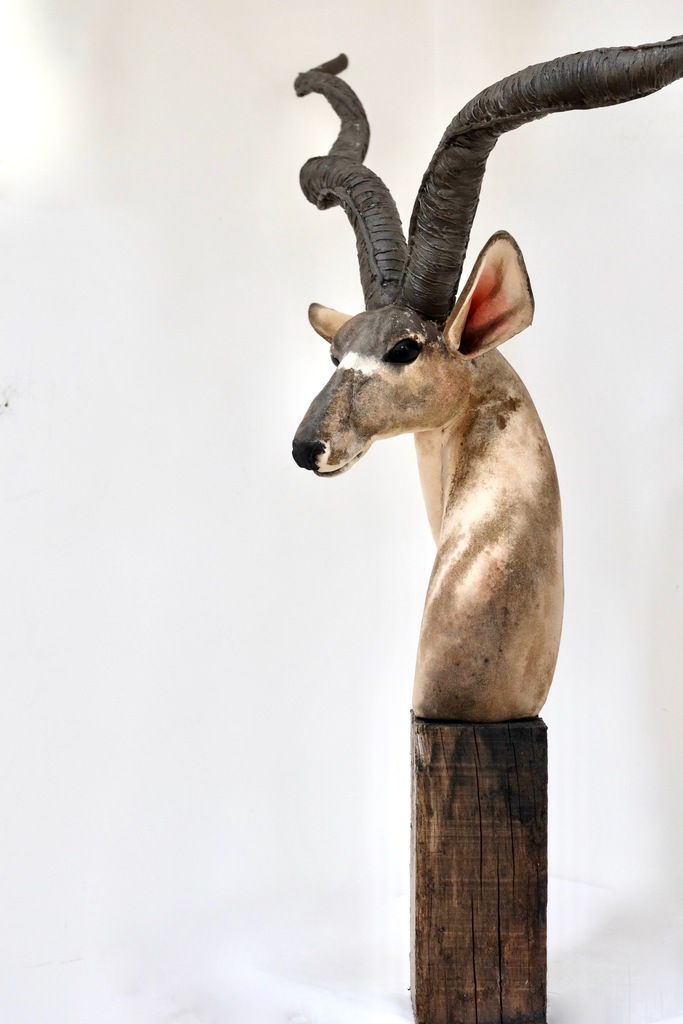
How has your knowledge in costume design, make and develop your fauxidermy?
Costume design and clothes making was a great introduction to sewing and I was also using that skill in the years I made art dolls. After meeting my husband on a zebra crossing in Sydney, Australia and moving from Sweden to the wild Highlands of Scotland in 2004, I got in to art doll making and was creating those as a hobby for 6 years.
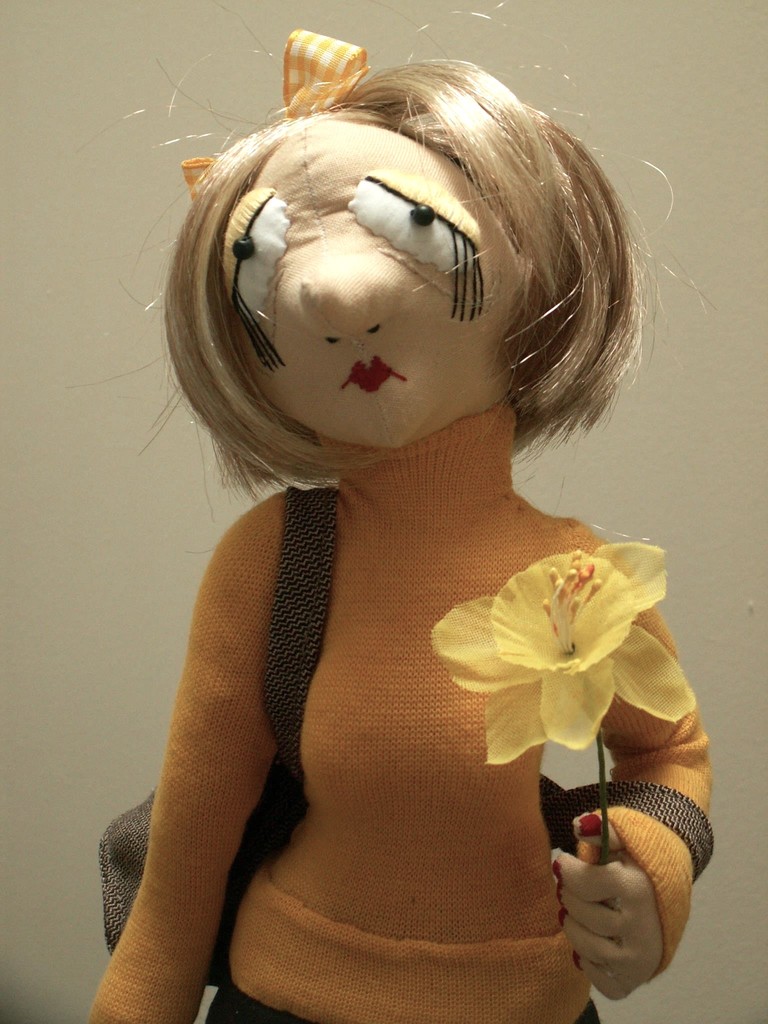
2010 I totally lost inspiration. It was quite upsetting for me as my well being is tied to my creativity and if I don’t create I feel restless and lost. Gardening and baking saw me through the two years I didn’t sew at all and it wasn’t until I had our first daughter that inspiration returned, and I developed my fauxidermy. I still have my first ever deer head, she’s called Elisabeth the 1st.
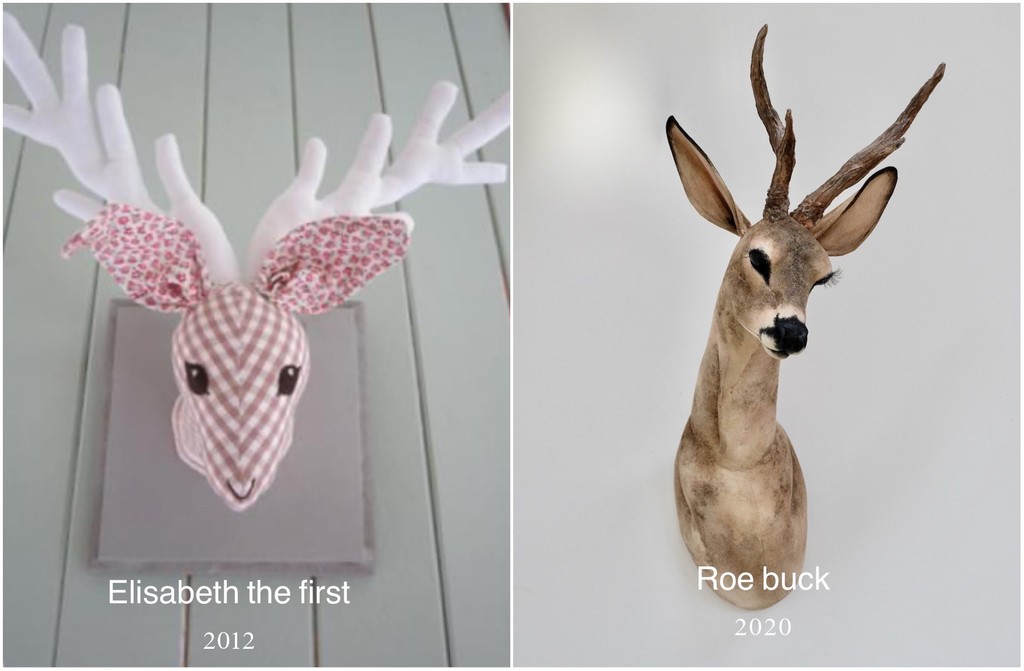
In retrospect I think the reason I lost my inspiration with the dolls was because I never let myself develop, the style of them stayed the same from the third (the first and second dolls were disasters) to the last and I felt trapped. With my animal sculptures I decided to never shy away from an idea and always try different things. My work mantra is “I make what I want”. Simple and effective and I think it has helped me develop.
Why are you reluctant to take on commissions?
This is tied to my inspiration. Inspiration is such a powerful force in my work and I have come to know better than to ignore it or work against it. If I am not inspired work grinds to a halt and nothing gets done, I sit at my desk and stare. When I’m inspired I can leap out of bed at 4:30am to get to work. I have learned this about myself and let myself make what inspires and due to my awesome followers on social media even the most “out there” pieces have found happy homes. I can be nudged in certain directions and every once in a while I’ll take on a commission but it needs to be something that excites me.
Which comes first the fabric or the animals?
In the beginning, when I was working with an array of fabrics I’d say it was the fabric combinations that came first. I loved to pick out juicy combos and then work out who would suit it.
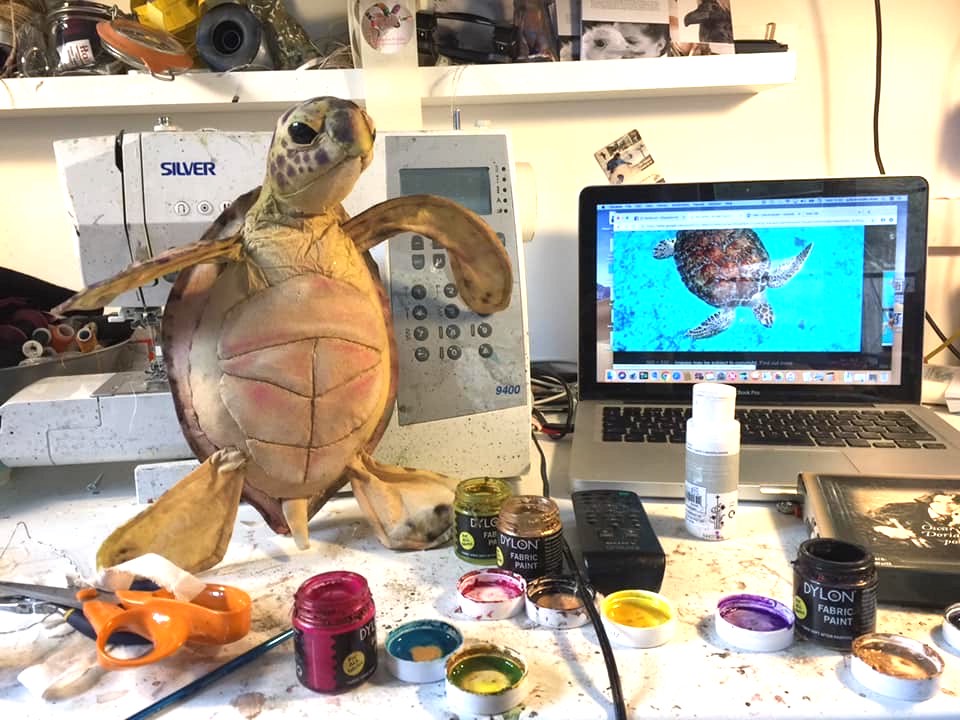
The past few years I have more and more turned to unbleached cotton that I sculpt and then paint with textile and acrylic paints so now it’s the animals that comes first. Or an emotion, or a position, or a relationship… or something else.
You comment, ‘I create my animals freehand’ briefly discuss the process you take to make a single animal?
I am self taught and have had to work out my process, what suits me and what works. In the beginning I was actually embarrassed that I never use patterns, I thought it seemed lazy to not create patterns for each piece but now I am confident enough to be free of that. I have the fabric in my lap and cut without pattern or drawings. My husband would say that I cut in my lap because my desk is too messy and he does have a point. But it works for me. I get an idea in my head and it’s a bit like being possessed, the piece needs to come out before I can move on. I have tried to ignore the crazier pieces for something more “sale able” but I just can’t get past it so it’s quicker to just make it. A bit like exorcism. When I have cut it out, I sew it on my sewing machine, his name is Maximus, and stuff the parts with synthetic stuffing.
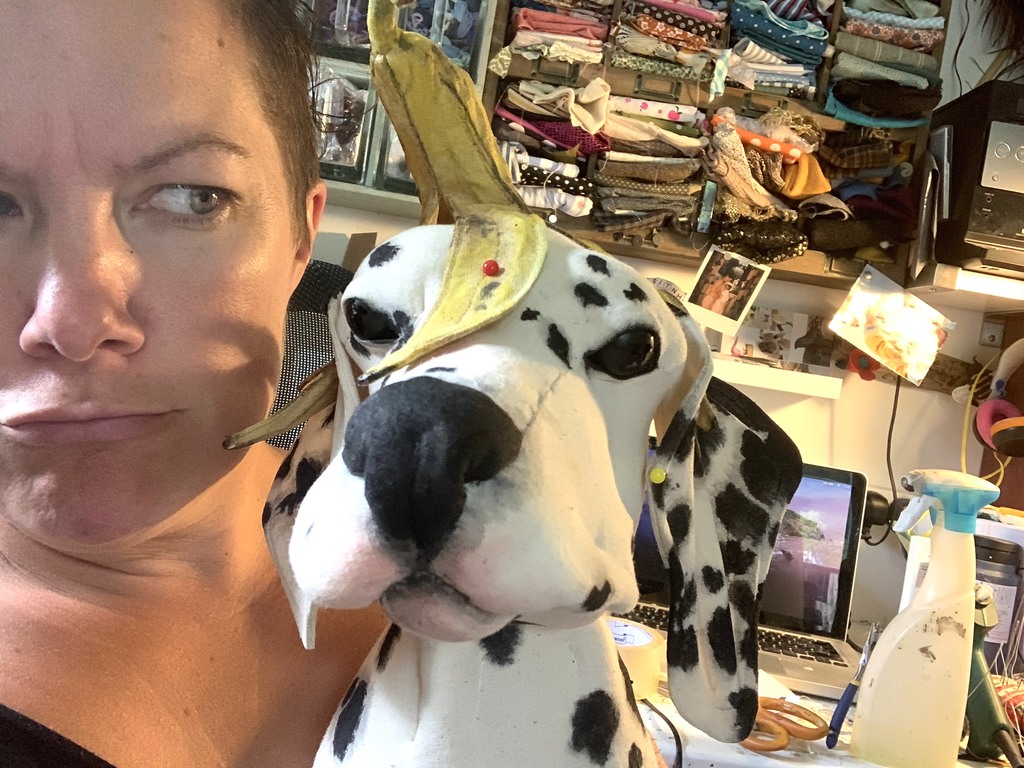
I would love to find a biodegradable substitute but have not managed yet. I then use this base to sculpt the features by pinching in and adding bumps and eyes. I use mostly glass eyes and sometimes I cast them myself in resin and paint them. When the features are where I want them I add a skin layer, trying to focus on wrinkles and the overall expression. All this is stitched by hand. I use wire for ears and limbs to be able to position them slightly and add structure. When the piece is sculpted, I paint it.
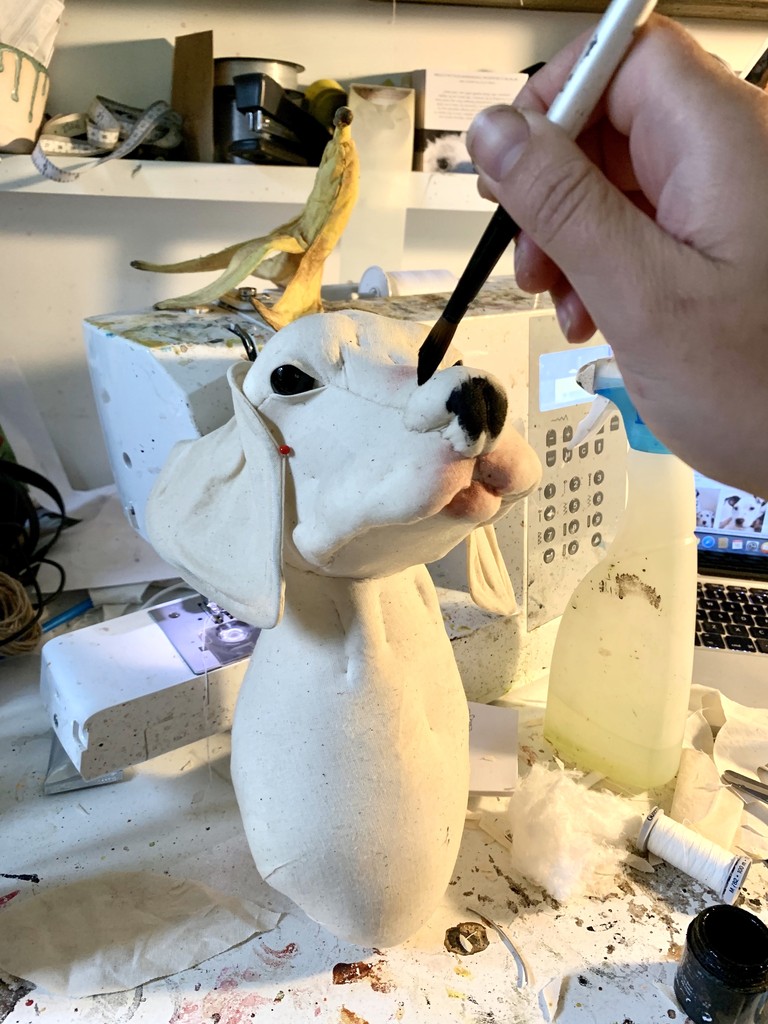
This is quite a scary stage, especially if it is a large piece that has taken a long time to sculpt. I paint them with several watery layers and let it dry between each layer to build up depth. I like when the paint create a pattern on the fabric, a bit like a glaze or a watercolour painting. I finish by adding things like eye lashes and usually sit them on pieces of rough wood or driftwood as the contrast between the fabric and the wood works well. I always have between 10-15 sculptures on the go at any time, that way I can work on what I feel like, be it sewing, painting or finishing.
Do you see your work as therapeutic and if so why?
Not therapeutic, I’d say it’s necessary for my well being. I don’t know if it’s the fact that I don’t make sketches, I just have the ideas in my head until I make them and, I tell you, it gets crowded in there.
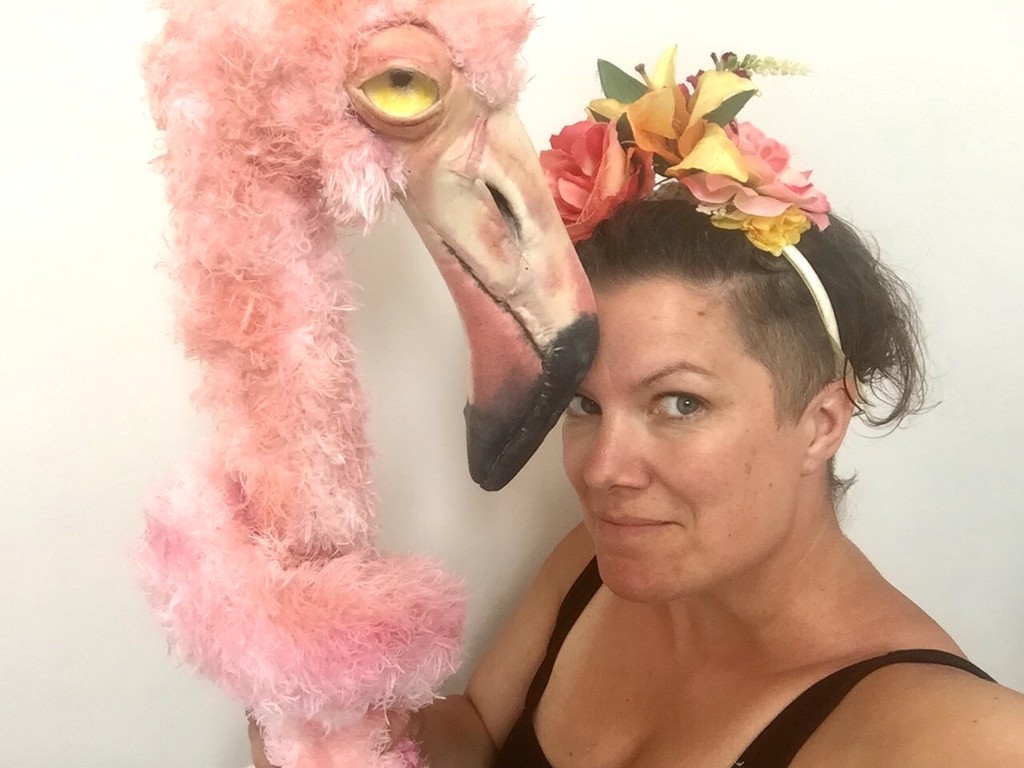
Take one or two pieces that are ‘very’ whimsical – discuss.
Is it the facial features?
Lately I have developed a bit of an obsession with adding things to the heads of my characters and I love contrasts so for example I made a toad with bunny ears. His angry face and drooping fag contrasted so well with his cute bunny ear headband and fluffy tail. I can imagine the profanities he’d like to shout at me, it makes me smile and sometimes that’s enough.
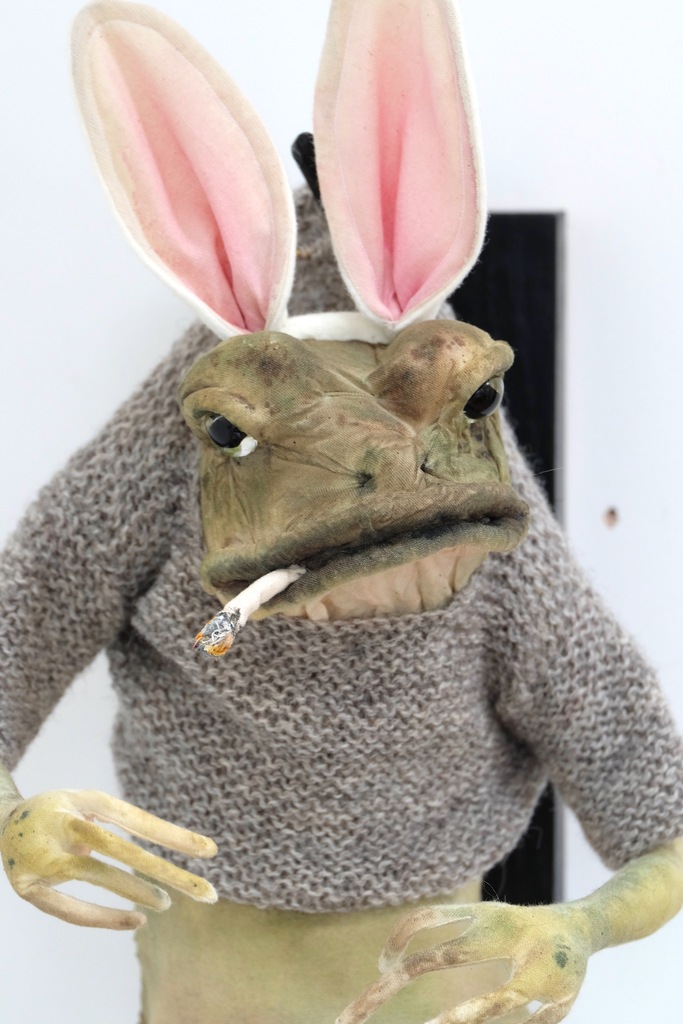
Is it the pose?
I also made a hare sculpture sitting on a heavy piece of wood and here it’s definitely the pose that makes the piece. He looks slightly tipsy, like he’s telling a long story about something only he thinks is funny.
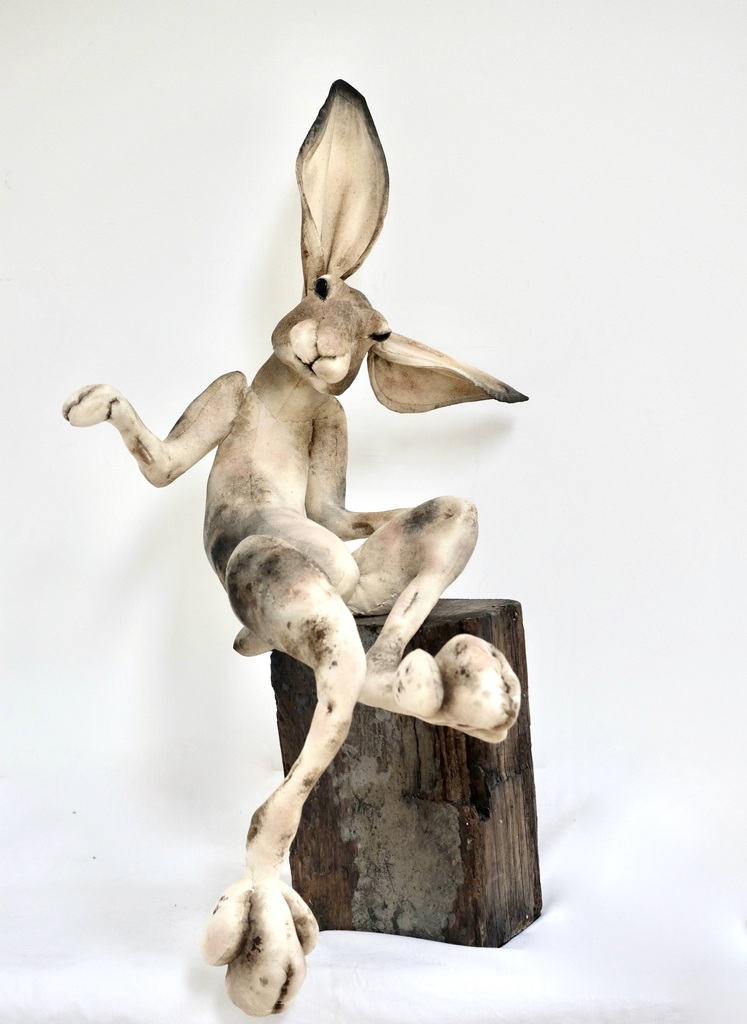
Take your ‘Hanging by a Thread’ series.
How did this project come about?
Like many others, I suffer from environmental anxiety and the total sense of powerlessness can keep me awake at night. I needed to feel like I did something, contributed however small. I had made a couple of pieces hung up by their jumpers and was contacted by one of my followers that told me how uneasy they made her feel. She was asking me to stop making them but her comment made me interested to take it further. If one piece made her uncomfortable, perhaps a whole alphabet would be an effective way to shine some light on the threats to so many of our wildlife.
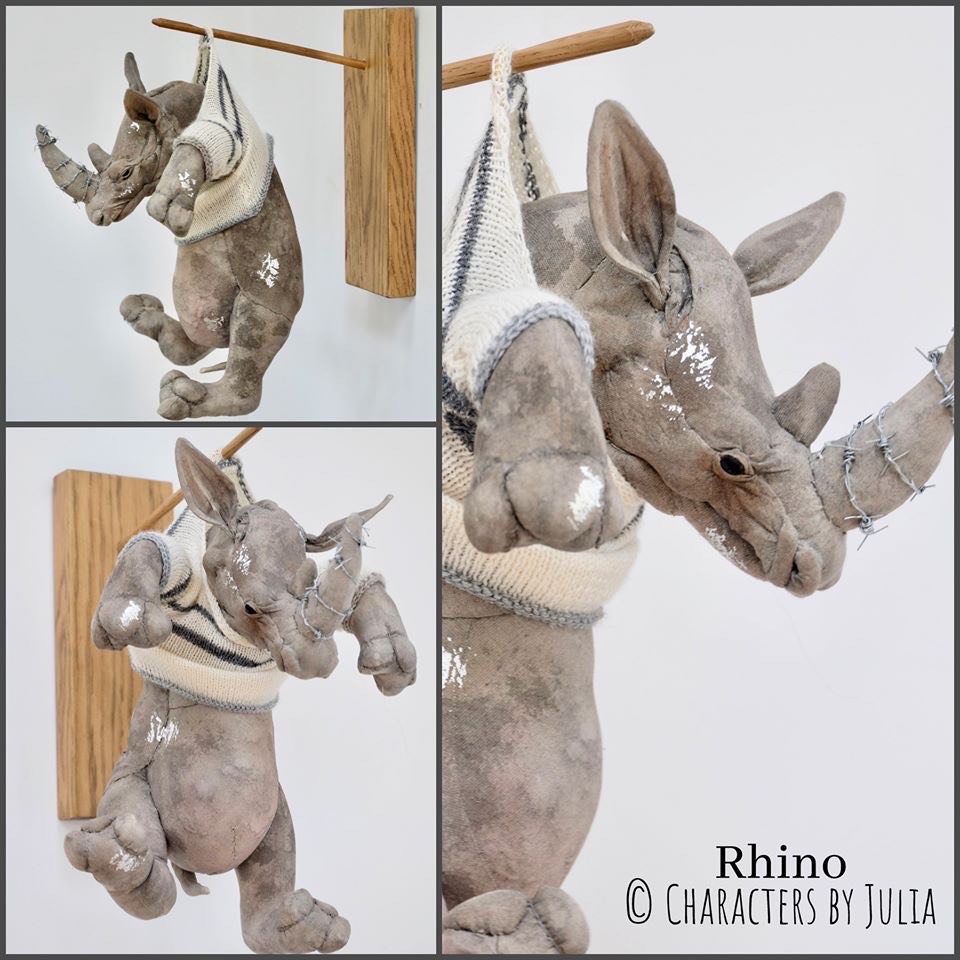
My goal was to make one textile sculpture for each letter of the alphabet depicting unusual, vulnerable and endangered species and also highlight some of the threats excessive packaging used in supermarkets, global warming, commercial fishing etc. That’s how the idea came about and I started thinking and researching what animals I wanted to highlight.I decided to do it as a sponsored challenge in aid of WWF UK so I set up a JustGiving page and people could donate the same way some people get sponsored to climb a mountain or run a marathon. I also set a target for donations and if I reached that target I would raffle out a commission piece at the end of the challenge and your donation would act as a raffle ticket. In the end we donated over £5000.00 which was great.
Why have you dressed the animals?
It was the animals hanging by their jumpers that started everything, they looked so vulnerable and in need of assistance, at our mercy. Just like our planet is, and we are anything but kind to her. It also helped to use the clothes as a way to highlight different issues, like the Walrus hanging by a tropical shirt.
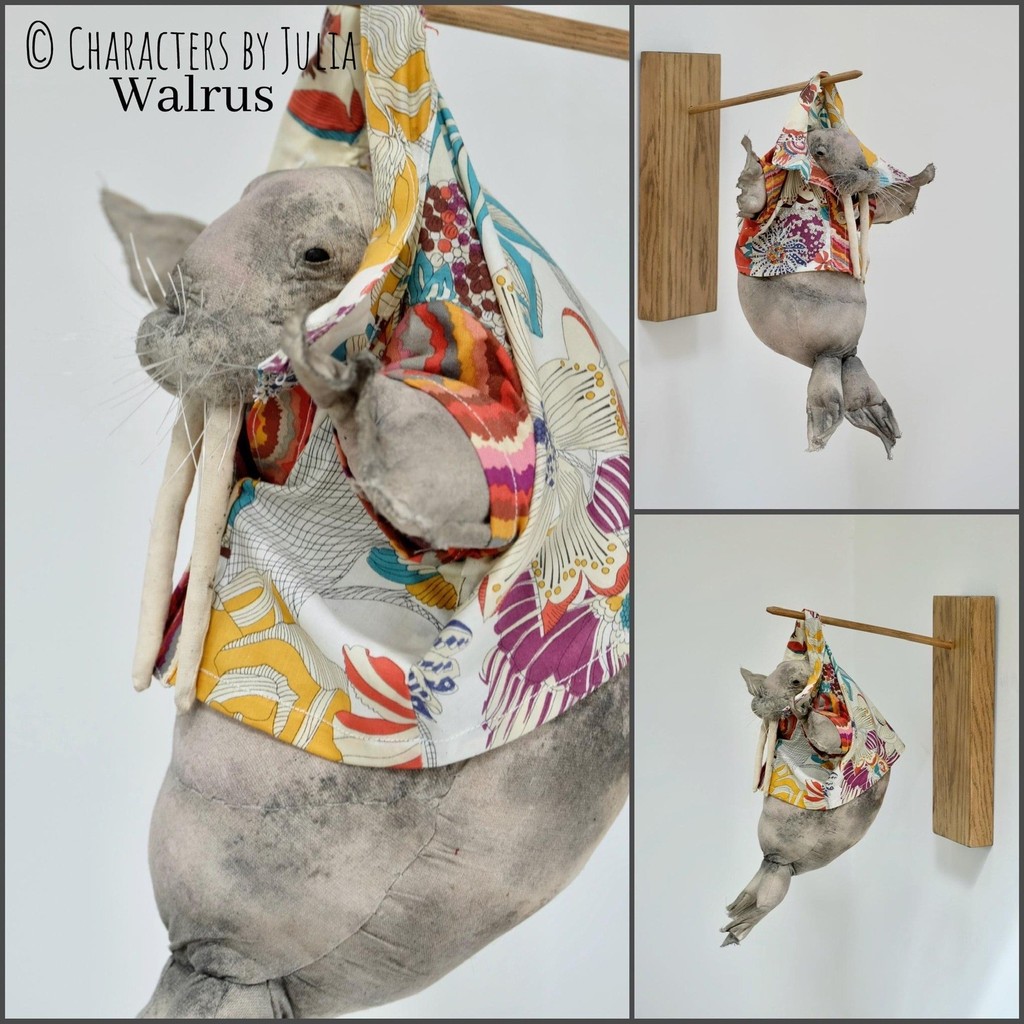
Global warming and melting ice is a huge problem for walrus. The Jaguar hung by a faux fur coat to highlight not only the fur trade but all the endangered animals that are hunted for pelts, scales, glands, fins, shells etc.
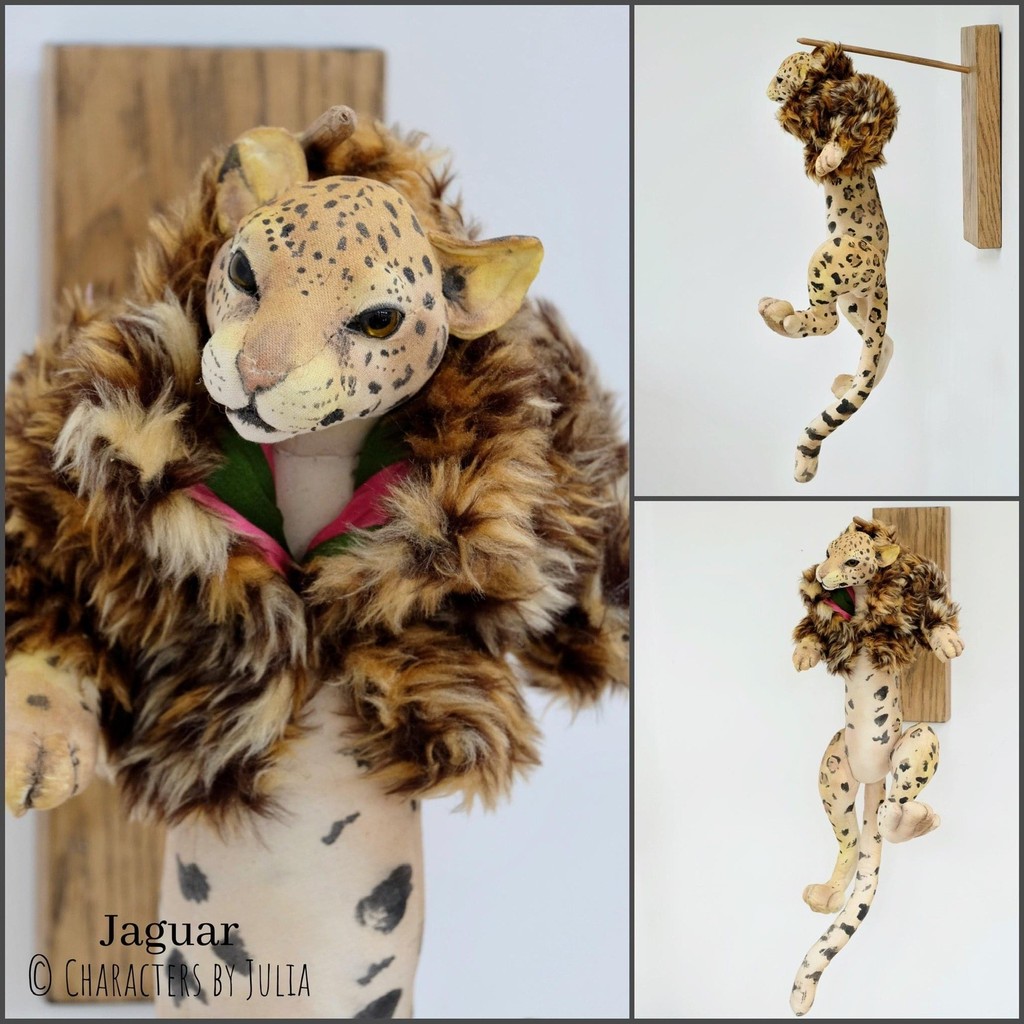
One of my followers suggested the name “Hanging by a Thread” and that was just perfect for the collection. My mum is my knitting collaborator, and she created a stunning array of beautiful jumpers that they could hang from. The journey to make them all was amazing; challenging, exhausting, emotional, often sad but also thrilling and I felt so much support during the whole experience.
Did it help to use the alphabet as a tool?
It certainly helped to bring the collection together and give structure. I needed a beginning and an end or goodness know where it would have ended up.

What was the biggest challenge when making such a large body of work?
It was a real challenge to find different ways to depict the different issues. To be varied and still keep a theme. I painted a Commercial Trawler tattoo on the Hammerhead shark and hung the Vaquita from a plastic net used as fruit packaging. The issues are endless. The Xenarthra (sloth) is climbing through denim to point to the unsustainable and heavily polluting fashion industry.
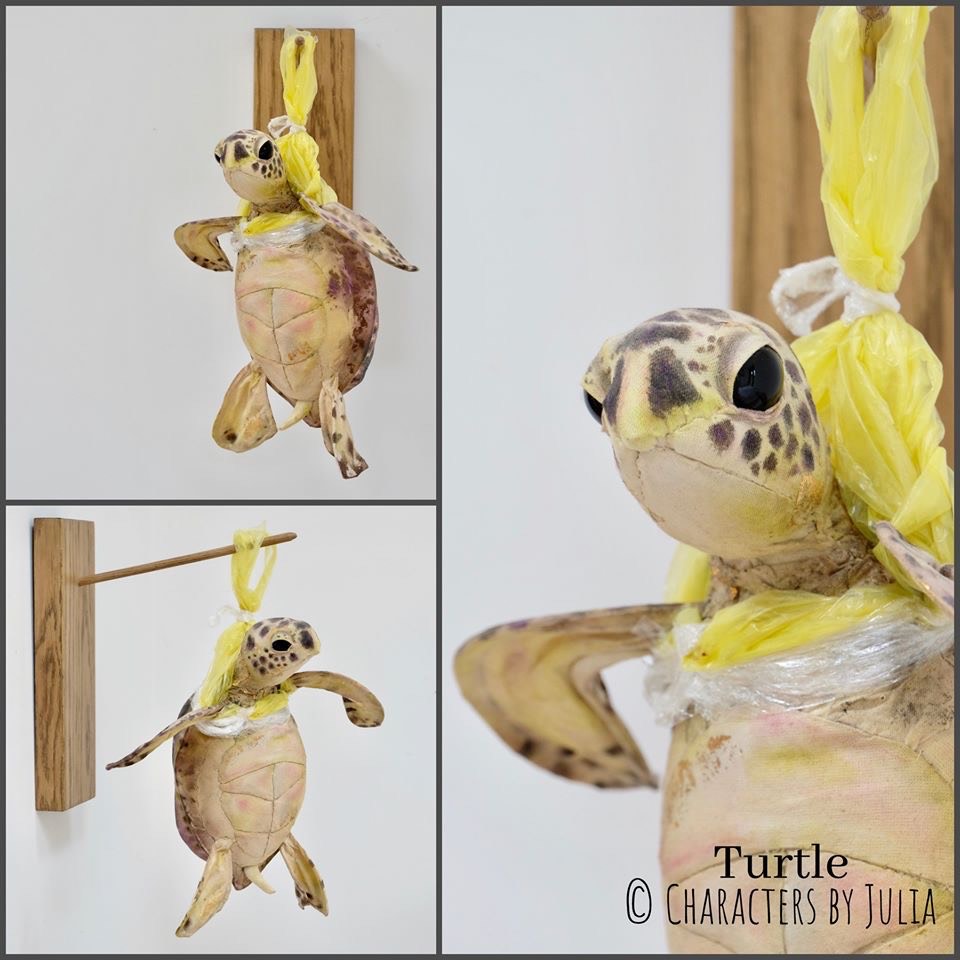
The Turtle also hung by plastic as our seas are so full of the stuff and the stripes of the Zebra disappearing as a symbol that we are running out of time.
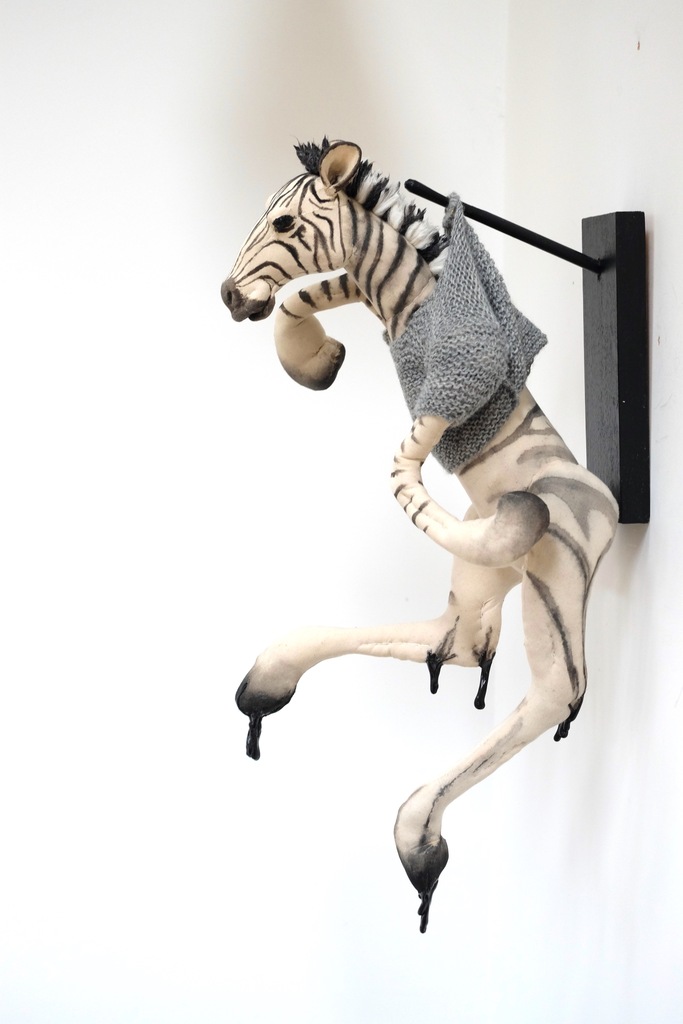
You did not work through the project alphabetically. Which two animals came first and which last, and why this selection?
Again, I let inspiration be the deciding factor. I had a list of the alphabet with options for each letter. I tried to get a good selection of different animals, locations and issues and made what inspired. I did actually start with Aardvark but then jumped to Orangutan and ended with Quokka
Why did you restrict the size range of 30 cms to 85cms?
I didn’t restrict it, it’s just what happened. Cutting free hand makes them all different and I go up and down in size, I must have been especially excited about the Uakari as he ended up so much bigger than the others, he was also one of my personal favourites. I always listen to audio books when I work and I was listening to His Dark Materials trilogy by Philip Pullman and it felt like I was making my daemon.
Have they been together and where and where have some gone to?
My aim was always to find a venue for them and display them as a group. Ideally I would have liked to be able to raise more awareness and funds perhaps auctioning them off and I was gearing up to start contacting organisations. Putting myself out there is not my strength. WWF UK was in touch and very supportive during the process of their making but they didn’t have any venue suitable for them. It was starting to feel like a pressure. I was also stressing because we are due to move to smaller accommodations awaiting to build our house on a croft that we are making into a small holding. The thought of them all in storage in the humid Scottish air was not good. When Covid 19 hit and lockdown was a fact I let myself off the hook and decided to find them homes individually. I was delighted when they all found loving homes in record time. It’s a shame they were never able to be displayed as a group but sometimes you just need to move forward.
Tell us about the Spring Salon ‘Vårsalongen’ in Stockholm and your entry in 2019.
Since I was about 15 I dreamed about having a piece represented at Vårsalongen. It is such a dynamic venue where a group of judges (they change every year but are always distinguished in their fields) pick out pieces based on the pieces alone, not the artists age or CVs, just the piece. The mix is usually very inspiring and it’s a big yearly event in Stockholm, I think 2021 will mark the 100th exhibition. My contribution was “Monkey” a quite large monkey sculpture made to look like an old fashion pull toy with wooden wheels but if you look closely the wood has gone through the flesh of the monkey and he’s bleeding.
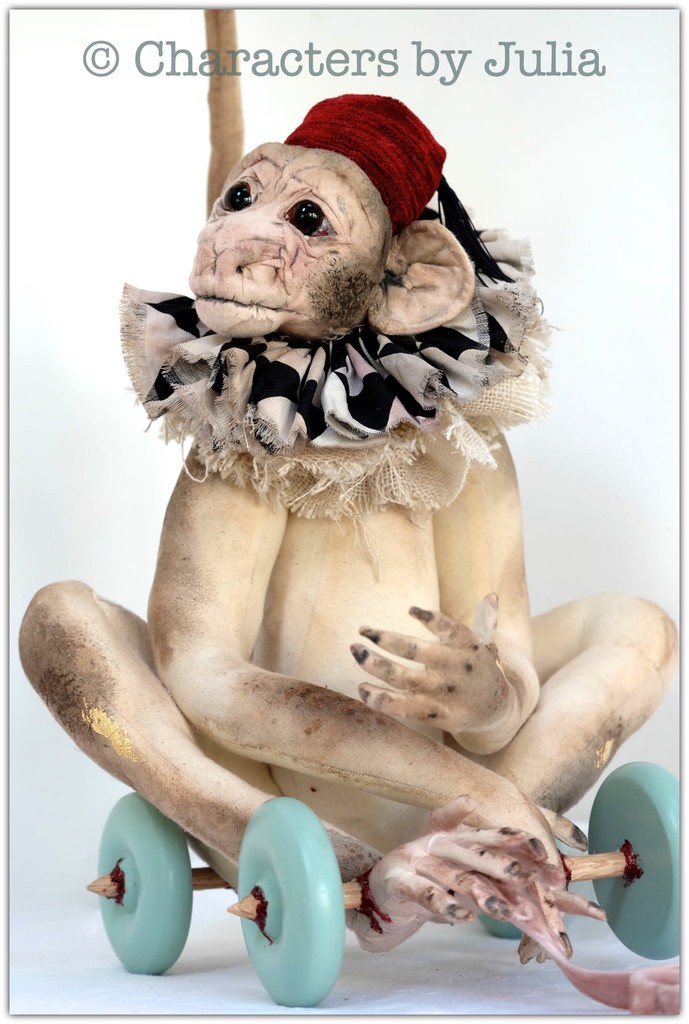
My hope is that he’ll make us think of the way we treat our wildlife and planet as a whole. I was so happy to be selected and travelled to Stockholm to be part of the opening in January. It was fantastic to meet some of the other artists and see the exhibition with my monkey included.
I love your hares, please comment on ‘Hare today – Gone Tomorrow’.
I love hares too, they’re my go-to animal.
I think it’s because I had a pet rabbit growing up and spent most days, watching her, sketching, painting and sculpting her. I got to know the features and body well.
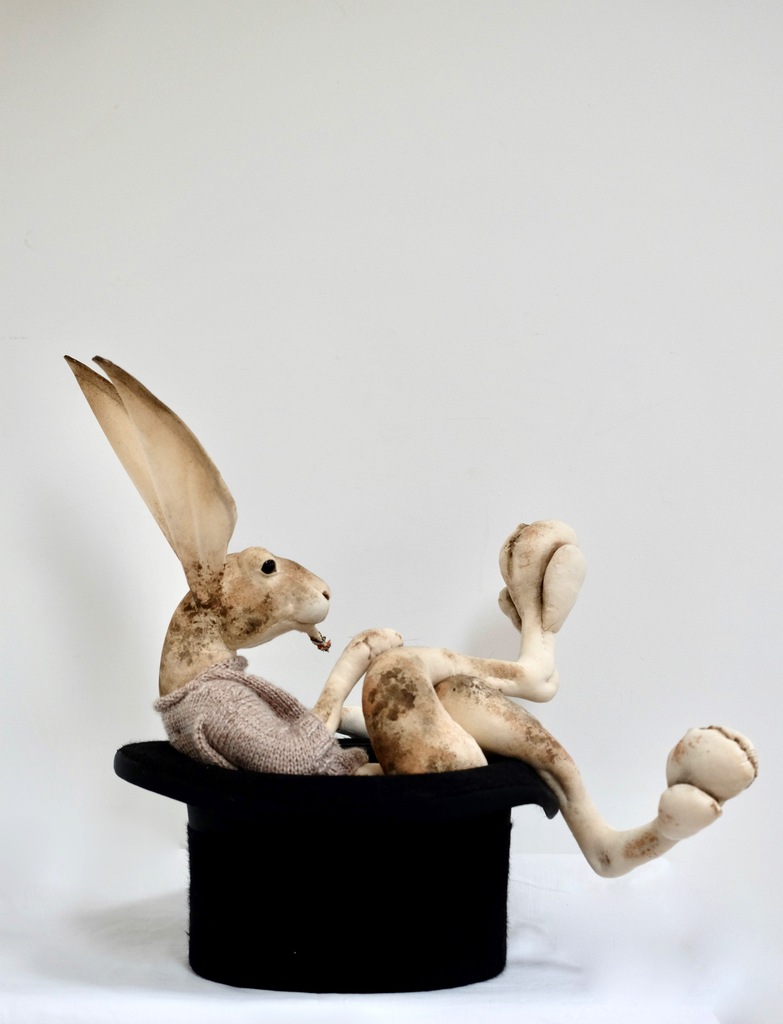
Although my hares usually sport larger than life feet, simply because I like big feet. I was approached by the fab owners of The Imaginarium in York, a shop where magic is real, and where I had displayed my pieces for a year or so. They asked if I would like to create 9 hare sculptures to be displayed in their window for Easter. Well, I was thrilled to oblige and the result was amazing, they did such a fab job displaying them.
You do not have a sale, rather an adoption, discuss.
I think it’s because they’re such characters and they invoke emotions, I know several people who speaks to their sculptures. Adoption is a nicer sentiment than sale. They’re re-homed and I miss every single piece but I’m also so humbled and so happy that I can make a living doing something I love so much. I have the best job in the world!
How do you use different ways to hang, hold and position your animals?
I love to make free standing sculptures but there is something about a wall sculpture that really changes the dynamic in a room. I am forever working out new ways to display them and to find the right narrative and movement. I usually have an idea but, as I’m starting to create, it can change direction totally. That is another reason I don’t take many commissions, the freedom to change my mind is important as that can take a piece to a new and unexpected place. I am starting to explore more emotions and facial expressions as my ability grows, it’s exciting.
You are currently dealing within a pandemic but also exhibition at Union Gallery. Can you give us some of the background to this exhibition and working with Alison Auldjo?
Alison contacted me after I had shared photos of the Monkey sculpture for Vårsalongen and she was so excited about my work. Union Gallery seemed like such a dynamic place and I felt it would be fantastic to have my pieces represented there. Delivery was postponed by Covid-19 but we kept in touch during lockdown and I was spurred on by Alisons energy and exuberance. She also very much left me free to decide what I wanted to make and it ended up being a mix of seven different pieces. Some slightly sad and thought provoking (I hope) and some a bit lighter. Originally I wanted to deliver the pieces in person so I could see the gallery and meet Alison but life gets in the way sometimes and in the end I had to send them. The response I got when they had been unwrapped I will always treasure and the fact that she immediately cleared the window and displayed them all there was amazing. I feel very lucky to have found such a great ambassador for my work.
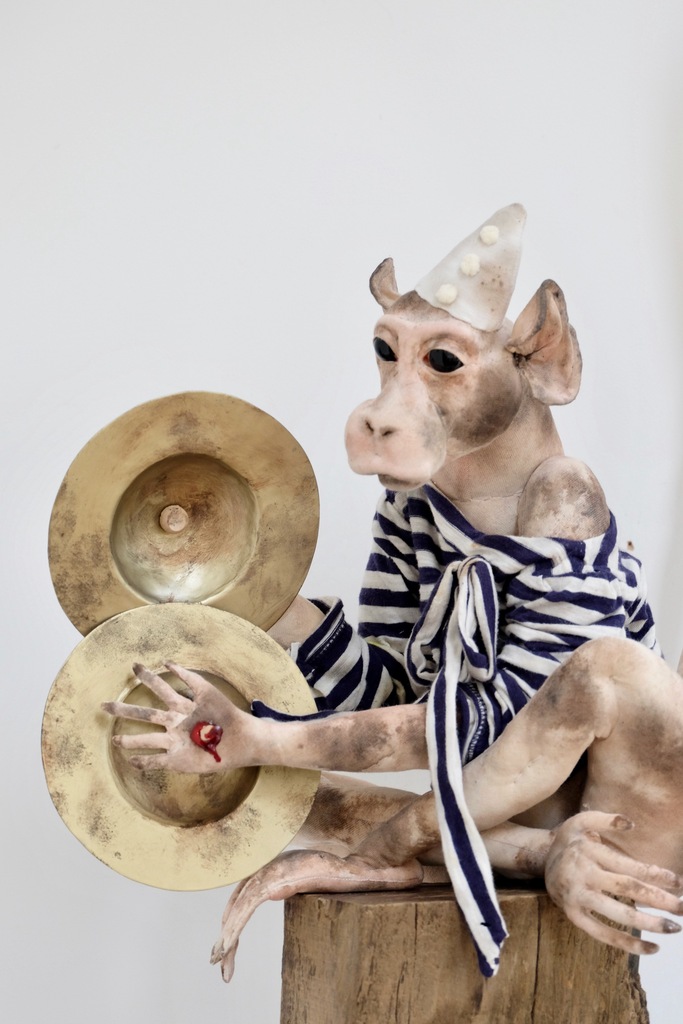
How are you coping with the lockdown and other new restrictions due to the pandemic in relations to your current work?
In the beginning the biggest challenge was the overwhelming anxiety and sadness for the people directly effected by the virus and their families. The anxiety and fear has been with me for many years though as this is how I feel about the global environmental crisis we’re in. So I try to manage it with family time and work. As I both live rurally and work from home the biggest physical difference during lockdown was to have the kids at home.
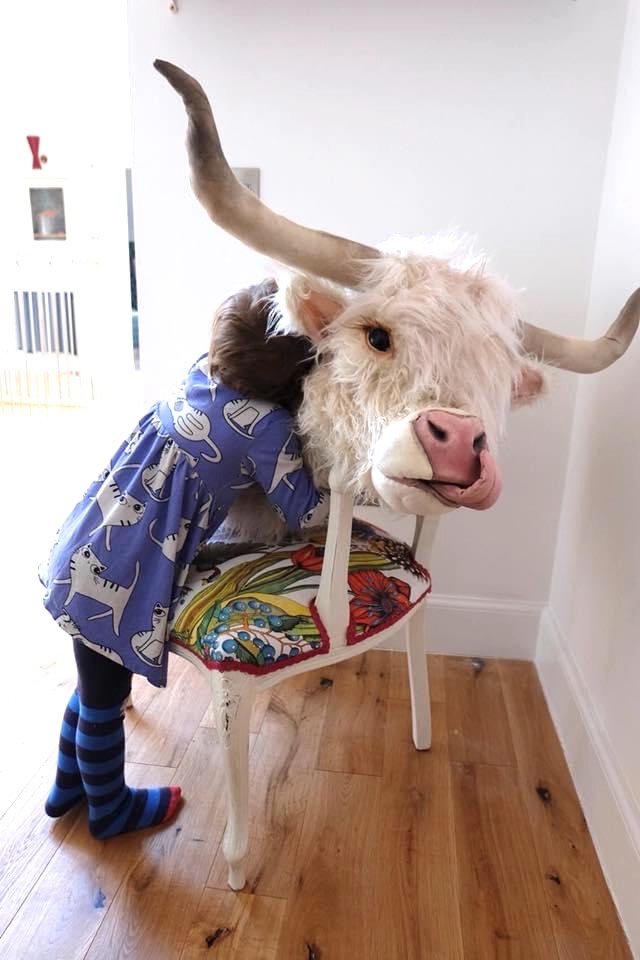
They’re eight and four and I share my messy studio with their playroom which works well as they can play or do crafts when I’m working. The only difficult thing is to get them to tidy their side when my side looks like a landslide. Of course there are also many interruptions but I’m quite used to that. At the beginning of lockdown I thought the first thing people would cut when things got uncertain would be textile sculptures but demand stayed steady so I could keep creating.
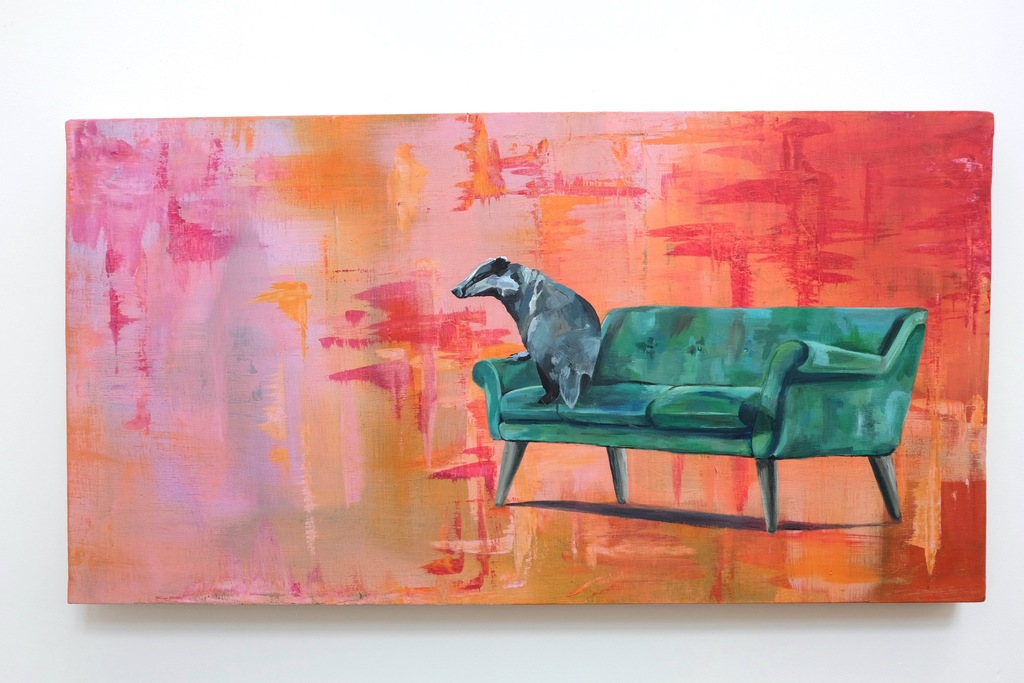
I also picked up painting again after a 15 year break. The urge had been growing inside me for a while and I made some large canvases and used paints I had at home, sometimes it can be freeing to not have unlimited choice. I hope I’ll keep painting.
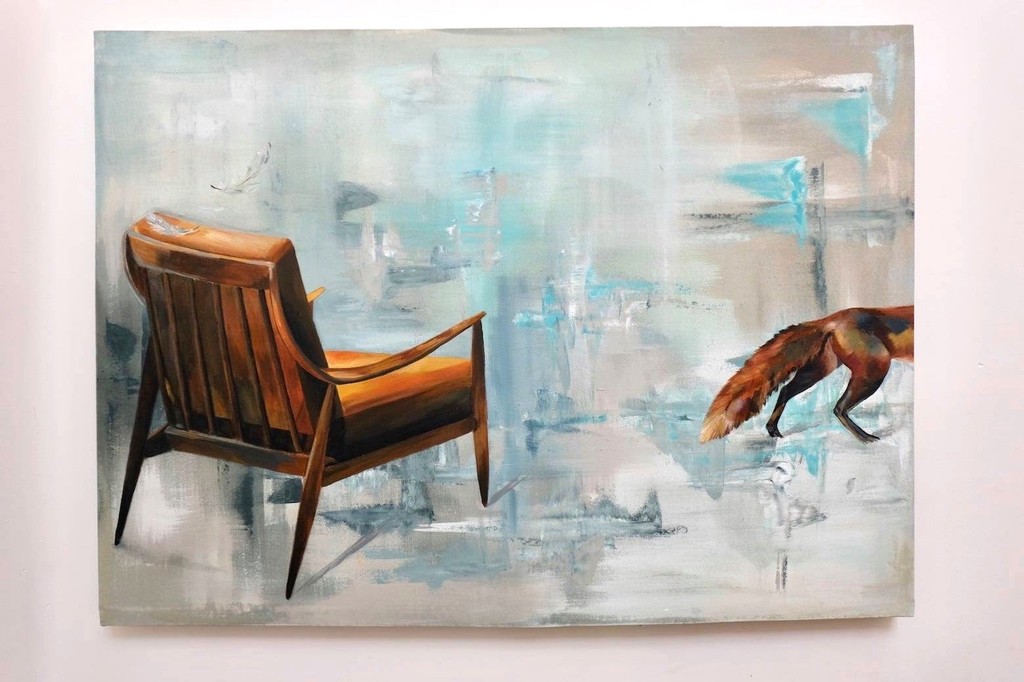
To finish off can you comment on your charity work and how you have been able though your sculptures to help support financially with your art. Please give us insight into two that I am aware of.
Jane Goodall, to celebrate Jane’s 85th Birthday.
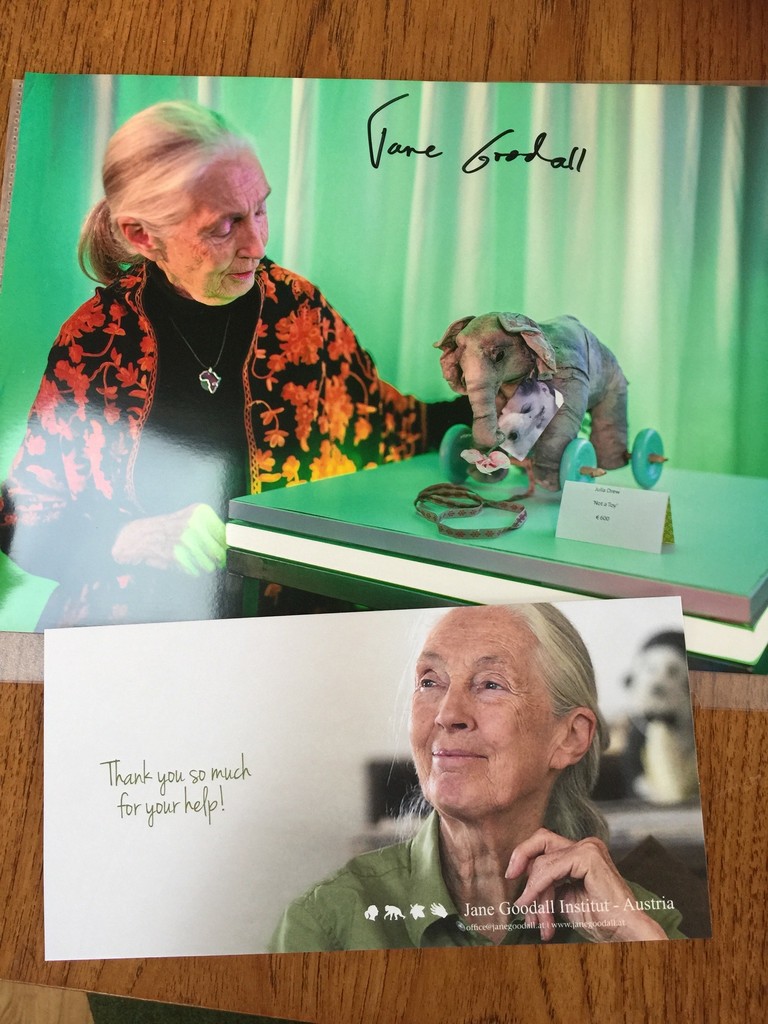 I follow the work of an array of artists on social media and I have become online friends with a couple. It’s amazing to never have met in person but still be able to discuss art and support each other online. One of these is the super talented Janine Heschl who creates mind blowingly realistic thread paintings of animals. It was through her I heard about the charity auction and I entered a sculpture of an elephant.
I follow the work of an array of artists on social media and I have become online friends with a couple. It’s amazing to never have met in person but still be able to discuss art and support each other online. One of these is the super talented Janine Heschl who creates mind blowingly realistic thread paintings of animals. It was through her I heard about the charity auction and I entered a sculpture of an elephant.
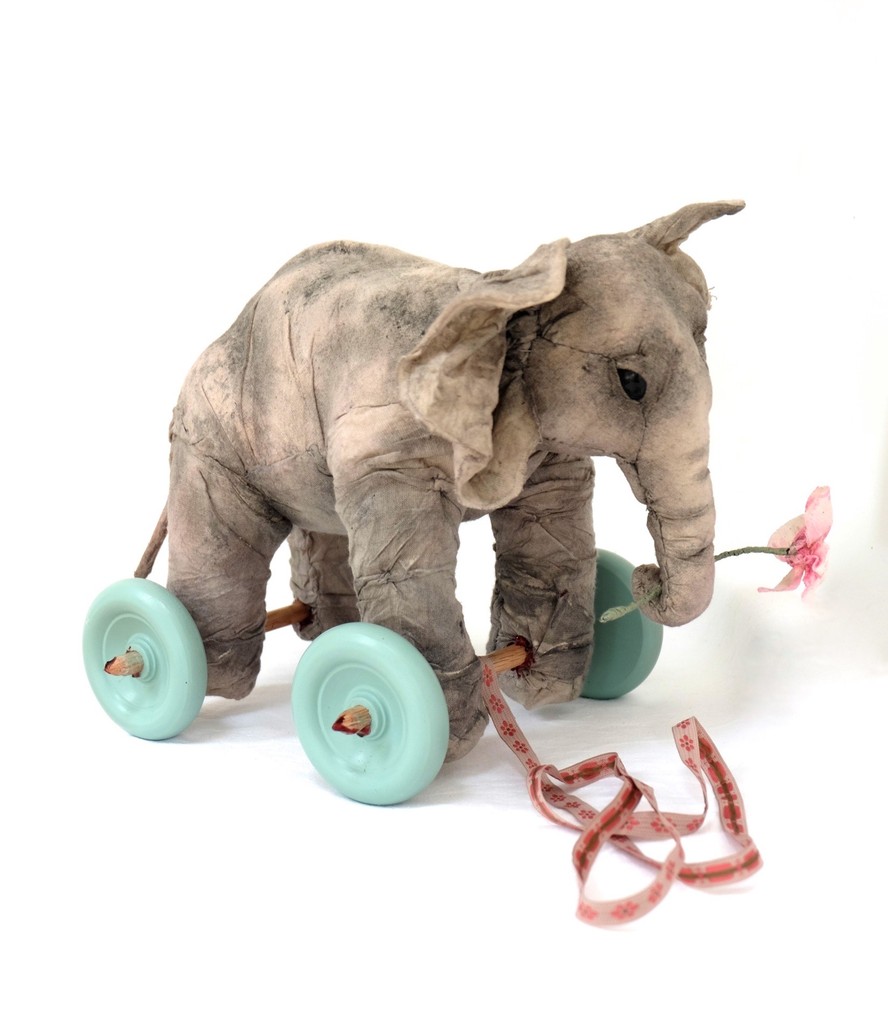
This was the first wounded pull toy I ever made and I was delighted when she was accepted to be part of the charity auction. Dr Jane Goodall’s work is so inspiring, her life a lesson in compassion and I wish we could all take a leaf out of her book. The future of our planet would be better for it.
The Australian Bushfire Relief in 2020
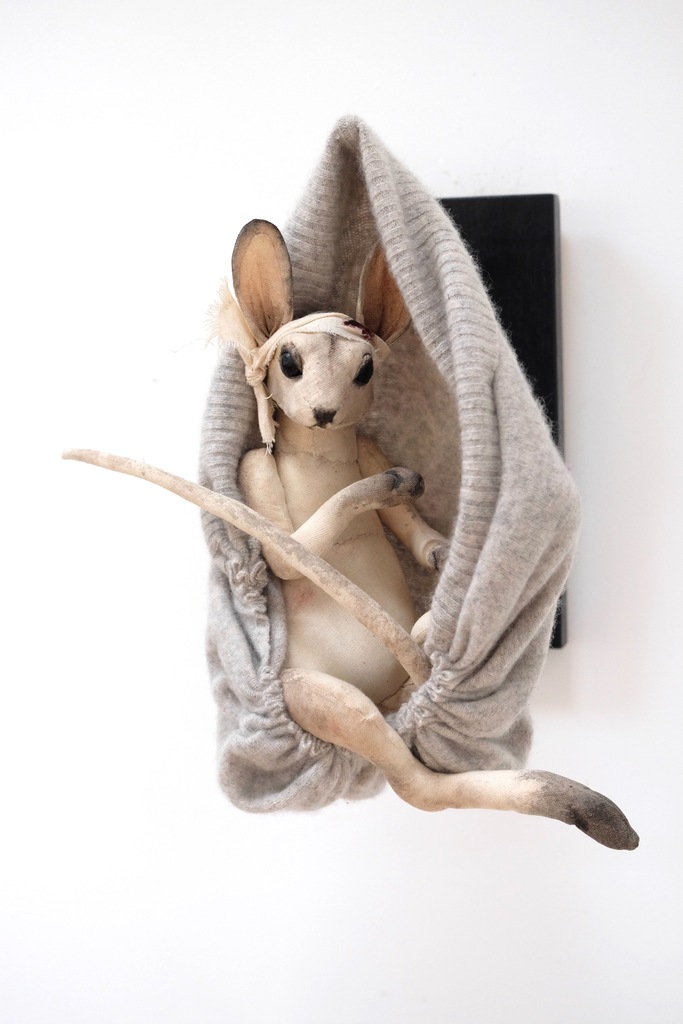
The distressing news of the Australian bush fires at the beginning of the year were so awful that, even from the other side of the world, I had to try to help a little. I created a little wounded kangaroo Joey and created a raffle where donations were made straight to an animal sanctuary on Kangaroo Island. It was a raffle built on solidarity and trust and I was blown away by the generosity shown.
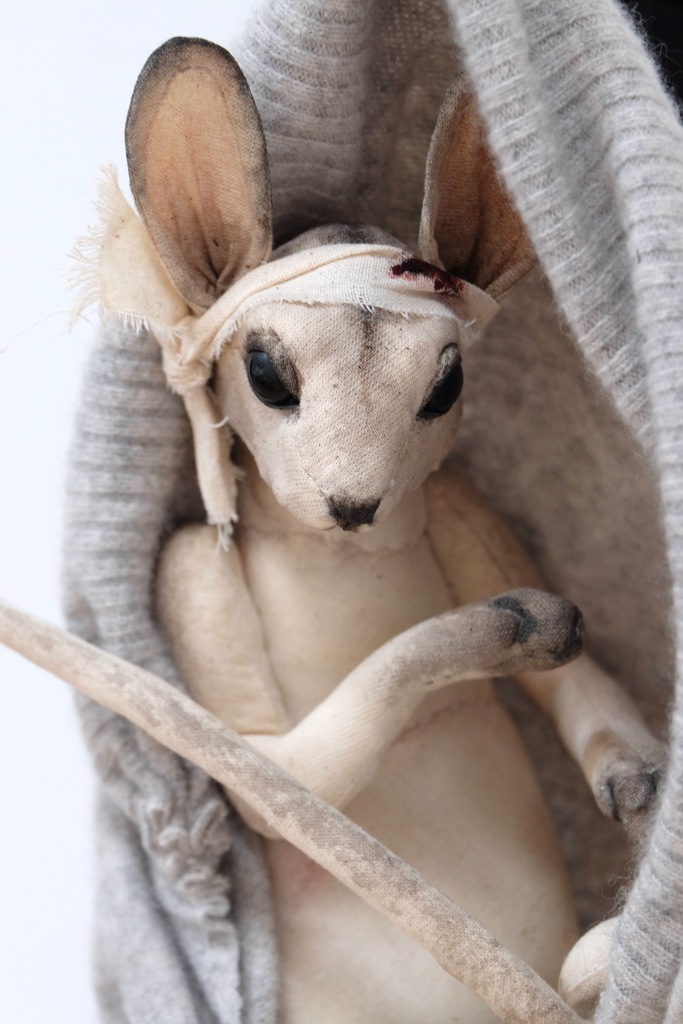
The baby Joey went to a home in America and his bloody bandage could be removed when he was happy in his home.
Julia Levander Drew
Fort Augustus, Scotland
www.charactersbyjulia.com
Deborah Blakeley, Melbourne, Australia
Interview by Deborah Blakeley, September 2020
Susan Avishai
You have been working with textile waste for the past ten years. What lead you to this area of art?
Inspiration. My mother died in 2009 and the sad task of going through her belongings fell to me, her only daughter. She had been an artist as well, and was the one who had made sure that in childhood I had all the supplies I needed to be creative. So it seemed appropriate then, that her clothing became my medium too. I was expressing a longing for her, but in addition a respect for the way she presented herself in the world—always beautifully dressed (unlike her daughter with her paint-spattered yoga pants). It was hard to make the decision to cut up her garments, but as I handled them and reworked the fabric, and remembered the times she wore them, it was as though I was spending time with her once more, which I found enormously comforting.
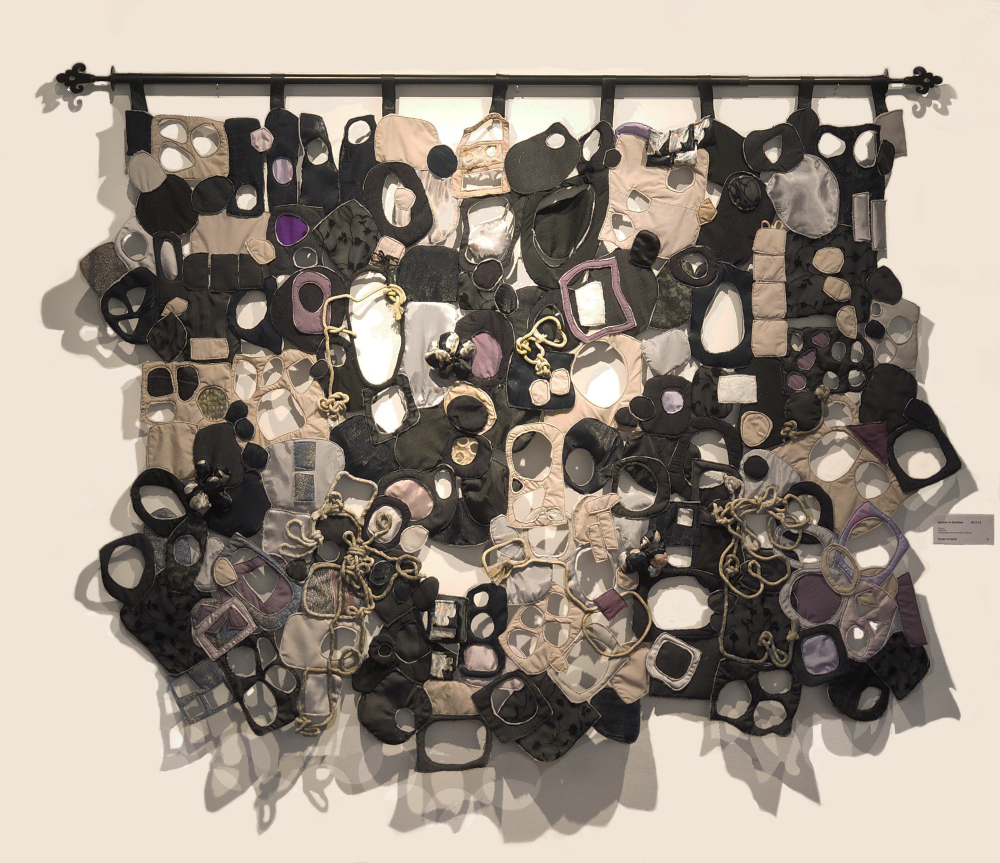
Homage ll, 48” x 66” x 3” Deconstructed clothing, rope
At about the same time I became aware of the work of El Anatsui, the Ghanaian artist who creates tapestry-like hangings from bottlecaps. I travelled to NY in 2013 just to see his show, Gravity and Grace, at the Brooklyn Museum, and the work so moved me that at first I was speechless. I knew then that my years of photographic, rather intellectual realism in egg tempera, oil, and pencil were over. It was time to try something new, to press forward with what excited me, and to leave what was already well-practised and understood.
Medium. It was the utter transformation of detritus, trash, the no longer useful, into magnificent art, worthy of museum timed-entrances that spoke to me. My daughter Tamar describes it this way in her Lonely Palette podcast episode of El Anatsui [thelonelypalette.com/episodes/2017/3/1/episode-15-el-anatsuis-black-river-2009] “...the creativity that went into turning something that is so one thing into something so entirely different that you start thinking about the social and economic implications.” The artist said it himself: “The amazing thing about working with these ‘fabrics’ is that the poverty of the materials used in no way precludes the telling of rich and wonderful stories.”
The repetition of like elements gave them rhythm and texture. This was a transformation so complete that it actually made me gasp when I saw what the elements actually were: discarded liquor bottle caps and collars. Several years later I got a similar thrill when, standing incognito behind some attendees at the Gardiner Museum Gala in Toronto, I overheard a comment about the doily-like intricacy of the 9’ fibre Christmas tree I had made. Then they read the blurb on the stand beside it. "What? This is made from men's shirts?!” What I had learned from El Anatsui was that you need to make a stunner first, and only reveal the dirty secret afterwards-- that this isn't gold leaf or metallic threads; it's bottle caps. This isn't fine lace from France; it's shirts from thrift shops.
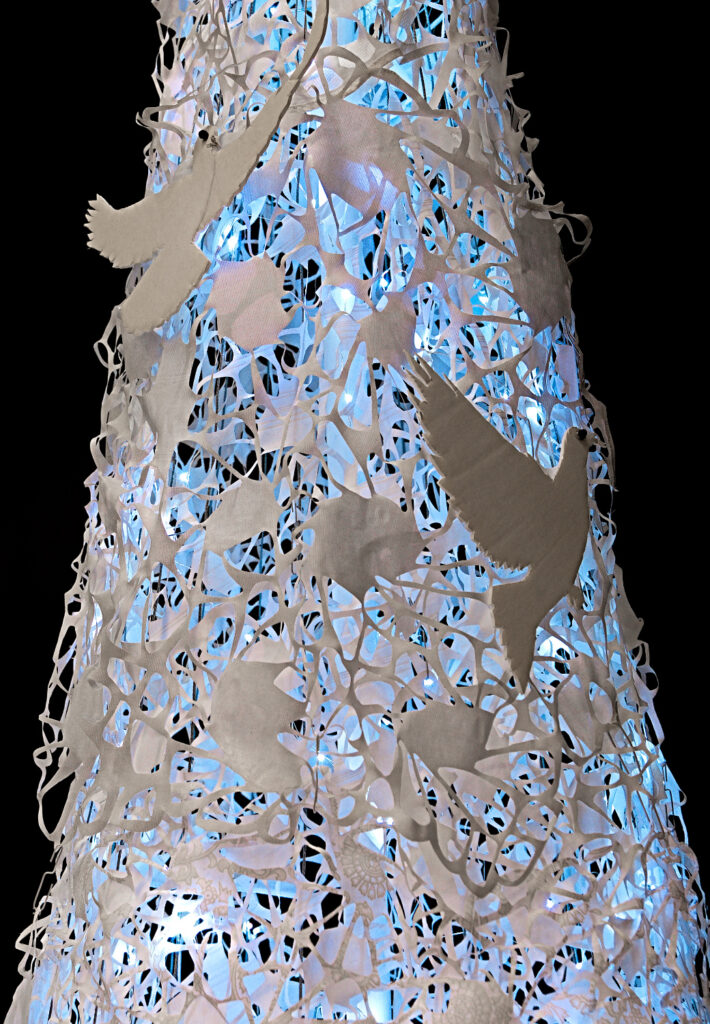
Twice Blessed, 108” x 38” x 38” Deconstructed and stiffened white men’s shirt backs, acrylic base, wire, turnbolts, styrofoam, fairy lights.
I had needed a medium in which to be expansive: something ubiquitous, something cheap, something original. After making those first homages to my mother, the medium declared itself, of course: cast-off clothing. One only has to be paying attention, it seems. I’d bring home armfuls of shirts from thrift shops, rummage sales, and friends’ closet clean-outs. I’d deconstruct them and end up with piles of collars and cuffs, pockets and plackets, yokes and seams. Why shirts? Unlike women’s clothing with its many fabrics, colours, and designs, there was a predictability, a sameness about men’s shirts. The fabric was easy to work with, the same thin, crisp cotton I remember being so aware of when my father had hugged me. Every man I knew wore shirts; they were the uniform of work. They smelled of ironing, or piney deodorant, of labour and stress, of stability and love.
Message. Then I happened upon a small book entitled Overdressed: The Shockingly High Cost of Cheap Fashion by Elizabeth Cline and my eyes were opened to an uncomfortable global paradox. Garment manufacture had turned into a lightning quick cycle of Third World underpaid women, using flimsy fabric, simple pattern, and knock-off design to keep Western consumers supplied with cheap clothes. Worn briefly and discarded quickly, the waste we created made my head spin. The Council for Textile Recycling reports that the US alone generates 25 billion pounds of textile waste a year-- 82 pounds per person!—and most of it is thrown into landfill. Now more than ever I needed to insert myself into this cycle of exploitation and waste, to increase awareness of and express my distress over the vast quantities of “stuff” we thoughtlessly toss away, how quickly we determine its usage to be over, and its value gone. By up-cycling, I wanted to see if I could create something transformative, inspired, sometimes even whimsical. I don’t think I speak only for myself when I think we connect with material on a deeper level when we recognize its previous life, its inherent history. It’s one thing to behold a fibre sculpture, but another to recognize it is made with the shirt cuffs you button each day.
Expand how you created sculptures from textiles?
I’m not a schooled weaver, knitter, embroiderer or quilter; my techniques are simple—cutting, sewing, gluing. For me, fibre sculpture is more about making something I’ve never seen before, from parts of shirts we see every day. I let the deconstructed pieces suggest how they might be reconstructed. I would turn a buttoned collar around and it looked like a tulip Row.
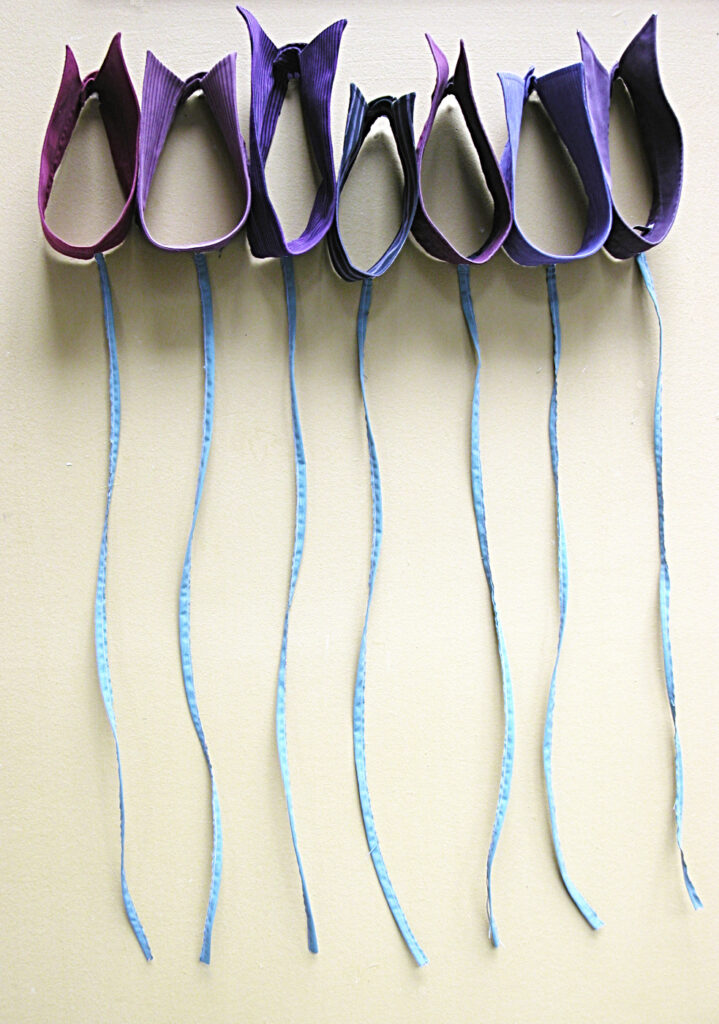
Tulip Row, 32”x30”x3” Deconstructed men’s dress shirt collars, hems, glue.
or a fish.
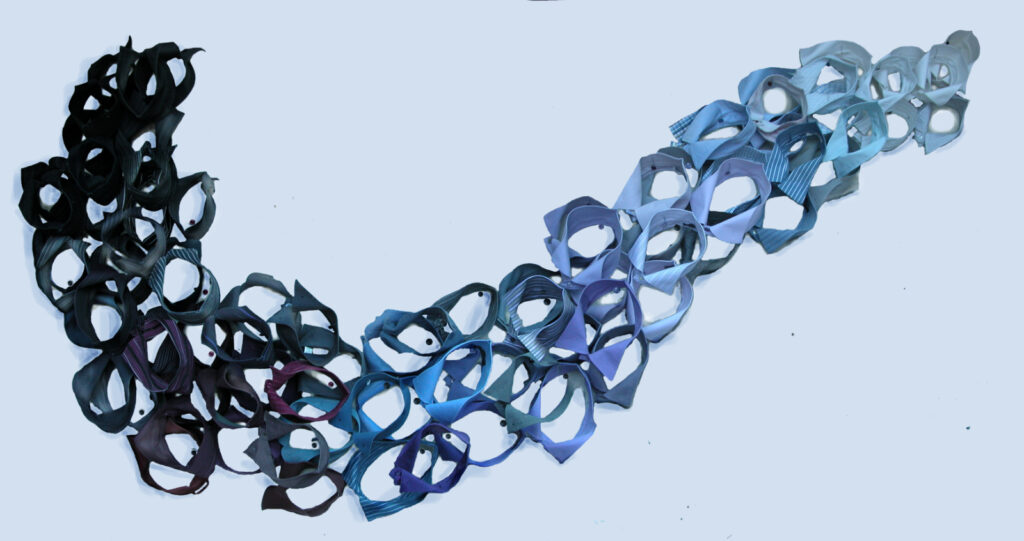
Off to School, 48” x 62” x 3.5” Deconstructed men’s shirt collars stiffened with polymer medium, wire, buttons, thread.
Then it was simply a matter of figuring out a way to make the piece...should it hang from a wall or from the ceiling? Did the collar need to be shaped with wire? Did the cuff need to be stiffened with acrylic medium?
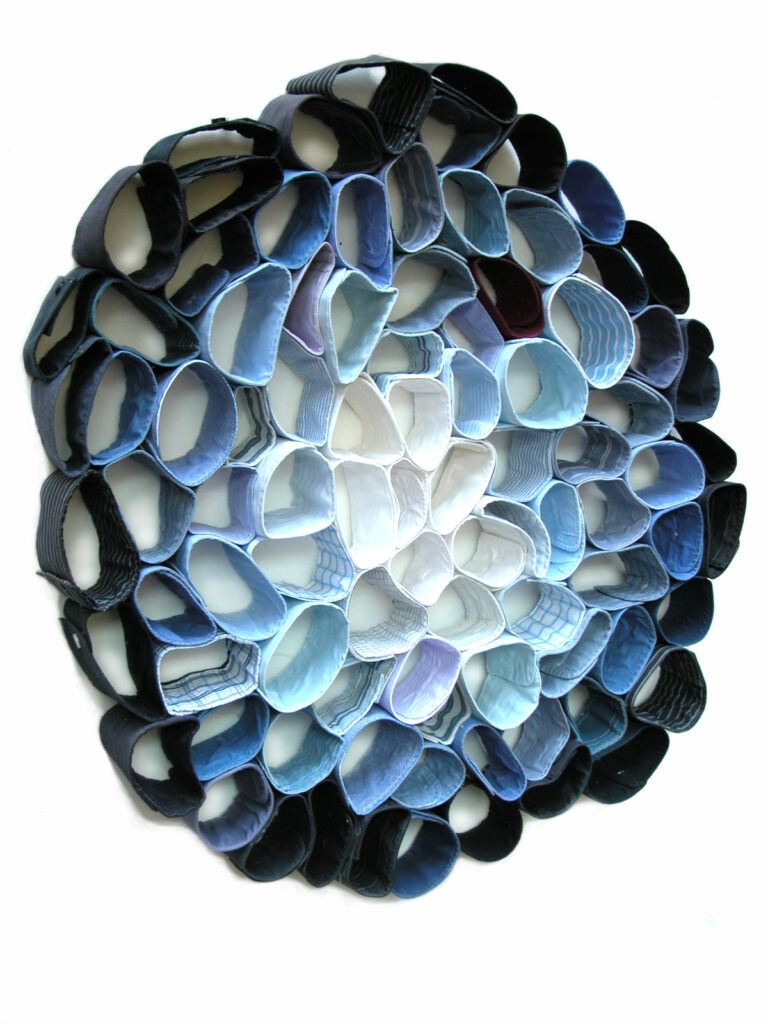 Cuff’d, 27” x 24” x 4” Deconstructed men’s dress shirt cuffs, stiffening medium, glue.
Cuff’d, 27” x 24” x 4” Deconstructed men’s dress shirt cuffs, stiffening medium, glue.
How did colour play into the piece?
I was playing in the sand and it was important to drop any hesitation or pre-judgment, to let the passion and original approaches fly. Seams and hems turned into hundreds of . White shirt backs, painted with medium were hand cut and layered, the result resembling lace.
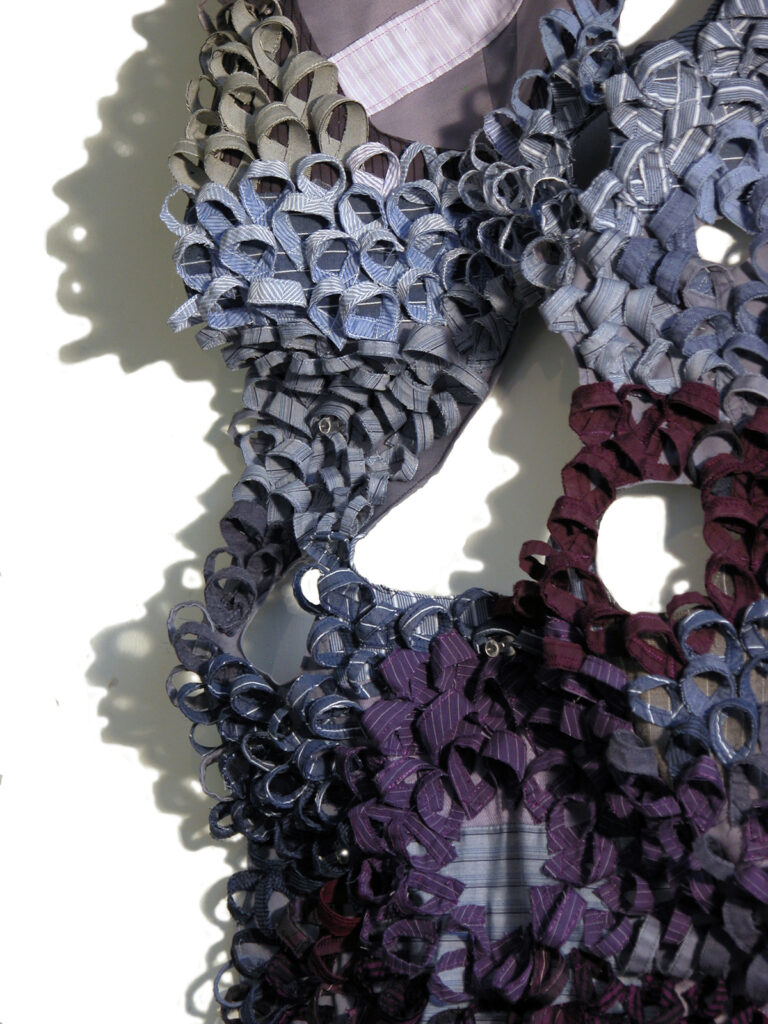
Garden without Seasons (2014)—70” x 28” x 4” deconstructed men’s shirts, glue, sewing
On a lark I pinned them from the ceiling, fastening the pieces to each other with paper clips and they seemed to transform themselves into a bridal gown.
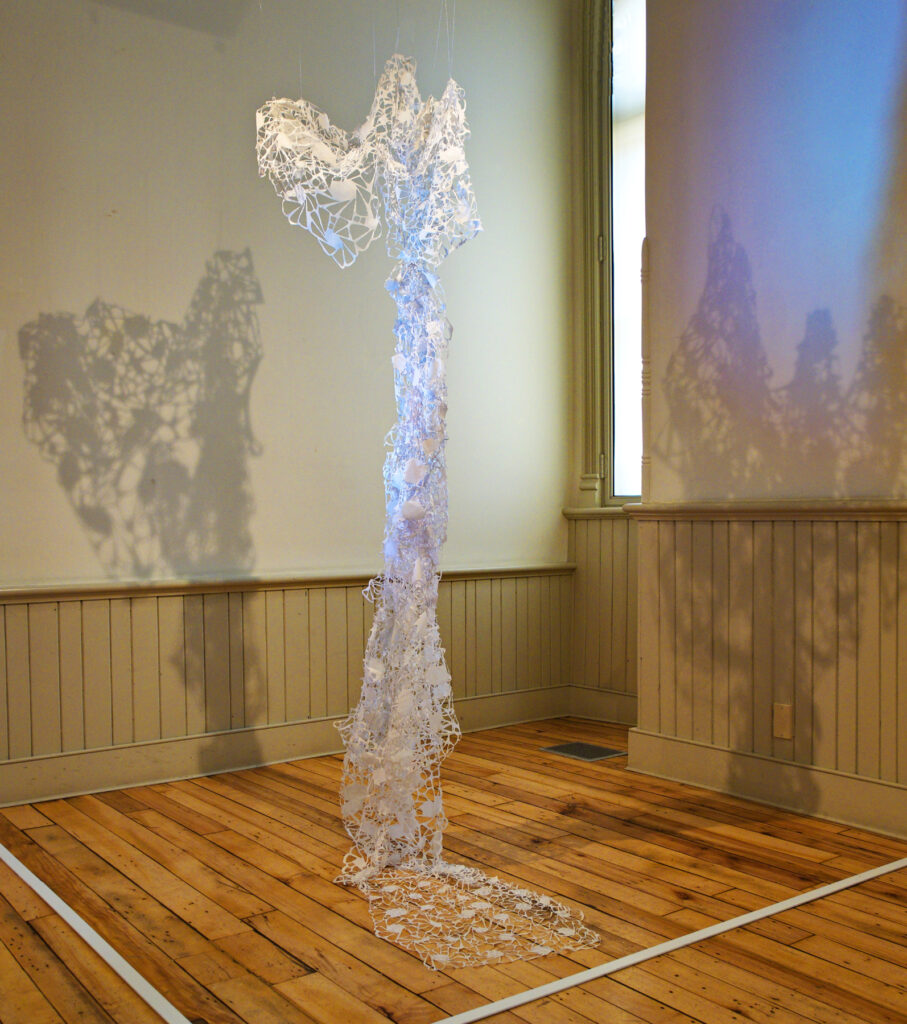
“...and the Bride Wore White” 8’ x 14” x 12” deconstructed men’s dress shirts
embedded with polymer medium, paper clips and filament line to attach; hand cutting with scissors, sewing.
I often got excited by the shadows thrown on walls when the work was illuminated, and in this particular case the larger dark shadow attached to the gown became a Father-Daughter dance.
Expand upon how ‘Rapunzel, Rapunzel’ came to be.
I had begun quilting elements with holes one summer in my studio, not at all sure what they would become. Hundreds were strung on curtain rods. After arranging and rearranging them in varied formations on the floor, I decided to attach them as a long train of sorts, and it ended up to be 37 feet in length. It was affixed to our 3rd floor ceiling, tumbling down through the stairwell, and puddling on the first floor. Easy to see where the title came from. Over fifty shirts in colours that graduated from white to black through purple hues sacrificed their lives for this one. The piece has been configured differently in several exhibitions, sometimes threaded through with tiny fairy lights.
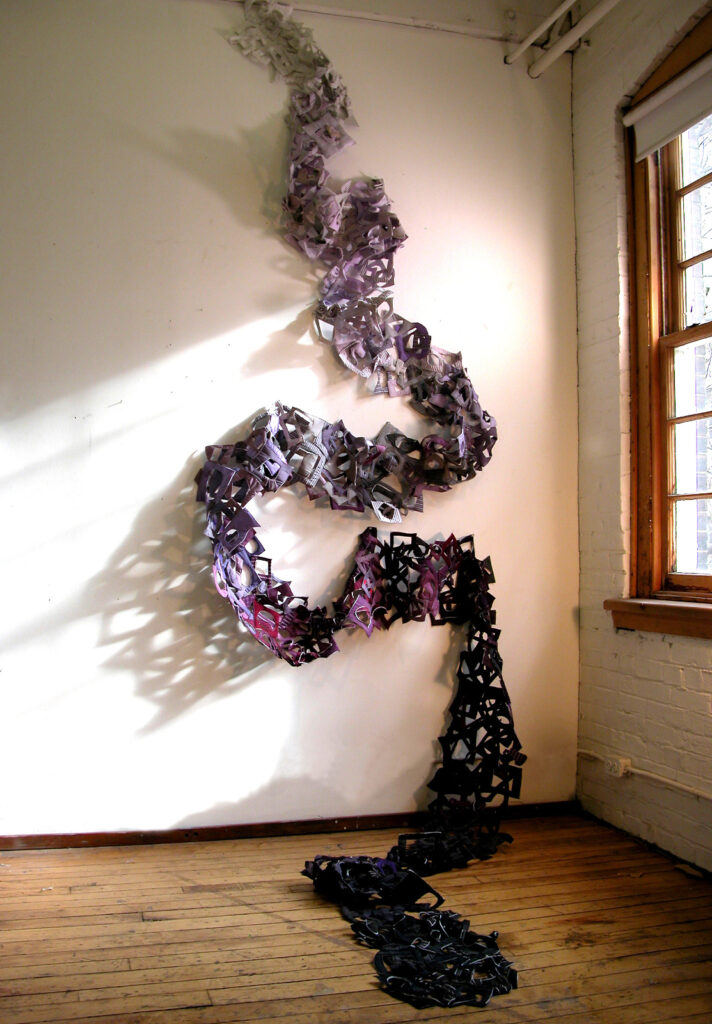
Rapunzel, Rapunzel 400” x 18” x4” Deconstructed, quilted men’s shirt pieces, glue.
Discuss the frequent appearance of holes in your work.
A while back I decided to break away from the very tight and representational work I had been doing in egg tempera and coloured pencil for so many years (see below). I had picked up an old 1905 Underwood typewriter at a flea market, a clunker, but beautiful in some ways for how it looked, no longer for what it did. I made dozens of drawings in almost as many media, from every angle, creating loosely abstracted, experimental interpretations of the machine.
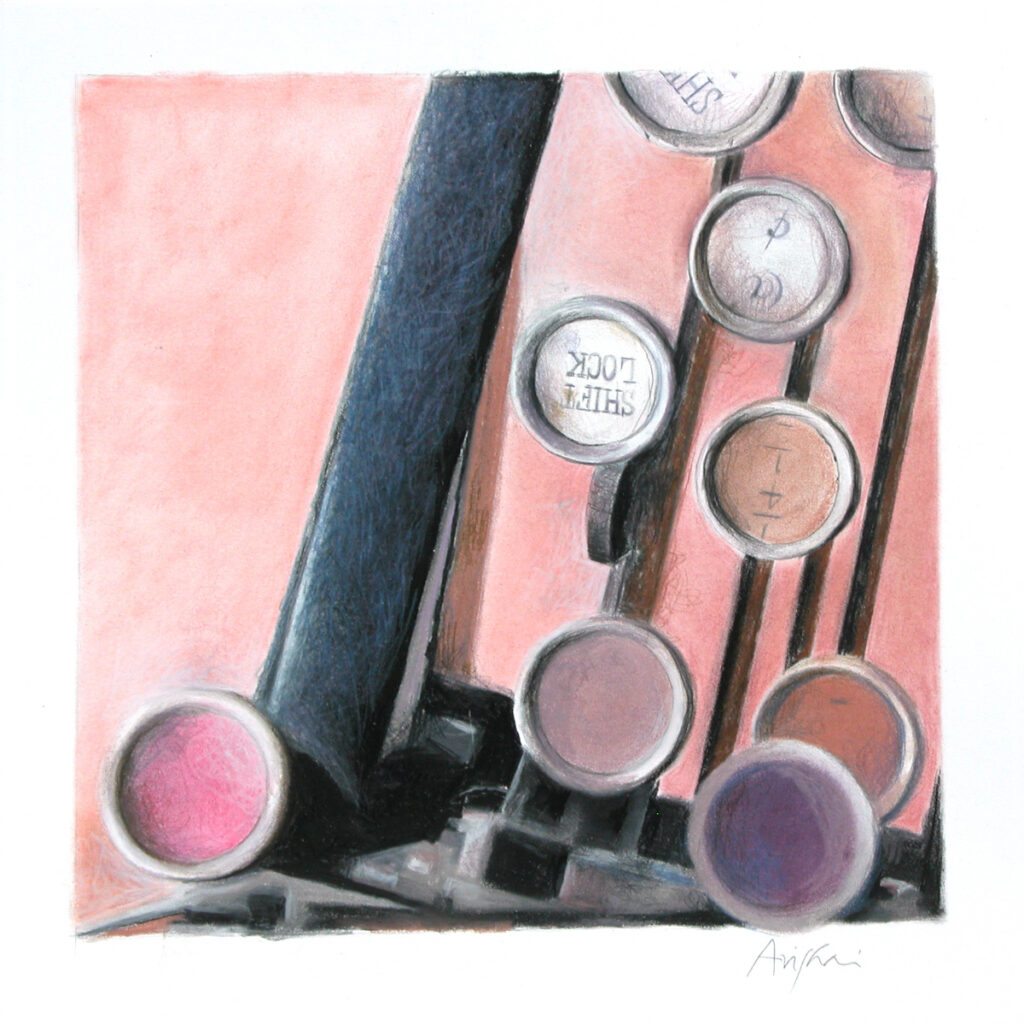 Shiftlock Balloons, 20” x 28” coloured pencil on rag paper
Shiftlock Balloons, 20” x 28” coloured pencil on rag paper
Eventually the round keys emerged as elements that carried forward into my next series: very large collages using found paper and oil stick. The paintings all seem to contain that circle, stretched and pulled, as figure and/or window, singly or in masses. In some paintings they succumb to gravity; in some they repel or attract each other like magnets. What intrigued me was their engagement with each other, and their energy in space. So when I turned to fibre, they appeared again, as holes in the fabric. Hard to explain why certain elements become iconic in one’s work. I think the shape simply pleases me. Perhaps the artist should focus on making the work, and leave the explanations and connections to more objective viewers!
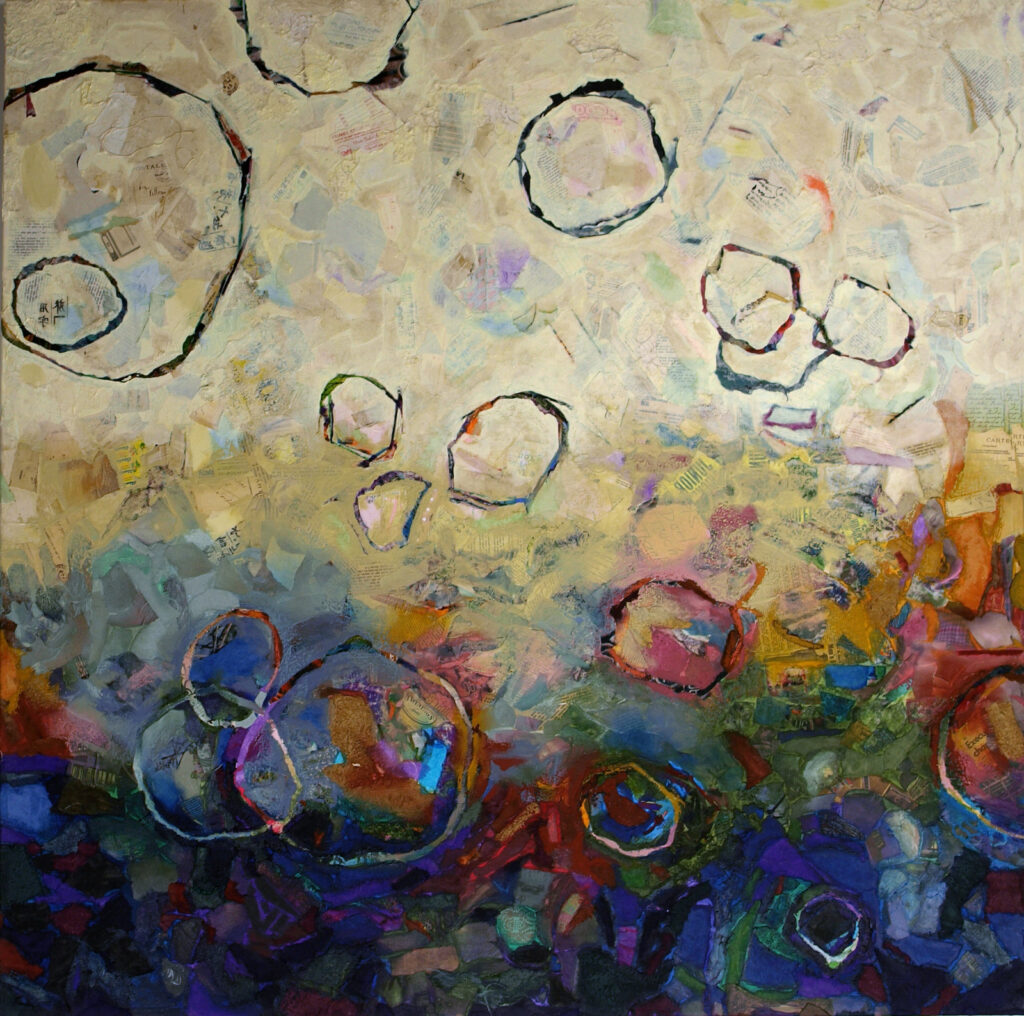
Light into Darkness, 48” x 48” found paper collage, oil stick
(collection of Fed Ex Canada)
You attended a residency in Latvia. What was that like?
Yes, in 2016, I was chosen to participate in a Textile Symposium in Daugavpils, Latvia, a small town three hours from Riga with the distinction of being the birthplace of Mark Rothko. Some years after his death, Rothko’s two children gave money to turn an old fortress there into the Mark Rothko Art Centre, and since then it has been a gathering place for artists in various disciplines to live and work at the museum, sharing intense time together, culminating with an exhibition of the work done during the residency. I knew little about Latvia before I went, but some research taught me that a once thriving Jewish community there had been decimated, first by the Nazis, then the Soviets. Even on Yom Kippur when I visited there was no service at the one synagogue that survived in town. Under the Soviet regime, even recitation of the mourners’ prayer was forbidden in public. I knew then that I had to make something to pay homage to this cruel history. I ended up with a linen hanging where the Hebrew letters of the Kaddish (mourners’ prayer) were cut out of a handmade prayer shawl. When illuminated from the front, the light was projected through the holes as a ghostly image on the wall behind. Beside it stood a plinth with names of some of the victims (copied from the Holocaust Museum in Riga), the prayer transliterated into Latvian, and a few stones as is the custom to leave at a Jewish gravesite.
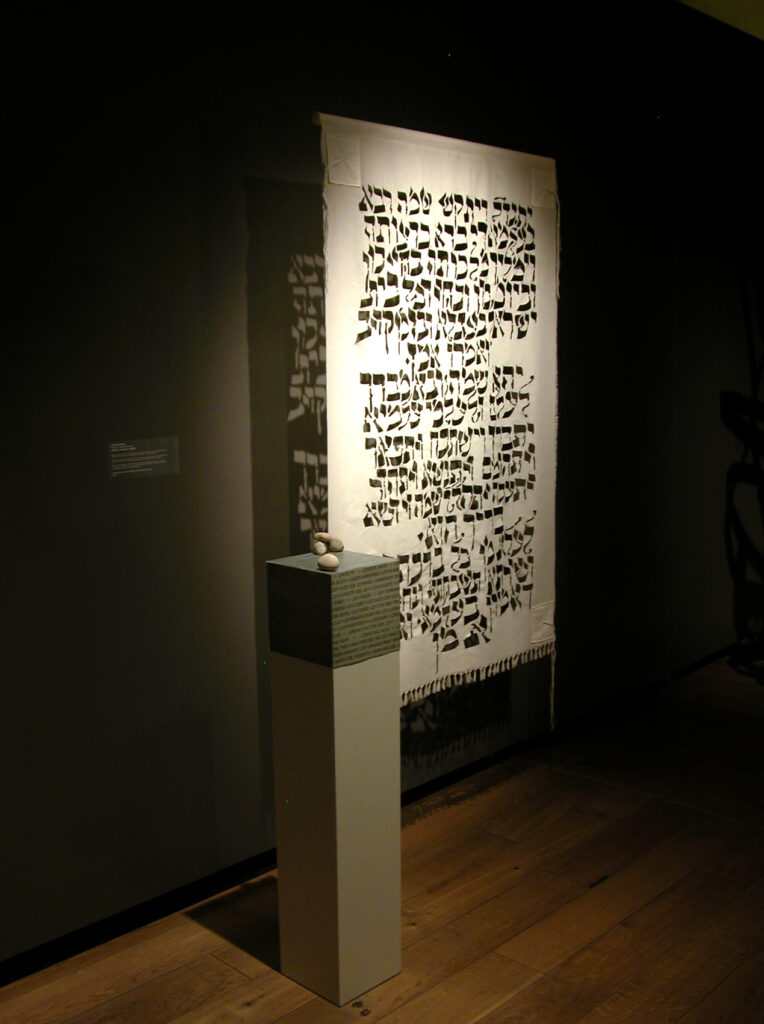
Kaddish 60” x 48” linen, fringes (Permanent collection of Mark Rothko Art Centre, Latvia
During the residency I read a memoir written by a survivor of the Daugavpils ghetto (How Dark the Heavens by Sidney Iwens). I came to a paragraph where he describes seeing a huge dark shadow ahead of him as he ran through the forests at night. Approaching, he realizes that it’s an old fortress. And there I was, 65 years later, reading his book in that exact location-- the fortress renovated by the Rothko family. Both Iwens and Rothko lived in the US for most of their lives but had never met. I left the memoir for the Rothko library, returning it to from where the story began.
Take one specific Memory Project that actually has a wonderful deep memory for you or the commissioner.
Recently my niece gave birth to her first child, a little girl that she and her husband named Adira. The Hebrew name means “strong woman.” As a gift for the newborn I thought of making a soft little quilt for her, and asked that the squares of fabric I needed be contributed by the strong women in her life-- her grandmas and great grandmas, aunts, cousins, and dear friends of her mom. People were truly delighted at the chance to send something. Little by little envelopes arrived in the mail-- pieces of fabric embedded with memories from special items of clothing, from old pillowcases, favourite jeans, a treasured tablecloth. Many of the women included a blessing for the baby or a story about where the fabric came from. After they were all collected, I made the quilt and had the new parents take photographs of the baby cuddled up in it, which of course we sent to all of the contributors.
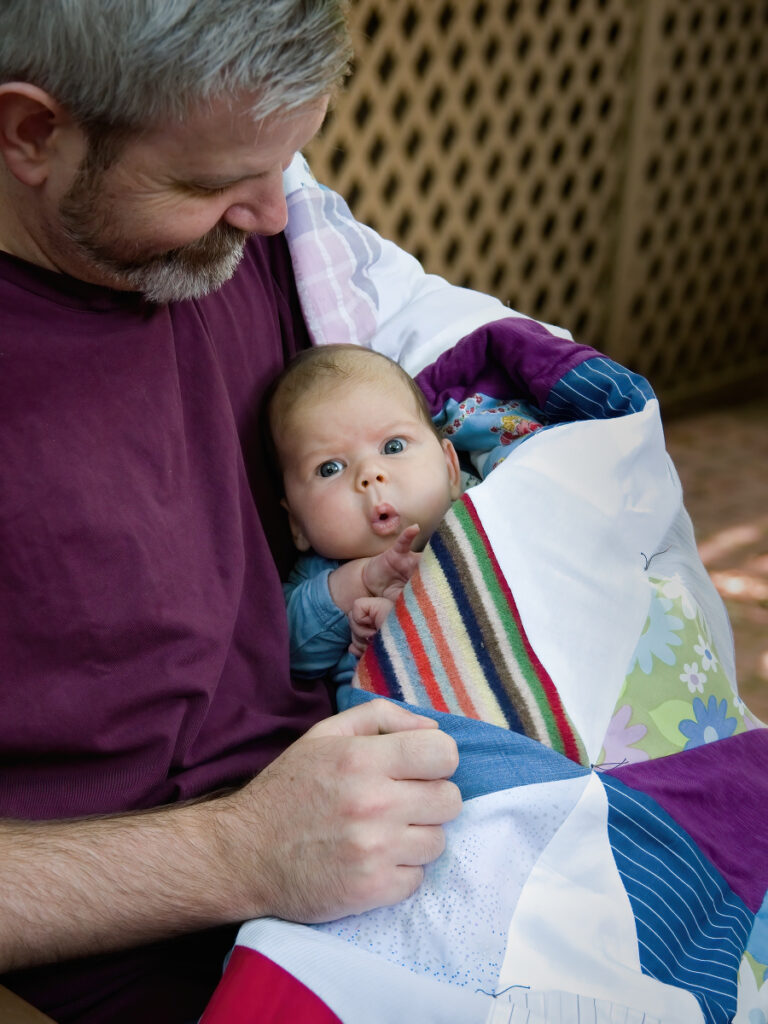
Adira’s Quilt, 40” x 30” varied fabrics, batting
Are any of your works wearable art?
They look as though they could be, but no. Usually I’m deconstructing wearable garments for their parts.
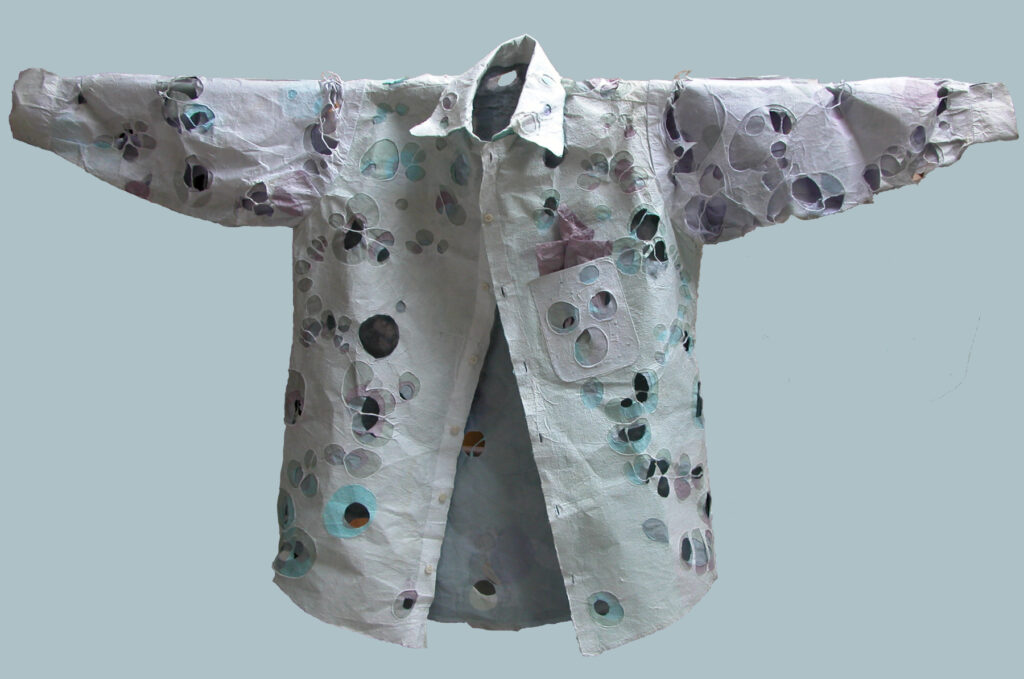
Joomshirt, 30” x 52” x 6” haji paper, buttons
Recently however, I made a new shirt using the ancient Korean paper felting technique called Joomchi. It’s made entirely of Hanji paper, layered and manipulated so the long fibres break down, fuse, and develop holes. As a reversal, I cut up a fabric shirt to use as the pattern for the paper shirt. Each section was kneaded individually with water and, “eager hands,” as Jiyoung Chung, a well-respected teacher of the technique, puts it. I was so delighted when Joomshirt was chosen for Excellence in Fiber 2019.
Discuss your paintings in the series, ‘Scapes of the Clothed Figure and how the human form can influence fabric.
For many years I drew and painted the figure, using coloured pencil, egg tempera, or oil. Because I would leave off the heads, and often the hands of my subjects, I had only their bodies to explain who they were. Relying then on what they wore, the gesture of the pose, and the body type, it fascinated me to see how much of a person can be described.
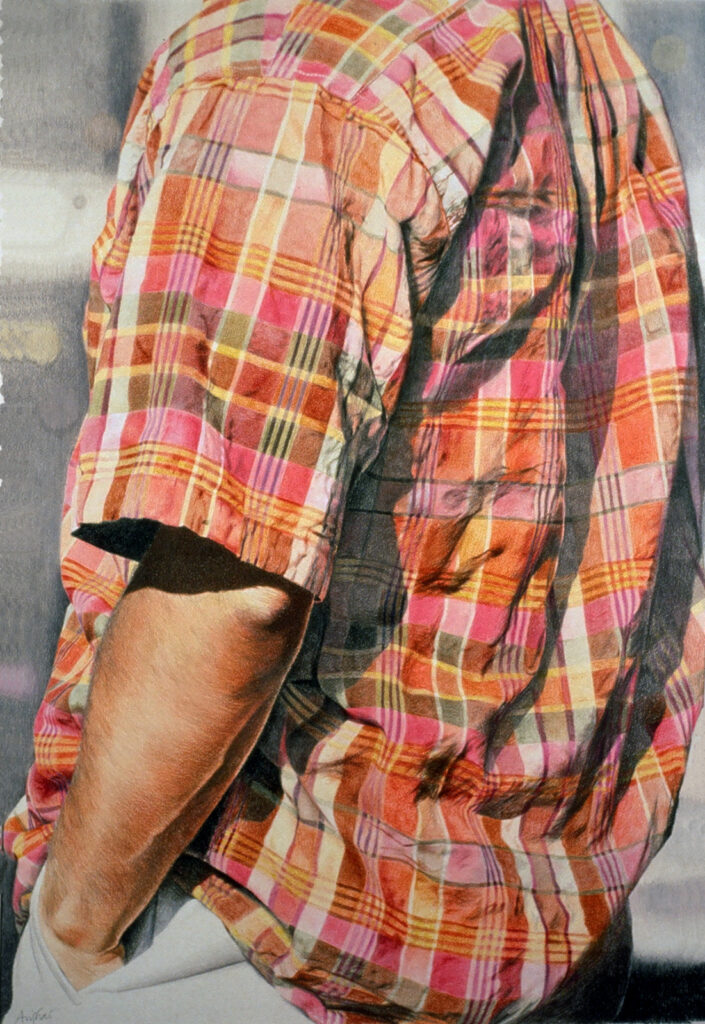
Madras, 28” x 19” Coloured pencil on rag paper
It was always the clothed figure I found so intriguing for we must conjure the body underneath based solely on the contours and lie of the covering. Parts are hidden under folds or stiff fabric. Other parts are revealed through taut, clinging, or transparent fabric. It’s an exploration. But it’s also a metaphor for any covering over form, any façade which simultaneously can hide and reveal what is underneath. Pushed psychologically, the metaphor can describe our own affective behaviour, as we allow some aspects of our nature to be shown to the world, but conscious or not, keep other parts hidden.
How do you personally see the pandemic affecting the art you are part of?
There has already been a very visible change in the art scene for the same reasons that affect so much else. Exhibitions have closed early, have been pushed ahead months or even years, or are cancelled altogether. Four shows that were to include my work have been postponed. The summer outdoor shows were moved online, a bold change for their organizers and I applaud their flexibility. But it’s hard for most people to buy art they haven’t seen up close, especially fibre art, a difficult sell to begin with and not displayed to advantage on a small screen. Outdoor fairs are a social event and family outing; sales are far less likely when the artist isn’t present to talk about the work.
In a time of uncertainty, art is the first thing we think we can put aside. Who will be spending money on a painting when they aren’t confident about the economy, or fear their job is in jeopardy? Who thinks of adding to the beauty of their home when no one is visiting? Who is gifting art when celebrations are cancelled? Our focus is on getting groceries safely, and deciding if it’s right to send our kids to school. Acquiring art will wait.
Artists aren’t just worried about diminished sales. Many have kids at home and must direct their creative juices toward activities for them. Many artists I’ve spoken with just aren’t feeling inspired. They are scared, or depressed, and if they can’t work they don’t usually qualify for unemployment benefits.
I happen to be one of the lucky ones whose kids are grown, and whose family income hasn’t been affected much. I still spend most days happily ensconced in my home studio. There are fewer distractions. Personally, I have found that making a very large piece (aiming for 8’ x 9’) with many intricate elements is giving me a necessary sense of continuity and direction that I don’t feel elsewhere. The finished piece is only a vague idea in my head, allowing me to change course as I go, experiment, stay light on my feet. And that keeps me challenged. At a time of deadly disease, social and political unrest, far too little contact with my kids and grandkids, my studio has become the only place I can feel I’m in some degree of control.
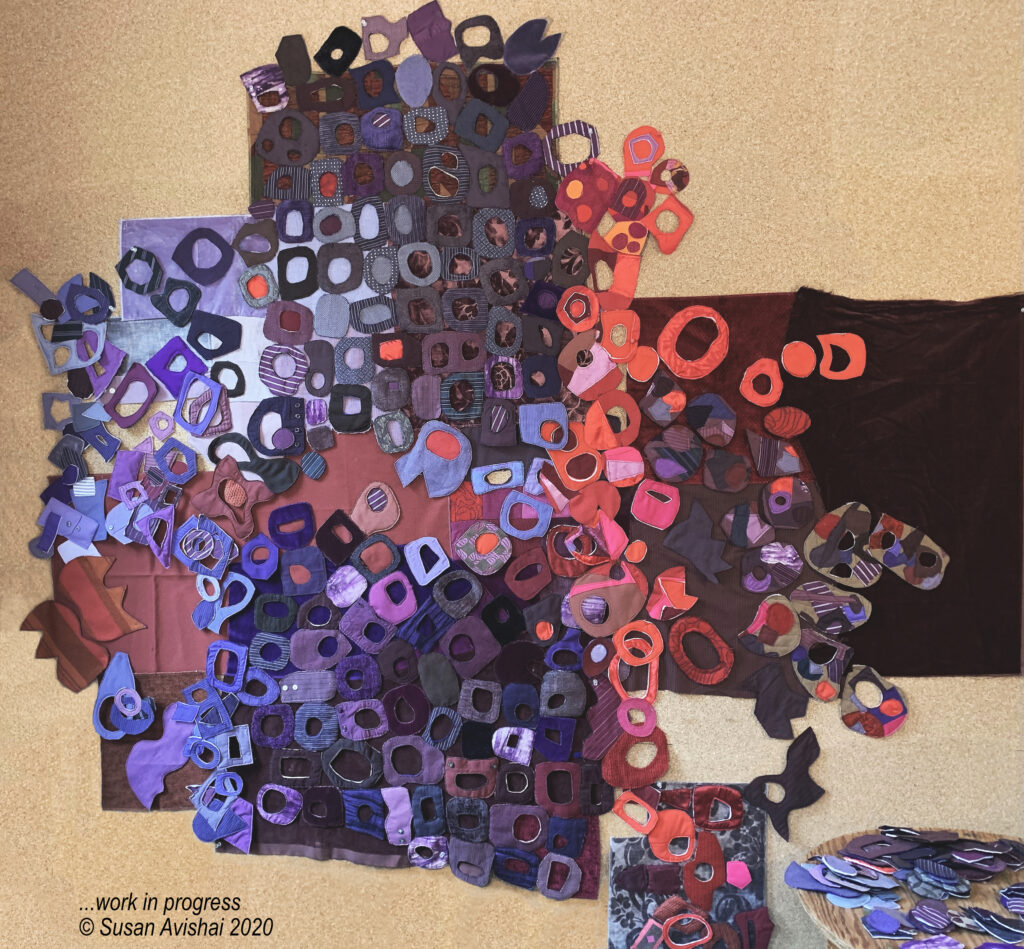 I Want to Bubble with Everyone, 8'x 9'(in progress) Deconstructed Clothing, discarded swatches from interior designers, sewing, quilting.
I Want to Bubble with Everyone, 8'x 9'(in progress) Deconstructed Clothing, discarded swatches from interior designers, sewing, quilting.
Play this short video, and I promise you will be smiling and feeling, Oh! so much better. Ready to face another day or even the whole week ahead. Thank you Susan for sharing this with us all.
Contact:
Susan Avishai
susan@susanavishai.net
www.susanavishai.com
Deborah Blakeley, Melbourne, Australia
Interview by Deborah Blakeley, September 2020
David Higgins
You have had many residencies take two and expand on how the actual residency developed your art.
It is hard to say which residency has impacted me the most. On reflection the residency that has the most impact on me was when I was appointed the first resident artist for the Zoological Board of Victoria based at Melbourne Zoo in 1980.
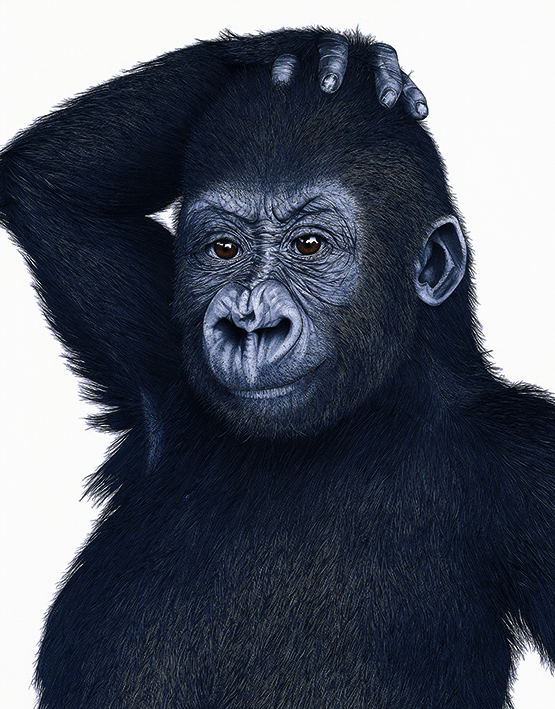
Lowland gorilla, 400mmx650mm
For the next 6 years I had intimate exposures to animals from around the world.
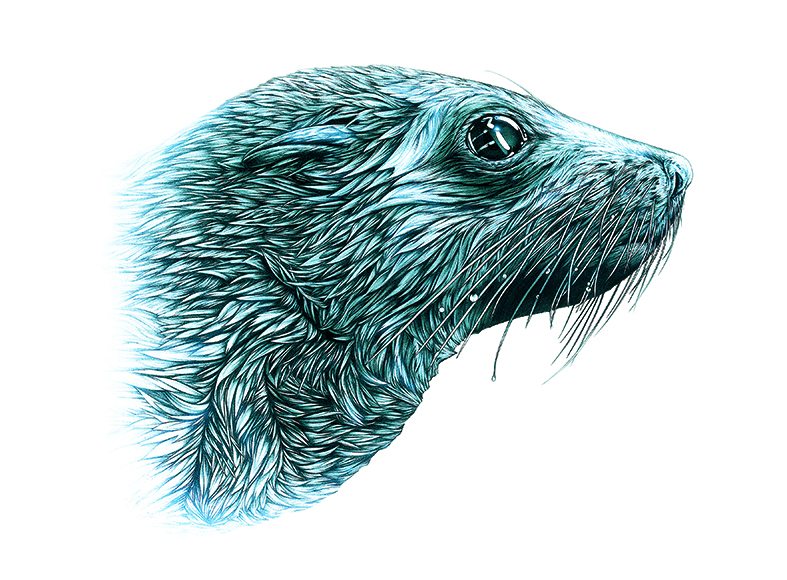
Australian Fur Seal illustration
This experience was trans formative and life changing.

Australian stamp art

From John Blakeley's Australian Decimal Stamp collection
Secondly I have been to Japan about twenty times for exhibitions and commercial activities beginning in the early 1980’s and tailing off around 2013. An exhibition of my wildlife art and sculpture at the Kyoto School of Art and Design was a definite highlight and the other in Tokyo in the Year of Association Japan / Australian Governments. Australian Embassy, Showa no mori, Forest Hotel for Australia Japan week celebrations, Ecological art exhibition and ceremonial proceedings. Both experiences occurred in 2006. Japan has been a huge influence on my outlook and appreciation of what is important.
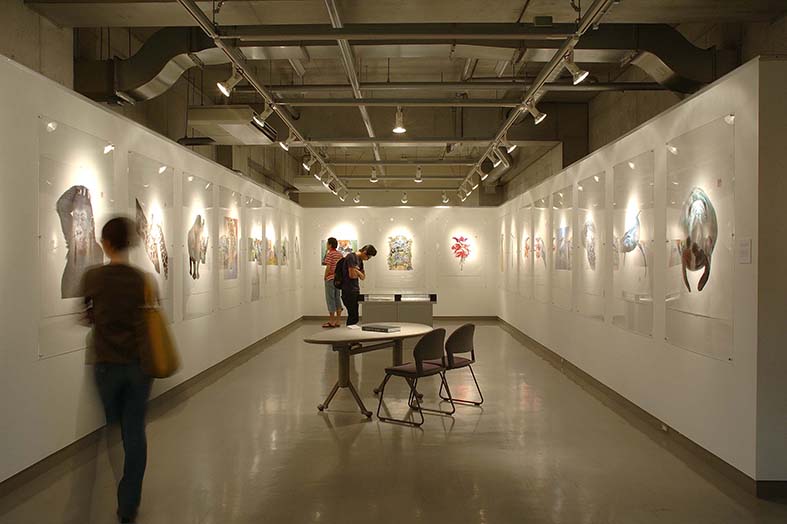
Kyoto University of art and design exhibition
The other highlight has been my two residencies in China. The International Sculpture Symposiums in Changchun, China in 2014 and 2017. The 2017 symposium was particularly memorable working with master stone masons of 30 generations.
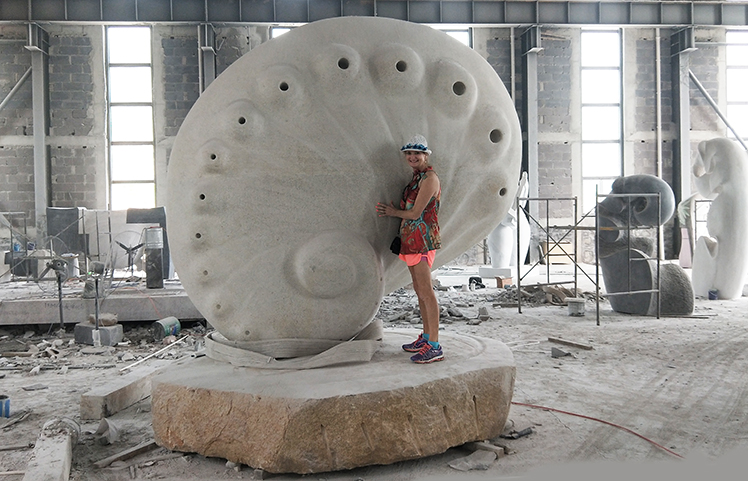
Shell form, Granite and Gail Higgins, International sculpture symposium Changchun, China
The skill levels were crazy good and the people beautiful. It gave me the opportunity to see how big and diverse China is and the importance of handing done skills and working together.
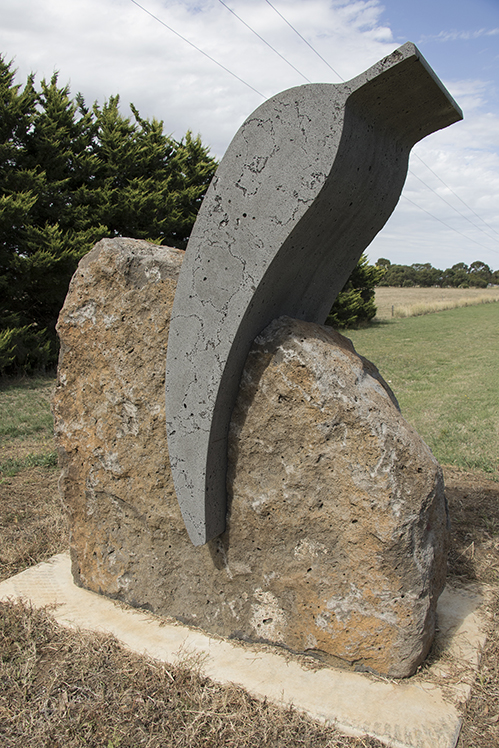
Purnim town entrance, basalt
How will 2020 effect artists residencies we are all hearing of the change’s athletes are making due to the cancellation of the Olympic Games. Discuss this issue in relations to art residencies.
The global pandemic has affected the creative community enormously. There is no national or international travel so
artists have to think how to stay active, relevant to their craft and keep their head space balanced. I had decided at the start of 2020 to scale back overseas art chasing and focus on making Nirranda Arts work here and see this as the future. The Covid-19 situation has reinforced that the future is online teaching, workshops and sales. I am working towards this and at the same time expanding my offers at the studio to cater for domestic customers and art lovers.
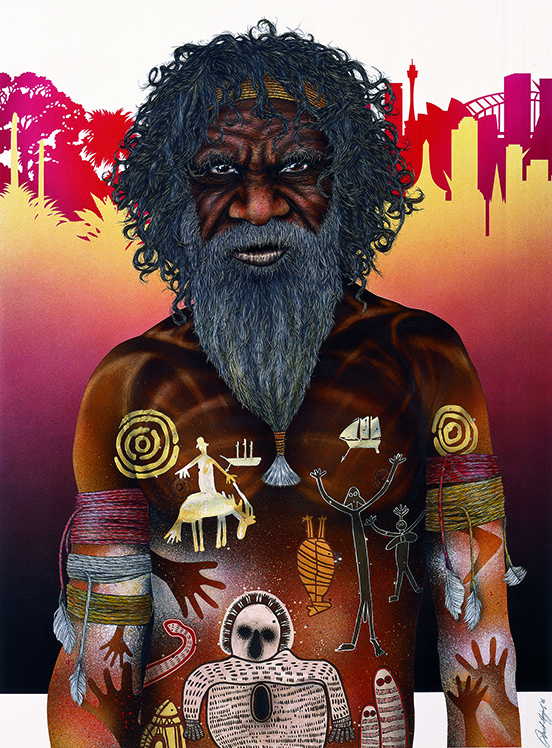
Indigenous dreaming, illustration 400mmx650mm
When did you move into textiles and silk painting?
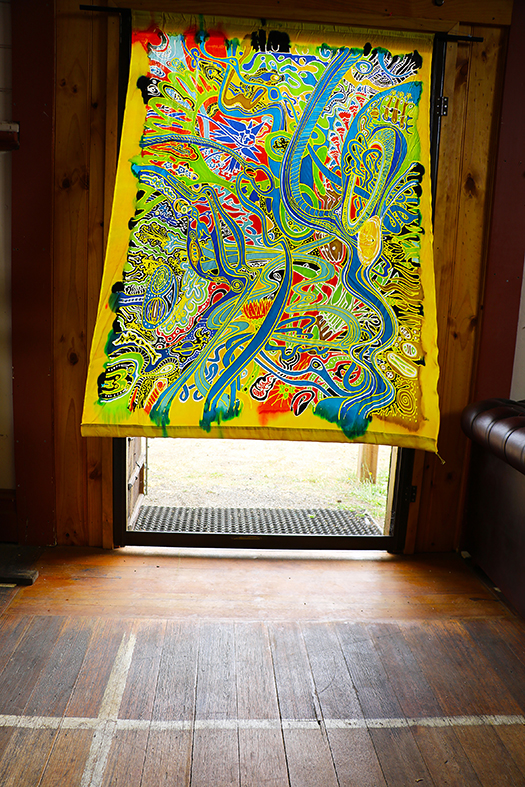
I resigned from my university job 14 years ago and needed to find a way back to being a full time working artist. My body and mindset needed real change from the institution and the difficult work of illustration. By chance I met Marion Hera-Gorr of Beautiful Silks, did her silk painting workshop and instantly saw I could move ahead with this. Perfect timing as I needed something to set me free. I moved into silk painting not knowing anything about the discipline. This proved to be a strength as the rules meant nothing to me. I made my own way as I went to suit my already existing drawing and design knowledge. The nature of silk painting technique is instant and spontaneous. This is what I wanted in my art production, no pre-planning and to work totally intuitively.
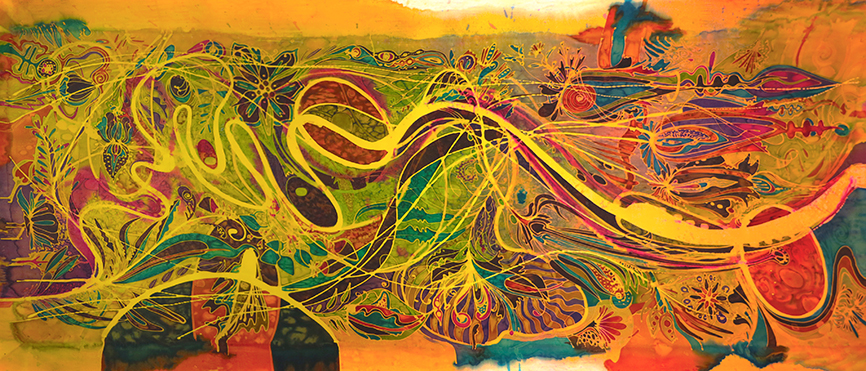
Desert song, satin silk 1400mmx3200mm
What are the constraints and restrictions to the works size and how do you overcome this and adapt to suit what is achieved?
I make wooden frames to stretch the silk to suit the size I want or need. For workshop teaching and production silk scarves I have frames at 1000mmx1000mm. Bigger frames at 2000mmx1200mm and 3000mmx1400mm and a range of other sizes. (preferred silk size is 3500mmx140mm).
I use flat tables and fold silk to create longer pieces up to 8000mm x1400mm. So in a way the constraints are minimal and I am constantly thinking on how to make the process new, achievable, and creative.
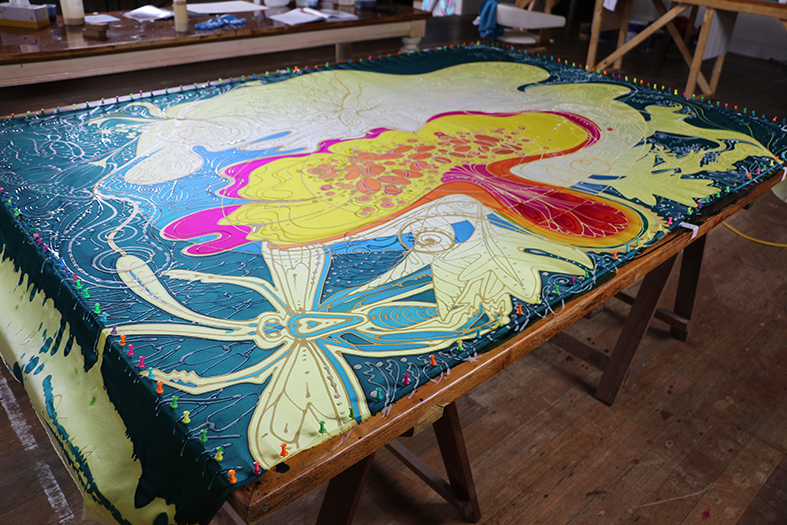
Pollination, silk painting in process
I use different types and weights of silk depending on the work I want to make, silk crepes, satin and chiffon. All have their individual characteristics and abilities.
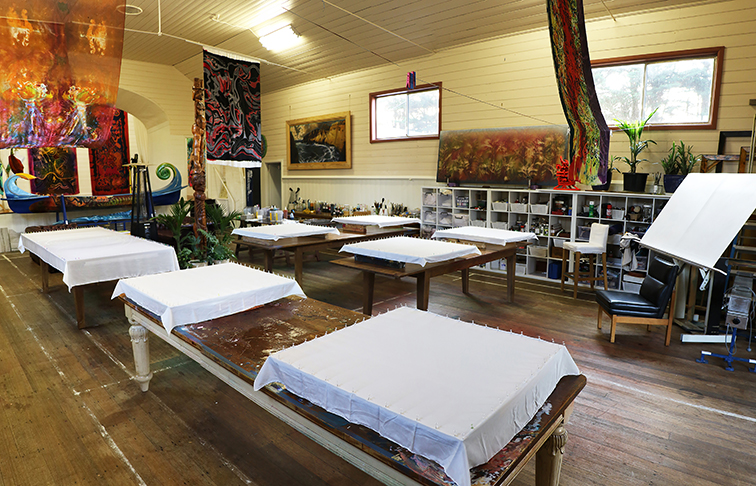
Ready for a silk painting workshop
Do you ever use the principal of repeated pattern similar to William Morris?
No, it is very different. Whilst I admire William Morris and the processes of that time, my method is almost opposite in that there is never pre planning except for a vague feeling what i might like to do, no guidelines or pre drawing on the silk. Morris’s work is highly regimented and controlled. My technique is totally intuitive, flexible, grounded in basic design and illustration.
When I do a repeat in the design it is because I want the ends to join up seamlessly. This is done for commercial runs of yardage and digitally printed for clients and garments.
Silk Painting:
Discuss the importance of the drying time between adding colours?
The drying time between colours varies and depends on what I want to achieve. Also the atmospheric conditions at the time can influence the timing. The process of applying dye to silk is traditionally by brush. I have a beautiful selection of Chinese brushes, all have their differing qualities and purpose. I tend to use my favorited brushes and have broadened the application of dye by using spray bottles and squirt and throw dyes onto the work depending on what I want to achieve. I generally wait until the surface is dry before applying more colour but it also needs to damp if trying to achieve a tonal or blending effects. I use hair dryers, the sun and the waiting game during drying and like to think about the next step.
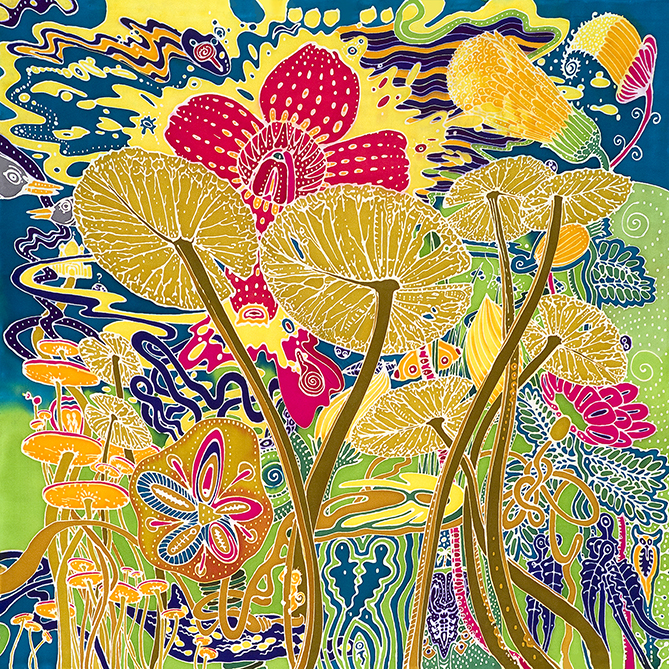
Lilly pond, satin silk,1000mm x1000mm.
How much time do you do in preparation before commencing?
Preparation takes time before the task begins. It is important to have a clean work space, clean frames, correct silk, mix the dyes, prepare the gutta and resistant, make ready the various applicators and tips, water containers and sprays. All are gotten ready before the silk painting begins so when the chaos of making is happening the only thing to really think about is what the next step is and not get diverted or have accidents due to lack of preparation. It takes a couple of days to get things ready. Applying the silk to the frame is also a sort of meditation and helps me get into the right frame of mind and become accustomed to accepting the path I am entering.
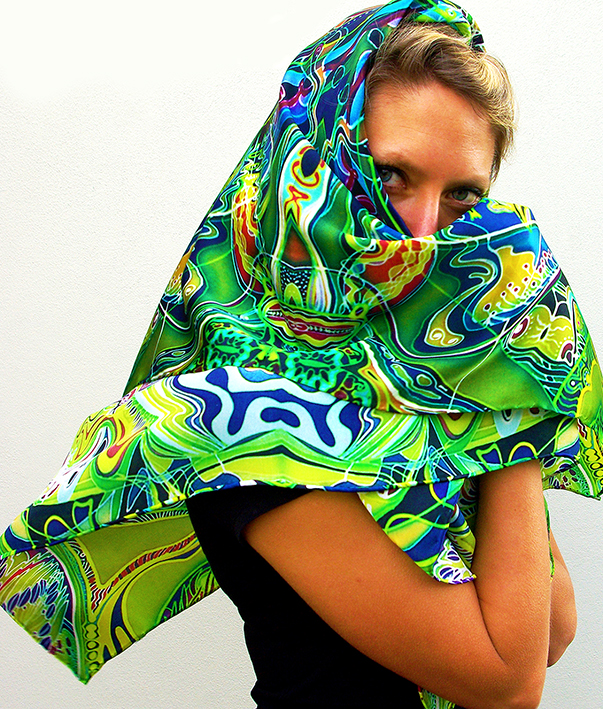
Commercial scarf design
Discuss the thickness of some lines?
The thickness and quality of line is important. Over time I have become increasingly aware of the timing of line placement and its variance within the design. Line is used to separate colour and controls viewer's eye tracking. Line can help emphasize and create the mood I am seeking. I use various applicators with different tips to create different line widths. I also have developed a tendency in my work to deconstruct and destroy the line. This gives a layer of freedom to the work and looks a bit like batik. The line if placed in the correct position can be deconstructed and not loose its potency. There is not one way to make lines, it depends on the maker's intent about what is to occur.
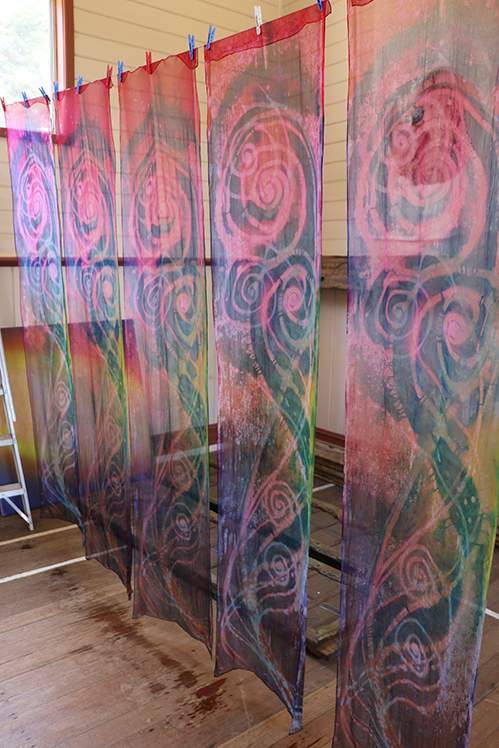
Silk painting, edition of scarves chiffon silk
What happens to the silk when you add salt?
Salt when applied to dye on the silk’s surface when wet or damp will create a natural pattern, a sort of fractal, a chemical reaction where the moisture is drawn into the salt crystal. The size of the salt crystal will determine the strength of the reaction. I use rock sea salt in a medium to small sized crystal. I also grind the silk in a mortar and pestle for finer effects. The application of salt can occur any time during the process and I generally wait till the majority of the piece is nearing completion. After applying salt it needs to be dry and scraped off the silk surface before steaming or other working. Again the process varies depending on the piece at hand.
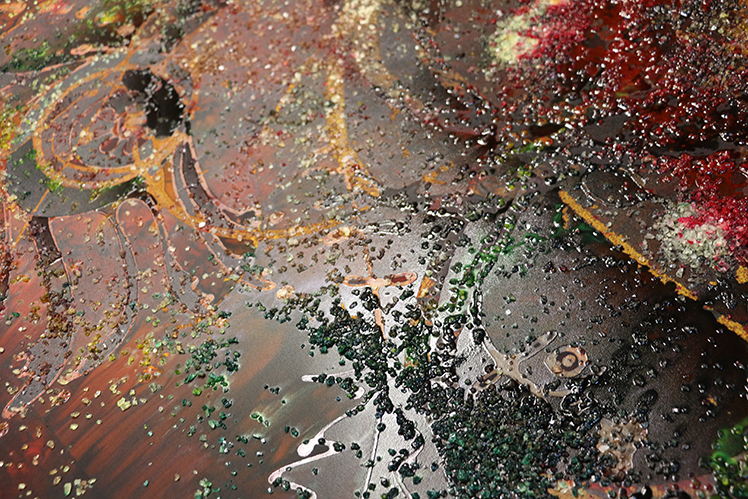
Salt effect on silk
https://vimeo.com/80896398
How is most of your silk painting displayed?
Wall art – 2D
Wearable Art
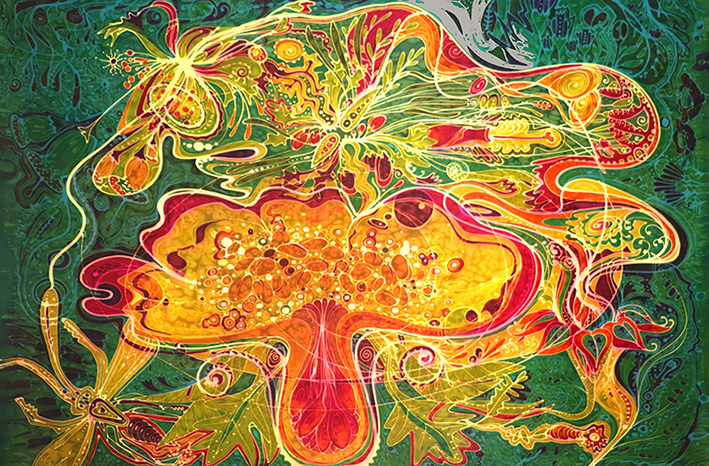
Pollination, silk painting, 1400mmx 2000mm on satin silk
My silk painting is dual purpose. First of all I see the work as a fine art practise, hence my attitude is primarily making a work of art especially with big works. I primarily make for exhibition and from there I apply the designs to commercial uses such as digital runs for rolls of fabric yardage, runs of scarves and for garments. Clients buy originals for wall hangings, stairwells and just as art pieces that are framed. I make small editions for scarves and sarongs. I also make pieces that are quite long for garments that need a lot of fabric and make silks for specific wearable art garments.
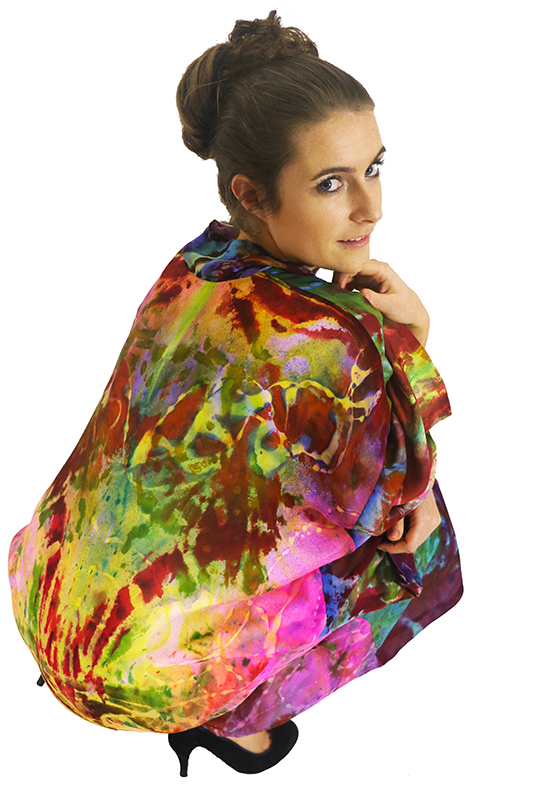
Satin silk garment
You lectured at University level from 1984 – 2006. Can you discuss several aspects (technical) that changed are teaching during this period?
I had done various sessional stints at different universities early on in my career. From 1991- 2006 I worked full time at Deakin University, School of Communication and Creative Arts.
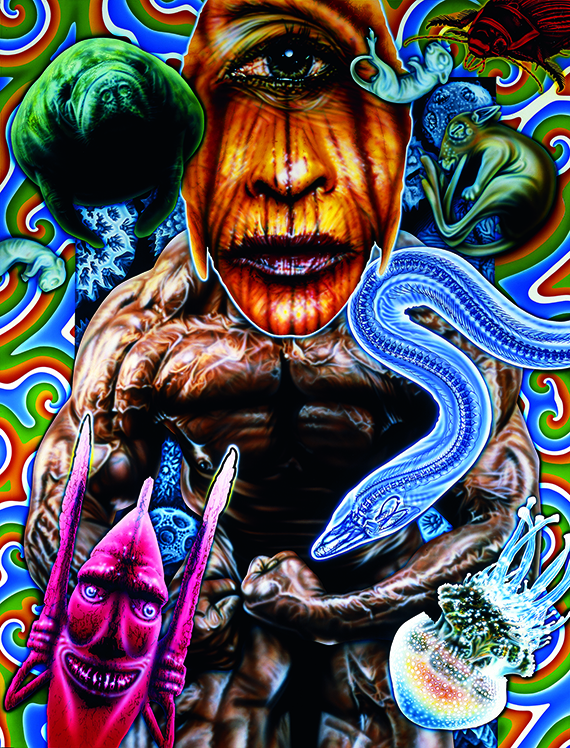
Primordial Paradox. acrylic painting, Deakin University
Lecturing in graphic design, drawing and sculpture. I think the main thing that has changed over that time has been the leap from the individual artist and that analogue mind and real hands on creativity to the digital realm where we see a flattening of the creative landscape. Here many people can do amazing work. Once artists were reliant on their ability to research, keep journals, work conceptually and then full fill the creative task. That market allowed talent to find their way up the creative and commercial ladders with logical ease. The digital era has broadened accessibility and made it easier to make great work. This means also that the market has become smaller, more competitive and overwhelmed with visual stimulus, hence the mystery of creating art diminished and somewhat undervalued.
Take one piece that was added to the Collection of an Institution.
How did it come to be acquired?
Why is this piece the one of many you have chosen?
I have had many commissions and institutional works acquired over the years in various art disciplines and differing circumstances. Monetary value does not outweigh what is important. I tend to like the commissions that push me out of my comfort zone into areas where I am not well known or published, where I really do have to compete and vulnerable to criticism. I love the work I did for the new cancer hospital in Warrnambool.
![]()
ICON Cancer Hospital Warrnambool Flying Ganett sculpture
To create art where healing is the main objective is a luxury for an artist. I was approached by the main driver of the project Vickie Jelly. It started as a small discussion and turned into two sculptural pieces and 3 oil paintings.
![]()
ICON Cancer Hospital Warrnambool Leafy sea dragon sculpture
It was a good feeling to know that the art would be viewed by patients, staff and visitors all there for the same purpose.
Tell us about Nirranda Arts Gallery.
The art business relocated from Warrnambool to Nirranda in early 2017 when my partner Gail and I purchased the Nirranda Community Hall (est. 1896) and obtained a permit to trade as an Art and Craft Centre. Today Nirranda Arts operates as a professional art and design studio focused on silk painting, textile design, sculpture, drawing, painting, workshops, teaching and other commercial activities.
The underpinning philosophy of Nirranda Arts is of an ecological consciousness which is concerned with how one living thing is connected to another living thing. That art is purposely made to heal. To create positive emotions and help people feel happier and empowered.
What does the name mean?
The name is thought to have been derived from an Aboriginal word meaning moon. There are also other indigenous words meaning moon.
Where is the gallery?
Nirranda Arts is located on the Great Ocean Road, nestled between the Bay of Islands and Childers Cove in rich dairy grasslands, 300 kms south west of Melbourne and 25 kms east of Warrnambool.
Comment of the importance of its physical environment?
Nirranda Arts is an art sanctuary, a sort of creative retreat far away from the city. No pollution, few people, no competitiveness or noise. The physical environment impacts me all the time. The coastline of the region is spectacular and relatively unspoilt. Fresh air, big skies, pure water and surrounding farmlands combine to create a pleasant work place where I feel like a free artist.
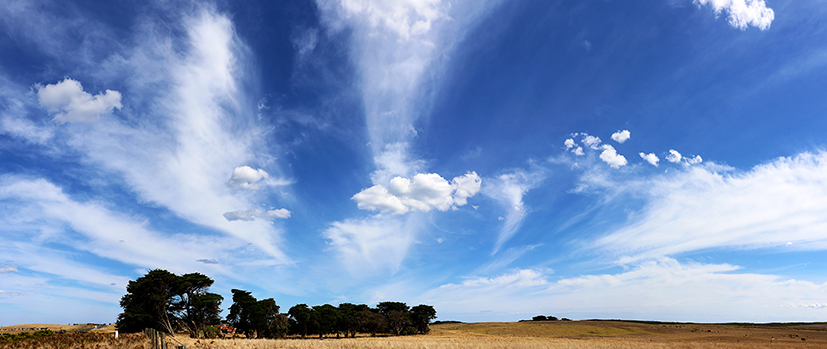
Big sky at Nirranda
The art and the environment are part of the same in that sense and those natural patterns, rhythms and emotions become part of the creative process whether I intend it or its unintended but is there.
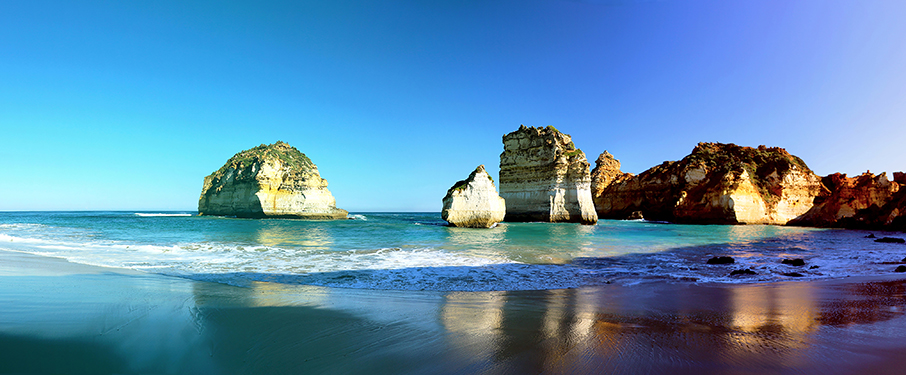
Childers Cove
Comment on the importance of art for the health of the viewer and the artists.
In my mind the purpose of art whether in textiles or any other art form is to heal. I am not interested in my emotional state or telling people how I feel about society or the current politics. I see making art as a contribution to the greater good of humans and hope this translates and transcends into a more caring and kinder world.
The state of mind of the viewer can never be taken for granted. The application of design strategies and control mechanisms within the artwork will either aid or hinder visual communication. In all my work I use basic design principles to control the viewer to achieve the emotional response I am aiming for. Whether this is done unconsciously or blatantly doesn't matter because once seen the message is delivered. This is how all successful visual communication is made.
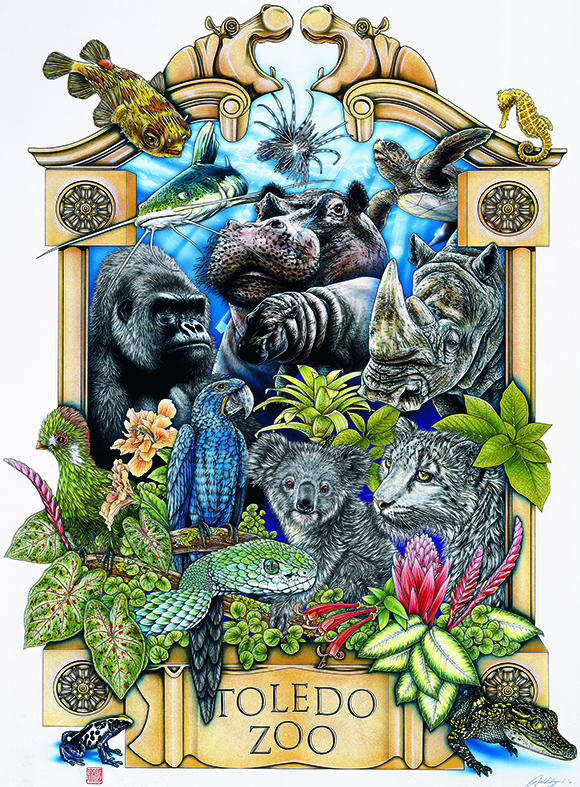
Toledo zoo poster
As for the health of the artist. I can only judge my own journey. A blend of posture pain and an aging body has meant changing methods and technique to compensate. It is never easy working alone but seems to be the way. I find it is important to treat everything I make as if it was for the first time. This gives the work and myself space for renewal and growth. New when creating and gives me a voice and freedom of expression I have grown more and more to be grateful.
How do you think your time in Japan, China and the USA has blended with living and working on the Great Ocean Road, in Victoria?
Working in Melbourne in the early years became quite limited very quickly. To me the best work was done elsewhere. For many years I chased this illusionary dream. The international experience over 40 years has given me many things. The exposure to different cultures, to their artists and craftspeople, seeing amazing art and design, learning other ways, methods and approaches to life. The realisation that there are many amazing artists out there with fantastic creative minds and hearts is a humbling and earthing experience.
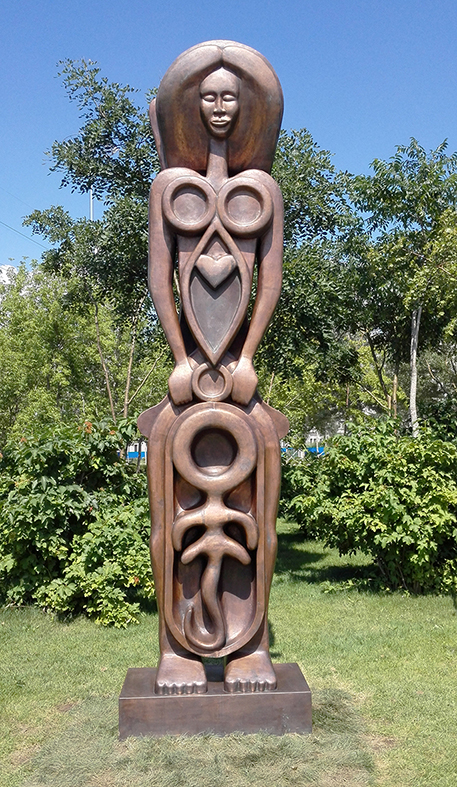
Southern Ocean Godess, Bronze, International sculpture symposium Changchun, China.
Today I base myself on the Great Ocean Road at Nirranda Arts, an old community hall located in a rural setting wedged between the Bay of Islands and Childers Cove. I have seen enough of the world to know how lucky it is to be here. With this in mind I try to continue the art practise and contribute to our society and help people to make art and walk softer on this beautiful earth.
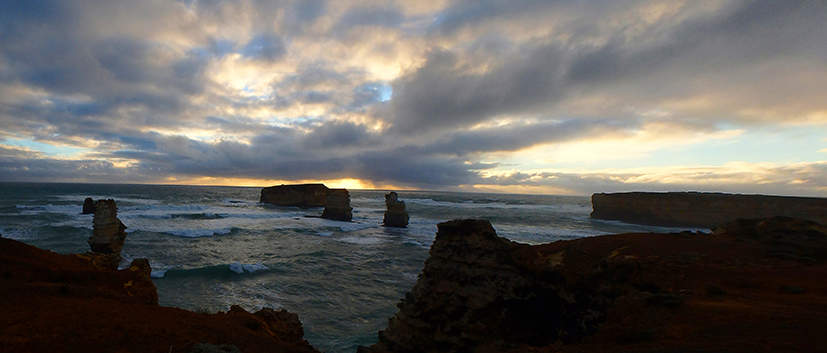
Contact:
David Higgins
Email: d.higgin@bigpond.net.au
Interview by Deborah Blakeley, August 2020
Kit Glaisyer
Comment on how both your parents influenced your love of painting.
Looking back, I can appreciate that my parents were my first painting teachers. I would observe my father making pencil portrait sketches of us as I grew up, and my mother made small paintings of me and my brother, usually depicted as cherubs! Both of my parents were talented artists, and though neither went to art school or pursued art as a career, they both had some training and created very accomplished landscape and portrait paintings.
My father was a family doctor based in the rural village of Cerne Abbas in Dorset, southwest UK. He used to carry a small watercolour set in his car so that he could stop and paint local landscape views between visits to his patients. Back at home, he would then explore the views from nearby fields and, once I was old enough, I began to accompany him on his painting excursions. After working for an hour or so at opposite ends of a field, we would meet up to see what the other had done, and this was really how I began to learn what did and did not work in a painting, and to understand what my own paintings needed in terms of technique, mood, and subtlety.
Discuss the importance of landscape in relationship to light.
My painting ‘Young Tree on Lewesdon Hill’ captures the brief few minutes as the sun sets behind a young beech tree on the path up the hill. I seek to capture the sun in its most dynamic essence, rather than simply painting an orange sphere in the sky. I wanted to make it feel like the viewer was hardly able to look at the painting because the sun is so bright, appearing to almost melt the tree trunk as it glistens through the leaves.
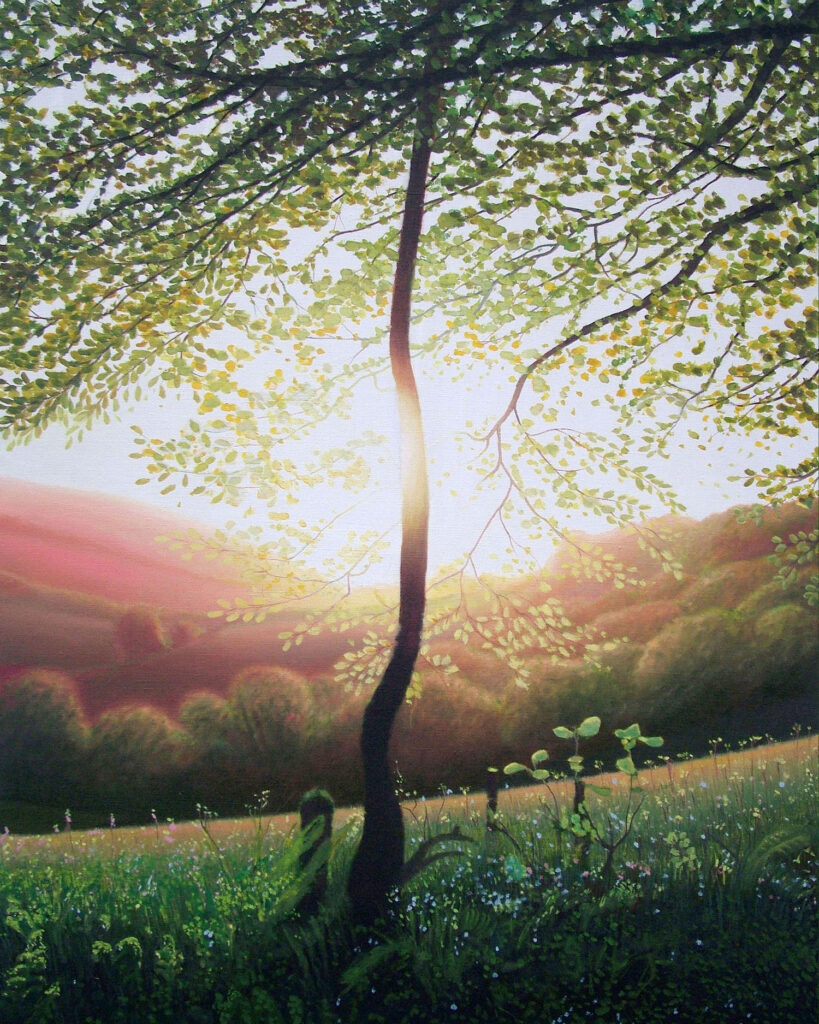
Sun setting behind a young tree on Lewesdon Hill - oil on flax - 108x140cm
I’ve always been fascinated by the idea of creating light, depth and atmosphere in a painting. The West Dorset landscapes that surround me, provide me with countless ways to explore this, using complex and multilayered oil painting techniques to create dynamic optical effects.
I’m always on the lookout for distinctive moments to capture in paint. Growing up, I used to capture fleeting moments with quick plein-air paintings, whereas now I prefer to work more slowly, creating highly ‘accomplished’ paintings that require several weeks or months of work, extensive preparation and dozens of layers (glazes) of paint.
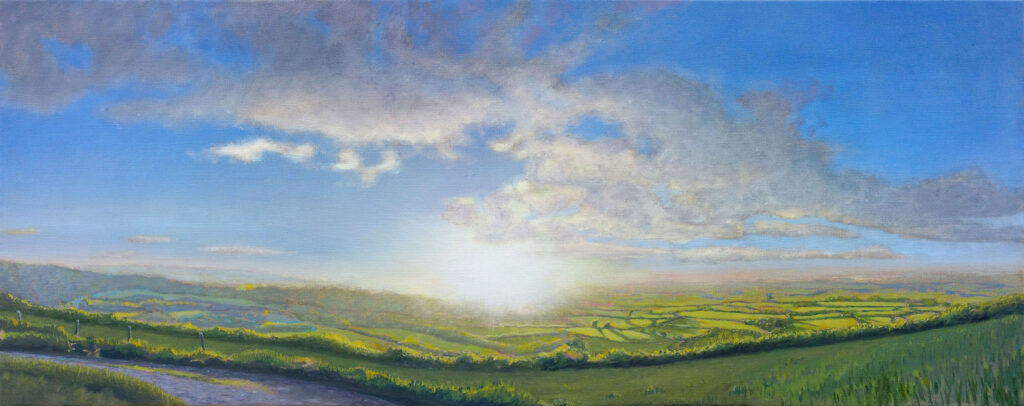
A view from Bulbarrow Hill - oil on canvas - 36x92cm
Expand this further to discuss Sky and how you paint skies.
Clouds
Every landscape painting actually requires a different approach to the sky, according to the mood and atmospherics involved. Some of my paintings have very simple skies because I don’t want to distract from complexity going on in the foreground or because lush foliage fills the upper half of the painting, so only glimpses of the sky are visible. Sometimes the mood of the scene is quite minimalist and meditative, so I simply create gentle gradations of colour across the sky.
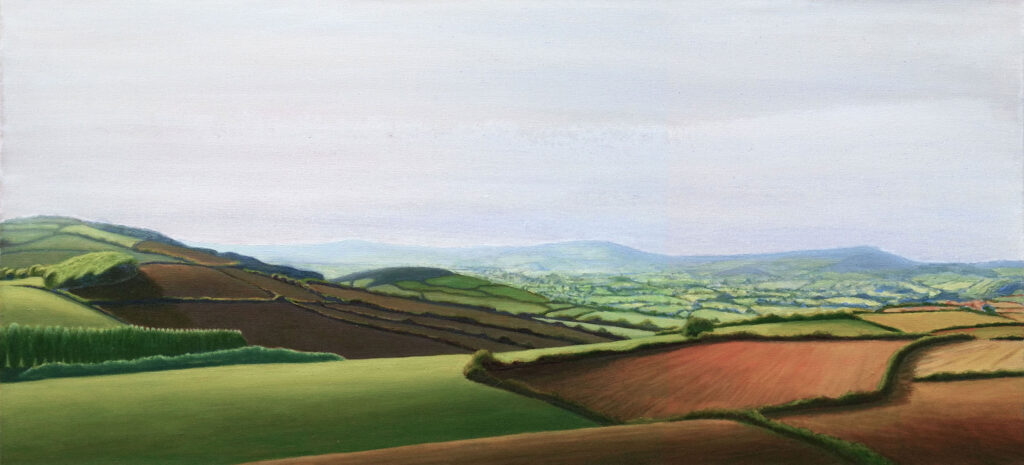
A Hazy summers view across the Marshwood Vale - oil on canvas - 120x60cm
But sometimes, the sky can be packed full of drama and amazing spectacle, and then I thoroughly enjoy indulging in the theatre and cacophony of light, texture, depth and colour.
One of my most elaborate skies is probably in “Dorset Clouds above the Marshwood Vale”. For this scene I painted the sky with the canvas lying flat on the ground so that I could create pools of paint, overlapping, merging and multilayered, that mimicked the wonderfully dynamic cloudscape above.
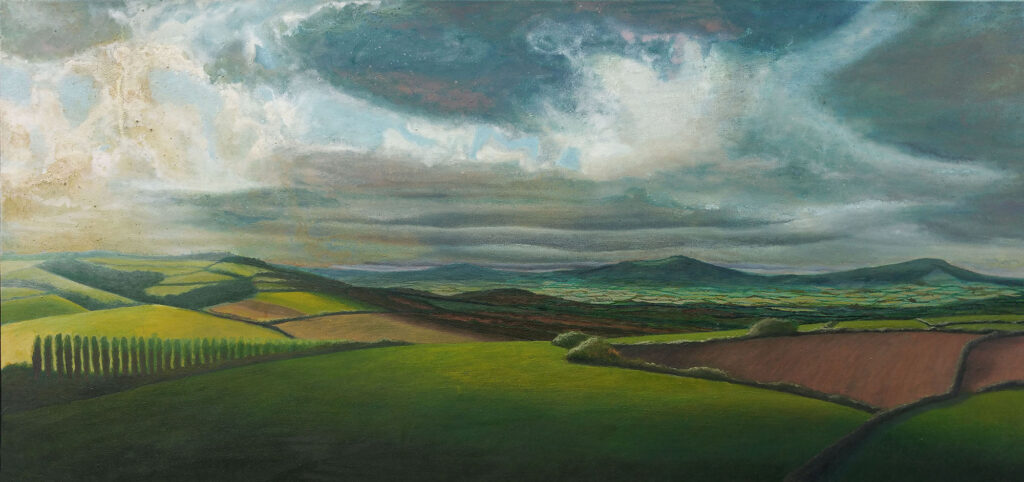
Dorset Clouds - oil on canvas - 120x60cm
I never simply make up skies (or landscapes for that matter), everything is based on moments that I’ve witnessed in Nature, though many things may change in the course of making the painting. With my plein-air studies I simply respond to the scene before me, but with many of my studio landscapes, I sometimes combine two or more days into a single painting, particularly if I witness a more interesting skyscape that might better complement a splendid landscape that lacked great skies on the day.
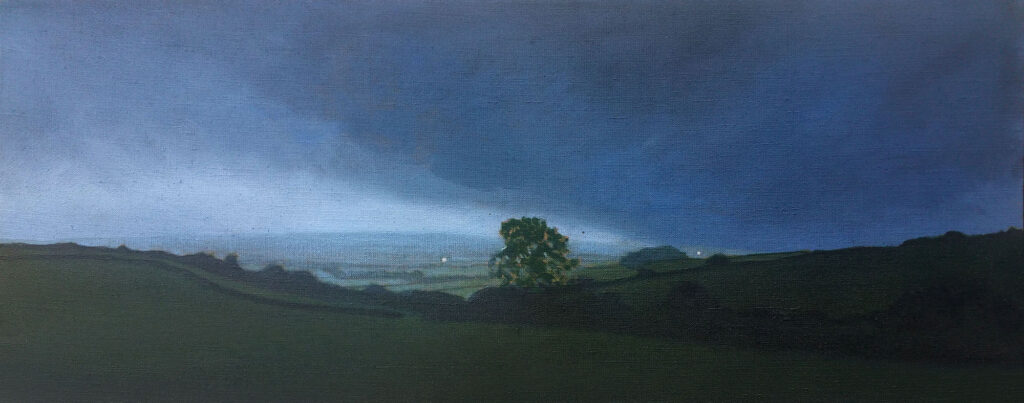
North Bowood Mists - oil on flax - 100x40cm
Sunlight
Sunlight is so varied in its effect, sometimes bright and illuminating, other times more subtle and indirect. I’m always looking for dynamic moments to capture, and when they occur, I decide which vantage point will best suit those atmospherics. I have at least a dozen different places that I’ve returned to again and again over the years, some are epic views from hilltops, other are more intimate glimpses from behind trees, through hedges or looking up paths.
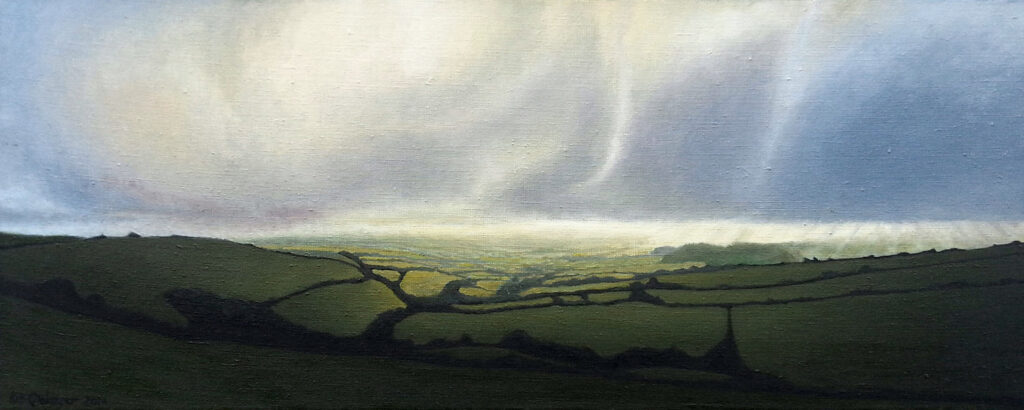
Eggardon light in the valley - oil on canvas - 100x40cm
When I’m looking for a grand landscape panorama, I often paint the views from the top of Eggardon Hill, an ancient hillfort in West Dorset. It’s a spectacular view, and because we’re so close to the sea, we often get low clouds and the sea mist sometimes creeps inland. This creates wonderful atmospherics of light, filtered through the clouds and mist. In ‘Eggardon Light in the Valley’ there is just a slim sliver of light between the land and the clouds, illuminating the valley below. Making a painting like this is all about patience, often working on just one area of the painting over several weeks to achieve the subtlety of colour and tonal gradation that it requires.
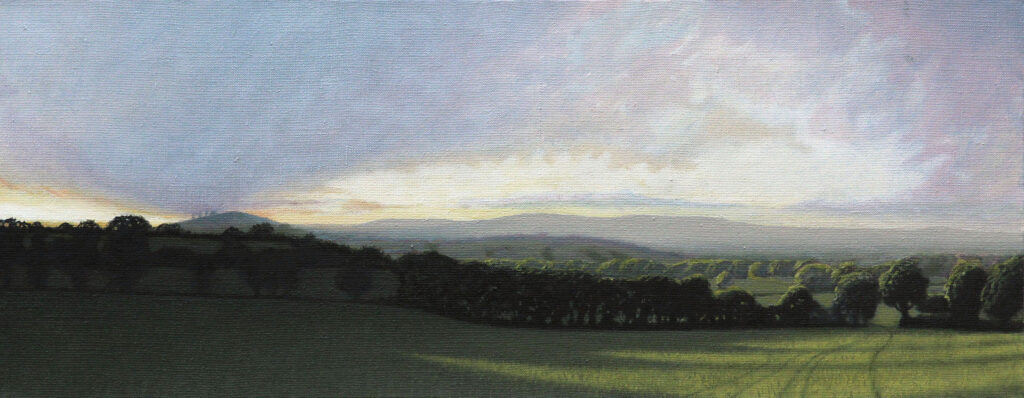
An October view near Whitchurch Canonicorum - oil on flax - 90x35cm
Dark skies
I often create compositions where there is a dark foreground, a light middle ground and a slightly darker sky. Some of the best skies are slightly stormy, with light breaking through the clouds and perhaps rainstorms in the distance. I also like to paint nightscapes, often with dark skies above a townscape or showing the moon above the sea.
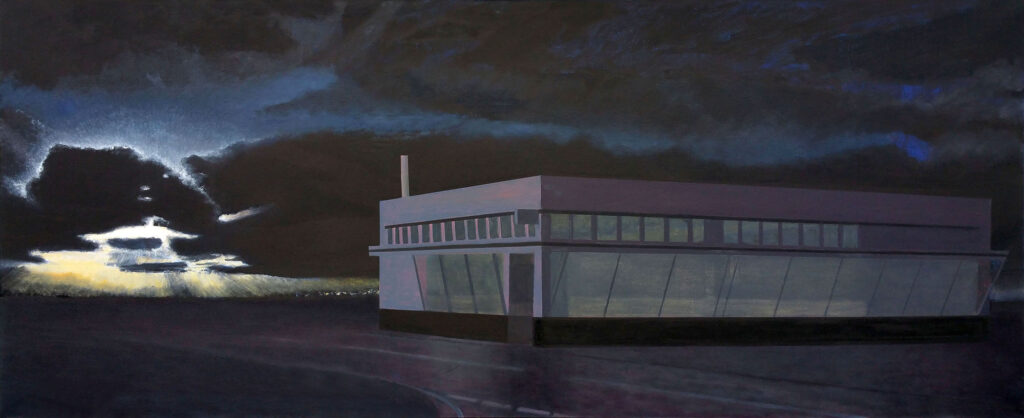
The Last Cafe - oil on canvas - 210x70cm
‘The Last Café’ is one of a series of paintings I’ve made of a local café that I often stage in a theatrical manner. With this particular painting, I decided to show it as a large dark, empty presence against a dark sky, but with the dramatic light of the moon breaking through clouds and suggestions of civilisation in hints of light across a distant coast.
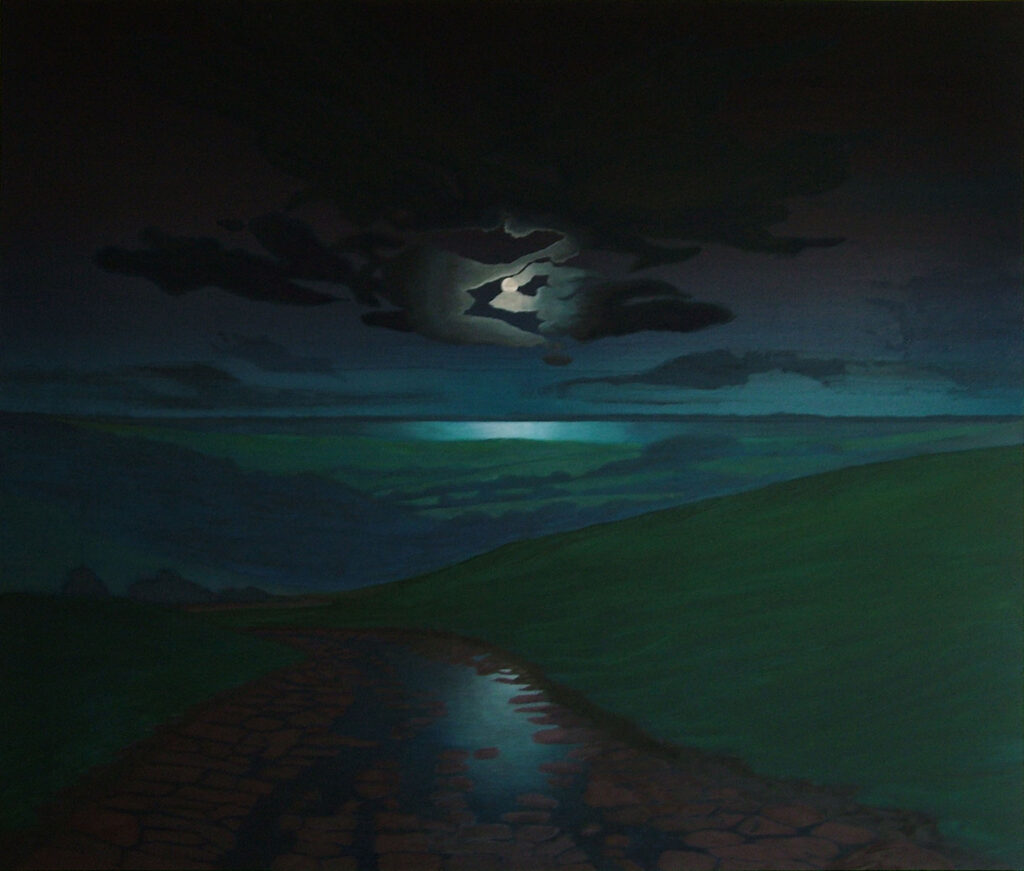
Litton Chaney Moonscape - oil on canvas - 210x180cm
For ‘Litton Chaney, Moonscape’ I went out for several nights to look at the moon above this small village close to the sea, trying to work out exactly what colours I was seeing. It’s a hard painting to photograph because I had to use a gloss varnish on the darkest parts of the sky in order to achieve a jet black. The cobbled road was actually an invention, so that I could reflect the moonlight in the bottom half of the painting.
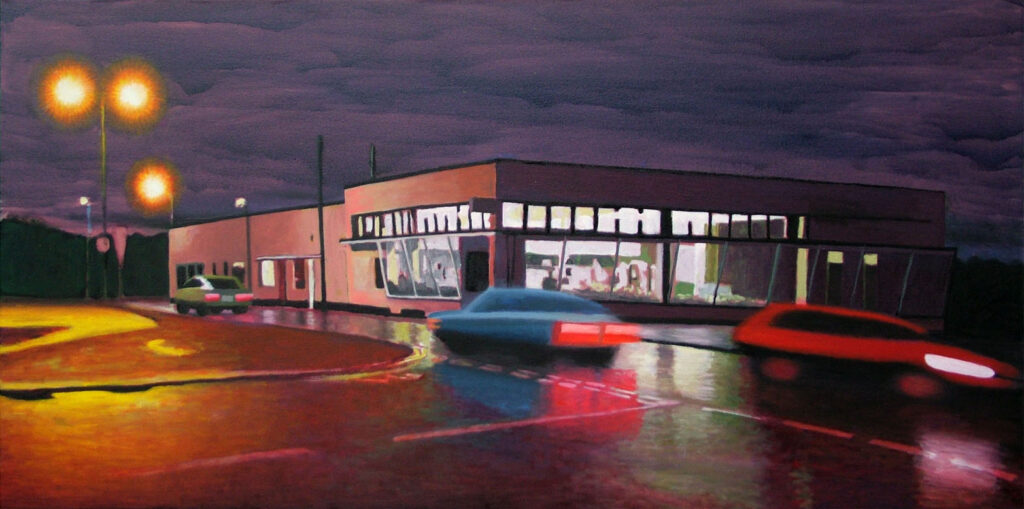
Cafe Royal with cars 120x60cm
The feeling of the power of nature
Perhaps the power of Nature is best felt when we witness a dramatic sky above an impressive landscape. One of my favorite vistas is from Eggardon Hill, an ancient hillfort a few miles outside of Bridport. The views from the top of the hill are often totally breathtaking, and, along with the atmospherics in the moment, you can also soak up millions of years of history that have shaped the hills and valleys, matched by the hundreds of millions of years along the Jurassic Coast, where the south coast meets the sea.

Grant Panorama from Eggardon Hill - oil on flax - 240x80cm
Eggardon Hill has a crescent shape with a steep hill on the south side and escarpments a on the north side, which nicely frame the view into the valley beyond, which dips steeply towards fields and woods below. A few miles west, smaller hills rise and fall, with towns and villages dotted within the valleys, and further away, more hillforts of Lewesdon, Pilsden Pen and Lamberts Castle dot the horizon. The view of the sky is far broader from the top of the hill and can contain multiple weather fronts from blue skies one side to rain clouds on the other.
Discuss your plein air painting and how significant it is to your work.
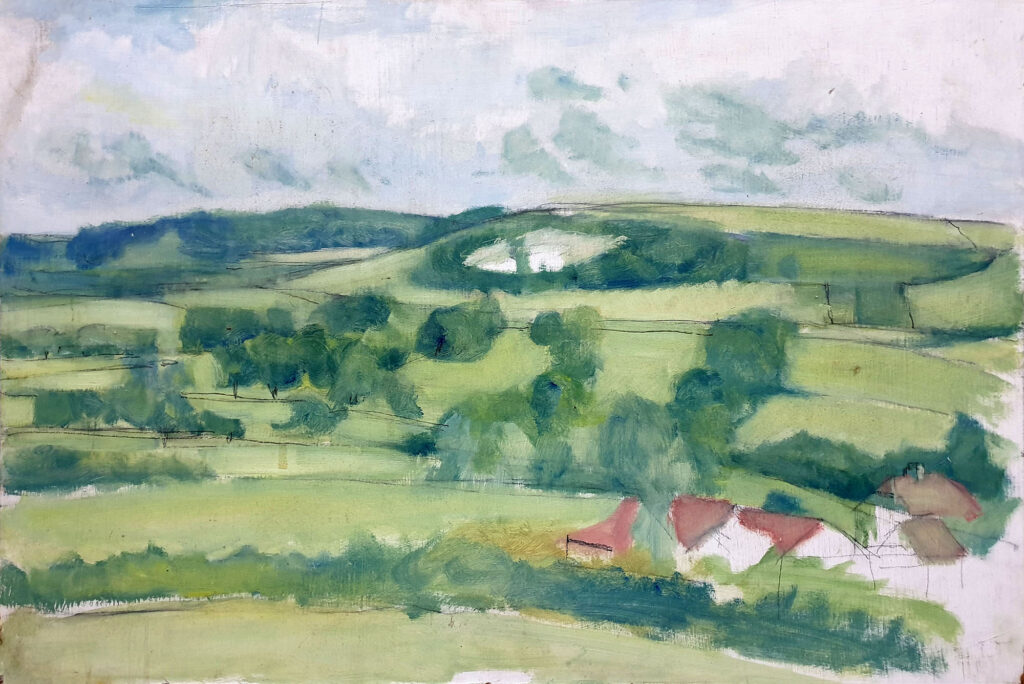
Buckland Newton - oil on board - 60x40cm
As a boy, when I was working on my plein-air watercolours alongside my father’s often very accomplished paintings, the experience really helped me to demand more of my own work and to try to accomplish something equally engaging and surprising by tweaking the composition, improving my observational drawing, and honing my palette to maximise the visual impact of the image.
These early experiences made me appreciate that the challenge of creating an accomplished plein-air painting wasn’t just about the ability to capture a likeness of a scene, but about creating something truly memorable, by scrutinising the view and searching for areas to enhance or subdue, using one’s imagination to consider new compositions, and finding ways to push the available materials to intriguing outcomes.
I’ve continued to use watercolours throughout my career, and I can appreciate how they have greatly informed my subsequent relationship with oil paint, both in terms of their versatility and the way one can create luminosity by allowing a white paper/canvas to shine through the thin colour washes above.
My deep love of oil painting really started to develop in my early teens, while I was still at school, when I began to make plein-air oil sketches on board, mainly inspired by John Constable’s plein-air sketches, Corot’s paintings of the Forest of Fontainebleau, and Cezanne’s many paintings of Mont St Victoire.
One of my early oil sketches on board is of the Buckland Newton valley, where I grew up. I prepared the board before I went out painting, with a simple white ground. I thensketched the scene in pencil before applying thin washes of oil paint.
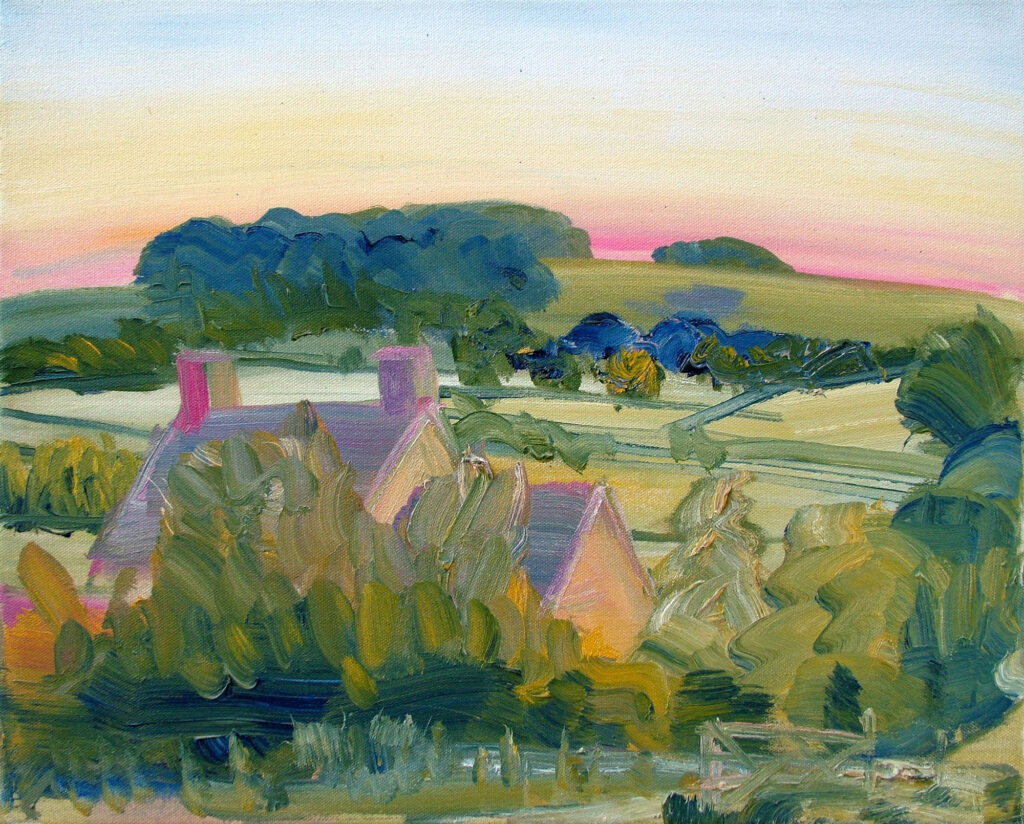
Homestead - oil on canvas - 30x24cm
A few years later, I painted Homestead with thicker oil paint, sat on the hill behind my parents’ house. Working for just an hour or so in the evening light, I started with a rough oil sketch, then, working down from the top, I painted in thicker layers, with the sky as the furthest background and then worked forwards, with the distant hill, then the woods in the middle ground, and finally the house in the foreground.
I find that plein air painting is a great discipline, but also has its limitations, as it very much depends on finding interesting light and atmospherics on that particular day. There are certain scenes that tend to work well with plein air, such as the light coming through trees in a wood, perhaps across a stream. Also, town scenes can be effective, or anywhere that the vista is interesting to look at in a wide range of lighting conditions.
However, for my larger compositions, the painting tends to be studio based, requiring several months of work to depict a relatively fleeing moment. In these cases, I tend to combine several plein air sketches with photography and collage to capture the essence of that moment, which forms the foundation for a final, highly accomplished studio painting.
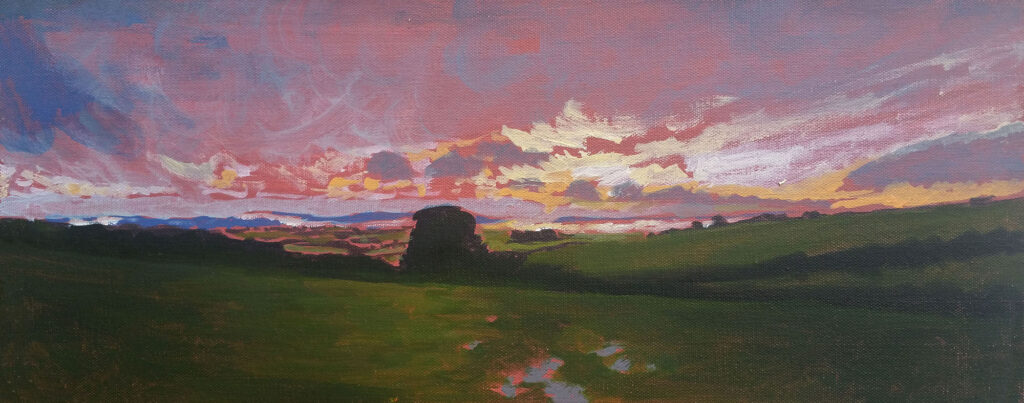
North Bowood Sunset Clouds - oil on canvas - 30x15cm
You call your paints ‘Cinematic’ can you explain this term in relationship to your current work?
In one sense, the term Cinematic simply refers to the Panoramic format in which I like to paint, something that I’ve increasingly adopted over the years, usually preferring a 3:1 format. It naturally makes sense to me that, because we have two eyes, we automatically see the world in a panoramic format. While I’ve also made many paintings on a standard 3:4 or 2:3 format, I particularly enjoy how we have to ‘scan’ a panoramic landscape, unable to take in all the elements at once, but instead, focusing on one part at a time.
I am also a huge fan of Cinema, from the 60’s to the present day. In fact, my original intention was to first pursue a career as a painter and then become a Film Director, something that remains at the back of my mind. I particularly love the cinematography of Roger Deakins (No Country for Old Men, Fargo, Skyfall, Blade Runner 2049), Wim Wenders (Paris, Texas and Wings of Desire), and Michelangelo Antonio (Zabriskie Point). One can perhaps imagine some of my paintings as the backdrop to a film, and in fact, if you watch the beautiful 2016 version of “Far from the Madding Crowd” it is actually filmed in the countryside where I live.
I also feel that the Landscape can contain narrative elements without needing to actually tell a story. And while I’ve enjoyed creating invented scenarios around my Café Royal paintings, I realised that I actually don’t need to invent any new narratives when I paint the countryside, since I can call upon all my accumulated childhood memories and experiences that are so innately embedded in my psyche.
I suppose, in some ways, I am returning to the original ideas of 19th Century painters, particularly those of the Hudson River Valley and European Romantic painters, visions of the land that Cinema’s greatest Directors subsequently borrowed in order to add atmosphere and grandeur to theirs films.
Discuss the way you paint, moments in time.
Before starting a painting, I spend a considerable amount of time on research: first exploring the location by walking, sketching and taking reference photographs, while searching out the best vantage points, all the while waiting for those magical moments of light and atmosphere that might just inspire an exceptional painting. I have also been known to wait several weeks for dull weather to transform into something more theatrical or sublime. And when that moment arrives, I know I have to act quickly, devouring as much information as I can in the brief window that all the elements are in place.
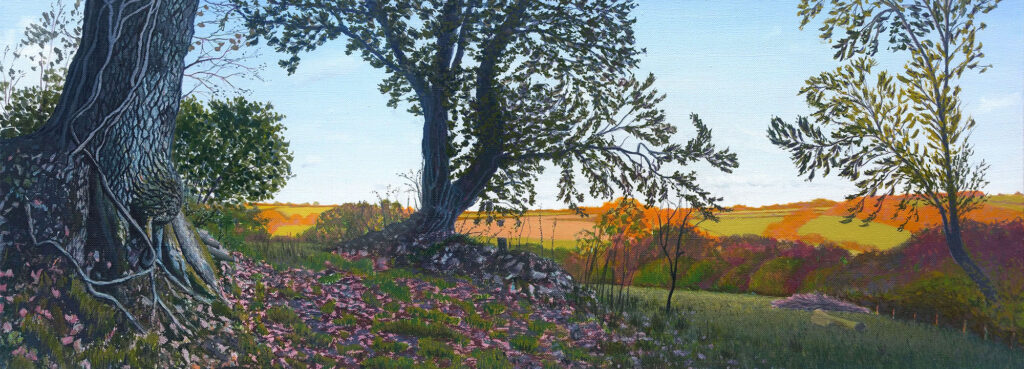
The Offwell Valley in Devon - oil on flax - 130x48cm
Once I’ve got enough reference materials, I then begin to create collages with which I can explore ideas, design compositions and craft pictorial narratives. This all leads to a concept sketch that evokes the mood and atmosphere I want to capture, and I then start on some initial oil sketches on a small scale, with my collages as reference.
The early stages of a painting tend to be quite raw with strong colours and vivid tones that I deliberately exaggerate so that I can clearly spell out the grand themes within the painting. I then begin to patiently build up the many glazes (layers) of oil paint required, gradually toning down the colour palette in order to achieve ever greater subtlety over the following weeks and months, all-the-while, improvising and adapting various elements of the painting. This intentionally patient process means that none of my paintings are rushed and I don’t ever feel that I have to compromise my ambition for them.
From then on, it’s all about my relationship with the painting, which will continue to evolve and develop in its own way until it’s finished. Because I work with raw oil paint, I tend to have to wait either a few days or a couple of weeks for a particular layer to dry. This also gives me time to consider which areas of a painting are either working effectively or are unsatisfactory and to imagine what I might do next. Sometimes the painting suggests surprising new directions, and at other times I simply continue to follow my original plan, building up layer upon layer of glazes, gradually developing the dynamics and atmospherics throughout the painting.
I guess I see my Cinematic Landscape paintings as a hybrid of the past and present, eagerly drawing from various landscape traditions with which I combine the traditional skills of plein-air painting and studio-based landscape painting, while also utilising photography and digital technology such as Photoshop.
I should also point out that while my paintings often appear very realistic, I never simply copy a photograph and I am certainly not a Photorealist painter. And while I frequently utilise photography, it is mainly in order to capture fleeting moments, and so that I have some reference materials available to me several months after that particular moment has passed. Furthermore, once I’ve created the composition for my painting, I then break down every aspect of the landscape and then patiently rebuild every field, pathway and tree, according to the mood I’m seeking, through a patient process that is both improvised and exacting.
Another aspect of your work is ‘Drip Painting’.
Where did this term come from?
The technique I use to create my Drip Figures actually originates with my Abstract Paintings that I created in the mid to late 90’s. In these paintings I would drip and drag the paint across the canvas, and I learned how to use turpentine to ‘bleed’ lines and shapes out of the paint. A few years later, when I returned to the figure, I realised that I could utilise my abstract techniques to express the figure in a new way. It makes sense to call them Drip Figures because the paintings literally drip off the canvas. In fact, once I’ve painted the figure, I have to lie the canvas flat on the ground so that it stops dripping and freezes that moment in time.
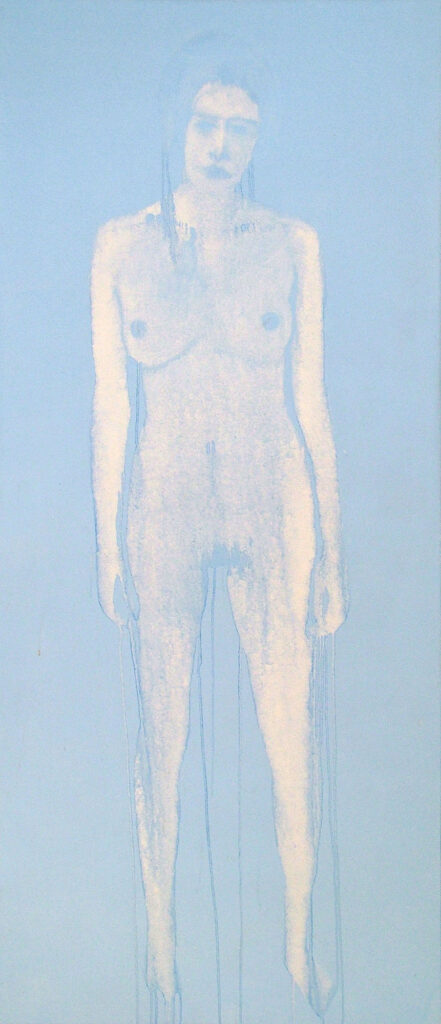
Drip Girl - oil on canvas - 180x60cm
How do you capture the figure within this work?
It’s all about preparation. I start with a flat layer of wet oil paint on the canvas, and I then remove the paint with turpentine, rather than adding paint, as most artists do! Painting with turpentine allows me to ‘feel’ my way around the figure rather than trying to depict something. Thus, I follow the contour of a shoulder or the angle of an arm, and I find I can express the dynamics and attitude of a figure through the movement of the brush across the canvas.
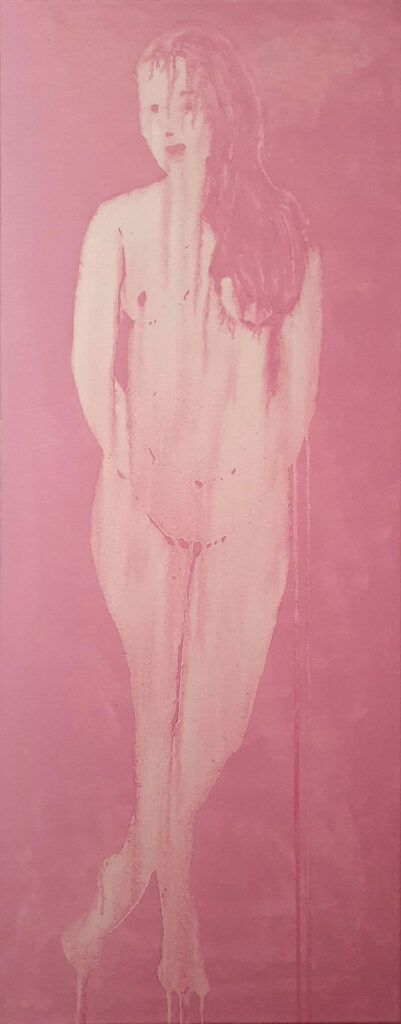
Sam standing - oil on canvas - 100x40cm
What I like about my Drip Figures is that they seem to have an actual presence, rather than simply being a depiction of someone. They literally emerge out of the paint, and the drips evoke how the body is in a constant state of change, as well as reminding us that the human body is full of fluid, which is both such a fragile and beautiful form to be living within.
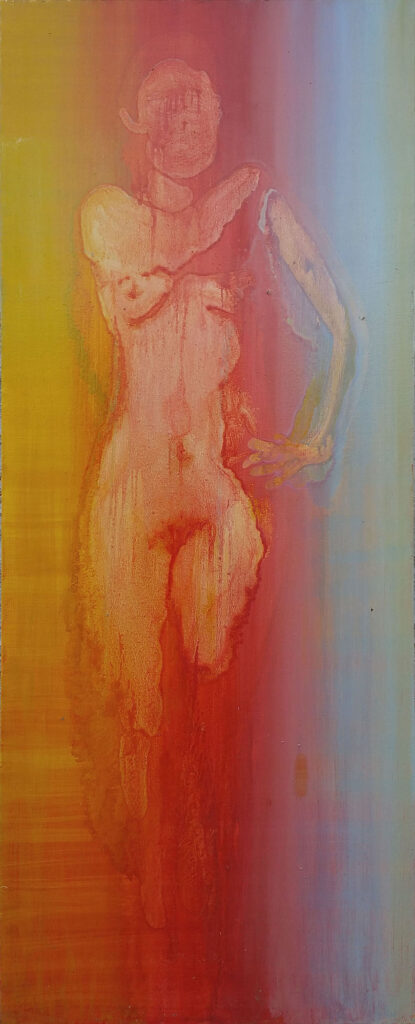
Multicolour Girl large - oil on canvas - 100x40cm
How are you coping with the Pandemic and your art?
I am fortunate because I have my studio in my home, so I’ve been able to keep painting throughout lockdown. In many ways, my life hasn’t changed a great deal, as, like most artists, I’m used to working on my own for long stretches of time. What I’ve missed most are visitors to my studio, both the public and other artists, as I really appreciate and enjoy feedback on what I’ve been working on.
I started a new series of landscapes as lockdown began and it’s interesting to see how these each expressed a different emotional state I was going through, from stormy thoughts, to calmer moments and even some feelings of upliftment and hope.
How essential is your studio space currently in this particular time?
As someone who spends a long time on each painting, my studio has been a vital space. It’s in my house, so I can come and go as I please. After working for a few hours, I usually go for a walk or a cycle ride to clear my head. I find painting to be a very intense experience, often focused on a specific part of a painting that requires great subtlety and patience, and because I work in oil paint, there is always a sense of the narrow window of time in which I have to achieve the result. While it is always possible to repaint over an oil layer once it is dry, my process is pretty unforgiving as it often requires several ‘perfect’ layers to be applied in succession. It’s certainly satisfying once I’ve finished a painting session for the day, and when I finally emerge from the studio, it feels like I’ve been in a trance, so I need to reconnect with something ‘real’, whether that’s walking in Nature or enjoying the company of other people.
Comment on the value of other local artists to you?
Having the company of other artists is very important to me. Going to Art College was a revelation, being surrounded by so many like-minds (unlike being at school) and, since those days, I have always aspired to live close to other artists.
I moved to my current town of Bridport in 1998 mainly because there was already a strong artistic community here. The community had evolved from a short-lived Art College that was run in the early 80’s and which had essentially become an Art Residency, where artists from the UK and abroad could come to live and work. In 1999 the Residency closed, so I started a new art studio complex in a run-down industrial estate in the town. This grew over the years to provide studios for a couple of dozen artists and became a big draw for the town as a whole.
I’ve also been Director of Bridport & West Dorset Open Studios for ten years, so it’s been my business to know every professional artist in the area. I’ve now stepped down as Director so that I can focus exclusively on my own work and on promoting my new gallery project, Bridport Contemporary which is based on the ground floor of my house. I present a selection of works by a number of West Country artists that I particularly admire.
Take us through your countryside by season – discuss colours and how they vary.
Summer
“Hazy Summer in the Marshwood Vale” was a painting in which I wanted to capture the balmy heat of summer. The foliage and greens in the fields below are slightly bleached out, with a dry sun-bleached quality, while the earth is dusty, and the air, moist and humid. The overall palette is both accented to the brightness of summer light and slightly muted, as the hazy light reduces any great extremes of colour and contrast.

A Hazy summers view across the Marshwood Vale - oil on canvas - 120x60cm
Autumn
In “View near Burton Bradstock”, the evening autumn light is setting behind us, and illuminates the fields and trees beyond with an orange glow. Every time I went to study the view the pattern of light in the distant fields had changed, so I had to choose one particular day when the palette of the fields best complemented the glowing foreground. The distant valley was the last part of the land to complete, and once again, that particular day was chosen to work best with the rest of the painting. The sky above was finished last, though I had a clear idea of what it would look like from the beginning, with a cloud formation created by the warmer air rising above the sea on the right. I then blended the sky in with the landscape across the horizon in a naturalistic way.

A view from Bulbarrow Hill - oil on canvas - 36x92cm
Winter
Loders Road, Duck Street and Broadoak Road. I wanted to capture the stark, crisp January light in this series of paintings. The trees are bare, the hedges shawn, and the earth lies in hibernation, waiting for spring.
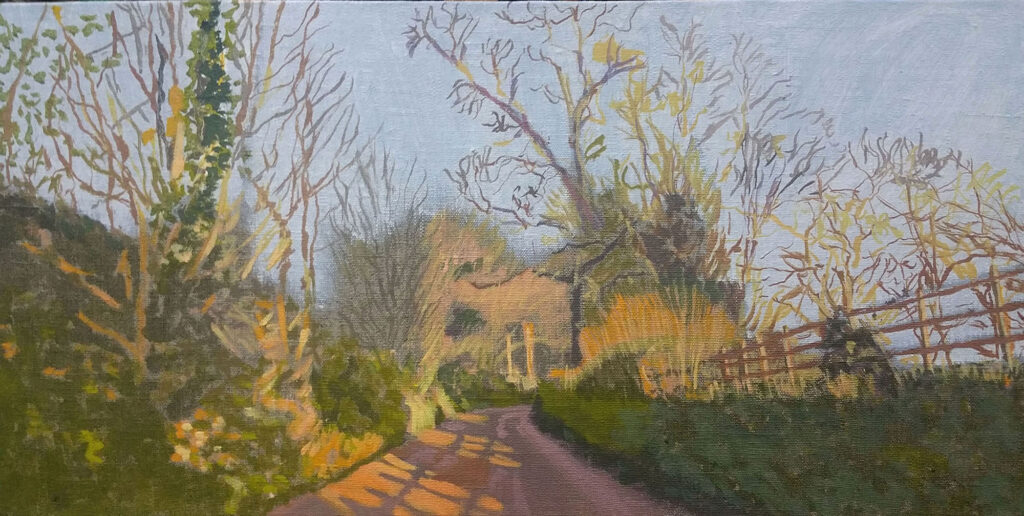
Loders Road - oil on flax - 30x60cm
The painting process is also looser and quicker, with thicker paint brushed on to rough, umber flax, which has had a layer of size (glue). Once the general composition is established, I tend to work from the back to the front of the painting, so that there is a crisp delineation of space between each plane of paint. The colours tend to be quite earthy in the spring, with more browns than greens, and showing a brisk clarity once the early morning mist has lifted.
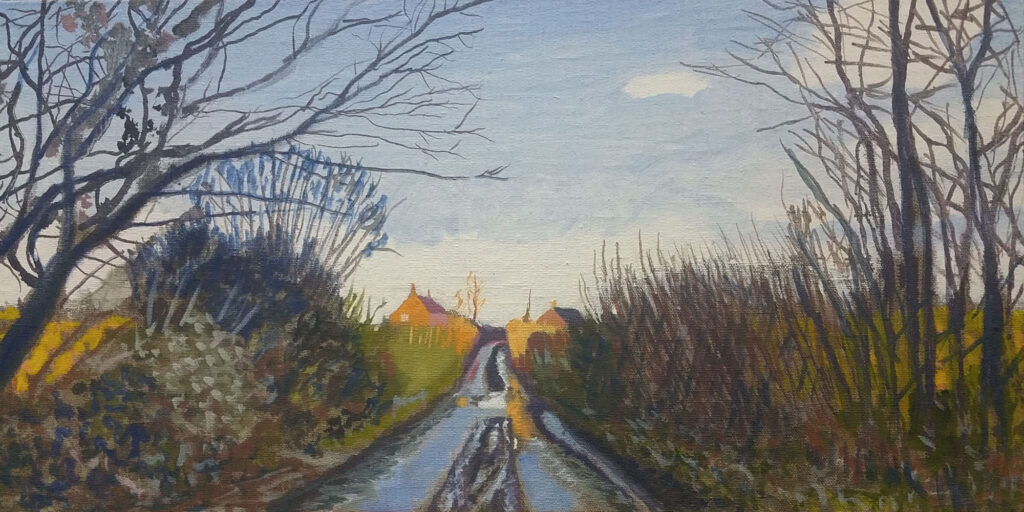
Broadoak Road - oil on flax - 30x60cm
Spring
Lewesdon Hill is another ancient hill fort, much loved for its fields of bluebells and is one of my favorite spots to paint. The foliage gets particularly lush and verdant in the spring, with blankets of grasses, flowers, and leaves. I’ve painted two versions of “Lewesdon Bluebells”, the first was painted quite loosely and in an Impressionistic style on raw flax; the second, a more complex composition looking out from between three trees into the valley beyond. Here, the colour spectrum is rich and bright, with a wide range of greens, illuminated yellow leaves caught in the sun, and the distinctive blue of British bluebells.
 Bluebells on Lewesdon Hill - oil on flax - 210x70cm
Bluebells on Lewesdon Hill - oil on flax - 210x70cm
What advice would you give your younger self?
What a question! I guess the answer is to work out what has brought me the most happiness and to avoid the things I most regret, and yet, surely, we have to embrace the unique journey that we’ve each been on? Looking back, I appreciate that I actually acted with considerable conviction when I was young, so I’d still endorse that. So, I’d highly recommend just getting on with whatever ideas occur to you, and avoid judging what you’re doing until it’s finished, for true originality must also surprise the artist in the process of creating it.
Also, find ways to constantly challenge and inspire yourself. I would be very bored if I had a completely premeditated process and a certain outcome. All of my most successful painting have been as much about discovery as creation.
Contact:
Kit Glaisyer
Deborah Blakeley, Melbourne, Australia
Interview by Deborah Blakeley, August 2020
Pippin Drysdale
Pippin Drysdale is an award-winning ceramic artist based in Perth who is renowned internationally for her large, intricate works inspired by the patterns and colours of landscapes around the world.

Mistletoe in Bloom I & II, Pilbara Series, Porcelain incised with coloured glazes,
260H x 185Dmm, 270H x 190Dmm
Pippin eventually progressed to exploring ceramics in which to present and display her plants. With her own kiln in the back yard and her irrepressible need to learn and explore a new material, she undertook formal ceramic studies first at Perth Technical School and then at Curtin University of Technology, where she completed a Bachelor of Fine Arts in 1986 under the tough but impressive direction of teacher David Hunt.

Bloodwood Well 1 - Pilbara Series, Porcelain incised with coloured glazes, 300H x 220Dmm
Pippin pushed her learning horizons wider, travelling to the, Anderson Ranch Art Center in Colorado.
Their simple mission statement: “Anderson Ranch Arts Center enriches lives with art, inspiration and community” enticed Drysdale to spend time in this dynamic environment, sharing, teaching and developing her craft, learning from others, and cross-pollinating with artists working in other media. The Anderson Ranch FaceBook page says that this is a place “for artists to immerse themselves in the studio practice of their choice. [They can] work alongside established faculty and receive in-studio support while still getting plenty of independent time, allowing the creative process to flourish.” What not to like?

Pyrites Lustre 09 – Pilbara Series, Porcelain with hand painted gold and Platinum lustre,
270H x 235Dmm
After returning to Australia, Pippin threw herself back into her work and her pieces,
were soon regularly exhibited and collected by major galleries around the world. To date, Pippin’s work has been seen in over 45 solo and group exhibitions in Australia, Japan, India, Europe, and the United States. She discovered a need to work thematically and many of her series are influenced by a journey.

Chichester Range Flood Plains, Pilbara Series, Porcelain incised with coloured glazes, 350H x 280Dmm
Drysdale draws inspiration from the colours and textures of landscape, and each of her pieces is infused with her emotional interpretations of place and space. Pippin focuses on the vast, diverse Australian landscape and has created series based around the patterns and colours of the Pilbara region, the eastern Goldfields, the Kimberley, and the Tanami Desert. Stark, severe, somber, sometimes flooded with intense colours, the landscape she journeyed through gave her endless inspiration. Some of her work has also grown from the exotic sights she saw in India, Russia and Italy, and in the Hunsa Valley in Pakistan.

Igneous Rock I & II, Pilbara Series, Porcelain incised with colour glazes, 110 x 140, 110 x 145mm
Drysdale,explains that landscape ‘is all about colour, whether subtle and soft or vibrant with contrast’.
Drysdale is totally committed to her work and constantly pushes herself to a higher standard. Her perfectionism is reflected in her ambitious works. In 2007, a major survey exhibition of Pippin’s works was held at John Curtin Gallery in Perth, a testament to an impressive two decades of endeavour. In 2008, Pippin was named a Master of Australian Craft by the Australia Council for the Arts. The following year, she undertook a residency at the New York City Department of Cultural Affairs. In 2010, her Tanami Mapping I exhibition was opened in Washington DC by Kim Beazley, Australian ambassador to the USA. In 2011, Pippin received a Lifetime Achievement Award from Artsource, the peak membership body for visual artists in Western Australia.

Wild Alchemy at Sabbia Gallery, Interior image
The range of vessels we see in images from world-wide collections of her work present a sumptuous spectrum of colours, warm and earthy, glowing amber-like or opalescent, dark ruby-garnet shades, while some capture and present in solid form the airey colours of mist. The two predominant shapes are the female – goblet-shapes, and the male – phallic-shapes. Many of the open goblet shapes have a contrasting colour inside which enlivens the pieces and playfully ties them to other pieces in the collection. Pippin explains, “the inside of the vessel is coloured by half-filling it with coloured glaze and swirling it round until a perfectly graduated colouring is produced. An evenly coloured inner void … is essential to the overall presence of the work and this … cannot be achieved with spraying alone, which leaves a dry powdery effect.”

Granites in Moonlight, Porcelain incised with coloured glazes, (Installation of 7),
Variable Heights, Tallest 310mm
With reference to her collection, DEVIL’S MARBLES 1 2016 – Shadow play, Pippin describes herself as “an Australian landscape artist”. Incised lines are my signature, but I use the ceramic vessel/ sculpture to describe the shadows and colours of the Australian landscape at different times of day.” The Devil’s Marbles are a collection of monumental granite boulders scattered across a valley south of Tennant Creek. Millions of years old, some of them are nearly 6 metres tall and are still weathering and changing in the desert environment.
Pippin explains that “the groups of lines in crystalline vitrified glazes moving roughly horizontally round each vessel [in my Devil’s Marbles series] are made by applying colour into incised lines after the initial spraying of glazes… Only a small patch of surface can be worked on at a time… a single pot can take several days to prepare and ‘paint’ in this way…I developed this technique by working for several weeks on shards …[until] it eventually became clear that … those lines that resonate with the form of the vessel were the most appropriate…”

Rainbow Ledge Breakaway, Pilbara Series, Porcelain incised with coloured glaze, 360H x 320Dmm
The female shapes balance on remarkably slender bases, not quite at the point of teetering, but seeming to be frozen mid-spin. Pippin’s “signature”, the delicate incised lines circling some of the vessels add to the sense of movement of these pieces like the shadowy strata on others. Grouped together they become a table-top landscape reminiscent of some of the extraordinary landscapes in Australia. Of these group installations, the artist explains that “it is their individual and collective shape, colour multitude and brilliance [that] contour the vast expanse of the Australian landscape. In the near future, I will push the integration of groups even further to create more diverse installations.” The Devil’s Marbles perhaps are the quintessential demonstration of this desire. As she says, “My future trajectory will focus on the Devil’s Marbles. I will continue to push the exploration of abstract ideas [about] spatial relations, line, texture and colour. Most recently I have returned to using gold and platinum luster and I am enjoying exploring how it can be used on the marbles to capture the iridescence and radiance of the Australian desert.”

Wild Alchemy at Sabbia Gallery, Interior image
Integral to Pippin Drysdale’s production is her thrower, Warwick Parmenteer. His handling of the clay forms, both on the wheel and on the table, show an intimate feel for the material. Mixing delicacy and strength, Warwick’s hands raise the lump of wet clay to become a large hollow globe which he then leans on to create an altered form, edgy and asymmetrical. Pippin’s metallic glazes then define and enrich the shape with their glowing response to the light. The reflective nature of the glazes emphasizes and lifts the form, the soft edges imposed on the original form becoming softly insistent and dividing the faces of the form from each other.
Now in her mid-seventies, Pippin is grateful to still “wake up every day with a challenge” and believes that she has found her identity through her work with clay.

Feathered Light I, Pilbara Series, Porcelain incised with coloured glaze, 240H x 180Dmm
Contact details:
Pippin Drysdale
Pippin Drysdale, Subiaco, Australia
Images supplied by artists in conjunction with Sabbia Gallery
Paper presented by Deborah Blakeley and Sally Baker, October 2018








